Extreme Networks AP3917E Wireless 802.11 a/ac+b/g/n Access Point User Manual WiNG 5 9 1 WC CLI
Extreme Networks, Inc. Wireless 802.11 a/ac+b/g/n Access Point WiNG 5 9 1 WC CLI
Contents
- 1. User Manual-AP3917e
- 2. User Manual-AP7662
- 3. User Manual-AP3917e R1
- 4. User Manual-AP7662 R1
- 5. WiNG 5.9.1 System Reference Guide Part 1
- 6. WiNG 5.9.1 System Reference Guide Part 2
- 7. WiNG 5.9.1 System Reference Guide Part 3
- 8. WiNG 5.9.1 System Reference Guide Part 4
- 9. WiNG 5.9.1 CLI Reference Guide Part 1
- 10. WiNG 5.9.1 CLI Reference Guide Part 2
- 11. Extreme Wireless V10.41.06 User Guide Part 1
- 12. AP3917 User Manual
- 13. AP7662 User Manual
WiNG 5.9.1 CLI Reference Guide Part 1

WiNG™ 5.9.1
Access Point, Wireless Controller and
Service Platform
CLI Reference Guide
Published September 2017
9035205
Published September 2017
9035205
9035205
Copyright © 2017 Extreme Networks, Inc. All Rights Reserved.
Legal Notices
Extreme Networks, Inc. reserves the right to make changes in specifications and other
information contained in this document and its website without prior notice. The reader
should in all cases consult representatives of Extreme Networks to determine whether any
such changes have been made.
The hardware, firmware, software or any specifications described or referred to in this
document are subject to change without notice.
Trademarks
Extreme Networks and the Extreme Networks logo are trademarks or registered
trademarks of Extreme Networks, Inc. in the United States and/or other countries.
All other names (including any product names) mentioned in this document are the
property of their respective owners and may be trademarks or registered trademarks of
their respective companies/owners.
For additional information about Extreme Networks trademarks, go to:
www.extremenetworks.com/company/legal/trademarks/
Support
For product support, including documentation, visit: www.extremenetworks.com/support/

i
Access Point, Wireless Controller and Service Platform CLI Reference Guide
Contents
ABOUT THIS GUIDE
Chapter 1, INTRODUCTION
1.1 CLI Overview ....................................................................................................................................................................................................................1-2
1.2 Getting Context Sensitive Help ................................................................................................................................................................................1-7
1.3 Using the No Command ............................................................................................................................................................................................. 1-9
1.3.1 Basic Conventions ............................................................................................................................................................................................. 1-9
1.4 Using CLI Editing Features and Shortcuts ......................................................................................................................................................... 1-9
1.4.1 Moving the Cursor on the Command Line .............................................................................................................................................1-10
1.4.2 Completing a Partial Command Name ...................................................................................................................................................1-10
1.4.3 Command Output Pagination ..................................................................................................................................................................... 1-11
1.5 Using CLI to Create Profiles and Enable Remote Administration ............................................................................................................. 1-11
1.5.1 Creating Profiles ................................................................................................................................................................................................ 1-12
1.5.2 Changing the default profile by creating vlan 150 and mapping to ge3 Physical interface ............................................. 1-13
1.5.3 Enabling Remote Administration ..............................................................................................................................................................1-14
Chapter 2, USER EXEC MODE COMMANDS
2.1 User Exec Commands .................................................................................................................................................................................................2-2
2.1.1 captive-portal-page-upload ......................................................................................................................................................................... 2-4
2.1.2 change-passwd ................................................................................................................................................................................................ 2-8
2.1.3 clear ....................................................................................................................................................................................................................... 2-9
2.1.4 clock ....................................................................................................................................................................................................................2-20
2.1.5 cluster .................................................................................................................................................................................................................. 2-21
2.1.6 connect ..............................................................................................................................................................................................................2-22
2.1.7 create-cluster ..................................................................................................................................................................................................2-23
2.1.8 crypto .................................................................................................................................................................................................................2-24
2.1.9 crypto-cmp-cert-update ............................................................................................................................................................................ 2-33
2.1.10 database ..........................................................................................................................................................................................................2-34
2.1.11 database-backup ..........................................................................................................................................................................................2-38
2.1.12 database-restore ......................................................................................................................................................................................... 2-40
2.1.13 device-upgrade ..............................................................................................................................................................................................2-41
2.1.14 disable ..............................................................................................................................................................................................................2-49
2.1.15 enable ...............................................................................................................................................................................................................2-50
2.1.16 file-sync .............................................................................................................................................................................................................2-51
2.1.17 join-cluster ......................................................................................................................................................................................................2-54
2.1.18 l2tpv3 ................................................................................................................................................................................................................2-56
2.1.19 logging .............................................................................................................................................................................................................2-58
2.1.20 mint ................................................................................................................................................................................................................. 2-60
2.1.21 no ........................................................................................................................................................................................................................2-62
2.1.22 on .......................................................................................................................................................................................................................2-64
2.1.23 opendns ..........................................................................................................................................................................................................2-65
2.1.24 page ..................................................................................................................................................................................................................2-67
2.1.25 ping ...................................................................................................................................................................................................................2-68
2.1.26 ping6 ................................................................................................................................................................................................................2-70
2.1.27 ssh ....................................................................................................................................................................................................................... 2-71
2.1.28 telnet ................................................................................................................................................................................................................ 2-72
2.1.29 terminal ........................................................................................................................................................................................................... 2-73
2.1.30 time-it ..............................................................................................................................................................................................................2-74
2.1.31 traceroute ........................................................................................................................................................................................................ 2-75
2.1.32 traceroute6 2-76

Contents
Access Point, Wireless Controller and Service Platform CLI Reference Guide ii
2.1.33 virtual-machine ............................................................................................................................................................................................ 2-77
2.1.34 watch ...............................................................................................................................................................................................................2-83
2.1.35 exit .....................................................................................................................................................................................................................2-84
Chapter 3, PRIVILEGED EXEC MODE COMMANDS
3.1 Privileged Exec Mode Commands ........................................................................................................................................................................ 3-3
3.1.1 archive ................................................................................................................................................................................................................... 3-6
3.1.2 boot ....................................................................................................................................................................................................................... 3-8
3.1.3 captive-portal-page-upload ....................................................................................................................................................................... 3-9
3.1.4 cd ..........................................................................................................................................................................................................................3-13
3.1.5 change-passwd ...............................................................................................................................................................................................3-14
3.1.6 clear ......................................................................................................................................................................................................................3-15
3.1.7 clock ....................................................................................................................................................................................................................3-28
3.1.8 cluster .................................................................................................................................................................................................................3-29
3.1.9 configure ...........................................................................................................................................................................................................3-30
3.1.10 connect .............................................................................................................................................................................................................3-31
3.1.11 copy ....................................................................................................................................................................................................................3-32
3.1.12 cpe ......................................................................................................................................................................................................................3-33
3.1.13 create-cluster .................................................................................................................................................................................................3-35
3.1.14 crypto ...............................................................................................................................................................................................................3-37
3.1.15 crypto-cmp-cert-update ...........................................................................................................................................................................3-46
3.1.16 database ..........................................................................................................................................................................................................3-47
3.1.17 database-backup .........................................................................................................................................................................................3-50
3.1.18 database-restore ..........................................................................................................................................................................................3-52
3.1.19 delete ................................................................................................................................................................................................................3-53
3.1.20 device-upgrade ...........................................................................................................................................................................................3-54
3.1.21 diff ..................................................................................................................................................................................................................... 3-60
3.1.22 dir ........................................................................................................................................................................................................................3-61
3.1.23 disable ..............................................................................................................................................................................................................3-62
3.1.24 edit ....................................................................................................................................................................................................................3-63
3.1.25 enable ..............................................................................................................................................................................................................3-64
3.1.26 erase .................................................................................................................................................................................................................3-65
3.1.27 ex3500 ............................................................................................................................................................................................................3-67
3.1.28 factory-reset .................................................................................................................................................................................................3-75
3.1.29 file-sync ...........................................................................................................................................................................................................3-79
3.1.30 halt ....................................................................................................................................................................................................................3-82
3.1.31 join-cluster ......................................................................................................................................................................................................3-83
3.1.32 l2tpv3 ...............................................................................................................................................................................................................3-85
3.1.33 logging .............................................................................................................................................................................................................3-87
3.1.34 mint ...................................................................................................................................................................................................................3-89
3.1.35 mkdir .................................................................................................................................................................................................................3-91
3.1.36 more .................................................................................................................................................................................................................3-92
3.1.37 no .......................................................................................................................................................................................................................3-93
3.1.38 on .......................................................................................................................................................................................................................3-95
3.1.39 opendns ..........................................................................................................................................................................................................3-96
3.1.40 page ...............................................................................................................................................................................................................3-100
3.1.41 ping ................................................................................................................................................................................................................... 3-101
3.1.42 ping6 .............................................................................................................................................................................................................. 3-103
3.1.43 pwd .................................................................................................................................................................................................................3-104
3.1.44 re-elect .......................................................................................................................................................................................................... 3-105
3.1.45 reload .............................................................................................................................................................................................................3-106
3.1.46 rename .............................................................................................................................................................................................................3-111
3.1.47 rmdir .................................................................................................................................................................................................................3-112

Contents
Access Point, Wireless Controller and Service Platform CLI Reference Guide iii
3.1.48 self .....................................................................................................................................................................................................................3-113
3.1.49 ssh .................................................................................................................................................................................................................... 3-114
3.1.50 t5 .......................................................................................................................................................................................................................3-115
3.1.51 telnet .................................................................................................................................................................................................................3-117
3.1.52 terminal ...........................................................................................................................................................................................................3-118
3.1.53 time-it ............................................................................................................................................................................................................. 3-119
3.1.54 traceroute .................................................................................................................................................................................................... 3-120
3.1.55 traceroute6 ....................................................................................................................................................................................................3-121
3.1.56 upgrade ..........................................................................................................................................................................................................3-122
3.1.57 upgrade-abort ............................................................................................................................................................................................ 3-126
3.1.58 virtual-machine ...........................................................................................................................................................................................3-127
3.1.59 watch ..............................................................................................................................................................................................................3-133
3.1.60 exit .................................................................................................................................................................................................................. 3-134
3.1.61 raid ....................................................................................................................................................................................................................3-135
Chapter 4, GLOBAL CONFIGURATION COMMANDS
4.1 Global Configuration Commands ......................................................................................................................................................................... 4-4
4.1.1 aaa-policy ............................................................................................................................................................................................................4-9
4.1.2 alias .......................................................................................................................................................................................................................4-11
4.1.3 aaa-tacacs-policy ......................................................................................................................................................................................... 4-20
4.1.4 ap6521 ................................................................................................................................................................................................................4-22
4.1.5 ap6522 ...............................................................................................................................................................................................................4-23
4.1.6 ap6532 ...............................................................................................................................................................................................................4-24
4.1.7 ap6562 ...............................................................................................................................................................................................................4-25
4.1.8 ap71xx ................................................................................................................................................................................................................4-26
4.1.9 ap7502 ...............................................................................................................................................................................................................4-27
4.1.10 ap7522 .............................................................................................................................................................................................................4-28
4.1.11 ap7532 ...............................................................................................................................................................................................................4-29
4.1.12 ap7562 ............................................................................................................................................................................................................. 4-30
4.1.13 ap7602 ..............................................................................................................................................................................................................4-31
4.1.14 ap7612 ...............................................................................................................................................................................................................4-32
4.1.15 ap7622 ..............................................................................................................................................................................................................4-33
4.1.16 ap7632 ............................................................................................................................................................................................................ 4-34
4.1.17 ap7662 ..............................................................................................................................................................................................................4-35
4.1.18 ap81xx ...............................................................................................................................................................................................................4-36
4.1.19 ap82xx ..............................................................................................................................................................................................................4-37
4.1.20 ap8432 ............................................................................................................................................................................................................4-38
4.1.21 ap8533 ..............................................................................................................................................................................................................4-39
4.1.22 application .................................................................................................................................................................................................... 4-40
4.1.23 application-group ...................................................................................................................................................................................... 4-48
4.1.24 application-policy .......................................................................................................................................................................................4-55
4.1.25 association-acl-policy ...............................................................................................................................................................................4-78
4.1.26 auto-provisioning-policy .........................................................................................................................................................................4-79
4.1.27 bgp .....................................................................................................................................................................................................................4-81
4.1.28 bonjour-gateway-discovery-policy .....................................................................................................................................................4-83
4.1.29 bonjour-gw-forwarding-policy ............................................................................................................................................................ 4-90
4.1.30 bonjour-gw-query-forwarding-policy ...............................................................................................................................................4-92
4.1.31 captive portal ................................................................................................................................................................................................4-93
4.1.32 clear ................................................................................................................................................................................................................4-146
4.1.33 client-identity ............................................................................................................................................................................................. 4-147
4.1.34 client-identity-group ............................................................................................................................................................................... 4-156
4.1.35 clone ...............................................................................................................................................................................................................4-164
4.1.36 crypto-cmp-policy ................................................................................................................................................................................... 4-165

Contents
Access Point, Wireless Controller and Service Platform CLI Reference Guide iv
4.1.37 customize .....................................................................................................................................................................................................4-166
4.1.38 database-client-policy ............................................................................................................................................................................ 4-177
4.1.39 database-policy .........................................................................................................................................................................................4-184
4.1.40 device ............................................................................................................................................................................................................ 4-192
4.1.41 device-categorization ..............................................................................................................................................................................4-194
4.1.42 dhcp-server-policy ................................................................................................................................................................................. 4-200
4.1.43 dhcpv6-server-policy ..............................................................................................................................................................................4-201
4.1.44 dns-whitelist ..............................................................................................................................................................................................4-203
4.1.45 end .................................................................................................................................................................................................................4-208
4.1.46 event-system-policy ..............................................................................................................................................................................4-209
4.1.47 ex3500 ......................................................................................................................................................................................................... 4-226
4.1.48 ex3500-management-policy .............................................................................................................................................................. 4-233
4.1.49 ex3500-qos-class-map-policy ...........................................................................................................................................................4-254
4.1.50 ex3500-qos-policy-map ...................................................................................................................................................................... 4-262
4.1.51 ex3524 ........................................................................................................................................................................................................... 4-277
4.1.52 ex3548 .......................................................................................................................................................................................................... 4-279
4.1.53 firewall-policy ............................................................................................................................................................................................4-280
4.1.54 global-association-list ............................................................................................................................................................................ 4-282
4.1.55 guest-management ................................................................................................................................................................................ 4-285
4.1.56 host ................................................................................................................................................................................................................ 4-297
4.1.57 inline-password-encryption ................................................................................................................................................................4-298
4.1.58 ip .....................................................................................................................................................................................................................4-299
4.1.59 ipv6 .................................................................................................................................................................................................................4-301
4.1.60 ipv6-router-advertisement-policy ...................................................................................................................................................4-302
4.1.61 l2tpv3 .............................................................................................................................................................................................................4-320
4.1.62 mac ................................................................................................................................................................................................................ 4-322
4.1.63 management-policy ............................................................................................................................................................................... 4-323
4.1.64 meshpoint ................................................................................................................................................................................................... 4-325
4.1.65 meshpoint-qos-policy ............................................................................................................................................................................ 4-327
4.1.66 mint-policy ................................................................................................................................................................................................. 4-328
4.1.67 nac-list .......................................................................................................................................................................................................... 4-329
4.1.68 no ................................................................................................................................................................................................................... 4-335
4.1.69 nsight-policy ..............................................................................................................................................................................................4-339
4.1.70 passpoint-policy ......................................................................................................................................................................................4-350
4.1.71 password-encryption .............................................................................................................................................................................. 4-352
4.1.72 profile ............................................................................................................................................................................................................ 4-353
4.1.73 radio-qos-policy ....................................................................................................................................................................................... 4-357
4.1.74 radius-group .............................................................................................................................................................................................. 4-358
4.1.75 radius-server-policy ................................................................................................................................................................................4-359
4.1.76 radius-user-pool-policy .......................................................................................................................................................................... 4-361
4.1.77 rename ......................................................................................................................................................................................................... 4-362
4.1.78 replace ..........................................................................................................................................................................................................4-364
4.1.79 rf-domain ....................................................................................................................................................................................................4-366
4.1.80 rfs6000 ........................................................................................................................................................................................................4-403
4.1.81 rfs4000 ........................................................................................................................................................................................................ 4-404
4.1.82 nx5500 .........................................................................................................................................................................................................4-405
4.1.83 nx75xx ......................................................................................................................................................................................................... 4-406
4.1.84 nx9000 ........................................................................................................................................................................................................4-407
4.1.85 roaming-assist-policy ........................................................................................................................................................................... 4-408
4.1.86 role-policy ....................................................................................................................................................................................................4-410
4.1.87 route-map ..................................................................................................................................................................................................... 4-411
4.1.88 routing-policy ............................................................................................................................................................................................. 4-412
4.1.89 rtl-server-policy ......................................................................................................................................................................................... 4-413
4.1.90 schedule-policy .........................................................................................................................................................................................4-419

Contents
Access Point, Wireless Controller and Service Platform CLI Reference Guide v
4.1.91 self ...................................................................................................................................................................................................................4-426
4.1.92 sensor-policy ............................................................................................................................................................................................. 4-427
4.1.93 smart-rf-policy ..........................................................................................................................................................................................4-436
4.1.94 t5 ....................................................................................................................................................................................................................4-438
4.1.95 web-filter-policy ...................................................................................................................................................................................... 4-440
4.1.96 wips-policy ..................................................................................................................................................................................................4-451
4.1.97 wlan ...............................................................................................................................................................................................................4-452
4.1.98 wlan-qos-policy ........................................................................................................................................................................................4-549
4.1.99 url-filter ......................................................................................................................................................................................................... 4-551
4.1.100 url-list ..........................................................................................................................................................................................................4-565
4.1.101 vx9000 ......................................................................................................................................................................................................... 4-571
Chapter 5, COMMON COMMANDS
5.1 Common Commands ................................................................................................................................................................................................. 5-2
5.1.1 clrscr ....................................................................................................................................................................................................................... 5-3
5.1.2 commit ................................................................................................................................................................................................................. 5-4
5.1.3 exit ......................................................................................................................................................................................................................... 5-5
5.1.4 help ........................................................................................................................................................................................................................ 5-6
5.1.5 no ........................................................................................................................................................................................................................... 5-9
5.1.6 revert ................................................................................................................................................................................................................... 5-12
5.1.7 service .................................................................................................................................................................................................................5-13
5.1.8 show ....................................................................................................................................................................................................................5-58
5.1.9 write ................................................................................................................................................................................................................... 5-60
Chapter 6, SHOW COMMANDS
6.1 show commands .......................................................................................................................................................................................................... 6-2
6.1.1 show ....................................................................................................................................................................................................................... 6-5
6.1.2 adoption ............................................................................................................................................................................................................ 6-10
6.1.3 bluetooth ...........................................................................................................................................................................................................6-14
6.1.4 boot .....................................................................................................................................................................................................................6-16
6.1.5 bonjour ...............................................................................................................................................................................................................6-17
6.1.6 captive-portal ..................................................................................................................................................................................................6-18
6.1.7 captive-portal-page-upload .................................................................................................................................................................... 6-20
6.1.8 cdp .......................................................................................................................................................................................................................6-22
6.1.9 classify-url ........................................................................................................................................................................................................6-24
6.1.10 clock ..................................................................................................................................................................................................................6-25
6.1.11 cluster ................................................................................................................................................................................................................6-26
6.1.12 cmp-factory-certs ........................................................................................................................................................................................6-28
6.1.13 commands ......................................................................................................................................................................................................6-29
6.1.14 context ............................................................................................................................................................................................................ 6-30
6.1.15 critical-resources ...........................................................................................................................................................................................6-31
6.1.16 crypto ...............................................................................................................................................................................................................6-32
6.1.17 database ..........................................................................................................................................................................................................6-35
6.1.18 device-upgrade ............................................................................................................................................................................................6-37
6.1.19 dot1x ..................................................................................................................................................................................................................6-39
6.1.20 dpi ......................................................................................................................................................................................................................6-41
6.1.21 eguest .............................................................................................................................................................................................................. 6-44
6.1.22 environmental-sensor ...............................................................................................................................................................................6-45
6.1.23 event-history ............................................................................................................................................................................................... 6-48
6.1.24 event-system-policy ................................................................................................................................................................................. 6-49
6.1.25 ex3500 ........................................................................................................................................................................................................... 6-50
6.1.26 extdev ..............................................................................................................................................................................................................6-53

Contents
Access Point, Wireless Controller and Service Platform CLI Reference Guide vi
6.1.27 file-sync ...........................................................................................................................................................................................................6-54
6.1.28 firewall .............................................................................................................................................................................................................6-56
6.1.29 global .............................................................................................................................................................................................................. 6-60
6.1.30 gre .....................................................................................................................................................................................................................6-62
6.1.31 guest-registration ........................................................................................................................................................................................6-63
6.1.32 interface ...........................................................................................................................................................................................................6-71
6.1.33 ip ........................................................................................................................................................................................................................6-75
6.1.34 ip-access-list .................................................................................................................................................................................................6-82
6.1.35 ipv6 .................................................................................................................................................................................................................. 6-84
6.1.36 ipv6-access-list ............................................................................................................................................................................................6-88
6.1.37 l2tpv3 ...............................................................................................................................................................................................................6-89
6.1.38 lacp ...................................................................................................................................................................................................................6-92
6.1.39 ldap-agent .....................................................................................................................................................................................................6-95
6.1.40 licenses .......................................................................................................................................................................................................... 6-96
6.1.41 lldp .................................................................................................................................................................................................................... 6-99
6.1.42 logging ......................................................................................................................................................................................................... 6-100
6.1.43 mac-access-list ...........................................................................................................................................................................................6-101
6.1.44 mac-address-table ...................................................................................................................................................................................6-102
6.1.45 mac-auth ......................................................................................................................................................................................................6-103
6.1.46 mac-auth-clients .......................................................................................................................................................................................6-105
6.1.47 mint ................................................................................................................................................................................................................6-107
6.1.48 nsight ............................................................................................................................................................................................................... 6-111
6.1.49 ntp .................................................................................................................................................................................................................... 6-112
6.1.50 password-encryption ............................................................................................................................................................................... 6-114
6.1.51 pppoe-client .................................................................................................................................................................................................. 6-115
6.1.52 privilege ......................................................................................................................................................................................................... 6-116
6.1.53 radius .............................................................................................................................................................................................................. 6-117
6.1.54 reload .............................................................................................................................................................................................................. 6-119
6.1.55 rf-domain-manager .................................................................................................................................................................................6-120
6.1.56 role ................................................................................................................................................................................................................... 6-121
6.1.57 route-maps .................................................................................................................................................................................................. 6-122
6.1.58 rtls ................................................................................................................................................................................................................... 6-123
6.1.59 running-config ........................................................................................................................................................................................... 6-125
6.1.60 session-changes ....................................................................................................................................................................................... 6-132
6.1.61 session-config ............................................................................................................................................................................................. 6-133
6.1.62 sessions ......................................................................................................................................................................................................... 6-134
6.1.63 site-config-diff ........................................................................................................................................................................................... 6-135
6.1.64 smart-rf ......................................................................................................................................................................................................... 6-136
6.1.65 spanning-tree .............................................................................................................................................................................................6-140
6.1.66 startup-config ............................................................................................................................................................................................ 6-142
6.1.67 t5 ...................................................................................................................................................................................................................... 6-143
6.1.68 terminal .......................................................................................................................................................................................................... 6-151
6.1.69 timezone ...................................................................................................................................................................................................... 6-152
6.1.70 traffic-shape ............................................................................................................................................................................................... 6-153
6.1.71 upgrade-status ............................................................................................................................................................................................ 6-155
6.1.72 version ........................................................................................................................................................................................................... 6-156
6.1.73 vrrp ................................................................................................................................................................................................................. 6-157
6.1.74 web-filter ...................................................................................................................................................................................................... 6-159
6.1.75 what ................................................................................................................................................................................................................. 6-161
6.1.76 wireless ......................................................................................................................................................................................................... 6-162
6.1.77 wwan .............................................................................................................................................................................................................. 6-185
6.1.78 virtual-machine .......................................................................................................................................................................................... 6-186
6.1.79 raid .................................................................................................................................................................................................................. 6-189

Contents
Access Point, Wireless Controller and Service Platform CLI Reference Guide vii
Chapter 7, PROFILES
7.1 Profile Config Commands .........................................................................................................................................................................................7-7
7.1.1 adopter-auto-provisioning-policy-lookup ............................................................................................................................................. 7-11
7.1.2 adoption ............................................................................................................................................................................................................. 7-13
7.1.3 alias ....................................................................................................................................................................................................................... 7-15
7.1.4 application-policy .......................................................................................................................................................................................... 7-22
7.1.5 area ......................................................................................................................................................................................................................7-24
7.1.6 arp ........................................................................................................................................................................................................................ 7-25
7.1.7 auto-learn ......................................................................................................................................................................................................... 7-27
7.1.8 autogen-uniqueid ..........................................................................................................................................................................................7-28
7.1.9 autoinstall .........................................................................................................................................................................................................7-30
7.1.10 bridge ................................................................................................................................................................................................................ 7-31
7.1.11 captive-portal .................................................................................................................................................................................................7-62
7.1.12 cdp .....................................................................................................................................................................................................................7-63
7.1.13 cluster ...............................................................................................................................................................................................................7-64
7.1.14 configuration-persistence ........................................................................................................................................................................7-67
7.1.15 controller .........................................................................................................................................................................................................7-68
7.1.16 critical-resource ............................................................................................................................................................................................ 7-72
7.1.17 crypto ............................................................................................................................................................................................................... 7-80
7.1.18 database ........................................................................................................................................................................................................ 7-143
7.1.19 device-onboard .......................................................................................................................................................................................... 7-144
7.1.20 device-upgrade ......................................................................................................................................................................................... 7-145
7.1.21 diag .................................................................................................................................................................................................................. 7-147
7.1.22 dot1x ............................................................................................................................................................................................................... 7-148
7.1.23 dpi .................................................................................................................................................................................................................... 7-150
7.1.24 dscp-mapping .............................................................................................................................................................................................7-153
7.1.25 eguest-server (VX9000 only) ............................................................................................................................................................. 7-154
7.1.26 eguest-server (NOC Only) .....................................................................................................................................................................7-155
7.1.27 email-notification ...................................................................................................................................................................................... 7-156
7.1.28 enforce-version .......................................................................................................................................................................................... 7-158
7.1.29 environmental-sensor ............................................................................................................................................................................. 7-159
7.1.30 events ............................................................................................................................................................................................................. 7-161
7.1.31 export .............................................................................................................................................................................................................. 7-162
7.1.32 file-sync ......................................................................................................................................................................................................... 7-163
7.1.33 floor ................................................................................................................................................................................................................. 7-164
7.1.34 gre ................................................................................................................................................................................................................... 7-165
7.1.35 http-analyze .................................................................................................................................................................................................7-177
7.1.36 interface ........................................................................................................................................................................................................ 7-180
7.1.37 ip ..................................................................................................................................................................................................................... 7-348
7.1.38 ipv6 ................................................................................................................................................................................................................ 7-358
7.1.39 l2tpv3 ............................................................................................................................................................................................................ 7-362
7.1.40 l3e-lite-table .............................................................................................................................................................................................. 7-364
7.1.41 led .................................................................................................................................................................................................................... 7-365
7.1.42 led-timeout ................................................................................................................................................................................................. 7-366
7.1.43 legacy-auto-downgrade ....................................................................................................................................................................... 7-368
7.1.44 legacy-auto-update ................................................................................................................................................................................ 7-369
7.1.45 lldp ................................................................................................................................................................................................................. 7-370
7.1.46 load-balancing ...........................................................................................................................................................................................7-372
7.1.47 logging ..........................................................................................................................................................................................................7-377
7.1.48 mac-address-table .................................................................................................................................................................................. 7-379
7.1.49 mac-auth .......................................................................................................................................................................................................7-381
7.1.50 management-server ............................................................................................................................................................................... 7-384
7.1.51 memory-profile .......................................................................................................................................................................................... 7-385

Contents
Access Point, Wireless Controller and Service Platform CLI Reference Guide viii
7.1.52 meshpoint-device .................................................................................................................................................................................... 7-386
7.1.53 meshpoint-monitor-interval ................................................................................................................................................................ 7-388
7.1.54 min-misconfiguration-recovery-time .............................................................................................................................................. 7-389
7.1.55 mint ................................................................................................................................................................................................................7-390
7.1.56 misconfiguration-recovery-time ....................................................................................................................................................... 7-397
7.1.57 neighbor-inactivity-timeout ................................................................................................................................................................ 7-398
7.1.58 neighbor-info-interval ............................................................................................................................................................................ 7-399
7.1.59 no ................................................................................................................................................................................................................... 7-400
7.1.60 noc .................................................................................................................................................................................................................7-402
7.1.61 nsight .............................................................................................................................................................................................................7-403
7.1.62 ntp ..................................................................................................................................................................................................................7-408
7.1.63 otls .................................................................................................................................................................................................................... 7-411
7.1.64 offline-duration .......................................................................................................................................................................................... 7-414
7.1.65 power-config .............................................................................................................................................................................................. 7-415
7.1.66 preferred-controller-group ................................................................................................................................................................... 7-417
7.1.67 preferred-tunnel-controller .................................................................................................................................................................. 7-418
7.1.68 radius ............................................................................................................................................................................................................. 7-419
7.1.69 rf-domain-manager ................................................................................................................................................................................7-420
7.1.70 router ............................................................................................................................................................................................................. 7-421
7.1.71 spanning-tree .............................................................................................................................................................................................. 7-423
7.1.72 traffic-class-mapping ............................................................................................................................................................................. 7-426
7.1.73 traffic-shape ............................................................................................................................................................................................... 7-428
7.1.74 trustpoint (profile-config-mode) ......................................................................................................................................................7-434
7.1.75 tunnel-controller ....................................................................................................................................................................................... 7-436
7.1.76 use .................................................................................................................................................................................................................. 7-437
7.1.77 vrrp .................................................................................................................................................................................................................7-443
7.1.78 vrrp-state-check ....................................................................................................................................................................................... 7-447
7.1.79 virtual-controller .......................................................................................................................................................................................7-448
7.1.80 wep-shared-key-auth ............................................................................................................................................................................7-450
7.1.81 service ............................................................................................................................................................................................................. 7-451
7.1.82 zone ............................................................................................................................................................................................................... 7-456
7.2 Device Config Commands .................................................................................................................................................................................. 7-457
7.2.1 adoption-site ................................................................................................................................................................................................7-464
7.2.2 area .................................................................................................................................................................................................................. 7-465
7.2.3 channel-list ...................................................................................................................................................................................................7-466
7.2.4 contact ........................................................................................................................................................................................................... 7-467
7.2.5 country-code ............................................................................................................................................................................................... 7-468
7.2.6 floor .................................................................................................................................................................................................................7-469
7.2.7 geo-coordinates .........................................................................................................................................................................................7-470
7.2.8 hostname ....................................................................................................................................................................................................... 7-471
7.2.9 lacp .................................................................................................................................................................................................................. 7-472
7.2.10 layout-coordinates .................................................................................................................................................................................. 7-473
7.2.11 license ............................................................................................................................................................................................................ 7-474
7.2.12 location ......................................................................................................................................................................................................... 7-477
7.2.13 mac-name ................................................................................................................................................................................................... 7-478
7.2.14 no .................................................................................................................................................................................................................... 7-479
7.2.15 nsight ............................................................................................................................................................................................................7-480
7.2.16 override-wlan ............................................................................................................................................................................................7-484
7.2.17 remove-override .......................................................................................................................................................................................7-486
7.2.18 rsa-key ..........................................................................................................................................................................................................7-488
7.2.19 sensor-server .............................................................................................................................................................................................7-489
7.2.20 timezone .....................................................................................................................................................................................................7-490
7.2.21 trustpoint (device-config-mode) ....................................................................................................................................................... 7-491
7.2.22 raid ................................................................................................................................................................................................................ 7-493

Contents
Access Point, Wireless Controller and Service Platform CLI Reference Guide ix
7.3 T5 Profile Config Commands ............................................................................................................................................................................7-494
7.3.1 cpe .................................................................................................................................................................................................................... 7-495
7.3.2 interface ......................................................................................................................................................................................................... 7-497
7.3.3 ip .......................................................................................................................................................................................................................7-499
7.3.4 no .....................................................................................................................................................................................................................7-500
7.3.5 ntp ..................................................................................................................................................................................................................... 7-501
7.3.6 override-wlan .............................................................................................................................................................................................. 7-502
7.3.7 t5 ....................................................................................................................................................................................................................... 7-503
7.3.8 t5-logging .....................................................................................................................................................................................................7-504
7.3.9 use ...................................................................................................................................................................................................................7-505
7.4 EX3524 & EX3548 Profile/Device Config Commands ............................................................................................................................7-506
7.4.1 interface ......................................................................................................................................................................................................... 7-507
7.4.2 ip ........................................................................................................................................................................................................................7-527
7.4.3 power ............................................................................................................................................................................................................. 7-528
7.4.4 upgrade ......................................................................................................................................................................................................... 7-529
7.4.5 use ...................................................................................................................................................................................................................7-530
7.4.6 no .......................................................................................................................................................................................................................7-531
Chapter 8, AAA-POLICY
8.1 aaa-policy ....................................................................................................................................................................................................................... 8-3
8.1.1 accounting ........................................................................................................................................................................................................... 8-4
8.1.2 attribute ............................................................................................................................................................................................................... 8-8
8.1.3 authentication ...................................................................................................................................................................................................8-11
8.1.4 health-check .....................................................................................................................................................................................................8-16
8.1.5 mac-address-format .....................................................................................................................................................................................8-17
8.1.6 no ..........................................................................................................................................................................................................................8-19
8.1.7 proxy-attribute ................................................................................................................................................................................................8-21
8.1.8 server-pooling-mode ...................................................................................................................................................................................8-22
8.1.9 use .......................................................................................................................................................................................................................8-23
Chapter 9, AUTO-PROVISIONING-POLICY
9.1 auto-provisioning-policy ..........................................................................................................................................................................................9-4
9.1.1 adopt ..................................................................................................................................................................................................................... 9-5
9.1.2 auto-create-rfd-template .......................................................................................................................................................................... 9-10
9.1.3 default-adoption .............................................................................................................................................................................................9-12
9.1.4 deny .....................................................................................................................................................................................................................9-13
9.1.5 evaluate-always ..............................................................................................................................................................................................9-16
9.1.6 redirect ...............................................................................................................................................................................................................9-17
9.1.7 upgrade ..............................................................................................................................................................................................................9-21
9.1.8 no .........................................................................................................................................................................................................................9-24
Chapter 10, ASSOCIATION-ACL-POLICY
10.1 association-acl-policy .............................................................................................................................................................................................10-2
10.1.1 deny .....................................................................................................................................................................................................................10-3
10.1.2 no .........................................................................................................................................................................................................................10-5
10.1.3 permit ............................................................................................................................................................................................................... 10-6
Chapter 11, ACCESS-LIST
11.1 ip-access-list ..................................................................................................................................................................................................................11-4
11.1.1 deny ....................................................................................................................................................................................................................... 11-5
11.1.2 disable .................................................................................................................................................................................................................11-17

Contents
Access Point, Wireless Controller and Service Platform CLI Reference Guide x
11.1.3 insert .................................................................................................................................................................................................................. 11-20
11.1.4 no .........................................................................................................................................................................................................................11-22
11.1.5 permit .................................................................................................................................................................................................................11-23
11.2 mac-access-list ......................................................................................................................................................................................................... 11-34
11.2.1 deny ....................................................................................................................................................................................................................11-35
11.2.2 disable ...............................................................................................................................................................................................................11-38
11.2.3 ex3500 ............................................................................................................................................................................................................11-40
11.2.4 insert ................................................................................................................................................................................................................ 11-43
11.2.5 no ....................................................................................................................................................................................................................... 11-45
11.2.6 permit .............................................................................................................................................................................................................. 11-46
11.3 ipv6-access-list ......................................................................................................................................................................................................... 11-49
11.3.1 deny ................................................................................................................................................................................................................... 11-50
11.3.2 no ....................................................................................................................................................................................................................... 11-56
11.3.3 permit ................................................................................................................................................................................................................11-57
11.4 ip-snmp-access-list ................................................................................................................................................................................................ 11-63
11.4.1 deny ................................................................................................................................................................................................................... 11-64
11.4.2 permit .............................................................................................................................................................................................................. 11-65
11.4.3 no ....................................................................................................................................................................................................................... 11-66
11.5 ex3500-ext-access-list ......................................................................................................................................................................................... 11-67
11.5.1 deny ................................................................................................................................................................................................................... 11-68
11.5.2 permit .................................................................................................................................................................................................................11-71
11.5.3 no ....................................................................................................................................................................................................................... 11-74
11.6 ex3500-std-access-list ..........................................................................................................................................................................................11-75
11.6.1 deny ................................................................................................................................................................................................................... 11-76
11.6.2 permit ...............................................................................................................................................................................................................11-77
11.6.3 no ........................................................................................................................................................................................................................11-78
Chapter 12, DHCP-SERVER-POLICY
12.1 dhcp-server-policy ................................................................................................................................................................................................... 12-3
12.1.1 bootp ...................................................................................................................................................................................................................12-4
12.1.2 dhcp-class ........................................................................................................................................................................................................12-5
12.1.3 dhcp-pool .........................................................................................................................................................................................................12-11
12.1.4 dhcp-server .................................................................................................................................................................................................. 12-56
12.1.5 no ...................................................................................................................................................................................................................... 12-58
12.1.6 option .............................................................................................................................................................................................................. 12-59
12.1.7 ping ..................................................................................................................................................................................................................12-60
12.2 dhcpv6-server-policy ........................................................................................................................................................................................... 12-61
12.2.1 dhcpv6-pool ................................................................................................................................................................................................. 12-62
12.2.2 option ..............................................................................................................................................................................................................12-73
12.2.3 restrict-vendor-options ...........................................................................................................................................................................12-75
12.2.4 server-preference ..................................................................................................................................................................................... 12-76
12.2.5 no ......................................................................................................................................................................................................................12-77
Chapter 13, FIREWALL-POLICY
13.1 firewall-policy ............................................................................................................................................................................................................. 13-3
13.1.1 acl-logging ........................................................................................................................................................................................................13-4
13.1.2 alg ........................................................................................................................................................................................................................13-5
13.1.3 clamp .................................................................................................................................................................................................................. 13-7
13.1.4 dhcp-offer-convert ......................................................................................................................................................................................13-8
13.1.5 dns-snoop ........................................................................................................................................................................................................13-9
13.1.6 firewall ............................................................................................................................................................................................................. 13-10
13.1.7 flow .....................................................................................................................................................................................................................13-11

Contents
Access Point, Wireless Controller and Service Platform CLI Reference Guide xi
13.1.8 ip .........................................................................................................................................................................................................................13-13
13.1.9 ip-mac ............................................................................................................................................................................................................. 13-20
13.1.10 ipv6 .................................................................................................................................................................................................................13-22
13.1.11 ipv6-mac ....................................................................................................................................................................................................... 13-26
13.1.12 logging .......................................................................................................................................................................................................... 13-28
13.1.13 no ..................................................................................................................................................................................................................... 13-30
13.1.14 proxy-arp ......................................................................................................................................................................................................13-32
13.1.15 proxy-nd ........................................................................................................................................................................................................13-33
13.1.16 stateful-packet-inspection-12 .............................................................................................................................................................. 13-34
13.1.17 storm-control ..............................................................................................................................................................................................13-35
13.1.18 virtual-defragmentation .........................................................................................................................................................................13-37
Chapter 14, MINT-POLICY
14.1 mint-policy ...................................................................................................................................................................................................................14-2
14.1.1 level ......................................................................................................................................................................................................................14-3
14.1.2 lsp ........................................................................................................................................................................................................................14-4
14.1.3 mtu ......................................................................................................................................................................................................................14-5
14.1.4 router .................................................................................................................................................................................................................14-6
14.1.5 udp ......................................................................................................................................................................................................................14-7
14.1.6 no .........................................................................................................................................................................................................................14-8
Chapter 15, MANAGEMENT-POLICY
15.1 management-policy ................................................................................................................................................................................................. 15-3
15.1.1 aaa-login ............................................................................................................................................................................................................15-5
15.1.2 allowed-locations .......................................................................................................................................................................................... 15-7
15.1.3 banner ................................................................................................................................................................................................................15-9
15.1.4 ftp ...................................................................................................................................................................................................................... 15-10
15.1.5 http ....................................................................................................................................................................................................................15-12
15.1.6 https ..................................................................................................................................................................................................................15-13
15.1.7 idle-session-timeout ...................................................................................................................................................................................15-15
15.1.8 ipv6 ................................................................................................................................................................................................................... 15-16
15.1.9 no ....................................................................................................................................................................................................................... 15-18
15.1.10 passwd-entry ............................................................................................................................................................................................. 15-20
15.1.11 privilege-mode-password .......................................................................................................................................................................15-22
15.1.12 rest-server ................................................................................................................................................................................................... 15-24
15.1.13 restrict-access .............................................................................................................................................................................................15-25
15.1.14 snmp-server ................................................................................................................................................................................................ 15-28
15.1.15 ssh ....................................................................................................................................................................................................................15-33
15.1.16 t5 ..................................................................................................................................................................................................................... 15-34
15.1.17 telnet .............................................................................................................................................................................................................. 15-36
15.1.18 user ..................................................................................................................................................................................................................15-37
15.1.19 service ............................................................................................................................................................................................................ 15-41
Chapter 16, RADIUS-POLICY
16.1 radius-group ................................................................................................................................................................................................................16-2
16.1.1 guest ....................................................................................................................................................................................................................16-4
16.1.2 policy ..................................................................................................................................................................................................................16-5
16.1.3 rate-limit ...........................................................................................................................................................................................................16-9
16.1.4 no .......................................................................................................................................................................................................................16-10
16.2 radius-server-policy .............................................................................................................................................................................................. 16-12
16.2.1 authentication .............................................................................................................................................................................................. 16-14

Contents
Access Point, Wireless Controller and Service Platform CLI Reference Guide xii
16.2.2 bypass ............................................................................................................................................................................................................. 16-16
16.2.3 chase-referral .............................................................................................................................................................................................. 16-17
16.2.4 crl-check ........................................................................................................................................................................................................ 16-18
16.2.5 ldap-agent .................................................................................................................................................................................................... 16-19
16.2.6 ldap-group-verification ........................................................................................................................................................................... 16-21
16.2.7 ldap-server ................................................................................................................................................................................................... 16-22
16.2.8 local ................................................................................................................................................................................................................ 16-25
16.2.9 nas ................................................................................................................................................................................................................... 16-26
16.2.10 no ................................................................................................................................................................................................................... 16-28
16.2.11 proxy ..............................................................................................................................................................................................................16-30
16.2.12 session-resumption ................................................................................................................................................................................ 16-32
16.2.13 termination ................................................................................................................................................................................................. 16-33
16.2.14 use ................................................................................................................................................................................................................. 16-34
16.3 radius-user-pool-policy ...................................................................................................................................................................................... 16-35
16.3.1 duration .......................................................................................................................................................................................................... 16-36
16.3.2 user ................................................................................................................................................................................................................. 16-37
16.3.3 no .....................................................................................................................................................................................................................16-40
Chapter 17, RADIO-QOS-POLICY
17.1 radio-qos-policy .........................................................................................................................................................................................................17-4
17.1.1 accelerated-multicast ................................................................................................................................................................................... 17-5
17.1.2 admission-control .........................................................................................................................................................................................17-6
17.1.3 no ....................................................................................................................................................................................................................... 17-10
17.1.4 smart-aggregation ......................................................................................................................................................................................17-12
17.1.5 service .............................................................................................................................................................................................................. 17-14
17.1.6 wmm ................................................................................................................................................................................................................ 17-16
Chapter 18, ROLE-POLICY
18.1 role-policy ....................................................................................................................................................................................................................18-2
18.1.1 default-role .......................................................................................................................................................................................................18-3
18.1.2 ldap-deadperiod ............................................................................................................................................................................................18-5
18.1.3 ldap-query .......................................................................................................................................................................................................18-6
18.1.4 ldap-server ...................................................................................................................................................................................................... 18-7
18.1.5 ldap-timeout ...................................................................................................................................................................................................18-9
18.1.6 no .......................................................................................................................................................................................................................18-10
18.1.7 user-role ............................................................................................................................................................................................................18-11
Chapter 19, SMART-RF-POLICY
19.1 smart-rf-policy ...........................................................................................................................................................................................................19-3
19.1.1 area ......................................................................................................................................................................................................................19-4
19.1.2 assignable-power .........................................................................................................................................................................................19-5
19.1.3 avoidance-time ..............................................................................................................................................................................................19-6
19.1.4 channel-list ......................................................................................................................................................................................................19-8
19.1.5 channel-width .................................................................................................................................................................................................19-9
19.1.6 coverage-hole-recovery ........................................................................................................................................................................... 19-11
19.1.7 enable .............................................................................................................................................................................................................. 19-13
19.1.8 group-by ......................................................................................................................................................................................................... 19-14
19.1.9 interference-recovery ............................................................................................................................................................................... 19-15
19.1.10 neighbor-recovery .................................................................................................................................................................................... 19-17
19.1.11 no ...................................................................................................................................................................................................................... 19-19
19.1.12 sensitivity ...................................................................................................................................................................................................... 19-21

Contents
Access Point, Wireless Controller and Service Platform CLI Reference Guide xiii
19.1.13 smart-ocs-monitoring ............................................................................................................................................................................ 19-23
Chapter 20, WIPS-POLICY
20.1 wips-policy ............................................................................................................................................................................................................... 20-4
20.1.1 ap-detection ..................................................................................................................................................................................................20-5
20.1.2 enable ..............................................................................................................................................................................................................20-7
20.1.3 event ............................................................................................................................................................................................................... 20-8
20.1.4 history-throttle-duration ....................................................................................................................................................................... 20-12
20.1.5 interference-event ................................................................................................................................................................................... 20-13
20.1.6 no ....................................................................................................................................................................................................................20-14
20.1.7 signature .......................................................................................................................................................................................................20-16
20.1.8 use .................................................................................................................................................................................................................20-33
Chapter 21, WLAN-QOS-POLICY
21.1 wlan-qos-policy ......................................................................................................................................................................................................... 21-2
21.1.1 accelerated-multicast ................................................................................................................................................................................... 21-3
21.1.2 classification ....................................................................................................................................................................................................21-5
21.1.3 multicast-mask ............................................................................................................................................................................................... 21-7
21.1.4 no .........................................................................................................................................................................................................................21-8
21.1.5 qos .......................................................................................................................................................................................................................21-9
21.1.6 rate-limit ......................................................................................................................................................................................................... 21-10
21.1.7 svp-prioritization ..........................................................................................................................................................................................21-13
21.1.8 voice-prioritization ..................................................................................................................................................................................... 21-14
21.1.9 wmm .................................................................................................................................................................................................................21-15
Chapter 22, L2TPV3-POLICY
22.1 l2tpv3-policy-commands ..................................................................................................................................................................................... 22-3
22.1.1 cookie-size ......................................................................................................................................................................................................22-5
22.1.2 failover-delay ................................................................................................................................................................................................22-6
22.1.3 force-l2-path-recovery ............................................................................................................................................................................. 22-7
22.1.4 hello-interval .................................................................................................................................................................................................22-8
22.1.5 no .......................................................................................................................................................................................................................22-9
22.1.6 reconnect-attempts ................................................................................................................................................................................. 22-10
22.1.7 reconnect-interval ......................................................................................................................................................................................22-11
22.1.8 retry-attempts .............................................................................................................................................................................................22-12
22.1.9 retry-interval ................................................................................................................................................................................................22-13
22.1.10 rx-window-size ......................................................................................................................................................................................... 22-14
22.1.11 tx-window-size ...........................................................................................................................................................................................22-15
22.2 l2tpv3-tunnel-commands ................................................................................................................................................................................. 22-16
22.2.1 establishment-criteria ..............................................................................................................................................................................22-17
22.2.2 fast-failover ................................................................................................................................................................................................ 22-19
22.2.3 hostname .................................................................................................................................................................................................... 22-20
22.2.4 local-ip-address .........................................................................................................................................................................................22-21
22.2.5 mtu .................................................................................................................................................................................................................22-22
22.2.6 no ....................................................................................................................................................................................................................22-23
22.2.7 peer ............................................................................................................................................................................................................... 22-24
22.2.8 router-id ...................................................................................................................................................................................................... 22-28
22.2.9 session ......................................................................................................................................................................................................... 22-29
22.2.10 use .................................................................................................................................................................................................................22-31
22.3 l2tpv3-manual-session-commands ..............................................................................................................................................................22-32
22.3.1 local-cookie ................................................................................................................................................................................................ 22-34

Contents
Access Point, Wireless Controller and Service Platform CLI Reference Guide xiv
22.3.2 local-ip-address ........................................................................................................................................................................................22-35
22.3.3 local-session-id ........................................................................................................................................................................................ 22-36
22.3.4 mtu .................................................................................................................................................................................................................22-37
22.3.5 no ................................................................................................................................................................................................................... 22-38
22.3.6 peer ............................................................................................................................................................................................................... 22-39
22.3.7 remote-cookie ..........................................................................................................................................................................................22-40
22.3.8 remote-session-id .................................................................................................................................................................................... 22-41
22.3.9 traffic-source ............................................................................................................................................................................................ 22-42
Chapter 23, ROUTER-MODE COMMANDS
23.1 router-mode ..............................................................................................................................................................................................................23-2
23.1.1 area .................................................................................................................................................................................................................... 23-3
23.1.2 auto-cost .......................................................................................................................................................................................................23-12
23.1.3 default-information ...................................................................................................................................................................................23-13
23.1.4 ip ...................................................................................................................................................................................................................... 23-14
23.1.5 network ..........................................................................................................................................................................................................23-15
23.1.6 ospf ................................................................................................................................................................................................................. 23-16
23.1.7 passive ............................................................................................................................................................................................................23-17
23.1.8 redistribute .................................................................................................................................................................................................. 23-18
23.1.9 route-limit .................................................................................................................................................................................................... 23-19
23.1.10 router-id .......................................................................................................................................................................................................23-21
23.1.11 no .....................................................................................................................................................................................................................23-22
Chapter 24, ROUTING-POLICY
24.1 routing-policy-commands ...................................................................................................................................................................................24-2
24.1.1 apply-to-local-packets ..............................................................................................................................................................................24-3
24.1.2 logging ............................................................................................................................................................................................................24-4
24.1.3 route-map ......................................................................................................................................................................................................24-5
24.1.4 route-map-mode ........................................................................................................................................................................................24-8
24.1.5 use ................................................................................................................................................................................................................... 24-18
24.1.6 no .................................................................................................................................................................................................................... 24-19
Chapter 25, AAA-TACACS-POLICY
25.1 aaa-tacacs-policy ....................................................................................................................................................................................................25-2
25.1.1 accounting ......................................................................................................................................................................................................25-3
25.1.2 authentication ..............................................................................................................................................................................................25-6
25.1.3 authorization .................................................................................................................................................................................................25-9
25.1.4 no ......................................................................................................................................................................................................................25-12
Chapter 26, MESHPOINT
26.1 meshpoint-config-instance .................................................................................................................................................................................26-2
26.1.1 allowed-vlans .................................................................................................................................................................................................26-4
26.1.2 beacon-format .............................................................................................................................................................................................26-5
26.1.3 control-vlan ...................................................................................................................................................................................................26-6
26.1.4 data-rates ......................................................................................................................................................................................................26-7
26.1.5 description .................................................................................................................................................................................................... 26-11
26.1.6 force ............................................................................................................................................................................................................... 26-12
26.1.7 meshid ........................................................................................................................................................................................................... 26-13
26.1.8 neighbor ....................................................................................................................................................................................................... 26-14
26.1.9 no ..................................................................................................................................................................................................................... 26-15
26.1.10 root ............................................................................................................................................................................................................... 26-17

Contents
Access Point, Wireless Controller and Service Platform CLI Reference Guide xv
26.1.11 security-mode ............................................................................................................................................................................................ 26-19
26.1.12 service .........................................................................................................................................................................................................26-20
26.1.13 shutdown .................................................................................................................................................................................................... 26-21
26.1.14 use ................................................................................................................................................................................................................ 26-22
26.1.15 wpa2 ............................................................................................................................................................................................................ 26-23
26.2 meshpoint-qos-policy-config-instance ...................................................................................................................................................... 26-26
26.2.1 accelerated-multicast ............................................................................................................................................................................ 26-27
26.2.2 no ................................................................................................................................................................................................................... 26-29
26.2.3 rate-limit .....................................................................................................................................................................................................26-30
26.3 meshpoint-device-config-instance .............................................................................................................................................................. 26-34
26.3.1 meshpoint-device .................................................................................................................................................................................... 26-35
26.3.2 meshpoint-device-commands .......................................................................................................................................................... 26-37
Chapter 27, PASSPOINT POLICY
27.1 passpoint-policy ......................................................................................................................................................................................................27-2
27.1.1 3gpp ................................................................................................................................................................................................................... 27-3
27.1.2 access-network-type .................................................................................................................................................................................27-4
27.1.3 connection-capability ................................................................................................................................................................................ 27-5
27.1.4 domain-name ............................................................................................................................................................................................... 27-7
27.1.5 hessid ...............................................................................................................................................................................................................27-8
27.1.6 internet ............................................................................................................................................................................................................27-9
27.1.7 ip-address-type ......................................................................................................................................................................................... 27-10
27.1.8 nai-realm ........................................................................................................................................................................................................27-12
27.1.9 net-auth-type ..............................................................................................................................................................................................27-18
27.1.10 no ................................................................................................................................................................................................................... 27-19
27.1.11 operator ....................................................................................................................................................................................................... 27-20
27.1.12 osu ...................................................................................................................................................................................................................27-21
27.1.13 roam-consortium ......................................................................................................................................................................................27-31
27.1.14 venue ............................................................................................................................................................................................................27-32
27.1.15 wan-metrics .............................................................................................................................................................................................. 27-36
Chapter 28, BORDER GATEWAY PROTOCOL
28.1 bgp-ip-prefix-list-config commands ...............................................................................................................................................................28-2
28.1.1 deny ...................................................................................................................................................................................................................28-4
28.1.2 permit ..............................................................................................................................................................................................................28-5
28.1.3 no .......................................................................................................................................................................................................................28-6
28.2 bgp-ip-access-list-config commands ............................................................................................................................................................28-7
28.2.1 deny ..................................................................................................................................................................................................................28-8
28.2.2 permit .............................................................................................................................................................................................................28-9
28.2.3 no ....................................................................................................................................................................................................................28-10
28.3 bgp-as-path-list-config commands ...............................................................................................................................................................28-11
28.3.1 deny ................................................................................................................................................................................................................ 28-12
28.3.2 permit ........................................................................................................................................................................................................... 28-13
28.3.3 no .................................................................................................................................................................................................................... 28-14
28.4 bgp-community-list-config commands ..................................................................................................................................................... 28-15
28.4.1 deny .................................................................................................................................................................................................................28-17
28.4.2 permit ........................................................................................................................................................................................................... 28-19
28.4.3 no ................................................................................................................................................................................................................... 28-21
28.5 bgp-extcommunity-list-config commands .............................................................................................................................................. 28-22
28.5.1 deny ............................................................................................................................................................................................................... 28-23
28.5.2 permit .......................................................................................................................................................................................................... 28-25
28.5.3 no ................................................................................................................................................................................................................... 28-27

Contents
Access Point, Wireless Controller and Service Platform CLI Reference Guide xvi
28.6 bgp-route-map-config commands ............................................................................................................................................................. 28-28
28.6.1 description ..................................................................................................................................................................................................28-30
28.6.2 match ............................................................................................................................................................................................................ 28-31
28.6.3 no ................................................................................................................................................................................................................... 28-34
28.6.4 set ................................................................................................................................................................................................................. 28-35
28.7 bgp-router-config commands ....................................................................................................................................................................... 28-39
28.7.1 aggregate-address ................................................................................................................................................................................... 28-41
28.7.2 asn ................................................................................................................................................................................................................. 28-42
28.7.3 bgp ................................................................................................................................................................................................................ 28-43
28.7.4 bgp-route-limit ........................................................................................................................................................................................28-48
28.7.5 distance .......................................................................................................................................................................................................28-49
28.7.6 ip ....................................................................................................................................................................................................................28-50
28.7.7 network ........................................................................................................................................................................................................ 28-51
28.7.8 no ................................................................................................................................................................................................................... 28-52
28.7.9 route-redistribute ................................................................................................................................................................................... 28-53
28.7.10 timers ......................................................................................................................................................................................................... 28-55
28.8 bgp-neighbor-config commands ................................................................................................................................................................. 28-56
28.8.1 activate ......................................................................................................................................................................................................... 28-59
28.8.2 advertisement-interval .........................................................................................................................................................................28-60
28.8.3 allowas-in .................................................................................................................................................................................................... 28-61
28.8.4 attribute-unchanged ............................................................................................................................................................................. 28-62
28.8.5 capability .................................................................................................................................................................................................... 28-63
28.8.6 default-originate .....................................................................................................................................................................................28-64
28.8.7 description ................................................................................................................................................................................................. 28-65
28.8.8 disable-connected-check .................................................................................................................................................................... 28-66
28.8.9 dont-capability-negotiate ................................................................................................................................................................... 28-67
28.8.10 ebgp-multihop ....................................................................................................................................................................................... 28-68
28.8.11 enforce-multihop .................................................................................................................................................................................... 28-69
28.8.12 local-as .......................................................................................................................................................................................................28-70
28.8.13 maximum-prefix ......................................................................................................................................................................................28-71
28.8.14 next-hop-self .......................................................................................................................................................................................... 28-72
28.8.15 no ................................................................................................................................................................................................................. 28-73
28.8.16 override-capability ............................................................................................................................................................................... 28-74
28.8.17 passive ....................................................................................................................................................................................................... 28-75
28.8.18 password .................................................................................................................................................................................................. 28-76
28.8.19 peer-group ................................................................................................................................................................................................28-77
28.8.20 port ............................................................................................................................................................................................................ 28-78
28.8.21 remote-as ................................................................................................................................................................................................. 28-79
28.8.22 remove-private-as ...............................................................................................................................................................................28-80
28.8.23 route-server-client ................................................................................................................................................................................ 28-81
28.8.24 send-community .................................................................................................................................................................................. 28-82
28.8.25 shutdown ................................................................................................................................................................................................. 28-83
28.8.26 soft-reconfiguration ............................................................................................................................................................................ 28-84
28.8.27 strict-capability-match ....................................................................................................................................................................... 28-85
28.8.28 timers ........................................................................................................................................................................................................ 28-86
28.8.29 unsuppress-map ................................................................................................................................................................................... 28-88
28.8.30 update-source ....................................................................................................................................................................................... 28-89
28.8.31 use ...............................................................................................................................................................................................................28-90
28.8.32 weight ........................................................................................................................................................................................................ 28-91
Chapter 29, CRYPTO-CMP-POLICY
29.1 crypto-cmp-policy-instance ...............................................................................................................................................................................29-2
29.1.1 ca-server ..........................................................................................................................................................................................................29-3

Contents
Access Point, Wireless Controller and Service Platform CLI Reference Guide xvii
29.1.2 cert-key-size .................................................................................................................................................................................................29-5
29.1.3 cert-renewal-timeout ................................................................................................................................................................................29-6
29.1.4 cross-cert-validate .....................................................................................................................................................................................29-7
29.1.5 subjectAltName ...........................................................................................................................................................................................29-8
29.1.6 trustpoint .......................................................................................................................................................................................................29-9
29.1.7 use .................................................................................................................................................................................................................... 29-11
29.1.8 no ..................................................................................................................................................................................................................... 29-12
29.2 other-cmp-related-commands ...................................................................................................................................................................... 29-13
29.2.1 use ................................................................................................................................................................................................................... 29-14
29.2.2 show .............................................................................................................................................................................................................. 29-15
Chapter 30, ROAMING ASSIST POLICY
30.1 roaming-assist-policy-instance .........................................................................................................................................................................30-2
30.1.1 action ................................................................................................................................................................................................................30-3
30.1.2 aggressiveness ........................................................................................................................................................................................... 30-4
30.1.3 detection-threshold ...................................................................................................................................................................................30-5
30.1.4 disassoc-time .............................................................................................................................................................................................. 30-6
30.1.5 handoff-count ..............................................................................................................................................................................................30-7
30.1.6 handoff-threshold ..................................................................................................................................................................................... 30-8
30.1.7 monitoring-interval ................................................................................................................................................................................... 30-9
30.1.8 sampling-interval ......................................................................................................................................................................................30-10
30.1.9 no ..................................................................................................................................................................................................................... 30-11
Appendix A, CONTROLLER MANAGED WLAN USE CASE
A.1 Creating a First Controller Managed WLAN .....................................................................................................................................................A-1
A.1.1 Assumptions .......................................................................................................................................................................................................A-1
A.1.2 Design ..................................................................................................................................................................................................................A-2
A.1.3 Using the Command Line Interface to Configure the WLAN .......................................................................................................A-2
Appendix B, PUBLICLY AVAILABLE SOFTWARE
B.1 General Information ....................................................................................................................................................................................................B-1
B.2 Open Source Software Used .................................................................................................................................................................................B-2
B.3 OSS Licenses ..............................................................................................................................................................................................................B-15
B.3.1 Apache License, Version 2.0 .....................................................................................................................................................................B-15
B.3.2 The BSD License ............................................................................................................................................................................................B-17
B.3.3 Creative Commons Attribution-ShareAlike License, version 3.0 ............................................................................................. B-18
B.3.4 DropBear License ........................................................................................................................................................................................B-23
B.3.5 GNU General Public License, version 2 ...............................................................................................................................................B-25
B.3.6 GNU GENERAL PUBLIC LICENSE ........................................................................................................................................................ B-26
B.3.7 GNU Lesser General Public License 2.1 ...............................................................................................................................................B-30
B.3.8 CCO 1.0 Universal .........................................................................................................................................................................................B-37
B.3.9 GNU General Public License, version 3 .............................................................................................................................................. B-39
B.3.10 ISC License ................................................................................................................................................................................................... B-48
B.3.11 GNU Lesser General Public License, version 3.0 ............................................................................................................................ B-48
B.3.12 GNU General Public License 2.0 ...........................................................................................................................................................B-51
B.3.13 GNU Lesser General Public License, version 2.0 ............................................................................................................................B-57
B.3.14 GNU Lesser General Public License, version 2.1 ............................................................................................................................ B-63
B.3.15 GNU LESSER GENERAL PUBLIC LICENSE ...................................................................................................................................... B-65
B.3.16 MIT License .................................................................................................................................................................................................. B-69
B.3.17 Mozilla Public License, version 2 .......................................................................................................................................................... B-70
B.3.18 The Open LDAP Public License ........................................................................................................................................................... B-74

Contents
Access Point, Wireless Controller and Service Platform CLI Reference Guide xviii
B.3.19 OpenSSL License ........................................................................................................................................................................................B-75
B.3.20 WU-FTPD Software License ................................................................................................................................................................ B-76
B.3.21 zlib License ....................................................................................................................................................................................................B-77
B.3.22 Python License, Version 2 (Python-2.0) ......................................................................................................................................... B-78
B.3.23 BEOPEN.COM LICENSE AGREEMENT FOR PYTHON 2.0 ........................................................................................................ B-78
B.3.24 CNRI OPEN SOURCE LICENSE AGREEMENT (for Python 1.6b1) .......................................................................................... B-79
B.3.25 CWI LICENSE AGREEMENT FOR PYTHON 0.9.0 THROUGH 1.2 ...........................................................................................B-80
B.3.26 Zope Public License (ZPL) Version 2.0 ............................................................................................................................................ B-81
B.3.27 Zope Public License (ZPL) Version 2.1 ............................................................................................................................................. B-82

i
Access Point, Wireless Controller and Service Platform CLI Reference Guide
ABOUT THIS GUIDE
This manual supports the following wireless controllers, service platformss, and access points:
• Wireless Controllers – RFS4000, RFS6000
• Service Platformss – NX5500, NX7500, NX7510, NX7520, NX7530, NX9500, NX9510, NX9600,
VX9000
• Access Points – AP6521, AP6522, AP6532, AP6562, AP7161, AP7502, AP7522, AP7532, AP7562,
AP7602, AP7612, AP7622, AP7632, AP7662, AP8122, AP8132, AP8163, AP8232, AP8432, AP8533
A simplified version of the WiNG operating system user interface (UI) is available on the following access
point and service platforms models:
• AP6521E, AP6522E, AP6562E, AP7502E, AP7522E, AP7532E, AP7562E, AP7602, AP7612, AP7632,
AP7662
• NX5500E, NX7510E, and VX9000E
This new WiNG Express (WE) UI, simplifies configuration and monitoring of small access point
deployments by limiting monitoring, analytics, and configuration capabilities. The WE UI is designed for
single-site access point deployments not exceeding more than 24 access points of the same model.
This section is organized into the following topics:
•Document Conventions
•Notational Conventions
•End-User Software License Agreement
NOTE: In this document AP8122, AP8132, AP8163 are collectively referred to as
AP81XX.
CAUTION: To configure a WE access point, exclusively use the WE UI. Do not
use the command line interface (CLI) along with it. Similarly, when using the
CLI to configure the WE access point, do not use the WE UI along with it.
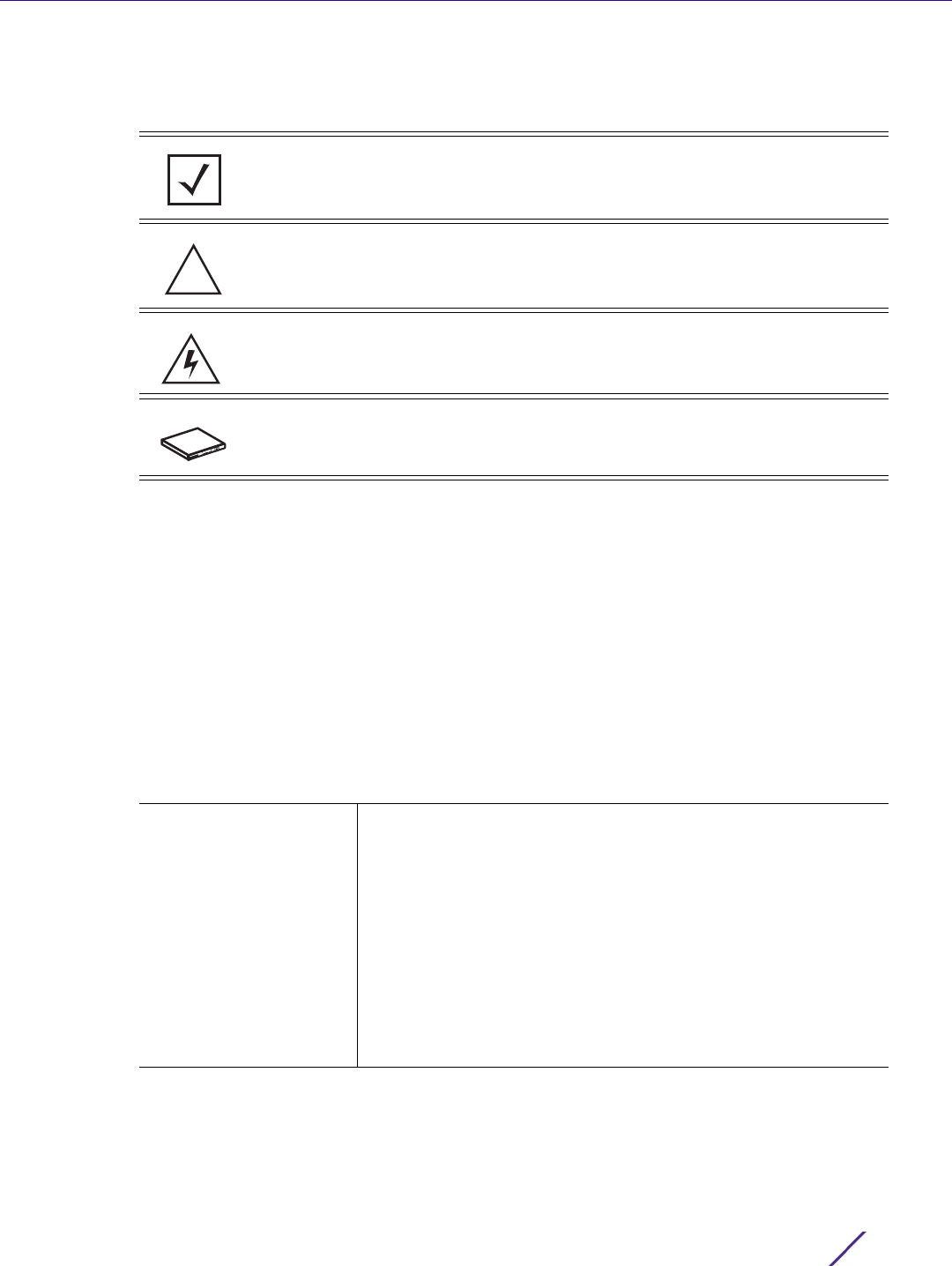
ABOUT THIS GUIDE
Access Point, Wireless Controller and Service Platform CLI Reference Guide ii
Document Conventions
The following conventions are used in this document to draw your attention to important information:
Notational Conventions
The following notational conventions are used in this document:
• Italics are used to highlight specific items in the general text, and to identify chapters and sections
in this and related documents
• Bullets (•) indicate:
- lists of alternatives
- lists of required steps that are not necessarily sequential
-action items
• Sequential lists (those describing step-by-step procedures) appear as numbered lists
Understanding Command Syntax
NOTE: Indicates tips or special requirements.
CAUTION: Indicates conditions that can cause equipment damage or data
loss.
WARNING! Indicates a condition or procedure that could result in personal
injury or equipment damage.
Switch Note: Indicates caveats unique to a RFS4000, RFS6000, NX5500,
NX7500, NX7510, NX7520, NX7530, NX9500, NX9510, or NX9600 model
controller.
<variable> Variables are described with a short description enclosed within a
‘<‘ and a ‘>’ pair.
For example, the command,
nx9500-6C8809>show interface ge 1
is documented as:
show interface ge <1-2>
where:
• show – is the command – displays information
• interface – is the keyword – represents the interface type
• <1-2> – is the variable – represents the ge interface index value
!

ABOUT THIS GUIDE
Access Point, Wireless Controller and Service Platform CLI Reference Guide iii
| The pipe symbol. This is used to separate the variables/keywords
in a list.
For example, the command,
nx9500-6C8809> show .....
is documented as:
show [adoption|bluetooth|bonjour|boot|
......
where:
• show – is the command – displays information
• [adoption|bluetooth|bonjour|boot|.......] – indicates the different
keywords that can be combined with the show command.
However, only one of the above option can be used at a time.
show adoption ...
show bluetooth ...
show bonjour ...
[] Of the different keywords and variables listed inside a ‘[‘ & ‘]’ pair,
only one can be used. Each choice in the list is separated with a ‘|’
(pipe) symbol.
For example, the command,
nx9500-6C8809#clear ...
is documented as:
clear [arp-cache|bonjour|cdp|counters|crypto|
event-history|firewall|gre|ip|ipv6|l2tpv3-
stats|lacp|license|lldp|logging|mac-address-
table|mint|role|rtls|spanning-tree|traffic-
shape|vrrp]
where:
• clear – is the command
• [arp-cache|cdp|bonjour|counters|crypto|event-history|firewall|
gre|ip|ipv6|l2tpv3-stats|lacp|license|lldp|logging|mac-address-
table|mint|role|rtls|spanning-tree|traffic-shape|vrrp] – indicates
that these keywords are available for this command. However,
only one can be used at a time.

ABOUT THIS GUIDE
Access Point, Wireless Controller and Service Platform CLI Reference Guide iv
{ } Any command/keyword/variable or a combination of them inside
a ‘{‘ &‘}’ pair is optional. All optional commands follow the same
conventions as listed above. However, they are displayed italicized.
For example, the command,
nx9500-6C8809> show adoption ....
is documented as:
show adoption info {on <DEVICE-NAME>}
here:
• show adoption info – is the command. This command can also
be used as:
show adoption info
The command can also be extended as:
show adoption info {on <DEVICE-NAME>}
here:
• {on <DEVICE-NAME>} – is the keyword, which is optional.
command / keyword The first word is always a command. Keywords are words that must
be entered as is. Commands and keywords are mandatory.
For example, the command,
nx9500-6C8809>show wireless
is documented as:
show wireless
where:
• show – is the command
• wireless – is the keyword
() Any command/keyword/variable or a combination of them inside
a ‘(‘ & ‘)’ pair are recursive. All recursive commands can be listed in
any order and can be used once along with the rest of the
commands.
For example, the command,
crypto pki export request generate-rsa-key
test autogen-subject-name ...
is documented as:
nx9500-6C8809#crypto pki export request
generate-rsa-key test autogen-subject-name
(<URL>,email <EMAIL>,fqdn <FQDN>,ip-address
<IP>)
here:
• crypto pki export request generate-rsa-key <RSA-KEYPAIR-
NAME> auto-gen-subject-name – is the command
• <RSA-KEYPAIR-NAME> – is the RSA keypair name (in this
example, the keypair name is ‘test’), and is a variable
• (<URL>,email <EMAIL>,fqdn <FQDN>,ip-address <IP>) – is
the set of recursive parameters (separated by commas) that can
be used in any order.

ABOUT THIS GUIDE
Access Point, Wireless Controller and Service Platform CLI Reference Guide v
End-User Software License Agreement
This document is an agreement (“Agreement”) between You, the end user, and Extreme Networks, Inc., on
behalf of itself and its Affiliates (“Extreme”) that sets forth your rights and obligations with respect to the
“Licensed Materials”. BY INSTALLING SOFTWARE AND/OR THE LICENSE KEY FOR THE SOFTWARE
(“License Key”) (collectively, “Licensed Software”), IF APPLICABLE, COPYING, OR OTHERWISE USING THE
LICENSED SOFTWARE AND/OR ANY OF THE LICENSED MATERIALS UNDER THIS AGREEMENT, YOU ARE
AGREEING TO BE BOUND BY THE TERMS OF THIS AGREEMENT, WHICH INCLUDES THE LICENSE(S) AND
THE LIMITATION(S) OF WARRANTY AND DISCLAIMER(S)/LIMITATION(S) OF LIABILITY. IF YOU DO NOT
AGREE TO THE TERMS OF THIS AGREEMENT, RETURN THE LICENSE KEY (IF APPLICABLE) TO EXTREME
OR YOUR DEALER, IF ANY, OR DO NOT USE THE LICENSED SOFTWARE AND/OR LICENSED MATERIALS
AND CONTACT EXTREME OR YOUR DEALER WITHIN TEN (10) DAYS FOLLOWING THE DATE OF RECEIPT
TO ARRANGE FOR A REFUND. IF YOU HAVE ANY QUESTIONS ABOUT THIS AGREEMENT, CONTACT
EXTREME, Attn: LegalTeam@extremenetworks.com.
1 DEFINITIONS. “Affiliates” means any person, partnership, corporation, limited liability company, or other
form of enterprise that directly or indirectly through one or more intermediaries, controls, or is
controlled by, or is under common control with the party specified. “Server Application” means the
software application associated to software authorized for installation (per License Key, if applicable) on
one or more of Your servers as further defined in the Ordering Documentation. “Client Application” shall
refer to the application to access the Server Application. “Network Device” for purposes of this
Agreement shall mean a physical computer device, appliance, appliance component, controller, wireless
access point, or virtual appliance as further described within the applicable product documentation,
which includes the Order Documentation. “Licensed Materials” means the Licensed Software (including
the Server Application and Client Application), Network Device (if applicable), Firmware, media
embodying software, and the accompanying documentation. “Concurrent User” shall refer to any of
Your individual employees who You provide access to the Server Application at any one time.
“Firmware” refers to any software program or code embedded in chips or other media. “Standalone”
software is software licensed for use independent of any hardware purchase as identified in the
Ordering Documentation. “Licensed Software” collectively refers to the software, including Standalone
software, Firmware, Server Application, Client Application or other application licensed with conditional
use parameters as defined in the Ordering Documentation. “Ordering Documentation” shall mean the
applicable price quotation, corresponding purchase order, relevant invoice, order acknowledgement, and
accompanying documentation or specifications for the products and services purchased, acquired or
licensed hereunder from Extreme either directly or indirectly.
2TERM
. This Agreement is effective from the date on which You accept the terms and conditions of this
Agreement via click-through, commence using the products and services or upon delivery of the
License Key if applicable, and shall be effective until terminated. In the case of Licensed Materials
offered on a subscription basis, the term of “licensed use” shall be as defined within Your Ordering
Documentation.
3 GRANT OF LICENSE. Extreme will grant You a non-transferable, non-sublicensable, non-exclusive license
to use the Licensed Materials and the accompanying documentation for Your own business purposes
subject to the terms and conditions of this Agreement, applicable licensing restrictions, and any term,
user server networking device, field of use, or other restrictions as set forth in Your Ordering
Documentation. If the Licensed Materials are being licensed on a subscription and/or capacity basis, the
applicable term and/or capacity limit of the license shall be specified in Your Ordering Documentation.
You may install and use the Licensed Materials as permitted by the license type purchased as described
below in License Types. The license type purchased is specified on the invoice issued to You by Extreme

ABOUT THIS GUIDE
Access Point, Wireless Controller and Service Platform CLI Reference Guide vi
or Your dealer, if any. YOU MAY NOT USE, COPY, OR MODIFY THE LICENSED MATERIALS, IN WHOLE
OR IN PART, EXCEPT AS EXPRESSLY PROVIDED IN THIS AGREEMENT.
4LICENSE TYPES
.
•Single User, Single Network Device. Under the terms of this license type, the license granted to You
by Extreme authorizes You to use the Licensed Materials as bundled with a single Network Device as
identified by a unique serial number for the applicable Term, if and as specified in Your Ordering
Documentation, or any replacement for that network device for that same Term, for internal use only.
A separate license, under a separate License Agreement, is required for any other network device on
which You or another individual, employee or other third party intend to use the Licensed Materials.
A separate license under a separate License Agreement is also required if You wish to use a Client
license (as described below).
•Single User, Multiple Network Device. Under the terms of this license type, the license granted to You
by Extreme authorizes You to use the Licensed Materials with a defined amount of Network Devices
as defined in the Ordering Documentation.
•Client. Under the terms of the Client license, the license granted to You by Extreme will authorize You
to install the License Key for the Licensed Materials on your server and allow the specific number of
Concurrent Users as ordered by you and is set forth in Your Ordering Documentation. A separate
license is required for each additional Concurrent User.
•Standalone. Software or other Licensed Materials licensed to You for use independent of any
Network Device.
•Subscription. Licensed Materials, and inclusive Software, Network Device or related appliance
updates and maintenance services, licensed to You for use during a subscription period as defined in
Your applicable Ordering Documentation.
•Capacity. Under the terms of this license, the license granted to You by Extreme authorizes You to
use the Licensed Materials up to the amount of capacity or usage as defined in the Ordering
Documentation.
5AUDIT RIGHTS
. You agree that Extreme may audit Your use of the Licensed Materials for compliance
with these terms and Your License Type at any time, upon reasonable notice. In the event that such
audit reveals any use of the Licensed Materials by You other than in full compliance with the license
granted and the terms of this Agreement, Extreme reserves the right to charge You for all reasonable
expenses related to such audit in addition to any other liabilities and overages applicable as a result of
such non-compliance, including but not limited to additional fees for Concurrent Users, excess capacity
or usage over and above those specifically granted to You. From time to time, the Licensed Materials
may upload information about the Licensed Materials and the associated usage to Extreme. This is to
verify the Licensed Materials are being used in accordance with a valid license and/or entitlement. By
using the Licensed Materials, you consent to the transmission of this information.
6 RESTRICTION AGAINST COPYING OR MODIFYING LICENSED MATERIALS. Except as expressly
permitted in this Agreement, You may not copy or otherwise reproduce the Licensed Materials. In no
event does the limited copying or reproduction permitted under this Agreement include the right to
decompile, disassemble, electronically transfer, or reverse engineer the Licensed Materials, including the
Licensed Software, or to translate the Licensed Materials into another computer language. The media
embodying the Licensed Materials may be copied by You, in whole or in part, into printed or machine
readable form, in sufficient numbers only for backup or archival purposes, or to replace a worn or
defective copy. However, You agree not to have more than two (2) copies of the Licensed Software in
whole or in part, including the original media, in your possession for said purposes without Extreme’
prior written consent, and in no event shall You operate more copies of the Licensed Software than the
specific licenses granted to You. You may not copy or reproduce the documentation. You agree to
maintain appropriate records of the location of the original media and all copies of the Licensed
Software, in whole or in part, made by You. Any portion of the Licensed Software included in any such
modular work shall be used only on a single computer for internal purposes and shall remain subject to

ABOUT THIS GUIDE
Access Point, Wireless Controller and Service Platform CLI Reference Guide vii
all the terms and conditions of this Agreement. You agree to include any copyright or other proprietary
notice set forth on the label of the media embodying the Licensed Software on any copy of the
Licensed Software in any form, in whole or in part, or on any modification of the Licensed Software or
any such modular work containing the Licensed Software or any part thereof.
7 TITLE AND PROPRIETARY RIGHTS
a The Licensed Materials are copyrighted works and are the sole and exclusive property of Extreme,
any company or a division thereof which Extreme controls or is controlled by, or which may result
from the merger or consolidation with Extreme (its “Affiliates”), and/or their suppliers. This
Agreement conveys a limited right to operate the Licensed Materials and shall not be construed to
convey title to the Licensed Materials to You. There are no implied rights. You shall not sell, lease,
transfer, sublicense, dispose of, or otherwise make available the Licensed Materials or any portion
thereof, to any other party.
b You further acknowledge that in the event of a breach of this Agreement, Extreme shall suffer severe
and irreparable damages for which monetary compensation alone will be inadequate. You therefore
agree that in the event of a breach of this Agreement, Extreme shall be entitled to monetary
damages and its reasonable attorney’s fees and costs in enforcing this Agreement, as well as
injunctive relief to restrain such breach, in addition to any other remedies available to Extreme.
8 PROTECTION AND SECURITY. In the performance of this Agreement or in contemplation thereof, You
and your employees and agents may have access to private or confidential information owned or
controlled by Extreme relating to the Licensed Materials supplied hereunder including, but not limited
to, product specifications and schematics, and such information may contain proprietary details and
disclosures. All information and data so acquired by You or your employees or agents under this
Agreement or in contemplation hereof shall be and shall remain Extreme’ exclusive property, and You
shall use all commercially reasonable efforts to keep, and have your employees and agents keep, any
and all such information and data confidential, and shall not copy, publish, or disclose it to others,
without Extreme’ prior written approval, and shall return such information and data to Extreme at its
request. Nothing herein shall limit your use or dissemination of information not actually derived from
Extreme or of information which has been or subsequently is made public by Extreme, or a third party
having authority to do so.
You agree not to deliver or otherwise make available the Licensed Materials or any part thereof,
including without limitation the object or source code (if provided) of the Licensed Software, to any
party other than Extreme or its employees, except for purposes specifically related to your use of the
Licensed Materials on a single computer as expressly provided in this Agreement, without the prior
written consent of Extreme. You acknowledge that the Licensed Materials contain valuable confidential
information and trade secrets, and that unauthorized use, copying and/or disclosure thereof are
harmful to Extreme or its Affiliates and/or its/their software suppliers.
9 MAINTENANCE AND UPDATES. Except as otherwise defined below, updates and certain maintenance
and support services, if any, shall be provided to You pursuant to the terms of an Extreme Service and
Maintenance Agreement, if Extreme and You enter into such an agreement. Except as specifically set
forth in such agreement, Extreme shall not be under any obligation to provide updates, modifications,
or enhancements, or maintenance and support services for the Licensed Materials to You. If you have
purchased Licensed Materials on a subscription basis then the applicable service terms for Your
Licensed Materials are as provided in Your Ordering Documentation. Extreme will perform the
maintenance and updates in a timely and professional manner, during the Term of Your subscription,
using qualified and experienced personnel. You will cooperate in good faith with Extreme in the
performance of the support services including, but not limited to, providing Extreme with: (a) access to
the Extreme Licensed Materials (and related systems); and (b) reasonably requested assistance and

ABOUT THIS GUIDE
Access Point, Wireless Controller and Service Platform CLI Reference Guide viii
information. Further information about the applicable maintenance and updates terms can be found on
Extreme’s website at http://www.extremenetworks.com/company/legal/terms-of-support
10 DEFAULT AND TERMINATION. In the event that You shall fail to keep, observe, or perform any
obligation under this Agreement, including a failure to pay any sums due to Extreme, or in the event
that you become insolvent or seek protection, voluntarily or involuntarily, under any bankruptcy law,
Extreme may, in addition to any other remedies it may have under law, terminate the License and any
other agreements between Extreme and You.
a Immediately after any termination of the Agreement, Your licensed subscription term, or if You have
for any reason discontinued use of Licensed Materials, You shall return to Extreme the original and
any copies of the Licensed Materials and remove the Licensed Materials, including an Licensed
Software, from any modular works made pursuant to Section 3, and certify in writing that through
your best efforts and to the best of your knowledge the original and all copies of the terminated or
discontinued Licensed Materials have been returned to Extreme.
b Sections 1, 7, 8, 10, 11, 12, 13, 14 and 15 shall survive termination of this Agreement for any reason.
11 EXPORT REQUIREMENTS. You are advised that the Licensed Materials, including the Licensed Software
is of United States origin and subject to United States Export Administration Regulations; diversion
contrary to United States law and regulation is prohibited. You agree not to directly or indirectly export,
import or transmit the Licensed Materials, including the Licensed Software to any country, end user or
for any Use that is prohibited by applicable United States regulation or statute (including but not limited
to those countries embargoed from time to time by the United States government); or contrary to the
laws or regulations of any other governmental entity that has jurisdiction over such export, import,
transmission or Use.
12 UNITED STATES GOVERNMENT RESTRICTED RIGHTS. The Licensed Materials (i) were developed solely
at private expense; (ii) contain “restricted computer software” submitted with restricted rights in
accordance with section 52.227-19 (a) through (d) of the Commercial Computer Software-Restricted
Rights Clause and its successors, and (iii) in all respects is proprietary data belonging to Extreme and/or
its suppliers. For Department of Defense units, the Licensed Materials are considered commercial
computer software in accordance with DFARS section 227.7202-3 and its successors, and use,
duplication, or disclosure by the U.S. Government is subject to restrictions set forth herein.
13 LIMITED WARRANTY AND LIMITATION OF LIABILITY. Extreme warrants to You that (a) the initially-
shipped version of the Licensed Materials will materially conform to the Documentation; and (b) the
media on which the Licensed Software is recorded will be free from material defects for a period of
ninety (90) days from the date of delivery to You or such other minimum period required under
applicable law. Extreme does not warrant that Your use of the Licensed Materials will be error-free or
uninterrupted.
NEITHER EXTREME NOR ITS AFFILIATES MAKE ANY OTHER WARRANTY OR REPRESENTATION,
EXPRESS OR IMPLIED, WITH RESPECT TO THE LICENSED MATERIALS, WHICH ARE LICENSED "AS IS".
THE LIMITED WARRANTY AND REMEDY PROVIDED ABOVE ARE EXCLUSIVE AND IN LIEU OF ALL
OTHER WARRANTIES, INCLUDING IMPLIED WARRANTIES OF MERCHANTABILITY OR FITNESS FOR A
PARTICULAR PURPOSE, WHICH ARE EXPRESSLY DISCLAIMED, AND STATEMENTS OR
REPRESENTATIONS MADE BY ANY OTHER PERSON OR FIRM ARE VOID. IN NO EVENT WILL
EXTREME OR ANY OTHER PARTY WHO HAS BEEN INVOLVED IN THE CREATION, PRODUCTION OR
DELIVERY OF THE LICENSED MATERIALS BE LIABLE FOR SPECIAL, DIRECT, INDIRECT, RELIANCE,
INCIDENTAL OR CONSEQUENTIAL DAMAGES, INCLUDING LOSS OF DATA OR PROFITS OR FOR
INABILITY TO USE THE LICENSED MATERIALS, TO ANY PARTY EVEN IF EXTREME OR SUCH OTHER
PARTY HAS BEEN ADVISED OF THE POSSIBILITY OF SUCH DAMAGES. IN NO EVENT SHALL

ABOUT THIS GUIDE
Access Point, Wireless Controller and Service Platform CLI Reference Guide ix
EXTREME OR SUCH OTHER PARTY'S LIABILITY FOR ANY DAMAGES OR LOSS TO YOU OR ANY
OTHER PARTY EXCEED THE LICENSE FEE YOU PAID FOR THE LICENSED MATERIALS.
Some states do not allow limitations on how long an implied warranty lasts and some states do not
allow the exclusion or limitation of incidental or consequential damages, so the above limitation and
exclusion may not apply to You. This limited warranty gives You specific legal rights, and You may also
have other rights which vary from state to state.
14 JURISDICTION. The rights and obligations of the parties to this Agreement shall be governed and
construed in accordance with the laws and in the State and Federal courts of the State of California,
without regard to its rules with respect to choice of law. You waive any objections to the personal
jurisdiction and venue of such courts. None of the 1980 United Nations Convention on the Limitation
Period in the International Sale of Goods, and the Uniform Computer Information Transactions Act shall
apply to this Agreement.
15 FREE AND OPEN SOURCE SOFTWARE. Portions of the Software (Open Source Software) provided to
you may be subject to a license that permits you to modify these portions and redistribute the
modifications (an Open Source License). Your use, modification and redistribution of the Open Source
Software are governed by the terms and conditions of the applicable Open Source License. More details
regarding the Open Source Software and the applicable Open Source Licenses are available at
www.extremenetworks.com/services/SoftwareLicensing.aspx. Some of the Open Source software may
be subject to the GNU General Public License v.x (GPL) or the Lesser General Public Library (LGPL),
copies of which are provided with the Licensed Materials and are further available for review at
www.extremenetworks.com/services/SoftwareLicensing.aspx, or upon request as directed herein. In
accordance with the terms of the GPL and LGPL, you may request a copy of the relevant source code.
See the Software Licensing web site for additional details. This offer is valid for up to three years from
the date of original download of the software.
16 GENERAL.
a This Agreement is the entire agreement between Extreme and You regarding the Licensed Materials,
and all prior agreements, representations, statements, and undertakings, oral or written, are hereby
expressly superseded and canceled.
b This Agreement may not be changed or amended except in writing signed by both parties hereto.
c You represent that You have full right and/or authorization to enter into this Agreement.
d This Agreement shall not be assignable by You without the express written consent of Extreme. The
rights of Extreme and Your obligations under this Agreement shall inure to the benefit of Extreme’
assignees, licensors, and licensees.
e Section headings are for convenience only and shall not be considered in the interpretation of this
Agreement
f The provisions of the Agreement are severable and if any one or more of the provisions hereof are
judicially determined to be illegal or otherwise unenforceable, in whole or in part, the remaining
provisions of this Agreement shall nevertheless be binding on and enforceable by and between the
parties hereto
g Extreme’s waiver of any right shall not constitute waiver of that right in future. This Agreement
constitutes the entire understanding between the parties with respect to the subject matter hereof,
and all prior agreements, representations, statements and undertakings, oral or written, are hereby
expressly superseded and canceled. No purchase order shall supersede this Agreement.

ABOUT THIS GUIDE
Access Point, Wireless Controller and Service Platform CLI Reference Guide x
h Should You have any questions regarding this Agreement, You may contact Extreme at the address
set forth below. Any notice or other communication to be sent to Extreme must be mailed by
certified mail to the following address:
Extreme Networks, Inc.
16480 Via Del
San Jose, CA 95119 United States
Tel: +1 408-579-2800
Toll-free: +1 888-257-3000

1 - 1
Access Point, Wireless Controller and Service Platform CLI Reference Guide
1
INTRODUCTION
This chapter describes the commands available within a device’s Command Line Interface (CLI) structure.
CLI is available for wireless controllers, access points (APs), and service platforms.
Access the CLI by using:
• A terminal emulation program running on a computer connected to the serial port on the device
(access point, wireless controller, and service platform).
• A Telnet session through Secure Shell (SSH) over a network.
Configuration for connecting to a Controller using a terminal emulator
If connecting through the serial port, use the following settings to configure your terminal emulator:
When a CLI session is established, complete the following (user input is in bold):
login as: <username>
administrator’s login password: <password>
User Credentials
Use the following credentials when logging into a device for the first time:
When logging into the CLI for the first time, you are prompted to change the password.
Examples in this reference guide
Examples used in this reference guide are generic to each supported wireless controller, service platform,
and AP model. Commands that are not common, are identified using the notation “Supported in the
following platforms:” For an example, see below:
Supported in the following platforms:
• Wireless Controller – RFS6000
The above example indicates the command is only available for an RFS6000 model wireless controller.
Bits Per Second 19200
For AP8533, AP8432, AP7662, AP7632, AP7622, AP7612,
AP7602, AP7502, AP7522, AP7532, AP7562, AP6521,
AP6522, AP6532, AP6562 model access points set this
value to 115200.
Data Bits 8
Parity None
Stop Bit 1
Flow Control None
User Name admin
Password admin123
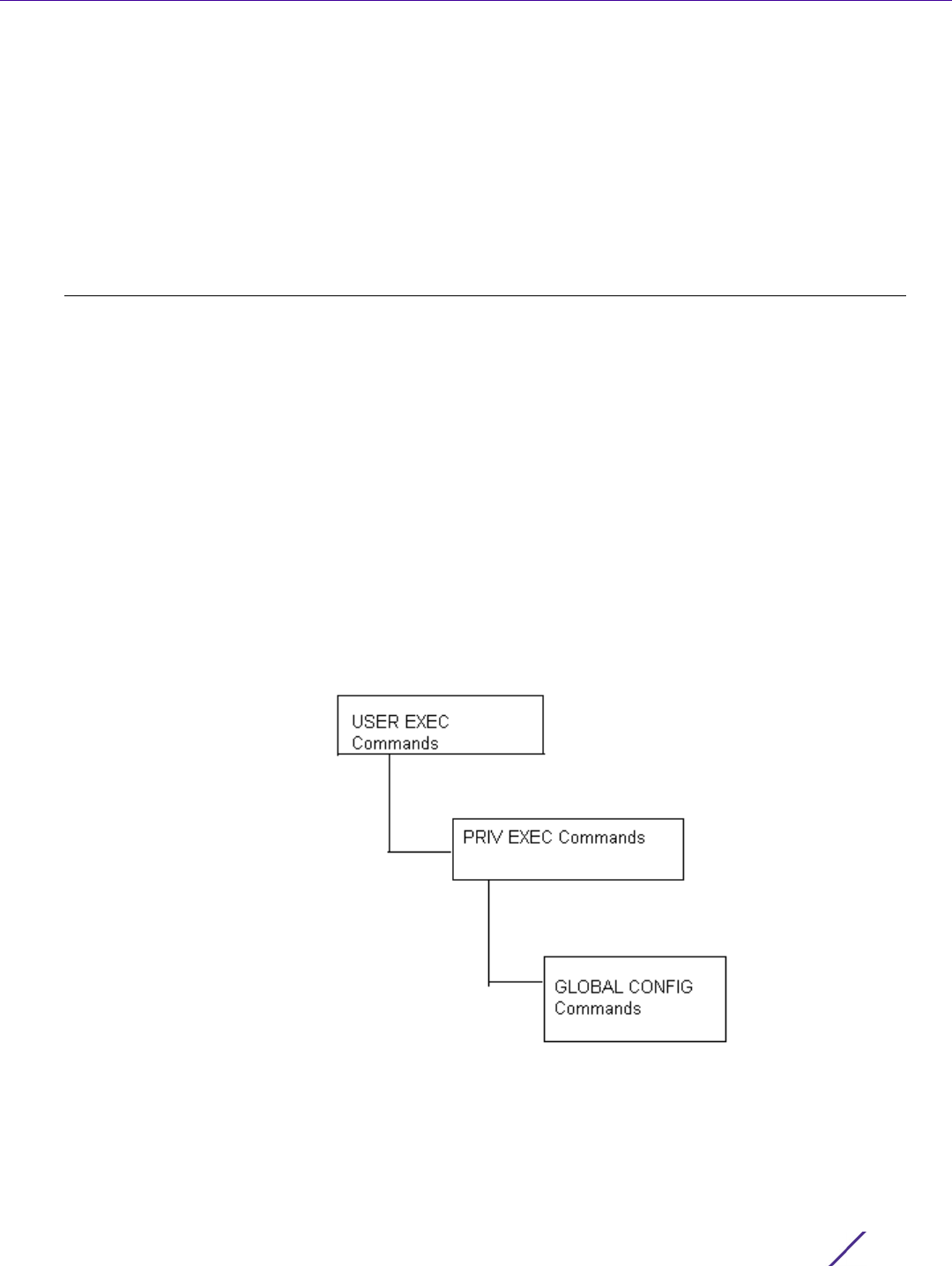
INTRODUCTION
Access Point, Wireless Controller and Service Platform CLI Reference Guide 1 - 2
This chapter is organized into the following sections:
•CLI Overview
•Getting Context Sensitive Help
•Using the No Command
•Using CLI Editing Features and Shortcuts
•Using CLI to Create Profiles and Enable Remote Administration
1.1 CLI Overview
INTRODUCTION
The CLI is used for configuring, monitoring, and maintaining the network. The user interface allows you to
execute commands on supported wireless controllers, service platforms, and APs, using either a serial
console or a remote access method.
This chapter describes basic CLI features. Topics covered include an introduction to command modes,
navigation and editing features, help features and command history.
The CLI is segregated into different command modes. Each mode has its own set of commands for
configuration, maintenance, and monitoring. The commands available at any given time depend on the
mode you are in, and to a lesser extent, the particular model used. Enter a question mark (?) at the system
prompt to view a list of commands available for each command mode/instance.
Use specific commands to navigate from one command mode to another. The standard order is: USER
EXEC mode, PRIV EXEC mode and GLOBAL CONFIG mode.
Figure 1-1 Hierarchy of User Modes
Command Modes
A session generally begins in the USER EXEC mode (one of the two access levels of the EXEC mode). For
security, only a limited subset of EXEC commands are available in the USER EXEC mode. This level is

INTRODUCTION
Access Point, Wireless Controller and Service Platform CLI Reference Guide 1 - 3
reserved for tasks that do not change the device’s (wireless controller, service platform, or AP)
configuration.
rfs6000-6DB5D4>
The system prompt signifies the device name and the last three bytes of the device MAC address.
To access commands, enter the PRIV EXEC mode (the second access level for the EXEC mode). Once in
the PRIV EXEC mode, enter any EXEC command. The PRIV EXEC mode is a superset of the USER EXEC
mode.
rfs6000-6DB5D4>enable
rfs6000-6DB5D4#
Most of the USER EXEC mode commands are one-time commands and are not saved across device
reboots. Save the command by executing ‘commit’ command. For example, the show command displays
the current configuration and the clear command clears the interface.
Access the GLOBAL CONFIG mode from the PRIV EXEC mode. In the GLOBAL CONFIG mode, enter
commands that set general system characteristics. Configuration modes, allow you to change the running
configuration. If you save the configuration later, these commands are stored across device reboots.
Access a variety of protocol specific (or feature-specific) modes from the global configuration mode. The
CLI hierarchy requires you to access specific configuration modes only through the global configuration
mode.
rfs6000-6DB5D4#configure terminal
Enter configuration commands, one per line. End with CNTL/Z.
rfs6000-6DB5D4(config)#
You can also access sub-modes from the global configuration mode. Configuration sub-modes define
specific features within the context of a configuration mode.
rfs6000-6DB5D4(config)#aaa-policy test
rfs6000-6DB5D4(config-aaa-policy-test)#
The following table summarizes available CLI commands:
Table 1.1 Controller CLI Modes and Commands
User Exec Mode Priv Exec Mode Global Configuration Mode
captive-portal-page-upload archive aaa-policy
change-passwd boot aaa-tacacs-policy
clear captive-portal-page-upload alias
clock cd ap6521
cluster change-passwd ap6522
commit clear ap6532
connect clock ap6562
create-cluster cluster ap7161
crypto commit ap7502
crypto-cmp-cert-update configure ap7522
database connect ap7532
database-backup copy ap7562

INTRODUCTION
Access Point, Wireless Controller and Service Platform CLI Reference Guide 1 - 4
database-restore cpe (RFS4000, RFS6000, NX9500,
NX9600, VX9000)
ap7602
debug create-cluster ap7612
device-upgrade crypto ap7622
disable crypto-cmp-cert-update ap7632
enable database ap7662
file-sync database-backup ap81xx (ap8122, ap8132, ap8163)
help database-restore ap8232
join-cluster debug ap8432
l2tpv3 delete ap8533
logging device-upgrade application
mint diff application-group
no dir application-policy
on disable association-acl-policy
opendns edit auto-provisioning-policy
page enable bgp
ping erase bonjour-gw-discovery-policy
ping6 ex3500 bonjour-gw-forwarding-policy
revert factory-reset bonjour-gw-query-forwarding-
policy
service file-sync captive-portal
show halt clear
ssh help client-identity
telnet join-cluster client-identity-group
terminal l2tpv3 clone
time-it logging crypto-cmp-policy
traceroute mint customize
traceroute6 mkdir database-client-policy (supported
only on VX9000
virtual-machine (supported only
on NX9500, NX9600, and
VX9000)
more database-policy (supported only
on NX9500, NX9600, and
VX9000)
watch no device
write on device-categorization
clrscr opendns dhcp-server-policy
exit page dhcp6-server-policy
ping dns-whitelist
ping6 event-system-policy
Table 1.1 Controller CLI Modes and Commands
User Exec Mode Priv Exec Mode Global Configuration Mode

INTRODUCTION
Access Point, Wireless Controller and Service Platform CLI Reference Guide 1 - 5
pwd ex3500
raid (supported only on NX9500 and
NX7530)
ex3500-management-policy
re-elect ex3500-qos-class-map-policy
reload ex3500-qos-policy-map
remote-debug ex3524
rename ex3548
revert firewall-policy
rmdir global-association-list
self guest-management
service help
show host
ssh igmp-snoop-policy (This
command has been deprecated.
IGMP snooping is now
configurable under the profile/
device configuration mode. For
more information, see ip.
t5 (supported only on RFS4000,
RFS6000, NX9500, NX9600, and
VX9000)
inline-password-encryption
telnet ip
terminal ipv6
time-it ipv6-router-advertisement-policy
traceroute l2tpv3
traceroute6 mac
upgrade management-policy
upgrade-abort meshpoint
virtual-machine (supported only on
NX9500, NX9600, and VX9000)
meshpoint-qos-policy
watch mint-policy
write nac-list
clrscr no
exit nsight-policy
nx5500 (supported only on
NX9500, NX9600, VX9000)
nx75xx (supported only on
NX9500, NX9600, VX9000)
nx9000 (supported only on
NX9500, NX9600, VX9000)
Table 1.1 Controller CLI Modes and Commands
User Exec Mode Priv Exec Mode Global Configuration Mode

INTRODUCTION
Access Point, Wireless Controller and Service Platform CLI Reference Guide 1 - 6
nx9600 (supported only on
NX9600)
passpoint-policy
password-encryption
profile
radio-qos-policy
radius-group
radius-server-policy
radius-user-pool-policy
rename
replace
rf-domain
rfs4000
rfs6000
roaming-assist-policy
role-policy
route-map
routing-policy
rtl-server-policy
schedule-policy
self
sensor-policy
smart-rf-policy
t5 (supported only on RFS4000,
RFS6000, NX9500, NX9600,
VX9000)
url-filter (supported only on
NX9500, NX9600, VX9000)
url-list (supported only on
NX9500, NX9600, VX9000)
vx9000 (supported only on
NX9500, and NX9600, VX9000)
web-filter-policy
wips-policy
wlan
wlan-qos-policy
write
clrscr
Table 1.1 Controller CLI Modes and Commands
User Exec Mode Priv Exec Mode Global Configuration Mode
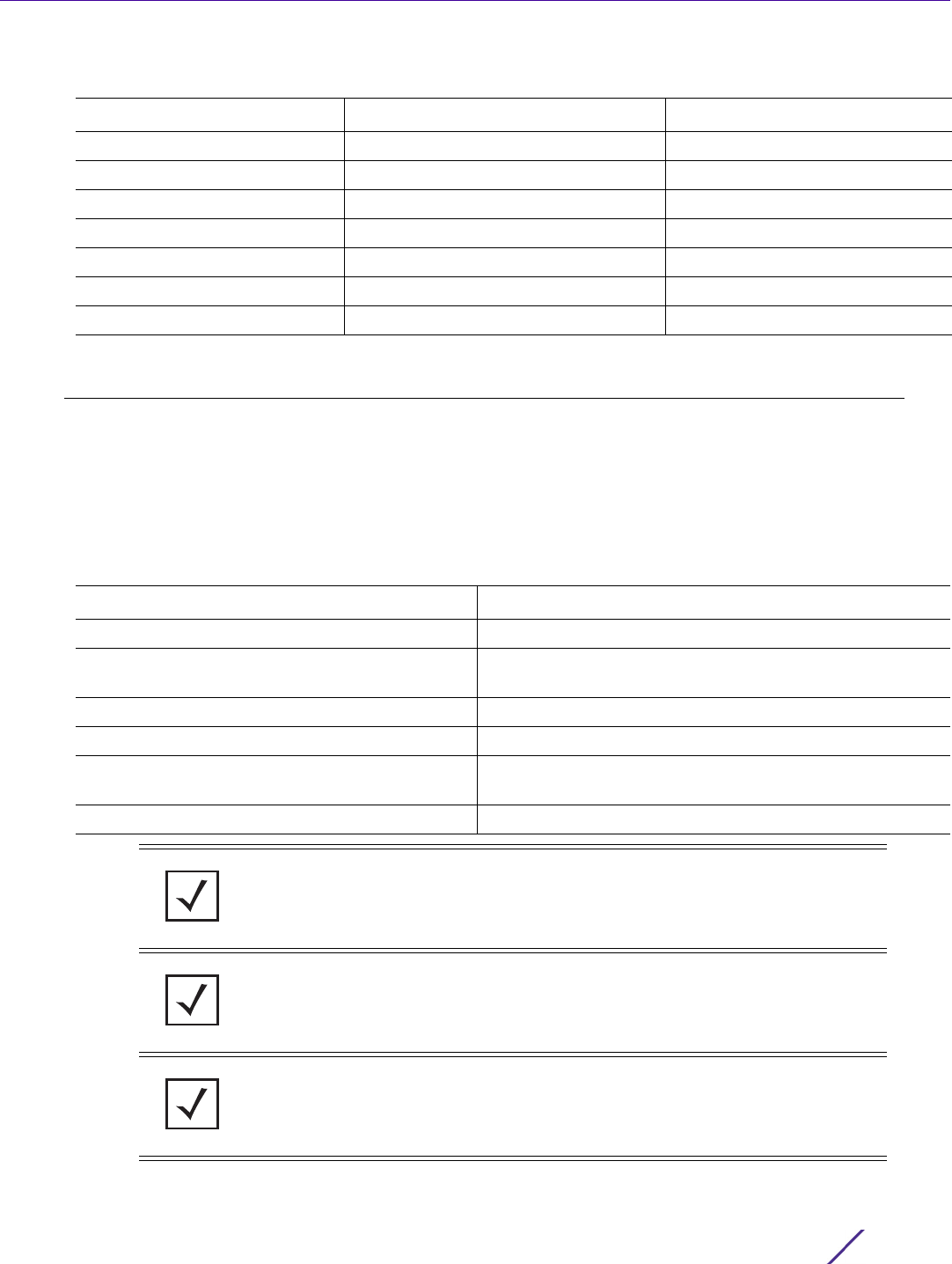
INTRODUCTION
Access Point, Wireless Controller and Service Platform CLI Reference Guide 1 - 7
1.2 Getting Context Sensitive Help
INTRODUCTION
Enter a question mark (?) at the system prompt to display a list of commands available for each mode.
Obtain a list of arguments and keywords for any command using the CLI context-sensitive help.
Use the following commands to obtain help specific to a command mode, command name, keyword or
argument:
commit
do
end
exit
revert
service
show
Table 1.1 Controller CLI Modes and Commands
User Exec Mode Priv Exec Mode Global Configuration Mode
Command Description
(prompt)#help Displays a brief description of the help system
(prompt)#abbreviated-command-entry? Lists commands in the current mode that begin with a
particular character string
(prompt)#abbreviated-command-entry[TAB] Completes a partial command name
(prompt)#? Lists all commands available in the command mode
(prompt)#command ? Lists the available syntax options (arguments and
keywords) for the command
(prompt)#command keyword ? Lists the next available syntax option for the command
NOTE: The system prompt varies depending on the configuration mode.
NOTE: Enter Ctrl + V to use ? as a regular character and not as a character
used for displaying context sensitive help. This is required when the user has
to enter a URL that ends with a ?
NOTE: The escape character used through out the CLI is “\”. To enter a "\"
use "\\" instead.

INTRODUCTION
Access Point, Wireless Controller and Service Platform CLI Reference Guide 1 - 8
When using context-sensitive help, the space (or lack of a space) before the question mark (?) is
significant. To obtain a list of commands that begin with a particular sequence, enter the characters
followed by a question mark (?). Do not include a space. This form of help is called word help, because it
completes a word.
rfs6000-6DB5D4#service?
service Service Commands
rfs6000-6DB5D4#service
Enter a question mark (?) (in place of a keyword or argument) to list keywords or arguments. Include a
space before the “?”. This form of help is called command syntax help. It shows the keywords or arguments
available based on the command/keyword and argument already entered.
rfs6000-6DB5D4#service ?
block-adopter-config-update Block configuration updates from the
bluetooth Bluetooth service commands
clear Clear adoption history
cli-tables-skin Choose a formatting layout/skin for CLI
tabular outputs (EXPERIMENTAL-Applies only
to certain commands)
cluster Cluster Protocol
copy Copy files or directories
delete Delete sessions
delete-offline-aps Delete Access Points that are configured
but offline
force-send-config Resend configuration to the device
force-update-vm-stats Force VM statistics to be pushed up to the
NOC
load-balancing Wireless load-balancing service commands
load-ssh-authorized-keys Load Ssh authorized keys
locator Enable leds flashing on the device
mint MiNT protocol
pktcap Start packet capture
pm Process Monitor
radio Radio parameters
radius Radius test
request-full-config-from-adopter Request full configuration from the
adopter
set Set global options
show Show running system information
signal Send a signal to a process
smart-rf Smart-RF Management Commands
snmp Snmp
ssm Command related to ssm
start-shell Provide shell access
syslog Syslog service
trace Trace a process for system calls and
signals
troubleshoot Troubleshooting
wireless Wireless commands
rfs6000-6DB5D4#
It is possible to abbreviate commands and keywords to allow a unique abbreviation. For example,
“configure terminal” can be abbreviated as config t. Since the abbreviated command is unique, the
controller accepts the abbreviation and executes the command.
Enter the help command (available in any command mode) to provide the following description:
rfs6000-6DB5D4>help
When using the CLI, help is provided at the command line when typing '?'. If no
help is available, the help content will be empty. Backup until entering a '?'
shows the help content.
There are two styles of help provided:
1. Full help. Available when entering a command argument (e.g. 'show ?'). This will

INTRODUCTION
Access Point, Wireless Controller and Service Platform CLI Reference Guide 1 - 9
describe each possible argument.
2. Partial help. Available when an abbreviated argument is entered. This will
display which arguments match the input (e.g. 'show ve?').
rfs6000-6DB5D4>
1.3 Using the No Command
INTRODUCTION
Almost every command has a no form. Use no to disable a feature or function or return it to its default.
Use the command without the no keyword to re-enable a disabled feature.
1.3.1 Basic Conventions
Keep the following conventions in mind while working within the CLI structure:
• Use “?” at the end of a command to display the sub-modes (keywords) associated with the
command. Type the first few characters of the required sub-mode and press the tab key to auto-fill.
Continue using “?” until you reach the last sub-mode.
• Pre-defined CLI commands and keywords are case-insensitive: cfg = Cfg = CFG. However (for
clarity), CLI commands and keywords are displayed (in this guide) using mixed case. For example,
apPolicy, trapHosts, channelInfo.
• Enter commands in uppercase, lowercase, or mixed case. Only passwords are case sensitive.
1.4 Using CLI Editing Features and Shortcuts
INTRODUCTION
A variety of shortcuts and edit features are available. The following sections describe these features:
•Moving the Cursor on the Command Line
•Completing a Partial Command Name
•Command Output Pagination

INTRODUCTION
Access Point, Wireless Controller and Service Platform CLI Reference Guide 1 - 10
1.4.1 Moving the Cursor on the Command Line
Using CLI Editing Features and Shortcuts
The following table shows the key combinations or sequences to move the command line cursor. Ctrl
defines the control key, which must be pressed simultaneously with its associated letter key. Esc means the
escape key (which must be pressed first), followed by its associated letter key. Keys are not case sensitive.
Specific letters are used to provide an easy way of remembering their functions.
1.4.2 Completing a Partial Command Name
Using CLI Editing Features and Shortcuts
If you cannot remember a command name (or if you want to reduce the amount of typing you have to
perform), enter the first few letters of a command, then press the Tab key. The command line parser
completes the command if the string entered is unique to the command mode. If your keyboard does not
have a Tab key, press Ctrl-L.
Table 1.2 Keystrokes Details
Keystrokes Function Summary Function Details
Left Arrow
or
Ctrl-B
Back character Moves the cursor one character to the left
When entering a command that extends beyond a
single line, press the Left Arrow or Ctrl-B keys
repeatedly to move back to the system prompt.
Right Arrow or Ctrl-F Forward character Moves the cursor one character to the right
Esc- B Back word Moves the cursor back one word
Esc- F Forward word Moves the cursor forward one word
Ctrl-A Beginning of line Moves the cursor to the beginning of the command
line
Ctrl-E End of line Moves the cursor to the end of the command line
Ctrl-D Deletes the current character
Ctrl-U Deletes text up to cursor
Ctrl-K Deletes from the cursor to end of the line
Ctrl-P Obtains the prior command from memory
Ctrl-N Obtains the next command from memory
Esc-C Converts the letter at the cursor to uppercase
Esc-L Converts the letter at the cursor to lowercase
Esc-D Deletes the remainder of a word
Ctrl-W Deletes the word up to the cursor
Ctrl-Z Returns to the root prompt
Ctrl-T Transposes the character to the left of the cursor
with the character located at the cursor
Ctrl-L Clears the screen
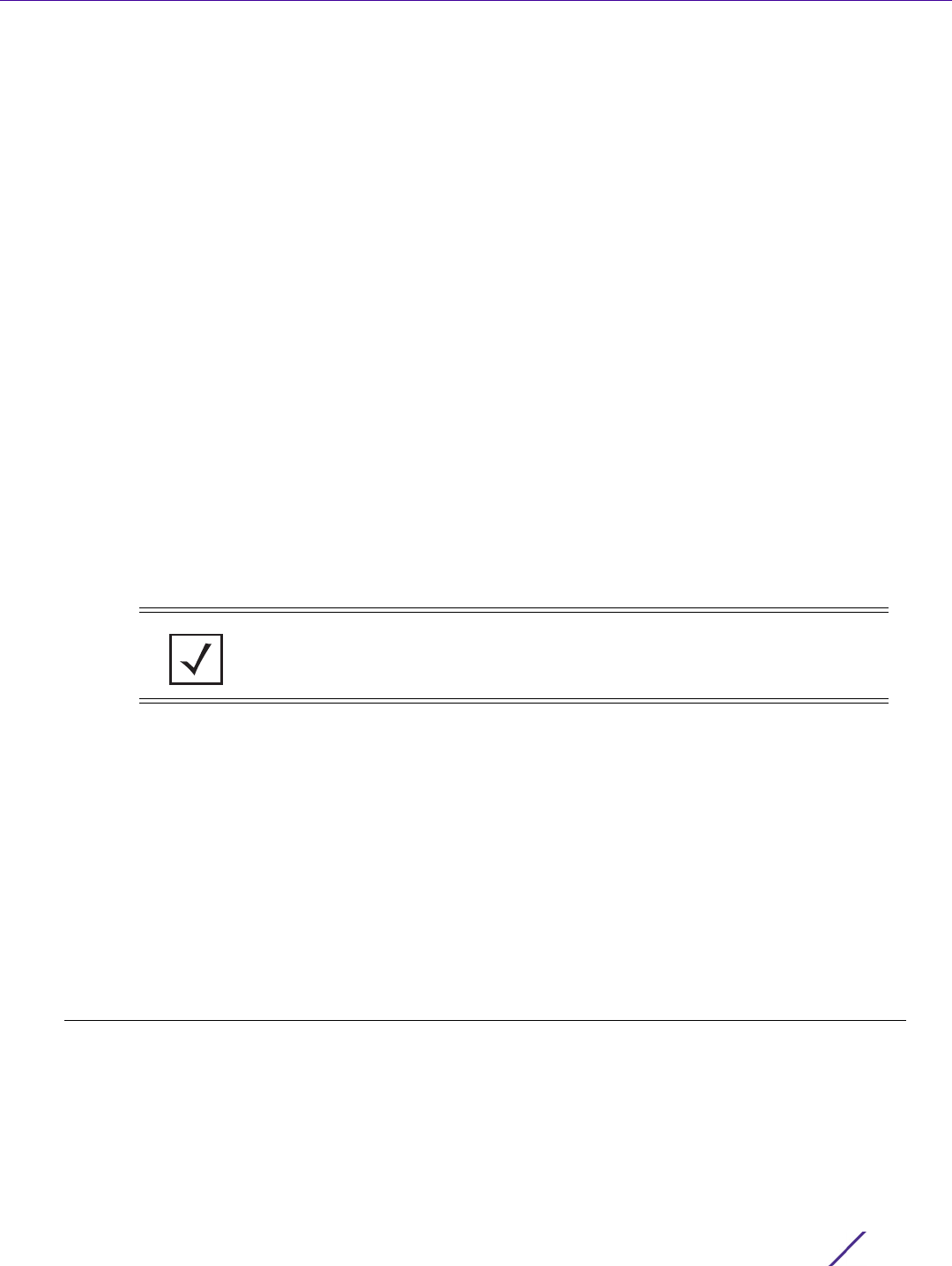
INTRODUCTION
Access Point, Wireless Controller and Service Platform CLI Reference Guide 1 - 11
The CLI recognizes a command once you have entered enough characters to make the command unique. If
you enter “conf” within the privileged EXEC mode, the CLI associates the entry with the configure
command, since only the configure command begins with conf.
In the following example, the CLI recognizes a unique string in the privileged EXEC mode when the Tab key
is pressed:
rfs6000-6DB5D4#conf[TAB]
rfs6000-6DB5D4#configure
When using the command completion feature, the CLI displays the full command name. The command is
not executed until the [Return] or [Enter] key is pressed. Modify the command if the full command was not
what you intended in the abbreviation. If entering a set of characters (indicating more than one command),
the system lists all commands beginning with that set of characters.
Enter a question mark (?) to obtain a list of commands beginning with a particular set of characters. Do
not leave a space between the last letter and the question mark (?).
In the following example, all commands, available in the current context, starting with the characters ‘co’
are listed:
rfs6000-6DB5D4#co?
commit Commit all changes made in this session
configure Enter configuration mode
connect Open a console connection to a remote device
copy Copy from one file to another
rfs6000-6DB5D4#
1.4.3 Command Output Pagination
Using CLI Editing Features and Shortcuts
Output often extends beyond the visible screen length. For cases where output continues beyond the
screen, the output is paused and a
--More--
prompt displays at the bottom of the screen. To resume the output, press the [Enter] key to scroll down
one line or press the Spacebar to display the next full screen of output.
1.5 Using CLI to Create Profiles and Enable Remote
Administration
INTRODUCTION
The following sections describe the following essential procedures:
•Creating Profiles
•Changing the default profile by creating vlan 150 and mapping to ge3 Physical interface
•Enabling Remote Administration
NOTE: The characters entered before the question mark are reprinted to the
screen to complete the command entry.

INTRODUCTION
Access Point, Wireless Controller and Service Platform CLI Reference Guide 1 - 12
1.5.1 Creating Profiles
Using CLI to Create Profiles and Enable Remote Administration
Profiles are sort of a ‘template’ representation of configuration. The system has:
• a default profile for each of the following devices:
- RFS4000, RFS6000
• a default profile for each of the following service platforms:
- NX5500, NX7500, NX7510, NX7520, NX7530, NX9500, NX9510, NX9600, VX9000
• a default profile for each of the following access points:
- AP6521, AP6522, AP6532, AP6562, AP7161, AP7502, AP7522, AP7532, AP7562, AP7602, AP7612,
AP7622, AP7632, AP7662, AP81XX, AP8232, AP8432, AP8533
You can modify a default profile. In the following example, an IP address is assigned to the management
port on the default RFS6000 profile.
rfs6000-6DB5D4(config)#profile rfs6000 default-rfs6000
rfs6000-6DB5D4(config-profile-default-rfs6000)#interface me1
rfs6000-6DB5D4(config-profile-default-rfs6000-if-me1)#ip address 172.16.10.2/24
rfs6000-6DB5D4(config-profile-default-rfs6000-if-me1)#commit
rfs6000-6DB5D4(config-profile-default-rfs6000)#exit
rfs6000-6DB5D4(config)#
The following command displays a default AP7562 profile configuration:
rfs6000-6DB5D4(config-profile-default-ap7562)#
rfs6000-6DB5D4(config-profile-default-ap7562)#show context
profile ap7562 default-ap7562
autoinstall configuration
autoinstall firmware
crypto ikev1 policy ikev1-default
isakmp-proposal default encryption aes-256 group 2 hash sha
crypto ikev2 policy ikev2-default
isakmp-proposal default encryption aes-256 group 2 hash sha
crypto ipsec transform-set default esp-aes-256 esp-sha-hmac
crypto ikev1 remote-vpn
crypto ikev2 remote-vpn
crypto auto-ipsec-secure
crypto load-management
crypto remote-vpn-client
interface radio1
placement outdoor
interface radio2
placement outdoor
interface ge1
interface ge2
interface vlan1
ip address dhcp
ip address zeroconf secondary
ip dhcp client request options all
--More--
rfs6000-6DB5D4(config-profile-default-ap7562)#

INTRODUCTION
Access Point, Wireless Controller and Service Platform CLI Reference Guide 1 - 13
1.5.2 Changing the default profile by creating vlan 150 and mapping to ge3 Physical
interface
Using CLI to Create Profiles and Enable Remote Administration
Logon to the controller in config mode and follow the procedure below:
rfs6000-6DB5D4(config-profile-default-rfs6000)#interface vlan 150
rfs6000-6DB5D4(config-profile-default-rfs6000-if-vlan150)#ip address
192.168.150.20/24
rfs6000-6DB5D4(config-profile-default-rfs6000-if-vlan150)#exit
rfs6000-6DB5D4(config-profile-default-rfs6000)#interface ge 3
rfs6000-6DB5D4(config-profile-default-rfs6000-if-ge3)#switchport access vlan 150
rfs6000-6DB5D4(config-profile-default-rfs6000-if-ge3)#commit write
Please Wait .
[OK]
rfs6000-6DB5D4(config-profile-default-rfs6000-if-ge3)#
rfs6000-6DB5D4(config-profile-default-rfs6000-if-ge3)#show interface vlan 150
Interface vlan150 is UP
Hardware-type: vlan, Mode: Layer 3, Address: 00-15-70-81-74-2D
Index: 6, Metric: 1, MTU: 1500
IP-Address: 192.168.150.20/24
input packets 0, bytes 0, dropped 0, multicast packets 0
input errors 0, length 0, overrun 0, CRC 0, frame 0, fifo 0, missed 0
output packets 2, bytes 140, dropped 0
output errors 0, aborted 0, carrier 0, fifo 0, heartbeat 0, window 0
collisions 0
IPv6 mode is disabled
rfs6000-6DB5D4(config-profile-default-rfs6000-if-ge3)#
1.5.2.1 Viewing Configured APs
To view previously configured APs, enter the following command:
rfs6000-6DB5D4>show wireless ap configured
--------------------------------------------------------------------------------
IDX NAME MAC PROFILE RF-DOMAIN ADOPTED-BY
--------------------------------------------------------------------------------
1 ap7532-80C2AC 84-24-8D-80-C2-AC default-ap7532 TechPubs 00-15-70-81-74-2D
2 ap8132-74B45C B4-C7-99-74-B4-5C default-ap81xx TechPubs 00-15-70-81-74-2D
3 ap7522-8330A4 84-24-8D-83-30-A4 default-ap7522 default 00-15-70-81-74-2D
4 ap8132-711728 B4-C7-99-71-17-28 default-ap81xx TechPubs 00-15-70-81-74-2D
5 ap8533-9A12DB 74-67-F7-9A-12-DB default-ap8533 default un-adopted
6 ap7562-84A224 84-24-8D-84-A2-24 default-ap7562 TechPubs 00-15-70-81-74-2D
--------------------------------------------------------------------------------
rfs6000-6DB5D4>

INTRODUCTION
Access Point, Wireless Controller and Service Platform CLI Reference Guide 1 - 14
1.5.3 Enabling Remote Administration
Using CLI to Create Profiles and Enable Remote Administration
A terminal server may function in remote administration mode if either the terminal services role is not
installed on the machine or the client used to invoke the session has enabled the admin controller.
• A terminal emulation program running on a computer connected to the serial port on the
controller. The serial port is located on the front of the controller.
• A Telnet session through a Secure Shell (SSH) over a network. The Telnet session may or may not
use SSH depending on how the controller is configured. It is recommended you use SSH for remote
administration tasks.
This section is organized into the following sub sections:
•Configuring Telnet for Management Access
•Configuring SSH for Management Access
1.5.3.1 Configuring Telnet for Management Access
Enabling Remote Administration
To enable Telnet for management access, use the serial console to login to the device and perform the
following:
1 The session, by default, opens in the USER EXEC mode (one of the two access levels of the EXEC
mode). Access the PRIV EXEC mode from the USER EXEC mode.
rfs6000-6DB5D4>en
rfs6000-6DB5D4#
2 Access the GLOBAL CONFIG mode from the PRIV EXEC mode.
rfs6000-6DB5D4>en
rfs6000-6DB5D4#configure terminal
Enter configuration commands, one per line. End with CNTL/Z.
rfs6000-6DB5D4(config)#
3 Go to ‘default-management-policy’ mode.
rfs6000-6DB5D4(config)#management-policy ?
MANAGEMENT Name of the management policy to be configured (will be created
if it does not exist)
rfs6000-6DB5D4(config)#management-policy default
rfs6000-6DB5D4(config-management-policy-default)#
4 Enter Telnet and the port number at the command prompt. Note, the port number is optional. If you do
not specify the port, the system, by default, assigns port 23 for Telnet. Commit your changes. Telnet is
enabled.
rfs6000-6DB5D4(config-management-policy-default)#telnet
rfs6000-6DB5D4(config-management-policy-default)#commit write
rfs6000-6DB5D4(config-management-policy-default)#end
rfs6000-6DB5D4#exit
5 Connect to the controller through Telnet using its configured IP address. If logging in for the first time,
use the following credentials:
At the first-time login instance, you will be prompted to change the password. Set a new password.
User Name admin
Password admin123

INTRODUCTION
Access Point, Wireless Controller and Service Platform CLI Reference Guide 1 - 15
6 On subsequent logins, to change the password, access the default management-policy configuration
mode and enter the username, new password, role, and access details.
rfs6000-6DB5D4(config-management-policy-default)#user testuser password test@123
role helpdesk access all
rfs6000-6DB5D4(config-management-policy-default)#commit
rfs6000-6DB5D4(config-management-policy-default)#show context
management-policy default
telnet
http server
https server
no ftp
ssh
user admin password 1
fd07f19c6caf46e5b7963a802d422a708ad39a24906e04667c8642299c8462f1 role superuser
access all
user testuser password 1
32472f01757293a181738674bdf068ffe0b777ce145524fc669278820ab582c0 role helpdesk
access all
snmp-server community 2 uktRccdr9eLoByF5PCSuFAAAAAeB78WhgTbSKDi96msyUiW+ rw
snmp-server community 2 Ne+R15zlwEdhybKxfbd6JwAAAAZzvrLGzU/xWXgwFtwF5JdD ro
snmp-server user snmptrap v3 encrypted des auth md5 2 WUTBNiUi7tL4ZbU2I7Eh/
QAAAAiDhBZTln0UIu+y/W6E/0tR
snmp-server user snmpmanager v3 encrypted des auth md5 2 9Fva4fYV1WL4ZbU2I7Eh/
QAAAAjdvbWANBNw+We/xHkH9kLi
no https use-secure-ciphers-only
rfs6000-6DB5D4(config-management-policy-default)#
7 Logon to the Telnet console and provide the user details configured in the previous step to access the
controller.
rfs6000 release 5.9.1.0-015D
rfs6000-6DB5D4 login: testuser
Password:
Welcome to CLI
Starting CLI...
rfs6000-6DB5D4>
1.5.3.2 Configuring SSH for Management Access
Enabling Remote Administration
By default, SSH is enabled from the factory settings on the controller. The controller requires an IP address
and login credentials.
To enable SSH access on a device, login through the serial console and perform the following:
1 The session, by default, opens in the USER EXEC mode (one of the two access levels of the EXEC
mode). Access the PRIV EXEC mode from the USER EXEC mode.
rfs6000-6DB5D4>en
rfs6000-6DB5D4#
2 Access the GLOBAL CONFIG mode from the PRIV EXEC mode.
rfs6000-6DB5D4>en
rfs6000-6DB5D4#configure terminal
Enter configuration commands, one per line. End with CNTL/Z.
rfs6000-6DB5D4(config)#
3 Go to ‘default-management-policy’ mode.
rfs6000-6DB5D4(config)#management-policy ?
MANAGEMENT Name of the management policy to be configured (will be created
if it does not exist)
rfs6000-6DB5D4(config)#management-policy default
rfs6000-6DB5D4(config-management-policy-default)#

INTRODUCTION
Access Point, Wireless Controller and Service Platform CLI Reference Guide 1 - 16
4 Enter SSH at the command prompt.
rfs6000-6DB5D4(config-management-policy-default)#ssh
rfs6000-6DB5D4(config-management-policy-default)#commit write
rfs6000-6DB5D4(config-management-policy-default)#end
rfs6000-6DB5D4#exit
5 Connect to the controller through SSH using its configured IP address. If logging in for the first time, use
the following credentials:
At the first-time login instance, you will be prompted to change the password. Set a new password.
6 On subsequent logins, to change the password, access the default management-policy configuration
mode and enter the username, new password, role, and access details.
rfs6000-6DB5D4(config-management-policy-default)#user testuser password test@123
role helpdesk access all
rfs6000-6DB5D4(config-management-policy-default)#commit
rfs6000-6DB5D4(config-management-policy-default)#show context
management-policy default
telnet
http server
https server
no ftp
ssh
user admin password 1
fd07f19c6caf46e5b7963a802d422a708ad39a24906e04667c8642299c8462f1 role superuser
access all
user testuser password 1
32472f01757293a181738674bdf068ffe0b777ce145524fc669278820ab582c0 role helpdesk
access all
snmp-server community 2 uktRccdr9eLoByF5PCSuFAAAAAeB78WhgTbSKDi96msyUiW+ rw
snmp-server community 2 Ne+R15zlwEdhybKxfbd6JwAAAAZzvrLGzU/xWXgwFtwF5JdD ro
snmp-server user snmptrap v3 encrypted des auth md5 2 WUTBNiUi7tL4ZbU2I7Eh/
QAAAAiDhBZTln0UIu+y/W6E/0tR
snmp-server user snmpmanager v3 encrypted des auth md5 2 9Fva4fYV1WL4ZbU2I7Eh/
QAAAAjdvbWANBNw+We/xHkH9kLi
no https use-secure-ciphers-only
rfs6000-6DB5D4(config-management-policy-default)#
7 Logon to the SSH console and provide the user details configured in the previous step to access the
controller.
rfs6000 release 5.9.1.0-015D
rfs6000-6DB5D4 login: testuser
Password:
Welcome to CLI
Starting CLI...
rfs6000-6DB5D4>
User Name admin
Password admin123

2 - 1
Access Point, Wireless Controller and Service Platform CLI Reference Guide
2
USER EXEC MODE COMMANDS
Logging in to the wireless controller places you within the USER EXEC command mode. Typically, a login
requires a user name and password. You have three login attempts before the connection attempt is
refused. USER EXEC commands (available at the user level) are a subset of the commands available at the
privileged level. In general, USER EXEC commands allow you to connect to remote devices, perform basic
tests, and list system information.
To list available USER EXEC commands, use ? at the command prompt. The USER EXEC prompt consists of
the device host name followed by an angle bracket (>).
<DEVICE>>?
Command commands:
captive-portal-page-upload Captive portal internal and advanced page upload
change-passwd Change password
clear Clear
clock Configure software system clock
cluster Cluster commands
commit Commit all changes made in this session
connect Open a console connection to a remote device
create-cluster Create a cluster
crypto Encryption related commands
crypto-cmp-cert-update Update the cmp certs
database Database
database-backup Backup database
database-restore Restore database
debug Debugging functions
device-upgrade Device firmware upgrade
disable Turn off privileged mode command
enable Turn on privileged mode command
file-sync File sync between controller and adoptees
help Description of the interactive help system
join-cluster Join the cluster
l2tpv3 L2tpv3 protocol
logging Modify message logging facilities
mint MiNT protocol
no Negate a command or set its defaults
on On RF-Domain
opendns OpenDNS configuration
page Toggle paging
ping Send ICMP echo messages
ping6 Send ICMPv6 echo messages
revert Revert changes
service Service Commands
show Show running system information
ssh Open an ssh connection
telnet Open a telnet connection
terminal Set terminal line parameters
time-it Check how long a particular command took between
request and completion of response
traceroute Trace route to destination
traceroute6 Trace route to destination(IPv6)
virtual-machine Virtual Machine
watch Repeat the specific CLI command at a periodic
interval
write Write running configuration to memory or
terminal
clrscr Clears the display screen
exit Exit from the CLI
<DEVICE>>

USER EXEC MODE COMMANDS
Access Point, Wireless Controller and Service Platform CLI Reference Guide 2 - 2
2.1 User Exec Commands
USER EXEC MODE COMMANDS
The following table summarizes the User Exec Mode commands:
Table 2.1 User Exec Mode Commands
Command Description Reference
captive-portal-
page-upload
Uploads captive portal advanced pages to adopted access points page 2-4
change-passwd Changes the password of a logged user page 2-8
clear Resets the last saved command page 2-9
clock Configures the system clock page 2-20
cluster Accesses the cluster context page 2-21
connect Establishes a console connection to a remote device page 2-22
create-cluster Creates a new cluster on a specified device page 2-23
crypto Enables encryption and configures encryption related parameters page 2-24
crypto-cmp-
cert-update
Triggers a CMP certificate update on a specified device or devices page 2-33
database Enables automatic repairing (vacuuming) and dropping of databases
(Captive-portal and NSight)
page 2-34
database-
backup
Backs up captive-portal and/or NSight database to a specified location
and file on an FTP or SFTP server
page 2-38
database-
restore
Restores a previously exported database [captive-portal and/or
NSight]. Previously exported databases (backed up to a specified FTP
or SFTP server) are restored to the original database.
page 2-40
device-upgrade Configures device firmware upgrade settings page 2-41
disable Turns off (disables) the privileged mode command set page 2-49
enable Turns on (enables) the privileged mode command set page 2-50
file-sync Configures parameters enabling syncing of PKCS#12 and wireless-
bridge certificate between the staging-controller and adopted access
points
page 2-51
join-cluster Adds a device (access point, wireless controller, or service platform) to
an existing cluster of devices
page 2-54
l2tpv3 Establishes or brings down Layer 2 Tunneling Protocol Version 3
(L2TPV3) tunnels
page 2-56
logging Modifies message logging facilities page 2-58
mint Configures MiNT protocol page 2-60
no Negates a command or sets its default page 2-62
on Executes the following commands in the RF Domain context: clrscr, do,
end, exit, help, service, and show
page 2-64
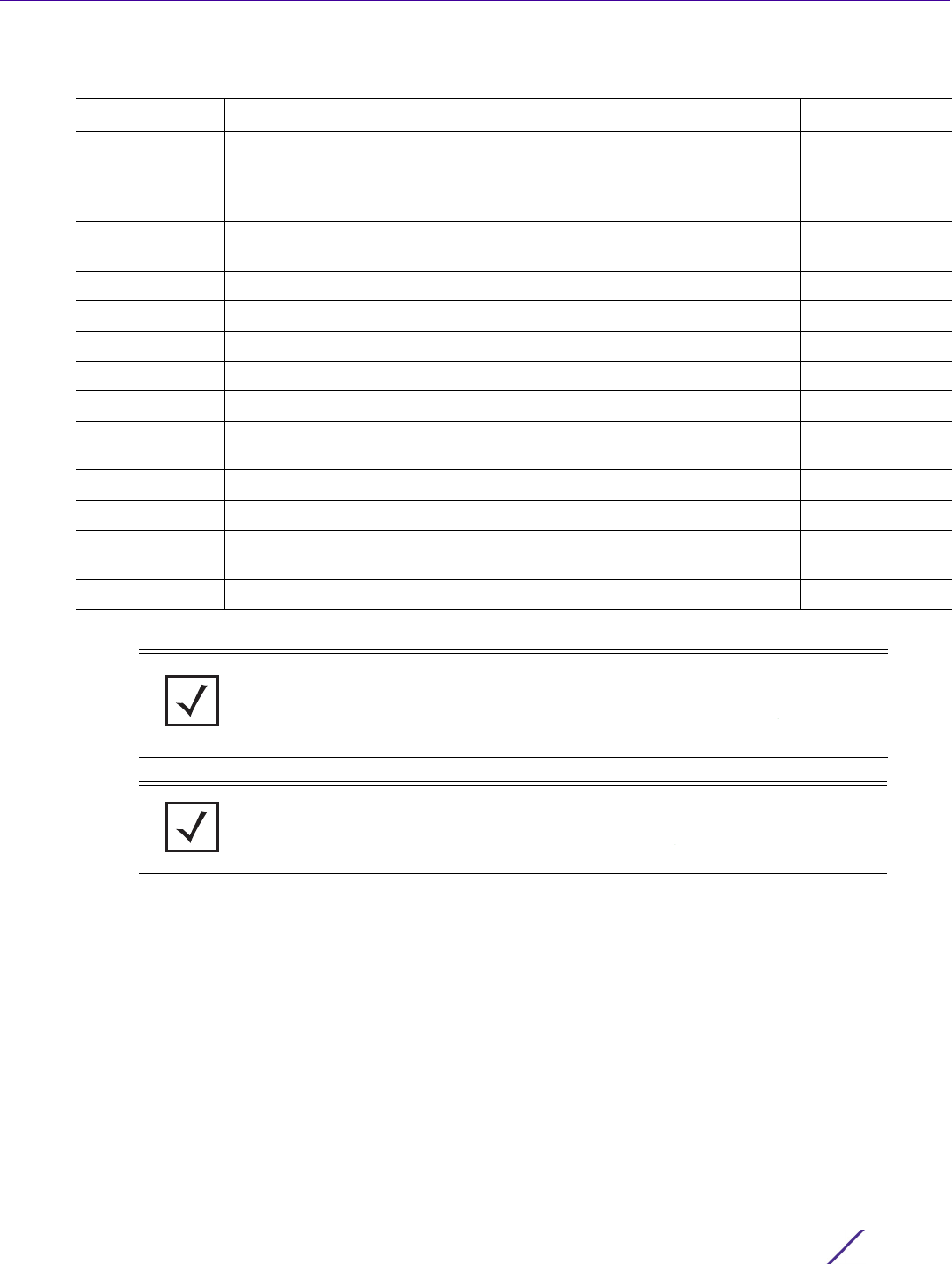
USER EXEC MODE COMMANDS
Access Point, Wireless Controller and Service Platform CLI Reference Guide 2 - 3
opendns Connects to the OpenDNS site using OpenDNS registered credentials
(username, password) OR OpenDNS API token to fetch the OpenDNS
device_id. This command is a part of the process that integrates access
points, controllers, and service platforms with OpenDNS.
page 2-65
page Toggles a device’s (access point, wireless controller, or service
platform) paging function
page 2-67
ping Sends ICMP echo messages to a user-specified location page 2-68
ping6 Sends ICMPv6 echo messages to a user-specified IPv6 address page 2-70
ssh Opens an SSH connection between two network devices page 2-71
telnet Opens a Telnet session page 2-72
terminal Sets the length and width of the terminal window page 2-73
time-it Verifies the time taken by a particular command between request and
response
page 2-74
traceroute Traces the route to its defined destination page 2-75
traceroute6 Traces the route to a specified IPv6 destination page 2-76
virtual-machine Installs, configures, and monitors the status of virtual machines
(VMs) installed on a WiNG controller
page 2-77
watch Repeats a specific CLI command at a periodic interval page 2-83
Table 2.1 User Exec Mode Commands
Command Description Reference
NOTE: For more information on common commands (clrscr, commit, help,
revert, service, show, write, and exit), see COMMON COMMANDS.
NOTE: The input parameter <HOSTNAME>, if used in syntaxes across this
chapter, cannot include an underscore (_) character.

USER EXEC MODE COMMANDS
Access Point, Wireless Controller and Service Platform CLI Reference Guide 2 - 4
2.1.1 captive-portal-page-upload
User Exec Commands
Uploads captive portal advanced pages to adopted access points. Use this command to provide access
points with specific captive portal configurations, so that they can successfully provision login, welcome,
and condition pages to clients attempting to access the wireless network using the captive portal.
Supported in the following platforms:
• Access Points — AP6521, AP6522, AP6532, AP6562, AP7161, AP7502, AP7522, AP7532, AP7562,
AP7602, AP7612, AP7622, AP7632, AP7662, AP81XX, AP8232, AP8432, AP8533
• Wireless Controllers — RFS4000, RFS6000
• Service Platforms — NX5500, NX7500, NX7510, NX7520, NX7530, NX9500, NX9510, NX9600,
VX9000
Syntax
captive-portal-page-upload [<CAPTIVE-PORTAL-NAME>|cancel-upload|delete-file|
load-file]
captive-portal-page-upload <CAPTIVE-PORTAL-NAME> [<MAC/HOSTNAME>|all|rf-domain]
captive-portal-page-upload <CAPTIVE-PORTAL-NAME> [<MAC/HOSTNAME>|all]
{upload-time <TIME>}
captive-portal-page-upload <CAPTIVE-PORTAL-NAME> rf-domain [<DOMAIN-NAME>|all]
{from-controller} {(upload-time <TIME>)}
captive-portal-page-upload cancel-upload [<MAC/HOSTNAME>|all|on rf-domain
[<DOMAIN-NAME>|all]]
captive-portal-page-upload delete-file <CAPTIVE-PORTAL-NAME> <FILE-NAME>
captive-portal-page-upload load-file <CAPTIVE-PORTAL-NAME> <URL>
Parameters
• captive-portal-page-upload <CAPTIVE-PORTAL-NAME> [<MAC/HOSTNAME>|all]
{upload-time <TIME>}
NOTE: Ensure that the captive portal pages uploaded are *.tar files.
captive-portal-page-
upload <CAPTIVE-
PORTAL-NAME>
Uploads advanced pages of the captive-portal identified by the <CAPTIVE-PORTAL-
NAME> parameter
• <CAPTIVE-PORTAL-NAME> – Specify the captive portal’s name (should be existing
and configured).
<MAC/HOSTNAME> Uploads to a specified AP
• <MAC/HOSTNAME> – Specify AP’s MAC address or hostname.
all Uploads to all APs

USER EXEC MODE COMMANDS
Access Point, Wireless Controller and Service Platform CLI Reference Guide 2 - 5
• captive-portal-page-upload <CAPTIVE-PORTAL-NAME> rf-domain [<DOMAIN-NAME>|
all] {from-controller} {(upload-time <TIME>)}
• captive-portal-page-upload cancel-upload [<MAC/HOSTNAME>|all|on rf-domain
[<DOMAIN-NAME>|all]]
• captive-portal-page-upload delete-file <CAPTIVE-PORTAL-NAME> <FILE-NAME>
upload-time <TIME> Optional. Schedules an AP upload time
• <TIME> – Specify upload time in the MM/DD/YYYY-HH:MM or HH:MM format.
The scheduled upload time is your local system’s time. It is not the access point,
controller, service platform, or virtual controller time and it is not synched with the
device.
To view a list of uploaded captive portal files, execute the show > captive-portal-
page-upload > list-files <CAPTIVE-PORTAL-NAME> command.
captive-portal-page-
upload <CAPTIVE-
PORTAL-NAME>
Uploads advanced pages of the captive portal identified by the <CAPTIVE-PORTAL-
NAME> parameter
• <CAPTIVE-PORTAL-NAME> – Specify captive portal name (should be existing and
configured).
rf-domain
[<DOMAIN-
NAME>|all]
Uploads to all APs within a specified RF Domain or all RF Domains
• <DOMAIN-NAME> – Uploads to APs within a specified RF Domain. Specify the RF
Domain name.
• all – Uploads to APs across all RF Domains
from-controller Optional. Uploads captive-portal pages to APs via the controller to which the APs are
adopted
upload-time <TIME> Optional. Schedules an AP upload time
• <TIME> – Specify upload time in the MM/DD/YYYY-HH:MM or HH:MM format.
The scheduled upload time is your local system’s time. It is not the access point,
controller, service platform, or virtual controller time and it is not synched with the
device.
captive-portal-page-
upload cancel-upload
Cancels a scheduled AP upload
cancel-upload
[<MAC/HOSTNAME>|
all|on rf-domain
[<DOMAIN-
NAME>|all]]
Select one of the following options:
• <MAC/HOSTNAME> – Cancels scheduled upload to a specified AP. Specify the AP’s
MAC address or hostname.
• all – Cancels all scheduled AP uploads
• on rf- domain – Cancels all scheduled uploads to APs within a specified RF Domain or
all RF Domains
• <DOMAIN-NAME> – Cancels scheduled uploads to APs within a specified RF Do-
main. Specify RF Domain name.
• all – Cancels scheduled uploads across all RF Domains
captive-portal-page-
upload delete-file
Deletes a specified captive portal’s uploaded captive-portal Web page files
<CAPTIVE-PORTAL-
NAME> <FILE-
NAME>
Identifies the captive-portal and Web pages to delete
• <CAPTIVE-PORTAL-NAME> – Specify the captive portal name.
• <FILE-NAME> – Specify the file name. The specified internal captive portal page is
deleted.

USER EXEC MODE COMMANDS
Access Point, Wireless Controller and Service Platform CLI Reference Guide 2 - 6
• captive-portal-page-upload load-file <CAPTIVE-PORTAL-NAME> <URL>
Example
ap6562-B1A214>captive-portal-page-upload load-file captive_portal_test tftp://
89.89.89.17/pages_new_only.tar
ap6562-B1A214>
ap6562-B1A214>show captive-portal-page-upload load-image-status
Download of captive_portal_test advanced page file is complete
ap6562-B1A214>
ap6562-B1A214>captive-portal-page-upload captive_portal_test all
--------------------------------------------------------------------------------
CONTROLLER STATUS MESSAGE
--------------------------------------------------------------------------------
FC-0A-81-B1-A2-14 Success Added 6 APs to upload queue
--------------------------------------------------------------------------------
ap6562-B1A214>
captive-portal-page-
upload load-file
Loads captive-portal advanced pages
<CAPTIVE-PORTAL-
NAME> <URL>
Specify the captive portal name and location. The captive portal should be existing
and configured.
• <URL> – Specifies location of the captive-portal Web pages. Use one of the following
formats to specify the location:
IPv4 URLs:
tftp://<hostname|IP>[:port]/path/file
ftp://<user>:<passwd>@<hostname|IP>[:port]/path/file
sftp://<user>:<passwd>@<hostname|IP>[:port]>/path/file
http://<hostname|IP>[:port]/path/file
cf:/path/file
usb<n>:/path/file
IPv6 URLs:
tftp://<hostname|[IPv6]>[:port]/path/file
ftp://<user>:<passwd>@<hostname|[IPv6]>[:port]/path/file
sftp://<user>:<passwd>@<hostname|[IPv6]>[:port]>/path/file
http://<hostname|[IPv6]>[:port]/path/file
Note: The captive portal pages are downloaded to the controller from the location
specified here. After downloading use the captive-portal-page-upload > <CAPTIVE-
PORTAL-NAME> > <DEVICE-OR-DOMAIN-NAME> command to upload these pages to
APs.

USER EXEC MODE COMMANDS
Access Point, Wireless Controller and Service Platform CLI Reference Guide 2 - 7
ap6562-B1A214>show captive-portal-page-upload status
Number of APs currently being uploaded : 1
Number of APs waiting in queue to be uploaded : 0
--------------------------------------------------------------------------------
-------
AP STATE UPLOAD TIME PROGRESS RETRIES LAST UPLOAD ERROR
UPLOADED BY
--------------------------------------------------------------------------------
-------
ap6562-B1A738 downloading immediate 100 0 - None
--------------------------------------------------------------------------------
-------
ap6562-B1A214>

USER EXEC MODE COMMANDS
Access Point, Wireless Controller and Service Platform CLI Reference Guide 2 - 8
2.1.2 change-passwd
User Exec Commands
Changes the password of the logged user. When this command is executed without any parameters, the
password can be changed interactively.
Supported in the following platforms:
• Access Points — AP6521, AP6522, AP6532, AP6562, AP7161, AP7502, AP7522, AP7532, AP7562,
AP7602, AP7612, AP7622, AP7632, AP7662, AP81XX, AP8232, AP8432, AP8533
• Wireless Controllers — RFS4000, RFS6000
• Service Platforms — NX5500, NX7500, NX7510, NX7520, NX7530, NX9500, NX9510, NX9600,
VX9000
Syntax
change-passwd {<OLD-PASSWORD>} <NEW-PASSWORD>
Parameters
• change-passwd {<OLD-PASSWORD>} <NEW-PASSWORD>
Usage Guidelines
A password must be from 1 - 64 characters in length.
Example
rfs6000-81742D>change-passwd
Enter old password:
Enter new password:
Password for user 'admin' changed successfully
Please write this password change to memory(write memory) to be persistent.
rfs6000-81742D#write memory
OK
rfs6000-81742D>
<OLD-PASSWORD> Optional. Specify the existing password.
<NEW-PASSWORD> Specify the new password.
Note: The password can also be changed interactively. To do so, press [Enter] after
the command.
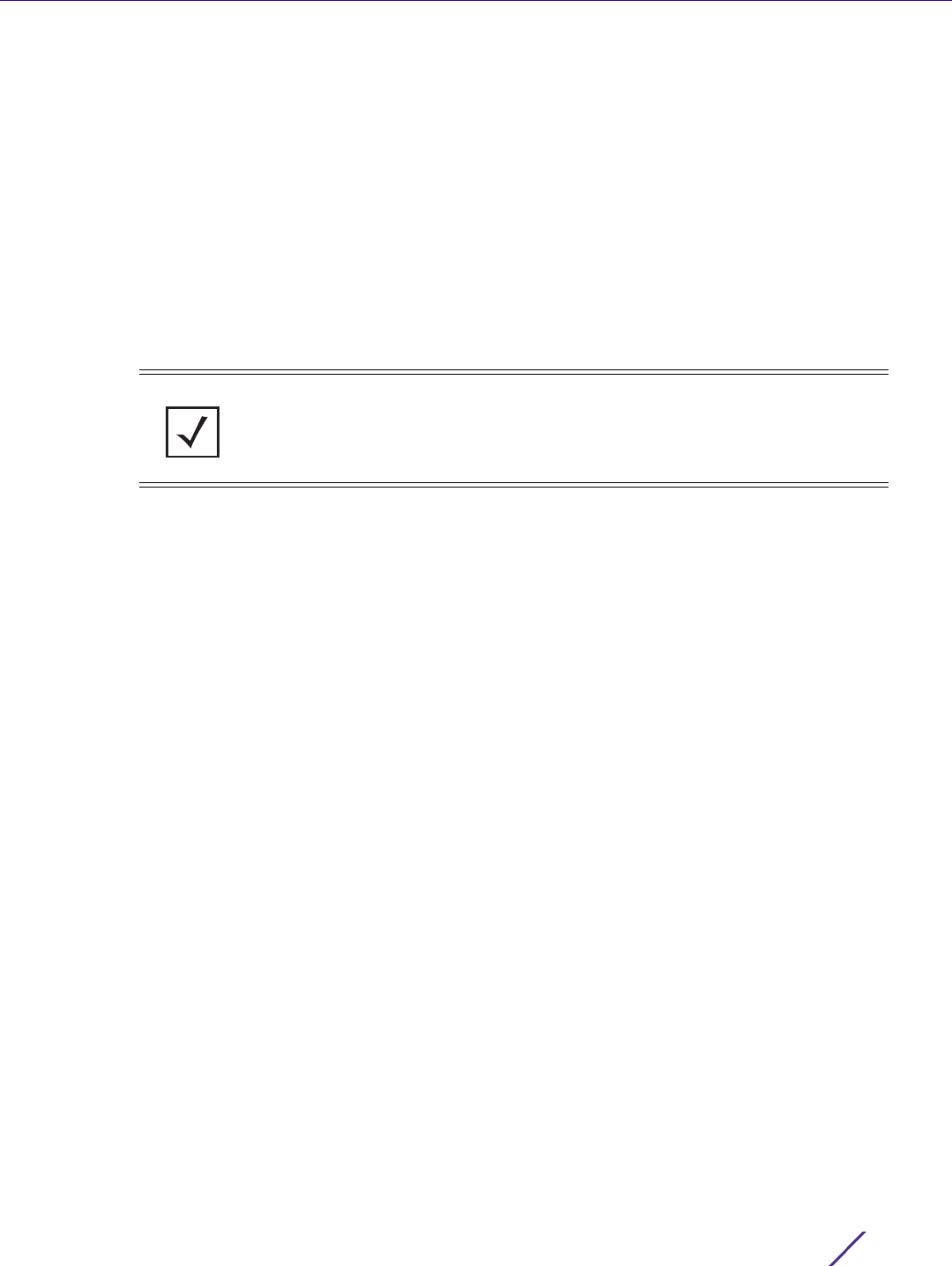
USER EXEC MODE COMMANDS
Access Point, Wireless Controller and Service Platform CLI Reference Guide 2 - 9
2.1.3 clear
User Exec Commands
Clears parameters, cache entries, table entries, and other similar entries. The clear command is available for
specific commands only. The information cleared, using this command, depends on the mode where the
clear command is executed.
Supported in the following platforms:
• Access Points — AP6521, AP6522, AP6532, AP6562, AP7161, AP7502, AP7522, AP7532, AP7562,
AP7602, AP7612, AP7622, AP7632, AP7662, AP81XX, AP8232, AP8432, AP8533
• Wireless Controllers — RFS4000, RFS6000
• Service Platforms — NX5500, NX7500, NX7510, NX7520, NX7530, NX9500, NX9510, NX9600,
VX9000
Syntax
clear [arp-cache|bonjour|cdp|counters|crypto|eguest|event-history|gre|ip|
ipv6|lacp|lldp|mac-address-table|mint|role|rtls|spanning-tree|traffic-shape|
vrrp]
clear arp-cache {on <DEVICE-NAME>}
clear bonjour cache {on <DEVICE-NAME>}
clear [cdp|lldp] neighbors {on <DEVICE-NAME>}
clear counters [ap|radio|wireless-client]
clear counters [ap {<MAC>}|radio {<MAC/DEVICE-NAME>} {<1-X>}|wireless-client
{<MAC>}] {(on <DEVICE-OR-DOMAIN-NAME>)}
clear crypto [ike|ipsec] sa
clear crypto ike sa [<IP>|all] {on <DEVICE-NAME>}
clear crypto ipsec sa {on <DEVICE-NAME>}
clear eguest registration statistics
clear event-history
clear gre stats {on <DEVICE-NAME>}
clear ip [bgp|dhcp|ospf]
clear ip bgp [<IP>|all|external|process]
clear ip bgp [<IP>|all|external] {in|on|out|soft}
clear ip bgp [<IP>|all|external] {in prefix-filter} {on <DEVICE-NAME>}
clear ip bgp [<IP>|all|external] {out} {(on <DEVICE-NAME>)}
clear ip bgp [<IP>|all|external] {soft {in|out}} {on <DEVICE-NAME>}
clear ip bgp process {on <DEVICE-NAME>}
clear ip dhcp bindings [<IP>|all] {on <DEVICE-NAME>}
clear ip ospf process {on <DEVICE-NAME>}
clear ipv6 neighbor-cache {on <DEVICE-NAME>}
clear lacp [<1-4> counters|counters]
NOTE: When using the clear command, refer to the interface details
provided in interface.

USER EXEC MODE COMMANDS
Access Point, Wireless Controller and Service Platform CLI Reference Guide 2 - 10
clear mac-address-table {address|interface|mac-auth-state|vlan} {on <DEVICE-
NAME>}
clear mac-address-table {address <MAC>|vlan <1-4094>} {on <DEVICE-NAME>}
clear mac-address-table {interface [<IN-NAME>|ge <1-2>|port-channel <1-2>|
vmif <1-8>]} {on <DEVICE-NAME>}
clear mac-address-table mac-auth-state address <MAC> vlan <1-4094> {on <DEVICE-
NAME>}
clear mint mlcp history {on <DEVICE-NAME>}
clear role ldap-stats {on <DEVICE-NAME>}
clear rtls [aeroscout|ekahau]
clear rtls [aeroscout|ekahau] {<MAC/DEVICE-NAME> {on <DEVICE-OR-DOMAIN-NAME>}|
on <DEVICE-OR-DOMAIN-NAME>}
clear spanning-tree detected-protocols {interface|on}
clear spanning-tree detected-protocols {on <DEVICE-NAME>}
clear spanning-tree detected-protocols {interface [<INTERFACE-NAME>|ge <1-X>|me1|
port-channel <1-X>|pppoe1|up1|vlan <1-4094>|wwan1]} {on <DEVICE-NAME>}
clear traffic-shape statistics class <1-4> {(on <DEVICE-NAME>)}
clear vrrp [error-stats|stats] {on <DEVICE-NAME>}
Parameters
• clear arp-cache {on <DEVICE-NAME>}
• clear bonjour cache {on <DEVICE-NAME>}
• clear [cdp|lldp] neighbors {on <DEVICE-NAME>}
arp-cache Clears Address Resolution Protocol (ARP) cache entries on a device. This protocol
matches layer 3 IP addresses to layer 2 MAC addresses.
on <DEVICE-NAME> Optional. Clears ARP cache entries on a specified device
• <DEVICE-NAME> – Specify the name of the AP, wireless controller, or service
platform.
bonjour cache Clears all Bonjour cached statistics. Once cleared the system has to re-discover
available Bonjour services.
on <DEVICE-NAME> Optional. Clears all Bonjour cached statistics on a specified device
• <DEVICE-NAME> – Specify the name of the AP, wireless controller, or service
platform.
cdp Clears Cisco Discovery Protocol (CDP) table entries
lldp Clears Link Layer Discovery Protocol (LLDP) table entries
neighbors Clears CDP or LLDP neighbor table entries based on the option selected in the
preceding step
on <DEVICE-NAME> Optional. Clears CDP or LLDP neighbor table entries on a specified device
• <DEVICE-NAME> – Specify the name of the AP, wireless controller, or service
platform.

USER EXEC MODE COMMANDS
Access Point, Wireless Controller and Service Platform CLI Reference Guide 2 - 11
• clear counters [ap {<MAC>}|radio {<MAC/DEVICE-NAME>} {<1-X>}|wireless-client
{<MAC>}] {(on <DEVICE-OR-DOMAIN-NAME>)}
• clear crypto ike sa [<IP>|all] {on <DEVICE-NAME>}
• clear crypto ipsec sa {on <DEVICE-NAME>}
counters Clears counters based on the parameters passed. The options are: AP, radio, and
wireless clients.
ap <MAC> Clears counters for all APs or a specified AP
• <MAC> – Optional. Specify the AP’s MAC address.
Note: If no MAC address is specified, all AP counters are cleared.
radio <MAC/DEVICE-
NAME> <1-X>
Clears radio interface counters on a specified device or on all devices
• <MAC/DEVICE-NAME> – Optional. Specify the device’s hostname or MAC address.
Optionally, append the radio interface number (to the radio ID) using one of the
following formats: AA-BB-CC-DD-EE-FF:RX or HOSTNAME:RX (where RX is the
interface number).
• <1-X> – Optional. Identifies the radio interface by its index. Specify the radio inter-
face index, if not specified as part of the radio ID. Note, the number of radio interfaces
available varies with the access point type.
If no device name or MAC address is specified, all radio interface counters are
cleared.
wireless-client <MAC> Clears counters for all wireless clients or a specified wireless client
• <MAC> – Optional. Specify the wireless client’s MAC address.
If no MAC address is specified, all wireless client counters are cleared.
on <DEVICE-OR-
DOMAIN-NAME>
The following option is common to all of the above keywords:
• on <DEVICE-OR-DOMAIN-NAME> – Optional. Clears AP, radio, or wireless client
counters on a specified device or RF Domain
• <DEVICE-OR-DOMAIN-NAME> – Specify the name of the AP, wireless controller,
service platform, or RF Domain.
crypto Clears encryption module’s cached statistics
ike sa [<IP>|all] Clears Internet Key Exchange (IKE) security associations (SAs)
• <IP> – Clears IKE SA entries for the peer identified by the <IP> keyword
• all – Clears IKE SA entries for all peers
on <DEVICE-NAME> Optional. Clears IKE SA entries, for a specified peer or all peers, on a specified device
• <DEVICE-NAME> – Specify the name of the AP, wireless controller, or service
platform.
crypto Clears encryption module’s cached statistics
ipsec sa
on <DEVICE-NAME>
Clears Internet Protocol Security (IPSec) database SAs
• on <DEVICE-NAME> – Optional. Clears IPSec SA entries on a specified device
• <DEVICE-NAME> – Specify the name of the AP, wireless controller, or service plat-
form.

USER EXEC MODE COMMANDS
Access Point, Wireless Controller and Service Platform CLI Reference Guide 2 - 12
• clear eguest registration statistics
• clear gre stats {on <DEVICE-NAME>}
• clear event-history
• clear ip bgp [<IP>|all|external] {in prefix-filter} {on <DEVICE-NAME>}
• clear ip bgp [<IP>|all|external] {out} {(on <DEVICE-NAME>)}
eguest registration
statistics
Clears EGuest registration server counters. When cleared EGuest registration details
are deleted, and the show > eguest > registration > statistics command output is null.
This command is applicable only on the NX9500, NX9600, and VX9000 model
service platforms.
gre stats Clears GRE tunnel statistics
on <DEVICE-NAME> Optional. Clears GRE tunnel statistics on a specified device
• <DEVICE-NAME> – Specify the name of the AP, wireless controller, or service
platform.
event-history Clears event history cache entries
ip bgp
[<IP>|all|external]
Clears on-going BGP sessions based on the option selected
• <IP> – Clears BGP session with the peer identified by the <IP> keyword. Specify the
BGP peer’s IP address.
• all – Clears all BGP peer sessions
• external – Clears external BGP (eBGP) peer sessions
This command is applicable only to the RFS4000, RFS6000, NX9500, NX9600, and
VX9000 platforms.
Modifications made to BGP settings (BGP access lists, weight, distance, route-maps,
versions, routing policy, etc.) take effect only after on-going BGP sessions are
cleared. The clear > ip > bgp command clears BGP sessions. To reduce lose of route
updates during the process, use the ‘soft’ option. Soft reconfiguration stores
inbound/outbound route updates to be processed later and updated to the routing
table. This requires high memory usage.
in prefix-filter Optional. Clears inbound route updates
• prefix-filter – Optional. Clears the existing Outbound Route Filtering (ORF) prefix-list
on <DEVICE-NAME> Optional. Clears route updates on a specified device
• <DEVICE-NAME> – Specify the name of the AP or service platform.
ip bgp
[<IP>|all|external]
Clears on-going BGP sessions based on the option selected
• <IP> – Clears BGP session with the peer identified by the <IP> keyword. Specify the
BGP peer’s IP address.
• all – Clears all BGP peer sessions
• external – Clears eBGP peer sessions
This command is applicable only to the RFS4000, RFS6000, NX9500, NX9600, and
VX9000 platforms.
Contd..

USER EXEC MODE COMMANDS
Access Point, Wireless Controller and Service Platform CLI Reference Guide 2 - 13
• clear ip bgp [<IP>|all|external] {soft {in|out}} {on <DEVICE-NAME>}
• clear ip bgp process {on <DEVICE-NAME>}
• clear ip dhcp bindings [<IP>|all] {on <DEVICE-NAME>}
Modifications made to BGP settings (BGP access lists, weight, distance, route-maps,
versions, routing policy, etc.) take effect only after on-going BGP sessions are
cleared. The clear > ip > bgp command clears BGP sessions. To reduce lose of route
updates during the process, use the ‘soft’ option. Soft reconfiguration stores
inbound/outbound route updates to be processed later and updated to the routing
table. This requires high memory usage.
out Optional. Clears outbound route updates. Optionally specify the device on which to
execute this command.
on <DEVICE-NAME> The following keyword is recursive and optional.
• on <DEVICE-NAME> – Optional. Clears BGP sessions on a specified device
• <DEVICE-NAME> – Specify the name of the AP or service platform.
ip bgp
[<IP>|all|external]
Clears on-going BGP sessions based on the option selected
• <IP> – Clears the BGP peer session with the peer identified by the <IP> keyword.
Specify the BGP peer’s IP address.
• all – Clears all BGP peer sessions
• external – Clears eBGP peer sessions
This command is applicable only to the RFS4000, RFS6000, NX9500, NX9600, and
VX9000 platforms.
soft {in|out} Optional. Initiates soft-reconfiguration of route updates for the specified IP address
• in – Optional. Enables soft reconfiguration of inbound route updates
• out – Optional. Enables soft reconfiguration of outbound route updates
Modifications made to BGP settings (BGP access lists, weight, distance, route-maps,
versions, routing policy, etc.) take effect only after on-going BGP sessions are
cleared. The clear > ip > bgp command clears BGP sessions. To reduce loss of route
updates during the process, use the ‘soft’ option. Soft reconfiguration stores
inbound/outbound route updates to be processed later and updated to the routing
table. This requires high memory usage.
on <DEVICE-NAME> Optional. Initiates soft reconfiguration inbound/outbound route updates on a
specified device
• <DEVICE-NAME> – Specify the name of the AP or service platform.
ip bgp process Clears all BGP processes running
This command is applicable only to the RFS4000, RFS6000, NX9500, NX9600, and
VX9000 platforms.
on <DEVICE-NAME> Optional. Clears all BGP processes on a specified device
• <DEVICE-NAME> – Specify the name of the AP or service platform.
ip Clears a Dynamic Host Configuration Protocol (DHCP) server’s IP address binding
entries
dhcp bindings Clears DHCP connections and server bindings
<IP> Clears specific address binding entries. Specify the IP address to clear binding
entries.

USER EXEC MODE COMMANDS
Access Point, Wireless Controller and Service Platform CLI Reference Guide 2 - 14
• clear ip ospf process {on <DEVICE-NAME>}
• clear ipv6 neighbor-cache {on <DEVICE-NAME>}
• clear lacp [<1-4> counters|counters]
• clear mac-address-table {address <MAC>|vlan <1-4094>} {on <DEVICE-NAME>}
all Clears all address binding entries
on <DEVICE-NAME> Optional. Clears a specified address binding or all address bindings on a specified
device
• <DEVICE-NAME> – Specify the name of the AP, wireless controller, or service
platform.
ip ospf process Clears already enabled Open Shortest Path First (OSPF) process and restarts the
process
on <DEVICE-NAME> Optional. Clears OSPF process on a specified device
OSPF is a link-state interior gateway protocol (IGP). OSPF routes IP packets within a
single routing domain (autonomous system), like an enterprise LAN. OSPF gathers
link state information from neighboring routers and constructs a network topology.
The topology determines the routing table presented to the Internet Layer, which
makes routing decisions based solely on the destination IP address found in IP
packets.
• <DEVICE-NAME> – Specify the name of the AP, wireless controller, or service
platform.
clear ipv6
neighbor-cache
Clears IPv6 neighbor cache entries
on <DEVICE-NAME> Optional. Clears IPv6 neighbor cache entries on a specified device
• <DEVICE-NAME> – Specify the name of the AP, wireless controller, or service
platform.
clear lacp
[<1-4> counters|
counters]
Clears Link Aggregation Control Protocol (LACP) counters for a specified port-
channel group or all port-channel groups configured
• <1-4> counters – Clears LACP counters for a specified port-channel. Specify the
port-channel index number from 1 - 4. Note, LACP is supported only on the NX5500,
NX7500, and NX9500 model service platforms. However, the NX9500 series service
platforms support only two (2) port-channels, and the other model service
platforms support four (4) port-channels.
• counters – Clears LACP counters for all configured port-channels on the device
mac-address-table Clears MAC address forwarding table data based on the parameters passed
Use this command to clear the following: all or specified MAC addresses from the
system, all MAC addresses on a specified interface, all MAC addresses on a specified
VLAN, or the authentication state of a MAC address.
address <MAC> Optional. Clears a specified MAC address from the MAC address table.
• <MAC> – Specify the MAC address in one of the following formats: AA-BB-CC-DD-
EE-FF or AA:BB:CC;DD:EE:FF or AABB.CCDD.EEFF
If executed without specifying any MAC address(es), all MAC addresses from the
MAC address table will be removed.

USER EXEC MODE COMMANDS
Access Point, Wireless Controller and Service Platform CLI Reference Guide 2 - 15
• clear mac-address-table {interface [<IF-NAME>|ge <1-X>|port-channel <1-X>]} {on
<DEVICE-NAME>}
• clear mac-address-table mac-auth-state address <MAC> vlan <1-4904> {on <DEVICE-
NAME>}
vlan <1-4094> Optional. Clears all MAC addresses for a specified VLAN
• <1-4094> – Specify the VLAN ID from 1 - 4094.
on <DEVICE-NAME> Optional. Clears a single MAC entry or all MAC entries, for the specified VLAN on a
specified device
• <DEVICE-NAME> – Specify the name of the AP, wireless controller, or service
platform.
mac-address-table Clears MAC address forwarding table data based on the parameters passed
Use this command to clear the following: all or specified MAC addresses from the
system, all MAC addresses on a specified interface, all MAC addresses on a specified
VLAN, or the authentication state of a MAC address.
interface Clears all MAC addresses for the selected interface. Use the options available to
specify the interface.
<IF-NAME> Clears MAC address forwarding table for the specified layer 2 interface (Ethernet
port)
• <IF-NAME> – Specify the layer 2 interface name.
ge <1-X> Clears MAC address forwarding table for the specified GigabitEthernet interface
• <1-X> – Specify the GigabitEthernet interface index from 1 - X.
The number of GE interfaces supported varies for different device types.
port-channel <1-X> Clears MAC address forwarding table for the specified port-channel interface
• <1-X> – Specify the port-channel interface index from 1 - X.
The number of port-channel interfaces supported varies for different device types.
on <DEVICE-NAME> Optional. Clears the MAC address forwarding table, for the selected interface, on a
specified device
• <DEVICE-NAME> – Specify the name of the AP, wireless controller, or service
platform.
mac-address-table
mac-auth-state address
<MAC> vlan <1-4904>
Clears MAC addresses learned from a particular VLAN when WLAN MAC
authentication and captive-portal fall back is enabled
Access points/controllers provide WLAN access to clients whose MAC address has
been learned and stored in their MAC address tables. Use this command to clear a
specified MAC address on the MAC address table. Once cleared the client has to re-
authenticate, and is provided access only on successful authentication.
• <MAC> – Specify the MAC address to clear.
• vlan <1-4904> – Specify the VLAN interface from 1 - 4094. In the AP/controller’s
MAC address table, the specified MAC address is cleared on the specified VLAN in-
terface.
on <DEVICE-NAME> Optional. Clears the specified MAC address on a specified device
• <DEVICE-NAME> – Specify the name of the AP, wireless controller, or service
platform.
If a device is not specified, the system clears the MAC address on all devices.

USER EXEC MODE COMMANDS
Access Point, Wireless Controller and Service Platform CLI Reference Guide 2 - 16
• clear mint mlcp history {on <DEVICE-NAME>}
• clear role ldap-stats {on <DEVICE-NAME>}
• clear rtls [aeroscout|ekahau] {<MAC/DEVICE-NAME> {on <DEVICE-OR-DOMAIN-NAME>}|
on <DEVICE-OR-DOMAIN-NAME>}
• clear spanning-tree detected-protocols {on <DEVICE-NAME>}
• clear spanning-tree detected-protocols {interface [<INTERFACE-NAME>|ge <1-X>|
me1|port-channel <1-X>|pppoe1|up1|vlan <1-4094>|wwan1]} {on <DEVICE-NAME>}
mint Clears MiNT related information
mlcp history Clears MiNT Link Creation Protocol (MLCP) client history
on <DEVICE-NAME> Optional. Clears MLCP client history on a specified device
• <DEVICE-NAME> – Specify the name of the AP, wireless controller, or service
platform.
role ldap-stats Clears Lightweight Directory Access Protocol (LDAP) server statistics
on <DEVICE-NAME> Optional. Clears LDAP server statistics on a specified device
• <DEVICE-NAME> – Specify the name of the AP, wireless controller, or service
platform.
rtls Clears Real Time Location Service (RTLS) statistics
aeroscout Clears RTLS Aeroscout statistics
ekahau Clears RTLS Ekahau statistics
<MAC/DEVICE-NAME> This keyword is common to the ‘aeroscout’ and ‘ekahau’ parameters.
• <MAC/DEVICE-NAME> – Optional. Clears Aeroscout or Ekahau RTLS statistics on a
specified AP, wireless controller, or service platform. Specify the AP’s MAC
address or hostname.
on <DEVICE-OR-
DOMAIN-NAME>
This keyword is common to the ‘aeroscout’, ‘ekahau’, and <MAC/DEVICE-NAME>
parameters.
• on <DEVICE-OR-DOMAIN-NAME> – Optional. Clears Aeroscout or Ekahau RTLS
statistics on a specified device
• <DEVICE-OR-DOMAIN-NAME> – Specify the name of the AP, wireless controller,
service platform, or RF Domain.
spanning-tree Clears spanning tree entries on an interface, and restarts protocol migration
detected-protocols Restarts protocol migration
on <DEVICE-NAME> Optional. Clears spanning tree entries on a specified device
• <DEVICE-NAME> – Specify the name of the AP, wireless controller, or service
platform.
spanning-tree Clears spanning tree entries on an interface and restarts protocol migration
detected-protocols Restarts protocol migration

USER EXEC MODE COMMANDS
Access Point, Wireless Controller and Service Platform CLI Reference Guide 2 - 17
• clear traffic-shape statistics class <1-4> {(on <DEVICE-NAME>)}
• clear vrrp [error-stats|stats] {on <DEVICE-NAME>}
interface
[<INTERFACE-NAME>|
ge <1-X>|me1|
port-channel <1-X>|
pppoe1|up1|
vlan <1-4094>|
wwan1]
Optional. Clears spanning tree entries on different interfaces
• <INTERFACE-NAME> – Clears detected spanning tree entries on a specified
interface. Specify the interface name.
• ge <1-X> – Clears detected spanning tree entries for the selected GigabitEthernet
interface. Select the GigabitEthernet interface index from 1 - X.
• me1 – Clears FastEthernet interface spanning tree entries
• port-channel <1-X> – Clears detected spanning tree entries for the selected port
channel interface. Select the port channel index from 1 - X.
The number of port-channel interfaces supported varies for different device types.
• pppoe1 – Clears detected spanning tree entries for Point-to-Point Protocol over
Ethernet (PPPoE) interface
• up1 – Clears detected spanning tree entries for the WAN Ethernet interface
• vlan <1-4094> – Clears detected spanning tree entries for the selected VLAN
interface. Select a Switch Virtual Interface (SVI) VLAN ID from 1- 4094.
• wwan1 – Clears detected spanning tree entries for wireless WAN interface.
on <DEVICE-NAME> Optional. Clears spanning tree entries on a specified device
• <DEVICE-NAME> – Specify the name of the AP, wireless controller, or service
platform.
traffic-shape statistics Clears traffic shaping statistics
class <1-4> Clears traffic shaping statistics for a specific traffic class
• <1-4> – Specify the traffic class from 1 - 4.
Note: If the traffic class is not specified, the system clears all traffic shaping statistics.
on <DEVICE-NAME> Optional. Clears traffic shaping statistics for the specified traffic class on a specified
device
• <DEVICE-NAME> – Specify the name of the access point, wireless controller, or
service platform.
Note: For more information on configuring traffic-shape, see traffic-shape.
vrrp Clears a device’s Virtual Router Redundancy Protocol (VRRP) statistics
VRRP allows a pool of routers to be advertized as a single virtual router. This virtual
router is configured by hosts as their default gateway. VRRP elects a master router,
from this pool, and assigns it a virtual IP address. The master router routes and
forwards packets to hosts on the same subnet. When the master router fails, one of
the backup routers is elected as the master and its IP address is mapped to the
virtual IP address.
error-stats Clears global error statistics
stats Clears VRRP related statistics
on <DEVICE-NAME> The following keywords are common to the ‘error-stats’ and ‘stats’ parameters:
• on <DEVICE-NAME> – Optional. Clears VRRP statistics on a specified device
• <DEVICE-NAME> – Specify the name of the AP, wireless controller, or service
platform.

USER EXEC MODE COMMANDS
Access Point, Wireless Controller and Service Platform CLI Reference Guide 2 - 18
Example
rfs4000-229D58>clear event-history
rfs4000-229D58>clear spanning-tree detected-protocols interface port-channel 1
rfs4000-229D58>clear spanning-tree detected-protocols interface ge 1
rfs4000-229D58>show lldp neighbors
-------------------------
Chassis ID: 00-23-68-88-0D-A7
System Name: rfs4000-880DA7
Platform: RFS-4011-11110-US, Version 5.8.6.0-008B
Capabilities: Bridge WLAN Access Point Router
Enabled Capabilities: Bridge WLAN Access Point Router
Local Interface: ge5, Port ID (outgoing port): ge5
TTL: 176 sec
Management Addresses: 192.168.13.8,192.168.0.1,1.2.3.4
rfs4000-229D58>
rfs4000-229D58>clear lldp neighbors
rfs4000-229D58>show lldp neighbors
rfs4000-229D58>show cdp neighbors
--------------------------------------------------------------------------------
Device ID Platform Local Intrfce Port ID Duplex
--------------------------------------------------------------------------------
rfs4000-880DA7 RFS-4011-11110-US ge1 ge1 full
rfs6000-434CAA RFS6000 ge1 ge1 full
ap7131-139B34 AP7131N ge1 ge1 full
--------------------------------------------------------------------------------
rfs4000-229D58>
rfs4000-229D58>clear cdp neighbors
rfs4000-229D58>show cdp neighbors
--------------------------------------------------------------------------------
Device ID Platform Local Intrfce Port ID Duplex
--------------------------------------------------------------------------------
--------------------------------------------------------------------------------
rfs4000-229D58>
rfs4000-229D58>clear role ldap-stats
rfs4000-229D58>show role ldap-stats
No ROLE LDAP statistics found.
rfs4000-229D58>
rfs4000-229D58>show mac-address-table
--------------------------------------------------------
BRIDGE VLAN PORT MAC STATE
--------------------------------------------------------
1 1 ge5 00-02-B3-28-D1-55 forward
1 1 ge5 00-0F-8F-19-BA-4C forward
1 1 ge5 B4-C7-99-5C-FA-8E forward
1 1 ge5 00-23-68-0F-43-D8 forward
1 1 ge5 00-15-70-38-06-49 forward
1 1 ge5 00-23-68-13-9B-34 forward
1 1 ge5 B4-C7-99-58-72-58 forward
1 1 ge5 00-15-70-81-74-2D forward
--------------------------------------------------------
Total number of MACs displayed: 8
rfs4000-229D58>

USER EXEC MODE COMMANDS
Access Point, Wireless Controller and Service Platform CLI Reference Guide 2 - 19
rfs4000-229D58>clear mac-address-table address 00-02-B3-28-D1-55
rfs4000-229D58>show mac-address-table
--------------------------------------------------------
BRIDGE VLAN PORT MAC STATE
--------------------------------------------------------
1 1 ge5 00-0F-8F-19-BA-4C forward
1 1 ge5 B4-C7-99-5C-FA-8E forward
1 1 ge5 00-23-68-0F-43-D8 forward
1 1 ge5 00-15-70-38-06-49 forward
1 1 ge5 00-23-68-13-9B-34 forward
1 1 ge5 B4-C7-99-58-72-58 forward
1 1 ge5 00-15-70-81-74-2D forward
--------------------------------------------------------
Total number of MACs displayed: 7
rfs4000-229D58>

USER EXEC MODE COMMANDS
Access Point, Wireless Controller and Service Platform CLI Reference Guide 2 - 20
2.1.4 clock
User Exec Commands
Sets a device’s system clock. By default all WiNG devices are shipped with the time zone and time format
set to UTC and 24-hour clock respectively. If a device’s clock is set without resetting the time zone, the
time is displayed relative to the Universal Time Coordinated (UTC) – Greenwich Time. To display time in the
local time zone format, in the device’s configuration mode, use the timezone command. You can also reset
the time zone at the RF Domain level. When configured as RF Domain setting, it applies to all devices
within the domain. Configuring the local time zone prior to setting the clock is recommended. For more
information on configuring RF Domain time zone, see timezone.
Supported in the following platforms:
• Access Points — AP6521, AP6522, AP6532, AP6562, AP7161, AP7502, AP7522, AP7532, AP7562,
AP7602, AP7612, AP7622, AP7632, AP7662, AP81XX, AP8232, AP8432, AP8533
• Wireless Controllers — RFS4000, RFS6000
• Service Platforms — NX5500, NX7500, NX7510, NX7520, NX7530, NX9500, NX9510, NX9600,
VX9000
Syntax
clock set <HH:MM:SS> <1-31> <MONTH> <1993-2035> {on <DEVICE-NAME>}
Parameters
• clock set <HH:MM:SS> <1-31> <MONTH> <1993-2035> {on <DEVICE-NAME>}
Example
The following commands set the time zone and clock for the logged device:
nx9500-6C8809(config-device-B4-C7-99-6C-88-09)#timezone America/Los_Angeles
nx9500-6C8809>clock set 11:24:30 21 Jan 2017
nx9500-6C8809>show clock
2017-01-21 12:14:14 PDT
nx9500-6C8809>
Note, if the clock is set without resetting the time zone, the time displays as UTC time, as shown in the
following example:
nx9500-6C8809(config-device-B4-C7-99-6C-88-09)#no timezone
nx9500-6C8809(config-device-B4-C7-99-6C-88-09)#commit
nx9500-6C8809(config-device-B4-C7-99-6C-88-09)#show clock
2017-01-21 19:15:55 UTC
nx9500-6C8809(config-device-B4-C7-99-6C-88-09)#
clock set Sets a device’s software system clock
<HH:MM:SS> Sets the current time (in military format hours, minutes, and seconds)
Note: By default, the WiNG software displays time in the 24-hour clock format. This setting
cannot be changed.
<1-31> Sets the numerical day of the month
<MONTH> Sets the month of the year (Jan to Dec)
<1993-2035> Sets a valid four digit year from 1993 - 2035
on
<DEVICE-NAME>
Optional. Sets the clock on a specified device
• <DEVICE-NAME> – Specify the name of the AP, wireless controller, or service platform.

USER EXEC MODE COMMANDS
Access Point, Wireless Controller and Service Platform CLI Reference Guide 2 - 21
2.1.5 cluster
User Exec Commands
Initiates cluster context. The cluster context provides centralized management to configure all cluster
members from any one member.
Commands executed under this context are executed on all members of the cluster.
Supported in the following platforms:
• Wireless Controllers — RFS4000, RFS6000
• Service Platforms — NX5500, NX7500, NX7510, NX7520, NX7530, NX9500, NX9510, NX9600,
VX9000
Syntax
cluster start-election
Parameters
• cluster start-election
Example
nx9500-6C8809>cluster start-election
nx9500-6C8809>
Related Commands
start-election Starts a new cluster master election
create-cluster Creates a new cluster on the specified device
join-cluster Adds a wireless controller or service platform, as a member, to an existing cluster of
controllers

USER EXEC MODE COMMANDS
Access Point, Wireless Controller and Service Platform CLI Reference Guide 2 - 22
2.1.6 connect
User Exec Commands
Begins a console connection to a remote device using the remote device’s MiNT ID or name
Supported in the following platforms:
• Access Points — AP6521, AP6522, AP6532, AP6562, AP7161, AP7502, AP7522, AP7532, AP7562,
AP7602, AP7612, AP7622, AP7632, AP7662, AP81XX, AP8232, AP8432, AP8533
• Wireless Controllers — RFS4000, RFS6000
• Service Platforms — NX5500, NX7500, NX7510, NX7520, NX7530, NX9500, NX9510, NX9600,
VX9000
Syntax
connect [mint-id <MINT-ID>|<REMOTE-DEVICE-NAME>]
Parameters
• connect [mint-id <MINT-ID>|<REMOTE-DEVICE-NAME>]
Example
rfs6000-81742D>show mint lsp-db
9 LSPs in LSP-db of 19.6D.B5.D4:
LSP 19.6C.88.09 at level 1, hostname nx9500-6C8809", 8 adjacencies, seqnum 1294555
LSP 19.6D.B5.D4 at level 1, hostname "rfs6000-81742D", 8 adjacencies, seqnum
1915724
LSP 19.74.B4.5C at level 1, hostname "ap8132-74B45C", 8 adjacencies, seqnum 1468229
LSP 4D.80.C2.AC at level 1, hostname "ap7532-80C2AC", 8 adjacencies, seqnum 649244
LSP 4D.83.30.A4 at level 1, hostname "ap7522-8330A4", 8 adjacencies, seqnum 202821
LSP 4D.84.A2.24 at level 1, hostname "ap7562-84A224", 8 adjacencies, seqnum 380340
LSP 68.88.0D.A7 at level 1, hostname "rfs4000-880DA7", 8 adjacencies, seqnum
1494523
LSP 68.99.BB.7C at level 1, hostname "ap7131-99BB7C", 8 adjacencies, seqnum 831532
rfs6000-81742D>
rfs6000-81742D>connect mint-id 19.6C.88.09
Entering character mode
Escape character is '^]'.
NX9500 release 5.9.1.0-012D
nx9500-6C8809 login:
mint-id <MINT-ID> Connects to the remote system using its MiNT ID
• <MINT-ID> – Specify the remote device’s MiNT ID.
<REMOTE-DEVICE-
NAME>
Connects to the remote system using its name
• <REMOTE-DEVICE-NAME> – Specify the remote device’s name.

USER EXEC MODE COMMANDS
Access Point, Wireless Controller and Service Platform CLI Reference Guide 2 - 23
2.1.7 create-cluster
User Exec Commands
Creates a new device cluster with the specified name and assigns it an IP address and routing level
A cluster (or redundancy group) is a set of controllers or service platforms (nodes) uniquely defined by a
profile configuration. Within the cluster, members discover and establish connections to other members
and provide wireless network self-healing support in the event of member's failure.
A cluster's load is typically distributed evenly amongst its members. An administrator needs to define how
often the profile is load balanced for radio distribution, as radios can come and go and members join and
exit the cluster.
Supported in the following platforms:
• Wireless Controllers — RFS4000, RFS6000
• Service Platforms — NX5500, NX7500, NX7510, NX7520, NX7530, NX9500, NX9510, NX9600,
VX9000
Syntax
create-cluster name <CLUSTER-NAME> ip <IP> {level [1|2]}
Parameters
• create-cluster name <CLUSTER-NAME> ip <IP> {level [1|2]}
Example
rfs6000-81742D>create-cluster name TechPubs ip 192.168.13.23 level 1
... creating cluster
... committing the changes
... saving the changes
Please Wait .
[OK]
rfs6000-81742D>
rfs6000-81742D>show context session-config include-factory | include cluster name
TechPubs
cluster name TechPubs
rfs6000-81742D>
Related Commands
create-cluster Creates a cluster
name
<CLUSTER-NAME>
Configures the cluster name
• <CLUSTER-NAME> – Specify a cluster name. Define a name for the cluster name unique
to its configuration or profile support requirements. The name cannot exceed 64
characters.
ip <IP> Specifies the device’s IP address used for cluster creation
• <IP> – Specify the device’s IP address in the A.B.C.D format.
level [1|2] Optional. Configures the cluster’s routing level
• 1 – Configures level 1 (local) routing
• 2 – Configures level 2 (inter-site) routing
cluster Initiates cluster context. The cluster context provides centralized management to
configure all cluster members from any one member.
join-cluster Adds a device, as a member, to an existing cluster of devices

USER EXEC MODE COMMANDS
Access Point, Wireless Controller and Service Platform CLI Reference Guide 2 - 24
2.1.8 crypto
User Exec Commands
Enables digital certificate configuration and RSA Keypair management. Digital certificates are issued by
CAs and contain user or device specific information, such as name, public key, IP address, serial number,
company name, etc. Use this command to generate, delete, export, or import encrypted RSA Keypairs and
generate Certificate Signing Request (CSR).
This command also enables trustpoint configuration. Trustpoints contain the CA’s identity and configuration
parameters.
Supported in the following platforms:
• Access Points — AP6521, AP6522, AP6532, AP6562, AP7161, AP7502, AP7522, AP7532, AP7562,
AP7602, AP7612, AP7622, AP7632, AP7662, AP81XX, AP8232, AP8432, AP8533
• Wireless Controllers — RFS4000, RFS6000
• Service Platforms — NX5500, NX7500, NX7510, NX7520, NX7530, NX9500, NX9510, NX9600,
VX9000
Syntax
crypto [key|pki]
crypto key [export|generate|import|zeroize]
crypto key export rsa <RSA-KEYPAIR-NAME> <EXPORT-TO-URL>
{background|on|passphrase}
crypto key export rsa <RSA-KEYPAIR-NAME> <EXPORT-TO-URL> {background|passphrase
<KEY-PASSPHRASE> background} {(on <DEVICE-NAME>)}
crypto key generate rsa <RSA-KEYPAIR-NAME> [2048|4096] {on <DEVICE-NAME>}
crypto key import rsa <RSA-KEYPAIR-NAME> <IMPORT-FROM-URL>
{background|on|passphrase}
crypto key import rsa <RSA-KEYPAIR-NAME> <IMPORT-FROM-URL> {background|passphrase
<KEY-PASSPHRASE> background} {(on <DEVICE-NAME>)}
crypto key zeroize rsa <RSA-KEYPAIR-NAME> {force} {(on <DEVICE-NAME>)}
crypto pki [authenticate|export|generate|import|zeroize]
crypto pki authenticate <TRUSTPOINT-NAME> <LOCATION-URL> {background}
{(on <DEVICE-NAME>)}
crypto pki export [request|trustpoint]
crypto pki export request [generate-rsa-key|short|use-rsa-key] <RSA-KEYPAIR-NAME>
[autogen-subject-name|subject-name]
crypto pki export request [generate-rsa-key|use-rsa-key] <RSA-KEYPAIR-NAME>
autogen-subject-name (<EXPORT-TO-URL>,email <SEND-TO-EMAIL>,fqdn <FQDN>,
ip-address <IP>)
crypto pki export request [generate-rsa-key|short [generate-rsa-key|use-rsa-key]|
use-rsa-key] <RSA-KEYPAIR-NAME> subject-name <COMMON-NAME> <COUNTRY> <STATE>
<CITY> <ORGANIZATION> <ORGANIZATION-UNIT> (<EXPORT-TO-URL>,email <SEND-TO-EMAIL>,
fqdn <FQDN>,ip-address <IP>)
crypto pki export trustpoint <TRUSTPOINT-NAME> <EXPORT-TO-URL>
{background|passphrase <KEY-PASSPHRASE> background} {(on <DEVICE-NAME)}

USER EXEC MODE COMMANDS
Access Point, Wireless Controller and Service Platform CLI Reference Guide 2 - 25
crypto pki generate self-signed <TRUSTPOINT-NAME> [generate-rsa-key|use-rsa-key]
<RSA-KEYPAIR-NAME> [autogen-subject-name|subject-name]
crypto pki generate self-signed <TRUSTPOINT-NAME> [generate-rsa-key|use-rsa-key]
<RSA-KEYPAIR-NAME> autogen-subject-name {(email <SEND-TO-EMAIL>, fqdn <FQDN>,ip-
address <IP>,on <DEVICE-NAME>)}
crypto pki generate self-signed <TRUSTPOINT-NAME> [generate-rsa-key|use-rsa-key]
<RSA-KEYPAIR-NAME> subject-name <COMMON-NAME> <COUNTRY> <STATE> <CITY>
<ORGANIZATION> <ORGANIZATION-UNIT> {(email <SEND-TO-EMAIL>,fqdn <FQDN>,ip-address
<IP>,on <DEVICE-NAME>)}
crypto pki import [certificate|crl|trustpoint]
crypto pki import [certificate|crl] <TRUSTPOINT-NAME> <IMPORT-FROM-URL>
{background} {(on <DEVICE-NAME>})
crypto pki import trustpoint <TRUSTPOINT-NAME> <IMPORT-FROM-URL>
{background|passphrase <KEY-PASSPHRASE> background} {(on <DEVICE-NAME>)}
crypto pki zeroize trustpoint <TRUSTPOINT-NAME> {del-key} {(on <DEVICE-NAME>)}
Parameters
• crypto key export rsa <RSA-KEYPAIR-NAME> <EXPORT-TO-URL> {background|passphrase
<KEY-PASSPHRASE> background} {(on <DEVICE-NAME>)}
• crypto key generate rsa <RSA-KEYPAIR-NAME> [2048|4096] {on <DEVICE-NAME>}
key Enables RSA Keypair management. Use this command to export, import, generate,
or delete a RSA key.
export rsa
<RSA-KEYPAIR-
NAME>
Exports an existing RSA Keypair to a specified destination
• <RSA-KEYPAIR-NAME> – Specify the RSA Keypair name.
<EXPORT-TO-URL> Specify the RSA Keypair destination address. Both IPv4 and IPv6 address formats
are supported.
After specifying the destination address (where the RSA Keypair is exported),
configure one of the following parameters: background or passphrase.
background Optional. Performs export operation in the background. If selecting this option, you
can optionally specify the device (access point or controller) to perform the export
on.
passphrase
<KEY-PASSPHRASE>
background
Optional. Encrypts RSA Keypair before exporting
• <KEY-PASSPHRASE> – Specify a passphrase to encrypt the RSA Keypair.
• background – Optional. Performs export operation in the background. After spec-
ifying the passphrase, optionally specify the device (access point or controller) to
perform the export on.
on <DEVICE-NAME> The following parameter is recursive and common to all of the above parameters:
• on <DEVICE-NAME> – Optional. Performs export operation on a specified device
• <DEVICE-NAME> – Specify the name of the AP, wireless controller, or service
platform.
key Enables RSA Keypair management. Use this command to export, import, generate,
or delete a RSA key.

USER EXEC MODE COMMANDS
Access Point, Wireless Controller and Service Platform CLI Reference Guide 2 - 26
• crypto key import rsa <RSA-KEYPAIR-NAME> <IMPORT-FROM-URL>
{background|passphrase <KEY-PASSPHRASE> background} {(on <DEVICE-NAME>)}
• crypto key zeroize rsa <RSA-KEYPAIR-NAME> {force} {(on <DEVICE-NAME>)}
generate rsa
<RSA-KEYPAIR-
NAME> [2048|4096]
Generates a new RSA Keypair
• <RSA-KEYPAIR-NAME> – Specify the RSA Keypair name.
• [2048|4096] – Sets the size of the RSA key in bits. The options are 2048 bits and
4096 bits. The default size is 2048 bits.
After specifying the key size, optionally specify the device (access point or
controller) to generate the key on.
on <DEVICE-NAME> Optional. Generates the new RSA Keypair on a specified device
• <DEVICE-NAME> – Specify the name of the AP, wireless controller, or service
platform.
key Enables RSA Keypair management. Use this command to export, import, generate,
or delete a RSA key.
import rsa
<RSA-KEYPAIR-
NAME>
Imports a RSA Keypair from a specified source
• <RSA-KEYPAIR-NAME> – Specify the RSA Keypair name.
<IMPORT-FROM-URL> Specify the RSA Keypair source address. Both IPv4 and IPv6 address formats are
supported.
After specifying the source address (where the RSA Keypair is imported from),
configure one of the following parameters: background or passphrase.
background Optional. Performs import operation in the background. If selecting this option, you
can optionally specify the device (access point or controller) to perform the import
on.
passphrase
<KEY-PASSPHRASE>
background
Optional. Decrypts the RSA Keypair after importing
• <KEY-PASSPHRASE> – Specify the passphrase to decrypt the RSA Keypair.
• background – Optional. Performs import operation in the background. After spec-
ifying the passphrase, optionally specify the device (access point, controller, or ser-
vice platform) to perform the import on.
on <DEVICE-NAME> The following parameter is recursive and common to the ‘background’ and
‘passphrase’ keywords:
• on <DEVICE-NAME> – Optional. Performs import operation on a specific device
• <DEVICE-NAME> – Specify the name of the AP, wireless controller, or service plat-
form.
key Enables RSA Keypair management. Use this command to export, import, generate,
or delete a RSA key.
zeroize rsa
<RSA-KEYPAIR-
NAME>
Deletes a specified RSA Keypair
• <RSA-KEYPAIR-NAME> – Specify the RSA Keypair name.
Note: All device certificates associated with this key will also be deleted.
force Optional. Forces deletion of all certificates associated with the specified RSA
Keypair. Optionally specify a device on which to force certificate deletion.

USER EXEC MODE COMMANDS
Access Point, Wireless Controller and Service Platform CLI Reference Guide 2 - 27
• crypto pki authenticate <TRUSTPOINT-NAME> <URL> {background} {(on <DEVICE-
NAME>)}
• crypto pki export request [generate-rsa-key|use-rsa-key] <RSA-KEYPAIR-NAME>
autogen-subject-name (<EXPORT-TO-URL>,email <SEND-TO-EMAIL>,fqdn <FQDN>,ip-
address <IP>)
on <DEVICE-NAME> The following parameter is recursive and optional:
• on <DEVICE-NAME> – Optional. Deletes all certificates associated with the RSA
Keypair on a specified device
• <DEVICE-NAME> – Specify the name of the AP, wireless controller, or service plat-
form.
pki Enables Private Key Infrastructure (PKI) management. Use this command to
authenticate, export, generate, or delete a trustpoint and its associated Certificate
Authority (CA) certificates.
authenticate
<TRUSTPOINT-NAME>
Authenticates a trustpoint and imports the corresponding CA certificate
• <TRUSTPOINT-NAME> – Specify the trustpoint name.
<URL> Specify CA’s location. Both IPv4 and IPv6 address formats are supported.
Note: The CA certificate is imported from the specified location.
background Optional. Performs authentication in the background. If selecting this option, you
can optionally specify the device (access point, controller, or service platform) to
perform the export on.
on <DEVICE-NAME> The following parameter is recursive and optional:
•on <DEVICE-NAME> – Optional. Performs authentication on a specified device
• <DEVICE-NAME> – Specify the name of the AP, wireless controller, or service
platform.
pki Enables PKI management. Use this command to authenticate, export, generate, or
delete a trustpoint and its associated CA certificates.
export request Exports CSR to the CA for digital identity certificate. The CSR contains applicant’s
details and RSA Keypair’s public key.
[generate-rsa-key|
use-rsa-key]
<RSA-KEYPAIR-
NAME>
Generates a new RSA Keypair or uses an existing RSA Keypair
• generate-rsa-key – Generates a new RSA Keypair for digital authentication
• use-rsa-key – Uses an existing RSA Keypair for digital authentication
• <RSA-KEYPAIR-NAME> – If generating a new RSA Keypair, specify a name for it.
If using an existing RSA Keypair, specify its name.
autogen-subject-name Auto generates subject name from configuration parameters. The subject name
identifies the certificate.
<EXPORT-TO-URL> Specify the CA’s location. Both IPv4 and IPv6 address formats are supported.
Note: The CSR is exported to the specified location.
email
<SEND-TO-EMAIL>
Exports CSR to a specified e-mail address
• <SEND-TO-EMAIL> – Specify the CA’s e-mail address.
fqdn <FQDN> Exports CSR to a specified Fully Qualified Domain Name (FQDN)
• <FQDN> – Specify the CA’s FQDN.
ip-address <IP> Exports CSR to a specified device or system
• <IP> – Specify the CA’s IP address.

USER EXEC MODE COMMANDS
Access Point, Wireless Controller and Service Platform CLI Reference Guide 2 - 28
• crypto pki export request [generate-rsa-key|short [generate-rsa-key|use-rsa-
key]|use-rsa-key] <RSA-KEYPAIR-NAME> subject-name <COMMON-NAME> <COUNTRY> <STATE>
<CITY> <ORGANIZATION> <ORGANIZATION-UNIT> (<EXPORT-TO-URL>,email <SEND-TO-EMAIL>,
fqdn <FQDN>,ip-address <IP>)
• crypto pki export trustpoint <TRUSTPOINT-NAME> <EXPORT-TO-URL>
{background|passphrase <KEY-PASSPHRASE> background} {(on <DEVICE-NAME>)}
pki Enables PKI management. Use this command to authenticate, export, generate, or
delete a trustpoint and its associated CA certificates.
export request Exports CSR to the CA for a digital identity certificate. The CSR contains applicant’s
details and RSA Keypair’s public key.
[generate-rsa-key|
short [generate-rsa-
key|use-rsa-key]|
use-rsa-key]
<RSA-KEYPAIR-
NAME>
Generates a new RSA Keypair or uses an existing RSA Keypair
• generate-rsa-key – Generates a new RSA Keypair for digital authentication
• short [generate-rsa-key|use-rsa-key] – Generates and exports a shorter version of
the CSR
• generate-rsa-key – Generates a new RSA Keypair for digital authentication. If gen-
erating a new RSA Keypair, specify a name for it.
• use-rsa-key – Uses an existing RSA Keypair for digital authentication. If using an
existing RSA Keypair, specify its name.
• use-rsa-key – Uses an existing RSA Keypair for digital authentication
• <RSA-KEYPAIR-NAME> – If generating a new RSA Keypair, specify a name for it.
If using an existing RSA Keypair, specify its name.
subject-name
<COMMON-NAME>
Configures a subject name, defined by the <COMMON-NAME> keyword, to identify
the certificate
• <COMMON-NAME> – Specify the common name used with the CA certificate. The
name should enable you to identify the certificate easily (2 to 64 characters in
length).
<COUNTRY> Sets the deployment country code (2 character ISO code)
<STATE> Sets the state name (2 to 64 characters in length)
<CITY> Sets the city name (2 to 64 characters in length)
<ORGANIZATION> Sets the organization name (2 to 64 characters in length)
<ORGANIZATION-
UNIT>
Sets the organization unit (2 to 64 characters in length)
<EXPORT-TO-URL> Specify the CA’s location. Both IPv4 and IPv6 address formats are supported.
The CSR is exported to the specified location.
email
<SEND-TO-EMAIL>
Exports CSR to a specified e-mail address
• <SEND-TO-EMAIL> – Specify the CA’s e-mail address.
fqdn <FQDN> Exports CSR to a specified FQDN
• <FQDN> – Specify the CA’s FQDN.
ip-address <IP> Exports CSR to a specified device or system
• <IP> – Specify the CA’s IP address.
pki Enables PKI management. Use this command to authenticate, export, generate, or
delete a trustpoint and its associated CA certificates.

USER EXEC MODE COMMANDS
Access Point, Wireless Controller and Service Platform CLI Reference Guide 2 - 29
• crypto pki generate self-signed <TRUSTPOINT-NAME> [generate-rsa-key|use-rsa-key]
<RSA-KEYPAIR-NAME> autogen-subject-name {(email <SEND-TO-EMAIL>,fqdn <FQDN>,
ip-address <IP>,on <DEVICE-NAME>)}
export trustpoint
<TRUSTPOINT-NAME>
Exports a trustpoint along with CA certificate, Certificate Revocation List (CRL),
server certificate, and private key
• <TRUSTPOINT-NAME> – Specify the trustpoint name (should be authenticated).
<EXPORT-TO-URL> Specify the destination address. Both IPv4 and IPv6 address formats are supported.
The trustpoint is exported to the address specified here.
background Optional. Performs export operation in the background. If selecting this option, you
can optionally specify the device (access point or controller) to perform the export
on
passphrase
<KEY-PASSPHRASE>
background
Optional. Encrypts the key with a passphrase before exporting
• <KEY-PASSPHRASE> – Specify the passphrase to encrypt the trustpoint.
• background – Optional. Performs export operation in the background. After spec-
ifying the passphrase, optionally specify the device (access point or controller) to
perform the export on.
on <DEVICE-NAME> The following parameter is recursive and common to the ‘background’ and
‘passphrase’ keywords:
• on <DEVICE-NAME> – Optional. Performs export operation on a specified device
• <DEVICE-NAME> – Specify the name of the AP, wireless controller, or service plat-
form.
pki Enables PKI management. Use this command to authenticate, export, generate, or
delete a trustpoint and its associated certificates.
generate Generates a certificate and a trustpoint
self-signed
<TRUSTPOINT-NAME>
Generates a self-signed certificate and a trustpoint
• <TRUSTPOINT-NAME> – Specify a name for the certificate and its trustpoint.
[generate-rsa-key|
use-rsa-key]
<RSA-KEYPAIR-
NAME>
Generates a new RSA Keypair, or uses an existing RSA Keypair
• generate-rsa-key – Generates a new RSA Keypair for digital authentication
• use-rsa-key – Uses an existing RSA Keypair for digital authentication
• <RSA-KEYPAIR-NAME> – If generating a new RSA Keypair, specify a name for it.
If using an existing RSA Keypair, specify its name.
autogen-subject-name Auto generates the subject name from the configuration parameters. The subject
name helps to identify the certificate.
email
<SEND-TO-EMAIL>
Optional. Exports the self-signed certificate to a specified e-mail address
• <SEND-TO-EMAIL> – Specify the e-mail address.
fqdn <FQDN> Optional. Exports the self-signed certificate to a specified FQDN
• <FQDN> – Specify the FQDN.
ip-address <IP> Optional. Exports the self-signed certificate to a specified device or system
• <IP> – Specify the device’s IP address.
on <DEVICE-NAME> Optional. Exports the self-signed certificate on a specified device
• <DEVICE-NAME> – Specify the name of the AP, wireless controller, or service
platform.

USER EXEC MODE COMMANDS
Access Point, Wireless Controller and Service Platform CLI Reference Guide 2 - 30
• crypto pki generate self-signed <TRUSTPOINT-NAME> [generate-rsa-key|use-rsa-key]
<RSA-KEYPAIR-NAME> subject-name <COMMON-NAME> <COUNTRY> <STATE> <CITY>
<ORGANIZATION> <ORGANIZATION-UNIT> {(email <SEND-TO-EMAIL>,fqdn <FQDN>,ip-address
<IP>,on <DEVICE-NAME>)}
• crypto pki import [certificate|crl] <TRUSTPOINT-NAME> <IMPORT-FROM-URL>
{background} {(on <DEVICE-NAME>)}
pki Enables PKI management. Use this command to authenticate, export, generate, or
delete a trustpoint and its associated certificates.
generate self-signed
<TRUSTPOINT-NAME>
Generates a self-signed certificate and a trustpoint
• <TRUSTPOINT-NAME> – Specify a name for the certificate and its trustpoint.
[generate-rsa-key|
use-rsa-key]
<RSA-KEYPAIR-
NAME>
Generates a new RSA Keypair, or uses an existing RSA Keypair
• generate-rsa-key – Generates a new RSA Keypair for digital authentication
• use-rsa-key – Uses an existing RSA Keypair for digital authentication
• <RSA-KEYPAIR-NAME> – If generating a new RSA Keypair, specify a name for it.
If using an existing RSA Keypair, specify its name.
subject-name
<COMMON-NAME>
Configures a subject name, defined by the <COMMON-NAME> keyword, to identify
the certificate
• <COMMON-NAME> – Specify the common name used with this certificate. The name
should enable you to identify the certificate easily and should not exceed 2 to 64
characters in length.
<COUNTRY> Sets the deployment country code (2 character ISO code)
<STATE> Sets the state name (2 to 64 characters in length)
<CITY> Sets the city name (2 to 64 characters in length)
<ORGANIZATION> Sets the organization name (2 to 64 characters in length)
<ORGANIZATION-
UNIT>
Sets the organization unit (2 to 64 characters in length)
email
<SEND-TO-EMAIL>
Optional. Exports the self-signed certificate to a specified e-mail address
• <SEND-TO-EMAIL> – Specify the e-mail address.
fqdn <FQDN> Optional. Exports the self-signed certificate to a specified FQDN
• <FQDN> – Specify the FQDN.
ip-address <IP> Optional. Exports the self-signed certificate to a specified device or system
• <IP> – Specify the device’s IP address.
pki Enables PKI management. Use this command to authenticate, export, generate, or
delete a trustpoint and its associated CA certificates.
import Imports certificates, Certificate Revocation List (CRL), or a trustpoint to the selected
device
[certificate|crl]
<TRUSTPOINT-NAME>
Imports a signed server certificate or CRL
• certificate – Imports signed server certificate
•crl – Imports CRL
• <TRUSTPOINT-NAME> – Specify the trustpoint name (should be authenticated).
<IMPORT-FROM-URL> Specify the signed server certificate or CRL source address. Both IPv4 and IPv6
address formats are supported.
The server certificate or the CRL (based on the parameter passed in the preceding
step) is imported from the location specified here.

USER EXEC MODE COMMANDS
Access Point, Wireless Controller and Service Platform CLI Reference Guide 2 - 31
• crypto pki import trustpoint <TRUSTPOINT-NAME> <IMPORT-FROM-URL>
{background|passphrase <KEY-PASSPHRASE> background} {(on <DEVICE-NAME>)}
• crypto pki zeroize trustpoint <TRUSTPOINT-NAME> {del-key} {(on <DEVICE-NAME>)}
background Optional. Performs import operation in the background. If selecting this option, you
can optionally specify the device (access point or controller) to perform the import
on.
on <DEVICE-NAME> The following parameter is recursive and optional:
• on <DEVICE-NAME> – Optional. Performs import operation on a specified device
• <DEVICE-NAME> – Specify the name of the AP, wireless controller, or service plat-
form.
pki Enables PKI management. Use this command to authenticate, export, generate, or
delete a trustpoint and its associated CA certificates.
import Imports certificates, CRL, or a trustpoint to the selected device
trustpoint
<TRUSTPOINT-NAME>
Imports a trustpoint and its associated CA certificate, server certificate, and private
key
• <TRUSTPOINT-NAME> – Specify the trustpoint name (should be authenticated).
<IMPORT-FROM-URL> Specify the trustpoint source address. Both IPv4 and IPv6 address formats are
supported.
background Optional. Performs import operation in the background. If selecting this option, you
can optionally specify the device (access point or controller) to perform the import
on.
passphrase
<KEY-PASSPHRASE>
background
Optional. Decrypts trustpoint with a passphrase after importing
• <KEY-PASSPHRASE> – Specify the passphrase. After specifying the passphrase,
optionally specify the device to perform import on.
• background – Optional. Performs import operation in the background. After spec-
ifying the passphrase, optionally specify the device (access point or controller) to
perform the import on.
on <DEVICE-NAME> The following parameter is recursive and optional:
• on <DEVICE-NAME> – Optional. Performs import operation on a specified device
• <DEVICE-NAME> – Specify the name of the AP, wireless controller, or service plat-
form.
pki Enables PKI management. Use this command to authenticate, export, generate, or
delete a trustpoint and its associated CA certificates.
zeroize trustpoint
<TRUSTPOINT-NAME>
Deletes a trustpoint and its associated CA certificate, server certificate, and private
key
• <TRUSTPOINT-NAME> – Specify the trustpoint name (should be authenticated).
del-key Optional. Deletes the private key associated with the server certificate. Optionally
specify the device to perform deletion on.
on <DEVICE-NAME> The following parameter is recursive and optional:
•on <DEVICE-NAME> – Optional. Deletes the trustpoint on a specified device
• <DEVICE-NAME> – Specify the name of the AP, wireless controller, or service plat-
form.

USER EXEC MODE COMMANDS
Access Point, Wireless Controller and Service Platform CLI Reference Guide 2 - 32
Usage Guidelines
The system supports both IPv4 and IPv6 address formats. Provide source and destination locations using
any one of the following options:
•IPv4 URLs:
tftp://<hostname|IP>[:port]/path/file
ftp://<user>:<passwd>@<hostname|IP>[:port]/path/file
sftp://<user>@<hostname|IP>[:port]>/path/file
http://<hostname|IP>[:port]/path/file
cf:/path/file
usb<n>:/path/file
•IPv6 URLs:
tftp://<hostname|[IPv6]>[:port]/path/file
ftp://<user>:<passwd>@<hostname|[IPv6]>[:port]/path/file
sftp://<user>:<passwd>@<hostname|[IPv6]>[:port]>/path/file
http://<hostname|[IPv6]>[:port]/path/file
Example
rfs6000-81742D>crypto key generate rsa key 1025
RSA Keypair successfully generated
rfs6000-81742D>
rfs6000-81742D>crypto key import rsa test123 url passphrase word background
RSA key import operation is started in background
rfs6000-81742D>
rfs6000-81742DE>crypto pki generate self-signed word generate-rsa-key word
autogen-subject-name fqdn word
Successfully generated self-signed certificate
rfs6000-81742D>
rfs6000-81742D>crypto pki zeroize trustpoint word del-key
Successfully removed the trustpoint and associated certificates
%Warning: Applications associated with the trustpoint will start using default-
trustpoint
rfs6000-81742D>
rfs6000-81742D>crypto pki authenticate word url background
Import of CA certificate started in background
rfs6000-81742D>
rfs6000-81742D>crypto pki import trustpoint word url passphrase word
Import operation started in background
rfs6000-81742D>
Related Commands
no Removes server certificates, trustpoints and their associated certificates

USER EXEC MODE COMMANDS
Access Point, Wireless Controller and Service Platform CLI Reference Guide 2 - 33
2.1.9 crypto-cmp-cert-update
User Exec Commands
Triggers a Certificate Management Protocol (CMP) certificate update on a specified device or devices
Supported in the following platforms:
• Access Points — AP6521, AP6522, AP6532, AP6562, AP7161, AP7502, AP7522, AP7532, AP7562,
AP7602, AP7612, AP7622, AP7632, AP7662, AP81XX, AP8232, AP8432, AP8533
• Wireless Controllers — RFS4000, RFS6000
• Service Platforms — NX5500, NX7500, NX7510, NX7520, NX7530, NX9500, NX9510, NX9600,
VX9000
Syntax
crypto-cmp-cert-update <TRUSTPOINT-NAME> {on <DEVICE-NAME>}
Parameters
• crypto-cmp-cert-update <TRUSTPOINT-NAME> {on <DEVICE-NAME>}
Example
rfs4000-229D58>crypto-cmp-cert-update test on B4-C7-99-71-17-28
CMP Cert update success
rfs4000-229D58>
crypto-cmp-cert-
update
<TRUSTPOINT-
NAME> on
<DEVICE-NAME>
Triggers a CMP certificate update on a specified device or devices
• <TRUSTPOINT-NAME> – Specify the target trustpoint name. A trustpoint represents a
CA/identity pair containing the identity of the CA, CA specific configuration
parameters, and an association with an enrolled identity certificate. Use the crypto-
cmp-policy context mode to configure the trustpoint.
• on <DEVICE-NAME> – Optional. Initiates a CMP certificate update and response on a
specified device or devices. Specify the name of the AP, wireless controller, or service
platform. Multiple devices can be provided as a comma separated list.
• <DEVICE-NAME> – Specify the name of the AP, wireless controller, or service plat-
form.

USER EXEC MODE COMMANDS
Access Point, Wireless Controller and Service Platform CLI Reference Guide 2 - 34
2.1.10 database
User Exec Commands
Enables automatic repairing (vacuuming) and dropping of captive-portal and NSight databases
If enforcing authenticated access to the database, use this command to generate the keyfile. Every keyfile
has a set of associated users having a username and password. Access to the database is allowed only if
the user credentials entered during database login are valid. For more information on enabling database
authentication, see Enabling Database Authentication.
Supported in the following platforms:
• Service Platforms — NX9500, NX9510, NX9600, VX9000
Syntax
database [drop|keyfile|repair]
database drop [all|captive-portal|nsight]
database repair {on <DEVICE-NAME>}
database keyfile [export|generate|import|zerzoise]
database keyfile generate
database keyfile [export|import] <URL>
database keyfile zerzoise
Parameters
• database drop [all|captive-portal|nsight]
• database repair {on <DEVICE-NAME>}
database drop
[all|captive-portal|
nsight]
Drops (deletes) all or a specified database. Execute the command on the database.
• all – Drops all databases, captive portal and NSight
• captive-portal – Drops the captive-portal database
• nsight – Drops the NSight database
database repair
on <DEVICE-NAME>
Enables automatic repairing of all databases. Repairing (vacuuming a database refers
to the process of finding and reclaiming space left over from previous DELETE
statements. Execute the command on the database host.
• on <DEVICE-NAME> – Optional. Specifies the name of the database host. When
specified, databases on the specified host are periodically checked to identify and
remove obsolete data documents.
• <DEVICE-NAME> – Specify the name of the access point, wireless controller, or ser-
vice platform.
Note: If no device is specified, the system repairs all databases.

USER EXEC MODE COMMANDS
Access Point, Wireless Controller and Service Platform CLI Reference Guide 2 - 35
• database keyfile generate
• database keyfile [export|import] <URL>
• database keyfile zerzoise
Example
nx9500-6C8809>database repair on nx9500-6C8809
nx9500-6C8809>
nx9500-6C8809>database keyfile generate
Database keyfile successfully generated
nx9500-6C8809>
nx9500-6C8809>database keyfile zeroize
Database keyfile successfully removed
nx9500-6C8809>
vx9000-1A1809>database keyfile generate
Database keyfile successfully generated
vx9000-1A1809>
vx9000-1A1809>database keyfile export ftp://1.1.1.111/db-key
Database keyfile successfully exported
vx9000-1A1809>
database keyfile
[generate|zerzoise]
Enables database keyfile management. This command is part of a set of
configurations required to enforce database authentication. Use this command to
generate database keyfiles. After generating the keyfile, create the username and
password combination required to access the database. For information on creating
database users see, service. For information on enabling database authentication, see
Enabling Database Authentication.
• generate – Generates the keyfile. In case of a replica-set deployment, execute the
command on the primary database host. Once generated, export the keyfile to a
specified location from where it is imported on to the replica-set hosts.
database keyfile
[export|import]
<URL>
Enables database keyfile management. This command is part of a set of
configurations required to enforce database authentication. Use this command to
exchange keyfiles between replica set members.
• export – Exports the keyfile to a specified location on an FTP/SFTP/TFTP server.
Execute the command on the database host on which the keyfile has been generated.
• import – Imports the keyfile from a specified location. Execute the command on the
replica set members.
The following parameter is common to both of the above keywords:
• <URL> – Specify the location to/from where the keyfile is to be exported/imported.
Use one of the following options to specify the keyfile location:
ftp://<user>:<passwd>@<hostname|IP>[:port]/path/file
sftp://<user>:<passwd>@<hostname|IP>[:port]/path/file
tftp://<hostname|IP>[:port]/path/file
database keyfile
zerzoise
Enables database keyfile management. Use this command to delete keyfiles
• zerzoise – Deletes an existing keyfile.

USER EXEC MODE COMMANDS
Access Point, Wireless Controller and Service Platform CLI Reference Guide 2 - 36
vx9000-D031F2>database keyfile import ftp://1.1.1.111/db-key
Database keyfile successfully imported
vx9000-D031F2>
Example Enabling Database Authentication
Follow the steps below to enable database authentication.
1 On the primary database host,
a Generate the database keyfile.
Primary-DB-HOST>database keyfile generate
Database keyfile successfully generated
Primary-DB-HOST>
bUse the show > database > keyfile command to view the generated keyfile.
c Export the keyfile to an external location. This is required only in case of database replica-set
deployment.
Primary-DB-HOST>database keyfile export ftp://1.1.1.111/db-key
Database keyfile successfully exported
Primary-DB-HOST>
d Create the users that are allowed access to the database.
Primary-DB-HOST#service database authentication create-user username techpubs
password techPubs@123
Database user [techpubs] created.
Primary-DB-HOST#
e View the database user account created.
Primary-DB-HOST#show database users
--------------------------------
DATABASE USER
--------------------------------
techpubs
--------------------------------
Primary-DB-HOST#
2 On the replica set host, import the keyfile from the location specified in Step 1 c.
Secondary-DB-HOST#database keyfile import ftp://1.1.1.111/db-key
3 In the database-policy context, --- (used on the NSight/EGuest database hosts)
a Enable authentication.
Primary-DB-HOST(config-database-policy-techpubs)#authentication
b Configure the user accounts created in Step 1 d.
Primary-DB-HOST(config-database-policy-techpubs)#authentication username
techpubs password S540QFZz9LzSOdX1ZJEqDgAAAAy3b7GtyO4Z/Ih2ruxnOYnr
Primary-DB-HOST(config-database-policy-techpubs)#show context
database-policy techpubs
authentication
authentication username techpubs password 2
S540QFZz9LzSOdX1ZJEqDgAAAAy3b7GtyO4Z/Ih2ruxnOYnr
replica-set member nx7500-A02B91 arbiter
replica-set member vx9000-1A1809 priority 1

USER EXEC MODE COMMANDS
Access Point, Wireless Controller and Service Platform CLI Reference Guide 2 - 37
replica-set member vx9000-D031F2 priority 20
Primary-DB-HOST(config-database-policy-techpubs)#
4 In the database-client policy context --- (used on the NSight/EGuest server host),
Note, this configuration is required only if the NSight/EGuest server and database are hosted on separate
hosts.
a Configure the user credentials created in Step 1 d.
NOC-Controller(config-database-client-policy-techpubs)#authentication username
techpubs password S540QFZz9LzSOdX1ZJEqDgAAAAy3b7GtyO4Z/Ih2ruxnOYnr
b View the configuration.
NOC-Controller(config-database-client-policy-techpubs)#show context
database-client-policy techpubs
authentication username techpubs password 2
S540QFZz9LzSOdX1ZJEqDgAAAAy3b7GtyO4Z/Ih2ruxnOYnr
NOC-Controller(config-database-client-policy-techpubs)#
Related Commands
database-backup Backs up captive-portal and/or NSight database to a specified location and file on an
FTP or SFTP server
database-restore Restores a previously exported database [captive-portal and/or NSight]
database-policy Documents database-policy configuration commands. Use this option to enable the
database.
database-client-
policy
Documents database-client-policy configuration commands. Use this option to
configure the database host details (IP address or hostname). If enforcing database
authentication, use it to configure the users having database access. Once configured,
use the policy in the NSight/EGuest server’s device config context.
service Documents the database user account configuration details

USER EXEC MODE COMMANDS
Access Point, Wireless Controller and Service Platform CLI Reference Guide 2 - 38
2.1.11 database-backup
User Exec Commands
Backs up captive-portal and/or NSight database to a specified location and file on an FTP, SFTP, or TFTP
server. Execute this command on the database host.
Supported in the following platforms:
• Service Platforms — NX9500, NX9510, NX9600, VX9000
Syntax
database-backup database [captive-portal|nsight|nsight-placement-info] <URL>
database-backup database [captive-portal|nsight] <URL>
database-backup database nsight-placement-info <URL>
Parameters
• database-backup database [captive-portal|nsight] <URL>
• database-backup database nsight-placement-info <URL>
Example
NS-DB-nx9510-6C87EF>database-backup database nsight tftp://192.168.9.50/testbckup
NS-DB-nx9510-6C87EF>show database backup-status
Last Database Backup Status : In_Progress(Starting tftp transfer.)
Last Database Backup Time : 2017-04-17 12:48:05
NS-DB-nx9510-6C87EF>show database backup-status
Last Database Backup Status : Successful
Last Database Backup Time : Mon Apr 17 12:48:08 IST 2017
NS-DB-nx9510-6C87EF>Apr 17 12:48:17 2017: NS-DB-nx9510-6C87EF : %DATABASE-6-
OPERATION_COMPLETE: backup for database nsight successful
NS-DB-nx9510-6C87EF#
database-backup
database
[captive-portal|
nsight]
Backs up captive portal and/or NSight database to a specified location. Select the
database to backup:
• captive-portal – Backs up captive portal database
• nsight – Backs up NSight database
After specifying the database type, configure the destination location.
<URL> Configures the destination location. The database is backed up at the specified
location. Specify the location URL in one of the following formats:
ftp://<user>:<passwd>@<hostname|IP>[:port]/path/file.tar.gz
sftp://<user>:<passwd>@<hostname|IP>[:port]/path/file.tar.gz
database-backup
database
nsight-placement-
info <URL>
Backs up the NSight access point placement related details to a specified location
• <URL> – Specify the URL in one of the following formats:
ftp://<user>:<passwd>@<hostname|IP>[:port]/path/file.tar.gz
sftp://<user>:<passwd>@<hostname|IP>[:port]/path/file.tar.gz
tftp://<hostname|IP>[:port]/path/file.tar.gz

USER EXEC MODE COMMANDS
Access Point, Wireless Controller and Service Platform CLI Reference Guide 2 - 39
NS-DB-nx9510-6C87EF>database-backup database nsight-placement-info tftp://192.16
8.9.50/plmentinfo
NS-DB-nx9510-6C87EF>show database backup-status
Last Database Backup Status : Successful
Last Database Backup Time : Mon Apr 17 12:48:48 IST 2017
NS-DB-nx9510-6C87EF>Apr 17 12:49:03 2017: NS-DB-nx9510-6C87EF : %DATABASE-6-
OPERATION_COMPLETE: backup for database nsight-placement-info successful
NS-DB-nx9510-6C87EF>
Related Commands
database Enables automatic repairing (vacuuming) and dropping of databases (captive-portal
and/or NSight)
database-restore Restores a previously exported (backed up) database (captive-portal and/or NSight)]

USER EXEC MODE COMMANDS
Access Point, Wireless Controller and Service Platform CLI Reference Guide 2 - 40
2.1.12 database-restore
User Exec Commands
Restores a previously exported database [captive-portal and/or NSight]. Previously exported databases
(backed up to a specified FTP or SFTP server) are restored from the backed-up location to the original
database.
Supported in the following platforms:
• Service Platforms — NX9500, NX9510, NX9600, VX9000
Syntax
database-restore database [captive-portal|nsight] <URL>
Parameters
• database-restore database [captive-portal|nsight] <URL>
Example
nx9500-6C8809>database-restore database nsight ftp://
anonymous:anonymous@192.168.13.10/backups/nsight/nsight.tar.gz
Related Commands
database-restore
database
[captive-portal|
nsight]
Restores previously exported (backed up) captive-portal and/or NSight database.
Specify the database type:
• captive-portal – Restores captive portal database
• nsight – Restores NSight database
After specifying the database type, configure the destination location and file name
from where the files are restored.
<URL> Configures the destination location. The database is restored from the specified
location. Specify the location URL in one of the following formats:
ftp://<user>:<passwd>@<hostname|IP>[:port]/path/file.tar.gz
sftp://<user>:<passwd>@<hostname|IP>[:port]/path/file.tar.gz
tftp://<hostname|IP>[:port]/path/file.tar.gz
database Enables automatic repairing (vacuuming) and dropping of databases (captive-portal
and NSight)
database-backup Backs up captive-portal and/or NSight database to a specified location and file on an
FTP or SFTP server
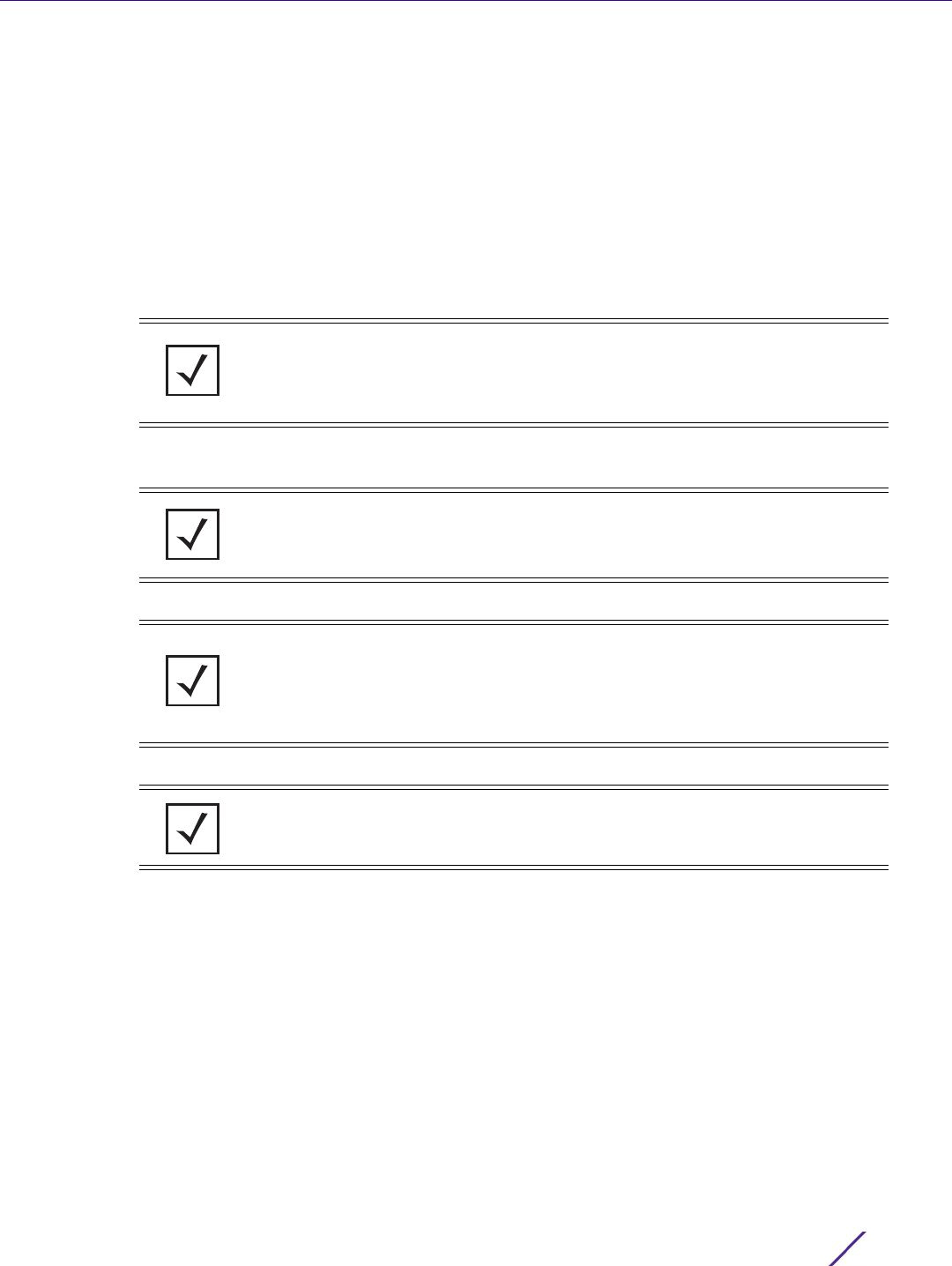
USER EXEC MODE COMMANDS
Access Point, Wireless Controller and Service Platform CLI Reference Guide 2 - 41
2.1.13 device-upgrade
User Exec Commands
Enables firmware upgrade on an adopted device or a set of adopted devices (access points, wireless
controllers, and service platforms).
In an hierarchically managed (HM) network, this command enables centralized device upgradation across
the network. The WiNG HM network defines a three-tier structure, consisting of multiple wireless sites
managed by a single Network Operations Center (NOC) controller. The NOC controller constitutes the first
and the site controllers constitute the second tier of the hierarchy. The site controllers in turn adopt and
manage access points that form the third tier of the hierarchy.
Use the device-upgrade command to schedule firmware upgrades across adopted devices within the
network. Devices are upgraded based on their device names, MAC addresses, or RF Domain.
Supported in the following platforms:
• Access Points — AP6521, AP6522, AP6532, AP6562, AP7161, AP7502, AP7522, AP7532, AP7562,
AP7602, AP7612, AP7622, AP7632, AP7662, AP81XX, AP8232, AP8432, AP8533
• Wireless Controllers — RFS4000, RFS6000
• Service Platforms — NX5500, NX7500, NX7510, NX7520, NX7530, NX9500, NX9510, NX9600,
VX9000
Syntax
device-upgrade [<MAC/HOSTNAME>|all|ap6521|ap6522|ap6532|ap6562|ap71xx|ap7502|
ap7522|ap7532|ap7562|ap7602|ap7612|ap7622|ap76232|ap7662|ap81xx|ap82xx|ap8432|
ap8533|rfs4000|rfs6000|nx5500|nx75xx|nx9000|nx9600|vx9000|cancel-upgrade|load-
image|rf-domain]
device-upgrade <MAC/HOSTNAME> {no-reboot|reboot-time <TIME>|upgrade-time <TIME>
{no-reboot|reboot-time <TIME>}}
NOTE: Hierarchical management allows the NOC controller to upgrade
controllers and access points that are directly or indirectly adopted to it.
However, ensure that the NOC controller is loaded with the correct firmware
version.
NOTE: If the persist-images option is selected, the RF Domain manager
retains the old firmware image, or else deletes it. For more information on
enabling device upgrade on profiles and devices (including the ‘persist-
images’ option), see device-upgrade.
NOTE: A NOC controller’s capacity is equal to, or higher than that of a site
controller. The following devices can be deployed at NOC and sites:
• NOC controller – NX95XX (NX9500 and NX9510), NX9600, VX9000
• Site controller – RFS4000, RFS6000, NX5500, or NX95XX
NOTE: Standalone devices have to be manually upgraded.

USER EXEC MODE COMMANDS
Access Point, Wireless Controller and Service Platform CLI Reference Guide 2 - 42
device-upgrade all {force|no-reboot|reboot-time <TIME>|upgrade-time <TIME>
{no-reboot|reboot-time <TIME>}} {(staggered-reboot)}
device-upgrade [ap6521|ap6522|ap6532|ap6562|ap71xx|ap7502|ap7522|ap7532|ap7562|
ap7602|ap7612|ap7622|ap76232|ap7662|ap81xx|ap82xx|ap8432|ap8533|rfs4000|rfs6000|
nx5500|nx75xx|nx9000|nx9600|vx9000] all {force|no-reboot|reboot-time
<TIME>|upgrade-time <TIME> {no-reboot|reboot-time <TIME>}} {(staggered-reboot)}
device-upgrade cancel-upgrade [<MAC/HOSTNAME>|all|ap6521|ap6522|ap6532|ap6562|
ap71xx|ap7502|ap7522|ap7532|ap7562|ap7602|ap7612|ap7622|ap76232|ap7662|ap81xx|
ap82xx|ap8432|ap8533|rfs4000|rfs6000|nx5500|nx75xx|nx9000|nx9600|vx9000|
on rf-domain [<RF-DOMAIN-NAME>|all]]
device-upgrade load-image [ap6521|ap6522|ap6532|ap6562|ap71xx|ap7502|ap7522|
ap7532|ap7562|ap7602|ap7612|ap7622|ap76232|ap7662|ap81xx|ap82xx|ap8432|ap8533|
rfs4000|rfs6000|nx5500|nx9000|nx9600|vx9000] {<IMAGE-URL>|on <DEVICE-OR-DOMAIN-
NAME>}
device-upgrade rf-domain [<RF-DOMAIN-NAME>|all|containing <WORD>|filter location
<WORD>] [all|ap6521|ap6522|ap6532|ap6562|ap71xx|ap7502|ap7522|ap7532|ap7562|
ap7602|ap7612|ap7622|ap76232|ap7662|ap81xx|ap82xx|ap8432|ap8533|rfs4000|rfs6000|
nx5500|nx75xx|nx9000|nx9600|vx9000] {(<MAC/HOSTNAME>|force|from-controller|
no-reboot|reboot-time <TIME>|staggered-reboot|upgrade-time <TIME>)}
Parameters
• device-upgrade <MAC/HOSTNAME> {no-reboot|reboot-time <TIME>|upgrade-time <TIME>
{no-reboot|reboot-time <TIME>}}
• device-upgrade all {force|no-reboot|reboot-time <TIME>|upgrade-time <TIME>
{no-reboot|reboot-time <TIME>}} {(staggered-reboot)}
<MAC/HOSTNAME> Upgrades firmware on the device identified by the <MAC/HOSTNAME> keyword
• <MAC/HOSTNAME> – Specify the device’s MAC address or hostname.
no-reboot Optional. Disables automatic reboot after a successful upgrade (the device must be
manually restarted)
reboot-time <TIME> Optional. Schedules an automatic reboot after a successful upgrade
• <TIME> – Specify the reboot time in the MM/DD/YYYY-HH:MM or HH:MM format.
upgrade-time <TIME>
{no-reboot|
reboot-time <TIME>}
Optional. Schedules an automatic device firmware upgrade on a specified day and
time
• <TIME> – Specify the upgrade time in the MM/DD/YYYY-HH:MM or HH:MM format.
The following actions can be performed after a scheduled upgrade:
• no-reboot – Optional. Disables automatic reboot after a successful upgrade (the
device must be manually restarted)
• reboot-time <TIME> – Optional. Schedules an automatic reboot after a successful
upgrade. Specify the reboot time in the MM/DD/YYYY-HH:MM or HH:MM format.
all Upgrades firmware on all devices
force Optional. Select this option to force upgrade on the selected device(s). When
selected, the devices are upgraded even if they have the same firmware as the
upgrading access point, wireless controller, or service platform. If forcing a device
upgrade, optionally specify any one of the following options: no-reboot, reboot-time,
upgrade-time, or staggered-reboot.
no-reboot Optional. Disables automatic reboot after a successful upgrade (the device must be
manually restarted)
reboot-time <TIME> Optional. Schedules an automatic reboot after a successful upgrade
• <TIME> – Specify the reboot time in the MM/DD/YYYY-HH:MM or HH:MM format.

USER EXEC MODE COMMANDS
Access Point, Wireless Controller and Service Platform CLI Reference Guide 2 - 43
• device-upgrade [ap6521|ap6522|ap6532|ap6562|ap71xx|ap7502|ap7522|ap7532|
ap7562|ap7602|ap7612|ap7622|ap7632|ap7662|ap81xx|ap82xx|ap8432|ap8533|rfs4000|
rfs6000|nx5500|nx75xx|nx9000|nx9600|vx9000] all {force|no-reboot|reboot-time
<TIME>|upgrade-time <TIME> {no-reboot|reboot-time <TIME>}} {(staggered-reboot)}
upgrade-time <TIME>
{no-reboot|
reboot-time <TIME>}
Optional. Schedules an automatic device firmware upgrade on all devices on a
specified day and time
• <TIME> – Specify the upgrade time in the MM/DD/YYYY-HH:MM or HH:MM format.
The following actions can be performed after a scheduled upgrade:
• no-reboot – Optional. Disables automatic reboot after a successful upgrade (the
device must be manually restarted).
• reboot-time <TIME> – Optional. Schedules an automatic reboot after a successful
upgrade. Specify the reboot time in the MM/DD/YYYY-HH:MM or HH:MM format.
staggered-reboot This keyword is recursive and common to all of the above.
• Optional. Enables staggered device reboot (one at a time) without network impact
device-upgrade
<DEVICE-TYPE> all
Upgrades firmware on all devices of a specific type. Select the device type. The
options are: AP6521, AP6522, AP6532, AP6562, AP7161, AP7502, AP7522, AP7532,
AP7562, AP7602, AP7612, AP7622, AP7632, AP7662, AP81XX, AP8232, AP8432,
AP8533, RFS4000, RFS6000, NX5500, NX75XX, NX9500, NX9600, and VX9000.
After selecting the device type, schedule an automatic upgrade and/or an automatic
reboot.
force Optional. Select this option to force upgrade on the selected device(s). When
selected, the devices are upgraded even if they have the same firmware as the
upgrading access point, wireless controller, or service platform. If forcing a device
upgrade, optionally specify any one of the following options: no-reboot, reboot-time,
upgrade-time, or staggered-reboot.
no-reboot Optional. Disables automatic reboot after a successful upgrade (the device must be
manually restarted)
reboot-time <TIME> Optional. Schedules an automatic reboot after a successful upgrade
• <TIME> – Optional. Specify the reboot time in the MM/DD/YYYY-HH:MM or HH:MM
format.
upgrade-time <TIME>
{no-reboot|
reboot-time <TIME>}
Optional. Schedules an automatic firmware upgrade on all devices, of the specified
type, on a specified day and time
• <TIME> – Specify the upgrade time in the MM/DD/YYYY-HH:MM or HH:MM format.
The following actions can be performed after a scheduled upgrade:
• no-reboot – Optional. Disables automatic reboot after a successful upgrade (the
device must be manually restarted)
• reboot-time <TIME> – Optional. Schedules an automatic reboot after a successful
upgrade. Specify the reboot time in the MM/DD/YYYY-HH:MM or HH:MM format.
staggered-reboot This keyword is recursive and common to all of the above.
• Optional. Enables staggered device reboot (one at a time) without network impact

USER EXEC MODE COMMANDS
Access Point, Wireless Controller and Service Platform CLI Reference Guide 2 - 44
• device-upgrade cancel-upgrade [<MAC/HOSTNAME>|all|ap6521|ap6522|ap6532|
ap6562|ap71xx|ap7502|ap7522|ap7532|ap7562|ap7602|ap7612|ap7622|ap7632|ap7662|
ap81xx|ap82xx|ap8432|ap8533|rfs4000|rfs6000|nx5500|nx75xx|nx9000|nx9600|vx9000|
on rf-domain [<RF-DOMAIN-NAME>|all]]
• device-upgrade load-image [ap6521|ap6522|ap6532|ap6562|ap71xx|ap7502|ap7522|
ap7532|ap7562|ap7602|ap7612|ap7622|ap7632|ap7662|ap81xx|ap82xx|ap8432|ap8533|
rfs4000|rfs6000|nx500|nx9000|nx9600|vx9000] {<IMAGE-URL>|on <DEVICE-OR-DOMAIN-
NAME>}
cancel-upgrade Cancels a scheduled firmware upgrade based on the parameters passed. This
command provides the following options to cancel scheduled firmware upgrades:
• Cancels upgrade on specific device(s). The devices are identified by their MAC
addresses or hostnames.
• Cancels upgrade on all devices within the network
• Cancels upgrade on all devices of a specific type. Specify the device type.
• Cancels upgrade on specific device(s) or all device(s) within a specific RF Domain or
all RF Domains. Specify the RF Domain name.
cancel-upgrade
[<MAC/HOSTNAME>|
all]
Cancels a scheduled firmware upgrade on a specified device or on all devices
• <MAC/HOSTNAME> – Cancels a scheduled upgrade on the device identified by the
<MAC/HOSTNAME> keyword. Specify the device’s MAC address or hostname.
• all – Cancels scheduled upgrade on all devices
cancel-upgrade
<DEVICE-TYPE> all
Cancels scheduled firmware upgrade on all devices of a specific type. Select the
device type. The options are: AP6521, AP6522, AP6532, AP6562, AP7161, AP7502,
AP7522, AP7532, AP7562, AP7602, AP7612, AP7622, AP7632, AP7662, AP81XX,
AP8232, AP8432, AP8533, RFS4000, RFS6000, NX5500, NX75XX, NX9500,
NX9600, and VX9000.
cancel-upgrade on
rf-domain
[<RF-DOMAIN-
NAME>|all]
Cancels scheduled firmware upgrade on all devices in a specified RF Domain or all
RF Domains
• <RF-DOMAIN-NAME> – Cancels scheduled device upgrade on all devices in a
specified RF Domain. Specify the RF Domain name.
• all – Cancels scheduled device upgrade on all devices across all RF Domains
load-image
<DEVICE-TYPE>
Loads device firmware image from a specified location. Use this command to specify
the device type and the location of the corresponding image file.
• <DEVICE-TYPE> – Specify the device type. The options are: AP6521, AP6522,
AP6532, AP6562, AP7161, AP7502, AP7522, AP7532, AP7562, AP7602, AP7612,
AP7622, AP7632, AP7662, AP81XX, AP8232, AP8432, AP8533, RFS4000, RFS6000,
NX5500, NX75XX, NX9500, NX9600, and VX9000.
After specifying the device type, provide the location of the required device firmware
image.
<IMAGE-URL> Specify the device’s firmware image location in one of the following formats:
IPv4 URLs:
tftp://<hostname|IP>[:port]/path/file
ftp://<user>:<passwd>@<hostname|IP>[:port]/path/file
sftp://<user>:<passwd>@<hostname|IP>[:port]>/path/file
http://<hostname|IP>[:port]/path/file
cf:/path/file
usb<n>:/path/file

USER EXEC MODE COMMANDS
Access Point, Wireless Controller and Service Platform CLI Reference Guide 2 - 45
• device-upgrade rf-domain [<RF-DOMAIN-NAME>|all|containing <WORD>|filter
location <WORD>] [all|ap6521|ap6522|ap6532|ap6562|ap71xx|ap7502|ap7522|ap7532|
ap7562|ap7602|ap7612|ap7622|ap7632|ap7662|ap81xx|ap82xx|ap8432|ap8533|rfs4000|
rfs6000|nx5500|nx75xx|nx9000|nx9600|vx9000] {(<MAC/HOSTNAME>|force|from-
controller|no-reboot|reboot-time <TIME>|staggered-reboot|upgrade-time <TIME>)}
IPv6 URLs:
tftp://<hostname|[IPv6]>[:port]/path/file
ftp://<user>:<passwd>@<hostname|[IPv6]>[:port]/path/file
sftp://<user>:<passwd>@<hostname|[IPv6]>[:port]>/path/file
http://<hostname|[IPv6]>[:port]/path/file
on <DEVICE-OR-
DOMAIN-NAME>
Specify the name of the device or RF Domain. The image, of the specified device
type is loaded from the device specified here. In case of an RF Domain, the image
available on the RF Domain manager is loaded.
• <DEVICE-OR-DOMAIN-NAME> – Specify the name of the AP, wireless controller,
service platform, or RF Domain.
rf-domain
[<RF-DOMAIN-
NAME>|all|
containing <WORD>|
filter location
<WORD>]
Upgrades firmware on devices in a specified RF Domain or all RF Domains. Devices
within a RF Domain are upgraded through the RF Domain manager.
• <RF-DOMAIN-NAME> – Upgrades devices in the RF Domain identified by the <RF-
DOMAIN-NAME> keyword.
• <RF-DOMAIN-NAME> – Specify the RF Domain name.
• all – Upgrades devices across all RF Domains
• containing <WORD> – Filters RF Domains by their names. RF Domains with names
containing the sub-string identified by the <WORD> keyword are filtered. Devices on
the filtered RF Domains are upgraded.
• filter location <WORD> – Filters devices by their location. All devices with location
matching the <WORD> keyword are upgraded.
<DEVICE-TYPE> After specifying the RF Domain, select the device type. The options are: AP6521,
AP6522, AP6532, AP6562, AP7161, AP7502, AP7522, AP7532, AP7562, AP7602,
AP7612, AP7622, AP7632, AP7662, AP81XX, AP8232, AP8432, AP8533, RFS4000,
RFS6000, NX5500, NX75XX, NX9500, NX9600, and VX9000.
After specifying the RF Domain and the device type, configure any one of the
following actions: force devices to upgrade, or initiate an upgrade through the
adopting controller.
<MAC/HOSTNAME> Optional. Use this option to identify specific devices for upgradation. Specify the
device’s MAC address or hostname. The device should be within the specified RF
Domain and of the specified device type. After identifying the devices to upgrade,
configure any one of the following actions: force devices to upgrade, or initiate an
upgrade through the adopting controller.
Note: If no MAC address or hostname is specified, all devices of the type selected are
upgraded.
force Optional. Select this option to force upgrade for the selected device(s). When
selected, the devices are upgraded even if they have the same firmware as the
upgrading access point, wireless controller, or service platform. If forcing a device
upgrade, optionally specify any one of the following options: no-reboot, reboot-time,
upgrade-time, or reboot-time.
from-controller Optional. Upgrades a device through the adopted device. If initiating an upgrade
through the adopting controller, optionally specify any one of the following options:
no-reboot, reboot-time, upgrade-time, or reboot-time.

USER EXEC MODE COMMANDS
Access Point, Wireless Controller and Service Platform CLI Reference Guide 2 - 46
Example
nx9500-6C8809>show adoption status
--------------------------------------------------------------------------------
------------------------
DEVICE-NAME VERSION CFG-STAT MSGS ADOPTED-BY LAST-ADOPTION
UPTIME
--------------------------------------------------------------------------------
------------------------
rfs6000-81742D 5.9.1.0-012D configured No nx9500-6C8809 2 days 12:23:52
13 days 22:32:38
t5-ED7C6C 5.4.2.0-010R configured No nx9500-6C8809 13 days
22:47:46 16 days 22:33:25
--------------------------------------------------------------------------------
------------------------
Total number of devices displayed: 2
nx9500-6C8809>
nx9500-6C8809>show device-upgrade versions
--------------------------------------------------------------------------------
CONTROLLER DEVICE-TYPE VERSION
--------------------------------------------------------------------------------
nx9500-6C8809 ap621 5.9.0.0-014D
nx9500-6C8809 ap622 5.9.1.0-012D
nx9500-6C8809 ap650 5.9.1.0-012D
nx9500-6C8809 ap6511 none
nx9500-6C8809 ap6521 5.9.0.0-014D
nx9500-6C8809 ap6522 5.9.1.0-012D
nx9500-6C8809 ap6532 5.9.1.0-012D
nx9500-6C8809 ap6562 5.9.1.0-012D
nx9500-6C8809 ap71xx 5.9.1.0-012D
nx9500-6C8809 ap7502 5.9.1.0-012D
nx9500-6C8809 ap7522 5.9.1.0-012D
nx9500-6C8809 ap7532 5.9.1.0-012D
nx9500-6C8809 ap7562 5.9.1.0-012D
nx9500-6C8809 ap7602 5.9.1.0-012D
nx9500-6C8809 ap7612 5.9.1.0-012D
nx9500-6C8809 ap7622 5.9.1.0-012D
nx9500-6C8809 ap7632 5.9.1.0-012D
nx9500-6C8809 ap7662 5.9.1.0-012D
nx9500-6C8809 ap81xx 5.9.1.0-012D
nx9500-6C8809 ap82xx 5.9.1.0-012D
nx9500-6C8809 ap8432 5.9.1.0-012D
nx9500-6C8809 ap8533 5.9.1.0-012D
nx9500-6C8809 nx45xx none
nx9500-6C8809 nx5500 none
no-reboot
{staggered-reboot}
Optional. Disables automatic reboot after a successful upgrade (the device must be
manually restarted)
reboot-time <TIME>
{staggered-reboot}
Optional. Schedules an automatic reboot after a successful upgrade. Specify the
reboot time in the MM/DD/YYYY-HH:MM or HH:MM format.
staggered-reboot This keyword is common to all of the above.
Optional. Enables staggered reboot (one at a time) without network impact
upgrade-time <TIME>
{no-reboot|
reboot-time <TIME>}
Optional. Schedules an automatic firmware upgrade
• <TIME> – Specify the upgrade time in the MM/DD/YYYY-HH:MM or HH:MM format.
After a scheduled upgrade, the following actions can be performed.
• no-reboot – Optional. Disables automatic reboot after a successful upgrade the
device must be manually restarted)
• reboot-time <TIME> – Optional. Schedules an automatic reboot after a successful
upgrade. Specify the reboot time in the MM/DD/YYYY-HH:MM or HH:MM format.

USER EXEC MODE COMMANDS
Access Point, Wireless Controller and Service Platform CLI Reference Guide 2 - 47
nx9500-6C8809 nx65xx none
nx9500-6C8809 nx75xx none
nx9500-6C8809 nx9000 none
nx9500-6C8809 rfs4000 5.9.1.0-012D
nx9500-6C8809 rfs6000 5.9.1.0-012D
nx9500-6C8809 rfs7000 5.9.0.0-010D
nx9500-6C8809 vx9000 none
--------------------------------------------------------------------------------
nx9500-6C8809>
nx9500-6C8809#device-upgrade load-image rfs6000 ftp://
anonymous:anonymous@192.168.13.10/LatestBuilds/W591/RFS6000-LEAN-5.9.1.0-
015D.img
--------------------------------------------------------------------------------
CONTROLLER STATUS MESSAGE
--------------------------------------------------------------------------------
nx9500-6C8809 Success Successfully initiated load image
--------------------------------------------------------------------------------
nx9500-6C8809#
nx9500-6C8809#show device-upgrade load-image-status
Download of rfs6000 firmware file is complete
nx9500-6C8809#
nx9500-6C8809>show device-upgrade versions
--------------------------------------------------------------------------------
CONTROLLER DEVICE-TYPE VERSION
--------------------------------------------------------------------------------
nx9500-6C8809 ap621 5.9.0.0-014D
nx9500-6C8809 ap622 5.9.1.0-012D
nx9500-6C8809 ap650 5.9.1.0-012D
nx9500-6C8809 ap6511 none
nx9500-6C8809 ap6521 5.9.0.0-014D
nx9500-6C8809 ap6522 5.9.1.0-012D
nx9500-6C8809 ap6532 5.9.1.0-012D
nx9500-6C8809 ap6562 5.9.1.0-012D
nx9500-6C8809 ap71xx 5.9.1.0-012D
nx9500-6C8809 ap7502 5.9.1.0-012D
nx9500-6C8809 ap7522 5.9.1.0-012D
nx9500-6C8809 ap7532 5.9.1.0-012D
nx9500-6C8809 ap7562 5.9.1.0-012D
nx9500-6C8809 ap7602 5.9.1.0-012D
nx9500-6C8809 ap7612 5.9.1.0-012D
nx9500-6C8809 ap7622 5.9.1.0-012D
nx9500-6C8809 ap7632 5.9.1.0-012D
nx9500-6C8809 ap7662 5.9.1.0-012D
nx9500-6C8809 ap81xx 5.9.1.0-012D
nx9500-6C8809 ap82xx 5.9.1.0-012D
nx9500-6C8809 ap8432 5.9.1.0-012D
nx9500-6C8809 ap8533 5.9.1.0-012D
nx9500-6C8809 nx45xx none
nx9500-6C8809 nx5500 none
nx9500-6C8809 nx65xx none
nx9500-6C8809 nx75xx none
nx9500-6C8809 nx9000 none
nx9500-6C8809 rfs4000 5.9.1.0-012D
nx9500-6C8809 rfs6000 5.9.1.0-015D
nx9500-6C8809 rfs7000 5.9.0.0-010D
nx9500-6C8809 vx9000 none
--------------------------------------------------------------------------------
nx9500-6C8809>

USER EXEC MODE COMMANDS
Access Point, Wireless Controller and Service Platform CLI Reference Guide 2 - 48
nx9500-6C8809>device-upgrade rfs6000-81742D
--------------------------------------------------------------------------------
CONTROLLER STATUS MESSAGE
--------------------------------------------------------------------------------
B4-C7-99-6C-88-09 Success Queued 1 devices to upgrade
--------------------------------------------------------------------------------
nx9500-6C8809>
nx9500-6C8809>show device-upgrade status
Number of devices currently being upgraded : 1
Number of devices waiting in queue to be upgraded : 0
Number of devices currently being rebooted : 0
Number of devices waiting in queue to be rebooted : 0
Number of devices failed upgrade : 0
--------------------------------------------------------------------------------
------------------------------
DEVICE STATE UPGRADE TIME REBOOT TIME PROGRESS RETRIES LAST
UPDATE ERROR UPGRADED BY
--------------------------------------------------------------------------------
------------------------------
rfs6000-81742D downloading immediate immediate 17 0 -
nx9500-6C8809
--------------------------------------------------------------------------------
------------------------------
nx9500-6C8809>
nx9500-6C8809>show adoption status
--------------------------------------------------------------------------------
-------------------------------
DEVICE-NAME VERSION CFG-STAT MSGS ADOPTED-BY LAST-
ADOPTION UPTIME
--------------------------------------------------------------------------------
-------------------------------
rfs6000-81742D 5.9.1.0-015D version-mismatch No nx9500-6C8809 0 days 00:00:42
0 days 00:03:33
t5-ED7C6C 5.4.2.0-010R configured No nx9500-6C8809 13 days
23:09:38 16 days 22:55:17
--------------------------------------------------------------------------------
--------------------------------
Total number of devices displayed: 2
nx9500-6C8809>

USER EXEC MODE COMMANDS
Access Point, Wireless Controller and Service Platform CLI Reference Guide 2 - 49
2.1.14 disable
User Exec Commands
This command can be executed in the Priv Exec Mode only. When executed, the command turns off
(disables) the privileged mode command set and returns to the User Executable Mode. The prompt
changes from rfs6000-81742D# to rfs6000-81742D>.
Supported in the following platforms:
• Access Points — AP6521, AP6522, AP6532, AP6562, AP7161, AP7502, AP7522, AP7532, AP7562,
AP7602, AP7612, AP7622, AP7632, AP7662, AP81XX, AP8232, AP8432, AP8533
• Wireless Controllers — RFS4000, RFS6000
• Service Platforms — NX5500, NX7500, NX7510, NX7520, NX7530, NX9500, NX9510, NX9600,
VX9000
Syntax
disable
Parameters
None
Example
rfs6000-81742D#disable
rfs6000-81742D>

USER EXEC MODE COMMANDS
Access Point, Wireless Controller and Service Platform CLI Reference Guide 2 - 50
2.1.15 enable
User Exec Commands
Turns on (enables) the privileged mode command set. The prompt changes from rfs6000-81742D> to
rfs6000-81742D#. This command does not do anything in the Privilege Executable mode.
Supported in the following platforms:
• Access Points — AP6521, AP6522, AP6532, AP6562, AP7161, AP7502, AP7522, AP7532, AP7562,
AP7602, AP7612, AP7622, AP7632, AP7662, AP81XX, AP8232, AP8432, AP8533
• Wireless Controllers — RFS4000, RFS6000
• Service Platforms — NX5500, NX7500, NX7510, NX7520, NX7530, NX9500, NX9510, NX9600,
VX9000
Syntax
enable
Parameters
None
Example
rfs6000-81742D>enable
rfs6000-81742D#

USER EXEC MODE COMMANDS
Access Point, Wireless Controller and Service Platform CLI Reference Guide 2 - 51
2.1.16 file-sync
User Exec Commands
Syncs trustpoint and/or EAP-TLS X.509 (PKCS#12) certificate between the staging-controller and adopted
access points.
When enabling file syncing, consider the following points:
• The X.509 certificate needs synchronization only if the access point is configured to use EAP-TLS
authentication.
• Execute the command on the controller adopting the access points.
• Ensure that the X.509 certificate file is installed on the controller.
Syncing of trustpoint/wireless-bridge certificate can be automated. To automate file syncing, in the
controller’s device/profile configuration mode, execute the following command: file-sync [auto|count <1-
20>]. For more information, see file-sync.
Supported in the following platforms:
• Access Points — AP6521, AP6522, AP6532, AP6562, AP7161, AP7502, AP7522, AP7532, AP7562,
AP7602, AP7612, AP7622, AP7632,AP7662, AP81XX, AP8232, AP8432, AP8533
• Wireless Controllers — RFS4000, RFS6000
• Service Platforms — NX5500, NX7500, NX7510, NX7520, NX7530, NX9500, NX9510, NX9600,
VX9000
Syntax
file-sync [cancel|load-file|trustpoint|wireless-bridge]
file-sync cancel [trustpoint|wireless-bridge]
file-sync cancel [trustpoint|wireless-bridge] [<DEVICE-NAME>|all|rf-domain
[<DOMAIN-NAME>|all]]
file-sync load-file [trustpoint|wireless-bridge]]
file-sync load-file [trustpoint <TRUSTPOINT-NAME>|wireless-bridge] <URL>
file-sync [trustpoint <TRUSTPOINT-NAME>|wireless-bridge] [<DEVICE-NAME>|all|
rf-domain [<DOMAIN-NAME>|all] {from-controller}] {reset-radio|upload-time <TIME>}
Parameters
• file-sync cancel [trustpoint|wireless-bridge] [<DEVICE-NAME>|all|rf-domain
[<DOMAIN-NAME>|all]]
file-sync cancel
[trustpoint|
wireless-bridge]
[<DEVICE-NAME>|
all|rf-domain
[<DOMAIN-NAME>|
all]]
Cancels scheduled file synchronization
• trustpoint – Cancels scheduled trustpoint synchronization on a specified AP, all APs, or
APs within a specified RF Domain
• wireless-bridge – Cancels scheduled wireless-bridge certificate synchronization on a
specified AP, all APs, or APs within a specified RF Domain
• <DEVICE-NAME> – Cancels scheduled trustpoint/certificate synchronization on a
specified AP. Specify the AP’s hostname or MAC address.
• all – Cancels scheduled trustpoint/certificate synchronization on all APs
Contd..

USER EXEC MODE COMMANDS
Access Point, Wireless Controller and Service Platform CLI Reference Guide 2 - 52
• file-sync load-file [trustpoint|wireless-bridge] <URL>
• file-sync [trustpoint <TRUSTPOINT-NAME>|wireless-bridge] [<DEVICE-NAME>|all|rf-
domain [<DOMAIN-NAME>|all] {from-controller}] {reset-radio|upload-time <TIME>}
• rf-domain [<DOMAIN-NAME>|all] – Cancels scheduled trustpoint/certificate syn-
chronization on all APs in a specified RF Domain or in all RF Domains
• <DOMAIN-NAME> – Cancels scheduled trustpoint/certificate synchronization on
all APs within a specified RF Domain. Specify the RF Domain’s name.
• all – Cancels scheduled trustpoint/certificate synchronization on all RF Domains
file-sync load-file
[trustpoint|
wireless-bridge]
<URL>
Loads the following files on to the staging controller:
• trustpoint – Loads the trustpoint, including CA certificate, server certificate and private
key
• wireless-bridge – Loads the wireless-bridge certificate to the staging controller
Use this command to load the certificate to the controller before scheduling or
initiating a certificate synchronization.
• <URL> – Provide the trustpoint/certificate location using one of the following for-
mats:
tftp://<hostname|IP>[:port]/path/file
ftp://<user>:<passwd>@<hostname|IP>[:port]/path/file
sftp://<user>:<passwd>@<hostname|IP>[:port]>/path/file
http://<hostname|IP>[:port]/path/file
cf:/path/file
usb<n>:/path/file
Note: Both IPv4 and IPv6 address types are supported.
file-sync
trustpoint
<TRUSTPOINT-
NAME>
[<DEVICE-NAME>|
all|rf-domain
[<DOMAIN-NAME>
|all] from-controller]
Configures file-syncing parameters
• trustpoint <TRUSTPOINT-NAME> – Syncs a specified trustpoint between controller and
its adopted APs
• <TRUSTPOINT-NAME> – Specify the trustpoint name.
• wireless-bridge – Syncs wireless-bridge certificate between controller and its adopted
APs
After specifying the file that is to be synced, configure following file-sync parameters:
• <DEVICE-NAME> – Syncs trustpoint/certificate with a specified AP. Specify the AP’s
hostname or MAC address.
• all – Syncs trustpoint/certificate with all APs
• rf-domain [<DOMAIN-NAME>|all] – Syncs trustpoint/certificate with all APs in a
specified RF Domain or in all RF Domains
• <DOMAIN-NAME> – Select to sync with APs within a specified RF Domain. Specify
the RF Domain’s name.
• all – Select to sync with APs across all RF Domains
• from-controller – Optional. Loads certificate to the APs from the adopting
controller and not the RF Domain manager
After specifying the access points, specify the following options: reset-radio and
upload-time.

USER EXEC MODE COMMANDS
Access Point, Wireless Controller and Service Platform CLI Reference Guide 2 - 53
Example
rfs6000-81742D>file-sync wireless-bridge ap7131-11E6C4 upload-time 06/01/2017-
12:30
--------------------------------------------------------------------------------
CONTROLLER STATUS MESSAGE
--------------------------------------------------------------------------------
B4-C7-99-6D-CD-4B Success Queued 1 APs to upload
--------------------------------------------------------------------------------
rfs6000-81742D>
The following command uploads certificate to all access points:
rfs6000-81742D>file-sync wireless-bridge all upload-time 06/01/2017-23:42
reset-radio This keyword is recursive and applicable to all of the above parameters.
Optional. Resets the radio after file synchronization. Reset the radio in case the
certificate is renewed along with no changes made to the ‘bridge EAP username’ and
‘bridge EAP password’.
upload-time <TIME> This keyword is recursive and applicable to all of the above parameters.
• upload-time – Optional. Schedules certificate upload at a specified time
• <TIME> – Specify the time in the MM/DD/YYYY-HH:MM or HH:MM format. If no time
is configured, the process is initiated as soon as the command is executed.

USER EXEC MODE COMMANDS
Access Point, Wireless Controller and Service Platform CLI Reference Guide 2 - 54
2.1.17 join-cluster
User Exec Commands
Adds a device (access point, wireless controller, or service platform), as a member, to an existing cluster of
devices. Assign a static IP address to the device before adding to a cluster. Note, a cluster can be only
formed of devices of the same model type.
Supported in the following platforms:
• Wireless Controllers — RFS4000, RFS6000
• Service Platforms — NX5500, NX7500, NX7510, NX7520, NX7530, NX9500, NX9510, NX9600,
VX9000
Syntax
join-cluster <IP> user <USERNAME> password <WORD> {level|mode}
join-cluster <IP> user <USERNAME> password <WORD> {level [1|2]|mode
[active|standby]}
Parameters
• join-cluster <IP> user <USERNAME> password <WORD> {level [1|2]|mode
[active|standby]}
Usage Guidelines
To add a device to an existing cluster:
• Configure a static IP address on the device (access point, wireless controller, or service platform).
• Provide username and password for superuser, network admin, system admin, or operator
accounts.
After adding the device to a cluster, execute the “write memory” command to ensure the configuration
persists across reboots.
Example
rfs4000-880DA7>join-cluster 192.168.13.15 user admin password superuser level 1
mode standby
... connecting to 192.168.13.15
... applying cluster configuration
... committing the changes
... saving the changes
[OK]
rfs4000-880DA7>
join-cluster Adds an access point, wireless controller, or service platform to an existing cluster
<IP> Specify the cluster member’s IP address.
user <USERNAME> Specify a user account with super user privileges on the new cluster member
password <WORD> Specify password for the account specified in the user parameter
level [1|2] Optional. Configures the routing level
• 1 – Configures level 1 routing
• 2 – Configures level 2 routing
mode
[active|standby]
Optional. Configures the cluster mode
• active – Configures this cluster as active
• standby – Configures this cluster to be on standby mode

USER EXEC MODE COMMANDS
Access Point, Wireless Controller and Service Platform CLI Reference Guide 2 - 55
rfs4000-880DA7>show context
!
! Configuration of RFS4000 version 5.9.1.0-012D
!
!
version 2.5
!
!
................................................................................
interface vlan1
ip address 192.168.13.15/24
no ipv6 enable
no ipv6 request-dhcpv6-options
cluster name TechPubs
cluster mode standby
cluster member ip 192.168.13.15
logging on
logging console warnings
logging buffered warnings
!
!
end
rfs4000-880DA7>
Related Commands
cluster Initiates cluster context. The cluster context enables centralized management and
configuration of all cluster members from any one member.
create-cluster Creates a new cluster on a specified device

USER EXEC MODE COMMANDS
Access Point, Wireless Controller and Service Platform CLI Reference Guide 2 - 56
2.1.18 l2tpv3
User Exec Commands
Establishes and/or brings down a Layer 2 Tunnel Protocol Version 3 (L2TPV3) tunnel
Supported in the following platforms:
• Access Points — AP6521, AP6522, AP6532, AP6562, AP7161, AP7502, AP7522, AP7532, AP7562,
AP7602, AP7612, AP7622, AP7632, AP7662, AP81XX, AP8232, AP8432, AP8533
• Wireless Controllers — RFS4000, RFS6000
• Service Platforms — NX5500, NX7500, NX7510, NX7520, NX7530, NX9500, NX9510, NX9600,
VX9000
Syntax
l2tpv3 tunnel [<TUNNEL-NAME>|all]
l2tpv3 tunnel <TUNNEL-NAME> [down|session|up]
l2tpv3 tunnel <TUNNEL-NAME> [down|up] {on <DEVICE-NAME>}
l2tpv3 tunnel <TUNNEL-NAME> session <SESSION-NAME> [down|up] {on <DEVICE-NAME>}
l2tpv3 tunnel all [down|up] {on <DEVICE-NAME>}
Parameters
• l2tpv3 tunnel <TUNNEL-NAME> [down|up] {on <DEVICE-NAME>}
• l2tpv3 tunnel <TUNNEL-NAME> session <SESSION-NAME> [down|up] {on <DEVICE-NAME>}
• l2tpv3 tunnel all [down|up] {on <DEVICE-NAME>}
l2tpv3 tunnel Establishes or brings down L2TPv3 tunnels
<TUNNEL-NAME>
[down|up]
Specifies the tunnel name to establish or bring down
• down – Brings down the specified tunnel
• up – Establishes the specified tunnel
on
<DEVICE-NAME>
Optional. Establishes or brings down a tunnel on a specified device
• <DEVICE-NAME> – Specify the name of the AP, wireless controller, or service platform.
l2tpv3 tunnel Establishes or brings down L2TPv3 tunnels
<TUNNEL-NAME>
[session
<SESSION-NAME>]
[down|up]
Establishes or brings down a specified session inside an L2TPv3 tunnel
• <TUNNEL-NAME> – Specify the tunnel name.
• session <SESSION-NAME> – Identifies a specific session
• <SESSION-NAME> – Specify the session name.
• down – Brings down the session identified by the <SESSION-NAME> key-
word
• up – Establishes the session identified by the <SESSION-NAME> keyword
on
<DEVICE-NAME>
Optional. Establishes or brings down a tunnel session on a specified device
• <DEVICE-NAME> – Specify the name of the AP, wireless controller, or service platform.
l2tpv3 tunnel Establishes or brings down L2TPv3 tunnels
all [down|up] Establishes or brings down all L2TPv3 tunnels
• down – Brings down all tunnels
• up – Establishes all tunnels

USER EXEC MODE COMMANDS
Access Point, Wireless Controller and Service Platform CLI Reference Guide 2 - 57
Example
rfs6000-81742D>l2tpv3 tunnel Tunnel1 session Tunnel1Session1 up on rfs6000-81742D
on
<DEVICE-NAME>
Optional. Establishes or brings down all tunnels on a specified device
• <DEVICE-NAME> – Specify the name of the AP, wireless controller, or service platform.
NOTE: For more information on the L2TPv3 tunnel configuration mode and
commands, see Chapter 22, L2TPV3-POLICY.

USER EXEC MODE COMMANDS
Access Point, Wireless Controller and Service Platform CLI Reference Guide 2 - 58
2.1.19 logging
User Exec Commands
Modifies message logging settings
Supported in the following platforms:
• Access Points — AP6521, AP6522, AP6532, AP6562, AP7161, AP7502, AP7522, AP7532, AP7562,
AP7602, AP7612, AP7622, AP7632, AP7662, AP81XX, AP8232, AP8432, AP8533
• Wireless Controllers — RFS4000, RFS6000
• Service Platforms — NX5500, NX7500, NX7510, NX7520, NX7530, NX9500, NX9510, NX9600,
VX9000
Syntax
logging monitor {<0-7>|alerts|critical|debugging|emergencies|errors|
informational|notifications|warnings}
Parameters
• logging monitor {<0-7>|alerts|critical|debugging|emergencies|errors|
informational|notifications|warnings}
Example
rfs6000-81742D(config-device-00-15-70-81-74-2D)##logging on
rfs6000-81742D>logging monitor debugging
rfs6000-81742D>show logging
Logging module: enabled
Aggregation time: disabled
Console logging: level warnings
Monitor logging: level debugging
Buffered logging: level warnings
Syslog logging: level warnings
Facility: local7
Log Buffer (69317 bytes):
monitor Sets the terminal lines logging levels. The logging severity levels can be set from 0 - 7.
The system uses default settings, if no logging severity level is specified.
• <0-7> – Optional. Specify the logging severity level from 0-7. The various levels and
their implications are as follows:
• alerts – Optional. Immediate action needed (severity=1)
• critical – Optional. Critical conditions (severity=2)
• debugging – Optional. Debugging messages (severity=7)
• emergencies – Optional. System is unusable (severity=0)
• errors – Optional. Error conditions (severity=3)
• informational – Optional. Informational messages (severity=6)
• notifications – Optional. Normal but significant conditions (severity=5)
• warnings – Optional. Warning conditions (severity=4)
Note: Before configuring the message logging level, ensure logging module is enabled. To
enable message logging, in the device’s configuration mode, execute the logging > on
command. Message logging can also be enabled on a profile. All devices using the profile
will have message logging enabled.

USER EXEC MODE COMMANDS
Access Point, Wireless Controller and Service Platform CLI Reference Guide 2 - 59
Apr 04 11:53:02 2017: %DIAG-4-FAN_UNDERSPEED: Fan fan 1 under speed: 0 RPM is under
limit 2000 RPM
Apr 04 11:43:02 2017: %DIAG-4-FAN_UNDERSPEED: Fan fan 1 under speed: 0 RPM is under
limit 2000 RPM
--More--
rfs6000-81742D>
Related Commands
no Resets terminal lines logging levels

USER EXEC MODE COMMANDS
Access Point, Wireless Controller and Service Platform CLI Reference Guide 2 - 60
2.1.20 mint
User Exec Commands
Uses MiNT protocol to perform a ping and traceroute to a remote device
Supported in the following platforms:
• Access Points — AP6521, AP6522, AP6532, AP6562, AP7161, AP7502, AP7522, AP7532, AP7562,
AP7602, AP7612, AP7622, AP7632, AP7662, AP81XX, AP8232, AP8432, AP8533
• Wireless Controllers — RFS4000, RFS6000
• Service Platforms — NX5500, NX7500, NX7510, NX7520, NX7530, NX9500, NX9510, NX9600,
VX9000
Syntax
mint [ping|traceroute]
mint ping <MINT-ID> {(count <1-10000>|size <1-64000>|timeout <1-10>)}
mint traceroute <MINT-ID> {(destination-port <1-65535>|max-hops <1-255>|source-
port <1-65535>|timeout <1-255>)}
Parameters
• mint ping <MINT-ID> {(count <1-10000>|size <1-64000>|timeout <1-10>)}
• mint traceroute <MINT-ID> {(destination-port <1-65535>|max-hops <1-255>|
source-port <1-65535>|timeout <1-255>)}
ping <MINT-ID> Sends a MiNT echo message to a specified destination
• <MINT-ID> – Specify the destination device’s MiNT ID.
count <1-10000> Optional. Sets the pings to the MiNT destination
• <1- 10000> – Specify a value from 1 - 10000. The default is 3.
size <1-64000> Optional. Sets the MiNT payload size in bytes
• <1-64000> – Specify a value from 1 - 640000 bytes. The default is 64 bytes.
timeout <1-10> Optional. Sets a response time in seconds
• <1-10> – Specify a value from 1 sec - 10 sec. The default is 1 second.
traceroute
<MINT-ID>
Prints the route packets trace to a device
• <MINT-ID> – Specify the destination device’s MiNT ID.
destination-port
<1-65535>
Optional. Sets the Equal-cost Multi-path (ECMP) routing destination port
• <1- 65535> – Specify a value from 1 - 65535. The default port is 45.
max-hops <1-255> Optional. Sets the maximum number of hops a traceroute packet traverses in the
forward direction
• <1- 255> – Specify a value from 1 - 255. The default is 30.
source-port
<1-65535>
Optional. Sets the ECMP source port
• <1- 65535> – Specify a value from 1 - 65535. The default port is 45.
timeout <1-255> Optional. Sets the minimum response time period in seconds
• <1- 255> – Specify a value from 1 sec - 255 sec. The default is 30 seconds.

USER EXEC MODE COMMANDS
Access Point, Wireless Controller and Service Platform CLI Reference Guide 2 - 61
Example
rfs6000-81742D>mint ping 19.6C.88.09
MiNT ping 19.6C.88.09 with 64 bytes of data.
Response from 19.6C.88.09: id=1 time=0.219 ms
Response from 19.6C.88.09: id=2 time=0.145 ms
Response from 19.6C.88.09: id=3 time=0.127 ms
--- 19.6C.88.09 ping statistics ---
3 packets transmitted, 3 packets received, 0% packet loss
round-trip min/avg/max = 0.127/0.164/0.219 ms
rfs6000-81742D>
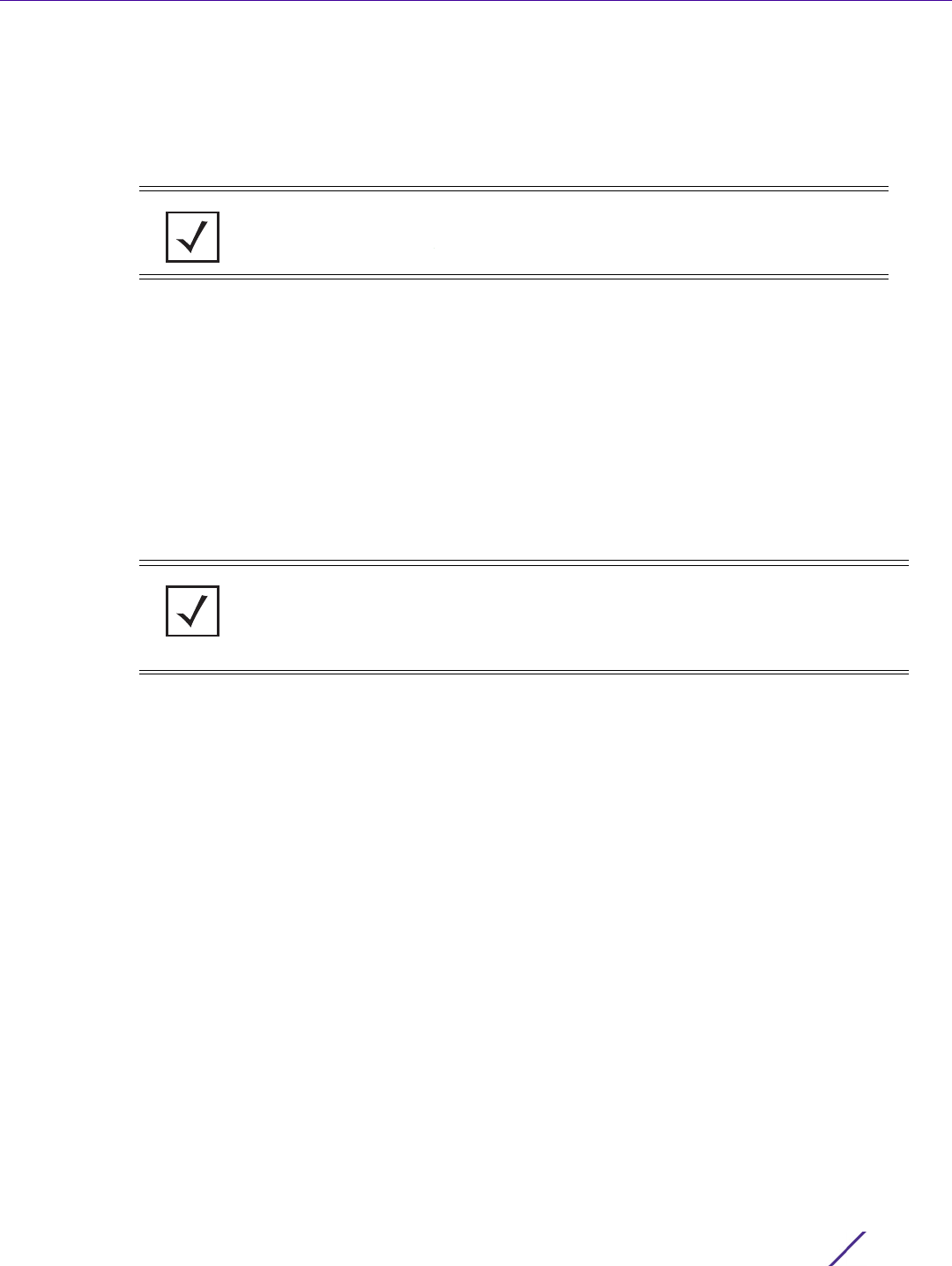
USER EXEC MODE COMMANDS
Access Point, Wireless Controller and Service Platform CLI Reference Guide 2 - 62
2.1.21 no
User Exec Commands
Use the no command to revert a command or to set parameters to their default. This command turns off
an enabled feature or reverts settings to default.
Supported in the following platforms:
• Access Points — AP6521, AP6522, AP6532, AP6562, AP7161, AP7502, AP7522, AP7532, AP7562,
AP7602, AP7612, AP7622, AP7632, AP7662, AP81XX, AP8232, AP8432, AP8533
• Wireless Controllers — RFS4000, RFS6000
• Service Platforms — NX5500, NX7500, NX7510, NX7520, NX7530, NX9500, NX9510, NX9600,
VX9000
Syntax
no [adoption|captive-portal|crypto|debug|logging|page|service|terminal|
virtual-machine|wireless]
no adoption {on <DEVICE-OR-DOMAIN-NAME>}
no captive-portal client [captive-portal <CAPTIVE-PORTAL-NAME>|mac <MAC>]
{on <DEVICE-OR-DOMAIN-NAME>}
no crypto pki [server|trustpoint]
no crypto pki [server|trustpoint] <TRUSTPOINT-NAME> {del-key {on <DEVICE-NAME>}|
on <DEVICE-NAME>}
no logging monitor
no page
no service [block-adopter-config-update|locator|snmp|ssm|wireless]
no service snmp sysoid wing5
no service block-adopter-config-update
no service ssm trace pattern {<WORD>} {on <DEVICE-NAME>}
no service wireless [trace pattern {<WORD>} {on <DEVICE-NAME>}|unsanctioned ap air-
terminate <BSSID> {on <DOMAIN-NAME>}]
no service locator {on <DEVICE-NAME>}
no terminal [length|width]
no virtual-machine assign-usb-ports {on <DEVICE-NAME>}
no wireless client [all|<MAC>]
NOTE: The “no” command sub-set of commands changes with the context
in which it is executed.
NOTE: The no > adoption command resets the adoption state of a specified
device (and all devices adopted to it) or devices within a specified RF Domain.
When executed without specifying the device or RF Domain, the command
resets the adoption state of the logged device and all devices, if any, adopted
to it.

USER EXEC MODE COMMANDS
Access Point, Wireless Controller and Service Platform CLI Reference Guide 2 - 63
no wireless client all {filter|on}
no wireless client all {filter [wlan <WLAN-NAME>]}
no wireless client all {on <DEVICE-OR-DOMAIN-NAME>} {filter [wlan <WLAN-NAME>]}
no wireless client mac <MAC> {on <DEVICE-OR-DOMAIN-NAME>}
Parameters
• no <PARAMETERS>
Usage Guidelines
The no command negates any command associated with it. Wherever required, use the same parameters
associated with the command getting negated.
Example
rfs4000-880DA7>no adoption
rfs4000-880DA7>no page
no <PARAMETERS> Resets or reverts settings based on the parameters passed

USER EXEC MODE COMMANDS
Access Point, Wireless Controller and Service Platform CLI Reference Guide 2 - 64
2.1.22 on
User Exec Commands
Executes the following commands in the RF Domain context: clrscr, do, end, exit, help, service, and show
Supported in the following platforms:
• Access Points — AP6521, AP6522, AP6532, AP6562, AP7161, AP7502, AP7522, AP7532, AP7562,
AP7602, AP7612, AP7622, AP7632, AP7662, AP81XX, AP8232, AP8432, AP8533
• Wireless Controllers — RFS4000, RFS6000
• Service Platforms — NX5500, NX7500, NX7510, NX7520, NX7530, NX9500, NX9510, NX9600,
VX9000
Syntax
on rf-domain [<RF-DOMAIN-NAME>|all]
Parameters
• on rf-domain [<RF-DOMAIN-NAME>|all]
Example
nx9500-6C8809>on rf-domain TechPubs
nx9500-6C8809(TechPubs)>?
on RF-Domain Mode commands:
clrscr Clears the display screen
do Run commands from Exec mode
end End current mode and change to EXEC mode
exit End current mode and down to previous mode
help Description of the interactive help system
service Service Commands
show Show running system information
nx9500-6C8809(TechPubs)>
nx9500-6C8809(rf-domain-all)>?
on RF-Domain Mode commands:
clrscr Clears the display screen
do Run commands from Exec mode
end End current mode and change to EXEC mode
exit End current mode and down to previous mode
help Description of the interactive help system
service Service Commands
show Show running system information
nx9500-6C8809(rf-domain-all)>
on rf-domain
[<RF-DOMAIN-
NAME>|all]
Enters the RF Domain context based on the parameter specified
• <RF-DOMAIN-NAME> – Specify the RF Domain name. Enters the specified
RF Domain context.
• all – Specifies all RF Domains.

USER EXEC MODE COMMANDS
Access Point, Wireless Controller and Service Platform CLI Reference Guide 2 - 65
2.1.23 opendns
User Exec Commands
Fetches the OpenDNS device_id from the OpenDNS site. Use this command to fetch the OpenDNS
device_id. Once fetched, apply the device_id to WLANs that are to be OpenDNS enabled.
OpenDNS is a free DNS service that enables swift Web navigation without frequent outages. It is a reliable
DNS service that provides the following services: DNS query resolution, Web-filtering, protection against
virus and malware attacks, performance enhancement, etc.
This command is part of a set of configurations that are required to integrate WiNG devices with
OpenDNS. When integrated, DNS queries going out of the WiNG device (access point, controller, or service
platform) are re-directed to OpenDNS (208.67.220.220 or 208.67.222.222) resolvers that act as proxy DNS
servers.
For more information on integrating WiNG devices with OpenDNS site, see Enabling OpenDNS Support.
Supported in the following platforms:
• Access Points — AP6521, AP6522, AP6532, AP6562, AP7161, AP7502, AP7522, AP7532, AP7562,
AP7602, AP7612, AP7622, AP7632, AP7662, AP81XX, AP8232, AP8432, AP8533
• Wireless Controllers — RFS4000, RFS6000
• Service Platforms — NX5500, NX7500, NX7510, NX7520, NX7530, NX9500, NX9510, NX9600,
VX9000
Syntax
opendns [APIToken|username]
opendns APIToken <OPENDNS-APITOKEN>
opendns username <USERNAME> password <OPENDNS-PSWD> label <LABEL>
Note, as per the current implementation both of the above commands can be used to
fetch the device_id from the OpenDNS site.
Parameters
• opendns APIToken <OPENDNS-APITOKEN>
• opendns username <USERNAME> password <OPENDNS-PSWD> label <LABEL>
opendns Fetches the device_id from the OpenDNS site using the OpenDNS API token
APIToken
<OPENDNS-
APITOKEN>
Configures the OpenDNS APIToken. This is the token provided you by CISCO at the
time of subscribing for their OpenDNS service.
• <OPENDNS-APITOKEN> – Provide the OpenDNS API token (should be a valid token).
For every valid OpenDNS API token provided a device_id is returned. Apply this
device_id to WLANs that are to be OpenDNS enabled. Once applied, DNS queries
originating from associating clients are appended with an additional 31 bytes of data
(representing the device ID) at the end of the DNS packet. For information on
configuring the device_id in the WLAN context, see opendns.
opendns Fetches the device_id from the OpenDNS site using the OpenDNS credentials
username
<USERNAME>
Configures the OpenDNS user name. This is your OpenDNS email ID provided by
CISCO at the time of subscribing for their OpenDNS service.
• <USERNAME> – Provide the OpenDNS user name (should be a valid OpenDNS
username).

USER EXEC MODE COMMANDS
Access Point, Wireless Controller and Service Platform CLI Reference Guide 2 - 66
Usage Guidelines
Use your OpenDNS credentials to logon to the opendns.org site and use the labels, edit settings, and
customize content filtering options to configure Web filtering settings.
Example
ap7161-E6D512>opendns username bob@examplecompany.com password opendns label
company_name
Connecting to OpenDNS server...
device_id = 0014AADF8EDC6C59
ap7161-E6D512>
nx9600-7F3C7F>opendns ApiToken 9110B39543DEB2ECA1F473AE03E8899C00019073 device_id
= 001480fe36dcb245
nx9600-7F3C7F>
password
<OPENDNS-PSWD>
Configures the password associated with the user name specified in the previous step
• <OPENDNS-PSWD> – Provide the OpenDNS password (should be a valid OpenDNS
password).
label <LABEL> Configures the network label. This the label (the user friendly name) of your network,
and should be the same as the label (name) configured on the OpenDNS portal.
• <LABEL> – Specify your network label.
For every set of user name, password, and label passed only one unique device_id is
returned. Apply this device_id to WLANs that are to be OpenDNS enabled. Once
applied, DNS queries originating from associating clients are appended with an
additional 31 bytes of data (representing the device ID) at the end of the DNS packet.
For information on configuring the device_id in the WLAN context, see opendns.

USER EXEC MODE COMMANDS
Access Point, Wireless Controller and Service Platform CLI Reference Guide 2 - 67
2.1.24 page
User Exec Commands
Toggles a device’s paging function. When executed, this command enables the display of CLI command
outputs page by page, instead of running the entire output at once.
Supported in the following platforms:
• Access Points — AP6521, AP6522, AP6532, AP6562, AP7161, AP7502, AP7522, AP7532, AP7562,
AP7602. AP7612, AP7622, AP7632, AP7662, AP81XX, AP8232, AP8432, AP8533
• Wireless Controllers — RFS4000, RFS6000
• Service Platforms — NX5500, NX7500, NX7510, NX7520, NX7530, NX9500, NX9510, NX9600,
VX9000
Syntax
page
Parameters
None
Example
rfs4000-880DA7>page
rfs4000-880DA7>
Related Commands
no Disables device paging

USER EXEC MODE COMMANDS
Access Point, Wireless Controller and Service Platform CLI Reference Guide 2 - 68
2.1.25 ping
User Exec Commands
Sends Internet Controller Message Protocol (ICMP) echo messages to a user-specified location
Supported in the following platforms:
• Access Points — AP6521, AP6522, AP6532, AP6562, AP7161, AP7502, AP7522, AP7532, AP7562,
AP7602, AP7612, AP7622, AP7632, AP7662, AP81XX, AP8232, AP8432, AP8533
• Wireless Controllers — RFS4000, RFS6000
• Service Platforms — NX5500, NX7500, NX7510, NX7520, NX7530, NX9500, NX9510, NX9600,
VX9000
Syntax
ping <IP/HOSTNAME> {count <1-10000>|dont-fragment {count|size}|size <1-64000>|
source [<IP>|pppoe|vlan <1-4094>|wwan]}
Parameters
• ping <IP/HOSTNAME> {count <1-10000>|dont-fragment {count|size}|size <1-64000>|
source[<IP>|pppoe|vlan <1-4094>|wwan]}
<IP/HOSTNAME> Specify the destination IP address or hostname. When entered without any parameters,
this command prompts for an IP address or a hostname.
count <1-10000> Optional. Sets the pings to the specified destination
• <1-10000> – Specify a value from 1 - 10000. The default is 5.
dont-fragment
{count|size}
Optional. Sets the don’t fragment bit in the ping packet. Packets with the dont-
fragment bit specified are not fragmented. When a packet, with the dont-fragment bit
specified, exceeds the specified maximum transmission unit (MTU) value, an error
message is sent from the device trying to fragment it.
• count <1-10000> – Optional. Sets the pings to the specified destination from 1 - 10000.
The default is 5.
• size <1-64000> – Optional. Sets the ping payload size from 1 - 64000 bytes. The default
is 100 bytes.
size <1-64000> Optional. Sets the ping payload size in bytes
• <1-64000> – Specify the ping payload size from 1 - 64000. The default is 100 bytes.
source
[<IP>|pppoe|
vlan <1-4094>|
wwan]
Optional. Sets the source address or interface name. This is the source of the ICMP
packet to the specified destination.
• <IP> – Specifies the source IP address
• pppoe – Selects the PPP over Ethernet interface
• vlan <1-4094> – Selects the VLAN interface from 1 - 4094
• wwan – Selects the wireless WAN interface

USER EXEC MODE COMMANDS
Access Point, Wireless Controller and Service Platform CLI Reference Guide 2 - 69
Example
rfs6000-81742D>ping 192.168.13.13 count 4
PING 192.168.13.13 (192.168.13.13) 100(128) bytes of data.
108 bytes from 192.168.13.13: icmp_seq=1 ttl=64 time=0.291 ms
108 bytes from 192.168.13.13: icmp_seq=2 ttl=64 time=0.243 ms
108 bytes from 192.168.13.13: icmp_seq=3 ttl=64 time=0.239 ms
108 bytes from 192.168.13.13: icmp_seq=4 ttl=64 time=0.232 ms
--- 192.168.13.13 ping statistics ---
4 packets transmitted, 4 received, 0% packet loss, time 3000ms
rtt min/avg/max/mdev = 0.232/0.251/0.291/0.025 ms
rfs6000-81742D>
rfs6000-81742D>ping 10.233.89.182 source vlan 1
PING 10.233.89.182 (10.233.89.182) from 192.168.13.24 vlan1: 100(128) bytes of
data.
From 192.168.13.2 icmp_seq=1 Packet filtered
From 192.168.13.2 icmp_seq=2 Packet filtered
From 192.168.13.2 icmp_seq=3 Packet filtered
From 192.168.13.2 icmp_seq=4 Packet filtered
From 192.168.13.2 icmp_seq=5 Packet filtered
--- 10.233.89.182 ping statistics ---
5 packets transmitted, 0 received, +5 errors, 100% packet loss, time 3997ms
rfs6000-81742D>>

USER EXEC MODE COMMANDS
Access Point, Wireless Controller and Service Platform CLI Reference Guide 2 - 70
2.1.26 ping6
User Exec Commands
Sends ICMPv6 echo messages to a user-specified IPv6 address
Supported in the following platforms:
• Access Points — AP6521, AP6522, AP6532, AP6562, AP7161, AP7502, AP7522, AP7532, AP7562,
AP7602, AP7612, AP7622, AP7632, AP7662, AP81XX, AP8232, AP8432, AP8533
• Wireless Controllers — RFS4000, RFS6000
• Service Platforms — NX5500, NX7500, NX7510, NX7520, NX7530, NX9500, NX9510, NX9600,
VX9000
Syntax
ping6 <IPv6/HOSTNAME> {<INTF-NAME>} {(count <1-10000>|size <1-64000>)}
Parameters
• ping <IPv6/HOSTNAME> {<INTF-NAME>} {(count <1-10000>|size <1-64000>)}
Usage Guidelines
To configure a device’s IPv6 address, in the VLAN interface configuration mode, use the ipv6 > address
<IPv6-ADDRESS> command. After configuring the IPv6 address, use the ipv6 > enable command to enable
IPv6. For more information, see ipv6.
Example
rfs4000-1B3596(config-device-00-23-68-1B-35-96-if-ge4)#show ipv6 interface brief
--------------------------------------------------------------------------------
INTERFACE IPV6 MODE IPV6-ADDRESS/MASK TYPE STATUS PROTOCOL
--------------------------------------------------------------------------------
vlan1 True fe80::223:68ff:fe88:da7/64 Link-Local UP up
vlan1 True 2001:10:10:10:10:10:10:1/64 Global-Permanent UP up
vlan2 False UNASSIGNED None UP up
--------------------------------------------------------------------------------
rfs4000-1B3596(config-device-00-23-68-1B-35-96-if-ge4)#
rfs4000-229D58>ping6 2001:10:10:10:10:10:10:1 count 6
PING 2001:10:10:10:10:10:10:1(2001:10:10:10:10:10:10:1) 100 data bytes
108 bytes from 2001:10:10:10:10:10:10:1: icmp_seq=1 ttl=64 time=0.401 ms
108 bytes from 2001:10:10:10:10:10:10:1: icmp_seq=2 ttl=64 time=0.311 ms
108 bytes from 2001:10:10:10:10:10:10:1: icmp_seq=3 ttl=64 time=0.300 ms
108 bytes from 2001:10:10:10:10:10:10:1: icmp_seq=4 ttl=64 time=0.309 ms
108 bytes from 2001:10:10:10:10:10:10:1: icmp_seq=5 ttl=64 time=0.299 ms
108 bytes from 2001:10:10:10:10:10:10:1: icmp_seq=6 ttl=64 time=0.313 ms
--- 2001:10:10:10:10:10:10:1 ping statistics ---
6 packets transmitted, 6 received, 0% packet loss, time 6999ms
rtt min/avg/max/mdev = 0.299/0.318/0.401/0.031 ms
rfs4000-229D58>
<IPv6/HOSTNAME> Specify the destination IPv6 address or hostname.
<INTF-NAME> Specify the interface name for link local/broadcast address
count <1-10000> Optional. Sets the pings to the specified IPv6 destination
• <1-10000> – Specify a value from 1 - 10000. The default is 5.
size <1-64000> Optional. Sets the IPv6 ping payload size in bytes
• <1-64000> – Specify the ping payload size from 1 - 64000. The default is 100 bytes.

USER EXEC MODE COMMANDS
Access Point, Wireless Controller and Service Platform CLI Reference Guide 2 - 71
2.1.27 ssh
User Exec Commands
Opens a Secure Shell (SSH) connection between two network devices
Supported in the following platforms:
• Access Points — AP6521, AP6522, AP6532, AP6562, AP7161, AP7502, AP7522, AP7532, AP7562,
AP7602, AP7612, AP7622, AP7632, AP7662, AP81XX, AP8232, AP8432, AP8533
• Wireless Controllers — RFS4000, RFS6000
• Service Platforms — NX5500, NX7500, NX7510, NX7520, NX7530, NX9500, NX9510, NX9600,
VX9000
Syntax
ssh <IP/HOSTNAME> <USER-NAME> {<INF-NAME/LINK-LOCAL-ADD>}
Parameters
• ssh <IP/HOSTNAME> <USER-NAME> {<INF-NAME/LINK-LOCAL-ADD>}
Example
nx9500-6C8809>ssh 192.168.13.24 admin
admin@192.168.13.24's password:
rfs6000-81742D>
<IP/HOSTNAME> Specify the remote system’s IP address or hostname.
<USERNAME> Specify the name of the user requesting SSH connection with the remote system.
<INF-NAME/
LINK-LOCAL-ADD>
Optional. Specify the interface’s name or link local address.

USER EXEC MODE COMMANDS
Access Point, Wireless Controller and Service Platform CLI Reference Guide 2 - 72
2.1.28 telnet
User Exec Commands
Opens a Telnet session between two network devices
Supported in the following platforms:
• Access Points — AP6521, AP6522, AP6532, AP6562, AP7161, AP7502, AP7522, AP7532, AP7562,
AP7602, AP7612, AP7622, AP7632, AP7662, AP81XX, AP8232, AP8432, AP8533
• Wireless Controllers — RFS4000, RFS6000
• Service Platforms — NX5500, NX7500, NX7510, NX7520, NX7530, NX9500, NX9510, NX9600,
VX9000
Syntax
telnet <IP/HOSTNAME> {<TCP-PORT>} {<INTF-NAME>}
Parameters
• telnet <IP/HOSTNAME> {<TCP-PORT>} {<INTF-NAME>}
Example
nx9500-6C8809#telnet 192.168.13.10
Entering character mode
Escape character is '^]'.
Welcome to Microsoft Telnet Service
login:
<IP/HOSTNAME> Configures the destination remote system’s IP (IPv4 or IPv6) address or hostname.
The Telnet session is established between the connecting system and the remote
system.
• <IP/HOSTNAME> – Specify the remote system’s IPv4 or IPv6 address or hostname.
<TCP-PORT> Optional. Specify the Transmission Control Protocol (TCP) port number.
<INTF-NAME> Optional. Specify the interface name for the link local address.

USER EXEC MODE COMMANDS
Access Point, Wireless Controller and Service Platform CLI Reference Guide 2 - 73
2.1.29 terminal
User Exec Commands
Sets the length and width of the CLI display window on a terminal
Supported in the following platforms:
• Access Points — AP6521, AP6522, AP6532, AP6562, AP7161, AP7502, AP7522, AP7532, AP7562,
AP7602, AP7612, AP7622, AP7632, AP7662, AP81XX, AP8232, AP8432, AP8533
• Wireless Controllers — RFS4000, RFS6000
• Service Platforms — NX5500, NX7500, NX7510, NX7520, NX7530, NX9500, NX9510, NX9600,
VX9000
Syntax
terminal [length|width] <0-512>
Parameters
• terminal [length|width] <0-512>
Example
rfs6000-81742D>terminal length 150
rfs6000-81742D>terminal width 215
rfs6000-81742D>show terminal
Terminal Type: xterm
Length: 150 Width: 215
rfs6000-81742D>
Related Commands
length <0-512> Sets the number of lines displayed on the terminal window
• <0-512> – Specify a value from 0 - 512.
width <0-512> Sets the width (the number of characters displayed in one line) of the terminal
window
• <0-512> – Specify a value from 0 - 512.
no Resets the width or length of the terminal window

USER EXEC MODE COMMANDS
Access Point, Wireless Controller and Service Platform CLI Reference Guide 2 - 74
2.1.30 time-it
User Exec Commands
Verifies the time taken by a particular command between request and response
Supported in the following platforms:
• Access Points — AP6521, AP6522, AP6532, AP6562, AP7161, AP7502, AP7522, AP7532, AP7562,
AP7602, AP7612, AP7622, AP7632, AP7662, AP81XX, AP8232, AP8432, AP8533
• Wireless Controllers — RFS4000, RFS6000
• Service Platforms — NX5500, NX7500, NX7510, NX7520, NX7530, NX9500, NX9510, NX9600,
VX9000
Syntax
time-it <COMMAND>
Parameters
• time-it <COMMAND>
Example
rfs6000-81742D>time-it enable
That took 0.00 seconds..
rfs6000-81742D#
time-it <COMMAND> Verifies the time taken by a particular command to execute and provide a result
• <COMMAND> – Specify the command.

USER EXEC MODE COMMANDS
Access Point, Wireless Controller and Service Platform CLI Reference Guide 2 - 75
2.1.31 traceroute
User Exec Commands
Traces the route to a defined destination
Use ‘--help’ or ‘-h’ to display a complete list of parameters for the traceroute command
Supported in the following platforms:
• Access Points — AP6521, AP6522, AP6532, AP6562, AP7161, AP7502, AP7522, AP7532, AP7562,
AP7602, AP7612, AP7622, AP7632, AP7662, AP81XX, AP8232, AP8432, AP8533
• Wireless Controllers — RFS4000, RFS6000
• Service Platforms — NX5500, NX7500, NX7510, NX7520, NX7530, NX9500, NX9510, NX9600,
VX9000
Syntax
traceroute <LINE>
Parameters
• traceroute <LINE>
Example
rfs6000-81742D>traceroute --help
BusyBox v1.14.4 () multi-call binary
Usage: traceroute [-FIldnrv] [-f 1st_ttl] [-m max_ttl] [-p port#] [-q nqueries]
[-s src_addr] [-t tos] [-w wait] [-g gateway] [-i iface]
[-z pausemsecs] HOST [data size]Options:
-F Set the don't fragment bit
-I Use ICMP ECHO instead of UDP datagrams
-l Display the ttl value of the returned packet
-d Set SO_DEBUG options to socket
-n Print hop addresses numerically rather than symbolically
-r Bypass the normal routing tables and send directly to a host
-v Verbose
-m max_ttl Max time-to-live (max number of hops)
-p port# Base UDP port number used in probes
(default is 33434)
-q nqueries Number of probes per 'ttl' (default 3)
-s src_addr IP address to use as the source address
-t tos Type-of-service in probe packets (default 0)
-w wait Time in seconds to wait for a response
(default 3 sec)
-g Loose source route gateway (8 max)
rfs6000-81742D>
rfs6000-81742D>traceroute 192.168.13.13
traceroute to 192.168.13.13 (192.168.13.13), 30 hops max, 38 byte packets
1 192.168.13.13 (192.168.13.13) 1.150 ms 0.261 ms 0.214 ms
rfs6000-81742D>
traceroute <LINE> Traces the route to a destination IP address or hostname
• <LINE> – Specify the destination IPv6 address or hostname.

USER EXEC MODE COMMANDS
Access Point, Wireless Controller and Service Platform CLI Reference Guide 2 - 76
2.1.32 traceroute6
User Exec Commands
Traces the route to a specified IPv6 destination
Supported in the following platforms:
• Access Points — AP6521, AP6522, AP6532, AP6562, AP7161, AP7502, AP7522, AP7532, AP7562,
AP7602, AP7612, AP7622, AP7632, AP7662, AP81XX, AP8232, AP8432, AP8533
• Wireless Controllers — RFS4000, RFS6000
• Service Platforms — NX5500, NX7500, NX7510, NX7520, NX7530, NX9500, NX9510, NX9600,
VX9000
Syntax
traceroute6 <LINE>
Parameters
• traceroute6 <LINE>
Example
rfs6000-81742D>traceroute6 2001:10:10:10:10:10:10:1
traceroute to 2001:10:10:10:10:10:10:1 (2001:10:10:10:10:10:10:1) from
2001:10:10:10:10:10:10:2, 30 hops max, 16 byte packets
1 2001:10:10:10:10:10:10:1 (2001:10:10:10:10:10:10:1) 6.054 ms 0.448 ms 0.555
ms
rfs6000-81742D>
traceroute6 <LINE> Traces the route to a destination IPv6 address or hostname
• <LINE> – Specify the destination IPv6 address or hostname.

USER EXEC MODE COMMANDS
Access Point, Wireless Controller and Service Platform CLI Reference Guide 2 - 77
2.1.33 virtual-machine
User Exec Commands
Installs, configures, and monitors the status of virtual machines (VMs) installed on a WiNG controller
Supported in the following platforms:
• Service Platforms — NX9500, NX9510, NX9600, VX9000
Syntax
virtual-machine [assign-usb-ports|export|install|restart|set|start|stop|
uninstall]
virtual-machine assign-usb-ports team-vowlan {on <DEVICE-NAME>}
virtual-machine export <VM-NAME> [<FILE>|<URL>] {on <DEVICE-NAME>}
virtual-machine install [<VM-NAME>|adsp|team-urc|team-rls|team-vowlan]
{on <DEVICE-NAME>}
virtual-machine restart [<VM-NAME>|hard|team-urc|team-rls|team-vowlan]
virtual-machine set [autostart|memory|vcpus|vif-count|vif-mac|vif-to-vmif|vnc]
virtual-machine set [autostart [ignore|start]|memory <512-8192>|vcpus <1-4>|
vif-count <0-2>|vif-mac <VIF-INDEX> <MAC-INDEX>|vif-to-vmif <VIF-INDEX> <VMIF-
INDEX>| vnc [disable|enable]] [<VM-NAME>|team-urc|team-rls|team-vowlan]
{on <DEVICE-NAME>}
The following virtual-machine commands are supported only on the VX9000 platform:
virtual-machine volume-group [add-drive|replace-drive|resize-drive|resize-volume-
group]
virtual-machine volume-group [add-drive|replace-drive] <BLOCK-DEVICE-LABEL>
virtual-machine volume-group replace-drive <BLOCK-DEVICE-LABLE> <NEW-BLOCK-
DEVICE-LABEL>
virtual-machine volume-group resize-volume-group <BLOCK-DEVICE-LABEL>
Parameters
• virtual-machine assign-usb-ports team-vowlan {on <DEVICE-NAME>}
• virtual-machine export <VM-NAME> [<FILE>|<URL>] {on <DEVICE-NAME>}
assign-usb-ports team-
vowlan
Assigns USB ports to TEAM-VoWLAN on a specified device
•on <DEVICE-NAME> – Optional. Specify the device name.
Note: Use the no > virtual-machine > assign-usb-ports to reassign the port to WiNG.
Note: TEAM-RLS VM cannot be installed when USB ports are assigned to TEAM-
VoWLAN.
virtual-machine export Exports an existing VM image and settings. Use this command to export the VM to
another <NX54XX> or <NX65XX> device in the same domain.
• <VM-NAME> – Specify the VM name.
• <FILE> – Specify the location and name of the source file (VM image). The VM im-
age is retrieved and exported from the specified location.
• <URL> – Specify the destination location. This is the location to which the VM im-
age is copied. Use one of the following formats to provide the destination path:
Contd..

USER EXEC MODE COMMANDS
Access Point, Wireless Controller and Service Platform CLI Reference Guide 2 - 78
• virtual-machine install [<VM-NAME>|adsp|team-centro|team-rls|team-vowlan]
{on <DEVICE-NAME>}
• virtual-machine set [autostart [ignore|start]|memory <512-8192>|vcpus <1-4>|
vif-count <0-2>|vif-mac <VIF-INDEX> <MAC-INDEX>|vif-to-vmif <VIF-INDEX> <VMIF-
INDEX>|vnc [disable|enable]] [<VM-NAME>|team-urc|team-rls|team-vowlan]
{on <DEVICE-NAME>}
tftp://<hostname|IP>[:port]/path/file
ftp://<user>:<passwd>@<hostname|IP>[:port]/path/file
sftp://<user>:<passwd>@<hostname|IP>[:port]>/path/file
http://<hostname|IP>[:port]/path/file
•on <DEVICE-NAME> – Optional. Executes the command on a specified device or
devices
•<DEVICE-NAME> – Specify the service platform name. In case of multiple devices, list
the device names separated by commas.
Note: The VM should be in a stop state during the export process.
Note: If the destination is a device, the image is copied to a predefined location (VM
archive).
virtual-machine install Installs the VM. The install command internally creates a VM template, consisting of
the specified parameters, and starts the installation process. Select one of the
following options:
• <VM-NAME> – Installs a VM having name specified by <VM-NAME> keyword.
• adsp – Installs ADSP
• team-centro – Installs the VM TEAM-Centro image
• team-rls – Installs the VM TEAM-RLS image
• team-vowlan – Installs the VM TEAM-VoWLAN image
Specify the device on which to install the VM.
• on <DEVICE-NAME> – Optional. Executes the command on a specified device or
devices
• <DEVICE-NAME> – Specify the service platform name. In case of multiple devices,
list the device names separated by commas.
virtual-machine set Configures the VM settings
•autostart – Specifies whether to autostart the VM on system reboot
• ignore – Enables autostart on each system reboot
• start – Disables autostart
• memory – Defines the VM memory size
• <512-8192> – Specify the VM memory from 512 - 8192 MB. The default is 1024 MB.
• vcpus – Specifies the number of VCPUS for this VM
• <1-4> – Specify the number of VCPUS from 1- 4.
• vif-count – Configures or resets the VM's VIFs
• <0-2> – Specify the VIF number from 0 - 2.
• vif-mac – Configures the MAC address of the selected virtual network interface
• <1-2> – Select the VIF
• <1-8> – Specify the MAC index for the selected VIF
• <MAC> – Specify the customized MAC address for the selected VIF in the AA-BB-
CC-DD-EE-FF format.
Contd..

USER EXEC MODE COMMANDS
Access Point, Wireless Controller and Service Platform CLI Reference Guide 2 - 79
• virtual-machine start [<VM-NAME>|adsp|team-urc|team-rls|team-vowlan]
{on <DEVICE-NAME>}
Each VM has a maximum of two network interfaces (indexed 1 and 2, referred to as VIF). By
default, each VIF is automatically assigned a MAC from the range allocated for that device.
However, you can use the ‘set’ keyword to specify the MAC from within the allocated range.
Each of these VIFs are mapped to a layer 2 port in the dataplane (referred to as VMIF).
These VMIFs are standard l2 ports on the DP bridge, supporting all VLAN and ACL
commands. The WiNG software supports up to a maximum of 8 VMIFs. By default, a VM’s
interface is always mapped to VMIF1. You can map a VIF to any of the 8 VMIFs. Use the vif-
to-vmif command to map a VIF to a VMIF on the DP bridge.
•vif-to-vmif – Maps the virtual interface (1 or 2) to the selected VMIF interface. Specify the
VMIF interface index from 1 - 8.
WiNG provides a dataplane bridge for external network connectivity for VMs. VM Interfaces
define which IP address is associated with each VLAN ID the service platform is connected
to and enables remote service platform administration. Each custom VM can have up to a
maximum of two VM interfaces. Each VM interface can be mapped to one of the twelve
ports for <NX9500> on the dataplane bridge. This mapping determines the destination for
service platform routing.
By default, VM interfaces are internally connected to the dataplane bridge via VMIF1.
VMIF1, by default, is an untagged port providing access to VLAN 1 to support the
capability to connect the VM interfaces to any of the VMIF ports. This provides the
flexibility to move a VM interface onto different VLANs as well as configure specific
firewall and QoS rules.
•vnc – Disables/enables VNC port option for an existing VM. When enabled, provides
remote access to VGA through the noVNC client.
•disable – Disables VNC port
• enable – Enables VNC port
After configuring the VM settings, identify the VM to apply the settings.
• <VM-NAME> – Applies these settings to the VM identified by the <VM-NAME>
keyword. Specify the VM name.
• adsp – Applies these settings to the ADSP VM
• team-urc – Applies these settings to the VM TEAM-URC
• team-rls – Applies these settings to the VM TEAM-RLS
• team-vowlan – Applies these settings to the VM TEAM-VoWLAN
virtual-machine start Starts the VM, based on the parameters passed. Select one of the following options:
• <VM-NAME> – Starts the VM identified by the <VM-NAME> keyword. Specify the
VM name.
• adsp – Starts the ADSP VM
• team-urc – Starts the VM TEAM-URC
• team-rls – Starts the VM TEAM-RLS
• team-vowlan – Starts the VM TEAM-VoWLAN
The following keywords are common to all of the above parameters:
• on <DEVICE-NAME> – Optional. Executes the command on a specified device or
devices
• <DEVICE-NAME> – Specify the service platform name. In case of multiple devic-
es, list the device names separated by commas.

USER EXEC MODE COMMANDS
Access Point, Wireless Controller and Service Platform CLI Reference Guide 2 - 80
• virtual-machine stop [<VM-NAME>|adsp|team-urc|team-rls|team-vowlan]
{on <DEVICE-NAME>}
• virtual-machine uninstall [<VM-NAME>|adsp|team-urc|team-rls|team-vowlan]
{on <DEVICE-NAME>}
• virtual-machine volume-group [add-drive|resize-drive] <BLOCK-DEVICE-LABEL>]
virtual-machine stop
hard
Stops the VM, based on the parameters passed. Select one of the following options:
• <VM-NAME> – Stops the VM identified by the <VM-NAME> keyword. Specify the
VM name.
• ADSP – Stops the ADSP VM
• team-urc – Stops the VM TEAM-URC
• team-rls – Stops the VM TEAM-RLS
• team-vowlan – Stops the VM TEAM-VoWLAN
The following keywords are common to all of the above parameters:
• on <DEVICE-NAME> – Optional. Executes the command on a specified device or
devices
• <DEVICE-NAME> – Specify the service platform name. In case of multiple de-
vices, list the device names separated by commas.
Note: The option ‘hard’ forces the selected VM to shutdown.
virtual-machine
uninstall
Uninstalls the specified VM
• <VM-NAME> – Uninstalls the VM identified by the <VM-NAME> keyword. Specify
the VM name.
•ADSP – Uninstalls the ADSP VM
• team-urc – Uninstalls the VM TEAM-URC
• team-rls – Uninstalls the VM TEAM-RLS
• team-vowlan – Uninstalls the VM TEAM-VoWLAN
The following keywords are common to all of the above parameters:
• on <DEVICE-NAME> – Optional. Executes the command on a specified device or
devices
• <DEVICE-NAME> – Specify the service platform name. In case of multiple de-
vices, list the device names separated by commas.
Note: This command releases the VM’s resources, such as memory, VCPUS, VNC port,
disk space, and removes the RF Domain reference from the system.
virtual-machine
volume-group [add-
drive|resize-drive]
<BLOCK-DEVICE-
LABEL>]
Enables provisioning of logical volume-groups on the VX9000 platform. Logical
volume-groups are created on the primary storage device, allowing the database
storage to be expanded to include additional storage drives. However, volume-groups
can be provisioned only on new VX9000 installation and cannot be added to existing
VX9000 installation.
Note: The logical volume-group is supported only on a VX9000 running the WiNG 5.9.1
image.
• add-drive – Adds a new block-device to the VM. Note, currently a maximum of 3
(three) block devices can be added. To add a new drive, first halt the VM, In the
Hypervisor, add a new storage disk to the VM and restart the VM. Once the VM
comes up, use this command to add the new drive. To identify the new drive
execute the show > virtual-machine > volume-group > status command.

USER EXEC MODE COMMANDS
Access Point, Wireless Controller and Service Platform CLI Reference Guide 2 - 81
• virtual-machine volume-group replace-drive <BLOCK-DEVICE-LABEL> <NEW-BLOCK-
DEVICE-LABEL>]
• virtual-machine volume-group resize-volume-group <BLOCK-DEVICE-LABEL>]
Example
The following examples show the VM installation process:
Insatllation media: USB
<DEVICE>#virtual-machine install <VM-NAME> type iso disk-size 8 install-media
usb1://vms/win7.iso autostart start memory 512 vcpus 3 vif-count 2 vnc enable
Installation media: pre-installed disk image
<DEVICE>#virtual-machine install <VM-NAME> type disk install-media flash:/vms/
win7_disk.img autostart start memory 512 vcpus 3 vif-count 2 vnc-enable on
<DEVICE-NAME>
In the preceding example, the command is executed on the device identified by the
<DEVICE-NAME> keyword. In such a scenario, the disk-size is ignored if specified.
The VM has the install media as first boot device.
Installation media: VM archive
<DEVICE>#virtual-machine install type vm-archive install-media flash:/vms/<VM-
NAME> vcpus 3
• resize-drive - Resizes a drive in the VM’s volume group. To increase the size of a drive
in the volume-group, first halt the VM. In the Hypervisor, increase the size of the
existing secondary storage drive and restart the VM. Once the VM comes up, use this
command to resize the drive. To identify the drive with the additional free space,
execute the show > virtual-machine > volume-group > status command.
The following keyword is common to all of the above parameters:
• <BLOCK-DEVICE-LABEL> –Specify the block-device label to be added or resized
depending on the action being performed.
virtual-machine
volume-group replace-
drive <BLOCK-DEVICE-
LABEL> <NEW-BLOCK-
DEVICE-LABEL>]
Enables provisioning of VMs as logical volume-groups on the VX9000 platform.
Logical volume-group VMs are created on the primary storage device, allowing the
database storage to be expanded to include additional storage drives.
• replace-drive – Replaces an existing block-device with a new block-device in a
volume-group. To replace a drive in the volume-group, first halt the VM. In the
Hypervisor, add the new drive and restart the VM. Once the VM comes up, use this
command to replace an existing drive with the new drive. To identify the drive with
the additional free space, execute the show > virtual-machine > volume-group >
status command
• <BLOCK-DEVICE-LABEL> –Specify the block-device label to be replaced.
• <BLOCK-DEVICE-LABEL> – Specify the replacement block-device label.
virtual-machine
volume-group resize-
volume-group <BLOCK-
DEVICE-LABEL>]
Enables provisioning of VMs as logical volume-groups on the VX9000 platform.
Logical volume-group VMs are created on the primary storage device, allowing the
database storage to be expanded to include additional storage drives
• resize-volume-group – Adds drive space to an existing block-device in the volume-
group
• <BLOCK-DEVICE-LABEL> –Specify the block-device label to which additional
drive space is to be provided

USER EXEC MODE COMMANDS
Access Point, Wireless Controller and Service Platform CLI Reference Guide 2 - 82
In the preceding example, the default configuration attached with the VM archive
overrides any parameters specified.
Exporting an installed VM:
<DEVICE>#virtual-machine export <VM-NAME> <URL> on <DEVICE-NAME>
In the preceding example, the command copies the VM archive on to the URL (VM should
be in stop state).
<exsw6>>virtual-machine install team-urc
Virtual Machine install team-urc command successfully sent.
<exsw6>>
vx9000-DE6F97>cirtual-machine add-drive sdb
vx9000-DE6F97>show virtual-machine volume-group status
-----------------------------------------
Logical Volume: lv1
-----------------------------------------
STATUS : available
SIZE : 81.89 GiB
VOLUME GROUP : vg0
PHYSICAL VOLUMES :
sda10 : 73.90 GiB
sdc1 : 8.00 GiB
AVAILABLE DISKS :
sdb : size: 8590MB
-----------------------------------------
* indicates a drive that must be resized
-----------------------------------------
vx9000-DE6F97>

USER EXEC MODE COMMANDS
Access Point, Wireless Controller and Service Platform CLI Reference Guide 2 - 83
2.1.34 watch
User Exec Commands
Repeats the specified CLI command at periodic intervals
Supported in the following platforms:
• Access Points — AP6521, AP6522, AP6532, AP6562, AP7161, AP7502, AP7522, AP7532, AP7562,
AP7602, AP7612, AP7622, AP7632, AP7662, AP81XX, AP8232, AP8432, AP8533
• Wireless Controllers — RFS4000, RFS6000
• Service Platforms — NX5500, NX7500, NX7510, NX7520, NX7530, NX9500, NX9510, NX9600,
VX9000
Syntax
watch <1-3600> <LINE>
Parameters
• watch <1-3600> <LINE>
Example
rfs6000-81742D>watch 40 ping 192.168.13.13
PING 192.168.13.13 (192.168.13.13) 100(128) bytes of data.
108 bytes from 192.168.13.13: icmp_seq=1 ttl=64 time=0.335 ms
108 bytes from 192.168.13.13: icmp_seq=2 ttl=64 time=0.217 ms
108 bytes from 192.168.13.13: icmp_seq=3 ttl=64 time=0.209 ms
108 bytes from 192.168.13.13: icmp_seq=4 ttl=64 time=0.202 ms
108 bytes from 192.168.13.13: icmp_seq=5 ttl=64 time=0.235 ms
--- 192.168.13.13 ping statistics ---
5 packets transmitted, 5 received, 0% packet loss, time 3999ms
rtt min/avg/max/mdev = 0.202/0.239/0.335/0.051 ms
rfs6000-81742D>
watch Repeats a CLI command at a specified interval (in seconds)
<1-3600> Select an interval from 1 - 3600 sec. Pressing CTRL-Z halts execution of the
command.
<LINE> Specify the CLI command.

USER EXEC MODE COMMANDS
Access Point, Wireless Controller and Service Platform CLI Reference Guide 2 - 84
2.1.35 exit
User Exec Commands
Ends the current CLI session and closes the session window
For more information, see exit.
Supported in the following platforms:
• Access Points — AP6521, AP6522, AP6532, AP6562, AP7161, AP7502, AP7522, AP7532, AP7562,
AP7602, AP7612, AP7622, AP7632, AP7662, AP81XX, AP8232, AP8432, AP8533
• Wireless Controllers — RFS4000, RFS6000
• Service Platforms — NX5500, NX7500, NX7510, NX7520, NX7530, NX9500, NX9510, NX9600,
VX9000
Syntax
exit
Parameters
None
Example
rfs6000-81742D>exit

3 - 1
Access Point, Wireless Controller and Service Platform CLI Reference Guide
3
PRIVILEGED EXEC MODE
COMMANDS
Most PRIV EXEC commands set operating parameters. Privileged-level access should be password
protected to prevent unauthorized use. The PRIV EXEC command set includes commands contained within
the USER EXEC mode. The PRIV EXEC mode also provides access to configuration modes, and includes
advanced testing commands.
The PRIV EXEC mode prompt consists of the hostname of the device followed by a pound sign (#).
To access the PRIV EXEC mode, enter the following at the prompt:
<DEVICE>>enable
<DEVICE>#
The PRIV EXEC mode is often referred to as the enable mode, because the enable command is used to
enter the mode.
There is no provision to configure a password to get direct access to PRIV EXEC (enable) mode.
<DEVICE>#?
Privileged command commands:
archive Manage archive files
boot Boot commands
captive-portal-page-upload Captive portal internal and advanced page upload
cd Change current directory
change-passwd Change password
clear Clear
clock Configure software system clock
cluster Cluster commands
commit Commit all changes made in this session
configure Enter configuration mode
connect Open a console connection to a remote device
copy Copy contents of one dir to another
cpe T5 CPE configuration
create-cluster Create a cluster
crypto Encryption related commands
crypto-cmp-cert-update Update the cmp certs
database Database
database-backup Backup database
database-restore Restore database
debug Debugging functions
delete Deletes specified file from the system
device-upgrade Device firmware upgrade
diff Display differences between two files
dir List files on a filesystem
disable Turn off privileged mode command
edit Edit a text file
enable Turn on privileged mode command
erase Erase a filesystem
ex3500 EX3500 commands
factory-reset Delete startup configuration on device(s),
reload the device(s) and remove configuration
entry from the controller
file-sync File sync between controller and adoptees
format Format file system
NOTE: To password-protect the Privilege mode, in the Management Policy,
configure the privilege-mode-password. For more information, see
privilege-mode-password.

PRIVILEGED EXEC MODE COMMANDS
Access Point, Wireless Controller and Service Platform CLI Reference Guide 3 - 2
halt Halt the system
help Description of the interactive help system
join-cluster Join the cluster
l2tpv3 L2tpv3 protocol
logging Modify message logging facilities
mint MiNT protocol
mkdir Create a directory
more Display the contents of a file
no Negate a command or set its defaults
on On RF-Domain
opendns Opendns username/password configuration
page Toggle paging
ping Send ICMP echo messages
ping6 Send ICMPv6 echo messages
pwd Display current directory
raid RAID operations
re-elect Perform re-election
reload Halt and perform a warm reboot
remote-debug Troubleshoot remote system(s)
rename Rename a file
revert Revert changes
rmdir Delete a directory
self Config context of the device currently logged
into
service Service Commands
show Show running system information
ssh Open an ssh connection
t5 T5 commands
telnet Open a telnet connection
terminal Set terminal line parameters
time-it Check how long a particular command took between
request and completion of response
traceroute Trace route to destination
traceroute6 Trace route to destination(IPv6)
upgrade Upgrade software image
upgrade-abort Abort an ongoing upgrade
virtual-machine Virtual Machine
watch Repeat the specific CLI command at a periodic
interval
write Write running configuration to memory or
terminal
clrscr Clears the display screen
exit Exit from the CLI
<DEVICE>#
NOTE: The input parameter <HOSTNAME>, wherever used in syntaxes
across this chapter, cannot include an underscore (_) character.

PRIVILEGED EXEC MODE COMMANDS
Access Point, Wireless Controller and Service Platform CLI Reference Guide 3 - 3
3.1 Privileged Exec Mode Commands
PRIVILEGED EXEC MODE COMMANDS
The following table summarizes the PRIV EXEC Mode commands:
Table 3.1 Privileged Exec Commands
Command Description Reference
archive Manages file archive operations page 3-6
boot Specifies the boot partition (primary or secondary). The device uses the
image stored in the specified partition to boot.
page 3-8
captive-portal-
page-upload
Uploads captive portal advanced pages to adopted access points page 3-9
cd Changes the current directory page 3-13
change-passwd Changes the password of a logged user page 3-14
clear Clears parameters, cache entries, table entries, and other similar entries page 3-15
clock Configures the system clock page 3-28
cluster Initiates a cluster context page 3-29
configure Enters the global configuration mode page 3-30
connect Begins a console connection to a remote device page 3-31
copy Copies a file from any location to the wireless controller, service
platform, or access point
page 3-32
cpe Enables adopted T5 Customer Premises Equipment (CPE) device(s)
management. Use this command to perform the following operations on
the CPEs: boot, reload, upgrade. This command is specific to the
RFS4000, RFS6000, and NX9500 devices.
page 3-33
create-cluster Creates a new cluster on a specified device page 3-35
crypto Enables encryption page 3-37
crypto-cmp-
cert-update
Triggers a CMP certificate update on a specified device or devices page 3-46
database Enables automatic repairing (vacuuming) and dropping of databases
(Captive-portal and NSight)
page 3-47
database-
backup
Backs up captive-portal and/or NSight database to a specified location
and file on an FTP or SFTP server
page 3-50
database-
restore
Restores a previously exported database [captive-portal and/or NSight].
Previously exported databases (backed up to a specified FTP or SFTP
server) are restored to the original database.
page 3-52
delete Deletes a specified file from the system page 3-53
device-upgrade Configures device firmware upgrade parameters page 3-54
diff Displays the differences between two files page 3-60
dir Displays the list of files on a file system page 3-61
disable Disables the privileged mode command set page 3-62
edit Enables ext file editing page 3-63

PRIVILEGED EXEC MODE COMMANDS
Access Point, Wireless Controller and Service Platform CLI Reference Guide 3 - 4
enable Turns on (enables) the privileged mode commands set page 3-64
erase Erases a file system page 3-65
ex3500 Enables EX3500 switch firmware management. Use this command to
perform the following operations: boot, copy, delete, and IP related
configurations.
page 3-67
factory-reset Erases startup configuration on a specified device or all devices within a
specified RF Domain
page 3-75
file-sync Configures parameters enabling syncing of PKCS#12 and wireless-bridge
certificate between the staging-controller and adopted access points
page 3-79
halt Halts a device (access point, wireless controller, or service platform) page 3-82
join-cluster Adds a device (access point, wireless controller, or service platform), as
cluster member, to an existing cluster of devices
page 3-83
l2tpv3 Establishes or brings down Layer 2 Tunneling Protocol Version 3
(L2TPV3) tunnels
page 3-85
logging Modifies message logging parameters page 3-87
mint Configures MiNT protocols page 3-89
mkdir Creates a new directory in the file system page 3-91
more Displays the contents of a file page 3-92
no Reverts a command or sets values to their default page 3-93
on Executes the following commands in the RF Domain context: clrscr, do,
end, exit, help, service, show
page 3-95
opendns Connects to the OpenDNS site using OpenDNS registered credentials
(username, password) OR OpenDNS API token to fetch the OpenDNS
device_id. This command is a part of the process integrating access
points, controllers, and service platforms with OpenDNS.
page 3-96
page Toggles a device’s (access point, wireless controller, or service platform)
paging function
page 3-100
ping Sends ICMP echo messages to a user-specified location page 3-101
ping6 Sends ICMPv6 echo messages to a user-specified location page 3-103
pwd Displays the current directory page 3-104
re-elect Re-elects the tunnel controller (wireless controller, service platform, or
access point)
page 3-105
reload Halts a device (wireless controller, service platform, or access point) and
performs a warm reboot
page 3-106
rename Renames a file in the existing file system page 3-111
rmdir Deletes an existing file from the file system page 3-112
self Displays the configuration context of the device page 3-113
ssh Connects to another device using a secure shell page 3-114
t5 Executes the following operations on a T5 device: copy, rename, delete,
and write. This command is specific to the RFS4000, RFS6000, NX9500
devices.
page 3-115
Table 3.1 Privileged Exec Commands
Command Description Reference
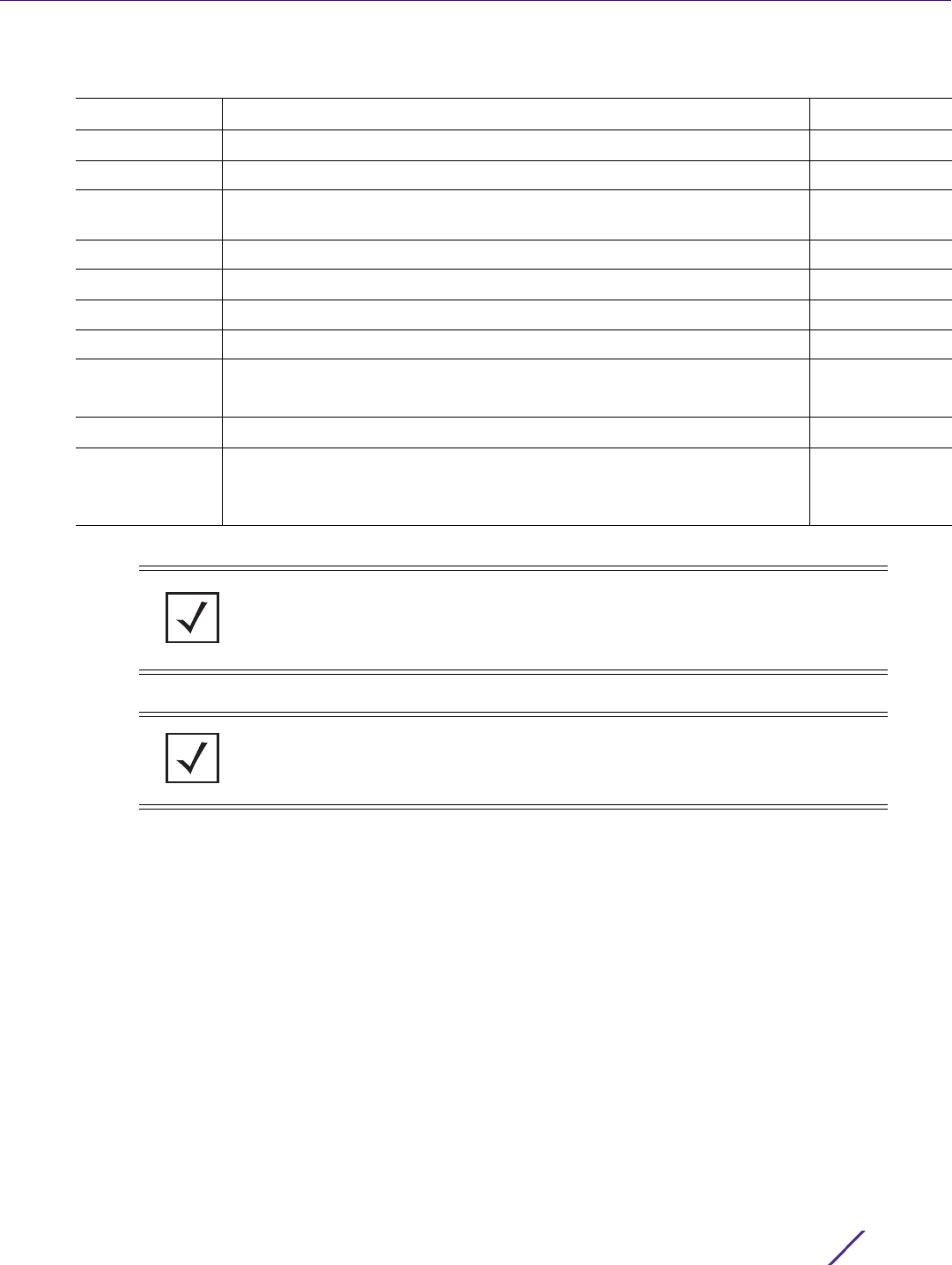
PRIVILEGED EXEC MODE COMMANDS
Access Point, Wireless Controller and Service Platform CLI Reference Guide 3 - 5
telnet Opens a Telnet session page 3-117
terminal Sets the length and width of the terminal window page 3-118
time-it Verifies the time taken by a particular command between request and
response
page 3-119
traceroute Traces the route to a defined destination page 3-120
traceroute6 Sends ICMPv6 echo messages to a user-specified location page 3-121
upgrade Upgrades the logged device’s software image page 3-122
upgrade-abort Aborts an ongoing software image upgrade page 3-126
virtual-machine Installs, configures, and monitors the status of virtual machines (VMs)
installed on a WiNG controller
page 3-127
watch Repeats a specified CLI command at a periodic interval page 3-133
raid Enables RAID management
This command is specific to the NX7530, NX9500, and NX9510 service
platforms.
page 3-135
Table 3.1 Privileged Exec Commands
Command Description Reference
NOTE: For more information on common commands (clrscr, commit, help,
revert, service, show, write, and exit), see COMMON COMMANDS.
NOTE: The input parameter <HOSTNAME>, if used in syntaxes across this
chapter, cannot include an underscore (_) character.

PRIVILEGED EXEC MODE COMMANDS
Access Point, Wireless Controller and Service Platform CLI Reference Guide 3 - 6
3.1.1 archive
Privileged Exec Mode Commands
Manages file archive operations
Supported in the following platforms:
• Access Points — AP6521, AP6522, AP6532, AP6562, AP7161, AP7502, AP7522, AP7532, AP7562,
AP7602, AP7612, AP7622, AP7632, AP7662, AP81XX, AP8232, AP8432, AP8533
• Wireless Controllers — RFS4000, RFS6000
• Service Platforms — NX5500, NX7500, NX7510, NX7520, NX7530, NX9500, NX9510, NX9600,
VX9000
Syntax
archive tar /table [<FILE>|<URL>]
archive tar /create [<FILE>|<URL>] <FILE>
archive tar /xtract [<FILE>|<URL>] <DIR>
Parameters
• archive tar /table [<FILE>|<URL>]
• archive tar /create [<FILE>|<URL>] <FILE>
• archive tar /xtract [<FILE>|<URL>] <DIR>
tar Manipulates (creates, lists, or extracts) a tar file
/table Lists the files in a tar file
<FILE> Defines a tar filename
<URL> Sets the tar file URL
tar Manipulates (creates, lists or extracts) a tar file
/create Creates a tar file
<FILE> Defines tar filename
<URL> Sets the tar file URL
tar Manipulates (creates, lists or extracts) a tar file
/xtract Extracts content from a tar file
<FILE> Defines tar filename
<URL> Sets the tar file URL
<DIR> Specify a directory name. When used with /create, dir is the source directory for the
tar file. When used with /xtract, dir is the destination file where contents of the tar file
are extracted.

PRIVILEGED EXEC MODE COMMANDS
Access Point, Wireless Controller and Service Platform CLI Reference Guide 3 - 7
Example
Following examples show how to zip the folder flash:/log/?
nx9500-6C8809#dir flash:/
Directory of flash:/
-rw- 62937 Tue Nov 24 16:00:06 2015 run-config-backup.txt
drwx Mon Apr 3 12:40:23 2017 crashinfo
drwx Wed Mar 22 13:58:28 2017 upgrade
drwx Mon Sep 28 09:48:33 2015 tmptpd
drwx Wed Apr 5 11:20:11 2017 log
drwx Thu Mar 30 15:07:54 2017 archived_logs
drwx Tue May 24 22:23:54 2016 cache
drwx Thu Feb 19 08:53:45 2015 floorplans
-rw- 42018304 Tue Sep 27 10:19:24 2016 in.tar
drwx Tue Jan 17 10:02:01 2017 hotspot
nx9500-6C8809#
nx9500-6C8809#archive tar /create flash:/in.tar flash:/log/
log/nsightd.log.1
log/nsight_reportd.log
log/messages.1.log
log/martdb.log
log/reportd.log.2
log/adopts.log.2
log/mongod.log.2
log/dpd2.log
log/nsight_server.log
log/mart_websock_server.log
log/nuxi/
log/nuxi/beanyaml.log
log/nuxi/statsreqresp.1.log
log/nuxi/hadoop.log.2014-08-03
log/nuxi/puts.log
log/nuxi/copy2w.log
log/nuxi/obj2yaml.log
log/nuxi/infl.log
--More--
nx9500-6C8809#
nx9500-6C8809#dir flash:/
Directory of flash:/
-rw- 62937 Tue Nov 24 16:00:06 2015 run-config-backup.txt
drwx Thu Sep 22 00:12:07 2016 crashinfo
drwx Sat Sep 17 05:14:43 2016 upgrade
drwx Mon Sep 28 09:48:33 2015 tmptpd
drwx Tue Sep 27 09:59:12 2016 log
drwx Mon Sep 26 09:58:54 2016 archived_logs
drwx Tue May 24 22:23:54 2016 cache
drwx Thu Feb 19 08:53:45 2015 floorplans
-rw- 42018304 Tue Sep 27 10:19:24 2016 in.tar
drwx Mon Sep 15 03:40:02 2014 hotspot
nx9500-6C8809#

PRIVILEGED EXEC MODE COMMANDS
Access Point, Wireless Controller and Service Platform CLI Reference Guide 3 - 8
3.1.2 boot
Privileged Exec Mode Commands
Specifies the image used after reboot
Supported in the following platforms:
• Access Points — AP6521, AP6522, AP6532, AP6562, AP7161, AP7502, AP7522, AP7532, AP7562,
AP7602, AP7612, AP7622, AP7632, AP7662, AP81XX, AP8232, AP8432, AP8533
• Wireless Controllers — RFS4000, RFS6000
• Service Platforms — NX5500, NX7500, NX7510, NX7520, NX7530, NX9500, NX9510, NX9600,
VX9000
Syntax
boot system [primary|secondary] {on <DEVICE-NAME>}
Parameters
• boot system [primary|secondary] {on <DEVICE-NAME>}
Example
nx9500-6C8809#show boot
--------------------------------------------------------------------------------
IMAGE BUILD DATE INSTALL DATE VERSION
--------------------------------------------------------------------------------
Primary 03/26/2017 01:48:56 03/30/2017 15:02:18 5.9.0.0-012D
Secondary 03/17/2017 13:13:38 03/22/2017 13:36:50 5.9.0.0-010D
--------------------------------------------------------------------------------
Current Boot : Primary
Next Boot : Primary
Software Fallback : Enabled
VM support : Not present
nx9500-6C8809#
nx9500-6C8809#boot system secondary
Updated system boot partition
nx9500-6C8809#
nx9500-6C8809#show boot
--------------------------------------------------------------------------------
IMAGE BUILD DATE INSTALL DATE VERSION
--------------------------------------------------------------------------------
Primary 03/26/2017 01:48:56 03/30/2017 15:02:18 5.9.0.0-012D
Secondary 03/17/2017 13:13:38 03/22/2017 13:36:50 5.9.0.0-010D
--------------------------------------------------------------------------------
Current Boot : Primary
Next Boot : Secondary
Software Fallback : Enabled
VM support : Not present
nx9500-6C8809#
system
[primary|secondary]
Specifies the image used after a device reboot
• primary – Uses the primary image after reboot
• secondary – Uses the secondary image after reboot
on
<DEVICE-NAME>
Optional. Specifies the primary or secondary image location on a specified device
• <DEVICE-NAME> – Specify the name of the AP, wireless controller, or service platform.

PRIVILEGED EXEC MODE COMMANDS
Access Point, Wireless Controller and Service Platform CLI Reference Guide 3 - 9
3.1.3 captive-portal-page-upload
Privileged Exec Mode Commands
Uploads captive portal advanced pages to connected access points. Use this command to provide
connected access points with specific captive portal configurations so they can successfully provision login,
welcome, and condition pages to requesting clients attempting to access the wireless network using the
captive portal.
Supported in the following platforms:
• Access Points — AP6521, AP6522, AP6532, AP6562, AP7161, AP7502, AP7522, AP7532, AP7562,
AP7602, AP7612, AP7622, AP7632, AP7662, AP81XX, AP8232, AP8432, AP8533
• Wireless Controllers — RFS4000, RFS6000
• Service Platforms — NX5500, NX7500, NX7510, NX7520, NX7530, NX9500, NX9510, NX9600,
VX9000
Syntax
captive-portal-page-upload [<CAPTIVE-PORTAL-NAME>|cancel-upload|delete-file|
load-file]
captive-portal-page-upload <CAPTIVE-PORTAL-NAME> [<MAC/HOSTNAME>|all|rf-domain]
captive-portal-page-upload <CAPTIVE-PORTAL-NAME> [<MAC/HOSTNAME>|all]
{upload-time <TIME>}
captive-portal-page-upload <CAPTIVE-PORTAL-NAME> rf-domain [<DOMAIN-NAME>|all]
{from-controller} {(upload-time <TIME>)}
captive-portal-page-upload cancel-upload [<MAC/HOSTNAME>|all|on rf-domain
{<DOMAIN-NAME>|all]]
captive-portal-page-upload delete-file <CAPTIVE-PORTAL-NAME> <FILE-NAME>
captive-portal-page-upload load-file <CAPTIVE-PORTAL-NAME> <URL>
Parameters
• captive-portal-page-upload <CAPTIVE-PORTAL-NAME> [<MAC/HOSTNAME>|all]
{upload-time <TIME>}
NOTE: Ensure that the captive portal pages to be uploaded are *.tar files.
captive-portal-page-
upload
<CAPTIVE-PORTAL-
NAME>
Uploads advanced pages specified by the <CAPTIVE-PORTAL-NAME> parameter
• <CAPTIVE-PORTAL-NAME> – Specify captive portal name (should be existing and
configured).
<MAC/HOSTNAME> Uploads to a specified AP
• <MAC/HOSTNAME> – Specify the AP’s MAC address or hostname.
all Uploads to all APs

PRIVILEGED EXEC MODE COMMANDS
Access Point, Wireless Controller and Service Platform CLI Reference Guide 3 - 10
• captive-portal-page-upload <CAPTIVE-PORTAL-NAME> rf-domain [<DOMAIN-NAME>|all]
{from-controller} {(upload-time <TIME>)}
• captive-portal-page-upload cancel-upload [<MAC/HOSTNAME>|all|on rf-domain
[<DOMAIN-NAME>|all]]
• captive-portal-page-upload delete-file <CAPTIVE-PORTAL-NAME> <FILE-NAME>
upload-time <TIME> Optional. Schedules an upload time
• <TIME> – Specify upload time in the MM/DD/YYYY-HH:MM or HH:MM format.
The scheduled upload time is your local system’s time. It is not the access point,
controller, service platform, or virtual controller time and it is not synched with the
device.
To view a list of uploaded captive portal files, execute the
show > captive-portal-page-upload > list-files <CAPTIVE-PORTAL-NAME> command.
captive-portal-page-
upload
<CAPTIVE-PORTAL-
NAME>
Uploads advanced pages specified by the <CAPTIVE-PORTAL-NAME> parameter
• <CAPTIVE-PORTAL-NAME> – Specify captive portal name (should be existing and
configured).
rf-domain
[<DOMAIN-NAME>|
all]
Uploads to all APs within a specified RF Domain or all RF Domains
• <DOMAIN-NAME> – Uploads to APs within a specified RF Domain. Specify the RF
Domain name.
• all – Uploads to APs across all RF Domains
from-controller Optional. Uploads to APs from the adopted device
upload-time <TIME> Optional. Schedules an AP upload
• <TIME> – Specify upload time in the MM/DD/YYYY-HH:MM or HH:MM format.
The scheduled upload time is your local system’s time. It is not the access point,
controller, service platform, or virtual controller time and it is not synched with the
device.
captive-portal-page-
upload cancel-upload
Cancels a scheduled AP upload
cancel-upload
[<MAC/
HOSTNAME>|all|
on rf-domain
[<DOMAIN-NAME>|
all]]
Select one of the following options:
• <MAC/HOSTNAME> – Cancels a scheduled upload to a specified AP. Specify the AP
MAC address or hostname.
• all – Cancels all scheduled AP uploads
• on rf- domain – Cancels all scheduled uploads within a specified RF Domain or all RF
Domains
• <DOMAIN-NAME> – Cancels scheduled uploads within a specified RF Domain.
Specify RF Domain name.
• all – Cancels scheduled uploads across all RF Domains
captive-portal-page-
upload delete-file
Deletes a specified captive portal’s uploaded captive-portal internal page files
<CAPTIVE-PORTAL-
NAME> <FILE-
NAME>
Deletes a captive portal’s, identified by the <CAPTIVE-PORTAL-NAME> keyword,
uploaded internal page files
• <CAPTIVE-PORTAL-NAME> – Specify the captive portal’s name.
• <FILE-NAME> – Specify the file name. The specified internal captive portal page is
deleted.

PRIVILEGED EXEC MODE COMMANDS
Access Point, Wireless Controller and Service Platform CLI Reference Guide 3 - 11
• captive-portal-page-upload load-file <CAPTIVE-PORTAL-NAME> <URL>
Example
ap6562-B1A214#captive-portal-page-upload load-file captive_portal_test tftp://
89.89.89.17/pages_new_only.tar
ap6562-B1A214#
ap6562-B1A214#show captive-portal-page-upload load-image-status
Download of captive_portal_test advanced page file is complete
ap6562-B1A214#
ap6562-B1A214#captive-portal-page-upload captive_portal_test all
--------------------------------------------------------------------------------
CONTROLLER STATUS MESSAGE
--------------------------------------------------------------------------------
FC-0A-81-B1-A2-14 Success Added 6 APs to upload queue
--------------------------------------------------------------------------------
ap6562-B1A214#
captive-portal-page-
upload load-file
Loads captive-portal advanced pages
<CAPTIVE-PORTAL-
NAME> <URL>
Specify captive portal name (should be existing and configured) and location.
• <URL> – Specifies location of the captive-portal's advanced pages. Use one of the
following formats:
IPv4 URLs:
tftp://<hostname|IP>[:port]/path/file
ftp://<user>:<passwd>@<hostname|IP>[:port]/path/file
sftp://<user>:<passwd>@<hostname|IP>[:port]>/path/file
http://<hostname|IP>[:port]/path/file
cf:/path/file
usb<n>:/path/file
IPv6 URLs:
tftp://<hostname|[IPv6]>[:port]/path/file
ftp://<user>:<passwd>@<hostname|[IPv6]>[:port]/path/file
sftp://<user>:<passwd>@<hostname|[IPv6]>[:port]>/path/file
http://<hostname|[IPv6]>[:port]/path/file
Note: The captive portal pages are downloaded to the controller from the location
specified here. After downloading use the
captive-portal-page-upload> <CAPTIVE-PORTAL-NAME> > <DEVICE-OR-DOMAIN-
NAME> command to upload these pages to APs.

PRIVILEGED EXEC MODE COMMANDS
Access Point, Wireless Controller and Service Platform CLI Reference Guide 3 - 12
ap6562-B1A214#show captive-portal-page-upload status
Number of APs currently being uploaded : 1
Number of APs waiting in queue to be uploaded : 0
--------------------------------------------------------------------------------
-------
AP STATE UPLOAD TIME PROGRESS RETRIES LAST UPLOAD ERROR UPLOADED BY
--------------------------------------------------------------------------------
-------
ap6562-B1A738 downloading immediate 100 0 - None
--------------------------------------------------------------------------------
-------
ap6562-B1A214#
The following example lists captive portal CP-BW uploaded files:
nx7500-7F2C13#show captive-portal-page-upload list-files CP-BW
--------------------------------------------------------------------------------
NAME SIZE LAST MODIFIED
--------------------------------------------------------------------------------
CP-BW-1.tar.gz 6133 2017-05-16 10:38:40
CP-BW.tar.gz 3370 2017-05-16 10:45:44
--------------------------------------------------------------------------------
nx7500-7F2C13#

PRIVILEGED EXEC MODE COMMANDS
Access Point, Wireless Controller and Service Platform CLI Reference Guide 3 - 13
3.1.4 cd
Privileged Exec Mode Commands
Changes the current directory
Supported in the following platforms:
• Access Points — AP6521, AP6522, AP6532, AP6562, AP7161, AP7502, AP7522, AP7532, AP7562,
AP7602, AP7612, AP7622, AP7632, AP7662, AP81XX, AP8232, AP8432, AP8533
• Wireless Controllers — RFS4000, RFS6000
• Service Platforms — NX5500, NX7500, NX7510, NX7520, NX7530, NX9500, NX9510, NX9600,
VX9000
Syntax
cd {<DIR>}
Parameters
• cd {<DIR>}
Example
rfs6000-81742D#cd flash:/log/
rfs6000-81742D#pwd
flash:/log/
rfs6000-81742D#
<DIR> Optional. Changes the current directory to the directory identified by the <DIR>
keyword. If a directory name is not provided, the system displays the current
directory.

PRIVILEGED EXEC MODE COMMANDS
Access Point, Wireless Controller and Service Platform CLI Reference Guide 3 - 14
3.1.5 change-passwd
Privileged Exec Mode Commands
Changes the password of a logged user. When this command is executed without any parameters, the
password can be changed interactively.
Supported in the following platforms:
• Access Points — AP6521, AP6522, AP6532, AP6562, AP7161, AP7502, AP7522, AP7532, AP7562,
AP7602, AP7612, AP7622, AP7632, AP7662, AP81XX, AP8232, AP8432, AP8533
• Wireless Controllers — RFS4000, RFS6000
• Service Platforms — NX5500, NX7500, NX7510, NX7520, NX7530, NX9500, NX9510, NX9600,
VX9000
Syntax
change-passwd <OLD-PASSWORD> <NEW-PASSWORD>
Parameters
• change-passwd <OLD-PASSWORD> <NEW-PASSWORD>
Usage Guidelines
A password must be from 1 - 64 characters in length.
Example
rfs6000-81742D#change-passwd
Enter old password:
Enter new password:
Password for user 'admin' changed successfully
Please write this password change to memory(write memory) to be persistent.
rfs6000-81742D#write memory
OK
rfs6000-81742D#
<OLD-PASSWORD> Specify the password to be changed.
<NEW-PASSWORD> Specify the new password.
Note: The password can also be changed interactively. To do so, press [Enter] after
the command.
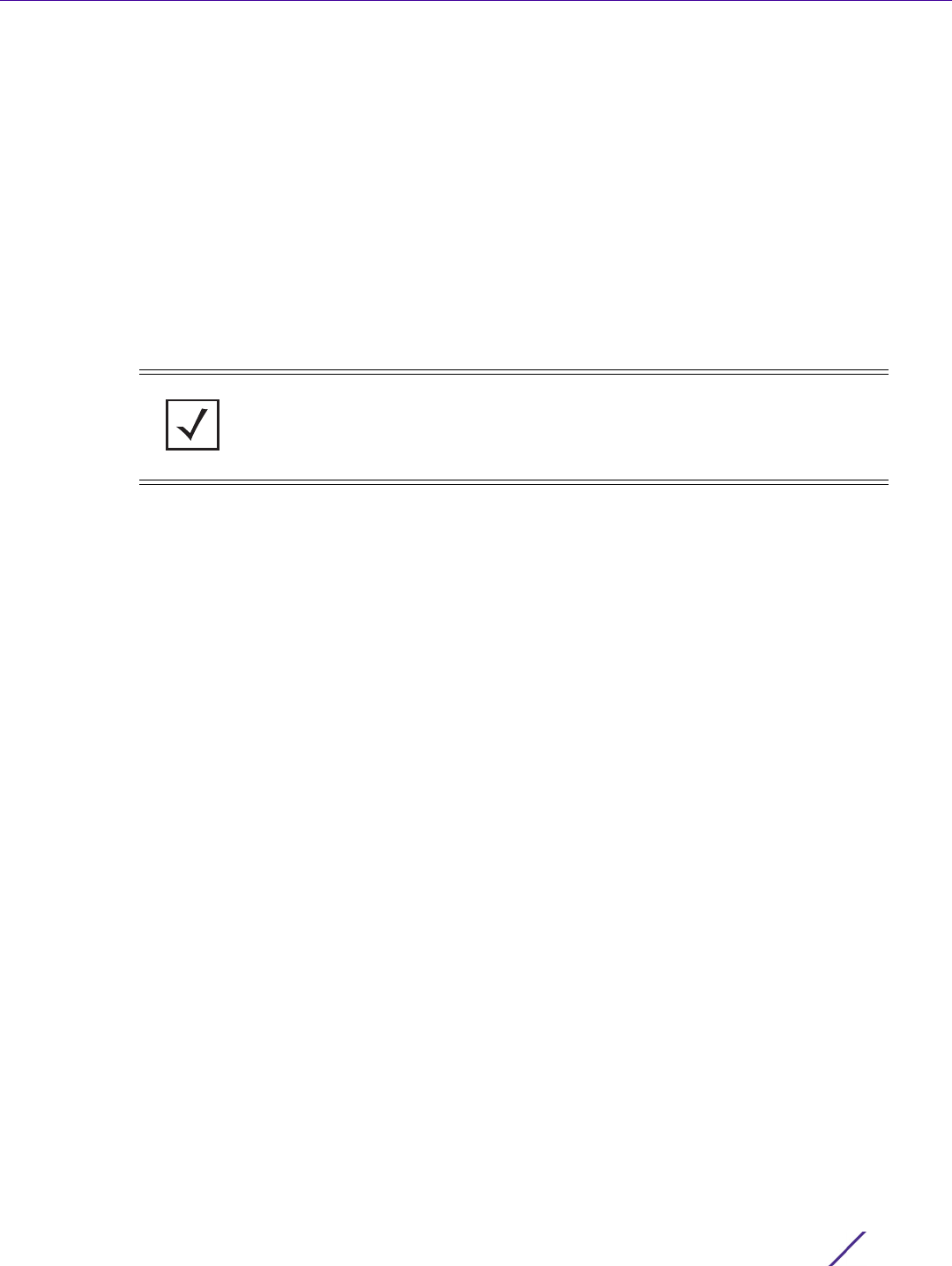
PRIVILEGED EXEC MODE COMMANDS
Access Point, Wireless Controller and Service Platform CLI Reference Guide 3 - 15
3.1.6 clear
Privileged Exec Mode Commands
Clears parameters, cache entries, table entries, and other entries. The clear command is available for
specific commands only. The information cleared using this command varies depending on the mode
where the clear command is executed.
Supported in the following platforms:
• Access Points — AP6521, AP6522, AP6532, AP6562, AP7161, AP7502, AP7522, AP7532, AP7562,
AP7602, AP7612, AP7622, AP7632, AP7662, AP81XX, AP8232, AP8432, AP8533
• Wireless Controllers — RFS4000, RFS6000
• Service Platforms — NX5500, NX7500, NX7510, NX7520, NX7530, NX9500, NX9510, NX9600,
VX9000
Syntax
clear [arp-cache|bonjour|cdp|counters|crypto|eguest|event-history|firewall|gre|
ip|ipv6|l2tpv3-stats|lacp|license|lldp|logging|mac-address-table|mint|role|rtls|
spanning-tree|traffic-shape|vrrp]
clear arp-cache {on <DEVICE-NAME>}
clear bonjour cache {on <DEVICE-NAME>}
clear [cdp|lldp] neighbors {on <DEVICE-NAME>}
clear counters [all|ap|bridge|interface|radio|router|thread|wireless-client]
clear counters [all|bridge|router|thread]
clear counters [ap|wireless-client] {<MAC>} {(on <DEVICE-OR-DOMAIN-NAME>)}
clear counters interface [<INTERFACE-NAME>|all|ge <1-X>|me1|port-channel <1-X>|
pppoe1|vlan <1-4094>|wwan1|xge <1-4>]
clear counters radio {<MAC/HOSTNAME>|on}
clear counters radio {<MAC/HOSTNAME> <1-X>} {(on <DEVICE-OR-DOMAIN-NAME>)}
clear crypto [ike|ipsec]
clear crypto ike sa [<IP>|all] {on <DEVICE-NAME>}
clear crypto ipsec sa {on <DEVICE-NAME>}
clear eguest registration statistics
clear event-history
clear firewall [dhcp snoop-table|dos stats|flows [ipv4|ipv6]|neighbors snoop-
table] {on <DEVICE-NAME>}
clear gre stats {on <DEVICE-NAME>}
clear ip [bgp|dhcp|ospf]
clear ip bgp [<IP>|all|external|process]
NOTE: When using the clear command, refer to the interface details
provided in interface.

PRIVILEGED EXEC MODE COMMANDS
Access Point, Wireless Controller and Service Platform CLI Reference Guide 3 - 16
clear ip bgp [<IP>|all|external] {in|on|out|soft}
clear ip bgp [<IP>|all|external] {in prefix-filter} {on <DEVICE-NAME>}
clear ip bgp [<IP>|all|external] {out} {(on <DEVICE-NAME>)}
clear ip bgp [<IP>|all|external] {soft {in|out}} {on <DEVICE-NAME>}
clear ip bgp process {on <DEVICE-NAME>}
clear ip dhcp bindings [<IP>|all] {on <DEVICE-NAME>}
clear ip ospf process {on <DEVICE-NAME>}
clear ipv6 neighbor-cache {on <DEVICE-NAME>}
clear lacp [<1-4> counters|counters]
clear l2tpv3-stats tunnel <L2TPV3-TUNNEL-NAME> {session <SESSION-NAME>}
{(on <DEVICE-NAME>)}
clear license [borrowed|lent]
clear license borrowed {on <DEVICE-NAME>}
clear license lent to <DEVICE-NAME> {on <DEVICE-NAME>}
clear logging {on <DEVICE-NAME>}
clear mac-address-table {address|interface|mac-auth-state|vlan} {on <DEVICE-
NAME>}
clear mac-address-table mac-auth-state address <AMC> vlan <1-4094> {on <DEVICE-
NAME>}
clear mac-address-table {address <MAC>|vlan <1-4094>} {on <DEVICE-NAME>}
clear mac-address-table interface [<IF-NAME>|ge <1-X>|port-channel <1-X>|t1e1 <1-
4> <1-1>|up <1-X>|xge <1-4>] {on <DEVICE-NAME>}
clear mint mlcp history {on <DEVICE-NAME>}
clear role ldap-stats {on <DEVICE-NAME>}
clear rtls [aeroscout|ekahau]
clear rtls [aeroscout|ekahau] {<MAC/DEVICE-NAME> {on <DEVICE-OR-DOMAIN-NAME>}|
on <DEVICE-OR-DOMAIN-NAME>}
clear spanning-tree detected-protocols {interface|on <DEVICE-NAME>}
clear spanning-tree detected-protocols {interface [<INTERFACE-NAME>|ge <1-x>|me1|
port-channel <1-x>|pppoe1|vlan <1-4094>|wwan1|xge <1-4>]} {on <DEVICE-NAME>}
clear traffic-shape statistics {class <1-4>} {(on <DEVICE-NAME>)}
clear vrrp [error-stats|stats] {on <DEVICE-NAME>}
The following clear command is specific to the NX95XX series service platforms:
clear logging analytics {on <DEVICE-NAME>}

PRIVILEGED EXEC MODE COMMANDS
Access Point, Wireless Controller and Service Platform CLI Reference Guide 3 - 17
Parameters
• clear arp-cache {on <DEVICE-NAME>}
• clear bonjour cache {on <DEVICE-NAME>}
• clear [cdp|lldp] neighbors {on <DEVICE-NAME>}
• clear counters [all|bridge|router|thread]
• clear counters [ap|wireless-client] {<MAC>} {(on <DEVICE-OR-DOMAIN-NAME>)}
arp-cache Clears Address Resolution Protocol (ARP) cache entries on a device. This protocol
matches layer 3 IP addresses to layer 2 MAC addresses.
on <DEVICE-NAME> Optional. Clears ARP cache entries on a specified device
• <DEVICE-NAME> – Specify the name of the AP, wireless controller, or service
platform.
bonjour cache Clears all Bonjour cached statistics. Once cleared, the system has to re-discover
available Bonjour services.
on <DEVICE-NAME> Optional. Clears all Bonjour cached statistics on a specified device
• <DEVICE-NAME> – Specify the name of the AP, wireless controller, or service
platform.
cdp Clears Cisco Discovery Protocol (CDP) table entries
ldp Clears Link Layer Discovery Protocol (LLDP) neighbor table entries
neighbors Clears CDP or LLDP neighbor table entries based on the option selected in the
preceding step
on <DEVICE-NAME> Optional. Clears CDP or LLDP neighbor table entries on a specified device
• <DEVICE-NAME> – Specify the name of the AP, wireless controller, or service
platform.
counters
[all|bridge|router|
thread]
Clears counters on a system
• all – Clears all counters irrespective of the interface type
• bridge – Clears bridge counters
• router – Clears router counters
• thread – Clears per-thread counters
counters
[ap|wireless-client]
Clears counters on a system
• ap – Clears access point wireless counters
• wireless-client – Clears wireless client counters
<MAC> The following keyword is common to the ‘ap’ and ‘wireless-client’ parameters:
• <MAC> – Optional. Clears counters of the AP/wireless client identified by the <MAC>
keyword. Specify the MAC address of the AP or wireless client.
The system clears all AP or wireless client counters, if no MAC address is specified.

PRIVILEGED EXEC MODE COMMANDS
Access Point, Wireless Controller and Service Platform CLI Reference Guide 3 - 18
• clear counters interface [<INTERFACE-NAME>|all|ge <1-X>|me1|port-channel <1-X>|
pppoe1|vlan <1-4094>|wwan1|xge <1-4>]
• clear counters radio {<MAC/HOSTNAME> <1-X>} {(on <DEVICE-OR-DOMAIN-NAME>)}
• clear crypto ike sa [<IP>|all] {on <DEVICE-NAME>}
on <DEVICE-OR-
DOMAIN-NAME>
The following keyword is recursive and is applicable to the <MAC> parameter:
• on <DEVICE-OR-DOMAIN-NAME> – Optional. Clears AP/wireless-client counters on
a specified device or RF Domain
• <DEVICE-OR-DOMAIN-NAME> – Specify the name of the AP, wireless controller,
service platform, or RF Domain.
If no MAC address is specified, the system clears all AP or wireless client counters
on the specified AP, wireless controller, service platform, or RF Domain.
counters interface
[<INTERFACE-
NAME>|all|
ge <1-X>|me1|
port-channel <1-X>|
pppoe1|vlan <1-4094>|
wwan1|xge <1-4>]
Clears interface counters for a specified interface
• <INTERFACE-NAME> – Clears a specified interface counters. Specify the interface
name.
• all – Clears all interface counters
• ge <1-X> – Clears GigabitEthernet interface counters. Specify the GigabitEthernet
interface index from 1 - X.
• me1 – Clears FastEthernet interface counters
• port-channel <1- X> – Clears port-channel interface counters. Specify the port
channel interface index from 1 - X.
Note: The number of port-channel interfaces supported varies for different device
types. For example, RFS4000 supports 3 port-channels.
• pppoe1 – Clears Point-to-Point Protocol over Ethernet (PPPoE) interface counters
• vlan <1-4094> – Clears interface counters. Specify the Switch Virtual Interface (SVI)
VLAN ID from 1 - 4094.
• wwan1 – Clears wireless WAN interface counters
• xge <1-4> – Clears TenGigabitEthernet interface counters. Specify the
GigabitEthernet interface index from 1 - 4.
counters radio Clears wireless radio counters
<MAC/HOSTNAME>
<1-X>
Clears counters of a radio identified by the <MAC/HOSTNAME> keyword.
• <MAC/HOSTNAME> – Optional. Specify the hostname or MAC address. Optionally,
append the interface number to form radio ID in the form of AA-BB-CC-DD-EE-
FF:RX or HOSTNAME:RX
• <1-X> – Optional. Specify the radio index (if not specified as part of the radio ID).
The maximum number of radio antennas supported varies with the access point
type.
If no MAC address or radio index is specified, the system clears all radio counters.
on <DEVICE-OR-
DOMAIN-NAME>
The following keyword is recursive and is applicable to the <MAC> parameter:
• on <DEVICE-OR-DOMAIN-NAME> – Optional. Clears AP/wireless-client counters on
a specified device or RF Domain
If no MAC address is specified, the system clears all AP or wireless client counters
on the specified AP, wireless controller, service platform, or RF Domain.
crypto Clears encryption module database

PRIVILEGED EXEC MODE COMMANDS
Access Point, Wireless Controller and Service Platform CLI Reference Guide 3 - 19
• clear crypto ipsec sa {on <DEVICE-NAME>}
• clear eguest registration statistics
• clear event-history
• clear firewall [dhcp snoop-table|dos stats|flows [ipv4|ipv6]|neighbors snoop-
table] {on <DEVICE-NAME>}
• clear gre stats {on <DEVICE-NAME>}
ike sa [<IP>|all] Clears Internet Key Exchange (IKE) security associations (SAs)
• <IP> – Clears IKE SAs for a certain peer
• all – Clears IKE SAs for all peers
on <DEVICE-NAME> Optional. Clears IKE SA entries, for a specified peer or all peers, on a specified
device
• <DEVICE-NAME> – Specify the name of the AP, wireless controller, or service
platform.
crypto Clears encryption module database
ipsec sa
{on <DEVICE-NAME>}
Clears Internet Protocol Security (IPSec) database SAs
• on <DEVICE-NAME> – Optional. Clears IPSec SA entries on a specified device
• <DEVICE-NAME> – Specify the name of the AP, wireless controller, or service
platform.
eguest registration
statistics
Clears EGuest registration server counters. When cleared EGuest registration details
are deleted, and the show > eguest > registration > statistics command output is null.
This command is applicable only on the NX95XX, NX9600, and the VX9000 model
platforms.
event-history Clears event history cache entries
firewall Clears firewall event entries
dhcp snoop-table Clears DHCP snoop table entries
dos stats Clears denial of service statistics
flows [ipv4|ipv6] Clears established IPv4 or IPv6 firewall sessions
neighbors snoop-table Clears IPv6 neighbors snoop-table entries
on <DEVICE-NAME> The following keywords are common to the DHCP, DOS, and flows parameters:
• on <DEVICE-NAME> – Optional. Clears DHCP snoop table entries, denial of service
statistics, or the established firewall sessions on a specified device
• <DEVICE-NAME> – Specify the name of the AP, wireless controller, or service
platform.
gre stats Clears GRE tunnel statistics
on <DEVICE-NAME> Optional. GRE tunnel statistics on a specified device
• <DEVICE-NAME> – Specify the name of the AP, wireless controller, or service
platform.

PRIVILEGED EXEC MODE COMMANDS
Access Point, Wireless Controller and Service Platform CLI Reference Guide 3 - 20
• clear ip bgp [<IP>|all|external] {in prefix-filter} {on <DEVICE-NAME>}
• clear ip bgp [<IP>|all|external] {out} {(on <DEVICE-NAME>)}
• clear ip bgp [<IP>|all|external] {soft {in|out}} {on <DEVICE-NAME>}
ip bgp
[<IP>|all|external]
Clears BGP routing table information based on the option selected
• <IP> – Clears the BGP peer identified by the <IP> keyword. Specify the BGP peer’s IP
address.
• all – Clears Route Updates Received From All BGP Peers
• external – Clears route updates received from external BGP peers
This command is applicable only to the RFS4000, RFS6000, NX95XX, and NX9600
series service platforms.
In case of a change in routing policy it is necessary to clear BGP routing table entries
in order for the new policy to take effect.
in prefix-filter Optional. Clears soft-reconfiguration inbound route updates
• prefix-filter – Optional. Clears the existing Outbound Route Filtering (ORF) prefix-list.
on <DEVICE-NAME> Optional. Clears soft-reconfiguration inbound route updates on a specified device
• <DEVICE-NAME> – Specify the name of the AP or service platform.
ip bgp
[<IP>|all|external]
Clears BGP routing table information based on the option selected
• <IP> – Clears the BGP peer identified by the <IP> keyword. Specify the BGP peer’s IP
address.
• all – Clears route updates received from all BGP peers
• external – Clears route updates received from external BGP peers
This command is applicable only to the RFS4000, RFS6000, and NX95XX series
service platforms.
In case of a change in routing policy it is necessary to clear BGP routing table entries
in order for the new policy to take effect.
out Optional. Clears soft-reconfiguration outbound route updates. Optionally specify the
device on which to execute this command.
on <DEVICE-NAME> The following keyword is recursive and optional.
• on <DEVICE-NAME> – Optional. Clears BGP sessions on a specified device
• <DEVICE-NAME> – Specify the name of the AP or service platform.
ip bgp
[<IP>|all|external]
Clears BGP routing table information based on the option selected
• <IP> – Clears the BGP peer identified by the <IP> keyword. Specify the BGP peer’s IP
address.
• all – Clears route updates received from all BGP peers
• external – Clears route updates received from external BGP peers
This command is applicable only to the RFS4000, RFS6000, and NX95XX series
service platforms.
In case of a change in routing policy it is necessary to clear BGP routing table entries
in order for the new policy to take effect.

PRIVILEGED EXEC MODE COMMANDS
Access Point, Wireless Controller and Service Platform CLI Reference Guide 3 - 21
• clear ip bgp process {on <DEVICE-NAME>}
• clear ip dhcp bindings [<IP>|all] {on <DEVICE-NAME>}
• clear ip ospf process {on <DEVICE-NAME>}
soft {in|out} Optional. Enables soft-reconfiguration of route updates for the specified IP address.
This option allows routing tables to be reconfigured without clearing BGP sessions.
• in – Optional. Enables soft reconfiguration of inbound route updates
• out – Optional. Enables soft reconfiguration of outbound route updates
Modifications made to BGP settings (BGP access lists, weight, distance, route-maps,
versions, routing policy, etc.) take effect only after on-going BGP sessions are
cleared. The clear > ip > bgp command clears BGP sessions. To reduce loss of route
updates during the process, use the ‘soft’ option. Soft reconfiguration stores
inbound/outbound route updates to be processed later and updated to the routing
table. This requires high memory usage.
on <DEVICE-NAME> Optional. Clears soft-reconfiguration inbound/outbound route updates on a specified
device
• <DEVICE-NAME> – Specify the name of the AP or service platform.
ip bgp process Clears all BGP processes running
This command is applicable only to the RFS4000, RFS6000, NX95XX, NX9600
platforms.
on <DEVICE-NAME> Optional. Clears all BGP processes on a specified device
• <DEVICE-NAME> – Specify the name of the AP or service platform.
ip Clears a Dynamic Host Configuration Protocol (DHCP) server’s IP address bindings
entries
dhcp bindings Clears DHCP server’s connections and address binding entries
<IP> Clears specific address binding entries. Specify the IP address to clear binding
entries.
all Clears all address binding entries
on <DEVICE-NAME> Optional. Clears a specified address binding or all address bindings on a specified
device
• <DEVICE-NAME> – Specify the name of the AP, wireless controller, or service
platform.
ip ospf process Clears already enabled open shortest path first (OSPF) process and restarts the
process
on <DEVICE-NAME> Optional. Clears OSPF process on a specified device
OSPF is a link-state interior gateway protocol (IGP). OSPF routes IP packets within
a single routing domain (autonomous system), like an enterprise LAN. OSPF
gathers link state information from neighbor routers and constructs a network
topology. The topology determines the routing table presented to the Internet layer
which makes routing decisions based solely on the destination IP address found in
IP packets.
• <DEVICE-NAME> – Specify the name of the AP, wireless controller, or service
platform.

PRIVILEGED EXEC MODE COMMANDS
Access Point, Wireless Controller and Service Platform CLI Reference Guide 3 - 22
• clear ipv6 neighbor-cache {on <DEVICE-NAME>}
• clear lacp [<1-4> counters|counters]
• clear l2tpv3-stats tunnel <L2TPV3-TUNNEL-NAME> {session <SESSION-NAME>}
{(on <DEVICE-NAME>)}
• clear license borrowed {on <DEVICE-NAME>}
• clear license lent to <DEVICE-NAME> {on <DEVICE-NAME>}
clear ipv6
neighbor-cache
Clears IPv6 neighbor cache entries
on <DEVICE-NAME> Optional. Clears IPv6 neighbor cache entries on a specified device
• <DEVICE-NAME> – Specify the name of the AP, wireless controller, or service
platform.
clear lacp
[<1-4> counters|
counters]
Clears Link Aggregation Control Protocol (LACP) counters for a specified port-
channel group or all port-channel groups configured
• <1-4> counters – Clears LACP counters for a specified port-channel. Specify the
port-channel index number from 1 - 4. Note, LACP is supported only on the NX5500,
NX7500, and NX9500 model service platforms. However, the NX9500 series service
platforms support only two (2) port-channels, and the other model service
platforms support four (4) port-channels.
• counters – Clears LACP counters for all configured port-channels on the device
l2tpv3-stats Clears L2TPv3 tunnel session statistics
tunnel
<L2TPV3-TUNNEL-
NAME>
Clears all sessions associated with a specified L2TPv3 tunnel
• <L2TPV3-TUNNEL-NAME> – Specify the L2TPv3 tunnel name.
session
<SESSION-NAME>
Optional. Clears a specified L2TPv3 tunnel session, identified by the <SESSION-
NAME> keyword
• <SESSION-NAME> – Specify the session name.
on <DEVICE-NAME> The following parameter is recursive and optional:
• on <DEVICE-NAME> – Optional. Specifies the device running the L2TPv3 tunnel
session
• <DEVICE-NAME> – Specify the name of the AP, wireless controller, or service
platform.
If no optional parameters are specified, the system clears all L2TPv3 tunnel session
statistics.
license borrowed
{on <DEVICE-NAME>}
Releases or revokes all licenses borrowed by a site controller
• on <DEVICE-NAME> – Optional. Specifies the borrowing controller’s name.
• <DEVICE-NAME> – Specify the wireless controller’s name.
If no device name is specified, the system clears all borrowed licenses on the
logged device.
license lent NOC controller releases or revokes all licenses loaned to a site controller
to <DEVICE-NAME> Specifies the borrowing controller’s name
• <DEVICE-NAME> – Specify the controller's name.

PRIVILEGED EXEC MODE COMMANDS
Access Point, Wireless Controller and Service Platform CLI Reference Guide 3 - 23
• clear mac-address-table {address <MAC>|vlan <1-4094>} {on <DEVICE-NAME>}
• clear mac-address-table interface [<IF-NAME>|ge <1-X>|port-channel <1-X>|t1e1
<1-4> <1-1>|up <1-X>|xge <1-4>] {on <DEVICE-NAME>}
on <DEVICE-NAME> Optional. Specifies the controller’s name
• <DEVICE-NAME> – Specify the wireless controller’s name.
If no device name is specified, the system clears all loaned licenses on the logged
device.
mac-address-table Clears the MAC address forwarding table
address <MAC> Optional. Clears a specified MAC address from the MAC address table.
• <MAC> – Specify the MAC address in one of the following formats: AA-BB-CC-DD-
EE-FF or AA:BB:CC;DD:EE:FF or AABB.CCDD.EEFF
vlan <1-4094> Optional. Clears all MAC addresses for a specified VLAN
• <1-4094> – Specify the VLAN ID from 1 - 4094.
on <DEVICE-NAME> Optional. Clears a single entry or all MAC entries for the specified VLAN in the MAC
address forwarding table on a specified device
• <DEVICE-NAME> – Specify the name of the AP, wireless controller, or service
platform.
mac-address-table Clears the MAC address forwarding table
interface Clears all MAC addresses for the selected interface. Use the options available to
specify the interface.
<IF-NAME> Clears MAC address forwarding table for the specified layer 2 interface (Ethernet
port)
• <IF-NAME> – Specify the layer 2 interface name.
ge <1-X> Clears MAC address forwarding table for the specified GigabitEthernet interface
• <1-X> – Specify the GigabitEthernet interface index from 1 - X.
port-channel <1-X> Clears MAC address forwarding table for the specified port-channel interface
• <1-X> – Specify the port-channel interface index from 1 - X.
up <1-X> Clears MAC address forwarding table for the WAN Ethernet interface
The number of WAN Ethernet interfaces supported varies for different devices. The
RFS4000 and RFS6000 devices support 1 WAN Ethernet interface.
xge <1-4> Clears MAC address forwarding table for the specified TenGigabitEthernet interface
• <1-4> – Specify the GigabitEthernet interface index from 1 - 4.
on <DEVICE-NAME> Optional. Clears the MAC address forwarding table, for the selected interface, on a
specified device
• <DEVICE-NAME> – Specify the name of the AP, wireless controller, or service
platform.

PRIVILEGED EXEC MODE COMMANDS
Access Point, Wireless Controller and Service Platform CLI Reference Guide 3 - 24
• clear mac-address-table mac-auth-state address <MAC> vlan <1-4904> {on <DEVICE-
NAME>}
• clear mint mlcp history {on <DEVICE-NAME>}
• clear role ldap-stats {on <DEVICE-NAME>}
• clear rtls [aeroscout|ekahau] {<MAC/DEVICE-NAME> {on <DEVICE-OR-DOMAIN-NAME>}|
on <DEVICE-OR-DOMAIN-NAME>}
mac-address-table
mac-auth-state address
<MAC> vlan <1-4904>
Clears MAC addresses learned from a particular VLAN when WLAN MAC
authentication and captive-portal fall back is enabled
Access points/controllers provide WLAN access to clients whose MAC address has
been learned and stored in their MAC address tables. Use this command to clear a
specified MAC address on the MAC address table. Once cleared the client has to re-
authenticate, and is provided access only on successful authentication.
• <MAC> – Specify the MAC address to clear.
• vlan <1-4904> – Specify the VLAN interface from 1 - 4094. In the AP/controller’s
MAC address table, the specified MAC address is cleared on the specified VLAN in-
terface.
on <DEVICE-NAME> Optional. Clears the specified MAC address on a specified device
• <DEVICE-NAME> – Specify the name of the AP, wireless controller, or service
platform.
If a device is not specified, the system clears the MAC address from the MAC
address table of all devices.
mint Clears MiNT related information
mlcp history Clears MiNT Link Creation Protocol (MLCP) client history
on <DEVICE-NAME> Optional. Clears MLCP client history on a specified device
• <DEVICE-NAME> – Specify the name of the AP, wireless controller, or service
platform
role ldap-stats Clears role based Lightweight Directory Access Protocol (LDAP) server statistics
on <DEVICE-NAME> Optional. Clears role based LDAP server statistics on a specified device
• <DEVICE-NAME> – Specify the name of the AP, wireless controller, or service
platform.
rtls Clears Real Time Location Service (RTLS) statistics
aeroscout Clears RTLS Aeroscout statistics
ekahau Clears RTLS Ekahau statistics
<MAC/DEVICE-NAME> This keyword is common to the ‘aeroscout’ and ‘ekahau’ parameters.
• <MAC/DEVICE-NAME> – Optional. Clears Aeroscout or Ekahau RTLS statistics on a
specified AP, wireless controller, or service platform. Specify the AP’s MAC address
or hostname.
on <DEVICE-OR-
DOMAIN-NAME>
This keyword is common to the ‘aeroscout’ and ‘ekahau’ parameters.
• on <DEVICE-OR-DOMAIN-NAME> – Optional. Clears Aeroscout or Ekahau RTLS
statistics on a specified device or RF Domain
• <DEVICE-OR-DOMAIN-NAME> – Specify the name of the AP,
wireless controller, service platform, or RF Domain.

PRIVILEGED EXEC MODE COMMANDS
Access Point, Wireless Controller and Service Platform CLI Reference Guide 3 - 25
• clear spanning-tree detected-protocols {on <DEVICE-NAME>}
• clear spanning-tree detected-protocols {interface [<INTERFACE-NAME>|ge <1-X>|
me1|port-channel <1-X>|pppoe1|vlan <1-4094>|wwan1|xge <1-4>]} {on <DEVICE-NAME>}
• clear traffic-shape statistics {class <1-4>} {(on <DEVICE-NAME>)}
• clear vrrp [error-stats|stats] {on <DEVICE-NAME>}
spanning-tree Clears spanning tree protocols on an interface, and also restarts protocol migration
detected-protocols Restarts protocol migration
on <DEVICE-NAME> Optional. Clears spanning tree protocols on a specified device
• <DEVICE-NAME> – Optional. Specify the name of the AP, wireless controller, or
service platform.
spanning-tree Clears spanning tree protocols on an interface and restarts protocol migration
detected-protocols Restarts protocol migration
interface
[<INTERFACE-NAME>|
ge <1-X>|me1|
port-channel <1-X>|
pppoe1|vlan <1-4094>|
wwan1|xge <1-4>]
Optional. Clears spanning tree entries on different interfaces
• <INTERFACE-NAME> – Clears detected spanning tree entries on a specified
interface. Specify the interface name.
• ge <1-X> – Clears detected spanning tree entries for the selected GigabitEthernet
interface. Select the GigabitEthernet interface index from 1 - X
• me1 – Clears FastEthernet interface spanning tree entries
• port-channel <1- X> – Clears detected spanning tree entries for the selected port
channel interface. Select the port channel index from 1 - X.
The number of port-channel interfaces supported varies for different device types.
For example, RFS4000 supports 3 port-channels.
• pppoe1 – Clears detected spanning tree entries for PPPoE interface.
• vlan <1-4094> – Clears detected spanning tree entries for the selected VLAN
interface. Select a SVI VLAN ID from 1 - 4094.
• wwan1 – Clears detected spanning tree entries for wireless WAN interface
• xge <1-4> – Clears detected spanning tree entries for TenGigabitEthernet interfaces.
Specify the GigabitEthernet interface index from 1 - 4.
on <DEVICE-NAME> Optional. Clears spanning tree protocol entries on a selected device
• <DEVICE-NAME> – Specify the name of the AP, wireless controller, or service
platform.
traffic-shape statistics Clears traffic shaping statistics
class <1-4> Optional. Clears traffic shaping statistics for a specific traffic class
• <1-4> – Specify the traffic class from 1 - 4.
Note: If the traffic class is not specified, the system clears all traffic shaping statistics.
on <DEVICE-NAME> Optional. Clears traffic shaping statistics for the specified traffic class on a specified
device
• <DEVICE-NAME> – Specify the name of the access point, wireless controller, or
service platform.
Note: For more information on configuring traffic-shape, see interface.
vrrp Clears Virtual Router Redundancy Protocol (VRRP) statistics for a device

PRIVILEGED EXEC MODE COMMANDS
Access Point, Wireless Controller and Service Platform CLI Reference Guide 3 - 26
Example
rfs4000-229D58#clear crypto ike sa all
rfs4000-229D58#show crypto ike sa
--------------------------------------------------------------------------------
-------IDX PEER VERSION ENCR ALGO HASH ALGO DH GROUP
IKE STATE
--------------------------------------------------------------------------------
--------------------------------------------------------------------------------
--------------Total IKE SAs: 0
rfs4000-229D58#
rfs6000-81742D#clear spanning-tree detected-protocols interface port-channel 1
rfs6000-81742D#clear ip dhcp bindings 172.16.10.9
rfs6000-81742D#clear cdp neighbors
rfs4000-229D58#clear spanning-tree detected-protocols interface ge 1
rfs4000-229D58#clear lldp neighbors
rfs6000-81742D#show event-history
EVENT HISTORY REPORT
Generated on '2017-04-04 13:49:57 IST' by 'admin'
2017-04-04 13:37:31 rfs6000-81742D SYSTEM LOGIN Successfully
logged in user 'admin' with privilege 'superuser' from 'ssh'
2017-04-04 13:15:19 rfs6000-81742D SYSTEM LOGOUT Logged out
user 'admin' with privilege 'superuser' from '192.168.13.10'
2017-04-04 13:09:47 rfs6000-81742D LICMGR LIC_AP_AAP_DEPLETED Depleted
AP/AAP license count: 1
2017-04-04 13:09:47 rfs6000-81742D LICMGR LIC_AP_AAP_DEPLETED Depleted
AP/AAP license count: 1
--More--
rfs6000-81742D#
jrfs6000-81742D#clear event-history
rfs6000-81742D#show event-history
EVENT HISTORY REPORT
Generated on '2017-04-04 13:51:27 IST' by 'admin'
rfs6000-81742D#
error-stats
{on <DEVICE-NAME>}
Clears global error statistics
• on <DEVICE-NAME> – Optional. Clears VRRP global error statistics on a selected
device
• <DEVICE-NAME> – Specify the name of the AP, wireless controller, or service
platform.
stats
{on <DEVICE-NAME>}
Clears VRRP related statistics
• on <DEVICE-NAME> – Optional. Clears VRRP related statistics on a selected device
• <DEVICE-NAME> – Specify the name of the AP, wireless controller, or service
platform.

PRIVILEGED EXEC MODE COMMANDS
Access Point, Wireless Controller and Service Platform CLI Reference Guide 3 - 27
rfs6000-81742D#show mac-address-table
--------------------------------------------------------
BRIDGE VLAN PORT MAC STATE
--------------------------------------------------------
1 1 up1 00-02-B3-28-D1-55 forward
1 1 up1 00-0F-8F-19-BA-4C forward
1 1 up1 84-24-8D-80-C2-AC forward
1 1 up1 84-24-8D-80-BF-34 forward
1 1 up1 1C-7E-E5-18-FA-67 forward
1 1 up1 84-24-8D-83-30-A4 forward
1 1 up1 B4-C7-99-DD-31-C8 forward
1 1 up1 B4-C7-99-6C-88-09 forward
1 1 up1 00-18-71-D0-1B-F3 forward
1 1 up1 B4-C7-99-71-17-28 forward
1 1 up1 FC-0A-81-42-93-6C forward
1 1 up1 B4-C7-99-6D-CD-4B forward
1 1 up1 84-24-8D-84-A2-24 forward
1 1 up1 3C-CE-73-F4-47-83 forward
1 1 up1 B4-C7-99-74-B4-5C forward
--------------------------------------------------------
Total number of MACs displayed: 15
rfs6000-81742D#
rfs6000-81742D>clear mac-address-table address 3C-CE-73-F4-47-83 on rfs6000-81742D
rfs6000-81742D#show mac-address-table
--------------------------------------------------------
BRIDGE VLAN PORT MAC STATE
--------------------------------------------------------
1 1 up1 00-02-B3-28-D1-55 forward
1 1 up1 00-0F-8F-19-BA-4C forward
1 1 up1 84-24-8D-80-C2-AC forward
1 1 up1 84-24-8D-80-BF-34 forward
1 1 up1 1C-7E-E5-18-FA-67 forward
1 1 up1 84-24-8D-83-30-A4 forward
1 1 up1 B4-C7-99-DD-31-C8 forward
1 1 up1 B4-C7-99-6C-88-09 forward
1 1 up1 00-18-71-D0-1B-F3 forward
1 1 up1 B4-C7-99-71-17-28 forward
1 1 up1 FC-0A-81-42-93-6C forward
1 1 up1 B4-C7-99-6D-CD-4B forward
1 1 up1 84-24-8D-84-A2-24 forward
1 1 up1 B4-C7-99-74-B4-5C forward
--------------------------------------------------------
Total number of MACs displayed: 14
rfs6000-81742D#

PRIVILEGED EXEC MODE COMMANDS
Access Point, Wireless Controller and Service Platform CLI Reference Guide 3 - 28
3.1.7 clock
Privileged Exec Mode Commands
Sets a device’s system clock. By default all WiNG devices are shipped with the time zone and time format
set to UTC and 24-hour clock respectively. If a device’s clock is set without resetting the time zone, the
time is displayed relative to the Universal Time Coordinated (UTC) – Greenwich Time. To display time in the
local time zone format, in the device’s configuration mode, use the timezone command to reset the time
zone. You can also reset the time zone at the RF Domain level. When configured as RF Domain setting, it
applies to all devices within the domain. Configuring the local time zone prior to setting the clock is
recommended. For more information on configuring RF Domain time zone, see timezone.
Supported in the following platforms:
• Access Points — AP6521, AP6522, AP6532, AP6562, AP7161, AP7502, AP7522, AP7532, AP7562,
AP7602, AP7612, AP7622, AP7632, AP7662, AP81XX, AP8232, AP8432, AP8533
• Wireless Controllers — RFS4000, RFS6000
• Service Platforms — NX5500, NX7500, NX7510, NX7520, NX7530, NX9500, NX9510, NX9600,
VX9000
Syntax
clock set <HH:MM:SS> <1-31> <MONTH> <1993-2035> {on <DEVICE-NAME>}
Parameters
• clock set <HH:MM:SS> <1-31> <MONTH> <1993-2035> {on <DEVICE-NAME>}
Example
The following commands set the time zone and clock for the logged device:
nx9500-6C8809(config-device-B4-C7-99-6C-88-09)#timezone America/Los_Angeles
nx9500-6C8809#clock set 00:25:10 16 Jan 2017
nx9500-6C8809#show clock
2017-01-16 03:31:16 IST
nx9500-6C8809#
clock set Sets a device’s system clock
<HH:MM:SS> Sets the current time (in military format hours, minutes and seconds)
Note: By default the WiNG software displays time in the 24-hour clock format. This
setting cannot be changed.
<1-31> Sets the numerical day of the month
<MONTH> Sets the month of the year from Jan - Dec
<1993-2035> Sets a valid four digit year from 1993 - 2035
on <DEVICE-NAME> Optional. Sets the clock on a specified device
• <DEVICE-NAME> – Specify the name of the AP, wireless controller, or service
platform.

PRIVILEGED EXEC MODE COMMANDS
Access Point, Wireless Controller and Service Platform CLI Reference Guide 3 - 29
3.1.8 cluster
Privileged Exec Mode Commands
Initiates the cluster context. The cluster context provides centralized management to configure all cluster
members from any one member.
Commands executed under this context are executed on all members of the cluster.
Supported in the following platforms:
• Access Points — AP6521, AP6522, AP6532, AP6562, AP7161, AP7502, AP7522, AP7532, AP7562,
AP7602, AP7612, AP7622, AP7632, AP7662, AP81XX, AP8232, AP8432, AP8533
• Wireless Controllers — RFS4000, RFS6000
• Service Platforms — NX5500, NX7500, NX7510, NX7520, NX7530, NX9500, NX9510, NX9600,
VX9000
Syntax
cluster start-election
Parameters
• cluster start-election
Example
rfs4000-880DA7#cluster start-election
rfs4000-880DA7#
Related Commands
start-election Starts a new cluster master election
create-cluster Creates a new cluster on a specified device
join-cluster Adds a controller, as cluster member, to an existing cluster of devices

PRIVILEGED EXEC MODE COMMANDS
Access Point, Wireless Controller and Service Platform CLI Reference Guide 3 - 30
3.1.9 configure
Privileged Exec Mode Commands
Enters the configuration mode. Use this command to enter the current device’s configuration mode, or
enable configuration from the terminal.
Supported in the following platforms:
• Access Points — AP6521, AP6522, AP6532, AP6562, AP7161, AP7502, AP7522, AP7532, AP7562,
AP7602, AP7612, AP7622, AP7632, AP7662, AP81XX, AP8232, AP8432, AP8533
• Wireless Controllers — RFS4000, RFS6000
• Service Platforms — NX5500, NX7500, NX7510, NX7520, NX7530, NX9500, NX9510, NX9600,
VX9000
Syntax
configure {self|terminal}
Parameters
• configure {self|terminal}
Example
rfs6000-81742D#configure self
Enter configuration commands, one per line. End with CNTL/Z.
rfs6000-81742D(config-device-00-15-70-81-74-2D)#
rfs6000-81742D#configure terminal
Enter configuration commands, one per line. End with CNTL/Z.
rfs6000-81742D(config)#
self Optional. Enables the current device’s configuration mode
terminal Optional. Enables configuration from the terminal

PRIVILEGED EXEC MODE COMMANDS
Access Point, Wireless Controller and Service Platform CLI Reference Guide 3 - 31
3.1.10 connect
Privileged Exec Mode Commands
Begins a console connection to a remote device using the remote device’s MiNT ID or name
Supported in the following platforms:
• Access Points — AP6521, AP6522, AP6532, AP6562, AP7161, AP7502, AP7522, AP7532, AP7562,
AP7602, AP7612, AP7622, AP7632, AP7662, AP81XX, AP8232, AP8432, AP8533
• Wireless Controllers — RFS4000, RFS6000
• Service Platforms — NX5500, NX7500, NX7510, NX7520, NX7530, NX9500, NX9510, NX9600,
VX9000
Syntax
connect [mint-id <MINT-ID>|<REMOTE-DEVICE-NAME>]
Parameters
• connect [mint-id <MINT-ID>|<REMOTE-DEVICE-NAME>]
Example
nx9500-6C8809#show mint lsp-db
9 LSPs in LSP-db of 19.6C.88.09:
LSP 19.6C.88.09 at level 1, hostname "nx9500-6C8809", 8 adjacencies, seqnum 1294552
LSP 19.6D.B5.D4 at level 1, hostname "rfs6000-81742D", 8 adjacencies, seqnum
1915721
LSP 19.74.B4.5C at level 1, hostname "ap8132-74B45C", 8 adjacencies, seqnum 1468227
LSP 4D.80.C2.AC at level 1, hostname "ap7532-80C2AC", 8 adjacencies, seqnum 649241
LSP 4D.83.30.A4 at level 1, hostname "ap7522-8330A4", 8 adjacencies, seqnum 202818
LSP 4D.84.A2.24 at level 1, hostname "ap7562-84A224", 8 adjacencies, seqnum 380337
LSP 68.88.0D.A7 at level 1, hostname "rfs4000-880DA7", 8 adjacencies, seqnum
1494520
LSP 68.99.BB.7C at level 1, hostname "ap7131-99BB7C", 8 adjacencies, seqnum 831529
nx9500-6C8809#
nx9500-6C8809#connect mint-id ?
MINT-ID MiNT ID of device to connect to
nx9500-6C8809#connect mint-id 19.6D.B5.D4
Entering character mode
Escape character is '^]'.
RFS6000 release 5.9.0.0-012D
rfs6000-81742D login: admin
Password:
rfs6000-81742D>
mint-id <MINT-ID> Connects to a remote system using the MiNT ID
• <MINT-ID> – Specify the remote device’s MiNT ID.
<REMOTE-DEVICE-
NAME>
Connects to a remote system using its name
• <REMOTE-DEVICE-NAME> – Specify the remote device’s name.

PRIVILEGED EXEC MODE COMMANDS
Access Point, Wireless Controller and Service Platform CLI Reference Guide 3 - 32
3.1.11 copy
Privileged Exec Mode Commands
Copies a file (config,log,txt...etc) from any location to the access point, wireless controller, or service
platform and vice-versa
Supported in the following platforms:
• Access Points — AP6521, AP6522, AP6532, AP6562, AP7161, AP7502, AP7522, AP7532, AP7562,
AP7602, AP7612, AP7622, AP7632, AP7662, AP81XX, AP8232, AP8432, AP8533
• Wireless Controllers — RFS4000, RFS6000
• Service Platforms — NX5500, NX7500, NX7510, NX7520, NX7530, NX9500, NX9510, NX9600,
VX9000
Syntax
copy [<SOURCE-FILE>|<SOURCE-URL>] [<DESTINATION-FILE>|<DESTINATION-URL>]
Parameters
• copy [<SOURCE-FILE>|<SOURCE-URL>] [<DESTINATION-FILE>|<DESTINATION-URL>]
Example
Transferring file snmpd.log to remote TFTP server.
rfs6000-81742D#copy flash:/log/snmpd.log
tftp://10.233.89.183:/snmpd.log
Accessing running-config file from remote TFTP server into switch running-config.
rfs6000-81742D#copy tftp://10.233.89.183:/running-config running-config
NOTE: Copying a new config file to an existing running-config file merges it with the
existing
running-config file on the wireless controller. Both the existing running-config and the
new config file are applied as the current running-config.
Copying a new config file to a start-up config file replaces the existing start-up config
file with the parameters of the new file. It is better to erase the existing start-up config
file and then copy the new config file to the startup config.
<SOURCE-FILE> Specify the source file to copy.
<SOURCE-URL> Specify the source file’s location (URL).
<DESTINATION-FILE> Specify the destination file to copy to.
<DESTINATION-URL> Specify the destination file’s location (URL).
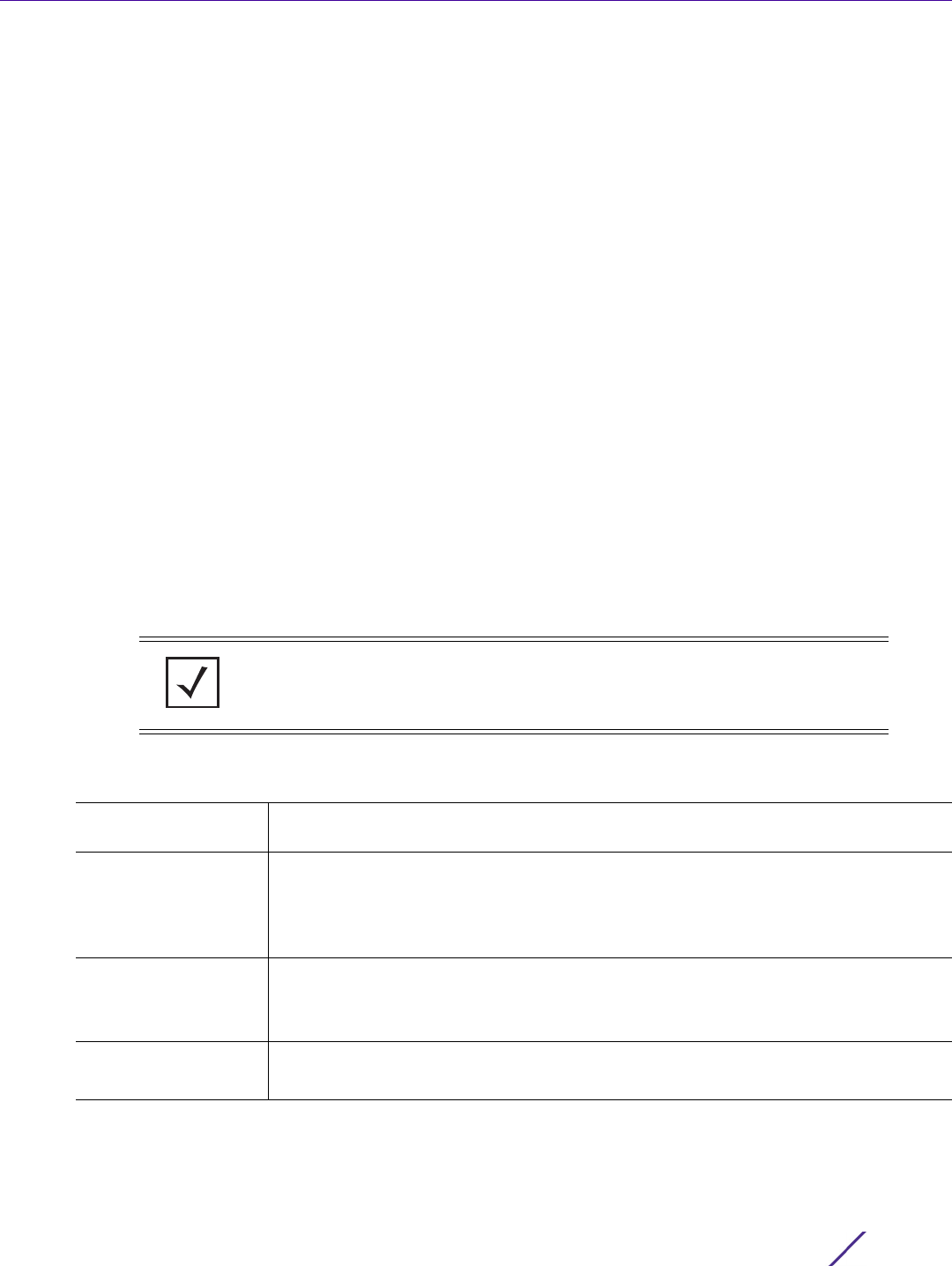
PRIVILEGED EXEC MODE COMMANDS
Access Point, Wireless Controller and Service Platform CLI Reference Guide 3 - 33
3.1.12 cpe
Privileged Exec Mode Commands
Enables a WiNG controller to perform certain operations on Customer Premises Equipment (CPEs) through
an adopted T5 controller
A T5 controller uses the IPX operating system to manage its connected radio devices, as opposed to the
WiNG operating system used by RFS wireless controllers and NX service platforms. However, a T5
controller, once enabled as a supported external device, can provide data to WiNG to assist in a T5’s
management within a WiNG supported subnet populated by both types of devices. The CPEs are the T5
controller managed radio devices using the IPX operating system. These CPEs use a Digital Subscriber Line
(DSL) as their high speed Internet access mechanism using the CPE’s physical wallplate connection and
phone jack.
Supported in the following platforms:
• Wireless Controllers — RFS4000, RFS6000
• Service Platforms — NX5500, NX7500, NX7510, NX7520, NX7530, NX9500, NX9510, NX9600,
VX9000
Syntax
cpe [boot|reload|upgrade]
cpe boot system cpe [<1-24>|all] [primary|secondary] {on <T5-DEVICE-NAME>}
cpe [reload|upgrade <IMAGE-LOCATION>] cpe [<1-24>|all] {on <T5-DEVICE-NAME>}
Parameters
• cpe boot system cpe [<1-24>|all] [primary|secondary] {on <T5-DEVICE-NAME>}
NOTE: These commands can also be executed on the T5 profile and device
context. For more information, see T5 Profile Config Commands.
cpe boot system Changes the image used by a CPE to boot. When reloading, the CPE uses the
specified image.
cpe [<1-24>|all] Identifies the CPE(s) on which this change is implemented
• <1-24> – Reloads only those CPEs whose IDs have been specified. Specify the ID from
1 - 24.
• all – Reloads all CPEs
[primary|secondary] Select the next boot image
• primary – Uses the primary image when reloading
• secondary – Uses the secondary image when reloading
on <T5-DEVICE-
NAME>
Optional. Performs this operation on a specified T5 device
• <T5-DEVICE-NAME> – Specify the T5 device’s hostname.

PRIVILEGED EXEC MODE COMMANDS
Access Point, Wireless Controller and Service Platform CLI Reference Guide 3 - 34
• cpe [reload|upgrade <IMAGE-LOCATION>] cpe [<1-24>|all] {on <T5-DEVICE-NAME>}
Example
nx9500-6C8809#show t5 cpe boot on t5-ED7C6C
--------------------------------------------------------------------------------
--------------------
DEVICE PRIMARY VERSION SECONDARY VERSION NEXT BOOT UPGRADE STATUS UPGRADE
PROGRESS %
--------------------------------------------------------------------------------
--------------------
cpe1 5.4.2.0-010R 5.4.2.0-006B primary none 0
cpe2 5.4.2.0-010R 5.4.2.0-006B primary none 0
--------------------------------------------------------------------------------
--------------------
nx9500-6C8809#
nx9500-6C8809#cpe boot system cpe 1 secondary on t5-ED7C6C
Updated T5 CPE system boot partition
nx9500-6C8809#
cpe [reload|
upgrade
<IMAGE-LOCATION>]
Performs the following operations on CPEs
• reload – Reloads the device
• upgrade <IMAGE-LOCATION> – Upgrades the device
• <IMAGE-LOCATION> – Specify the location of the firmware image. Both IPv4 and
IPv6 addresses are supported. Use one of the following options to provide the
location:
IPv4 URLs:
tftp://<hostname|IP>[:port]/path/file
ftp://<user>:<passwd>@<hostname|IP>[:port]/path/file
sftp://<user>:<passwd>@<hostname|IP>[:port]>/path/file
http://<hostname|IP>[:port]/path/file
cf:/path/file
usb<n>:/path/file
IPv6 URLs:
tftp://<hostname|[IPv6]>[:port]/path/file
ftp://<user>:<passwd>@<hostname|[IPv6]>[:port]/path/file
sftp://<user>:<passwd>@<hostname|[IPv6]>[:port]>/path/file
http://<hostname|[IPv6]>[:port]/path/file
Note: After specifying the operation to perform, identify the device(s).
cpe [<1-24>|all] Identifies the CPE(s) on which the operation is performed
• <1-24> – Configures the CPE’s ID from 1 - 24
• all – Configures all CPEs
on <T5-DEVICE-
NAME>
Optional. Performs this operation on a specified T5 device
• <T5-DEVICE-NAME> – Specify the T5 device’s hostname.

PRIVILEGED EXEC MODE COMMANDS
Access Point, Wireless Controller and Service Platform CLI Reference Guide 3 - 35
3.1.13 create-cluster
Privileged Exec Mode Commands
Creates a new device cluster, with the specified name, and assigns it an IP address and routing level
A cluster (or redundancy group) is a set of controllers or service platforms (nodes) uniquely defined by a
profile configuration. Within the cluster, members discover and establish connections to other members
and provide wireless network self-healing support in the event of member's failure.
A cluster's load is typically distributed evenly amongst its members. An administrator needs to define how
often the profile is load balanced for radio distribution, as radios can come and go and members join and
exit the cluster.
Supported in the following platforms:
• Access Points — AP6521, AP6522, AP6532, AP6562, AP7161, AP7502, AP7522, AP7532, AP7562,
AP7602, AP7612, AP7622, AP7632, AP7662, AP81XX, AP8232, AP8432, AP8533
• Wireless Controllers — RFS4000, RFS6000
• Service Platforms — NX5500, NX7500, NX7510, NX7520, NX7530, NX9500, NX9510, NX9600,
VX9000
Syntax
create-cluster name <CLUSTER-NAME> ip <IP> {level [1|2]}
Parameters
• create-cluster name <CLUSTER-NAME> ip <IP> {level [1|2]}
Example
rfs4000-229D58#create-cluster name TechPubs ip 192.168.13.8 level 2
... creating cluster
... committing the changes
... saving the changes
Please Wait .
[OK]
rfs4000-229D58#
rfs4000-229D58#show cluster configuration
create-cluster Creates a cluster
name
<CLUSTER-NAME>
Configures the cluster name
• <CLUSTER-NAME> – Specify a cluster name. Define a name for the cluster name
unique to its configuration or profile support requirements. The name cannot exceed
64 characters.
ip <IP> Specifies the device’s IP address used for cluster creation
• <IP> – Specify the device’s IP address in the A.B.C.D format.
level [1|2] Optional. Configures the routing level for this cluster
• 1 – Configures level 1 (local) routing
• 2 – Configures level 2 (inter-site) routing

PRIVILEGED EXEC MODE COMMANDS
Access Point, Wireless Controller and Service Platform CLI Reference Guide 3 - 36
Cluster Configuration Information
Name : TechPubsLAN
Configured Mode : Active
Master Priority : 128
Force configured state : Disabled
Force configured state delay : 5 minutes
Handle STP : Disabled
Radius Counter DB Sync Time : 5 minutes
rfs4000-229D58#
rfs4000-229D58#show context
!
! Configuration of RFS4000 version 5.9.1.0-012D
!
!
version 2.5
!
!
firewall-policy default
no ip dos tcp-sequence-past-window
alg sip
!
!
mint-policy global-default
router packet priority 6
!
radio-qos-policy default
!
!
management-policy default
telnet
http server
https server
no ftp
--More--
rfs4000-229D58#
Related Commands
cluster Initiates the cluster context. The cluster context provides centralized management to
configure all cluster members from any one member.
join-cluster Adds a wireless controller, access point, or service platform, as cluster member, to an
existing cluster of devices

PRIVILEGED EXEC MODE COMMANDS
Access Point, Wireless Controller and Service Platform CLI Reference Guide 3 - 37
3.1.14 crypto
Privileged Exec Mode Commands
Enables digital certificate configuration and RSA Keypair management. Digital certificates are issued by
CAs and contain user or device specific information, such as name, public key, IP address, serial number,
company name, etc. Use this command to generate, delete, export, or import encrypted RSA Keypairs and
generate Certificate Signing Request (CSR).
This command also enables trustpoint configuration. Trustpoints contain the CA’s identity and configuration
parameters.
Supported in the following platforms:
• Access Points — AP6521, AP6522, AP6532, AP6562, AP7161, AP7502, AP7522, AP7532, AP7562,
AP7602, AP7612, AP7622, AP7632, AP7662, AP81XX, AP8232, AP8432, AP8533
• Wireless Controllers — RFS4000, RFS6000
• Service Platforms — NX5500, NX7500, NX7510, NX7520, NX7530, NX9500, NX9510, NX9600,
VX9000
Syntax
crypto [key|pki]
crypto key [export|generate|import|zeroize]
crypto key export rsa <RSA-KEYPAIR-NAME> <EXPORT-TO-URL>
{background|on|passphrase}
crypto key export rsa <RSA-KEYPAIR-NAME> <EXPORT-TO-URL> {background|passphrase
<KEY-PASSPHRASE> background} {(on <DEVICE-NAME>)}
crypto key generate rsa <RSA-KEYPAIR-NAME> [2048|4096] {on <DEVICE-NAME>}
crypto key import rsa <RSA-KEYPAIR-NAME> <IMPORT-FROM-URL>
{background|on|passphrase}
crypto key import rsa <RSA-KEYPAIR-NAME> <IMPORT-FROM-URL> {background|passphrase
<KEY-PASSPHRASE> background} {(on <DEVICE-NAME>)}
crypto key zeroize rsa <RSA-KEYPAIR-NAME> {force} {(on <DEVICE-NAME>)}
crypto pki [authenticate|export|generate|import|zeroize]
crypto pki authenticate <TRUSTPOINT-NAME> <LOCATION-URL> {background} {(on
<DEVICE-NAME>)}
crypto pki export [request|trustpoint]
crypto pki export request [generate-rsa-key|short|use-rsa-key] <RSA-KEYPAIR-NAME>
[autogen-subject-name|subject-name]
crypto pki export request [generate-rsa-key|use-rsa-key] <RSA-KEYPAIR-NAME>
autogen-subject-name (<EXPORT-TO-URL>,email <SEND-TO-EMAIL>,fqdn <FQDN>,ip-
address <IP>)
crypto pki export request [generate-rsa-key|short [generate-rsa-key|use-rsa-key]|
use-rsa-key] <RSA-KEYPAIR-NAME> subject-name <COMMON-NAME> <COUNTRY> <STATE>
<CITY> <ORGANIZATION> <ORGANIZATION-UNIT> (<EXPORT-TO-URL>,email <SEND-TO-EMAIL>,
fqdn <FQDN>,ip-address <IP>)
crypto pki export trustpoint <TRUSTPOINT-NAME> <EXPORT-TO-URL>
{background|passphrase <KEY-PASSPHRASE> background} {(on <DEVICE-NAME)}

PRIVILEGED EXEC MODE COMMANDS
Access Point, Wireless Controller and Service Platform CLI Reference Guide 3 - 38
crypto pki generate self-signed <TRUSTPOINT-NAME> [generate-rsa-key|use-rsa-key]
<RSA-KEYPAIR-NAME> [autogen-subject-name|subject-name]
crypto pki generate self-signed <TRUSTPOINT-NAME> [generate-rsa-key|use-rsa-key]
<RSA-KEYPAIR-NAME> autogen-subject-name {(email <SEND-TO-EMAIL>,fqdn <FQDN>,ip-
address <IP>,on <DEVICE-NAME>)}
crypto pki generate self-signed <TRUSTPOINT-NAME> [generate-rsa-key|use-rsa-key]
<RSA-KEYPAIR-NAME> subject-name <COMMON-NAME> <COUNTRY> <STATE> <CITY>
<ORGANIZATION> <ORGANIZATION-UNIT> {(email <SEND-TO-EMAIL>,fqdn <FQDN>,ip-address
<IP>,on <DEVICE-NAME>)}
crypto pki import [certificate|crl|trustpoint]
crypto pki import [certificate|crl] <TRUSTPOINT-NAME> <IMPORT-FROM-URL>
{background} {(on <DEVICE-NAME>})
crypto pki import trustpoint <TRUSTPOINT-NAME> <IMPORT-FROM-URL>
{background|passphrase <KEY-PASSPHRASE> background} {(on <DEVICE-NAME>)}
crypto pki zeroize trustpoint <TRUSTPOINT-NAME> {del-key} {(on <DEVICE-NAME>)}
Parameters
• crypto key export rsa <RSA-KEYPAIR-NAME> <EXPORT-TO-URL> {background|passphrase
<KEY-PASSPHRASE> background} {(on <DEVICE-NAME>)}
• crypto key generate rsa <RSA-KEYPAIR-NAME> [2048|4096] {on <DEVICE-NAME>}
key Enables RSA Keypair management. Use this command to export, import, generate,
or delete a RSA key.
export rsa
<RSA-KEYPAIR-
NAME>
Exports an existing RSA Keypair to a specified destination
• <RSA-KEYPAIR-NAME> – Specify the RSA Keypair name.
<EXPORT-TO-URL> Specify the RSA Keypair destination address. Both IPv4 and IPv6 address formats
are supported.
After specifying the destination address (where the RSA keypair is exported),
configure one of the following parameters: background or passphrase.
background Optional. Performs export operation in the background. If selecting this option, you
can optionally specify the device (access point or controller) to perform the export
on.
passphrase
<KEY-PASSPHRASE>
background
Optional. Encrypts RSA Keypair before exporting
• <KEY-PASSPHRASE> – Specify a passphrase to encrypt the RSA keypair.
• background – Optional. Performs export operation in the background. After
specifying the passphrase, optionally specify the device (access point or controller)
to perform the export on.
on <DEVICE-NAME> The following parameter is recursive and common to all of the above parameters:
• on <DEVICE-NAME> – Optional. Performs export operation on a specified device
• <DEVICE-NAME> – Specify the name of the AP, wireless controller, or service
platform.
key Enables RSA Keypair management. Use this command to export, import, generate,
or delete a RSA key.

PRIVILEGED EXEC MODE COMMANDS
Access Point, Wireless Controller and Service Platform CLI Reference Guide 3 - 39
• crypto key import rsa <RSA-KEYPAIR-NAME> <IMPORT-FROM-URL>
{background|passphrase <KEY-PASSPHRASE> background} {(on <DEVICE-NAME>)}
• crypto key zeroize rsa <RSA-KEYPAIR-NAME> {force} {(on <DEVICE-NAME>)}
generate rsa
<RSA-KEYPAIR-
NAME> [2048|4096]
Generates a new RSA Keypair
• <RSA-KEYPAIR-NAME> – Specify the RSA Keypair name.
• [2048|4096] – Sets the size of the RSA key in bits. The options are 2048 bits and
4096 bits. The default size is 2048 bits.
After specifying the key size, optionally specify the device (access point or
controller) to generate the key on.
on <DEVICE-NAME> Optional. Generates the new RSA Keypair on a specified device
• <DEVICE-NAME> – Specify the name of the AP, wireless controller, or service
platform.
key Enables RSA Keypair management. Use this command to export, import, generate,
or delete a RSA key.
import rsa
<RSA-KEYPAIR-
NAME>
Imports a RSA Keypair from a specified source
• <RSA-KEYPAIR-NAME> – Specify the RSA Keypair name.
<IMPORT-FROM-URL> Specify the RSA Keypair source address. Both IPv4 and IPv6 address formats are
supported.
After specifying the source address (where the RSA Keypair is imported from),
configure one of the following parameters: background or passphrase.
background Optional. Performs import operation in the background. If selecting this option, you
can optionally specify the device (access point or controller) to perform the import
on.
passphrase
<KEY-PASSPHRASE>
background
Optional. Decrypts the RSA Keypair after importing
• <KEY-PASSPHRASE> – Specify the passphrase to decrypt the RSA keypair.
• background – Optional. Performs import operation in the background. After
specifying the passphrase, optionally specify the device (access point or controller)
to perform the import on.
on <DEVICE-NAME> The following parameter is recursive and common to the ‘background’ and
‘passphrase’ keywords:
• on <DEVICE-NAME> – Optional. Performs import operation on a specific device
• <DEVICE-NAME> – Specify the name of the AP, wireless controller, or service plat-
form.
key Enables RSA Keypair management. Use this command to export, import, generate,
or delete a RSA key.
zeroize rsa
<RSA-KEYPAIR-
NAME>
Deletes a specified RSA Keypair
• <RSA-KEYPAIR-NAME> – Specify the RSA Keypair name.
Note: All device certificates associated with this key will also be deleted.
force Optional. Forces deletion of all certificates associated with the specified RSA
Keypair. Optionally specify a device on which to force certificate deletion.

PRIVILEGED EXEC MODE COMMANDS
Access Point, Wireless Controller and Service Platform CLI Reference Guide 3 - 40
• crypto pki authenticate <TRUSTPOINT-NAME> <URL> {background} {(on <DEVICE-
NAME>)}
• crypto pki export request [generate-rsa-key|use-rsa-key] <RSA-KEYPAIR-NAME>
autogen-subject-name (<EXPORT-TO-URL>,email <SEND-TO-EMAIL>,fqdn <FQDN>,ip-
address <IP>)
on <DEVICE-NAME> The following parameter is recursive and optional:
• on <DEVICE-NAME> – Optional. Deletes all certificates associated with the RSA
Keypair on a specified device
• <DEVICE-NAME> – Specify the name of the AP, wireless controller, or service plat-
form.
pki Enables Private Key Infrastructure (PKI) management. Use this command to
authenticate, export, generate, or delete a trustpoint and its associated Certificate
Authority (CA) certificates.
authenticate
<TRUSTPOINT-NAME>
Authenticates a trustpoint and imports the corresponding CA certificate
• <TRUSTPOINT-NAME> – Specify the trustpoint name.
<URL> Specify CA’s location. Both IPv4 and IPv6 address formats are supported.
Note: The CA certificate is imported from the specified location.
background Optional. Performs authentication in the background. If selecting this option, you
can optionally specify the device (access point or controller) to perform the
authentication on.
on <DEVICE-NAME> The following parameter is recursive and optional:
•on <DEVICE-NAME> – Optional. Performs authentication on a specified device
• <DEVICE-NAME> – Specify the name of the AP, wireless controller, or service
platform.
pki Enables PKI management. Use this command to authenticate, export, generate, or
delete a trustpoint and its associated CA certificates.
export request Exports CSR to the CA for digital identity certificate. The CSR contains applicant’s
details and RSA Keypair’s public key.
[generate-rsa-key|
use-rsa-key]
<RSA-KEYPAIR-
NAME>
Generates a new RSA Keypair or uses an existing RSA Keypair
• generate-rsa-key – Generates a new RSA Keypair for digital authentication
• use-rsa-key – Uses an existing RSA Keypair for digital authentication
• <RSA-KEYPAIR-NAME> – If generating a new RSA Keypair, specify a name for it.
If using an existing RSA Keypair, specify its name.
autogen-subject-name Auto generates subject name from configuration parameters. The subject name
identifies the certificate.
<EXPORT-TO-URL> Specify the CA’s location. Both IPv4 and IPv6 address formats are supported.
Note: The CSR is exported to the specified location.
email
<SEND-TO-EMAIL>
Exports CSR to a specified e-mail address
• <SEND-TO-EMAIL> – Specify the CA’s e-mail address.
fqdn <FQDN> Exports CSR to a specified Fully Qualified Domain Name (FQDN)
• <FQDN> – Specify the CA’s FQDN.
ip-address <IP> Exports CSR to a specified device or system
• <IP> – Specify the CA’s IP address.

PRIVILEGED EXEC MODE COMMANDS
Access Point, Wireless Controller and Service Platform CLI Reference Guide 3 - 41
• crypto pki export request [generate-rsa-key|short [generate-rsa-key|use-rsa-
key]|use-rsa-key] <RSA-KEYPAIR-NAME> subject-name <COMMON-NAME> <COUNTRY> <STATE>
<CITY> <ORGANIZATION> <ORGANIZATION-UNIT> (<EXPORT-TO-URL>,email <SEND-TO-EMAIL>,
fqdn <FQDN>,ip-address <IP>)
• crypto pki export trustpoint <TRUSTPOINT-NAME> <EXPORT-TO-URL>
{background|passphrase <KEY-PASSPHRASE> background} {(on <DEVICE-NAME>)}
pki Enables PKI management. Use this command to authenticate, export, generate, or
delete a trustpoint and its associated CA certificates.
export request Exports CSR to the CA for a digital identity certificate. The CSR contains applicant’s
details and RSA Keypair’s public key.
[generate-rsa-key|
short [generate-rsa-
key|use-rsa-key]|
use-rsa-key]
<RSA-KEYPAIR-
NAME>
Generates a new RSA Keypair or uses an existing RSA Keypair
• generate-rsa-key – Generates a new RSA Keypair for digital authentication
• short [generate-rsa-key|use-rsa-key] – Generates and exports a shorter version of
the CSR
• generate-rsa-key – Generates a new RSA Keypair for digital authentication. If gen-
erating a new RSA Keypair, specify a name for it.
• use-rsa-key – Uses an existing RSA Keypair for digital authentication. If using an
existing RSA Keypair, specify its name.
• use-rsa-key – Uses an existing RSA Keypair for digital authentication
• <RSA-KEYPAIR-NAME> – If generating a new RSA Keypair, specify a name for it.
If using an existing RSA Keypair, specify its name.
subject-name
<COMMON-NAME>
Configures a subject name, defined by the <COMMON-NAME> keyword, to identify
the certificate
• <COMMON-NAME> – Specify the common name used with the CA certificate. The
name should enable you to identify the certificate easily (2 to 64 characters in
length).
<COUNTRY> Sets the deployment country code (2 character ISO code)
<STATE> Sets the state name (2 to 64 characters in length)
<CITY> Sets the city name (2 to 64 characters in length)
<ORGANIZATION> Sets the organization name (2 to 64 characters in length)
<ORGANIZATION-
UNIT>
Sets the organization unit (2 to 64 characters in length)
<EXPORT-TO-URL> Specify the CA’s location. Both IPv4 and IPv6 address formats are supported.
The CSR is exported to the specified location.
email
<SEND-TO-EMAIL>
Exports CSR to a specified e-mail address
• <SEND-TO-EMAIL> – Specify the CA’s e-mail address.
fqdn <FQDN> Exports CSR to a specified FQDN
• <FQDN> – Specify the CA’s FQDN.
ip-address <IP> Exports CSR to a specified device or system
• <IP> – Specify the CA’s IP address.
pki Enables PKI management. Use this command to authenticate, export, generate, or
delete a trustpoint and its associated CA certificates.

PRIVILEGED EXEC MODE COMMANDS
Access Point, Wireless Controller and Service Platform CLI Reference Guide 3 - 42
• crypto pki generate self-signed <TRUSTPOINT-NAME> [generate-rsa-key|use-rsa-key]
<RSA-KEYPAIR-NAME> autogen-subject-name {(email <SEND-TO-EMAIL>,fqdn <FQDN>,ip-
address <IP>,on <DEVICE-NAME>)}
export trustpoint
<TRUSTPOINT-NAME>
Exports a trustpoint along with CA certificate, Certificate Revocation List (CRL),
server certificate, and private key
• <TRUSTPOINT-NAME> – Specify the trustpoint name (should be authenticated).
<EXPORT-TO-URL> Specify the destination address. Both IPv4 and IPv6 address formats are supported.
The trustpoint is exported to the address specified here.
background Optional. Performs export operation in the background. If selecting this option, you
can optionally specify the device (access point or controller) to perform the export
on.
passphrase
<KEY-PASSPHRASE>
background
Optional. Encrypts the key with a passphrase before exporting
• <KEY-PASSPHRASE> – Specify the passphrase to encrypt the trustpoint.
• background – Optional. Performs export operation in the background. After
specifying the passphrase, optionally specify the device (access point or controller)
to perform the export on.
on <DEVICE-NAME> The following parameter is recursive and common to the ‘background’ and
‘passphrase’ keywords:
• on <DEVICE-NAME> – Optional. Performs export operation on a specified device
• <DEVICE-NAME> – Specify the name of the AP, wireless controller, or service plat-
form.
pki Enables PKI management. Use this command to authenticate, export, generate, or
delete a trustpoint and its associated certificates.
generate Generates a certificate and a trustpoint
self-signed
<TRUSTPOINT-NAME>
Generates a self-signed certificate and a trustpoint
• <TRUSTPOINT-NAME> – Specify a name for the certificate and its trustpoint.
[generate-rsa-key|
use-rsa-key]
<RSA-KEYPAIR-
NAME>
Generates a new RSA Keypair, or uses an existing RSA Keypair
• generate-rsa-key – Generates a new RSA Keypair for digital authentication
• use-rsa-key – Uses an existing RSA Keypair for digital authentication
• <RSA-KEYPAIR-NAME> – If generating a new RSA Keypair, specify a name for it.
If using an existing RSA Keypair, specify its name.
autogen-subject-name Auto generates the subject name from the configuration parameters. The subject
name helps to identify the certificate.
email
<SEND-TO-EMAIL>
Optional. Exports the self-signed certificate to a specified e-mail address
• <SEND-TO-EMAIL> – Specify the e-mail address.
fqdn <FQDN> Optional. Exports the self-signed certificate to a specified FQDN
• <FQDN> – Specify the FQDN.
ip-address <IP> Optional. Exports the self-signed certificate to a specified device or system
• <IP> – Specify the device’s IP address.
on <DEVICE-NAME> Optional. Exports the self-signed certificate on a specified device
• <DEVICE-NAME> – Specify the name of the AP, wireless controller, or service
platform.

PRIVILEGED EXEC MODE COMMANDS
Access Point, Wireless Controller and Service Platform CLI Reference Guide 3 - 43
• crypto pki generate self-signed <TRUSTPOINT-NAME> [generate-rsa-key|use-rsa-key]
<RSA-KEYPAIR-NAME> subject-name <COMMON-NAME> <COUNTRY> <STATE> <CITY>
<ORGANIZATION> <ORGANIZATION-UNIT> {(email <SEND-TO-EMAIL>,fqdn <FQDN>,ip-address
<IP>,on <DEVICE-NAME>)}
• crypto pki import [certificate|crl] <TRUSTPOINT-NAME> <IMPORT-FROM-URL>
{background} {(on <DEVICE-NAME>)}
pki Enables PKI management. Use this command to authenticate, export, generate, or
delete a trustpoint and its associated certificates.
generate self-signed
<TRUSTPOINT-NAME>
Generates a self-signed certificate and a trustpoint
• <TRUSTPOINT-NAME> – Specify a name for the certificate and its trustpoint.
[generate-rsa-key|
use-rsa-key]
<RSA-KEYPAIR-
NAME>
Generates a new RSA Keypair, or uses an existing RSA Keypair
• generate-rsa-key – Generates a new RSA Keypair for digital authentication
• use-rsa-key – Uses an existing RSA Keypair for digital authentication
• <RSA-KEYPAIR-NAME> – If generating a new RSA Keypair, specify a name for it.
If using an existing RSA Keypair, specify its name.
subject-name
<COMMON-NAME>
Configures a subject name, defined by the <COMMON-NAME> keyword, to identify
the certificate
• <COMMON-NAME> – Specify the common name used with this certificate. The name
should enable you to identify the certificate easily and should not exceed 2 to 64
characters in length.
<COUNTRY> Sets the deployment country code (2 character ISO code)
<STATE> Sets the state name (2 to 64 characters in length)
<CITY> Sets the city name (2 to 64 characters in length)
<ORGANIZATION> Sets the organization name (2 to 64 characters in length)
<ORGANIZATION-
UNIT>
Sets the organization unit (2 to 64 characters in length)
email
<SEND-TO-EMAIL>
Optional. Exports the self-signed certificate to a specified e-mail address
• <SEND-TO-EMAIL> – Specify the e-mail address.
fqdn <FQDN> Optional. Exports the self-signed certificate to a specified FQDN
• <FQDN> – Specify the FQDN.
ip-address <IP> Optional. Exports the self-signed certificate to a specified device or system
• <IP> – Specify the device’s IP address.
pki Enables PKI management. Use this command to authenticate, export, generate, or
delete a trustpoint and its associated CA certificates.
import Imports certificates, Certificate Revocation List (CRL), or a trustpoint to the selected
device
[certificate|crl]
<TRUSTPOINT-NAME>
Imports a signed server certificate or CRL
• certificate – Imports signed server certificate
•crl – Imports CRL
• <TRUSTPOINT-NAME> – Specify the trustpoint name (should be authenticated).
<IMPORT-FROM-URL> Specify the signed server certificate or CRL source address. Both IPv4 and IPv6
address formats are supported.
The server certificate or the CRL (based on the parameter passed in the preceding
step) is imported from the location specified here.

PRIVILEGED EXEC MODE COMMANDS
Access Point, Wireless Controller and Service Platform CLI Reference Guide 3 - 44
• crypto pki import trustpoint <TRUSTPOINT-NAME> <IMPORT-FROM-URL>
{background|passphrase <KEY-PASSPHRASE> background} {(on <DEVICE-NAME>)}
• crypto pki zeroize trustpoint <TRUSTPOINT-NAME> {del-key} {(on <DEVICE-NAME>)}
background Optional. Performs import operation in the background. If selecting this option, you
can optionally specify the device (access point or controller) to perform the import
on.
on <DEVICE-NAME> The following parameter is recursive and optional:
• on <DEVICE-NAME> – Optional. Performs import operation on a specified device
• <DEVICE-NAME> – Specify the name of the AP, wireless controller, or service plat-
form.
pki Enables PKI management. Use this command to authenticate, export, generate, or
delete a trustpoint and its associated CA certificates.
import Imports certificates, CRL, or a trustpoint to the selected device
trustpoint
<TRUSTPOINT-NAME>
Imports a trustpoint and its associated CA certificate, server certificate, and private
key
• <TRUSTPOINT-NAME> – Specify the trustpoint name (should be authenticated).
<IMPORT-FROM-URL> Specify the trustpoint source address. Both IPv4 and IPv6 address formats are
supported.
background Optional. Performs import operation in the background. If selecting this option, you
can optionally specify the device (access point or controller) to perform the export
on.
passphrase
<KEY-PASSPHRASE>
background
Optional. Decrypts trustpoint with a passphrase after importing
• <KEY-PASSPHRASE> – Specify the passphrase. After specifying the passphrase,
optionally specify the device to perform import on.
• background – Optional. Performs import operation in the background. After
specifying the passphrase, optionally specify the device (access point or controller)
to perform the import on.
on <DEVICE-NAME> The following parameter is recursive and optional:
• on <DEVICE-NAME> – Optional. Performs import operation on a specified device
• <DEVICE-NAME> – Specify the name of the AP, wireless controller, or service plat-
form.
pki Enables PKI management. Use this command to authenticate, export, generate, or
delete a trustpoint and its associated CA certificates.
zeroize trustpoint
<TRUSTPOINT-NAME>
Deletes a trustpoint and its associated CA certificate, server certificate, and private
key
• <TRUSTPOINT-NAME> – Specify the trustpoint name (should be authenticated).
del-key Optional. Deletes the private key associated with the server certificate. Optionally
specify the device to perform deletion on.
on <DEVICE-NAME> The following parameter is recursive and optional:
•on <DEVICE-NAME> – Optional. Deletes the trustpoint on a specified device
• <DEVICE-NAME> – Specify the name of the AP, wireless controller, or service plat-
form.

PRIVILEGED EXEC MODE COMMANDS
Access Point, Wireless Controller and Service Platform CLI Reference Guide 3 - 45
Usage Guidelines
The system supports both IPv4 and IPv6 address formats. Provide source and destination locations using
any one of the following options:
•IPv4 URLs:
tftp://<hostname|IP>[:port]/path/file
ftp://<user>:<passwd>@<hostname|IP>[:port]/path/file
sftp://<user>@<hostname|IP>[:port]>/path/file
http://<hostname|IP>[:port]/path/file
cf:/path/file
usb<n>:/path/file
•IPv6 URLs:
tftp://<hostname|[IPv6]>[:port]/path/file
ftp://<user>:<passwd>@<hostname|[IPv6]>[:port]/path/file
sftp://<user>:<passwd>@<hostname|[IPv6]>[:port]>/path/file
http://<hostname|[IPv6]>[:port]/path/file
Example
rfs6000-81742D#crypto key generate rsa key 1025
RSA Keypair successfully generated
rfs6000-81742D#
rfs6000-81742D#crypto key import rsa test123 url passphrase word background
RSA key import operation is started in background
rfs6000-81742D#
rfs6000-81742D#crypto pki generate self-signed word generate-rsa-key word autogen-
subject-name fqdn word
Successfully generated self-signed certificate
rfs6000-81742D#
rfs6000-81742D#crypto pki zeroize trustpoint word del-key
Successfully removed the trustpoint and associated certificates
%Warning: Applications associated with the trustpoint will start using default-
trustpoint
rfs6000-81742D#
rfs6000-81742D#crypto pki authenticate word url background
Import of CA certificate started in background
rfs6000-81742D#
rfs6000-81742D#crypto pki import trustpoint word url passphrase word
Import operation started in background
rfs6000-81742D#
Related Commands
no Removes server certificates, trustpoints and their associated certificates

PRIVILEGED EXEC MODE COMMANDS
Access Point, Wireless Controller and Service Platform CLI Reference Guide 3 - 46
3.1.15 crypto-cmp-cert-update
Privileged Exec Mode Commands
Triggers a Certificate Management Protocol (CMP) certificate update on a specified device or devices
Supported in the following platforms:
• Access Points — AP6521, AP6522, AP6532, AP6562, AP7161, AP7502, AP7522, AP7532, AP7562,
AP7602, AP7612, AP7622, AP7632, AP7662, AP81XX, AP8232, AP8432, AP8533
• Wireless Controllers — RFS4000, RFS6000
• Service Platforms — NX5500, NX7500, NX7510, NX7520, NX7530, NX9500, NX9510, NX9600,
VX9000
Syntax
crypto-cmp-cert-update <TRUSTPOINT-NAME> {on <DEVICE-NAME>}
Parameters
• crypto-cmp-cert-update <TRUSTPOINT-NAME> {on <DEVICE-NAME>}
Example
rfs4000-229D58#crypto-cmp-cert-update test on B4-C7-99-71-17-28
CMP Cert update success
rfs4000-229D58#
crypto-cmp-cert-update
<TRUSTPOINT-NAME>
{on <DEVICE-NAME>}
Triggers a CMP certificate update on a specified device or devices
• <TRUSTPOINT-NAME> – Specify the target trustpoint name. A trustpoint represents
a CA/identity pair containing the identity of the CA, CA specific configuration
parameters, and an association with an enrolled identity certificate. Use the crypto-
cmp-policy context to configure the trustpoint.
• on <DEVICE-NAME> – Optional. Triggers a CMP certificate update and response
on a specified device or devices. Specify the name of the AP, wireless controller, or
service platform. Multiple devices can be provided as a comma separated list.
• <DEVICE-NAME> – Specify the name of the AP, wireless controller, or service
platform.
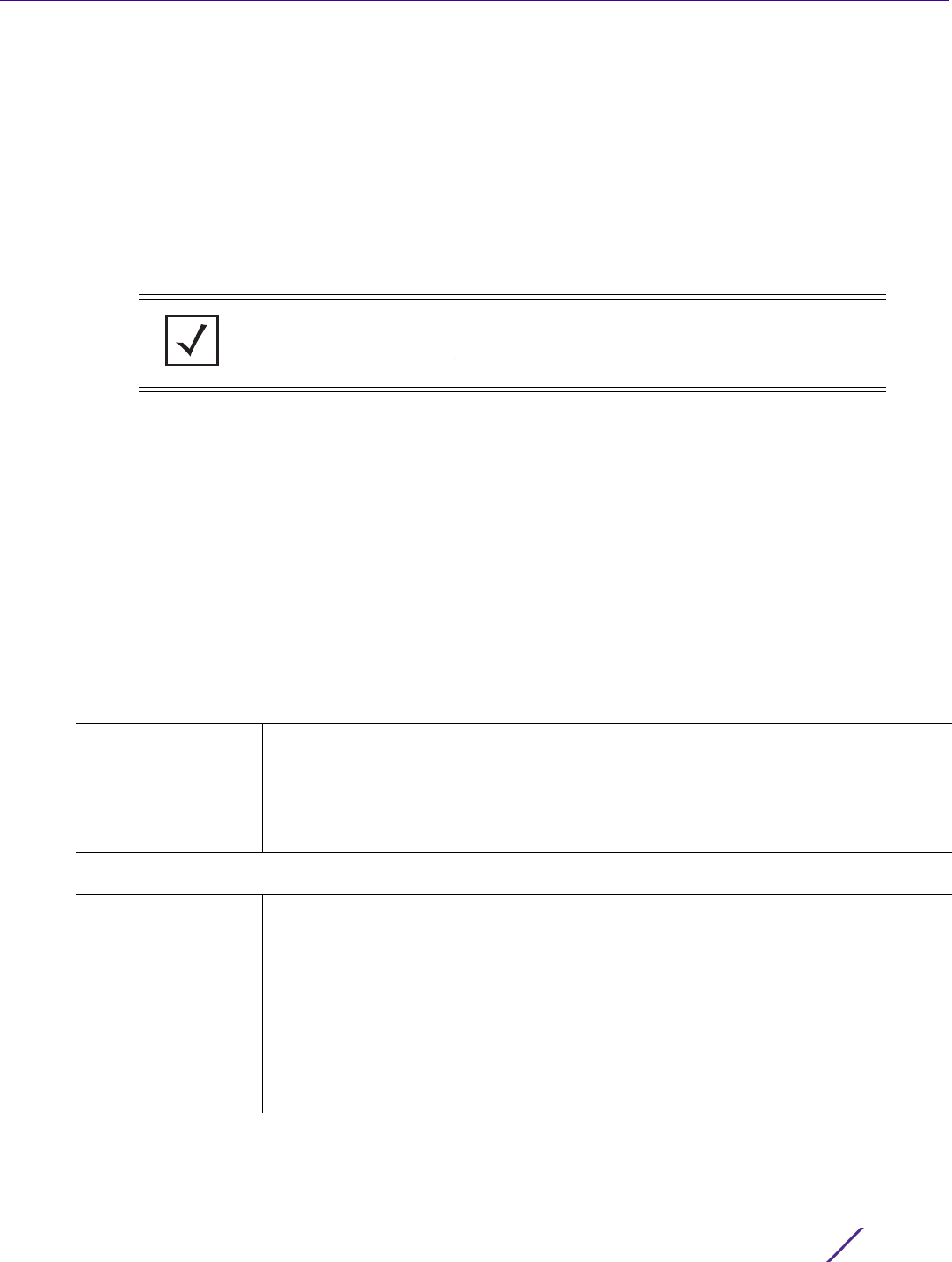
PRIVILEGED EXEC MODE COMMANDS
Access Point, Wireless Controller and Service Platform CLI Reference Guide 3 - 47
3.1.16 database
Privileged Exec Mode Commands
Enables automatic repairing (vacuuming) and dropping of databases (Captive-portal and NSight).
Vacuuming a database refers to the process of finding and reclaiming space left over from previous
DELETE statements.
If enforcing authenticated access to the database, use this command to generate the keyfile. Every keyfile
has a set of associated users having a username and password. Database access is provided only if the
keyfile and the user credentials entered during database longin match.
Supported in the following platforms:
• Service Platforms — NX9500, NX9510, NX9600, VX9000
Syntax
database [drop|keyfile|repair]
database drop [all|captive-portal|nsight]
database repair {on <DEVICE-NAME>}
database keyfile [export|generate|import|zerzoise]
database keyfile generate
database keyfile [export|import] <URL>
database keyfile zerzoise
Parameters
• database drop [all|captive-portal|nsight]
• database repair {on <DEVICE-NAME>}
NOTE: For information on enabling database authentication, see Enabling
Database Authentication.
database drop
[all|captive-portal|
nsight]
Drops (deletes) all or a specified database. Execute the command on the database
host.
• all – Drops all databases, captive portal and NSight.
• captive-portal – Drops captive-portal database only
• nsight – Drops NSight database only
database repair
on <DEVICE-NAME>
Enables automatic repairing of all databases. Execute the command on the database
host.
• on <DEVICE-NAME> – Optional. Specifies the name of the access point, wireless
controller, or service platform hosting the database. When specified, databases on the
specified device are periodically checked through to identify and remove obsolete
data documents.
• <DEVICE-NAME> – Specify the name of the AP, wireless controller, or service plat-
form.
If no device is specified, the system repairs all databases.

PRIVILEGED EXEC MODE COMMANDS
Access Point, Wireless Controller and Service Platform CLI Reference Guide 3 - 48
• database keyfile [generate|zerzoise]
• database keyfile [export|import] <URL>
• database keyfile zerzoise
Example
nx9500-6C8809#database repair on nx9500-6C8809
nx9500-6C8809#
nx9500-6C8809#database keyfile generate
Database keyfile successfully generated
nx9500-6C8809#
nx9500-6C8809#database keyfile zeroize
Database keyfile successfully removed
nx9500-6C8809#
vx9000-1A1809#database keyfile generate
Database keyfile successfully generated
vx9000-1A1809#
vx9000-1A1809#database keyfile export ftp://1.1.1.111/db-key
Database keyfile successfully exported
vx9000-1A1809#
vx9000-D031F2#database keyfile import ftp://1.1.1.111/db-key
Database keyfile successfully imported
vx9000-D031F2#
database keyfile
[generate|zerzoise]
Enables management of database keyfiles. This command is part of a series of
configurations that are required to enforce authentication on the database. Use this
command to generate keyfiles associated with the database. After generating the
keyfile, create the users having the database access. For information on creating
database users, see service.
• generate – Generates the keyfile. Execute the command on the primary database
host.
• zerzoise – Deletes a keyfile.
database keyfile
[export|import]
<URL>
Enables database keyfile management. This command is part of a series of
configurations required to enforce database authentication. Use this command to
exchange keyfiles between replica set members.
• export – Exports the keyfile to a specified location on an FTP/SFTP/TFTP server.
Execute the command on the primary database host.
• import – Imports the keyfile from a specified location. Execute the command on the
replica set members.
The following parameter is common to both of the above keywords:
• <URL> – Specify the location to/from where the keyfile is to be exported/imported.
Use one of the following options:
ftp://<user>:<passwd>@<hostname|IP>[:port]/path/file
sftp://<user>:<passwd>@<hostname|IP>[:port]/path/file
tftp://<hostname|IP>[:port]/path/file
database keyfile
zerzoise
Enables the management of database keyfiles
• zerzoise – Deletes an existing keyfile.

PRIVILEGED EXEC MODE COMMANDS
Access Point, Wireless Controller and Service Platform CLI Reference Guide 3 - 49
Related Commands
database-backup Backs up captive-portal and/or NSight database to a specified location and file on an
FTP or SFTP server
database-restore Restores a previously exported database [captive-portal and/or NSight]

PRIVILEGED EXEC MODE COMMANDS
Access Point, Wireless Controller and Service Platform CLI Reference Guide 3 - 50
3.1.17 database-backup
Privileged Exec Mode Commands
Backs up captive-portal/NSight database to a specified location and file on an FTP or SFTP server
Supported in the following platforms:
• Service Platforms — NX9500, NX9510, NX9600, VX9000
Syntaxf
database-backup database [captive-portal|nsight|nsight-placement-info] <URL>
database-backup database [captive-portal|nsight] <URL>
database-backup database nsight-placement-info <URL>
Parameters
• database-backup database [captive-portal|nsight] <URL>
• database-backup database nsight-placement-info <URL>
Example
NS-DB-nx9510-6C87EF#database-backup database nsight tftp://192.168.9.50/testbckup
NS-DB-nx9510-6C87EF#show database backup-status
Last Database Backup Status : In_Progress(Starting tftp transfer.)
Last Database Backup Time : 2017-04-17 12:48:05
NS-DB-nx9510-6C87EF#show database backup-status
Last Database Backup Status : Successful
Last Database Backup Time : Mon Apr 17 12:48:08 T 2017
NS-DB-nx9510-6C87EF#Apr 17 12:48:17 2017: NS-DB-nx9510-6C87EF : %DATABASE-6-
OPERATION_COMPLETE: backup for database nsight successful
NS-DB-nx9510-6C87EF#
NS-DB-nx9510-6C87EF#database-backup database nsight-placement-info tftp://192.16
8.9.50/plmentinfo
NS-DB-nx9510-6C87EF#show database backup-status
Last Database Backup Status : Successful
Last Database Backup Time : Mon Apr 17 12:48:48 IST 2017
NS-DB-nx9510-6C87EF#Apr 17 12:49:03 2017: NS-DB-nx9510-6C87EF : %DATABASE-6-
OPERATION_COMPLETE: backup for database nsight-placement-info successful
NS-DB-nx9510-6C87EF#
database-backup
database [captive-
portal|nsight]
Backs up captive portal and/or NSight database to a specified location. Select the
database to backup:
• captive-portal – Backs up captive portal database
• nsight – Backs up NSight database
After specifying the database type, configure the destination location.
<URL> Configures the destination location. The database is backed up at the specified
location. Specify the location URL in one of the following formats:
ftp://<user>:<passwd>@<hostname|IP>[:port]/path/file.tar.gz
sftp://<user>:<passwd>@<hostname|IP>[:port]/path/file.tar.gz
database-backup
database
nsight-placement-
info <URL>
Backs up the NSight access point placement related details to a specified location
• <URL> – Specify the URL in one of the following formats:
ftp://<user>:<passwd>@<hostname|IP>[:port]/path/file.tar.gz
sftp://<user>:<passwd>@<hostname|IP>[:port]/path/file.tar.gz
tftp://<hostname|IP>[:port]/path/file.tar.gz

PRIVILEGED EXEC MODE COMMANDS
Access Point, Wireless Controller and Service Platform CLI Reference Guide 3 - 51
Related Commands
database Enables automatic repairing (vacuuming) and dropping of databases (captive-portal
and NSight)
database-restore Restores a previously exported (backed up) database [captive-portal and/or NSight]

PRIVILEGED EXEC MODE COMMANDS
Access Point, Wireless Controller and Service Platform CLI Reference Guide 3 - 52
3.1.18 database-restore
Privileged Exec Mode Commands
Restores a previously exported database [captive-portal and/or NSight]. Previously exported databases
(backed up to a specified FTP or SFTP server) are restored from the backed-up location to the original
database.
Supported in the following platforms:
• Service Platforms — NX9500, NX9510, NX9600, VX9000
Syntax
database-restore database [captive-portal|nsight] <URL>
Parameters
• database-restore database [captive-portal|nsight] <URL>
Example
nx9500-6C8809#database-restore database nsight
ftp://anonymous:anonymous@192.168.13.10/backups/nsight/nsight.tar.gz
Related Commands
database-restore
database
[captive-portal|
nsight]
Restores previously exported (backed up) captive-portal and/or NSight database.
Specify the database type:
• captive-portal – Restores captive portal database
• nsight – Restores NSight database
After specifying the database type, configure the destination location and file name
from where the files are restored.
<URL> Configures the destination location. The database is restored from the specified
location. Specify the location URL in one of the following formats:
ftp://<user>:<passwd>@<hostname|IP>[:port]/path/file.tar.gz
sftp://<user>:<passwd>@<hostname|IP>[:port]/path/file.tar.gz
database Enables automatic repairing (vacuuming) and dropping of databases (captive-portal
and NSight)
database-backup Backs up captive-portal and/or NSight database to a specified location and file on an
FTP or SFTP server

PRIVILEGED EXEC MODE COMMANDS
Access Point, Wireless Controller and Service Platform CLI Reference Guide 3 - 53
3.1.19 delete
Privileged Exec Mode Commands
Deletes a specified file from the device’s file system
Supported in the following platforms:
• Access Points — AP6521, AP6522, AP6532, AP6562, AP7161, AP7502, AP7522, AP7532, AP7562,
AP7602, AP7612, AP7622, AP7632, AP7662, AP81XX, AP8232, AP8432, AP8533
• Wireless Controllers — RFS4000, RFS6000
• Service Platforms — NX5500, NX7500, NX7510, NX7520, NX7530, NX9500, NX9510, NX9600,
VX9000
Syntax
delete [/force <FILE>|/recursive <FILE>|<FILE>]
Parameters
• delete [/force <FILE>|/recursive <FILE>|<FILE>]
Example
rfs6000-81742D#delete flash:/out.tar flash:/out.tar.gz
Delete flash:/out.tar [y/n]? y
Delete flash:/out.tar.gz [y/n]? y
rfs6000-81742D#delete /force flash:/tmp.txt
rrfs6000-81742D#
rfs6000-81742D#delete /recursive flash:/backup/
Delete flash:/backup//fileMgmt_350_180B.core
[y/n]? y
Delete
flash:/backup//fileMgmt_350_18212X.core_bk
[y/n]? n
Delete flash:/backup//imish_1087_18381X.core.gz
[y/n]? n
rfs6000-81742D#
/force <FILE> Forces deletion without a prompt
/recursive <FILE> Performs a recursive delete
<FILE> Specifies the file name
• Deletes the file specified by the <FILE> parameter

PRIVILEGED EXEC MODE COMMANDS
Access Point, Wireless Controller and Service Platform CLI Reference Guide 3 - 54
3.1.20 device-upgrade
Privileged Exec Mode Commands
Enables firmware upgrade on an adopted device or a set of adopted devices (access points, wireless
controllers, and service platforms)
Supported in the following platforms:
• Access Points — AP6521, AP6522, AP6532, AP6562, AP7161, AP7502, AP7522, AP7532, AP7562,
AP7602, AP7612, AP7622, AP7632, AP7662, AP81XX, AP8232, AP8432, AP8533
• Wireless Controllers — RFS4000, RFS6000
• Service Platforms — NX5500, NX7500, NX7510, NX7520, NX7530, NX9500, NX9510, NX9600,
VX9000
Syntax
device-upgrade [<MAC/HOSTNAME>|all|ap6521|ap6522|ap6532|ap6562|ap71xx|ap7502|
ap7522|ap7532|ap7562|ap7602|ap7612|ap7622|ap7632|ap7662|ap81xx|ap82xx|ap8432|
ap8533|rfs4000|rfs6000|nx5500|nx75xx|nx9000|nx9600|vx9000|cancel-upgrade|load-
image|rf-domain]
device-upgrade <MAC/HOSTNAME> {no-reboot|reboot-time <TIME>|upgrade-time <TIME>
{no-reboot|reboot-time <TIME>}}
device-upgrade all {force|no-reboot|reboot-time <TIME>|upgrade-time <TIME>
{no-reboot|reboot-time <TIME>}} {(staggered-reboot)}
device-upgrade [ap6521|ap6522|ap6532|ap6562|ap71xx|ap7502|ap7522|ap7532|ap7562|
ap7602|ap7612|ap7622|ap7632|ap7662|ap81xx|ap82xx|ap8432|ap8533|rfs4000|rfs6000|
nx5500|nx75xx|nx9000|nx9600|vx9000] all {force|no-reboot|reboot-time <TIME>|
upgrade-time <TIME> {no-reboot|reboot-time <TIME>}} {(staggered-reboot)}
device-upgrade cancel-upgrade [<MAC/HOSTNAME>|all|ap6521|ap6522|ap6532|ap6562|
ap71xx|ap7502|ap7522|ap7532|ap7562|ap7602|ap7612|ap7622|ap7632|ap7662|ap81xx|
ap82xx|ap8432|ap8533|rfs4000|rfs6000|nx75xx|nx9000|nx9600|vx9000|on rf-domain
[<RF-DOMAIN-NAME>|all]]
device-upgrade load-image [ap6521|ap6522|ap6532|ap6562|ap71xx|ap7502|ap7522|
ap7532|ap7562|ap7602|ap7612|ap7622|ap7632|ap7662|ap81xx|ap82xx|ap8432|ap8533|
rfs4000|rfs6000|nx5500|nx75xx|nx9000|nx9600|vx9000] {<IMAGE-URL>|on <DEVICE-OR-
DOMAIN-NAME>}
device-upgrade rf-domain [<RF-DOMAIN-NAME>|all|containing <WORD>|filter location
<WORD>] [all|ap6521|ap6522|ap6532|ap6562|ap71xx|ap7502|ap7522|ap7532|ap7562|
ap7602|ap7612|ap7622|ap7632|ap7662|ap81xx|ap82xx|ap8432|ap8533|rfs4000|rfs6000|
nx5500|nx75xx|nx9000|nx9600|vx9000] {(<MAC/HOSTNAME>|force|no-reboot|
from-controller|reboot-time <TIME>|staggered-reboot|upgrade-time <TIME>)}
Parameters
• device-upgrade <MAC/HOSTNAME> {no-reboot|reboot-time <TIME>|upgrade-time <TIME>
{no-reboot|reboot-time <TIME>}}
NOTE: A NOC controller’s capacity is equal to, or higher than that of a site
controller. The following devices can be deployed at NOC and sites:
• NOC controller – NX95XX (NX9500 and NX9510), NX9600
• Site controller – RFS4000, RFS6000, NX5500, NX75XX, or NX95XX
<MAC/HOSTNAME> Upgrades firmware on the device identified by the <MAC/HOSTNAME> keyword
• <MAC/HOSTNAME> – Specify the device’s MAC address or hostname.

PRIVILEGED EXEC MODE COMMANDS
Access Point, Wireless Controller and Service Platform CLI Reference Guide 3 - 55
• device-upgrade all {force|no-reboot|reboot-time <TIME>|upgrade-time <TIME> {no-
reboot|reboot-time <TIME>}} {(staggered-reboot)}
• device-upgrade [ap6521|ap6522|ap6532|ap6562|ap71xx|ap7502|ap7522|ap7532|
ap7562|ap7602|ap7612|ap7622|ap7632|ap7662|ap81xx|ap82xx|ap8432|ap8533|rfs4000|
rfs6000|nx5500|nx75xx|nx9000|nx9600|vx9000] all {force|no-reboot|reboot-time
<TIME>|upgrade-time <TIME> {no-reboot|reboot-time <TIME>}} {(staggered-reboot)}
no-reboot Optional. Disables automatic reboot after a successful upgrade (the device must be
manually restarted)
reboot-time <TIME> Optional. Schedules an automatic reboot after a successful upgrade
• <TIME> – Specify the reboot time in the MM/DD/YYYY-HH:MM or HH:MM format.
upgrade-time <TIME>
{no-reboot|
reboot-time <TIME>}
Optional. Schedules an automatic device firmware upgrade on a specified day and
time
• <TIME> – Specify the upgrade time in the MM/DD/YYYY-HH:MM or HH:MM format.
The following actions can be performed after a scheduled upgrade:
• no-reboot – Optional. Disables automatic reboot after a successful upgrade
(the device must be manually restarted)
• reboot-time <TIME> – Optional. Schedules an automatic reboot after a successful
upgrade. Specify the reboot time in the MM/DD/YYYY-HH:MM or HH:MM format.
all Upgrades firmware on all devices
force Optional. Select this option to force upgrade on the selected device(s). When
selected, the devices are upgraded even if they have the same firmware as the
upgrading access point, wireless controller, or service platform. If forcing a device
upgrade, optionally specify any one of the following options: no-reboot, reboot-time,
upgrade-time, or staggered-reboot.
no-reboot Optional. Disables automatic reboot after a successful upgrade (the device must be
manually restarted)
reboot-time <TIME> Optional. Schedules an automatic reboot after a successful upgrade
• <TIME> – Specify the reboot time in the MM/DD/YYYY-HH:MM or HH:MM format.
upgrade-time <TIME>
{no-reboot|
reboot-time <TIME>}
Optional. Schedules an automatic device firmware upgrade on all devices on a
specified day and time
• <TIME> – Specify the upgrade time in the MM/DD/YYYY-HH:MM or HH:MM format.
The following actions can be performed after a scheduled upgrade:
• no-reboot – Optional. Disables automatic reboot after a successful upgrade
(the device must be manually restarted)
• reboot-time <TIME> – Optional. Schedules an automatic reboot after a
successful upgrade. Specify the reboot time in the MM/DD/YYYY-HH:MM or HH:MM
format.
staggered-reboot This keyword is recursive and common to all of the above.
• Optional. Enables staggered device reboot (one at a time), without network impact
device-upgrade
<DEVICE-TYPE> all
Upgrades firmware on all devices of a specific type. Select the device type. The
options are: AP6521, AP6522, AP6532, AP6562, AP7161, AP7502, AP7522, AP7532,
AP7562, AP7602, AP7612, AP7622, AP7632, AP7662, AP81XX, AP8232, AP8432,
AP8533, RFS4000, RFS6000, NX5500, NX75XX, NX95XX, NX9600, and VX9000.
After selecting the device type, schedule an automatic upgrade and/or an automatic
reboot.

PRIVILEGED EXEC MODE COMMANDS
Access Point, Wireless Controller and Service Platform CLI Reference Guide 3 - 56
• device-upgrade cancel-upgrade [<MAC/HOSTNAME>|all|ap6521|ap6522|ap6532|
ap6562|ap71xx|ap7502|ap7522|ap7532|ap7562|ap7602|ap7612|ap7622|ap7632|ap7662|
ap81xx|ap82xx|ap8432|ap8533|rfs4000|rfs6000|nx5500|nx75xx|nx9000|nx9600|vx9000|
on rf-domain [<RF-DOMAIN-NAME>|all]]
force Optional. Select this option to force upgrade on selected device(s). When selected,
the devices are upgraded even if they have the same firmware as the upgrading
access point, wireless controller, or service platform. If forcing a device upgrade,
optionally specify any one of the following options: no-reboot, reboot-time, upgrade-
time, or staggered-reboot.
no-reboot Optional. Disables automatic reboot after a successful upgrade (the device must be
manually restarted)
reboot-time <TIME> Optional. Schedules an automatic reboot after a successful upgrade
• <TIME> – Optional. Specify the reboot time in the MM/DD/YYYY-HH:MM or HH:MM
format.
upgrade-time <TIME>
{no-reboot|
reboot-time <TIME>}
Optional. Schedules an automatic firmware upgrade on all devices of the specified
type, on a specified day and time
• <TIME> – Specify the upgrade time in the MM/DD/YYYY-HH:MM or HH:MM format.
The following actions can be performed after a scheduled upgrade:
• no-reboot – Optional. Disables automatic reboot after a successful upgrade
(the device must be manually restarted)
• reboot-time <TIME> – Optional. Schedules an automatic reboot after a
successful upgrade. Specify the reboot time in the MM/DD/YYYY-HH:MM or HH:MM
format.
staggered-reboot This keyword is recursive and common to all of the above.
• Optional. Enables staggered device reboot (one at a time), without network impact
cancel-upgrade Cancels a scheduled firmware upgrade based on the parameters passed. This
command provides the following options to cancel scheduled firmware upgrades:
• Cancels upgrade on specific device(s). The devices are identified by their MAC
addresses or hostnames.
• Cancels upgrade on all devices within the network
• Cancels upgrade on all devices of a specific type. Specify the device type.
• Cancels upgrade on specific device or all device(s) within a specific RF Domain or all
RF Domains. Specify the RF Domain name.
cancel-upgrade
[<MAC/HOSTNAME>|
all]
Cancels a scheduled firmware upgrade on a specified device or on all devices
• <MAC/HOSTNAME> – Cancels a scheduled upgrade on the device identified by the
<MAC/HOSTNAME> keyword. Specify the device’s MAC address or hostname.
• all – Cancels scheduled upgrade on all devices
cancel-upgrade
<DEVICE-TYPE> all
Cancels scheduled firmware upgrade on all devices of a specific type. Select the
device type. The options are: AP6521, AP6522, AP6532, AP6562, AP7161, AP7502,
AP7522, AP7532, AP7562, AP7602, AP7612, AP7622, AP7632, AP7662, AP81XX,
AP8232, AP8432, AP8533, RFS4000, RFS6000, NX5500, NX75XX, NX9500,
NX9600, and VX9000.
cancel-upgrade on
rf-domain
[<RF-DOMAIN-
NAME>|
all]
Cancels scheduled firmware upgrade on all devices in a specified RF Domain or all
RF Domains
• <RF-DOMAIN-NAME> – Cancels scheduled device upgrade on all devices in a
specified RF Domain. Specify the RF Domain name.
• all – Cancels scheduled device upgrade on all devices across all RF Domains

PRIVILEGED EXEC MODE COMMANDS
Access Point, Wireless Controller and Service Platform CLI Reference Guide 3 - 57
• device-upgrade load-image [ap6521|ap6522|ap6532|ap6562|ap71xx|ap7502|ap7522|
ap7532|ap7562|ap7602|ap7612|ap7622|ap7632|ap7662|ap81xx|ap82xx|ap8432|ap8533|
rfs4000|rfs6000|nx5500|nx75xx|nx9000|nx9600|vx9000] {<IMAGE-URL>|on <DEVICE-OR-
DOMAIN-NAME>}
• device-upgrade rf-domain [<RF-DOMAIN-NAME>|all|containing <WORD>|filter
location <WORD>] [all|ap6521|ap6522|ap6532|ap6562|ap71xx|ap7502|ap7522|ap7532|
ap7562|ap7602|ap7612|ap7622|ap7632|ap7662|ap81xx|ap82xx|ap8432|ap8533|rfs4000|
rfs6000|nx5500|nx75xx|nx9000|nx9600|vx9000] {(<MAC/HOSTNAME>|force|from-
controller|no-reboot|reboot-time <TIME>|staggered-reboot|upgrade-time <TIME>)}
load-image
<DEVICE-TYPE>
Loads device firmware image from a specified location. Select the device type and
provide the location of the required device firmware image.
• <DEVICE-TYPE> – Specify the device type. The options are: AP6521, AP6522,
AP6532, AP6562, AP7161, AP7502, AP7522, AP7532, AP7562, AP7602, AP7612,
AP7622, AP7632, AP7662, AP81XX, AP8232, AP8432, AP8533, RFS4000, RFS6000,
NX5500, NX75XX, NX95XX, NX9600, and VX9000. After specifying the device type,
provide the location of the required device firmware image.
<IMAGE-URL> Specify the device’s firmware image location in one of the following formats:
IPv4 URLs:
tftp://<hostname|IP>[:port]/path/file
ftp://<user>:<passwd>@<hostname|IP>[:port]/path/file
sftp://<user>:<passwd>@<hostname|IP>[:port]>/path/file
http://<hostname|IP>[:port]/path/file
cf:/path/file
usb<n>:/path/file
IPv6 URLs:
tftp://<hostname|[IPv6]>[:port]/path/file
ftp://<user>:<passwd>@<hostname|[IPv6]>[:port]/path/file
sftp://<user>:<passwd>@<hostname|[IPv6]>[:port]>/path/file
http://<hostname|[IPv6]>[:port]/path/file
on <DEVICE-OR-
DOMAIN-NAME>
Optional. Specifies the name of a device or RF Domain. The image, of the specified
device type is loaded from the device specified here. In case of an RF Domain, the
image available on the RF Domain manager is loaded.
• <DEVICE-OR-DOMAIN-NAME> – Specify the name of the AP, wireless controller,
service platform, or RF Domain.
rf-domain
[<RF-DOMAIN-
NAME>|all|
containing <WORD>|
filter location
<WORD>]
Upgrades firmware on devices in a specified RF Domain or all RF Domains. Devices
within a RF Domain are upgraded through the RF Domain manager.
• <RF-DOMAIN-NAME> – Upgrades devices in the RF Domain identified by the <RF-
DOMAIN-NAME> keyword.
• <RF-DOMAIN-NAME> – Specify the RF Domain name.
• all – Upgrades devices across all RF Domains
• containing <WORD> – Filters RF Domains by their names. RF Domains with names
containing the sub-string identified by the <WORD> keyword are filtered. Devices on
the filtered RF Domains are upgraded.
• filter location <WORD> – Filters devices by their location. All devices with location
matching the <WORD> keyword are upgraded.

PRIVILEGED EXEC MODE COMMANDS
Access Point, Wireless Controller and Service Platform CLI Reference Guide 3 - 58
Example
nx9500-6C8809#show device-upgrade history on TechPubs
--------------------------------------------------------------------------------
-----------------
Device RESULT TIME RETRIES UPGRADED-BY
LAST-UPDATE-ERROR
--------------------------------------------------------------------------------
-----------------
rfs6000-81742D done 2017-07-20 14:16:49 0 nx9500-6C8809 -
rfs6000-81742D done 2017-07-06 15:19:23 0 nx9500-6C8809 -
rfs6000-81742D done 2017-07-06 15:15:37 0 nx9500-6C8809 -
--More--
nx9500-6C8809#
<DEVICE-TYPE> After specifying the RF Domain, select the device type. The options are: AP6521,
AP6522, AP6532, AP6562, AP7161, AP7502, AP7522, AP7532, AP7562, AP7602,
AP7612, AP7622, AP7632, AP7662, AP81XX, AP8232, AP8432, AP8533, RFS4000,
RFS6000, NX5500, NX75XX, NX95XX, NX9600, and VX9000.
After specifying the RF Domain and the device type, configure any one of the
following actions: force devices to upgrade, or initiate an upgrade through the
adopting controller.
<MAC/HOSTNAME> Optional. Use this option to identify specific devices for upgradation. Specify the
device’s MAC address or hostname. The device should be within the specified RF
Domain and of the specified device type. After identifying the devices to upgrade,
configure any one of the following actions: force devices to upgrade, or initiate an
upgrade through the adopting controller.
Note: If no MAC address or hostname is specified, all devices of the type selected are
upgraded.
force Optional. Select this option to force upgrade for the selected device(s). When
selected, the devices are upgraded even if they have the same firmware as the
upgrading access point, wireless controller, or service platform. If forcing a device
upgrade, optionally specify any one of the following options: no-reboot, reboot-time,
upgrade-time, or reboot-time.
from-controller Optional. Upgrades a device through the adopted device. If initiating an upgrade
through the adopting controller, optionally specify any one of the following options:
no-reboot, reboot-time, upgrade-time, or reboot-time.
no-reboot
{staggered-reboot}
Optional. Disables automatic reboot after a successful upgrade (the device must be
manually restarted)
reboot-time <TIME>
{staggered-reboot}
Optional. Schedules an automatic reboot after a successful upgrade. Specify the
reboot time in the MM/DD/YYYY-HH:MM or HH:MM format.
staggered-reboot This keyword is common to all of the above.
Optional. Enables staggered reboot (one at a time), without network impact
upgrade-time <TIME>
{no-reboot|
reboot-time <TIME>}
Optional. Schedules an automatic firmware upgrade
• <TIME> – Specify the upgrade time in the MM/DD/YYYY-HH:MM or HH:MM format.
After a scheduled upgrade, the following actions can be performed:
• no-reboot – Optional. Disables automatic reboot after a successful upgrade
(the device must be manually restarted)
• reboot-time <TIME> – Optional. Schedules an automatic reboot after a successful
upgrade. Specify the reboot time in the MM/DD/YYYY-HH:MM or HH:MM format.

PRIVILEGED EXEC MODE COMMANDS
Access Point, Wireless Controller and Service Platform CLI Reference Guide 3 - 59
nx9500-6C8809#device-upgrade load-image rfs6000 ftp://anonymous:anonymous@192.16
8.13.17/RFS6000-LEAN-5.9.1.0-017D.img
--------------------------------------------------------------------------------
CONTROLLER STATUS MESSAGE
--------------------------------------------------------------------------------
nx9500-6C8809 Success Successfully initiated load image
--------------------------------------------------------------------------------
nx9500-6C8809#
nx9500-6C8809#show device-upgrade load-image-status
Download of rfs6000 firmware file is 50 percent complete
nx9500-6C8809#
nx9500-6C8809#device-upgrade rfs6000-81742D
--------------------------------------------------------------------------------
CONTROLLER STATUS MESSAGE
--------------------------------------------------------------------------------
B4-C7-99-6C-88-09 Success Queued 1 devices to upgrade
--------------------------------------------------------------------------------
nx9500-6C8809#show device-upgrade status
Number of devices currently being upgraded : 0
Number of devices waiting in queue to be upgraded : 1
Number of devices currently being rebooted : 0
Number of devices waiting in queue to be rebooted : 0
Number of devices failed upgrade : 0
--------------------------------------------------------------------------------
-------------------------
DEVICE STATE UPGRADE TIME REBOOT TIME PROGRESS RETRIES LAST UPDATE
ERROR UPGRADED BY
--------------------------------------------------------------------------------
-------------------------
rfs6000-81742D waiting immediate immediate 0 0 -
nx9500-6C8809
--------------------------------------------------------------------------------
-------------------------
nx9500-6C8809#

PRIVILEGED EXEC MODE COMMANDS
Access Point, Wireless Controller and Service Platform CLI Reference Guide 3 - 60
3.1.21 diff
Privileged Exec Mode Commands
Displays the differences between two files on a device’s file system or a particular URL
Supported in the following platforms:
• Access Points — AP6521, AP6522, AP6532, AP6562, AP7161, AP7502, AP7522, AP7532, AP7562,
AP7602, AP7612, AP7622, AP7632, AP7662, AP81XX, AP8232, AP8432, AP8533
• Wireless Controllers — RFS4000, RFS6000
• Service Platforms — NX5500, NX7500, NX7510, NX7520, NX7530, NX9500, NX9510, NX9600,
VX9000
Syntax
diff [<FILE>|<URL>] [<FILE>|<URL>]
Parameters
• diff [<FILE>|<URL>] [<FILE>|<URL>]
Example
nx9500-6C8809#diff startup-config running-config
--- startup-config
+++ running-config
@@ -1,12 +1,10 @@
+!### show running-config
!
! Configuration of NX9500 version 5.9.1.0-012D
!
!
version 2.5
!
-password-encryption-version 1.0
-inline-password-encryption
-password-encryption-key secret 2
776f9d6d5bb08fac753394d779cbc5a200000020a4ca26def55d4d77952308cd5e3afc66c06581bb
1e5af6d6b033fd664c363522
!
client-identity-group default
load default-fingerprints
@@ -35,13 +33,13 @@
!
alias string $IN-Blr-EcoSpace-Floor-4 IBEF4
!
-alias encrypted-string $READ 2 LKSXiTieTV5hybKxfbd6JwAAAAZ/lakoqHh/ZfyHLJWzluTH
+alias encrypted-string $READ 2 1og6ZeMyEVJhybKxfbd6JwAAAAahnGq6RaJb70CEIbVpTYre
--More--
nx9500-6C8809#
<FILE> The first <FILE> is the source file for the diff command. The second <FILE> is used
for comparison.
<URL> The first <URL> is the source file’s URL. The second <URL> is the second file’s URL.

PRIVILEGED EXEC MODE COMMANDS
Access Point, Wireless Controller and Service Platform CLI Reference Guide 3 - 61
3.1.22 dir
Privileged Exec Mode Commands
Lists files on a device’s file system
Supported in the following platforms:
• Access Points — AP6521, AP6522, AP6532, AP6562, AP7161, AP7502, AP7522, AP7532, AP7562,
AP7602, AP7612, AP7622, AP7632, AP7662, AP81XX, AP8232, AP8432, AP8533
• Wireless Controllers — RFS4000, RFS6000
• Service Platforms — NX5500, NX7500, NX7510, NX7520, NX7530, NX9500, NX9510, NX9600,
VX9000
Syntax
dir {/all|/recursive|<DIR>|all-filesystems}
Parameters
• dir {/all|/recursive|<DIR>|all-filesystems}
Example
nx9500-6C8809#dir flash:/
Directory of flash:/
-rw- 62937 Tue Nov 24 16:00:06 2015 run-config-backup.txt
drwx Tue Nov 29 09:48:42 2016 crashinfo
drwx Sat Sep 17 05:14:43 2016 upgrade
drwx Mon Sep 28 09:48:33 2015 tmptpd
drwx Wed Feb 15 11:53:07 2017 log
drwx Wed Feb 15 11:02:55 2017 archived_logs
drwx Tue May 24 22:23:54 2016 cache
drwx Thu Feb 19 08:53:45 2015 floorplans
-rw- 42018304 Tue Sep 27 10:19:24 2016 in.tar
drwx Tue Jan 17 10:02:01 2017 hotspot
nx9500-6C8809#
nx9500-6C8809#dir all-filesystems
Directory of flash:/
-rw- 62937 Tue Nov 24 16:00:06 2015 run-config-backup.txt
drwx Tue Nov 29 09:48:42 2016 crashinfo
drwx Sat Sep 17 05:14:43 2016 upgrade
drwx Mon Sep 28 09:48:33 2015 tmptpd
drwx Wed Feb 15 11:53:07 2017 log
drwx Wed Feb 15 11:02:55 2017 archived_logs
drwx Tue May 24 22:23:54 2016 cache
drwx Thu Feb 19 08:53:45 2015 floorplans
-rw- 42018304 Tue Sep 27 10:19:24 2016 in.tar
drwx Tue Jan 17 10:02:01 2017 hotspot
Directory of nvram:/
lrwx 29 Tue Oct 27 16:22:21 2015 sensor_default_scan
--More--
nx9500-6C8809#
/all Optional. Lists all files
/recursive Optional. Lists files recursively
<DIR> Optional. Lists files in the named file path
all-filesystems Optional. Lists files on all file systems

PRIVILEGED EXEC MODE COMMANDS
Access Point, Wireless Controller and Service Platform CLI Reference Guide 3 - 62
3.1.23 disable
Privileged Exec Mode Commands
Turns off (disables) the privileged mode command set. This command returns to the User Executable
mode.
Supported in the following platforms:
• Access Points — AP6521, AP6522, AP6532, AP6562, AP7161, AP7502, AP7522, AP7532, AP7562,
AP7602, AP7612, AP7622, AP7632, AP7662, AP81XX, AP8232, AP8432, AP8533
• Wireless Controllers — RFS4000, RFS6000
• Service Platforms — NX5500, NX7500, NX7510, NX7520, NX7530, NX9500, NX9510, NX9600,
VX9000
Syntax
disable
Parameters
None
Example
rfs6000-81742D#disable
rfs6000-81742D>

PRIVILEGED EXEC MODE COMMANDS
Access Point, Wireless Controller and Service Platform CLI Reference Guide 3 - 63
3.1.24 edit
Privileged Exec Mode Commands
Edits a text file on the device’s file system
Supported in the following platforms:
• Access Points — AP6521, AP6522, AP6532, AP6562, AP7161, AP7502, AP7522, AP7532, AP7562,
AP7602, AP7612, AP7622, AP7632, AP7662, AP81XX, AP8232, AP8432, AP8533
• Wireless Controllers — RFS4000, RFS6000
• Service Platforms — NX5500, NX7500, NX7510, NX7520, NX7530, NX9500, NX9510, NX9600,
VX9000
Syntax
edit <FILE>
Parameters
• edit <FILE>
Example
rfs4000-880DA7#edit startup-config
GNU nano 1.2.4 File: startup-config
!
! Configuration of RFS4000 version 5.9.1.0-015D
!
!
version 2.5
!
password-encryption-version 1.0
inline-password-encryption
no password-encryption-key
!
client-identity-group default
load default-fingerprints
!
ip snmp-access-list default
permit any
!
firewall-policy default
no ip dos tcp-sequence-past-window
!
[ Read 400 lines ]
^G Get Help ^O WriteOut ^R Read File ^Y Prev Page ^K Cut Text ^C Cur Pos
^X Exit ^J Justify ^W Where Is ^V Next Page ^U UnCut Txt ^T To Spell
<FILE> Specify the name of the file to modify.

PRIVILEGED EXEC MODE COMMANDS
Access Point, Wireless Controller and Service Platform CLI Reference Guide 3 - 64
3.1.25 enable
Privileged Exec Mode Commands
Turns on (enables) the privileged mode command set. This command does not do anything in the Privilege
Executable mode.
Supported in the following platforms:
• Access Points — AP6521, AP6522, AP6532, AP6562, AP7161, AP7502, AP7522, AP7532, AP7562,
AP7602, AP7612, AP7622, AP7632, AP7662, AP81XX, AP8232, AP8432, AP8533
• Wireless Controllers — RFS4000, RFS6000
• Service Platforms — NX5500, NX7500, NX7510, NX7520, NX7530, NX9500, NX9510, NX9600,
VX9000
Syntax
enable
Parameters
None
Example
rfs6000-81742D#enable
rfs6000-81742D#

PRIVILEGED EXEC MODE COMMANDS
Access Point, Wireless Controller and Service Platform CLI Reference Guide 3 - 65
3.1.26 erase
Privileged Exec Mode Commands
Erases a device’s (wireless controller, access point, and service platform) file system. Erases the content of
the specified storage device. Also erases the startup configuration to restore the device to its default.
Supported in the following platforms:
• Access Points — AP6521, AP6522, AP6532, AP6562, AP7161, AP7502, AP7522, AP7532, AP7562,
AP7602, AP7612, AP7622, AP7632, AP7662, AP81XX, AP8232, AP8432, AP8533
• Wireless Controllers — RFS4000, RFS6000
• Service Platforms — NX5500, NX7500, NX7510, NX7520, NX7530, NX9500, NX9510, NX9600,
VX9000
Syntax
erase [flash:|nvram:|startup-config|usb1:|usb2:|usb3:|usb4:]
erase [flash:|nvram:|usb1:|usb2:|usb3:|usb4:]
erase startup-config {<HOSTNAME/MAC>|on <DOMAIN-NAME> {containing <SUB-STRING>|
exclude-controllers|exclude-rf-domain-manager|filter <DEVICE-TYPE>}}
Parameters
• erase [flash:|nvram:|usb1:|usb2:|usb3:|usb4:]
• erase startup-config {<HOSTNAME/MAC>|on <DOMAIN-NAME> {containing <SUB-STRING>|
exclude-controllers|exclude-rf-domain-manager|filter <DEVICE-TYPE>}}
flash: Erases everything in the device’s flash: file
nvram: Erases everything in the device’s nvram: file
startup-config Erases the device’s startup configuration file. The startup configuration file is used to
configure the device when it reboots.
usb1: Erases everything in the device's usb1: file
usb2: Erases everything in the device's usb2: file
usb3: Erases everything in the device's usb3: file
usb4: Erases everything in the device's usb4: file
startup-config: Erases the startup configuration file on a specified device or devices in a specified RF
Domain. The specified device(s) are reloaded after the startup configuration file is
erased. Use the ‘<HOSTNAME/MAC>’ or ‘on <DOMAIN-NAME>’ options to identify the
device or RF Domain respectively. Once executed, the configuration file, for the
targeted device or for all device(s) in the targeted RF Domain, is also erased from the
adopting controller’s configuration file. The are automatically reloaded once the
startup configuration file has been erased.
<HOSTNAME/MAC> Optional. Erases the startup configuration file on the device identified by the
<HOSTNAME/MAC> keyword. Specify the device’s hostname or MAC address.

PRIVILEGED EXEC MODE COMMANDS
Access Point, Wireless Controller and Service Platform CLI Reference Guide 3 - 66
Example
nx9500-6C8809#erase ?
cf: Erase everything in cf:
flash: Erase everything in flash:
nvram: Erase everything in nvram:
startup-config Reset configuration to factory default
usb1: Erase everything in usb1:
usb2: Erase everything in usb2:
nx9500-6C8809#
on
<DOMAIN-NAME>
{containing <SUB-
STRING>|
exclude-controllers|
exclude-rf-domain-
manager|
filter <DEVICE-
TYPE>}
Optional. Erases the startup configuration file on all devices or specified device(s) in a
specified RF Domain
• <DOMAIN-NAME> – Specify the RF Domain name. After specifying the RF Domain,
optionally use the filters provided to identify specific device(s) within the RF Domain.
If none of the filters are used, the command is executed on all devices within the RF
Domain. These filters are:
• containing <SUB-STRING> – Optional. Executes the command on all devices con-
taining a specified sub-string in their hostname
• <SUB-STRING> – Specify the sub-string to match. The startup configuration file
is erased on all devices whose hostname contains the sub-string specified here.
• exclude-controllers – Optional. Executes the command on all devices excluding
controllers. The startup configuration file is erased on all devices except controllers.
• exclude-rf-domain-manager – Optional. Executes the command on all devices ex-
cluding RF Domain managers. The startup configuration file is erased on all devices ex-
cept RF Domain managers.
• filter <DEVICE-TYPE> – Optional. Executes the command on all devices of a speci-
fied type
• <DEVICE-TYPE> – Specify the device type. The options are: AP6521, AP6522,
AP6532, AP6562, AP7161, AP7502, AP7522, AP7532, AP7562, AP7602, AP7612,
AP7622, AP7632, AP7662, AP81XX, AP8532, AP8432, AP8533, RFS4000,
RFS6000, NX5500, NX75XX, NX95XX, NX9600, and VX9000. The startup con-
figuration file is erased on all devices of the type specified here. For example, if
AP6521 is the device-type specified, the startup configuration file on all AP6521s,
within the RF Domain, is erased.

PRIVILEGED EXEC MODE COMMANDS
Access Point, Wireless Controller and Service Platform CLI Reference Guide 3 - 67
3.1.27 ex3500
Privileged Exec Mode Commands
Enables EX3500 switch firmware management. Use this command to perform the following operations:
boot, copy, delete, and IP-related configurations.
The copy keyword provides multiple copy options. It allows you to upload or download code images or
configuration files between the switch’s flash memory and an FTP/TFTP server. When you save the system
code or configuration settings to a file on an FTP/TFTP server, that file can later be downloaded to the
switch to restore system operation. The success of the file transfer depends on the accessibility of the FTP/
TFTP server and the quality of the network connection.
Supported in the following platforms:
• Service Platforms — NX9500, NX9510, NX9600
Syntax
ex3500 [adoptd|boot|copy|delete|ip]
ex3500 adoptd upgrade <URL> on <EX3500-DEVICE-NAME>
ex3500 boot system <1-1> (config|opcode) <FILE-NAME> on <EX3500-DEVICE-NAME>
ex3500 copy [file|ftp|running-config|startup-config|tftp|unit]
ex3500 copy [file file <SOURCE-FILE-NAME> <DEST-FILE-NAME> on <EX3500-DEVICE-NAME>
ex3500 copy [ftp|tftp] [add-to-running-config|file|https-certificate|public-key|
running-config|startup-config]
ex3500 copy [ftp|tftp] add-to-running-config <FTP/TFTP-SERVER-IP> <USER-NAME>
<PASSWORD> <SOURCE-FILE-NAME> on <EX3500-DEVICE-NAME>
ex3500 copy [ftp|tftp] file <FTP/TFTP-SERVER-IP> <USER-NAME> <PASSWORD> [1|2]
<SOURCE-FILE-NAME> <DEST-FILE-NAME> on <EX3500-DEVICE-NAME>
ex3500 copy [ftp|tftp] https-certificate <FTP/TFTP-SERVER-IP> <USER-NAME>
<PASSWORD> <SOURCE-CERT-FILE-NAME> <SOURCE-PVT-KEY-FILE-NAME> <PVT-PASS-WORD>
on <EX3500-DEVICE-NAME>
ex3500 copy [ftp|tftp] public-key <FTP/TFTP-SERVER-IP> <USER-NAME> <PASSWORD>
[1|2] <SOURCE-PUB-KEY-FILE-NAME> <USER-NAME> on <EX3500-DEVICE-NAME>
ex3500 copy [ftp|tftp] [running-config|startup-config] <FTP/TFTP-SERVER-IP> <USER-
NAME> <PASSWORD> <SOURCE-CONFIG-FILE-NAME> on <EX3500-DEVICE-NAME>
ex3500 copy running-config [file <DEST-FILE-NAME>|ftp <FTP-SERVER-IP> <USER-NAME>
<PASSWORD> <DEST-FILE-NAME>|startup-config|tftp <TFTP-SERVER-IP> <DEST-FILE-
NAME>] on <EX3500-DEVICE-NAME>
ex3500 copy startup-config [file <DEST-FILE-NAME>|ftp <FTP-SERVER-IP> <USER-NAME>
<PASSWORD> <DEST-FILE-NAME>|running-config|tftp <TFTP-SERVER-IP> <DEST-FILE-
NAME>] on <EX3500-DEVICE-NAME>
ex3500 copy unit file <1-1> [1|2] <SOURCE-FILE-NAME> <DEST-FILE-NAME> on <EX3500-
DEVICE-NAME>
ex3500 delete [file|public-key]
ex3500 delete file [name <FILE-NAME>|unit <1-1> name <FILE-NAME>] on <EX3500-
DEVICE-NAME>
ex3500 delete public-key <USER-NAME> [dsa|rsa] on <EX3500-DEVICE-NAME>

PRIVILEGED EXEC MODE COMMANDS
Access Point, Wireless Controller and Service Platform CLI Reference Guide 3 - 68
ex3500 ip ssh [crypto|save]
ex3500 ip ssh crypto host-key generates [dsa|rsa] on <EX3500-DEVICE-NAME>
ex3500 ip ssh crypto zeroize [dsa|rsa] on <EX3500-DEVICE-NAME>
ex3500 ip ssh save host-key on <EX3500-DEVICE-NAME>
Parameters
• ex3500 adoptd upgrade <URL> on <EX3500-DEVICE-NAME>
• ex3500 boot system <1-1> (config|opcode) <FILE-NAME> on <EX3500-DEVICE-NAME>
• ex3500 copy file file <SOURCE-FILE-NAME> <DEST-FILE-NAME> on <EX3500-DEVICE-
NAME>
ex3500 adoptd
upgrade
Upgrades an adopted EX3500 switch
Note: After an upgrade, reboot the EX3500 switch to initiate the new image. To view an
EX3500’s current image version, use the show > version > on <EX3500-DEVICE-NAME>
command.
<URL> Specifies the location and image file name in the following format:
tftp://<IP>[/path]/file
on <EX3500-DEVICE-
NAME>
Executes the command on a specified EX3500 switch
• <EX3500-DEVICE-NAME> – Specify the EX3500 switch’s hostname.
ex3500 boot system Boots a EX3500 switch using a specified configuration file
<1-1> Identifies the EX3500 unit by its ID number. Specify the EX3500 ID from 1 - 1.
Note: As of now only one (1) EX3500 unit can be managed through a NOC controller.
(config|opcode)
<FILE-NAME>
The following keywords are recursive:
Specifies the image file to use for booting. The options are:
• config – Uses the configuration file to boot the switch
• opcode – Uses the Operation Code (opcode), which is the runtime code, to boot the
switch. The opcode is like an operating system that enables the WiNG software to
communicate with the EX3500 device.
The following parameter is common to the ‘config’ and opcode’ keywords:
• <FILE-NAME> – Specify the configuration/runtime-code file name.
on <EX3500-DEVICE-
NAME>
Reloads a specified EX3500 switch
• <EX3500-DEVICE-NAME> – Specify the EX3500 switch’s hostname. You can also
specify its MAC address.
ex3500 copy Copies a configuration file to another file
file file <SOURCE-FILE-
NAME> <DEST-FILE-
NAME>
Copies a specified file (this is the source configuration file)
• file – Copies the specified source file to a specified file (this is the destination
configuration file)
• <SOURCE-FILE-NAME> – Specify the source configuration file’s name
• <DEST-FILE-NAME> – Specify the destination configuration file’s name.
Contd..

PRIVILEGED EXEC MODE COMMANDS
Access Point, Wireless Controller and Service Platform CLI Reference Guide 3 - 69
• ex3500 copy [ftp|tftp] add-to-running-config <FTP/TFTP-SERVER-IP> <USER-NAME>
<PASSWORD> <SOURCE-FILE-NAME> on <EX3500-DEVICE-NAME>
• ex3500 copy [ftp|tftp] file <FTP/TFTP-SERVER-IP> <USER-NAME> <PASSWORD> [1|2]
<SOURCE-FILE-NAME> <DEST-FILE-NAME> on <EX3500-DEVICE-NAME>
When specifying the destination file name, keep in mind the following points:
- It should not contain slashes (\ or /),
- It should not exceed 32 characters for files on the switch, or 127 characters for files
on the server.
on <EX3500-DEVICE-
NAME>
Copies the file to a specified EX3500 switch
• <EX3500-DEVICE-NAME> – Specify the EX3500 switch’s hostname. The specified
source file is copied to specified destination file on the EX3500 identified here.
ex3500 copy [ftp|tftp] Copies files from a FTP or TFTP server. This command allows you to copy the
following types of files: HTTPS certificate, running configuration, startup
configuration, public key, etc.
This command also allows you to add a remote system’s running configuration to the
current system configuration.
add-to-running-config Adds a remote system’s running configuration to the current system
<FTP/TFTP-SERVER-
IP> <USER-NAME>
<PASSWORD>
Configures the FTP or TFTP server details (depending on the option selected in the
previous step), such as IP address and user credentials. This is the device running the
FTP/TFTP server.
• <FTP/TFTP-SERVER-IP> – Specify the FTP or TFTP server’s IP address in the A.B.C.D
format.
• <USER-NAME> – If using a FTP server, specify the FTP server’s user name (should
be an authorized user)
• <PASSWORD> – Specify the password applicable for the above specified FTP
server user name.
<SOURCE-FILE-
NAME>
After specifying the server details, specify the name of the running configuration file.
• <SOURCE-FILE-NAME> – Specify the source file’s name.
on <EX3500-DEVICE-
NAME>
Copies the file to a specified EX3500 switch
• <EX3500-DEVICE-NAME> – Specify the EX3500 switch’s hostname. The specified
source file is copied to specified destination file on the EX3500 identified here.
ex3500 copy [ftp|tftp] Copies files from a FTP or TFTP server. This command allows you to copy the
following types of files: HTTPS certificate, running configuration, startup
configuration, public key, etc.
file Copies to a specified file system
<FTP/TFTP-SERVER-
IP> <USER-NAME>
<PASS-WORD>
Configures the FTP or TFTP server details (depending on the option selected in the
previous step), such as IP address and user credentials. This is the device running the
FTP/TFTP server.
• <FTP/TFTP-SERVER-IP> – Specify the FTP or TFTP server’s IP address in the A.B.C.D
format.
• <USER-NAME> – If using a FTP server, specify the FTP server’s user name (should
be an authorized user)
• <PASSWORD> – Specify the password applicable for the above specified FTP
server user name.

PRIVILEGED EXEC MODE COMMANDS
Access Point, Wireless Controller and Service Platform CLI Reference Guide 3 - 70
• ex3500 copy [ftp|tftp] https-certificate <FTP/TFTP-SERVER-IP> <USER-NAME>
<PASSWORD> <SOURCE-CERT-FILE-NAME> <SOURCE-PVT-KEY-FILE-NAME> <PVT-PASS-WORD> on
<EX3500-DEVICE-NAME>
• ex3500 copy [ftp|tftp] public-key <FTP/TFTP-SERVER-IP> <USER-NAME> <PASSWORD>
[1|2] <SOURCE-PUB-KEY-FILE-NAME> <USER-NAME> on <EX3500-DEVICE-NAME>
[1|2]
<SOURCE-FILE-
NAME>
<DEST-FILE-NAME>
After specifying the server details, select the file type and specify the name of the
source and destination file names.
• [1|2] – Select the file type from 1 - 2.
• 1 – Copies the EX3500 configuration file.
• 2 – Copies the opcode, which is the runtime code. The opcode is like an operating
system that enables the WiNG software to communicate with the EX3500 device.
• <SOURCE-FILE-NAME> – Specify the source file’s name.
• <DEST-FILE-NAME> – Specify the destination file’s name.
on <EX3500-DEVICE-
NAME>
Copies the file to a specified EX3500 device
• <EX3500-DEVICE-NAME> – Specify the EX3500 device’s hostname. The specified
source file is copied to specified destination file on the EX3500 identified here.
ex3500 copy [ftp|tftp] Copies files from a FTP or TFTP server. This command allows you to copy the
following types of files: HTTPS certificate, running configuration, startup
configuration, public key, etc.
https-certificate Copies HTTPS secure site certificate from the FTP or TFTP server to the switch
<FTP/TFTP-SERVER-
IP> <USER-NAME>
<PASSWORD>
Configures the FTP or TFTP server details (depending on the option selected in the
previous step), such as IP address and user credentials. This is the device running the
FTP/TFTP server.
• <FTP/TFTP-SERVER-IP> – Specify the FTP or TFTP server’s IP address in the A.B.C.D
format.
• <USER-NAME> – If using a FTP server, specify the FTP server’s user name (should
be an authorized user)
• <PASSWORD> – Specify the password applicable for the above specified FTP
server user name.
<SOURCE-CERT-FILE-
NAME>
<SOURCE-PVT-KEY-
FILE-NAME>
<PVT-PASS-WORD>
After identifying the FTP or TFTP server, specify the following:
• <SOURCE-CERT-FILE-NAME> – Specify the source HTTPS secure site certificate file
name.
• <SOURCE-PVT-KEY-FILE-NAME> – Specify the source private-key file name.
• <PVT-PASS-WORD> – Specify the private password.
on <EX3500-DEVICE-
NAME>
Copies the file to a specified EX3500 device
• <EX3500-DEVICE-NAME> – Specify the EX3500 device’s hostname.
ex3500 copy [ftp|tftp] Copies files from a FTP or TFTP server. This command allows you to copy the
following types of files: HTTPS certificate, running configuration, startup
configuration, public key, etc.
public-key Copies the SSH public key from the FTP or TFTP server to the switch

PRIVILEGED EXEC MODE COMMANDS
Access Point, Wireless Controller and Service Platform CLI Reference Guide 3 - 71
• ex3500 copy [ftp|tftp] [running-config|startup-config] <FTP/TFTP-SERVER-IP>
<USER-NAME> <PASSWORD> <DEST-FILE-NAME> on <EX3500-DEVICE-NAME>
• ex3500 copy unit file <1-1> [1|2] <SOURCE-FILE-NAME> <DEST-FILE-NAME>
on <EX3500-DEVICE-NAME>
<FTP/TFTP-SERVER-
IP> <USER-NAME>
<PASSWORD>
Configures the FTP or TFTP server details (depending on the option selected in the
previous step), such as IP address and user credentials. This is the device running the
FTP/TFTP server.
• <FTP/TFTP-SERVER-IP> – Specify the FTP or TFTP server’s IP address in the A.B.C.D
format.
• <USER-NAME> – If using a FTP server, specify the FTP server’s user name (should
be an authorized user)
• <PASSWORD> – Specify the password applicable for the above specified FTP
server user name.
[1|2]
<SOURCE-PUB-KEY-
FILE-NAME> <USER-
NAME>
After identifying the FTP or TFTP server, specify the following:
• [1|2] – Configures the SSH public key type as RS or DSA
• 1 – Configures the public key type as RSA
• 2 – Configures the public key type as DSA
• <SOURCE-PUB-KEY-FILE-NAME> – Specifies the source public key file name
• <USER-NAME> – Specifies the public key’s user name.
on <EX3500-DEVICE-
NAME>
Copies the public key to a specified EX3500 device
• <EX3500-DEVICE-NAME> – Specify the EX3500 device’s hostname.
ex3500 copy [ftp|tftp] Copies files from a FTP or TFTP server. This command allows you to copy the
following types of files: HTTPS certificate, running configuration, startup
configuration, public key, etc.
[running-config|
startup-config]
Copies the running or startup configuration file to one of the following destinations:
file system, FTP server, or TFTP server
The running configuration file can be copied to the startup configuration file and vice
versa.
<FTP/TFTP-SERVER-
IP> <USER-NAME>
<PASSWORD>
If copying to a FTP/TFTP server, configure the following parameters:
• <FTP/TFTP-SERVER-IP> – Specify the FTP or TFTP server’s IP address in the A.B.C.D
format.
• <USER-NAME> – If using a FTP server, specify the FTP server’s user name (should
be an authorized user)
• <PASSWORD> – Specify the password applicable for the above specified FTP
server user name.
<DEST-FILE-NAME> Configures the destination file name. The running or startup configuration file is
copied to the specified destination file.
• <DEST-FILE-NAME> – Specify the destination file name. You can also copy the
running configuration file to the startup configuration file and vice versa.
on <EX3500-DEVICE-
NAME>
Copies the running or startup configuration file on to a specified EX3500 device
• <EX3500-DEVICE-NAME> – Specify the EX3500 device’s hostname.
ex3500 copy unit Copies from a EX3500 switch

PRIVILEGED EXEC MODE COMMANDS
Access Point, Wireless Controller and Service Platform CLI Reference Guide 3 - 72
• ex3500 delete file [name <FILE-NAME>|unit <1-1> name <FILE-NAME>]
on <EX3500-DEVICE-NAME>
• ex3500 delete public-key <USER-NAME> [dsa|rsa] on <EX3500-DEVICE-NAME>
file <1-1> [1|2] Copies the file system from the EX3500 switch identified by the unit number
• <1-1> – Specify the unit number from 1 - 1.
• [1|2] – Select the file type from 1 - 2.
• 1 – Copies the selected unit’s configuration file.
• 2 – Copies the selected unit’s opcode, which is the runtime code. The opcode is
like an operating system that enables the WiNG software to communicate with
the EX3500 device.
<SOURCE-FILE-
NAME>
Configures the source file name
• <SOURCE-FILE-NAME> – Specify the source file name. You can copy the running
configuration file to the startup configuration file and vice versa.
<DEST-FILE-NAME> Configures the destination file name. The running or startup configuration file is
copied to the specified file.
• <DEST-FILE-NAME> – Specify the destination file name. You can copy the running
configuration file to the startup configuration file and vice versa.
on <EX3500-DEVICE-
NAME>
Copies the running or startup configuration file on to a specified EX3500 device
• <EX3500-DEVICE-NAME> – Specify the EX3500 device’s hostname.
ex3500 delete file Deletes a file or image on a specified EX3500 device
name <FILE-NAME> Specifies the file to delete. The specified file is deleted.
• <FILE-NAME> – Specify the file name.
unit <1-1>
name <FILE-NAME>
Identifies the unit in the stackable system on which the file is located
• <1-1> – Select the unit from 1 - 1.
• name – After identifying the unit, specify the file to delete. The specified file is
deleted.
• <FILE-NAME> – Specify the file name.
on <EX3500-DEVICE-
NAME>
Executes the command on a specified EX3500 device
• <EX3500-DEVICE-NAME> – Specify the EX3500 device’s hostname.
ex3500 delete
public-key
<USER-NAME>
[dsa|rsa]
Deletes a specified user’s public key
• <USER-NAME> – Specify the SSH user’s name.
• dsa – Deletes the specified user’s DSA (version 2) key
• rsa – Deletes the specified user’s RSA (version 1) key
on <EX3500-DEVICE-
NAME>
Executes the command on a specified EX3500 device
• <EX3500-DEVICE-NAME> – Specify the EX3500 device’s hostname.

PRIVILEGED EXEC MODE COMMANDS
Access Point, Wireless Controller and Service Platform CLI Reference Guide 3 - 73
• ex3500 ip ssh crypto host-key generates [dsa|rsa] on <EX3500-DEVICE-NAME>
• ex3500 ip ssh zeroize [dsa|rsa] <EX3500-DEVICE-NAME>
• ex3500 ip ssh save host-key on <EX3500-DEVICE-NAME>
Usage Guidelines
When using the ex3500 command and its parameters, keep in mind the following:
• Destination file names should not:
- Contain slashes (\ or /),
- Exceed 32 characters for files on the switch, or 127 characters for files on the server
• The FTP server’s default user name is set as “anonymous”.
• The Boot ROM and Loader cannot be uploaded or downloaded from the FTP/TFTP server. Follow
instructions provided in the release notes for new firmware, or contact your distributor for help.
• The “Factory_Default_Config.cfg” can be used as the source to copy from, but cannot be used as
the destination.
• Although the switch supports only two operation code files, the maximum number of user-defined
configuration files supported is 16.
ex3500 ip ssh crypto
host-key generates
[dsa|rsa]
Generates the host-key pair (public and private). This host key is used by the SSH
server to negotiate a session key and encryption method with the client trying to
connect to it.
• dsa – Generates DSA (version 2) key type
• rsa – Generates RSA (version 1) key type
Note: The RSA Version 1 is used only for SSHv1.5 clients, whereas DSA Version 2 is used
only for SSHv2 clients.
Note: This generated host-key pair is stored in the volatile memory (i.e RAM). To save
the host-key pair in the flash memory, use the ex3500 > ip > ssh > save > host-key
command.
on <EX3500-DEVICE-
NAME>
Executes the command on a specified EX3500 device
• <EX3500-DEVICE-NAME> – Specify the EX3500 device’s hostname.
ex3500 ip ssh zeroize
[dsa|rsa]
Removes the host-key (DSA and RSA) from the volatile memory (i.e. RAM)
on <EX3500-DEVICE-
NAME>
Executes the command on a specified EX3500 device
• <EX3500-DEVICE-NAME> – Specify the EX3500 device’s hostname.
ex3500 ip ssh save
host-key
Saves the host-key (DSA and RSA) to the flash memory
on <EX3500-DEVICE-
NAME>
Executes the command on a specified EX3500 device
• <EX3500-DEVICE-NAME> – Specify the EX3500 device’s hostname.

PRIVILEGED EXEC MODE COMMANDS
Access Point, Wireless Controller and Service Platform CLI Reference Guide 3 - 74
Example
nx9500-6C8809#ex3500 adopted upgrade tftp://192.168.0.99/ex3500-adopted-
5.8.5.0.img on
ex3524-ED5EAC
Flash programming started
Flash programming completed
Successful
nx9500-6C8809#
nx9500-6C8809#ex3500 copy tftp file 10.2.0.100 1 m360.bix m360.bix on ex3524-ED5EAC
\Write to FLASH Programming.
-Write to FLASH finish.
Success.
nx9500-6C8809#
nx9500-6C8809#ex3500 copy tftp startup-config 10.2.0.99 startup.01 startup on
ex3524-ED5EAC
TFTP server ip address: 10.1.0.99
Flash programming started.
Flash programming completed.
Success.
nx9500-6C8809#

PRIVILEGED EXEC MODE COMMANDS
Access Point, Wireless Controller and Service Platform CLI Reference Guide 3 - 75
3.1.28 factory-reset
Privileged Exec Mode Commands
Erases startup configuration on a specified device or all devices within a specified RF Domain
Supported in the following platforms:
• Access Points — AP6521, AP6522, AP6532, AP6562, AP7161, AP7502, AP7522, AP7532, AP7562,
AP7602, AP7612, AP7622, AP7632, AP7662, AP81XX, AP8232, AP8432, AP8533
• Wireless Controllers — RFS4000, RFS6000
• Service Platforms — NX5500, NX7500, NX7510, NX7520, NX7530, NX9500, NX9510, NX9600,
VX9000
Syntax
factory-reset [<HOSTNAME/MAC>|config-all|config-device-only|on <RF-DOMAIN-NAME>]
factory-reset <HOSTNAME/MAC> {<HOSTNAME/MAC>}
factory-reset on <RF-DOMAIN-NAME> {containing <SUB-STRING>|exclude-controllers|
exclude-rf-domain-manager|filter <DEVICE-TYPE>}
factory-reset [config-all|config-device-only] [<HOSTNAME/MAC> {<HOSTNAME/MAC>}|
on <RF-DOMAIN-NAME> {containing <SUB-STRING>|exclude-controllers|exclude-rf-
domain-manager|filter <DEVICE-TYPE>}]
Parameters
• factory-reset <HOSTNAME/MAC> {<HOSTNAME/MAC>}
• factory-reset on <RF-DOMAIN-NAME> {containing <SUB-STRING>|exclude-
controllers|exclude-rf-domain-manager|filter <DEVICE-TYPE>}
factory-reset Erases startup configuration and reloads device(s) based on the parameters passed
For more information on the actions performed by this command, see Actions
performed by the factory-reset command.
<HOSTNAME/MAC>
{<HOSTNAME/
MAC>}
Erases startup configuration and reloads the device identified by the <HOSTNAME/
MAC> keyword. Specify the device’s hostname or MAC address.
• <HOSTNAME/MAC> – Optional. You can optionally specify multiple space-separated
devices.
factory-reset Erases startup configuration and reloads device(s) based on the parameters passed
For more information on the actions performed by this command, see Actions
performed by the factory-reset command.
on <RF-DOMAIN-
NAME>
{containing
<SUB-STRING>|
exclude-controllers|
exclude-rf-domain-
manager|
filter <DEVICE-
TYPE>]}
Erases startup configuration and reloads all devices or specified device(s) within a
specified RF Domain identified by the <RF-DOMAIN-NAME> keyword
• <RF-DOMAIN-NAME> – Specify the RF Domain name. After specifying the RF Domain,
optionally use the filters provided to identify specific device(s) within the RF Domain.
If none of the filters are used, the command is executed on all devices within the RF
Domain. These filters are:
• containing <SUB-STRING> – Optional. Executes the command on all devices con-
taining a specified sub-string in their hostname
• <SUB-STRING> – Specify the sub-string to match.
Contd...

PRIVILEGED EXEC MODE COMMANDS
Access Point, Wireless Controller and Service Platform CLI Reference Guide 3 - 76
• factory-reset [config-all|config-device-only] [<HOSTNAME/MAC> {<HOSTNAME/
MAC>}|on <RF-DOMAIN-NAME> {containing <SUB-STRING>|exclude-controllers|exclude-
rf-domain-manager|filter <DEVICE-TYPE>}]
• exclude-controllers – Optional. Executes the command on all devices excluding
controllers. Since only a NOC controller is capable of adopting other controllers, use
this option when executing the command on a NOC controller.
• exclude-rf-domain-manager – Optional. Executes the command on all devices ex-
cluding RF Domain managers. Use this option when executing the command on the
NOC, site controller, or RF Domain manager.
• filter <DEVICE-TYPE> – Optional. Executes the command on all devices of a speci-
fied type
• <DEVICE-TYPE> – Specify the device type. The options are: AP6521, AP6522,
AP6532, AP6562, AP7161, AP7502, AP7522, AP7532, AP7562, AP7602, AP7612,
AP7622, AP7632, AP7662, AP81XX, AP8232, AP8432, AP8533, RFS4000,
RFS6000, NX5500, NX75XX, NX95XX, NX9600, and VX9000. The startup con-
figuration is erased on all devices of the type specified here. For example, if
AP6521 is the device-type specified, the command is executed on all AP6521s
within the specified RF Domain.
factory-reset Erases startup configuration and reloads device(s) based on the parameters passed
For more information on the actions performed by this command, see Actions
performed by the factory-reset command.
[config-all|
config-device-only]
Erases startup configuration and reloads only controller-adopted devices or the
controller as well as its adopted devices
• config-all – Erases startup configuration on the controller and all devices adopted by it
• config-device-only – Erases startup configuration only on the devices adopted by the
controller
<HOSTNAME/MAC>
{<HOSTNAME/
MAC>}
This parameter is common to the ‘config-all’ and ‘config-device-only’ keywords:
• <HOSTNAME/MAC> – Erases startup configuration and reloads the device identified
by the <HOSTNAME/MAC> keyword. Specify the device’s hostname or MAC address.
• <HOSTNAME/MAC> – Optional. You can optionally specify multiple
space-separated devices.
The following parameters are common to the ‘config-all’ and ‘config-device-only’
keywords:
• on <RF-DOMAIN-NAME> – Erases startup configuration and reloads all devices or
specified device(s) within a specified RF Domain
• <RF-DOMAIN-NAME> – Specify the RF Domain name. After specifying the RF Do-
main, optionally use the filters provided to identify specific device(s) within the RF Do-
main. If none of the filters are used, the command is executed on all devices within the
RF Domain. These filters are:
• containing <SUB-STRING> – Optional. Executes the command on all devices con-
taining a specified sub-string in their hostname
• <SUB-STRING> – Specify the sub-string to match.
• exclude-controllers – Optional. Executes the command on all devices excluding
controllers. Since only a NOC controller is capable of adopting other controllers,
use this option when executing the command on a NOC controller.
Contd...

PRIVILEGED EXEC MODE COMMANDS
Access Point, Wireless Controller and Service Platform CLI Reference Guide 3 - 77
Usage Guidelines Actions performed by the factory-reset command.
The action taken by this command depends on the parameters passed.
•For the ‘factory-reset [<DEVICE-NAME>|on <RF-DOMAIN-NAME>]’ options, the command:
- Erases startup configuration on the target device (or) all devices in the target RF Domain.
- Erases the device configuration entries from the controller’s configuration for the target device (or) for
all the devices in the target RF Domain.
- Reloads the target device (or) all devices in the target RF Domain.
•For the ‘factory-reset config-all [<DEVICE-NAME>|on <RF-DOMAIN-NAME>]’ options, the command:
- Erases startup configuration on the target device (or) all devices in the target RF Domain.
- Erases the device configuration entries from the controller’s configuration for the target device (or) for
all the devices in the target RF Domain.
•For the ‘factory-reset config-device-only [<DEVICE-NAME>|on <RF-DOMAIN-NAME>]’ options, the
command:
- Erases startup configuration on the target device (or) all devices in the target RF Domain.
Example
nx7500-7F3609#factory-reset config-all ap6522-5A873C
In progress ....
Erased startup-config - success 1 fail 0
Successful device deletion - total 1
nx7500-7F3609#
rfs6000-18072B# factory-reset B4-C7-99-5A-87-3C
In progress ....
Erased startup-config and initiated reload - success 1 fail 0
Successful device deletion - total 1
rfs6000-18072B#
The following example displays the access points in the RF Domain ‘rfd1’:
nx7500-7F3609#show wireless ap on rfd1
--------------------------------------------------------------------------------
-------
MODE : radio modes - W = WLAN, S=Sensor, ' ' (Space) = radio not present
--------------------------------------------------------------------------------
-------
--------------------------------------------------------------------------------
-------
AP-NAME AP-LOCATION RF-DOMAIN AP-MAC #RADIOS MODE #CLIENT
IPv4 IPv6
--------------------------------------------------------------------------------
-------
on <RF-DOMAIN-
NAME>
{containing
<SUB-STRING>|
exclude-controllers|
exclude-rf-domain-
manager|
filter <DEVICE-
TYPE>]}
• exclude-rf-domain-manager – Optional. Executes the command on all devices
excluding RF Domain managers. Use this option when executing the command
on the NOC, Site controller, or RF Domain manager.
• filter <DEVICE-TYPE> – Optional. Executes the command on all devices of a spec-
ified type
•<DEVICE-TYPE> – Specify the device type. The options are: AP6521,
AP6522, AP6532, AP6562, AP7161, AP7502, AP7522, AP7532, AP7562,
AP7602, AP7612, AP7622, AP7632, AP7662, AP81XX, AP8232, AP8432,
AP8533, RFS4000, RFS6000, NX5500, NX75XX, NX95XX, NX9600, and
VX9000. The startup configuration is erased on all devices of the type
specified here. For example, if AP6521 is the device-type specified, the
command is executed on all AP6521s within the specified RF Domain.

PRIVILEGED EXEC MODE COMMANDS
Access Point, Wireless Controller and Service Platform CLI Reference Guide 3 - 78
ap7131-1180FC rfd1 00-23-68-11-80-FC 2 W-W 0 0.0.0.0
::
ap6522-551648 rfd1 B4-C7-99-55-16-48 2 W-W 0 0.0.0.0
::
ap8232-7F0DF8 rfd1 FC-0A-81-7F-0D-F8 2 W-W 0
0.0.0.0 ::
--------------------------------------------------------------------------------
-------
Total number of APs displayed: 3
nx7500-7F3609#
Note, the factory-reset command executed on an RF Domain with the ‘exclude-rf-domain-manager’
option erases the startup configuration on all devices other than the RF Domain manager.
nx7500-7F3609#factory-reset config-device-only on rfd1 exclude-rf-domain-manager
In progress ....
Erased startup-config -
ap7131-1180FC: OK
ap6522-551648: OK
nx7500-7F3609#
nx7500-7F3609# factory-reset on rfd2
In progress ....
Erased startup-config and initiated reload -
ap650-A6566C: OK,Reload scheduled in 60 seconds...
ap4532-34505C: OK,Reload scheduled in 60 seconds...
ap650-345000: OK,Reload scheduled in 60 seconds...
Successful device deletion - total 3
nx7500-7F3609#

PRIVILEGED EXEC MODE COMMANDS
Access Point, Wireless Controller and Service Platform CLI Reference Guide 3 - 79
3.1.29 file-sync
Privileged Exec Mode Commands
Syncs trustpoint and/or EAP-TLS X.509 (PKCS#12) certificate between the staging-controller and adopted
access points.
When enabling file syncing, consider the following points:
• The X.509 certificate needs synchronization only if the access point is configured to use EAP-TLS
authentication.
• Execute the command on the controller adopting the access points.
• Ensure that the X.509 certificate file is installed on the controller.
Syncing of trustpoint/wireless-bridge certificate can to be automated. To automate file syncing, in the
controller’s device/profile configuration mode, execute the following command: file-sync [auto|count <1-
20>]. For more information, see file-sync.
Supported in the following platforms:
• Access Points — AP6521, AP6522, AP6532, AP6562, AP7161, AP7502, AP7522, AP7532, AP7562,
AP7602, AP7612, AP7622, AP7632, AP7662, AP81XX, AP8232, AP8432, AP8533
• Wireless Controllers — RFS4000, RFS6000
• Service Platforms — NX5500, NX7500, NX7510, NX7520, NX7530, NX9500, NX9510, NX9600,
VX9000
Syntax
file-sync [cancel|load-file|trustpoint|wireless-bridge]
file-sync cancel [trustpoint|wireless-bridge]
file-sync cancel [trustpoint|wireless-bridge] [<DEVICE-NAME>|all|rf-domain
[<DOMAIN-NAME>|all]]
file-sync load-file [trustpoint|wireless-bridge]]
file-sync load-file [trustpoint <TRUSTPOINT-NAME>|wireless-bridge] <URL>
file-sync [trustpoint <TRUSTPOINT-NAME>|wireless-bridge] [<DEVICE-NAME>|all|
rf-domain [<DOMAIN-NAME>|all] {from-controller}] {reset-radio|upload-time <TIME>}
Parameters
• file-sync cancel [trustpoint|wireless-bridge] [<DEVICE-NAME>|all|rf-domain
[<DOMAIN-NAME>|all]]
file-sync cancel
[trustpoint|
wireless-bridge]
[<DEVICE-NAME>|
all|rf-domain
[<DOMAIN-NAME>|
all]]
Cancels scheduled file synchronization
• trustpoint – Cancels scheduled trustpoint synchronization on a specified AP, all APs, or
APs within a specified RF Domain
• wireless-bridge – Cancels scheduled wireless-bridge certificate synchronization on a
specified AP, all APs, or APs within a specified RF Domain
• <DEVICE-NAME> – Cancels scheduled trustpoint/certificate synchronization on a
specified AP. Specify the AP’s hostname or MAC address.
Contd..

PRIVILEGED EXEC MODE COMMANDS
Access Point, Wireless Controller and Service Platform CLI Reference Guide 3 - 80
• file-sync load-file [trustpoint|wireless-bridge] <URL>
• file-sync [trustpoint <TRUSTPOINT-NAME>|wireless-bridge] [<DEVICE-NAME>|
all|rf-domain [<DOMAIN-NAME>|all] {from-controller}] {reset-radio|upload-time
<TIME>}
• all – Cancels scheduled trustpoint/certificate synchronization on all APs
• rf-domain [<DOMAIN-NAME>|all] – Cancels scheduled trustpoint/certificate syn-
chronization on all APs in a specified RF Domain or in all RF Domains
• <DOMAIN-NAME> – Cancels scheduled trustpoint/certificate synchronization on
all APs within a specified RF Domain. Specify the RF Domain’s name.
• all – Cancels scheduled trustpoint/certificate synchronization on all RF Domains
file-sync load-file
[trustpoint|
wireless-bridge]
<URL>
Loads the following files on to the staging controller:
• trustpoint – Loads the trustpoint, including CA certificate, server certificate and private
key
• wireless-bridge – Loads the wireless-bridge certificate to the staging controller
Use this command to load the certificate to the controller before scheduling or
initiating a certificate synchronization.
• <URL> – Provide the trustpoint/certificate location using one of the following for-
mats:
tftp://<hostname|IP>[:port]/path/file
ftp://<user>:<passwd>@<hostname|IP>[:port]/path/file
sftp://<user>:<passwd>@<hostname|IP>[:port]>/path/file
http://<hostname|IP>[:port]/path/file
cf:/path/file
usb<n>:/path/file
Note: Both IPv4 and IPv6 address types are supported.
file-sync
trustpoint
<TRUSTPOINT-
NAME>
[<DEVICE-NAME>|
all|rf-domain
[<DOMAIN-NAME>
|all] from-controller]
Configures file-syncing parameters
• trustpoint <TRUSTPOINT-NAME> – Syncs a specified trustpoint between controller and
its adopted APs
• <TRUSTPOINT-NAME> – Specify the trustpoint name.
• wireless-bridge – Syncs wireless-bridge certificate between controller and its adopted
APs
After specifying the file that is to be synced, configure following file-sync parameters:
• <DEVICE-NAME> – Syncs trustpoint/certificate with a specified AP. Specify the AP’s
hostname or MAC address.
• all – Syncs trustpoint/certificate with all APs
• rf-domain [<DOMAIN-NAME>|all] from-controller – Syncs trustpoint/certificate with
all APs in a specified RF Domain or in all RF Domains
• <DOMAIN-NAME> – Select to sync with APs within a specified RF Domain. Specify
the RF Domain’s name.
• all – Select to sync with APs across all RF Domains
• from-controller – Optional. Loads certificate to the APs from the adopting
controller and not the RF Domain manager
After specifying the access points, specify the following options: reset-radio and
upload-time.

PRIVILEGED EXEC MODE COMMANDS
Access Point, Wireless Controller and Service Platform CLI Reference Guide 3 - 81
Example
rfs6000-81742D#file-sync wireless-bridge ap7131-11E6C4 upload-time 06/01/2017-
12:30
--------------------------------------------------------------------------------
CONTROLLER STATUS MESSAGE
--------------------------------------------------------------------------------
B4-C7-99-6D-CD-4B Success Queued 1 APs to upload
--------------------------------------------------------------------------------
rfs6000-81742D#
The following command uploads certificate to all access points:
rfs6000-81742D#file-sync wireless-bridge all upload-time 06/01/2017-23:42
reset-radio This keyword is recursive and applicable to all of the above parameters.
Optional. Resets the radio after file synchronization. Reset the radio in case the
certificate is renewed along with no changes made to the ‘bridge EAP username’ and
‘bridge EAP password’.
upload-time <TIME> This keyword is recursive and applicable to all of the above parameters.
• upload-time – Optional. Schedules certificate upload at a specified time
• <TIME> – Specify the time in the MM/DD/YYYY-HH:MM or HH:MM format. If no time
is configured, the process is initiated as soon as the command is executed.

PRIVILEGED EXEC MODE COMMANDS
Access Point, Wireless Controller and Service Platform CLI Reference Guide 3 - 82
3.1.30 halt
Privileged Exec Mode Commands
Stops (halts) a device (access point, wireless controller, or service platform). Once halted, the system must
be restarted manually.
This command stops the device immediately. No indications or notifications are provided while the device
shuts down.
Supported in the following platforms:
• Access Points — AP6521, AP6522, AP6532, AP6562, AP7161, AP7502, AP7522, AP7532, AP7562,
AP7602, AP7612, AP7622, AP7632, AP7662, AP81XX, AP8232, AP8432, AP8533
• Wireless Controllers — RFS4000, RFS6000
• Service Platforms — NX5500, NX7500, NX7510, NX7520, NX7530, NX9500, NX9510, NX9600,
VX9000
Syntax
halt {force} {(on <DEVICE-NAME>)}
Parameters
• halt {force} {(on <DEVICE-NAME>)}
Example
nx9500-6C8809#halt on rfs6000-81742D
nx9500-6C8809#
halt Halts a device
force Optional. Forces a device to halt ignoring in-progress operations, such as firmware
upgrades, downloads, unsaved configuration changes, etc.
on <DEVICE-NAME> The following keywords are recursive and applicable to the ‘force’ parameter:
• on <DEVICE-NAME> – Optional. Specifies the name of the device to be halted
• <DEVICE-NAME> – Enter the name of the AP, wireless controller, or service plat-
form.
If the device name is not specified, the logged device is halted.

PRIVILEGED EXEC MODE COMMANDS
Access Point, Wireless Controller and Service Platform CLI Reference Guide 3 - 83
3.1.31 join-cluster
Privileged Exec Mode Commands
Adds a device (access point, wireless controller, or service platform), as cluster member, to an existing
cluster of devices. Assign a static IP address to the device before adding to a cluster. Note, a cluster can be
only formed of devices of the same model type.
Supported in the following platforms:
• Wireless Controllers — RFS4000, RFS6000
• Service Platforms — NX5500, NX7500, NX7510, NX7520, NX7530, NX9500, NX9510, NX9600,
VX9000
Syntax
join-cluster <IP> user <USERNAME> password <WORD> {level|mode}
join-cluster <IP> user <USERNAME> password <WORD> {level [1|2]|mode
[active|standby]}
Parameters
• join-cluster <IP> user <USERNAME> password <WORD> {level [1|2]|mode
[active|standby]}
Usage Guidelines
To add a device to an existing cluster:
• configure a static IP address on the device (access point, wireless controller, or service platform).
• provide username and password for superuser, network admin, system admin, or operator accounts.
After adding the device to a cluster, execute the “write memory” command to ensure the configuration
persists across reboots.
Example
rfs6000-81742D#join-cluster 192.168.13.16 user admin password superuser level 1
mode standby
... connecting to 192.168.13.16
... applying cluster configuration
... committing the changes
... saving the changes
[OK]
rfs6000-81742D#
join-cluster Adds a access point, wireless controller, or service platform to an existing cluster
<IP> Specify the cluster member’s IP address.
user <USERNAME> Specify a user account with super user privileges on the new cluster member.
password <WORD> Specify password for the account specified in the user parameter.
level [1|2] Optional. Configures the routing level
• 1 – Configures level 1 routing
• 2 – Configures level 2 routing
mode [active|standby] Optional. Configures the cluster mode
• active – Configures cluster mode as active
• standby – Configures cluster mode as standby

PRIVILEGED EXEC MODE COMMANDS
Access Point, Wireless Controller and Service Platform CLI Reference Guide 3 - 84
rfs6000-81742D#show context
!
! Configuration of RFS6000 version 5.9.1.0-012D
!
!
version 2.5
!
!
................................................................................
interface ge1
switchport mode access
switchport access vlan 1
interface vlan1
ip address 192.168.13.16/24
ip dhcp client request options all
no ipv6 enable
no ipv6 request-dhcpv6-options
cluster name TechPubs
cluster mode standby
cluster member ip 192.168.13.16 level 1
logging on
logging console warnings
logging buffered warnings
!
!
end
rfs6000-81742D#
Related Commands
cluster Initiates the cluster context. The cluster context provides centralized management to
configure all cluster members from any one member.
create-cluster Creates a new cluster on a specified device

PRIVILEGED EXEC MODE COMMANDS
Access Point, Wireless Controller and Service Platform CLI Reference Guide 3 - 85
3.1.32 l2tpv3
Privileged Exec Mode Commands
Establishes or brings down an L2TPv3 tunnel
Supported in the following platforms:
• Access Points — AP6521, AP6522, AP6532, AP6562, AP7161, AP7502, AP7522, AP7532, AP7562,
AP7602, AP7612, AP7622, AP7632, AP7662, AP81XX, AP8232, AP8432, AP8533
• Wireless Controllers — RFS4000, RFS6000
• Service Platforms — NX5500, NX7500, NX7510, NX7520, NX7530, NX9500, NX9510, NX9600,
VX9000
Syntax
l2tpv3 tunnel [<TUNNEL-NAME>|all]
l2tpv3 tunnel <TUNNEL-NAME> [down|session|up]
l2tpv3 tunnel <TUNNEL-NAME> [down|up] {on <DEVICE-NAME>}
l2tpv3 tunnel <TUNNEL-NAME> session <SESSION-NAME> [down|up] {on <DEVICE-NAME>}
l2tpv3 tunnel all [down|up] {on <DEVICE-NAME>}
Parameters
• l2tpv3 tunnel <TUNNEL-NAME> [down|up] {on <DEVICE-NAME>}
• l2tpv3 tunnel <TUNNEL-NAME> session <SESSION-NAME> [down|up] {on <DEVICE-NAME>}
• l2tpv3 tunnel all [down|up] {on <DEVICE-NAME>}
l2tpv3 tunnel
<TUNNEL-NAME>
[down|up]
Establishes or brings down an L2TPv3 tunnel
• <TUNNEL-NAME> – Specify the tunnel name.
• down – Brings down the specified tunnel
• up – Establishes the specified tunnel
on <DEVICE-NAME> Optional. Establishes or brings down a tunnel on a specified device
• <DEVICE-NAME> – Specify the name of the AP, wireless controller, or service
platform.
l2tpv3 tunnel
<TUNNEL-NAME>
Establishes or brings down an L2TPv3 tunnel
• <TUNNEL-NAME> – Specify the tunnel name.
session
<SESSION-NAME>
[down|up]
Establishes or brings down a session in the specified tunnel
• <SESSION-NAME> – Specify the session name.
• down – Brings down the specified tunnel session
• up – Establishes the specified tunnel session
on <DEVICE-NAME> Optional. Establishes or brings down a tunnel session on a specified device
• <DEVICE-NAME> – Specify the name of the AP, wireless controller, or service
platform.
l2tpv3 tunnel Establishes or brings down a L2TPv3 tunnel
all [down|up] Establishes or brings down all L2TPv3 tunnels
• down – Brings down all tunnels
• up – Establishes all tunnels

PRIVILEGED EXEC MODE COMMANDS
Access Point, Wireless Controller and Service Platform CLI Reference Guide 3 - 86
Example
rfs6000-81742D#l2tpv3 tunnel Tunnel1 session Tunnel1Session1 up on rfs6000-81742D
on <DEVICE-NAME> Optional. Establishes or brings down all tunnels on a specified device
• <DEVICE-NAME> – Specify the name of the AP, wireless controller, or service
platform.
NOTE: For more information on the L2TPv3 tunnel configuration mode and
commands, see Chapter 22, L2TPV3-POLICY.

PRIVILEGED EXEC MODE COMMANDS
Access Point, Wireless Controller and Service Platform CLI Reference Guide 3 - 87
3.1.33 logging
Privileged Exec Mode Commands
Modifies message logging settings
Supported in the following platforms:
• Access Points — AP6521, AP6522, AP6532, AP6562, AP7161, AP7502, AP7522, AP7532, AP7562,
AP7602, AP7612, AP7622, AP7632, AP7662, AP81XX, AP8232, AP8432, AP8533
• Wireless Controllers — RFS4000, RFS6000
• Service Platforms — NX5500, NX7500, NX7510, NX7520, NX7530, NX9500, NX9510, NX9600,
VX9000
Syntax
logging monitor {<0-7>|alerts|critical|debugging|emergencies|errors|
informational|warnings|notifications}
Parameters
• logging monitor {<0-7>|alerts|critical|debugging|emergencies|errors|
informational|notifications|warnings}
monitor Sets terminal lines logging levels. The logging severity levels can be set from 0 - 7.
The system configures default settings, if no logging severity level is specified.
• <0-7> – Optional. Enter the logging severity level from 0 - 7. The various levels and
their implications are:
• alerts – Optional. Immediate action needed (severity=1)
• critical – Optional. Critical conditions (severity=2)
• debugging – Optional. Debugging messages (severity=7)
• emergencies – Optional. System is unusable (severity=0)
• errors – Optional. Error conditions (severity=3)
• informational – Optional. Informational messages (severity=6)
• notifications – Optional. Normal but significant conditions (severity=5)
• warnings – Optional. Warning conditions (severity=4)
Note: Ensure that the logging module is enabled, before configuring the message
logging level. To enable message logging, in the device’s configuration mode, execute
the logging > on command. Message logging can also be enabled on a profile.

PRIVILEGED EXEC MODE COMMANDS
Access Point, Wireless Controller and Service Platform CLI Reference Guide 3 - 88
Example
rfs6000-81742D(config-device-00-15-70-81-74-2D)#logging on
rfs6000-81742D#logging monitor debugging
rfs6000-81742D#show logging
Logging module: enabled
Aggregation time: disabled
Console logging: level warnings
Monitor logging: disabled
Buffered logging: level warnings
Syslog logging: level warnings
Facility: local7
Log Buffer (70096 bytes):
Apr 04 12:43:02 2017: %DIAG-4-FAN_UNDERSPEED: Fan fan 1 under speed: 0 RPM is under
limit 2000 RPM
Apr 04 12:33:02 2017: %DIAG-4-FAN_UNDERSPEED: Fan fan 1 under speed: 0 RPM is under
limit 2000 RPM
--More--
rfs6000-81742D#
Related Commands
no Resets terminal lines logging levels

PRIVILEGED EXEC MODE COMMANDS
Access Point, Wireless Controller and Service Platform CLI Reference Guide 3 - 89
3.1.34 mint
Privileged Exec Mode Commands
Uses MiNT protocol to perform a ping and traceroute to a remote device
Supported in the following platforms:
• Access Points — AP6521, AP6522, AP6532, AP6562, AP7161, AP7502, AP7522, AP7532, AP7562,
AP7602, AP7612, AP7622, AP7632, AP7662, AP81XX, AP8232, AP8432, AP8533
• Wireless Controllers — RFS4000, RFS6000
• Service Platforms — NX5500, NX7500, NX7510, NX7520, NX7530, NX9500, NX9510, NX9600,
VX9000
Syntax
mint [ping|traceroute]
mint ping <MINT-ID> {count <1-10000>|size <1-64000>|timeout <1-10>}
mint traceroute <MINT-ID> {destination-port <1-65535>|max-hops <1-255>|source-
port <1-65535>|timeout <1-255>}
Parameters
• mint ping <MINT-ID> {count <1-10000>|size <1-64000>|timeout <1-10>}
• mint traceroute <MINT-ID> {destination-port <1-65535>|max-hops <1-255>|
source-port <1-65535>|timeout <1-255>}
ping <MINT-ID> Sends a MiNT echo message to a specified destination
• <MINT-ID> – Specify the destination device’s MiNT ID.
count <1-10000> Optional. Sets the pings to the MiNT destination
• <1-10000> – Specify a value from 1 - 60. The default is 3.
size <1-64000> Optional. Sets the MiNT payload size in bytes
• <1-64000> – Specify a value from 1 - 640000 bytes. The default is 64 bytes.
timeout <1-10> Optional. Sets a response time in seconds
• <1-10> – Specify a value from 1 - 10 seconds. The default is 1 second.
traceroute
<MINT-ID>
Prints the route packets trace to a device
• <MINT-ID> – Specify the destination device’s MiNT ID.
destination-port
<1-65535>
Optional. Sets the Equal-cost Multi-path (ECMP) routing destination port
• <1-65535> – Specify a value from 1 - 65535. The default port is 45.
max-hops <1-255> Optional. Sets the maximum number of hops a traceroute packet traverses in the
forward direction
• <1-255> – Specify a value from 1 - 255. The default is 30.
source-port
<1-65535>
Optional.Sets the ECMP source port
• <1-65535> – Specify a value from 1 - 65535. The default port is 45.
timeout <1-255> Optional. Sets the minimum response time period
• <1-255> – Specify a value from 1 - 255 seconds. The default is 30 seconds.

PRIVILEGED EXEC MODE COMMANDS
Access Point, Wireless Controller and Service Platform CLI Reference Guide 3 - 90
Example
rfs4000-229D58#mint ping 68.88.0D.A7
MiNT ping 68.88.0D.A7 with 64 bytes of data.
Response from 68.88.0D.A7: id=1 time=0.364 ms
Response from 68.88.0D.A7: id=2 time=0.333 ms
Response from 68.88.0D.A7: id=3 time=0.368 ms
--- 68.88.0D.A7 ping statistics ---
3 packets transmitted, 3 packets received, 0% packet loss
round-trip min/avg/max = 0.333/0.355/0.368 ms
rfs4000-229D58#

PRIVILEGED EXEC MODE COMMANDS
Access Point, Wireless Controller and Service Platform CLI Reference Guide 3 - 91
3.1.35 mkdir
Privileged Exec Mode Commands
Creates a new directory in the file system
Supported in the following platforms:
• Access Points — AP6521, AP6522, AP6532, AP6562, AP7161, AP7502, AP7522, AP7532, AP7562,
AP7602, AP7612, AP7622, AP7632, AP7662, AP81XX, AP8232, AP8432, AP8533
• Wireless Controllers — RFS4000, RFS6000
• Service Platforms — NX5500, NX7500, NX7510, NX7520, NX7530, NX9500, NX9510, NX9600,
VX9000
Syntax
mkdir <DIR>
Parameters
• mkdir <DIR>
Example
rfs4000-880DA7#dir
Directory of flash:/.
drwx Tue Sep 27 06:25:15 2016 log
drwx Sat Jan 1 05:30:08 2000 configs
drwx Sat Jan 1 05:30:08 2000 cache
drwx Wed Nov 4 16:12:15 2015 crashinfo
drwx Mon Sep 26 10:45:03 2016 archived_logs
drwx Sat Jan 1 05:30:08 2000 upgrade
drwx Sat Jan 1 05:30:23 2000 hotspot
drwx Sat Jan 1 05:30:08 2000 floorplans
drwx Sat Jan 1 05:30:08 2000 tmptpd
rfs4000-880DA7#
rfs4000-880DA7#mkdir test
rfs4000-880DA7#dir
Directory of flash:/.
drwx Tue Sep 27 06:25:15 2016 log
drwx Tue Sep 27 15:20:01 2016 test
drwx Sat Jan 1 05:30:08 2000 configs
drwx Sat Jan 1 05:30:08 2000 cache
drwx Wed Nov 4 16:12:15 2015 crashinfo
drwx Mon Sep 26 10:45:03 2016 archived_logs
drwx Sat Jan 1 05:30:08 2000 upgrade
drwx Sat Jan 1 05:30:23 2000 hotspot
drwx Sat Jan 1 05:30:08 2000 floorplans
drwx Sat Jan 1 05:30:08 2000 tmptpd
rfs4000-880DA7#
<DIR> Specify a directory name.
Note: A directory, specified by the <DIR> parameter, is created within the file system.

PRIVILEGED EXEC MODE COMMANDS
Access Point, Wireless Controller and Service Platform CLI Reference Guide 3 - 92
3.1.36 more
Privileged Exec Mode Commands
Displays files on the device’s file system. This command navigates and displays specific files in the device’s
file system. Provide the complete path to the file more <file>.
The more command also displays the startup configuration file.
Supported in the following platforms:
• Access Points — AP6521, AP6522, AP6532, AP6562, AP7161, AP7502, AP7522, AP7532, AP7562,
AP7602, AP7612, AP7622, AP7632, AP7662, AP81XX, AP8232, AP8432, AP8533
• Wireless Controllers — RFS4000, RFS6000
• Service Platforms — NX5500, NX7500, NX7510, NX7520, NX7530, NX9500, NX9510, NX9600,
VX9000
Syntax
more <FILE>
Parameters
• more <FILE>
Example
rfs4000-880DA7#more flash:/archived_logs/startup.5.log
00-07-42-05-30-17
May 30 05:37:43 2017: %PM-6-PROCSTART: Starting process "/usr/sbin/logd"
May 30 05:37:43 2017: %PM-6-PROCSTART: Starting process "/usr/sbin/isDiag"
May 30 05:37:48 2017: %PM-6-PROCSTART: Starting process "/usr/sbin/rim"
May 30 05:37:51 2017: %DIAG-4-FAN_UNDERSPEED: Fan fan 1 under speed: 0 RPM is under
limit 2000 RPM
May 30 05:38:18 2017: %PM-6-PROCSTART: Starting process "/etc/init.d/cfgd"
May 30 05:38:19 2017: %KERN-6-INFO: up1 { no link }.
May 30 05:38:19 2017: %PM-6-PROCSTART: Starting process "/usr/sbin/nsm"
May 30 05:38:21 2017: %PM-6-PROCSTART: Starting process "/usr/sbin/mstp"
May 30 05:38:21 2017: %PM-6-PROCSTART: Starting process "/usr/sbin/hsd"
May 30 05:38:22 2017: %PM-6-PROCSTART: Starting process "/etc/init.d/dpd2.init"
May 30 05:38:22 2017: %PM-6-PROCSTART: Starting process "/usr/sbin/ssm"
--More--
rfs4000-880DA7#
<FILE> Specify the file name and location.
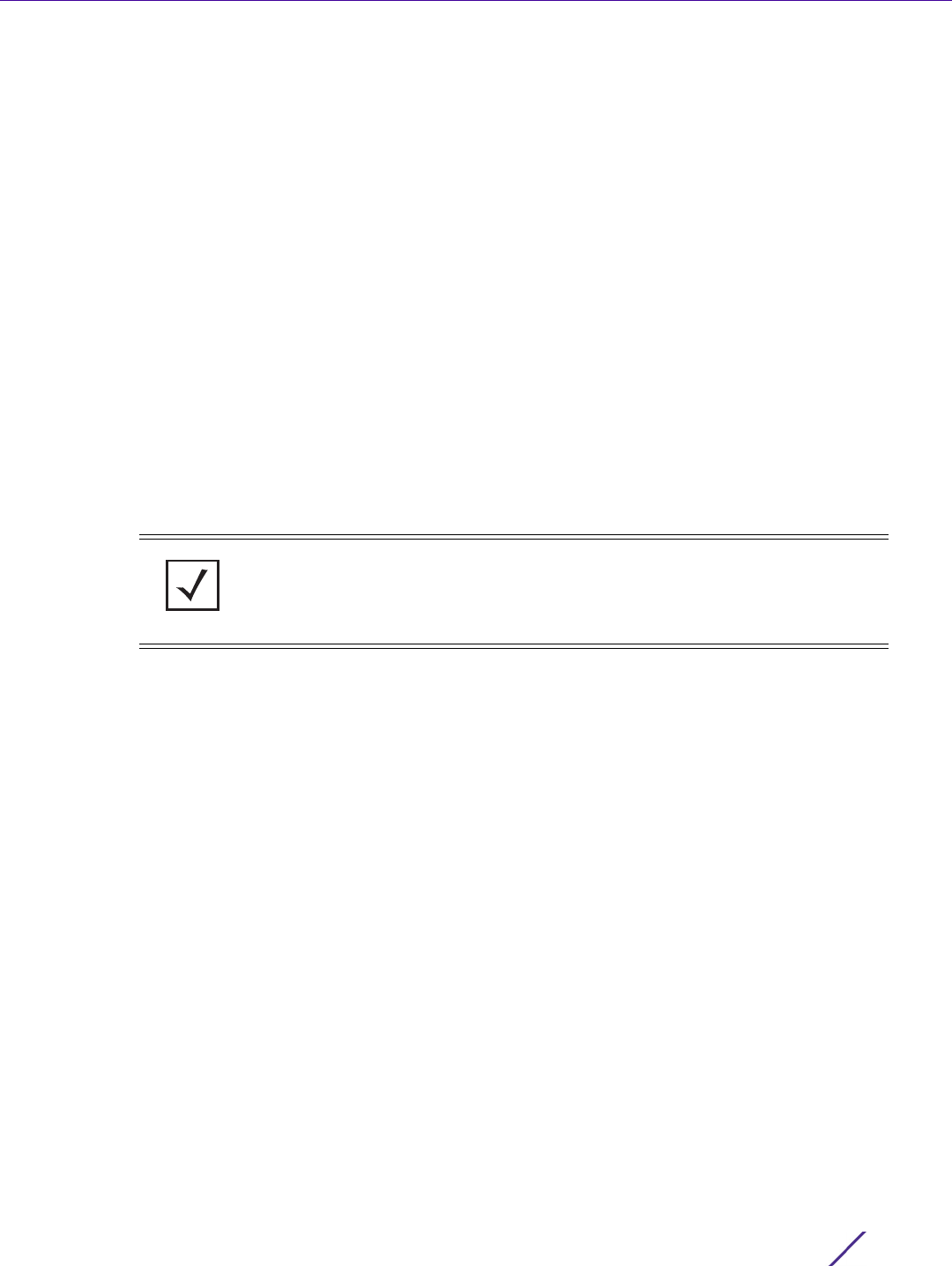
PRIVILEGED EXEC MODE COMMANDS
Access Point, Wireless Controller and Service Platform CLI Reference Guide 3 - 93
3.1.37 no
Privileged Exec Mode Commands
Use the no command to revert a command or a set of parameters to their default. This command is useful
to turn off an enabled feature or to revert to default settings.
The no commands have their own set of parameters that can be reset. These parameters depend on the
context in which the command is being used.
Supported in the following platforms:
• Access Points — AP6521, AP6522, AP6532, AP6562, AP7161, AP7502, AP7522, AP7532, AP7562,
AP7602, AP7612, AP7622, AP7632, AP7662, AP81XX, AP8232, AP8432, AP8533
• Wireless Controllers — RFS4000, RFS6000
• Service Platforms — NX5500, NX7500, NX7510, NX7520, NX7530, NX9500, NX9510, NX9600,
VX9000
Syntax
no [adoption|captive-portal|cpe|crypto|debug|logging|page|raid|service|
terminal|upgrade|virtual-machine|wireless]
no adoption {on <DEVICE-OR-DOMAIN-NAME>}
no captive-portal client [captive-portal <CAPTIVE-PORTAL-NAME>|mac <MAC>]
{on <DEVICE-OR-DOMAIN-NAME>}
no crypto pki [server|trustpoint]
no crypto pki [server|trustpoint] <TRUSTPOINT-NAME> {del-key {on <DEVICE-NAME>}|
on <DEVICE-NAME>}
no logging monitor
no page
no service [block-adopter-config-update|locator|snmp|ssm|wireless]
no service block-adopter-config-update
no service locator {on <DEVICE-NAME>}
no service snmp sysoid wing5
no service ssm trace pattern {<WORD>} {(on <DEVICE-NAME>)}
no service wireless [trace pattern {<WORD>} {(on <DEVICE-NAME>)}|unsanctioned ap
air-terminate <BSSID> {on <DOMAIN-NAME>}]
no terminal [length|width]
no upgrade <PATCH-NAME> {on <DEVICE-NAME>}
no wireless client [all|<MAC>]
NOTE: The no > adoption command resets the adoption state of a specified
device (and all devices adopted to it) or devices within a specified RF
Domain. When executed without specifying the device or RF Domain, the
command resets the adoption state of the logged device and all devices, if
any, adopted to it.

PRIVILEGED EXEC MODE COMMANDS
Access Point, Wireless Controller and Service Platform CLI Reference Guide 3 - 94
no wireless client all {filter|on}
no wireless client all {filter [wlan <WLAN-NAME>]}
no wireless client all {on <DEVICE-OR-DOMAIN-NAME>} {filter [wlan <WLAN-NAME>]}
no wireless client mac <MAC> {on <DEVICE-OR-DOMAIN-NAME>}
The following command is available only on the NX95XX series service platforms:
no cpe led cpe [<1-24>|all] {on <T5-DEVICE-NAME>}
no virtual-machine assign-usb-ports {on <DEVICE-NAME>}
no raid locate
Parameters
• no <PARAMETERS>
Usage Guidelines
The no command negates any command associated with it. Wherever required, use the same parameters
associated with the command getting negated.
Example
rfs4000-229D58#no adoption
rfs4000-229D58#
rfs6000-81742D#no page
rfs6000-81742D#
no <PARAMETERS> Resets or reverts settings based on the parameters passed

PRIVILEGED EXEC MODE COMMANDS
Access Point, Wireless Controller and Service Platform CLI Reference Guide 3 - 95
3.1.38 on
Privileged Exec Mode Commands
Executes the following commands in the RF Domain context: clrscr, do, end, exit, help, service, and show
Supported in the following platforms:
• Access Points — AP6521, AP6522, AP6532, AP6562, AP7161, AP7502, AP7522, AP7532, AP7562,
AP7602, AP7612, AP7622, AP7632, AP7662, AP81XX, AP8232, AP8432, AP8533
• Wireless Controllers — RFS4000, RFS6000
• Service Platforms — NX5500, NX7500, NX7510, NX7520, NX7530, NX9500, NX9510, NX9600,
VX9000
Syntax
on rf-domain [<RF-DOMAIN-NAME>|all]
Parameters
• on rf-domain [<RF-DOMAIN-NAME>|all]
Example
nx9500-6C8809#on rf-domain TechPubs
nx9500-6C8809(TechPubs)#
nx9500-6C8809(TechPubs)#?
on RF-Domain Mode commands:
clrscr Clears the display screen
do Run commands from Exec mode
end End current mode and change to EXEC mode
exit End current mode and down to previous mode
help Description of the interactive help system
service Service Commands
show Show running system information
nx9500-6C8809(TechPubs)#?
nx9500-6C8809(TechPubs)#show adoption timeline on TechPubs/ap7562-84A224
--------------------------------------------------------------------------------
-----
AP-NAME RF-DOMAIN LAST-ADOPTION-TIMESTAMP ADOPTED-SINCE
--------------------------------------------------------------------------------
-----
nx9500-6C8809 TechPubs 2016-09-09 00:00:14 7 days 05:19:49
rfs4000-880DA7 TechPubs 2016-09-08 23:59:57 7 days 05:20:06
rfs6000-81742D TechPubs 2016-09-08 05:52:04 7 days 23:27:58
--------------------------------------------------------------------------------
-----
Total number of devices displayed: 3
nx9500-6C8809(TechPubs)#
on rf-domain
[<RF-DOMAIN-
NAME>|all]
Enters the RF Domain context based on the parameter specified
• <RF-DOMAIN-NAME> – Specify the RF Domain name. Enters the specified RF Domain
context.
• all – Specifies all RF Domains.

PRIVILEGED EXEC MODE COMMANDS
Access Point, Wireless Controller and Service Platform CLI Reference Guide 3 - 96
3.1.39 opendns
Privileged Exec Mode Commands
Fetches the OpenDNS device_id from the OpenDNS site. Use this command to fetch the OpenDNS
device_id. Once fetched, apply the device_id to WLANs that are to be OpenDNS enabled.
OpenDNS is a free DNS service that enables swift Web navigation without frequent outages. It is more
reliable than other available DNS services, and provides the following services: DNS query resolution, Web-
filtering, protection against virus and malware attacks, performance enhancement, etc.
This command is part of a set of configurations that are required to integrate WiNG devices with
OpenDNS. When integrated, DNS queries going out of the WiNG device (access point, controller, or service
platform) are re-directed to OpenDNS (208.67.220.220 or 208.67.222.222) resolvers that act as proxy DNS
servers. For more information on enabling OpenDNS support, see Enabling OpenDNS Support.
Supported in the following platforms:
• Access Points — AP6521, AP6522, AP6532, AP6562, AP7161, AP7502, AP7522, AP7532, AP7562,
AP7602, AP7612, AP7622, AP7632, AP7662, AP81XX, AP8232, AP8432, AP8533
• Wireless Controllers — RFS4000, RFS6000
• Service Platforms — NX5500, NX7500, NX7510, NX7520, NX7530, NX9500, NX9510, NX9600,
VX9000
Syntax
opendns [APIToken|username]
opendns APIToken <OPENDNS-APITOKEN>
opendns username <USERNAME> password <OPENDNS-PSWD> label <LABEL>
Note, you can use either of the above commands to fetch the device_id from the
OpenDNS site.
Parameters
• opendns APIToken <OPENDNS-APITOKEN>
• opendns username <USERNAME> password <OPENDNS-PSWD> label <LABEL>
opendns Fetches the device_id from the OpenDNS site using the OpenDNS API token
APIToken
<OPENDNS-
APITOKEN>
Configures the OpenDNS APIToken. This is the token provided you by CISCO at the
time of subscribing for their OpenDNS service.
• <OPENDNS-APITOKEN> – Provide the OpenDNS API token (should be a valid token).
For every valid OpenDNS API token provided a device_id is returned. Apply this
device_id to WLANs that are to be OpenDNS enabled. Once applied, DNS queries
originating from associating clients are appended with an additional 31 bytes of data
(representing the device ID) at the end of the DNS packet. For information on
configuring the device_id in the WLAN context, see opendns.
opendns Fetches the device_id from the OpenDNS site using the OpenDNS credentials
username
<USERNAME>
Configures the OpenDNS user name. This is your OpenDNS email ID provided by
CISCO at the time of subscribing for their OpenDNS service.
• <USERNAME> – Provide the OpenDNS user name (should be a valid OpenDNS
username).

PRIVILEGED EXEC MODE COMMANDS
Access Point, Wireless Controller and Service Platform CLI Reference Guide 3 - 97
Example
ap7131-E6D512#opendns username bob@examplecompany.com password opendns label
company_name
Connecting to OpenDNS server...
device_id = 0014AADF8EDC6C59
ap7131-E6D512#
nx9600-7F3C7F#opendns ApiToken 9110B39543DEB2ECA1F473AE03E8899C00019073
device_id = 001480fe36dcb245
nx9600-7F3C7F#
Example Enabling OpenDNS Support
The following example shows how to enable OpenDNS support’
1 Fetch the OpenDNS device_id from the OpenDNS site.
a In the User/Privilege executable mode execute one of the following commands:
nx9500-6C874D#opendns APIToken <OPENDNS-APITOKEN>
nx9500-6C8809#opendns ApiToken 9110B39543DEB2ECA1F473AE03E8899C00019073
device_id = 001480fe36dcb245
nx9500-6C8809#
OR
nx9500-6C8809#opendns username <USERNAME> password <OPENDNS-PSWD> label
<LABEL>
Note, the OpenDNS API token and/or user account credentials are provided the
OpenDNS service provider when subscribing for the OpenDNS service.
b Apply the device_id fetched in the step 1 to the WLAN.
nx9500-6C8809(config-wlan-opendns)#opendns device-id <OPENDNS-DEVICE-ID>
nx9500-6C8809(config-wlan-opendns)#opendns device-id 001480fe36dcb245
nx9500-6C8809(config-wlan-opendns)#show context
wlan opendns
ssid opendns
bridging-mode local
encryption-type none
authentication-type none
opendns device-id 001480fe36dcb245
nx9500-6C8809(config-wlan-opendns)#
Once applied, DNS queries originating from wireless clients associating with
the WLAN are appended with an additional 31 bytes of data (representing the
device ID) at the end of the DNS packet.
2 Configure a DHCP server policy, and set the DHCP pool’s DNS server configuration to point to the
OpenDNS servers.
password
<OPENDNS-PSWD>
Configures the password associated with the user name specified in the previous step
• <OPENDNS-PSWD> – Provide the OpenDNS password (should be a valid OpenDNS
password).
label <LABEL> Configures the network label. This the label (the user friendly name) of your network,
and should be the same as the label (name) configured on the OpenDNS portal.
• <LABEL> – Specify your network label.
For every set of username, password, and label passed only one unique device_id is
returned. Apply this device_id to WLANs that are to be OpenDNS enabled. Once
applied, DNS queries originating from associating clients are appended with an
additional 31 bytes of data (representing the device ID) at the end of the DNS packet.
For information on configuring the device_id in the WLAN context, see opendns.

PRIVILEGED EXEC MODE COMMANDS
Access Point, Wireless Controller and Service Platform CLI Reference Guide 3 - 98
nx9500-6C8809(config-dhcp-policy-opendns-pool-opendnsPool)#dns-server
208.67.222.222
Note, you can configure any one of the following OpenDNS servers:
208.67.222.222 OR 208.67.222.220
nx9500-6C8809(config-dhcp-policy-opendns-pool-opendnsPool)#show context
dhcp-pool opendnsPool
dns-server 208.67.222.222
nx9500-6C8809(config-dhcp-policy-opendns-pool-opendnsPool)#
3 Apply the DHCP server policy configured in step 2 on the access point, controller, or service platform.
nx9500-6C8809(config-device-B4-C7-99-6C-88-09)#use dhcp-server-policy
opendns
nx9500-6C8809(config-device-B4-C7-99-6C-88-09)#show context include-factory
| include use
use profile default-nx9000
use rf-domain TechPubs
use database-policy default
use nsight-policy noc
use dhcp-server-policy opendns
use auto-provisioning-policy TechPubs
nx9500-6C8809(config-device-B4-C7-99-6C-88-09)#
When configured, DNS queries are forwarded by the access point, controller, or
service platform to the specified OpenDNS resolver.
4 Configure an IP Access Control List with the following permit and deny rules:
nx9500-6C8809(config-ip-acl-OpenDNS)#permit udp any host 208.67.222.222 eq
dns rule-precedence 1 rule-description "allow dns queries only to OpenDNS"
nx9500-6C8809(config-ip-acl-OpenDNS)#deny udp any any eq dns rule-precedence
10 rule-description "block all DNS queries"
nx9500-6C8809(config-ip-acl-OpenDNS)#permit ip any any rule-precedence 100
rule-description "allow all other ip packets"
nx9500-6C8809(config-ip-acl-OpenDNS)#show context
ip access-list OpenDNS
permit udp any host 208.67.222.222 eq dns rule-precedence 1 rule-description
"allow dns queries only to OpenDNS"
deny udp any any eq dns rule-precedence 10 rule-description "block all dns
queries"
permit ip any any rule-precedence 100 rule-description "allow all other ip
packets"
nx9500-6C8809config-ip-acl-OpenDNS)#
When configured and applied in the WLAN context, the IP ACL prevents wireless
clients from adding their own DNS servers to bypass the Web filtering and
network policies enforced by OpenDNS.
5 Apply the IP ACL configured in step 4 in the WLAN context.

PRIVILEGED EXEC MODE COMMANDS
Access Point, Wireless Controller and Service Platform CLI Reference Guide 3 - 99
nx9500-6C8809(config-wlan-opendns)#use ip-access-list out OpenDNS
nx9500-6C8809(config-wlan-opendns)#show context
wlan opendns
ssid opendns
vlan 1
bridging-mode local
encryption-type none
authentication-type none
use ip-access-list in OpenDNS
use ip-access-list out OpenDNS
opendns device-id 0014AADF8EDC6C59
nx9500-6C8809(config-wlan-opendns)#
When applied to the WLAN, only the DNS queries directed to the OpenDNS server
are forwarded. All other DNS queries are dropped.

PRIVILEGED EXEC MODE COMMANDS
Access Point, Wireless Controller and Service Platform CLI Reference Guide 3 - 100
3.1.40 page
Privileged Exec Mode Commands
Toggles controller paging. Enabling this command displays the CLI command output page by page, instead
of running the entire output at once.
Supported in the following platforms:
• Access Points — AP6521, AP6522, AP6532, AP6562, AP7161, AP7502, AP7522, AP7532, AP7562,
AP7602, AP7612, AP7622, AP7632, AP7662, AP81XX, AP8232, AP8432, AP8533
• Wireless Controllers — RFS4000, RFS6000
• Service Platforms — NX5500, NX7500, NX7510, NX7520, NX7530, NX9500, NX9510, NX9600,
VX9000
Syntax
page
Parameters
None
Example
rfs6000-81742D#page
rfs6000-81742D#
Related Commands
no Disables controller paging

PRIVILEGED EXEC MODE COMMANDS
Access Point, Wireless Controller and Service Platform CLI Reference Guide 3 - 101
3.1.41 ping
Privileged Exec Mode Commands
Sends Internet Controller Message Protocol (ICMP) echo messages to a user-specified location
Supported in the following platforms:
• Access Points — AP6521, AP6522, AP6532, AP6562, AP7161, AP7502, AP7522, AP7532, AP7562,
AP7602, AP7612, AP7622, AP7632, AP7662, AP81XX, AP8232, AP8432, AP8533
• Wireless Controllers — RFS4000, RFS6000
• Service Platforms — NX5500, NX7500, NX7510, NX7520, NX7530, NX9500, NX9510, NX9600,
VX9000
Syntax
ping <IP/HOSTNAME> {count <1-10000>|dont-fragment {count|size}|size <1-64000>|
source [<IP>|pppoe|vlan <1-4094>|wwan]}
Parameters
• ping <IP/HOSTNAME> {count <1-10000>|dont-fragment {count|size}|size <1-64000>|
source [<IP>|pppoe|vlan <1-4094>|wwan]}
<IP/HOSTNAME> Specify the destination IP address or hostname to ping. When entered without any
parameters, this command prompts for an IP address or a hostname.
count <1-10000> Optional. Sets the pings to the specified destination
• <1-10000> – Specify a value from 1 - 10000. The default is 5.
dont-fragment
{count|size}
Optional. Sets the dont-fragment bit in the ping packet. Packets with the dont-
fragment bit specified, are not fragmented. When a packet, with the dont-fragment
bit specified, exceeds the specified Maximum Transmission Unit (MTU) value, an error
message is sent from the device trying to fragment it.
• count <1-10000> – Sets the pings to the specified destination from 1 - 10000. The
default is 5.
• size – <1-64000> – Sets the size of ping payload size from 1 - 64000 bytes. The default
is 100 bytes.
size <1-64000> Optional. Sets the ping packet’s size in bytes
• <1-64000> – Specify the ping payload size from 1 - 64000 bytes. The default is 100
bytes.
source [<IP>|pppoe|
vlan <1-4094>|wwan]
Optional. Sets the source address or interface name. This is the source of the ICMP
packet to the specified destination.
• <IP> – Specifies the source IP address
• pppoe – Selects the PPP over Ethernet interface
• vlan <1-4094> – Selects the VLAN interface from 1 - 4094
• wwan – Selects the wireless WAN interface

PRIVILEGED EXEC MODE COMMANDS
Access Point, Wireless Controller and Service Platform CLI Reference Guide 3 - 102
Example
rfs6000-81742D#ping 192.168.13.13 count 4
PING 192.168.13.13 (192.168.13.13) 100(128) bytes of data.
108 bytes from 192.168.13.13: icmp_seq=1 ttl=64 time=0.356 ms
108 bytes from 192.168.13.13: icmp_seq=2 ttl=64 time=0.211 ms
108 bytes from 192.168.13.13: icmp_seq=3 ttl=64 time=0.199 ms
108 bytes from 192.168.13.13: icmp_seq=4 ttl=64 time=0.215 ms
--- 192.168.13.13 ping statistics ---
4 packets transmitted, 4 received, 0% packet loss, time 2999ms
rtt min/avg/max/mdev = 0.199/0.245/0.356/0.065 ms
rfs6000-81742D#
rfs6000-81742D#ping 10.233.89.182 source vlan 1
PING 10.233.89.182 (10.233.89.182) from 192.168.13.24 vlan1: 100(128) bytes of
data.
From 192.168.13.2 icmp_seq=1 Packet filtered
From 192.168.13.2 icmp_seq=2 Packet filtered
From 192.168.13.2 icmp_seq=3 Packet filtered
From 192.168.13.2 icmp_seq=4 Packet filtered
From 192.168.13.2 icmp_seq=5 Packet filtered
--- 10.233.89.182 ping statistics ---
5 packets transmitted, 0 received, +5 errors, 100% packet loss, time 3997ms
rfs6000-81742D#

PRIVILEGED EXEC MODE COMMANDS
Access Point, Wireless Controller and Service Platform CLI Reference Guide 3 - 103
3.1.42 ping6
Privileged Exec Mode Commands
Sends ICMPv6 echo messages to a user-specified IPv6 address
Supported in the following platforms:
• Access Points — AP6521, AP6522, AP6532, AP6562, AP7161, AP7502, AP7522, AP7532, AP7562,
AP7602, AP7612, AP7622, AP7632, AP7662, AP81XX, AP8232, AP8432, AP8533
• Wireless Controllers — RFS4000, RFS6000
• Service Platforms — NX5500, NX7500, NX7510, NX7520, NX7530, NX9500, NX9510, NX9600,
VX9000
Syntax
ping6 <IPv6/HOSTNAME> {<INTF-NAME>|count <1-10000>|size <1-64000>}
Parameters
• ping <IPv6/HOSTNAME> {<INTF-NAME>|count <1-10000>|size <1-64000>}
Usage Guidelines
To configure a device’s IPv6 address, in the VLAN interface configuration mode, use the
ipv6 > address <IPv6-ADDRESS> command. After configuring the IPv6 address, use the ipv6 > enable
command to enable IPv6. For more information, see ipv6.
Example
rfs4000-880DA7#ping6 2001:10:10:10:10:10:10:2 count 6 size 200
PING 2001:10:10:10:10:10:10:2(2001:10:10:10:10:10:10:2) 200 data bytes
208 bytes from 2001:10:10:10:10:10:10:2: icmp_seq=1 ttl=64 time=0.509 ms
208 bytes from 2001:10:10:10:10:10:10:2: icmp_seq=2 ttl=64 time=0.323 ms
208 bytes from 2001:10:10:10:10:10:10:2: icmp_seq=3 ttl=64 time=0.318 ms
208 bytes from 2001:10:10:10:10:10:10:2: icmp_seq=4 ttl=64 time=0.317 ms
208 bytes from 2001:10:10:10:10:10:10:2: icmp_seq=5 ttl=64 time=0.314 ms
208 bytes from 2001:10:10:10:10:10:10:2: icmp_seq=6 ttl=64 time=0.318 ms
--- 2001:10:10:10:10:10:10:2 ping statistics ---
6 packets transmitted, 6 received, 0% packet loss, time 4999ms
rtt min/avg/max/mdev = 0.314/0.349/0.509/0.075 ms
rfs4000-880DA7#
<IPv6/HOSTNAME> Specify the destination IPv6 address or hostname.
<INTF-NAME> Optional. Specify the interface name for link local/broadcast address
count <1-10000> Optional. Sets the pings to the specified IPv6 destination
• <1-10000> – Specify a value from 1 - 10000. The default is 5.
size <1-64000> Optional. Sets the IPv6 ping payload size in bytes
• <1-64000> – Specify the ping payload size from 1 - 64000. The default is 100 bytes.

PRIVILEGED EXEC MODE COMMANDS
Access Point, Wireless Controller and Service Platform CLI Reference Guide 3 - 104
3.1.43 pwd
Privileged Exec Mode Commands
Displays the full path of the present working directory, similar to the UNIX pwd command
Supported in the following platforms:
• Access Points — AP6521, AP6522, AP6532, AP6562, AP7161, AP7502, AP7522, AP7532, AP7562,
AP7602, AP7612, AP7622, AP7632, AP7662, AP81XX, AP8232, AP8432, AP8533
• Wireless Controllers — RFS4000, RFS6000
• Service Platforms — NX5500, NX7500, NX7510, NX7520, NX7530, NX9500, NX9510, NX9600,
VX9000
Syntax
pwd
Parameters
None
Example
rfs4000-229D58#pwd
flash:/
rfs4000-229D58#
rfs4000-229D58#dir
Directory of flash:/.
drwx Mon Feb 8 17:37:21 2016 log
drwx Sat Jan 1 05:30:08 2000 configs
drwx Sat Jan 1 05:30:08 2000 cache
drwx Thu Nov 12 17:55:02 2015 crashinfo
drwx Mon Feb 8 17:34:21 2016 archived_logs
drwx Sat Jan 1 05:30:08 2000 upgrade
drwx Sat Jan 1 05:30:23 2000 hotspot
drwx Sat Jan 1 05:30:08 2000 floorplans
drwx Sat Jan 1 05:30:08 2000 tmptpd
rfs4000-229D58#

PRIVILEGED EXEC MODE COMMANDS
Access Point, Wireless Controller and Service Platform CLI Reference Guide 3 - 105
3.1.44 re-elect
Privileged Exec Mode Commands
Re-elects the tunnel controller (wireless controller or service platform)
Supported in the following platforms:
• Access Points — AP6521, AP6522, AP6532, AP6562, AP7161, AP7502, AP7522, AP7532, AP7562,
AP7602, AP7612, AP7622, AP7632, AP7662, AP81XX, AP8232, AP8432, AP8533
• Wireless Controllers — RFS4000, RFS6000
• Service Platforms — NX5500, NX7500, NX7510, NX7520, NX7530, NX9500, NX9510, NX9600,
VX9000
Syntax
re-elect tunnel-controller {<WORD> {on <DEVICE-NAME>}|on <DEVICE-NAME>}
Parameters
• re-elect tunnel-controller {<WORD> {on <DEVICE-NAME>}|on <DEVICE-NAME>}
Example
rfs4000-880DA7#re-elect tunnel-controller
OK
rfs4000-880DA7#
re-elect
tunnel-controller
Re-elects the tunnel controller
<WORD>
{on <DEVICE-
NAME>}
Optional. Re-elects the tunnel controller on all devices whose preferred tunnel
controller name matches <WORD>
• on <DEVICE-NAME> – Optional. Re-elects the tunnel controller on a specified device
• <DEVICE-NAME> – Specify the name of the AP, wireless controller, or service plat-
form.

PRIVILEGED EXEC MODE COMMANDS
Access Point, Wireless Controller and Service Platform CLI Reference Guide 3 - 106
3.1.45 reload
Privileged Exec Mode Commands
Halts a device or devices and performs a warm reboot
Supported in the following platforms:
• Access Points — AP6521, AP6522, AP6532, AP6562, AP7161, AP7502, AP7522, AP7532, AP7562,
AP7602, AP7612, AP7622, AP7632, AP7662, AP81XX, AP8232, AP8432, AP8533
• Wireless Controllers — RFS4000, RFS6000
• Service Platforms — NX5500, NX7500, NX7510, NX7520, NX7530, NX9500, NX9510, NX9600,
VX9000
Syntax
reload {<DEVICE-MAC-OR-HOSTNAME>|at|cancel|force|in|on|staggered}
reload {(<DEVICE-MAC-OR-HOSTNAME>)}
reload {at <TIME> <1-31> <MONTH> <1993-2035> {on <DEVICE-OR-DOMAIN-NAME>}}
reload {cancel} {on <DEVICE-OR-DOMAIN-NAME>}
reload {force} {(<DEVICE-MAC-OR-HOSTNAME>|on <DOMAIN-NAME>|staggered)}
reload {force} {(<DEVICE-MAC-OR-HOSTNAME>)}
reload {force} {on <DOMAIN-NAME> {staggered}|staggered {<DEVICE-MAC-OR-HOSTNAME>|
on <DOMAIN-NAME>}} {containing <WORD>|exclude-controllers|exclude-rf-domain-
manager|filter <DEVICE-TYPE>}
reload {in <1-999>} {list|on}
reload {in <1-999>} {list {<LINE>|all}|on <DEVICE-OR-DOMAIN-NAME>}
reload {in <1-999>} {on <DEVICE-OR-DOMAIN-NAME>}
reload {on <DOMAIN-NAME>} {containing <WORD>|exclude-controllers|exclude-rf-
domain-manager|filter <DEVICE-TYPE>}
reload {staggered} {(<DEVICE-MAC-OR-HOSTNAME>)|on <DOMAIN-NAME>} {containing
<WORD>|exclude-controllers|exclude-rf-domain-manager|filter <DEVICE-TYPE>}
Parameters
• reload {(<DEVICE-MAC-OR-HOSTNAME>)}
• reload {at <TIME> <1-31> <MONTH> <1993-2035> {on <DEVICE-OR-DOMAIN-NAME>}}
reload
<DEVICE-MAC-OR-
HOSTNAME>
Initiates device(s) reload and configures associated parameters
The following keyword is recursive and allows you to specify multiple devices:
• <DEVICE-MAC-OR-HOSTNAME> – Optional. Reloads a specified device(s),
identified by the <DEVICE-MAC-OR-HOSTNAME> keyword. Specify the device’s
hostname or MAC address.
If no device is specified, the system reloads the logged device.
reload at Initiates device(s) reload and configures associated parameters
• at – Optional. Schedules a reload at a specified time and day. Use the following
keywords to specify the time and day: <TIME>, <1-31>, <MONTH>, and <1993-2035>.
<TIME> Specifies the time in the HH:MM:SS format

PRIVILEGED EXEC MODE COMMANDS
Access Point, Wireless Controller and Service Platform CLI Reference Guide 3 - 107
• reload {cancel} {on <DEVICE-OR-DOMAIN-NAME>}
• reload {force} {(<DEVICE-MAC-OR-HOSTNAME>)}
• reload {force} {on <DOMAIN-NAME> {staggered}|staggered {<DEVICE-MAC-OR-
HOSTNAME>|on <DOMAIN-NAME>}} {containing <WORD>|exclude-controllers|exclude-rf-
domain-manager|filter <DEVICE-TYPE>}
<1-31> Specifies the day of the month from 1 - 31
<MONTH> Specifies the month from Jan - Dec
<1993-2035> Specifies the year from 1993 - 2035. It should be a valid 4 digit year.
on <DEVICE-OR-
DOMAIN-NAME>
Optional. Performs reload at the scheduled time, on a specified device or all devices
within a specified RF Domain
• <DEVICE-OR-DOMAIN-NAME> – Specify the name of the AP, wireless controller,
service platform, or RF Domain. When a RF Domain name is provided, all devices
within the specified RF Domain are reloaded at the scheduled time.
If no device is specified, the reload is scheduled on the logged device.
reload cancel
on <DEVICE-OR-
DOMAIN-NAME>
Cancels pending/scheduled reloads of device(s)
• cancel – Optional. Cancels all pending reloads
• on <DEVICE-OR-DOMAIN-NAME> – Optional. Cancels reloads pending on a
specified device or all devices within a specified RF Domain
• <DEVICE-OR-DOMAIN-NAME> – Specify the name of the AP, wireless control-
ler, service platform, or RF Domain.
If no device is specified, the system cancels reloads pending on the logged device.
reload force Initiates device(s) reload and configures associated parameters
• force – Optional. Forces device(s) to reload, while ignoring conditions like upgrade
in progress, unsaved changes, etc. Use the options provided to force a reload on a
specified device or all devices in a RF Domain.
<DEVICE-MAC-OR-
HOSTNAME>
This keyword is recursive and allows you to specify multiple devices.
• <DEVICE-MAC-OR-HOSTNAME> – Optional. Forces a reload on a specified device
identified by the <DEVICE-MAC-OR-HOSTNAME> keyword. Specify the device’s
hostname or MAC address. When executed, the specified device(s) are forced to
halt and a warm reboot is performed.
If no device is specified, the system forcefully reloads the logged device.
reload force Initiates device(s) reload and configures associated parameters
• force – Optional. Forces device(s) to reload, while ignoring conditions like upgrade
in progress, unsaved changes, etc. Use the options provided to force a reload on a
specified device or all devices in a RF Domain.
on <DOMAIN-NAME>
staggered
Optional. Forces a reload on all devices in a RF Domain
• <DOMAIN-NAME> – Optional. Specify the name of the RF Domain. When executed,
all devices within the specified RF Domain are forced to halt and a warm reboot is
performed.
• staggered – Optional. Enables staggered reload of devices (one at a time) with-
out network impact. Use this option when rebooting multiple devices within an RF
Domain. When executed, all devices within the specified RF Domain are forced to
halt and reboot in a staggered manner.

PRIVILEGED EXEC MODE COMMANDS
Access Point, Wireless Controller and Service Platform CLI Reference Guide 3 - 108
• reload {in <1-999>} {list {<LINE>|all}|on <DEVICE-OR-DOMAIN-NAME>}
staggered
{<DEVICE-MAC-OR-
HOSTNAME>|
on <DOMAIN-NAME>}
Optional. Enables staggered reload of devices (one at a time) without network
impact
• <DEVICE-MAC-OR-HOSTNAME> – Optional. Forces a reload on specified device(s)
identified by the <DEVICE-MAC-OR-HOSTNAME> keyword. Specify the device’s
hostname or MAC address. This is a recursive keyword that allows you to specify
multiple devices. When executed, the specified device(s) are forced to halt and a
warm reboot is performed.
• on <DOMAIN-NAME> – Optional. Forces a reload on all devices in a RF Domain.
Specify the name of the RF Domain. When executed, all devices within the specified
RF Domain are forced to halt and a warm reboot is performed.
If no device or RF Domain is specified, the system forcefully reloads the logged
device.
{containing <WORD>|
exclude-controllers|
exclude-rf-domain-
manager|
filter <DEVICE-TYPE>}
When forcefully reloading devices in a RF Domain, you can use following options to
filter specific devices or device types:
• containing <WORD> – Optional. Filters out devices containing a specified sub-string
in their hostnames
• <WORD> – Optional. Provide the sub-string to match. All devices having host-
names containing the provided sub-string are filtered and forcefully reloaded.
• exclude-controllers – Optional. Excludes all controllers in the specified RF Domain
from the reload process
• exclude-rf-domain-manager – Optional. Excludes the RF Domain manager from the
reload process
• filter <DEVICE-TYPE> – Optional. Filters devices by the device type specified. Select
the type of device. All devices, of the specified type, within the specified RF Domain,
are forcefully reloaded.
• <DEVICE-TYPE> – Select the type of device to reload. The options are: AP6521,
AP6522, AP6532, AP6562, AP7161, AP7502, AP7522, AP7532, AP7562, AP7602,
AP7612, AP7622, AP7632, AP7662, AP81XX, AP8232, AP8432, AP8533, RFS4000,
RFS6000, NX5500, NX75XX, NX95XX, NX9600, VX9000, t5.
reload in <1-999> Initiates device(s) reload and configures associated parameters
• in – Optional. Performs a reload after a specified time period
• <1-999> – Specify the time from 1 - 999 minutes
list {<LINE>|all} Optional. Reloads all adopted devices or specified devices
• <LINE> – Optional. Reloads listed devices. List all devices (to be reloaded) separated
by a space.
• all – Optional. Reloads all devices adopted by this controller
on <DEVICE-OR-
DOMAIN-NAME>
Optional. Reloads a specified device or all devices within a specified RF Domain
• <DEVICE-OR-DOMAIN-NAME> – Specify the name of the AP, wireless controller,
service platform, or RF Domain.

PRIVILEGED EXEC MODE COMMANDS
Access Point, Wireless Controller and Service Platform CLI Reference Guide 3 - 109
• reload {on <DOMAIN-NAME>} {containing <WORD>|exclude-controllers|exclude-rf-
domain-manager|filter <DEVICE-TYPE>}
• reload {staggered} {(<DEVICE-MAC-OR-HOSTNAME>)|on <DOMAIN-NAME>} {containing
<WORD>|exclude-controllers|exclude-rf-domain-manager|filter <DEVICE-TYPE>}
reload
on <DOMAIN-NAME>
Initiates device(s) reload and configures associated parameters
• on <DOMAIN-NAME> – Optional. Enables reload of all devices in a RF Domain
• <DOMAIN-NAME> – Specify the name of the RF Domain. When executed, all de-
vices within the specified RF Domain are immediately halted and a warm reboot is
performed.
If no RF Domain is specified, the system reloads the logged device.
{containing <WORD>|
exclude-controllers|
exclude-rf-domain-
manager|
filter <DEVICE-TYPE>}
When reloading devices in a RF Domain, you can use following options to filter
specific devices or device types:
• containing <WORD> – Optional. Filters out devices containing a specified sub-string
in their hostnames.
• <WORD> – Optional. Provide the sub-string to match. All devices having host-
names containing the provided sub-string are filtered and forcefully reloaded.
• exclude-controllers – Optional. Excludes all controllers in the specified RF Domain
from the reload process
• exclude-rf-domain-manager – Optional. Excludes the RF Domain manager from the
reload process
• filter <DEVICE-TYPE> – Optional. Filters devices by the device type specified. Select
the type of device to reload. All devices, of the specified type, within the specified
RF Domain, are forcefully reloaded.
• <DEVICE-TYPE> – Select the type of device to reload. The options are: AP6521,
AP6522, AP6532, AP6562, AP7161, AP7502, AP7522, AP7532, AP7562, AP81XX,
AP8232, AP8432, AP8533, RFS4000, RFS6000, NX5500, NX75XX, NX95XX,
NX9600, VX9000, t5. All devices of the type specified are reloaded.
reload staggered Initiates device(s) reload and configures associated parameters
• staggered – Optional. Enables staggered reload of devices (one at a time) without
network impact
{<DEVICE-MAC-OR-
HOSTNAME>|
on <DOMAIN-NAME>}
Use one of the following options to specify a single device, multiple devices, or a
RF Domain
• <DEVICE-MAC-OR-HOSTNAME> – Optional. Performs staggered reload on
specified device(s) identified by the <DEVICE-MAC-OR-HOSTNAME> keyword.
Specify the device’s hostname or MAC address. This is a recursive keyword that
allows you to specify multiple devices. When executed, the specified device(s) are
halted and a warm reboot is performed. Multiple devices are halted and rebooted
one at a time without impacting network functioning.
Contd..
• <DOMAIN-NAME> – Optional. Performs staggered reload of all devices in a RF
Domain. Specify the name of the RF Domain. When executed, devices in the
specified RF Domain are halted and rebooted one at a time without impacting
network functioning. Use additional filter options to filter devices in the specified RF
Domain.
If no device or RF Domain is specified, the system reloads the logged device.

PRIVILEGED EXEC MODE COMMANDS
Access Point, Wireless Controller and Service Platform CLI Reference Guide 3 - 110
Example
rfs7000-6DCD4B#reload at 12:30:00 31 Mar 2015 on rfs6000-81742D
Reload scheduled at 2015-03-31 12:30:00 UTC ...
rfs7000-6DCD4B#
rfs7000-6DCD4B#reload cancel on rfs6000-81742D
Scheduled reload cancelled.
rfs7000-6DCD4B#
The following example schedules a reload on all non-controller devices in the RF Domain ‘default’:
rfs7000-6DCD4B#reload on default exclude-controllers
ap8132-711728: OK
rfs7000-6DCD4B#
{containing <WORD>|
exclude-controllers|
exclude-rf-domain-
manager|
filter <DEVICE-TYPE>}
When reloading devices in a RF Domain, you can use following options to filter
specific devices or device types:
• containing <WORD> – Optional. Filters out devices containing a specified sub-string
in their hostnames.
• <WORD> – Optional. Provide the sub-string to match. All devices having host-
names containing the provided sub-string are filtered and reloaded.
• exclude-controllers – Optional. Excludes all controllers in the specified RF Domain
from the reload process
• exclude-rf-domain-manager – Optional. Excludes the RF Domain manager from the
reload process
• filter <DEVICE-TYPE> – Optional. Filters devices by the device type specified. Select
the type of device. All devices, of the specified type, within the specified RF Domain,
are reloaded.
• <DEVICE-TYPE> – Select the type of device to reload. The options are: AP6521,
AP6522, AP6532, AP6562, AP7161, AP7502, AP7522, AP7532, AP7562, AP7602,
AP7612, AP7622, AP7632, AP7662, AP81XX, AP8232, AP8432, AP8533, RFS4000,
RFS6000, NX5500, NX75XX, NX95XX, NX9600, VX9000, t5.

PRIVILEGED EXEC MODE COMMANDS
Access Point, Wireless Controller and Service Platform CLI Reference Guide 3 - 111
3.1.46 rename
Privileged Exec Mode Commands
Renames a file in the devices’ file system
Supported in the following platforms:
• Access Points — AP6521, AP6522, AP6532, AP6562, AP7161, AP7502, AP7522, AP7532, AP7562,
AP7602, AP7612, AP7622, AP7632, AP7662, AP81XX, AP8232, AP8432, AP8533
• Wireless Controllers — RFS4000, RFS6000
• Service Platforms — NX5500, NX7500, NX7510, NX7520, NX7530, NX9500, NX9510, NX9600,
VX9000
Syntax
rename <OLD-FILE-NAME> <NEW-FILE-NAME>
Parameters
• rename <OLD-FILE-NAME> <NEW-FILE-NAME>
Example
rfs4000-880DA7#dir
Directory of flash:/.
drwx Wed Sep 14 13:54:10 2016 log
drwx Sat Jan 1 05:30:08 2000 configs
drwx Sat Jan 1 05:30:08 2000 cache
drwx Wed Nov 4 16:12:15 2015 crashinfo
drwx Fri Sep 16 05:26:37 2016 testdir
drwx Thu Sep 8 04:09:30 2016 archived_logs
drwx Sat Jan 1 05:30:08 2000 upgrade
drwx Sat Jan 1 05:30:23 2000 hotspot
drwx Sat Jan 1 05:30:08 2000 floorplans
drwx Sat Jan 1 05:30:08 2000 tmptpd
rfs4000-880DA7#
rfs4000-880DA7#rename flash:/testdir/ Final
rfs4000-880DA7#
rfs4000-880DA7#dir
Directory of flash:/.
drwx Wed Sep 14 13:54:10 2016 log
drwx Sat Jan 1 05:30:08 2000 configs
drwx Fri Sep 16 05:26:37 2016 Final
drwx Sat Jan 1 05:30:08 2000 cache
drwx Wed Nov 4 16:12:15 2015 crashinfo
drwx Thu Sep 8 04:09:30 2016 archived_logs
drwx Sat Jan 1 05:30:08 2000 upgrade
drwx Sat Jan 1 05:30:23 2000 hotspot
drwx Sat Jan 1 05:30:08 2000 floorplans
drwx Sat Jan 1 05:30:08 2000 tmptpd
rfs4000-880DA7#
<OLD-FILE-NAME> Specify the file to rename.
<NEW-FILE-NAME> Specify the new file name.

PRIVILEGED EXEC MODE COMMANDS
Access Point, Wireless Controller and Service Platform CLI Reference Guide 3 - 112
3.1.47 rmdir
Privileged Exec Mode Commands
Deletes an existing directory from the file system (only empty directories can be removed)
Supported in the following platforms:
• Access Points — AP6521, AP6522, AP6532, AP6562, AP7161, AP7502, AP7522, AP7532, AP7562,
AP7602, AP7612, AP7622, AP7632, AP7662, AP81XX, AP8232, AP8432, AP8533
• Wireless Controllers — RFS4000, RFS6000
• Service Platforms — NX5500, NX7500, NX7510, NX7520, NX7530, NX9500, NX9510, NX9600,
VX9000
Syntax
rmdir <DIR>
Parameters
• rmdir <DIR>
Example
rfs4000-880DA7#dir
Directory of flash:/.
drwx Wed Sep 14 13:54:10 2016 log
drwx Sat Jan 1 05:30:08 2000 configs
drwx Fri Sep 16 05:26:37 2016 Final
drwx Sat Jan 1 05:30:08 2000 cache
drwx Wed Nov 4 16:12:15 2015 crashinfo
drwx Thu Sep 8 04:09:30 2016 archived_logs
drwx Sat Jan 1 05:30:08 2000 upgrade
drwx Sat Jan 1 05:30:23 2000 hotspot
drwx Sat Jan 1 05:30:08 2000 floorplans
drwx Sat Jan 1 05:30:08 2000 tmptpd
rfs4000-880DA7#
rfs4000-880DA7#rmdir Final
rfs4000-880DA7#
rfs4000-880DA7#dir
Directory of flash:/.
drwx Wed Sep 14 13:54:10 2016 log
drwx Sat Jan 1 05:30:08 2000 configs
drwx Sat Jan 1 05:30:08 2000 cache
drwx Wed Nov 4 16:12:15 2015 crashinfo
drwx Thu Sep 8 04:09:30 2016 archived_logs
drwx Sat Jan 1 05:30:08 2000 upgrade
drwx Sat Jan 1 05:30:23 2000 hotspot
drwx Sat Jan 1 05:30:08 2000 floorplans
drwx Sat Jan 1 05:30:08 2000 tmptpd
rfs4000-880DA7#
rmdir <DIR> Specifies the directory name
Note: The directory, specified by the <DIR> parameter, is removed from the file
system.

PRIVILEGED EXEC MODE COMMANDS
Access Point, Wireless Controller and Service Platform CLI Reference Guide 3 - 113
3.1.48 self
Privileged Exec Mode Commands
Enters the logged device’s configuration context
Supported in the following platforms:
• Access Points — AP6521, AP6522, AP6532, AP6562, AP7161, AP7502, AP7522, AP7532, AP7562,
AP7602, AP7612, AP7622, AP7632, AP7662, AP81XX, AP8232, AP8432, AP8533
• Wireless Controllers — RFS4000, RFS6000
• Service Platforms — NX5500, NX7500, NX7510, NX7520, NX7530, NX9500, NX9510, NX9600,
VX9000
Syntax
self
Parameters
None
Example
rfs6000-81742D#self
Enter configuration commands, one per line. End with CNTL/Z.
rfs6000-81742D(config-device-00-15-70-81-74-2D)#

PRIVILEGED EXEC MODE COMMANDS
Access Point, Wireless Controller and Service Platform CLI Reference Guide 3 - 114
3.1.49 ssh
Privileged Exec Mode Commands
Opens a Secure Shell (SSH) connection between two network devices
Supported in the following platforms:
• Access Points — AP6521, AP6522, AP6532, AP6562, AP7161, AP7502, AP7522, AP7532, AP7562,
AP7602, AP7612, AP7622, AP7632, AP7662, AP81XX, AP8232, AP8432, AP8533
• Wireless Controllers — RFS4000, RFS6000
• Service Platforms — NX5500, NX7500, NX7510, NX7520, NX7530, NX9500, NX9510, NX9600,
VX9000
Syntax
ssh <IP/HOSTNAME> <USERNAME> {<INF-NAME/LINK-LOCAL-ADD>}
Parameters
• ssh <IP/HOSTNAME> <USERNAME> {<INF-NAME/LINK-LOCAL-ADD>}
Usage Guidelines
To exit the other device’s context, use the command that is relevant to that device.
Example
nx9500-6C8809#ssh 192.168.13.16 admin
admin@192.168.13.16's password:
rfs6000-81742D>
<IP/HOSTNAME> Specify the remote system’s IP address or hostname.
<USERNAME> Specify the name of the user requesting the SSH connection.
<INF-NAME/
LINK-LOCAL-ADD>
Optional. Specify the interface’s name or link local address.
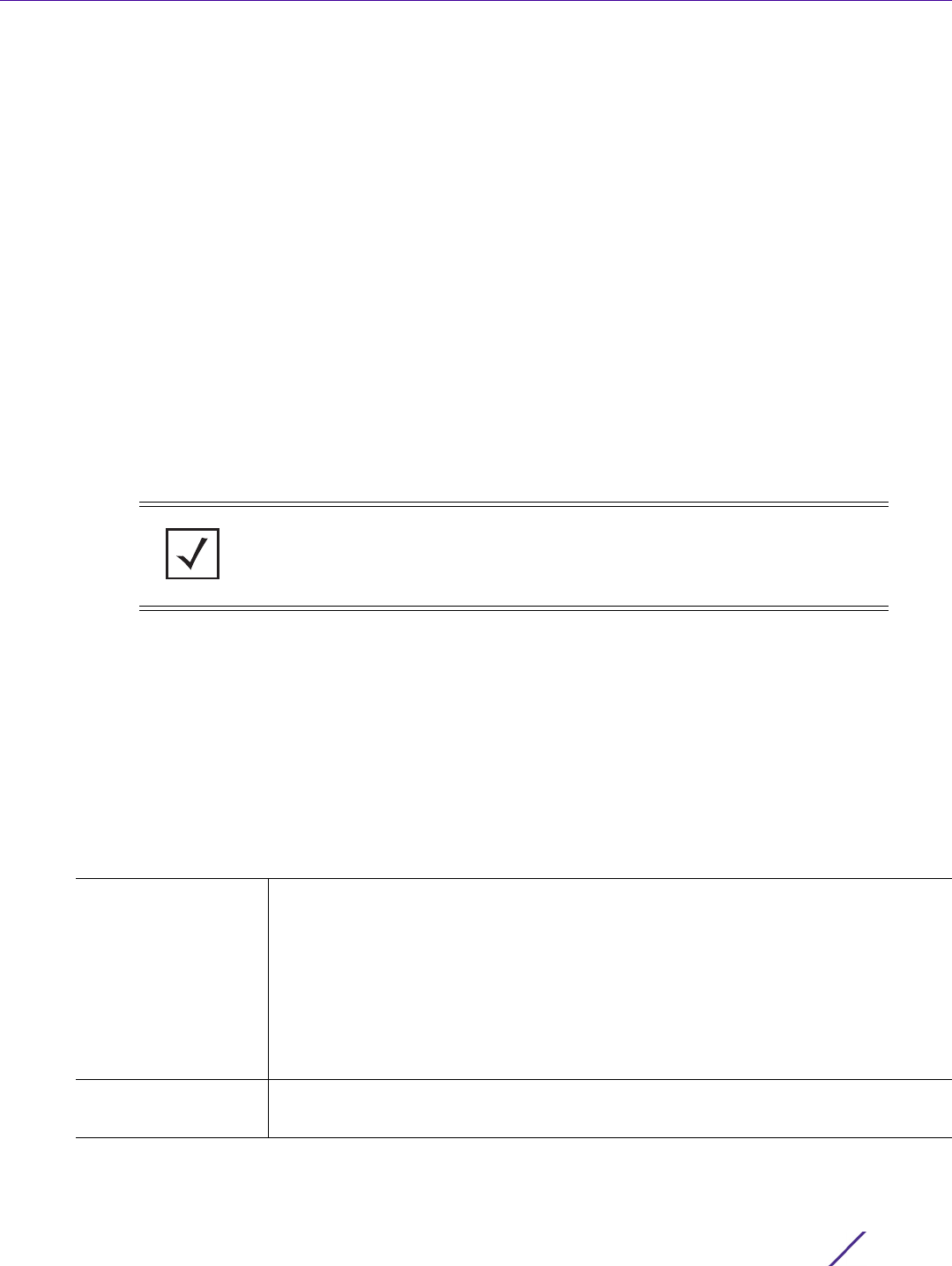
PRIVILEGED EXEC MODE COMMANDS
Access Point, Wireless Controller and Service Platform CLI Reference Guide 3 - 115
3.1.50 t5
Privileged Exec Mode Commands
Executes following operations on a T5 device through the WiNG controller:
• copy, rename, and delete files on the T5 device’s file system
• write running configuration to the T5 device’s memory
The T5 switch is a means of providing cost-effective, high-speed, wall-to-wall coverage across a building.
The T5 switch leverages the in-building telephone lines to extend Ethernet and Wireless LAN networks
without additional expenditure on re-wiring. This setup is ideally suited for hotels, providing high-speed
Wi-Fi coverage to guest rooms.
The entire setup consists of the DSL T5 switch, TW-510 Ethernet wallplates, and TW-511 wireless wallplate
access points. Replace the phone jack plate in a room with the TW-511 delivers 802.11 a/b/g/n and extend
wireless connectivity in that room and the neighboring rooms. These TW-511 wallplates (also referred to as
the CPEs) are connected to the T5 switch over the DSL interface using a phone block.
The T5 switch is adopted and managed through a WiNG controller. The connection between the T5 and
WiNG switches is over a WebSocket.
Supported in the following platforms:
• Wireless Controllers — RFS4000, RFS6000
• Service Platforms — NX5500, NX7500, NX7510, NX7520, NX7530, NX9500, NX9510, NX9600,
VX9000
Syntax
t5 [copy <SOURCE-FILE-NAME> <DEST-FILE-NAME>|delete <FILE-NAME>|rename <SOURCE-
FILE-NAME> <DEST-FILE-NAME>|write memory] {on <T5-DEVICE-NAME>}
Parameters
• t5 [copy <SOURCE-FILE-NAME> <DEST-FILE-NAME>|delete <FILE-NAME>|rename <SOURCE-
FILE-NAME> <DEST-FILE-NAME>|write memory] {on <T5-DEVICE-NAME>}
NOTE: For more information on other T5 CPE related commands, see cpe.
copy
<SOURCE-FILE-
NAME>
<DEST-FILE-NAME>
Copies file to an external server
• <SOURCE-FILE-NAME> – Specify the source file name.
• <DEST-FILE-NAME> – Specify the destination file name.
The content from the source file is copied to the destination file.
The source or destination files can be local or remote FTP or TFTP files. The source
file also can be a pre-defined keyword. At least one of the files should be a local file.
Use this command to copy the startup and/or running configurations to an external
server.
delete <FILE-NAME> Deletes files on the T5 device’s file system
• <FILE-NAME> – Specify the file name. The specified file is deleted.

PRIVILEGED EXEC MODE COMMANDS
Access Point, Wireless Controller and Service Platform CLI Reference Guide 3 - 116
Example
nx9500-6C8809#t5 write memory on t5-ED7C6C
Success
nx9500-6C8809#
rename
<SOURCE-FILE-
NAME>
<DEST-FILE-NAME>
Renames a file on the T5 device’s file system
• <SOURCE-FILE-NAME> – Specify the source file name
• <DEST-FILE-NAME> – Specify the new file name. The source file is renamed to the
input provided here.
write memory Writes running configuration to an adopted T5 device’s memory
• memory – Writes running configuration to the T5 device’s non-volatile (NV) memory.
on <T5-DEVICE-
NAME>
Optional. Executes these operation on a specified T5 device
• <T5-DEVICE-NAME> – Specify the T5 device’s hostname.

PRIVILEGED EXEC MODE COMMANDS
Access Point, Wireless Controller and Service Platform CLI Reference Guide 3 - 117
3.1.51 telnet
Privileged Exec Mode Commands
Opens a Telnet session between two network devices
Supported in the following platforms:
• Access Points — AP6521, AP6522, AP6532, AP6562, AP7161, AP7502, AP7522, AP7532, AP7562,
AP7602, AP7612, AP7622, AP7632, AP7662, AP81XX, AP8232, AP8432, AP8533
• Wireless Controllers — RFS4000, RFS6000
• Service Platforms — NX5500, NX7500, NX7510, NX7520, NX7530, NX9500, NX9510, NX9600,
VX9000
Syntax
telnet <IP/HOSTNAME> {<TCP-PORT>} {<INTF-NAME>}
Parameters
• telnet <IP/HOSTNAME> {<TCP-PORT>} {<INTF-NAME>}
Usage Guidelines
To exit the other device’s context, use the command relevant to that device.
Example
nx9500-6C8809#telnet 192.168.13.22
Entering character mode
Escape character is '^]'.
AP7131 release 5.9.0.0-012D
ap7131-11E6C4 login: admin
Password:
ap7131-11E6C4>
<IP/HOSTNAME> Configures the remote system’s IP (IPv4 or IPv6) address or hostname. The Telnet
session will be established between the connecting system and the remote system.
• <IP> – Specify the remote system’s IPv4 or IPv6 address or hostname.
<TCP-PORT> Optional. Specify the Transmission Control Protocol (TCP) port.
<INTF-NAME> Optional. Specify the interface name for the link local address.

PRIVILEGED EXEC MODE COMMANDS
Access Point, Wireless Controller and Service Platform CLI Reference Guide 3 - 118
3.1.52 terminal
Privileged Exec Mode Commands
Sets the number of characters per line, and the number of lines displayed within the terminal window
Supported in the following platforms:
• Access Points — AP6521, AP6522, AP6532, AP6562, AP7161, AP7502, AP7522, AP7532, AP7562,
AP7602, AP7612, AP7622, AP7632, AP7662, AP81XX, AP8232, AP8432, AP8533
• Wireless Controllers — RFS4000, RFS6000
• Service Platforms — NX5500, NX7500, NX7510, NX7520, NX7530, NX9500, NX9510, NX9600,
VX9000
Syntax
terminal [length|width] <0-512>
Parameters
• terminal [length|width] <0-512>
Example
rfs6000-81742D#terminal length 150
rfs6000-81742D#terminal width 215
rfs6000-81742D#show terminal
Terminal Type: xterm
Length: 150 Width: 215
rfs6000-81742D#
Related Commands
length <0-512> Sets the number of lines displayed on the terminal window
• <0-512> – Specify a value from 0 - 512.
width <0-512> Sets the width or number of characters displayed on the terminal window
• <0-512> – Specify a value from 0 - 512.
no Resets the width of the terminal window or the number of lines displayed on a
terminal window

PRIVILEGED EXEC MODE COMMANDS
Access Point, Wireless Controller and Service Platform CLI Reference Guide 3 - 119
3.1.53 time-it
Privileged Exec Mode Commands
Verifies the time taken by a particular command between request and response
Supported in the following platforms:
• Access Points — AP6521, AP6522, AP6532, AP6562, AP7161, AP7502, AP7522, AP7532, AP7562,
AP7602, AP7612, AP7622, AP7632, AP7662, AP81XX, AP8232, AP8432, AP8533
• Wireless Controllers — RFS4000, RFS6000
• Service Platforms — NX5500, NX7500, NX7510, NX7520, NX7530, NX9500, NX9510, NX9600,
VX9000
Syntax
time-it <COMMAND>
Parameters
• time-it <COMMAND>
Example
rfs6000-81742D#time-it config terminal
Enter configuration commands, one per line. End with CNTL/Z.
That took 0.00 seconds..
rfs6000-81742D(config)#
time-it <COMMAND> Verifies the time taken by a particular command to execute and provide a result
• <COMMAND> – Specify the command name.

PRIVILEGED EXEC MODE COMMANDS
Access Point, Wireless Controller and Service Platform CLI Reference Guide 3 - 120
3.1.54 traceroute
Privileged Exec Mode Commands
Traces the route to a defined destination
Use ‘--help’ or ‘-h’ to display a complete list of parameters for the traceroute command
Supported in the following platforms:
• Access Points — AP6521, AP6522, AP6532, AP6562, AP7161, AP7502, AP7522, AP7532, AP7562,
AP7602, AP7612, AP7622, AP7632, AP7662, AP81XX, AP8232, AP8432, AP8533
• Wireless Controllers — RFS4000, RFS6000
• Service Platforms — NX5500, NX7500, NX7510, NX7520, NX7530, NX9500, NX9510, NX9600,
VX9000
Syntax
traceroute <WORD>
Parameters
• traceroute <WORD>
Example
nx9500-6C8809#traceroute 192.168.13.16
traceroute to 192.168.13.16 (192.168.13.16), 30 hops max, 46 byte packets
1 192.168.13.16 (192.168.13.16) 0.479 ms 0.207 ms 0.199 ms
nx9500-6C8809#
<WORD> Traces the route to a IP address or hostname
• <WORD> – Specify the IPv4 address or hostname.

PRIVILEGED EXEC MODE COMMANDS
Access Point, Wireless Controller and Service Platform CLI Reference Guide 3 - 121
3.1.55 traceroute6
Privileged Exec Mode Commands
Traces the route to a specified IPv6 destination
Supported in the following platforms:
• Access Points — AP6521, AP6522, AP6532, AP6562, AP7161, AP7502, AP7522, AP7532, AP7562,
AP7602, AP7612, AP7622, AP7632, AP7662, AP81XX, AP8232, AP8432, AP8533
• Wireless Controllers — RFS4000, RFS6000
• Service Platforms — NX5500, NX7500, NX7510, NX7520, NX7530, NX9500, NX9510, NX9600,
VX9000
Syntax
traceroute6 <WORD>
Parameters
• traceroute6 <WORD>
Example
rfs4000-880DA7#traceroute6 2001:10:10:10:10:10:10:2
traceroute to 2001:10:10:10:10:10:10:2 (2001:10:10:10:10:10:10:2) from
2001:10:10:10:10:10:10:1, 30 hops max, 16 byte packets
1 2001:10:10:10:10:10:10:2 (2001:10:10:10:10:10:10:2) 0.622 ms 0.497 ms 0.531
ms
rfs4000-880DA7#
traceroute6 <WORD> Traces the route to a IPv6 address or hostname
• <WORD> – Specify the IPv6 address or hostname.

PRIVILEGED EXEC MODE COMMANDS
Access Point, Wireless Controller and Service Platform CLI Reference Guide 3 - 122
3.1.56 upgrade
Privileged Exec Mode Commands
Upgrades a device’s software image
Supported in the following platforms:
• Access Points — AP6521, AP6522, AP6532, AP6562, AP7161, AP7502, AP7522, AP7532, AP7562,
AP7602, AP7612, AP7622, AP7632, AP7662, AP81XX, AP8232, AP8432, AP8533
• Wireless Controllers — RFS4000, RFS6000
• Service Platforms — NX5500, NX7500, NX7510, NX7520, NX7530, NX9500, NX9510, NX9600,
VX9000
Syntax
upgrade [<FILE>|<URL>|dhcp-vendor-options]
upgrade [<FILE>|<URL>] {background|on <DEVICE-NAME>|on <RF-DOMAIN-NAME>}
upgrade dhcp-vendor-options {<DEVICE-NAME>|on <RF-DOMAIN-NAME>}
upgrade dhcp-vendor-options {<DEVICE-NAME>} {<DEVICE-NAME>}
upgrade dhcp-vendor-options {on <RF-DOMAIN-NAME>} {containing <SUB-
STRING>|exclude-controllers|exclude-rf-domain-managers|filter <DEVICE-TYPE>}
Parameters
• upgrade [<FILE>|<URL>] {background|on <DEVICE-NAME>|on <RF-DOMAIN-NAME>}
<FILE> Specify the target firmware image location in the following format:
cf:/path/file
usb1:/path/file
usb2:/path/file
usb<n>:/path/file
<URL> Specify the target firmware image location. Use one of the following formats:
IPv4 URLs:
tftp://<hostname|IP>[:port]/path/file
ftp://<user>:<passwd>@<hostname|IP>[:port]/path/file
sftp://<user>:<passwd>@<hostname|IP>[:port]>/path/file
http://<hostname|IP>[:port]/path/file
cf:/path/file
usb<n>:/path/file
IPv6 URLs:
tftp://<hostname|[IPv6]>[:port]/path/file
ftp://<user>:<passwd>@<hostname|[IPv6]>[:port]/path/file
sftp://<user>:<passwd>@<hostname|[IPv6]>[:port]>/path/file
http://<hostname|[IPv6]>[:port]/path/file
background Optional. Performs upgrade in the background

PRIVILEGED EXEC MODE COMMANDS
Access Point, Wireless Controller and Service Platform CLI Reference Guide 3 - 123
• upgrade dhcp-vendor-options {<DEVICE-NAME>} {<DEVICE-NAME>}
• upgrade dhcp-vendor-options {on <RF-DOMAIN-NAME>} {containing <SUB-STRING>|
exclude-controllers|exclude-rf-domain-managers|filter <DEVICE-TYPE>}
Example
nx9500-6C8809#show boot
--------------------------------------------------------------------------------
IMAGE BUILD DATE INSTALL DATE VERSION
--------------------------------------------------------------------------------
Primary 02/05/2017 14:33:58 02/11/2017 12:27:53 5.9.0.0-024D
Secondary 02/01/2017 21:36:24 02/03/2017 12:05:48 5.8.6.0-007B
--------------------------------------------------------------------------------
Current Boot : Secondary
Next Boot : Primary
Software Fallback : Enabled
VM support : Not presentt
nx9500-6C8809#
on
<DEVICE-NAME>
Optional. Upgrades the software image on a specified remote device
• <DEVICE-NAME> – Specify the name of the AP, wireless controller, or service platform.
on <RF-DOMAIN-
NAME>
Optional. Upgrades the software image on all devices within a specified RF Domain
• <RF-DOMAIN-NAME> – Specify the name of the RF Domain.
dhcp-vendor-options Uses DHCP vendor options to upgrade device(s)
<DEVICE-NAME>
{<DEVICE-NAME>}
Optional. Uses DHCP vendor options to upgrade a specified device. Specify the name
of the AP, wireless controller, or service platform.
• <DEVICE-NAME> – Optional. You can optionally specify multiple comma-separated
device names/MAC addresses to upgrade.
dhcp-vendor-options Uses DHCP vendor options to upgrade device(s)
on <RF-DOMAIN-
NAME>
{containing <SUB-
STRING>|
exclude-controllers|
exclude-rf-domain-
managers|
filter <DEVICE-
TYPE>}
Optional. Uses DHCP vendor options to upgrade all devices or specified device(s)
within the RF Domain identified by the <RF-DOMAIN-NAME> keyword
• <RF-DOMAIN-NAME> – Specify the RF Domain name. After specifying the RF Domain,
optionally use the filters provided to identify specific device(s) within the RF Domain.
If none of the filters are used, all devices within the RF Domain are upgraded. These
filters are:
• containing <SUB-STRING> – Optional. Upgrades all devices, within the specified RF
Domain, containing a specified sub-string in their hostname
• <SUB-STRING> – Specify the sub-string to match.
• exclude-controllers – Optional. Upgrades all devices, within the specified RF Domain,
excluding controllers. Since only a NOC controller is capable of adopting other control-
lers, use this option when executing the command on a NOC controller.
• exclude-rf-domain-manager – Optional. Upgrades all devices, within the specified
RF Domain, excluding RF Domain managers. Use this option when executing the com-
mand on the NOC, Site controller, or RF Domain manager.
• filter <DEVICE-TYPE> – Optional. Executes the command on all devices, within the
specified RF Domain, of a specified type
• <DEVICE-TYPE> – Specify the device type. The options are: AP6521, AP6522,
AP6532, AP6562, AP7161, AP7502, AP7522, AP7532, AP7562, AP81XX, AP8232,
AP8432, AP8533, RFS4000, RFS6000, NX5500, NX75XX, NX95XX, NX9600, and
VX9000. Upgrades all devices of the type specified here. For example, if AP6521
is the device-type specified, all AP6521s within the specified RF Domain are up-
graded

PRIVILEGED EXEC MODE COMMANDS
Access Point, Wireless Controller and Service Platform CLI Reference Guide 3 - 124
nx9500-6C8809#upgrade ftp://anonymous:anonymous@192.168.13.10/LatestBuilds/W59/
NX9500.img
Running from partition /dev/sda7
Validating image file header
Removing other partition
Making file system
Extracting files (this may take some
time)...........................................................................
................................................................................
................................................................................
................................................................................
................................................................................
................................................................................
................................................................................
................................................................................
................................................................................
................................................................................
................................................................................
.............................................................
Control C disabled
Version of firmware update file is 5.9.0.0-026D
Removing unneeded files from flash:/crashinfo directory
Removing unneeded files from flash:/var2/log directory
Creating LILO files
Running LILO
Successful
nx9500-6C8809#
nx9500-6C8809#show boot
--------------------------------------------------------------------------------
IMAGE BUILD DATE INSTALL DATE VERSION
--------------------------------------------------------------------------------
Primary 05/01/2017 12:03:13 05/10/2017 10:12:53 5.9.0.0-026D
Secondary 05/01/2017 19:30:21 05/02/2017 10:05:48 5.9.0.0-007B
--------------------------------------------------------------------------------
Current Boot : Secondary
Next Boot : Primary
Software Fallback : Enabled
VM support : Not present
nx9500-6C8809#
After upgrading, the device has to be reloaded to boot using the new image.
nx7500-7F3609#upgrade tftp://192.168.0.50/RFS6000-5.9.0.-012D.img rfs6000-6DCBB3
--------------------------------------------------------------------------------
DEVICE STATUS MESSAGE
--------------------------------------------------------------------------------
rfs6000-6DCBB3 Success None
--------------------------------------------------------------------------------
nx7500-7F3609#show upgrade-status
Last Image Upgrade Status : Successful
Last Image Upgrade Time : 2017-03-26 10:31:12
nx7500-7F3609#
The following example shows the upgrade status:
nx7500-7F3609#show upgrade detail
Last Image Upgrade Status : Successful
Last Image Upgrade Time : 2017-03-26 10:31:12
-----------------------------------------------
Running from partition /dev/sda7
var2 is 2 percent full
/tmp is 2 percent full
Free Memory 15258044 kB
FWU invoked via Linux shell
Validating image file header
Removing other partition

PRIVILEGED EXEC MODE COMMANDS
Access Point, Wireless Controller and Service Platform CLI Reference Guide 3 - 125
Making file system
Extracting files (this may take some time).
Control C disabled
Version of firmware update file is 5.9.0.-012D
Creating LILO files
Running LILO
Successful
nx7500-7F3609#
nx7500-7F3609#show upgrade on rfs6000-6DCBB3
Last Image Upgrade Status :Successful
Last Image Upgrade Time :2017-03-26 10:31:12
nx7500-7F3609#
Related Commands
no Removes a patch installed on a specified device

PRIVILEGED EXEC MODE COMMANDS
Access Point, Wireless Controller and Service Platform CLI Reference Guide 3 - 126
3.1.57 upgrade-abort
Privileged Exec Mode Commands
Aborts an ongoing software image upgrade
Supported in the following platforms:
• Access Points — AP6521, AP6522, AP6532, AP6562, AP7161, AP7502, AP7522, AP7532, AP7562,
AP7602, AP7612, AP7622, AP7632, AP7662, AP81XX, AP8232, AP8432, AP8533
• Wireless Controllers — RFS4000, RFS6000
• Service Platforms — NX5500, NX7500, NX7510, NX7520, NX7530, NX9500, NX9510, NX9600,
VX9000
Syntax
upgrade-abort {on <DEVICE-OR-DOMAIN-NAME>}
Parameters
• upgrade-abort {on <DEVICE-OR-DOMAIN-NAME>}
Example
rfs4000-229D58#upgrade ftp://anonymous:anonymous@192.168.13.10/LatestBuilds/W59/
RFS4000-5.9.0.0-012D.img
Running from partition /dev/mtdblock6
Validating image file header
Making file system
Extracting files (this may take some time)..................
rfs6000-81701D#upgrade-abort on rfs4000-229D58
rfs4000-229D58#upgrade ftp://anonymous:anonymous@192.168.13.10/LatestBuilds/W59/
RFS4000-5.9.0.0-012D.img.img
Running from partition /dev/mtdblock6
Validating image file header
Making file system
Extracting files (this may take some time)..................
Update error: Aborted
rfs4000-229D58#
upgrade-abort Aborts an ongoing software image upgrade
on <DEVICE-OR-
DOMAIN-NAME>
Optional. Aborts an ongoing software image upgrade on a specified device or
domain
• <DEVICE-OR-DOMAIN-NAME> – Specify the name of the AP, wireless controller,
service platform, or RF Domain.

PRIVILEGED EXEC MODE COMMANDS
Access Point, Wireless Controller and Service Platform CLI Reference Guide 3 - 127
3.1.58 virtual-machine
Privileged Exec Mode Commands
Installs, configures, and monitors the status of virtual machines (VMs) installed on a WiNG controller
Supported in the following platforms:
• Service Platforms — NX9500, NX9510, NX9600, VX9000
Syntax
virtual-machine [assign-usb-ports|export|install|restart|set|start|
stop|uninstall]
virtual-machine assign-usb-ports team-vowlan {on <DEVICE-NAME>}
virtual-machine export <VM-NAME> [<FILE>|<URL>] {on <DEVICE-NAME>}
virtual-machine install [<VM-NAME>|adsp|team-urc|team-rls|team-vowlan]
{on <DEVICE-NAME>}
virtual-machine restart [<VM-NAME>|hard|team-urc|team-rls|team-vowlan]
virtual-machine set [autostart|memory|vcpus|vif-count|vif-mac|vif-to-vmif|vnc]
virtual-machine set [autostart [ignore|start]|memory <512-8192>|vcpus <1-4>|
vif-count <0-2>|vif-mac <VIF-INDEX> <MAC-INDEX>|vif-to-vmif <VIF-INDEX> <VMIF-
INDEX>| vnc [disable|enable]] [<VM-NAME>|team-urc|team-rls|team-vowlan]
{on <DEVICE-NAME>}
The following virtual-machine commands are supported only on the VX9000 platform:
virtual-machine volume-group [add-drive|replace-drive|resize-drive|resize-volume-
group]
virtual-machine volume-group [add-drive|replace-drive] <BLOCK-DEVICE-LABEL>
virtual-machine volume-group replace-drive <BLOCK-DEVICE-LABLE> <NEW-BLOCK-
DEVICE-LABEL>
virtual-machine volume-group resize-volume-group <BLOCK-DEVICE-LABEL>
Parameters
• virtual-machine assign-usb-ports team-vowlan {on <DEVICE-NAME>}
• virtual-machine export <VM-NAME> [<FILE>|<URL>] {on <DEVICE-NAME>}
assign-usb-ports team-
vowlan Assigns USB ports to TEAM-VoWLAN on a specified device
•on <DEVICE-NAME> – Optional. Specify the device name.
Note: Use the no > virtual-machine > assign-usb-ports to reassign the port to WiNG.
Note: TEAM-RLS VM cannot be installed when USB ports are assigned to TEAM-
VoWLAN.
virtual-machine export Exports an existing VM image and settings. Use this command to export the VM to
another <NX54XX> or <NX65XX> device in the same domain.
• <VM-NAME> – Specify the VM name.
• <FILE> – Specify the location and name of the source file (VM image). The VM
image is retrieved and exported from the specified location.
• <URL> – Specify the destination location. This is the location to which the VM im-
age is copied. Use one of the following formats to provide the destination path:
Contd..

PRIVILEGED EXEC MODE COMMANDS
Access Point, Wireless Controller and Service Platform CLI Reference Guide 3 - 128
• virtual-machine install [<VM-NAME>|adsp|team-centro|team-rls|team-vowlan]
{on <DEVICE-NAME>}
• virtual-machine set [autostart [ignore|start]|memory <512-8192>|vcpus <1-4>|
vif-count <0-2>|vif-mac <VIF-INDEX> <MAC-INDEX>|vif-to-vmif <VIF-INDEX> <VMIF-
INDEX>|vnc [disable|enable]] [<VM-NAME>|team-urc|team-rls|team-vowlan]
{on <DEVICE-NAME>}
tftp://<hostname|IP>[:port]/path/file
ftp://<user>:<passwd>@<hostname|IP>[:port]/path/file
sftp://<user>:<passwd>@<hostname|IP>[:port]>/path/file
http://<hostname|IP>[:port]/path/file
•on <DEVICE-NAME> – Optional. Executes the command on a specified device or
devices
•<DEVICE-NAME> – Specify the service platform name. In case of multiple devices, list
the device names separated by commas.
Note: The VM should be in a stop state during the export process.
Note: If the destination is a device, the image is copied to a predefined location (VM
archive).
virtual-machine install Installs the VM. The install command internally creates a VM template, consisting of
the specified parameters, and starts the installation process. Select one of the
following options:
• <VM-NAME> – Installs a VM having name specified by <VM-NAME> keyword.
• adsp – Installs ADSP
• team-centro – Installs the VM TEAM-Centro image
• team-rls – Installs the VM TEAM-RLS image
• team-vowlan – Installs the VM TEAM-VoWLAN image
Specify the device on which to install the VM.
• on <DEVICE-NAME> – Optional. Executes the command on a specified device or
devices
• <DEVICE-NAME> – Specify the service platform name. In case of multiple devices,
list the device names separated by commas.
virtual-machine set Configures the VM settings
•autostart – Specifies whether to autostart the VM on system reboot
• ignore – Enables autostart on each system reboot
• start – Disables autostart
• memory – Defines the VM memory size
• <512-8192> – Specify the VM memory from 512 - 8192 MB. The default is 1024 MB.
• vcpus – Specifies the number of VCPUS for this VM
• <1-4> – Specify the number of VCPUS from 1- 4.
• vif-count – Configures or resets the VM's VIFs
• <0-2> – Specify the VIF number from 0 - 2.
• vif-mac – Configures the MAC address of the selected virtual network interface
• <1-2> – Select the VIF
• <1-8> – Specify the MAC index for the selected VIF
• <MAC> – Specify the customized MAC address for the selected VIF in the AA-BB-
CC-DD-EE-FF format.
Contd..

PRIVILEGED EXEC MODE COMMANDS
Access Point, Wireless Controller and Service Platform CLI Reference Guide 3 - 129
• virtual-machine start [<VM-NAME>|adsp|team-urc|team-rls|team-vowlan]
{on <DEVICE-NAME>}
Each VM has a maximum of two network interfaces (indexed 1 and 2, referred to as VIF). By
default, each VIF is automatically assigned a MAC from the range allocated for that device.
However, you can use the ‘set’ keyword to specify the MAC from within the allocated range.
Each of these VIFs are mapped to a layer 2 port in the dataplane (referred to as VMIF).
These VMIFs are standard l2 ports on the DP bridge, supporting all VLAN and ACL
commands. The WiNG software supports up to a maximum of 8 VMIFs. By default, a VM’s
interface is always mapped to VMIF1. You can map a VIF to any of the 8 VMIFs. Use the vif-
to-vmif command to map a VIF to a VMIF on the DP bridge.
•vif-to-vmif – Maps the virtual interface (1 or 2) to the selected VMIF interface. Specify the
VMIF interface index from 1 - 8.
WiNG provides a dataplane bridge for external network connectivity for VMs. VM
Interfaces define which IP address is associated with each VLAN ID the service
platform is connected to and enables remote service platform administration. Each
custom VM can have up to a maximum of two VM interfaces. Each VM interface can be
mapped to one of the twelve ports for <NX9500> on the dataplane bridge. This
mapping determines the destination for service platform routing.
By default, VM interfaces are internally connected to the dataplane bridge via VMIF1.
VMIF1, by default, is an untagged port providing access to VLAN 1 to support the
capability to connect the VM interfaces to any of the VMIF ports. This provides the
flexibility to move a VM interface onto different VLANs as well as configure specific
firewall and QoS rules.
•vnc – Disables/enables VNC port option for an existing VM. When enabled, provides
remote access to VGA through the noVNC client.
•disable – Disables VNC port
• enable – Enables VNC port
After configuring the VM settings, identify the VM to apply the settings.
• <VM-NAME> – Applies these settings to the VM identified by the <VM-NAME>
keyword. Specify the VM name.
• adsp – Applies these settings to the ADSP VM
• team-urc – Applies these settings to the VM TEAM-URC
• team-rls – Applies these settings to the VM TEAM-RLS
• team-vowlan – Applies these settings to the VM TEAM-VoWLAN
virtual-machine start Starts the VM, based on the parameters passed. Select one of the following options:
• <VM-NAME> – Starts the VM identified by the <VM-NAME> keyword. Specify the
VM name.
• adsp – Starts the ADSP VM
• team-urc – Starts the VM TEAM-URC
• team-rls – Starts the VM TEAM-RLS
• team-vowlan – Starts the VM TEAM-VoWLAN
The following keywords are common to all of the above parameters:
• on <DEVICE-NAME> – Optional. Executes the command on a specified device or
devices
• <DEVICE-NAME> – Specify the service platform name. In case of multiple devic-
es, list the device names separated by commas.

PRIVILEGED EXEC MODE COMMANDS
Access Point, Wireless Controller and Service Platform CLI Reference Guide 3 - 130
• virtual-machine stop [<VM-NAME>|adsp|team-urc|team-rls|team-vowlan]
{on <DEVICE-NAME>}
• virtual-machine uninstall [<VM-NAME>|adsp|team-urc|team-rls|team-vowlan]
{on <DEVICE-NAME>}
• virtual-machine volume-group [add-drive|resize-drive] <BLOCK-DEVICE-LABEL>]
virtual-machine stop
hard
Stops the VM, based on the parameters passed. Select one of the following options:
• <VM-NAME> – Stops the VM identified by the <VM-NAME> keyword. Specify the
VM name.
• ADSP – Stops the ADSP VM
• team-urc – Stops the VM TEAM-URC
• team-rls – Stops the VM TEAM-RLS
• team-vowlan – Stops the VM TEAM-VoWLAN
The following keywords are common to all of the above parameters:
• on <DEVICE-NAME> – Optional. Executes the command on a specified device or
devices
• <DEVICE-NAME> – Specify the service platform name. In case of multiple de-
vices, list the device names separated by commas.
Note: The option ‘hard’ forces the selected VM to shutdown.
virtual-machine
uninstall
Uninstalls the specified VM
• <VM-NAME> – Uninstalls the VM identified by the <VM-NAME> keyword. Specify
the VM name.
•ADSP – Uninstalls the ADSP VM
• team-urc – Uninstalls the VM TEAM-URC
• team-rls – Uninstalls the VM TEAM-RLS
• team-vowlan – Uninstalls the VM TEAM-VoWLAN
The following keywords are common to all of the above parameters:
• on <DEVICE-NAME> – Optional. Executes the command on a specified device or
devices
• <DEVICE-NAME> – Specify the service platform name. In case of multiple de-
vices, list the device names separated by commas.
Note: This command releases the VM’s resources, such as memory, VCPUS, VNC port,
disk space, and removes the RF Domain reference from the system.
virtual-machine
volume-group [add-
drive|resize-drive]
<BLOCK-DEVICE-
LABEL>]
Enables provisioning of logical volume-groups on the VX9000 platform. Logical
volume-groups are created on the primary storage device, allowing the database
storage to be expanded to include additional storage drives. However, volume-groups
can be provisioned only on new VX9000 installation and cannot be added to existing
VX9000 installation.
Note: The logical volume-group is supported only on a VX9000 running the WiNG 5.9.1
image.
Contd..

PRIVILEGED EXEC MODE COMMANDS
Access Point, Wireless Controller and Service Platform CLI Reference Guide 3 - 131
• virtual-machine volume-group replace-drive <BLOCK-DEVICE-LABEL> <NEW-BLOCK-
DEVICE-LABEL>]
• virtual-machine volume-group resize-volume-group <BLOCK-DEVICE-LABEL>]
• add-drive – Adds a new block-device to the VM. Note, currently a maximum of 3
(three) block devices can be added. To add a new drive, first halt the VM, In the
Hypervisor, add a new storage disk to the VM and restart the VM. Once the VM
comes up, use this command to add the new drive. To identify the new drive execute
the show > virtual-machine > volume-group > status command.
• resize-drive - Resizes a drive in the VM’s volume group. To increase the size of a drive
in the volume-group, first halt the VM. In the Hypervisor, increase the size of the
existing secondary storage drive and restart the VM. Once the VM comes up, use this
command to resize the drive. To identify the drive with the additional free space,
execute the show > virtual-machine > volume-group > status command.
The following keyword is common to all of the above parameters:
• <BLOCK-DEVICE-LABEL> –Specify the block-device label to be added or resized
depending on the action being performed.
virtual-machine
volume-group replace-
drive <BLOCK-DEVICE-
LABEL> <NEW-BLOCK-
DEVICE-LABEL>]
Enables provisioning of VMs as logical volume-groups on the VX9000 platform.
Logical volume-group VMs are created on the primary storage device, allowing the
database storage to be expanded to include additional storage drives.
• replace-drive – Replaces an existing block-device with a new block-device in a
volume-group. To replace a drive in the volume-group, first halt the VM. In the
Hypervisor, add the new drive and restart the VM. Once the VM comes up, use this
command to replace an existing drive with the new drive. To identify the drive with
the additional free space, execute the show > virtual-machine > volume-group >
status command
• <BLOCK-DEVICE-LABEL> –Specify the block-device label to be replaced.
• <BLOCK-DEVICE-LABEL> – Specify the replacement block-device label.
virtual-machine
volume-group resize-
volume-group <BLOCK-
DEVICE-LABEL>]
Enables provisioning of VMs as logical volume-groups on the VX9000 platform.
Logical volume-group VMs are created on the primary storage device, allowing the
database storage to be expanded to include additional storage drives
• resize-volume-group – Adds drive space to an existing block-device in the volume-
group
• <BLOCK-DEVICE-LABEL> –Specify the block-device label to which additional
drive space is to be provided

PRIVILEGED EXEC MODE COMMANDS
Access Point, Wireless Controller and Service Platform CLI Reference Guide 3 - 132
Example
The following examples show the VM installation process:
Insatllation media: USB
<DEVICE>#virtual-machine install <VM-NAME> type iso disk-size 8 install-media
usb1://vms/win7.iso autostart start memory 512 vcpus 3 vif-count 2 vnc enable
Installation media: pre-installed disk image
<DEVICE>#virtual-machine install <VM-NAME> type disk install-media flash:/vms/
win7_disk.img autostart start memory 512 vcpus 3 vif-count 2 vnc-enable on
<DEVICE-NAME>
In the preceding example, the command is executed on the device identified by the
<DEVICE-NAME> keyword. In such a scenario, the disk-size is ignored if specified.
The VM has the install media as first boot device.
Installation media: VM archive
<DEVICE>#virtual-machine install type vm-archive install-media flash:/vms/<VM-
NAME> vcpus 3
In the preceding example, the default configuration attached with the VM archive
overrides any parameters specified.
Exporting an installed VM:
<DEVICE>#virtual-machine export <VM-NAME> <URL> on <DEVICE-NAME>
In the preceding example, the command copies the VM archive on to the URL (VM should
be in stop state).
nx9500-6C8809#virtual-machine install team-urc
Virtual Machine install team-urc command successfully sent.
nx9500-6C8809#
vx9000-DE6F97>cirtual-machine add-drive sdb
vx9000-DE6F97>show virtual-machine volume-group status
-----------------------------------------
Logical Volume: lv1
-----------------------------------------
STATUS : available
SIZE : 81.89 GiB
VOLUME GROUP : vg0
PHYSICAL VOLUMES :
sda10 : 73.90 GiB
sdc1 : 8.00 GiB
AVAILABLE DISKS :
sdb : size: 8590MB
-----------------------------------------
* indicates a drive that must be resized
-----------------------------------------
vx9000-DE6F97#

PRIVILEGED EXEC MODE COMMANDS
Access Point, Wireless Controller and Service Platform CLI Reference Guide 3 - 133
3.1.59 watch
Privileged Exec Mode Commands
Repeats a specified CLI command at periodic intervals
Supported in the following platforms:
• Access Points — AP6521, AP6522, AP6532, AP6562, AP7161, AP7502, AP7522, AP7532, AP7562,
AP7602, AP7612, AP7622, AP7632, AP7662, AP81XX, AP8232, AP8432, AP8533
• Wireless Controllers — RFS4000, RFS6000
• Service Platforms — NX5500, NX7500, NX7510, NX7520, NX7530, NX9500, NX9510, NX9600,
VX9000
Syntax
watch <1-3600> <LINE>
Parameters
• watch <1-3600> <LINE>
Example
rfs6000-81742D#watch 1 show clock
rfs6000-81742D#
watch <1-3600> Repeats a CLI command at a specified interval
<1-3600> Select an interval from 1 - 3600 seconds. Pressing CTRL-Z halts execution of the
command.
<LINE> Specify the CLI command name.

PRIVILEGED EXEC MODE COMMANDS
Access Point, Wireless Controller and Service Platform CLI Reference Guide 3 - 134
3.1.60 exit
Privileged Exec Mode Commands
Ends the current CLI session and closes the session window
For more information, see exit.
Supported in the following platforms:
• Access Points — AP6521, AP6522, AP6532, AP6562, AP7161, AP7502, AP7522, AP7532, AP7562,
AP7602, AP7612, AP7622, AP7632, AP7662, AP81XX, AP8232, AP8432, AP8533
• Wireless Controllers — RFS4000, RFS6000
• Service Platforms — NX5500, NX7500, NX7510, NX7520, NX7530, NX9500, NX9510, NX9600,
VX9000
Syntax
exit
Parameters
None
Example
rfs6000-81742D#exit

PRIVILEGED EXEC MODE COMMANDS
Access Point, Wireless Controller and Service Platform CLI Reference Guide 3 - 135
3.1.61 raid
Privileged Exec Mode Commands
Enables Redundant Array of Independent Disks (RAID) management
RAID is a group of one or more independent, physical drives, referred to as an array or drive group, These
physically independent drives are linked together and appear as a single storage unit or multiple virtual
drives. Replacing a single, large drive system with an array, improves performance (input and output
processes are faster) and increases fault tolerance within the data storage system.
In an array, the drives can be organized in different ways, resulting in different RAID types. Each RAID type
is identified by a number, which determines the RAID level. The common RAID levels are 0, 00, 1, 5, 6, 50
and 60. The WiNG MegaRAID implementation supports RAID-1, which provides data mirroring, but does
not support data parity. RAID-1 consists of a two-drive array, where the data is simultaneously written on
both drives, ensuring total data redundancy. In case of a drive failure the information on the other drive is
used to rebuild the failed drive.
An array is said to be degraded when one of its drives has failed. A degraded array continues to function
and can be rebooted using the one remaining functional drive. When a drive fails, the chassis sounds an
alarm (if enabled), and the CLI prompt changes to “RAID degraded”. The failed drive is automatically
replaced with a hot spare (provided a spare is installed). The spare is used to re-build the array.
Use this command to:
• Verify the current array status
• Start and monitor array consistency checks
• Retrieve date and time of the last consistency check
• Shut down drives before physically removing them
• Install new drives
• Assign drives as hot spares
• Identify a degraded drive
• Deactivate an alarm (triggered when a drive is removed from the array)
Supported in the following platforms:
• Service Platforms — NX7530, NX9500, NX9510
Syntax
raid [check|install|locate|remove|silence|spare]
raid [check|silence]
raid [install|locate|remove|spare] drive <0-4>
NOTE: RAID controller drive arrays are available within NX7530 and NX95XX
series service platforms (NX9500 and NX9510 models) only. However, they
can be administrated on behalf of a NX9500 profile by a different model
service platform or controller. The NX9500 service platform includes a single
Intel MegaRAID controller, configured to provide a single virtual drive. This
virtual drive is of the RAID-1 type, and has a maximum of two physical drives.
In addition to these two drives, there are three hot spares, which are used in
case of a primary drive failure.

PRIVILEGED EXEC MODE COMMANDS
Access Point, Wireless Controller and Service Platform CLI Reference Guide 3 - 136
Parameters
• raid [check|silence]
• raid [install|locate|remove|spare] drive <0-4>
Example
nx9500-6C874D#raid install drive 0
Error: Input Error: Drive 0 is already member of array, can't be added
nx9500-6C874D#
check Starts a consistency check on the RAID array. Use the show > raid command to view
consistency check status.
A consistency check verifies the data stored in the array. When regularly executed, it
helps protect against data corruption, and ensures data redundancy. Consistency
checks also warn of potential disk failures.
silence Deactivates an alarm
When enabled, an audible alarm is triggered when a drive in the array fails. The
silence command deactivates the alarm (sound).
Note: To enable RAID alarm, in the device configuration mode, use the raid > alarm >
enable command. A NX9500 profile can also have the RAID alarm feature activated. For
more information on the enabling RAID alarm, see raid.
install <0-4> Installs a new drive, inserted in one of the available slots, in the array. Specify the drive
number.
Drives 0 and 1 are the array drives. Drives 2, 3, and 4 are the hot spare drives. You can
include the new drive in a degraded array, or enable it as a hot spare.
If the array is in a degraded state, the re-build process is triggered and the new drive
is used to repair the degraded array.
locate <0-4> Enables LEDs to blink on a specified drive. Specify the drive number.
Blinking LEDs enable you correctly locate a drive.
remove <0-4> Removes (shuts downs) a disk from the array, before it is physically removed from its
slot. Specify the drive number containing the disk.
Use this command to also remove a hot spare.
spare <0-4> Converts an unused drive into a hot spare. Specify the drive number.

4 - 1
Access Point, Wireless Controller and Service Platform CLI Reference Guide
4
GLOBAL CONFIGURATION
COMMANDS
This chapter summarizes the global-configuration commands in the CLI command structure.
The term global indicates characteristics or features effecting the system as a whole. Use the Global
Configuration Mode to configure the system globally, or enter specific configuration modes to configure
specific elements (such as interfaces or protocols). Use the configure terminal command (under PRIV
EXEC) to enter the global configuration mode.
The following example describes the process of entering the global configuration mode from the PRIV
EXEC mode:
<DEVICE>#configure terminal
<DEVICE>(config)#
Commands entered in the global configuration mode update the running configuration file as soon as they
are entered. However, these changes are not saved in the startup configuration file until a commit write
memory command is issued.
<DEVICE>(config)#?
Global configuration commands:
aaa-policy Configure a
authentication/accounting/authorization
policy
aaa-tacacs-policy Configure an
authentication/accounting/authorization
TACACS policy
alias Alias
ap621 AP621 access point
ap622 AP622 access point
ap650 AP650 access point
ap6511 AP6511 access point
ap6521 AP6521 access point
ap6522 AP6522 access point
ap6532 AP6532 access point
ap6562 AP6562 access point
ap71xx AP71XX access point
ap7502 AP7502 access point
ap7522 AP7522 access point
ap7532 AP7532 access point
ap7562 AP7562 access point
ap7602 AP7602 access point
ap7612 AP7612 access point
ap7622 AP7622 access point
ap7632 AP7632 access point
ap7662 AP7662 access point
ap81xx AP81XX access point
ap82xx AP82XX access point
ap8432 AP8432 access point
ap8533 AP8533 access point
application Configure an application
application-group Configure an application-group
application-policy Configure an application policy
association-acl-policy Configure an association acl policy
auto-provisioning-policy Configure an auto-provisioning policy
bgp BGP Configuration
bonjour-gw-discovery-policy Bonjour Gateway discovery policy
bonjour-gw-forwarding-policy Bonjour Gateway forwarding policy
NOTE: The system prompt changes to indicate you are now in the global
configuration mode. The prompt consists of the device host name followed
by (config) and a pound sign (#).

GLOBAL CONFIGURATION COMMANDS
Access Point, Wireless Controller and Service Platform CLI Reference Guide 4 - 2
bonjour-gw-query-forwarding-policy Bonjour Gateway Query forwarding policy
captive-portal Configure a captive portal
clear Clear
client-identity Client identity (DHCP Device
Fingerprinting)
client-identity-group Client identity group (DHCP Fingerprint
Database)
clone Clone configuration object
crypto-cmp-policy CMP policy
customize Customize the output of summary cli
commands
database-client-policy Configure database client policy
database-policy Configure database policy
device Configuration on multiple devices
device-categorization Configure a device categorization object
dhcp-server-policy DHCP server policy
dhcpv6-server-policy DHCPv6 server related configuration
dns-whitelist Configure a whitelist
event-system-policy Configure a event system policy
ex3500 Ex3500 device
ex3500-management-policy Configure a ex3500 management policy
ex3500-qos-class-map-policy Configure a ex3500 qos class-map policy
ex3500-qos-policy-map Configure a ex3500 qos policy-map
ex3524 EX3524 wireless controller
ex3548 EX3548 wireless controller
firewall-policy Configure firewall policy
global-association-list Configure a global association list
guest-management Configure a guest management policy
help Description of the interactive help
system
host Enter the configuration context of a
device by specifying its hostname
igmp-snoop-policy Create igmp snoop policy
inline-password-encryption Store encryption key in the startup
configuration file
ip Internet Protocol (IP)
ipv6 Internet Protocol version 6 (IPv6)
ipv6-router-advertisement-policy IPv6 Router Advertisement related
configuration
l2tpv3 L2tpv3 tunnel protocol
mac MAC configuration
management-policy Configure a management policy
meshpoint Create a new MESHPOINT or enter
MESHPOINT configuration context for one
or more MESHPOINTs
meshpoint-qos-policy Configure a meshpoint quality-of-service
policy
mint-policy Configure the global mint policy
nac-list Configure a network access control list
no .
nsight-policy Configure a Nsight policy
nx45xx NX45XX integrated services platform
nx5500 NX5500 wireless controller
nx65xx NX65XX integrated services platform
nx75xx NX75XX wireless controller
nx9000 NX9000 wireless controller
passpoint-policy Configure a passpoint policy
password-encryption Encrypt passwords in configuration
profile Profile related commands - if no
parameters are given, all profiles are
selected
radio-qos-policy Configure a radio quality-of-service
policy
radius-group Configure radius user group parameters
radius-server-policy Create device onboard radius policy
radius-user-pool-policy Configure Radius User Pool
rename Clone configuration object
replace Replace configuration object

GLOBAL CONFIGURATION COMMANDS
Access Point, Wireless Controller and Service Platform CLI Reference Guide 4 - 3
rf-domain Create a RF Domain or enter rf-domain
context for one or more rf-domains
rfs4000 RFS4000 wireless controller
rfs6000 RFS6000 wireless controller
rfs7000 RFS7000 wireless controller
roaming-assist-policy Configure a roaming-assist policy
role-policy Role based firewall policy
route-map Dynamic routing route map Configuration
routing-policy Policy Based Routing Configuration
rtl-server-policy Configure a rtl server policy
schedule-policy Configure a schedule policy
self Config context of the device currently
logged into
sensor-policy Configure a sensor policy
smart-rf-policy Configure a Smart-RF policy
t5 T5 DSL switch
url-filter Configure a url filter
url-list Configure a URL list
vx9000 VX9000 wireless controller
web-filter-policy Configure a web filter policy
wips-policy Configure a wips policy
wlan Create a new WLAN or enter WLAN
configuration context for one or more
WLANs
wlan-qos-policy Configure a wlan quality-of-service
policy
write Write running configuration to memory or
terminal
clrscr Clears the display screen
commit Commit all changes made in this session
do Run commands from Exec mode
end End current mode and change to EXEC mode
exit End current mode and down to previous
mode
revert Revert changes
service Service Commands
show Show running system information
<DEVICE>(config)#

GLOBAL CONFIGURATION COMMANDS
Access Point, Wireless Controller and Service Platform CLI Reference Guide 4 - 4
4.1 Global Configuration Commands
GLOBAL CONFIGURATION COMMANDS
The following table summarizes Global Configuration mode commands:
Table 4.1 Global Config Commands
Command Description Reference
aaa-policy Creates a AAA policy and enters its configuration mode. This policy
enables administrators to define access control within the network.
page 4-9
aaa-tacacs-policy Creates a AAA-TACACS policy and enters its configuration mode. This
policy provides access control to network devices such as routers,
network access servers, and other computing devices through
centralized servers.
page 4-20
alias Creates various types of aliases, such as network, VLAN, network-
group, network-service, encrypted-string, hashed -string, etc.
page 4-11
ap6521 Adds an AP6521 to the network page 4-22
ap6522 Adds an AP6522 to the network page 4-23
ap6532 Adds an AP6532 to the network page 4-24
ap6562 Adds an AP6562 to the network page 4-25
ap71xx Adds an AP7161 to the network page 4-26
ap7502 Adds an AP7502 to the network page 4-27
ap7522 Adds an AP7522 to the network page 4-28
ap7532 Adds an AP7532 to the network page 4-29
ap7562 Adds an AP7562 to the network page 4-30
ap7602 Adds an AP7602 to the network page 4-31
ap7612 Adds an AP7612 to the network page 4-32
ap7622 Adds an AP7622 to the network page 4-33
ap7632 Adds an AP7632 to the network page 4-34
ap7662 Adds an AP7662 to the network page 4-35
ap81xx Adds an AP81XX to the network page 4-36
ap82xx Adds an AP82XX to the network page 4-37
ap8432 Adds an AP8432 to the network page 4-38
ap8533 Adds an AP8533 to the network page 4-39
application Creates an application definition and enters its configuration mode. This
command allows you to create a customized application detection
definition.
page 4-40
application-group Creates an application group and enters its configuration mode page 4-48
application-policy Creates an application policy and enters its configuration mode. This
policy defines the actions executed on recognized HTTP (e.g.
Facebook), enterprise (e.g. Webex) and peer-to-peer (e.g. gaming)
applications or application-categories.
page 4-55

GLOBAL CONFIGURATION COMMANDS
Access Point, Wireless Controller and Service Platform CLI Reference Guide 4 - 5
association-acl-
policy
Creates an association ACL policy and enters its configuration mode.
This policy restricts access by specifying a client MAC address or range
of addresses to either include or exclude from WLAN connectivity.
page 4-78
auto-provisioning-
policy
Creates an auto provisioning policy and enters its configuration mode.
This policy defines the process by which an access point discovers
controllers and associates with it.
page 4-79
bgp Configures Border Gateway Protocol (BGP) settings page 4-81
bonjour-gw-
discovery-policy
Creates a Bonjour GW Discovery policy and enters its configuration
mode. This policy configures the VLANs on which Bonjour services are
located.
page 4-84
bonjour-gw-
forwarding-policy
Configures a Bonjour GW Forwarding policy and enters its configuration
mode. This policy enables the discovery of services on VLANs not
visible to the device running the Bonjour Gateway.
page 4-90
bonjour-gw-
query-forwarding-
policy
Creates a Bonjour GW Query Forwarding policy and enters its
configuration mode. This policy enables Bonjour query forwarding
across multiple VLANs.
page 4-92
captive portal Creates a captive portal and enters its configuration mode page 4-93
clear Clears the event history page 4-146
client-identity Creates a client identity definition and enters its configuration mode.
This feature enables client identification through DHCP device
fingerprinting.
page 4-147
client-identity-
group
Creates a new client identity group and enters its configuration mode page 4-156
clone Clones a specified configuration object page 4-164
crypto-cmp-policy Creates a crypto Certificate Management Protocol (CMP) policy and
enters its configuration mode. CMP is an Internet protocol designed to
obtain and manage digital certificates in a Public Key Infrastructure
(PKI) network.
page 4-165
customize Customizes the CLI command summary output page 4-166
database-client-
policy
Creates a database client policy and enters its configuration mode. The
database client policy configures the IP address or hostname of the
VX9000 hosting the captive-portal/NSight database. Use this option
when deploying a split NSight/EGuest deployment.
page 4-177
database-policy Creates a database policy and enters its configuration mode. This policy
enables the database, and also configures the database replica set.
page 4-184
device Specifies configuration on multiple devices page 4-192
device-
categorization
Creates a device categorization list and enters its configuration mode.
The list categorizes devices as sanctioned or neighboring.
Categorization of devices enables quick identification and blocking of
unsanctioned devices in the network.
page 4-194
dhcp-server-policy Creates a DHCP server policy and enters its configuration mode. This
policy allows hosts on an IP network to request and be assigned IP
addresses and discover information about the network.
page 4-200
Table 4.1 Global Config Commands
Command Description Reference

GLOBAL CONFIGURATION COMMANDS
Access Point, Wireless Controller and Service Platform CLI Reference Guide 4 - 6
dhcpv6-server-
policy
Creates a DHCPv6 server policy and enters its configuration mode. This
policy configures hosts with IPv6 addresses, IP prefixes and other
configuration attributes required on an IPv6 network.
page 4-201
dns-whitelist Creates a DNS whitelist and enters its configuration mode. A DNS
whitelist is used with a captive portal to provide access services to
requesting wireless clients.
page 4-203
event-system-
policy
Creates an Event system policy and enters its configuration mode. This
policy enables administrators to create notification mechanisms using
one, some, or all of the SNMP, syslog, controller forwarding, or email
notification options available to the controller or service platform.
page 4-209
ex3500 Creates an EX3500 time range list and enters its configuration mode page 4-227
ex3500-
management-
policy
Creates an EX3500 management policy and enters its configuration
mode. This policy controls access to the EX3500 switch from
management stations using SNMP.
page 4-233
ex3500-qos-class-
map-policy
Creates an EX3500 QoS class map policy and enters its configuration
mode. The QoS policy map assigns priority to mission critical EX3500
switch data traffic, prevent EX3500 switch bandwidth congestion, and
prevent packet drops.
page 4-254
ex3500-qos-
policy-map
Creates an EX3500 QoS policy map and enters its configuration mode.
This policy defines rules that filter traffic exchanged between the
EX3500 switch and its connected devices.
page 4-262
ex3524 Adds a EX3524 switch to the network page 4-277
ex3548 Adds a EX3548 switch to the network page 4-279
firewall-policy Creates a firewall policy and enters its configuration mode. This policy
configures safe guards against denial of service (DoS) attacks and
packet storms. It also configures firewall parameters, such as logging,
application layer gateway, TCP protocol checks, state flow checks, etc.
page 4-280
global-association-
list
Creates a global list of client MAC addresses page 4-282
guest-
management
Creates a guest management policy and enters its configuration mode.
This policy redirects guest users to a registration portal, upon
association to a captive portal Service Set Identifier (SSID).
page 4-286
host Sets the system's network name page 4-297
inline-password-
encryption
Stores the encryption key in the startup configuration file page 4-298
ip Creates a IP access control list (ACL) and/or a Simple Network
Management Protocol (SNMP) ACL, and enters its configuration mode
page 4-299
ipv6 Creates a IPv6 ACL and enters its configuration mode page 4-301
ipv6-router-
advertisement-
policy
Creates an IPv6 router advertisement (RA) policy and enters its
configuration mode
page 4-302
l2tpv3 Creates Layer 2 Tunneling Protocol Version 3 (L2TPV3) tunnel policy
and enters its configuration mode. This policy defines control and
encapsulation protocols for tunneling layer 2 frames between two IP
nodes.
page 4-320
Table 4.1 Global Config Commands
Command Description Reference

GLOBAL CONFIGURATION COMMANDS
Access Point, Wireless Controller and Service Platform CLI Reference Guide 4 - 7
mac Configures MAC access lists (goes to the MAC ACL mode) page 4-322
management-
policy
Creates a management policy and enters its configuration context. This
policy configures services that run on a device, such as welcome
messages, banners, etc.
page 4-323
meshpoint Creates a meshpoint and enters its configuration mode page 4-325
meshpoint-qos-
policy
Creates a meshpoint quality of service (QoS) policy and enters its
configuration mode
page 4-327
mint-policy Creates a MiNT security policy and enters its configuration mode page 4-328
nac-list Creates a network ACL and enters its configuration mode page 4-329
no Negates a command or sets its default page 4-335
nsight-policy Creates an NSight policy and enters its configuration mode page 4-339
passpoint-policy Creates a new passpoint policy and enters its configuration mode page 4-350
password-
encryption
Enables password encryption page 4-352
profile Creates a device profile and enters its configuration mode page 4-353
radio-qos-policy Creates a radio qos policy and enters its configuration mode page 4-357
radius-group Creates a RADIUS group and enters its configuration mode page 4-358
radius-server-
policy
Creates a RADIUS server policy and enters its configuration mode page 4-359
radius-user-pool-
policy
Creates a RADIUS user pool policy and enters its configuration mode page 4-361
rename Renames and existing top-level object (TLO) page 4-362
replace Selects an existing device by its MAC address or hostname and replaces
it with a new device having a different MAC address
page 4-364
rf-domain Creates an RF Domain and enters its configuration mode page 4-366
rfs4000 Adds an RFS4000 to the network page 4-404
rfs6000 Adds an RFS6000 to the network page 4-403
nx5500 Adds an NX5500 to the network page 4-405
nx75xx Adds an NX75XX to the network page 4-406
nx9000 Adds a NX9500 or NX9510 to the network page 4-407
roaming-assist-
policy
Configures a roaming assist policy and enters its configuration mode.
This policy enables access points to assist wireless clients in making
roaming decisions, such as which access point to connect, etc.
page 4-408
role-policy Creates a role policy and enters its configuration mode page 4-410
route-map Creates a dynamic BGP route map and enters its configuration mode page 4-411
routing-policy Creates a routing policy and enters its configuration mode page 4-412
rtl-server-policy Creates an RTL server policy and enters its configuration mode. The
RTL server policy provides the exact location (URL) at which the Euclid
server can be reached.
page 4-413
schedule-policy Creates a schedule policy and enters its configuration mode page 4-419
Table 4.1 Global Config Commands
Command Description Reference
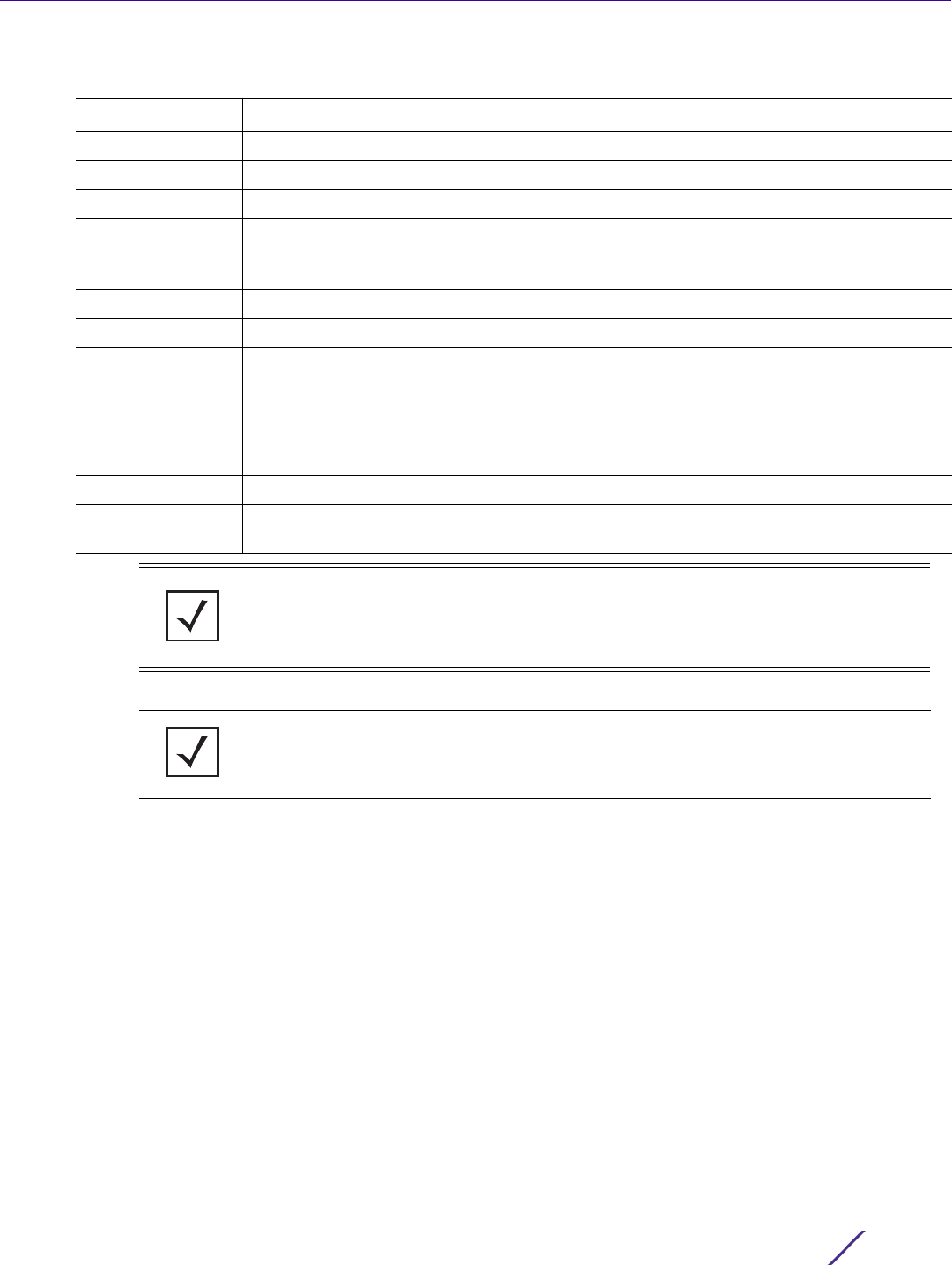
GLOBAL CONFIGURATION COMMANDS
Access Point, Wireless Controller and Service Platform CLI Reference Guide 4 - 8
self Displays a logged device’s configuration context page 4-426
sensor-policy Creates a sensor policy and enters its configuration mode page 4-427
smart-rf-policy Creates a Smart RF policy and enters its configuration mode page 4-436
t5 Configures a t5 wireless controller. This command is applicable only on
the RFS4000, RFS6000, NX7500, NX7510, NX7520, NX7530, NX9500,
NX9510, NX9600, and VX9000 platforms.
page 4-438
web-filter-policy Creates a Web Filtering policy and enters its configuration mode page 4-440
wips-policy Creates a WIPS policy and enters its configuration mode page 4-451
wlan Creates a Wireless Local Area Network (WLAN) and enters its
configuration mode
page 4-452
wlan-qos-policy Creates a WLAN QoS policy and enters its configuration mode page 4-549
url-filter Creates an URL filter and enters its configuration mode. URL filtering is
a licensed feature.
page 4-551
url-list Creates an URL list and enters its configuration mode. page 4-565
vx9000 Configures a Virtual WLAN Controller (V-WLC) in a virtual machine
(VM) environment
page 4-571
Table 4.1 Global Config Commands
Command Description Reference
NOTE: For more information on common commands (clrscr, commit, help, revert,
service, show, write, and exit), see COMMON COMMANDS.
NOTE: The input parameter <HOSTNAME>, wherever used in syntaxes across this
chapter, cannot include an underscore (_) character.

GLOBAL CONFIGURATION COMMANDS
Access Point, Wireless Controller and Service Platform CLI Reference Guide 4 - 9
4.1.1 aaa-policy
Global Configuration Commands
Configures an Authentication, Accounting, and Authorization (AAA) policy. Network administrators can use
an AAA policy to define access control within the network.
A controller, service platform, or access point can interoperate with external RADIUS and LDAP servers
(AAA Servers) to provide an additional user database and authentication resource. Each WLAN can
maintain its own unique AAA configuration. Up to six servers can be configured for providing AAA
services.
Supported in the following platforms:
• Access Points — AP6521, AP6522, AP6532, AP6562, AP7161, AP7502, AP7522, AP7532, AP7562,
AP7602, AP7612, AP7622, AP7632, AP7662, AP81XX, AP82XX, AP8432, AP8533
• Wireless Controllers — RFS4000, RFS6000
• Service Platforms — NX5500, NX7500, NX7510, NX7520, NX7530, NX9500, NX9510, NX9600,
VX9000
Syntax
aaa-policy <AAA-POLICY-NAME>
Parameters
• aaa-policy <AAA-POLICY-NAME>
Example
rfs6000-81742D(config)#aaa-policy test
rfs6000-81742D(config-aaa-policy-test)#?
AAA Policy Mode commands:
accounting Configure accounting parameters
attribute Configure RADIUS attributes in access and accounting
requests
authentication Configure authentication parameters
health-check Configure server health-check parameters
mac-address-format Configure the format in which the MAC address must be
filled in the Radius-Request frames
no Negate a command or set its defaults
proxy-attribute Configure radius attribute behavior when proxying
through controller or rf-domain-manager
server-pooling-mode Configure the method of selecting a server from the
pool of configured AAA servers
use Set setting to use
clrscr Clears the display screen
commit Commit all changes made in this session
do Run commands from Exec mode
end End current mode and change to EXEC mode
exit End current mode and down to previous mode
help Description of the interactive help system
revert Revert changes
service Service Commands
show Show running system information
write Write running configuration to memory or terminal
rfs6000-81742D(config-aaa-policy-test)#
Related Commands
<AAA-POLICY-NAME> Specify the AAA policy name. If the policy does not exist, it is created.
no Removes an existing AAA policy

GLOBAL CONFIGURATION COMMANDS
Access Point, Wireless Controller and Service Platform CLI Reference Guide 4 - 10
NOTE: For more information on the AAA policy commands, see Chapter 8, AAA-
POLICY.

GLOBAL CONFIGURATION COMMANDS
Access Point, Wireless Controller and Service Platform CLI Reference Guide 4 - 11
4.1.2 alias
Global Configuration Commands
Configures the following types of aliases: network, VLAN, host, string, network-service, etc.
Aliases are objects having a unique name and content that is determined by the alias type (network, VLAN,
and network-service).
A typical large enterprize network consists of multiple sites (RF Domains) having similar configuration
parameters with few elements that vary, such as networks or network ranges, hosts having different IP
addresses, and VLAN IDs or URLs. These elements can be defined as aliases (object oriented wireless
firewalls) and used across sites by applying overrides to the object definition. Using aliases results in a
configuration that is easier to understand and maintain.
Multiple instances of an alias (same type and same name) can be defined at any of the following levels:
global, RF Domain, profile, or device. An alias defined globally functions as a top-level-object (TLO). An
alias defined on a device is applicable to that device only. An alias defined on a profile applies to every
device using the profile. Similarly, aliases defined at the RF Domain level apply to all devices within that
domain.
Aliases defined at any given level can be overridden at any of the next lower levels. For example, a global
alias can be redefined on a selected set of RF Domains, profiles, or devices. Overrides applied at the device
level take precedence.
The different aliases types supported are:
• address-range alias – Maps a user-friendly name to a range of IP addresses. An address-range alias
can be utilized at different deployments. For example, if an ACL defines a pool of network
addresses as 192.168.10.10 through 192.168.10.100 for an entire network, and a remote location’s
network range is 172.16.13.20 through 172.16.13.110, the remote location’s ACL can be overridden
using an alias. At the remote location, the ACL works with the 172.16.13.20-110 address range. A new
ACL need not be created specifically for the remote deployment location.
• host alias – Maps a user-friendly name to a specific host (identified by its IP address. For example,
192.168.10.23). A host alias can be utilized at different deployments. For example, if a central
network DNS server is set a static IP address, and a remote location’s local DNS server is defined,
this host can be overridden at the remote location. At the remote location, the network is
functional with a local DNS server, but uses the name set at the central network. A new host need
not be created at the remote location. This simplifies creating and managing hosts and allows an
administrator to better manage specific local requirements.
• network alias – Maps a user-friendly name to a network. A network alias can be utilized at different
deployments. For example, if a central network ACL defines a network as 192.168.10.0/24, and a
remote location’s network range is 172.16.10.0/24, the ACL can be overridden at the remote location
to suit their local (but remote) requirement. At the remote location, the ACL functions with the
172.16.10.0/24 network. A new ACL need not be created specifically for the remote deployment. This
simplifies ACL definition and allows an administrator to better manage specific local requirements.
• network-group alias – Maps a user-friendly name to a single or a range of addresses of devices,
hosts, and network configurations. Network configurations are complete networks in the form
192.168.10.0/24 or IP address range in the form 192.168.10.10-192.168.10.20.
A network-group alias can contain a maximum of eight (8) host entries, eight (8) network entries, and
eight (8) IP address-range entries. A maximum of 32 network-group alias entries can be created.

GLOBAL CONFIGURATION COMMANDS
Access Point, Wireless Controller and Service Platform CLI Reference Guide 4 - 12
A network-group alias can be used in IP firewall rules to substitute hosts, subnets, and IP address
ranges.
• network-service alias – Maps a user-friendly name to service protocols and ports. Both source and
destination ports are configurable. For each protocol, up to 2 source port ranges and up to 2
destination port ranges can be configured. A maximum of 4 protocol entries can be configured per
network-service alias. When used with an ACL, the network-service alias defines the service-
specific components of the ACL rule. Overrides can be applied to the service alias, at the device
level, without modifying the ACL. Application of overrides to the service alias allows an ACL to be
used across sites.
Use a network-service alias to associate more than one IP address to a network interface, providing
multiple connections to a network from a single IP node.
• number alias – Maps a user-friendly name to a number
• vlan alias – Maps a user-friendly name to a VLAN ID. A VLAN alias can be used at different
deployments. For example, if a named VLAN is defined as 10 for the central network, and the VLAN
is set at 26 at a remote location, the VLAN can be overridden at the deployment location with an
alias. At the remote deployment location, the network is functional with a VLAN ID of 26, but
utilizes the name defined at the centrally managed network. A new VLAN need not be created
specifically for the remote deployment.
• string alias – Maps a user-friendly name to a specific string (for example, RF Domain name). A
string alias can be utilized at different deployments. For example, if the main domain at a remote
location is called loc1.domain.com and at another deployment location it is called loc2.domain.com,
the alias can be overridden at the remote location to suit the local (but remote) requirement. At
one remote location, the alias functions with the loc1.domain.com domain and at the other with the
loc2.domain.com domain.
• encrypted-string alias – Maps a user-friendly name to a string value. The string value of this alias is
encrypted when "password-encryption" is enabled. Encrypted-string aliases can be used for string
configuration parameters that are encrypted by the "password-encryption" feature.
• hashed-string alias – Maps a user-friendly name to a hashed-string value. Hashed-string aliases can
be used for string configuration parameters that are hashed, such as passwords.
Supported in the following platforms:
• Access Points — AP6521, AP6522, AP6532, AP6562, AP7161, AP7502, AP7522, AP7532, AP7562,
AP7602, AP7612, AP7622, AP7632, AP7662, AP81XX, AP82XX, AP8432, AP8533
• Wireless Controllers — RFS4000, RFS6000
• Service Platforms — NX5500, NX7500, NX7510, NX7520, NX7530, NX9500, NX9510, NX9600,
VX9000
Syntax
alias [address-range|encrypted-string|hashed-string|host|network|network-group|
network-service|number|string|vlan]
alias address-range <ADDRESS-RANGE-ALIAS-NAME> <STARTING-IP> to <ENDING-IP>
alias encrypted-string <ENCRYPTED-STRING-ALIAS-NAME> [0|2] <LINE>
alias hashed-string <HASHED-STRING-ALIAS-NAME> <LINE>
alias host <HOST-ALIAS-NAME> <HOST-IP>
alias network <NETWORK-ALIAS-NAME> <NETWORK-ADDRESS/MASK>
alias network-group <NETWORK-GROUP-ALIAS-NAME> [address-range|host|network]

GLOBAL CONFIGURATION COMMANDS
Access Point, Wireless Controller and Service Platform CLI Reference Guide 4 - 13
alias network-group <NETWORK-GROUP-ALIAS-NAME> [address-range <STARTING-IP> to
<ENDING-IP> {<STARTING-IP> to <ENDING-IP>}|host <HOST-IP> {<HOST-IP>}|network
<NETWORK-ADDRESS/MASK> {<NETWORK-ADDRESS/MASK>}]
alias network-service <NETWORK-SERVICE-ALIAS-NAME> proto [<0-254>|<WORD>|eigrp|
gre|igmp|igp|ospf|vrrp] {(<1-65535>|<WORD>|bgp|dns|ftp|ftp-data|gopher|https|
ldap|nntp|ntp|pop3|proto|sip|smtp|sourceport|ssh|telnet|tftp|www)}
alias network-service <NETWORK-SERVICE-ALIAS-NAME> proto [<0-254>|<WORD>|eigrp|
gre|igmp|igp|ospf|vrrp] {(<1-65535>|<WORD>|bgp|dns|ftp|ftp-data|gopher|https|
ldap|nntp|ntp|pop3|proto|sip|smtp|sourceport [<1-65535>|<WORD>]|ssh|telnet|
tftp|www)}
alias number <NUMBER-ALIAS-NAME> <0-4294967295>
alias string <STRING-ALIAS-NAME> <LINE>
alias vlan <VLAN-ALIAS-NAME> <1-4094>
Parameters
• alias address-range <ADDRESS-RANGE-ALIAS-NAME> <STARTING-IP> to <ENDING-IP>
• alias encrypted-string <ENCRYPTED-STRING-ALIAS-NAME> [0|2] <LINE>
address-range
<ADDRESS-RANGE-
ALIAS-NAME>
Creates an address-range alias, defining a range of IP addresses
• <ADDRESS-RANGE-ALIAS-NAME> – Specify the address-range alias name.
Alias name should begin with ‘$’.
<STARTING-IP>
to <ENDING-IP>
Associates a range of IP addresses with this address-range alias
• <STARTING-IP> – Specify the first IP address in the range.
• to <ENDING-IP> – Specify the last IP address in the range.
encrypted-string
<ENCRYPTED-
STRING-ALIAS-
NAME>
Creates an alias for an encrypted string. Use this alias for string configuration values
that are encrypted when "password-encryption" is enabled. For example, in the
management-policy, use it to define the SNMP community string. For more
information, see snmp-server.
• <ENCRYPTED-STRING-ALIAS-NAME> – Specify the encrypted-string alias name.
Alias name should begin with ‘$’.
[0|2] <LINE> Configures the value associated with the alias name specified in the previous step
• [0|2] <LINE> – Configures the alias value
Note, if password-encryption is enabled, in the show > running-config output, this
clear text is displayed as an encrypted string, as shown below:
nx9500-6C8809(config)#show running-config
!...............................
alias encrypted-string $enString 2
fABMK2is7UToNiZE3MQXbgAAAAxB0ZIysdqsEJwr6AH/Da//
!
--More--
nx9500-6C8809
In the above show > running-config output, the ‘2’ displayed before the encrypted-
string alias value indicates that the displayed text is encrypted and not a clear text.
Cotnd..

GLOBAL CONFIGURATION COMMANDS
Access Point, Wireless Controller and Service Platform CLI Reference Guide 4 - 14
• alias hashed-string <HASHED-STRING-ALIAS-NAME> <LINE>
• alias host <HOST-ALIAS-NAME> <HOST-IP>
• alias network <NETWORK-ALIAS-NAME> <NETWORK-ADDRESS/MASK>
However, if password-encryption is disabled the clear text is displayed as is:
nx9500-6C8809(config)#show running-config
!...............................
!
alias encrypted-string $enString 0 test11223344
!
--More--
nx9500-6C8809
For more information on enabling password-encryption, see password-encryption.
hashed-string
<HASHED-STRING-
ALIAS-NAME>
Creates an alias for a hashed string. Use this alias for configuration values that are
hashed strings, such as passwords. For example, in the management-policy, use it to
define the privilege mode password. For more information, see .
• <HASHED-STRING-ALIAS-NAME> – Specify the hashed-string alias name.
Alias name should begin with ‘$’.
<LINE> Configures the hashed-string value associated with this alias.
nx9500-6C8809(config)#show running-config
!
alias encrypted-string $WRITE 2
sBqVCDAoxs3oByF5PCSuFAAAAAd7HT2+EiT/l/BXm9c4SBDv
!
alias hashed-string $PriMode 1
faffdde27cb49ad634ea20df4f7c8ef2685894d10ffcb1b2efba054112ec
fc75
0--More--
nx9500-6C8809
In the above show > running-config output, the ‘1’ displayed before the hashed-string
alias value indicates that the displayed text is hashed and not a clear text.
host
<HOST-ALIAS-NAME>
Creates a host alias, defining a single network host
• <HOST-ALIAS-NAME> – Specify the host alias name.
Alias name should begin with ‘$’.
<HOST-IP> Associates the network host’s IP address with this host alias. For example, ‘alias host
$HOST 1.1.1.100’. In this example, the host alias name is: $HOST and the host IP
address it is mapped to is: 1.1.1.100.
• <HOST-IP> – Specify the network host’s IP address.
network
<NETWORK-ALIAS-
NAME>
Creates a network alias, defining a single network address
• <NETWORK-ALIAS-NAME> – Specify the network alias name.
Alias name should begin with ‘$’.
<NETWORK-
ADDRESS/MASK>
Associates a single network with this network alias. For example, ‘alias network $NET
1.1.1.0/24’. In this example, the network alias name is: $NET and the network it is
mapped to is: 1.1.1.0/24.
• <NETWORK-ADDRESS/MASK> – Specify the network’s address and mask.

GLOBAL CONFIGURATION COMMANDS
Access Point, Wireless Controller and Service Platform CLI Reference Guide 4 - 15
• alias network-group <NETWORK-GROUP-ALIAS-NAME> [address-range <STARTING-IP> to
<ENDING-IP> {<STARTING-IP> to <ENDING-IP>}|host <HOST-IP> {<HOST-IP>}|
network <NETWORK-ADDRESS/MASK> {<NETWORK-ADDRESS/MASK>}]
• alias network-service <NETWORK-SERVICE-ALIAS-NAME> proto [<0-254>|<WORD>|
eigrp|gre|igmp|igp|ospf|vrrp] {(<1-65535>|<WORD>|bgp|dns|ftp|ftp-data|gopher|
https|ldap|nntp|ntp|pop3|proto|sip|smtp|sourceport [<1-65535>|<WORD>]|ssh|telnet|
tftp|www)}
network
<NETWORK-GROUP-
ALIAS-NAME>
Creates a network-group alias
• <NETWORK-GROUP-ALIAS-NAME> – Specify the network-group alias name.
Alias name should begin with ‘$’.
The network-group aliases are used in ACLs, to define the network-specific
components. ACLs using aliases can be used across sites by re-defining the network-
group alias elements at the device or profile level.
After specifying the name, specify the following: a range of IP addresses, host
addresses, or a range of network addresses.
address-range
<STARTING-IP>
to <ENDING-IP>
{<STARTING-IP>
to <ENDING-IP>}
Associates a range of IP addresses with this network-group alias
• <STARTING-IP> – Specify the first IP address in the range.
• to <ENDING-IP> – Specify the last IP address in the range.
• <STARTING-IP> to <ENDING-IP> – Optional. Specifies more than one range of IP
addresses. A maximum of eight (8) IP address ranges can be configured.
host <HOST-IP>
{<HOST-IP>}
Associates a single or multiple hosts with this network-group alias
• <HOST-IP> – Specify the hosts’ IP address.
• <HOST-IP> – Optional. Specifies more than one host. A maximum of eight (8) hosts
can be configured.
network <NETWORK-
ADDRESS/MASK>
{<NETWORK-
ADDRESS/MASK>}
Associates a single or multiple networks with this network-group alias
• <NETWORK-ADDRESS/MASK> – Specify the network’s address and mask.
• <NETWORK-ADDRESS/MASK> – Optional. Specifies more than one network. A
maximum of eight (8) networks can be configured.
alias network-service
<NETWORK-
SERVICE-ALIAS-
NAME>
Configures an alias that specifies available network services and the corresponding
source and destination software ports
• <NETWORK-SERVICE-ALIAS-NAME> – Specify a network-service alias name.
Alias name should begin with ‘$’.
Network-service aliases are used in ACLs, to define the service-specific components.
ACLs using aliases can be used across sites by re-defining the network-service alias
elements at the device or profile level.
proto [<0-254>|
<WORD>|eigrp|gre|
igmp|igp|ospf|vrrp]
Use one of the following options to associate an Internet protocol with this network-
service alias:
• <0-254> – Identifies the protocol by its number. Specify the protocol number from 0
- 254. This is the number by which the protocol is identified in the Protocol field of the
IPv4 header and the Next Header field of IPv6 header. For example, the User Datagram
Protocol’s (UDP) designated number is 17.
• <WORD> – Identifies the protocol by its name. Specify the protocol name.
• eigrp – Selects Enhanced Interior Gateway Routing Protocol (EIGRP). The protocol
number 88.
Contd..

GLOBAL CONFIGURATION COMMANDS
Access Point, Wireless Controller and Service Platform CLI Reference Guide 4 - 16
•gre – Selects Generic Routing Encapsulation (GRE). The protocol number is 47.
• igmp – Selects Internet Group Management Protocol (IGMP). The protocol number is
2.
•igp – Selects Interior Gateway Protocol (IGP). The protocol number is 9.
•ospf – Selects Open Shortest Path First (OSPF). The protocol number is 89.
• vrrp – Selects Virtual Router Redundancy Protocol (VRRP). The protocol number is 112.
{(<1-65535>|
<WORD>|
bgp|dns|ftp|ftp-data|
gopher|https|ldap|
nntp|ntp|pop3|proto|
sip|smtp|sourceport
[<1-65535>|
<WORD>]|ssh|telnet|
tftp|www)}
After specifying the protocol, you may configure a destination port for this service.
These keywords are recursive and you can configure multiple protocols and associate
multiple destination and source ports.
• <1-65535> – Optional. Configures a destination port number from 1 - 65535
• <WORD> – Optional. Identifies the destination port by the service name provided. For
example, the secure shell (SSH) service uses TCP port 22.
• bgp – Optional. Configures the default Border Gateway Protocol (BGP) services port
(179)
• dns – Optional. Configures the default Domain Name System (DNS) services port (53)
• ftp – Optional. Configures the default File Transfer Protocol (FTP) control services port
(21)
• ftp-data – Optional. Configures the default FTP data services port (20)
• gopher – Optional. Configures the default gopher services port (70)
• https – Optional. Configures the default HTTPS services port (443)
• ldap – Optional. Configures the default Lightweight Directory Access Protocol (LDAP)
services port (389)
• nntp – Optional. Configures the default Newsgroup (NNTP) services port (119)
• ntp – Optional. Configures the default Network Time Protocol (NTP) services port
(123)
• POP3 – Optional. Configures the default Post Office Protocol (POP3) services port
(110)
• proto – Optional. Use this option to select another Internet protocol in addition to the
one selected in the previous step.
• sip – Optional. Configures the default Session Initiation Protocol (SIP) services port
(5060)
• smtp – Optional. Configures the default Simple Mail Transfer Protocol (SMTP) services
port (25)
• sourceport [<1-65535>|<WORD>] – Optional. After specifying the destination port,
you may specify a single or range of source ports.
• <1-65535> – Specify the source port from 1 - 65535.
• <WORD> – Specify the source port range, for example 1-10.
• ssh – Optional. Configures the default SSH services port (22)
• telnet – Optional. Configures the default Telnet services port (23)
• tftp – Optional. Configures the default Trivial File Transfer Protocol (TFTP) services
port (69)

GLOBAL CONFIGURATION COMMANDS
Access Point, Wireless Controller and Service Platform CLI Reference Guide 4 - 17
• alias number <NUMBER-ALIAS-NAME> <0-4294967295>
• alias string <STRING-ALIAS-NAME> <LINE>
• alias vlan <VLAN-ALIAS-NAME> <1-4094>
Example
rfs4000-229D58(config)##alias address-range $AddRanAlias 192.168.13.10 to
192.168.13.13
rfs4000-229D58(config)#alias network $NetworkAlias 192.168.13.0/24
rfs4000-229D58(config)#alias host $HostAlias 192.168.13.100
rfs4000-229D58(config)#alias vlan $VlanAlias 1
rfs4000-229D58(config)#alias address-range $AddRangeAlias 192.168.13.2 to 192.16
8.13.10
rfs4000-229D58(config)#alias network-service $NetServAlias proto igmp
alias number
<NUMBER-ALIAS-
NAME> <0-
4294967295>
Creates a number alias identified by the <NUMBER-ALIAS-NAME> keyword. Number
aliases map a name to a numeric value. For example, ‘alias number $NUMBER 100’
• The number alias name is: $NUMBER
• The value assigned is: 100
The value referenced by alias $NUMBER, wherever used, is 100.
• <NUMBER-ALIAS-NAME> – Specify the number alias name.
• <0-4294967295> – Specify the number, from 0 - 4294967295, assigned to the
number alias created.
Alias name should begin with ‘$’.
alias string
<STRING-ALIAS-
NAME>
Creates a string alias identified by the <STRING-ALIAS-NAME> keyword
• <STRING-ALIAS-NAME> – Specify the string alias name.
• <LINE> – Specify the string value associated with the specified <STRING-ALIAS-
NAME> keyword.
String aliases map a name to an arbitrary string value. For example, ‘alias string
$DOMAIN test.example_company.com’.
• The string alias name is: $DOMAIN
• The value assigned is: test.example_company.com (a domain name)
The value referenced by alias $DOMAIN, wherever used, is
test.example_company.com.
Alias name should begin with ‘$’.
You can also use a string alias to configure the Bonjour Service instance name. Once
configured, use the string alias in the Bonjour Gateway Discovery Policy context to
specify the Bonjour service instance name to be used as the match criteria. For more
information, see allow-service.
alias vlan
<VLAN-ALIAS-NAME>
Creates a VLAN alias identified by the <VLAN-ALIAS-NAME> keyword
• <VLAN-ALIAS-NAME> – Specify the VLAN alias name.
Alias name should begin with ‘$’.
<1-4094> Maps the VLAN alias to a VLAN ID
• <1-4094> – Specify the VLAN ID from 1 - 4094.

GLOBAL CONFIGURATION COMMANDS
Access Point, Wireless Controller and Service Platform CLI Reference Guide 4 - 18
rfs4000-229D58(config)#show running-config | include alias
alias network-group $NetGrAlias address-range 192.168.13.7 to 192.168.13.9
192.168.13.20 to 192.168.13.25
alias network $NetworkAlias 192.168.13.0/24
alias host $HostAlias 192.168.13.10
alias address-range $AddRangeAlias 192.168.13.2 to 192.168.13.10
alias network-service $NetServAlias proto igmp
alias vlan $VlanAlias 1
rfs4000-229D58(config)#
nx9500-6C8809(config)#alias number $NUMBER 100
nx9500-6C8809(config)#show context include-factory | include alias
alias string $DOMAIN test.examplecompany.com
alias string $DOMAIN2 test.example_company.com
alias number $NUMBER 100
alias string $SN B4C7996C8809
nx9500-6C8809(config)#
The following examples show encrypted-string alias configuration:
nx9500-6C8809(config)#alias encrypted-string $WRITE 0 private
nx9500-6C8809(config)#alias encrypted-string $READ 0 public
nx9500-6C8809(config)#show context | include alias
alias vlan $BLR-01 1
alias string $IN-Blr-EcoSpace-Floor-4 IBEF4
alias encrypted-string $READ 0 public
alias encrypted-string $WRITE 0 private
nx9500-6C8809(config)#
The following example shows the encrypted-string aliases, configured in the previous example, used in
the management-policy:
nx9500-6C8809(config-management-policy-default)#snmp-server community 0 $WRITE rw
nx9500-6C8809(config-management-policy-default)#snmp-server community 0 $READ ro
nx9500-6C8809(config-management-policy-default)#show context
management-policy default
no telnet
no http server
https server
rest-server
ssh
user admin password 1
ad4d8797f007444ccdda3788b9ee0e8b46f3facb4308e045239eb7771e127ed5 role superuser
access all
snmp-server community 0 $WRITE rw
snmp-server community 0 $READ ro
snmp-server user snmptrap v3 encrypted des auth md5 2 yqr96yyVzmD4ZbU2I7Eh/
QAAAAjWNKa4KXF95pruUCSnhOiT
snmp-server user snmpmanager v3 encrypted des auth md5 2 NOf8+2+AY2r4ZbU2I7Eh/
QAAAAgc0l8ahJYo3AjHo9wXzYGo
t5 snmp-server community public ro 192.168.0.1
t5 snmp-server community private rw 192.168.0.1
nx9500-6C8809(config-management-policy-default)#
The following example shows hashed-string alias configuration:
nx9500-6C8809(config)#alias hashed-string $PriMode Test12345
nx9500-6C8809(config)#show context | include alias
alias vlan $BLR-01 1
alias string $IN-Blr-EcoSpace-Floor-4 IBEF4
alias encrypted-string $READ 0 public
alias encrypted-string $WRITE 0 private
alias hashed-string $PriMode 1
faffdde27cb49ad634ea20df4f7c8ef2685894d10ffcb1b2efba054112ecfc75
nx9500-6C8809(config)#

GLOBAL CONFIGURATION COMMANDS
Access Point, Wireless Controller and Service Platform CLI Reference Guide 4 - 19
The following example shows the hashed-string alias, configured in the previous example, used in the
management-policy:
nx9500-6C8809(config-management-policy-default)#show context
management-policy default
https server
rest-server
ssh
user admin password 1
ad4d8797f007444ccdda3788b9ee0e8b46f3facb4308e045239eb7771e127ed5 role superuser
access all
snmp-server community 0 $WRITE rw
snmp-server community 0 $READ ro
snmp-server user snmptrap v3 encrypted des auth md5 2 yqr96yyVzmD4ZbU2I7Eh/
QAAAAjWNKa4KXF95pruUCSnhOiT
snmp-server user snmpmanager v3 encrypted des auth md5 2 NOf8+2+AY2r4ZbU2I7Eh/
QAAAAgc0l8ahJYo3AjHo9wXzYGo
t5 snmp-server community public ro 192.168.0.1
t5 snmp-server community private rw 192.168.0.1
privilege-mode-password $PriMode
nx9500-6C8809(config-management-policy-default)#
Related Commands
no Removes an existing network, VLAN, service, string, etc. alias

GLOBAL CONFIGURATION COMMANDS
Access Point, Wireless Controller and Service Platform CLI Reference Guide 4 - 20
4.1.3 aaa-tacacs-policy
Global Configuration Commands
Configures AAA Terminal Access Controller Access-Control System+ (TACACS) policy. TACACS+ is a
protocol created by CISCO Systems which provides access control to network devices such as routers,
network access servers and other networked computing devices through one or more centralized servers.
TACACS provides separate authentication, authorization, and accounting services running on different
servers.
TACACS controls user access to devices and network resources while providing separate accounting,
authentication, and authorization services. Some of the services provided by TACACS are:
• Authorizing each command with the TACACS+ server before execution.
• Accounting each session’s logon and log off events.
• Authenticating each user with the TACACS+ server before enabling access to network resources.
Supported in the following platforms:
• Access Points — AP6521, AP6522, AP6532, AP6562, AP7161, AP7502, AP7522, AP7532, AP7562,
AP7602, AP7612, AP7622, AP7632, AP7662, AP81XX, AP82XX, AP8432, AP8533
• Wireless Controllers — RFS4000, RFS6000
• Service Platforms — NX5500, NX7500, NX7510, NX7520, NX7530, NX9500, NX9510, NX9600,
VX9000
Syntax
aaa-tacacs-policy <AAA-TACACS-POLICY-NAME>
Parameters
• aaa-tacacs-policy <AAA-TACACS-POLICY-NAME>
Example
rfs6000-81742D(config)#aaa-tacacs-policy testpolicy
rfs6000-81742D(config-aaa-tacacs-policy-testpolicy)#?
AAA TACACS Policy Mode commands:
accounting Configure accounting parameters
authentication Configure authentication parameters
authorization Configure authorization parameters
no Negate a command or set its defaults
clrscr Clears the display screen
commit Commit all changes made in this session
do Run commands from Exec mode
end End current mode and change to EXEC mode
exit End current mode and down to previous mode
help Description of the interactive help system
revert Revert changes
service Service Commands
show Show running system information
write Write running configuration to memory or terminal
rfs6000-81742D(config-aaa-tacacs-policy-testpolicy)#
Related Commands
<AAA-TACACS-POLICY-
NAME>
Specify the AAA-TACACS policy name. If the policy does not exist, it is created.
no Removes an existing AAA TACACS policy

GLOBAL CONFIGURATION COMMANDS
Access Point, Wireless Controller and Service Platform CLI Reference Guide 4 - 21
NOTE: For more information on the AAA-TACACS policy commands, see
Chapter 25, AAA-TACACS-POLICY.

GLOBAL CONFIGURATION COMMANDS
Access Point, Wireless Controller and Service Platform CLI Reference Guide 4 - 22
4.1.4 ap6521
Global Configuration Commands
Adds an AP6521 to the network. If a profile for the AP is not available, a new profile is created.
Supported in the following platforms:
• Access Point — AP6521
• Wireless Controllers — RFS4000, RFS6000
• Service Platforms — NX5500, NX7500, NX7510, NX7520, NX7530, NX9500, NX9510, NX9600,
VX9000
Syntax
ap6521 <MAC>
Parameters
• ap6521 <MAC>
Example
nx9500-6C8809(config)#ap6521 FC-0A-81-42-93-6C
nx9500-6C8809(config-device-FC-0A-81-42-93-6C)#show context
ap6521 FC-0A-81-42-93-6C
use profile default-ap6521
use rf-domain default
hostname ap6521-42936C
nx9500-6C8809(config-device-FC-0A-81-42-93-6C)#
nx9500-6C8809(config)#show wireless ap configured
--------------------------------------------------------------------------------
-------
IDX NAME MAC PROFILE RF-DOMAIN ADOPTED-BY
--------------------------------------------------------------------------------
-------
1 ap6521-42936C FC-0A-81-42-93-6C default-ap6521 default B4-C7-
99-6C-88-09
--------------------------------------------------------------------------------
-------
nx9500-6C8809(config)#
Related Commands
<MAC> Specify the AP6521’s MAC address.
no Removes an AP6521 from the network

GLOBAL CONFIGURATION COMMANDS
Access Point, Wireless Controller and Service Platform CLI Reference Guide 4 - 23
4.1.5 ap6522
Global Configuration Commands
Adds an AP6522 to the network. If a profile for the AP is not available, a new profile is created.
Supported in the following platforms:
• Access Point — AP6522
• Wireless Controllers — RFS4000, RFS6000
• Service Platforms — NX5500, NX7500, NX7510, NX7520, NX7530, NX9500, NX9510, NX9600,
VX9000
Syntax
ap6522 <MAC>
Parameters
• ap6522 <MAC>
Example
nx9500-6C8809(config)#ap6522 B4-C7-99-58-72-58
nx9500-6C8809(config-device-B4-C7-99-58-72-58)#show context
ap6522 B4-C7-99-58-72-58
use profile default-ap6522
use rf-domain default
hostname ap6522-587258
nx9500-6C8809(config-device-B4-C7-99-58-72-58)#
nx9500-6C8809(config)#show wireless ap configured
--------------------------------------------------------------------------------
-------
IDX NAME MAC PROFILE RF-DOMAIN ADOPTED-BY
--------------------------------------------------------------------------------
-------
1 ap6521-42936C FC-0A-81-42-93-6C default-ap6521 default B4-C7-
99-6C-88-09
2 ap6522-587258 B4-C7-99-58-72-58 default-ap6522 default B4-C7-99-6C-
88-09
--------------------------------------------------------------------------------
-------
nx9500-6C8809(config)#
Related Commands
<MAC> Specify the AP6522’s MAC address.
no Removes an AP6522 from the network

GLOBAL CONFIGURATION COMMANDS
Access Point, Wireless Controller and Service Platform CLI Reference Guide 4 - 24
4.1.6 ap6532
Global Configuration Commands
Adds an AP6532 to the network. If a profile for the AP is not available, a new profile is created.
Supported in the following platforms:
• Access Point — AP6532
• Wireless Controllers — RFS4000, RFS6000
• Service Platforms — NX5500, NX7500, NX7510, NX7520, NX7530, NX9500, NX9510, NX9600,
VX9000
Syntax
ap6532 <MAC>
Parameters
• ap6532 <MAC>
Example
nx9500-6C8809(config)#ap6532 00-23-68-31-16-59
nx9500-6C8809(config-device-B4-C7-99-58-72-58)#show context
ap6532 00-23-68-31-16-59
use profile default-ap6532
use rf-domain default
hostname ap6532-311659
nx9500-6C8809(config-device-00-23-68-31-16-59)#
nx9500-6C8809(config)#show wireless ap configured
--------------------------------------------------------------------------------
-------
IDX NAME MAC PROFILE RF-DOMAIN ADOPTED-BY
--------------------------------------------------------------------------------
-------
1 ap6521-42936C FC-0A-81-42-93-6C default-ap6521 default B4-C7-
99-6C-88-09
2 ap6522-587258 B4-C7-99-58-72-58 default-ap6522 default B4-C7-99-6C-
88-09
3 ap6532-311659 00-23-68-31-16-59 default-ap6532 default B4-C7-99-6C-
88-09
--------------------------------------------------------------------------------
-------
nx9500-6C8809(config)#
Related Commands
<MAC> Specify the AP6532’s MAC address.
no Removes an AP6532 from the network

GLOBAL CONFIGURATION COMMANDS
Access Point, Wireless Controller and Service Platform CLI Reference Guide 4 - 25
4.1.7 ap6562
Global Configuration Commands
Adds an AP6562 to the network. If a profile for the AP is not available, a new profile is created.
Supported in the following platforms:
• Access Point — AP6562
• Wireless Controllers — RFS4000, RFS6000
• Service Platforms — NX5500, NX7500, NX7510, NX7520, NX7530, NX9500, NX9510, NX9600,
VX9000
Syntax
ap6562 <MAC>
Parameters
• ap6562 <MAC>
Example
nx9500-6C8809(config)#ap6562 00-23-09-0E-12-60
nx9500-6C8809(config-device-00-23-09-0E-12-60)#show context
ap6562 00-23-09-0E-12-60
use profile default-ap6562
use rf-domain default
hostname ap6562-0E1260
nx9500-6C8809(config-device-00-23-09-0E-12-60)#
nx9500-6C8809(config)#show wireless ap configured
--------------------------------------------------------------------------------
-------
IDX NAME MAC PROFILE RF-DOMAIN ADOPTED-BY
--------------------------------------------------------------------------------
-------
1 ap6521-42936C FC-0A-81-42-93-6C default-ap6521 default B4-C7-
99-6C-88-09
2 ap6522-587258 B4-C7-99-58-72-58 default-ap6522 default B4-C7-99-6C-
88-09
3 ap6532-311659 00-23-68-31-16-59 default-ap6532 default B4-C7-99-6C-
88-09
4 ap6562-0E1260 00-23-09-0E-12-60 default-ap6562 default B4-C7-99-
6C-88-09
--------------------------------------------------------------------------------
-------
nx9500-6C8809(config)#
Related Commands
<MAC> Specify the AP6562’s MAC address.
no Removes an AP6562 from the network

GLOBAL CONFIGURATION COMMANDS
Access Point, Wireless Controller and Service Platform CLI Reference Guide 4 - 26
4.1.8 ap71xx
Global Configuration Commands
Adds an AP7161 series to the network. If a profile for the AP is not available, a new profile is created.
Supported in the following platforms:
• Access Point — AP7161
• Wireless Controllers — RFS4000, RFS6000
• Service Platforms — NX5500, NX7500, NX7510, NX7520, NX7530, NX9500, NX9510, NX9600,
VX9000
Syntax
ap71xx <MAC>
Parameters
• ap71xx <MAC>
Example
nx9500-6C8809(config)#ap71xx 00-23-68-11-E6-C4
nx9500-6C8809(config-device-00-23-68-11-E6-C4)#show context
ap71xx 00-23-68-11-E6-C4
use profile default-ap71xx
use rf-domain TechPubs
hostname ap71xx-11E6C4
no staging-config-learnt
ip default-gateway 192.168.13.2
interface vlan1
ip address 192.168.13.23/24
use auto-provisioning-policy TecPubs
no auto-learn staging-config
adopter-auto-provisioning-policy-lookup evaluate-always
nx9500-6C8809(config-device-00-23-68-11-E6-C4)#
nx9500-6C8809(config)#show wireless ap configured
--------------------------------------------------------------------------------
-------
IDX NAME MAC PROFILE RF-DOMAIN ADOPTED-BY
--------------------------------------------------------------------------------
-------
1 ap71xx-11E6C4 00-23-68-11-E6-C4 default-ap71xx TechPubs un-adopted
2 ap7532-80C2AC 84-24-8D-80-C2-AC default-ap7532 TechPubs B4-C7-99-
6C-88-09
3 ap7131-9C63D4 00-23-68-9C-63-D4 default-ap71xx default un-adopted
4 t5-ED7C6C B4-C7-99-ED-7C-6C default-t5 TechPubs B4-C7-99-
6C-88-09
5 rfs4000-880DA7 00-23-68-88-0D-A7 default-rfs4000 TechPubs B4-C7-99-
6C-88-09
6 ap7131-99BB7C 00-23-68-99-BB-7C default-ap71xx TechPubs B4-C7-99-
6C-88-09
--------------------------------------------------------------------------------
-------
nx9500-6C8809(config)#
Related Commands
<MAC> Specify the AP7161’s MAC address.
no Removes an AP7161 from the network

GLOBAL CONFIGURATION COMMANDS
Access Point, Wireless Controller and Service Platform CLI Reference Guide 4 - 27
4.1.9 ap7502
Global Configuration Commands
Adds an AP7502 series to the network. If a profile for the AP is not available, a new profile is created.
Supported in the following platforms:
• Access Point — AP7502
• Wireless Controllers — RFS4000, RFS6000
• Service Platforms — NX5500, NX7500, NX7510, NX7520, NX7530, NX9500, NX9510, NX9600,
VX9000
Syntax
ap7502 <MAC>
Parameters
• ap7502 <MAC>
Example
rfs6000-81742D(config)#ap7502 00-23-68-99-BF-A8
rfs6000-81742D(config-device-00-23-68-99-BF-A8)#
Related Commands
<MAC> Specify the AP7502’s MAC address.
no Removes an AP7502 from the network

GLOBAL CONFIGURATION COMMANDS
Access Point, Wireless Controller and Service Platform CLI Reference Guide 4 - 28
4.1.10 ap7522
Global Configuration Commands
Adds an AP7522 series to the network. If a profile for the AP is not available, a new profile is created.
Supported in the following platforms:
• Access Point – AP7522
• Wireless Controllers — RFS4000, RFS6000
• Service Platforms — NX5500, NX7500, NX7510, NX7520, NX7530, NX9500, NX9510, NX9600,
VX9000
Syntax
ap7522 <MAC>
Parameters
• ap7522 <MAC>
Example
rfs6000-81742D(config)#ap7522 00-23-09-0E-12-63
rfs6000-81742D(config-device-00-23-09-0E-12-63)#
Related Commands
<MAC> Specify the AP7522’s MAC address.
no Removes an AP7522 from the network

GLOBAL CONFIGURATION COMMANDS
Access Point, Wireless Controller and Service Platform CLI Reference Guide 4 - 29
4.1.11 ap7532
Global Configuration Commands
Adds an AP7532 series to the network. If a profile for the AP is not available, a new profile is created.
Supported in the following platforms:
• Access Point — AP7532
• Wireless Controllers — RFS4000, RFS6000
• Service Platforms — NX5500, NX7500, NX7510, NX7520, NX7530, NX9500, NX9510, NX9600,
VX9000
Syntax
ap7532 <MAC>
Parameters
• ap7532 <MAC>
Example
rfs6000-81742D(config)#ap7532 00-23-09-0E-12-71
rfs6000-81742D(config-device-00-23-09-0E-12-71)#
Related Commands
<MAC> Specify the AP7532’s MAC address.
no Removes an AP7532 from the network

GLOBAL CONFIGURATION COMMANDS
Access Point, Wireless Controller and Service Platform CLI Reference Guide 4 - 30
4.1.12 ap7562
Global Configuration Commands
Adds an AP7562 series to the network. If a profile for the AP is not available, a new profile is created.
Supported in the following platforms:
• Access Point — AP7562
• Wireless Controllers — RFS4000, RFS6000
• Service Platforms — NX5500, NX7500, NX7510, NX7520, NX7530, NX9500, NX9510, NX9600,
VX9000
Syntax
ap7562 <MAC>
Parameters
• ap7562 <MAC>
Example
rfs6000-81742D(config)#ap7562 84-24-8D-80-C2-AC
rfs6000-81742D(config-device-84-24-8D-80-C2-AC)#
Related Commands
<MAC> Specify the AP7562’s MAC address.
no Removes an AP7562 from the network

GLOBAL CONFIGURATION COMMANDS
Access Point, Wireless Controller and Service Platform CLI Reference Guide 4 - 31
4.1.13 ap7602
Global Configuration Commands
Adds an AP7602 series to the network. If a profile for the AP is not available, a new profile is created.
Supported in the following platforms:
• Access Point — AP7602
• Wireless Controllers — RFS4000, RFS6000
• Service Platforms — NX5500, NX7500, NX7510, NX7520, NX7530, NX9500, NX9510, NX9600,
VX9000
Syntax
ap7602 <MAC>
Parameters
• ap7602 <MAC>
Example
nx9500-6C8809(config)#ap7602 11-2C-3b-01-aa-23
nx9500-6C8809(config-device-11-2C-3B-01-AA-23)#show context
ap7602 11-2C-3B-01-AA-23
use profile default-ap7602
use rf-domain default
hostname ap7602-01AA23
nx9500-6C8809(config-device-11-2C-3B-01-AA-23)#
Related Commands
<MAC> Specify the AP7602’s MAC address.
no Removes an AP7602 from the network

GLOBAL CONFIGURATION COMMANDS
Access Point, Wireless Controller and Service Platform CLI Reference Guide 4 - 32
4.1.14 ap7612
Global Configuration Commands
Adds an AP7612 series to the network. If a profile for the AP is not available, a new profile is created.
Supported in the following platforms:
• Access Point — AP7612
• Wireless Controllers — RFS4000, RFS6000
• Service Platforms — NX5500, NX7500, NX7510, NX7520, NX7530, NX9500, NX9510, NX9600,
VX9000
Syntax
ap7612 <MAC>
Parameters
• ap7612 <MAC>
Example
nx9500-6C8809(config)#ap7612 10-1c-AB-11-0E-20
nx9500-6C8809(config-device-10-1c-AB-11-0E-20)#show context
ap7612 10-1C-AB-11-0E-20
use profile default-ap7612
use rf-domain default
hostname ap7612-110E20
nx9500-6C8809(config-device-10-1c-AB-11-0E-20)#
Related Commands
<MAC> Specify the AP7612’s MAC address.
no Removes an AP7612 from the network

GLOBAL CONFIGURATION COMMANDS
Access Point, Wireless Controller and Service Platform CLI Reference Guide 4 - 33
4.1.15 ap7622
Global Configuration Commands
Adds an AP7622 series to the network. If a profile for the AP is not available, a new profile is created.
Supported in the following platforms:
• Access Point — AP7622
• Wireless Controllers — RFS4000, RFS6000
• Service Platforms — NX5500, NX7500, NX7510, NX7520, NX7530, NX9500, NX9510, NX9600,
VX9000
Syntax
ap7622 <MAC>
Parameters
• ap7622 <MAC>
Example
nx9500-6C8809(config-device-01-11-CD-21-0B-13)#show con
ap7622 01-11-CD-21-0B-13
use profile default-ap7622
use rf-domain default
hostname ap7622-210B13
nx9500-6C8809(config-device-01-11-CD-21-0B-13)#
Related Commands
<MAC> Specify the AP7622’s MAC address.
no Removes an AP7622 from the network

GLOBAL CONFIGURATION COMMANDS
Access Point, Wireless Controller and Service Platform CLI Reference Guide 4 - 34
4.1.16 ap7632
Global Configuration Commands
Adds an AP7632 series to the network. If a profile for the AP is not available, a new profile is created.
Supported in the following platforms:
• Access Point — AP7632
• Wireless Controllers — RFS4000, RFS6000
• Service Platforms — NX5500, NX7500, NX7510, NX7520, NX7530, NX9500, NX9510, NX9600,
VX9000
Syntax
ap7632 <MAC>
Parameters
• ap7632 <MAC>
Example
nx9500-6C8809(config)#ap7632 23-12-A1-F0-12-02
nx9500-6C8809(config-device-23-12-A1-F0-12-02)#show context
ap7632 23-12-A1-F0-12-02
use profile default-ap7632
use rf-domain default
hostname ap7632-F01202
nx9500-6C8809(config-device-23-12-A1-F0-12-02)#
Related Commands
<MAC> Specify the AP7632’s MAC address.
no Removes an AP7632 from the network

GLOBAL CONFIGURATION COMMANDS
Access Point, Wireless Controller and Service Platform CLI Reference Guide 4 - 35
4.1.17 ap7662
Global Configuration Commands
Adds an AP7662 series to the network. If a profile for the AP is not available, a new profile is created.
Supported in the following platforms:
• Access Point — AP7662
• Wireless Controllers — RFS4000, RFS6000
• Service Platforms — NX5500, NX7500, NX7510, NX7520, NX7530, NX9500, NX9510, NX9600,
VX9000
Syntax
ap7662 <MAC>
Parameters
• ap7662 <MAC>
Example
nx9500-6C8809(config)#ap7662 20-12-bd-4C-31-5F
nx9500-6C8809(config-device-20-12-BD-4C-31-5F)#show context
ap7662 20-12-BD-4C-31-5F
use profile default-ap7662
use rf-domain default
hostname ap7662-4C315F
nx9500-6C8809(config-device-20-12-BD-4C-31-5F)#
Related Commands
<MAC> Specify the AP7662’s MAC address.
no Removes an AP7662 from the network

GLOBAL CONFIGURATION COMMANDS
Access Point, Wireless Controller and Service Platform CLI Reference Guide 4 - 36
4.1.18 ap81xx
Global Configuration Commands
Adds an AP81XX series to the network. If a profile for the AP is not available, a new profile is created.
Supported in the following platforms:
• Access Point — AP81XX
• Wireless Controllers — RFS4000, RFS6000
• Service Platforms — NX5500, NX7500, NX7510, NX7520, NX7530, NX9500, NX9510, NX9600,
VX9000
Syntax
ap81xx <MAC>
Parameters
• ap81xx <MAC>
Example
rfs6000-81742D#ap81xx B4-C7-99-71-17-28
rfs6000-81742D(config-device-B4-C7-99-71-17-28)#show context
ap8132 B4-C7-99-71-17-28
use profile default-ap81xx
use rf-domain default
hostname ap8132-711728
license AAP DEFAULT-LICENSE
rfs6000-81742D(config-device-B4-C7-99-71-17-28)#
rfs6000-81742D(config)#show wireless ap configured
--------------------------------------------------------------------------------
-------
IDX NAME MAC PROFILE RF-DOMAIN ADOPTED-BY
--------------------------------------------------------------------------------
-------
1 ap8132-711728 B4-C7-99-71-17-28 default-ap81xx default 00-15-70-
81-74-2D
--------------------------------------------------------------------------------
-------
rfs6000-81742D(config)#
Related Commands
<MAC> Specify the AP81XX’s MAC address.
no Removes an AP81XX from the network

GLOBAL CONFIGURATION COMMANDS
Access Point, Wireless Controller and Service Platform CLI Reference Guide 4 - 37
4.1.19 ap82xx
Global Configuration Commands
Adds an AP82XX series to the network. If a profile for the AP is not available, a new profile is created.
Supported in the following platforms:
• Wireless Controllers — RFS4000, RFS6000
• Service Platforms — NX5500, NX7500, NX7510, NX7520, NX7530, NX9500, NX9510, NX9600,
VX9000
Syntax
ap82xx <MAC>
Parameters
• ap82xx <MAC>
Example
rfs6000-81742D(config-device-00-23-68-14-77-48)
rfs6000-81742D(config-device-00-23-68-14-77-48)#show context
ap82xx 00-23-68-14-77-48
use profile default-ap82xx
use rf-domain default
hostname ap8232-147748
rfs6000-81742D(config-device-00-23-68-14-77-48)#
rfs6000-81742D(config)#show wireless ap configured
--------------------------------------------------------------------------------
-------
IDX NAME MAC PROFILE RF-DOMAIN ADOPTED-BY
--------------------------------------------------------------------------------
-------
1 ap6511-08456A 5C-0E-8B-08-45-6A default-ap6511 default un-adopted
2 ap8232-147748 00-23-68-14-77-48 default-ap82xx default un-adopted
--------------------------------------------------------------------------------
-------
rfs6000-81742D(config)#
Related Commands
<MAC> Specify the AP82XX’s MAC address.
no Removes an AP82XX from the network

GLOBAL CONFIGURATION COMMANDS
Access Point, Wireless Controller and Service Platform CLI Reference Guide 4 - 38
4.1.20 ap8432
Global Configuration Commands
Adds an AP8432 series to the network. If a profile for the AP is not available, a new profile is created.
Supported in the following platforms:
• Access Point — AP8432
• Wireless Controllers — RFS4000, RFS6000
• Service Platforms — NX5500, NX7500, NX7510, NX7520, NX7530, NX9500, NX9510, NX9600,
VX9000
Syntax
ap8432 <MAC>
Parameters
• ap8432 <MAC>
Example
nx9500-6C8809(config)#ap8432 84-24-8D-80-C2-AC
nx9500-6C8809(config-device-84-24-8D-80-C2-AC)#show context
ap8432 84-24-8D-80-C2-AC
use profile default-ap8432
use rf-domain default
hostname ap8432-80C2AC
nx9500-6C8809(config-device-84-24-8D-80-C2-AC)#
nx9500-6C8809(config)#show wireless ap configured
--------------------------------------------------------------------------------
-------
IDX NAME MAC PROFILE RF-DOMAIN ADOPTED-BY
--------------------------------------------------------------------------------
-------
1 ap8432-80C2AC 84-24-8D-80-C2-AC default-ap8432 default un-adopted
--------------------------------------------------------------------------------
-------
nx9500-6C8809(config)#
Related Commands
<MAC> Specify the AP8432’s MAC address.
no Removes an AP8432 from the network

GLOBAL CONFIGURATION COMMANDS
Access Point, Wireless Controller and Service Platform CLI Reference Guide 4 - 39
4.1.21 ap8533
Global Configuration Commands
Adds an AP8533 series to the network. If a profile for the AP is not available, a new profile is created.
• Access Point — AP8533
• Wireless Controllers — RFS4000, RFS6000
• Service Platforms — NX5500, NX7500, NX7510, NX7520, NX7530, NX9500, NX9510, NX9600,
VX9000
Syntax
ap8533 <MAC>
Parameters
• ap8533 <MAC>
Example
nx9500-6C8809(config)#ap8533 B4-C7-99-74-B4-5C)
nx9500-6C8809(config-device-B4-C7-99-74-B4-5C)#show context
ap8533 B4-C7-99-74-B4-5C
use profile default-ap8533
use rf-domain default
hostname ap8533-74B45C
nx9500-6C8809(config-device-B4-C7-99-74-B4-5C)#
nx9500-6C8809(config)#show wireless ap configured
--------------------------------------------------------------------------------
-------
IDX NAME MAC PROFILE RF-DOMAIN ADOPTED-BY
--------------------------------------------------------------------------------
-------
1 ap8533-74B45C B4-C7-99-74-B4-5C default-ap8533 default un-adopted
--------------------------------------------------------------------------------
-------
nx9500-6C8809(config)#
Related Commands
<MAC> Specify the AP8533’s MAC address.
no Removes an AP8533 from the network

GLOBAL CONFIGURATION COMMANDS
Access Point, Wireless Controller and Service Platform CLI Reference Guide 4 - 40
4.1.22 application
Global Configuration Commands
The following table lists the commands that enable you to enter the Application definition configuration
mode:
Table 4.2 Application-Policy Config Command
Command Description Reference
application Creates a new application definition and enters its configuration
mode. This command allows you to create a customized application
detection definition.
page 4-41
application-
config-mode
commands
Summarizes application definition configuration mode commands page 4-42

GLOBAL CONFIGURATION COMMANDS
Access Point, Wireless Controller and Service Platform CLI Reference Guide 4 - 41
4.1.22.1 application
application
Creates a new application definition and enters its configuration mode
Supported in the following platforms:
• Access Points — AP7522, AP7532
• Service Platforms — NX5500, NX7500, NX7510, NX7520, NX7530, NX9500, NX9510, NX9600,
VX9000
Syntax
application <APPLICATION-NAME>
Parameters
• application <APPLICATION-NAME>
Example
nx9500-6C8809(config)#application Bing
nx9500-6C8809(config-application-Bing)#?
Application Mode commands:
app-category Set application category (default is custom)
description Add application description
https Secure HTTP
no Negate a command or set its defaults
use Set setting to use
clrscr Clears the display screen
commit Commit all changes made in this session
do Run commands from Exec mode
end End current mode and change to EXEC mode
exit End current mode and down to previous mode
help Description of the interactive help system
revert Revert changes
service Service Commands
show Show running system information
write Write running configuration to memory or terminal
nx9500-6C8809(config-application-Bing)#
Related Commands
application
<APPLICATION-
NAME>
Creates a new application definition and enters its configuration mode
• <APPLICATION-NAME> – Specify a name of the new application definition. It is created
if not already existing in the system.
no Deletes an existing application definition

GLOBAL CONFIGURATION COMMANDS
Access Point, Wireless Controller and Service Platform CLI Reference Guide 4 - 42
4.1.22.2 application-config-mode commands
application
The following table summarizes Application definition configuration mode commands:
Table 4.3 Application- Config-Mode Commands
Command Description Reference
app-category Configures the category for this application definition page 4-43
description Configures a description for this application definition page 4-44
https Configures the HTTPS common-name attribute value for this
application category’s server certificate. Applicable only to applications
using HTTPS protocol.
page 4-45
use Associates a network-service alias or a URL list with this application
definition. Applicable for applications using protocols other than HTTPS.
page 4-46
no Removes or resets this application definition’s configured settings page 4-47

GLOBAL CONFIGURATION COMMANDS
Access Point, Wireless Controller and Service Platform CLI Reference Guide 4 - 43
4.1.22.2.1 app-category
application-config-mode commands
Configures the category for this application definition
Supported in the following platforms:
• Access Points — AP7522, AP7532
• Service Platforms — NX5500, NX7500, NX7510, NX7520, NX7530, NX9500, NX9510, NX9600,
VX9000
Syntax
app-category <APP-CATEGORY-NAME>
Parameters
• app-category <APP-CATEGORY-NAME>
Example
nx9500-6C8809(config-application-Bing)#app-category [TAB]
business conference custom
database filetransfer gaming
generic im mail
mobile network\ management other
p2p remote_control sharehosting
social\ networking streaming tunnel
voip web
nx9500-6C8809(config-application-Bing)#
nx9500-6C8809(config-application-Bing)#app-category streaming
nx9500-6C8809(config-application-Bing)#show context
application Bing
app-category streaming
nx9500-6C8809(config-application-Bing)#
Related Commands
app-category
<APP-CATEGORY-
NAME>
Select the category best suited for this application definition. There are twenty three
categories. These are: business, conference, custom, database, filetransfer, gaming,
generic, im, mail, mobile, network\ management, other, p2p, remote_control, social\
networking, standard, streaming, tunnel, video, voip, and Web.
The default setting is custom. Use this option to categorize your internal custom
applications, so that they do not appear as unknown traffic.
no Resets application category to default (custom)

GLOBAL CONFIGURATION COMMANDS
Access Point, Wireless Controller and Service Platform CLI Reference Guide 4 - 44
4.1.22.2.2 description
application-config-mode commands
Configures a description for this application definition
Supported in the following platforms:
• Access Points — AP7522, AP7532
• Service Platforms — NX5500, NX7500, NX7510, NX7520, NX7530, NX9500, NX9510, NX9600,
VX9000
Syntax
description <WORD>
Parameters
• description <WORD>
Example
nx9500-6C8809(config-application-Bing)#description "Bing is Microsoft's Web search
engine"
nx9500-6C8809(config-application-Bing)#show context
application Bing
description "Bing is Microsoft's Web search engine"
app-category streaming
nx9500-6C8809(config-application-Bing)#
Related Commands
description
<WORD>
Configures a description for this application
• <WORD> – Specify a description not exceeding 80 characters in length. Enter the
descriptive text within double quotes.
no Removes this description configured for this application

GLOBAL CONFIGURATION COMMANDS
Access Point, Wireless Controller and Service Platform CLI Reference Guide 4 - 45
4.1.22.2.3 https
application-config-mode commands
Configures the HTTPS parameter type, attribute type, match criteria for the HTTPS server name and 64
character maximum server name attribute used in the HTTPS server message exchange
Supported in the following platforms:
• Access Points — AP7522, AP7532
• Service Platforms — NX5500, NX7500, NX7510, NX7520, NX7530, NX9500, NX9510, NX9600,
VX9000
Syntax
https server-cert common-name [contains|ends-with] <WORD>
Parameters
• https server-cert common-name [contains|ends-with] <WORD>
Example
nx9500-6C8809(config-application-Bing)#https server-cert common-name exact
bing.com
nx9500-6C8809(config-application-Bing)#show context
application Bing
description "Bing is Microsoft's web search engine"
app-category streaming
https server-cert common-name exact bing.com
nx9500-6C8809(config-application-Bing)#
Related Commands
https server-cert Configures the HTTPS parameter type as server certificate
common-name
[contains|ends-with]
<WORD>
Configures the HTTPS attribute match criteria as common name. This is the only option
applicable when the HTTPS parameter type is set to server-cert. Use one of the
following options to provide the common-name attribute value used as the match
criteria:
• contains – Filters applications having common-name attributes containing the string
specified here
• ends-with – Filters applications ending with the string specified here
• <WORD> – Specify the string to match (should not exceed 64 characters).
no Removes the HTTPS common-name attribute value configured with this application
category

GLOBAL CONFIGURATION COMMANDS
Access Point, Wireless Controller and Service Platform CLI Reference Guide 4 - 46
4.1.22.2.4 use
application-config-mode commands
Associates a network-service alias or a URL list with this application definition
For applications using protocols other than HTTPS, use this command to define the protocols, ports, and/or
URL host name to match.
Supported in the following platforms:
• Access Points — AP7522, AP7532
• Service Platforms — NX5500, NX7500, NX7510, NX7520, NX7530, NX9500, NX9510, NX9600,
VX9000
Syntax
use [network-service <NETWORK-SERVICE-ALIAS-NAME>|url-list <URL-LIST-NAME>]
Parameters
• use [network-service <NETWORK-SERVICE-ALIAS-NAME>|url-list <URL-LIST-NAME>]
Example
nx9500-6C8809(config-application-Bing)#use url-list Bing
nx9500-6C8809(config-application-Bing)#show context
application Bing
description "Bing is Microsoft's web search engine"
app-category streaming
use url-list Bing
https server-cert common-name exact bing.com
nx9500-6C8809(config-application-Bing)#
Related Commands
use Configures this application definition to use a network-service alias or a URL list
network-service
<NETWORK-
SERVICE-ALIAS-
NAME>
Associates a network-service alias with this application definition
• <NETWORK-SERVICE-ALIAS-NAME> – Specify the network-service alias name (should
be existing and configured). The network-service alias should specify the protocols and
ports to match.
url-list
<URL-LIST-NAME>
Associates a URL list with this application definition. URL lists are utilized for
whitelisting and blacklisting Web application URLs from being launched and
consuming bandwidth within the WiNG managed network.
• <URL-LIST-NAME> – Specify the URL list name (should be existing and configured).
The URL list should specify the HTTP URL host names to match.
no Removes the network-service alias or the URL list associated with this application
definition

GLOBAL CONFIGURATION COMMANDS
Access Point, Wireless Controller and Service Platform CLI Reference Guide 4 - 47
4.1.22.2.5 no
application-config-mode commands
Removes or resets this application definition’s configured settings
Supported in the following platforms:
• Access Points — AP7522, AP7532
• Service Platforms — NX5500, NX7500, NX7510, NX7520, NX7530, NX9500, NX9510, NX9600,
VX9000
Syntax
no [app-category|description|https|use]
no [app-category|description]
no https server-cert common-name [contains|ends-with] <WORD>
no use [network-service <NETWORK-SERVICE-ALIAS-NAME>|url-list <URL-LIST-NAME>]
Parameters
• no <PARAMETERS>
Example
The following example displays the application definition ‘Bing’ parameters before the ‘no’ commands
are executed:
nx9500-6C8809(config-application-Bing)#show context
application Bing
description "Bing is Microsoft's web search engine"
app-category streaming
use url-list Bing
https server-cert common-name exact bing.com
nx9500-6C8809config-application-Bing)#
nx9500-6C8809(config-application-Bing)#no description
nx9500-6C8809(config-application-Bing)#no https server-cert common-name exact
bing.com
The following example displays the application definition ‘Bing’ parameters after the ‘no’ commands are
executed:
nx9500-6C8809(config-application-Bing)#show context
application Bing
app-category streaming
use url-list Bing
nx9500-6C8809(config-application-Bing)#
no <PARAMETERS> Removes or resets this application definition’s configured settings based on the
parameters passed

GLOBAL CONFIGURATION COMMANDS
Access Point, Wireless Controller and Service Platform CLI Reference Guide 4 - 48
4.1.23 application-group
Global Configuration Commands
The following table lists the commands that enable you to create a new application group and enter its
configuration mode:
Table 4.4 Application-Group Config Command
Command Description Reference
application-group Creates a new application group and enters its configuration mode page 4-49
application-group-
mode commands
Summarizes application group configuration mode commands page 4-50

GLOBAL CONFIGURATION COMMANDS
Access Point, Wireless Controller and Service Platform CLI Reference Guide 4 - 49
4.1.23.1 application-group
application-group
An application group is a collection of system-provided and/or user-defined applications. It is a subset of
the total number of supported applications. There are a total of 299 system-provided applications.
Supported in the following platforms:
• Access Points — AP7522, AP7532
• Service Platforms — NX7500, NX7510, NX7520, NX7530, NX9500, NX9510, NX9600, VX9000
Syntax
application-group <APPLICATION-GROUP-NAME>
Parameters
• application-group <APPLICATION-GROUP-NAME>
Example
nx9500-6C8809(config)#application-group amazon
nx9500-6C8809(config-app-group-amazon)#?
Application Group Mode commands:
application Add application to group
description Add application-group description
no Negate a command or set its defaults
clrscr Clears the display screen
commit Commit all changes made in this session
do Run commands from Exec mode
end End current mode and change to EXEC mode
exit End current mode and down to previous mode
help Description of the interactive help system
revert Revert changes
service Service Commands
show Show running system information
write Write running configuration to memory or terminal
nx9500-6C8809(config-app-group-amazon)#
Related Commands
application-group
<APPLICATION-
GROUP-NAME>
Creates an application group and enters its configuration mode
• <APPLICATION-GROUP-NAME – Specify the application group name. If an application
group with the specified name does not exist, it is created. The name should not exceed
32 characters in length.
no Removes an existing application group

GLOBAL CONFIGURATION COMMANDS
Access Point, Wireless Controller and Service Platform CLI Reference Guide 4 - 50
4.1.23.2 application-group-mode commands
application-group
The following table summarizes the application group configuration mode commands:
Table 4.5 Application-Group-Config-Mode Commands
Command Description Reference
application Adds an application to this application group page 4-51
description Configures a description for this application group page 4-53
no Removes this application group’s configured parameters (application
and/or description)
page 4-54

GLOBAL CONFIGURATION COMMANDS
Access Point, Wireless Controller and Service Platform CLI Reference Guide 4 - 51
4.1.23.2.1 application
application-group-mode commands
Adds an application to this application group. You can add a system-provided or user-defined application.
Supported in the following platforms:
• Access Points — AP7522, AP7532
• Service Platforms — NX5500, NX7500, NX7510, NX7520, NX7530, NX9500, NX9510, NX9600,
VX9000
Syntax
application <APPLICATION-NAME>
Parameters
• application <APPLICATION-NAME>
Example
To view all applications available in the system, use [TAB], as shown in the following example:
nx9500-6C8809(config-app-group-test)#application [TAB]
Display all 299 possibilities? (y or n)
1-clickshare-com 1-upload-com
1-upload-to 10upload-com
--More--
nx9500-6C8809(config-app-group-test)#
Select the desired application from the list displayed, as shown in the following examples:
nx9500-6C8809(config-app-group-amazon)#application amazon [TAB]
amazon-prime-music amazon-prime-video amazon_cloud amazon_shop
nx9500-6C8809(config-app-group-amazon)#
nx9500-6C8809(config-app-group-amazon)#application amazon-prime-music
nx9500-6C8809(config-app-group-amazon)#application amazon-prime-video
nx9500-6C8809(config-app-group-amazon)#application amazon_cloud
nx9500-6C8809(config-app-group-amazon)#application amazon_shop
nx9500-6C8809(config-app-group-amazon)#show context
application-group amazon
application amazon-prime-music
application amazon-prime-video
application amazon_cloud
application amazon_shop
nx9500-6C8809(config-app-group-amazon)#
Note, the system returns an error message if the application entered is not listed, as shown in the
following example:
nx9500-6C8809(config-app-group-test)#application bing
% Error: application 'bing' is not defined
nx9500-6C8809(config-app-group-test)#
application
<APPLICATION-
NAME>
Configures the application to be added to this application group
• <APPLICATION-NAME> – Provide the application name (should be available as an
option in the system). A maximum of eight (8) applications can be added to a group.
If the desired application is not available as an option, use the application command to
add it.

GLOBAL CONFIGURATION COMMANDS
Access Point, Wireless Controller and Service Platform CLI Reference Guide 4 - 52
Related Commands
no Removes a specified application from this application group

GLOBAL CONFIGURATION COMMANDS
Access Point, Wireless Controller and Service Platform CLI Reference Guide 4 - 53
4.1.23.2.2 description
application-group-mode commands
Configures a description for this application group
Supported in the following platforms:
• Access Points — AP7522, AP7532
• Service Platforms — NX5500, NX7500, NX7510, NX7520, NX7530, NX9500, NX9510, NX9600,
VX9000
Syntax
description <WORD>
Parameters
• description <WORD>
Example
nx9500-6C8809(config-app-group-amazon)#description “This application-group lists
all Amazon applications.”
nx9500-6C8809(config-app-group-amazon)#show context
application-group amazon
description “This application-group lists all Amazon applications.”
application amazon-prime-music
application amazon-prime-video
application amazon_cloud
application amazon_shop
nx9500-6C8809(config-app-group-amazon)#
Related Commands
description
<WORD>
Configures a description for this application group that uniquely differentiates it from
other existing application groups
• <WORD> – Provide a description not exceeding 80 characters in length.
no Removes the description configured for this application group

GLOBAL CONFIGURATION COMMANDS
Access Point, Wireless Controller and Service Platform CLI Reference Guide 4 - 54
4.1.23.2.3 no
application-group-mode commands
Removes this application group’s configured parameters (application and/or description)
Supported in the following platforms:
• Access Points — AP7522, AP7532
• Service Platforms — NX5500, NX7500, NX7510, NX7520, NX7530, NX9500, NX9510, NX9600,
VX9000
Syntax
no [application <APPLICATION-NAME>|description]
Parameters
• no [application <APPLICATION-NAME>|description]
Example
The following example displays the application-group ‘amazon’ configuration before the execution of
‘no’ commands:
nx9500-6C8809(config-app-group-amazon)#show context
application-group amazon
description "This application-group lists all Amazon applications."
application amazon-prime-music
application amazon-prime-video
application amazon_cloud
application amazon_shop
nx9500-6C8809(config-app-group-amazon)#
nx9500-6C8809(config-app-group-amazon)#no application amazon_cloud
nx9500-6C8809(config-app-group-amazon)#no description
The following example displays the application-group ‘amazon’ configuration after the execution of ‘no’
commands:
nx9500-6C8809(config-app-group-amazon)#show context
application-group amazon
application amazon-prime-music
application amazon-prime-video
application amazon_shop
nx9500-6C8809(config-app-group-amazon)#
no <PARAMETERS> Removes an application associated with this group, and removes this group’s
description

GLOBAL CONFIGURATION COMMANDS
Access Point, Wireless Controller and Service Platform CLI Reference Guide 4 - 55
4.1.24 application-policy
Global Configuration Commands
The following table lists the commands that enable you to enter the Application policy configuration mode:
Table 4.6 Application-Policy Config Command
Command Description Reference
application-policy Creates an application policy and enters its configuration mode page 4-56
application-policy-
mode commands
Summarizes the application policy configuration mode commands page 4-58

GLOBAL CONFIGURATION COMMANDS
Access Point, Wireless Controller and Service Platform CLI Reference Guide 4 - 56
4.1.24.1 application-policy
application-policy
When an application is recognized and classified by the WiNG application recognition engine, administrator
defined actions can be applied to that specific application. An application policy defines the rules or
actions executed on recognized applications (for example, Facebook) or application-categories (for
example, social-networking). The following are the rules/actions that can be applied in an application
policy:
•Allow - Allow packets for a specific application or application category
•Deny - Deny packets for a a specific application or application category
•Mark - Mark packets with DSCP/8021p value for a specific application or application category
•Rate-limit - Rate limit packets from specific application types.
For each rule defined, a precedence is assigned to resolve conflicting rules for applications and categories.
A deny rule is exclusive, as no other action can be combined with a deny. An allow rule is redundant with
other actions, since the default action is allow. An allow rule is useful when wanting to deny packets for a
category, but wanting to allow a few applications in the same category to proceed. In such a cases, add an
allow rule for applications with a higher precedence then a deny rule for that category.
Mark actions mark packets for a recognized application and category with DSCP/8021p values used for
QoS. Rate-limits create a rate-limiter applied to packets recognized for an application and category. Ingress
and egress rates need to be specified for the rate-limiter, but both are not required. Mark and rate-limit are
the only two actions that can be combined for an application and category. All other combinations are
invalid.
Once created and configured, apply the application policy at the following levels within the network to
enforce application assurance:
• RADIUS CoA usage – In the device/profile configuration mode, use the application-policy > radius >
<APPLICATION-POLICY-NAME> command to apply the policy to every user successfully
authenticated by the RADIUS server.
• User role – In the role-policy-user-role configuration mode, use the use > application-policy
<APPLICATION-POLICY-NAME> command to apply the policy to all users assigned to the role.
• WLAN – In the WLAN configuration mode, use the use > application-policy <APPLICATION-
POLICY-NAME> command to apply the policy to all users accessing the WLAN.
• Bridge VLAN – In the bridge VLAN configuration mode, use the use > application-policy
<APPLICATION-POLICY-NAME> command to apply the policy for the traffic corresponding to the
bridged VLAN.
Supported in the following platforms:
• Access Points — AP7522, AP7532
• Service Platforms — NX5500, NX7500, NX7510, NX7520, NX7530, NX9500, NX9510, NX9600,
VX9000
Syntax
application-policy <APPLICATION-POLICY-NAME>

GLOBAL CONFIGURATION COMMANDS
Access Point, Wireless Controller and Service Platform CLI Reference Guide 4 - 57
Parameters
• application-policy <APPLICATION-POLICY-NAME>
Example
nx9500-6C8809(config)#application-policy TestAppliPolicy
nx9500-6C8809(config-app-policy-TestAppliPolicy)#?
Application Policy Mode commands:
allow Allow packets
deny Deny packets
description Application policy description
enforcement-time Configure policy enforcement based on time
logging Application recognition logging
mark Mark packets
no Negate a command or set its defaults
rate-limit Rate-limit packets
clrscr Clears the display screen
commit Commit all changes made in this session
do Run commands from Exec mode
end End current mode and change to EXEC mode
exit End current mode and down to previous mode
help Description of the interactive help system
revert Revert changes
service Service Commands
show Show running system information
write Write running configuration to memory or terminal
nx9500-6C8809(config-app-policy-TestAppliPolicy)#
Related Commands
application-policy
<APPLICATION-
POLICY-NAME>
Specify the application policy name. If an application policy with the specified name
does not exist, it is created. The name should not exceed 32 characters in length.
no Removes an existing application policy

GLOBAL CONFIGURATION COMMANDS
Access Point, Wireless Controller and Service Platform CLI Reference Guide 4 - 58
4.1.24.2 application-policy-mode commands
application-policy
The following table summarizes Application policy configuration mode commands:
Table 4.7 Application- Policy-Mode Commands
Command Description Reference
allow Creates an allow rule and configures the match criteria based on which
packets are filtered and the allow access action applied
page 4-59
deny Creates a deny rule and configures the match criteria based on which
packets are filtered and the deny access action applied
page 4-62
description Configures a brief description for this application policy that enables
you to differentiate it from other application policies
page 4-65
enforcement-
time
Configures an enforcement time period in days and hours for this
application policy. The policy is enforced only during the specified time
period.
page 4-66
logging Enables logging of application recognition hits made by the DPI engine.
It also sets the logging level.
page 4-68
mark Creates a mark rule and configures the match criteria based on which
packets are filtered and marked with 802.1p priority value or
Differentiated Service Code Point (DSCP) code
page 4-70
rate-limit Creates a rate-limit rule and configures the match criteria based on
which incoming and outgoing packets are filtered and the configured
rate limits applied
page 4-73
no Removes or resets this application policy’s settings page 4-76

GLOBAL CONFIGURATION COMMANDS
Access Point, Wireless Controller and Service Platform CLI Reference Guide 4 - 59
4.1.24.2.1 allow
application-policy-mode commands
Creates an allow rule and configures the match criteria based on which packets are filtered and the allow
access action applied
Supported in the following platforms:
• Access Points — AP7522, AP7532
• Service Platforms — NX5500, NX7500, NX7510, NX7520, NX7530, NX9500, NX9510, NX9600,
VX9000
Syntax
allow [app-category [<APP-CATEGORY-NAME>|all]|application <APPLICATION-NAME>]
schedule <SCHEDULE-POLICY-NAME> (precedence <1-256>)
Parameters
• allow [app-category [<APP-CATEGORY-NAME>|all]|application <APPLICATION-NAME>]
schedule <SCHEDULE-POLICY-NAME> (precedence <1-256>)
allow Creates an allow rule and configures the match criteria. The options are app-category
and application.
app-category
[<APP-CATEGORY-
NAME>|all]
Uses application category as the match criteria
• <APP-CATEGORY-NAME> – Specify the application category. The options are:
antivirus\ update, audio, business, conference, custom, database, file transfer, gaming,
generic, im, mail, mobile, network\ management, other, p2p, remote_control, social\
networking, standard, streaming, tunnel, video, voip, and web. Each packet’s app-
category is matched with the value specified here. In case of a match, the system
forwards the packet or else drops it.
• all – The system forwards all packets irrespective of the application category.
application
<APPLICATION-
NAME>
Uses application name as the match criteria
• <APPLICATION-NAME> – Specify the application name. Each packet’s application is
matched with the application name specified here. In case of a match, the system
forwards the packet.
The WiNG database provides approximately 381 canned applications. In addition to
these, the database also includes custom-made applications. These are application
definitions created using the application command.
schedule
<SCHEDULE-
POLICY-NAME>
Schedules an enforcement time for this allow rule by associating a schedule policy with
it. Use this parameter to apply rule-specific enforcement time.
• schedule <SCHEDULE-POLICY-NAME> – Associates a schedule policy with the rule.
When associated, the rule is enforced only on the days and time configured in the
schedule policy. Without the association of a schedule policy, all rules within an
application policy are enforced concurrently (defined by the application-policy >
enforcement-time command). If scheduling a rule, ensure that the time configured in
the schedule policy is a subset of the application policy’s enforcement time. In other
words the application policy should be active when the rule is being enforced. For
example, if the application policy is enforced on Mondays from 10:00 to 22:00 hours
and the schedule policy time-rule is set for Fridays, then this rule will never be hit. When
enforcing rules at different times the best practice would be to keep the application
policy active at all time (i.e., retain the default enforcement-time setting as ‘all’).
Contd..

GLOBAL CONFIGURATION COMMANDS
Access Point, Wireless Controller and Service Platform CLI Reference Guide 4 - 60
Example
The following example shows how to view all built-in, system provided applications:
nx9500-6C8809(config-app-policy-test)#allow application [TAB]
Display all 366 possibilities? (y or n)
1-clickshare-com 1-upload-com
1-upload-to 10upload-com
123upload-pl 139pan-com
163pan-com 1clickshare-net
1fichier-com 1kxun
2channel 2gis
2shared-com 360mobile
4fastfile-com 4share-ws
Dota\ 2 EA\ Origin
--More--
nx9500-6C8809(config-app-policy-test)#
The following examples show two allow rules, allowing access to all packets belonging to the
application category ‘business’ and the application ‘Bing’:
nx9500-6C8809(config-app-policy-Bing)#allow application Bi [TAB]
Bing BitTorrent BitTorrent_encrypted
BitTorrent_plain BitTorrent_uTP BitTorrent_uTP_encrypted
nx9500-6C8809(config-app-policy-Bing)#
Note: Bing is not one of the WiNG built-in database applications. It is a customized application created
using the application command.
nx9500-6C8809(config-app-policy-Bing)#allow application Bing precedence 1
• <SCHEDULE-POLICY-NAME> – Specify the policy name (should be existing and
configured). After applying a schedule policy, specify a precedence for the rule.
In case of no schedule policy being applied, the rule is enforced as per the
enforcement-time configured in the application policy. For more information, see
enforcement-time.
precedence <1-256> Assigns a precedence value for this allow rule. The precedence value differentiates
between rules applicable to applications and the application categories to which they
belong. The allow, deny, mark, rate-limit options are mutually exclusive. In other words,
in an application policy, for a specific application or application category, you can
create either an allow rule, or a deny rule, or a mark and rate-limit rule.
Let us consider application youtube belonging to app-category streaming.
The action required is: Allow youtube packets and deny all other applications
belonging to app-category streaming.
The rules can be defined as:
#allow application youtube precedence 1
#deny app-category streaming precedence 2
The following configuration is incorrect:
#deny app-category streaming precedence 1
#allow application youtube precedence 2
Once the deny app-category streaming precedence 1 rule is hit, all streaming packets,
including youtube, are dropped. Consequently, there are no packets left to apply the
subsequent allow rule.
The mark and rate-limit rules are the only two actions that can be combined for a
specific application or application category type.

GLOBAL CONFIGURATION COMMANDS
Access Point, Wireless Controller and Service Platform CLI Reference Guide 4 - 61
nx9500-6C8809(config-app-policy-Bing)#allow app-category [TAB]
all antivirus\ update audio
business conference custom
database filetransfer gaming
generic im mail
mobile network\ management other
p2p remote_control social\ networking
standard streaming tunnel
video voip web
nx9500-6C8809(config-app-policy-Bing)#
nx9500-6C8809(config-app-policy-Bing)#allow app-category business precedence 2
nx9500-6C8809(config-app-policy-Bing)#show context
application-policy Bing
allow application Bing precedence 1
allow app-category business precedence 2
nx9500-6C8809(config-app-policy-Bing)#
The following example shows an application policy 'SocialNet' having an allow rule with an associated
schedule policy named 'FaceBook':
nx9500-6C8809(config-app-policy-SocialNet)#allow application facebook schedule
Facebook precedence 1
nx9500-6C8809(config-app-policy-SocialNet)#show context
application-policy SocialNet
description "This application policy relates to Social Networking sites."
allow application facebook schedule FaceBook precedence 1
nx9500-6C8809(config-app-policy-SocialNet)#
The schedule policy ‘FaceBook’ configuration is as follows. As per this policy, the above allow rule will
apply to all FaceBook packets every Friday between 13:00 and 18:00 hours.
nx9500-6C8809(config-schedule-policy-FaceBook)#show context
schedule-policy FaceBook
description "Allows FaceBook traffic on Fridays."
time-rule days friday start-time 13:00 end-time 18:00
nx9500-6C8809(config-schedule-policy-FaceBook)#
Related Commands
no Removes this allow rule from the application policy

GLOBAL CONFIGURATION COMMANDS
Access Point, Wireless Controller and Service Platform CLI Reference Guide 4 - 62
4.1.24.2.2 deny
application-policy-mode commands
Creates a deny rule and configures the match criteria based on which packets are filtered and the deny
access action applied
Supported in the following platforms:
• Access Points — AP7522, AP7532
• Service Platforms — NX5500, NX7500, NX7510, NX7520, NX7530, NX9500, NX9510, NX9600,
VX9000
Syntax
deny [app-category [<APP-CATEGORY-NAME>|all]|application <APPLICATION-NAME>]
schedule <SCHEDULE-POLICY-NAME> (precedence <1-256>)
Parameters
• deny [app-category [<APP-CATEGORY-NAME>|all]|application <APPLICATION-NAME>]
schedule <SCHEDULE-POLICY-NAME> (precedence <1-256>)
deny Creates a deny rule and configures the match criteria. The options are app-category
and application.
app-category
[<APP-CATEGORY-
NAME>|all]
Uses application category as the match criteria
• <APP-CATEGORY-NAME> – Specify the application category name. The options are:
antivirus\ update, audio, business, conference, custom, database, file transfer, gaming,
generic, im, mail, mobile, network\ management, other, p2p, remote_control, social\
networking, standard, streaming, tunnel, video, voip, and web. Each packet’s app-
category is matched with the value specified here. In case of a match, the system drops
the packet.
• all – The system drops all packets irrespective of the application category.
application
<APPLICATION-
NAME>
Uses application name as the match criteria
• <APPLICATION-NAME> – Specify the application name. Each packet’s application is
matched with the application name specified here. In case of a match, the system drops
the packet.
There are approximately some 381 canned applications in the database. In addition to
these, the database displays custom-made applications also. These are application
definitions created using the application command.
schedule
<SCHEDULE-
POLICY-NAME>
Schedules an enforcement time for this deny rule by associating a schedule policy with
it. Use this parameter to apply rule-specific enforcement time.
• schedule <SCHEDULE-POLICY-NAME> – Associates a schedule policy with the rule.
When associated, the rule is enforced only on the days and time configured in the
schedule policy. Without the association of a schedule policy, all rules within an
application policy are enforced concurrently (defined by the application-policy >
enforcement-time command). If scheduling a rule, ensure that the time configured in
the schedule policy is a subset of the application policy’s enforcement time. In other
words the application policy should be active when the rule is being enforced. For
example, if the application policy is enforced on Mondays from 10:00 to 22:00 hours
and the schedule policy time-rule is set for Fridays, then this rule will never be hit. When
enforcing rules at different times the best practice would be to keep the application
policy active at all time (i.e., retain the default enforcement-time setting as ‘all’).
Contd..

GLOBAL CONFIGURATION COMMANDS
Access Point, Wireless Controller and Service Platform CLI Reference Guide 4 - 63
Example
The following example shows one deny rule, denying access to all packets belonging to the application
category ‘social\ networking’:
nx9500-6C8809(config-app-policy-Bing)#deny app-category social\ networking
precedence 3
nx9500-6C8809(config-app-policy-Bing)#show context
application-policy Bing
allow application Bing precedence 1
allow app-category business precedence 2
deny app-category "social networking" precedence 3
nx9500-6C8809(config-app-policy-Bing)#
The following example displays the schedule policy ‘DenyS-N’ settings. The time-rule defined in the
policy is all weekdays from 9:30 AM to 11:30 PM.
nx9500-6C8809(config-schedule-policy-DenyS-N)#show context
schedule-policy DenyS-N
description "Denies all social Networking sites on weekdays."
time-rule days weekdays start-time 09:30 end-time 23:30
nx9500-6C8809(config-schedule-policy-DenyS-N)#
The following example displays the schedule policy ‘FaceBook’ settings. The time-rule defined in the
policy is Friday from 1:00 PM to 6:00 PM.
nx9500-6C8809(config-schedule-policy-FaceBook)#show context
schedule-policy FaceBook
description "Allows FaceBook traffic on Fridays."
time-rule days friday start-time 13:00 end-time 18:00
nx9500-6C8809(config-schedule-policy-FaceBook)#
• <SCHEDULE-POLICY-NAME> – Specify the policy name (should be existing and
configured). After applying a schedule policy, specify a precedence for the rule.
In case of no schedule policy being applied, the rule is enforced as per the
enforcement-time configured in the application policy. For more information, see
enforcement-time.
precedence <1-256> Assigns a precedence value for this deny rule. The precedence value differentiates
between rules applicable to applications and the application categories to which they
belong. The allow, deny, mark, rate-limit options are mutually exclusive. In other words,
in an application policy, for a specific application or application category, you can
create either an allow rule, or a deny rule, or a mark and rate-limit rule.
Let us consider application youtube belonging to app-category streaming.
The action required is: Allow youtube packets and deny all other applications
belonging to app-category streaming.
The rules can be defined as:
#allow application youtube precedence 1
#deny app-category streaming precedence 2
The following configuration is incorrect:
#deny app-category streaming precedence 1
#allow application youtube precedence 2
Once the deny app-category streaming precedence 1 rule is hit, all streaming packets,
including youtube, are dropped. Consequently, there are no packets left to apply the
subsequent allow rule.
The mark and rate-limit rules are the only two actions that can be combined for a
specific application or application category type.

GLOBAL CONFIGURATION COMMANDS
Access Point, Wireless Controller and Service Platform CLI Reference Guide 4 - 64
The following example shows an application policy ‘SocialNet’ defining an allow and deny rule. Both
rules have different enforcement time, which is defined by their respective schedule policies (DentS-N
and FaceBook). As per these two schedule policy settings, this application policy:
• Denies all social\ networking sites on weekdays (barring Fridays between 1:00 PM to 6:00 PM)
from 9:30 AM to 11:30 PM.
On Fridays, between 1:00 PM to 6:00 PM, it:
• Denies all social\ networking sites except Facebook.
nx9500-6C8809(config-app-policy-SocialNet)#show context
application-policy SocialNet
description "This application policy relates to Social Networking sites."
allow application facebook schedule FaceBook precedence 1
deny app-category "social networking" schedule DenyS-N precedence 2
nx9500-6C8809(config-app-policy-SocialNet)#
Related Commands
no Removes this deny rule from the application policy

GLOBAL CONFIGURATION COMMANDS
Access Point, Wireless Controller and Service Platform CLI Reference Guide 4 - 65
4.1.24.2.3 description
application-policy-mode commands
Configures a brief description for this application policy that enables you to differentiate it from other
application policies
Supported in the following platforms:
• Access Points — AP7522, AP7532
• Service Platforms — NX5500, NX7500, NX7510, NX7520, NX7530, NX9500, NX9510, NX9600,
VX9000
Syntax
description <LINE>
Parameters
• description <LINE>
Example
nx9500-6C8809(config-app-policy-Bing)#description "This application policy allows
Bing search engine packets"
nx9500-6C8809(config-app-policy-Bing)#show context
application-policy Bing
description "This application policy allows Bing search engine packets"
allow application Bing precedence 1
allow app-category business precedence 2
deny app-category "social networking" precedence 3
nx9500-6C8809(config-app-policy-Bing)#
Related Commands
description <LINE> Configures this application policy’s description
• <LINE> – Specify a brief description not exceeding 80 characters in length.
no Removes this application policy’s description

GLOBAL CONFIGURATION COMMANDS
Access Point, Wireless Controller and Service Platform CLI Reference Guide 4 - 66
4.1.24.2.4 enforcement-time
application-policy-mode commands
Configures an enforcement time period in days and hours for this application policy. The enforcement time
is applicable only to those rules, within the application policy, that do not have a schedule policy
associated. By default an application policy is enforced on all days.
Supported in the following platforms:
• Access Points — AP7522, AP7532
• Service Platforms — NX5500, NX7500, NX7510, NX7520, NX7530, NX9500, NX9510, NX9600,
VX9000
Syntax
enforcement-time days [sunday|monday|tuesday|wednesday|thursday|friday|
saturday|all|weekends|weekdays] {start-time <HH:MM> end-time <HH:MM>}
Parameters
• enforcement-time days [sunday|monday|tuesday|wednesday|thursday|friday|
saturday|all|weekends|weekdays] {start-time <HH:MM> end-time <HH:MM>}
NOTE: Schedule policies are a means of enforcing allow/deny/mark/rate-
limit rules at different time periods. If no schedule policy is applied, all rules
within an application policy are enforced at the time specified using this
enforcement-time command. For more information on configuring a
schedule policy, see schedule-policy.
enforcement-time
days
Enforces this application policy on only on the days specified here
• sunday – Enforces the policy only on Sundays
• monday – Enforces the policy only on Mondays
• tuesday – Enforces the policy only on Tuesdays
• wednesday – Enforces the policy only on Wednesdays
• thursday – Enforces the policy only on Thursdays
• friday – Enforces the policy only on Fridays
• saturday – Enforces the policy only on Saturdays
• all – Enforces the policy on all days. This is the default setting.
• weekends – Enforces the policy only on weekends
• weekdays – Enforces the policy only on weekdays
In case no enforcement time is specified, the application policy is enforced on all days
(i.e., always active).
If using schedule policies with the allow/deny/mark/rate-limit rules, the best practice
would be to keep the application policy active at all time (i.e., retain the default
enforcement-time setting of ‘all’).
start-time <HH:MM>
end-time <HH:MM>
Optional. Configures this application policy’s enforcement period
• start-time – Configures the start time. This is the time at which the application policy
enforcement begins.
• end-time – Configures the end time. This is the time at which the application policy
enforcement ends.
• <HH:MM> – Specify the start and end time in the HH:MM format.

GLOBAL CONFIGURATION COMMANDS
Access Point, Wireless Controller and Service Platform CLI Reference Guide 4 - 67
Example
nx9500-6C8809(config-app-policy-Bing)#enforcement-time days weekdays start-time
10:30 end-time 20:00
nx9500-6C8809(config-app-policy-Bing)#show context
application-policy Bing
description "This application policy allows Bing search engine packets"
enforcement-time days weekdays start-time 10:30 end-time 20:00
allow application Bing precedence 1
allow app-category business precedence 2
deny app-category "social networking" precedence 3
nx9500-6C8809(config-app-policy-Bing)#
Related Commands
no Removes this application policy’s enforcement period

GLOBAL CONFIGURATION COMMANDS
Access Point, Wireless Controller and Service Platform CLI Reference Guide 4 - 68
4.1.24.2.5 logging
application-policy-mode commands
Enables DPI application recognition logging. It also sets the logging level.
DPI is an advanced packet analysis technique, which analyzes packet and packet content headers to
determine the nature of network traffic. When enabled, DPI inspects packets of all flows to identify
applications (such as, Netflix, Twitter, Facebook, etc.) and extract metadata (such as, host name, server
name, TCP-RTT, etc.) for further use by the WiNG firewall.
Supported in the following platforms:
• Access Points — AP7522, AP7532
• Service Platforms — NX5500, NX7500, NX7510, NX7520, NX7530, NX9500, NX9510, NX9600,
VX9000
Syntax
logging [level|on]
logging on
logging level [<0-7>|alerts|critical|debugging|emergencies|errors|informational|
notifications|warnings]
Parameters
• logging on
• logging level [<0-7>|alerts|critical|debugging|emergencies|errors|
informational|notifications|warnings]
logging on Enables logging of application recognition hits made by the DPI engine. This option is
disabled by default.
logging level
[<0-7>|alerts|
critical|debugging|
emergencies|errors|
informational|
notifications|
warnings]
Sets the logging level for application recognition hits made by the DPI engine. This
option is disabled by default.
• <0-7> – Sets the message logging severity level on a scale of 0 - 7
• emergencies – Severity level 0: System is unusable
• alerts – Severity level 1: Requires immediate action
• critical – Severity level 2: Critical conditions
• errors – Severity level 3: Error conditions
• warnings – Severity level 4: Warning conditions
• notifications – Severity level 5: Normal but significant conditions (this is the default
setting)
• informational – Severity level 6: Informational messages
• debugging – Severity level 7: Debugging messages

GLOBAL CONFIGURATION COMMANDS
Access Point, Wireless Controller and Service Platform CLI Reference Guide 4 - 69
Example
nx9500-6C8809(config-app-policy-Bing)#logging level critical
nx9500-6C8809(config-app-policy-Bing)#show context
application-policy Bing
description "This application policy allows Bing search engine packets"
enforcement-time days weekdays start-time 12:30 end-time 20:00
allow application Bing precedence 1
allow app-category business precedence 2
deny app-category "social networking" precedence 3
logging level critical
nx9500-6C8809(config-app-policy-Bing)#
Related Commands
no Resets the logging level to default (notifications). And the no > logging > on command
disables DPI logging.

GLOBAL CONFIGURATION COMMANDS
Access Point, Wireless Controller and Service Platform CLI Reference Guide 4 - 70
4.1.24.2.6 mark
application-policy-mode commands
Creates a mark rule and configures the match criteria based on which packets are marked
Marks packets, matching a specified set of application categories or applications/protocols, with 802.1p
priority level or Differentiated Services Code Point (DSCP) type of service (ToS) code. Marking packets is a
means of identifying them for specific actions, and is used to provide different levels of service to different
traffic types.
Supported in the following platforms:
• Access Points — AP7522, AP7532
• Service Platforms — NX5500, NX7500, NX7510, NX7520, NX7530, NX9500, NX9510, NX9600,
VX9000
Syntax
mark [app-category [<APP-CATEGORY-NAME>|all]|application <APPLICATION-NAME>]
[8021p <0-7>|dscp <0-63>] schedule <SCHEDULE-POLICY-NAME> (precedence <1-256>)
Parameters
• mark [app-category [<APP-CATEGORY-NAME>|all]|application <APPLICATION-NAME>]
[8021p <0-7>|dscp <0-63>] schedule <SCHEDULE-POLICY-NAME> (precedence <1-256>)
mark Creates a mark rule and configures the match criteria. When applied, the rule marks
packets, matching the criteria configured here, with 802.1p priority value or DSCP code.
The match criteria options are: app-category and application.
app-category
[<APP-CATEGORY-
NAME>|all]
Uses application category as the match criteria
• <APP-CATEGORY-NAME> – Specify the application category. The options are:
antivirus\ update, audio, business, conference, custom, database, file transfer, gaming,
generic, im, mail, mobile, network\ management, other, p2p, remote_control, social\
networking, standard, streaming, tunnel, video, voip, and web. Each packet’s app-
category is matched with the value specified here. In case of a match, the system marks
the packet.
• all – The system marks all packets irrespective of the application category.
application
<APPLICATION-
NAME>
Uses application name as the match criteria
• <APPLICATION-NAME> – Specify the application name. Each packet’s application is
matched with the application name specified here. In case of a match, the system marks
the packet.
The WiNG database provides approximately 381 canned applications. In addition to
these, the database includes custom-made applications. These are application
definitions created using the application command.
8021p <0-7> Marks packets matching the specified criteria with 802.1p priority value
• <0-7> – Specify a value from 0 - 7.
The IEEE 802.1p signaling standard enables marking of layer 2 network traffic. Layer 2
network devices (such as switches), using 802.1p standards, group traffic into classes
based on their 802.1p priority value, which is appended to the packet’s MAC header. In
case of traffic congestion, packets with higher priority get precedence over lower
priority packets and are forwarded first.

GLOBAL CONFIGURATION COMMANDS
Access Point, Wireless Controller and Service Platform CLI Reference Guide 4 - 71
dscp <0-63> Marks packets matching the specified criteria with DSCP ToS code
• <0-63> – Specify a value from 0 - 63.
The DSCP protocol marks layer 3 network traffic. Layer 3 network devices (such as
routers) using DSCP, mark each layer 3 packet with a six-bit DSCP code, which is
appended to the packet’s IP header. Each DSCP code is assigned a corresponding level
of service, enabling packet prioritization.
schedule
<SCHEDULE-
POLICY-NAME>
Schedules an enforcement time for this mark rule by associating a schedule policy with
it. Use this parameter to apply rule-specific enforcement time.
• schedule <SCHEDULE-POLICY-NAME> – Associates a schedule policy with the rule.
When associated, the rule is enforced only on the days and time configured in the
schedule policy. Without the association of a schedule policy, all rules within an
application policy are enforced concurrently (defined by the application-policy >
enforcement-time command). If scheduling a rule, ensure that the time configured in
the schedule policy is a subset of the application policy’s enforcement time. In other
words the application policy should be active when the rule is being enforced. For
example, if the application policy is enforced on Mondays from 10:00 to 22:00 hours
and the schedule policy time-rule is set for Fridays, then this rule will never be hit. When
enforcing rules at different times the best practice would be to keep the application
policy active at all time (i.e., retain the default enforcement-time setting as ‘all’).
• <SCHEDULE-POLICY-NAME> – Specify the policy name (should be existing and
configured). After applying a schedule policy, specify a precedence for the rule.
In case of no schedule policy being applied, the rule is enforced as per the
enforcement-time configured in the application policy. For more information, see
enforcement-time.
precedence <1-256> Assigns a precedence value for this mark rule. The precedence value differentiates
between rules applicable to applications and the application categories they belong.
The allow, deny, mark, rate-limit options are mutually exclusive. In other words, in an
application policy, for a specific application or application category, you can create
either an allow rule, or a deny rule, or a mark and rate-limit rule.
Let us consider application youtube belonging to app-category streaming.
The action required is: Allow youtube packets and deny all other applications
belonging to app-category streaming.
The rules can be defined as:
#allow application youtube precedence 1
#deny app-category streaming precedence 2
The following configuration is incorrect:
#deny app-category streaming precedence 1
#allow application youtube precedence 2
Once the deny app-category streaming precedence 1 rule is hit, all streaming packets,
including youtube, are dropped. Consequently, there are no packets left to apply the
subsequent allow rule.
The mark and rate-limit rules are the only two actions that can be combined for a
specific application or application category type.

GLOBAL CONFIGURATION COMMANDS
Access Point, Wireless Controller and Service Platform CLI Reference Guide 4 - 72
Example
nx9500-6C8809(config-app-policy-Bing)#mark app-category video dscp 9 precedence 4
nx9500-6C8809(config-app-policy-Bing)#mark application facetime dscp 10 precedence
5
nx9500-6C8809(config-app-policy-Bing)#show context
application-policy Bing
description "This application policy allows Bing search engine packets"
enforcement-time days weekdays start-time 12:30 end-time 20:00
allow application Bing precedence 1
allow app-category business precedence 2
deny app-category "social networking" precedence 3
mark app-category video dscp 9 precedence 4
mark application facetime dscp 10 precedence 5
logging level critical
nx9500-6C8809(config-app-policy-Bing)#
Related Commands
no Removes this mark rule from the application policy

GLOBAL CONFIGURATION COMMANDS
Access Point, Wireless Controller and Service Platform CLI Reference Guide 4 - 73
4.1.24.2.7 rate-limit
application-policy-mode commands
Creates a rate-limit rule and configures the match criteria
Supported in the following platforms:
• Access Points — AP7522, AP7532
• Service Platforms — NX5500, NX7500, NX7510, NX7520, NX7530, NX9500, NX9510, NX9600,
VX9000
Syntax
rate-limit [app-category [<APP-CATEGORY-NAME>|all]|application <APPLICATION-
NAME>] ([egress|ingress]) rate <50-1000000> max-burst-size <2-1024> schedule
<SCHEDULE-POLICY-NAME> (precedence <1-256>)
Parameters
• rate-limit [app-category [<APP-CATEGORY-NAME>|all]|application <APPLICATION-
NAME>] ([egress|ingress]) rate <50-1000000> max-burst-size <2-1024> schedule
<SCHEDULE-POLICY-NAME> (precedence <1-256>)
rate-limit Creates a rate-limit rule and configures the match criteria. When applied, the rule
applies a rate-limit to packets that match the criteria configured here. These packets
could be incoming, outgoing, or both. The match criteria options are: app-category
and application.
app-category
[<APP-CATEGORY-
NAME>|all]
Uses application category as the match criteria
• <APP-CATEGORY-NAME> – Specify the application category. The options are:
antivirus\ update, audio, business, conference, custom, database, file transfer, gaming,
generic, im, mail, mobile, network\ management, other, p2p, remote_control, social\
networking, standard, streaming, tunnel, video, voip, and web. Each packet’s app-
category is matched with the value specified here. In case of a match, the system rate-
limits the packet.
• all – The system rate-limits all packets irrespective of the application category.
application
<APPLICATION-
NAME>
Uses application name as the match criteria
• <APPLICATION-NAME> – Specify the application name. Each packet’s application is
matched with the application name specified here. In case of a match, the system rate-
limits the packet.
[egress|ingress] The egress and ingress parameters are recursive and can be used to rate limit either
incoming, outgoing, or both incoming and outgoing traffic.
• egress – Selects the traffic type as outgoing
• ingress – Selects the traffic type as outgoing
After selecting the traffic type (incoming/outgoing) configure the rate and maximum
burst size.
rate <50-1000000> The following parameters are common to the ‘egress’ and ‘ingress’ keywords:
• rate – Configures the rate limit, in Kbps, for both incoming and outgoing packets
• <50-1000000> – Specify the rate limit from 50 - 1000000 Kbps.
max-burst-size The following parameters are common to the ‘egress’ and ‘ingress’ keywords:
• max-burst-size – Configures the maximum burst size, in Kbytes, for both incoming and
outgoing packets
• <2-1024> – Specify the maximum burst size from 2 - 1024 Kbytes.

GLOBAL CONFIGURATION COMMANDS
Access Point, Wireless Controller and Service Platform CLI Reference Guide 4 - 74
schedule
<SCHEDULE-
POLICY-NAME>
Schedules an enforcement time for this rate-limit rule by associating a schedule policy
with it. Use this parameter to apply rule-specific enforcement time.
• schedule <SCHEDULE-POLICY-NAME> – Associates a schedule policy with the rule.
When associated, the rule is enforced only on the days and time configured in the
schedule policy. Without the association of a schedule policy, all rules within an
application policy are enforced concurrently (defined by the application-policy >
enforcement-time command). If scheduling a rule, ensure that the time configured in
the schedule policy is a subset of the application policy’s enforcement time. In other
words the application policy should be active when the rule is being enforced. For
example, if the application policy is enforced on Mondays from 10:00 to 22:00 hours
and the schedule policy time-rule is set for Fridays, then this rule will never be hit. When
enforcing rules at different times the best practice would be to keep the application
policy active at all time (i.e., retain the default enforcement-time setting as ‘all’).
• <SCHEDULE-POLICY-NAME> – Specify the policy name (should be existing and
configured). After applying a schedule policy, specify a precedence for the rule.
In case of no schedule policy being applied, the rule is enforced as per the
enforcement-time configured in the application policy. For more information, see
enforcement-time.
precedence <1-256> Assigns a precedence value for this mark rule. The precedence value differentiates
between rules applicable to applications and the application categories they belong.
The allow, deny, mark, rate-limit options are mutually exclusive. In other words, in an
application policy, for a specific application or application category, you can create
either an allow rule, or a deny rule, or a mark and rate-limit rule.
Let us consider application youtube belonging to app-category streaming.
The action required is: Allow youtube packets and deny all other applications
belonging to app-category streaming.
The rules can be defined as:
#allow application youtube precedence 1
#deny app-category streaming precedence 2
The following configuration is incorrect:
#deny app-category streaming precedence 1
#allow application youtube precedence 2
Once the deny app-category streaming precedence 1 rule is hit, all streaming packets,
including youtube, are dropped. Consequently, there are no packets left to apply the
subsequent allow rule.
The mark and rate-limit rules are the only two actions that can be combined for a
specific application or application category type.

GLOBAL CONFIGURATION COMMANDS
Access Point, Wireless Controller and Service Platform CLI Reference Guide 4 - 75
Example
nx9500-6C8809(config-app-policy-Bing)#rate-limit application BGP ingress rate 100
max-burst-size 25 egress rate 50 max-burst-size 25 precedence 6
nx9500-6C8809(config-app-policy-Bing)#show context
application-policy Bing
description "This application policy allows Bing search engine packets"
enforcement-time days weekdays start-time 12:30 end-time 20:00
allow application Bing precedence 1
allow app-category business precedence 2
deny app-category "social networking" precedence 3
mark app-category video dscp 9 precedence 4
mark application facetime dscp 10 precedence 5
rate-limit application BGP ingress rate 100 max-burst-size 25 egress rate 50 max-
burst-size 25 precedence 6
logging level critical
nx9500-6C8809(config-app-policy-Bing)#
Related Commands
no Removes this rate-limit rule from the application policy

GLOBAL CONFIGURATION COMMANDS
Access Point, Wireless Controller and Service Platform CLI Reference Guide 4 - 76
4.1.24.2.8 no
application-policy-mode commands
Removes or resets this application policy’s settings
Supported in the following platforms:
• Access Points — AP7522, AP7532
• Service Platforms — NX5500, NX7500, NX7510, NX7520, NX7530, NX9500, NX9510, NX9600,
VX9000
Syntax
no [allow|deny|description|enforcement-time|logging|mark|rate-limit]
no allow [app-category [<APP-CATEGORY-NAME>|all]|application <APPLICATION-NAME>]
precedence <1-256>
no deny [app-category [<APP-CATEGORY-NAME>|all]|application <APPLICATION-NAME>]
precedence <1-256>
no description
no enforcement-time days [sunday|monday|tuesday|wednesday|thursday|friday|
saturday|all|weekends|weekdays]
no logging [level|on]
no mark [app-category [<APP-CATEGORY-NAME>|all]|application <APPLICATION-NAME>]
precedence <1-256>
no rate-limit [app-category [<APP-CATEGORY-NAME>|all]|application <APPLICATION-
NAME>] precedence <0-256>
Parameters
• no <PARAMETERS>
Example
The following example shows the application policy ‘Bing’ settings before the ‘no’ commands are
executed:
nx9500-6C8809(config-app-policy-Bing)#show context
application-policy Bing
description "This application policy allows Bing search engine packets"
enforcement-time days weekdays start-time 12:30 end-time 20:00
allow application Bing precedence 1
allow app-category business precedence 2
deny app-category "social networking" precedence 3
mark app-category video dscp 9 precedence 4
mark application facetime dscp 10 precedence 5
rate-limit application BGP ingress rate 100 max-burst-size 25 egress rate 50 max-
burst-size 25 precedence 6
logging level critical
nx9500-6C8809(config-app-policy-Bing)#
nx9500-6C8809(config-app-policy-Bing)#no allow app-category business precedence 2
nx9500-6C8809(config-app-policy-Bing)#no deny app-category social\ networking
precedence 3
no <PARAMETERS> Removes or resets this application policy settings based on the parameters passed

GLOBAL CONFIGURATION COMMANDS
Access Point, Wireless Controller and Service Platform CLI Reference Guide 4 - 77
The following example shows the application policy ‘Bing’ settings after the ‘no’ commands are
executed:
nx9500-6C8809(config-app-policy-Bing)#show context
application-policy Bing
description "This application policy allows Bing search engine packets"
enforcement-time days weekdays start-time 12:30 end-time 20:00
allow application Bing precedence 1
mark app-category video dscp 9 precedence 4
mark application facetime dscp 10 precedence 5
rate-limit application BGP ingress rate 100 max-burst-size 25 egress rate 50 max-
burst-size 25 precedence 6
logging level critical
nx9500-6C8809(config-app-policy-Bing)#

GLOBAL CONFIGURATION COMMANDS
Access Point, Wireless Controller and Service Platform CLI Reference Guide 4 - 78
4.1.25 association-acl-policy
Global Configuration Commands
Configures an association ACL policy. This policy defines a list of devices allowed or denied access to the
network.
Supported in the following platforms:
• Access Points — AP6521, AP6522, AP6532, AP6562, AP7161, AP7502, AP7522, AP7532, AP7562,
AP7602, AP7612, AP7622, AP7632, AP7662, AP81XX, AP82XX, AP8432, AP8533
• Wireless Controllers — RFS4000, RFS6000
• Service Platforms — NX5500, NX7500, NX7510, NX7520, NX7530, NX9500, NX9510, NX9600,
VX9000
Syntax
association-acl-policy <ASSOCIATION-ACL-POLICY-NAME>
Parameters
• association-acl-policy <ASSOCIATION-ACL-POLICY-NAME>
Example
rfs6000-81742D(config)#association-acl-policy test
rfs6000-81742D(config-assoc-acl-test)#?
Association ACL Mode commands:
deny Specify MAC addresses to be denied
no Negate a command or set its defaults
permit Specify MAC addresses to be permitted
clrscr Clears the display screen
commit Commit all changes made in this session
do Run commands from Exec mode
end End current mode and change to EXEC mode
exit End current mode and down to previous mode
help Description of the interactive help system
revert Revert changes
service Service Commands
show Show running system information
write Write running configuration to memory or terminal
rfs6000-81742D(config-assoc-acl-test)#
Related Commands
<ASSOCIATION-ACL-
POLICY-NAME>
Specify the association ACL policy name. If the policy does not exist, it is created.
no Resets values or disables commands
NOTE: For more information on the association-acl-policy, see Chapter 10,
ASSOCIATION-ACL-POLICY.

GLOBAL CONFIGURATION COMMANDS
Access Point, Wireless Controller and Service Platform CLI Reference Guide 4 - 79
4.1.26 auto-provisioning-policy
Global Configuration Commands
Configures an auto provisioning policy. This policy configures the automatic provisioning of device
adoption. The policy configures how an AP is adopted based on its type.
Supported in the following platforms:
• Access Points — AP6521, AP6522, AP6532, AP6562, AP7161, AP7502, AP7522, AP7532, AP7562,
AP7602, AP7612, AP7622, AP7632, AP7662, AP81XX, AP82XX, AP8432, AP8533
• Wireless Controllers — RFS4000, RFS6000
• Service Platforms — NX5500, NX7500, NX7510, NX7520, NX7530, NX9500, NX9510, NX9600,
VX9000
Syntax
auto-provisioning-policy <AUTO-PROVISIONING-POLICY-NAME>
Parameters
• auto-provisioning-policy <AUTO-PROVISIONING-POLICY-NAME>
Example
rfs6000-81742D(config)#auto-provisioning-policy test
rfs6000-81742D(config-auto-provisioning-policy-test)#?
Auto-Provisioning Policy Mode commands:
Auto-Provisioning Policy Mode commands:
adopt Add rule for device adoption
auto-create-rfd-template When RF Domain specified by the matching rule
template does not exist create new RF Domain
automatically
default-adoption Adopt devices even when no matching rules are
found. Assign default profile and default
rf-domain
deny Add rule to deny device adoption
evaluate-always Set the flag to evaluate the policy everytime,
regardless of previous adoption status
no Negate a command or set its defaults
redirect Add rule to redirect device adoption
upgrade Add rule for device upgrade
clrscr Clears the display screen
commit Commit all changes made in this session
do Run commands from Exec mode
end End current mode and change to EXEC mode
exit End current mode and down to previous mode
help Description of the interactive help system
revert Revert changes
service Service Commands
show Show running system information
write Write running configuration to memory or terminal
rfs6000-81742D(config-auto-provisioning-policy-test)#
Related Commands
<AUTO-
PROVISIONING-
POLICY-NAME>
Specify the auto provisioning policy name. If the policy does not exist, it is created.
no Removes an existing Auto Provisioning policy

GLOBAL CONFIGURATION COMMANDS
Access Point, Wireless Controller and Service Platform CLI Reference Guide 4 - 80
NOTE: For more information on the auto-provisioning-policy, see Chapter 9,
AUTO-PROVISIONING-POLICY.

GLOBAL CONFIGURATION COMMANDS
Access Point, Wireless Controller and Service Platform CLI Reference Guide 4 - 81
4.1.27 bgp
Global Configuration Commands
Configures Border Gateway Protocol (BGP) settings
BGP is an inter-ISP routing protocol which establishes routing between Internet Service Providers (ISPs).
ISPs use BGP to exchange routing and reachability information between Autonomous Systems (AS) on the
Internet. BGP makes routing decisions based on paths, network policies and/or rules configured by
network administrators. The primary role of a BGP system is to exchange network reachability information
with other BGP peers. This information includes information on AS that the reachability information
traverses. This information is sufficient to create a graph of AS connectivity from which routing decisions
can be created and rules enforced.
An AS is a set of routers under the same administration that use Interior Gateway Protocol (IGP) and
common metrics to define how to route packets within the AS. AS uses inter-AS routing to route packets
to other ASs. For an external AS, an AS appears to have a single coherent interior routing plan and
presents a consistent picture of the destinations reachable through it.
Routing information exchanged through BGP supports only destination based forwarding (it assumes a
router forwards packets based on the destination address carried in the IP header of the packet).
BGP uses TCP as its transport protocol. This eliminates the need to implement explicit update
fragmentation, retransmission, acknowledgment, and sequencing. BGP listens on TCP port 179. The error
notification mechanism used in BGP assumes that TCP supports a graceful close (all outstanding data is
delivered before the connection is closed).
Supported in the following platforms:
• Wireless Controllers — RFS4000, RFS6000
• Service Platforms — NX5500, NX7500, NX7510, NX7520, NX7530, NX9500, NX9510, NX9600,
VX9000
Syntax
bgp [as-path-list|community-list|extcommunity-list|ip-access-list|ip-prefix-list]
<LIST-NAME>
Parameters
• bgp [as-path-list|community-list|extcommunity-list|ip-access-list|ip-prefix-
list] <LIST-NAME>
as-path-list
<LIST-NAME>
Creates an AS path list and enters its configuration mode
• <LIST-NAME> – Provide the AS-PATH-LIST name.
community-list
<LIST-NAME>
Creates a community list and enters its configuration mode
• <LIST-NAME> – Provide the COMMUNITY-LIST name.
extcommunity-list
<LIST-NAME>
Creates an extended community list and enters its configuration mode
• <LIST-NAME> – Provide the EXTCOMMUNITY-LIST name.
ip-access-list
<LIST-NAME>
Creates a BGP IP access list and enters its configuration mode
• <LIST-NAME> – Provide the BGP IP-ACCESS-LIST name.
ip-prefix-list
<LIST-NAME>
Creates a BGP IP prefix list and enters its configuration mode
• <LIST-NAME> – Provide the BGP IP-PREFIX-LIST name.
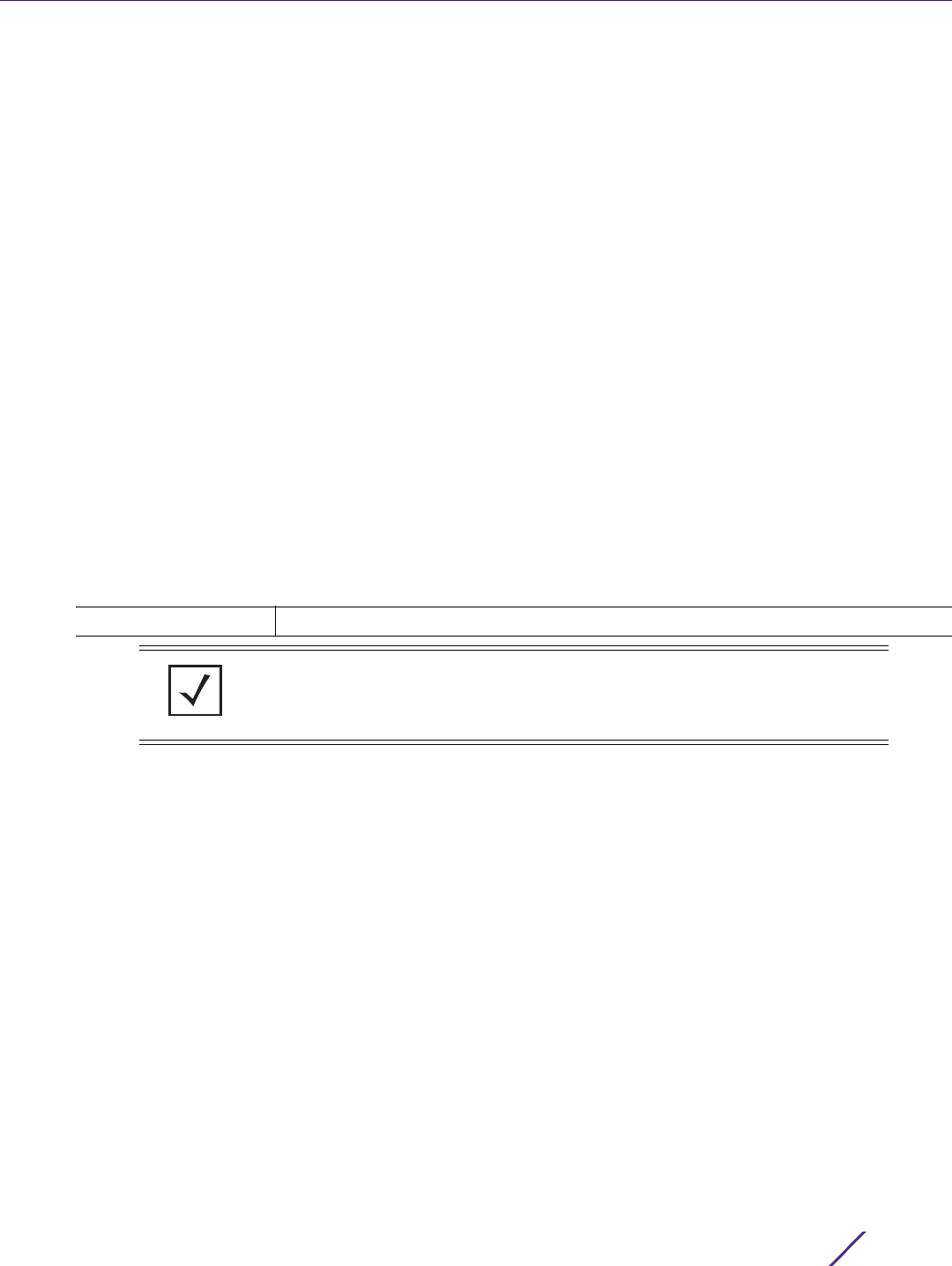
GLOBAL CONFIGURATION COMMANDS
Access Point, Wireless Controller and Service Platform CLI Reference Guide 4 - 82
Example
nx9500-6C8809(config)#bgp ?
as-path-list BGP AS path list Configuration
community-list Add a community list entry
extcommunity-list Add a extended community list entry (EXPERIMENTAL)
ip-access-list Add an access list entry
ip-prefix-list Build a prefix list
nx9500-6C8809(config)#
nx9500-6C8809(config)#bgp as-path-list AS-TEST-PATH
nx9500-6C8809(config-bgp-as-path-list-AS-TEST-PATH)#?
BGP AS Path List Mode commands:
deny Specify packets to reject
no Negate a command or set its defaults
permit Specify packets to forward
clrscr Clears the display screen
commit Commit all changes made in this session
do Run commands from Exec mode
end End current mode and change to EXEC mode
exit End current mode and down to previous mode
help Description of the interactive help system
revert Revert changes
service Service Commands
show Show running system information
write Write running configuration to memory or terminal
nx9500-6C8809(config-bgp-as-path-list-AS-TEST-PATH)#
Related Commands
no Modifies BGP settings, based on the parameters passed
NOTE: For more information on configuring BGP Top-Level Objects (TLOs),
see Chapter 28, BORDER GATEWAY PROTOCOL.

GLOBAL CONFIGURATION COMMANDS
Access Point, Wireless Controller and Service Platform CLI Reference Guide 4 - 83
4.1.28 bonjour-gateway-discovery-policy
Global Configuration Commands
The following table lists the commands that allows you to create a Bonjour Gateway Discovery Policy:
Table 4.8 Bonjour-Gateway-Discovery Config Commands
Command Description Reference
bonjour-gw-
discovery-policy
Creates a Bonjour Gateway Discovery policy and enters its
configuration mode
page 4-84
bonjour-
gateway-
discovery-
policy-mode
commands
Summarizes Bonjour Gateway Discovery policy configuration mode
commands
page 4-86

GLOBAL CONFIGURATION COMMANDS
Access Point, Wireless Controller and Service Platform CLI Reference Guide 4 - 84
4.1.28.1 bonjour-gw-discovery-policy
bonjour-gateway-discovery-policy
Bonjour is Apple’s zero-configuration networking (Zeroconf) implementation. Bonjour enables automatic IP
address assignment, name to address resolution, and service discovery without having to configure a DHCP
server, DNS server, and Directory server. When configured and applied on a WLAN, the Bonjour Gateway
Discovery policy queries for and locates Bonjour devices (printers, computers, file-sharing servers, etc.) and
services these computers provide over a local network. Bonjour works only within a single broadcast
domain. However, with a special DNS configuration, it can be extended to find services across broadcast
domains.
Use this command to configure a Bonjour GW Discovery policy. The policy defines a list of services clients
can discover across subnets. A maximum of 8 (eight) policies can be created on access points, wireless
controllers, or service platforms.
When configured and applied, this feature enables discovery of Bonjour services on local and/or tunneled
VLANs.
Supported in the following platforms:
• Access Points — AP6521, AP6522, AP6532, AP6562, AP7161, AP7502, AP7522, AP7532, AP7562,
AP7602, AP7612, AP7622, AP7632, AP7662, AP81XX, AP82XX, AP8432, AP8533
• Wireless Controllers — RFS4000, RFS6000
• Service Platforms — NX5500, NX7500, NX7510, NX7520, NX7530, NX9500, NX9510, NX9600,
VX9000
Syntax
bonjour-gw-discovery-policy <POLICY-NAME>
Parameters
• bonjour-gw-discovery-policy <POLICY-NAME>
<POLICY-NAME> Specify the Bonjour GW Discovery policy name. If the policy does not exist, it is
created. In the Bonjour GW Discovery policy configuration mode, use the allow-
service keyword to configure the services that the Bonjour gateway is allowed to
discover. A maximum of 16 (sixteen) service rules can be created. Optionally, you can
restrict this facility for users on specific VLANs. To do so, specify the VLAN IDs.
Execute the bonjour-gw-forwarding-policy command to enable forwarding of
Bonjour service responses across VLANs.
To associate a Bonjour GW Discovery policy with a WLAN, in the WLAN
configuration mode, execute the following command: use > bonjour-gw-discovery-
policy > <POLICY-NAME>. For more information, see use.
To associate a Bonjour GW Discovery policy with a VLAN, in the interface VLAN
configuration mode, execute the following command: use > bonjour-gw-discovery-
policy > <POLICY-NAME>. For more information, see use.
To associate a Bonjour GW Discovery policy with a user role, in the role-policy -
user-role - configuration mode, execute the following command: use > bonjour-gw-
discovery-policy > <POLICY-NAME>. For more information, see use.

GLOBAL CONFIGURATION COMMANDS
Access Point, Wireless Controller and Service Platform CLI Reference Guide 4 - 85
Example
rfs6000-81742D(config)#bonjour-gw-discovery-policy TestPolicy
rfs6000-81742D(config-bonjour-gw-discovery-policy-TestPolicy)#?
commands:
allow-service Allow Bonjour Service on local or tunneled vlan,Optionally
VLAN IDs can be given so service will be discovered for those
vlan only
no Negate a command or set its defaults
clrscr Clears the display screen
commit Commit all changes made in this session
do Run commands from Exec mode
end End current mode and change to EXEC mode
exit End current mode and down to previous mode
help Description of the interactive help system
revert Revert changes
service Service Commands
show Show running system information
write Write running configuration to memory or terminal
rfs6000-81742D(config-bonjour-gw-discovery-policy-TestPolicy)#
Related Commands
no Removes an existing Bonjour GW Discovery policy

GLOBAL CONFIGURATION COMMANDS
Access Point, Wireless Controller and Service Platform CLI Reference Guide 4 - 86
4.1.28.2 bonjour-gateway-discovery-policy-mode commands
bonjour-gateway-discovery-policy
The following table summarizes the Bonjour Gateway Discovery Policy configuration mode commands:
Table 4.9 Bonjour-Gateway-Discovery-Policy-Mode Commands
Command Description Reference
allow-service Configures the Bonjour Services that can be discovered on Local or
Tunneled VLANs. It configures the local VLANs on which these services can
be found.
page 4-87
no Removes or modifies the Bonjour Gateway Discovery policy settings page 4-89

GLOBAL CONFIGURATION COMMANDS
Access Point, Wireless Controller and Service Platform CLI Reference Guide 4 - 87
4.1.28.2.1 allow-service
bonjour-gateway-discovery-policy-mode commands
Enables discovery of Bonjour devices and the services they provide on Local or Tunneled VLANs
Supported in the following platforms:
• Access Points — AP6521, AP6522, AP6532, AP6562, AP7161, AP7502, AP7522, AP7532, AP7562,
AP7602, AP7612, AP7622, AP7632, AP7662, AP81XX, AP82XX, AP8432, AP8533
• Wireless Controllers — RFS4000, RFS6000
• Service Platforms — NX5500, NX7500, NX7510, NX7520, NX7530, NX9500, NX9510, NX9600,
VX9000
Syntax
allow-service <BONJOUR-SERVICE-NAME> [local|tunneled]
allow-service <BONJOUR-SERVICE-NAME> local {instance-name contains <WORD>}
({service-vlans <WORD>})
allow-service <BONJOUR-SERVICE-NAME> tunneled {instance-name contains <WORD>}
Parameters
• allow-service <BONJOUR-SERVICE-NAME> local {instance-name contains <WORD>}
({service-vlans <WORD>})
allow-service
<BONJOUR-
SERVICE-NAME>
Configures the services that can be discovered by the Bonjour gateway. And also
configures the VLANs on which the selected services can be discovered.
• <BONJOUR-SERVICE-NAME> – You can either select the Bonjour services from a set
of system-provided, pre-defined Apple services, or use an existing alias to define a
service not available in the predefined list.
The predefined Apple services available are: Afp, AirPlay, AirPort, AirPrint, AirTunes,
AppleTimeMachine, Chromecast, Daap, HomeSharing, Printer, and Scanner.
Use the <WORD> keyword to define a service not included in the system-provided, pre-
defined list. Ensure this device is registered with the Multicast DNS Responder
(mDNSResponder).
local Select to enable the discovery of the selected Bonjour Services on the local VLAN
instance-name
contains <WORD>
Optional. Specifies the selected Bonjour service’s instance name. When specified, the
Bonjour service discovery queries contain the instance name. of the service to be
discovered.
This option is useful especially in large distributed, enterprise networks. Use it to
create different instances of a Bonjour service for the different organizations or
departments (VLANS) within your network. Creating instances allows you to advertise
specific service instances for a specific set of VLANs, instead of advertising top-level
Bonjour Services to various allocated VLAN(s).
• contains <WORD> – Specify the instance name. You can either directly specify the
string value to be used as a match criteria, or use a string alias (for example,
$BONJOUR-STRING) to identify the string to match. If using a string alias, ensure that
it is existing and configured. For information on configuring a string alias, see alias.
service-vlans
<WORD>
Optional. Configures a VLAN or a list of VLANs on which the selected service is
discoverable. When specified, Bonjour discovery queries are delivered to all clients on
the specified VLANs. Applicable only if enabling Bonjour Services discovery on local
VLANs.

GLOBAL CONFIGURATION COMMANDS
Access Point, Wireless Controller and Service Platform CLI Reference Guide 4 - 88
• allow-service <BONJOUR-SERVICE-NAME> tunneled {instance-name contains <WORD>}
Example
nx9500-6C8809(config-bonjour-gw-discovery-policy-test)#allow-service Afp local
nx9500-6C8809(config-bonjour-gw-discovery-policy-test)#allow-service Printer lo
cal instance-name contains $Bonjour_Service service-vlans 1,2
nx9500-6C8809(config-bonjour-gw-discovery-policy-test)#show context
bonjour-gw-discovery-policy test
allow-service Printer local service-vlans 1-2 instance-name contains
$Bonjour_Service
allow-service Afp local
nx9500-6C8809(config-bonjour-gw-discovery-policy-test)#
Following example configures the string alias named $Bonjour_Service:
nx9500-6C8809(config)#alias string $Bonjour_Service admin
nx9500-6C8809(config)#commit
nx9500-6C8809(config)#show context include-factory | include alias string
alias string $Bonjour_Service admin
nx9500-6C8809(config)#
Related Commands
allow-service
<BONJOUR-
SERVICE-NAME>
Configures the services that can be discovered by the Bonjour gateway. And also
configures the VLANs on which the selected services can be discovered.
• <BONJOUR-SERVICE-NAME> – You can either select the Bonjour Services from a set
of system-provided, pre-defined Apple services, or use an existing alias to define a
service not available in the predefined list.
The predefined Apple services available are: Afp, AirPlay, AirPort, AirPrint, AirTunes,
AppleTimeMachine, Chromecast, Daap, HomeSharing, Printer, and Scanner.
Use the <WORD> keyword to define a service not included in the system-provided,
predefine list.
tunneled Select to enable the discovery of the selected Bonjour Services on tunneled VLANs
instance-name
contains <WORD>
Optional. Adds a Bonjour Service instance name. If you have a large enterprise
network, use this option to create different Bonjour Service instances for the different
organizations or departments (VLANS) within your network. Creating instances allows
you to advertise specific service instances for a specific set of VLANs, instead of
advertising top-level Bonjour Services to various allocated VLAN(s).
• contains <WORD> – Specify the sub-string to match. You can either directly specify the
string value to be used as a match criteria, or use a string alias (for example,
$BONJOUR-STRING) to identify the string to match. If using a string alias, ensure that
it is existing and configured. For information on configuring aliases, see alias.
no Removes or modifies this Bonjour Gateway Discovery Policy settings

GLOBAL CONFIGURATION COMMANDS
Access Point, Wireless Controller and Service Platform CLI Reference Guide 4 - 89
4.1.28.2.2 no
bonjour-gateway-discovery-policy-mode commands
Removes or modifies the Bonjour Gateway Discovery policy settings
Supported in the following platforms:
• Access Points — AP6521, AP6522, AP6532, AP6562, AP7161, AP7502, AP7522, AP7532, AP7562,
AP7602, AP7612, AP7622, AP7632, AP7662, AP81XX, AP82XX, AP8432, AP8533
• Wireless Controllers — RFS4000, RFS6000
• Service Platforms — NX5500, NX7500, NX7510, NX7520, NX7530, NX9500, NX9510, NX9600,
VX9000
Syntax
no allow-service <BONJOUR-SERVICE-NAME> [local|tunneled] {service-vlans <WORD>}
Parameters
• no allow-service <BONJOUR-SERVICE-NAME> [local|tunneled] {service-vlans <WORD>}
Example
The following example shows the Bonjour GW Discovery policy ‘test’ settings before
the ‘no’ command is executed:
nx9500-6C8809(config-bonjour-gw-discovery-policy-test)#show context
bonjour-gw-discovery-policy test
allow-service Printer local service-vlans 1-2 instance-name contains
$Bonjour_Service
allow-service Afp local
nx9500-6C8809(config-bonjour-gw-discovery-policy-test)#
nx9500-6C8809(config-bonjour-gw-discovery-policy-test1)#no allow-service Afp
local
The following example shows the Bonjour GW Discovery policy ‘test’ settings after
the ‘no’ command was executed:
nx9500-6C8809(config-bonjour-gw-discovery-policy-test)#show context
bonjour-gw-discovery-policy test
allow-service Printer local service-vlans 1-2 instance-name contains
$Bonjour_Service
nx9500-6C8809(config-bonjour-gw-discovery-policy-test)#
no <parameters> Removes allow-service rules in the selected Bonjour GW Discovery policy, based on
the parameters passed

GLOBAL CONFIGURATION COMMANDS
Access Point, Wireless Controller and Service Platform CLI Reference Guide 4 - 90
4.1.29 bonjour-gw-forwarding-policy
Global Configuration Commands
Configures a Bonjour GW Forwarding policy. When configured and applied on the controller, the policy
defines the service VLANs (the VLANs on which Bonjour services are running) and client VLANs where
clients are present. All Bonjour responses from service VLANs are forwarded to client VLANs. A maximum
of 2 (two) policies can be created on a wireless controller or service platform. And only 1 (one) policy can
be created on an access point.
Supported in the following platforms:
• Access Points — AP6521, AP6522, AP6532, AP6562, AP7161, AP7502, AP7522, AP7532, AP7562,
AP7602, AP7612, AP7622, AP7632, AP7662, AP81XX, AP82XX, AP8432, AP8533
• Wireless Controllers — RFS4000, RFS6000
• Service Platforms — NX5500, NX7500, NX7510, NX7520, NX7530, NX9500, NX9510, NX9600,
VX9000
Syntax
bonjour-gw-forwarding-policy <POLICY-NAME>
Parameters
• bonjour-gw-forwarding-policy <POLICY-NAME>
Example
rfs6000-81742D(config)#bonjour-gw-forwarding-policy TestPolicy
rfs6000-81742D(config-bonjour-gw-forwarding-policy-TestPolicy)#?
commands:
forward-bonjour-response Forwards bonjour service response across vlans
no Negate a command or set its defaults
clrscr Clears the display screen
commit Commit all changes made in this session
do Run commands from Exec mode
end End current mode and change to EXEC mode
exit End current mode and down to previous mode
help Description of the interactive help system
revert Revert changes
service Service Commands
show Show running system information
write Write running configuration to memory or terminal
rfs6000-81742D(config-bonjour-gw-forwarding-policy-TestPolicy)#
<POLICY-NAME> Specify the Bonjour GW Forwarding policy name. If the policy does not exist, it is
created.
To receive Bonjour service responses from specific VLANs, specify the VLAN IDs. In
the Bonjour GW Forwarding policy configuration mode, provide a list of VLAN IDs
from which Bonjour responses can be received (format: 10-20, 25, 30-35). And then
specify the list of client VLANs that can access Bonjour services.
Execute the bonjour-gw-discovery-policy command to define the Bonjour services
allowed on local and tunneled VLANs.
To associate a Bonjour GW Forwarding policy with a device or profile, in the profile/
device configuration mode, execute the use > bonjour-gw-forwarding-policy >
<POLICY-NAME> command. For more information, see use.

GLOBAL CONFIGURATION COMMANDS
Access Point, Wireless Controller and Service Platform CLI Reference Guide 4 - 91
Related Commands
no Removes an existing Bonjour GW Forwarding policy

GLOBAL CONFIGURATION COMMANDS
Access Point, Wireless Controller and Service Platform CLI Reference Guide 4 - 92
4.1.30 bonjour-gw-query-forwarding-policy
Global Configuration Commands
Configures a Bonjour GW Query Forwarding policy and enters its configuration mode. When created and
applied, this policy enables forwarding of Bonjour queries across VLANs.
Supported in the following platforms:
• Access Points — AP6521, AP6522, AP6532, AP6562, AP7161, AP7502, AP7522, AP7532, AP7562,
AP7602, AP7612, AP7622, AP7632, AP7662, AP81XX, AP82XX, AP8432, AP8533
• Wireless Controllers — RFS4000, RFS6000
• Service Platforms — NX5500, NX7500, NX7510, NX7520, NX7530, NX9500, NX9510, NX9600,
VX9000
Syntax
bonjour-gw-query-forwarding-policy <POLICY-NAME>
Parameters
• bonjour-gw-query-forwarding-policy <POLICY-NAME>
Example
rfs6000-81742D(config)#bonjour-gw-query-forwarding-policy TestPolicy
rfs6000-81742D(config-bonjour-gw-query-forwarding-policy-test)#?
(config-bonjour-gw-query-forwarding-policy) commands:
forward-bonjour-query Forwards bonjour query across vlans
no Negate a command or set its defaults
clrscr Clears the display screen
commit Commit all changes made in this session
do Run commands from Exec mode
end End current mode and change to EXEC mode
exit End current mode and down to previous mode
help Description of the interactive help system
revert Revert changes
service Service Commands
show Show running system information
write Write running configuration to memory or terminal
rfs6000-81742D(config-bonjour-gw-query-forwarding-policy-test)#
Related Commands
<POLICY-NAME> Specify the Bonjour GW Query Forwarding policy name. If the policy does not exist,
it is created.
In the Bonjour GW Query Forwarding policy configuration mode, specify the ‘from’
and ‘to’ VLAN(s). The from-vlans option configures the VLAN(s) that are the source
of the Bonjour queries. The to-vlans option configures the destination VLAN(s) that
can access the Bonjour queries.
To associate a Bonjour GW Query Forwarding policy with a device or profile, in the
profile/device configuration mode, execute the use > bonjour-gw-query-forwarding-
policy > <POLICY-NAME> command. For more information, see use.
no Removes an existing Bonjour GW Query Forwarding policy

GLOBAL CONFIGURATION COMMANDS
Access Point, Wireless Controller and Service Platform CLI Reference Guide 4 - 93
4.1.31 captive portal
Global Configuration Commands
The following table lists the commands that enable you to create a new captive portal policy and enter its
configuration mode:
Table 4.10 Captive-Portal Config Commands
Command Description Reference
captive-portal Creates a new captive portal and enters its configuration mode page 4-94
captive-portal-
mode
commands
Summarizes captive portal configuration commands page 4-96

GLOBAL CONFIGURATION COMMANDS
Access Point, Wireless Controller and Service Platform CLI Reference Guide 4 - 94
4.1.31.1 captive-portal
captive portal
Configures a captive portal policy and enters its configuration mode. Once created and configured, use the
captive portal policy in the WLAN context, and in the device/profile contexts of the access point or
controller hosting the captive portal server.
A captive portal provides secure access using a standard Web browser. Captive portals provide
authenticated access by capturing and re-directing a wireless user's Web browser session to a captive
portal login page where the user must enter valid credentials to access to the wireless network. Once
logged into the captive portal, additional Acknowledgment, Agreement, Welcome, No Service, and Fail
pages provide the administrator options to customize the screen flow and user appearance.
Captive portals are recommended for providing guests or visitors authenticated access to network
resources when 802.1X EAP is not a viable option. Captive portal authentication does not provide end-user
data encryption, but it can be used with static WEP, WPA-PSK or WPA2-PSK encryption.
Authentication for captive portal access requests is performed using a username and password pair,
authenticated by an integrated RADIUS server. Authentication for private network access is conducted
either locally on the requesting wireless client, or centrally at a data center.
Captive portals use a Web provisioning tool to create guest user accounts directly on the controller, service
platform, or access point. The connection medium defined for the Web connection is either HTTP or
HTTPS. Both HTTP and HTTPS use a request and response procedure to disseminate information to and
from requesting wireless clients.
Supported in the following platforms:
• Access Points — AP6521, AP6522, AP6532, AP6562, AP7161, AP7502, AP7522, AP7532, AP7562,
AP7602, AP7612, AP7622, AP7632, AP7662, AP81XX, AP82XX, AP8432, AP8533
• Wireless Controllers — RFS4000, RFS6000
• Service Platforms — NX5500, NX7500, NX7510, NX7520, NX7530, NX9500, NX9510, NX9600,
VX9000
Syntax
captive-portal <CAPTIVE-PORTAL-NAME>
Parameters
• captive-portal <CAPTIVE-PORTAL-NAME>
<CAPTIVE-PORTAL-
NAME>
Specify the captive portal name. If a captive portal with the specified name does not
exist, it is created.

GLOBAL CONFIGURATION COMMANDS
Access Point, Wireless Controller and Service Platform CLI Reference Guide 4 - 95
Example
rfs6000-81742D(config)#captive-portal test
rfs6000-81742D(config-captive-portal-test)#?
Captive Portal Mode commands:
access-time Allowed access time for the client. Used when
there is no session time in radius response
access-type Access type of this captive portal
accounting Configure how accounting records are created for
this captive portal policy
bypass Bypass captive portal
connection-mode Connection mode for this captive portal
custom-auth Custom user information
data-limit Enforce data limit for clients
inactivity-timeout Inactivity timeout in seconds. If a frame is not
received from client for this amount of time,
then current session will be removed
ipv6 Internet Protocol version 6 (IPv6)
localization Configure the FQDN address to get the
localization parameters for the client
logout-fqdn Configure the FQDN address to logout the session
from client
no Negate a command or set its defaults
oauth OAuth 2.0 authentication configuration
php-helper Configure the captive portal to use a server for
help with php
post-authentication-vlan Configure post authentication vlan for captive
portal users
radius-vlan-assignment Enable radius vlan assignment for captive portal
users
redirection Configure connection redirection parameters
report-loyalty-application Report customer loyalty application presence in
clients
server Configure captive portal server parameters
simultaneous-users Particular username can only be used by a
certain number of MAC addresses at a time
terms-agreement User needs to agree for terms and conditions
use Set setting to use
webpage Configure captive portal webpage parameters
webpage-auto-upload Enable automatic upload of internal and advanced
webpages
webpage-location The location of the webpages to be used for
authentication. These pages can either be hosted
on the system or on an external web server.
welcome-back Welcome back page settings
clrscr Clears the display screen
commit Commit all changes made in this session
do Run commands from Exec mode
end End current mode and change to EXEC mode
exit End current mode and down to previous mode
help Description of the interactive help system
revert Revert changes
service Service Commands
show Show running system information
write Write running configuration to memory or
terminal
rfs6000-81742D(config-captive-portal-test)#
Related Commands
no Removes an existing captive portal

GLOBAL CONFIGURATION COMMANDS
Access Point, Wireless Controller and Service Platform CLI Reference Guide 4 - 96
4.1.31.2 captive-portal-mode commands
captive portal
The following table summarizes captive portal configuration mode commands:
Table 4.11 Captive-Portal-Mode Commands
Command Description Reference
access-time Defines a client’s access time. It is used when no session time is defined
in the RADIUS response.
page 4-98
access-type Configures a captive portal’s access type page 4-99
accounting Enables a captive portal’s accounting records page 4-100
bypass Enables bypassing of captive portal detection requests from wireless
clients
page 4-102
connection-
mode
Configures a captive portal’s connection mode page 4-103
custom-auth Configures custom user information page 4-104
data-limit Enforces data limit on captive portal clients page 4-105
inactivity-
timeout
Defines an inactivity timeout in seconds page 4-106
ipv6 Configures the IPv6 address of the internal captive portal server page 4-107
localization Configures an FQDN address string that enables the client to receive
localization parameters. This command also allows the configuration of a
response message.
page 4-108
logout-fqdn Clears the logout FQDN address page 4-110
no Reverts the selected captive portal’s settings to default page 4-111
oauth Enables OAuth-based authentication support on the captive portal. When
enabled, OAuth allows captive-portal users to sign in to guest WLANs
using their Facebook or Google credentials.
page 4-113
php-helper Configures a PHP helper to serve the captive portal’s PHP splash pages
to guest users using social-media to login to the captive portal.
page 4-115
post-
authentication-
vlan
Assigns a post authentication RADIUS VLAN for this captive portal’s
users
page 4-117
radius-vlan-
assignment
Assigns a RADIUS VLAN for this captive portal page 4-118
redirection Enables redirection of client connections to specified destination ports page 4-119
report-loyalty-
application
Enables detection of captive portal client’s loyalty application presence
and stores this information in the captive portal’s user database
page 4-120
server Configures the captive portal server settings page 4-121
simultaneous-
users
Specifies a username used by a MAC address pool page 4-123
terms-
agreement
Enforces the user to agree to terms and conditions (included in login
page) for captive portal access
page 4-124
use Associates a AAA policy and a DNS whitelist with a captive portal page 4-125
webpage Configures captive portal Web page settings page 4-127

GLOBAL CONFIGURATION COMMANDS
Access Point, Wireless Controller and Service Platform CLI Reference Guide 4 - 97
webpage-auto-
upload
Enables automatic upload of advanced Web pages on a captive portal page 4-135
webpage-
location
Specifies the location of Web pages used for captive portal
authentication
page 4-136
welcome-back Enables the provision of direct Internet access to once-registered,
captive-portal guest users on subsequent log-ins
page 4-137
configuring
device
registration with
dynamic VLAN
assignment
Documents configuration details required to enable device registration
with dynamic VLAN assignment in a multi-vendor environment
page 4-139
configuring
WeChat Wi-Fi
hotspot support
in WiNG captive
portal
Documents configuration details required to support the WeChat WiFi
hotspot, so that WeChat users, on their first connect to a WiNG access
point, can automatically authenticate with the WeChat server through an
intermediate server
page 4-141
configuring
ExtremeGuest
captive-portal
Documents the basic configurations required to deploy an ExtremeGuest
setup
page 4-143
Table 4.11 Captive-Portal-Mode Commands
Command Description Reference

GLOBAL CONFIGURATION COMMANDS
Access Point, Wireless Controller and Service Platform CLI Reference Guide 4 - 98
4.1.31.2.1 access-time
captive-portal-mode commands
Defines the permitted access time for a client. It is used when no session time is defined in the RADIUS
response.
Supported in the following platforms:
• Access Points — AP6521, AP6522, AP6532, AP6562, AP7161, AP7502, AP7522, AP7532, AP7562,
AP7602, AP7612, AP7622, AP7632, AP7662, AP81XX, AP82XX, AP8432, AP8533
• Wireless Controllers — RFS4000, RFS6000
• Service Platforms — NX5500, NX7500, NX7510, NX7520, NX7530, NX9500, NX9510, NX9600,
VX9000
Syntax
access-time <10-10080>
Parameters
• access-time <10-10080>
Example
rfs6000-81742D(config-captive-portal-test)#access-time 35
rfs6000-81742D(config-captive-portal-test)#show context
captive-portal test
access-time 35
rfs6000-81742D(config-captive-portal-test)#
Related Commands
access-time
<10-10080>
Defines the duration wireless clients are allowed access to the Internet using this
captive portal policy
• <10-10080> – Specify a value from 10 - 10080 minutes. The default is 1440 minutes.
no Reverts to the default permitted access time (1440 minutes)

GLOBAL CONFIGURATION COMMANDS
Access Point, Wireless Controller and Service Platform CLI Reference Guide 4 - 99
4.1.31.2.2 access-type
captive-portal-mode commands
Defines the captive portal’s access type. The authentication scheme configured here is applied to wireless
clients using this captive portal.
Supported in the following platforms:
• Access Points — AP6521, AP6522, AP6532, AP6562, AP7161, AP7502, AP7522, AP7532, AP7562,
AP7602, AP7612, AP7622, AP7632, AP7662, AP81XX, AP82XX, AP8432, AP8533
• Wireless Controllers — RFS4000, RFS6000
• Service Platforms — NX5500, NX7500, NX7510, NX7520, NX7530, NX9500, NX9510, NX9600,
VX9000
Syntax
access-type [custom-auth-radius|logging|no-auth|radius|registration]
Parameters
• access-type [custom-auth-radius|logging|no-auth|radius|registration]
Example
rfs6000-81742D(config-captive-portal-test)#access-type logging
rfs6000-81742D(config-captive-portal-test)#show context
captive-portal test
access-type logging
access-time 35
rfs6000-81742D(config-captive-portal-test)#
Related Commands
custom-auth-radius Specifies the custom user information used for authentication (RADIUS lookup of
given information, such as name, e-mail address, telephone, etc.). When configured,
accessing clients are required to provide a 1-32 character lookup data string used to
authenticate their credentials.
When selecting this option, use the custom-auth command to configure the required
user information.
logging Provides users access without authentication. The system logs access details of users
allowed access.
no-auth Defines no authentication required for a guest (guest is redirected to welcome
message). Provides users access to the captive portal without authentication.
radius Enables RADIUS authentication for wireless clients. Provides captive portal access to
successfully authenticated users only. This is the default setting.
registration Enables captive portal’s clients to self register in the captive portal’s database. When
configured, a requesting client’s user credentials require authentication locally or
through social media credential exchange and validation.
If enabled, use the webpage > internal > registration > field command to customize
the registration page. If not customized, the default, built-in registration Web page is
displayed.
no Removes the captive portal access type or reverts to default (radius)

GLOBAL CONFIGURATION COMMANDS
Access Point, Wireless Controller and Service Platform CLI Reference Guide 4 - 100
4.1.31.2.3 accounting
captive-portal-mode commands
Enables support for accounting messages for this captive portal
When enabled, accounting for clients entering and exiting the captive portal is initiated. Accounting is the
method of collecting and sending security server information for billing, auditing, and reporting user data.
This data includes information, such as start and stop times, executed commands (such as PPP), number of
packets and number of bytes transmitted, etc. Accounting enables tracking of captive portal services
consumed by clients.
Supported in the following platforms:
• Access Points — AP6521, AP6522, AP6532, AP6562, AP7161, AP7502, AP7522, AP7532, AP7562,
AP7602, AP7612, AP7622, AP7632, AP7662, AP81XX, AP82XX, AP8432, AP8533
• Wireless Controllers — RFS4000, RFS6000
• Service Platforms — NX5500, NX7500, NX7510, NX7520, NX7530, NX9500, NX9510, NX9600,
VX9000
Syntax
accounting [radius|syslog]
accounting radius
accounting syslog host <IP/HOSTNAME> {port <1-65535>} {proxy-mode [none|through-
controller|through-rf-domain-manager]}
Parameters
• accounting radius
• accounting syslog host <IP/HOSTNAME> {port <1-65535>} {proxy-mode [none|
through-controller|through-rf-domain-manager]}
radius Enables support for RADIUS accounting messages. When enabled, this option uses an
external RADIUS resource for AAA accounting. This option is disabled by default.
syslog
host <IP/
HOSTNAME>
Enables support for syslog accounting messages. When enabled, data relating to
wireless client usage of remote access services is logged on the specified external
syslog resource. This information assists in differentiating between local and remote
users. Remote user information can be archived to an external location for periodic
network and user administration. This option is disabled by default.
• host <IP/HOSTNAME> – Specifies the destination where accounting messages are
sent. Specify the destination’s IP address or hostname.
port <1-65535> Optional. Specifies the syslog server’s listener port
• <1-65535> – Specify the UDP port from 1- 65535. The default is 514.
proxy-mode [none|
through-controller|
through-rf-domain-
manager]
Optional. Specifies the mode of proxying the syslog server
• none – Accounting messages are sent directly to the syslog server
• through-controller – Accounting messages are sent through the controller configuring
the device
• through-rf-domain-manager – Accounting messages are sent through the local RF
Domain manager

GLOBAL CONFIGURATION COMMANDS
Access Point, Wireless Controller and Service Platform CLI Reference Guide 4 - 101
Example
rfs6000-81742D(config-captive-portal-test)#accounting syslog host 172.16.10.13
port 1
rfs6000-81742D(config-captive-portal-test)#show context
captive-portal test
access-type logging
access-time 35
accounting syslog host 172.16.10.13 port 1
rfs6000-81742D(config-captive-portal-test)#
Related Commands
no Disables accounting records for this captive portal

GLOBAL CONFIGURATION COMMANDS
Access Point, Wireless Controller and Service Platform CLI Reference Guide 4 - 102
4.1.31.2.4 bypass
captive-portal-mode commands
Enables bypassing of captive portal detection requests from wireless clients
Certain devices, such as Apple IOS devices send Captive Network Assistant (CNA) requests to detect
existence of captive portals. When enabled, the bypass option does not allow CNA requests to be
redirected to the captive portal pages.
Supported in the following platforms:
• Access Points — AP6521, AP6522, AP6532, AP6562, AP7161, AP7502, AP7522, AP7532, AP7562,
AP7602, AP7612, AP7622, AP7632, AP7662, AP81XX, AP82XX, AP8432, AP8533
• Wireless Controllers — RFS4000, RFS6000
• Service Platforms — NX5500, NX7500, NX7510, NX7520, NX7530, NX9500, NX9510, NX9600,
VX9000
Syntax
bypass captive-portal-detection
Parameters
• bypass captive-portal-detection
Example
rfs4000-229D58(config-captive-portal-test)#bypass captive-portal-detection
rfs4000-229D58(config-captive-portal-test)#show context
captive-portal test
bypass captive-portal-detection
rfs4000-229D58(config-captive-portal-test)#
Related Commands
bypass captive-
portal-detection
Bypasses captive portal detection requests
no Disables bypassing of captive portal detection requests

GLOBAL CONFIGURATION COMMANDS
Access Point, Wireless Controller and Service Platform CLI Reference Guide 4 - 103
4.1.31.2.5 connection-mode
captive-portal-mode commands
Configures a captive portal’s mode of connection to the Web server. HTTP uses plain unsecured connection
for user requests. HTTPS uses an encrypted connection to support user requests.
Both HTTP and HTTPS use the same Uniform Resource Identifier (URI), so controller and client resources
can be identified. However, the use of HTTPS is recommended, as it affords controller and client
transmissions some measure of data protection HTTP cannot provide.
Supported in the following platforms:
• Access Points — AP6521, AP6522, AP6532, AP6562, AP7161, AP7502, AP7522, AP7532, AP7562,
AP7602, AP7612, AP7622, AP7632, AP7662, AP81XX, AP82XX, AP8432, AP8533
• Wireless Controllers — RFS4000, RFS6000
• Service Platforms — NX5500, NX7500, NX7510, NX7520, NX7530, NX9500, NX9510, NX9600,
VX9000
Syntax
connection-mode [http|https]
Parameters
• connection-mode [http|https]
Example
rfs6000-81742D(config-captive-portal-test)#connection-mode https
rfs6000-81742D(config-captive-portal-test)#show context
captive-portal test
access-type logging
access-time 35
connection-mode https
accounting syslog host 172.16.10.13 port 1
rfs6000-81742D(config-captive-portal-test)#
Related Commands
http Sets HTTP as the default connection mode. This is the default setting.
https Sets HTTPS as the default connection mode
HTTPS is a more secure version of HTTP, and uses encryption while sending and
receiving requests.
no Removes this captive portal’s connection mode

GLOBAL CONFIGURATION COMMANDS
Access Point, Wireless Controller and Service Platform CLI Reference Guide 4 - 104
4.1.31.2.6 custom-auth
captive-portal-mode commands
Configures custom user information
Supported in the following platforms:
• Access Points — AP6521, AP6522, AP6532, AP6562, AP7161, AP7502, AP7522, AP7532, AP7562,
AP7602, AP7612, AP7622, AP7632, AP7662, AP81XX, AP82XX, AP8432, AP8533
• Wireless Controllers — RFS4000, RFS6000
• Service Platforms — NX5500, NX7500, NX7510, NX7520, NX7530, NX9500, NX9510, NX9600,
VX9000
Syntax
custom-auth info <LINE>
Parameters
• custom-auth info <LINE>
Example
rfs6000-81742D(config-captive-portal-test)#custom-auth info bob
bob@examplecompany.com
rfs6000-81742D(config-captive-portal-test)#show context
captive-portal test
access-type logging
access-time 35
custom-auth info bob bob@examplecompany.com
connection-mode https
accounting syslog host 172.16.10.13 port 1
rfs6000-81742D(config-captive-portal-test)#
Related Commands
info <LINE> Configures information used for RADIUS lookup when custom-auth RADIUS access
type is configured
• <LINE> – Guest data needs to be provided. Specify the name, e-mail address, and
telephone number of the user.
no Removes custom user information configured with this captive portal

GLOBAL CONFIGURATION COMMANDS
Access Point, Wireless Controller and Service Platform CLI Reference Guide 4 - 105
4.1.31.2.7 data-limit
captive-portal-mode commands
Enforces data transfer limits on captive portal clients. This feature enables the tracking and logging of user
usage. Users exceeding the allowed bandwidth are restricted from the captive portal.
Supported in the following platforms:
• Access Points — AP6521, AP6522, AP6532, AP6562, AP7161, AP7502, AP7522, AP7532, AP7562,
AP7602, AP7612, AP7622, AP7632, AP7662, AP81XX, AP82XX, AP8432, AP8533
• Wireless Controllers — RFS4000, RFS6000
• Service Platforms — NX5500, NX7500, NX7510, NX7520, NX7530, NX9500, NX9510, NX9600,
VX9000
Syntax
data-limit <1-102400> {action [log-and-disconnect|log-only]}
Parameters
• data-limit <1-102400> {action [log-and-disconnect|log-only]}
Example
rfs6000-81742D(config-captive-portal-test)#data-limit 200 action log-and-
disconnect
rfs6000-81742D(config-captive-portal-test)#show context
captive-portal test
data-limit 200 action log-and-disconnect
rfs6000-81742D(config-captive-portal-test)#
Related Commands
data-limit
<1-102400>
Sets a captive portal client’s data transfer limit in megabytes. This limit is applicable
for both upstream and downstream data transfer.
• <1-102400> – Specify a value from 1 - 102400 MB.
action
[log-and-disconnect|
log-only]
Optional. Specifies the action taken when a client exceeds the configured data limit.
The options are:
• log-and-disconnect – When selected, an entry is added to the log file any time a
captive portal client exceeds the data limit, and the client is disconnected.
• log-only – When selected, an entry is added to the log file any time a captive portal
client exceeds the data limit. the client, however, remains connected to the captive
portal. This is the default setting.
no Removes data limit enforcement for captive portal clients

GLOBAL CONFIGURATION COMMANDS
Access Point, Wireless Controller and Service Platform CLI Reference Guide 4 - 106
4.1.31.2.8 inactivity-timeout
captive-portal-mode commands
Defines the inactivity timeout in seconds. If a frame is not received from a client for the specified interval
the current session is terminated.
Supported in the following platforms:
• Access Points — AP6521, AP6522, AP6532, AP6562, AP7161, AP7502, AP7522, AP7532, AP7562,
AP7602, AP7612, AP7622, AP7632, AP7662, AP81XX, AP82XX, AP8432, AP8533
• Wireless Controllers — RFS4000, RFS6000
• Service Platforms — NX5500, NX7500, NX7510, NX7520, NX7530, NX9500, NX9510, NX9600,
VX9000
Syntax
inactivity-timeout <60-86400>
Parameters
• inactivity-timeout <60-86400>
Example
rfs6000-81742D(config-captive-portal-test)#inactivity-timeout 750
rfs6000-81742D(config-captive-portal-test)#show context
captive-portal test
access-type logging
access-time 35
custom-auth info bob bob@examplecompany.com
connection-mode https
inactivity-timeout 750
accounting syslog host 172.16.10.13 port 1
rfs6000-81742D(config-captive-portal-test)#
Related Commands
<60-86400> Defines the interval for which a captive portal session is kept alive without receiving a
frame from the client. The session is automatically terminated once this interval is
over.
• <60-86400> – Specify a value from 60 - 86400 seconds. The default is 10 minutes or
600 seconds.
no Removes the client inactivity-timeout configured with this captive portal

GLOBAL CONFIGURATION COMMANDS
Access Point, Wireless Controller and Service Platform CLI Reference Guide 4 - 107
4.1.31.2.9 ipv6
captive-portal-mode commands
Configures the internal captive portal server’s (running on the centralized mode) IPv6 address. If using
centralized server mode, use this option to define the controller, service platform, or access point resource’s
(hosting the captive portal) IPv6 address. For information on configuring the server mode, see server.
Supported in the following platforms:
• Access Points — AP6521, AP6522, AP6532, AP6562, AP7161, AP7502, AP7522, AP7532, AP7562,
AP7602, AP7612, AP7622, AP7632, AP7662, AP81XX, AP82XX, AP8432, AP8533
• Wireless Controllers — RFS4000, RFS6000
• Service Platforms — NX5500, NX7500, NX7510, NX7520, NX7530, NX9500, NX9510, NX9600,
VX9000
Syntax
ipv6 server host <IPv6>
Parameters
• ipv6 server host <IPv6>
Example
rfs6000-81742D(config-captive-portal-test2)#ipv6 server host
2001:10:10:10:6d:33:fa:8b
rfs6000-81742D(config-captive-portal-test2)#show context
captive-portal test2
access-type OAuth
ipv6 server host 2001:10:10:10:6d:33:fa:8b
OAuth client-id Google TechPubs.printer.google.com
rfs6000-81742D(config-captive-portal-test2)#
Related Commands
ipv6 server host
<IPv6>
Configures the IPv6 address of the internal captive portal server
• <IPv6> – Specify the captive portal server’s global IPv6 address.
no Removes the captive portal server’s IPv6 address

GLOBAL CONFIGURATION COMMANDS
Access Point, Wireless Controller and Service Platform CLI Reference Guide 4 - 108
4.1.31.2.10 localization
captive-portal-mode commands
Configures an FQDN address string that enables the client to receive localization parameters. Use this
option to add a URL to trigger a one-time redirect on demand. The defined URL is triggered from a mobile
application to derive location information from the wireless network so an application can be localized to a
particular store or region.
Supported in the following platforms:
• Access Points — AP6521, AP6522, AP6532, AP6562, AP7161, AP7502, AP7522, AP7532, AP7562,
AP7602, AP7612, AP7622, AP7632, AP7662, AP81XX, AP82XX, AP8432, AP8533
• Wireless Controllers — RFS4000, RFS6000
• Service Platforms — NX5500, NX7500, NX7510, NX7520, NX7530, NX9500, NX9510, NX9600,
VX9000
Syntax
localization [fqdn <WORD>|response <WORD>]
Parameters
• localization [fqdn <WORD>|response <WORD>]
localization Configures an FQDN address string that enables the client to receive localization
parameters. This command also allows the configuration of a response message.
fqdn <WORD> Configures the FQDN address string, which is used to obtain localization parameters
for the captive portal’s client.
• <WORD> – Specify the FQDN address string. For example, local.guestaccess.com
response <WORD> Configures a message, which is sent back to the client in response to the client’s
localization HTTP requests
• <WORD> – Specify the response message (should not exceed 512 characters in
length). The following built-in query tags can be included in the response message:
WING_TAG_CLIENT_IP' -Captive portal client IPv4 address
'WING_TAG_CLIENT_MAC' - Captive portal client MAC address
'WING_TAG_WLAN_SSID ' - Captive portal client WLAN ssid
'WING_TAG_AP_MAC' - Captive portal client AP MAC address
'WING_TAG_AP_NAME' - Captive portal client AP Name
'WING_TAG_RF_DOMAIN' - Captive portal client RF Domain
'WING_TAG_USERNAME' - Captive portal authentication username
'WING_TAG_USERTYPE' - Captive portal usertype
(new/return/refresh) Example:-
<local><site>WING_TAG_RF_DOMAIN</site><ap>WING_TAG_AP_NAME</ap></
local

GLOBAL CONFIGURATION COMMANDS
Access Point, Wireless Controller and Service Platform CLI Reference Guide 4 - 109
Example
nx9500-6C8809(config-captive-portal-test)#localization fqdn local.guestaccess.com
nx9500-6C8809(config-captive-portal-test)#localization response
<local><site>SJExtreme</site><ap>ap8132-74B45C</ap><user>Bob</user><local>
nx9500-6C8809(config-captive-portal-TechPubsNew)#show context
captive-portal TechPubsNew
webpage internal registration field city type text enable label "City" placeholder
"Enter City"
webpage internal registration field street type text enable label "Address"
placeholder "123 Any Street"
webpage internal registration field name type text enable label "Full Name"
placeholder "Enter First Name, Last Name"
webpage internal registration field zip type number enable label "Zip" placeholder
"Zip"
webpage internal registration field via-sms type checkbox enable title "SMS
Preferred"
webpage internal registration field mobile type number enable label "Mobile"
placeholder "Mobile Number with Country code"
webpage internal registration field age-range type dropdown-menu enable label "Age
Range" title "Age Range"
webpage internal registration field email type e-address enable mandatory label
"Email" placeholder "you@domain.com"
webpage internal registration field via-email type checkbox enable title "Email
Preferred"
localization fqdn local.guestaccess.com
localization response <local><site>SJExtreme</site><ap>ap8132-74B45C</
ap><user>Bob</user><local>
nx9500-6C8809(config-captive-portal-TechPubsNew)#
Related Commands
no Removes the FQDN address string and response message configured on a captive
portal for localization

GLOBAL CONFIGURATION COMMANDS
Access Point, Wireless Controller and Service Platform CLI Reference Guide 4 - 110
4.1.31.2.11 logout-fqdn
captive-portal-mode commands
Configures the Fully Qualified Domain Name (FQDN) address to logout of the session from the client
Supported in the following platforms:
• Access Points — AP6521, AP6522, AP6532, AP6562, AP7161, AP7502, AP7522, AP7532, AP7562,
AP7602, AP7612, AP7622, AP7632, AP7662, AP81XX, AP82XX, AP8432, AP8533
• Wireless Controllers — RFS4000, RFS6000
• Service Platforms — NX5500, NX7500, NX7510, NX7520, NX7530, NX9500, NX9510, NX9600,
VX9000
Syntax
logout-fqdn <WORD>
Parameters
• logout-fqdn <WORD>
Example
rfs6000-81742D(config-captive-portal-test)#logout-fqdn logout.testuser.com
rfs6000-81742D(config-captive-portal-test)#show context
captive-portal test
logout-fqdn logout.testuser.com
rfs6000-81742D(config-captive-portal-test)#
Related Commands
logout-fqdn <WORD> Configures the FQDN address used to logout
• <WORD> – Provide the FQDN address (for example, logout.guestaccess.com).
no Clears the logout FQDN address

GLOBAL CONFIGURATION COMMANDS
Access Point, Wireless Controller and Service Platform CLI Reference Guide 4 - 111
4.1.31.2.12 no
captive-portal-mode commands
The no command reverts the selected captive portal’s settings or resets settings to default.
Supported in the following platforms:
• Access Points — AP6521, AP6522, AP6532, AP6562, AP7161, AP7502, AP7522, AP7532, AP7562,
AP7602, AP7612, AP7622, AP7632, AP7662, AP81XX, AP82XX, AP8432, AP8533
• Wireless Controllers — RFS4000, RFS6000
• Service Platforms — NX5500, NX7500, NX7510, NX7520, NX7530, NX9500, NX9510, NX9600,
VX9000
Syntax
no [access-time|access-type|accounting|bypass|connection-mode|custom-auth|
data-limit|inactivity-timeout|ipv6|localization|logout-fqdn|oauth|php-helper|
post-authentication-vlan|radius-vlan-assignment|redirection|
report-loyalty-application|server|simultaneous-users|terms-agreement|use|
webpage|webpage-auto-upload|webpage-location|welcome-back]
no [access-time|access-type|connection-mode|data-limit|inactivity-timeout|
logout-fqdn|post-authentication-vlan|radius-vlan-assignment|report-loyalty-
application|simultaneous-users|terms-agreement|webpage-auto-upload|
webpage-location]
no accounting [radius|syslog]
no bypass captive-portal-detection
no custom-auth info
no ipv6 server host
no localization [fqdn|response]
no oauth {client-id}
no php-helper
no redirection ports
no server host
no server mode {centralized-controller [hosting-vlan-interface]}
no use [aaa-policy|dns-whitelist]
no webpage external [acknowledgement|agreement|fail|login {post}|no-service|
registration|welcome]
no webpage internal [acknowledgement|agreement|fail|login|no-service|org-name|
org-signature|registration|welcome]
no webpage internal [org-name|org-signature]
no webpage internal [acknowledgment|agreement|fail|login|no-service] [body-
background-color|body-font-color|description|footer|header|main-logo|org-
background-color|org-font-color|small-logo|title]
no webpage internal registration [body-background-color|body-font-color|
description|field|footer|header|main-logo|org-background-color|org-font-
color|small-logo|title]

GLOBAL CONFIGURATION COMMANDS
Access Point, Wireless Controller and Service Platform CLI Reference Guide 4 - 112
no webpage internal registration field [age-range|city|country|custom <FIELD-
NAME>|disclaimer|dob|email|gender|member|mobile|name|optout|street|via-email|
via-sms|zip] {enable}
no webpage internal welcome [body-background-color|body-font-color|description|
footer|header|main-logo|org-background-color|org-font-color|small-logo|title|
use-external-success-url]
no welcome-back pass-through
Parameters
• no <PARAMETERS>
Example
The following example shows the captive portal ‘test’ settings before the ‘no’ commands are executed:
rfs6000-81742D(config-captive-portal-test)#show context
captive-portal test
access-type logging
access-time 35
custom-auth info bob bob@examplecompany.com
connection-mode https
inactivity-timeout 750
accounting syslog host 172.16.10.13 port 1
rfs6000-81742D(config-captive-portal-test)#
rfs6000-81742D(config-captive-portal-test)#no accounting syslog
rfs6000-81742D(config-captive-portal-test)#no access-type
The following example shows the captive portal ‘test’ settings after the ‘no’ commands are executed:
rfs6000-81742D(config-captive-portal-test)#show context
captive-portal test
access-time 35
custom-auth info bob bob@examplecompany.com
connection-mode https
inactivity-timeout 750
rfs6000-81742D(config-captive-portal-test)#
no <PARAMETERS> Removes or resets this captive portal’s settings, based on the parameters passed.

GLOBAL CONFIGURATION COMMANDS
Access Point, Wireless Controller and Service Platform CLI Reference Guide 4 - 113
4.1.31.2.13 oauth
captive-portal-mode commands
Enables OAuth-driven Google and/or Facebook authentication on captive portals that use internal Web
pages.
To enable Google and Facebook captive-portal authentication:
• Enforce captive-portal authentication on the WLAN to which wireless-clients associate. For
information, see captive-portal-enforcement.
• Set captive-portal Web page location to internal. For more information, see webpage-location.
• Register your captive-portal individually on Google/FaceBook APIs and generate a client-id and
client-secret. The client-ids retrieved during registration are the IDs for the WiNG application
running on the access point/controller. The WiNG application uses these client-ids to access the
Google and Facebook Auth APIs, and authenticate the guest client on behalf of the user.
If enabling OAuth-driven Google and/or Facebook authentication on the captive portal, use this command
to configure the Google/Facebook client-ids. Once enabled, the captive portal landing page, displayed on
the client’s browser, provides the Facebook and Google login buttons.
Supported in the following platforms:
• Access Points — AP6521, AP6522, AP6532, AP6562, AP7161, AP7502, AP7522, AP7532, AP7562,
AP7602, AP7612, AP7622, AP7632, AP7662, AP81XX, AP82XX, AP8432, AP8533
• Wireless Controllers — RFS4000, RFS6000
• Service Platforms — NX5500, NX7500, NX7510, NX7520, NX7530, NX9500, NX9510, NX9600,
VX9000
Syntax
oauth
oauth client-id [facebook|google] <WORD>
Parameters
• oauth
• oauth client-id [facebook|google] <WORD>
oauth Execute this command without the associated keywords to enable OAuth on this
captive-portal. If enabling OAuth, ensure the captive-portal Web page location is
configured as advanced or external.
oauth client-id
[facebook|google]
<WORD>
Configures the client-ids retrieved from the Google and Facebook API manager
portals during registration
• facebook – Configures the Facebook API client-id (is a 15 digit entity)
• google – Configures the Google API client-id (is a 12 digit number)
• <WORD> – Provide the Facebook/Google client-id.
If the captive-portal Web page location is advanced or external, and you are enabling
OAuth support, you need not configure the client-id. In such a scenario, the client-id is
configured through the EGuest server UI and not the WiNG CLI.

GLOBAL CONFIGURATION COMMANDS
Access Point, Wireless Controller and Service Platform CLI Reference Guide 4 - 114
Example
nx7500-6DCD39(config-captive-portal-test2)#OAuth
nx7500-6DCD39(config-captive-portal-test2)#OAuth client-id Google
xxxxxxxxxxxx.apps.googleusercontent.com Facebook yyyyyyyyyyyyyyy
nx7500-6DCD39(config-captive-portal-test2)#show context
captive-portal test2
server host guest.social.com
oauth
oauth client-id Google xxxxxxxxxxxx.apps.googleusercontent.com Facebook
yyyyyyyyyyyyyyy
nx7500-6DCD39(config-captive-portal-test)#
In the above example:
• xxxxxxxxxxxx - Is the 12 digit numeric part of your Google client-id.
• yyyyyyyyyyyyyyy - Is the 15 digit Facebook client-id
Related Commands
no Removes all OAuth client identities configured for this captive portal

GLOBAL CONFIGURATION COMMANDS
Access Point, Wireless Controller and Service Platform CLI Reference Guide 4 - 115
4.1.31.2.14 php-helper
captive-portal-mode commands
Configures a PHP helper to serve the PHP splash pages to guest users logging in to the captive portal
using social-media credentials. Configure a PHP helper only if the following criteria are fulfilled:
• OAuth-based authentication is enabled on the captive portal.
• The captive-portal server mode is “self”.
• The access point, hosting the captive-portal server, has low memory space (for example, the
AP6511, AP6521, AP6522, AP6532, and AP7502 model access points).
• A hotspot server, hosting the captive-portal PHP splash pages, is up and running.
The WiNG software introduces HybridAuth support on captive portals. HybridAuth is an open-source,
social-sign on PHP Library. In addition to Google and Facebook, it allows a variety of third-party social
authentications, such as LinkedIn, Twitter, Live, Yahoo, OpenID, etc. However, HybridAuth uses space-
consuming PHP splash pages that cannot be loaded on access points with low memory space. These
access points can only serve the initial landing page, where guests clicking on a social login button are
redirected by the php-helper to a PHP page hosted on the PHP-helper.
To create PHP splash pages, use the splash template configuration tool available on the ExtremeGuest
(EGuest) dashboard. Upload the generated tar to both the hotspot server and the php helper. Note, the
EGuest dashboard can be launched from the WiNG controller (NX9500/NX9600/VX9000) enabled as the
EGuest server.
For more information on enabling the EGuest server, see eguest-server (VX9000 only).
For more information on configuring an EGuest captive portal, see configuring ExtremeGuest captive-
portal.
Supported in the following platforms:
• Access Points — AP6521, AP6522, AP6532, AP6562, AP7161, AP7502, AP7522, AP7532, AP7562,
AP7602, AP7612, AP7622, AP7632, AP7662, AP81XX, AP82XX, AP8432, AP8533
• Wireless Controllers — RFS4000, RFS6000
• Service Platforms — NX5500, NX7500, NX7510, NX7520, NX7530, NX9500, NX9510, NX9600,
VX9000
Syntax
php-helper [controller|domain-manager]
php-helper controller <IP/HOSTNAME> hosting-vlan-interface <0-4096>
php-helper domain-manager <IP/HOSTNAME>
Parameters
• php-helper controller <IP/HOSTNAME> hosting-vlan-interface <0-4094>]
php-helper Configures the php-helper parameters
controller <IP/
HOSTNAME>
Configures the controller adopting the captive-portal access point as the php-helper
• <IP/HOSTNAME> – Specify the adopting controller’s IP address or host name.
hosting-vlan-interface
<0-4096>
Optional. Configures the VLAN on which the php-helper is reachable
• <0-4096> – Specify the VLAN hosting the php-helper from 0 - 4096.

GLOBAL CONFIGURATION COMMANDS
Access Point, Wireless Controller and Service Platform CLI Reference Guide 4 - 116
• php-helper domain-manager <IP/HOSTNAME>
Example
To enable php-helper configure the following parameters in the captive-portal context:
ap6532-3163A4(config-captive-portal-php-helper)#oauth
ap6532-3163A4(config-captive-portal-php-helper)#php-helper controller nx9500-
6C8809
ap6532-3163A4(config-captive-portal-php-helper)#server mode self
ap6532-3163A4(config-captive-portal-php-helper)#server host cpsocial.extreme.com
Note, when configuring the server, specify the server’s hostname and not the IP address, because some
social media do not allow IP address as a redirect URI.
ap6532-3163A4(config-captive-portal-php-helper)#show running-config captive-
portal php-helper
captive-portal php-helper
server host cpsocial.extreme.com
php-helper controller nx9500-6C8809
oauth
webpage internal registration field city type text enable label "City" placeholder
"Enter City"
webpage internal registration field street type text enable label "Address"
placeholder "123 Any Street"
webpage internal registration field name type text enable label "Full Name"
placeholder --More--
ap6532-3163A4(config-captive-portal-php-helper)#
Related Commands
php-helper Configures the php-helper parameters
domain-manager <IP/
HOSTNAME>
Configures the captive-portal access point’s RF Domain manager as the php-helper
• <IP/HOSTNAME> – Specify the RF Domain manager’s IP address or host name.
no Removes the PHP helper configuration

GLOBAL CONFIGURATION COMMANDS
Access Point, Wireless Controller and Service Platform CLI Reference Guide 4 - 117
4.1.31.2.15 post-authentication-vlan
captive-portal-mode commands
Configures the VLAN that is assigned to this captive portal’s users upon successful authentication
Supported in the following platforms:
• Access Points — AP6521, AP6522, AP6532, AP6562, AP7161, AP7502, AP7522, AP7532, AP7562,
AP7602, AP7612, AP7622, AP7632, AP7662, AP81XX, AP82XX, AP8432, AP8533
• Wireless Controllers — RFS4000, RFS6000
• Service Platforms — NX5500, NX7500, NX7510, NX7520, NX7530, NX9500, NX9510, NX9600,
VX9000
Syntax
post-authentication-vlan [<1-4096>|<VLAN-ALIAS>]
Parameters
• post-authentication-vlan [<1-4096>|<VLAN-ALIAS>]
Example
rfs4000-229D58(config-captive-portal-test)#post-authentication-vlan 1
rfs4000-229D58(config-captive-portal-test)#show context
captive-portal test
post-authentication-vlan 1
rfs4000-229D58(config-captive-portal-test)#
Related Commands
post-authentication-
vlan [<1-4096>|
<VLAN-ALIAS>]
Configures the post authentication VLAN. The VLAN specified here is assigned to this
captive portal’s users after they have authenticated and logged on to the network.
Provide the VLAN ID, or use an existing VLAN alias to identify the post authentication
VLAN.
• <1-4096> – Specify the VLAN’s number from 1 - 4096.
• <VLAN-ALIAS> – Specify the VLAN alias (should be existing and configured).
VLAN alias names begin with a ‘$’.
no Removes the post authentication RADIUS VLAN assigned to this captive portal’s users
radius-vlan-
assignment
Enables assignment of a RADIUS VLAN for this captive portal

GLOBAL CONFIGURATION COMMANDS
Access Point, Wireless Controller and Service Platform CLI Reference Guide 4 - 118
4.1.31.2.16 radius-vlan-assignment
captive-portal-mode commands
Enables assignment of a RADIUS VLAN for this captive portal
When enabled, if the RADIUS server as part of the authentication process returns a client’s VLAN-ID in a
RADIUS access-accept packet, all client traffic is forwarded on the post authentication VLAN. If disabled,
the RADIUS server’s VLAN assignment is ignored and the VLAN configuration defined within the WLAN
configuration is used instead. This feature is disabled by default.
Supported in the following platforms:
• Access Points — AP6521, AP6522, AP6532, AP6562, AP7161, AP7502, AP7522, AP7532, AP7562,
AP7602, AP7612, AP7622, AP7632, AP7662, AP81XX, AP82XX, AP8432, AP8533
• Wireless Controllers — RFS4000, RFS6000
• Service Platforms — NX5500, NX7500, NX7510, NX7520, NX7530, NX9500, NX9510, NX9600,
VX9000
Syntax
radius-vlan-assignment
Parameters
None
Example
rfs4000-229D58(config-captive-portal-test)#radius-vlan-assignment
rfs4000-229D58(config-captive-portal-test)#show context
captive-portal test
post-authentication-vlan 1
radius-vlan-assignment
rfs4000-229D58(config-captive-portal-test)#
Related Commands
no Disables assignment of a RADIUS VLAN for this captive portal
post-authentication-
vlan
Assigns a post authentication RADIUS VLAN for this captive portal’s users

GLOBAL CONFIGURATION COMMANDS
Access Point, Wireless Controller and Service Platform CLI Reference Guide 4 - 119
4.1.31.2.17 redirection
captive-portal-mode commands
Configures a list of destination ports (separated by commas, or using a dash for a range) that are taken
into consideration when redirecting client connections
Supported in the following platforms:
• Access Points — AP6521, AP6522, AP6532, AP6562, AP7161, AP7502, AP7522, AP7532, AP7562,
AP7602, AP7612, AP7622, AP7632, AP7662, AP81XX, AP82XX, AP8432, AP8533
• Wireless Controllers — RFS4000, RFS6000
• Service Platforms — NX5500, NX7500, NX7510, NX7520, NX7530, NX9500, NX9510, NX9600,
VX9000
Syntax
redirection ports <LIST-OF-PORTS>
Parameters
• redirection ports <LIST-OF-PORTS>
Example
rfs4000-229D58(config-captive-portal-test)#redirection ports 1,2,3
rfs4000-229D58(config-captive-portal-test)#show context
captive-portal test
redirection ports 1-3
rfs4000-229D58(config-captive-portal-test)#
Related Commands
ports <LIST-OF-
PORTS>
Configures destination ports considered for redirecting client connection
A maximum of 16 ports can be specified in a comma-separated list. Standard ports
80 and 443 are always considered for client connections regardless of what’s entered
by the administrator.
no Disables redirection of client connection

GLOBAL CONFIGURATION COMMANDS
Access Point, Wireless Controller and Service Platform CLI Reference Guide 4 - 120
4.1.31.2.18 report-loyalty-application
captive-portal-mode commands
Enables detection of captive portal client’s usage of a selected (preferred) loyalty application
Supported in the following platforms:
• Access Points — AP6521, AP6522, AP6532, AP6562, AP7161, AP7502, AP7522, AP7532, AP7562,
AP7602, AP7612, AP7622, AP7632, AP7662, AP81XX, AP82XX, AP8432, AP8533
• Wireless Controllers — RFS4000, RFS6000
• Service Platforms — NX5500, NX7500, NX7510, NX7520, NX7530, NX9500, NX9510, NX9600,
VX9000
Syntax
report-loyalty-application {custom-app <APPLICATION-NAME>}
Parameters
• report-loyalty-application {custom-app <APPLICATION-NAME>}
Example
nx9500-6C8809(config-captive-portal-test)#report-loyalty-application custom-app
AntiVirus
nx9500-6C8809(config-captive-portal-test)#show context include-factory | include
report-loyalty-application
report-loyalty-application custom-app AntiVirus
nx9500-6C8809(config-captive-portal-test)#
Related Commands
report-loyalty-
application
{custom-app
<APPLICATION-
NAME>}
Reports a captive portal client’s loyalty application presence and stores this
information in the captive portal’s user database. The client’s loyalty application
detection occurs on the access point to which the client is associated. Retail
administrators can use this information to assess whether patrons’ loyalty application
usage is as per expectation within specific retail environments. This option is disabled
by default.
• custom-app <APPLICATION-NAME> – Optional. Uses a custom application definition
as match criteria.
• <APPLICATION-NAME> – Specify the custom application name (should be existing
and configured). Ensure that the application specified is available and configured. If
not, create an application definition. For more information, see application.
If no custom application definition is specified, the system uses localization to detect
application presence.
no Disables detection of customer-loyalty application presence

GLOBAL CONFIGURATION COMMANDS
Access Point, Wireless Controller and Service Platform CLI Reference Guide 4 - 121
4.1.31.2.19 server
captive-portal-mode commands
Configures captive portal server parameters, such as the hostname, IP address, and mode of operation.
This is the captive-portal server hosting the captive portal Web pages.
Supported in the following platforms:
• Access Points — AP6521, AP6522, AP6532, AP6562, AP7161, AP7502, AP7522, AP7532, AP7562,
AP7602, AP7612, AP7622, AP7632, AP7662, AP81XX, AP82XX, AP8432, AP8533
• Wireless Controllers — RFS4000, RFS6000
• Service Platforms — NX5500, NX7500, NX7510, NX7520, NX7530, NX9500, NX9510, NX9600,
VX9000
Syntax
server [host|mode]
server host <IP/HOSTNAME>
server mode [centralized|centralized-controller {hosting-vlan-interface <0-
4096>}|self]
Parameters
• server host <IP/HOSTNAME>
• server mode [centralized|centralized-controller {hosting-vlan-interface <0-
4096>}|self]
host <IP/HOSTNAME> Configures the internal captive portal server (wireless controller, access point, service
platform)
• <IP/HOSTNAME> – Specify the IPv4/IPv6 address or hostname of the captive portal
server.
For centralized-controller mode, the server host should be a virtual hostname and not
an IP address.
If enabling OAuth (social-media login) on the captive portal, configure the server’s
hostname and not the IP address. This is because some social media do not allow IP
address as redirect-uri. For more information, see oauth and php-helper.
mode Configures the captive portal server mode. This parameter identifies the device that
will capture and redirect a wireless user’s Web browser session to a landing page
where the user has to provide login credentials in order to access the managed
network. The WiNG captive portal implementation is very flexible and allows captive
portal services to reside anywhere within the WiNG managed network. For example,
the capture and redirection can be performed directly by the access points at the
edge of the network, centrally on the controllers or service platforms managing the
access points, or on dedicated wireless controller deployed within an isolated
network.
centralized Select this option if capture and redirection is provided by a designated wireless
controller/service platform on the network defined using an IPv4/IPv6 address or
hostname. This dedicated device can either be managing the dependent/independent
access points or be a dedicated device deployed over the intermediate network.
Ensure the IPv4 address or hostname of the WiNG wireless controller performing the
capture and redirection is defined in the captive portal policy. And also, that the
wireless controller is reachable via MINT.

GLOBAL CONFIGURATION COMMANDS
Access Point, Wireless Controller and Service Platform CLI Reference Guide 4 - 122
Example
rfs6000-81742D(config-captive-portal-test)#server host 172.16.10.9
rfs6000-81742D(config-captive-portal-test)#show context
captive-portal test
access-time 35
custom-auth info bob bob@examplecompany.com
connection-mode https
inactivity-timeout 750
server host 172.16.10.9
rfs6000-81742D(config-captive-portal-test)#
Related Commands
centralized-controller
{hosting-vlan-
interface <0-4096>}
Select this option if capture and redirection is on a cluster of wireless controller/
service platforms managing dependent/independent access points when redundancy
is required. The capture and redirection is provided by one of the controllers in the
cluster that is operating as the designated forwarder for the tunneled VLAN. The
cluster can be configured as active/active or active/standby as required.
If using this option, ensure a non-resolvable virtual hostname is defined in the captive
portal policy which is shared between the controllers in the cluster.
• hosting-vlan-interface – Optional. Configures the VLAN where the client can reach the
captive-portal server. This option is available only for the centralized-controller mode.
• <0-4096> – Specify the VLAN number (0 implies the controller is available on the
client’s VLAN).
self Select this option if capture and redirection is provided by the access point that is
servicing the captive portal enabled Wireless LAN. This is the default setting.
When enabled each remote access point servicing the captive portal enabled WLAN
performs the captive portal capture and redirection internally. The WLAN users are
mapped to a locally bridged VLAN for which each access point has a Switched Virtual
Interface (SVI) defined. The SVI can either have a static or dynamic (DHCP) IPv4
address assigned. The capture, redirection, and presentation of the captive portal
pages are performed using the SVI on each access point the wireless device is
associated to.
no Resets or disables captive portal host and mode settings

GLOBAL CONFIGURATION COMMANDS
Access Point, Wireless Controller and Service Platform CLI Reference Guide 4 - 123
4.1.31.2.20 simultaneous-users
captive-portal-mode commands
Specifies the number of users (client MAC addresses) that can simultaneously logon to the captive portal.
This option is disabled by default.
Supported in the following platforms:
• Access Points — AP6521, AP6522, AP6532, AP6562, AP7161, AP7502, AP7522, AP7532, AP7562,
AP7602, AP7612, AP7622, AP7632, AP7662, AP81XX, AP82XX, AP8432, AP8533
• Wireless Controllers — RFS4000, RFS6000
• Service Platforms — NX5500, NX7500, NX7510, NX7520, NX7530, NX9500, NX9510, NX9600,
VX9000
Syntax
simultaneous-users <1-8192>
Parameters
• simultaneous-users <1-8192>
Example
rfs6000-81742D(config-captive-portal-test)#simultaneous-users 5
rfs6000-81742D(config-captive-portal-test)#show context
captive-portal test
access-time 35
custom-auth info bob bob@examplecompany.com
connection-mode https
inactivity-timeout 750
server host 172.16.10.9
simultaneous-users 5
rfs6000-81742D(config-captive-portal-test)#
Related Commands
simultaneous-users
<1-8192>
Specifies the number of MAC addresses that can simultaneously access the captive
portal
• <1-8192> – Select a number from 1 - 8192.
no Resets or disables captive portal commands

GLOBAL CONFIGURATION COMMANDS
Access Point, Wireless Controller and Service Platform CLI Reference Guide 4 - 124
4.1.31.2.21 terms-agreement
captive-portal-mode commands
Enforces the user to agree to terms and conditions (included in the login page) for captive portal access.
This feature is disabled by default.
When enabled, the system enforces a previously registered user to re-confirm the terms of agreement, on
successive log ins, only if the interval between the last log out and the current log in exceeds the
agreement-refresh timeout configured in the WLAN context. For more information on configuring the
agreement-refresh timeout value, see registration.
For example:
If the agreement-refresh timeout is set at 20 minutes, the following two possibilities can arise:
• The interval between logging out and re-logging exceeds 20 minutes - in which case the user is
served the Terms of Agreement page on successful authentication.
• The interval between logging out and re-logging is less than 20 minutes - in which case the user is
provided direct Internet access.
Supported in the following platforms:
• Access Points — AP6521, AP6522, AP6532, AP6562, AP7161, AP7502, AP7522, AP7532, AP7562,
AP7602, AP7612, AP7622, AP7632, AP7662, AP81XX, AP82XX, AP8432, AP8533
• Wireless Controllers — RFS4000, RFS6000
• Service Platforms — NX5500, NX7500, NX7510, NX7520, NX7530, NX9500, NX9510, NX9600,
VX9000
Syntax
terms-agreement
Parameters
None
Example
rfs6000-81742D(config-captive-portal-test)#terms-agreement
rfs6000-81742D(config-captive-portal-test)#show context
captive-portal test
access-time 35
custom-auth info bob bob@examplecompany.com
connection-mode https
inactivity-timeout 750
server host 172.16.10.9
simultaneous-users 5
terms-agreement
rfs6000-81742D(config-captive-portal-test)#
Related Commands
no Resets or disables captive portal commands

GLOBAL CONFIGURATION COMMANDS
Access Point, Wireless Controller and Service Platform CLI Reference Guide 4 - 125
4.1.31.2.22 use
captive-portal-mode commands
Configures a AAA policy and DNS whitelist with this captive portal policy. AAA policies are used to
configure authentication and accounting servers for this captive portal. DNS whitelists restrict users to a
set of configurable domains on the Internet.
For more information on AAA policies, see AAA-POLICY.
For more information on DNS whitelists, see dns-whitelist.
Supported in the following platforms:
• Access Points — AP6521, AP6522, AP6532, AP6562, AP7161, AP7502, AP7522, AP7532, AP7562,
AP7602, AP7612, AP7622, AP7632, AP7662, AP81XX, AP82XX, AP8432, AP8533
• Wireless Controllers — RFS4000, RFS6000
• Service Platforms — NX5500, NX7500, NX7510, NX7520, NX7530, NX9500, NX9510, NX9600,
VX9000
Syntax
use [aaa-policy <AAA-POLICY-NAME>|dns-whitelist <DNS-WHITELIST-NAME>]
Parameters
• use [aaa-policy <AAA-POLICY-NAME>|dns-whitelist <DNS-WHITELIST-NAME>]
Example
rfs6000-81742D(config-captive-portal-test)#use aaa-policy test
rfs6000-81742D(config-captive-portal-test)#use dns-whitelist test
rfs6000-81742D(config-captive-portal-test)#show context
captive-portal test
access-time 35
custom-auth info bob bob@examplecompany.com
connection-mode https
inactivity-timeout 750
server host 172.16.10.9
simultaneous-users 5
terms-agreement
use aaa-policy test
use dns-whitelist test
rfs6000-81742D(config-captive-portal-test)#
aaa-policy
<AAA-POLICY-
NAME>
Associates a AAA policy with this captive portal. AAA policies validate user
credentials and provide captive portal access to the network.
• <AAA-POLICY-NAME> – Specify the AAA policy name.
dns-whitelist
<DNS-WHITELIST-
NAME>
Associates a DNS whitelist to use with this captive portal. A DNS whitelist defines a
set of allowed destination IP addresses. DNS whitelists restrict captive portal access.
• <DNS-WHITELIST-NAME> – Specify the DNS whitelist name.
To effectively host captive portal pages on an external Web server, the IP address of
the destination Web server(s) should be added to the DNS whitelist.

GLOBAL CONFIGURATION COMMANDS
Access Point, Wireless Controller and Service Platform CLI Reference Guide 4 - 126
Related Commands
no Removes a DNS Whitelist or a AAA policy from the captive portal
dns-whitelist Configures a DNS whitelist
aaa-policy Configures a AAA policy

GLOBAL CONFIGURATION COMMANDS
Access Point, Wireless Controller and Service Platform CLI Reference Guide 4 - 127
4.1.31.2.23 webpage
captive-portal-mode commands
Use this command to define the appearance and flow of Web pages requesting clients encounter when
accessing a controller, service platform, or access point managed captive portal. Define whether the Web
pages are maintained locally or externally to the managing device as well as messages displayed
requesting clients.
Configures Web pages displayed when interacting with a captive portal. These pages are:
• acknowledgment – This page displays details for the user to acknowledge
• agreement – This page displays “Terms and Conditions” that a user accepts before allowed access
to the captive portal.
• fail – This page is displayed when the user is not authenticated.
• login – This page is displayed when the user connects to the captive portal. It fetches login
credentials from the user.
• no-service – This page is displayed when a captive portal user is unable to access the captive portal
due to unavailability of critical services.
• registration – This page is displayed when users are redirected to a Web page where they have to
register in the captive portal’s database.
• welcome – This page is displayed to welcome an authenticated user to the captive portal.
These Web pages, which interact with captive portal users, can be located either on the controller or an
external location.
Supported in the following platforms:
• Access Points — AP6521, AP6522, AP6532, AP6562, AP7161, AP7502, AP7522, AP7532, AP7562,
AP7602, AP7612, AP7622, AP7632, AP7662, AP81XX, AP82XX, AP8432, AP8533
• Wireless Controllers — RFS4000, RFS6000
• Service Platforms — NX5500, NX7500, NX7510, NX7520, NX7530, NX9500, NX9510, NX9600,
VX9000
Syntax
webpage [external|internal]
webpage external [acknowledgment|agreement|fail|login {post}|no-service|
registration|welcome] <URL>
webpage internal [acknowledgment|agreement|fail|login|no-service|org-name|
org-signature|registration|welcome]
webpage internal [acknowledgment|agreement|fail|login|no-service|registration|
welcome] [description|footer|header|title] <CONTENT>
webpage internal [acknowledgment|agreement|fail|login|no-service|registration|
welcome] [body-background-color|body-font-color|org-background-color|org-font-
color] <WORD>
webpage internal [acknowledgment|agreement|fail|login|no-service|registration|
welcome] [main-logo use-as-banner|small-logo] <URL>
webpage internal registration field [age-range|city|country|custom|disclaimer|
dob|email|gender|member|mobile|name|optout|street|via-email|via-sms|zip] type
[checkbox|date|dropdown-menu|e-address|number|radio-button|text] enable {label
<LINE>|mandatory|title <LINE>|placeholder <LINE>}

GLOBAL CONFIGURATION COMMANDS
Access Point, Wireless Controller and Service Platform CLI Reference Guide 4 - 128
webpage internal welcome use-external-success-url
webpage internal [org-name|org-signature] <LINE>
Parameters
• webpage external [acknowledgment|agreement|fail|login {post}|no-service|
registration|welcome] <URL>
external Indicates Web pages being served are hosted on an external (to the captive portal)
server resource
acknowledgment Indicates the page is displayed for user acknowledgment of details. Users are
redirected to this page to acknowledge information provided.
agreement Indicates the page is displayed for “Terms & Conditions”
The agreement page provides conditions that must be agreed to before captive
portal access is permitted.
fail Indicates the page is displayed for login failure
The fail page asserts authentication attempt has failed, the user is not allowed to
access the Internet (using this captive portal) and must provide the correct login
information again to access the Internet.
login {post} Indicates the page is displayed for getting user credentials. This page is displayed by
default.
• post – Optional. Redirects users to post externally during authentication
The login page prompts the user for a username and password to access the captive
portal and proceed to either the agreement page (if used) or the welcome page.
no-service Indicates the page is displayed when certain critical services are unavailable and the
user fails to access the captive portal. The no-service page asserts the captive portal
service is temporarily unavailable due to technical reasons. Once the services become
available, the captive portal user is automatically connected back to the services
available through the captive portal. The possible scenarios are:
• The RADIUS server (on-board or external) is not reachable and the user cannot be
authenticated
• The external captive portal server is not reachable
• The connectivity between the adopted AP and controller is lost
• The external DHCP server is not reachable
To provide this service, enable the following:
• External captive portal server monitoring
• AAA server monitoring. This enables detection of RADIUS server failure.
• External DHCP server monitoring
For more information on enabling these critical resource monitoring, see service.
registration Indicates the page is displayed when users are redirected to a Web page where they
have to register in the captive portal’s database
Guest users are redirected to an internally (or) externally hosted registration page
(registration.html) upon association to a captive portal SSID, where previously,
not-registered guest users can register.
welcome Indicates the page is displayed after a user has been successfully authenticated
The welcome page asserts a user has logged in successfully and can access the
captive portal.

GLOBAL CONFIGURATION COMMANDS
Access Point, Wireless Controller and Service Platform CLI Reference Guide 4 - 129
• webpage internal [acknowledgment|agreement|fail|login|no-service|
registration|welcome] [description|footer|header|title] <CONTENT>
<URL> This parameter is common to all of the above mentioned Web pages, and specifies
the Web page URL. The Web page is retrieved and served from the specified external
location.
The URL can include following query tags:
'WING_TAG_CLIENT_IP' - Captive portal client IPv4 address
'WING_TAG_CLIENT_MAC' - Captive portal client MAC address
'WING_TAG_WLAN_SSID ' - Captive portal client WLAN ssid
'WING_TAG_AP_MAC' - Captive portal client AP MAC address
'WING_TAG_AP_NAME' - Captive portal client AP Name
'WING_TAG_RF_DOMAIN' - Captive portal client RF Domain
'WING_TAG_CP_SERVER' - Captive portal server address
'WING_TAG_USERNAME' - Captive portal authentication username
Example:
http://cportal.com/policy/login.html?client_ip=WING_TAG_CLIENT_IP&ap_m
c=WING_TAG_AP_MAC.
Use '&' or '?' character to separate field-value pair.
Enter 'ctrl-v' followed by '?' to configure query string.
internal Indicates the Web pages are hosted on an internal server resource. This is the default
setting.
acknowledgment Indicates the Web page is displayed for users to acknowledge the information
provided
agreement Indicates the page is displayed for “Terms & Conditions”
fail Indicates the page is displayed for login failure
login Indicates the page is displayed for entering user credentials
no-service Indicates the page is displayed when certain critical services are unavailable and the
user fails to access the captive portal. The possible scenarios are:
• The RADIUS server (on-board or external) is not reachable and the user cannot be
authenticated
• The external captive portal server is not reachable
• The connectivity between the adopted AP and controller is lost
• The external DHCP server is not reachable
To provide this service, enable the following:
• External captive portal server monitoring
• AAA server monitoring. This enables detection of RADIUS server failure.
• External DHCP server monitoring
• AP to controller connectivity monitoring
For more information on enabling these critical resource monitoring, see service.

GLOBAL CONFIGURATION COMMANDS
Access Point, Wireless Controller and Service Platform CLI Reference Guide 4 - 130
• webpage internal [acknowledgment|agreement|fail|login|no-service|registration|
welcome] [main-logo use-as-banner|small-logo] <URL>
registration Indicates the page is displayed when users are redirected to a Web page where they
have to register in the captive portal’s database
Guest users are redirected to an internally (or) externally hosted registration page
(registration.html) upon association to a captive portal SSID, where previously, not-
registered guest users can register.
welcome Indicates the page is displayed after a user has been successfully authenticated
description Indicates the content is the description portion of each of the following internal Web
pages: acknowledgment, agreement, fail, login, no-service, and welcome
footer Indicates the content is the footer portion of each of the following internal Web
pages: acknowledgment, agreement, fail, no-service, and welcome page. The footer
portion contains the signature of the organization that hosts the captive portal.
header Indicates the content is the header portion of each of the following internal Web
pages: acknowledgment, agreement, fail, no-service, and welcome page. The header
portion contains the heading information for each of these pages.
title Indicates the content is the title of each of the following internal Web pages:
acknowledgment, agreement, fail, no-service, and welcome page. The title for each of
these pages is configured here.
<CONTENT> The following keyword is common to all of the above internal Web page options:
• <CONTENT> – Specify the content displayed for each of the different components of
the internal Web page. Enter up to 900 characters for the description and 256
characters each for header, footer, and title.
internal Indicates the Web pages are hosted on an internal server resource
agreement Indicates the page is displayed for “Terms & Conditions”
acknowledgment Indicates the Web page is displayed for users to acknowledge the information
provided
fail Indicates the page is displayed for login failure
login Indicates the page is displayed for user credentials
no-service Indicates the page is displayed when certain critical services are unavailable and the
user fails to access the captive portal. The possible scenarios are:
• The RADIUS server (on-board or external) is not reachable and the user cannot be
authenticated
• The external captive portal server is not reachable
• The connectivity between the adopted AP and controller is lost
• The external DHCP server is not reachable
To provide this service, enable the following:
• External captive portal server monitoring
• AAA server monitoring. This enables detection of RADIUS server failure.
• External DHCP server monitoring
• AP to controller connectivity monitoring
For more information on enabling these critical resource monitoring, see wlan.

GLOBAL CONFIGURATION COMMANDS
Access Point, Wireless Controller and Service Platform CLI Reference Guide 4 - 131
• webpage internal registration field [age-range|city|country|custom|
disclaimer|dob|email|gender|member|mobile|name|optout|street|via-email|via-sms|
zip] type [checkbox|date|dropdown-menu|e-address|number|radio-button|text] enable
{label <LINE>|mandatory|title <LINE>|placeholder <LINE>}
registration Indicates the page displayed is the registration page to which users are redirected in
order to register in the captive portal’s database
Guest users are redirected to an internally (or) externally hosted registration page
(registration.html) upon association to a captive portal SSID, where previously, not-
registered guest users can register.
welcome Indicates the page is displayed after a user has been successfully authenticated
main-logo
use-as-banner
The following keyword is common to all of the above internal Web page options:
• main-logo – Indicates the main logo displayed in the header of each Web page
• use-as-banner – Uses the image, specified here, as the Web page banner, in place
of the logo and organization name
small-logo The following keyword is common to all of the above internal Web page options:
• small-logo – Indicates the logo image displayed in the footer of each Web page, and
constitutes the organization’s signature
<URL> This parameter is common to the ‘main-logo’ and ‘small-logo’ keywords and provides
the complete URL from where the main-logo and small-logo files are loaded and
subsequently cached on the system.
• <URL> – Specify the location and name of the main-logo and the small-logo image
files.
internal Indicates the Web pages are hosted on an internal server resource
registration Allows you to customize the user registration page. Select this option if the captive-
portal’s access-type is set to registration. Use the field and type options to define the
input fields (for example, age-range, city, email, etc.) and the field type (for example,
text, checkbox, dropdown-menu, radio-button, etc.)
Guest users are redirected to an internally (or) externally hosted registration page
(registration.html) upon association to a captive portal SSID, where previously, not-
registered guest users can register.
If the registration Web page is not customized, the built-in, default registration page
is displayed to the client.
field [age-range|
city|country|
custom <WORD >|
disclaimer|]
Configures the captive portal’s registration page fields
Following are the available fields and the field type for each:
• age-range – Creates the age-range input field (enabled by default and included in the
built-in registration page)
• dropdown-menu – Configures the age-range field as a drop-down menu
• radio-button – Configures the age-range field as a radio button menu
•city – Creates the postal address: city name input field (enabled by default and
included in the built-in registration page)
• text – Configures the city field as only alpha-numeric and special characters input
field
Contd..

GLOBAL CONFIGURATION COMMANDS
Access Point, Wireless Controller and Service Platform CLI Reference Guide 4 - 132
• country – Creates the postal address: country name input field (disabled by default)
• text – Configures the country field as only alpha-numeric and special characters in-
put field
• custom <WORD> – Creates a customized field (as per your requirement). Use the
‘custom’ option to create a field not included in the built-in list.
• <WORD> – Provide a name for the field. On the registration page, the field is dis-
played under the name specified here.
• disclaimer – Creates client’s disclaimer-confirmation input field (disabled by default)
• checkbox – Configures the disclaimer field as a check box
field [dob|email|
gender|member|
mobile|name|optout|
street|via-email|
via-sms|zip]
•dob – Creates the client’s date of birth (DoB) input field (disabled by default)
• date – Configures the DoB field as only date-format input field
• dropdown-menu – Configures the DoB field as a drop-down menu
• text – Configures the DoB field as only alpha-numeric and special characters input
field
• email – Creates the e-mail address input field (enabled by default and included in the
built-in registration page)
• e-address – Configures the e-mail field as only e-mail address format input field
• gender – Creates client’s gender input field (disabled by default)
• dropdown-menu – Configures the gender field as a drop-down menu
• radio-button – Configures the gender field as a radio button menu
• member – Creates client’s loyalty or captive-portal membership card number input
field (disabled by default)
• number – Configures the member field as only-numeric characters input field
• text – Configures the member field as only alpha-numeric and special characters
input field
• mobile – Creates the mobile number input field (enabled by default and included in the
built-in registration page)
• number – Configures the mobile field as only-numeric characters input field
• text – Configures the mobile field as only alpha-numeric and special characters in-
put field
• name – Creates the client name input field (enabled by default and included in the
built-in registration page)
• text – Configures the name field as only alpha-numeric and special characters input
field
• optout – Creates an input field that enables clients to opt out from registering
• checkbox – Configures the optout field as a check box
• street – Creates the postal address: street name/number input field (enabled by
default and included in the built-in registration page)
• text – Configures the street field as only alpha-numeric and special characters input
field
• via-email – Creates the client’s preferred mode of communication as e-mail input field
(enabled by default and included in the built-in registration page)
• checkbox – Configures the via-email field as a check box
• via-sms – Creates the client’s preferred mode of communication as SMS input field
(enabled by default and included in the built-in registration page)
• checkbox – Configures the via-sms field as a check box
Contd..

GLOBAL CONFIGURATION COMMANDS
Access Point, Wireless Controller and Service Platform CLI Reference Guide 4 - 133
• webpage internal welcome use-external-success-url
• webpage internal [org-name|org-signature] <LINE>
• zip – Creates the postal address: zip input field (enabled by default and included in the
built-in registration page)
• number – Configures the zip field as only-numeric characters input field
• text – Configures the zip field as only alpha-numeric and special characters input
field
type [checkbox|
date|
dropdown-menu|
e-address|number|
radio-button|text]
After specifying the field, configure the field type. The options displayed depend on
the field selected in the previous step. These options are: checkbox, date, dropdown-
menu, e-address, number, radio-button, and text.
• checkbox – Configures the field as a check box
• date – Configures the field as only date-format input field
• dropdown-menu – Configures the field as a drop-down menu
• e-address – Configures the field as an e-mail address input field
• number – Configures the field as only-numeric characters input field
• radio-button – Configures the field as a radio button
• text – Configures the field as only alpha-numeric and special characters input field
Some of the fields can have more than one field type options. For example, the field
‘zip’ can either be a numerical field or a text. Select the one best suited for your
captive-portal.
enable
{label <LINE>|
mandatory|
title <LINE>|
placeholder <LINE>}
Enables the field. When enabled, the field is displayed on the registration page. After
enabling the field, optionally configure the following parameters:
• label <LINE> – Optional. Configures the field’s label
• mandatory – Optional. Makes the field mandatory
• title – Optional. Configures the comma-separated list of items to include in the drop-
down menu.
• placeholder <LINE> – Optional. Configures a string, not exceeding 300 characters, that
is displayed within the field. If not configured, the field remains blank.
internal Indicates the Web pages are hosted on an internal server resource
welcome Indicates the page is displayed after a user has been successfully authenticated
use-external-success-
url
When configured, redirects the user, on successful authentication, to an externally
hosted success URL from the locally-hosted landing page.
Use the webpage > external > welcome > <URL> command to specify the location of
the Welcome page.
internal Indicates the Web pages are hosted on an internal server resource
org-name Specifies the company’s name, included on Web pages along with the main image
org-signature Specifies the company’s signature information, included in the bottom of Web pages
along with a small image
<LINE> Specify the company’s name or signature depending on the option selected.

GLOBAL CONFIGURATION COMMANDS
Access Point, Wireless Controller and Service Platform CLI Reference Guide 4 - 134
Example
rfs6000-81701D(config-captive-portal-guest)#webpage external welcome http://
192.168.9.46/welcome.html
rfs6000-81701D(config-captive-portal-guest)#show context
captive-portal guest
webpage external welcome http://192.168.9.46/welcome.html
rfs6000-81701D(config-captive-portal-guest)#
nx9500-6C8809(config-captive-portal-register)#webpage internal registration field
age-range type dropdown-menu enable mandatory title 10-20,20-30,30-40,50-60,60-70
nx9500-6C8809(config-captive-portal-register)#show context include-factory |
include age-range
webpage internal registration field age-range type dropdown-menu enable mandatory
label "Age Range" title "10-20,20-30,30-40,50-60,60-70"
nx9500-6C8809(config-captive-portal-register)#
In the following examples, the background and font colors have been customized for the captive
portal’s login page. Similar customizations can be applied to the acknowledgement, agreement, fail,
welcome, no-service, and registration captive portal pages.
rfs6000-81701D(config-captive-portal-cap-enhanced-policy)#webpage internal login
body-background-color #E7F0EB
rfs6000-81701D(config-captive-portal-cap-enhanced-policy)#webpage internal login
body-font-color #EF68A7
rfs6000-81701D(config-captive-portal-cap-enhanced-policy)#webpage internal login
org-background-color #EFE4E9
rfs6000-81701D(config-captive-portal-cap-enhanced-policy)#webpage internal login
org-font-color #BA4A21
rfs6000-81701D(config-captive-portal-cap-enhanced-policy)#show context
captive-portal cap-enhanced-policy
webpage internal login org-background-color #EFE4E9
webpage internal login org-font-color #BA4A21
webpage internal login body-background-color #E7F0EB
webpage internal login body-font-color #EF68A7
rfs6000-81701D(config-captive-portal-ca-enhanced-policy)#
The following examples configure a scenario where a successfully authenticated user is redirected to an
externally hosted Welcome page from the internal landing page.
rfs6000-81701D(config-captive-portal-cap-enhanced-policy)#webpage external
welcome http://192.168.13.10/WelcomePage.html
rfs6000-81701D(config-captive-portal-cap-enhanced-policy)#webpage internal
welcome use-external-success-url
rfs6000-81701D(config-captive-portal-cap-enhanced-policy)#show context
captive-portal cap-enhanced-policy
webpage external welcome http://192.168.13.10/WelcomePage.html
webpage internal acknowledgement org-background-color #33ff88
webpage internal acknowledgement org-font-color #bb6622
webpage internal acknowledgement body-background-color #22aa11
webpage internal acknowledgement body-font-color #bb6622
webpage internal welcome use-external-success-url
rfs6000-81701D(config-captive-portal-ca-enhanced-policy)#
Related Commands
no Resets or disables captive portal configurations

GLOBAL CONFIGURATION COMMANDS
Access Point, Wireless Controller and Service Platform CLI Reference Guide 4 - 135
4.1.31.2.24 webpage-auto-upload
captive-portal-mode commands
Enables automatic upload of advanced Web pages to requesting clients on association. Enable this option
if the webpage-location is selected as advanced. For more information, see webpage-location.
If this feature is enabled, access points shall request for Web pages from the controller during adoption. If
the controller has a different set of Web pages, than the ones existing on the access points, the controller
shall distribute the Web pages uploaded on it to the access points.
Supported in the following platforms:
• Access Points — AP6521, AP6522, AP6532, AP6562, AP7161, AP7502, AP7522, AP7532, AP7562,
AP7602, AP7612, AP7622, AP7632, AP7662, AP81XX, AP82XX, AP8432, AP8533
• Wireless Controllers — RFS4000, RFS6000
• Service Platforms — NX5500, NX7500, NX7510, NX7520, NX7530, NX9500, NX9510, NX9600,
VX9000
Syntax
webpage-auto-upload
Parameters
None
Example
rfs6000-81742D(config-captive-portal-test)#webpage-auto-upload
rfs6000-81742D(config-captive-portal-test)#show context
captive-portal test
webpage-auto-upload
logout-fqdn logout.testuser.com
rfs6000-81742D(config-captive-portal-test)#
Related Commands
no Disables automatic upload of advanced Web pages on a captive portal
webpage Configures Web pages displayed when interacting with a captive portal
webpage-location Specifies the location of the Web pages used for authentication

GLOBAL CONFIGURATION COMMANDS
Access Point, Wireless Controller and Service Platform CLI Reference Guide 4 - 136
4.1.31.2.25 webpage-location
captive-portal-mode commands
Specifies the location of the Web pages used for authentication. These pages can either be hosted on the
system or on an external Web server.
Supported in the following platforms:
• Access Points — AP6521, AP6522, AP6532, AP6562, AP7161, AP7502, AP7522, AP7532, AP7562,
AP7602, AP7612, AP7622, AP7632, AP7662, AP81XX, AP82XX, AP8432, AP8533
• Wireless Controllers — RFS4000, RFS6000
• Service Platforms — NX5500, NX7500, NX7510, NX7520, NX7530, NX9500, NX9510, NX9600,
VX9000
Syntax
webpage-location [advanced|external|internal]
Parameters
• webpage-location [advanced|external|internal]
Example
rfs6000-81742D(config-captive-portal-test)#webpage-location external
rfs6000-81742D(config-captive-portal-test)#show context
captive-portal test
access-time 35
custom-auth info bob bob@examplecompany.com
connection-mode https
inactivity-timeout 750
server host 172.16.10.9
simultaneous-users 5
terms-agreement
webpage-location external
use aaa-policy test
rfs6000-81742D(config-captive-portal-test)#
Related Commands
advanced Uses Web pages for login, welcome, failure, and terms created and stored on the
controller. Select advanced to use a custom-developed directory full of Web page
content that can be copied in and out of the controller, service platform, or access
point.
If selecting advanced, enable the webpage-auto-upload option to automatically launch
the advanced pages to requesting clients upon association. For more information, see
webpage-auto-upload.
external Uses Web pages for login, welcome, failure, and terms located on an external server.
Provide the URL for each of these pages.
internal Uses Web pages for login, welcome, and failure that are automatically generated
no Resets or disables captive portal Web page settings
webpage Configures a captive portal’s Web page (acknowledgment, agreement, login, welcome,
fail, no-service, and terms) settings
webpage-auto-
upload
Enables an automatic upload of advanced Web pages on a captive portal

GLOBAL CONFIGURATION COMMANDS
Access Point, Wireless Controller and Service Platform CLI Reference Guide 4 - 137
4.1.31.2.26 welcome-back
captive-portal-mode commands
Enables the provision of direct Internet access to once-registered, captive-portal guest users on
subsequent log-ins. When enabled, a registered captive-portal guest user, on subsequent logins, is served
the Acknowledgement page only if:
•The agreement-refresh option is enabled for device-based (device and device-OTP) registration,
and
• The interval between logout and login is lesser than the agreement-refresh timeout configured in
the WLAN context. If this interval exceeds the agreement-refresh timeout, the user is served the
Agreement page. For more information on configuring the agreement-refresh timeout value, see
registration.
Supported in the following platforms:
• Access Points — AP6521, AP6522, AP6532, AP6562, AP7161, AP7502, AP7522, AP7532, AP7562,
AP7602, AP7612, AP7622, AP7632, AP7662, AP81XX, AP82XX, AP8432, AP8533
• Wireless Controllers — RFS4000, RFS6000
• Service Platforms — NX5500, NX7500, NX7510, NX7520, NX7530, NX9500, NX9510, NX9600,
VX9000
Syntax
welcome-back pass-through
Parameters
• welcome-back pass-through
Example
nx9500-6C8809(config-captive-portal-test)#show context
captive-portal test
welcome-back pass-through
webpage internal registration field city type text enable label "City" placeholder
"Enter City"
webpage internal registration field street type text enable label "Address"
placeholder "123 Any Street"
webpage internal registration field name type text enable label "Full Name"
placeholder "Enter First Name, Last Name"
webpage internal registration field zip type number enable label "Zip" placeholder
"Zip"
webpage internal registration field via-sms type checkbox enable title "SMS
Preferred"
webpage internal registration field mobile type number enable label "Mobile"
placeholder "Mobile Number with Country code"
webpage internal registration field age-range type dropdown-menu enable label "Age
Range" title "Age Range"
webpage internal registration field email type e-address enable mandatory label
"Email" placeholder "you@domain.com"
webpage internal registration field via-email type checkbox enable title "Email
Preferred"
nx9500-6C8809(config-captive-portal-test)#
welcome-back
pass-through
Enables display of the Acknowledgement page to an already registered user on
subsequent captive-portal log-ins, provided the interval between logout and login is
lesser than the agreement-refresh timeout
• pass-through – Provides user direct Internet access, from the Welcome-back page,
without any user action

GLOBAL CONFIGURATION COMMANDS
Access Point, Wireless Controller and Service Platform CLI Reference Guide 4 - 138
Related Commands
no Disables the provision of direct Internet access to once-registered, captive-portal
guest users on subsequent log-ins

GLOBAL CONFIGURATION COMMANDS
Access Point, Wireless Controller and Service Platform CLI Reference Guide 4 - 139
4.1.31.2.27 configuring device registration with dynamic VLAN assignment
captive-portal-mode commands
This section provides the configurations required to enable device registration with dynamic VLAN
assignment in a multi-vendor environment.
1 Create vendor-specific RADIUS user groups and assign an allowed VLAN to each group, as shown in the
following examples:
nx9500-6C8809(config)#radius-group Apple
nx9500-6C8809(config-radius-group-Apple)#policy vlan 200
nx9500-6C8809(config)#radius-group Samsung
nx9500-6C8809(config-radius-group-Samsung)#policy vlan 100
nx9500-6C8809(config)#radius-group Devices
nx9500-6C8809(config-radius-group-Devices)#policy vlan 1
Note, if necessary, configure the session-time for each of the above configured
RADIUS group. This is the duration for which a RADIUS group client’s session
remains active after successful authentication. Upon expiration, the RADIUS
session is terminated. Use the policy > session-time > <5-144000> command to
specify the session-time.
2 Create a RADIUS user pool, add users to the pool, and assign the users to the vendor-specific user
groups: as shown in the following examples:
nx9500-6C8809(config)#radius-user-pool-policy Vendor-Devices
nx9500-6C8809(config-radius-user-pool-Vendor-Devices)#user Samsung password 0
samsung group Samsung
nx9500-6C8809(config-radius-user-pool-Vendor-Devices)#user test password 0
test123 group Apple
3 Create a RADIUS server policy, and associate the RADIUS groups and user pool created in steps 1 and 2
respectively, as shown in the following examples:
nx9500-6C8809(config)#radius-server-policy Guest-Radius
nx9500-6C8809(config-radius-server-policy-Guest-Radius)#use radius-user-pool-
policy Vendor-Devices
nx9500-6C8809(config-radius-server-policy-Guest-Radius)#use radius-group
Samsung
nx9500-6C8809(config-radius-server-policy-Guest-Radius)#use radius-group Sony
nx9500-6C8809(config-radius-server-policy-Guest-Radius)#use radius-group
Apple
4 Create an AAA Policy, on the controller, and configure the authentication server as self, as shown in the
following example:
nx9500-6C8809(config)#aaa-policy OnBoard-NX
nx9500-6C8809(config-aaa-policy-OnBoard-NX)#authentication server 1 onboard
controller
nx9500-6C8809(config-aaa-policy-OnBoard-NX)#show context
aaa-policy OnBoard-NX
authentication server 1 onboard self
nx9500-6C8809(config-aaa-policy-OnBoard-NX)#
5 Create a captive-portal, and point to the captive-portal’s server, enable RADIUS VLAN assignment, and
associate the AAA policy, as shown in the following examples:

GLOBAL CONFIGURATION COMMANDS
Access Point, Wireless Controller and Service Platform CLI Reference Guide 4 - 140
nx9500-6C8809(config)#captive-portal DeviceRegistration
nx9500-6C8809(config-captive-portal-DeviceRegistration)#server host
captive.extremenoc.com
nx9500-6C8809(config-captive-portal-DeviceRegistration)#radius-vlan-
assignment
nx9500-6C8809(config-captive-portal-DeviceRegistration)#use aaa-policy
OnBoard-NX
nx9500-6C8809(config-captive-portal-DeviceRegistration)#access-type radius
6 Configure a WLAN and enable RADIUS VLAN assignment, as shown in the following examples:
nx9500-6C8809(config)#wlan CP-OnBoarding
nx9500-6C8809(config-wlan-CP-OnBoarding)#ssid CP-OnBoarding
nx9500-6C8809(config-wlan-CP-OnBoarding)#radius vlan-assignment
nx9500-6C8809(config-wlan-CP-OnBoarding)#use aaa-policy OnBoard-NX
nx9500-6C8809(config-wlan-CP-OnBoarding)#use captive-portal
DeviceRegistration
nx9500-6C8809(config-wlan-CP-OnBoarding)#captive-portal-enforcement fall-back
nx9500-6C8809(config-wlan-CP-OnBoarding)#registration device group-name
Devices expiry-time 4320
nx9500-6C8809(config-wlan-CP-OnBoarding)#authentication-type mac
7 Create an access point profile, associate the RADIUS server policy, captive-portal policy to it, and also
assign the WLAN to the AP radio, as shown in the following examples:
nx9500-6C8809(config-profile-SITE-10)#use radius-server-policy Guest-Radius
nx9500-6C8809(config-profile-SITE-10)#use captive-portal server
DeviceRegistration
nx9500-6C8809(config-profile-SITE-10-if-radio2)#wlan CP-OnBoarding bss 1
primary
nx9500-6C8809(config-profile-SITE-10-if-ge1)#switchport mode trunk
nx9500-6C8809(config-profile-SITE-10-if-ge1)#switchport trunk native vlan 90
nx9500-6C8809(config-profile-SITE-10-if-ge1)#switchport trunk allowed vlan
1,90,1000-1002
nx9500-6C8809(config-profile-SITE-10-if-ge1)#no switchport trunk native
tagged
8 Use the access point profile in the access point’s device context.
Related Commands
radius-server-policy Documents RADIUS server policy configuration commands
radius-group Documents RADIUS group policy configuration commands
radius-user-pool-policy Documents RADIUS user policy configuration commands
aaa-policy Documents AAA policy configuration commands
captive portal Documents captive-portal configuration commands
wlan Documents WLAN configuration commands
Profile Config
Commands
Documents profile configuration commands
guest-registration Documents show > guest-registration command and outputs. Use this command
to view guest registration statistics once device-registration is enabled.

GLOBAL CONFIGURATION COMMANDS
Access Point, Wireless Controller and Service Platform CLI Reference Guide 4 - 141
4.1.31.2.28 configuring WeChat Wi-Fi hotspot support in WiNG captive portal
captive-portal-mode commands
WeChat is a popular messaging app used in China with more than 500 million installations. WeChat’s WiFi
hotspot solution allows businesses to provide Internet access to their customers. The WiNG captive portal
can be configured to incorporate the WeChat WiFi hotspot, so that WeChat users, on their first connect to
a WiNG access point, can automatically authenticate with the WeChat server through an intermediate
server.
This section provides an example that shows the configurations required to be made on the WiNG portal to
enable WeChat Wi-Fi hotspot.
1 Create an AAA policy re-directing the WiNG captive portal user to WeChat’s AAA server for
authentication, as shown in the following example:
nx9500-6C8809(config)#aaa-policy cloud2
nx9500-6C8809(config-aaa-policy-cloud2)#authentication server 1 host
cloud2.synchroweb.com secret 0 firmware
nx9500-6C8809(config-aaa-policy-cloud2)#show context
aaa-policy cloud2
authentication server 1 host cloud2.synchroweb.com secret 0 firmware
nx9500-6C8809(config-aaa-policy-cloud2)#
Note, Synchroweb is an independent software vendor (ISV), whose third-party
software is being used as the intermediate server. The AAA server and RADIUS
accounting server configured in AAA policy must be as per the specification
provided by the ISV.
2 Create a DNS whitelist, whitelisting WeChat’s server name in order to initiate RADIUS authentication.
The “qq.com” domain name is where WeChat server can be reached.
nx9500-6C8809(config)#dns-whitelist wxWL
nx9500-6C8809(config-dns-whitelist-wxWL)#permit cloud2.synchroweb.com
nx9500-6C8809(config-dns-whitelist-wxWL)#permit qq.com suffix
nx9500-6C8809(config-dns-whitelist-wxWL)#show context
dns-whitelist wxWL
permit qq.com suffix
permit cloud2.synchroweb.com
nx9500-6C8809(config-dns-whitelist-wxWL)#
3 Create a captive portal and associate the AAA policy and DNS whitelist created in steps 1 & 2, as shown
in the following example:
nx9500-6C8809(config)#captive-portal wxCP
nx9500-6C8809(config-captive-portal-wxCP)#use aaa-policy cloud2
nx9500-6C8809(config-captive-portal-wxCP)#use dns-whitelist wxWL
4 Configure the following captive portal parameters:
nx9500-6C8809(config)#captive-portal wxCP
nx9500-6C8809(config-captive-portal-wxCP)#access-time 10
nx9500-6C8809(config-captive-portal-wxCP)#server host guest.extreme.com
nx9500-6C8809(config-captive-portal-wxCP)#webpage-location external
nx9500-6C8809(config-captive-portal-wxCP)#webpage external login http://
cloud2.synchroweb.com/wechat.nx/index.phpc=WING_TAG_CLIENT_MAC

GLOBAL CONFIGURATION COMMANDS
Access Point, Wireless Controller and Service Platform CLI Reference Guide 4 - 142
nx9500-6C8809(config-captive-portal-wxCP)#)#show context
captive-portal wxCP
access-time 10
server host guest.extreme.com
webpage-location external
webpage external login http://cloud2.synchroweb.com/wechat.nx/
index.phpc=WING_TAG_CLIENT_MAC
use aaa-policy cloud2
use dns-whitelist wxWL
--More--
nx9500-6C8809(config-captive-portal-wxCP)#
Note, the login URL configured here must be as per the specifications provided
by the ISV.
Note, the access-type remains unchanged (i.e radius, which is the default
setting). The access-time is set to a minimum value (10 minutes in this example)
in order to avoid the default value of 24 hours being applied, in case the
RADIUS response does not contain the session-timeout attribute.
5 Create a WLAN and associate the captive portal created in step 3:
nx9500-6C8809(config)#wlan wxOpen
nx9500-6C8809(config-wlan-wxOpen)#ssid wxOpen
nx9500-6C8809(config-wlan-wxOpen)#vlan 200
nx9500-6C8809(config-wlan-wxOpen)##use captive-portal wxCP
nx9500-6C8809(config-wlan-wxOpen)#captive-portal-enforcement
nx9500-6C8809(config-wlan-wxOpen)#show context
wlan wxOpen
ssid wxOpen
vlan 200
bridging-mode local
encryption-type none
authentication-type none
use captive-portal wxCP
captive-portal-enforcement
nx9500-6C8809(config-wlan-wxOpen)#
Note, the modes of authentication and encryption remain unchanged (i.e none,
which is the default setting for both parameters). Ensure captive-portal-
enforcement is enabled on the WLAN.
Related Commands
AAA-POLICY Documents AAA policy configuration mode commands
dns-whitelist Documents DNS whitelist configuration mode commands
captive portal Documents captive portal configuration mode commands
wlan Documents WLAN configuration mode commands

GLOBAL CONFIGURATION COMMANDS
Access Point, Wireless Controller and Service Platform CLI Reference Guide 4 - 143
4.1.31.2.29 configuring ExtremeGuest captive-portal
captive-portal-mode commands
This section documents the basic configurations required to deploy an ExtremeGuest (EGuest) setup. A
typical EGuest deployment consists of the EGuest server, EGuest captive-portal database, and NOC
adopting the access points. The EGuest server and database can be hosted only on the VX9000 platform.
In the following example, the EGuest server and database are hosted on the same device.
1 On the EGuest server/database host,
a enable the EGuest daemon. When enabled, the EGuset server is up and running.
EG-Server-DB(config-device-02-EE-1A-7E-AE-5B)#eguest-server
b apply a database-policy to enable the EGuest database.
EG-Server-DB(config-device-02-EE-1A-7E-AE-5B)#use database-policy default
c configure the NTP server. This is to ensure time synchronization across replica-set members (this is
mandatory in replica-set deployments and should be configured either on the replica-set members’
device or profile context).
EG-Server-DB(config-device-02-EE-1A-7E-AE-5B)#ntp server time.nist.govt
2On the NOC,
a create an AAA policy with the following configurations:
- Configure the EGuest server (configured in Step 1) as the authentication and accounting RADIUS
server.
NOC(config-aaa-policy-EguestAAA)#authentication server 1 host EG-Server secret 0
extreme123
NOC(config-aaa-policy-EguestAAA)#accounting server 1 host EG-Server secret 0
extreme123
- Configure the proxy-mode as ‘through-controller’. When configured, all requests to the server are
proxied through the NOC.
NOC(config-aaa-policy-EguestAAA)#authentication server 1 proxy-mode through-
controller
NOC(config-aaa-policy-EguestAAA)#accounting server 1 proxy-mode through-
controller
NOC(config-aaa-policy-EguestAAA)#show context
aaa-policy EguestAAA
accounting server 1 host EG-OnBServer secret 0 extreme123
accounting server 1 proxy-mode through-controller
authentication server 1 host EG-Server secret 0 extreme123
authentication server 1 proxy-mode through-controller
NOC(config-aaa-policy-EguestAAA)#
b Create a DNS whitelist. Note, DNS whitelist configuration is required only if enabling OAuth on the
EGuest captive-portal. When created and used on the EGuest captive-portal, the DNS whitelist
renders social plugin buttons on the client prior to successful captive portal authentication.
- Configure the following permit rules:
NOC(config-dns-whitelist-EguestDNS)#permit fbstatic-a.akamaihd.net
NOC(config-dns-whitelist-EguestDNS)#permit connect facebook.net
NOC(config-dns-whitelist-EguestDNS)#permit facebook.com suffix
NOC(config-dns-whitelist-EguestDNS)#permit fbcdn.net suffix

GLOBAL CONFIGURATION COMMANDS
Access Point, Wireless Controller and Service Platform CLI Reference Guide 4 - 144
NOC(config-dns-whitelist-EguestDNS)#permit googleapis.com suffix
NOC(config-dns-whitelist-EguestDNS)#permit google.com suffix
NOC(config-dns-whitelist-EguestDNS)#permit googleusercontent.com suffix
NOC(config-dns-whitelist-EguestDNS)#permit linkedin.com suffix
NOC(config-dns-whitelist-EguestDNS)#permit static.licdn.com
NOC(config-dns-whitelist-EguestDNS)#permit twitter.com suffix
NOC(config-dns-whitelist-EguestDNS)#permit twimg.com suffix
NOC(config-dns-whitelist-EguestDNS)#permit instagramstatic-a.akamaihd.net
NOC(config-dns-whitelist-EguestDNS)#permit instagram.com suffix
NOC(config-dns-whitelist-EguestDNS)#permit ssl.gstatic.com
NOC(config-dns-whitelist-EguestDNS)#permit extremenetworks.com suffix
NOC(config-dns-whitelist-EguestDNS)#permit local.extreme.com
c Create a captive-portal with the following configurations:
- Specify the captive-portal server.
NOC(config-captive-portal-EguestCP)#server host guest.extreme.com
- Use the AAA policy created in Step 2 a.
NOC(config-captive-portal-EguestCP)#use aaa-policy EguestAAA
- Enable social-media authentication. This setting is optional.
NOC(config-captive-portal-EguestCP)#oauth
- Use the DNS whitelist created in Step 2 b. Note, the DNS whitelist is required only if enabling OAuth
on the captive-portal.
NOC(config-captive-portal-EguestCP)#use dns-whitelist EguestDNS
- Configure the webpage-location as advanced. Note, webpage-location should be ‘advanced’ if using
pages created with EGuest splash templates.
NOC(config-captive-portal-EguestCP)#webpage-location advanced
d Create a WLAN policy with the following configurations:
- Enable MAC authentication.
NOC(config-wlan-EguestWLAN)#authentication-type mac
- Use the AAA policy created in Step 2 a.
NOC(config-wlan-EguestWLAN)#use aaa-policy EguestAAA
--When used, access points/controllers forward registration requests to the EGuest
server specified in the AAA policy. However, ensure that the registration >
external > follow-aaa option is configured on the WLAN. See below.
NOC(config-wlan-EguestWLAN)#registration external follow-aaa
--This enables the use of the Authentication and Accounting servers specified
in the AAA policy applied on the WLAN.
- Use the captive-portal created in Step 2 c.
NOC(config-wlan-EguestWLAN)#use captive-portal EguestCP
- Enable captive-portal enforcement with fall-back.
NOC(config-wlan-EguestWLAN)#captive-portal-enforcement fall-back
- Configure the following guest registration parameters:

GLOBAL CONFIGURATION COMMANDS
Access Point, Wireless Controller and Service Platform CLI Reference Guide 4 - 145
NOC(config-wlan-EguestWLAN)#registration device group-name Eguest expiry-time
4320 agreement-refresh 1440
--This is the RADIUS group assigned to registered users post authentication.
NOC(config-wlan-EguestWLAN)#show context
wlan EguestWLAN
ssid _EXTREME-GUEST-NRF2017
vlan 1
bridging-mode local
encryption-type none
authentication-type mac
no answer-broadcast-probes
no client-client-communication
wireless-client hold-time 300
use aaa-policy EguestAAA
use captive-portal EguestCP
captive-portal-enforcement fall-back
registration device group-name Eguest expiry-time 4320 agreement-refresh 1440
registration external follow-aaa
mac-authentication cached-credentials
NOC(config-wlan-EguestWLAN)#
e In the NOC’s self context, configure the EGuest server.
NOC(config-device-74-67-F7-5C-64-4A)#eguest-server host 1 EG-Server https
3 In the Access Point’s device or profile context,
a Use the captive-portal configured in Step 2 c.
Eguest-AP(config-device-74-67-F7-5C-64-4A)#use captive-portal EguestCP
4 To view EGuest registration status and statistics, on the EGuest server, use the following commands:
EG-Server-DB#show eguest registration statistics
EG-Server-DB#show eguest registration status
5 To clear EGuest registration statistics, on the EGuest server, use the following command:
EG-Server-DB#clear eguest registration statistics
Related Commands
eguest-server (VX9000
only)
Documents the eguest-server command. When used in the EGuest server’s
device/profile context, without the ‘host’ option, it enables the EGuest daemon.
When used on the NOC along with the ‘host’ option, it points to the EGuest
server.
AAA-POLICY Documents AAA policy configuration commands
dns-whitelist Documents DNS-whitelist configuration commands
captive portal Documents captive-portal configuration commands
wlan Documents WLAN configuration commands
eguest Documents the show > eguest command outputs

GLOBAL CONFIGURATION COMMANDS
Access Point, Wireless Controller and Service Platform CLI Reference Guide 4 - 146
4.1.32 clear
Global Configuration Commands
Clears parameters, cache entries, table entries, and other similar entries. The clear command is available for
specific commands only. The information cleared using this command varies depending on the mode
where executed.
Supported in the following platforms:
• Access Points — AP6521, AP6522, AP6532, AP6562, AP7161, AP7502, AP7522, AP7532, AP7562,
AP7602, AP7612, AP7622, AP7632, AP7662, AP81XX, AP82XX, AP8432, AP8533
• Wireless Controllers — RFS4000, RFS6000
• Service Platforms — NX5500, NX7500, NX7510, NX7520, NX7530, NX9500, NX9510, NX9600,
VX9000
Syntax
clear event-history
Parameters
• clear event-history
Example
rfs4000-880DA7(config)#show event-history
EVENT HISTORY REPORT
Generated on '2017-06-09 14:23:31 IST' by 'admin'
2017-06-09 14:16:28 rfs4000-880DA7 SYSTEM LOGIN Successfully
logged in user 'admin' with privilege 'superuser' from 'ssh'
2017-06-09 14:06:21 rfs4000-880DA7 DEVICE OFFLINE Device B4-C7-
99-71-17-28(ap8132-711728) is offline, last seen:10 minutes ago on switchport
ap7522-8330A4:ge1
2017-06-09 13:46:15 rfs4000-880DA7 SYSTEM CONFIG_REVISION Configuration
revision updated to 10 from 9
2017-06-09 13:36:12 rfs4000-880DA7 SYSTEM CONFIG_REVISION Configuration
revision updated to 9 from 8
2017-06-09 13:26:09 rfs4000-880DA7 SYSTEM CONFIG_COMMIT Configuration
commit by user 'cfgd' (site apply config diff) from '127.0.0.1'
2017-06-09 13:16:06 rfs4000-880DA7 DEVICE UNADOPTED Device('ap8132-
711728'/'ap81xx'/B4-C7-99-71-17-28) at rf-domain:'TechPubs' unadopted. Radios:
Count=2, Bss: B4-C7-99-78-53-10|B4-C7-99-78-53-70|
2017-06-09 13:10:047 ap8132-711728 SYSTEM WARM_START System Warm
Start Reason : Upgrade done, reloading... (user: system @ rfs4000-880DA7)
Timestamp: Nov 04 11:32:27 2016
2017-06-09 13:06:03 rfs4000-880DA7 DEVICE DEVICE_UPGRADE_REBOOT DEVICEUPGRADE:
ap81xx mac B4-C7-99-71-17-28 Device upgrade rebooting
--More--
rfs4000-880DA7(config)#
rfs4000-880DA7(config)#clear event-history
rfs4000-880DA7(config)#show event-history
EVENT HISTORY REPORT
Generated on '2017-06-09 14:27:05 IST' by 'admin'
rfs4000-880DA7(config)#
event-history Clears the event history file

GLOBAL CONFIGURATION COMMANDS
Access Point, Wireless Controller and Service Platform CLI Reference Guide 4 - 147
4.1.33 client-identity
Global Configuration Commands
With an increase in Bring Your Own Device (BYOD) corporate networks, there is a parallel increase in the
number of possible attack scenarios within the network. BYOD devices are inherently unsafe, as the
organization’s security mechanisms do not extend to these personal devices deployed in the corporate
wireless network. Organizations can protect their network by limiting how and what these BYODs can
access on and through the corporate network.
Device fingerprinting assists administrators by controlling how BYOD devices access a corporate wireless
domain.
Device fingerprinting uses DHCP options sent by the client in request or discover packets to derive a
unique signature specific to device class. For example, Apple devices have a different signature from
Android devices. The signature is used to classify the devices and assign permissions and restrictions on
each device class.
The following table summarizes the commands available for creating and configuring a set of new client
identity parameters:
Table 4.12 Client-Identity-Config Commands
Command Description Reference
client-identity Creates a new client identity and enters its configuration mode page 4-148
client-identity-
mode
commands
Invokes the client identity policy configuration mode commands page 4-150
client-identity-
group
Creates a new client identity group and enters its configuration mode page 4-156

GLOBAL CONFIGURATION COMMANDS
Access Point, Wireless Controller and Service Platform CLI Reference Guide 4 - 148
4.1.33.1 client-identity
client-identity
Creates a new client identity and enters its configuration mode. Client identity is a set of unique
fingerprints used to identify a class of devices. This information is used to configure permissions and access
rules for the identified class of devices in the network. The client-identity feature enables device
fingerprinting.
Device fingerprinting is a technique of collecting, analyzing, and identifying traffic patterns originating from
remote computing devices. When enabled, device fingerprinting helps to identify a wireless client’s device
type. There are two methods of fingerprinting devices: Active and Passive.
Active fingerprinting is based on the fact that traffic patterns vary with varying device types. It involves the
sending of requests (HTTP, etc.) to devices (clients) and analyzing their response to determine the device
type. For example, an invalid request is sent to a device, and its error response is analyzed to identify the
device type. Since active device fingerprinting involves sending of packets, the probability of the network
getting flooded is very high, especially when many devices are being fingerprinted simultaneously.
Passive fingerprinting involves monitoring of devices to check for known traffic patterns specific to devices
based on the protocol, driver implementation, etc. This method accurately classifies a client’s TCP/IP
configuration, OS fingerprints, wireless settings etc. No packets are sent to the device. Some of the
commonly used protocols for passive device fingerprinting are, TCP, DHCP, HTTP, etc.
This feature implements DHCP device fingerprinting, which relies on specific information sent by a wireless
client when acquiring IP address and other configuration information from a DHCP server. The feature uses
the DHCP options sent by the wireless client in the DHCP request or discover packets to derive a unique
signature specific to the class of devices. For example, Apple devices have a different signature than
Android devices. This unique signature can then be used to classify the devices and assign permissions and
restrictions on each device class.
The WiNG software provides a set of built-in device fingerprints that load by default and identify client
device types. Use the service > show > client-identity-defaults command to view default client identity
fingerprints.
Supported in the following platforms:
• Access Points — AP6521, AP6522, AP6532, AP6562, AP7161, AP7502, AP7522, AP7532, AP7562,
AP7602, AP7612, AP7622, AP7632, AP7662, AP81XX, AP82XX, AP8432, AP8533
• Wireless Controllers — RFS4000, RFS6000
• Service Platforms — NX5500, NX7500, NX7510, NX7520, NX7530, NX9500, NX9510, NX9600,
VX9000
Syntax
client-identity <CLIENT-IDENTITY-NAME>
Parameters
• client-identity <CLIENT-IDENTITY-NAME>
client-identity
<CLIENT-IDENTITY-
NAME>
Creates a new client identity policy and enters its configuration mode
• <CLIENT-IDENTITY--NAME> – Specify a client identity policy name. If the client
identity policy does not exist, it is created.

GLOBAL CONFIGURATION COMMANDS
Access Point, Wireless Controller and Service Platform CLI Reference Guide 4 - 149
Usage Guidelines
The following points should be considered when configuring the client identity (device fingerprinting)
feature:
• Ensure that DHCP is enforced on the WLANs. For more information on enforcing DHCP on WLANs,
see enforce-dhcp.
• Successful identification of different device types depends on the uniqueness of the configured
fingerprints. DHCP fingerprinting identifies clients based on the patterns (fingerprints) in the DHCP
discover and request messages sent by clients. If different operating systems have the same
fingerprints. it will be difficult to identity the device type.
• When associating client identities with a role policy, ensure that the profile/device, under which the
role policy is being used, also has an associated client identity group (containing all the client
identities used by the role policy).
Example
rfs4000-229D58(config)#client-identity test
rfs4000-229D58(config-client-identity-test)#?
Client Identity Mode commands:
dhcp Add a DHCP option based match criteria
dhcp-match-message-type Specify DHCP message type to match
no Negate a command or set its defaults
clrscr Clears the display screen
commit Commit all changes made in this session
do Run commands from Exec mode
end End current mode and change to EXEC mode
exit End current mode and down to previous mode
help Description of the interactive help system
revert Revert changes
service Service Commands
show Show running system information
write Write running configuration to memory or terminal
rfs4000-229D58(config-client-identity-test)#
Use the service > show > client-identity-defaults command to view default, built-in, system-provided
client identity fingerprints:
nx9500-6C8809#service show client-identity-defaults
client-identity Android-2-1
dhcp 1 message-type request option 55 exact hexstring 0103061c21333a3b79
dhcp 6 message-type request option 60 exact ascii dhcpcd\ 4.0.1
client-identity Android-2-2
dhcp 1 message-type request option 55 exact hexstring 01792103061c333a3b
dhcp 6 message-type request option 60 exact ascii dhcpcd\ 4.0.15
client-identity Android-2-3
dhcp 3 message-type request option 55 exact hexstring 01792103061c333a3b
dhcp 6 message-type request option 60 exact ascii dhcpcd\ 4.0.15
dhcp 1 message-type request option-codes exact hexstring 353d32393c37
dhcp 2 message-type request option-codes exact hexstring 353d3236393c37
dhcp 10 message-type request option-codes exact hexstring 353d3236393c0c37
--More--
nx9500-6C8809#

GLOBAL CONFIGURATION COMMANDS
Access Point, Wireless Controller and Service Platform CLI Reference Guide 4 - 150
4.1.33.2 client-identity-mode commands
client-identity
The following table summarizes client identity configuration mode commands:
Table 4.13 Client-Identity-Mode Commands
Command Description Reference
dhcp Configures the DHCP option match criteria for device fingerprinting page 4-151
dhcp-match-
message-type
Configures the DHCP message type for device fingerprinting page 4-154
no Removes the DHCP option (used for client identification) configurations page 4-155

GLOBAL CONFIGURATION COMMANDS
Access Point, Wireless Controller and Service Platform CLI Reference Guide 4 - 151
4.1.33.2.1 dhcp
client-identity-mode commands
Configures the DHCP option match criteria (signature) for the discover and request message types
received from wireless clients
When accessing a network, DHCP discover and request messages are passed between wireless clients and
the DHCP server. These messages contain DHCP options and option values that differ from device to
device and are based on the DHCP implementation in the device’s operating system (OS). Options and
option values contained in a client’s messages are parsed and compared against the configured DHCP
option values to identify the device. Once a device type is identified, the wireless client database is
updated with the discovered device type.
Supported in the following platforms:
• Access Points — AP6521, AP6522, AP6532, AP6562, AP7161, AP7502, AP7522, AP7532, AP7562,
AP7602, AP7612, AP7622, AP7632, AP7662, AP81XX, AP82XX, AP8432, AP8533
• Wireless Controllers — RFS4000, RFS6000
• Service Platforms — NX5500, NX7500, NX7510, NX7520, NX7530, NX9500, NX9510, NX9600,
VX9000
Syntax
dhcp <1-16> message-type [discover|request] [option|option-codes]
dhcp <1-16> message-type [discover|request] [option <1-254>|option-codes]
[contains|exact|starts-with] [ascii|hexstring] <WORD>
Parameters
• dhcp <1-16> message-type [discover|request] [option <1-254>|option-codes]
[contains|exact|starts-with] [ascii|hexstring] <WORD>
dhcp <1-16> Adds a DHCP option match criteria signature
• <1-16> – Specify an index for this DHCP match criteria from 1 - 16.
A maximum of 16 match criteria can be configured.
message-type
[discover|request]
Specifies the message type to which this DHCP match criteria is applicable
• discover – Applies this match criteria to DHCP discover messages only. Indicates that
the fingerprint is only checked with any DHCP discover messages received from any
device.
• request – Applies this match criteria to DHCP request messages only. Indicates that
the fingerprint is only checked with any DHCP request messages received from any
device.
It is recommended to configure client-identity with request messages, because clients
rarely send discover messages.
If the message type is not specified, the fingerprint is checked with all message types
(DHCP request and DHCP discover).
option <1-254> The following keywords are common to the ‘discover’ and ‘request’ message types:
• option – Configures a DHCP option value, which is used as the match criteria
• <1-254> – Configures a code for this DHCP option from 1 - 254 (except option 53)

GLOBAL CONFIGURATION COMMANDS
Access Point, Wireless Controller and Service Platform CLI Reference Guide 4 - 152
Usage Guidelines
The following DHCP options are useful for identifying different device types:
• Option 55: Used by a DHCP client to request values for specific configuration parameters. It is a list
of DHCP option codes and can be in the client’s order of preference.
• Client configured list of DHCP options (all options parsed into a hex string).
• Option 60: Vendor class identifier. Used to identify the vendor and functionality of a DHCP client
(some devices do not set the value of this field).
Though it is possible to use any option to configure a device fingerprint, the use of a combination of one or
more of the preceding options to define a device is recommended.
Example
rfs4000-229D58(config-client-identity-test)#dhcp 1 message-type request option
60 exact ascii MSFT\5.0
rfs4000-229D58(config-client-identity-test)#dhcp 2 message-type discover option
2 exact hexstring 012456c22c44
rfs4000-229D58(config-client-identity-test)#show context
client-identity test
dhcp 2 message-type discover option 2 exact hexstring 012456c22c44
dhcp 1 message-type request option 60 exact ascii MSFT5.0
rfs4000-229D58(config-client-identity-test)#
option-codes The following keyword is common to the ‘discover’ and ‘request’ message types:
• option-codes – Matches criteria based on the DHCP option codes contained in the
client’s discover/request messages
Devices pass options in their DHCP discover/request messages as option codes,
option types, and option value sets. These option codes are extracted and matched
against the configured DHCP option codes and a fingerprint is derived. This derived
fingerprint is used to identify the device.
contains The following keyword is common to the ‘discover’ and ‘request’ message types:
• contains – Specifies that the DHCP options received in the client’s discover/request
messages contains the configured option code string
exact The following keyword is common to the discover and request message types:
• exact – Specifies that the DHCP options received in the client’s discover/request
messages is an exact match with the configured option code string
starts-with The following keyword is common to the ‘discover’ and ‘request’ message types:
• starts-with – Specifies that the DHCP options received in the client’s discover/request
messages starts with the configured option code string
ascii <WORD> The following keywords are common to the ‘contains’, ‘exact’, and ‘starts-with’
parameters:
• ascii – Configures the DHCP option in the ASCII format
• <WORD> – Specify the DHCP option ASCII value to match.
hexstring <WORD> The following keywords are common to the ‘contains’, ‘exact’, and ‘starts-with’
parameters:
• hexstring – Configures the DHCP option in the hexa-decimal format
• <WORD> – Specify the DHCP option hexstring value to match.

GLOBAL CONFIGURATION COMMANDS
Access Point, Wireless Controller and Service Platform CLI Reference Guide 4 - 153
Related Commands
no Removes a DHCP option signature (match criteria)

GLOBAL CONFIGURATION COMMANDS
Access Point, Wireless Controller and Service Platform CLI Reference Guide 4 - 154
4.1.33.2.2 dhcp-match-message-type
client-identity-mode commands
Configures the DHCP message type to match
Supported in the following platforms:
• Access Points — AP6521, AP6522, AP6532, AP6562, AP7161, AP7502, AP7522, AP7532, AP7562,
AP7602, AP7612, AP7622, AP7632, AP7662, AP81XX, AP82XX, AP8432, AP8533
• Wireless Controllers — RFS4000, RFS6000
• Service Platforms — NX5500, NX7500, NX7510, NX7520, NX7530, NX9500, NX9510, NX9600,
VX9000
Syntax
dhcp-match-message-type [all|any|discover|request]
Parameters
• dhcp-match-message-type [all|any|discover|request]
Example
rfs4000-229D58(config-client-identity-test)#dhcp-match-message-type all
rfs4000-229D58(config-client-identity-test)#show context
client-identity test
dhcp 2 message-type discover option 2 exact hexstring 012456c22c44
dhcp 1 message-type request option 60 exact ascii MSFT5.0
dhcp-match-message-type all
rfs4000-229D58(config-client-identity-test)#
Related Commands
dhcp-match-
message-type
[all|any|discover|
request]
Specifies the DHCP message type to consider for matching
• all – Matches all message types: discover and request. Indicates that the fingerprint is
checked with both the DHCP request and the DHCP discover message.
• any – Matches any message type: discover or request. Indicates that the fingerprint is
checked with either the DHCP request or the DHCP discover message.
• discover – Matches discover messages only. Client matches the client identity only if
the discover message sent by the client matches. Values configured for request
messages are ignored.
• request – Matches request messages only. Client matches the client identity only if the
request message sent by the client matches. Values configured for discover messages
are ignored.
no Removes the DHCP message type to match

GLOBAL CONFIGURATION COMMANDS
Access Point, Wireless Controller and Service Platform CLI Reference Guide 4 - 155
4.1.33.2.3 no
client-identity-mode commands
Removes the DHCP options match criteria configurations
Supported in the following platforms:
• Access Points — AP6521, AP6522, AP6532, AP6562, AP7161, AP7502, AP7522, AP7532, AP7562,
AP7602, AP7612, AP7622, AP7632, AP7662, AP81XX, AP82XX, AP8432, AP8533
• Wireless Controllers — RFS4000, RFS6000
• Service Platforms — NX5500, NX7500, NX7510, NX7520, NX7530, NX9500, NX9510, NX9600,
VX9000
Syntax
no [dhcp <1-16>|dhcp-match-message-type]
Parameters
• no [dhcp <1-16>|dhcp-match-message-type]
Example
The following example shows the client identity ‘test’ settings before the ‘no’ commands are executed:
rfs4000-229D58(config-client-identity-test)#show context
client-identity test
dhcp 2 message-type discover option 2 exact hexstring 012456c22c44
dhcp 1 message-type request option 60 exact ascii MSFT5.0
dhcp-match-message-type all
rfs4000-229D58(config-client-identity-test)#
The following example shows the client identity ‘test’ settings after the ‘no’ commands are executed:
rfs4000-229D58(config-client-identity-test)#no dhcp 2
rfs4000-229D58(config-client-identity-test)#no dhcp-match-message-type
rfs4000-229D58(config-client-identity-test)#show context
client-identity test
dhcp 1 message-type request option 60 exact ascii MSFT5.0
rfs4000-229D58(config-client-identity-test)#
Related Commands
dhcp <1-16> Removes the DHCP option match criteria rule identified by the <1-16> keyword
• <1-16> – Specify the DHCP option match criteria rule index
dhcp-match-
message-type
Removes the DHCP message type to match
dhcp Configures the DHCP option match criteria for device fingerprinting
dhcp-match-
message-type
Configures the DHCP message type for device fingerprinting

GLOBAL CONFIGURATION COMMANDS
Access Point, Wireless Controller and Service Platform CLI Reference Guide 4 - 156
4.1.34 client-identity-group
client-identity
The following table summarizes commands available to enter the client identity group configuration mode:
Table 4.14 Client-Identity-Group Config Commands
Command Description Reference
client-identity-
group
Creates a new client identity group and enters its configuration mode page 4-157
client-identity-
group-mode
commands
Invokes the client identity group configuration mode commands page 4-158
client-identity Creates new client identity policy and enters its configuration mode page 4-147

GLOBAL CONFIGURATION COMMANDS
Access Point, Wireless Controller and Service Platform CLI Reference Guide 4 - 157
4.1.34.1 client-identity-group
client-identity-group
Configures a new client identity group
A client identity group is a collection of client identities. Each client identity included in a client identity
group is set a priority value that indicates the priority for that identity when device fingerprinting.
Device Fingerprinting relies on specific information sent by a wireless client when acquiring IP address and
other configuration information from a DHCP server. The feature uses the DHCP options sent by the
wireless client in the DHCP request or discover packets to derive a unique signature specific to the class of
devices. For example, Apple devices have a different signature than Android devices. This unique signature
can then be used to classify the devices and assign permissions and restrictions on each device class.
A client identity group can be attached to a profile or device, enabling device fingerprinting on them.
Supported in the following platforms:
• Access Points — AP6521, AP6522, AP6532, AP6562, AP7161, AP7502, AP7522, AP7532, AP7562,
AP7602, AP7612, AP7622, AP7632, AP7662, AP81XX, AP82XX, AP8432, AP8533
• Wireless Controllers — RFS4000, RFS6000
• Service Platforms — NX5500, NX7500, NX7510, NX7520, NX7530, NX9500, NX9510, NX9600,
VX9000
Syntax
client-identity-group <CLIENT-IDENTITY-GROUP-NAME>
Parameters
• client-identity-group <CLIENT-IDENTITY-GROUP-NAME>
Example
rfs4000-229D58(config)#client-identity-group test
rfs4000-229D58(config-client-identity-group-test)#
Client Identity group Mode commands:
client-identity Client identity (DHCP Device Fingerprinting)
load Load Client identity Fingerprints
no Negate a command or set its defaults
clrscr Clears the display screen
commit Commit all changes made in this session
do Run commands from Exec mode
end End current mode and change to EXEC mode
exit End current mode and down to previous mode
help Description of the interactive help system
revert Revert changes
service Service Commands
show Show running system information
write Write running configuration to memory or terminal
rfs4000-229D58(config-client-identity-group-test)#
client-identity-group
<CLIENT-IDENTITY-
GROUP-NAME>
Creates a new client identity group and enters its configuration mode
• <CLIENT-IDENTITY-GROUP-NAME> – Specify a client identity group name. If the
group does not exist, it is created.

GLOBAL CONFIGURATION COMMANDS
Access Point, Wireless Controller and Service Platform CLI Reference Guide 4 - 158
4.1.34.2 client-identity-group-mode commands
client-identity-group
The following table summarizes client identity group configuration mode commands:
Table 4.15 Client-Identity-Group-Mode Commands
Command Description Reference
client-identity Associates an existing and configured client identity (device fingerprint)
with this client identity group
page 4-159
load Loads default (system-provided) client identity fingerprints page 4-161
no Removes the client identity associated with this client identity group page 4-155

GLOBAL CONFIGURATION COMMANDS
Access Point, Wireless Controller and Service Platform CLI Reference Guide 4 - 159
4.1.34.2.1 client-identity
client-identity-group-mode commands
Associates an existing and configured client identity (device fingerprint) with this client identity group
Supported in the following platforms:
• Access Points — AP6521, AP6522, AP6532, AP6562, AP7161, AP7502, AP7522, AP7532, AP7562,
AP7602, AP7612, AP7622, AP7632, AP7662, AP81XX, AP82XX, AP8432, AP8533
• Wireless Controllers — RFS4000, RFS6000
• Service Platforms — NX5500, NX7500, NX7510, NX7520, NX7530, NX9500, NX9510, NX9600,
VX9000
Syntax
client-identity <CLIENT-IDENTITY-NAME> precedence <1-10000>
Parameters
• client-identity <CLIENT-IDENTITY-NAME> precedence <1-10000>
Example
The following example shows two client identities created and configured:
rfs4000-229D58(config)#show context
!
! Configuration of RFS4000 version 5.9.1.0-029R
!
!
version 2.5
!
!
client-identity TestClientIdentity
dhcp 1 message-type request option-codes exact hexstring 5e4d36780b3a7f
!
client-identity test
dhcp 2 message-type discover option 2 exact hexstring 012456c22c44
dhcp 1 message-type request option 60 exact ascii MSFT5.0
dhcp-match-message-type all
!
client-identity-group ClientIdentityGroup
client-identity TestClientIdentity precedence 1
!
client-identity-group test
!
ip access-list BROADCAST-MULTICAST-CONTROL
permit tcp any any rule-precedence 10 rule-description "permit all TCP traffic"
--More--
rfs4000-229D58(config)#
client-identity
<CLIENT-IDENTITY-
NAME>
Associates a client identity with this group
• <CLIENT-IDENTITY-NAME> – Specify a client identity name (should be existing and
configured)
precedence
<1-10000>
Determines the order in which client identity is used
• <1-10000> – Specify this client identity precedence from <1-10000>.
The client identity rule is applied based on its precedence value. Lower the value,
higher is the precedence. Therefore, a client identity with precedence 5 gets
precedence over a client identity having precedence 20.

GLOBAL CONFIGURATION COMMANDS
Access Point, Wireless Controller and Service Platform CLI Reference Guide 4 - 160
The following example associates client identity ‘test’ with the client identity group ‘test’:
rfs4000-229D58(config-client-identity-group-test)#client-identity test precedence
1
The following example shows the client identity group ‘test’ with two associated client identities having
precedence 1 and 2:
rfs4000-229D58(config-client-identity-group-test)#client-identity
TestClientIdentity precedence 2
rfs4000-229D58(config-client-identity-group-test)#show context
client-identity-group test
client-identity test precedence 1
client-identity TestClientIdentity precedence 2
rfs4000-229D58(config-client-identity-group-test)#
Related Commands
no Removes the client identity associated with the client identity group

GLOBAL CONFIGURATION COMMANDS
Access Point, Wireless Controller and Service Platform CLI Reference Guide 4 - 161
4.1.34.2.2 load
client-identity-group-mode commands
Loads default (built-in, system-provided) client identity fingerprints. This option is enabled by default.
The WiNG software provides some built-in client identity fingerprints that are automatically loaded when
the client identity group if applied to a device (either directly or through the profile).
Supported in the following platforms:
• Access Points — AP6521, AP6522, AP6532, AP6562, AP7161, AP7502, AP7522, AP7532, AP7562,
AP7602, AP7612, AP7622, AP7632, AP7662, AP81XX, AP82XX, AP8432, AP8533
• Wireless Controllers — RFS4000, RFS6000
• Service Platforms — NX5500, NX7500, NX7510, NX7520, NX7530, NX9500, NX9510, NX9600,
VX9000
Syntax
load default-fingerprints
Parameters
• load default-fingerprints
Example
The auto-load default fingerprints option is enabled by default, as shown in the following example:
nx9500-6C8809(config-client-identity-group-test)#show context
client-identity-group test
load default-fingerprints
nx9500-6C8809(config-client-identity-group-test)#
In scenarios where only customized client identities are to be applied, use the no > load > default-
fingerprints command to disable auto-loading of default device fingerprints.
nx9500-6C8809(config-client-identity-group-test)#no load default-fingerprints
nx9500-6C8809(config-client-identity-group-test)#show context
client-identity-group test
no load default-fingerprints
nx9500-6C8809(config-client-identity-group-test)#
Use the service > show > client-identity-defaults command to view default client identity fingerprints:
nx9500-6C8809#service show client-identity-defaults
client-identity Android-2-1
dhcp 1 message-type request option 55 exact hexstring 0103061c21333a3b79
dhcp 6 message-type request option 60 exact ascii dhcpcd\ 4.0.1
client-identity Android-2-2
dhcp 1 message-type request option 55 exact hexstring 01792103061c333a3b
dhcp 6 message-type request option 60 exact ascii dhcpcd\ 4.0.15
client-identity Android-2-3
dhcp 3 message-type request option 55 exact hexstring 01792103061c333a3b
dhcp 6 message-type request option 60 exact ascii dhcpcd\ 4.0.15
dhcp 1 message-type request option-codes exact hexstring 353d32393c37
dhcp 2 message-type request option-codes exact hexstring 353d3236393c37
dhcp 10 message-type request option-codes exact hexstring 353d3236393c0c37
--More--
nx9500-6C8809#
load default-
fingerprints
Loads client identity default fingerprints. This option is enabled by default.

GLOBAL CONFIGURATION COMMANDS
Access Point, Wireless Controller and Service Platform CLI Reference Guide 4 - 162
Related Commands
no Disables automatic loading of default client identity fingerprints

GLOBAL CONFIGURATION COMMANDS
Access Point, Wireless Controller and Service Platform CLI Reference Guide 4 - 163
4.1.34.2.3 no
client-identity-group-mode commands
Removes the client identity associated with the client identity group
Supported in the following platforms:
• Access Points — AP6521, AP6522, AP6532, AP6562, AP7161, AP7502, AP7522, AP7532, AP7562,
AP7602, AP7612, AP7622, AP7632, AP7662, AP81XX, AP82XX, AP8432, AP8533
• Wireless Controllers — RFS4000, RFS6000
• Service Platforms — NX5500, NX7500, NX7510, NX7520, NX7530, NX9500, NX9510, NX9600,
VX9000
Syntax
no [client-identity|load]
no client-identity <CLIENT-IDENTITY-NAME> precedence <1-10000>
no load default-fingerprints
Parameters
• no client-identity <CLIENT-IDENTITY-NAME> precedence <1-10000>
• no load default-fingerprints
Example
rfs4000-229D58(config-client-identity-group-test)#show context
client-identity-group test
client-identity test precedence 1
rfs4000-229D58(config-client-identity-group-test)#
rfs4000-229D58(config-client-identity-group-test)#no client-identity test
rfs4000-229D58(config)#
Related Commands
no client-identity
<CLIENT-IDENTITY-
NAME>
precedence <1-
10000>
Disassociates a specified client identity from this client identity group
• <CLIENT-IDENTITY-NAME> – Specify the client identity name.
• precedence <1-10000> – Specify the above specified client identity’s precedence
value from <1-10000>.
The client identity rule is applied based on its precedence value. Lower the value,
higher is the precedence. Therefore, a client identity with precedence 5 gets
precedence over a client identity having precedence 20.
no load default-
fingerprints
Disables automatic loading of built-in, system-provided client identity fingerprints
client-identity Associates an existing and configured client identity (device fingerprint) with this
client identity group
load Loads default (built-in, system-provided) client identity fingerprints. This option is
enabled by default.

GLOBAL CONFIGURATION COMMANDS
Access Point, Wireless Controller and Service Platform CLI Reference Guide 4 - 164
4.1.35 clone
Global Configuration Commands
Creates a replica of an existing object or device. The configuration of the new object or device is an exact
copy of the existing object or device configuration. Use this command to copy existing configurations and
then modifying only the required parameters.
Supported in the following platforms:
• Access Points — AP6521, AP6522, AP6532, AP6562, AP7161, AP7502, AP7522, AP7532, AP7562,
AP7602, AP7612, AP7622, AP7632, AP7662, AP81XX, AP82XX, AP8432, AP8533
• Wireless Controllers — RFS4000, RFS6000
• Service Platforms — NX5500, NX7500, NX7510, NX7520, NX7530, NX9500, NX9510, NX9600,
VX9000
Syntax
clone [TLO|device]
clone TLO <EXISTING-OBJECT-NAME> <NEW-OBJECT-NAME>
clone device <EXISTING-DEVICE-MAC/NAME> <NEW-DEVICE-MAC>
Parameters
• clone TLO <EXISTING-OBJECT-NAME> <NEW-OBJECT-NAME>
• clone device <EXISTING-DEVICE-MAC/NAME> <NEW-DEVICE-MAC>
Example
nx9500-6C8809(config)#clone rf_domain TechPubs Cloned_TechPubs2
nx9500-6C8809(config)#show context
!
! Configuration of NX9500 version 5.9.1.0-008B
!
!
version 2.5
!
................................................................................
rf-domain TechPubs
location SanJose
timezone America/Los_Angeles
country-code us
!
rf-domain Cloned_TechPubs2
location SanJose
--More--
nx9500-6C8809(config)#
TLO <EXISTING-
OBJECT-NAME>
<NEW-OBJECT-
NAME>
Creates a new TLO by cloning an existing top-level object. The new object has the
same configuration as the cloned object.
• <EXISTING-OBJECT-NAME> – Specify the existing object’s (to be cloned) name
• <NEW-OBJECT-NAME> – Provide the new object’s name.
Enter clone and press Tab to list objects available for cloning.
device
<EXISTING-DEVICE-
MAC/NAME>
<NEW-DEVICE-
MAC>
Configures a new device based on an existing device configuration
• <EXISTING-DEVICE-MAC/NAME> – Specify the existing device’s name or MAC
address (the device to be cloned)
• <NEW-DEVICE-MAC> – Provide the new device’s MAC address.
Enter clone > device and press Tab to list devices available for cloning.

GLOBAL CONFIGURATION COMMANDS
Access Point, Wireless Controller and Service Platform CLI Reference Guide 4 - 165
4.1.36 crypto-cmp-policy
Global Configuration Commands
Creates a crypto Certificate Management Protocol (CMP) policy and enters its configuration mode
Supported in the following platforms:
• Access Points — AP6521, AP6522, AP6532, AP6562, AP7161, AP7502, AP7522, AP7532, AP7562,
AP7602, AP7612, AP7622, AP7632, AP7662, AP81XX, AP82XX, AP8432, AP8533
• Wireless Controllers — RFS4000, RFS6000
• Service Platforms — NX5500, NX7500, NX7510, NX7520, NX7530, NX9500, NX9510, NX9600,
VX9000
Syntax
crypto-cmp-policy <CRYPTO-CMP-POLICY-NAME>
Parameters
• crypto-cmp-policy <CRYPTO-CMP-POLICY-NAME>
Example
nx9500-6C8809(config)#crypto-cmp-policy CMP
nx9500-6C8809(config-cmp-policy-CMP)#?
CMP Policy Mode commands:
ca-server CMP CA Server configuration commands
cert-key-size Set key size for certificate request
cert-renewal-timeout Trigger a cert renewal request on timeout
cross-cert-validate Validate cross-cert using factory-cert
no Negate a command or set its defaults
subjectAltName Configure subjectAltName value
trustpoint Trustpoint for CMP
use Set setting to use
clrscr Clears the display screen
commit Commit all changes made in this session
do Run commands from Exec mode
end End current mode and change to EXEC mode
exit End current mode and down to previous mode
help Description of the interactive help system
revert Revert changes
service Service Commands
show Show running system information
write Write running configuration to memory or terminal
nx9500-6C8809(config-cmp-policy-CMP)#
Related Commands
<CRYPTO-CMP-
POLICY-NAME>
Specify the crypto CMP policy name. If the policy does not exist, it is created.
no Resets values or disables commands
NOTE: For more information on the crypto CMP policy, see Chapter 29,
CRYPTO-CMP-POLICY.

GLOBAL CONFIGURATION COMMANDS
Access Point, Wireless Controller and Service Platform CLI Reference Guide 4 - 166
4.1.37 customize
Global Configuration Commands
Customizes the output of the summary CLI commands. Use this command to define the data displayed as
a result of various show commands.
Supported in the following platforms:
• Access Points — AP6521, AP6522, AP6532, AP6562, AP7161, AP7502, AP7522, AP7532, AP7562,
AP7602, AP7612, AP7622, AP7632, AP7662, AP81XX, AP82XX, AP8432, AP8533
• Wireless Controllers — RFS4000, RFS6000
• Service Platforms — NX5500, NX7500, NX7510, NX7520, NX7530, NX9500, NX9510, NX9600,
VX9000
Syntax
customize [cdp-lldp-info-column-width|hostname-column-width|show-adoption-status|
show-wireless-client|show-wireless-client-stats|show-wireless-client-stats-rf|
show-wireless-meshpoint|show-wireless-meshpoint-accelerated-multicast|
show-wireless-meshpoint-neighbor-stats|show-wireless-meshpoint-neighbor-stats-rf
|show-wireless-mint-client|show-wireless-mint-client-stats|show-wireless-mint-
client-stats-rf|show-wireless-mint-portal|show-wireless-mint-portal-stats|
show-wireless-mint-portal-stats-rf|show-wireless-radio|show-wireless-radio-
stats|show-wireless-radio-stats-rf]
customize [cdp-lldp-info-column-width|hostname-column-width] <1-64>
customize show-adoption-status (adopted-by,ap-name <1-64>,cdp-lldp-info,config-
status,last-adoption,msgs,uptime,version)
customize show-wireless-client (ap-name <1-64>,auth,client-identity <1-32>,bss,
enc,hostname <1-64>,ip,last-active,location <1-64>,mac,radio-alias <3-67>,radio-
id,radio-type,role <1-32>,state,username <1-64>,vendor,vlan,wlan)
customize show-wireless-client-stats (hostname <1-64>,mac,rx-bytes,rx-errors,rx-
packets,rx-throughput,t-index,tx-bytes,tx-dropped,tx-packets,tx-throughput)
customize show-wireless-client-stats-rf (average-retry-number,error-rate,hostname
<1-64>,mac,noise,q-index,rx-rate,signal,snr,tx-rate)
customize show-wireless-meshpoint-accelerated-multicast (ap-hostname,group-addr,
mesh-name,neighbor-hostname,neighbor-ifid,radio-alias,radio-id,radio-mac,
subscriptions)
customize show-wireless-meshpoint (ap-mac,cfg-as-root,hops,hostname <1-64>,
interface-ids,is-root,mesh-name <1-64>,mpid,next-hop-hostname <1-64>,next-hop-
ifid,next-hop-use-time,path-metric,root-bound-time,root-hostname <1-64>,root-
mpid)
customize show-wireless-meshpoint-neighbor-stats (ap-hostname <1-64>,neighbor-
hostname <1-64>,neighbor-ifid,rx-bytes,rx-errors,rx-packets,rx-throughput,t-
index,tx-bytes,tx-dropped,tx-packets,tx-throughput)
customize show-wireless-meshpoint-neighbor-stats-rf (ap-hostname <1-64>,average-
retry-number,error-rate,neighbor-hostname <1-64>,neighbor-ifid,noise,q-index,rx-
rate,signal,snr,t-index,tx-rate)
customize show-wireless-mint-client (client-alias <1-64>,client-bss,portal-alias
<1-64>,portal-bss,up-time)
customize show-wireless-mint-client-stats (client-alias <1-64>,portal-alias <1-
64>,portal-bss,rx-bytes,rx-errors,rx-packets,rx-throughput,t-index,tx-bytes,tx-
dropped,tx-packets,tx-throughput)

GLOBAL CONFIGURATION COMMANDS
Access Point, Wireless Controller and Service Platform CLI Reference Guide 4 - 167
customize show-wireless-mint-client-stats-rf (average-retry-number,client-alias
<1-64>,error-rate,noise,portal-alias <1-64>,portal-bss,q-index,rx-rate,signal,
snr,tx-rate)
customize show-wireless-mint-portal (client-alias <1-64>,client-bss,portal-alias
<1-64>,portal-bss,up-time)
customize show-wireless-mint-portal-stats (client-alias <1-64>,client-bss,portal-
alias <1-64>,rx-bytes,rx-errors,rx-packets,rx-throughput,t-index,tx-bytes,tx-
dropped,tx-packets,tx-throughput)
customize show-wireless-mint-portal-stats-rf (average-retry-number,client-alias
<1-64>,client-bss,error-rate,noise,portal-alias <1-64>,q-index,rx-rate,signal,
snr,tx-rate)
customize show-wireless-radio (adopt-to,ap-name <1-64>,channel,location <1-64>,
num-clients,power,radio-alias <3-67>,radio-id,radio-mac,rf-mode,state)
customize show-wireless-radio-stats (radio-alias <3-67>,radio-id,radio-mac,
rx-bytes,rx-errors,rx-packets,rx-throughput,tx-bytes,tx-dropped,tx-packets,
tx-throughput)
customize show-wireless-radio-stats-rf (average-retry-number,error-rate,noise,
q-index,radio-alias <3-67>,radio-id,radio-mac,rx-rate,signal,snr,t-index,tx-rate)
Parameters
• customize [cdp-lldp-info-column-width|hostname-column-width] <1-64>
• customize show-adoption-status (adopted-by,ap-name <1-64>,cdp-lldp-info,config-
status,last-adoption,msgs,uptime,version)
• customize show-wireless-client (ap-name <1-64>,auth,client-identity <1-32>,
bss,enc,hostname <1-64>,ip,last-active,location <1-64>,mac,radio-alias <3-67>,
radio-id,radio-type,role <1-32>,state,username <1-64>,vendor,vlan,wlan)
hostname-column-
width <1-64>
Configures default width of the hostname column in all show command outputs
• <1-64> – Sets the hostname column width from 1 - 64 characters
cdp-lldp-info-column-
width <1-64>
Configures the column width in the show > cdp/lldp > [neighbor|report] command
output
• <1-64> – Sets the column width from 1 - 64 characters
show-adoption-status Configures the information displayed in the show > adoption > status command
output. Select the columns (information) displayed from the following options:
adopted-by, ap-name, cdp-lldp-info, config-status, last-adoption, msgs, uptime, and
version. These are recursive parameters and you can select multiple options at a time.
The columns displayed by default are: Device-Name, Version, Config-Status, MSGS,
Adopted-By, Last-Adoption, and Uptime.
Where ever available, you can optionally use the <1-64> parameter to set the column
width.
show-wireless-client Customizes the show > wireless > client command output
The columns displayed by default are: MAC, IPv4, Vendor, Radio-ID, WLAN. VLAN, and
State.
ap-name <1-64> Includes the ap-name column, which displays the name of the AP with which this
client associates
• <1-64> – Sets the ap-name column width from 1 - 64 characters
auth Includes the auth column, which displays the authorization protocol used by the
wireless client

GLOBAL CONFIGURATION COMMANDS
Access Point, Wireless Controller and Service Platform CLI Reference Guide 4 - 168
• customize show-wireless-client-stats (hostname <1-64>,mac,rx-bytes,rx-errors,
rx-packets,rx-throughput,t-index,tx-bytes,tx-dropped,tx-packets,tx-throughput)
client-identity <1-32> Includes the client-identity (device type) column, which displays details gathered from
DHCP device fingerprinting feature (when enabled). For more information, see client-
identity.
• <1-32> – Sets the client-identity column width from 1 - 32 characters
bss Includes the BSS column, which displays the BSS ID the wireless client is associated
with
enc Includes the enc column, which displays the encryption suite used by the wireless
client
hostname <1-64> Includes the hostname column, which displays the wireless client’s hostname
• <1-64> – Sets the hostname column width from 1 - 64 characters
ip Includes the IP column, which displays the wireless client’s current IP address
last-active Includes the last-active column, which displays the time of last activity seen from the
wireless client
location <1-64> Includes the location column, which displays the location of the client’s associated
access points
• <1-64> – Sets the location column width from 1 - 64 characters
mac Includes the MAC column, which displays the wireless client’s MAC address
radio-alias <3-67> Includes the radio-alias column, which displays the radio alias with the AP's hostname
and radio interface number in the “HOSTNAME:RX” format
• <3-64> – Sets the radio-alias column width from 3 - 67 characters
radio-id Includes the radio-id column, which displays the radio ID with the AP’s MAC address
and radio interface number in the “AA-BB-CC-DD-EE-FF:RX” format
radio-type Includes the radio-type column, which displays the wireless client’s radio type
role <1-32> Includes the role column, which displays the client’s role
• <1-32> – Sets the role column width from 1 - 32 characters
state Includes the state column, which displays the wireless client’s current availability state
username <1-64> Includes the username column, which displays the wireless client’s username
• <1-64> – Specify the username column width from 1 - 64 characters.
vendor Includes the vendor column, which displays the wireless client’s vendor ID
vlan Includes the VLAN column, which displays the wireless client’s assigned VLAN
wlan Includes the WLAN column, which displays the wireless client’s assigned WLAN
show-wireless-client-
stats
Customizes the show > wireless > client > statistics command output
The columns displayed by default are: MAC, Tx bytes, RX bytes, Tx pkts, Rx pkts, and
Tx bps, RX bps, T-Index, and Dropped pkts.
hostname <1-64> Includes the hostname column, which displays the wireless client’s hostname
• <1-64> – Sets the hostname column width from 1 - 64 characters
mac Includes the MAC column, which displays the wireless client’s MAC address
rx-bytes Includes the rx-bytes column, which displays the total number of bytes received by
the wireless client

GLOBAL CONFIGURATION COMMANDS
Access Point, Wireless Controller and Service Platform CLI Reference Guide 4 - 169
• customize show-wireless-client-stats-rf (average-retry-number,error-rate,host-
name <1-64>,mac,noise,q-index,rx-rate,signal,snr,tx-rate)
rx-errors Includes the rx-error column, which displays the total number of errors received by
the wireless client
rx-packets Includes the rx-packets column, which displays the total number of packets received
by the wireless client
rx-throughput Includes the rx-throughput column, which displays the receive throughput at the
wireless client
t-index Includes the t-index column, which displays the traffic utilization index at the
particular wireless client
tx-bytes Includes the tx-bytes column, which displays the total number of bytes transmitted by
the wireless client
tx-dropped Includes the tx-dropped column, which displays the total number of dropped packets
by the wireless client
tx-packets Includes the tx-packets column, which displays the total number of packets
transmitted by the wireless client
tx-throughput Includes the tx-throughput column, which displays the transmission throughput at the
wireless client
show-wireless-client-
stats-rf
Customizes the show > wireless > client > statistics > rf command output
The columns displayed by default are: MAC, Signal (dBm), Noise (dBm), SNR (dB), TX
Rate (Mbps), Retry Avg, Errors (pps), and Q-Index (%).
average-retry-
number
Includes the average-retry-number column, which displays the average number of
retransmissions made per packet
error-rate Includes the error-rate column, which displays the rate of error for the wireless client
hostname <1-64> Includes the hostname column, which displays the wireless client’s hostname
• <1-64> – Sets the hostname column width from 1 - 64 characters
mac Includes the MAC column, which displays the wireless client’s MAC address
noise Includes the noise column, which displays the noise (in dBm) as detected by the
wireless client
q-index Includes the q-index column, which displays the RF quality index
Higher values indicate better RF quality.
rx-rate Includes the rx-rate column, which displays the receive rate at the particular wireless
client
signal Includes the signal column, which displays the signal strength (in dBm) at the
particular wireless client
snr Includes the snr column, which displays the signal to noise (SNR) ratio (in dB) at the
particular wireless client
tx-rate Includes the tx-rate column, which displays the packet transmission rate at the
particular wireless client

GLOBAL CONFIGURATION COMMANDS
Access Point, Wireless Controller and Service Platform CLI Reference Guide 4 - 170
• customize show-wireless-meshpoint-accelerated-multicast (ap-hostname,group-
addr,mesh-name,neighbor-hostname,neighbor-ifid,radio-alias,radio-id,radio-mac,
subscriptions)
• customize show-wireless-meshpoint (ap-mac,cfg-as-root,hops,hostname <1-64>,
interface-ids,is-root,mesh-name <1-64>,mpid,next-hop-hostname <1-64>,next-hop-
ifid,next-hop-use-time,path-metric,root-bound-time,root-hostname <1-64>,root-
mpid)
show-wireless-
meshpoint-
accelerated-multicast
Configures the information displayed in the show > wireless > meshpoint >
accelerated multicast command output. Select the columns (information) displayed
from the following options: ap-hostname, group-addr, mesh-name, neighbor-
hostname, neighbor-ifid, radio-alias, radio-id, radio-mac, subscriptions. These are
recursive parameters and you can select multiple options at a time.
The columns displayed by default are: Mesh, Radio, Neighbor-IFID, Neighbor-
Hostname, Group-MAC, and Subscriptions.
show-wireless-
meshpoint
Customizes the show > wireless > meshpoint command output
The columns displayed by default are: Mesh, Hostname, Hops, Is-Root, Config-As-Root,
Root-Hostname, Root-Bound-Time, Path-Metric, Next-Hop-Hostname, and Next-Hop-
Use-Time.
ap-mac Includes the ap-mac column, which displays the AP’s MAC address in the AA-BB-CC-
DD-EE-FF format. Applicable only in case of non-controller meshpoints
cfg-as-root Includes the cfg-as-root column, which displays the configured root state of the
meshpoint
hops Includes the hops column, which displays the number of hops to the root for this
meshpoint
hostname <1-64> Includes the hostname column, which displays the AP’s hostname. Applicable only in
case of non-wireless controller meshpoints
• <1-64> – Sets the hostname column width from 1 - 64 characters
interface-ids Includes the interface-ids column, which displays the interface identifiers (interfaces
used by this meshpoint)
is-root Includes the is-root column, which displays the current root state of the meshpoint
mesh-name <1-64> Includes the mesh-name column, which displays the meshpoint’s name
• <1-64> – Sets the mesh-name column width from 1 - 64 characters
mpid Includes the mpid column, which displays the meshpoint identifier in the AA-BB-CC-
DD-EE-FF format
next-hop-hostname
<1-64>
Includes the next-hop-hostname column, which displays the next-hop AP’s name (the
AP next in the path to the bound root)
• <1-64> – Sets the next-hop-hostname column width from 1 - 64 characters
next-hop-ifid Includes the next-hop-ifid column, which displays the next-hop interface identifier in
the AA-BB-CC-DD-EE-FF format
next-hop-use-time Includes the next-hop-use-time column, which displays the time since this meshpoint
started using this next hop
root-bound-time Includes the root-bound-time column, which displays the time since this meshpoint
has been bound to the current root

GLOBAL CONFIGURATION COMMANDS
Access Point, Wireless Controller and Service Platform CLI Reference Guide 4 - 171
• customize show-wireless-meshpoint-neighbor-stats (ap-hostname <1-64>,
neighbor-hostname <1-64>,neighbor-ifid,rx-bytes,rx-errors,rx-packets,rx-
throughput,t-index,tx-bytes,tx-dropped,tx-packets,tx-throughput)
• customize show-wireless-meshpoint-neighbor-stats-rf (ap-hostname <1-64>,
average-retry-number,error-rate,neighbor-hostname <1-64>,neighbor-ifid,noise,
q-index,rx-rate,signal,snr,t-index,tx-rate)
root-hostname <1-
64>
Includes the root-hostname column, which displays the root AP’s hostname to which
this meshpoint is bound
• <1-64> – Sets the root-hostname column width from 1 - 64 characters
root-mpid Includes the root-mpid column, which displays the bound root meshpoint identifier in
the AA-BB-CC-DD-EE-FF format
show-wireless-
meshpoint-neighbor-
stats
Customizes the show > wireless > meshpoint > neighbor > statistics command output
The columns displayed by default are: AP Hostname, Neighbor-IFID, TX bytes, RX
bytes, Tx pkts, Rx pkts, Tx (bps), Rx (bps), T-Index (%), and Dropped pkts.
ap-name <1-64> Includes the ap-name column, which displays name of the AP reporting a neighbor
• <1-64> – Sets the ap-name column width from 1 - 64 characters
neighbor-hostname
<1-64>
Includes the neighbor-hostname column, which displays the reported neighbor’s
hostname
• <1-64> – Sets the neighbor-hostname column width from 1 - 64 characters
neighbor-ifid Includes the neighbor-ifid column, which displays the neighbor’s interface ID
rx-bytes Includes the rx-bytes column, which displays the total bytes received
rx-errors Includes the rx-error column, which displays the total bytes of error received
rx-packets Includes the rx-packets column, which displays the number of packets received
rx-throughput Includes the rx-throughput column, which displays neighbor’s received throughput
t-index Includes the t-index column, which displays the traffic utilization index at the
neighbor end
tx-bytes Includes the tx-bytes column, which displays the total bytes transmitted
tx-dropped Includes the tx-dropped column, which displays the total bytes dropped
tx-packets Includes the tx-packets column, which displays the number of packets transmitted
tx-throughput Includes the tx-throughput column, which displays neighbor’s transmitted throughput
show-wireless-
meshpoint-neighbor-
stats-rf
Customizes the show > wireless > meshpoint > neighbor > statistics > rf command
output
The columns displayed by default are: AP Hostname, Neighbor-IFID, Signal (dBm),
Noise (dBm), SNR (dB), Tx-Rate (Mbps), Rx-Rate (Mbps), Retry Avg, Errors (pps), and
Q-Index (%).
ap-name <1-64> Includes the ap-name column, which displays name of the AP reporting a neighbor
• <1-64> – Sets the ap-name column width from 1 - 64 characters
average-retry-
number
Includes the average-retry-number column, which displays the average number of
retransmissions made per packet.
error-rate Includes the error-rate column
neighbor-hostname
<1-64>
Includes the neighbor-hostname, which displays reported neighbor’s hostname
• <1-64> – Sets the neighbor-hostname column width from 1 - 64 characters

GLOBAL CONFIGURATION COMMANDS
Access Point, Wireless Controller and Service Platform CLI Reference Guide 4 - 172
• customize show-wireless-mint-client (client-alias <1-64>,client-bss,portal-
alias <1-64>,portal-bss,up-time)
• customize show-wireless-mint-client-stats (client-alias <1-64>,portal-alias <1-
64>,portal-bss,rx-bytes,rx-errors,rx-packets,rx-throughput,t-index,tx-bytes,
tx-dropped,tx-packets,tx-throughput)
• customize show-wireless-mint-client-stats-rf (average-retry-number,client-alias
<1-64>,error-rate,noise,portal-alias <1-64>,portal-bss,q-index,rx-rate,signal,
snr,tx-rate)
noise Includes the noise column, which displays the noise level in dBm
q-index Includes the q-index column, which displays the q-index
rx-rate Includes the rx-rate column, which displays rate of receiving
signal Includes the signal column, which displays the signal strength in dBm
snr Includes the snr column, which displays the signal-to-noise ratio
t-index Includes the t-index column, which displays t-index
tx-rate Includes the tx-rate column, which displays rate of transmission
show-wireless-mint-
client
Configures the information displayed in the show > wireless > mint > client command
output. Select the columns (information) displayed from the following options: client-
alias, client-bss, portal-alias, portal-bss, and up-time. These are recursive parameters
and you can select multiple options at a time.
The columns displayed by default are: Portal, Portal-Radio-MAC, Client, Client-Radio-
MAC, and Up-Time.
show-wireless-mint-
client-stats
Configures the information displayed in the show > wireless > mint > client > statistics
command output. Select the columns (information) displayed from the following
options: client-alias, portal-alias, portal-bss, rx-bytes, rx-errors, rx-packets, rx-
throughput, t-index, tx-bytes, tx-dropped, tx-packets, tx-throughput. These are
recursive parameters and you can select multiple options at a time.
The columns displayed by default are: Portal, Portal-Radio-MAC, Client, Tx bytes, Rx
bytes, TX pkts, Rx pkts, TX (bps), Rx (bps), T-Index (%), and Dropped pkts.
Where ever available, you can optionally use the <1-64> parameter to set the column
width.
show-wireless-mint-
client-stats-rf
Configures the information displayed in the show > wireless > mint > client > statistics
> rf command output. Select the columns (information) displayed from the following
options: average-retry-number, client-alias, error-rate, noise, portal-alias, portal-bss, q-
index, rx-rate, signal, snr, and tx-rate. These are recursive parameters and you can
select multiple options at a time.
The columns displayed by default are: MAC, Signal (dBm), Noise (dBm), SNR (dB), Tx-
Rate (Mbps), Rx-rate (Mbps), Retry Avg, Errors (pps), and Q-Index (%).
Where ever available, you can optionally use the <1-64> parameter to set the column
width.

GLOBAL CONFIGURATION COMMANDS
Access Point, Wireless Controller and Service Platform CLI Reference Guide 4 - 173
• customize show-wireless-mint-portal (client-alias <1-64>,client-bss,portal-
alias <1-64>,portal-bss,up-time)
• customize show-wireless-mint-portal-stats (client-alias <1-64>,client-bss,
portal-alias <1-64>,rx-bytes,rx-errors,rx-packets,rx-throughput,t-index,
tx-bytes,tx-dropped,tx-packets,tx-throughput)
• customize show-wireless-mint-portal-stats-rf (average-retry-number,client-alias
<1-64>,client-bss,error-rate,noise,portal-alias <1-64>,q-index,rx-rate,signal,
snr,tx-rate)
• customize show-wireless-radio (adopt-to,ap-name <1-64>,channel,location <1-64>,
num-clients,power,radio-alias <3-67>,radio-id,radio-mac,rf-mode,state)
show-wireless-mint-
portal
Configures the information displayed in the show > wireless > mint > portal command
output. Select the columns (information) displayed from the following options: client-
alias, client-bss, portal-alias, portal-bss, and up-time. These are recursive parameters
and you can select multiple options at a time.
The columns displayed by default are: Client, Client-Radio-MAC, Portal, Portal-Radio-
MAC, and Up-Time.
Where ever available, optionally use the <1-64> parameter to set the column width.
show-wireless-mint-
portal-stats
Configures the information displayed in the show > wireless > mint > portal >
statistics command output. Select the columns (information) displayed from the
following options: client-alias, client-bss, portal-alias, rx-bytes, rx-errors, rx-packets,
rx-throughput, t-index, tx-bytes, tx-dropped, tx-packets, tx-throughput. These are
recursive parameters and you can select multiple options at a time.
The columns displayed by default are: Client, Client-Radio-MAC, Portal, Tx bytes, Rx
bytes, TX pkts, Rx pkts, TX (bps), Rx (bps), T-Index (%), and Dropped pkts.
Where ever available, optionally use the <1-64> parameter to set the column width.
show-wireless-mint-
portal-stats-rf
Configures the information displayed in the show > wireless > mint > portal >
statistics > rf command output. Select the columns (information) displayed from the
following options: average-retry-number, client-alias, client-bss, error-rate, noise,
portal-alias, q-index, rx-rate, signal, snr, tx-rate. These are recursive parameters and
you can select multiple options at a time.
The columns displayed by default are: Client, Client-Radio-MAC, Portal, Signal (dBm),
Noise (dBm), SNR (dB), Tx-Rate (Mbps), Rx-rate (Mbps), Retry Avg, Errors (pps), and
Q-Index (%).
Where ever available, optionally use the <1-64> parameter to set the column width.
show-wireless-radio Customizes the show wireless radio command output
adopt-to Includes the adopt-to column, which displays information about the wireless
controller adopting this AP
ap-name <1-64> Includes the ap-name column, which displays information about the AP this radio
belongs
• <1-64> – Sets the ap-name column width from 1 - 64 characters
channel Includes the channel column, which displays information about the configured and
current channel for this radio
location <1-64> Includes the location column, which displays the location of the AP this radio belongs
• <1-64> – Sets the location column width from 1 - 64 characters
num-clients Includes the num-clients column, which displays the number of clients associated with
this radio

GLOBAL CONFIGURATION COMMANDS
Access Point, Wireless Controller and Service Platform CLI Reference Guide 4 - 174
• customize show-wireless-radio-stats (radio-alias <3-67>,radio-id,radio-mac,
rx-bytes,rx-errors,rx-packets,rx-throughput,tx-bytes,tx-dropped,tx-packets,
tx-throughput)
• customize show-wireless-radio-stats-rf (average-retry-number,error-rate,noise,
q-index,radio-alias <3-67>,radio-id,radio-mac,rx-rate,signal,snr,t-index,tx-rate)
power Includes the power column, which displays the radio’s configured and current transmit
power
radio-alias <3-67> Includes the radio-alias column, which displays the radio’s alias (combination of AP's
hostname and radio interface number in the “HOSTNAME:RX” formate)
• <3-67> – Sets the radio-alias column width from 3 - 67 characters
radio-id Includes the radio-id column, which displays the radio‘s ID (combination of AP’s MAC
address and radio interface number in the “AA-BB-CC-DD-EE-FF:RX” format)
radio-mac Includes the radio-mac column, which displays the radio’s base MAC address
rf-mode Includes the rf-mode column, which displays the radio’s operating mode. The radio
mode can be 2.4 GHz, 5.0 GHz, or sensor.
state Includes the state column, which displays the radio’s current operational state
show-wireless-radio-
stats
Customizes the show wireless radio statistics command output
radio-alias <3-67> Includes the radio-alias column, which displays the radio’s alias (combination of AP's
hostname and radio interface number in the “HOSTNAME:RX” format)
• <3-67> – Sets the radio-alias column width from 3 - 67 characters
radio-id Includes the radio-id column, which displays the radio‘s ID (combination of AP’s MAC
address and radio interface number in the “AA-BB-CC-DD-EE-FF:RX” format)
radio-mac Includes the radio-mac column, which displays the radio’s base MAC address
rx-bytes Includes the rx-bytes column, which displays the total number of bytes received by
the radio
rx-errors Includes the rx-error column, which displays the total number of errors received by
the radio
rx-packets Includes the rx-packets column, which displays the total number of packets received
by the radio
rx-throughput Includes the rx-throughput column, which displays the receive throughput at the
radio
tx-bytes Includes the tx-bytes column, which displays the total number of bytes transmitted
by the radio
tx-dropped Includes the tx-dropped column, which displays the total number of packets dropped
by the radio
tx-packets Includes the tx-packets column, which displays the total number of packets
transmitted by the radio
tx-throughput Includes the tx-throughput column, which displays the transmission throughput at
the radio
show-wireless-radio-
stats-rf
Customizes the show wireless radio stats RF command output
average-retry-number Includes the average-retry-number column, which displays the average number of
retransmissions per packet

GLOBAL CONFIGURATION COMMANDS
Access Point, Wireless Controller and Service Platform CLI Reference Guide 4 - 175
Example
The following example shows the shows the show > adoption > status command output before
customizing the output:
rfs6000-81742D#show adoption status
Adopted by:
Type : nx9000
System Name : nx9500-6C8809
MAC address : B4-C7-99-6C-88-09
MiNT address : 19.6C.88.09
Time : 4 days 22:38:32 ago
Adopted Devices:
--------------------------------------------------------------------------------
-------------------------------
DEVICE-NAME VERSION CFG-STAT MSGS ADOPTED-BY LAST-
ADOPTION UPTIME
--------------------------------------------------------------------------------
-------------------------------
ap7532-A2A56C 5.9.0.0-010D *configured No rfs6000-81742D 4 days 22:25:56
4 days 22:31:23
--------------------------------------------------------------------------------
--------------------------------
Total number of devices displayed: 1
rfs6000-81742D#
rfs6000-81742D(config)#customize show-adoption-status adopted-by ap-name config-
status last-adoption
rfs6000-81742D(config)#commit
The following example shows the shows the show > adoption > status command output after
customizing the output:
rfs6000-81742D#show adoption status
Adopted by:
Type : nx9000
System Name : nx9500-6C8809
error-rate Includes the error-rate column, which displays the rate of error for the radio
noise Includes the noise column, which displays the noise detected by the radio
q-index Includes the q-index column, which displays the RF quality index
Higher values indicate better RF quality.
radio-alias <3-67> Includes the radio-alias column, which displays the radio’s alias (combination of AP's
hostname and radio interface number in the “HOSTNAME:RX” format)
• <3-67> – Sets the radio-alias column width from 3 - 67 characters
radio-id Includes the radio-id column, which displays the radio‘s ID (combination of AP’s MAC
address and radio interface number in the “AA-BB-CC-DD-EE-FF:RX” format)
radio-mac Includes the radio-mac column, which displays the radio’s base MAC address
rx-rate Includes the rx-rate column, which displays the receive rate at the particular radio
signal Includes the signal column, which displays the signal strength at the particular radio
snr Includes the snr column, which displays the signal-to-noise ratio at the particular
radio
t-index Includes the t-index column, which displays the traffic utilization index at the
particular radio
tx-rate Includes the tx-rate column, which displays the packet transmission rate at the
particular radio

GLOBAL CONFIGURATION COMMANDS
Access Point, Wireless Controller and Service Platform CLI Reference Guide 4 - 176
MAC address : B4-C7-99-6C-88-09
MiNT address : 19.6C.88.09
Time
Adopted Devices:
------------------------------------------------------------------------
ADOPTED-BY DEVICE-NAME CFG-STAT LAST-ADOPTION
------------------------------------------------------------------------
rfs6000-81742D ap7532-A2A56C *configured 4 days 22:25:56
------------------------------------------------------------------------
Total number of devices displayed: 1
rfs6000-81742D(config)#
Use the no > customize > show-adoption-status command to revert back to the default format.
rfs6000-81742D(config)#no customize show-adoption-status
rfs6000-81742D(config)#commit
rfs6000-81742D#show adoption status
Adopted by:
Type : nx9000
System Name : nx9500-6C8809
MAC address : B4-C7-99-6C-88-09
MiNT address : 19.6C.88.09
Time : 4 days 22:38:32 ago
Adopted Devices:
--------------------------------------------------------------------------------
-------------------------------
DEVICE-NAME VERSION CFG-STAT MSGS ADOPTED-BY LAST-
ADOPTION UPTIME
--------------------------------------------------------------------------------
-------------------------------
ap7532-A2A56C 5.9.0.0-010D *configured No rfs6000-81742D 4 days 22:25:56
4 days 22:31:23
--------------------------------------------------------------------------------
--------------------------------
Total number of devices displayed: 1
rfs6000-81742D#
Related Commands
no Restores custom CLI settings to default
wireless (show
commands)
Displays wireless configuration and other information

GLOBAL CONFIGURATION COMMANDS
Access Point, Wireless Controller and Service Platform CLI Reference Guide 4 - 177
4.1.38 database-client-policy
Global Configuration Commands
The following table summarizes the config database client policy commands:
Table 4.16 Database-Client-Policy Config Commands
Command Description Reference
database-client-policy Creates a database-client policy and enters its configuration mode page 4-178
database-client-
policy-mode
commands
Summarizes the database client policy mode commands page 4-180

GLOBAL CONFIGURATION COMMANDS
Access Point, Wireless Controller and Service Platform CLI Reference Guide 4 - 178
4.1.38.1 database-client-policy
database-client-policy
Creates a database-client-policy and enters its configuration mode. The database-client-policy configures
the IP address or hostname of the database host, and is used on the NSight/EGuest server’s device cortext.
However, the database-client-policy is required only in a split deployment, where the server and database
are hosted on separate boxes. In such a scenario, the database-client-policy enables the server to identify
the database host.
If enforcing database authentication, configure the user-name and password required to access the
database on the database-client-policy. For more information on enabling database authentication, see
database.
Supported in the following platforms:
• Service Platforms — NX9500, NX9600, VX9000
Syntax
database-client-policy <DATABASE-CLIENT-POLICY-NAME>
Parameters
• database-client-policy <DATABASE-CLIENT-POLICY-NAME>
Example
vx9000-34B78B(config)#database-client-policy DBClientPolicy
vx9000-34B78B(config-database-client-policy-DBClientPolicy)#?
Database Client Policy Mode commands:
authentication Database authentication
database-server Add database server
no Negate a command or set its defaults
clrscr Clears the display screen
commit Commit all changes made in this session
do Run commands from Exec mode
end End current mode and change to EXEC mode
exit End current mode and down to previous mode
help Description of the interactive help system
revert Revert changes
service Service Commands
show Show running system information
write Write running configuration to memory or terminal
vx9000-34B78B(config-database-client-policy-DBClientPolicy)#
To setup a database/server environment, with the database and the server hosted n separate hosts:
1 On the database host, use the database policy. This brings up the database server.
2 On the NSight/EGuest server, create the database-client-policy, and configure the database host’s IP
address or hostname.
database-policy
<DATABASE-CLIENT-
POLICY-NAME>
Specify the database-client-policy name. If the policy does not exist, it is created.
Once created and configured, use this policy in the NSight/EGuest server’s device
context.

GLOBAL CONFIGURATION COMMANDS
Access Point, Wireless Controller and Service Platform CLI Reference Guide 4 - 179
vx9000-34B78B(config)#database-client-policy DBClientPolicy
vx9000-34B78B(config-database-client-policy-DBClientPolicy)#database-server
192.168.13.10
vx9000-34B78B(config-database-client-policy-DBClientPolicy)#show context
database-client-policy DBClientPolicy
database-server 192.168.13.10
vx9000-34B78B(config-database-client-policy-DBClientPolicy)#
3 Use this database-client-policy in the NSight/EGuest server’s device configuration context. Once
applied, the server posts details to the database specified in the policy.
vx9000-34B78B(config-device-00-0C-29-34-B7-8B)#use database-client-policy
DBClientPolicy
vx9000-34B78B(config-device-00-0C-29-34-B7-8B)#show context include-factory |
include database-client-policy
use database-client-policy DBClientPolicy
vx9000-34B78B(config-device-00-0C-29-34-B7-8B)#
Related Commands
no Removes an existing database-client-policy
database-policy Documents database policy configuration commands. If enforcing authenticated
database access, use this command to enable authentication on the database and
configure the username and password.
nsight-policy Documents NSight policy configuration commands. The NSight policy is a tool, which
when created and applied at the RF Domain level allows the RF Domain manager to
send statistics (polled from devices within the RF Domain) to the NOC. The NOC,
when enabled as the NSight server, stores this data in a locally or externally hosted
database.
use (profile/device
context)
Uses a database-client-policy in the VX9000’s device or profile context
database Drops or repairs a database. Also provides database keyfile management capabilities.
If enforcing authenticated access to the database, use this command to generate,
export, import, and zerzoise the keyfile.

GLOBAL CONFIGURATION COMMANDS
Access Point, Wireless Controller and Service Platform CLI Reference Guide 4 - 180
4.1.38.2 database-client-policy-mode commands
database-client-policy
The following table summarizes database-client-policy configuration mode commands:
Table 4.17 Database-Client-Policy-Config-Mode Commands
Command Description Reference
authentication Configures the captive-portal/NSight database users page 4-181
database-server Configures the database host’s IP address or hostname. Use this
command to configure the IP address or hostname of the VM hosting the
database.
page 4-182
no Removes the database host’s IP/hostname configuration page 4-183

GLOBAL CONFIGURATION COMMANDS
Access Point, Wireless Controller and Service Platform CLI Reference Guide 4 - 181
4.1.38.2.1 authentication
database-client-policy-mode commands
Configures the database’s username and password
Supported in the following platforms:
• Service Platforms — NX9500, NX9600, VX9000
Syntax
authentication username <USER-NAME> password <PASSWORD>
Parameters
• authentication username <USER-NAME> password <PASSWORD>
Example
vx9000-65672(config-database-client-policy-DBClientPolicy)# authentication
username extreme password 2 test@12345
vx9000-656725#show running-config database-client-policy replica-set
database-client-policy replica-set
database-server 13.13.13.3
database-server 14.14.14.2
authentication username extreme password 2 q4cUyedmA4BFsn1kg/
xjCQAAAAliMbdrXKblQbsyrwMGdVzv
vx9000-656725#
Related Commands
authentication
username <USER-
NAME> password
<PASSWORD>
Configures the username and password required to access the database. Note,
username and password specified here should be the same as those already created
on the database host. For more information on creating database users, see service.
• username <USER-NAME> – Configures the user name
• password <PASSWORD> – Configures the password for the username specified
above.
However, ensure database authentication is enabled in the database-policy.
For more information on database-policy, see database-policy.
For more information on enabling database authentication, see database
no Removes an existing database username and password

GLOBAL CONFIGURATION COMMANDS
Access Point, Wireless Controller and Service Platform CLI Reference Guide 4 - 182
4.1.38.2.2 database-server
database-client-policy-mode commands
Configures the IPv4/IPv6 address or hostname of the VM hosting the database
Supported in the following platforms:
• Service Platforms — VX9000
Syntax
database-server [<IP>|<HOSTNAME>|<IPv6>]
Parameters
• database-server [<IP>|<HOSTNAME>|<IPv6>]
Example
vx9000-34B78B(config-database-client-policy-DBClientPolicy)#database-server
192.168.13.10
vx9000-34B78B(config-database-client-policy-DBClientPolicy)#show context
database-client-policy DBClientPolicy
database-server 192.168.13.10
vx9000-34B78B(config-database-client-policy-DBClientPolicy)#
Related Commands
database-server
[<IP>|<HOSTNAME>|<
IPv6>]
Identifies the database host using one of the following options:
• <IP> – Specifies the host’s IPv4 address
• <HOSTNAME> – Specifies the host’s hostname
• <IPv6> – Specifies the host’s IPv6 address.
no Removes the database server’s (the VM hosting the database) IP/hostname
configuration

GLOBAL CONFIGURATION COMMANDS
Access Point, Wireless Controller and Service Platform CLI Reference Guide 4 - 183
4.1.38.2.3 no
database-client-policy-mode commands
Removes the database host’s IP/hostname configuration
Supported in the following platforms:
• Service Platforms — VX9000
Syntax
no [authentication|database-server]
no authentication username <USER-NAME>
no database-server [<IP>|<HOST-NAME>|<IPv6>]
Parameters
• no [authentication|database-server]
Example
vx9000-34B78B(config-database-client-policy-DBClientPolicy)#show context
database-client-policy DBClientPolicy
database-server 192.168.13.10
vx9000-34B78B(config-database-client-policy-DBClientPolicy)#
vx9000-34B78B(config-database-client-policy-DBClientPolicy)#no database-server
vx9000-34B78B(config-database-client-policy-DBClientPolicy)#show context
database-client-policy DBClientPolicy
vx9000-34B78B(config-database-client-policy-DBClientPolicy)#
no database-server Removes the database VM’s IPv4/Ipv6 address or hostname associated with this
database client policy. Also removes database user details.

GLOBAL CONFIGURATION COMMANDS
Access Point, Wireless Controller and Service Platform CLI Reference Guide 4 - 184
4.1.39 database-policy
Global Configuration Commands
The following table summarizes the config database policy commands:
Table 4.18 Database-Policy Config Commands
Command Description Reference
database-policy Creates a database policy and enters its configuration mode page 4-185
database-policy-
mode commands
Lists database policy configuration mode commands page 4-186

GLOBAL CONFIGURATION COMMANDS
Access Point, Wireless Controller and Service Platform CLI Reference Guide 4 - 185
4.1.39.1 database-policy
database-policy
Creates a database-policy and enters its configuration mode. After creating the database-policy, use it on
the database host. This enables the database. If deploying a database replica-set, use this command to
define the replica set configurations.
To enforce database authentication, enable authentication on the database-policy, and configure the
username and password required to access the database. Note, this command is part of a set of
configurations that are required to enable authentication. For more information on the entire set of
configurations, see database.
Supported in the following platforms:
• Service Platforms — NX9500, NX9510, VX9000
Syntax
database-policy <DATABASE-POLICY-NAME>
Parameters
• database-policy <DATABASE-POLICY-NAME>
Example
nx9500-6C8809(config-database-policy-test)#?
Database Policy Mode commands:
authentication Database authentication
no Negate a command or set its defaults
replica-set Replica Set
shutdown Disable database server
clrscr Clears the display screen
commit Commit all changes made in this session
do Run commands from Exec mode
end End current mode and change to EXEC mode
exit End current mode and down to previous mode
help Description of the interactive help system
revert Revert changes
service Service Commands
show Show running system information
write Write running configuration to memory or terminal
nx9500-6C8809(config-database-policy-test)#
Related Commands
database-policy
<DATABASE-POLICY-
NAME>
Specify the database policy name. If the policy does not exist, it is created.
no Removes an existing database policy

GLOBAL CONFIGURATION COMMANDS
Access Point, Wireless Controller and Service Platform CLI Reference Guide 4 - 186
4.1.39.2 database-policy-mode commands
database-policy
The following table summarizes database-policy configuration mode commands:
Table 4.19 Database-Policy-Config-Mode Commands
Command Description Reference
authentication Enables database authentication and configures the username and
password required to access the database
page 4-187
replica-set Adds a member to a database replica set page 4-188
shutdown Shuts down the database server page 4-190
no Removes a member from the database replica set page 4-191

GLOBAL CONFIGURATION COMMANDS
Access Point, Wireless Controller and Service Platform CLI Reference Guide 4 - 187
4.1.39.2.1 authentication
database-policy-mode commands
Enables database authentication. When enabled and applied on the database host, this policy enforces
authenticated access to the database. This command also configures the username and password required
to access the database.
Supported in the following platforms:
• Service Platforms — NX9500, NX9600, VX9000
Syntax
authentication
authentication username <USER-NAME> password <PASSWORD>
Parameters
• authentication
• authentication username <USER-NAME> password <PASSWORD>
Example
nx9500-6C8809(config-database-policy-test)#authentication
nx9500-6C8809(config-database-policy-test)#no shutdown
nx9500-6C8809(config-database-policy-test)#authentication username user1 password
uesr@123
nx9500-6C8809(config-database-policy-test)#show context
database-policy test
authentication
authentication username user1 password 2 f20/dTjYiMnR/tqbGFaO5gAAAAjL/
xo8clisk1TZjimo128t
nx9500-6C8809(config-database-policy-test)#
Related Commands
authentication Enables database authentication on this database-policy. When executed without the
associated keywords, the command enables authentication on the database host
using the policy. Execute the command along with the username and password
inputs to configure the user credentials required for access the database.
authentication
username <USER-
NAME> password
<PASSWORD>
Configures the username and password required to access the database. Note,
username and password specified here should be the same as those already created
on the database host. For more information, see service.
• username <USER-NAME> – Configures the database username
• password <PASSWORD> – Configures the password for the username specified
above
Users using these credentials are allowed database access. In case of a split NSight/
EGuest deployment, ensure that the database-client-policy running on the NSight/
EGuest server has the same user details configured.
For information on creating database-client-policy, see database-client-policy
For more information on enabling database authentication, see database.
no Disables database authentication, and removes the username and password
configuration.

GLOBAL CONFIGURATION COMMANDS
Access Point, Wireless Controller and Service Platform CLI Reference Guide 4 - 188
4.1.39.2.2 replica-set
database-policy-mode commands
Adds a member to a database replica set. A replica-set is a group of devices (replica-set members)
running the database instances that maintain the same data set. Replica sets provide redundancy and high
availability and are the basis for all production deployments. The replica set usually consists of: an arbiter, a
primary member, and one or more secondary members. The primary member and the secondary
member(s) maintain replicas of the data set.
Before deploying a replica set, ensure that each of the replica-set member:
• has the DB instances installed, and
• is able to communicate with every other member in the set.
After ensuring the above,
• Create a database policy (with identical replica-set configuration) on each of the member devices,
and
• Use the database policy in the member device’s configuration mode.
These member devices elect a primary member, which begins accepting client-write operations. Remaining
devices in the replica-set, with the exception of the arbiter, are designated as secondary members.
Supported in the following platforms:
• Service Platforms — NX9500, NX9600, VX9000, NX7500, NX5500
Syntax
replica-set member [<IP>|<FQDN>] {arbiter|priority <0-255>}
Parameters
• replica-set member [<IP>|<FQDN>] {arbiter|priority <0-255>}
replica-set member
[<IP>|<FQDN>]
{arbiter|priority <0-
255>}
Adds a member to the database replica set. To identify the member, use one of the
following options:
• <IP> – Specify the member’s IP address.
• <FQDN> – Specify the member’s Fully Qualified Domain Name (FQDN).
After specifying the IP address or FQDN, specify the following:
• arbiter – Optional. Select to configure the member as the arbiter.
• priority <0-255> – Optional. Configures the priority of a non-arbiter member of the
replica set
• <0-255> – Specify the priority from 0 - 255. This value determines the member’s
position within the replica set as primary or secondary. It also helps in electing the
fall-back primary member in the eventuality of the current primary member being
unreachable.
A replica set should have at least three members. The maximum number of members
can go up to fifty (50). However, configuring a three-member replica set is
recommended. Replica sets should have odd number of members. In case of an even-
numbered replica set, add an arbiter to make the member count odd. This ensures that
at least one member gets a majority vote in the primary-member election.

GLOBAL CONFIGURATION COMMANDS
Access Point, Wireless Controller and Service Platform CLI Reference Guide 4 - 189
Example
nx9500-6C8809(config-database-policy-test)#replica-set member 192.168.13.14
arbiter
nx9500-6C8809(config-database-policy-test)#replica-set member 192.168.13.16
priority 1
nx9500-6C8809(config-database-policy-test)#replica-set member 192.168.13.12
priority 2
nx9500-6C8809(config-database-policy-test)#show context
database-policy test
replica-set member 192.168.13.12 priority 2
replica-set member 192.168.13.14 arbiter
replica-set member 192.168.13.16 priority 1
nx9500-6C8809(config-database-policy-test)#
Related Commands
no Removes a member from the database replica set

GLOBAL CONFIGURATION COMMANDS
Access Point, Wireless Controller and Service Platform CLI Reference Guide 4 - 190
4.1.39.2.3 shutdown
database-policy-mode commands
Shuts down the database server. The factory default is set as no shutdown.
Supported in the following platforms:
• Service Platforms — NX9500, NX9600, VX9000, NX7500, NX5500
Syntax
shutdown
Parameters
None
Example
nx9500-6C8809(config-database-policy-test)#shutdown
nx9500-6C8809(config-database-policy-test)#show context
database-policy test
shutdown
nx9500-6C8809(config-database-policy-test)#
Related Commands
no Enables the database server

GLOBAL CONFIGURATION COMMANDS
Access Point, Wireless Controller and Service Platform CLI Reference Guide 4 - 191
4.1.39.2.4 no
database-policy-mode commands
Removes or reverts the database policy settings to default values
Supported in the following platforms:
• Service Platforms — NX9500, NX9600, VX9000, NX7500, NX5500
Syntax
no [authentication|replica-set|shutdown]
no authentication {username <USER-NAME>}
no replica-set member [<IP>|<FQDN>]
no shutdown
Parameters
• no <PARAMETERS>
Example
The following example shows a three-member replica set:
nx9500-6C8809(config-database-policy-test)#show context
database-policy test
replica-set member 192.168.13.12 priority 2
replica-set member 192.168.13.14 arbiter
replica-set member 192.168.13.16 priority 1
nx9500-6C8809(config-database-policy-test)#
In the following example the arbiter is being removed, leaving the replica set with only two members:
nx9500-6C8809(config-database-policy-test)#no replica-set member 192.168.13.14
nx9500-6C8809(config-database-policy-test)#show context
database-policy test
replica-set member 192.168.13.12 priority 2
replica-set member 192.168.13.16 priority 1
nx9500-6C8809(config-database-policy-test)#
Since a replica set must have at least three members, another member must be added to this replica
set. This member may or may not be an arbiter.
nx9500-6C8809(config-database-policy-test)#replica-set member 192.168.13.8
priority 3
nx9500-6C8809(config-database-policy-test)#show context
database-policy test
replica-set member 192.168.13.12 priority 2
replica-set member 192.168.13.16 priority 1
replica-set member 192.168.13.8 priority 3
nx9500-6C8809(config-database-policy-test)#
no <PARAMETERS> Removes a member from the database replica set, or brings up a database server that
is down. Also disables database authentication and removes user

GLOBAL CONFIGURATION COMMANDS
Access Point, Wireless Controller and Service Platform CLI Reference Guide 4 - 192
4.1.40 device
Global Configuration Commands
Enables simultaneous configuration of multiple devices
Supported in the following platforms:
• Access Points — AP6521, AP6522, AP6532, AP6562, AP7161, AP7502, AP7522, AP7532, AP7562,
AP7602, AP7612, AP7622, AP7632, AP7662, AP81XX, AP82XX, AP8432, AP8533
• Wireless Controllers — RFS4000, RFS6000
• Service Platforms — NX5500, NX7500, NX7510, NX7520, NX7530, NX9500, NX9510, NX9600,
VX9000
Syntax
device {containing|filter}
device {containing <STRING>} {filter type [ap6521|ap6522|ap6532|ap6562|ap71xx|
ap7502|ap7522|ap7532|ap7562|ap7602|ap7612|ap7622|ap7632|ap7662|ap81xx|ap82xx|
ap8432|ap8533|ex3524|ex3548|rfs4000|rfs6000|nx5500|nx75xx|nx9000|nx9600|t5|
vx9000]}
device {filter type [ap6521|ap6522|ap6532|ap6562|ap71xx|ap7502|ap7522|ap7532|
ap7562|ap7602|ap7612|ap7622|ap7632|ap7662|ap81xx|ap82xx|ap8432|ap8533|ex3524|
ex3548|rfs4000|rfs6000|nx5500|nx75xx|nx9000|nx9600|t5|vx9000]}
Parameters
• device {containing <STRING>} {filter type [ap6521|ap6522|ap6532|ap6562|ap71xx|
ap7502|ap7522|ap7532|ap7562|ap7602|ap7612|ap7622|ap7632|ap7662|ap81xx|ap82xx|
ap8432|ap8533|ex3524|ex3548|rfs4000|rfs6000|nx5500|nx75xx|nx9000|nx9600|t5|
vx9000]}
• device {filter type [ap6521|ap6522|ap6532|ap6562|ap71xx|ap7502|ap7522|ap7532|
ap7562|ap7602|ap7612|ap7622|ap7632|ap7662|ap81xx|ap82xx|ap8432|ap8533|ex3524|
ex3548|rfs4000|rfs6000|nx5500|nx75xx|nx9000|nx9600|t5|vx9000]}
device Enters a device’s configuration mode. Use this command to simultaneously configure
devices having similar configuration.
containing <STRING> Optional. Configures the string to search for in the device’s hostname. All devices
having hostnames containing the string specified here are filtered, and can be
configured simultaneously.
• <STRING> – Specify the string to search for in the device’s hostname.
filter type
<DEVICE-TYPE>
Optional. Filters out a specific device type. After specifying the hostname string,
select the device type. The options are: AP6521, AP6522, AP6532, AP6562, AP7161,
AP7502, AP7522, AP7532, AP7562, AP7602, AP7612, AP7622, AP7632, AP7662,
AP81XX, AP82XX, AP8432, AP8533, EX3524, EX3548, RFS4000, RFS6000, NX5500,
NX75XX, NX95XX, NX9600, t5, and VX9000 (V-WLC).
The t5 option is applicable only on the NX7500, NX7510, NX7520, NX7530, NX95XX,
NX9500, NX9510, and NX9600 platforms.
The VX9000 option is applicable only to the NX9500, NX9510, and NX9600
platforms.
device Configures a basic device profile

GLOBAL CONFIGURATION COMMANDS
Access Point, Wireless Controller and Service Platform CLI Reference Guide 4 - 193
Example
rfs6000-81742D(config)#device filter type ap7532
rfs6000-81742D(config-device-{'type': 'ap7532'})#
Related Commands
filter type
<DEVICE-TYPE>
Optional. Filters out a specific device type. The options are: AP6521, AP6522, AP6532,
AP6562, AP7161, AP7502, AP7522, AP7532, AP7562, AP7602, AP7612, AP7622, AP7632,
AP7662, AP81XX, AP82XX, AP8432, AP8533, EX3524, EX3548, RFS4000, RFS6000,
NX5500, NX75XX, NX95XX, NX9600, t5, and VX9000 (V-WLC).
The t5 option is applicable only on the NX7500, NX7510, NX7520, NX7530, NX95XX,
NX9500, NX9510, and NX9600 platforms.
The VX9000 option is applicable only to the NX9500, NX9510, and NX9600 platforms.
no Removes multiple devices from the network

GLOBAL CONFIGURATION COMMANDS
Access Point, Wireless Controller and Service Platform CLI Reference Guide 4 - 194
4.1.41 device-categorization
Global Configuration Commands
Categorizes devices as sanctioned or neighboring. Categorization of devices enables quick identification
and blocking of unsanctioned devices in the network.
The following table summarizes the device categorization mode commands:
Table 4.20 Device-Categorization Config Command
Command Description Reference
device-categorization Creates a device categorization list and enters its configuration
mode
page 4-195
device-categorization-
mode commands
Summarizes device categorization list configuration mode
commands
page 4-196

GLOBAL CONFIGURATION COMMANDS
Access Point, Wireless Controller and Service Platform CLI Reference Guide 4 - 195
4.1.41.1 device-categorization
device-categorization
Configures a device categorization list
Proper classification and categorization of devices (access points, clients, etc.) helps suppress unnecessary
unauthorized access point alarms, allowing network administrators to focus on alarms on devices actually
behaving in a suspicious manner. An intruder with a device erroneously authorized could potentially
perform activities that harm your organization.
Authorized access points and clients are generally known to you and conform with your organization’s
security policies. Unauthorized devices are those detected as interoperating within the network, but are not
approved. These devices should be filtered to avoid jeopardizing the data within a managed network. Use
this command to apply the neighboring and sanctioned (approved) filters on peer devices operating within
a wireless controller or access point’s radio coverage area. Detected client MAC addresses can also be
filtered based on their classification.
Supported in the following platforms:
• Access Points — AP6521, AP6522, AP6532, AP6562, AP7161, AP7502, AP7522, AP7532, AP7562,
AP7602, AP7612, AP7622, AP7632, AP7662, AP81XX, AP82XX, AP8432, AP8533
• Wireless Controllers — RFS4000, RFS6000
• Service Platforms — NX5500, NX7500, NX7510, NX7520, NX7530, NX9500, NX9510, NX9600,
VX9000
Syntax
device-categorization <DEVICE-CATEGORIZATION-LIST-NAME>
Parameters
• device-categorization <DEVICE-CATEGORIZATION-LIST-NAME>
Example
rfs6000-81742D(config)#device-categorization rfs6000
rfs6000-81742D(config-device-categorization-rfs6000)#?
Device Category Mode commands:
mark-device Add a device
no Negate a command or set its defaults
clrscr Clears the display screen
commit Commit all changes made in this session
do Run commands from Exec mode
end End current mode and change to EXEC mode
exit End current mode and down to previous mode
help Description of the interactive help system
revert Revert changes
service Service Commands
show Show running system information
write Write running configuration to memory or terminal
rfs6000-81742D(config-device-categorization-rfs6000)#
Related Commands
<DEVICE-
CATEGORIZATION-
LIST-NAME>
Specify the device categorization list name. If a list with the same name does not
exist, it is created.
no Removes an existing device categorization list

GLOBAL CONFIGURATION COMMANDS
Access Point, Wireless Controller and Service Platform CLI Reference Guide 4 - 196
4.1.41.2 device-categorization-mode commands
device-categorization
The following table summarizes device categorization configuration mode commands:
Table 4.21 Device-Categorization-Mode Commands
Command Description Reference
mark-device Adds a device to the device categorization list page 4-197
no Removes a device from the device categorization list page 4-199

GLOBAL CONFIGURATION COMMANDS
Access Point, Wireless Controller and Service Platform CLI Reference Guide 4 - 197
4.1.41.2.1 mark-device
device-categorization-mode commands
Adds a device to the device categorization list as sanctioned or neighboring. Devices are further classified
as AP or client.
Supported in the following platforms:
• Access Points — AP6521, AP6522, AP6532, AP6562, AP7161, AP7502, AP7522, AP7532, AP7562,
AP81XX, AP82XX, AP8432, AP8533
• Wireless Controllers — RFS4000, RFS6000
• Service Platforms — NX5500, NX7500, NX7510, NX7520, NX7530, NX9500, NX9510, NX9600,
VX9000
Syntax
mark-device <1-1000> [sanctioned|neighboring] [ap|client]
mark-device <1-1000> [sanctioned|neighboring] ap {mac <MAC>|ssid <SSID> {mac
<MAC>}}
mark-device <1-1000> [sanctioned|neighboring] client {mac <MAC>}
Parameters
• mark-device <1-1000> [sanctioned|neighboring] ap {mac <MAC>|ssid <SSID> {mac
<MAC>}}
• mark-device [sanctioned|neighboring] client {mac <MAC>}
<1-1000> Configures the device categorization entry index number
sanctioned Marks a device as sanctioned. A sanctioned device is authorized to use network
resources.
neighboring Marks a device as neighboring. A neighboring device is a neighbor in the same
network as this device.
ap
{mac <MAC>|
ssid <SSID>}
Marks a specified AP as sanctioned or neighboring based on its MAC address or SSID
• mac <MAC> – Optional. Specify the AP’s MAC address
• ssid <SSID> – Optional. Specify the AP’s SSID. After specifying the SSID, you can
optionally specify its MAC SSID.
All APs are marked if no specific MAC address or SSID is provided.
<1-1000> Configures the device categorization entry index number
sanctioned Marks the wireless client as sanctioned. A sanctioned device is authorized to use
network resources.
neighboring Marks the wireless client as neighboring. A neighboring device is a neighbor in the
same network as this device.
client {mac <MAC>} Marks a specified wireless client as sanctioned or neighboring based on its MAC
address
• mac <MAC> – Optional. Specify the wireless client’s MAC address.

GLOBAL CONFIGURATION COMMANDS
Access Point, Wireless Controller and Service Platform CLI Reference Guide 4 - 198
Example
rfs6000-81742D(config-device-categorization-rfs6000)#mark-device 1 sanctioned ap
mac 11-22-33-44-55-66
rfs6000-81742D(config-device-categorization-rfs6000)#show context
device-categorization rfs6000
mark-device 1 sanctioned ap mac 11-22-33-44-55-66
rfs6000-81742D(config-device-categorization-rfs6000)#
Related Commands
no Removes an entry from the device categorization list

GLOBAL CONFIGURATION COMMANDS
Access Point, Wireless Controller and Service Platform CLI Reference Guide 4 - 199
4.1.41.2.2 no
device-categorization-mode commands
Removes a device from the device categorization list
Supported in the following platforms:
• Access Points — AP6521, AP6522, AP6532, AP6562, AP7161, AP7502, AP7522, AP7532, AP7562,
AP81XX, AP82XX, AP8432, AP8533
• Wireless Controllers — RFS4000, RFS6000
• Service Platforms — NX5500, NX7500, NX7510, NX7520, NX7530, NX9500, NX9510, NX9600,
VX9000
Syntax
no mark-device <1-1000> [neighboring|sanctioned] [ap|client]
no mark-device <1-1000> [sanctioned|neighboring] client {mac <MAC>}
no mark-device <1-1000> [sanctioned|neighboring] ap {mac <MAC>|ssid <SSID> {mac
<MAC>}}
Parameters
• no <PARAMETERS>
Example
The following example shows the device categorization list ‘rfs6000’ settings before the ‘no’ command
is executed:
rfs6000-81742D(config-device-categorization-rfs6000)#show context
device-categorization rfs6000
mark-device 1 sanctioned ap mac 11-22-33-44-55-66
rfs6000-81742D(config-device-categorization-rfs6000)#
rfs6000-81742D(config-device-categorization-rfs6000)#no mark-device 1 sanctioned
ap mac 11-22-33-44-55-66
The following example shows the device categorization list ‘rfs6000’ settings after the ‘no’ command is
executed:
rfs6000-81742D(config-device-categorization-rfs6000)#show context
device-categorization rfs6000
rfs6000-81742D(config-device-categorization-rfs6000)#
Related Commands
no <PARAMETERS> Removes a mark device (AP or wireless client) entry from this device categorization
list
mark-device Adds a device to a list of sanctioned or neighboring devices

GLOBAL CONFIGURATION COMMANDS
Access Point, Wireless Controller and Service Platform CLI Reference Guide 4 - 200
4.1.42 dhcp-server-policy
Global Configuration Commands
Configures DHCPv4 server policy parameters, such as class, address range, and options. A new policy is
created if it does not exist.
Supported in the following platforms:
• Access Points — AP6521, AP6522, AP6532, AP6562, AP7161, AP7502, AP7522, AP7532, AP7562,
AP7602, AP7612, AP7622, AP7632, AP7662, AP81XX, AP82XX, AP8432, AP8533
• Wireless Controllers — RFS4000, RFS6000
• Service Platforms — NX5500, NX7500, NX7510, NX7520, NX7530, NX9500, NX9510, NX9600,
VX9000
Syntax
dhcp-server-policy <DHCP-SERVER-POLICY-NAME>
Parameters
• dhcp-server-policy <DHCP-SERVER-POLICY-NAME>
Example
rfs6000-81742D(config)#dhcp-server-policy test
rfs6000-81742D(config-dhcp-policy-test)#?
DHCP policy Mode commands:
bootp BOOTP specific configuration
dhcp-class Configure DHCP class (for address allocation using DHCP
user-class options)
dhcp-pool Configure DHCP server address pool
dhcp-server Activating dhcp server based on criteria
no Negate a command or set its defaults
option Define DHCP server option
ping Specify ping parameters used by DHCP Server
clrscr Clears the display screen
commit Commit all changes made in this session
do Run commands from Exec mode
end End current mode and change to EXEC mode
exit End current mode and down to previous mode
help Description of the interactive help system
revert Revert changes
service Service Commands
show Show running system information
write Write running configuration to memory or terminal
rfs6000-81742D(config-dhcp-policy-test)#
Related Commands
<DHCP-SERVER-
POLICY-NAME>
Specify the DHCPv4 server policy name. If the policy does not exist, it is created.
no Removes an existing DHCP server policy
NOTE: For more information on DHCP policy, see Chapter 12, DHCP-SERVER-
POLICY.

GLOBAL CONFIGURATION COMMANDS
Access Point, Wireless Controller and Service Platform CLI Reference Guide 4 - 201
4.1.43 dhcpv6-server-policy
Global Configuration Commands
Creates a DHCPv6 server policy and enters its configuration mode
DHCPv6 is a networking protocol for configuring IPv6 hosts with IP addresses, IP prefixes, or other
configuration attributes required on an IPv6 network.
DHCPv6 servers pass IPv6 network addresses to IPv6 clients. The DHCPv6 address assignment feature
manages non-duplicate addresses in the correct prefix based on the network where the host is connected.
Assigned addresses can be from one or multiple pools. Additional options, such as the default domain and
DNS name-server address, can be passed back to the client. Address pools can be assigned for use on a
specific interface or on multiple interfaces, or the server can automatically find the appropriate pool.
When configured and applied to a device, the DHCPv6 server policy enables the device to function as a
stateless DHCPv6 server.
Supported in the following platforms:
• Access Points — AP6521, AP6522, AP6532, AP6562, AP7161, AP7502, AP7522, AP7532, AP7562,
AP7602, AP7612, AP7622, AP7632, AP7662, AP81XX, AP82XX, AP8432, AP8533
• Wireless Controllers — RFS4000, RFS6000
• Service Platforms — NX5500, NX7500, NX7510, NX7520, NX7530, NX9500, NX9510, NX9600,
VX9000
Syntax
dhcpv6-server-policy <DHCPv6-SERVER-POLICY-NAME>
Parameters
• dhcpv6-server-policy <DHCPv6-SERVER-POLICY-NAME>
Example
rfs6000-81742D(config-dhcpv6-server-policy-test)#?
DHCPv6 server policy Mode commands:
dhcpv6-pool Configure DHCPV6 server address pool
no Negate a command or set its defaults
option Define DHCPv6 server option
restrict-vendor-options Restrict vendor specific options to be sent in
server reply
server-preference Server preference value sent in the reply, by the
server to client
clrscr Clears the display screen
commit Commit all changes made in this session
do Run commands from Exec mode
end End current mode and change to EXEC mode
exit End current mode and down to previous mode
help Description of the interactive help system
revert Revert changes
service Service Commands
show Show running system information
write Write running configuration to memory or terminal
rfs6000-81742D(config-dhcpv6-server-policy-test)#
<DHCPv6-SERVER-
POLICY-NAME>
Specify the DHCPv6 server policy name. If the policy does not exist, it is created.

GLOBAL CONFIGURATION COMMANDS
Access Point, Wireless Controller and Service Platform CLI Reference Guide 4 - 202
Related Commands
no Removes an existing DHCPv6 server policy
NOTE: For more information on DHCP policy, see Chapter 12, DHCP-SERVER-
POLICY.

GLOBAL CONFIGURATION COMMANDS
Access Point, Wireless Controller and Service Platform CLI Reference Guide 4 - 203
4.1.44 dns-whitelist
Global Configuration Commands
Configures a DNS whitelist. A DNS whitelist is a list of domains allowed access to the network.
The following table lists DNS Whitelist configuration mode commands:
Table 4.22 DNS-Whitelist Config Commands
Command Description Reference
dns-whitelist Creates a DNS whitelist and enters its configuration mode page 4-204
dns-whitelist-mode
commands
Summarizes DNS whitelist configuration mode commands page 4-205

GLOBAL CONFIGURATION COMMANDS
Access Point, Wireless Controller and Service Platform CLI Reference Guide 4 - 204
4.1.44.1 dns-whitelist
dns-whitelist
Configures a DNS whitelist. A DNS whitelist is a list of allowed DNS destination IP addresses pre-approved
to access a controller, service platform, or access point managed captive portal.
Supported in the following platforms:
• Access Points — AP6521, AP6522, AP6532, AP6562, AP7161, AP7502, AP7522, AP7532, AP7562,
AP7602, AP7612, AP7622, AP7632, AP7662, AP81XX, AP82XX, AP8432, AP8533
• Wireless Controllers — RFS4000, RFS6000
• Service Platforms — NX5500, NX7500, NX7510, NX7520, NX7530, NX9500, NX9510, NX9600,
VX9000
Syntax
dns-whitelist <DNS-WHITELIST-NAME>
Parameters
• dns-whitelist <DNS-WHITELIST-NAME>
Example
rfs6000-81742D(config)#dns-whitelist test
rfs6000-81742D(config-dns-whitelist-test)#?
DNS Whitelist Mode commands:
no Negate a command or set its defaults
permit Match a host
clrscr Clears the display screen
commit Commit all changes made in this session
end End current mode and change to EXEC mode
exit End current mode and down to previous mode
help Description of the interactive help system
revert Revert changes
service Service Commands
show Show running system information
write Write running configuration to memory or terminal
rfs6000-81742D(config-dns-whitelist-test)#
Related Commands
<DNS-WHITELIST-
NAME>
Specify the DNS whitelist name. If the whitelist does not exist, it is created.
no Removes an existing DNS Whitelist

GLOBAL CONFIGURATION COMMANDS
Access Point, Wireless Controller and Service Platform CLI Reference Guide 4 - 205
4.1.44.2 dns-whitelist-mode commands
dns-whitelist
The following table summarizes DNS Whitelist configuration mode commands:
Table 4.23 DNS-Whitelist-Mode Commands
Command Description Reference
permit Permits a host, existing on a DNS whitelist, access to the network or
captive portal
page 4-206
no Negates a command or reverts to default page 4-207

GLOBAL CONFIGURATION COMMANDS
Access Point, Wireless Controller and Service Platform CLI Reference Guide 4 - 206
4.1.44.2.1 permit
dns-whitelist-mode commands
A whitelist is a list of host names and IP addresses permitted access to the network or captive portal. This
command adds a host or destination IP address to the DNS whitelist.
Supported in the following platforms:
• Access Points — AP6521, AP6522, AP6532, AP6562, AP7161, AP7502, AP7522, AP7532, AP7562,
AP7602, AP7612, AP7622, AP7632, AP7662, AP81XX, AP82XX, AP8432, AP8533
• Wireless Controllers — RFS4000, RFS6000
• Service Platforms — NX5500, NX7500, NX7510, NX7520, NX7530, NX9500, NX9510, NX9600,
VX9000
Syntax
permit <IPv4/IPv6/HOSTNAME> {suffix}
Parameters
• permit <IPv4/IPv6/HOSTNAME> {suffix}
Example
rfs6000-81742D(config-dns-whitelist-test)#permit example_company.com suffix
rfs6000-81742D(config-dns-whitelist-test)#show context
dns-whitelist test
permit example_company.com suffix
rfs6000-81742D(config-dns-whitelist-test)#
Related Commands
<IPv4/IPv6/
HOSTNAME>
Adds a device to the DNS whitelist
• <IPv4/IPv6/HOSTNAME> – Provide a hostname or numerical IPv4 or IPv6 address for
each destination IP address or host included in the whitelist.
A maximum of 256 entries can be made.
suffix Optional. Matches any hostname or domain name including the specified name as
suffix
no Removes a DNS whitelist entry

GLOBAL CONFIGURATION COMMANDS
Access Point, Wireless Controller and Service Platform CLI Reference Guide 4 - 207
4.1.44.2.2 no
dns-whitelist-mode commands
Removes a specified host or IP address from the DNS whitelist, and prevents it from accessing network
resources
Supported in the following platforms:
• Access Points — AP6521, AP6522, AP6532, AP6562, AP7161, AP7502, AP7522, AP7532, AP7562,
AP7602, AP7612, AP7622, AP7632, AP7662, AP81XX, AP82XX, AP8432, AP8533
• Wireless Controllers — RFS4000, RFS6000
• Service Platforms — NX5500, NX7500, NX7510, NX7520, NX7530, NX9500, NX9510, NX9600,
VX9000
Syntax
no permit <IPv4/IPv6/HOSTNAME>
Parameters
• no permit <IPv4/IPv6/HOSTNAME>
Example
rfs6000-81742D(config-dns-whitelist-test)#show context
dns-whitelist test
permit example_company.com suffix
rfs6000-81742D(config-dns-whitelist-test)#
rfs6000-81742D(config-dns-whitelist-test)#no permit example_company.com
rfs6000-81742D(config-dns-whitelist-test)#show context
dns-whitelist test
rfs6000-81742D(config-dns-whitelist-test)#
Related Commands
<IPv4/IPv6/
HOSTNAME>
Removes a device from the DNS whitelist (identifies the device by its IP address or
hostname)
• <IPv4/IPv6/HOSTNAME> – Specify the device’s IPv4/IPv6 address or hostname.
permit Adds a device to the DNS whitelist

GLOBAL CONFIGURATION COMMANDS
Access Point, Wireless Controller and Service Platform CLI Reference Guide 4 - 208
4.1.45 end
Global Configuration Commands
Ends and exits the current mode and moves to the PRIV EXEC mode
The prompt changes to the PRIV EXEC mode.
Supported in the following platforms:
• Access Points — AP6521, AP6522, AP6532, AP6562, AP7161, AP7502, AP7522, AP7532, AP7562,
AP7602, AP7612, AP7622, AP7632, AP7662, AP81XX, AP82XX, AP8432, AP8533
• Wireless Controllers — RFS4000, RFS6000
• Service Platforms — NX5500, NX7500, NX7510, NX7520, NX7530, NX9500, NX9510, NX9600,
VX9000
Syntax
end
Parameters
None
Example
rfs4000-229D58(config)#end
rfs4000-229D58#

GLOBAL CONFIGURATION COMMANDS
Access Point, Wireless Controller and Service Platform CLI Reference Guide 4 - 209
4.1.46 event-system-policy
Global Configuration Commands
The following table lists event system configuration mode commands:
Table 4.24 Event-System-Policy Config Command
Command Description Reference
event-system-
policy
Creates an event system policy and enters its configuration mode page 4-210
event-system-
policy-mode
commands
Summarizes event system policy configuration mode commands page 4-211

GLOBAL CONFIGURATION COMMANDS
Access Point, Wireless Controller and Service Platform CLI Reference Guide 4 - 210
4.1.46.1 event-system-policy
event-system-policy
Configures a system wide events handling policy
Event system policies enable administrators to create notification mechanisms using one, some, or all of
the SNMP, syslog, controller forwarding, or email notification options available to the controller or service
platform. Each listed event can have customized notification settings defined and saved as part of an event
policy. Thus, policies can be configured and administrated in respect to specific sets of client association,
authentication or encryption, and performance events. Once policies are defined, they can be mapped to
device profiles strategically as the likelihood of an event applies to particular devices.
To view an existing event system policy configuration details, use the show > event-system-policy
command.
Supported in the following platforms:
• Access Points — AP6521, AP6522, AP6532, AP6562, AP7161, AP7502, AP7522, AP7532, AP7562,
AP7602, AP7612, AP7622, AP7632, AP7662, AP81XX, AP82XX, AP8432, AP8533
• Wireless Controllers — RFS4000, RFS6000
• Service Platforms — NX5500, NX7500, NX7510, NX7520, NX7530, NX9500, NX9510, NX9600,
VX9000
Syntax
event-system-policy <EVENT-SYSTEM-POLICY-NAME>
Parameters
• event-system-policy <EVENT-SYSTEM-POLICY-NAME>
Example
rfs6000-81701D(config)#event-system-policy event-testpolicy
rfs6000-81701D(config-event-system-policy-event-testpolicy)#?
Event System Policy Mode commands:
event Configure an event
no Negate a command or set its defaults
clrscr Clears the display screen
commit Commit all changes made in this session
do Run commands from Exec mode
end End current mode and change to EXEC mode
exit End current mode and down to previous mode
help Description of the interactive help system
revert Revert changes
service Service Commands
show Show running system information
write Write running configuration to memory or terminal
rfs6000-81701D(config-event-system-policy-event-testpolicy)#
Related Commands
<EVENT-SYSTEM-
POLICY-NAME>
Specify the event system policy name. If the policy does not exist, it is created.
no Removes an event system policy

GLOBAL CONFIGURATION COMMANDS
Access Point, Wireless Controller and Service Platform CLI Reference Guide 4 - 211
4.1.46.2 event-system-policy-mode commands
event-system-policy
The following table summarizes event system policy configuration mode commands:
Table 4.25 Event-System-Policy Mode Commands
Command Description Reference
event Configures an event page 4-212
no Negates a command or reverts to default page 4-225

GLOBAL CONFIGURATION COMMANDS
Access Point, Wireless Controller and Service Platform CLI Reference Guide 4 - 212
4.1.46.2.1 event
event-system-policy-mode commands
Configures an event and sets the action performed when the event happens
Supported in the following platforms:
• Access Points — AP6521, AP6522, AP6532, AP6562, AP7161, AP7502, AP7522, AP7532, AP7562,
AP7602, AP7612, AP7622, AP7632, AP7662, AP81XX, AP82XX, AP8432, AP8533
• Wireless Controllers — RFS4000, RFS6000
• Service Platforms — NX5500, NX7500, NX7510, NX7520, NX7530, NX9500, NX9510, NX9600,
VX9000
Syntax
event <EVENT-TYPE> <EVENT-NAME> (email,forward-to-switch,snmp,syslog)
[default|on|off]
The event types are:
rfs6000-81742D(config-event-system-policy-testpolicy)#event ?
aaa AAA/Radius module
adapt Adaptivity Module
adopt-service Adoption Service
adv-wips Adv-wips module
ap Access Point module
bt Bluetooth
captive-portal Captive Portal
cdp Cisco Discovery Protocol
certmgr Certificate Manager (Not valid for NCAP/MCN)
cfgd Cfgd module
cluster Cluster module
crm Critical Resource Monitoring
database Database Services
device Device module
dhcpsvr DHCP Configuration Daemon
diag Diag module
dot11 802.11 management module
dot1x 802.1X Authentication
fwu Firmware update module
isdn Isdn module
l2gre Layer 2 GRE Tunnel
l2tpv3 Layer 2 Tunneling Protocol Version 3
licmgr License module
lldp Link Layer Discovery Protocol
mesh Mesh module
mgmt Management Services
nsm Network Services Module
pm Process-monitor module
radconf Radius Configuration Daemon
rasst Roaming-Assist module
radio Radio module
smrt Smart-rf module
smtpnot Smtpnot module
system System module
test Test module
vrrp Virtual Router Redundancy Protocol
webf Webf module
wips Wireless IPS module
rfs6000-81742D(config-event-system-policy-testpolicy)#

GLOBAL CONFIGURATION COMMANDS
Access Point, Wireless Controller and Service Platform CLI Reference Guide 4 - 213
Parameters
• event <EVENT-TYPE> <EVENT-NAME> (email,forward-to-switch,snmp,syslog)
[default|on|off]
NOTE: The parameter values for <EVENT-TYPE> and <EVENT-NAME> are
summarized in the table under the Parameters section.
<event-type> <event-name>
aaa Enables and configures logging of the following authentication, authorization, and
accounting related events:
• radius-discon-msg – RADIUS disconnection
• radius-session-expired – RADIUS session expired
• radius-session-not-started – RADIUS session not started
• radius-vlan-update – RADIUS VLAN update
adapt Enables and configures logging of the following adaptivity module related events:
• adaptivity-change – Event adaptivity change
• adaptivity-rehome – Event adaptivity rehome
adopt-services Enables and configures the logging of adopted services related events
adv-wips Enables and configures the logging of advanced WIPS related events
ap Enables and configures logging of the following AP related events:
• adopted – Event AP adopted
• adopted-to-controller – Event AP adopted to wireless controller
• ap-adopted – Event access port adopted
• ap-autoup-done – Event AP autoup done
• ap-autoup-fail – Event AP autoup fail
• ap-autoup-needed – Event AP autoup needed
• ap-autoup-no-need – Event AP autoup not needed
• ap-autoup-reboot – Event AP autoup reboot
• ap-autoup-timeout – Event AP autoup timeout
• ap-autoup-ver – Event AP autoup version
• ap-reset-detected – Event access port reset detected
• ap-reset-request – Event access port user requested reset
• ap-timeout – Event access port timed out
• ap-unadopted – Event access port unadopted
• image-parse-failure – Event image parse failure message
• legacy-auto-update – Event legacy auto update
• no-image-file – Event no image file
•offline – Event AP detected as offline
• online – Event offline AP detected as online
Contd...

GLOBAL CONFIGURATION COMMANDS
Access Point, Wireless Controller and Service Platform CLI Reference Guide 4 - 214
• reset – Event AP reset
• sw-conn-lost – Event software connection with AP lost
• unadopted – Event AP unadopted
bt Enables and configures logging of the following bluetooth related events:
•bt-started – Event bluetooth (bt) started
• bt-state-change – Event bt state change
captive-portal Enables and configures logging of the following captive portal (hotspot) related
events:
• allow-access – Event client allowed access
• auth-failed – Event client authentication failed
• auth-success – Event client authentication success
• client-disconnect – Event client disconnected
• client-removed – Event client removed
• data-limit-exceed – Event client data limit exceed
• flex-log-access – Event flexible log access granted to client
• inactivity-timeout – Event client time-out due to inactivity
• page-cre-failed – Event captive portal page creation failure
• purge-client – Event client purged
• session-timeout – Event client’s session timeout
• vlan-switch – Event client switched VLAN
cdp Enables and configures logging of the following CISCO Discovery Protocol (cdp)
related event:
• duplex-mismatch – Event duplex mismatch detected between CDP neighbors
certmgr Enables and configures logging of the following certificate manager related events
(not applicable to AP6511 and AP6521 model access points):
• ca-cert-actions-failure – Event CA certificate actions failure
• ca-cert-actions-success – Event CA certificate actions success
• ca-key-actions-failure – Event CA key actions failure
• ca-key-actions-success – Event CA key actions success
• cert-expiry – Event certificate expiry
• crl-actions-failure – Event Certificate Revocation List (CRL) actions failure
• crl-actions-success – Event CRL actions success
• csr-export-failure – Event CSR export failure
• csr-export-success – Event CSR export success
• delete-trustpoint-action – Event delete trustpoint action
• export-trustpoint – Event trustpoint exported
• import-trustpoint – Event trustpoint imported
• rsa-key-actions-failure – Event RSA key actions failure
• rsa-key-actions-success – Event RSA key actions success
• svr-cert-actions-success – Event server certificate actions success
• svr-cert-actions-failure – Event server certificate actions failure
<event-type> <event-name>

GLOBAL CONFIGURATION COMMANDS
Access Point, Wireless Controller and Service Platform CLI Reference Guide 4 - 215
certmgr-lite Enables and configures logging of certificate manager (lite version) related event
messages (applicable only to AP6521 and AP6511 model access points)
cfgd Enables and configures logging of the following configuration daemon module
related events:
• acl-attached-altered – Event Access List (ACL) attached altered
• acl-rule-altered – Event ACL rule altered
cluster Enables and configures logging of the following cluster module related events:
• cmaster-cfg-update-fail – Event cluster master config update failed
• max-exceeded – Event maximum cluster count exceeded
• state-change – Event cluster state change (active/inactive)
• state-change-active – Event cluster state change to active
• state-change-inactive – Event cluster state change to inactive
• state-retain-active – Event cluster state retained as active
crm Enables and configures logging of the following Critical Resource Monitoring (CRM)
related events:
• critical-resource-down – Event critical resource goes down
• critical-resource-up – Event critical resource comes up
device Enables and configures the logging of device module related events
database Enables and configures logging of the following error conditions in the captive-
portal/NSIght database:
• database-election-fail – Event primary database node selection failure. Requires
manual intervention to select primary database node.
• database-exception – Event database may need to be dropped and device restarted
• database-low-disk-space – Event database low disk space
• Database-new-state – Event database state change
• database-op-failure – Event database failure
• database-set-name-mismatch – Event replica-set not enabled on host
• database-storage-mismatch – Event database mismatch. All database files must be
removed.
• operation-complete – Event database operation completed successfully
• operation-failed – Event database operation failure
dhcpsvr Enables and configures logging of the following DHCP server related events:
• dhcp-start – Event DHCP server started
• dhcpsvr-stop – Event DHCP sever stopped
• relay-iface-no-ip – Event no IP address on DHCP relay interface
• relay-no-iface – Event no interface for DHCP relay
• relay-start – Event relay agent started
• relay-stop – Event DHCP relay agent stopped
<event-type> <event-name>

GLOBAL CONFIGURATION COMMANDS
Access Point, Wireless Controller and Service Platform CLI Reference Guide 4 - 216
diag Enables and configures logging of the following diagnostics module related events:
• autogen-tech-sprt – Event autogen technical support
• buf-usage – Event buffer usage
• cpu-load – Event CPU load
• cpu-usage-too-high – Event CPU usage high
• cpu-usage-too-high-recover – Event recovery from high CPU usage
• disk-usage – Event disk usage
• elapsed-time – Event elapsed time
• fan-underspeed – Event fan underspeed
• fd-count – Event forward count
• free-flash-disk – Event free flash disk
• free-flash-inodes – Event free flash inodes
• free-nvram-disk – Event free nvram disk
• free-nvram-inodes – Event free nvram inodes
• free-ram – Event free ram
• free-ram-disk – Event free ram disk
• free-ram-inodes – Event free ram inodes
• head-cache-usage – Event head cache usage
• high-temp – Event high temp
• ip-dest-usage – Event ip destination usage
• led-identify – Event led identify
• low-temp – Event low temp
• mem-usage-too-high – Event memory usage high
• mem-usage-too-high-recover – Event recovery from high memory usage
• new-led-state – Event new led state
• over-temp – Event over temp
• over-voltage – Event over voltage
• poe-init-fail – Event PoE init fail
• poe-power-level – Event PoE power level
• poe-read-fail – Event PoE read fail
• poe-state-change – Event PoE state change
• poe-state-change – Event PoE state change
• pwrsply-fail – Event failure of power supply
• raid-degraded – Event Redundant Array of Independent Disks (RAID) degraded
• raid-error – Event RAID error
• ram-usage – Event ram usage
• under-voltage – Event under voltage
• wd-reset-sys – Event wd reset system
• wd-state-change – Event wd state change
<event-type> <event-name>

GLOBAL CONFIGURATION COMMANDS
Access Point, Wireless Controller and Service Platform CLI Reference Guide 4 - 217
dot11 Enables and configures logging of the following 802.11 management module related
events:
• client-assoc-ignored – Wireless client association ignored event
• client-associated – Wireless client associated event
• client-denied-assoc – Event client denied association
• client-disassociated – Wireless client disassociated
• country-code – Event country code applied
• country-code-error – Event country code error
• eap-cached-keys – Event Extensible Authentication Protocol (EAP) cached keys
• eap-client-timeout – Event EAP client timeout
• eap-failed – Event EAP failed
• eap-opp-cached-keys – Event EAP opp cached keys
• eap-preauth-client-timeout – Event EAP pre authentication client timeout
• eap-preauth-failed – Event EAP pre authentication failed
• eap-preauth-server-timeout – Event EAP pre authentication server timeout
• eap-preauth-success – Event EAP pre authentication success
• eap-server-timeout – Event EAP server timeout
• eap-success – Event EAP success
• ft-roam-success – Event client fast BSS transition
• gal-rx-request – Event GAL request received event
• gal-tx-response – Event response sent to GAL request
• gal-validate-failed – Event GAL validation failed
• gal-validate-req – Event GAL validation request
• gal-validate-success – Event GAL validation success
• kerberos-client-success – Event client Kerberos authentication success
• kerberos-wlan-failed – Event WLAN Kerberos authentication failed
• kerberos-wlan-success – Event WLAN Kerberos authentication success
• kerberos-wlan-timeout – Event Kerberos authentication timed out
• move-operation-success – Event move operation success
• neighbor-denied-assoc – Event neighbor denied association
• tkip-cntrmeas-end – Event TKIP countermeasures ended
• tkip-cntrmeas-start – Event TKIP countermeasures initiated
• tkip-mic-fail-report – Event TKIP MIC failure report
• tkip-mic-failure – Event TKIP MIC check failed
• voice-call-completed – Event voice call completed
• voice-call-established – Event voice call established
• voice-call-failed – Event voice call failed
• wlan-time-access-disable – Event WLAN disabled by time-based-access
• wlan-time-access-enable – Event WLAN re-enabled by time-based-access
Contd..
<event-type> <event-name>

GLOBAL CONFIGURATION COMMANDS
Access Point, Wireless Controller and Service Platform CLI Reference Guide 4 - 218
• wlan-time-access-disable – Event WLAN disabled by time-based-access
• wlan-time-access-enable – Event WLAN re-enabled by time-based-access
• wpa-wpa2-failed – Event WPA-WPA2 failed
• wpa-wpa2-key-rotn – Event WPA-WPA2 key rotn
• wpa-wpa2-success – Event WPA-WPA2 success
dot1x Enables and configures logging of the following 802.1X authentication related events:
• dot1x-failed – Event EAP authentication failure
• dot1x-success – Event dot1x-success
fwu Enables and configures logging of the following firmware update (fwu) related
events:
• fwuaborted – Event fwu aborted
• fwubadconfig – Event fwu aborted due to bad config
• fwucorruptedfile – Event fwu aborted due to corrupted file
• fwucouldntgetfile – Event fwu aborted because the system could not get file
• fwudone – Event fwu done
• fwufileundef – Event fwu aborted due to file undefined
• fwunoneed – Event fwu no need
• fwuprodmismatch – Event fwu aborted due to product mismatch
• fwuserverundef – Event fwu aborted due to server undefined
• fwuserverunreachable – Event fwu aborted due to server unreachable
• fwusignmismatch – Event fwu aborted due to signature mismatch
• fwusyserr – Event fwu aborted due to system error
• fwuunsupportedhw – Event fwu aborted due to unsupported hardware
• fwuunsupportedmodelnum – Event fwu aborted due to unsupported FIPS model
number
• fwuvermismatch – Event fwu aborted due to version mismatch
isdn Enables and configures logging of the following file Integrated Service Digital
Network (ISDN) module related events:
• isdn-alert – Event ISDN alert
• isdn-crit – Event ISDN critical
• isdn-debug – Event ISDN debug
• isdn-emerg – Event ISDN emergency
• isdn-err – Event ISDN error
• isdn-info – Event ISDN info
• isdn-notice – Event ISDN notice
• isdn-warning – Event ISDN warning
l2gre Enables and configures logging of the following Layer 2 GRE (L2GRE) tunnel related
events:
• l2gre-tunnel-down – Event L2GRE tunnel down
• l2gre-tunnel-failover – Event L2GRE tunnel failover
• l2gre-tunnel-up – Event L2GRE tunnel up
<event-type> <event-name>

GLOBAL CONFIGURATION COMMANDS
Access Point, Wireless Controller and Service Platform CLI Reference Guide 4 - 219
l2tpv3 Enables and configures logging of the following L2TPv3 related events:
• l2tpv3-tunnel-down – Event L2TPv3 tunnel down
• l2tpv3-tunnel-up – Event L2TPv3 tunnel up
licmgr Enables and configures logging of the following license manager module related
events:
• lic-installed-count – Event total number of license installed count
• lic-installed-default – Event default license installation
• lic-installed – Event license installed
• lic-invalid – Event license installation failed
• lic-removed – Event license removed
lldp Enables and configures logging of the following Link Layer Discovery Protocol (LLDP)
related events:
• lldp-loop-detected – Event layer 2 switching loop
• lldp-loop-recovery – Event recovery from layer 2 switching loop
mgmt Enables and configures logging of the following management services module
related events:
• log-http-init – Event Web server started
• log-http-local-start – Event Web server started in local mode
• log-http-start – Event Web server started in external mode
• log-https-start – Event secure Web server started
• log-https-wait – Event waiting for Web server to start
• log-key-deleted – Event RSA key associated with SSH is deleted
• log-key-restored – Event RSA key associated with SSH is added
• log-trustpoint-deleted – Event trustpoint associated with HTTPS is deleted
mesh Enables and configures logging of the following mesh module related events:
• mesh-link-down – Event mesh link down
• mesh-link-up – Event mesh link up
• meshpoint-down – Event meshpoint down
• meshpoint-loop-prevent-off – Event meshpoint loop prevent off
• meshpoint-loop-prevent-on – Event meshpoint loop prevent on
• meshpoint-path-change – Event meshpoint-path-change
• meshpoint-root-change – Event meshpoint-root-change
• meshpoint-up – Event meshpoint up
nsm Enables and configures logging of the following Network Service Module (NSM)
related events:
• dhcpc-err – Event DHCP certification error
• dhcpdefrt – Event DHCP defrt
• dhcpip – Event DHCP IP
• dhcpipchg – Event DHCP IP change
• dhcpipnoadd – Event DHCP IP overlaps static IP address
Contd...
<event-type> <event-name>

GLOBAL CONFIGURATION COMMANDS
Access Point, Wireless Controller and Service Platform CLI Reference Guide 4 - 220
• dhcplsexp – Event DHCP lease expiry
• dhcpnak – Event DHCP server returned DHCP NAK response
• dhcpnodefrt – Event interface no default route
• if-failback – Event interface failback message
• if-failover – Event interface failover message
• ifdown – Event interface down message
• ifipcfg – Event interface IP config message
• ifup – Event interface up message
• nsm-ntp – Event translate host name message
• ntp-start – Event NTP server start message
• ntp-stop – Event NTP server stop message
pm Enables and configures logging of the following process monitor module related
events:
• procid – Event proc ID generated
• procmaxrstrt – Event proc max restart
• procnoresp – Event proc no response
• procrstrt – Event proc restart
• procstart – Event proc start
• procstop – Event proc stop
• procsysrstrt – Event proc system restart
• startupcomplete – Event startup complete
radconf Enables and configures logging of the following RADIUS configuration daemon
related events:
• could-not-stop-radius – Event could not stop RADIUS server
• radiusdstart – Event RADIUS server started
• radiusdstop – Event RADIUS server stopped
radio Enables and configures logging of the following radio module related events:
• acs-scan-complete – Event ACS scan completed
• acs-scan-started – Event ACS scan started
• cb-associated – Event client-bridge access point associates with an infrastructure
access point
• cb-roam – Event client-bridge access point roams from one infrastructure access
point to another infrastructure access point
• cb-wired-client-added – Event wired client is added to the client-bridge
• cb-wired-client-removed – Event wired client is removed from the client-bridge
• channel-country-mismatch – Event channel and country of operation mismatch
• radar-det-info – Event radar detected radar info
• radar-detected – Event radar detected
• radar-scan-completed – Event radar scan completed
• radar-scan-started – Event radar scan started
• radio-antenna-error – Event invalid antenna type on this radio
Contd..
<event-type> <event-name>

GLOBAL CONFIGURATION COMMANDS
Access Point, Wireless Controller and Service Platform CLI Reference Guide 4 - 221
• radio-antenna-setting – Event antenna type setting on this radio
• radio-state-change – Event radio state change
• resume-home-channel – Event resume home channel
rasst Enables and configures the logging of roaming assist module related events
smrt Enables and configures logging of the following SMART RF module related events:
• calibration-done – Event calibration done
• calibration-started – Event calibration started
• channel-change – Event channel change
• config-cleared – Configuration cleared event
• cov-hole-recovery – Event coverage hole recovery
• cov-hole-recovery-done – Event coverage hole recovery done
• interference-recovery – Event interference recovery
• neighbor-recovery – Event neighbor recovery
• power-adjustment – Event power adjustment
• root-recovery – Event meshpoint root recovery
smtpnot Enables and configures logging of the following SMTP module related events:
•cfg – Event cfg
• cfginc – Event cfg inc
•net – Event net
•proto – Event proto
• smtpauth – Event SMTP authentication
• smtperr – Event SMTP error
• smtpinfo – Event SMTP information
system Enables and configures logging of the following system module related events:
• clock-reset – Event clock reset
• cold-start – Event cold start
• config-commit – Event configuration commit
• config-revision – Event config-revision done
• devup-rfd-fail – Event device-upgrade failed on rf-domain manager managed
devices
• guest-user-exp – Event guest user purging
• http-err – Event Web server failed to start
• login – Event user successfully logged in
• login-fail – Event login fail. Occurs when user authentication fails.
• login-fail-access – Event login fail access. Occurs in case of access violation.
• login-fail-bad-role – Event login fail bad role. Occurs when user uses an invalid role to
logon.
Contd..
<event-type> <event-name>

GLOBAL CONFIGURATION COMMANDS
Access Point, Wireless Controller and Service Platform CLI Reference Guide 4 - 222
system • login-lockout – Event user account locked out message. Occurs when a user account
is locked due to exceeding of maximum number failed login attempts threshold.
Configure this event notification only if the max-fail and lockout-time parameters
have been configured in the management-policy context. For more information, see
passwd-entry.
• login-unlocked – Event user account un-locked. Occurs when a locked user account
is re-activated. Enable this event notification only if the max-fail and lockout-time
parameters have been configured in the management-policy context. For more
information, see passwd-entry.
• logout – Event user logout
• maat-light – Event action on Research in Motion (RIM) radio(s) from the Maat light
module
•panic – Event panic
• periodic-heart-beat – Event periodic heart beat
• procstop – Event proc stop
• server-unreachable – Event server-unreachable
• system-autoup-disable – Event system autoup disable
• system-autoup-enable – Event system autoup enable
• t5-config-error – Event t5-config-error
• ui-user-auth-fail – Event user authentication fail
• ui-user-auth-success – Event user authentication success
• warm-start – Event warm start
• warm-start-recover – Event recovery from warm start
test Enables and configures logging of the following test module related events:
• testalert – Event test alert
• testargs – Event test arguments
• testcrit – Event test critical
• testdebug – Event test debug
• testemerg – Event test emergency
• testerr – Event test error
• testinfo – Event test information
• testnotice – Event test notice
• testwarn – Event test warning
vrrp Enables and configures logging of the following Virtual Router Redundancy Protocol
(VRRP) related events:
• vrrp-monitor-change – Event VRRP monitor link state change
• vrrp-state-change – Event VRRP state transition
• vrrp-vip-subnet-mismatch – Event VRRP IP not overlapping with an interface
addresses
<event-type> <event-name>

GLOBAL CONFIGURATION COMMANDS
Access Point, Wireless Controller and Service Platform CLI Reference Guide 4 - 223
Example
rfs4000-229D58(config-event-system-policy-event-testpolicy)#event aaa radius-
discon-msg email on forward-to-switch default snmp default syslog default
rfs4000-229D58(config-event-system-policy-event-testpolicy)#
rfs4000-229D58(config-event-system-policy-testpolicy)#show context
event-system-policy test
event aaa radius-discon-msg email on
rfs4000-229D58(config-event-system-policy-testpolicy)#
nx9500-6C8809(config-event-system-policy-test)#event database database-exception
syslog default snmp default forward-to-switch default email default
nx9500-6C8809(config-event-system-policy-test)#event database operation-failed
syslog default snmp default forward-to-switch default email default
webf Enables and configures logging of the following Web Filtering (webf) module related
events:
• malform-url-request – Event malformed URL request
• no-parent-engine – Event ‘no session to URL classification server’
• srvr-connect-fail – Event URL classification server unreachable
• url-blocked – Event URL blocked
• webf-lic-acquired – Event webf license acquired
• webf-lic-missing – Event webf license missing
• webf-lic-revoked – Event webf license revoked
wips Enables and configures logging of the following Wireless IPS module related events:
• air-termination-active – Event air termination active
• air-termination-ended – Event air termination ended
• air-termination-inactive – Event air termination inactive
• air-termination-initiated – Event air termination initiated
• rogue-ap-active – Event rogue AP active
• rogue-ap-inactive – Event rogue AP inactive
• unsanctioned-ap-active – Event unsanctioned AP active
• unsanctioned-ap-inactive – Event unsanctioned AP inactive
• unsanctioned-ap-status-change – Event unsanctioned AP changed state
• wips-client-blacklisted – Event WIPS client blacklisted
• wips-client-rem-blacklist – Event WIPS client rem blacklist
• wips-event – Event WIPS event triggered
email Sends e-mail notifications to a pre configured e-mail ID
forward-to-switch Forwards the messages to an external server
snmp Logs an SNMP event
syslog Logs an event to syslog
default Performs the default action for the event
off Switches the event off, when the event happens, and no action is performed
on Switches the event on, when the event happens, and the configured action is taken
<event-type> <event-name>

GLOBAL CONFIGURATION COMMANDS
Access Point, Wireless Controller and Service Platform CLI Reference Guide 4 - 224
nx9500-6C8809(config-event-system-policy-test)#show context include-factory |
grep operation-failed
event database operation-failed syslog default snmp default forward-to-switch
default email default
nx9500-6C8809(config-event-system-policy-test)#
Related Commands
no Resets or disables event monitoring

GLOBAL CONFIGURATION COMMANDS
Access Point, Wireless Controller and Service Platform CLI Reference Guide 4 - 225
4.1.46.2.2 no
event-system-policy-mode commands
Negates an event monitoring configuration
Supported in the following platforms:
• Access Points — AP6521, AP6522, AP6532, AP6562, AP7161, AP7502, AP7522, AP7532, AP7562,
AP7602, AP7612, AP7622, AP7632, AP7662, AP81XX, AP82XX, AP8432, AP8533
• Wireless Controllers — RFS4000, RFS6000
• Service Platforms — NX5500, NX7500, NX7510, NX7520, NX7530, NX9500, NX9510, NX9600,
VX9000
Syntax
no event <EVENT-TYPE> <EVENT-NAME> [email|forward-to-switch|snmp|syslog]
[default|on|off]
Parameters
• no <PARAMETERS>
Example
rfs4000-229D58(config-event-system-policy-TestPolicy)#event ap adopted syslog
default
rfs4000-229D58(config-event-system-policy-TestPolicy)#no event ap adopted syslog
Related Commands
no <PARAMETERS> Removes event monitoring and message forwarding activity based on the
parameters passed
The system stops network monitoring for the occurrence of the specified event and
no notification is sent if the event occurs.
event Configures the action taken for each event

GLOBAL CONFIGURATION COMMANDS
Access Point, Wireless Controller and Service Platform CLI Reference Guide 4 - 226
4.1.47 ex3500
GLOBAL CONFIGURATION COMMANDS
The following table lists EX3500 time-range configuration mode commands. It also provides links to other
EX3500 related configuration modes:
Table 4.26 EX3500-Time-Range-List Config Command
Command Description Reference
ex3500 Creates an EX3500 time range list and enters its configuration mode page 4-227
ex3500-time-
range-config-
mode commands
Summarizes EX3500 time range list configuration mode commands page 4-228
ex3500-
management-
policy
Creates an EX3500 management policy and enters its configuration
mode
page 4-233
ex3500-qos-class-
map-policy
Creates an EX3500 QoS class map policy and enters its configuration
mode
page 4-254
ex3500-qos-
policy-map
Creates an EX3500 QoS policy map and enters its configuration
mode
page 4-262
ex3524 Adds a EX3524 switch to the network page 4-277
ex3548 Adds a EX3548 switch to the network page 4-279

GLOBAL CONFIGURATION COMMANDS
Access Point, Wireless Controller and Service Platform CLI Reference Guide 4 - 227
4.1.47.1 ex3500
ex3500
Creates an EX3500 time range list and enters its configuration mode
An EX3500 time range list consists of a set of periodic and absolute time range rules. Periodic time ranges
recur periodically at specified time periods, such as daily, weekly, weekends, weekdays, and on specific
week days, for example on every successive Mondays. Absolute time ranges are not periodic and do not
recur. They consist of a range of days during a particular time period (the starting and ending days and
time are fixed).
The EX3500 series switch is a Gigabit Ethernet layer 2 switch with either 24 or 48 10/100/1000-BASE-T
ports, and four Small Form Factor Pluggable (SFP) transceiver slots for fiber connectivity. The EX3500
series switch can adopt to a WiNG NOC controller and be managed by it. The EX3500 time range values
configured here are used in EX3500 MAC ACL firewall rules that filter an EX3500’s incoming and outgoing
traffic. For more information on creating EX3500 MAC ACL rules, see ex3500 and access-group.
Supported in the following platforms:
• Service Platforms — NX7500, NX9500
Syntax
ex3500 time-range <TIME-RANGE-NAME>
Parameters
• ex3500 time-range <TIME-RANGE-NAME>
Example
nx9500-6C8809(config)#ex3500 time-range EX3500_TimeRange_02
nx9500-6C8809(config-ex3500-time-range-EX3500_TimeRange_02)#?
EX3500 Time Range Configuration commands:
absolute Absolute time and date
no Negate a command or set its defaults
periodic Periodic time and date
clrscr Clears the display screen
commit Commit all changes made in this session
do Run commands from Exec mode
end End current mode and change to EXEC mode
exit End current mode and down to previous mode
help Description of the interactive help system
revert Revert changes
service Service Commands
show Show running system information
write Write running configuration to memory or terminal
nx9500-6C8809(config-ex3500-time-range-EX3500_TimeRange_02)#
Related Commands
ex3500 time-range
<TIME-RANGE-
NAME>
Configures EX3500 time range list and enters its configuration mode
• <TIME-RANGE-NAME> – Enter a name for this EX3500 time range. If the time range
does not exist, it is created.
no Removes this EX3500 time range list

GLOBAL CONFIGURATION COMMANDS
Access Point, Wireless Controller and Service Platform CLI Reference Guide 4 - 228
4.1.47.2 ex3500-time-range-config-mode commands
ex3500
The following table summarizes EX3500 time-range configuration mode commands:
Table 4.27 EX3500-Time-Range-Mode Commands
Command Description Reference
absolute Configures an absolute time range rule for this EX3500 time range list page 4-229
periodic Configures a periodic time range rule for this EX3500 time range list page 4-230
no Removes this EX3500 time range list settings page 4-232

GLOBAL CONFIGURATION COMMANDS
Access Point, Wireless Controller and Service Platform CLI Reference Guide 4 - 229
4.1.47.2.1 absolute
ex3500-time-range-config-mode commands
Configures an absolute time range rule for this EX3500 time range list
Absolute time ranges are not periodic and do not recur. They consist of a range of days during a particular
time period.
Supported in the following platforms:
• Service Platforms — NX7500, NX9500
Syntax
absolute start <0-23> <0-59> <1-31> <MONTH> <2013-2037> {end <0-23> <0-59> <1-31>
<MONTH> <2013-2037>}
Parameters
• absolute start <0-23> <0-59> <1-31> <MONTH> <2013-2037> {end <0-23> <0-59> <1-31>
<MONTH> <2013-2037>}
Example
nx9500-6C8809(config-ex3500-time-range-EX3500-TimeRange-01)#absolute start 1 0 1
june 2017 end 1 0 30 june 2018
nx9500-6C8809(config-ex3500-time-range-EX3500-TimeRange-01)#show context
ex3500 time-range EX3500-TimeRange-01
absolute start 1 0 1 june 2017 end 1 0 30 june 2018
nx9500-6C8809(config-ex3500-time-range-EX3500-TimeRange-01)#
Related Commands
absolute Configures an absolute time range rule settings
start <0-23> <0-59>
<1-31> <MONTH>
<2013-2037>
Configures the start day and time settings
• <0-23> – Specify the start time from 0 - 23 hours.
• <0-59> – Specify the start time from 0 - 59 minutes.
For example, if the values provided are 12 hours and 30 minutes, the start time is 12:30
A.M on the specified day.
• <1-31> – Specify the day of month from 1 - 31 when the time range starts.
• <MONTH> – Specify the month. The options are: April, August, December,
February, January, July, June, March, May, November, October, September.
• <2013-2037> – Specify the year from 2013 - 2037.
end <0-23> <0-59>
<1-31> <MONTH>
<2013-2037>
Optional. Configures the end day and time settings
• <0-23> – Specify the end time from 0 - 23 hours.
• <0-59> – Specify the end time from 0 - 59 minutes.
• <1-31> – Specify the day of month from 1 - 31 when the time range ends.
• <MONTH> – Specify the month. The options are: April, August, December,
February, January, July, June, March, May, November, October, September.
• <2013-2037> – Specify the year from 2013 - 2037.
no Removes this absolute time range rule from the EX3500 time range list

GLOBAL CONFIGURATION COMMANDS
Access Point, Wireless Controller and Service Platform CLI Reference Guide 4 - 230
4.1.47.2.2 periodic
ex3500-time-range-config-mode commands
Configures a periodic time range rule for this EX3500 time range list
Periodic time ranges are configured to recur based on periodicity such as daily, weekly, weekends,
weekdays, and on specific week days, such as on every successive Sunday.
Supported in the following platforms:
• Service Platforms — NX7500, NX9500
Syntax
periodic [daily|friday|monday|saturday|sunday|thursday|tuesday|wednesday|
weekdays|weekend] <0-23> <0-59> to [<023> <0-59>|daily|friday|monday|saturday|
sunday|thursday|tuesday|wednesday|weekdays|weekend] <0-23> <0-59> rule-precedence
<1-7>
Parameters
• periodic [daily|friday|monday|saturday|sunday|thursday|tuesday|wednesday|
weekdays|weekend] <0-23> <0-59> to [<023> <0-59>|daily|friday|monday|saturday|
sunday|thursday|tuesday|wednesday|weekdays|weekend] <0-23> <0-59> rule-precedence
<1-7>
periodic
[daily|friday|monday|
saturday|sunday|
thursday|tuesday|
wednesday|
weekdays|
weekend]
Configures this periodic time range’s start day. The options are:
•daily
•Friday
•Monday
•Saturday
•Sunday
• Thursday
•Tuesday
•Wednesday
•weekdays
•weekend
<0-23> <0-59> After specifying the start day, specify the start time in hours (24 hours format) and
minutes
• <0-23> – Specify the start time from 0 - 23 hours.
• <0-59> – Specify the start time from 0 - 59 minutes.
For example, if the values provided are 12 hours and 30 minutes, the start time is 12:30
A.M on the specified day.
to
[<023> <0-59>|daily|
friday|monday|
saturday|sunday|
thursday|tuesday|
wednesday|
weekdays|weekend]
Configures this periodic time range’s end day. This is the day when the time range
ends. The options available changes depending on the start day configured. The
options are:
• <0-23> <0-59> – Select this option to end the time range on the same day as it starts.
Specify the end hour from 0 - 23 hours and the minutes from 0 - 59 minutes.
• daily – Select this option if the time range starts and ends every day at a specified time
• friday – Select this option if the time range ends on Fridays
Contd..

GLOBAL CONFIGURATION COMMANDS
Access Point, Wireless Controller and Service Platform CLI Reference Guide 4 - 231
Example
nx9500-6C8809(config-ex3500-time-range-EX3500-TimeRange-01)#periodic daily 1 10
to daily 23 10 rule-precedence 1
nx9500-6C8809(config-ex3500-time-range-EX3500-TimeRange-01)#show context
ex3500 time-range EX3500-TimeRange-01
periodic daily 1 10 to daily 23 10 rule-precedence 1
absolute start 1 0 1 june 2017 end 1 0 30 june 2018
nx9500-6C8809(config-ex3500-time-range-EX3500-TimeRange-01)#
Related Commands
• monday – Select this option if the time range ends on Mondays
• saturday – Select this option if the time range ends on Saturdays
• sunday – Select this option if the time range ends on Sundays
• thursday – Select this option if the time range ends on Thursdays
• tuesday – Select this option if the time range ends on Tuesdays
• wednesday – Select this option if the time range ends on Wednesdays
• weekdays – Select this option if the time range ends on Weekdays
• weekend – Select this option if the time range ends on Weekends
If the time range does not end on the same day, select the end day, and then specify
the end time, or else just specify the end time.
<0-23> <0-59> After specifying the end day, specify the end time in hours (in 24 hours format) and
minutes
• <0-23> – Specify the end time from 0 - 23 hours.
• <0-59> – Specify the end minute from 0 - 59 minutes.
In case of time ranges starting and ending on the same day, ensure that the end time
(hours and minutes) is not lower than the specified start time.
rule-precedence
<1-7>
Configures a precedence value for this periodic time range rule. Rules with lower
precedence have higher priority and are applied first.
• <1-7> – Specify a precedence value from 1 - 7.
no Removes this periodic time range rule from the EX3500 time range list

GLOBAL CONFIGURATION COMMANDS
Access Point, Wireless Controller and Service Platform CLI Reference Guide 4 - 232
4.1.47.2.3 no
ex3500-time-range-config-mode commands
Removes this EX3500 time range list settings
Supported in the following platforms:
• Service Platforms — NX7500, NX9500
Syntax
no [absolute|periodic]
no absolute
no periodic [daily|friday|monday|saturday|sunday|thursday|tuesday|wednesday|
weekdays|weekend] <0-23> <0-59> to [<0-23> <0-59>|daily|friday|monday|saturday|
sunday|thursday|tuesday|wednesday|weekdays|weekend]
Parameters
• no <PARAMETERS>
Example
nx9500-6C8809(config-ex3500-time-range-EX3500-TimeRange-01)#show context
ex3500 time-range EX3500-TimeRange-01
periodic daily 1 10 to daily 23 10 rule-precedence 1
absolute start 1 0 1 june 2015 end 1 0 30 june 2016
nx9500-6C8809(config-ex3500-time-range-EX3500-TimeRange-01)#
nx9500-6C8809(config-ex3500-time-range-EX3500-TimeRange-01)#no periodic daily 1
10 to daily 23 10 rule-precedence 1
nx9500-6C8809(config-ex3500-time-range-EX3500-TimeRange-01)#show context
ex3500 time-range EX3500-TimeRange-01
absolute start 1 0 1 june 2015 end 1 0 30 june 2016
nx9500-6C8809(config-ex3500-time-range-EX3500-TimeRange-01)#
no <PARAMETERS> Removes this EX3500 time range list settings based on the parameters passed

GLOBAL CONFIGURATION COMMANDS
Access Point, Wireless Controller and Service Platform CLI Reference Guide 4 - 233
4.1.48 ex3500-management-policy
Global Configuration Commands
The following table lists EX3500 management policy configuration mode commands:
Table 4.28 EX3500-Management-Policy Config Command
Command Description Reference
ex3500-
management-
policy
Creates an EX3500 management policy and enters its configuration
mode
page 4-234
ex3500-
management-
policy config
commands
Summarizes EX3500 management policy configuration mode
commands
page 4-236
ex3500 Creates an EX3500 time range list and enters its configuration mode page 4-226
ex3500-qos-class-
map-policy
Creates an EX3500 QoS class map policy and enters its configuration
mode
page 4-254
ex3500-qos-
policy-map
Creates an EX3500 QoS policy map and enters its configuration
mode
page 4-262
ex3524 Adds a EX3524 switch to the network page 4-277
ex3548 Adds a EX3548 switch to the network page 4-279

GLOBAL CONFIGURATION COMMANDS
Access Point, Wireless Controller and Service Platform CLI Reference Guide 4 - 234
4.1.48.1 ex3500-management-policy
ex3500-management-policy
Creates an EX3500 management policy and enters its configuration mode. Once configured and applied on
a EX3500 switch, the management policy controls access to the switch from management stations using
SNMP.
The EX3500 management policy is either applied:
• Individually on an adopted EX3500 series switch (in the device configuration mode), or
• To a EX3524 and/or EX3548 profile, which is then applied to an adopted EX3500 series switch.
EX3500 devices (EX3524 and EX3548) are layer 2 Gigabit Ethernet switches with either 24 or 48 10/100/
1000-BASE-T ports, and four SFP transceiver slots for fiber connectivity. Each 10/100/1000 Mbps port
supports both the IEEE 802.3af and IEEE 802.3at-2009 PoE standards. An EX3500 switch has an SNMP-
based management agent that provides both in-band and out-of-band management access. The EX3500
switch utilizes an embedded HTTP Web agent and CLI, which in spite of being different from that of the
WiNG operating system provides WiNG controllers PoE and port management resources.
Going forward NX9500 and NX7500 WiNG managed series service platforms and WiNG VMs can discover,
adopt, and partially manage EX3500 series Ethernet switches without modifying the proprietary operating
system running the EX3500 switches. The WiNG service platforms utilize standardized WiNG interfaces to
push configuration files to the EX3500 switches, and maintain a translation layer, understood by the
EX3500 switch, for statistics retrieval.
WiNG can partially manage an EX3500 without using DHCP option 193, provided the EX3500 is directly
configured to specify the IPv4 addresses of potential WiNG adopters. To identify the potential WiNG
adopter, in the EX3500’s device configuration mode specify the adopter’s IPv4 address using the controller
> host > <IP-ADDRESS> command. WiNG service platforms leave the proprietary operating system running
the EX3500 switches unmodified, and partially manage them utilizing standardized WiNG interfaces. WiNG
service platforms use a translation layer to communicate with the EX3500.
Supported in the following platforms:
• Service Platforms — NX7500, NX9500
Syntax
ex3500-management-policy <POLICY-NAME>
Parameters
• ex3500-management-policy <POLICY-NAME>
<POLICY-NAME> Specify the EX3500 management policy name. If the policy does not exist, it is
created.

GLOBAL CONFIGURATION COMMANDS
Access Point, Wireless Controller and Service Platform CLI Reference Guide 4 - 235
Example
nx9500-6C8809(config)#ex3500-management-policy test
nx9500-6C8809(config-ex3500-management-policy-test)#?
EX3500_Management Mode commands:
enable Modifies enable password parameters
http Hyper Text Terminal Protocol (HTTP)
memory Memory utilization
no Negate a command or set its defaults
process-cpu Process-cpu utilization
snmp-server Enable SNMP server configuration
ssh Secure Shell server connections
username Login TACACS server port
clrscr Clears the display screen
commit Commit all changes made in this session
do Run commands from Exec mode
end End current mode and change to EXEC mode
exit End current mode and down to previous mode
help Description of the interactive help system
revert Revert changes
service Service Commands
show Show running system information
write Write running configuration to memory or terminal
nx9500-6C8809(config-ex3500-management-policy-test)#
Related Commands
no Removes this EX3500 management policy

GLOBAL CONFIGURATION COMMANDS
Access Point, Wireless Controller and Service Platform CLI Reference Guide 4 - 236
4.1.48.2 ex3500-management-policy config commands
ex3500-management-policy
The following table summarizes EX3500 management policy configuration mode commands:
Table 4.29 EX3500-Management-Policy Config Mode Commands
Command Description Reference
enable Configures an executive password for this EX3500 management policy page 4-237
http Configures the HTTP server settings used to authenticate HTTP connection
to a EX3500 switch
page 4-239
memory Configures the EX3500’s memory utilization rising (upper) and falling
(lower) threshold values
page 4-240
process-cpu Configures the EX3500’s CPU (processor) utilization rising (upper) and
falling (lower) threshold values
page 4-241
snmp-server Configures Simple Network Management Protocol (SNMP) server settings.
Once configured and applied on a EX3500 switch, the management policy
controls access to the switch from management stations using SNMP.
page 4-242
ssh Configures the SSH server settings used to authenticate Secure Shell (SSH)
connection to a EX3500 switch
page 4-249
username Configures a EX3500 switch user settings page 4-251
no Removes or reverts this EX3500 management policy settings page 4-252

GLOBAL CONFIGURATION COMMANDS
Access Point, Wireless Controller and Service Platform CLI Reference Guide 4 - 237
4.1.48.2.1 enable
ex3500-management-policy config commands
Configures an executive password for this EX3500 management policy
Each EX3500 management policy can have a unique executive password with its own privilege level
assigned. Utilize these passwords as specific EX3500 management sessions require priority over others.
Supported in the following platforms:
• Service Platforms — NX7500, NX9500
Syntax
enable password [0|7|level]
enable password [0|7] <PASSWORD>
enable password level <0-15> [0 <PASSWORD>|7 <PASSWORD>]
Parameters
• enable password [0|7] <PASSWORD>
• enable password level <0-15> [0 <PASSWORD>|7 <PASSWORD>]
Example
nx9500-6C8809(config-ex3500-management-policy-test)#enable password level 3 7
12345678901020304050607080929291
nx9500-6C8809(config-ex3500-management-policy-test)#show context
ex3500-management-policy test
enable password level 3 7 12345678901020304050607080929291
snmp-server notify-filter 1 remote 127.0.0.1
nx9500-6C8809(config-ex3500-management-policy-test)#
enable password
[0|7] <PASSWORD>
Creates a new executive password for this EX3500 management policy. The password
could be in clear text or encrypted
• 0 – Configures a clear text password using ASCII characters (should be 1 - 32 characters
long)
• 7 – Configures an encrypted password using HEX characters (should be 32 characters
long)
• <PASSWORD> – Specify the password.
enable password
level <0-15>
Creates a new executive password for this EX3500 management policy and sets its
privilege level
• <0-15> – Specify the privilege level for this executive password from 0 - 15. Lower values
have higher priority, to slot and prioritize executive passwords and EX3500
management sessions.
[0|7] <PASSWORD> After setting the privilege level, configure the password, which could be in clear text or
encrypted
• 0 – Configures a clear text password using ASCII characters (should be 1 - 32 characters
long)
• 7 – Configures an encrypted password using HEX characters (should be 32 characters
long)
• <PASSWORD> – Specify the password.

GLOBAL CONFIGURATION COMMANDS
Access Point, Wireless Controller and Service Platform CLI Reference Guide 4 - 238
Related Commands
no Removes a executive password from this EX3500 management policy

GLOBAL CONFIGURATION COMMANDS
Access Point, Wireless Controller and Service Platform CLI Reference Guide 4 - 239
4.1.48.2.2 http
ex3500-management-policy config commands
Configures the HTTP server settings used to authenticate HTTP connection to a EX3500 switch
Management access to an EX3500 switch can be enabled/disabled as required using separate interfaces
and protocols (HTTP, SSH). Disabling un-used and insecure interfaces and unused management services
can dramatically reduce an attack footprint and free resources within an EX3500 management policy.
Supported in the following platforms:
• Service Platforms — NX7500, NX9500
Syntax
http [port <1-65535>|secure-port <1-65535>|secure-server|server]
Parameters
• http [port <1-65535>|secure-port <1-65535>|secure-server|server]
Example
nx9500-6C8809(config-ex3500-management-policy-test)#http secure-server
nx9500-6C8809(config-ex3500-management-policy-test)#show context
ex3500-management-policy test
http secure-server
enable password level 3 7 12345678901020304050607080929291
snmp-server notify-filter 1 remote 127.0.0.1
nx9500-6C8809(config-ex3500-management-policy-test)#
Related Commands
http Configures following HTTP settings: port, secure-port, secure-server, and server
port <1-65535> Configures the HTTP port number. This is the port used to connect to the HTTP server.
• <1-65535> – Specify a value from 1 - 65535. The default port is 80.
secure-port
<1-65535>
Enables secure HTTP connection over a designated secure port. Ensure that the HTTP
secure server is enabled before specifying the secure-server port.
• <1-65535> – Specify the secure HTTP server port from 1 - 65535. The default port is 443.
secure-server Enables HTTP secure server. This option is disabled by default.
server Enables HTTP server. This option is enabled by default. Consequently, HTTP
management access is allowed by default.
no Reverts to default HTTP server settings (HTTP server enabled, HTTP port 80)

GLOBAL CONFIGURATION COMMANDS
Access Point, Wireless Controller and Service Platform CLI Reference Guide 4 - 240
4.1.48.2.3 memory
ex3500-management-policy config commands
Configures the EX3500’s memory utilization rising (upper) and falling (lower) threshold values. Once
configured, the system sends a notification when the memory utilization exceeds the specified rising limit
or falls below the specified falling limit.
By customizing an EX3500’s memory and CPU utilization’s upper and lower thresholds, you can avoid over
utilization of the EX3500’s processor capacity when sharing network resources with an NX series service
platform or a WiNG VM.
Supported in the following platforms:
• Service Platforms — NX7500, NX9500
Syntax
memory [falling-threshold|rising-threshold] <1-100>
Parameters
• memory [falling-threshold|rising-threshold] <1-100>
Example
nx9500-6C8809(config-ex3500-management-policy-test)#memory falling-threshold 50
nx9500-6C8809(config-ex3500-management-policy-test)#memory rising-threshold 95
nx9500-6C8809(config-ex3500-management-policy-test)#show context
ex3500-management-policy test
http secure-server
enable password level 3 7 12345678901020304050607080929291
snmp-server notify-filter 1 remote 127.0.0.1
memory falling-threshold 50
memory rising-threshold 95
nx9500-6C8809(config-ex3500-management-policy-test)#
Related Commands
memory Configures the EX3500’s memory utilization rising and falling threshold values. The
system generates a notification when either of these limits is exceeded.
falling-threshold
<1-100>
Configures the falling threshold for the EX3500 memory utilization
• <1-100> – Specify the falling threshold as a percentage from 1 - 100. The default is 70%.
rising-threshold
<1-100>
Configures the rising threshold for the EX3500’s memory utilization
• <1-100> – Specify the rising threshold as a percentage from 1 - 100. The default is 90%.
no Reverts the memory utilization's falling-threshold and/or rising threshold to 70% and
90% respectively

GLOBAL CONFIGURATION COMMANDS
Access Point, Wireless Controller and Service Platform CLI Reference Guide 4 - 241
4.1.48.2.4 process-cpu
ex3500-management-policy config commands
Configures the EX3500’s CPU (processor) utilization rising (upper) and falling (lower) threshold values.
Once configured, the system sends a notification when the CPU utilization exceeds the specified rising limit
or falls below the specified falling limit.
By customizing an EX3500’s memory and CPU utilization’s upper and lower thresholds, you can avoid over
utilization of the EX3500’s processor capacity when sharing network resources with an NX series service
platform or a WiNG VM.
Supported in the following platforms:
• Service Platforms — NX7500, NX9500
Syntax
process-cpu [falling-threshold|rising-threshold] <1-100>
Parameters
• process-cpu [falling-threshold|rising-threshold] <1-100>
Example
nx9500-6C8809(config-ex3500-management-policy-test)#process-cpu falling-threshold
60
nx9500-6C8809(config-ex3500-management-policy-test)#process-cpu rising-threshold
80
nx9500-6C8809(config-ex3500-management-policy-test)#show context
ex3500-management-policy test
http secure-server
enable password level 3 7 12345678901020304050607080929291
snmp-server notify-filter 1 remote 127.0.0.1
memory falling-threshold 50
memory rising-threshold 95
process-cpu falling-threshold 60
process-cpu rising-threshold 80
nx9500-6C8809(config-ex3500-management-policy-test)#
Related Commands
process-cpu Configures the EX3500’s CPU utilization rising and falling threshold values. The system
generates a notification when either of these limits is exceeded.
falling-threshold
<1-100>
Configures the falling threshold for the EX3500’s CPU utilization
• <1-100> – Specify the falling threshold as a percentage from 1 - 100. The default is 70%.
rising-threshold
<1-100>
Configures the rising threshold for the EX3500’s CPU utilization
• <1-100> – Specify the rising threshold as a percentage from 1 - 100. The default is 90%.
no Reverts the CPU utilization's falling-threshold and/or rising threshold to 70% and 90%
respectively

GLOBAL CONFIGURATION COMMANDS
Access Point, Wireless Controller and Service Platform CLI Reference Guide 4 - 242
4.1.48.2.5 snmp-server
ex3500-management-policy config commands
Configures Simple Network Management Protocol (SNMP) server settings. Once configured and applied on
a EX3500 switch, the management policy controls access to the switch from management stations using
SNMP.
SNMP is an application layer protocol that facilitates the exchange of management information between
the management stations and a managed EX3500 switch. SNMP-enabled devices listen on port 162 (by
default) for SNMP packets from the management server. SNMP uses read-only and read-write community
strings as an authentication mechanism to monitor and configure supported devices. The read-only
community string is used to gather statistics and configuration parameters from a supported wireless
device. The read-write community string is used by a management server to set device parameters. SNMP
is generally used to monitor a system's performance and other parameters.
Supported in the following platforms:
• Service Platforms — NX7500, NX9500
Syntax
snmp-server {community|contact|enable|engine-id|group|host|location|notify-
filter|user|view}
snmp-server {community <STRING> {ro|rw}}
snmp-server {contact <NAME>}
snmp-server {enable traps {authentication|link-up-down}}
snmp-server {engine-id [local <WORD>|remote <IP> <WORD>]}
snmp-server {group <GROUP-NAME> [v1|v2c|v3 [auth|noauth|priv]] {notify <WORD>|
read <WORD>|write <WORD>}}
snmp-server {host <IP> [<STRING>|inform]}
snmp-server {host <IP> <STRING> version [v1|v2c|v3 [auth|noauth|priv]] {udp-port
<1-65535>}}
snmp-server {host <IP> inform [retry <0-255>|timeout <0-2147483647>] <STRING>
version [v2c|v3 [auth|noauth|priv]] {udp-port <1-65535>}}
snmp-server {location <WORD>}
snmp-server {notify-filter <WORD> remote <IP>}
snmp-server {user <USER-NAME> <GROUP-NAME> [remote-host|v1|v2c|v3]}
snmp-server {user <USER-NAME> <GROUP-NAME> remote-host <IP> v3 [auth|encrypted
auth] [md5|sha] <WORD> {priv [3des|aes128|aes192|aes256|des56] <WORD>}}
snmp-server {user <USER-NAME> <GROUP-NAME> [v1|v2c|v3]}
snmp-server {view <VIEW-NAME> <OID-TREE-STRING> [excluded|included]}

GLOBAL CONFIGURATION COMMANDS
Access Point, Wireless Controller and Service Platform CLI Reference Guide 4 - 243
Parameters
• snmp-server {community <STRING> {ro|rw}}
• snmp-server {contact <NAME>}
• snmp-server {enable traps {authentication|link-up-down}}
• snmp-server {engine-id [local <WORD>|remote <IP> <WORD>]}
snmp-server
community
<STRING> {ro|rw}
Configures SNMP-server related settings
• community – Optional. Configures an SNMP community access string used to
authorize management access by clients using SNMP v1, v2c, or v3
• <STRING> – Specify the SNMP community access string (should not exceed 32 char-
acters).
After specifying the string, optionally specify the access type associated with it.
• ro – Optional. Provides read-only access with this SNMP community string. Allows
authorized clients to only retrieve Management Information Base (MIB) objects. This is
the default setting.
• rw – Optional. Provides read-write access with this SNMP community string. Allows
authorized clients to retrieve as well as modify MIB objects.
You can configure a maximum of five (5) community strings per EX3500 management
policy.
snmp-server contact
<NAME>
Configures SNMP-server related settings
• contact – Optional. Configures the system’s contact information
• <NAME> – Specify the contact person’s name (should not exceed 255 characters).
snmp-server enable
traps
{authentication|
link-up-down}
Configures SNMP-server related settings
• enable traps – Optional. Enables the EX3500 switch to send following SNMP traps or
notifications:
• authentication – Optional. Enables SNMP authentication trap. This option is disabled
by default.
• link-up-down – Optional. Enables SNMP link up and link down traps. This option is
disabled by default.
If the command is executed without either of the above mentioned trap options, the
system enables both authentication and link-up-down traps.
If enabling SNMP traps, use the snmp-server > host command to specify the host(s)
receiving the SNMP notifications.
snmp-server
engine-id
[local <WORD>|
remote <IP>
<WORD>]
Configures SNMP-server related settings
• engine-id – Optional. Configures an identification string for the SNMPv3 engine. The
SNMP engine is an independent SNMP agent residing either on the logged switch or on
a remote device. It prevents message replay, delay, and redirection. In SNMPv3, the
engine ID in combination with user passwords generates the security keys that is used
for SNMPv3 packet authentication and encryption.
• local – Configures the SNMP engine on the logged switch
• <WORD> – Specify the hexadecimal engine ID string identifying the SNMP engine
(should be 9 - 64 characters in length).
Contd..

GLOBAL CONFIGURATION COMMANDS
Access Point, Wireless Controller and Service Platform CLI Reference Guide 4 - 244
• snmp-server {group <GROUP-NAME> [v1|v2c|v3 [auth|noauth|priv]] {notify <WORD>|
read <WORD>|write <WORD>}}
• snmp-server {host <IP> <STRING> version [v1|v2c|v3 [auth|noauth|priv]] {udp-port
<1-65535>}}
• remote <IP> <WORD> – Configures a remote device as the SNMP engine
• <IP> – Specify the remote device’s IP address.
• <WORD> – Specify the hexadecimal engine ID string identifying the SNMP
engine (should be 9 - 64 characters in length).
Configure the remote engine ID when using SNMPv3 informs. The remote ID
configured here is used to generate the security digest for authentication and
encryption of packets exchanged between the switch and the and the remote host
user. SNMP passwords are localized using the engine ID of the authoritative agent. For
informs, the authoritative SNMP agent is the remote agent. You therefore need to
configure the remote agent’s SNMP engine ID before you can send proxy requests or
informs to it.
snmp-server group
<GROUP-NAME>
Configures SNMP-server related settings
• group – Optional. Configures an SNMP user group, mapping SNMP users to SNMP
views
• <GROUP-NAME> – Specify the SNMP group name (should not exceed 32 charac-
ters).
[v1|v2c|v3
[auth|noauth|priv]]
Configures the SNMP version used for authentication by this user group
• v1 – Configures the SNMP version as v1.
• v2c – Configures SNMP version as v2c
• v3 – Configures the SNMP version as v3. If using SNMP v3, specify the authentication
and encryption levels.
• auth – Uses SNMP v3 with authentication and no privacy
• noauth – Uses SNMP v3 with no authentication and no privacy
• priv – Uses SNMP v3 with authentication and privacy
notify <WORD> Optional. Configures the notification view string
• <WORD> – Specify the string (should not exceed 32 characters).
read <WORD> Optional. Configures the read view string
• <WORD> – Specify the string (should not exceed 32 characters).
write <WORD> Optional. Configures the write view string
• <WORD> – Specify the string (should not exceed 32 characters).
snmp-server host
<IP>
Configures SNMP-server related settings
• host – Optional. Configures the host(s) receiving the SNMP notifications. At least one
SNMP server host should be configured in order to configure the switch to send
notifications
• <IP> – Specify the SNMP host’s IP address.
You can configure a maximum of five (5) SNMP trap recipients per EX3500
management policy.
Ensure that SNMP trap notification is enabled.

GLOBAL CONFIGURATION COMMANDS
Access Point, Wireless Controller and Service Platform CLI Reference Guide 4 - 245
• snmp-server {host <IP> inform [retry <0-255>|timeout <0-2147483647>] <STRING>
version [v2c|v3 [auth|noauth|priv]] {udp-port <1-65535>}}
<STRING> Configures the SNMP community string. You can configure the SNMP community
string here, or else use the string configured using the snmp-server > community
<STRING> > {ro|rw} command. It is recommended that you configure the SNMP
community string prior to configuring the SNMP host.
• <STRING> – Specify the community string. The string configured here is sent in the
SNMP traps to the SNMPv1 or SNMPv2c hosts.
version
[v1|v2c|
v3 [auth|noauth|
priv]]
Configures the SNMP version used
• v1 – Configures the SNMP version as 1. This is the default setting.
• v2c – Configures SNMP version as 2c
• v3 – Configures the SNMP version as 3. If using SNMPv3, specify the authentication and
encryption levels.
• auth – Uses SNMP v3 with authentication and no privacy
• noauth – Uses SNMP v3 with no authentication and no privacy
• priv – Uses SNMP v3 with authentication and privacy
udp-port <1-65535> Optional. After specifying the SNMP version, optionally specify the host UDP port
• <1-65535> – Specify the UDP port. The default is 162.
snmp-server host
<IP>
Configures SNMP-server related settings
• host – Optional. Configures the host(s) receiving the SNMP notifications
• <IP> – Specify the SNMP host’s IP address.
You can configure a maximum of five (5) SNMP trap recipients per EX3500
management policy.
Ensure that SNMP trap notification is enabled.
inform
[retry <0-255>|
timeout
<0-2147483647>]
Enables sending of SNMP notifications as inform messages, and configures inform
message settings.
• retry <0-255> – Configures the maximum number attempts made to re-send an inform
message in case the specified SNMP host does not acknowledge receipt.
• <0-255> – Specify a value from 0 - 255. The default is 3.
• timeout <0-2147483647> – Configures the interval, in seconds, to wait for an
acknowledgment from the SNMP host before re-sending an inform message
• <0-2147483647> – Specify a value from 0 - 2147483647 seconds. The default is 1500
seconds.
Inform messages are more reliable than trap messages since they include a request for
acknowledgement of receipt. Using inform messages to communicate critical
information would be good practice. However, since inform messages are retained in
the memory until a response is received, they consume more memory and may also
result in traffic congestion. Take into considerations these facts when configuring the
notification format.
<STRING> Configures the SNMP community string. You can configure the SNMP community
string here, or else use the string configured using the snmp-server > community
<STRING> > {ro|rw} command. It is recommended that you configure the SNMP
community string prior to configuring the SNMP host.
• <STRING> – Specify the community string. The string configured here is sent in the
SNMP inform messages to the SNMPv2c or SNMPv3 hosts.

GLOBAL CONFIGURATION COMMANDS
Access Point, Wireless Controller and Service Platform CLI Reference Guide 4 - 246
• snmp-server {location <WORD>}
• snmp-server {notify-filter <WORD> remote <IP>}
• snmp-server {user <USER-NAME> <GROUP-NAME> remote <IP> v3 {auth|encrypted auth}
[md5|sha] <WORD> {priv [3des|aes128|aes192|aes256|des56] <WORD>}}
version [v2c|
v3 [auth|noauth|
priv]]
Configures the SNMP version used
• v2c – Configures the SNMP version as v2c
• v3 – Configures the SNMP version as v3. If using SNMP v3, specify the authentication
and encryption levels.
• auth – Uses SNMP v3 with authentication and no privacy
• noauth – Uses SNMP v3 with no authentication and no privacy
• priv – Uses SNMP v3 with authentication and privacy
SNMP inform messages are not supported on SNMP v1.
udp-port <1-65535> Optional. After specifying the SNMP version, optionally specify the host UDP port
• <1-65535> – Specify the UDP port. The default is 162.
snmp-server location
<WORD>
Configures SNMP-server related settings
• location – Optional. Configures the EX3500’s location string
• <WORD> – Specify the location (should not exceed 255 characters).
snmp-server
notify-filter <WORD>
Configures SNMP-server related settings
• notify-filter – Optional. Modifies the SNMP server’s notify filter
• <WORD> – Specify the SNMP notify-filter name.
remote <IP> Optional. Configures the remote host’s IP address
• <IP> – Specify the IP address in the A.B.C.D format.
snmp-server user
<USER-NAME>
<GROUP-NAME>
Configures SNMP-server related settings
• user – Optional. Configures the name of the SNMP user (connecting to the SNMP
agent) and adds the user to an existing SNMP group. It also specifies the SNMP version
type used. In case of SNMP version 3, this command also configures the remote host’s
IP address and the authentication type used.
• <USER-NAME> – Specify the user’s name (should not exceed 32 characters).
• <GROUP-NAME> – Specify the SNMP group name to which this user is assigned.
remote <IP> v3 Configures the remote host on which the SNMPv3 engine is running
• <IP> – Specify the remote host’s IP address.
This option is available only for SNMPv3 engine.
After configuring the remote host, optionally configure the authentication type and
the corresponding authentication password used.
{auth|encrypted
auth}
[md5|sha] <WORD>
{priv [3des|aes128|
aes192|aes256|
des56] <WORD>}
Optional. Configures authentication and encryption settings
• auth – Specifies the authentication type used and configures the authentication
password
• encrypted – Enables encryption. When enabled all communications between the user
and the SNMP engine are encrypted. After enabling encryption, specify the
authentication type and configure the authentication password.
Contd..

GLOBAL CONFIGURATION COMMANDS
Access Point, Wireless Controller and Service Platform CLI Reference Guide 4 - 247
• snmp-server {user <USER-NAME> <GROUP-NAME> [v1|v2c|v3]}
• snmp-server {view <VIEW-NAME> <OID-TREE-STRING> [excluded|included]}
The following parameters are common to the ‘auth’ and ‘encrypted’ keywords:
• md5 – Uses MD5 to authenticate the user
• sha – Uses SHA to authenticate the user
The following parameter is common to the ‘md5’ and ‘sha’ keywords:
• <WORD> – Specify the authentication password.
If the ‘encrypted’ option is not being used, enter an 8 - 40 characters ASCII password.
Whereas, in case of an encrypted password enter a HEX characters password of 32
characters.
• priv – Optional. Uses SNMPv3 with privacy. Select one of the privacy options: des,
aes128, aes192, aes256, des56
• <WORD> – Configures the privacy password. If the ‘encrypted’ option is not being
used, enter an 8 - 40 characters long ASCII password. Whereas, the encrypted pass-
word should be 32 HEX characters.
snmp-server user
<USER-NAME>
<GROUP-NAME>
[v1|v2c|v3]
Configures SNMP-server related settings
• user – Optional. Configures the name of the SNMP user (connecting to the SNMP
agent) and adds the user to an existing SNMP group. It also specifies the SNMP version
type used. In case of SNMPv3, this command also configures the authentication type
used and the enables encryption.
• <USER-NAME> – Specify the user’s name (should not exceed 32 characters).
• <GROUP-NAME> – Specify the SNMP group name to which this user is assigned.
• [v1|v2c|v3] – After specifying the group name, specify the SNMP version
used. The options are SNMP version v1, SNMP version 2c, and SNMP version
3.
If using SNMP version 3, optionally specify the authentication type and the
corresponding authentication password used. Please see previous table for SNMPv3
authentication and encryption configuration details.
snmp-server view
<VIEW-NAME>
Configures SNMP-server related settings
• view – Optional. Creates an SNMP view. SNMP views are used to control user access to
the MIB.
• <VIEW-NAME> – Provide a name for this SNMP view (should not exceed 32 charac-
ters).
<OID-TREE-STRING>
[excluded|included]
Configures the object identifier (OID) of a branch within the MIB tree
• excluded – Specifies an excluded view
• included – Specifies an included view

GLOBAL CONFIGURATION COMMANDS
Access Point, Wireless Controller and Service Platform CLI Reference Guide 4 - 248
Example
nx9500-6C8809(config-ex3500-management-policy-test)#snmp-server enable traps
nx9500-6C8809(config-ex3500-management-policy-test)#snmp-server host
192.168.13.10 snmpteststring version 1 udp-port 170
nx9500-6C8809(config-ex3500-management-policy-test)#snmp-server host 1.2.3.4
inform retry 2 test version 3 auth udp-port 180
nx9500-6C8809(config-ex3500-management-policy-test)#snmp-server engine-id local
1234567890
nx9500-6C8809(config-ex3500-management-policy-test)#show context
ex3500-management-policy test
http secure-server
enable password level 3 7 12345678901020304050607080929291
snmp-server enable traps authentication
snmp-server notify-filter 3 remote 1.2.3.4
snmp-server notify-filter 1 remote 127.0.0.1
snmp-server notify-filter 2 remote 192.168.13.10
snmp-server host 1.2.3.4 inform timeout 1500 retry 2 test version 3 auth udp-port
180
snmp-server host 192.168.13.10 snmpteststring version 1 udp-port 170
snmp-server engine-id local 1234567890
memory falling-threshold 50
memory rising-threshold 95
process-cpu falling-threshold 60
process-cpu rising-threshold 80
nx9500-6C8809(config-ex3500-management-policy-test)#
Related Commands
no Removes SNMP server related settings or reverts them to default

GLOBAL CONFIGURATION COMMANDS
Access Point, Wireless Controller and Service Platform CLI Reference Guide 4 - 249
4.1.48.2.6 ssh
ex3500-management-policy config commands
Configures the SSH server settings used to authenticate Secure Shell (SSH) connection to a EX3500 switch
Management access to an EX3500 switch can be enabled/disabled as required using separate interfaces
and protocols (HTTP, SSH). Disabling un-used and insecure interfaces and unused management services
can dramatically reduce an attack footprint and free resources within an EX3500 management policy.
Supported in the following platforms:
• Service Platforms — NX7500, NX9500
Syntax
ssh [authentication-retries <1-5>|server|server-key size <512-1024>|timeout <1-
120>]
Parameters
• ssh [authentication-retries <1-5>|server|server-key size <512-1024>|timeout <1-
120>]
Example
nx9500-6C8809(config-ex3500-management-policy-test)#ssh authentication-retries 4
nx9500-6C8809(config-ex3500-management-policy-test)#ssh timeout 90
nx9500-6C8809(config-ex3500-management-policy-test)#ssh server-key size 600
nx9500-6C8809(config-ex3500-management-policy-test)#ssh server
nx9500-6C8809(config-ex3500-management-policy-test)#show context
ex3500-management-policy test
ssh server
ssh authentication-retries 4
ssh timeout 90
ssh server-key size 600
http secure-server
enable password level 3 7 12345678901020304050607080929291
snmp-server enable traps authentication
--More--
nx9500-6C8809(config-ex3500-management-policy-test)#
ssh Enables SSH management access to an EX3500 switch. This option is disabled by
default. Use this command to configure SSH access settings.
authentication-retries
<1-5>
Configures the maximum number of retries made to connect to the SSH server
resource
• <1-5> – Specify a value from 1 - 5. The default setting is 3.
server Enables SSH server connection
server-key size
<512-1024>
Configures the SSH server key size
• <512-1024> – Specify the SSH server key from 512 - 1,024. The default length is 768.
timeout <1-120> Configures the SSH server resource inactivity timeout value in seconds. When the
specified time is exceeded, the SSH server resource becomes unreachable and must
be re-authenticated.
• <1-120> – Specify a value from 1 120 seconds. The default is 120 seconds.

GLOBAL CONFIGURATION COMMANDS
Access Point, Wireless Controller and Service Platform CLI Reference Guide 4 - 250
Related Commands
no Disables SSH management access to an EX3500 switch

GLOBAL CONFIGURATION COMMANDS
Access Point, Wireless Controller and Service Platform CLI Reference Guide 4 - 251
4.1.48.2.7 username
ex3500-management-policy config commands
Configures a EX3500 switch user settings
The EX3500 switch user details are stored in a local database on the NX9500, NX7500, or WiNG VM. You
can configure multiple users, each having a unique name, access level, and password.
Supported in the following platforms:
• Service Platforms — NX7500, NX9500
Syntax
username <USER-NAME> [access-level <0-15>|nopassword|password [0|7] <PASSWORD>]
Parameters
• username <USER-NAME> [access-level <0-15>|nopassword|password [0|7] <PASSWORD>]
Example
nx9500-6C8809(config-ex3500-management-policy-test)#username user1 access-level 5
nx9500-6C8809(config-ex3500-management-policy-test)#username user1 password 0
user1@1234
nx9500-nx9500-6C8809(config-ex3500-management-policy-test)#show context
ex3500-management-policy test
ssh server
ssh authentication-retries 4
ssh timeout 90
ssh server-key size 600
http secure-server
enable password level 3 7 12345678901020304050607080929291
username user1 access-level 5
username user1 password 7 5c4786c1e52f913d38168ce89154a079
snmp-server enable traps authentication
snmp-server notify-filter 3 remote 1.2.3.4
snmp-server notify-filter 1 remote 127.0.0.1
--More--
nx9500-6C8809(config-ex3500-management-policy-test)#
Related Commands
username
<USER-NAME>
Configures the TACACS server port username
• <USER-NAME> – Specify the user name (should not exceed 32 characters)
access-level <0-15> Configures the access level for this user. This value determines the access priority of
each user requesting access and interoperability with EX3500 switch.
• <0-15> – Specify the access level from 0 - 15. The default is 0.
nopassword Allows user to login without a password
password [0|7]
<PASSWORD>
Configures the password for this user
• 0 – Configures a plain text password
• 7 – Configures an encrypted password (should be 32 characters in length)
• <PASSWORD> – Specify the password.
no Removes this SNMP user settings

GLOBAL CONFIGURATION COMMANDS
Access Point, Wireless Controller and Service Platform CLI Reference Guide 4 - 252
4.1.48.2.8 no
ex3500-management-policy config commands
Removes or reverts this EX3500 management policy settings
Supported in the following platforms:
• Service Platforms — NX7500, NX9500
Syntax
no [enable|http|memory|process-cpu|snmp-server|ssh|username]
no enable password {level <0-15>}
no http [port|secure-port|secure-sever|server]
no memory [falling-threshold|rising-threshold]
no process-cpu [falling-threshold|rising-threshold]
no snmp-server {community|contact|enable|engine-id|group|host|location|notify-
filter|user|view}
no snmp-server {community <STRING>}
no snmp-server {contact}
no snmp-server {enable traps {authentication|link-up-down}}
no snmp-server {engine-id [local|remote <IP>]}
no snmp-server {group <GROUP-NAME> [v1|v2c|v3 [auth|noauth|priv]]}
no snmp-server {host <IP>}
no snmp-server {location}
no snmp-server {notify-filter <WORD> remote <IP>}
no snmp-server {user <USER-NAME> [v1|v2c|v3]}
no snmp-server {user <USER-NAME> <GROUP-NAME> remote-host <IP> v3}
no snmp-server {view <VIEW-NAME> {<OID-TREE-STRING>}}
no ssh [authentication-retries|server|server-key size <512-1024>|timeout]
no username
Parameters
• no <PARAMETERS>
no <PARAMETERS> Removes this EX3500 management policy settings based on the parameters passed

GLOBAL CONFIGURATION COMMANDS
Access Point, Wireless Controller and Service Platform CLI Reference Guide 4 - 253
Example
nx9500-6C8809(config-ex3500-management-policy-test)#show context
ex3500-management-policy test
ssh server
ssh authentication-retries 4
ssh timeout 90
ssh server-key size 600
http secure-server
enable password level 3 7 12345678901020304050607080929291
username user1 access-level 5
username user1 password 7 5c4786c1e52f913d38168ce89154a079
snmp-server enable traps authentication
snmp-server notify-filter 3 remote 1.2.3.4
snmp-server notify-filter 1 remote 127.0.0.1
snmp-server notify-filter 2 remote 192.168.13.10
snmp-server host 1.2.3.4 inform timeout 1500 retry 2 test version 3 auth udp-port
180
snmp-server host 192.168.13.10 snmpteststring version 1 udp-port 170
snmp-server engine-id local 1234567890
memory falling-threshold 50
memory rising-threshold 95
process-cpu falling-threshold 60
process-cpu rising-threshold 80
nx9500-6C8809(config-ex3500-management-policy-test)#
nx9500-6C8809(config-ex3500-management-policy-test)#no http secure-server
nx9500-6C8809(config-ex3500-management-policy-test)#no memory falling-threshold
nx9500-6C8809(config-ex3500-management-policy-test)#no process-cpu rising-
threshold
nx9500-6C8809(config-ex3500-management-policy-test)#no snmp-server notify-filter
3 remote 1.2.3.4
nx9500-6C8809(config-ex3500-management-policy-test)#show context
ex3500-management-policy test
ssh server
ssh authentication-retries 4
ssh timeout 90
ssh server-key size 600
enable password level 3 7 12345678901020304050607080929291
username user1 access-level 5
username user1 password 7 5c4786c1e52f913d38168ce89154a079
snmp-server enable traps authentication
snmp-server notify-filter 1 remote 127.0.0.1
snmp-server notify-filter 2 remote 192.168.13.10
snmp-server host 1.2.3.4 inform timeout 1500 retry 2 test version 3 auth udp-port
180
snmp-server host 192.168.13.10 snmpteststring version 1 udp-port 170
snmp-server engine-id local 1234567890
memory rising-threshold 95
process-cpu falling-threshold 60
nx9500-6C8809(config-ex3500-management-policy-test)#

GLOBAL CONFIGURATION COMMANDS
Access Point, Wireless Controller and Service Platform CLI Reference Guide 4 - 254
4.1.49 ex3500-qos-class-map-policy
Global Configuration Commands
The following table lists EX3500 QoS class map policy configuration mode commands:
Table 4.30 EX3500-QoS-Class-Map Config Command
Command Description Reference
ex3500-qos-class-
map-policy
Creates an EX3500 QoS class map policy and enters its configuration
mode
page 4-255
ex3500-qos-class-
map-policy config
commands
Summarizes EX3500 QoS class map policy configuration mode
commands
page 4-256
ex3500-qos-
policy-map
Creates an EX3500 QoS policy map and enters its configuration
mode
page 4-262
ex3500 Creates an EX3500 time range list and enters its configuration mode page 4-226
ex3500-
management-
policy
Creates an EX3500 management policy and enters its configuration
mode
page 4-233
ex3524 Adds a EX3524 switch to the network page 4-277
ex3548 Adds a EX3548 switch to the network page 4-279

GLOBAL CONFIGURATION COMMANDS
Access Point, Wireless Controller and Service Platform CLI Reference Guide 4 - 255
4.1.49.1 ex3500-qos-class-map-policy
ex3500-qos-class-map-policy
Creates a EX3500 Quality of Service (QoS) class map policy and enters its configuration mode
A QoS class map policy contains a set of Differentiated Services (DiffServ) classification criteria that are
used to classify incoming traffic into different category and provide differentiated service based on this
classification. Each policy defines a set match criteria rules that use objects, such as access lists, IP
precedence or DSCP values, and VLANs. When configured and applied, the policy classifies traffic based on
layer 2, layer 3, or layer 4 information contained in each incoming packet.
Supported in the following platforms:
• Service Platforms — NX7500, NX9500
Syntax
ex3500-qos-class-map-policy <POLICY-NAME>
Parameters
• ex3500-qos-class-map-policy <POLICY-NAME>
Example
nx9500-6C8809(config)#ex3500-qos-class-map-policy dscp
nx9500-6C8809(config-ex3500-qos-class-map-policy-dscp)#?
EX3500_Qos_class_map Mode commands:
description Class-map description
match Defines the match criteria to classify traffic
no Negate a command or set its defaults
rename Redefines the name of class-map
clrscr Clears the display screen
commit Commit all changes made in this session
do Run commands from Exec mode
end End current mode and change to EXEC mode
exit End current mode and down to previous mode
help Description of the interactive help system
revert Revert changes
service Service Commands
show Show running system information
write Write running configuration to memory or terminal
nx9500-6C8809(config-ex3500-qos-class-map-policy-dscp)#
Related Commands
<POLICY-NAME> Specify the EX3500 QoS class map policy name. If the policy does not exist, it is
created.
no Removes an existing EX3500 QoS class map policy

GLOBAL CONFIGURATION COMMANDS
Access Point, Wireless Controller and Service Platform CLI Reference Guide 4 - 256
4.1.49.2 ex3500-qos-class-map-policy config commands
ex3500-qos-class-map-policy
The following table summarizes EX3500 QoS class map policy configuration mode commands:
Table 4.31 EX3500-Management-Policy Commands
Command Description Reference
description Configures a description for this EX3500 QoS class map policy page 4-257
match Configures match criteria rules used to classify traffic page 4-258
rename Renames an existing EX3500 QoS class map object page 4-260
no Removes this EX3500 QoS class map policy’s description and match
criteria
page 4-261

GLOBAL CONFIGURATION COMMANDS
Access Point, Wireless Controller and Service Platform CLI Reference Guide 4 - 257
4.1.49.2.1 description
ex3500-qos-class-map-policy config commands
Configures this EX3500 QoS class map policy’s description
Supported in the following platforms:
• Service Platforms — NX7500, NX9500
Syntax
description <LINE>
Parameters
• description <LINE>
Example
nx9500-6C8809(config-ex3500-qos-class-map-policy-dscp)#description "Matches
packets marked for DSCP service 3"
nx9500-6C8809(config-ex3500-qos-class-map-policy-dscp)#show context
ex3500-qos-class-map-policy dscp
description "Matches packets marked for DSCP service 3"
nx9500-6C8809(config-ex3500-qos-class-map-policy-dscp)#
Related Commands
description <LINE> Configures this EX3500 QoS class map policy’s description
• <LINE> – Enter a description that allows to you differentiate it from other policies with
similar configuration (should not exceed 64 characters)
no Removes this EX3500 QoS class map policy’s description

GLOBAL CONFIGURATION COMMANDS
Access Point, Wireless Controller and Service Platform CLI Reference Guide 4 - 258
4.1.49.2.2 match
ex3500-qos-class-map-policy config commands
Configures match criteria rules used to classify traffic
Access lists, IP precedence, DSCP values, or VLANs are commonly used to classify traffic. Access lists select
traffic based on layer 2, layer 3, or layer 4 information contained in each packet.
Supported in the following platforms:
• Service Platforms — NX7500, NX9500
Syntax
match [access-list [ex3500-ext-access-list|ex3500-std-access-list|mac-acl] <ACL-
NAME>|cos <0-7>|ip [dscp <0-63>|precedence <0-7>]|ipv6 dscp <0-63>|vlan <1-4094>]
Parameters
• match [access-list [ex3500-ext-access-list|ex3500-std-access-list|mac-acl]
<ACL-NAME>|cos <0-7>|ip [dscp <0-63>|precedence <0-7>]|ipv6 dscp <0-63>|vlan <1-
4094>]
match Configures the match criteria. The options are: access-list, cos, ip, ipv6, vlan
Incoming packets matching the specified criteria are included in this QoS class map.
access-list
[ex3500-ext-access-
list|
ex3500-std-access-
list|
mac-acl]
<ACL-NAME>
Uses access lists to provide the match criteria. You can use any one the following ACL
types to classify traffic:
• ex3500-ext-access-list – Uses an IPv4 EX3500 extended ACL
• ex3500-std-access-list – Uses an IPv4 EX3500 standard ACL
• mac-acl – Uses a MAC EX3500 ACL
The following keyword is common to all of the above ACL types:
• <ACL-NAME> – Specify the ACL name (should be existing and configured).
cos <0-7> Configures the class of service (CoS) value used to apply user priority. CoS is a form of
QoS applicable only to layer 2 Ethernet frames. It uses 3-bits (8 values) of the 802.1Q
tag to differentiate and shape network traffic.
• <0-7> – Specify the CoS value from 0 - 7.
Following are the 8 traffic classes based on the CoS value:
000 (0) - Routine
001 (1) - Priority
010 (2) - Immediate
011 (3) - Flash
100 (4) - Flash Override
101 (5) - Critical
110 (6) - Internetwork Control
111 (7) - Network Control

GLOBAL CONFIGURATION COMMANDS
Access Point, Wireless Controller and Service Platform CLI Reference Guide 4 - 259
Usage Guidelines
When configuring match entries, take into consideration the following points:
• Deny rules included in an ACL (associated with a EX3500 QoS class map policy) are ignored
whenever an incoming packet matches the ACL.
• A class map policy cannot include both IP ACL or IP precedence rule and a VLAN rule.
• A class map policy containing a MAC ACL or VLAN rule cannot include either an IP ACL or a IP
precedence rule.
• A class map policy can include a maximum of 16 match entries.
Example
nx9500-6C8809(config-ex3500-qos-class-map-policy-dscp)#match ip dscp 3
nx9500-6C8809(config-ex3500-qos-class-map-policy-dscp)#show context
ex3500-qos-class-map-policy dscp
description "Matches packets marked for DSCP service 3"
match ip dscp 3
nx9500-6C8809(config-ex3500-qos-class-map-policy-dscp)#
nx9500-6C8809(config-ex3500-qos-class-map-policy-test2)#match ip precedence 1
Related Commands
ip [dscp <0-63>|
precedence <0-7>]
Configures the IPv4 DSCP value to match and/or the IP precedence value to match.
• <0-63> – Specify the DSCP value from 0 - 63. Use this option to specify the type of
service (ToS) field values included in the IP header. The ToS field exists between the
header length and the total length fields. The DSCP constitutes the first 6 bits of the
ToS field.
• precedence <0-7> – Configures the IP precedence to match. Following are the 8 traffic
classes based on the IP precedence values:
000 (0) - Routine
001 (1) - Priority
010 (2) - Immediate
011 (3) - Flash
100 (4) - Flash Override
101 (5) - Critical
110 (6) - Internetwork Control
111 (7) - Network Control
ipv6 dscp <0-63> Configures the IPv6 DSCP value to match
• <0-63> – Specify the DSCP value from 0 - 63.
vlan <1-4094> Configures the VLAN to match
• <1-4094> – Specify the VLAN ID.
no Removes match criteria rules configured for this EX3500 QoS class map policy

GLOBAL CONFIGURATION COMMANDS
Access Point, Wireless Controller and Service Platform CLI Reference Guide 4 - 260
4.1.49.2.3 rename
ex3500-qos-class-map-policy config commands
Renames an existing EX3500 QoS class map policy
Supported in the following platforms:
• Service Platforms — NX7500, NX9500
Syntax
rename <EX3500-QOS-CLASS-MAP-POLICY-NAME> <NEW-EX3500-QOS-CLASS-MAP-POLICY-NAME>
Parameters
• rename <EX3500-QOS-CLASS-MAP-POLICY-NAME> <NEW-EX3500-QOS-CLASS-MAP-POLICY-
NAME>
Example
nx9500-6C8809(config-ex3500-qos-class-map-policy-dscp)#rename [TAB]
dscp test test2
nx9500-6C8809(config-ex3500-qos-class-map-policy-dscp)#
nx9500-6C8809(config-ex3500-qos-class-map-policy-dscp)#rename test2 IP_Precedence
nx9500-6C8809(config-ex3500-qos-class-map-policy-dscp)#rename [TAB]
dscp IP_Precedence test
nx9500-6C8809(config-ex3500-qos-class-map-policy-dscp)#
rename <EX3500-
QOS-CLASS-MAP-
POLICY-NAME>
<NEW-EX3500-
QOS-CLASS-MAP-
NAME>
Renames an existing EX3500 QoS class map
• <EX3500-QOS-CLASS-MAP-POLICY-NAME> – Enter the EX3500 QoS class map’s
current name.
• <NEW-EX3500-QOS-CLASS-MAP-POLICY-NAME> – Enter the new name.

GLOBAL CONFIGURATION COMMANDS
Access Point, Wireless Controller and Service Platform CLI Reference Guide 4 - 261
4.1.49.2.4 no
ex3500-qos-class-map-policy config commands
Removes this EX3500 QoS class map policy’s description and match criteria
Supported in the following platforms:
• Service Platforms — NX7500, NX9500
Syntax
no [description|match]
no description
no match [access-list [ex3500-ext-access-list|ex3500-std-access-list|mac-acl]
<ACL-NAME>|cos <0-7>|ip [dscp <0-63>|precedence <0-7>]|ipv6 dscp <0-63>|vlan <1-
4094>]
Parameters
• no <PARAMETERS>
Example
The following example shows the EX3500 QoS class map policy ‘test’ settings before the ‘no’ command
are executed:
nx9500-6C8809(config-ex3500-qos-class-map-policy-dscp)#show context
ex3500-qos-class-map-policy dscp
description "Matches packets marked for DSCP service 3"
match ip dscp 3
nx9500-6C8809(config-ex3500-qos-class-map-policy-dscp)#
nx9500-6C8809(config-ex3500-qos-class-map-policy-dscp)#no description
nx9500-6C8809(config-ex3500-qos-class-map-policy-dscp)#no match ip dscp
The following example shows the EX3500 QoS class map policy ‘test’ settings after the ‘no’ command
are executed:
nx9500-6C8809(config-ex3500-qos-class-map-policy-dscp)#show context
ex3500-qos-class-map-policy test
nx9500-6C8809(config-ex3500-qos-class-map-policy-dscp)#
no <PARAMETERS> Removes the EX3500 QoS class map policy’s settings based on the parameters
passed

GLOBAL CONFIGURATION COMMANDS
Access Point, Wireless Controller and Service Platform CLI Reference Guide 4 - 262
4.1.50 ex3500-qos-policy-map
Global Configuration Commands
The following table lists EX3500 QoS policy map configuration mode commands:
Table 4.32 EX3500-QoS-Policy-Map Config Command
Command Description Reference
ex3500-qos-
policy-map
Creates a EX3500 policy map and enters its configuration mode page 4-263
ex3500-qos-
policy-map config
commands
Summarizes EX3500 QoS policy map configuration mode commands page 4-264

GLOBAL CONFIGURATION COMMANDS
Access Point, Wireless Controller and Service Platform CLI Reference Guide 4 - 263
4.1.50.1 ex3500-qos-policy-map
ex3500-qos-policy-map
Creates an EX3500 policy map and enters its configuration mode
An EX3500 policy map contains one or more EX3500 QoS class maps traffic classifications (existing and
configured) and can be attached to multiple interfaces. Creates an EX3500 policy map, and then use the
class parameter to configure policies for traffic that matches the criteria defined in the EX3500 QoS class
map policy. For more information, see match.
Supported in the following platforms:
• Service Platforms — NX7500, NX9500
Syntax
ex3500-qos-policy-map <EX3500-QOS-POLICY-MAP-NAME>
Parameters
• ex3500-qos-policy-map <EX3500-QOS-POLICY-MAP-NAME>
Example
nx9500-6C8809(config)#ex3500-qos-policy-map testPolicyMap
nx9500-6C8809(config-ex3500-qos-policy-map-testPolicyMap)#?
EX3500_Qos_policy_map Mode commands:
class Defines a traffic classification for the policy
description Policy-map description
no Negate a command or set its defaults
clrscr Clears the display screen
commit Commit all changes made in this session
do Run commands from Exec mode
end End current mode and change to EXEC mode
exit End current mode and down to previous mode
help Description of the interactive help system
revert Revert changes
service Service Commands
show Show running system information
write Write running configuration to memory or terminal
nx9500-6C8809(config-ex3500-qos-policy-map-testPolicyMap)#
Related Commands
<EX3500-QOS-POLICY-
MAP-NAME>
Specify the EX3500 policy map’s name
no Removes an existing EX3500 QoS policy map

GLOBAL CONFIGURATION COMMANDS
Access Point, Wireless Controller and Service Platform CLI Reference Guide 4 - 264
4.1.50.2 ex3500-qos-policy-map config commands
ex3500-qos-policy-map
The following table summarizes EX3500 QoS policy map configuration mode commands:
Table 4.33 EX3500-QoS-Policy-Map Commands
Command Description Reference
class Creates a policy map class and enters its configuration mode page 4-265
description Configures this EX3500 QoS policy map's description page 4-275
no Removes this EX3500 QoS policy map's settings. Use this keyword to
remove or modify the description and to remove the QoS traffic
classification created.
page 4-276

GLOBAL CONFIGURATION COMMANDS
Access Point, Wireless Controller and Service Platform CLI Reference Guide 4 - 265
4.1.50.2.1 class
ex3500-qos-policy-map config commands
Creates a policy map class and enters its configuration mode. The policy map class is a traffic classification
upon which a policy can act.
Supported in the following platforms:
• Service Platforms — NX7500, NX9500
Syntax
class <EX3500-QoS-CLASS-MAP-POLICY-NAME>
Parameters
• class <EX3500-QoS-CLASS-MAP-POLICY-NAME>
Example
nx9500-6C8809(config-ex3500-qos-policy-map-testPolicyMap)#class dscp
nx9500-6C8809(config-ex3500-qos-policy-map-testPolicyMap-pmap-class-dscp)#?
commands:
no Negate a command or set its defaults
police Defines a policer for classified traffic
set Classify IP traffic
clrscr Clears the display screen
commit Commit all changes made in this session
do Run commands from Exec mode
end End current mode and change to EXEC mode
exit End current mode and down to previous mode
help Description of the interactive help system
revert Revert changes
service Service Commands
show Show running system information
write Write running configuration to memory or terminal
nx9500-6C8809(config-ex3500-qos-policy-map-testPolicyMap-pmap-class-dscp)#
Related Commands
<EX3500-QoS-
CLASS-MAP-
POLICY-NAME>
Specify the EX3500 QoS class map policy’s name (should be existing and configured)
no Removes this policy map class association
ex3500-qos-policy-
map
EX3500 QoS policy map configuration mode commands

GLOBAL CONFIGURATION COMMANDS
Access Point, Wireless Controller and Service Platform CLI Reference Guide 4 - 266
4.1.50.2.2 ex3500-qos-policy-map-class-config commands
class
The following table summarizes the policy map class configuration mode commands
Table 4.34 EX3500-Policy-Map-Class Config Command
Command Description Reference
police Configures an enforcer for classified traffic page 4-267
set Sets class of service (CoS) value, per-hop behavior (PHB) value, and
IP DSCP value in matching packets
page 4-272
no Removes this traffic classification’s settings page 4-274

GLOBAL CONFIGURATION COMMANDS
Access Point, Wireless Controller and Service Platform CLI Reference Guide 4 - 267
4.1.50.2.3 police
ex3500-qos-policy-map-class-config commands
Configures an enforcer for classified traffic
Supported in the following platforms:
• Service Platforms — NX7500, NX9500
Syntax
police [flow|srtcm-color-aware|srtcm-color-blind|trtcm-color-aware|trtcm-color-
blind]
police flow <0-1000000> <0-16000000> conform-action transmit violate-action
[<0-63>|drop]
police [srtcm-color-aware|srtcm-color-blind] <0-1000000> <0-16000000>
<0-16000000> conform-action transmit exceed-action [<0-63>|drop] violate-action
[<0-63>|drop]
police [trtcm-color-aware|trtcm-color-blind] <0-1000000> <0-16000000>
<0-1000000> <0-16000000> conform-action transmit exceed-action [<0-63>|drop]
violate-action [<0-63>|drop]
Parameters
• police flow <0-1000000> <0-16000000> conform-action transmit violate-action [<0-
63>|drop]
police Configures an enforcer for classified traffic
flow <0-1000000>
<0-16000000>
Configures an enforcer for classified traffic based on the metered flow rate
• <0-1000000> – Configures the committed information rate (CIR) from 0 -1000000
kilobits per second.
• <0-16000000> – Configures the committed burst size (BC) from 0 - 16000000
bytes.
Policing is based on a token bucket, where bucket depth (i.e., the maximum burst
before the bucket overflows) is specified by the committed-burst field, and the
average rate tokens are added to the bucket is specified by the committed-rate
option. Note that the token bucket functions similar to that described in RFC 2697 and
RFC 2698.
The behavior of the meter is specified in terms of one token bucket (C), the rate at
which the tokens are incremented CIR and the maximum size of the token bucket BC.
The token bucket C is initially full, that is, the token count Tc(0) = BC. Thereafter, the
token count Tc is updated CIR times per second as follows:
• If Tc is less than BC, Tc is incremented by one, else
• Tc is not incremented.
When a packet of size B bytes arrives at time t, the following happens:
• If Tc(t)-B > OR = 0, the packet is green and Tc is decremented by B down to the
minimum value of 0, else
• The packet is red and Tc is not decremented.

GLOBAL CONFIGURATION COMMANDS
Access Point, Wireless Controller and Service Platform CLI Reference Guide 4 - 268
• police [srtcm-color-aware|srtcm-color-blind] <0-1000000> <0-16000000> <0-
16000000> conform-action transmit exceed-action [<0-63>|drop] violate-action [<0-
63>|drop]
conform-action
transmit
Configures the action applied when packets fall within the specified CIR and BC limits
• transmit – Transmits packets falling within the specified CIR and BC limits. This is
subject to there being enough tokens to service the packet, in which case the packet is
set green.
violate-action
[<0-63>|drop]
Configures the action applied when packets violate the specified CIR and BC limits
• <0-63> – Applies a new DSCP value. Select the DSCP value from 0 - 63.
• drops – Drops packets violating the specified CIR and BC limits
police Configures an enforcer for classified traffic
[srtcm-color-aware|
srtcm-color-blind]
<0-1000000>
<0-16000000>
<0-16000000>
Configures an enforcer for classified traffic based on single rate three color meter
(srTCM) mode. The srTCM as defined in RFC 2697 meters a traffic stream and
processes its packets according to three traffic parameters – Committed Information
Rate (CIR), Committed Burst Size (BC), and Excess Burst Size (BE).
• srtcm-color-blind - Single rate three color meter in color-blind mode
• srtcm-color-aware - Single rate three color meter in color-aware mode
The meter operates in one of two modes. In the color-blind mode, the meter assumes
that the packet stream is uncolored. In color-aware mode the meter assumes that
some preceding entity has pre-colored the incoming packet stream so that each
packet is either green, yellow, or red. The marker (re)colors an IP packet according to
the results of the meter. The color is coded in the DS
field [RFC 2474] of the packet.
• <0-1000000> – Configures the CIR from 0 -1000000 kilobits per second.
• <0-16000000> – Configures the BC from 0 - 1600000 bytes.
• <0-16000000> – Configures the BE from 0 - 1600000 bytes.
The behavior of the meter is specified in terms of its mode and two token buckets, C
and E, which both share the common rate CIR. The maximum size of the token bucket
C is BC and the maximum size of the token bucket E is BE.
The token buckets C and E are initially full, that is, the token count Tc(0) = BC and the
token count Te(0) = BE. Thereafter, the token counts Tc and Te are updated CIR times
per second as follows:
• If Tc is less than BC, Tc is incremented by one, else
• If Te is less then BE, Te is incremented by one, else
• neither Tc nor Te is incremented.
When a packet of size B bytes arrives at time t, the following happens if srTCM is
configured to operate in color-blind mode:
• If Tc(t)-B > OR = 0, the packet is green and Tc is decremented by B down to the
minimum value of 0, else
• if Te(t)-B > OR = 0, the packets is yellow and Te is decremented by B down to the
minimum value of 0,
• else the packet is red and neither Tc nor Te is decremented.
Contd..

GLOBAL CONFIGURATION COMMANDS
Access Point, Wireless Controller and Service Platform CLI Reference Guide 4 - 269
• police [trtcm-color-aware|trtcm-color-blind] <0-1000000> <0-16000000> <0-
1000000> <0-16000000> conform-action transmit exceed-action [<0-63>|drop] violate-
action [<0-63>|drop]
When a packet of size B bytes arrives at time t, the following happens if srTCM is
configured to operate in color-aware mode:
• If the packet has been pre-colored as green and Tc(t)-B ? 0, the packet is green and Tc
is decremented by B down to the minimum value of 0, else
• If the packet has been pre-colored as yellow or green and if
• Te(t)-B > OR = 0, the packets is yellow and Te is decremented by B down to the
minimum value of 0, else the packet is red and neither Tc nor Te is decremented.
The metering policy guarantees a deterministic behavior where the volume of green
packets is never smaller than what has been determined by the CIR and BC, that is,
tokens of a given color are always spent on packets of that color. Refer to RFC 2697
for more information on other aspects of srTCM.
conform-action
transmit
Configures the action applied when packet rates fall within the specified CIR and BC
limits
• transmit – Transmits packets falling within the specified CIR and BC limits
exceed-action
[<0-63>|drop]
Configures the action applied when packet rates exceed the specified CIR and BC
limits
• <0-63> – Applies a new DSCP value. Select the DSCP value from 0 - 63.
• drops – Drops packets exceeding the specified CIR and BC limits
violate-action
[<0-63>|drop]
Configures the action applied when packet rates exceed the specified BE limit
• <0-63> – Applies a new DSCP value. Select the DSCP value from 0 - 63.
• drops – Drops packets exceeding the specified BE limit
police Configures an enforcer for classified traffic
[trtcm-color-aware|
trtcm-color-blind]
<0-1000000>
<0-16000000>
<0-1000000>
<0-16000000>
Configures an enforcer for classified traffic based on a two rate three color meter
(trTCM) mode. The trTCM as defined in RFC 2698 meters a traffic stream and
processes its packets based on two rates – Committed Information Rate (CIR) and
Peak Information Rate (PIR), and their associated burst sizes - Committed Burst Size
(BC) and Peak Burst Size (BP).
• trtcm-color-blind - Two rate three color meter in color-blind mode
• trtcm-color-aware - Two rate three color meter in color-aware mode
• <0-1000000> – Configures the CIR from 0 - 1000000 kilobits per second
• <0-16000000> – Configures the BC from 0 - 1600000 bytes.
• <0-1000000> – Configures the PIR from 0 - 1000000 kilobits per second
• <0-16000000> – Configures the BP from 0 - 1600000 bytes
The meter operates in one of two modes. In the color-blind mode, the meter assumes
that the packet stream is uncolored. In color-aware mode the meter assumes that
some preceding entity has pre-colored the incoming packet stream so that each
packet is either green, yellow, or red. The marker (re)colors an IP packet according to
the results of the meter. The color is coded in the DS field [RFC 2474] of the packet.
Contd..

GLOBAL CONFIGURATION COMMANDS
Access Point, Wireless Controller and Service Platform CLI Reference Guide 4 - 270
Usage Guidelines
When configuring the traffic class enforcer parameters, take into consideration the following factors:
• You can configure up to 200 enforcers/policers (i.e., class maps) for ingress ports.
• The committed-rate cannot exceed the configured interface speed, and the committed-burst
cannot exceed 16 Mbytes.
The behavior of the meter is specified in terms of its mode and two token buckets, P
and C, which are based on the rates PIR and CIR, respectively. The maximum size of
the token bucket P is BP and the maximum size of the token bucket C is BC.
The token buckets P and C are initially (at time 0) full, that is, the token count Tp(0) =
BP and the token count Tc(0) = BC. Thereafter, the token count Tp is incremented by
one PIR times per second up to BP and the token count Tc is incremented by one CIR
times per second up to BC.
When a packet of size B bytes arrives at time t, the following happens if trTCM is
configured to operate in color-blind mode:
• If Tp(t)-B < 0, the packet is red, else
• if Tc(t)-B < 0, the packet is yellow and Tp is decremented by B, else
• The packet is green and both Tp and Tc are decremented by B.
When a packet of size B bytes arrives at time t, the following happens if trTCM is
configured to operate in color-aware mode:
• If the packet has been pre-colored as red or if Tp(t)-B < 0, the packet is red, else
• if the packet has been pre-colored as yellow or if Tc(t)-B < 0, the packet is yellow and
Tp is decremented by B, else
• the packet is green and both Tp and Tc are decremented by B.
The trTCM can be used to mark a IP packet stream in a service, where different,
decreasing levels of assurances (either absolute or relative) are given to packets which
are green, yellow, or red. Refer to RFC 2698 for more information on other aspects of
trTCM.
conform-action
transmit
Configures the action applied when packet rates fall within the specified CIR and BP
limits
• transmit – Transmits packets falling within the specified CIR and BC limits
exceed-action
[<0-63>|drop]
Configures the action applied when packet rates exceed the specified CIR limit, but are
within the specified PIR limit
• <0-63> – Applies a new DSCP value. Select the DSCP value from 0 - 63.
• drops – Drops packets exceeding the specified CIR and BC limit
violate-action
[<0-63>|drop]
Configures the action applied when packet rates exceed the specified PIR limit
• <0-63> – Applies a new DSCP value. Select the DSCP value from 0 - 63.
• drops – Drops packets exceeding the specified BE limit

GLOBAL CONFIGURATION COMMANDS
Access Point, Wireless Controller and Service Platform CLI Reference Guide 4 - 271
Example
The following example uses the police trtcm-color-blind command to limit the average bandwidth to
100,000 Kbps, the committed burst rate to 4000 bytes, the peak information rate to 1,000,000 Kbps,
the peak burst size to 6000, to remark any packets exceeding the committed burst size, and to drop
any packets exceeding the peak information rate.
nx9500-6C8809(config-ex3500-qos-policy-map-testPolicyMap-pmap-class-dscp)#police
trtcm-color-blind 100000 4000 100000 6000 conform-action transmit exceed-action
0 violate-action drop
nx9500-6C8809(config-ex3500-qos-policy-map-testPolicyMap-pmap-class-dscp)#
nx9500-6C8809(config-ex3500-qos-policy-map-testPolicyMap-pmap-class-dscp)#show
context
class dscp
police trtcm-color-blind 100000 4000 100000 6000 conform-action transmit exceed-
action 0 violate-action drop
nx9500-6C8809(config-ex3500-qos-policy-map-testPolicyMap-pmap-class-dscp)#
Related Commands
no Removes the traffic enforcer settings

GLOBAL CONFIGURATION COMMANDS
Access Point, Wireless Controller and Service Platform CLI Reference Guide 4 - 272
4.1.50.2.4 set
ex3500-qos-policy-map-class-config commands
Sets class of service (CoS) value, per-hop behavior (PHB) value, and IP DSCP value in matching packets
Supported in the following platforms:
• Service Platforms — NX7500, NX9500
Syntax
set [cos <0-7>|ip dscp <0-63>|phb <0-7>]
Parameters
• set [cos <0-7>|ip dscp <0-63>|phb <0-7>]
Example
The following example uses the set > phb command to classify the service that incoming packets will
receive, and then uses the police > trtcm-color-blind command to limit the average bandwidth to
100,000 Kbps, the committed burst rate to 4000 bytes, the peak information rate to 1,000,000 Kbps,
the peak burst size to 6000 bytes, to remark any packets exceeding the committed burst size, and to
drop any packets exceeding the peak information rate.
nx9500-6C8809(config-ex3500-qos-policy-map-testPolicyMap-pmap-class-test2)#set
phb 3
nx9500-6C8809(config-ex3500-qos-policy-map-testPolicyMap-pmap-class-
test2)#police
trtcm-color-blind 100000 4000 1000000 6000 conform-action transmit exceed-action
0 violate-action drop
nx9500-6C8809(config-ex3500-qos-policy-map-testPolicyMap-pmap-class-test2)#show
context
class test2
set phb 3
police trtcm-color-blind 100000 4000 100000 6000 conform-action transmit exceed-
action 0 violate-action drop
nx9500-6C8809(config-ex3500-qos-policy-map-testPolicyMap-pmap-class-test2)#
set Sets the match criteria used to identify and classify traffic into different classes. The
match criteria options are: CoS, IP DSCP, and PHB values.
cos <0-7> Configures the CoS value for a matching packet (as specified by the match command)
in the packet’s VLAN tag
• <0-7> – Specify a value from 0 - 7. The CoS is modified to the value specified here.
ip dscp <0-63> Modifies the IP DSCP value in a matching packet (as specified by the match
command)
• <0-63> – Specify a value from 0 - 63. The DSCP value is modified to the value specified
here.
phb <0-7> Configures a PHB value for a matching packets
• <0-7> – Specify a value from 0 -7.
The PHB label is composed of five bits, three bits for per-hop behavior, and two bits
for the color scheme used to control queue congestion. A packet is marked green,
yellow, or red as per the following:
• green if it does not exceed the CIR and BC limits
• yellow if it exceeds the CIR and BC limits, but not the BE limit, and
• red otherwise.

GLOBAL CONFIGURATION COMMANDS
Access Point, Wireless Controller and Service Platform CLI Reference Guide 4 - 273
The following example uses the set > ip dscp command to classify the service that incoming packets
will receive, and then uses the police > flow command to limit the average bandwidth to 100,000 Kbps,
the burst rate to 4000 bytes, and configure the response to drop any violating packets:
nx9500-6C8809(config-ex3500-qos-policy-map-testPolicyMap-pmap-class-dscp)#set ip
dscp 3
nx9500-6C8809(config-ex3500-qos-policy-map-testPolicyMap-pmap-class-dscp)#police
flow 100000 4000 conform-action transmit violate-action drop
nx9500-6C8809(config-ex3500-qos-policy-map-testPolicyMap-pmap-class-dscp)#show
context
class dscp
set ip dscp 3
police flow 100000 4000 conform-action transmit violate-action drop
nx9500-6C8809(config-ex3500-qos-policy-map-testPolicyMap-pmap-class-dscp)#
Related Commands
no Removes CoS value, PHB value, or IP DSCP value from this traffic class

GLOBAL CONFIGURATION COMMANDS
Access Point, Wireless Controller and Service Platform CLI Reference Guide 4 - 274
4.1.50.2.5 no
ex3500-qos-policy-map-class-config commands
Removes this traffic classification’s settings
Supported in the following platforms:
• Service Platforms — NX7500, NX9500
Syntax
no [police|set]
no police [flow|srtcm-color-aware|srtcm-color-blind|trtcm-color-aware|trtcm-
color-blind]
no set [cos|ip dscp|phb]
Parameters
• no <PARAMETERS>
Example
nx9500-6C8809(config-ex3500-qos-policy-map-testPolicyMap-pmap-class-dscp)#show
context
class dscp
set ip dscp 3
police flow 100000 4000 conform-action transmit violate-action drop
nx9500-6C8809(config-ex3500-qos-policy-map-testPolicyMap-pmap-class-dscp)#
nx9500-6C8809(config-ex3500-qos-policy-map-testPolicyMap-pmap-class-dscp)#no set
ip dscp
nx9500-6C8809(config-ex3500-qos-policy-map-testPolicyMap-pmap-class-dscp)#no
police flow
nx9500-6C8809(config-ex3500-qos-policy-map-testPolicyMap-pmap-class-dscp)#show
context
class dscp
nx9500-6C8809(config-ex3500-qos-policy-map-testPolicyMap-pmap-class-dscp)#
no <PARAMETERS> Removes this traffic class settings based on the parameters passed

GLOBAL CONFIGURATION COMMANDS
Access Point, Wireless Controller and Service Platform CLI Reference Guide 4 - 275
4.1.50.2.6 description
ex3500-qos-policy-map config commands
Configures this EX3500 QoS policy map's description
Supported in the following platforms:
• Service Platforms — NX7500, NX9500
Syntax
description <LINE>
Parameters
• description <LINE>
Example
nx9500-6C8809(config-ex3500-qos-policy-map-test)#description "This is a test
EX3500 QoS Policy Map"
nx9500-6C8809(config-ex3500-qos-policy-map-test)#show context
ex3500-qos-policy-map test
description "This is a test EX3500 QoS Policy Map"
class test
nx9500-6C8809(config-ex3500-qos-policy-map-test)#
Related Commands
description <LINE> Configures this EX3500 QoS policy map's description
• <LINE> – Enter a description that allows to you differentiate it from other policies with
similar configuration (should not exceed 64 characters)
no Removes this EX3500 QoS policy map's description

GLOBAL CONFIGURATION COMMANDS
Access Point, Wireless Controller and Service Platform CLI Reference Guide 4 - 276
4.1.50.2.7 no
ex3500-qos-policy-map config commands
Removes this EX3500 QoS policy map's settings. Use this keyword to remove the description and to
remove the QoS traffic classification created.
Supported in the following platforms:
• Service Platforms — NX7500, NX9500
Syntax
no [class <EX3500-QoS-POLICY-MAP-NAME>|description]
Parameters
• no <PARAMETERS>
Example
The following example shows the EX3500 QoS policy map ‘test’ settings before the ‘no’ command are
executed:
nx9500-6C8809(config-ex3500-qos-policy-map-test)#show context
ex3500-qos-policy-map test
description "This is a test EX3500 QoS Policy Map"
class test
nx9500-6C8809(config-ex3500-qos-policy-map-test)#
nx9500-6C8809(config-ex3500-qos-policy-map-test)#no description
nx9500-6C8809(config-ex3500-qos-policy-map-test)#no class test
The following example shows the EX3500 QoS policy map ‘test’ settings after the ‘no’ command are
executed:
nx9500-6C8809(config-ex3500-qos-policy-map-test)#show context
ex3500-qos-policy-map test
nx9500-6C8809(config-ex3500-qos-policy-map-test)#
no <PARAMETERS> Removes this EX3500 QoS policy map's settings based on the parameters passed

GLOBAL CONFIGURATION COMMANDS
Access Point, Wireless Controller and Service Platform CLI Reference Guide 4 - 277
4.1.51 ex3524
Global Configuration Commands
Adds a EX3524 switch to the network
The EX3500 series switch is a Gigabit Ethernet layer 2 switch with either 24 or 48 10/100/1000-BASE-T
ports, and four Small Form Factor Pluggable (SFP) transceiver slots for fiber connectivity.
To enable layer 3 adoption of the logged EX3524 switch to a NOC controller, navigate to the EX3524
switch’s device configuration mode and execute the following command: controller > host > <IP/
HOSTANME>.
EX3500 devices (EX3524 and EX3548) are layer 2 Gigabit Ethernet switches with either 24 or 48 10/100/
1000-BASE-T ports, and four SFP transceiver slots for fiber connectivity. Each 10/100/1000 Mbps port
supports both the IEEE 802.3af and IEEE 802.3at-2009 PoE standards. An EX3500 switch has an SNMP-
based management agent that provides both in-band and out-of-band management access. The EX3500
switch utilizes an embedded HTTP Web agent and CLI, which in spite of being different from that of the
WiNG operating system provides WiNG controllers PoE and port management resources.
Going forward NX9500 and NX7500 WiNG managed series service platforms and WiNG VMs can discover,
adopt, and partially manage EX3500 series Ethernet switches without modifying the proprietary operating
system running the EX3500 switches. The WiNG service platforms utilize standardized WiNG interfaces to
push configuration files to the EX3500 switches, and maintain a translation layer, understood by the
EX3500 switch, for statistics retrieval.
Supported in the following platforms:
• Service Platforms — NX7500, NX9500
Syntax
ex3524 <DEVICE-EX3524-MAC>
Parameters
• ex3524 <DEVICE-EX3524-MAC>
Example
nx9500-6C8809(config)#ex3524 A1-C4-33-6D-66-07
nx9500-6C8809(config-device-A1-C4-33-6D-66-07)#?
EX35xx Device Mode commands:
hostname Set system's network name
interface Select an interface to configure
ip Internet Protocol (IP)
no Negate a command or set its defaults
power EX3500 Power over Ethernet Command
remove-override Remove configuration item override from the device (so
profile value takes effect)
upgrade Configures upgrade option for ex3500 system
use Set setting to use
clrscr Clears the display screen
commit Commit all changes made in this session
do Run commands from Exec mode
end End current mode and change to EXEC mode
exit End current mode and down to previous mode
help Description of the interactive help system
revert Revert changes
<DEVICE-EX3524-MAC> Specifies the MAC address of a EX3524 switch

GLOBAL CONFIGURATION COMMANDS
Access Point, Wireless Controller and Service Platform CLI Reference Guide 4 - 278
service Service Commands
show Show running system information
write Write running configuration to memory or terminal
nx9500-6C8809(config-device-A1-C4-33-6D-66-07)#
Related Commands
no Removes a EX3524 switch from the network

GLOBAL CONFIGURATION COMMANDS
Access Point, Wireless Controller and Service Platform CLI Reference Guide 4 - 279
4.1.52 ex3548
Global Configuration Commands
Adds a EX3548 switch to the network
The EX3500 series switch is a Gigabit Ethernet layer 2 switch with either 24 or 48 10/100/1000-BASE-T
ports, and four SFP transceiver slots for fiber connectivity.
Supported in the following platforms:
• Service Platforms — NX7500, NX9500
Syntax
ex3548 <DEVICE-EX3548-MAC>
Parameters
• ex3548 <DEVICE-EX3548-MAC>
Example
nx9500-6C8809(config)#ex3548 22-65-78-09-12-35
nx9500-6C8809(config-device-22-65-78-09-12-35)#?
EX35xx Device Mode commands:
hostname Set system's network name
interface Select an interface to configure
ip Internet Protocol (IP)
no Negate a command or set its defaults
power EX3500 Power over Ethernet Command
remove-override Remove configuration item override from the device (so
profile value takes effect)
upgrade Configures upgrade option for ex3500 system
use Set setting to use
clrscr Clears the display screen
commit Commit all changes made in this session
do Run commands from Exec mode
end End current mode and change to EXEC mode
exit End current mode and down to previous mode
help Description of the interactive help system
revert Revert changes
service Service Commands
show Show running system information
write Write running configuration to memory or terminal
nx9500-6C8809(config-device-22-65-78-09-12-35)#
Related Commands
<DEVICE-EX3548-
MAC>
Specifies the MAC address of a EX3548 switch
no Removes a EX3548 switch from the network

GLOBAL CONFIGURATION COMMANDS
Access Point, Wireless Controller and Service Platform CLI Reference Guide 4 - 280
4.1.53 firewall-policy
Global Configuration Commands
Configures a firewall policy. This policy defines a set of rules for managing network traffic and prevents
unauthorized access to the network behind the firewall.
Supported in the following platforms:
• Access Points — AP6521, AP6522, AP6532, AP6562, AP7161, AP7502, AP7522, AP7532, AP7562,
AP7602, AP7612, AP7622, AP7632, AP7662, AP81XX, AP82XX, AP8432, AP8533
• Wireless Controllers — RFS4000, RFS6000
• Service Platforms — NX5500, NX7500, NX7510, NX7520, NX7530, NX9500, NX9510, NX9600,
VX9000
Syntax
firewall-policy <FIREWALL-POLICY-NAME>
Parameters
• firewall-policy <FIREWALL-POLICY-NAME>
Example
rfs6000-81742D(config)#firewall-policy test
rfs6000-81742D(config-fw-policy-test)#?
Firewall policy Mode commands:
acl-logging Log on flow creating traffic
alg Enable ALG
clamp Clamp value
dhcp-offer-convert Enable conversion of broadcast dhcp offers to
unicast
dns-snoop DNS Snooping
firewall Wireless firewall
flow Firewall flow
ip Internet Protocol (IP)
ip-mac Action based on ip-mac table
ipv6 Internet Protocol version 6 (IPv6)
ipv6-mac Action based on ipv6-mac table
logging Firewall enhanced logging
no Negate a command or set its defaults
proxy-arp Enable generation of ARP responses on behalf
of another device
proxy-nd Enable generation of ND responses (for IPv6)
on behalf of another device
stateful-packet-inspection-l2 Enable stateful packet inspection in layer2
firewall
storm-control Storm-control
virtual-defragmentation Enable virtual defragmentation for IPv4
packets (recommended for proper functioning
of firewall)
clrscr Clears the display screen
commit Commit all changes made in this session
do Run commands from Exec mode
end End current mode and change to EXEC mode
exit End current mode and down to previous mode
help Description of the interactive help system
revert Revert changes
service Service Commands
show Show running system information
write Write running configuration to memory or
<FIREWALL-POLICY-
NAME>
Specify the firewall policy name. If a firewall policy does not exist, it is created.

GLOBAL CONFIGURATION COMMANDS
Access Point, Wireless Controller and Service Platform CLI Reference Guide 4 - 281
terminal
rfs6000-81742D(config-fw-policy-test)#
Related Commands
no Removes an existing firewall policy
NOTE: For more information on Firewall policy, see Chapter 13, FIREWALL-
POLICY.

GLOBAL CONFIGURATION COMMANDS
Access Point, Wireless Controller and Service Platform CLI Reference Guide 4 - 282
4.1.54 global-association-list
Global Configuration Commands
Configures a global list of client MAC addresses. Based on the deny or permit rules specified, clients are
either allowed or denied access to the managed network.
The global association list serves the same purpose as an Association Access Control List (ACL). However,
the Association ACL allows a limited number of entries, a few thousand only, and does not suffice the
requirements of a large deployment. This gap is filled by a global association list, which is much larger
(with tens of thousands of entries). Both lists co-exist in the system. When an access request comes in, the
association ACL is looked up first and if the requesting MAC address is listed in one of the deny ACLs, the
association is denied. But, if the requesting client is permitted access, or if in case none of the ACLs list the
client’s MAC address, the global association ACL is checked. Once authenticated, the client’s credentials are
cached on the access point, and subsequent requests are not referenced to the controller. An entry in an
APs credential cache means a pass in the global association list.
Supported in the following platforms:
• Access Points — AP6521, AP6522, AP6532, AP6562, AP7161, AP7502, AP7522, AP7532, AP7562,
AP7602, AP7612, AP7622, AP7632, AP7662, AP81XX, AP82XX, AP8432, AP8533
• Wireless Controllers — RFS4000, RFS6000
• Service Platforms — NX5500, NX7500, NX7510, NX7520, NX7530, NX9500, NX9510, NX9600,
VX9000
Syntax
global-association-list <GLOBAL-ASSOC-LIST-NAME>
Parameters
• global-association-list <GLOBAL-ASSOC-LIST-NAME>
Example
rfs4000-229D58(config)#global-association-list my-clients
rfs4000-229D58(config-global-assoc-list-my-clients)#?
Global Association List Mode commands:
default-action Configure the default action when the client MAC does not
match any rule
deny Specify MAC addresses to be denied
no Negate a command or set its defaults
permit Specify MAC addresses to be permitted
clrscr Clears the display screen
commit Commit all changes made in this session
do Run commands from Exec mode
end End current mode and change to EXEC mode
exit End current mode and down to previous mode
help Description of the interactive help system
revert Revert changes
service Service Commands
<GLOBAL-ASSOC-
LIST-NAME>
Specify the global association list name. If a list with the same name does not exist,
it is created.
Map this global association list to a device (controller) or a controller profile. Once
associated, the controller applies this association list to requests received from all
adopted APs. For more information, see use.
The global association list can also be mapped to a WLAN. The usage of global
access lists is controlled on a per-WLAN basis. For more information, see
association-list.

GLOBAL CONFIGURATION COMMANDS
Access Point, Wireless Controller and Service Platform CLI Reference Guide 4 - 283
show Show running system information
write Write running configuration to memory or terminal
rfs4000-229D58(config-global-assoc-list-my-clients)#
To enable global-association-list controlled client association, execute the following commands:
1 Create a global association list, and configure it as shown in the following examples:
rfs4000-229D58(config)#global-association-list vtt-list
rfs4000-880DA7(config-global-assoc-list-vtt-list)#permit 01-22-33-44-55-66
description sample
rfs4000-880DA7(config-global-assoc-list-vtt-list)#permit 40-B8-9A-39-F1-27
description acer
rfs4000-880DA7(config-global-assoc-list-vtt-list)#permit 42-B8-9A-39-F1-27
description ami
rfs4000-880DA7(config-global-assoc-list-vtt-list)#permit 6C-40-08-B2-80-6C
description mac
rfs4000-880DA7(config-global-assoc-list-vtt-list)#permit E0-98-61-34-11-47
description my_mobile
rfs4000-880DA7(config-global-assoc-list-vtt-list)#show context
global-association-list vtt-list
default-action deny
permit 01-22-33-44-55-66 description sample
permit 40-B8-9A-39-F1-27 description acer
permit 42-B8-9A-39-F1-27 description ami
permit 6C-40-08-B2-80-6C description mac
permit E0-98-61-34-11-47 description my_mobile
rfs4000-880DA7(config-global-assoc-list-vtt-list)#
2 Attach this global association list to the profile or device context of the access point or controller, as
shown in the following examples:
3 On the access point’s profile context:
Note: Ensure that the global association list is associated with the profile
being applied on the access point.
rfs4000-880DA7(config-profile-testAP6522)#use global-association-list server
vtt-list
rfs4000-880DA7(config-profile-testAP6522)#show context include-factory |
include g
lobal-association-list
service global-association-list blacklist-interval 60
use global-association-list server vtt-list
rfs4000-880DA7(config-profile-testAP6522)#
4 On the access point’s device context:
ap6522(config-device-B4-C7-99-EA-DF-2C)#use global-association-list server
vtt-list
ap6522 (config-device-B4-C7-99-EA-DF-2C)#show context include-factory | in
clude global-association-list
use global-association-list server vtt-list
ap6522(config-device-B4-C7-99-EA-DF-2C)#
5 On the controller’s device context:

GLOBAL CONFIGURATION COMMANDS
Access Point, Wireless Controller and Service Platform CLI Reference Guide 4 - 284
rfs4000-880DA7(config-device-00-23-68-88-0D-A7)#use global-association-list
server vtt-list
rfs4000-880DA7(config-device-00-23-68-88-0D-A7)#show context include-factory
| in
clude global-association-list
use global-association-list server vtt-list
ap6522(config-device-B4-C7-99-EA-DF-2C)#
6 Attach this global association list with the WLAN, as shown in the following example:
rfs4000-880DA7(config-wlan-GLAssList)#association-list global vtt-list
rfs4000-880DA7(config-wlan-GLAssList)#show context include-factory | include
association-list
association-list global vtt-list
rfs4000-880DA7(config-wlan-GLAssList)#

GLOBAL CONFIGURATION COMMANDS
Access Point, Wireless Controller and Service Platform CLI Reference Guide 4 - 285
4.1.55 guest-management
Global Configuration Commands
The following table summarizes the guest management policy configuration mode commands:
Table 4.35 Guest-Management Policy Config Command
Command Description Reference
guest-management Creates a guest management policy and enters its configuration
mode
page 4-286
guest-management-
mode commands
Summarizes guest management policy configuration mode
commands
page 4-287

GLOBAL CONFIGURATION COMMANDS
Access Point, Wireless Controller and Service Platform CLI Reference Guide 4 - 286
4.1.55.1 guest-management
guest-management
Configures a guest management policy that redirects guest users to a registration portal upon association
to a captive portal. Guest users are redirected to an internally (or) externally hosted registration page
(registration.html) where previously, not-registered guest users can register. The internally hosted captive
portal registration page can be customized based on business requirements.
Use the guest management policy commands to configure parameters, such as E-mail host and SMS
gateway along with the credentials required for sending pass code to guest via e-mail and SMS. You can
configure up to 32 different guest management policies. Each guest management policy allows you to
configure the SMS gateway, SMS message body, E-mail SMTP server, E-mail subject contents, and E-mail
message body. Although, at any point-in-time, multiple guest management policies may exist, only one
guest management policy can be active per device.
Guest registration is supported only on the NX95XX and NX7500 series service platforms. However, the
number of user identity entries supported on each varies. It is 2 million and 1 million user-identity entries
for the NX95XX and NX75XX model service platforms respectively.
Supported in the following platforms:
• Service Platforms — NX7500, NX7510, NX7520, NX7530, NX9500, NX9510, NX9600, VX9000
Syntax
guest-management <POLICY-NAME>
Parameters
• guest-management <POLICY-NAME>
Example
nx9500-6C8809(config)#guest-management guest
nx9500-6C8809(config-guest-management-guest)#?
Guest Management Mode commands:
email Email guest-notification configuration
guest-database-backup Configure guest-database-backup parameters
guest-database-export Configure guest-database-export parameters
no Negate a command or set its defaults
sms SMS guest-notification configuration
sms-over-smtp Sms-over-smtp configuration to email sms gateway
address
clrscr Clears the display screen
commit Commit all changes made in this session
do Run commands from Exec mode
end End current mode and change to EXEC mode
exit End current mode and down to previous mode
help Description of the interactive help system
revert Revert changes
service Service Commands
show Show running system information
write Write running configuration to memory or terminal
nx9500-6C8809(config-guest-management-guest)#
Related Commands
<POLICY-NAME> Specify the guest management policy name. If the policy does not exist, it is created.
no Removes an existing guest management policy

GLOBAL CONFIGURATION COMMANDS
Access Point, Wireless Controller and Service Platform CLI Reference Guide 4 - 287
4.1.55.2 guest-management-mode commands
guest-management
The following table summarizes guest management policy configuration mode commands:
Table 4.36 Guest-Management-Policy-Config-Mode Commands
Command Description Reference
email Configures guest user e-mail notification settings page 4-288
guest-
database-
backup
Enables periodic backup of the captive portal’s guest registration user
database
page 4-290
guest-
database-
export
Schedules an export of the Guest Management User database to a
specified external server
page 4-291
sms Configures guest user SMS notification settings page 4-292
sms-over-smtp Configures an e-mail host server along with sender credentials and the
recipient’s gateway e-mail address to which the message is e-mailed. The
gateway server converts the e-mail into SMS and forwards the message
to the guest users’s mobile device.
page 4-294
no Removes this guest management policy settings page 4-296

GLOBAL CONFIGURATION COMMANDS
Access Point, Wireless Controller and Service Platform CLI Reference Guide 4 - 288
4.1.55.2.1 email
guest-management-mode commands
Configures guest user e-mail notification settings. When configured, guest users can register themselves
with their e-mail credentials as a primary key for authentication. The captive portal system provides the
pass code for their registration. Guest users need to use their registered e-mail, mobile, or member ID and
the received pass code for subsequent logins to the captive portal.
This option is disabled by default.
Supported in the following platforms:
• Service Platforms — NX7500, NX7510, NX7520, NX7530, NX9500, NX9510, NX9600, VX9000
Syntax
email [host|message|subject]
email host [<IP/HOSTNAME>|<HOST-ALIAS-NAME>] sender <EMAIL-ADDRESS> security
[none|ssl|starttls] username <USER-NAME> password <PASSWORD>
email message <LINE>
email subject <LINE>
Parameters
• email host [<IP/HOSTNAME>|<HOST-ALIAS-NAME>] sender <EMAIL-ADDRESS> security
[none|ssl|starttls] username <USER-NAME> password <PASSWORD>
email Configures guest user e-mail notification settings
host
[<IP/HOSTNAME>|
<HOST-ALIAS-
NAME>]
Configures the SMTP server’s IP address or hostname used for guest management e-
mail traffic, guest user credential validation, and pass code reception. Optionally you
can use an existing host alias to identify the SMTP server host.
• <IP/HOSTNAME> – Specify the SMTP server’s IPv4 address or hostname.
• <HOST-ALIAS-NAME> – Specify the host alias name (should be existing and
configured). Consider providing the host as an alias. A host alias is a configuration item
that maps the alias to a hostname. Once created, it can be used across different
configuration modes. Where ever used the alias is replaced by the associated
hostname.
sender
<EMAIL-ADDRESS>
Configures the sender’s name for the guest user receiving the passcode required for
registering their guest E-mail credentials using SMTP.
• <EMAIL-SENDER> – Specify the sender’s name (should not exceed 100 characters).
security
[none|ssl|starttls]
Configures the encryption protocol used by the SMTP server when communicating the
pass code
• none – No encryption used. Use if no additional user authentication is needed beyond
the required username and password combination.
• SSL – Uses SSL encryption. This is the default setting.
• STARTTLS – Uses STARTTLS encryption
username
<USER-NAME>
Configures a username unique to this SMS guest management configuration. After
configuring the username, specify the associated password. Ensure that the password
is correctly provided to receive the pass code required for registering guest user
credentials with SMS.
• <USER-NAME> – Specify the username (should not exceed 100 characters).

GLOBAL CONFIGURATION COMMANDS
Access Point, Wireless Controller and Service Platform CLI Reference Guide 4 - 289
• email message <LINE>
• email subject <LINE>
Example
nx9500-6C8809(config-guest-management-test)#email host 192.168.13.10 sender
bob@extremenetworks.com security ssl username guest1 password guest1@123
nx9500-6C8809(config-guest-management-test)#show context
guest-management test
email host 192.168.13.10 sender bob@extremenetworks.com security ssl username
guest1 password guest1@123
nx9500-6C8809(config-guest-management-test)#
nx9500-6C8809(config-guest-management-test2)#email message Dear GM_Guest2, CR-NL
Your internet access passcode is GM_Guest2. CR-NL Use this for internet access.
nx9500-6C8809(config-guest-management-test2)#email subject GM_Guest2 Your
internet access code
nx9500-6C8809(config-guest-management-test2)#show context
guest-management test2
email subject GM_Guest2 Your internet access code
email message Dear GM_Guest2, CR-NL Your internet access passcode is GM_Guest2.
CR-NL Use this for internet access.
nx9500-6C8809(config-guest-management-test2)#
Related Commands
password
<PASSWORD>
Configures the password associated with the specified SMTP user name
• <PASSWORD> – Specify the password (should not exceed 63 characters).
email Configures guest user e-mail notification content
message <LINE> Configures the content of the e-mail sent to the guest user notifying the pass code
(should not exceed 1024 characters)
• <LINE> – Specify the message content. When entering the message, use the following
tags:
GM-NAME – for the guest user’s name
GM_PASSCODE – for the pass code
CR-NL – to enter a new line
For example: Dear GM_NAME, CR-NL your internet access pass code is
GM_PASSCODE. CR-NL Use this for internet access.
email Configures guest user e-mail notification subject line
subject <LINE> Configures the subject line of the e-mail sent to the guest user notifying the pass code
(should not exceed 100 characters)
• <LINE> – Specify the subject line content. When entering the subject line, use the
following tag:
GM-NAME – for the guest user’s name
For example: GM_NAME, your internet access code
no Removes the e-mail settings used to send notification mails to the guest user

GLOBAL CONFIGURATION COMMANDS
Access Point, Wireless Controller and Service Platform CLI Reference Guide 4 - 290
4.1.55.2.2 guest-database-backup
guest-management-mode commands
Enables periodic backup of a captive portal’s guest registration user database. This option is enabled by
default.
Supported in the following platforms:
• Service Platforms — NX7500, NX7510, NX7520, NX7530, NX9500, NX9510, NX9600, VX9000
Syntax
guest-database-backup enable {<TIME>}
Parameters
• guest-database-backup enable {<TIME>}
Example
nx9500-6C8809(config-guest-management-test)#guest-database-backup enable 12:30
vnx9500-6C8809(config-guest-management-test)#show context
guest-management test
guest-database-backup enable 12:30
nx9500-6C8809(config-guest-management-test)#
Related Commands
guest-database-
backup enable
<TIME>
Enables periodic backup of a captive portal’s guest registration user database. This
command also allows you to configure the time at which the system starts backing up
the database. The default backup-start time is ‘00:00’ (midnight every day).
• <TIME> – Optional. Resets the periodic database backup-start time to a user-defined
value in the HH;MM format. When specified, the system starts periodic backup of the
database, every day, at the specified time.
no Disables periodic backup of a captive portal’s guest registration user database

GLOBAL CONFIGURATION COMMANDS
Access Point, Wireless Controller and Service Platform CLI Reference Guide 4 - 291
4.1.55.2.3 guest-database-export
guest-management-mode commands
Schedules an export of the Guest Management user database to a specified external server. This option is
enabled by default.
Supported in the following platforms:
• Service Platforms — NX7500, NX7510, NX7520, NX7530, NX9500, NX9510, NX9600, VX9000
Syntax
guest-database-export <TIME> frequency <1-168> url-directory <URL> {(format
[csv|json]|last-visit-within <1-168>)}
Parameters
• guest-database-export <TIME> frequency <1-168> url-directory <URL> {(format
[csv|json]|last-visit-within <1-168>)}
Example
nx9500-6C8809(config-guest-management-gm1)#guest-database-export 10:30 frequency
6 url-directory ftp://admin:xxxxxx@192.168.13.10/dbe_dir format json last-visit
-within 168
nx9500-6C8809(config-guest-management-test)#show context
guest-management test
guest-database-export 12:30 frequency 20 url-directory ftp://
admin:xxxxxx@192.168.13.10/dbe_dir format json last-visit-within 168
nx9500-6C8809(config-guest-management-test)#
Related Commands
guest-database-
export <TIME>
Schedules an export of the Guest Management User collection to an external server
• <TIME> – Configures the start time of the export operation in the HH:MM format
frequency <1-168> Configures the user collection export frequency in hours
• <1-168> – Configures the frequency from 1 - 168 hours. If the frequency is set at 3 hours,
the user database is exported once in every 3 hours. The default is 4 hours.
url-directory <URL> Configures external server’s URL and directory to where the collection is exported
• <URL> – Specify the external server’s URL
format [csv|json] Optional. Configures the file format
• csv – Exports collection to the specified location in CSV format. This is the default
setting.
• json – Exports collection to the specified location in JSON format
last-visit-within
<1-168>
Configures a filters guest users who have last visited within a specified period of time
• <1-168> – Specify a time period from 1 - 168 hours. If for example, the last-visit-within
value is set at 2 hours, then only the last two hours guest user collections will be
exported. The default is 4 hours.
no Reverts the guest database export parameters to default
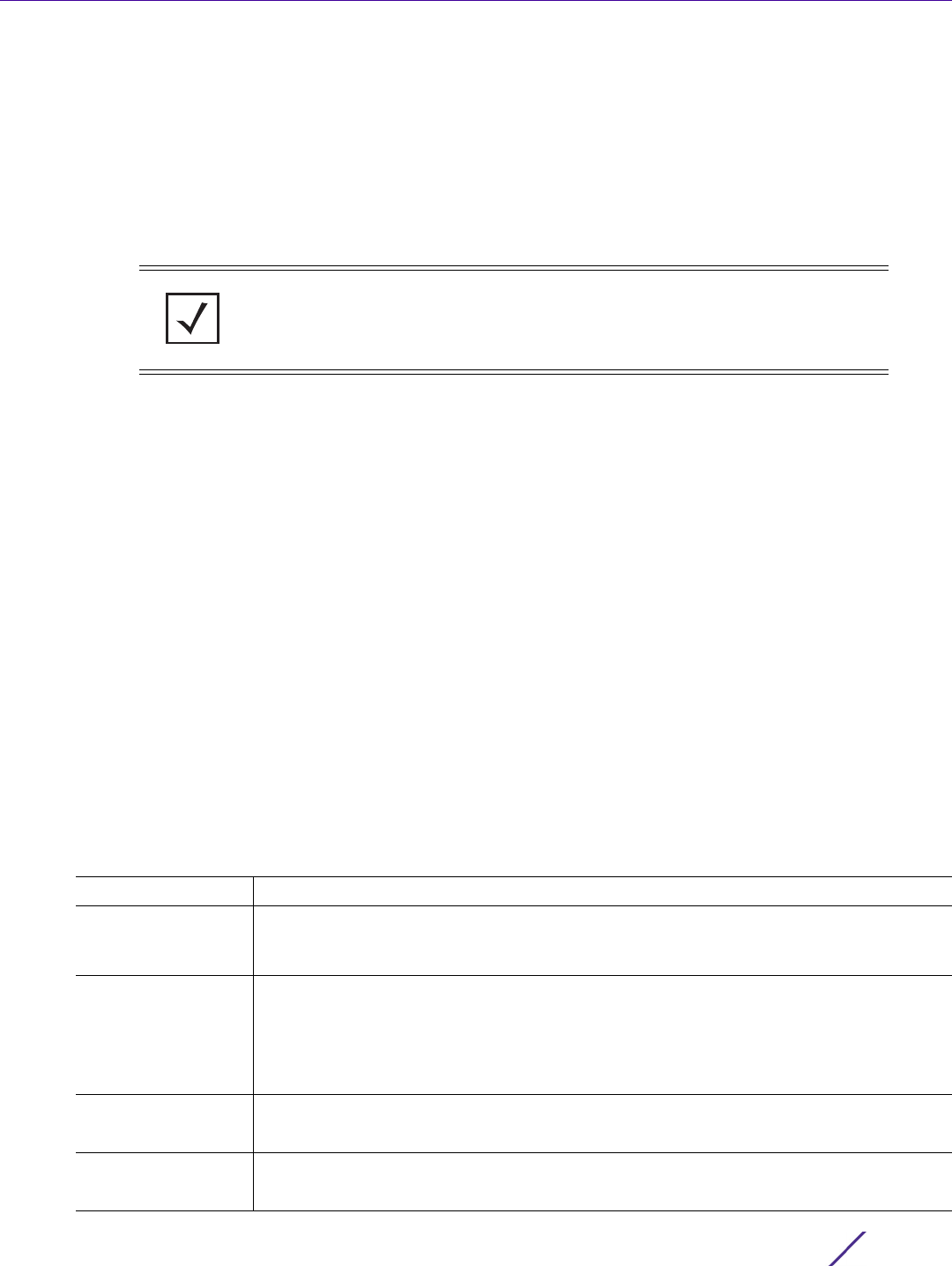
GLOBAL CONFIGURATION COMMANDS
Access Point, Wireless Controller and Service Platform CLI Reference Guide 4 - 292
4.1.55.2.4 sms
guest-management-mode commands
Configures guest user SMS notification settings
When configured, guest users can register themselves with their e-mail or mobile device ID as the primary
key for authentication. The captive portal provides the pass code for registration. Guest users use their
registered e-mail or mobile device ID and the received pass code for subsequent logins to the captive
portal.
SMS is similar to MAC address-based self registration, but in addition the captive portal sends an SMS
message, containing an access code, to the user’s mobile phone number provided at the time of
registration. The captive portal verifies the code, returns the Welcome page and provides access. This
allows the administrator to verify the phone number provided and can be traced back to a specific
individual should the need arise.
The default gateway used with SMS is Clickatell. A pass code can be sent with SMS to the guest user
directly using Clickatell, or the pass code can be sent via e-mail to the SMS Clickatell gateway server, and
Clickatell sends the pass code SMS to the guest user.
Supported in the following platforms:
• Service Platforms — NX7500, NX7510, NX7520, NX7530, NX9500, NX9510, NX9600, VX9000
Syntax
sms [host|message]
sms host clickatell username <USER-NAME> password <PASSWORD> api-id <ID> user-agent
<PYCLICKATELL> {source-number <WORD>}
sms message <LINE>
Parameters
• sms host clickatell username <USER-NAME> password <PASSWORD> api-id <ID> user-
agent <PYCLICKATELL> {source-number <WORD>}
NOTE: When using SMS, ensure that the WLAN’s mode of authentication is
set to none and the mode of registration is set to user. In other words,
captive portal authentication must always enforce guest registration.
sms Configures guest user SMS notification settings
host clickatell By default, clickatell is the host SMS gateway server resource. Upon receiving the pass
code e-mail, the SMS gateway sends the actual notification pass code SMS to the
guest user.
username
<USER-NAME>
Configures a username unique to this SMS guest management configuration. After
configuring the username, specify the associated password. Ensure that the password
is correctly provided to receive the pass code required for registering guest user
credentials with SMS.
• <USER-NAME> – Specify the username (should not exceed 32 characters).
password
<PASSWORD>
Configures the password associated with the specified username
• <PASSWORD> – Specify the password (should not exceed 63 characters).
api-id <ID> Set a 32 character maximum API ID
• <API-ID> – Specify the API ID (should not exceed 32 characters).

GLOBAL CONFIGURATION COMMANDS
Access Point, Wireless Controller and Service Platform CLI Reference Guide 4 - 293
• sms message <LINE>
Example
nx9500-6C8809(config-guest-management-test)#sms host clickatell username guest1
password guest1@123 api-id test user-agent pyclickatell
nx9500-6C8809(config-guest-management-test)#sms message Dear guest1, Your passcode
for internet access is GM-guest1
nx9500-6C8809(config-guest-management-test)#show context
guest-management test
email host 192.168.13.10 sender bob@extremenetworks.com security ssl username
guest1 password guest1@123
sms host clickatell username guest1 password guest1@123 api-id test user-agent
pyclickatell
sms message Dear guest1, Your passcode for internet access is GM-guest1
nx9500-6C8809(config-guest-management-test)#
Related Commands
user-agent
<PYCLICKATELL>
Since the SMS service provider by default is Clickatell, set the user agent name to
pyclickatell. The user-agent value ensures the Clickatell SMS gateway server and its
related credentials, needed for sending the pass code to guest users, are configured.
source-number
<WORD>
Optional. Configures the long-address or the from-number associated with this
Clickatell user account
• <WORD> – Specify the source number (should not exceed 32 characters).
SMS Configures guest user SMS notification content
message <LINE> Configures the content of the SMS sent to the guest user notifying the pass code
(should not exceed 1024 characters)
• <LINE> – Specify the message content. When entering the message, use the following
tags:
GM-NAME – for the guest user’s name
GM_PASSCODE – for the pass code
For example: Dear GM_NAME, your internet access pass code is GM_PASSCODE.
no Removes the SMS settings used to send SMS to the guest user

GLOBAL CONFIGURATION COMMANDS
Access Point, Wireless Controller and Service Platform CLI Reference Guide 4 - 294
4.1.55.2.5 sms-over-smtp
guest-management-mode commands
Configures an e-mail host server (for example: smtp.gmail.com) along with sender related credentials and
the recipient gateway e-mail address to which the message is E-mailed. The gateway server converts the
e-mail into SMS and sends the message to the guest users’s mobile device.
When sending an e-mail, the e-mail client interacts with a SMTP server to handle the content transmission.
The SMTP server on the host may have conversations with other SMTP servers to deliver the e-mail.
Supported in the following platforms:
• Service Platforms — NX7500, NX7510, NX7520, NX7530, NX9500, NX9510, NX9600, VX9000
Syntax
sms-over-smtp [host|message|subject]
sms-over-smtp host [<IP/HOSTNAME>|<HOST-ALIAS-NAME>] sender <EMAIL-ADDRESS>
security [none|ssl|starttls] username <USER-NAME> password <PASSWORD> recipient
<EMAIL-ADDRESS>
sms-over-smtp message <LINE>
sms-over-smtp subject <LINE>
Parameters
• sms-over-smtp host [<IP/HOSTNAME>|<HOST-ALIAS-NAME>] sender <EMAIL-ADDRESS>
security [none|ssl|starttls] username <USER-NAME> password <PASSWORD> recipient
<EMAIL-ADDRESS>
sms-over-smtp Configures guest user SMS over SMTP notification settings
host
[<IP/HOSTNAME>|
<HOST-ALIAS-
NAME>]
Configures the SMS gateway server resource’s IPv4 address or hostname used for
guest management SMS over SMTP traffic, guest user credential validation and pass
code reception. Optionally you can use an existing host alias to identify the SMS
gateway server resource.
• <IP/HOSTNAME> – Specify the SMTP gateway server resource’s IP address or
hostname.
• <HOST-ALIAS-NAME> – Specify the host alias name (should existing and configured).
Consider providing the host as an alias. A host alias is a configuration item that maps
the alias to a hostname. Once created, it can be used across different configuration
modes. Where ever used the alias is replaced by the associated hostname.
sender
<EMAIL-ADDRESS>
Configures the sender’s e-mail address. The sender here is the guest user receiving the
pass code. Guest users require this pass code for registering their guest e-mail
credentials using SMTP.
• <EMAIL-ADDRESS> – Specify the e-mail address (should not exceed 64 characters).
security
[none|ssl|starttls]
Configures the encryption protocol used by the SMTP server when communicating the
pass code
• none – No encryption used. Use if no additional user authentication is needed beyond
the required username and password combination.
• SSL – Uses SSL encryption. This is the default setting.
• STARTTLS – Uses STARTTLS encryption

GLOBAL CONFIGURATION COMMANDS
Access Point, Wireless Controller and Service Platform CLI Reference Guide 4 - 295
• sms-over-smtp message <LINE>
• sms-over-smtp subject <LINE>
Example
nx9500-6C8809(config-guest-management-test3)#sms-over-smtp host test sender
bob@extremenetworks.com security ssl username bob password bob@123 recipient
john@extremenetworks.com
nx9500-6C8809(config-guest-management-test3)#show context
guest-management test3
sms-over-smtp host test sender bob@extremenetworks.com security ssl username bob
password bob@123 recipient john@extremenetworks.com
nx9500-6C8809(config-guest-management-test3)#
Related Commands
username
<USER-NAME>
Configures a username unique to this SMTP guest management configuration. After
configuring the username, specify the associated password. Ensure that the correct
password is provided to receive the pass code required for registering guest user
credentials with SMTP.
• <USER-NAME> – Specify the username (should not exceed 64 characters).
password
<PASSWORD>
Configures the password associated with the specified SMTP user name
• <PASSWORD> – Specify the password (should not exceed 64 characters).
recipient
<EMAIL-ADDRESS>
Configures the e-mail recipient's e-mail address
• <EMAIL-ADDRESS> – Specify the recipient’s e-mail address (should not exceed 64
characters in length.
sms-over-smtp Configures guest user SMS over SMTP notification message content
message <LINE> Configures the content of the SMS over SMTP sent to the guest user notifying the pass
code (should not exceed 1024 characters)
• <LINE> – Specify the message content. When entering the message, use the following
tags:
GM-NAME – for the guest user’s name
GM_PASSCODE – for the pass code
CR-NL – to enter a new line
For example: Dear GM_NAME, CR-NL your internet access pass code is
GM_PASSCODE. CR-NL Use this access code for internet access.
sms-over-smtp Configures guest user e-mail notification subject line content
subject <LINE> Configures the subject line of the SMS over SMTP sent to the guest user notifying the
pass code (should not exceed 100 characters)
• <LINE> – Specify the subject line content. When entering the subject line, use the
following tag:
GM-NAME – for the guest user’s name
For example: GM_NAME, your internet access code
no Removes the SMS over SMTP settings used to send SMS to the guest user

GLOBAL CONFIGURATION COMMANDS
Access Point, Wireless Controller and Service Platform CLI Reference Guide 4 - 296
4.1.55.2.6 no
guest-management-mode commands
Removes this guest management policy settings
Supported in the following platforms:
• Service Platforms — NX7500, NX7510, NX7520, NX7530, NX9500, NX9510, NX9600, VX9000
Syntax
no [email|guest-database-backup|guest-database-export|sms|sms-over-smtp]
no email [host|message|subject]
no guest-database-backup enable
no guest-database-export
no gmd report-generation enable
no sms [host|message]
no sms-over-smtp [host|message|subject]
Parameters
• no <PARAMETERS>
Example
nx9500-6C8809(config-guest-management-test3)#show context
guest-management test3
sms-over-smtp host test sender bob@extremenetworks.com security ssl username bob
password bob@123 recipient john@extremenetworks.com
nx9500-6C8809(config-guest-management-test3)#
nx9500-6C8809(config-guest-management-test)#no sms-over-smtp host
nx9500-6C8809(config-guest-management-test3)#show context
guest-management test3
nx9500-6C8809(config-guest-management-test3)#
no <PARAMETERS> Removes this guest management policy settings based on the parameters passed

GLOBAL CONFIGURATION COMMANDS
Access Point, Wireless Controller and Service Platform CLI Reference Guide 4 - 297
4.1.56 host
Global Configuration Commands
Enters the configuration context of a remote device using its hostname
Supported in the following platforms:
• Access Points — AP6521, AP6522, AP6532, AP6562, AP7161, AP7502, AP7522, AP7532, AP7562,
AP7602, AP7612, AP7622, AP7632, AP7662, AP81XX, AP82XX, AP8432, AP8533
• Wireless Controllers — RFS4000, RFS6000
• Service Platforms — NX5500, NX7500, NX7510, NX7520, NX7530, NX9500, NX9510, NX9600,
VX9000
Syntax
host <DEVICE-NAME>
Parameters
• host <DEVICE-NAME>
Example
rfs4000-229D58(config)#host rfs4000-229D58
rfs4000-229D58(config-device-00-23-68-22-9D-58)#
<DEVICE-NAME> Specify the device’s hostname. All discovered devices are displayed when ‘Tab’ is
pressed to auto complete this command.

GLOBAL CONFIGURATION COMMANDS
Access Point, Wireless Controller and Service Platform CLI Reference Guide 4 - 298
4.1.57 inline-password-encryption
Global Configuration Commands
Stores the encryption key in the startup configuration file
By default, the encryption key is not stored in the startup-config file. Use the inline-password-encryption
command to move the encrypted key to the startup-config file. This command uses the master key to
encrypt the password, then moves it to the startup-config file.
Supported in the following platforms:
• Access Points — AP6521, AP6522, AP6532, AP6562, AP7161, AP7502, AP7522, AP7532, AP7562,
AP7602, AP7612, AP7622, AP7632, AP7662, AP81XX, AP82XX, AP8432, AP8533
• Wireless Controllers — RFS4000, RFS6000
• Service Platforms — NX5500, NX7500, NX7510, NX7520, NX7530, NX9500, NX9510, NX9600,
VX9000
Syntax
inline-password-encryption
Parameters
None
Usage Guidelines
When the configuration file is imported to a different device, it first decrypts the encryption key using the
default key and then decrypts the rest of the configuration using the administrator configured encryption
key.
Example
The following command uses the specified password for encryption key and stores it outside of
startup-config:
rfs6000-81742D(config)#password-encryption secret 2 12345678
rfs6000-81742D(config)#commit write memory
The following command moves the same password to the startup-config and encrypts it with the
master key:
rfs6000-81742D(config)#inline-password-encryption
Related Commands
no Disables storing of the encryption key in the startup configuration file
password-encryption Enables password encryption

GLOBAL CONFIGURATION COMMANDS
Access Point, Wireless Controller and Service Platform CLI Reference Guide 4 - 299
4.1.58 ip
Global Configuration Commands
Creates a IP access control list (ACL) and/or a SNMP IP ACL
Access lists define access permissions to the network using a set of rules. Each rule specifies an action
taken when a packet matches the rule. If the action is deny, the packet is dropped. If the action is permit,
the packet is allowed.
Supported in the following platforms:
• Access Points — AP6521, AP6522, AP6532, AP6562, AP7161, AP7502, AP7522, AP7532, AP7562,
AP7602, AP7612, AP7622, AP7632, AP7662, AP81XX, AP82XX, AP8432, AP8533
• Wireless Controllers — RFS4000, RFS6000
• Service Platforms — NX5500, NX7500, NX7510, NX7520, NX7530, NX9500, NX9510, NX9600,
VX9000
Syntax
ip [access-list|snmp-access-list]
ip access-list <IP-ACL-NAME>
ip snmp-access-list <IP-SNMP-ACL-NAME>
Parameters
• ip access-list <IP-ACL-NAME>
• ip snmp-access-list <IP-SNMP-ACL-NAME>
access-list
<IP-ACL-NAME>
Creates an IP ACL and enters its configuration mode
• <IP-ACL-NAME> – Specify the ACL name. If the access list does not exist, it is created.
snmp-access-list
<IP-SNMP-ACL-
NAME>
Creates a SNMP IP ACL and enters its configuration mode. An SNMP IP ACL is an
access control mechanism that uses a combination of IP ACL and SNMP community
string.
SNMP performs network management functions using a data structure called a
Management Information Base (MIB). SNMP is widely implemented but not very
secure, since it uses only text community strings for accessing controller or service
platform configuration files.
Use SNMP ACLs (firewalls) to help reduce SNMP’s vulnerabilities, as SNMP traffic can
be easily exploited to produce a denial of service (DoS).
• <IP-SNMP-ACL-NAME> – Specify the SNMP IP ACL name. If the access list does not
exist, it is created. After creating the SNMP ACL, define the deny/permit rules based
on the network and/or host IP addresses. Once created and configured, link this SNMP
IP ACL with a SNMP community string.
To link the SNMP community string with the SNMP IP ACL, in the management-
policy-config-mode, use the following command: snmp-server > community
<COMMUNITY-STRING> > [ro|rw] > ip-snmp-access-list <IP-SNMP-ACL-NAME>.

GLOBAL CONFIGURATION COMMANDS
Access Point, Wireless Controller and Service Platform CLI Reference Guide 4 - 300
Example
rfs6000-81742D(config)#ip access-list test
rfs6000-81742D(config-ip-acl-test)#?
ACL Configuration commands:
deny Specify packets to reject
disable Disable rule if not needed
no Negate a command or set its defaults
permit Specify packets to forward
clrscr Clears the display screen
commit Commit all changes made in this session
end End current mode and change to EXEC mode
exit End current mode and down to previous mode
help Description of the interactive help system
revert Revert changes
service Service Commands
show Show running system information
write Write running configuration to memory or terminal
rfs6000-81742D(config-ip-acl-test)#
rfs6000-81742D(config)#ip snmp-access-list SNMPAcl
rfs6000-81742D(config-ip-snmp-acl-SNMPAcl)#?
SNMP ACL Configuration commands:
deny Specify packets to reject
no Negate a command or set its defaults
permit Specify packets to forward
clrscr Clears the display screen
commit Commit all changes made in this session
do Run commands from Exec mode
end End current mode and change to EXEC mode
exit End current mode and down to previous mode
help Description of the interactive help system
revert Revert changes
service Service Commands
show Show running system information
write Write running configuration to memory or terminal
rfs6000-81742D(config-ip-snmp-acl-SNMPAcl)#
Related Commands
no Removes an IP access control list
NOTE: For more information on access control lists, see Chapter 11, ACCESS-
LIST.

GLOBAL CONFIGURATION COMMANDS
Access Point, Wireless Controller and Service Platform CLI Reference Guide 4 - 301
4.1.59 ipv6
Global Configuration Commands
Creates a IPv6 ACL
An IPv6 ACL defines a set of rules that filter IPv6 packets flowing through a port or interface. Each rule
specifies the action taken when a packet matches the rule. If the action is deny, the packet is dropped. If
the action is permit, the packet is allowed.
Supported in the following platforms:
• Access Points — AP6521, AP6522, AP6532, AP6562, AP7161, AP7502, AP7522, AP7532, AP7562,
AP7602, AP7612, AP7622, AP7632, AP7662, AP81XX, AP82XX, AP8432, AP8533
• Wireless Controllers — RFS4000, RFS6000
• Service Platforms — NX5500, NX7500, NX7510, NX7520, NX7530, NX9500, NX9510, NX9600,
VX9000
Syntax
ipv6 access-list <IPv6-ACL-NAME>
Parameters
• ipv6 access-list <IPv6-ACL-NAME>
Example
rfs4000-229D58(config)#ipv6 access-list IPv6ACLTest
rfs4000-229D58(config-ipv6-acl-IPv6ACLTest)#?
IPv6 Access Control Mode commands:
deny Specify packets to reject
no Negate a command or set its defaults
permit Specify packets to forward
clrscr Clears the display screen
commit Commit all changes made in this session
do Run commands from Exec mode
end End current mode and change to EXEC mode
exit End current mode and down to previous mode
help Description of the interactive help system
revert Revert changes
service Service Commands
show Show running system information
write Write running configuration to memory or terminal
rfs4000-229D58(config-ipv6-acl-IPv6ACLTest)#
Related Commands
access-list
<IPv6-ACL-NAME>
Configures an IPv6 access list and enters its configuration mode
• <IPv6-ACL-NAME> – Specify the IPv6 ACL name. If the access list does not exist, it is
created.
no Removes an IPv6 access control list
NOTE: For more information on access control lists, see Chapter 11, ACCESS-
LIST.

GLOBAL CONFIGURATION COMMANDS
Access Point, Wireless Controller and Service Platform CLI Reference Guide 4 - 302
4.1.60 ipv6-router-advertisement-policy
Global Configuration Commands
The following table lists the IPv6 router advertisement (RA) policy configuration commands:
Table 4.37 IPv6-Router-Advertisement-Policy-Config Commands
Command Description Reference
ipv6-router-
advertisement-
policy
Creates a new IPv6 RA policy and enters its configuration mode page 4-303
ipv6-router-
advertisement-
policy-mode
commands
Summarizes the IPv6 RA policy configuration mode commands page 4-305

GLOBAL CONFIGURATION COMMANDS
Access Point, Wireless Controller and Service Platform CLI Reference Guide 4 - 303
4.1.60.1 ipv6-router-advertisement-policy
ipv6-router-advertisement-policy
Creates an IPv6 RA policy and enters its configuration mode
An IPv6 router policy allows routers to advertise their presence in response to solicitation messages. After
receiving a neighbor solicitation message, the destination node sends an advertisement message. which
includes the link layer address of the source node. After receiving the advertisement, the destination device
replies with a neighbor advertisement message on the local link. After the source receives the
advertisement it can communicate with other devices.
Advertisement messages are also sent to indicate a change in link layer address for a node on the local
link. With such a change, the multicast address becomes the destination address for advertisement
messages.
Supported in the following platforms:
• Access Points — AP6521, AP6522, AP6532, AP6562, AP7161, AP7502, AP7522, AP7532, AP7562,
AP7602, AP7612, AP7622, AP7632, AP7662, AP81XX, AP82XX, AP8432, AP8533
• Wireless Controllers — RFS4000, RFS6000
• Service Platforms — NX5500, NX7500, NX7510, NX7520, NX7530, NX9500, NX9510, NX9600,
VX9000
Syntax
ipv6-router-advertisement-policy <POLICY-NAME>
Parameters
• ipv6-router-advertisement-policy <POLICY-NAME>
Example
rfs4000-229D58(config)#ipv6-router-advertisement-policy test
rfs4000-229D58(config-ipv6-radv-policy-test)#?
IPv6 Router Advertisement Policy Mode commands:
advertise Option to advertise in router advertisement
assist-neighbor-discovery Send the Source Link Layer address option
in Router Advertisement to assist in
neighbor discovery
check-ra-consistency Check if the parameters advertised by other
routers on the link are in conflict with
those configured on this router. Conflicts
are logged.
dns-server DNS Server
domain-name Configure domain-name
managed-config-flag Set the managed-address-configuration flag
in Router Advertisements. When set, it
indicates that the addresses are available
via DHCPv6
nd-reachable-time Time that a node assumes a neighbor is
reachable after having received a
reachability confirmation
no Negate a command or set its defaults
ns-interval Time between retransmitted Neighbor
Solicitation messages
other-config-flag Set the other-configuration flag in Router
Advertisements. When set, it indicates that
other configuration information is
ipv6-router-
advertisement-policy
<POLICY-NAME>
Specify an IPv6 RA policy name. If the policy does not exist, it is created.

GLOBAL CONFIGURATION COMMANDS
Access Point, Wireless Controller and Service Platform CLI Reference Guide 4 - 304
available via DHCPv6.
ra Router Advertisements
router-lifetime Lifetime associated with the default router
router-preference Preference of this router over other
routers
unicast-solicited-advertisement Unicast the solicited Router Advertisements
clrscr Clears the display screen
commit Commit all changes made in this session
do Run commands from Exec mode
end End current mode and change to EXEC mode
exit End current mode and down to previous mode
help Description of the interactive help system
revert Revert changes
service Service Commands
show Show running system information
write Write running configuration to memory or
terminal
rfs4000-229D58(config-ipv6-radv-policy-test)#
Related Commands
no Removes the specified IPv6 RA policy

GLOBAL CONFIGURATION COMMANDS
Access Point, Wireless Controller and Service Platform CLI Reference Guide 4 - 305
4.1.60.2 ipv6-router-advertisement-policy-mode commands
ipv6-router-advertisement-policy
The following table summarizes IPv6 router advertisement policy configuration commands:
Table 4.38 IPv6-Router-Advertisement-Policy-Config-Mode Commands
Command Description Reference
advertise Enables advertisement of IPv6 maximum transmission unit (MTU) and
hop-count value in RAs
page 4-306
assist-neighbor-
discovery
Enables advertisement of the source link layer address in RAs page 4-307
check-ra-
consistency
Enables checking of consistency in RA values advertised by this router
with those advertised by other routers, if any, on the same link
page 4-308
dns-server Configures the DNS server’s IPv6 address and lifetime advertised in RAs page 4-309
domain-name Configures the Domain name search label advertised in RAs page 4-310
managed-config-
flag
Sets the managed address configuration flag in RAs page 4-311
nd-reachable-
time
Enables advertisement of neighbor reachable time in RAs page 4-312
no Removes or reverts router advertisement policy settings page 4-313
ns-interval Configures the interval between two successive retransmitted neighbor
solicitation (NS) messages
page 4-314
other-config-flag Sets the other-configuration flag in RAs page 4-315
ra Configures RA related parameters, such as the interval between two
unsolicited successive RAs
page 4-316
router-lifetime Configures the default router’s lifetime, in seconds, advertised in RAs page 4-317
router-preference Configures the router preference field value advertised in RAs page 4-318
unicast-solicited-
advertisement
Enables unicasting of solicited RAs page 4-319

GLOBAL CONFIGURATION COMMANDS
Access Point, Wireless Controller and Service Platform CLI Reference Guide 4 - 306
4.1.60.2.1 advertise
ipv6-router-advertisement-policy-mode commands
Enables advertisement of IPv6 MTU and hop-count value in RAs
Supported in the following platforms:
• Access Points — AP6521, AP6522, AP6532, AP6562, AP7161, AP7502, AP7522, AP7532, AP7562,
AP7602, AP7612, AP7622, AP7632, AP7662, AP81XX, AP82XX, AP8432, AP8533
• Wireless Controllers — RFS4000, RFS6000
• Service Platforms — NX5500, NX7500, NX7510, NX7520, NX7530, NX9500, NX9510, NX9600,
VX9000
Syntax
advertise [hop-limit|mtu]
Parameters
• advertise [hop-limit|mtu]
Example
rfs6000-81742D(config-ipv6-radv-policy-test)#advertise hop-limit
rfs6000-81742D(config-ipv6-radv-policy-test)#advertise mtu
rfs6000-81742D(config-ipv6-radv-policy-test)#show context
ipv6-router-advertisement-policy test
advertise mtu
advertise hop-limit
rfs6000-81742D(config-ipv6-radv-policy-test)#
Related Commands
advertise
[hop-limit|mtu]
Enables advertisement of IPv6 MTU and hop-count value in RAs. Both these features
are disabled by default.
no Disables advertisement of IPv6 MTU and hop-count value in RAs

GLOBAL CONFIGURATION COMMANDS
Access Point, Wireless Controller and Service Platform CLI Reference Guide 4 - 307
4.1.60.2.2 assist-neighbor-discovery
ipv6-router-advertisement-policy-mode commands
Enables advertisement of the source link layer address in RAs to facilitate neighbor discovery. This feature
is enabled by default.
Supported in the following platforms:
• Access Points — AP6521, AP6522, AP6532, AP6562, AP7161, AP7502, AP7522, AP7532, AP7562,
AP7602, AP7612, AP7622, AP7632, AP7662, AP81XX, AP82XX, AP8432, AP8533
• Wireless Controllers — RFS4000, RFS6000
• Service Platforms — NX5500, NX7500, NX7510, NX7520, NX7530, NX9500, NX9510, NX9600,
VX9000
Syntax
assist-neighbor-discovery
Parameters
None
Example
rfs6000-81742D(config-ipv6-radv-policy-test)#assist-neighbor-discovery
Related Commands
no Disables the advertisement of the source link layer address in RAs

GLOBAL CONFIGURATION COMMANDS
Access Point, Wireless Controller and Service Platform CLI Reference Guide 4 - 308
4.1.60.2.3 check-ra-consistency
ipv6-router-advertisement-policy-mode commands
Enables checking of consistency in RA values advertised by this router with those advertised by other
routers, if any, on the same link. If the values advertised are inconsistent, a conflict is logged.
Supported in the following platforms:
• Access Points — AP6521, AP6522, AP6532, AP6562, AP7161, AP7502, AP7522, AP7532, AP7562,
AP7602, AP7612, AP7622, AP7632, AP7662, AP81XX, AP82XX, AP8432, AP8533
• Wireless Controllers — RFS4000, RFS6000
• Service Platforms — NX5500, NX7500, NX7510, NX7520, NX7530, NX9500, NX9510, NX9600,
VX9000
Syntax
check-ra-consistency
Parameters
None
Example
rfs6000-81742D(config-ipv6-radv-policy-test)#check-ra-consistency
rfs6000-81742D(config-ipv6-radv-policy-test)#show context
ipv6-router-advertisement-policy test
advertise mtu
advertise hop-limit
check-ra-consistency
rfs6000-81742D(config-ipv6-radv-policy-test)#
Related Commands
no Disables comparison of interface-specific parameters advertised by other routers,
within the link, with those advertised with this router

GLOBAL CONFIGURATION COMMANDS
Access Point, Wireless Controller and Service Platform CLI Reference Guide 4 - 309
4.1.60.2.4 dns-server
ipv6-router-advertisement-policy-mode commands
Configures the DNS server’s IPv6 address and lifetime. The configured values are advertised in RAs.
Supported in the following platforms:
• Access Points — AP6521, AP6522, AP6532, AP6562, AP7161, AP7502, AP7522, AP7532, AP7562,
AP7602, AP7612, AP7622, AP7632, AP7662, AP81XX, AP82XX, AP8432, AP8533
• Wireless Controllers — RFS4000, RFS6000
• Service Platforms — NX5500, NX7500, NX7510, NX7520, NX7530, NX9500, NX9510, NX9600,
VX9000
Syntax
dns-server <IPv6> {lifetime [<4-3600>|expired|infinite]}
Parameters
• dns-server <IPv6> {lifetime [<4-3600>|expired|infinite]}
Example
rfs6000-81742D(config-ipv6-radv-policy-test)#dns-server 2002::2 lifetime 3000
rfs6000-81742D(config-ipv6-radv-policy-test)#show context
ipv6-router-advertisement-policy test
advertise mtu
advertise hop-limit
check-ra-consistency
dns-server 2002::2 lifetime 3000
rfs6000-81742D(config-ipv6-radv-policy-test)#
Related Commands
dns-server <IPv6> Configures the DNS server’s IPv6 address
Enables the use of a DNS server to resolve host names to IPv6 addresses. When an
IPv6 host is configured with the address of a DNS server, the host sends DNS name
queries to the server for resolution.
• <IPv6> – Specify the DNS server’s address. This address is advertised in RAs. A
maximum of four (4) entries can be made per policy.
lifetime [<4-
3600>|expired|infinit
e]
Optional. Configures the DNS server’s (identified by the <IPv6> parameter) lifetime
• <4-3600> – Configures a lifetime in seconds. Specify a value form 4 - 3600 seconds.
The default is 600 seconds.
• expired – Advertises that this DNS server’s lifetime has expired and should not be used
• infinite – Advertises that this DNS server’s lifetime is infinite
no Removes the DNS server settings advertised in RAs. Once removed these values are
not advertised in RAs.

GLOBAL CONFIGURATION COMMANDS
Access Point, Wireless Controller and Service Platform CLI Reference Guide 4 - 310
4.1.60.2.5 domain-name
ipv6-router-advertisement-policy-mode commands
Configures the Domain name search label advertised in RAs
Supported in the following platforms:
• Access Points — AP6521, AP6522, AP6532, AP6562, AP7161, AP7502, AP7522, AP7532, AP7562,
AP7602, AP7612, AP7622, AP7632, AP7662, AP81XX, AP82XX, AP8432, AP8533
• Wireless Controllers — RFS4000, RFS6000
• Service Platforms — NX5500, NX7500, NX7510, NX7520, NX7530, NX9500, NX9510, NX9600,
VX9000
Syntax
domain-name <WORD> {lifetime [<4-3600>|expired|infinite]}
Parameters
• domain-name <WORD> {lifetime [<4-3600>|expired|infinite]}
Example
rfs6000-81742D(config-ipv6-radv-policy-test)#domain-name TechPubs lifetime
infinite
rfs6000-81742D(config-ipv6-radv-policy-test)#show context
ipv6-router-advertisement-policy test
advertise mtu
advertise hop-limit
check-ra-consistency
dns-server 2002::2 lifetime 3000
domain-name TechPubs lifetime infinite
rfs6000-81742D(config-ipv6-radv-policy-test)#
Related Commands
domain-name
<WORD>
Configures the Domain name search label advertised in RAs
Enter a fully qualified domain name (FQDN), which is an unambiguous domain name
available in a router advertisement resource. To distinguish an FQDN from a regular
domain name, a trailing period is added. For example, somehost.example.com.
• <WORD> – Specify the Domain name search label. A maximum of four (4) entries can
be made per policy.
lifetime [<4-3600>|
expired|infinite]
Optional. Configures the Domain name search label's lifetime
• <4-3600> – Configures a lifetime in seconds. Specify a value form 4 - 3600 seconds.
The default is 600 seconds.
• expired – Advertises that this Domain name search label's lifetime has expired and
should not be used
• infinite – Advertises that this Domain name search label's lifetime is infinite
no Removes the Domain name settings advertised in RAs. Once removed these values
are not advertised in RAs.

GLOBAL CONFIGURATION COMMANDS
Access Point, Wireless Controller and Service Platform CLI Reference Guide 4 - 311
4.1.60.2.6 managed-config-flag
ipv6-router-advertisement-policy-mode commands
Sets the managed address configuration flag in RAs. When set, it indicates that IPv6 addresses are
available through DHCPv6. This feature is disabled by default.
Supported in the following platforms:
• Access Points — AP6521, AP6522, AP6532, AP6562, AP7161, AP7502, AP7522, AP7532, AP7562,
AP7602, AP7612, AP7622, AP7632, AP7662, AP81XX, AP82XX, AP8432, AP8533
• Wireless Controllers — RFS4000, RFS6000
• Service Platforms — NX5500, NX7500, NX7510, NX7520, NX7530, NX9500, NX9510, NX9600,
VX9000
Syntax
managed-config-flag
Parameters
None
Example
rfs6000-81742D(config-ipv6-radv-policy-test)#managed-config-flag
rfs6000-81742D(config-ipv6-radv-policy-test)#show context
ipv6-router-advertisement-policy test
managed-config-flag
advertise mtu
advertise hop-limit
check-ra-consistency
dns-server 2002::2 lifetime 3000
domain-name TechPubs lifetime infinite
rfs6000-81742D(config-ipv6-radv-policy-test)#
Related Commands
no Removes the managed address configuration flag advertised in RAs

GLOBAL CONFIGURATION COMMANDS
Access Point, Wireless Controller and Service Platform CLI Reference Guide 4 - 312
4.1.60.2.7 nd-reachable-time
ipv6-router-advertisement-policy-mode commands
Enables advertisement of neighbor discovery reachable time in RAs. This feature is disabled by default.
Supported in the following platforms:
• Access Points — AP6521, AP6522, AP6532, AP6562, AP7161, AP7502, AP7522, AP7532, AP7562,
AP7602, AP7612, AP7622, AP7632, AP7662, AP81XX, AP82XX, AP8432, AP8533
• Wireless Controllers — RFS4000, RFS6000
• Service Platforms — NX5500, NX7500, NX7510, NX7520, NX7530, NX9500, NX9510, NX9600,
VX9000
Syntax
nd-reachable-time [<5000-3600000>|global]
Parameters
• nd-reachable-time [<5000-3600000>|global]
Example
rfs6000-81742D(config-ipv6-radv-policy-test)#nd-reachable-time 6000
rfs6000-81742D(config-ipv6-radv-policy-test)#show context
ipv6-router-advertisement-policy test
managed-config-flag
nd-reachable-time 6000
advertise mtu
advertise hop-limit
check-ra-consistency
dns-server 2002::2 lifetime 3000
domain-name TechPubs lifetime infinite
rfs6000-81742D(config-ipv6-radv-policy-test)#
Related Commands
nd-reachable-time
[<5000-3600000>|
global]
Configures the interval, in milliseconds, that a node assumes a neighbor is reachable
after receiving a reachability confirmation from the neighbor. Therefore, a neighbor is
reachable, after being discovered, for a period specified here. This value is advertised in
RAs. Use one of the following options:
• <5000-3600000> – Configures an interface-specific value. Specify a value from
5000 - 3600000 milliseconds. The default is 5000 milliseconds.
• global – Advertises the neighbor reachable time configured for the system. This is the
value configured at the device configuration mode. For more information, see use.
no Disables advertisement of neighbor reachable time in RAs

GLOBAL CONFIGURATION COMMANDS
Access Point, Wireless Controller and Service Platform CLI Reference Guide 4 - 313
4.1.60.2.8 no
ipv6-router-advertisement-policy-mode commands
Removes or reverts router advertisement policy settings. Use the no command to remove or revert the
interface-specific parameters that are advertised by link router.
Supported in the following platforms:
• Access Points — AP6521, AP6522, AP6532, AP6562, AP7161, AP7502, AP7522, AP7532, AP7562,
AP7602, AP7612, AP7622, AP7632, AP7662, AP81XX, AP82XX, AP8432, AP8533
• Wireless Controllers — RFS4000, RFS6000
• Service Platforms — NX5500, NX7500, NX7510, NX7520, NX7530, NX9500, NX9510, NX9600,
VX9000
Syntax
no [advertise [hop-limit|mtu]|assist-neighbor-discovery|check-ra-consistency|
dns-server <IPv6>|domain-name <WORD>|managed-config-flag|nd-reachable-time|
ns-interval|other-config-flag|ra [interval|suppress]|router-lifetime|
unicast-solicited-advertisement]
Parameters
• no <PARAMETERS>
Example
rfs6000-81742D(config-ipv6-radv-policy-test)#show context
ipv6-router-advertisement-policy test
managed-config-flag
nd-reachable-time global
advertise mtu
advertise hop-limit
check-ra-consistency
dns-server 2002::2 lifetime 3000
domain-name TechPubs lifetime infinite
rfs6000-81742D(config-ipv6-radv-policy-test)#
rfs6000-81742D(config-ipv6-radv-policy-test)#no managed-config-flag
rfs6000-81742D(config-ipv6-radv-policy-test)#no nd-reachable-time
rfs6000-81742D(config-ipv6-radv-policy-test)#no check-ra-consistency
rfs6000-81742D(config-ipv6-radv-policy-test)#show context
ipv6-router-advertisement-policy test
advertise mtu
advertise hop-limit
dns-server 2002::2 lifetime 3000
domain-name TechPubs lifetime infinite
rfs6000-81742D(config-ipv6-radv-policy-test)#
no <PARAMETERS> Removes or reverts this IPv6 router advertisement policy’s settings based on the
parameters passed

GLOBAL CONFIGURATION COMMANDS
Access Point, Wireless Controller and Service Platform CLI Reference Guide 4 - 314
4.1.60.2.9 ns-interval
ipv6-router-advertisement-policy-mode commands
Configures the neighbor solicitation (NS) retransmit timer value advertised in RAs. This is the interval
between two successive NS messages. When specified, it enables the sending of the specified value in RAs.
This feature is disabled by default.
Supported in the following platforms:
• Access Points — AP6521, AP6522, AP6532, AP6562, AP7161, AP7502, AP7522, AP7532, AP7562,
AP7602, AP7612, AP7622, AP7632, AP7662, AP81XX, AP82XX, AP8432, AP8533
• Wireless Controllers — RFS4000, RFS6000
• Service Platforms — NX5500, NX7500, NX7510, NX7520, NX7530, NX9500, NX9510, NX9600,
VX9000
Syntax
ns-interval [<1000-3600000>|global]
Parameters
• ns-interval [<1000-3600000>|global]
Example
rfs6000-81742D(config-ipv6-radv-policy-test)#ns-interval 3000
rfs6000-81742D(config-ipv6-radv-policy-test)#show context
ipv6-router-advertisement-policy test
managed-config-flag
nd-reachable-time global
ns-interval 3000
advertise mtu
advertise hop-limit
check-ra-consistency
dns-server 2002::2 lifetime 3000
domain-name TechPubs lifetime infinite
rfs6000-81742D(config-ipv6-radv-policy-test)#
Related Commands
ns-interval
[<1000-3600000>|
global]
Configures the NS interval advertised in RAs. Use one of the following options:
• <1000-3600000> – Specify a value from 1000 - 3600000 milliseconds. The default is
1000 milliseconds.
• global – Advertises the NS interval configured for the system. This is configured on the
device in the device configuration mode. For more information, see ipv6.
no Disables advertisement of NS interval in RAs

GLOBAL CONFIGURATION COMMANDS
Access Point, Wireless Controller and Service Platform CLI Reference Guide 4 - 315
4.1.60.2.10 other-config-flag
ipv6-router-advertisement-policy-mode commands
Sets the other-configuration flag in RAs. When set, it indicates that other configuration details, such as
DNS-related information, are available through DHCPv6. This feature is enabled by default.
Supported in the following platforms:
• Access Points — AP6521, AP6522, AP6532, AP6562, AP7161, AP7502, AP7522, AP7532, AP7562,
AP7602, AP7612, AP7622, AP7632, AP7662, AP81XX, AP82XX, AP8432, AP8533
• Wireless Controllers — RFS4000, RFS6000
• Service Platforms — NX5500, NX7500, NX7510, NX7520, NX7530, NX9500, NX9510, NX9600,
VX9000
Syntax
other-config-flag
Parameters
None
Example
rfs6000-81742D(config-ipv6-radv-policy-test)#other-config-flag
Related Commands
no Removes the other-config-flag advertised on RAs

GLOBAL CONFIGURATION COMMANDS
Access Point, Wireless Controller and Service Platform CLI Reference Guide 4 - 316
4.1.60.2.11 ra
ipv6-router-advertisement-policy-mode commands
Configures RA related parameters, such as the interval between two unsolicited successive RAs. It also
allows suppression of RAs.
Supported in the following platforms:
• Access Points — AP6521, AP6522, AP6532, AP6562, AP7161, AP7502, AP7522, AP7532, AP7562,
AP7602, AP7612, AP7622, AP7632, AP7662, AP81XX, AP82XX, AP8432, AP8533
• Wireless Controllers — RFS4000, RFS6000
• Service Platforms — NX5500, NX7500, NX7510, NX7520, NX7530, NX9500, NX9510, NX9600,
VX9000
Syntax
ra [interval <3-1800>|suppress]
Parameters
• ra [interval <3-1800>|suppress]
Example
rfs6000-81742D(config-ipv6-radv-policy-test)#ra interval 200
rfs6000-81742D(config-ipv6-radv-policy-test)#ra suppress
rfs6000-81742D(config-ipv6-radv-policy-test)#show context
ipv6-router-advertisement-policy test
ra suppress
ra interval 200
managed-config-flag
nd-reachable-time global
advertise mtu
advertise hop-limit
check-ra-consistency
dns-server 2002::2 lifetime 3000
domain-name TechPubs lifetime infinite
rfs6000-81742D(config-ipv6-radv-policy-test)#
Related Commands
interval <3-1800> Configures the interval, in seconds, between two unsolicited successive RAs
• <3-1800> – Specify a value from 3 - 1800 seconds. The default is 300 seconds.
The router-lifetime should be at least three times the specified router interval.
suppress Enables the suppression of RAs. When enabled, the transmission of RAs in IPv6
packets is suppressed. This option is disabled by default.
The no > ra > suppress command enables the sending of RAs.
no Removes the RA interval, and enables the sending of RAs

GLOBAL CONFIGURATION COMMANDS
Access Point, Wireless Controller and Service Platform CLI Reference Guide 4 - 317
4.1.60.2.12 router-lifetime
ipv6-router-advertisement-policy-mode commands
Configures the default router’s lifetime, in seconds, advertised in RAs
Supported in the following platforms:
• Access Points — AP6521, AP6522, AP6532, AP6562, AP7161, AP7502, AP7522, AP7532, AP7562,
AP7602, AP7612, AP7622, AP7632, AP7662, AP81XX, AP82XX, AP8432, AP8533
• Wireless Controllers — RFS4000, RFS6000
• Service Platforms — NX5500, NX7500, NX7510, NX7520, NX7530, NX9500, NX9510, NX9600,
VX9000
Syntax
router-lifetime <0-9000>
Parameters
• router-lifetime <0-9000>
Example
rfs6000-81742D(config-ipv6-radv-policy-test)#router-lifetime 2000
rfs6000-81742D(config-ipv6-radv-policy-test)#show context
ipv6-router-advertisement-policy test
ra suppress
ra interval 200
managed-config-flag
nd-reachable-time global
router-lifetime 2000
advertise mtu
advertise hop-limit
check-ra-consistency
dns-server 2002::2 lifetime 3000
domain-name TechPubs lifetime infinite
rfs6000-81742D(config-ipv6-radv-policy-test)#
Related Commands
router-lifetime
<0-9000>
Configures the default router’s lifetime
• <0-9000> – Specify a value from 0 - 9000 seconds. The default value is 1500 seconds.
A value of “0” indicates that this router is not the default router.
no Removes the default router’s lifetime

GLOBAL CONFIGURATION COMMANDS
Access Point, Wireless Controller and Service Platform CLI Reference Guide 4 - 318
4.1.60.2.13 router-preference
ipv6-router-advertisement-policy-mode commands
Configures the router preference field value advertised in RAs. The options are high, medium, and low. This
value is used to prioritize and select the default router when multiple routers are discovered.
Supported in the following platforms:
• Access Points — AP6521, AP6522, AP6532, AP6562, AP7161, AP7502, AP7522, AP7532, AP7562,
AP7602, AP7612, AP7622, AP7632, AP7662, AP81XX, AP82XX, AP8432, AP8533
• Wireless Controllers — RFS4000, RFS6000
• Service Platforms — NX5500, NX7500, NX7510, NX7520, NX7530, NX9500, NX9510, NX9600,
VX9000
Syntax
router-preference [high|medium|low]
Parameters
• router-preference [high|medium|low]
Example
rfs6000-81742D(config-ipv6-radv-policy-test)#router-preference high
rfs6000-81742D(config-ipv6-radv-policy-test)#show context
ipv6-router-advertisement-policy test
ra suppress
ra interval 200
managed-config-flag
nd-reachable-time global
router-lifetime 2000
advertise mtu
advertise hop-limit
router-preference high
check-ra-consistency
dns-server 2002::2 lifetime 3000
domain-name TechPubs lifetime infinite
rfs6000-81742D(config-ipv6-radv-policy-test)#
router-preference
[high|medium|low]
Sets this router’s preference over other routers, in the link, to be the default router. The
options are high, low, and medium. The default value is medium.
The following points should be taken into consideration when configuring router
preference:
• For a router to be selected as a default router, the router’s lifetime should not be equal
to “0”.
• To enable default router selection, using router information contained in RAs, configure
default router selection on that interface.

GLOBAL CONFIGURATION COMMANDS
Access Point, Wireless Controller and Service Platform CLI Reference Guide 4 - 319
4.1.60.2.14 unicast-solicited-advertisement
ipv6-router-advertisement-policy-mode commands
Enables unicasting of solicited RAs. This feature is disabled by default.
Supported in the following platforms:
• Access Points — AP6521, AP6522, AP6532, AP6562, AP7161, AP7502, AP7522, AP7532, AP7562,
AP7602, AP7612, AP7622, AP7632, AP7662, AP81XX, AP82XX, AP8432, AP8533
• Wireless Controllers — RFS4000, RFS6000
• Service Platforms — NX5500, NX7500, NX7510, NX7520, NX7530, NX9500, NX9510, NX9600,
VX9000
Syntax
unicast-solicited-advertisement
Parameters
None
Example
rfs6000-81742D(config-ipv6-radv-policy-test)#unicast-solicited-advertisement
rfs6000-81742D(config-ipv6-radv-policy-test)#show context
ipv6-router-advertisement-policy test
ra suppress
ra interval 200
unicast-solicited-advertisement
managed-config-flag
nd-reachable-time global
router-lifetime 2000
advertise mtu
advertise hop-limit
router-preference high
check-ra-consistency
dns-server 2002::2 lifetime 3000
domain-name TechPubs lifetime infinite
rfs6000-81742D(config-ipv6-radv-policy-test)#
Related Commands
no Disables unicasting of solicited RAs

GLOBAL CONFIGURATION COMMANDS
Access Point, Wireless Controller and Service Platform CLI Reference Guide 4 - 320
4.1.61 l2tpv3
Global Configuration Commands
Configures a Layer 2 Tunnel Protocol Version 3 (L2TPv3) tunnel policy, used to create one or more L2TPv3
tunnels
The L2TPv3 policy defines the control and encapsulation protocols needed for tunneling layer 2 frames
between two IP nodes. This policy enables creation of L2TPv3 tunnels for transporting Ethernet frames
between bridge VLANs and physical GE ports. L2TPv3 tunnels can be created between any vendor devices
supporting L2TPv3 protocol.
Supported in the following platforms:
• Access Points — AP6521, AP6522, AP6532, AP6562, AP7161, AP7502, AP7522, AP7532, AP7562,
AP7602, AP7612, AP7622, AP7632, AP7662, AP81XX, AP82XX, AP8432, AP8533
• Wireless Controllers — RFS4000, RFS6000
• Service Platforms — NX5500, NX7500, NX7510, NX7520, NX7530, NX9500, NX9510, NX9600,
VX9000
Syntax
l2tpv3 policy <L2TPV3-POLICY-NAME>
Parameters
• l2tpv3 policy <L2TPV3-POLICY-NAME>
Example
rfs6000-81742D(config)#l2tpv3 policy L2TPV3Policy1
rfs6000-81742D(config-l2tpv3-policy-L2TPV3Policy1)#?
L2tpv3 Policy Mode commands:
cookie-size Size of the cookie field present in each l2tpv3 data
message
failover-delay Time interval for re-establishing the tunnel after
the failover (RF-Domain
manager/VRRP-master/Cluster-master failover)
force-l2-path-recovery Enables force learning of servers, gateways etc.,
behind the l2tpv3 tunnel when the tunnel is
established
hello-interval Configure the time interval (in seconds) between
l2tpv3 Hello keep-alive messages exchanged in l2tpv3
control connection
no Negate a command or set its defaults
reconnect-attempts Maximum number of attempts to reestablish the
tunnel.
reconnect-interval Time interval between the successive attempts to
reestablish the l2tpv3 tunnel
retry-attempts Configure the maximum number of retransmissions for
signaling message
retry-interval Time interval (in seconds) before the initiating a
retransmission of any l2tpv3 signaling message
rx-window-size Number of signaling messages that can be received
without sending the acknowledgement
tx-window-size Number of signaling messages that can be sent
without receiving the acknowledgement
clrscr Clears the display screen
commit Commit all changes made in this session
l2tpv3 policy
<L2TPV3-POLICY-
NAME>
Configures an L2TPv3 tunnel policy
• <L2TPV3-POLICY-NAME> – Specify a policy name. The policy is created if it does not
exist. To modify an existing L2TPv3, specify its name.
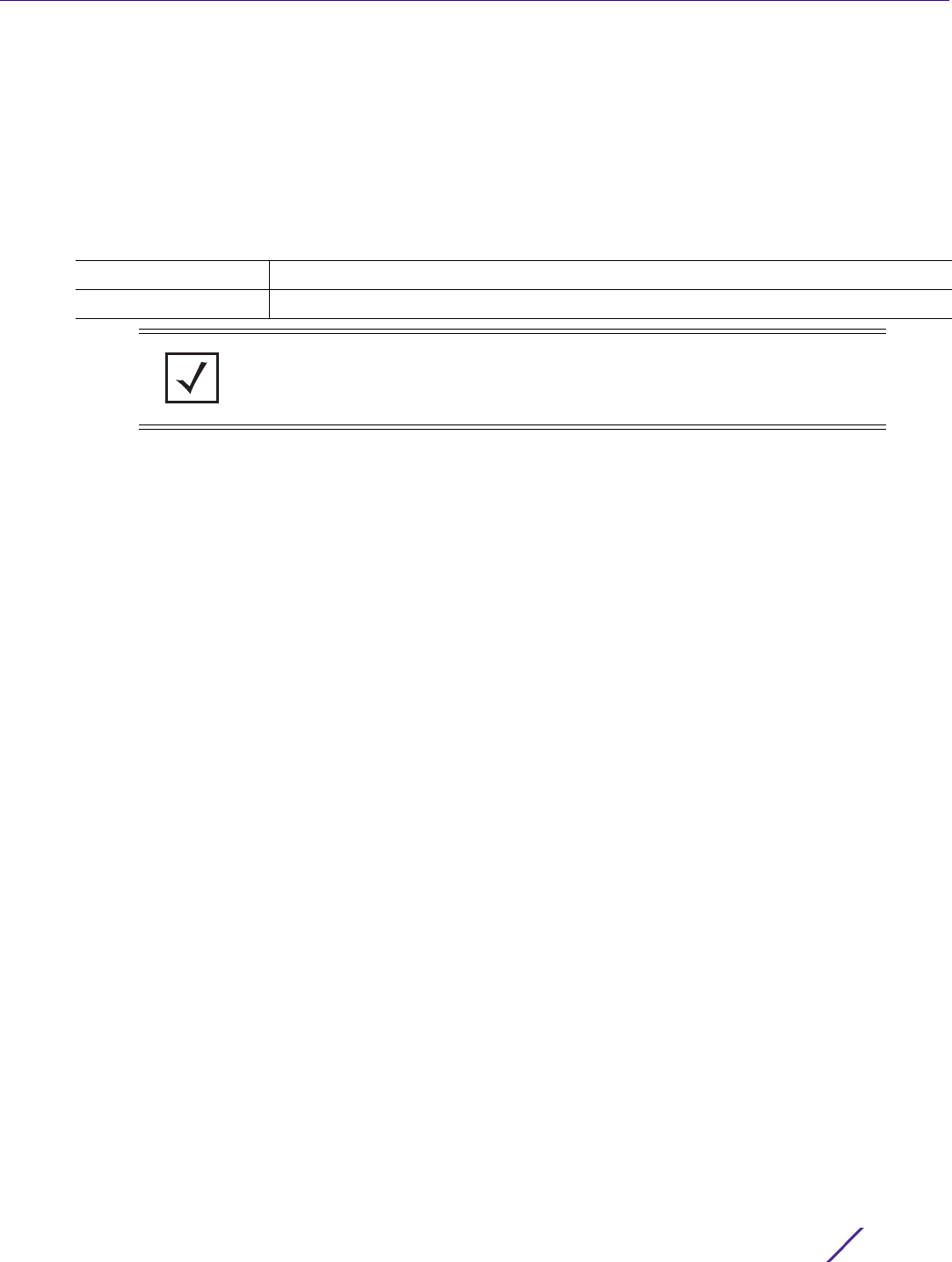
GLOBAL CONFIGURATION COMMANDS
Access Point, Wireless Controller and Service Platform CLI Reference Guide 4 - 321
end End current mode and change to EXEC mode
exit End current mode and down to previous mode
help Description of the interactive help system
revert Revert changes
service Service Commands
show Show running system information
write Write running configuration to memory or terminal
rfs6000-81742D(config-l2tpv3-policy-L2TPV3Policy1)#
Related Commands
no Removes an existing L2TPv3 tunnel policy
mint-policy Configures the global MiNT policy
NOTE: For more information on the L2TPv3 tunnel configuration mode and
commands, see Chapter 22, L2TPV3-POLICY.

GLOBAL CONFIGURATION COMMANDS
Access Point, Wireless Controller and Service Platform CLI Reference Guide 4 - 322
4.1.62 mac
Global Configuration Commands
Configures a MAC ACLs
Access lists define access permissions to the network using a set of rules. Each rule specifies an action
taken when a packet matches the rule. If the action is deny, the packet is dropped. If the action is permit,
the packet is allowed.
Supported in the following platforms:
• Access Points — AP6521, AP6522, AP6532, AP6562, AP7161, AP7502, AP7522, AP7532, AP7562,
AP7602, AP7612, AP7622, AP7632, AP7662, AP81XX, AP82XX, AP8432, AP8533
• Wireless Controllers — RFS4000, RFS6000
• Service Platforms — NX5500, NX7500, NX7510, NX7520, NX7530, NX9500, NX9510, NX9600,
VX9000
Syntax
mac access-list <MAC-ACL-NAME>
Parameters
• mac access-list <MAC-ACL-NAME>
Example
rfs6000-81742D(config)#mac access-list test
rfs6000-81742D(config-mac-acl-test)#?
MAC Extended ACL Configuration commands:
deny Specify packets to reject
disable Disable rule if not needed
no Negate a command or set its defaults
permit Specify packets to forward
clrscr Clears the display screen
commit Commit all changes made in this session
end End current mode and change to EXEC mode
exit End current mode and down to previous mode
help Description of the interactive help system
revert Revert changes
service Service Commands
show Show running system information
write Write running configuration to memory or terminal
rfs6000-81742D(config-mac-acl-test)#
Related Commands
access-list
<MAC-ACL-NAME>
Configures a MAC access control list
• <MAC-ACL-NAME> – Specify the MAC ACL name. If the access control list does not
exist, it is created.
no Removes a MAC access control list
NOTE: For more information on MAC access control lists, see Chapter 11, ACCESS-LIST.

GLOBAL CONFIGURATION COMMANDS
Access Point, Wireless Controller and Service Platform CLI Reference Guide 4 - 323
4.1.63 management-policy
Global Configuration Commands
Configures a management policy. Management policies include services that run on a device, welcome
messages, banners, etc.
Supported in the following platforms:
• Access Points — AP6521, AP6522, AP6532, AP6562, AP7161, AP7502, AP7522, AP7532, AP7562,
AP7602, AP7612, AP7622, AP7632, AP7662, AP81XX, AP82XX, AP8432, AP8533
• Wireless Controllers — RFS4000, RFS6000
• Service Platforms — NX5500, NX7500, NX7510, NX7520, NX7530, NX9500, NX9510, NX9600,
VX9000
Syntax
management-policy <MANAGEMENT-POLICY-NAME>
Parameters
• management-policy <MANAGEMENT-POLICY-NAME>
Example
<DEVICE>(config)#management-policy test
<DEVICE>(config-management-policy-test)#?
Management Mode commands:
aaa-login Set authentication for logins
allowed-locations Add allowed locations
banner Define a login banner
ftp Enable FTP server
http Hyper Text Terminal Protocol (HTTP)
https Secure HTTP
idle-session-timeout Configure idle timeout for a configuration session
(GUI or CLI)
ipv6 IPv6 Protocol
no Negate a command or set its defaults
passwd-retry Lockout user if too many consecutive login failures
privilege-mode-password Set the password for entering CLI privilege mode
rest-server Enable rest server for device on-boarding
functionality
restrict-access Restrict management access to the device
snmp-server SNMP
ssh Enable ssh
t5 T5 configuration
telnet Enable telnet
user Add a user account
clrscr Clears the display screen
commit Commit all changes made in this session
do Run commands from Exec mode
end End current mode and change to EXEC mode
exit End current mode and down to previous mode
help Description of the interactive help system
revert Revert changes
service Service Commands
show Show running system information
write Write running configuration to memory or terminal
<DEVICE>(config-management-policy-test)#
<MANAGEMENT-
POLICY-NAME>
Specify the management policy name. If the policy does not exist, it is created.

GLOBAL CONFIGURATION COMMANDS
Access Point, Wireless Controller and Service Platform CLI Reference Guide 4 - 324
Related Commands
no Removes an existing management policy
NOTE: For more information on Management policy configuration, see
Chapter 15, MANAGEMENT-POLICY.

GLOBAL CONFIGURATION COMMANDS
Access Point, Wireless Controller and Service Platform CLI Reference Guide 4 - 325
4.1.64 meshpoint
Global Configuration Commands
Creates a new meshpoint and enters its configuration mode. Use this command to select and configure
existing meshpoints.
Supported in the following platforms:
• Access Points — AP6522, AP6532, AP6562, AP7161, AP7522, AP7532, AP7562, AP81XX
• Wireless Controllers — RFS4000, RFS6000
• Service Platforms — NX5500, NX7500, NX7510, NX7520, NX7530, NX9500, NX9510, NX9600,
VX9000
Syntax
meshpoint [<MESHPOINT-NAME>|containing <WORD>]
Parameters
• meshpoint [<MESHPOINT-NAME>|containing <WORD>]
Example
rfs6000-81742D(config)#meshpoint TestMeshpoint
rfs6000-81742D(config-meshpoint-TestMeshpoint)#?
Mesh Point Mode commands:
allowed-vlans Set the allowed VLANs
beacon-format The beacon format of this meshpoint
control-vlan VLAN for meshpoint control traffic
data-rates Specify the 802.11 rates to be supported on this meshpoint
description Configure a description of the usage of this meshpoint
force Force suboptimal paths
meshid Configure the Service Set Identifier for this meshpoint
neighbor Configure neighbor specific parameters
no Negate a command or set its defaults
root Set this meshpoint as root
security-mode The security mode of this meshpoint
shutdown Shutdown this meshpoint
use Set setting to use
wpa2 Modify ccmp wpa2 related parameters
clrscr Clears the display screen
commit Commit all changes made in this session
do Run commands from Exec mode
end End current mode and change to EXEC mode
exit End current mode and down to previous mode
help Description of the interactive help system
revert Revert changes
service Service Commands
show Show running system information
write Write running configuration to memory or terminal
rfs6000-81742D(config-meshpoint-TestMeshpoint)#
Related Commands
<MESHPOINT-NAME> Specify the meshpoint name. If the meshpoint does not exist, it is created.
containing <WORD> Selects existing meshpoints containing the sub-string <WORD> in their names
no Removes an existing meshpoint

GLOBAL CONFIGURATION COMMANDS
Access Point, Wireless Controller and Service Platform CLI Reference Guide 4 - 326
NOTE: For more information on Meshpoint configuration, see Chapter 26,
MESHPOINT.

GLOBAL CONFIGURATION COMMANDS
Access Point, Wireless Controller and Service Platform CLI Reference Guide 4 - 327
4.1.65 meshpoint-qos-policy
Global Configuration Commands
Configures a set of parameters that defines the meshpoint quality of service (QoS) policy
Supported in the following platforms:
• Access Points — AP6522, AP6532, AP6562, AP7161, AP7522, AP7532, AP7562, AP81XX
• Wireless Controllers — RFS4000, RFS6000
• Service Platforms — NX5500, NX7500, NX7510, NX7520, NX7530, NX9500, NX9510, NX9600,
VX9000
Syntax
meshpoint-qos-policy <MESHPOINT-QOS-POLICY-NAME>
Parameters
• meshpoint-qos-policy <MESHPOINT-QOS-POLICY-NAME>
Example
rfs6000-81742D(config)#meshpoint-qos-policy TestMeshpointQoS
rfs6000-81742D(config-meshpoint-qos-TestMeshpointQoS)#?
Mesh Point QoS Mode commands:
accelerated-multicast Configure accelerated multicast streams address and
forwarding QoS classification
no Negate a command or set its defaults
rate-limit Configure traffic rate-limiting parameters on a
per-meshpoint/per-neighbor basis
clrscr Clears the display screen
commit Commit all changes made in this session
do Run commands from Exec mode
end End current mode and change to EXEC mode
exit End current mode and down to previous mode
help Description of the interactive help system
revert Revert changes
service Service Commands
show Show running system information
write Write running configuration to memory or terminal
rfs6000-81742D(config-meshpoint-qos-TestMeshpointQoS)#
Related Commands
<MESHPOINT-QOS-
POLICY-NAME>
Specify the meshpoint QoS policy name. If the policy does not exist, it is created.
no Removes an existing meshpoint QoS policy
NOTE: For more information on Meshpoint QoS policy configuration, see
Chapter 26, MESHPOINT.

GLOBAL CONFIGURATION COMMANDS
Access Point, Wireless Controller and Service Platform CLI Reference Guide 4 - 328
4.1.66 mint-policy
Global Configuration Commands
Configures the global MiNT policy
Supported in the following platforms:
• Access Points — AP6521, AP6522, AP6532, AP6562, AP7161, AP7502, AP7522, AP7532, AP7562,
AP7602, AP7612, AP7622, AP7632, AP7662, AP81XX, AP82XX, AP8432, AP8533
• Wireless Controllers — RFS4000, RFS6000
• Service Platforms — NX5500, NX7500, NX7510, NX7520, NX7530, NX9500, NX9510, NX9600,
VX9000
Syntax
mint-policy global-default
Parameters
• mint-policy global-default
Example
rfs6000-81742D(config)#mint-policy global-default
rfs6000-81742D(config-mint-policy-global-default)#?
Mint Policy Mode commands:
level Mint routing level
lsp LSP
mtu Configure the global Mint MTU
no Negate a command or set its defaults
router Mint router
udp Configure mint UDP/IP encapsulation
clrscr Clears the display screen
commit Commit all changes made in this session
do Run commands from Exec mode
end End current mode and change to EXEC mode
exit End current mode and down to previous mode
help Description of the interactive help system
revert Revert changes
service Service Commands
show Show running system information
write Write running configuration to memory or terminal
rfs6000-81742D(config-mint-policy-global-default)#
Related Commands
global-default Configures the global default MiNT policy
no Removes an existing MiNT policy
NOTE: For more information on MiNT policy configuration, see Chapter 14, MINT-POLICY.

GLOBAL CONFIGURATION COMMANDS
Access Point, Wireless Controller and Service Platform CLI Reference Guide 4 - 329
4.1.67 nac-list
Global Configuration Commands
A Network Access Control (NAC) policy configures a list of devices that can access a network based on
their MAC addresses.
The following table lists NAC list configuration mode commands:
Table 4.39 NAC-List Config Command
Command Description Reference
nac-list Creates a NAC list and enters its configuration mode page 4-330
nac-list-mode
commands
Summarizes NAC list configuration mode commands page 4-331

GLOBAL CONFIGURATION COMMANDS
Access Point, Wireless Controller and Service Platform CLI Reference Guide 4 - 330
4.1.67.1 nac-list
nac-list
Configures a NAC list that manages access to the network
Supported in the following platforms:
• Access Points — AP6521, AP6522, AP6532, AP6562, AP7161, AP7502, AP7522, AP7532, AP7562,
AP7602, AP7612, AP7622, AP7632, AP7662, AP81XX, AP82XX, AP8432, AP8533
• Wireless Controllers — RFS4000, RFS6000
• Service Platforms — NX5500, NX7500, NX7510, NX7520, NX7530, NX9500, NX9510, NX9600,
VX9000
Syntax
nac-list <NAC-LIST-NAME>
Parameters
• nac-list <NAC-LIST-NAME>
Example
rfs6000-81742D(config)#nac-list test
rfs6000-81742D(config-nac-list-test)#?
NAC List Mode commands:
exclude Specify MAC addresses to be excluded from the NAC enforcement list
include Specify MAC addresses to be included in the NAC enforcement list
no Negate a command or set its defaults
clrscr Clears the display screen
commit Commit all changes made in this session
do Run commands from Exec mode
end End current mode and change to EXEC mode
exit End current mode and down to previous mode
help Description of the interactive help system
revert Revert changes
service Service Commands
show Show running system information
write Write running configuration to memory or terminal
rfs6000-81742D(config-nac-list-test)#
Related Commands
<NAC-LIST-NAME> Specify the NAC list name. If the NAC list does not exist, it is created.
no Removes a NAC list

GLOBAL CONFIGURATION COMMANDS
Access Point, Wireless Controller and Service Platform CLI Reference Guide 4 - 331
4.1.67.2 nac-list-mode commands
nac-list
The following table summarizes NAC list configuration mode commands:
Table 4.40 NAC-List-Mode Commands
Command Description Reference
exclude Specifies the MAC addresses excluded from the NAC enforcement list page 4-332
include Specifies the MAC addresses included in the NAC enforcement list page 4-333
no Cancels an exclude or include NAC list rule page 4-334

GLOBAL CONFIGURATION COMMANDS
Access Point, Wireless Controller and Service Platform CLI Reference Guide 4 - 332
4.1.67.2.1 exclude
nac-list-mode commands
Specifies the MAC addresses excluded from the NAC enforcement list
Supported in the following platforms:
• Access Points — AP6521, AP6522, AP6532, AP6562, AP7161, AP7502, AP7522, AP7532, AP7562,
AP7602, AP7612, AP7622, AP7632, AP7662, AP81XX, AP82XX, AP8432, AP8533
• Wireless Controllers — RFS4000, RFS6000
• Service Platforms — NX5500, NX7500, NX7510, NX7520, NX7530, NX9500, NX9510, NX9600,
VX9000
Syntax
exclude <START-MAC> [<END-MAC> precedence <1-1000>|precedence <1-1000>]
Parameters
• exclude <START-MAC> [<END-MAC> precedence <1-1000>|precedence <1-1000>]
Example
rfs6000-81742D(config-nac-list-test)#exclude 00-40-96-B0-BA-2A precedence 1
rfs6000-81742D(config-nac-list-test)#show context
nac-list test
exclude 00-40-96-B0-BA-2A 00-40-96-B0-BA-2A precedence 1
rfs6000-81742D(config-nac-list-test)#
<START-MAC> Specifies a range of MAC addresses or a single MAC address to exclude from the NAC
enforcement list
• <START-MAC> – Specify the first MAC address in the range.
Use this parameter to specify a single MAC address.
<END-MAC> Specifies the last MAC address in the range (optional if a single MAC is added to the
list)
• <END-MAC> – Specify the last MAC address in the range.
precedence
<1-1000>
Sets the rule precedence. Exclude entries are checked in the order of their rule
precedence.
• <1-1000> – Specify a value from 1 - 1000.

GLOBAL CONFIGURATION COMMANDS
Access Point, Wireless Controller and Service Platform CLI Reference Guide 4 - 333
4.1.67.2.2 include
nac-list-mode commands
Specifies the MAC addresses included in the NAC enforcement list
Supported in the following platforms:
• Access Points — AP6521, AP6522, AP6532, AP6562, AP7161, AP7502, AP7522, AP7532, AP7562,
AP7602, AP7612, AP7622, AP7632, AP7662, AP81XX, AP82XX, AP8432, AP8533
• Wireless Controllers — RFS4000, RFS6000
• Service Platforms — NX5500, NX7500, NX7510, NX7520, NX7530, NX9500, NX9510, NX9600,
VX9000
Syntax
include <START-MAC> [<END-MAC> precedence <1-1000>|precedence <1-1000>]
Parameters
• include <START-MAC> [<END-MAC> precedence <1-1000>|precedence <1-1000>]
Example
rfs6000-81742D(config-nac-list-test)#include 00-15-70-38-06-49 precedence 2
rfs6000-81742D(config-nac-list-test)#show context
nac-list test
exclude 00-04-96-B0-BA-2A 00-04-96-B0-BA-2A precedence 1
include 00-15-70-38-06-49 00-15-70-38-06-49 precedence 2
rfs6000-81742D(config-nac-list-test)#
<START-MAC> Specifies a range of MAC addresses or a single MAC address to include in the NAC
enforcement list
• <START-MAC> – Specify the first MAC address in the range.
Use this parameter to specify a single MAC address.
<END-MAC> Specifies the last MAC address in the range (optional if a single MAC is added to the
list)
• <END-MAC> – Specify the last MAC address in the range.
precedence
<1-1000>
Sets the rule precedence. Include entries are checked in the order of their rule
precedence.
• <1-1000> – Specify a value from 1 - 1000.

GLOBAL CONFIGURATION COMMANDS
Access Point, Wireless Controller and Service Platform CLI Reference Guide 4 - 334
4.1.67.2.3 no
nac-list-mode commands
Cancels an exclude or include NAC list rule
Supported in the following platforms:
• Access Points — AP6521, AP6522, AP6532, AP6562, AP7161, AP7502, AP7522, AP7532, AP7562,
AP7602, AP7612, AP7622, AP7632, AP7662, AP81XX, AP82XX, AP8432, AP8533
• Wireless Controllers — RFS4000, RFS6000
• Service Platforms — NX5500, NX7500, NX7510, NX7520, NX7530, NX9500, NX9510, NX9600,
VX9000
Syntax
no [exclude|include]
no [exclude|include] <START-MAC> [<END-MAC> precedence <1-1000>|precedence <1-
1000>]
Parameters
• no <PARAMETERS>
Example
The following example shows the NAC list ‘test’ settings before the ‘no’ command is executed:
rfs6000-81742D(config-nac-list-test)#show context
nac-list test
exclude 00-04-96-B0-BA-2A 00-04-96-B0-BA-2A precedence 1
include 00-15-70-38-06-49 00-15-70-38-06-49 precedence 2
rfs6000-81742D(config-nac-list-test)#
rfs6000-81742D(config-nac-list-test)#no exclude 00-40-96-B0-BA-2A precedence 1
The following example shows the NAC list ‘test’ settings after the ‘no’ command is executed:
rfs6000-81742D(config-nac-list-test)#show context
nac-list test
include 00-15-70-38-06-49 00-15-70-38-06-49 precedence 2
rfs6000-81742D(config-nac-list-test)#
Related Commands
no <PARAMETERS> Removes or reverts this NAC list’s settings based on the parameters passed
exclude Specifies MAC addresses excluded from the NAC enforcement list
include Specifies MAC addresses included in the NAC enforcement list

GLOBAL CONFIGURATION COMMANDS
Access Point, Wireless Controller and Service Platform CLI Reference Guide 4 - 335
4.1.68 no
Global Configuration Commands
Negates a command, or reverts configured settings to their default
Supported in the following platforms:
• Access Points — AP6521, AP6522, AP6532, AP6562, AP7161, AP7502, AP7522, AP7532, AP7562,
AP7602, AP7612, AP7622, AP7632, AP7662, AP81XX, AP82XX, AP8432, AP8533
• Wireless Controllers — RFS4000, RFS6000
• Service Platforms — NX5500, NX7500, NX7510, NX7520, NX7530, NX9500, NX9510, NX9600,
VX9000
Syntax
no [aaa-policy|aaa-tacacs-policy|alias|ap6521|ap6522|ap6532|ap6562|ap71xx|
ap7502|ap7522|ap7532|ap7562|ap7602|ap7612|ap7622|ap7632|ap7662|ap81xx|ap82xx|
ap8432|ap8533|nx5500|nx75xx|nx9000|nx9600|application|application-group|
application-policy|association-acl-policy|auto-provisioning-policy|bgp|bonjour-
gw-discovery-policy|bonjour-gw-forwarding-policy|bonjour-gw-query-forwarding-
policy|captive-portal|client-identity|client-identity-group|crypto-cmp-policy|
customize|database-policy|device|device-categorization|dhcp-server-policy|
dhcpv6-server-policy|dns-whitelist|event-system-policy|ex3500|
ex3500-management-policy|ex3500-qos-class-map-policy|ex3500-qos-policy-map|
ex3524|ex3548|firewall-policy|global-association-list|guest-management|
igmp-snoop-policy|inline-password-encryption|ip|ipv6|ipv6-router-advertisement-
policy|l2tpv3|mac|management-policy|meshpoint|meshpoint-qos-policy|nac-list|
nsight-policy|passpoint-policy|password-encryption|profile|radio-qos-policy|
radius-group|radius-server-policy|radius-user-pool-policy|rf-domain|rfs4000|
rfs6000|roaming-assist-policy|role-policy|route-map|routing-policy|
rtl-server-policy|schedule-policy|t5|sensor-policy|smart-rf-policy|url-filter|
url-list|vx9000|web-filter-policy|wips-policy|wlan|wlan-qos-policy|service]
no alias [address-range <ADDRESS-RANGE-ALIAS-NAME>|host <HOST-ALIAS-NAME>|network
<NETWORK-ALIAS-NAME>|network-group <NETWORK-GROUP-ALIAS-NAME> [address-
range|host|network]|network-service <NETWORK-SERVICE-ALIAS-NAME>|number <NUMBER-
ALIAS-NAME>|string <STRING-ALIAS-NAME>|vlan <VLAN-ALIAS-NAME>]
no [aaa-policy|aaa-tacacs-policy|application-policy|auto-provisioning-policy|
auto-provisioning-policy|bonjour-gw-discovery-policy|bonjour-gw-forwarding-
policy|bonjour-gw-query-forwarding-policy|database-policy|captive-portal|
crypto-cmp-policy|device-categorization|dhcp-server-policy|dhcpv6-server-policy|
dns-whitelist|event-system-policy|ex3500|ex3500-management-policy|ex3500-qos-
class-map-policy|ex3500-qos-policy|firewall-policy|global-association-list|
guest-management|igmp-snoop-policy|inline-password-encryption|ip|ipv6|
ipv6-router-advertisement-policy|l2tpv3|mac|management-policy|meshpoint|
meshpoint-qos-policy|nac-list|nsight-policy|passpoint-policy|radio-qos-policy|
radius-group|radius-server-policy|radius-user-pool-policy|roaming-assist-policy|
role-policy|routing-policy|rtl-server-policy|schedule-policy|sensor-policy|
smart-rf-policy|web-filter-policy|wips-policy|wlan-qos-policy] <POLICY-NAME>
no application <APPLICATION-NAME>
no application-group <APPLICATION-GROUP-NAME>
no [ap6521|ap6522|ap6532|ap6562|ap71xx|ap7502|ap7522|ap7532|ap7562|ap7602|
ap7612|ap7622|ap7632|ap7662|ap81xx|ap82xx|ap8432|ap8533|ex3524|ex3548|rfs4000|
rfs6000|t5|nx5500|nx75xx|nx9000|nx9600|vx9000] <MAC>
no client-identity <CLIENT-IDENTITY-NAME>
no client-identity-group <CLIENT-IDENTITY-GROUP-NAME>

GLOBAL CONFIGURATION COMMANDS
Access Point, Wireless Controller and Service Platform CLI Reference Guide 4 - 336
no device {containing <WORD>} {(filter type [ap6521|ap6522|ap6532|ap6562|ap71xx|
ap7502|ap7522|ap7532|ap7562|ap81xx|ap82xx|ap8432|ap8533|ex3524|ex3548|rfs4000|
rfs6000|t5|nx5500|nx75xx|nx9000|nx9600|vx9000])}
no customize [hostname-column-width|show-wireless-client|show-wireless-client-
stats|show-wireless-client-stats-rf|show-wireless-meshpoint|show-wireless-
meshpoint-neighbor-stats|show-wireless-meshpoint-neighbor-stats-rf|show-
wireless-radio|show-wireless-radio-stats|show-wireless-radio-stats-rf]
no password-encryption secret 2 <OLD-PASSPHRASE>
no profile {ap6521|ap6522|ap6532|ap71xx|ap7502|ap7522|ap7532|ap7562|ap81xx|
ap82xx|ap8432|ap8533|ex3524|ex3548|containing|filter|rfs4000|rfs6000|nx5500|
nx75xx|nx9000|nx9600|t5|vx9000} <PROFILE-NAME>
no wlan [<WLAN-NAME>|all|containing <WLAN-NAME-SUBSTRING>]
no service set [command-history|reboot-history|upgrade-history] {on <DEVICE-NAME>}
The following ‘no’ commands are specific to the RFS4000, RFS6000, and NX95XX platforms:
no t5 <T5-DEVICE-MAC>
The following ‘no’ commands are specific to the RFS4000, RFS6000, and NX95XX platforms:
no bgp [as-path-list|community-list|extcommunity-list|ip-access-list|ip-prefix-
list] <LIST-NAME>
The following ‘no’ commands are specific to the NX95XX series service platforms:
no route-map <ROUTE-MAP-NAME>
The following ‘no’ commands are specific to the AP6522, AP6532, AP7161, AP7502, AP7522, AP7532,
AP8132, RFS4000, RFS6000 platforms:
no url-filter <URL-FILTER-NAME>
no url-list <URL-LIST-NAME>
no web-filter-name <WEB-FILTER-NAME>
The following ‘no’ command is specific to the VX9000 virtual machine platform:
no database-client-policy <POLICY-NAME>
Parameters
• no <PARAMETERS>
Example
<DEVICE>(config)#no ?
aaa-policy Delete a aaa policy
aaa-tacacs-policy Delete a aaa tacacs policy
alias Alias
ap650 Delete an AP650 access point
ap6511 Delete an AP6511 access point
ap6521 Delete an AP6521 access point
ap6522 Delete an AP6522 access point
ap6532 Delete an AP6532 access point
ap6562 Delete an AP6562 access point
ap71xx Delete an AP7161 access point
ap7502 Delete an AP7502 access point
ap7522 Delete an AP7522 access point
ap7532 Delete an AP7532 access point
ap7562 Delete an AP7562 access point
ap7602 Delete an AP7602 access point
ap7612 Delete an AP7612 access point
ap7622 Delete an AP7622 access point
ap7632 Delete an AP7632 access point
ap7662 Delete an AP7662 access point
ap81xx Delete an AP81XX access point
no <PARAMETERS> Removes or resets settings, configurable in the global configuration mode, based on
the parameters passed

GLOBAL CONFIGURATION COMMANDS
Access Point, Wireless Controller and Service Platform CLI Reference Guide 4 - 337
ap82xx Delete an AP82XX access point
ap8432 Delete an AP8432 access point
ap8533 Delete an AP8533 access point
application Delete an application
application-group Delete an application-group
application-policy Delete an application policy
association-acl-policy Delete an association-acl policy
auto-provisioning-policy Delete an auto-provisioning policy
bgp BGP Configuration
bonjour-gw-discovery-policy Disable Bonjour Gateway discovery policy
bonjour-gw-forwarding-policy Disable Bonjour Gateway Forwarding
policy
bonjour-gw-query-forwarding-policy Disable Bonjour Gateway Query Forwarding
policy
captive-portal Delete a captive portal
client-identity Client identity (DHCP Device
Fingerprinting)
client-identity-group Client identity group (DHCP Fingerprint
Database)
crypto-cmp-policy CMP policy
customize Restore the custom cli commands to
default
database-client-policy Configure database policy
database-policy Configure database policy
device Delete multiple devices
device-categorization Delete device categorization object
dhcp-server-policy DHCP server policy
dhcpv6-server-policy DHCPv6 server related configuration
dns-whitelist Delete a whitelist object
event-system-policy Delete a event system policy
ex3500 EX3500 device
ex3500-management-policy Delete a ex3500 management policy
ex3500-qos-class-map-policy Delete a ex3500 qos class-map policy
ex3500-qos-policy-map Delete a ex3500 qos policy-map
ex3524 Delete an EX3524 wireless controller
ex3548 Delete an EX3548 wireless controller
firewall-policy Configure firewall policy
global-association-list Delete a global association list
guest-management Delete a guest management policy
igmp-snoop-policy Remove device onboard igmp snoop policy
inline-password-encryption Disable storing encryption key in the
startup configuration file
ip Internet Protocol (IP)
ipv6 Internet Protocol version 6 (IPv6)
ipv6-router-advertisement-policy IPv6 Router Advertisement related
configuration
l2tpv3 Negate a command or set its defaults
mac MAC configuration
management-policy Delete a management policy
meshpoint Delete a meshpoint object
meshpoint-qos-policy Delete a mesh point QoS configuration
policy
nac-list Delete an network access control list
nsight-policy Delete a nsight policy
nx5500 Delete an NX5500 wireless controller
nx75xx Delete an NX75XX wireless controller
nx9000 Delete an NX9000 wireless controller
passpoint-policy Delete a passpoint configuration policy
password-encryption Disable password encryption in
configuration
profile Delete a profile and all its associated
configuration
radio-qos-policy Delete a radio QoS configuration policy
radius-group Local radius server group configuration
radius-server-policy Remove device onboard radius policy
radius-user-pool-policy Configure Radius User Pool
rf-domain Delete one or more RF-domains and all
their associated configurations

GLOBAL CONFIGURATION COMMANDS
Access Point, Wireless Controller and Service Platform CLI Reference Guide 4 - 338
rfs4000 Delete an RFS4000 wireless controller
rfs6000 Delete an RFS6000 wireless controller
roaming-assist-policy Delete a roaming-assist policy
role-policy Role based firewall policy
route-map Dynamic routing route map Configuration
routing-policy Policy Based Routing Configuration
rtl-server-policy Delete a rtl server policy
schedule-policy Delete a schedule policy
sensor-policy Delete a sensor policy
smart-rf-policy Delete a smart-rf-policy
t5 Delete an T5 wireless controller
url-filter Delete a url filter
url-list Delete a URL list
vx9000 Delete an VX9000 wireless controller
web-filter-policy Delete a web filter policy
wips-policy Delete a wips policy
wlan Delete a wlan object
wlan-qos-policy Delete a wireless lan QoS configuration
policy
service Service Commands
<DEVICE>(config)#

GLOBAL CONFIGURATION COMMANDS
Access Point, Wireless Controller and Service Platform CLI Reference Guide 4 - 339
4.1.69 nsight-policy
Global Configuration Commands
The following table lists NSight policy configuration mode commands:
Table 4.41 NSight-Policy Config Command
Command Description Reference
nsight-policy Creates an NSight policy and enters its configuration mode page 4-340
nsight-policy
commands
Summarizes NSight policy configuration mode commands page 4-342
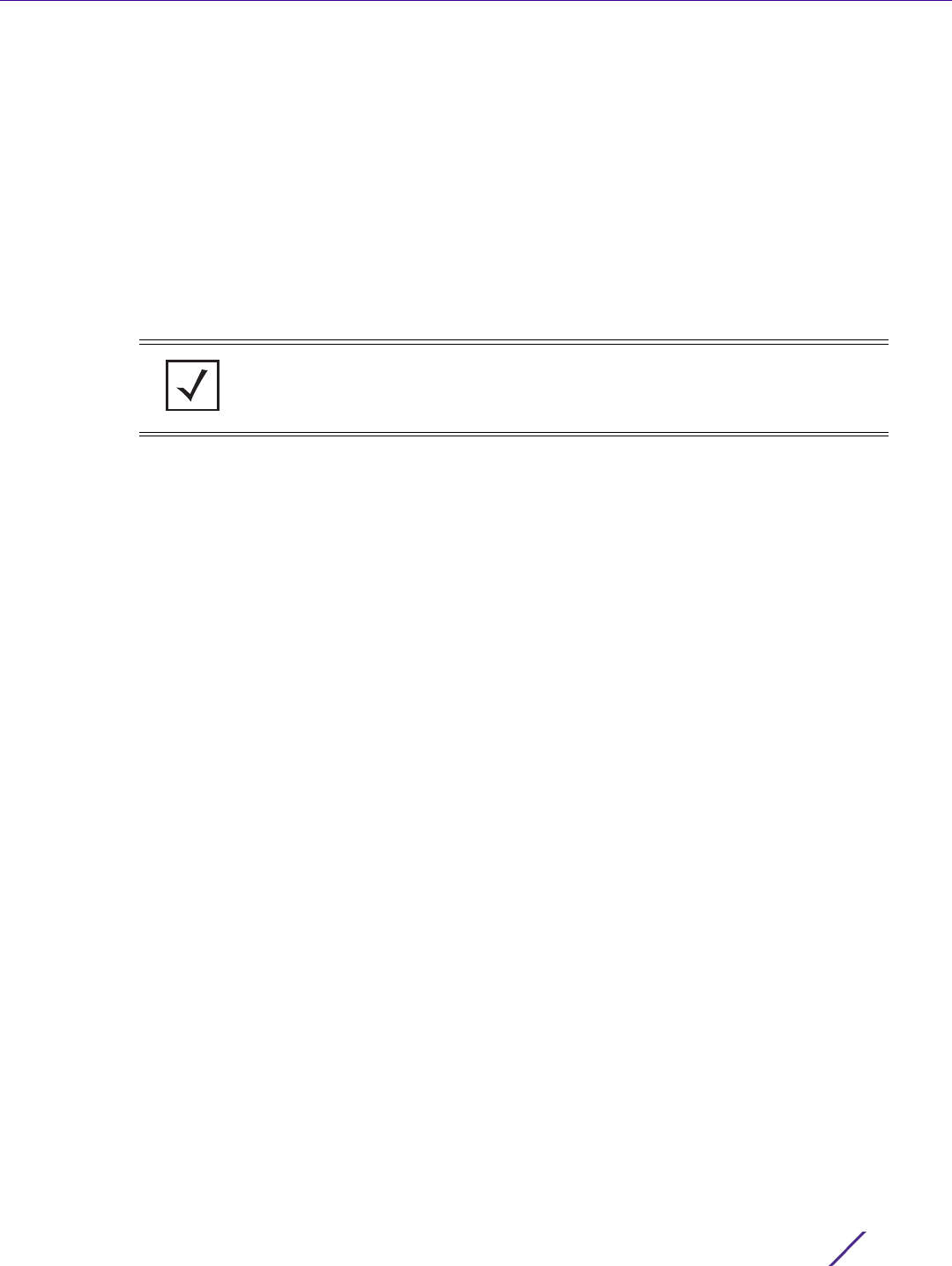
GLOBAL CONFIGURATION COMMANDS
Access Point, Wireless Controller and Service Platform CLI Reference Guide 4 - 340
4.1.69.1 nsight-policy
nsight-policy
Creates an NSight policy and enters its configuration mode
The NSight policy is an advance management, analytics, reporting, and troubleshooting tool, which when
created and applied at the RF Domain level allows the RF Domain manager to send statistics (polled from
devices within the RF Domain) to the NOC. The NOC, when enabled as the NSight server, stores this data
in a locally or externally hosted database. This large, complex data is collated and presented on an NSight
Dashboard that can be launched from the NSight-enabled NOC. For large networks, enabling NSight
removes the inadequacies of the existing data collection, presentation, and analytics framework. It
simplifies network monitoring, troubleshooting, and reporting.
The NSight features include:
• Network statistic and event visualization - Simplified and unified network views based on defined
user roles
• Custom dashboards - Live network health information in real-time to optimally assist network
administrators
• Live troubleshooting tools - Packet capture, wireless debug logs, TCP/IP ping and traceroute
• Interactive floor maps with timeline views - Visualize and identify potential issues and problems
areas
• Real-time trend analysis - Simplify network growth planning
• Exceptionally responsive interface - Any information the admin needs is three, or less, clicks away
The WiNG NSight implementation consists of the following components:
•An NSight server
• A database. This database consists of AP statistics gathered by RF Domain managers.
•An NSight UI portal
• An NSight client hosted on the RF Domain manager, which periodically gathers statistics from APs
and forwards to the NSight server.
• Event history – Event details for all APs adopted by the NOC. These are events received by the
Cfgd every 30 seconds and sent to the MART server. Each event consists of the RF Domain name,
wireless client MAC if applicable, AP MAC, event mnemonic, event timestamp, and the event string
itself.
Supported in the following platforms:
• Service Platforms — NX7500, NX9500, NX9510, NX9600, VX9000
Syntax
nsight-policy <NSIGHT-POLICY-NAME>
NOTE: NSight is a licensed feature, and can be enabled only on the
application of an NSight license in the NSight server’s self mode.

GLOBAL CONFIGURATION COMMANDS
Access Point, Wireless Controller and Service Platform CLI Reference Guide 4 - 341
Parameters
• nsight-policy <NSIGHT-POLICY-NAME>
Example
nx9500-6C8809(config)#nsight-policy test
nx9500-6C8809(config-nsight-policy-test)#?
Nsight Policy Mode commands:
enable Enable this Nsight policy
event-history-size Size of the event history collection
history-ttl Time to live for historical data
no Negate a command or set its defaults
nsight-server Enable Nsight server functionality
server Configure Nsight server
clrscr Clears the display screen
commit Commit all changes made in this session
end End current mode and change to EXEC mode
exit End current mode and down to previous mode
help Description of the interactive help system
revert Revert changes
service Service Commands
show Show running system information
write Write running configuration to memory or terminal
nx9500-6C8809(config-nsight-policy-test)#
Related Commands
<NSIGHT-POLICY-
NAME>
Specify the NSight policy name. If the policy does not exist, it is created.
no Removes an existing NSight policy

GLOBAL CONFIGURATION COMMANDS
Access Point, Wireless Controller and Service Platform CLI Reference Guide 4 - 342
4.1.69.2 nsight-policy commands
nsight-policy
The following table summarizes NSight policy configuration mode commands:
Table 4.42 NSight-Policy-Config Mode Commands
Command Description Reference
enable Enables this NSight policy page 4-343
event-history-
size
Converts and sizes the NSight event history collection to a capped
collection
page 4-344
history-ttl Configures the time-to-live (TTL), in days, for historical data related to
clients and devices
page 4-345
nsight-server Enables NSight server functionality and configures the SMTP report
delivery settings
page 4-346
server Configures the NSight server host. This configuration is used by the
NSight client to identify the NSight server host.
page 4-348
no Removes this NSight policy settings page 4-349

GLOBAL CONFIGURATION COMMANDS
Access Point, Wireless Controller and Service Platform CLI Reference Guide 4 - 343
4.1.69.2.1 enable
nsight-policy commands
Enables this NSight policy. The default setting is enabled.
Supported in the following platforms:
• Service Platforms — NX9500, NX9510, NX9600, VX9000
Syntax
enable
Parameters
None
Example
nx9510-6C8A5C(config-nsight-policy-test2)#enable
Related Commands
no Disables this NSight policy

GLOBAL CONFIGURATION COMMANDS
Access Point, Wireless Controller and Service Platform CLI Reference Guide 4 - 344
4.1.69.2.2 event-history-size
nsight-policy commands
Converts and sizes the NSight event history collection to a capped collection. The conversion occurs when
upgrading. Use this command to define the NSight event history collection’s size and prevent its
unbounded growth. Note, resizing the collection results in the collection contents being dropped.
Supported in the following platforms:
• Service Platforms — NX9500, NX9510, NX9600, VX9000
Syntax
event-history-size [high|low|medium]
Parameters
• event-history-size [high|low|medium]
Example
nx9500-6C8809(config-nsight-policy-test)#event-history-size medium
nx9500-6C8809(config-nsight-policy-test)#show context
nsight-policy test
event-history-size medium
nx9500-6C8809(config-nsight-policy-test)#
Related Commands
event-history-size
[high|low|medium]
Defines the size of the NSight event history collection. The options are:
• high – Sets the size at approximately 10 M events
• low – Sets the size at approximately 500 K events. This is the default setting.
• medium – Sets the size at approximately 5 M events
no Reverts the NSight event history collection size to default (5 M)

GLOBAL CONFIGURATION COMMANDS
Access Point, Wireless Controller and Service Platform CLI Reference Guide 4 - 345
4.1.69.2.3 history-ttl
nsight-policy commands
Configures the time-to-live (TTL), in days, for historical data related to clients, devices, and guest users.
This is the duration for which clients, devices, or guest user related data is retained in the NSight database.
Supported in the following platforms:
• Service Platforms — NX9500, NX9510, NX9600, VX9000
Syntax
history-ttl [clients|devices|guest-clients]
history-ttl [clients|devices] <1-3650>
history-ttl guest-clients <8-48>
Parameters
• history-ttl [clients|devices] <1-3650>
• history-ttl guest-clients <8-48>
Example
nx9500-6C8809(config-nsight-policy-test)#history-ttl clients 250
nx9500-6C8809(config-nsight-policy-test)#show context
nsight-policy test
history-ttl clients 250
nx9500-6C8809(config-nsight-policy-test)#
Related Commands
history-ttl
[client|devices]
<1-3650>
Configures the TTL for historical data related to clients and devices
• clients – Configures the TTL for wireless clients related historical data
• devices – Configures the TTL for devices (adopted access points or site controllers)
related historical data
The following is common to both the ‘clients’ and ‘devices’ keywords:
• <1-3650> – Specify a value from 1 - 3650 days. The default for both (clients and de-
vices) is 180 days.
history-ttl
guest-clients
<8-48>
Configures the TTL for historical data related to clients and devices
• guest-clients – Configures the TTL for guest-client related historical data
• <8-48> – Specify a value from 8 - 48 hours. The default is 8 hours.
no Reverts the NSight clients or devices TTL duration to default (180 days)

GLOBAL CONFIGURATION COMMANDS
Access Point, Wireless Controller and Service Platform CLI Reference Guide 4 - 346
4.1.69.2.4 nsight-server
nsight-policy commands
Enables NSight server functionality and configures the SMTP report delivery settings.
Supported in the following platforms:
• Service Platforms — NX9500, NX9510, NX9600, VX9000
Syntax
nsight-server {smtp-report-delivery|standalone}
nsight-server {smtp-report-delivery host <WORD> sender <EMAIL-ADD> [port <1-
65535>|security [none|ssl|starttls]|username <USER-NAME> password [0|2|<WORD>]]}
nsight-server {standalone}
Parameters
• nsight-server {smtp-report-delivery host <WORD> sender <EMAIL-ADD> [port <1-
65535>|security [none|ssl|starttls]|username <USER-NAME> password [0|2|<WORD>]]}
• nsight-server {standalone}
nsight-server Enables NSight server functionality on the host using this NSight policy
smtp-report-delivery
host <WORD>
Optional. Configures SMTP report delivery settings
• host <WORD> – Configures the SMTP server host
• <WORD> – Specify the SMTP server host’s IP address or hostname.
sender
<EMAIL-ADD>
Optional. Configures the SMTP sender’s e-mail address
• <EMAIL-ADD> – Specify the sender’s e-mail address.
port <1-65535> Optional. Configures the SMTP server port
• <1-65535> – Specify the port from 1 - 65535.
security
[none|ssl|starttls]
Optional. Configures the encryption protocol used by the SMTP server. The options are:
• none – Uses no encryption
• ssl – Uses SSL encryption
• starttls – Uses STARTTLS encryption
username
<USER-NAME>
password
[0|2|<WORD>]
Optional. Configures the SMTP username
• <USER-NAME> Specify the user name
• password [0|2|<WORD>] – Configures the password associated with the above con-
figured user
• 0 – Configures a clear text password
• 2 – Configures an encrypted password
• <WORD> – Enter the password.
nsight-server Enables NSight server functionality on the host using this NSight policy
standalone Optional. Configures NSight server as standalone. Use this option in the split NSight
deployment scenario where the NSight server and database are hosted on separate
hosts.

GLOBAL CONFIGURATION COMMANDS
Access Point, Wireless Controller and Service Platform CLI Reference Guide 4 - 347
Example
nx9510-6C8A5C(config-nsight-policy-test2)#nsight-server
nx9510-6C8A5C(config-nsight-policy-test2)#show context
nsight-policy test2
nsight-server
nx9510-6C8A5C(config-nsight-policy-test2)#
Related Commands
no Disables NSight server functionality on this NSight policy

GLOBAL CONFIGURATION COMMANDS
Access Point, Wireless Controller and Service Platform CLI Reference Guide 4 - 348
4.1.69.2.5 server
nsight-policy commands
Configures the NSight server host. This configuration is used by the NSight client to identify the NSight
server host.
Supported in the following platforms:
• Service Platforms — NX9500, NX9510, NX9600, VX9000
Syntax
server host [<IP>|<HOSTNAME>|<X:X::X:X>] {http|https}
Parameters
• server host [<IP>|<HOSTNAME>|<X:X::X:X>] {http|https}
Example
nx9510-6C8A5C(config-nsight-policy-test2)#server host 172.22.0.153 http
nx9510-6C8A5C(config-nsight-policy-test2)#show context
nsight-policy test2
server host 172.22.0.153 http
nsight-server
nx9510-6C8A5C(config-nsight-policy-test2)#
Related Commands
server host [<IP>|
<HOSTNAME>|
<X:X::X:X>]
Configures the NSight server host’s address. Use one of the following options to
identify the NSight server host:
• <IP> – Configures the NSight server’s IPv4 address
• <HOSTNAME> – Configures the NSight server’s hostname
• <X:X::X:X> – Configures the NSight server’s IPv6 address
{http|https} Optional. Configures the protocol used to communicate with the NSight server
• http – Optional. Uses HTTP to communicate
• https – Optional. Uses HTTPS to communicate (this is the default setting)
no Removes NSight server host settings from this NSight policy

GLOBAL CONFIGURATION COMMANDS
Access Point, Wireless Controller and Service Platform CLI Reference Guide 4 - 349
4.1.69.2.6 no
nsight-policy commands
Removes NSight policy settings
Supported in the following platforms:
• Service Platforms — NX9500, NX9510, NX9600, VX9000
Syntax
no [enable|event-history-size|history-ttl [clients|devices|guest-clients]|
nsight-server {smtp-report-delivery}|server host [<IP>|<HOSTNAME>|<X:X::X:X>]]
Parameters
• no <PARAMETERS>
Example
The following example shows the NSight policy ‘test2’ settings before the ‘no’ command is executed:
nx9510-6C8A5C(config-nsight-policy-test2)#show context
nsight-policy test2
server host 172.22.0.153 http
nsight-server
nx9510-6C8A5C(config-nsight-policy-test2)#
nx9510-6C8A5C(config-nsight-policy-test2)#no server host 172.22.0.153
The following example shows the NSight policy ‘test2’ settings after the ‘no’ command is executed:
nx9500-6C8809(config-nsight-policy-test2)#show context
nsight-policy test2
nsight-server
nx9510-6C8A5C(config-nsight-policy-test2)#
no <PARAMETERS> Removes NSight policy settings based on the parameters passed

GLOBAL CONFIGURATION COMMANDS
Access Point, Wireless Controller and Service Platform CLI Reference Guide 4 - 350
4.1.70 passpoint-policy
Global Configuration Commands
Creates a new passpoint policy and enters its configuration mode
The passpoint policy implements the Hotspot 2.0 Wi-Fi Alliance standard, enabling interoperability
between clients, infrastructure, and operators. It makes a portion of the IEEE 802.11u standard mandatory
and adds Hotspot 2.0 extensions that allow clients to query a network before actually attempting to join it.
The passpoint policy allows a single or set of Hotspot 2.0 configurations to be global and referenced by the
devices that use it. It is mapped to a WLAN. However, only primary WLANs on a BSSID will have their
passpoint policy configuration used.
Supported in the following platforms:
• Access Points — AP6521, AP6522, AP6532, AP6562, AP7161, AP7502, AP7522, AP7532, AP7562,
AP7602, AP7612, AP7622, AP7632, AP7662, AP81XX, AP82XX, AP8432, AP8533
• Wireless Controllers — RFS4000, RFS6000
• Service Platforms — NX5500, NX7500, NX7510, NX7520, NX7530, NX9500, NX9510, NX9600,
VX9000
Syntax
passpoint-policy <POLICY-NAME>
Parameters
• passpoint-policy <POLICY-NAME>
Example
rfs4000-229D58(config)#passpoint-policy test
rfs4000-229D58(config-passpoint-policy-test)#?
Passpoint Policy Mode commands:
3gpp Configure a 3gpp plmn (public land mobile network) id
access-network-type Set the access network type for the passpoint
connection-capability Configure the connection capability for the passpoint
domain-name Add a domain-name for the passpoint
hessid Set a homogeneous ESSID value for the passpoint
internet Advertise the passopint having internet access
ip-address-type Configure the advertised ip-address-type
nai-realm Configure a NAI realm for the passpoint
net-auth-type Add a network authentication type to the passpoint
no Negate a command or set its defaults
operator Add configuration related to the operator of the
passpoint
osu Online signup
roam-consortium Add a roam consortium for the passpoint
venue Set the venue parameters of the passpoint
wan-metrics Set the wan-metrics of the passpoint
clrscr Clears the display screen
commit Commit all changes made in this session
do Run commands from Exec mode
end End current mode and change to EXEC mode
exit End current mode and down to previous mode
help Description of the interactive help system
revert Revert changes
service Service Commands
show Show running system information
passpoint-policy
<POLICY-NAME>
Specify the passpoint policy name. If a passpoint policy does not exist, it is created.

GLOBAL CONFIGURATION COMMANDS
Access Point, Wireless Controller and Service Platform CLI Reference Guide 4 - 351
write Write running configuration to memory or terminal
rfs4000-229D58(config-passpoint-policy-test)#
Related Commands
no Removes an existing passpoint policy
NOTE: For more information on passpoint policy, see Chapter 27,
PASSPOINT POLICY.

GLOBAL CONFIGURATION COMMANDS
Access Point, Wireless Controller and Service Platform CLI Reference Guide 4 - 352
4.1.71 password-encryption
Global Configuration Commands
Enables password encryption and configures the passphrase used to encrypt passwords. When enabled,
passwords configured within the system are not displayed as clear text.
Supported in the following platforms:
• Access Points — AP6521, AP6522, AP6532, AP6562, AP7161, AP7502, AP7522, AP7532, AP7562,
AP7602, AP7612, AP7622, AP7632, AP7662, AP81XX, AP82XX, AP8432, AP8533
• Wireless Controllers — RFS4000, RFS6000
• Service Platforms — NX5500, NX7500, NX7510, NX7520, NX7530, NX9500, NX9510, NX9600,
VX9000
Syntax
password-encryption secret 2 <LINE>
Parameters
• password-encryption secret 2 <LINE>
Example
nx9500-6C8809(config)#password-encryption secret 2 test@123
To confirm if password encryption is enabled, execute the following command:
nx9500-6C8809(config)#show password-encryption status
Password encryption is enabled
nx9500-6C8809(config)#
The following example shows the privilege-mode-password as encrypted text. Note, the digit ‘1’
preceding the password implies that displayed text is the encrypted password and not clear text.
nx9500-6C8809(config-management-policy-test)#show context include-factory |
include privilege-mode-password
privilege-mode-password 1
bc28e4d82bb11fa75a3c56346441d48f50f19c47184e2575a59a6a5d18e63925
nx9500-6C8809(config-management-policy-test)#
Related Commands
secret 2 <LINE> Encrypts passwords with a secret phrase
• 2 – Specifies the encryption type as either SHA256 or AES256
• <LINE> – Specify the encryption passphrase.
no Disables password encryption

GLOBAL CONFIGURATION COMMANDS
Access Point, Wireless Controller and Service Platform CLI Reference Guide 4 - 353
4.1.72 profile
Global Configuration Commands
Configures profile related commands. If no parameters are given, all profiles are selected.
Supported in the following platforms:
• Access Points — AP6521, AP6522, AP6532, AP6562, AP7161, AP7502, AP7522, AP7532, AP7562,
AP7602, AP7612, AP7622, AP7632, AP7662, AP81XX, AP82XX, AP8432, AP8533
• Wireless Controllers — RFS4000, RFS6000
• Service Platforms — NX5500, NX7500, NX7510, NX7520, NX7530, NX9500, NX9510, NX9600,
VX9000
Syntax
profile {anyap|ap6521|ap6522|ap6532|ap6562|ap71xx|ap7502|ap7522|ap7532|ap7562|
ap7602|ap7612|ap7622|ap7632|ap7662|ap81xx|ap82xx|ap8432|ap8533|containing|filter
|rfs4000|rfs6000|nx5500|nx75xx|nx9000|nx9600|vx9000}
profile {anyap|ap6521|ap6522|ap6532|ap6562|ap71xx|ap7502|ap7522|ap7532|ap7562|
ap7602|ap7612|ap7622|ap7632|ap7662|ap81xx|ap82xx|ap8432|ap8533|rfs4000|rfs6000|
nx5500|nx75xx|nx9000|nx9600|vx9000} <DEVICE-PROFILE-NAME>
profile {containing <DEVICE-PROFILE-NAME>} {filter type [ap6521|ap6522|ap6532|
ap6562|ap71xx|ap7502|ap7522|ap7532|ap7602|ap7612|ap7622|ap7632|ap7662|ap81xx|
ap82xx|ap8432|ap8533|rfs4000|rfs6000|nx75xx|nx9000|vx9000]}
profile {filter type [ap6521|ap6522|ap6532|ap6562|ap71xx|ap7502|ap7522|ap7532|
ap7562|ap7602|ap7612|ap7622|ap7632|ap7662|ap81xx|ap82xx|ap8432|ap8533|rfs4000|
rfs6000|nx5500|nx75xx|nx9000|nx9600|vx9000]}
Parameters
• profile {anyap|ap6521|ap6522|ap6532|ap6562|ap71xx|ap7502|ap7522|ap7532|ap7562|
ap7602|ap7612|ap7622|ap7632|ap7662|ap81xx|ap82xx|ap8432|ap8533|rfs4000|rfs6000|
nx5500|nx75xx|nx9000|nx9600|vx9000} <DEVICE-PROFILE-NAME>
• profile {containing <DEVICE-PROFILE-NAME>} {filter type [ap6521|ap6522|ap6532|
ap6562|ap71xx|ap7502|ap7522|ap7532|ap7562|ap7602|ap7612|ap7622|ap7632|ap7662|
ap81xx|ap82xx|ap8432|ap8533|rfs4000|rfs6000|nx5500|nx75xx|nx9000|nx9600|vx9000]}
profile
<DEVICE-TYPE>
<DEVICE-PROFILE-
NAME>
Configures device profile commands. If no device profile is specified, the system
configures all device profiles.
• <DEVICE-TYPE> – Optional. Select the device type. The options are: AP6521, AP6522,
AP6532, AP6562, AP7161, AP7502, AP7522, AP7532, AP7562, AP7602, AP7612, AP7622,
AP7632, AP7662, AP81XX, AP82XX, AP8432, AP8533, RFS4000, RFS6000, NX5500,
NX75XX, NX95XX, NX9600, and VX9000. After specifying the device type, specify the
profile name.
• <DEVICE-PROFILE-NAME> – Specify the profile name.
Select ‘anyap’ to configure a profile applicable to any access point.
The NX9600 profile option is only available on an NX9600 device.
profile Configures device profile commands
containing
<DEVICE-PROFILE-
NAME>
Optional. Configures profiles that contain a specified sub-string in the hostname
• <DEVICE-PROFILE-NAME> – Specify a substring in the profile name to filter profiles.

GLOBAL CONFIGURATION COMMANDS
Access Point, Wireless Controller and Service Platform CLI Reference Guide 4 - 354
• profile {filter type [ap6521|ap6522|ap6532|ap6562|ap71xx|ap7502|ap7522|ap7532|
ap7562|ap7602|ap7612|ap7622|ap7632|ap7662|ap81xx|ap82xx|ap8432|ap8533|rfs4000|
rfs6000|nx5500|nx75xx|nx9000|nx9600|vx9000]}
Example
<DEVICE>(config)#profile <DEVICE-TYPE> <PROFILE-NAME>
<DEVICE>(config-profile-<PROFILE-NAME>)#?
Profile Mode commands:
adopter-auto-provisioning-policy-lookup Use centralized auto-provisioning
policy when adopted by another
controller
adoption Adoption configuration
alias Alias
application-policy Application Policy configuration
area Set name of area where the system
is located
arp Address Resolution Protocol (ARP)
auto-learn Auto learning
autogen-uniqueid Autogenerate a unique id
autoinstall Autoinstall settings
bluetooth-detection Detect Bluetooth devices using the
Bluetooth USB module - there will
be interference on 2.4 Ghz radio in
wlan mode
bridge Ethernet bridge
captive-portal Captive portal
cdp Cisco Discovery Protocol
cluster Cluster configuration
configuration-persistence Enable persistence of configuration
across reloads (startup config
file)
controller WLAN controller configuration
critical-resource Critical Resource
crypto Encryption related commands
database Database command
device-onboard Device-onboarding configuration
device-upgrade Device firmware upgrade
diag Diagnosis of packets
dot1x 802.1X
dpi Enable Deep-Packet-Inspection
(Application Assurance)
dscp-mapping Configure IP DSCP to 802.1p
priority mapping for untagged
filter type Optional. An additional filter used to configure a specific type of device profile. If no
device type is specified, the system configures all device profiles.
• type – Filters profiles by the device type. Select a device type from the following
options: AP6521, AP6522, AP6532, AP6562, AP7161, AP7502, AP7522, AP7532, AP7562,
AP7602, AP7612, AP7622, AP7632, AP7662, AP81XX, AP82XX, AP8432, AP8533,
RFS4000, RFS6000, NX5500, NX75XX, NX95XX, NX9600, and VX9000.
The NX9600 profile option is only available on an NX9600 device.
profile Configures device profile commands
filter type Optional. An additional filter used to configure a specific type of device profile. If no
device type is specified, the system configures all device profiles.
• type – Filters profiles by the device type. Select a device type from the following
options: AP6521, AP6522, AP6532, AP6562, AP7161, AP7502, AP7522, AP7532, AP7562,
AP7602, AP7612, AP7622, AP7632, AP7662, AP81XX, AP82XX, AP8432, AP8533,
RFS4000, RFS6000, NX5500, NX75XX, NX95XX, NX9600, and VX9000.
The NX9600 profile option is only available on an NX9600 device.

GLOBAL CONFIGURATION COMMANDS
Access Point, Wireless Controller and Service Platform CLI Reference Guide 4 - 355
frames
eguest-server Enable EGuest Server functionality
email-notification Email notification configuration
enforce-version Check the firmware versions of
devices before interoperating
environmental-sensor Environmental Sensors Configuration
events System event messages
export Export a file
file-sync File sync between controller and
adoptees
floor Set the floor within a area where
the system is located
gre GRE protocol
http-analyze Specify HTTP-Analysis configuration
interface Select an interface to configure
ip Internet Protocol (IP)
ipv6 Internet Protocol version 6 (IPv6)
l2tpv3 L2tpv3 protocol
l3e-lite-table L3e lite Table
led Turn LEDs on/off on the device
led-timeout Configure the time for the led to
turn off after the last radio state
change
legacy-auto-downgrade Enable device firmware to auto
downgrade when other legacy devices
are detected
legacy-auto-update Auto upgrade of legacy devices
lldp Link Layer Discovery Protocol
load-balancing Configure load balancing parameter
logging Modify message logging facilities
mac-address-table MAC Address Table
mac-auth 802.1X
management-server Configure management server address
memory-profile Memory profile to be used on the
device
meshpoint-device Configure meshpoint device
parameters
meshpoint-monitor-interval Configure meshpoint monitoring
interval
min-misconfiguration-recovery-time Check controller connectivity after
configuration is received
mint MiNT protocol
misconfiguration-recovery-time Check controller connectivity after
configuration is received
neighbor-inactivity-timeout Configure neighbor inactivity
timeout
neighbor-info-interval Configure neighbor information
exchange interval
no Negate a command or set its
defaults
noc Configure the noc related setting
nsight NSight
ntp Ntp server WORD
offline-duration Set duration for which a device
remains unadopted before it
generates offline event
otls Omnitrail Location Server
power-config Configure power mode
preferred-controller-group Controller group this system will
prefer for adoption
preferred-tunnel-controller Tunnel Controller Name this system
will prefer for tunneling extended
vlan traffic
radius Configure device-level radius
authentication parameters
raid RAID
remove-override Remove configuration item override
from the device (so profile value

GLOBAL CONFIGURATION COMMANDS
Access Point, Wireless Controller and Service Platform CLI Reference Guide 4 - 356
takes effect)
rf-domain-manager RF Domain Manager
router Dynamic routing
slot PCI expansion Slot
spanning-tree Spanning tree
traffic-class-mapping Configure IPv6 traffic class to
802.1p priority mapping for
untagged frames
traffic-shape Traffic shaping
trustpoint Assign a trustpoint to a service
tunnel-controller Tunnel Controller group this
controller belongs to
use Set setting to use
vrrp VRRP configuration
vrrp-state-check Publish interface via OSPF/BGP only
if the interface VRRP state is not
BACKUP
wep-shared-key-auth Enable support for 802.11 WEP
shared key authentication
zone Configure Zone name
clrscr Clears the display screen
commit Commit all changes made in this
session
do Run commands from Exec mode
end End current mode and change to EXEC
mode
exit End current mode and down to
previous mode
help Description of the interactive help
system
revert Revert changes
service Service Commands
show Show running system information
write Write running configuration to
memory or terminal
<DEVICE>(config-profile-<PROFILE-NAME>)#
Related Commands
no Removes a profile and its associated configurations
NOTE: For more information on profiles and how to configure profiles, see
Chapter 7, PROFILES.

GLOBAL CONFIGURATION COMMANDS
Access Point, Wireless Controller and Service Platform CLI Reference Guide 4 - 357
4.1.73 radio-qos-policy
Global Configuration Commands
Configures a radio quality-of-service (QoS) policy
Supported in the following platforms:
• Access Points — AP6521, AP6522, AP6532, AP6562, AP7161, AP7502, AP7522, AP7532, AP7562,
AP7602, AP7612, AP7622, AP7632, AP7662, AP81XX, AP82XX, AP8432, AP8533
• Wireless Controllers — RFS4000, RFS6000
• Service Platforms — NX5500, NX7500, NX7510, NX7520, NX7530, NX9500, NX9510, NX9600,
VX9000
Syntax
radio-qos-policy <RADIO-QOS-POLICY-NAME>
Parameters
• radio-qos-policy <RADIO-QOS-POLICY-NAME>
Example
rfs6000-81742D(config)#radio-qos-policy test
rfs6000-81742D(config-radio-qos-test)#?
Radio QoS Mode commands:
accelerated-multicast Configure multicast streams for acceleration
admission-control Configure admission-control on this radio for one or
more access categories
no Negate a command or set its defaults
smart-aggregation Configure smart aggregation parameters
wmm Configure 802.11e/Wireless MultiMedia parameters
clrscr Clears the display screen
commit Commit all changes made in this session
do Run commands from Exec mode
end End current mode and change to EXEC mode
exit End current mode and down to previous mode
help Description of the interactive help system
revert Revert changes
service Service Commands
show Show running system information
write Write running configuration to memory or terminal
rfs6000-81742D(config-radio-qos-test)#
Related Commands
<RADIO-QOS-POLICY-
NAME>
Specify the radio QoS policy name. If the policy does not exist, it is created.
no Removes an existing Radio QoS policy
NOTE: For more information on radio qos policy, see Chapter 17, RADIO-
QOS-POLICY.

GLOBAL CONFIGURATION COMMANDS
Access Point, Wireless Controller and Service Platform CLI Reference Guide 4 - 358
4.1.74 radius-group
Global Configuration Commands
Configures RADIUS user group parameters
Supported in the following platforms:
• Access Points — AP6521, AP6522, AP6532, AP6562, AP7161, AP7502, AP7522, AP7532, AP7562,
AP7602, AP7612, AP7622, AP7632, AP7662, AP81XX, AP82XX, AP8432, AP8533
• Wireless Controllers — RFS4000, RFS6000
• Service Platforms — NX5500, NX7500, NX7510, NX7520, NX7530, NX9500, NX9510, NX9600,
VX9000
Syntax
radius-group <RADIUS-GROUP-NAME>
Parameters
• radius-group <RADIUS-GROUP-NAME>
Example
rfs6000-81742D(config)#radius-group testgroup
rfs6000-81742D(config-radius-group-testgroup)#?
Radius user group configuration commands:
guest Make this group a Guest group
no Negate a command or set its defaults
policy Radius group access policy configuration
rate-limit Set rate limit for group
clrscr Clears the display screen
commit Commit all changes made in this session
do Run commands from Exec mode
end End current mode and change to EXEC mode
exit End current mode and down to previous mode
help Description of the interactive help system
revert Revert changes
service Service Commands
show Show running system information
write Write running configuration to memory or terminal
rfs6000-81742D(config-radius-group-testgroup)#
Related Commands
<RADIUS-GROUP-
NAME>
Specify a RADIUS user group name. The name should not exceed 64 characters. If
the RADIUS user group does not exist, it is created.
no Removes an existing RADIUS group
NOTE: For more information on RADIUS user group commands, see Chapter
16, RADIUS-POLICY.

GLOBAL CONFIGURATION COMMANDS
Access Point, Wireless Controller and Service Platform CLI Reference Guide 4 - 359
4.1.75 radius-server-policy
Global Configuration Commands
Creates an onboard device RADIUS policy
Supported in the following platforms:
• Access Points — AP6521, AP6522, AP6532, AP6562, AP7161, AP7502, AP7522, AP7532, AP7562,
AP7602, AP7612, AP7622, AP7632, AP7662, AP81XX, AP82XX, AP8432, AP8533
• Wireless Controllers — RFS4000, RFS6000
• Service Platforms — NX5500, NX7500, NX7510, NX7520, NX7530, NX9500, NX9510, NX9600,
VX9000
Syntax
radius-server-policy <RADIUS-SERVER-POLICY-NAME>
Parameters
• radius-server-policy <RADIUS-SERVER-POLICY-NAME>
Example
rfs6000-81742D(config)#radius-server-policy testpolicy
rfs6000-81742D(config-radius-server-policy-testpolicy)#?
Radius Configuration commands:
authentication Radius authentication
bypass Bypass Certificate Revocation List( CRL ) check
chase-referral Enable chasing referrals from LDAP server
crl-check Enable Certificate Revocation List( CRL ) check
ldap-agent LDAP Agent configuration parameters
ldap-group-verification Enable LDAP Group Verification setting
ldap-server LDAP server parameters
local RADIUS local realm
nas RADIUS client
no Negate a command or set its defaults
proxy RADIUS proxy server
session-resumption Enable session resumption/fast reauthentication by
using cached attributes
termination Enable Eap termination for proxy requests
use Set setting to use
clrscr Clears the display screen
commit Commit all changes made in this session
do Run commands from Exec mode
end End current mode and change to EXEC mode
exit End current mode and down to previous mode
help Description of the interactive help system
revert Revert changes
service Service Commands
show Show running system information
write Write running configuration to memory or terminal
rfs6000-81742D(config-radius-server-policy-testpolicy)#
Related Commands
<RADIUS-SERVER-
POLICY-NAME>
Specify the RADIUS server policy name. If the policy does not exist, it is created.
no Removes an existing RADIUS server policy

GLOBAL CONFIGURATION COMMANDS
Access Point, Wireless Controller and Service Platform CLI Reference Guide 4 - 360
NOTE: For more information on RADIUS server policy commands, see
Chapter 16, RADIUS-POLICY.

GLOBAL CONFIGURATION COMMANDS
Access Point, Wireless Controller and Service Platform CLI Reference Guide 4 - 361
4.1.76 radius-user-pool-policy
Global Configuration Commands
Configures a RADIUS user pool
Supported in the following platforms:
• Access Points — AP6521, AP6522, AP6532, AP6562, AP7161, AP7502, AP7522, AP7532, AP7562,
AP7602, AP7612, AP7622, AP7632, AP7662, AP81XX, AP82XX, AP8432, AP8533
• Wireless Controllers — RFS4000, RFS6000
• Service Platforms — NX5500, NX7500, NX7510, NX7520, NX7530, NX9500, NX9510, NX9600,
VX9000
Syntax
radius-user-pool-policy <RADIUS-USER-POOL-POLICY-NAME>
Parameters
• radius-user-pool-policy <RADIUS-USER-POOL-POLICY-NAME>
Example
rfs6000-81742D(config)#radius-user-pool-policy testpool
rfs6000-81742D(config-radius-user-pool-testpool)#?
Radius User Pool Mode commands:
duration Set a guest user's access duration
no Negate a command or set its defaults
user Radius user configuration
clrscr Clears the display screen
commit Commit all changes made in this session
do Run commands from Exec mode
end End current mode and change to EXEC mode
exit End current mode and down to previous mode
help Description of the interactive help system
revert Revert changes
service Service Commands
show Show running system information
write Write running configuration to memory or terminal
rfs6000-81742D(config-radius-user-pool-testpool)#
Related Commands
<RADIUS-USER-
POOL-POLICY-NAME>
Specify the RADIUS user pool policy name. If the policy does not exist, it is created.
no Removes an existing RADIUS user pool
NOTE: For more information on RADIUS user group commands, see Chapter
16, RADIUS-POLICY.

GLOBAL CONFIGURATION COMMANDS
Access Point, Wireless Controller and Service Platform CLI Reference Guide 4 - 362
4.1.77 rename
Global Configuration Commands
Renames and existing TLO
Supported in the following platforms:
• Access Points — AP6521, AP6522, AP6532, AP6562, AP7161, AP7502, AP7522, AP7532, AP7562,
AP7602, AP7612, AP7622, AP7632, AP7662, AP81XX, AP82XX, AP8432, AP8533
• Wireless Controllers — RFS4000, RFS6000
• Service Platforms — NX5500, NX7500, NX7510, NX7520, NX7530, NX9500, NX9510, NX9600,
VX9000
Syntax
rename tlo <TLO-NAME>
Parameters
• rename tlo <TLO-NAME> <NEW-TLO-NAME>
Example
The following example shows the top level objects available for renaming:
Enter rename and press Tab to list top level objects available for renaming.
nx9500-6C8809(config)#rename
aaa_policy aaa_tacacs_policy
address_range_alias aif_policy
ap300 app_group
app_policy application
assoc_acl auto_provisioning_policy
bgp_as_path_list bgp_community_list
bgp_extcommunity_list bgp_ip_access_list
bgp_ip_prefix_list bonjour_gw_discovery_policy
bonjour_gw_forwarding_policy bonjour_gw_query_forwarding_policy
bridging_policy captive_portal
centro_policy client_identity
client_identity_group content_cache_policy
content_filter_policy crypto_cmp_policy
database_client_policy database_policy
device_categorization dhcp_server_policy
dhcpv6_server_policy dns_whitelist
dr_route_map encrypted_string_alias
event_system_policy ex3500_ext_ip_acl
ex3500_management_policy ex3500_qos_class_map_policy
ex3500_qos_policy_map ex3500_std_ip_acl
ex3500_time_range firewall_policy
global_assoc_list guest_management
hashed_string_alias host_alias
ip_acl ip_snmp_acl
ipv6_acl ipv6_radv_policy
l2tpv3_policy mac_acl
management_policy meshpoint
meshpoint_qos mint_policy
mint_security_policy nac_list
--More--
nx9500-6C8809(config)#
rename tlo
<TLO-NAME>
<NEW-TLO-NAME>
Renames an existing TLO object
• <TLO-NAME> – Specify the TLO’s name. This is the TLO that is to be renamed.
• <NEW-TLO-NAME> – Specify the new name for this TLO

GLOBAL CONFIGURATION COMMANDS
Access Point, Wireless Controller and Service Platform CLI Reference Guide 4 - 363
The following examples first clones the existing IP access list BROADCAST-MULTICAST-CONTROL, and
then renames the cloned IP access list:
nx9500-6C8809(config)#show context include-factory | include ip access-list
ip access-list BROADCAST-MULTICAST-CONTROL
nx9500-6C8809(config)#
nx9500-6C8809(config)#clone ip_acl BROADCAST-MULTICAST-CONTROL Test_IP_CLONED
nx9500-6C8809(config)#commit
nx9500-6C8809(config)#show context include-factory | include ip access-list
ip access-list BROADCAST-MULTICAST-CONTROL
ip access-list Test_IP_CLONED
nx9500-6C8809(config)#
rfs4000-229D58(config)#rename ip_acl TestIP_CLONED TestIP_RENAMED
rfs4000-229D58(config)#commit
nx9500-6C8809(config)#rename ip_acl Test_IP_CLONED Test_IP_RENAMED
nx9500-6C8809(config)#
nx9500-6C8809(config)#show context include-factory | include ip access-list
ip access-list BROADCAST-MULTICAST-CONTROL
ip access-list Test_IP_RENAMED
nx9500-6C8809(config)#
Related Commands
clone Creates a replica of an existing TLO or device

GLOBAL CONFIGURATION COMMANDS
Access Point, Wireless Controller and Service Platform CLI Reference Guide 4 - 364
4.1.78 replace
Global Configuration Commands
Selects an existing device by its MAC address or hostname and replaces it with a new device having a
different MAC address. Internally, a new device is created with the new MAC address. The old device’s
configuration is copied to the new device, and then removed from the controller’s configuration (i.e., the
old device’s configuration is no longer staged on the controller).
Supported in the following platforms:
• Access Points — AP6521, AP6522, AP6532, AP6562, AP7161, AP7502, AP7522, AP7532, AP7562,
AP7602, AP7612, AP7622, AP7632, AP7662, AP81XX, AP82XX, AP8432, AP8533
• Wireless Controllers — RFS4000, RFS6000
• Service Platforms — NX5500, NX7500, NX7510, NX7520, NX7530, NX9500, NX9510, NX9600,
VX9000
Syntax
replace device [<MAC-ADDRESS>|<HOSTNAME>] <NEW-MAC-ADDRESS>
Parameters
• replace device [<MAC-ADDRESS>|<HOSTNAME>] <NEW-MAC-ADDRESS>
Example
rfs4000-882A17(config)#replace device ap7131-4BF364 ?
AA-BB-CC-DD-EE-FF New device MAC address
rfs4000-882A17(config)#replace device ap7131-4BF364 00-15-0F-BB-98-30
The following example shows an existing AP7502 (MAC: DD-AA-BB-88-12-43) configuration staged on a
VX9000 controller:
VX9000-NOC-DE9D(config-device-DD-AA-BB-88-12-43)#show context
ap7502 DD-AA-BB-88-12-43
use profile default-ap7502
use rf-domain default
hostname ap7502-881243
interface radio1
wlan theMOZART bss 1 primary
interface radio2
wlan theMOZART bss 1 primary
interface ge1
switchport mode access
switchport access vlan 1
controller host 12.12.12.2
VX9000-NOC-DE9D(config-device-DD-AA-BB-88-12-43)#
replace device Replaces an existing device with a new device, such that the old device’s
configuration is copied on to the new device
[<MAC-ADDRESS>|
<HOSTNAME>]
Identifies the device to replace by its MAC address or hostname
• <MAC-ADDRESS> – Identifies the device to replace by its MAC address. Specify the
device’s existing MAC address.
• <HOSTNAME> – Identifies the device to replace by its hostname. Specify the device’s
hostname.
<NEW-MAC-
ADDRESS>
Specifies the new device’s MAC address
Both the new and old devices should of the same model type.

GLOBAL CONFIGURATION COMMANDS
Access Point, Wireless Controller and Service Platform CLI Reference Guide 4 - 365
The following example shows AP7502 (MAC: DD-AA-BB-88-12-43) replaced by another AP7502 having
MAC address 11-22-33-44-55-66:
Note that the new AP7502 device has the same configuration as the old AP7502 device. The
HOSTNAME remains the same. Consequently, objects that refer to this particular hostname need not be
updated. For example, an hostname alias identifying this particular device, and TLOs using this alias,
such as IP/MAC ACLs, remain unchanged.
VX9000-NOC-DE9D(config)#replace device DD-AA-BB-88-12-43 11-22-33-44-55-66
VX9000-NOC-DE9D(config)#ap7502 11-22-33-44-55-66
VX9000-NOC-DE9D(config-device-11-22-33-44-55-66)#show context
ap7502 11-22-33-44-55-66
use profile default-ap7502
use rf-domain default
hostname ap7502-881243
interface radio1
wlan theMOZART bss 1 primary
interface radio2
wlan theMOZART bss 1 primary
interface ge1
switchport mode access
switchport access vlan 1
controller host 12.12.12.2
VX9000-NOC-DE9D(config-device-11-22-33-44-55-66)#

GLOBAL CONFIGURATION COMMANDS
Access Point, Wireless Controller and Service Platform CLI Reference Guide 4 - 366
4.1.79 rf-domain
Global Configuration Commands
An RF Domain groups devices that can logically belong to one network.
The following table lists the RF Domain configuration mode commands:
Table 4.43 RF-Domain Config Commands
Command Description Reference
rf-domain Creates a RF Domain policy and enters its configuration mode page 4-367
rf-domain-mode
commands
Invokes RF Domain configuration mode commands page 4-369

GLOBAL CONFIGURATION COMMANDS
Access Point, Wireless Controller and Service Platform CLI Reference Guide 4 - 367
4.1.79.1 rf-domain
rf-domain
Creates an RF Domain or enters the RF Domain configuration context for one or more RF Domains. If the
RF Domain does not exist, it is created.
The configuration of controllers (wireless controllers, service platforms, and access points) comprises of RF
Domains that define regulatory, location, and other relevant policies. At least one default RF Domain is
assigned to each controller. RF Domains allow administrators to assign configuration data to multiple
devices deployed in a common coverage area, such as in a floor, building, or site. Each RF Domain contains
policies that set the Smart RF or WIPS configuration.
RF Domains also enable administrators to override WLAN SSID name and VLAN assignments. This enables
the deployment of a global WLAN across multiple sites and unique SSID name or VLAN assignments to
groups of access points servicing the global WLAN. This WLAN override eliminates the need to define and
manage a large number of individual WLANs and profiles.
A controller’s configuration contains:
• A default RF Domain - Each controller utilizes a default RF Domain. Access Points are assigned to
this default RF Domain as they are discovered by the controller. A default RF Domain can be used
for single-site and multi-site deployments.
• Single-site deployment – The default RF Domain can be used for single site deployments, where
regional, regulatory, and RF policies are common between devices.
• Multi-site deployment – A default RF Domain can omit configuration parameters to prohibit
regulatory configuration from automatically being inherited by devices as they are discovered. This
is desirable in multi-site deployments with devices spanning multiple countries. Omitting specific
configuration parameters eliminates the risk of an incorrect country code from being automatically
assigned to a device.
• A user-defined RF Domain - Created by administrators. A user-defined RF Domain can be assigned
to multiple devices manually or automatically.
• Manually assigned – Use the CLI or UI to manually assign a user-defined RF Domain to controllers
and service platforms.
• Automatically assigned – Use a AP provisioning policy to automatically assign specific RF Domains
to access points based on the access point’s model, serial number, VLAN, DHCP option, and IP
address or MAC address. Automatic RF Domain assignments are useful in large deployments, as
they enable plug-n-play access point deployments by automatically applying RF Domains to
remote access points. For more information on auto provisioning policy, see AUTO-PROVISIONING-
POLICY.
Configure and deploy user-defined RF Domains for single or multiple sites where devices require
unique regulatory and regional configurations, or unique Smart RF and WIPS policies. User-defined RF
Domains can be used to:
• Assign unique Smart RF or WIPS policies to access points deployed on different floors or buildings
within in a site.
• Assign unique regional or regulatory configurations to devices deployed in different states or
countries.
• Assign unique WLAN SSIDs and/or VLAN IDs to sites assigned a common WLAN without having to
define individual WLANs for each site.

GLOBAL CONFIGURATION COMMANDS
Access Point, Wireless Controller and Service Platform CLI Reference Guide 4 - 368
Supported in the following platforms:
• Access Points — AP6521, AP6522, AP6532, AP6562, AP7161, AP7502, AP7522, AP7532, AP7562,
AP7602, AP7612, AP7622, AP7632, AP7662, AP81XX, AP82XX, AP8432, AP8533
• Wireless Controllers — RFS4000, RFS6000
• Service Platforms — NX5500, NX7500, NX7510, NX7520, NX7530, NX9500, NX9510, NX9600,
VX9000
Syntax
rf-domain {<RF-DOMAIN-NAME>|containing <RF-DOMAIN-NAME>}
Parameters
• rf-domain {<RF-DOMAIN-NAME>|containing <RF-DOMAIN-NAME>}
Example
rfs6000-81742D(config)#rf-domain rfs6000
rfs6000-81742D(config-rf-domain-rfs6000)#?
RF Domain Mode commands:
alias Alias
channel-list Configure channel list to be advertised to wireless
clients
contact Configure the contact
control-vlan VLAN for control traffic on this RF Domain
controller-managed RF Domain manager for this domain will be an adopting
controller
country-code Configure the country of operation
geo-coordinates Configure geo coordinates for this device
layout Configure layout
location Configure the location
location-server LSENSE server configuration
mac-name Configure MAC address to name mappings
no Negate a command or set its defaults
nsight-sensor Enable sensor for Nsight
override-smartrf Configured RF Domain level overrides for smart-rf
override-wlan Configure RF Domain level overrides for wlan
sensor-server AirDefense sensor server configuration
stats Configure the stats related setting
timezone Configure the timezone
tree-node Configure tree node under which this rf-domain appears
use Set setting to use
clrscr Clears the display screen
commit Commit all changes made in this session
do Run commands from Exec mode
end End current mode and change to EXEC mode
exit End current mode and down to previous mode
help Description of the interactive help system
revert Revert changes
service Service Commands
show Show running system information
write Write running configuration to memory or terminal
rfs6000-81742D(config-rf-domain-rfs6000)#
rf-domain Creates a new RF Domain or enters its configuration context
<RF-DOMAIN-
NAME>
Optional. Specify the RF Domain name (should not exceed 32 characters and should
represent the intended purpose). Once created, the name cannot be edited.
containing
<RF-DOMAIN-
NAME>
Optional. Identifies an existing RF Domain that contains a specified sub-string in the
domain name
• <RF-DOMAIN-NAME> – Specify a sub-string of the RF Domain name.

GLOBAL CONFIGURATION COMMANDS
Access Point, Wireless Controller and Service Platform CLI Reference Guide 4 - 369
4.1.79.2 rf-domain-mode commands
rf-domain
This section describes the default commands under RF Domain.
The following table summarizes RF Domain configuration commands:
Table 4.44 RF-Domain-Mode Commands
Command Description Reference
alias Creates various types of aliases, such as network, VLAN, network-group,
network-service, encrypted-string, hashed -string, etc. at the RF Domain
level
page 4-370
channel-list Configures the channel list advertised by radios page 4-377
contact Configures network administrator’s contact information (needed in case
of any problems impacting the RF Domain)
page 4-378
control-vlan Configures VLAN for traffic control on a RF Domain page 4-379
controller-
managed
Configures the adopting controller or service platform as this RF
Domain’s manager
page 4-380
country-code Configures the country of operation page 4-381
geo-coordinates Configures the longitude and latitude of the RF Domain in order to fix its
exact geographical location on a map
page 4-382
layout Configures layout information page 4-383
location Configures the physical location of a RF Domain page 4-385
location-server Configures an LSENSE server on the selected RF Domain. This command
is supported only on the NX95XX series service platforms.
page 4-386
mac-name Maps MAC addresses to names page 4-387
no Negates a command or reverts configured settings to their default page 4-388
override-smart-rf Configures RF Domain level overrides for Smart RF page 4-390
override-wlan Configures RF Domain level overrides for a WLAN page 4-391
sensor-server Configures an AirDefense sensor server on this RF Domain page 4-394
stats Configures stats related settings on this RF Domain. These settings
define how RF Domain statistics are updated.
page 4-396
timezone Configures a RF Domain’s geographic time zone page 4-397
tree-node Configures the hierarchical (tree-node) structure under which this RF
Domain appears
page 4-399
use Enables the use of a specified Smart RF and/or WIPS policy page 4-401

GLOBAL CONFIGURATION COMMANDS
Access Point, Wireless Controller and Service Platform CLI Reference Guide 4 - 370
4.1.79.2.1 alias
rf-domain-mode commands
Configures network, VLAN, host, string, network-service, etc. aliases at the RF Domain level
For information on aliases, see alias.
Supported in the following platforms:
• Access Points — AP6521, AP6522, AP6532, AP6562, AP7161, AP7502, AP7522, AP7532, AP7562,
AP7602, AP7612, AP7622, AP7632, AP7662, AP81XX, AP82XX, AP8432, AP8533
• Wireless Controllers — RFS4000, RFS6000
• Service Platforms — NX5500, NX7500, NX7510, NX7520, NX7530, NX9500, NX9510, NX9600,
VX9000
Syntax
alias [address-range|encrypted-string|hashed-string|host|network|network-group|
network-service|number|string|vlan]
alias encrypted-string <ENCRYPTED-STRING-ALIAS-NAME> [0|2] <LINE>
alias hashed-string <HASHED-STRING-ALIAS-NAME> 1 <LINE>
alias address-range <ADDRESS-RANGE-ALIAS-NAME> <STARTING-IP> to <ENDING-IP>
alias host <HOST-ALIAS-NAME> <HOST-IP>
alias network <NETWORK-ALIAS-NAME> <NETWORK-ADDRESS/MASK>
alias network-group <NETWORK-GROUP-ALIAS-NAME> [address-range|host|network]
alias network-group <NETWORK-GROUP-ALIAS-NAME> [address-range <STARTING-IP> to
<ENDING-IP> {<STARTING-IP> to <ENDING-IP>}|host <HOST-IP> {<HOST-IP>}|
network <NETWORK-ADDRESS/MASK> {<NETWORK-ADDRESS/MASK>}]
alias network-service <NETWORK-SERVICE-ALIAS-NAME> proto [<0-254>|<WORD>|eigrp|
gre|igmp|igp|ospf|vrrp] {(<1-65535>|<WORD>|bgp|dns|ftp|ftp-data|gopher|https|
ldap|nntp|ntp|pop3|proto|sip|smtp|sourceport|ssh|telnet|tftp|www)}
alias number <NUMBER-ALIAS-NAME> <0-4294967295>
alias network-service <NETWORK-SERVICE-ALIAS-NAME> proto [<0-254>|<WORD>|eigrp|
gre|igmp|igp|ospf|vrrp] {(<1-65535>|<WORD>|bgp|dns|ftp|ftp-data|gopher|https|
ldap|nntp|ntp|pop3|proto|sip|smtp|sourceport [<1-65535>|<WORD>]|ssh|telnet|
tftp|www)}
alias string <STRING-ALIAS-NAME> <LINE>
alias vlan <VLAN-ALIAS-NAME> <1-4094>
Parameters
• alias address-range <ADDRESS-RANGE-ALIAS-NAME> <STARTING-IP> to <ENDING-IP>
address-range
<ADDRESS-RANGE-
ALIAS-NAME>
Creates a new address-range alias for this RF Domain. Or associates an existing
address-range alias with this RF Domain. An address-range alias maps a name to a
range of IP addresses.
• <ADDRESS-RANGE-ALIAS-NAME> – Specify the address range alias name.
Alias name should begin with ‘$’.

GLOBAL CONFIGURATION COMMANDS
Access Point, Wireless Controller and Service Platform CLI Reference Guide 4 - 371
• alias encrypted-string <ENCRYPTED-STRING-ALIAS-NAME> [0|2] <LINE>
• alias hashed-string <HASHED-STRING-ALIAS-NAME> <LINE>
<STARTING-IP>
to <ENDING-IP>
Associates a range of IP addresses with this address range alias
• <STARTING-IP> – Specify the first IP address in the range.
• to <ENDING-IP> – Specify the last IP address in the range.
Aliases defined at any given level can be overridden at the next lower level. For
example, a global alias can be redefined on a selected set of RF Domains, profiles, or
devices. Overrides applied at the device level take precedence.
encrypted-string
<ENCRYPTED-
STRING-ALIAS-
NAME>
Creates an alias for an encrypted string. Use this alias for string configuration values
that are encrypted when "password-encryption" is enabled. For example, in the
management-policy, use it to define the SNMP community string. For more
information, see snmp-server.
• <ENCRYPTED-STRING-ALIAS-NAME> – Specify the encrypted-string alias name.
Alias name should begin with ‘$’.
[0|2] <LINE> Configures the value associated with the alias name specified in the previous step
• [0|2] <LINE> – Configures the alias value
Note, if password-encryption is enabled, in the show > running-config output, this
clear text is displayed as an encrypted string, as shown below:
nx9500-6C8809(config)#show running-config
!...............................
alias encrypted-string $enString 2
fABMK2is7UToNiZE3MQXbgAAAAxB0ZIysdqsEJwr6AH/Da//
!
--More--
nx9500-6C8809
In the above output, the ‘2’ displayed before the encrypted-string alias value indicates
that the displayed text is encrypted and not a clear text.
However, if password-encryption is disabled the clear text is displayed as is:
nx9500-6C8809(config)#show running-config
!...............................
!
alias encrypted-string $enString 0 test11223344
!
--More--
nx9500-6C8809
For more information on enabling password-encryption, see password-encryption.
hashed-string
<HASHED-STRING-
ALIAS-NAME>
Creates an alias for a hashed string. Use this alias for configuration values that are
hashed string, such as passwords. For example, in the management-policy, use it to
define the privilege mode password. For more information, see privilege-mode-
password.
• <HASHED-STRING-ALIAS-NAME> – Specify the hashed-string alias name.
Alias name should begin with ‘$’.

GLOBAL CONFIGURATION COMMANDS
Access Point, Wireless Controller and Service Platform CLI Reference Guide 4 - 372
• alias host <HOST-ALIAS-NAME> <HOST-IP>
• alias network <NETWORK-ALIAS-NAME> <NETWORK-ADDRESS/MASK>
• alias network-group <NETWORK-GROUP-ALIAS-NAME> [address-range <STARTING-IP> to
<ENDING-IP> {<STARTING-IP> to <ENDING-IP>}|host <HOST-IP> {<HOST-IP>}|
network <NETWORK-ADDRESS/MASK> {<NETWORK-ADDRESS/MASK>}]
<LINE> Configures the hashed-string value associated with this alias.
nx9500-6C8809(config)#show running-config
!
alias encrypted-string $WRITE 2
sBqVCDAoxs3oByF5PCSuFAAAAAd7HT2+EiT/l/BXm9c4SBDv
!
alias hashed-string $PriMode 1
faffdde27cb49ad634ea20df4f7c8ef2685894d10ffcb1b2efba05411
2ecfc75
--More--
nx9500-6C8809
In the above show > running-config output, the ‘1’ displayed before the hashed-string
alias value indicates that the displayed text is hashed and not a clear text.
host
<HOST-ALIAS-NAME>
Creates a host alias for this RF Domain. Or associates an existing host alias with this
RF Domain. A host alias maps a name to a single network host.
• <HOST-ALIAS-NAME> – Specify the host alias name.
Alias name should begin with ‘$’.
<HOST-IP> Associates the network host’s IP address with this host alias
• <HOST-IP> – Specify the network host’s IP address.
Aliases defined at any given level can be overridden at the next lower levels. For
example, a global alias can be redefined on a selected set of RF Domains, profiles, or
devices. Overrides applied at the device level take precedence.
network
<NETWORK-ALIAS-
NAME>
Creates a network alias for this RF Domain. Or associates an existing network alias
with this RF Domain. A network alias maps a name to a single network address.
• <NETWORK-ALIAS-NAME> – Specify the network alias name.
Alias name should begin with ‘$’.
<NETWORK-
ADDRESS/MASK>
Associates a single network with this network alias
• <NETWORK-ADDRESS/MASK> – Specify the network’s address and mask.
Aliases defined at any given level can be overridden at the next lower levels. For
example, a global alias can be redefined on a selected set of RF Domains, profiles, or
devices. Overrides applied at the device level take precedence.
network-group
<NETWORK-GROUP-
ALIAS-NAME>
Creates a network-group alias for this RF Domain. Or associates an existing network-
group alias with this RF Domain.
• <NETWORK-GROUP-ALIAS-NAME> – Specify the network-group alias name.
Alias name should begin with ‘$’.
Contd..

GLOBAL CONFIGURATION COMMANDS
Access Point, Wireless Controller and Service Platform CLI Reference Guide 4 - 373
• alias network-service <NETWORK-SERVICE-ALIAS-NAME> proto [<0-254>|<WORD>|
eigrp|gre|igmp|igp|ospf|vrrp] {(<1-65535>|<WORD>|bgp|dns|ftp|ftp-data|gopher|
https|ldap|nntp|ntp|pop3|proto|sip|smtp|sourceport [<1-65535>|<WORD>]|ssh|
telnet|tftp|www)}
After specifying the name, specify the following: a range of IP addresses, host
addresses, or a range of network addresses.
Aliases defined at any given level can be overridden at the next lower levels. For
example, a global alias can be redefined on a selected set of RF Domains, profiles, or
devices. Overrides applied at the device level take precedence.
address-range
<STARTING-IP>
to <ENDING-IP>
{<STARTING-IP>
to <ENDING-IP>}
Associates a range of IP addresses with this network-group alias
• <STARTING-IP> – Specify the first IP address in the range.
• to <ENDING-IP> – Specify the last IP address in the range.
• <STARTING-IP> to <ENDING-IP> – Optional. Specifies more than one range of IP
addresses. A maximum of eight (8) IP address ranges can be configured.
host <HOST-IP>
{<HOST-IP>}
Associates a single or multiple hosts with this network-group alias
• <HOST-IP> – Specify the hosts’ IP address.
• <HOST-IP> – Optional. Specifies more than one host. A maximum of eight (8) hosts
can be configured.
network <NETWORK-
ADDRESS/MASK>
{<NETWORK-
ADDRESS/MASK>}
Associates a single or multiple networks with this network-group alias
• <NETWORK-ADDRESS/MASK> – Specify the network’s address and mask.
• <NETWORK-ADDRESS/MASK> – Optional. Specifies more than one network. A
maximum of eight (8) networks can be configured.
alias network-service
<NETWORK-
SERVICE-ALIAS-
NAME>
Creates a network-service alias for this RF Domain. Or associates an existing network-
service alias with this RF Domain. A network-service alias maps a name to network
services and the corresponding source and destination software ports.
• <NETWORK-SERVICE-ALIAS-NAME> – Specify a network-service alias name.
Alias name should begin with ‘$’.
Aliases defined at any given level can be overridden at the next lower levels. For
example, a global alias can be redefined on a selected set of RF Domains, profiles, or
devices. Overrides applied at the device level take precedence.
proto [<0-254>|
<WORD>|eigrp|gre|
igmp|igp|ospf|vrrp]
Use one of the following options to associate an Internet protocol with this network-
service alias:
• <0-254> – Identifies the protocol by its number. Specify the protocol number from 0
- 254. This is the number by which the protocol is identified in the Protocol field of the
IPv4 header and the Next Header field of IPv6 header. For example, the User Datagram
Protocol’s (UDP) designated number is 17.
• <WORD> – Identifies the protocol by its name. Specify the protocol name.
• eigrp – Selects Enhanced Interior Gateway Routing Protocol (EIGRP). The protocol
number 88.
•gre – Selects Generic Routing Encapsulation (GRE). The protocol number is 47.
• igmp – Selects Internet Group Management Protocol (IGMP). The protocol number is
2.
•igp – Selects Interior Gateway Protocol (IGP). The protocol number is 9.
•ospf – Selects Open Shortest Path First (OSPF). The protocol number is 89.
• vrrp – Selects Virtual Router Redundancy Protocol (VRRP). The protocol number is 112.

GLOBAL CONFIGURATION COMMANDS
Access Point, Wireless Controller and Service Platform CLI Reference Guide 4 - 374
• alias number <NUMBER-ALIAS-NAME> <0-4294967295>
{(<1-65535>|
<WORD>|
bgp|dns|ftp|
ftp-data|gopher|
https|ldap|nntp|ntp|p
op3|proto|
sip|smtp|sourceport
[<1-65535>|
<WORD>]|ssh|telnet|
tftp|www)}
After specifying the protocol, you may configure a destination port for this service.
These keywords are recursive and you can configure multiple protocols and associate
multiple destination and source ports.
• <1-65535> – Optional. Configures a destination port number from 1 - 65535
• <WORD> – Optional. Identifies the destination port by the service name provided. For
example, the secure shell (SSH) service uses TCP port 22.
• bgp – Optional. Configures the default Border Gateway Protocol (BGP) services port
(179)
• dns – Optional. Configures the default Domain Name System (DNS) services port (53)
• ftp – Optional. Configures the default File Transfer Protocol (FTP) control services port
(21)
• ftp-data – Optional. Configures the default FTP data services port (20)
• gopher – Optional. Configures the default gopher services port (70)
• https – Optional. Configures the default HTTPS services port (443)
• ldap – Optional. Configures the default Lightweight Directory Access Protocol (LDAP)
services port (389)
• nntp – Optional. Configures the default Newsgroup (NNTP) services port (119)
• ntp – Optional. Configures the default Network Time Protocol (NTP) services port
(123)
• POP3 – Optional. Configures the default Post Office Protocol (POP3) services port
(110)
• proto – Optional. Use this option to select another Internet protocol in addition to the
one selected in the previous step.
• sip – Optional. Configures the default Session Initiation Protocol (SIP) services port
(5060)
• smtp – Optional. Configures the default Simple Mail Transfer Protocol (SMTP) services
port (25)
• sourceport [<1-65535>|<WORD>] – Optional. After specifying the destination port,
you may specify a single or range of source ports.
• <1-65535> – Specify the source port from 1 - 65535.
• <WORD> – Specify the source port range, for example 1-10.
• ssh – Optional. Configures the default SSH services port (22)
• telnet – Optional. Configures the default Telnet services port (23)
• tftp – Optional. Configures the default Trivial File Transfer Protocol (TFTP) services
port (69)
• www – Optional. Configures the default HTTP services port (80)
alias number
<NUMBER-ALIAS-
NAME>
<0-4294967295>
Creates a new number alias or applies an existing number, identified by the
<NUMBER-ALIAS-NAME> keyword,
• <NUMBER-ALIAS-NAME> – Specify the number alias name.
• <0-4294967295> – Specify the number, from 0 - 4294967295, assigned to the
number alias created.
Contd..

GLOBAL CONFIGURATION COMMANDS
Access Point, Wireless Controller and Service Platform CLI Reference Guide 4 - 375
• alias string <STRING-ALIAS-NAME> <LINE>
• alias vlan <VLAN-ALIAS-NAME> <1-4094>
Example
rfs4000-229D58(config)#show context
!
! Configuration of RFS4000 version 5.9.1.0-008B
!
!
version 2.5
!
!
alias network-group $TestNetGrpAlias network 192.168.13.0/24 192.168.16.0/24
alias network-group $TestNetGrpAlias address-range 192.168.13.7 to 192.168.13.16
192.168.13.20 to 192.168.13.25
!
alias network $TestNetworkAlias 192.168.13.0/24
!
alias host $TestHostAlias 192.168.13.10
!
alias address-range $TestAddRanAlias 192.168.13.10 to 192.168.13.13
!
alias network-service $NetworkServAlias proto udp
!
alias network-service $kerberos proto tcp 749 750 80 proto udp 68 sourceport 67
!
Number aliases map a name to a numeric value. For example, ‘alias number
$NUMBER 100’.
• The number alias name is: $NUMBER
• The value assigned is: 100
The value referenced by alias $NUMBER, wherever used, is 100.
alias string
<STRING-ALIAS-
NAME>
Creates a string alias for this RF Domain. Or associates an existing string alias with
this RF Domain. String aliases map a name to an arbitrary string value. For example,
‘alias string $DOMAIN test.example_company.com’. In this example, the string alias
name is: $DOMAIN and the string value it is mapped to is:
test.example_company.com. In this example, the string alias refers to a domain name.
• <STRING-ALIAS-NAME> – Specify the string alias name.
• <LINE> – Specify the string value.
Alias name should begin with ‘$’.
Aliases defined at any given level can be overridden at the next lower levels. For
example, a global alias can be redefined on a selected set of RF Domains, profiles, or
devices. Overrides applied at the device level take precedence.
alias vlan
<VLAN-ALIAS-NAME>
Creates a VLAN alias for this RF Domain. Or associates an existing VLAN alias with
this RF Domain. A VLAN alias maps a name to a VLAN ID.
• <VLAN-ALIAS-NAME> – Specify the VLAN alias name.
Alias name should begin with ‘$’.
<1-4094> Maps the VLAN alias to a VLAN ID
• <1-4094> – Specify the VLAN ID from 1 - 4094.
Aliases defined at any given level can be overridden at the next lower levels. For
example, a global alias can be redefined on a selected set of RF Domains, profiles, or
devices. Overrides applied at the device level take precedence.

GLOBAL CONFIGURATION COMMANDS
Access Point, Wireless Controller and Service Platform CLI Reference Guide 4 - 376
alias vlan $TestVLANAlias 1
--More--
rfs4000-229D58(config)#
In the following examples, the global aliases ‘$kerberos’ and ‘$TestVLANAlias’ are associated with the
RF Domain ‘test’ and overrides applied:
rfs4000-229D58(config-rf-domain-test)#alias network-service $kerberos proto tcp
749 750 80
rfs4000-229D58(config-rf-domain-test)#alias vlan $TestVLANAlias 10
rfs4000-229D58(config-rf-domain-test)#show context
rf-domain test
no country-code
alias network-service $kerberos proto tcp 749 750 80
alias vlan $TestVLANAlias 10
rfs4000-229D58(config-rf-domain-test)#
nx9500-6C8809(config-rf-domain-test)#alias string $test example_company.com
nx9500-6C8809(config-rf-domain-test)#show context
rf-domain test
no country-code
alias string $test example_company.com
nx9500-6C8809(config-rf-domain-test)#
Example 1:
In the following examples, the network-group alias ‘$test’ is configured to include hosts 192.168.1.10 and
192.168.1.11, networks 192.168.2.0/24 and 192.168.3.0/24 and address-range 192.168.4.10 to 192.168.4.20.
rfs4000-229D58(config)#alias network-group $test host 192.168.1.10 192.168.1.11
rfs4000-229D58(config)#alias network-group $test network 192.168.2.0/24
192.168.3.0/24
rfs4000-229D58(config)#alias network-group $test address-range 192.168.4.10 to
192.168.4.20
Associate this network-group alias ‘$test’ to the RF Domain ‘test’ and override the ‘host’ element of the
alias.
rfs4000-229D58(config-rf-domain-test)#alias network-group $test host
192.168.10.10
rfs4000-229D58(config-rf-domain-test)#show context
rf-domain test
no country-code
alias network-service $kerberos proto tcp 749 750 80
alias network-group $test host 192.168.10.10
alias network-group $test network 192.168.2.0/24 192.168.3.0/24
alias network-group $test address-range 192.168.4.10 to 192.168.4.20
alias vlan $TestVLANAlias 10
rfs4000-229D58(config-rf-domain-test)#
In the preceding example, the ‘host’ element of the network-group alias ‘$test’ has been overridden.
But the ‘network’ and ‘address-range’ elements have been retained as is.
Related Commands
no Removes a network, network-group, network-service, VLAN, or string alias from this
RF Domain

GLOBAL CONFIGURATION COMMANDS
Access Point, Wireless Controller and Service Platform CLI Reference Guide 4 - 377
4.1.79.2.2 channel-list
rf-domain-mode commands
Configures the channel list advertised by radios. This command also enables a dynamic update of a
channel list.
Supported in the following platforms:
• Access Points — AP6521, AP6522, AP6532, AP6562, AP7161, AP7502, AP7522, AP7532, AP7562,
AP7602, AP7612, AP7622, AP7632, AP7662, AP81XX, AP82XX, AP8432, AP8533
• Wireless Controllers — RFS4000, RFS6000
• Service Platforms — NX5500, NX7500, NX7510, NX7520, NX7530, NX9500, NX9510, NX9600,
VX9000
Syntax
channel-list [2.4GHz|5GHz|dynamic]
channel-list dynamic
channel-list [2.4GHz|5GHz] <CHANNEL-LIST>
Parameters
• channel-list dynamic
• channel-list [2.4GHz|5GHz] <CHANNEL-LIST>
Example
rfs6000-81742D(config-rf-domain-default)#channel-list 2.4GHz 1-10
rfs6000-81742D(config-rf-domain-default)#show context
rf-domain default
no country-code
channel-list 2.4GHz 1,2,3,4,5,6,7,8,9,10
rfs6000-81742D(config-rf-domain-default)#
Related Commands
dynamic Enables a dynamic update of a channel list
2.4GHz
<CHANNEL-LIST>
Configures the channel list advertised by radios operating in the 2.4 GHz mode
• <CHANNEL-LIST> – Specify the list of channels separated by commas or hyphens.
5GHz
<CHANNEL-LIST>
Configures the channel list advertised by radios operating in the 5.0 GHz mode
• <CHANNEL-LIST> – Specify the list of channels separated by commas or hyphens.
no Removes the list of channels configured on the selected RF Domain for 2.4 GHz and
5.0 GHz bands. Also disables dynamic update of a channel list.

GLOBAL CONFIGURATION COMMANDS
Access Point, Wireless Controller and Service Platform CLI Reference Guide 4 - 378
4.1.79.2.3 contact
rf-domain-mode commands
Configures the network administrator’s contact details. The network administrator is responsible for
addressing problems impacting the network.
Supported in the following platforms:
• Access Points — AP6521, AP6522, AP6532, AP6562, AP7161, AP7502, AP7522, AP7532, AP7562,
AP7602, AP7612, AP7622, AP7632, AP7662, AP81XX, AP82XX, AP8432, AP8533
• Wireless Controllers — RFS4000, RFS6000
• Service Platforms — NX5500, NX7500, NX7510, NX7520, NX7530, NX9500, NX9510, NX9600,
VX9000
Syntax
contact <WORD>
Parameters
• contact <WORD>
Example
rfs6000-81742D(config-rf-domain-default)#contact Bob+14082778691
rfs6000-81742D(config-rf-domain-default)#show context
rf-domain default
contact Bob+14082778691
no country-code
channel-list 2.4GHz 1,2,3,4,5,6,7,8,9,10
rfs6000-81742D(config-rf-domain-default)#
Related Commands
contact <WORD> Specify contact details, such as name and number.
no Removes a network administrator’s contact details

GLOBAL CONFIGURATION COMMANDS
Access Point, Wireless Controller and Service Platform CLI Reference Guide 4 - 379
4.1.79.2.4 control-vlan
rf-domain-mode commands
Configures the VLAN designated for traffic control in this RF Domain
Supported in the following platforms:
• Access Points — AP6521, AP6522, AP6532, AP6562, AP7161, AP7502, AP7522, AP7532, AP7562,
AP7602, AP7612, AP7622, AP7632, AP7662, AP81XX, AP82XX, AP8432, AP8533
• Wireless Controllers — RFS4000, RFS6000
• Service Platforms — NX5500, NX7500, NX7510, NX7520, NX7530, NX9500, NX9510, NX9600,
VX9000
Syntax
control-vlan [<1-4094>|<VLAN-ALIAS-NAME>]
Parameters
• control-vlan [<1-4094>|<VLAN-ALIAS-NAME>]
Example
rfs6000-81742D(config-rf-domain-default)#control-vlan 1
rfs6000-81742D(config-rf-domain-default)#show context
rf-domain default
contact Bob+14082778691
no country-code
channel-list 2.4GHz 1,2,3,4,5,6,7,8,9,10
control-vlan 1
rfs6000-81742D(config-rf-domain-default)#
Related Commands
[<1-4094>|
<VLAN-ALIAS-
NAME>]
Specify the VLAN ID from 1 - 4094. Alternately, use a vlan-alias to identify the control
VLAN. If using a vlan-alias, ensure that the alias is existing and configured.
no Disables the VLAN designated for controlling RF Domain traffic

GLOBAL CONFIGURATION COMMANDS
Access Point, Wireless Controller and Service Platform CLI Reference Guide 4 - 380
4.1.79.2.5 controller-managed
rf-domain-mode commands
Configures the adopting controller (wireless controller, access point, or service platform) as this RF
Domain’s manager. In other words, the RF Domain is controller managed, and the managing controller is
the device managing the RF Domain.
Supported in the following platforms:
• Access Points — AP6521, AP6522, AP6532, AP6562, AP7161, AP7502, AP7522, AP7532, AP7562,
AP7602, AP7612, AP7622, AP7632, AP7662, AP81XX, AP82XX, AP8432, AP8533
• Wireless Controllers — RFS4000, RFS6000
• Service Platforms — NX5500, NX7500, NX7510, NX7520, NX7530, NX9500, NX9510, NX9600,
VX9000
Syntax
controller-managed
Parameters
None
Example
rfs4000-229D58(config-rf-domain-test)#controller-managed
rfs4000-229D58(config-rf-domain-test)#commit
rfs4000-229D58(config-rf-domain-test)#show context
rf-domain test
country-code in
controller-managed
network-alias techPubs host 192.168.13.8
network-alias techPubs address-range 192.168.13.10 to 192.168.13.15
service-alias testing index 10 proto 9 destination-port range 21 21
rfs4000-229D58(config-rf-domain-test)#
Related Commands
no Removes the adopting controller or service platform as this RF Domain’s manager

GLOBAL CONFIGURATION COMMANDS
Access Point, Wireless Controller and Service Platform CLI Reference Guide 4 - 381
4.1.79.2.6 country-code
rf-domain-mode commands
Configures a RF Domain’s country of operation. Since device channels transmit in specific channels unique
to the country of operation, it is essential to configure the country code correctly or risk using illegal
operation.
Supported in the following platforms:
• Access Points — AP6521, AP6522, AP6532, AP6562, AP7161, AP7502, AP7522, AP7532, AP7562,
AP7602, AP7612, AP7622, AP7632, AP7662, AP81XX, AP82XX, AP8432, AP8533
• Wireless Controllers — RFS4000, RFS6000
• Service Platforms — NX5500, NX7500, NX7510, NX7520, NX7530, NX9500, NX9510, NX9600,
VX9000
Syntax
country-code <WORD>
Parameters
• country-code <WORD>
Example
rfs6000-81742D(config-rf-domain-default)#country-code ?
WORD The 2 letter ISO-3166 country code
ae United Arab Emirates
ag Antigua and Barbuda
ai Anguilla
al Albania
an Dutch Antilles
ar Argentina
at Austria
au Australia
ba Bosnia-Herzegovina
bb Barbados
bd Bangladesh
be Belgium
bf Burkina Faso
--More--
rfs6000-81742D(config-rf-domain-default)#
rfs6000-81742D(config-rf-domain-default)#country-code us
rfs6000-81742D(config-rf-domain-default)#show context
rf-domain default
contact Bob+14082778691
country-code us
channel-list 2.4GHz 1,2,3,4,5,6,7,8,9,10
control-vlan 1
rfs6000-81742D(config-rf-domain-default)#
Related Commands
country-code Configures the RF Domain’s country of operation
<WORD> Specify the two (2) letter ISO-3166 country code.
no Removes or resets this RF Domain’s configured country of operation

GLOBAL CONFIGURATION COMMANDS
Access Point, Wireless Controller and Service Platform CLI Reference Guide 4 - 382
4.1.79.2.7 geo-coordinates
rf-domain-mode commands
Configures the longitude and latitude of the RF Domain in order to fix its exact geographical location on a
map. Use this command to define the geographical area where a common set of device configurations are
deployed and managed by this RF Domain policy.
Supported in the following platforms:
• Access Points — AP6521, AP6522, AP6532, AP6562, AP7161, AP7502, AP7522, AP7532, AP7562,
AP7602, AP7612, AP7622, AP7632, AP7662, AP81XX, AP82XX, AP8432, AP8533
• Wireless Controllers — RFS4000, RFS6000
• Service Platforms — NX5500, NX7500, NX7510, NX7520, NX7530, NX9500, NX9510, NX9600,
VX9000
Syntax
geo-coordinates <-90.0000-90.0000> <-180.0000-180.0000>
Parameters
• geo-coordinates <-90.0000-90.0000> <-180.0000-180.0000>
Example
nx9500-6C8809(config-rf-domain-TechPubs)#geo-coordinates 12.971599 77.594563
nx9500-6C8809(config-rf-domain-TechPubs)#show context
rf-domain TechPubs
location Bangalore
geo-coordinates 12.9716 77.5946
timezone Asia/Calcutta
country-code in
use database-policy default
use nsight-policy AP-rfd
control-vlan 1
controller-managed
use license WEBF
nx9500-6C8809(config-rf-domain-TechPubs)#
Related Commands
geo-coordinates
<-90.0000-
90.0000> <-
180.0000-180.0000>
Configures the geo-coordinates of this RF Domain
• <-90.0000-90.0000> – Specify the latitude from -90.0000 - 90.0000.
• -180.0000-180.0000 – Specify the longitude from -180.0000 - 180.0000.
no Removes or resets this RF Domain’s configured geo-coordinates

GLOBAL CONFIGURATION COMMANDS
Access Point, Wireless Controller and Service Platform CLI Reference Guide 4 - 383
4.1.79.2.8 layout
rf-domain-mode commands
Configures the RF Domain layout in terms of area, floor, and location on a map. It allows users to place APs
across the deployment map. A maximum of 256 layouts is permitted.
Supported in the following platforms:
• Access Points — AP6521, AP6522, AP6532, AP6562, AP7161, AP7502, AP7522, AP7532, AP7562,
AP7602, AP7612, AP7622, AP7632, AP7662, AP81XX, AP82XX, AP8432, AP8533
• Wireless Controllers — RFS4000, RFS6000
• Service Platforms — NX5500, NX7500, NX7510, NX7520, NX7530, NX9500, NX9510, NX9600,
VX9000
Syntax
layout [area|description|floor|map-location] {(area|description|floor|map-
location)}
layout [area <AREA-NAME>|description <LINE>|floor <FLOOR-NAME> {<1-4094>}|
map-location <URL> units [feet|meters]] {(area <AREA-NAME>|description <LINE>|
floor <FLOOR-NAME> {<1-4094>}|map-location <URL> units [feet|meters])}
Parameters
• layout [area <AREA-NAME>|description <LINE>|floor <FLOOR-NAME> {<1-4094>}|
map-location <URL> units [feet|meters]] {(area <AREA-NAME>|description <LINE>|
floor <FLOOR-NAME> {<1-4094>}|map-location <URL> units [feet|meters])}
layout Configures the RF Domain’s layout in terms of area, floor, and location on a map
These are recursive parameters and you can configure one or all of these parameters.
area <AREA-NAME> Configures the RF Domain’s layout in terms of the area of location
• <AREA-NAME> – Specify the area name.
After configuring the RF Domain’s area of functioning, optionally specify the floor
name (and number), description, and/or the location on map.
description <LINE> Configures a description for this RF Domain
• <LINE> – Specify a description that enables you to identify the RF Domain. For a multi-
worded string, use double quotes.
floor <FLOOR-
NAME> <1-4094>
Configures the RF Domain’s layout in terms of the floor name and number
• <FLOOR-NAME> – Specify the floor name.
• <1-4094> – Optional. Specifies the floor number from 1 - 4094. The default floor
number is 1.
After configuring the RF Domain’s floor name (and number), optionally specify the
area name, description, and/or the location on map.
map-location <URL>
units [feet|meters]
Configures the location of the RF Domain on the map
• <URL> – Specify the URL to configure the map location.
• units [feet|meters] – Configures the map units. The options are: feet or meters
• feet – Configures the map units in terms of feet
• meters – Configures the map units in terms of meter
After configuring the location of the RF Domain on the map, optionally specify the
area name, floor name (and number), and/or description.

GLOBAL CONFIGURATION COMMANDS
Access Point, Wireless Controller and Service Platform CLI Reference Guide 4 - 384
Example
rfs6000-81742D(config-rf-domain-default)#layout map-location www.firstfloor.com
units meters area HamiltonAve floor Floor1
rfs6000-81742D(config-rf-domain-default)#show context
rf-domain default
contact Bob+14082778691
country-code us
channel-list 2.4GHz 1,2,3,4,5,6,7,8,9,10
layout area HamiltonAve floor Floor1 map-location www.firstfloor.com units meters
control-vlan 1
rfs6000-81742D(config-rf-domain-default)#
Related Commands
no Removes the RF Domain layout details

GLOBAL CONFIGURATION COMMANDS
Access Point, Wireless Controller and Service Platform CLI Reference Guide 4 - 385
4.1.79.2.9 location
rf-domain-mode commands
Configures the RF Domain’s physical location’s name. The location could be as specific as the building
name or floor number. Or it could be generic and include an entire site. The location defines the physical
area where a set of devices with common configurations are deployed and managed by a RF Domain
policy.
Supported in the following platforms:
• Access Points — AP6521, AP6522, AP6532, AP6562, AP7161, AP7502, AP7522, AP7532, AP7562,
AP7602, AP7612, AP7622, AP7632, AP7662, AP81XX, AP82XX, AP8432, AP8533
• Wireless Controllers — RFS4000, RFS6000
• Service Platforms — NX5500, NX7500, NX7510, NX7520, NX7530, NX9500, NX9510, NX9600,
VX9000
Syntax
location <WORD>
Parameters
• location <WORD>
Example
rfs6000-81742D(config-rf-domain-default)#location SanJose
rfs6000-81742D(config-rf-domain-default)#show context
rf-domain default
location SanJose
contact Bob+14082778691
country-code us
channel-list 2.4GHz 1,2,3,4,5,6,7,8,9,10
layout area HamiltonAve floor Floor1 map-location www.firstfloor.com units meters
control-vlan 1
rfs6000-81742D(config-rf-domain-default)#
Related Commands
location <WORD> Configures the RF Domain location by specifying the area or building name
• <WORD> – Specify the location.
no Removes the RF Domain location

GLOBAL CONFIGURATION COMMANDS
Access Point, Wireless Controller and Service Platform CLI Reference Guide 4 - 386
4.1.79.2.10 location-server
rf-domain-mode commands
Configures the L-Sense server’s IP address or hostname on the selected RF Domain. When configured, the
AP7522, AP7532, AP7562, AP8432 and AP8533 model access points, within the RF Domain, extract and
forward client-location related data to the specified L-Sense server.
L-Sense is a highly scalable indoor locationing platform that gathers location-related analytics, such as
visitor trends, peak and off-peak times, dwell time, heat-maps, etc. to enable entrepreneurs deeper
visibility at a venue. To enable the location tracking system, the L-Sense server should be up and running
and the RF Domain Sensor configuration should point to the L-sense server.
Supported in the following platforms:
• Service Platforms — NX7500, NX7510, NX7520, NX7530, NX9500, NX9510
Syntax
location-server 1 ip <LSENSE-SERVER-IP/HOSTNAME> {port [443|<1-65535>]}
Parameters
• location-server 1 ip <LSENSE-SERVER-IP/HOSTNAME> {port [443|<1-65535>]}
Example
nx9500-6C8809(config-rf-domain-test)#location-server 1 ip 192.168.13.20 port 200
nx9500-6C8809(config-rf-domain-test)#show context
rf-domain test
no country-code
location-server 1 ip 192.168.13.20 port 200
nx9500-6C8809(config-rf-domain-test)#
Related Commands
location-server 1 ip
<LSENSE-SERVER-
IP/HOSTNAME>
Configures the LSENSE server parameters
• 1 – Sets the server ID as 1. As of now only one L-Sense server can be configured.
• ip <LSENSE-SERVER-IP/HOSTNAME> – Specify the server’s IPv4 address/host-
name. This is the L-Sense server designated to receive RSSI scan data from a WiNG
dedicated sensor.
port
[443|<1-65535>]
Optional. Configures the port where the LSENSE server is reachable. The options are:
• 443 – Configures port 443. This is the default setting.
• <1-65535> – Alternately, specify a port as the LSENSE server port from 1 - 65535.
no Removes the LSENSE server configurations

GLOBAL CONFIGURATION COMMANDS
Access Point, Wireless Controller and Service Platform CLI Reference Guide 4 - 387
4.1.79.2.11 mac-name
rf-domain-mode commands
Configures a relevant name for each MAC address. Use this command to associate client names to specific
connected client MAC addresses for improved client management.
Supported in the following platforms:
• Access Points — AP6521, AP6522, AP6532, AP6562, AP7161, AP7502, AP7522, AP7532, AP7562,
AP7602, AP7612, AP7622, AP7632, AP7662, AP81XX, AP82XX, AP8432, AP8533
• Wireless Controllers — RFS4000, RFS6000
• Service Platforms — NX5500, NX7500, NX7510, NX7520, NX7530, NX9500, NX9510, NX9600,
VX9000
Syntax
mac-name <MAC> <NAME>
Parameters
• mac-name <MAC> <NAME>
Example
rfs6000-81742D(config-rf-domain-default)#mac-name 11-22-33-44-55-66 TestDevice
rfs6000-81742D(config-rf-domain-default)#show context
rf-domain default
location SanJose
contact Bob+14082778691
country-code us
channel-list 2.4GHz 1,2,3,4,5,6,7,8,9,10
mac-name 11-22-33-44-55-66 TestDevice
layout area Ecospace floor Floor1 map-location www.firstfloor.com units meters
control-vlan 1
rfs6000-81742D(config-rf-domain-default)#
Related Commands
mac-name <MAC>
<NAME>
Assigns a user-friendly name to this RF Domain’s member access point’s connected
client to assist in its easy recognition
• <MAC> – Specify the MAC address
• <NAME> – Specify the client name for the specified MAC address. The name spec-
ified here will be used in events and statistics.
no Removes the MAC address to name mapping

GLOBAL CONFIGURATION COMMANDS
Access Point, Wireless Controller and Service Platform CLI Reference Guide 4 - 388
4.1.79.2.12 no
rf-domain-mode commands
Negates a command or reverts configured settings to their default. When used in the config RF Domain
mode, the no command negates or reverts
RF Domain settings.
Supported in the following platforms:
• Access Points — AP6521, AP6522, AP6532, AP6562, AP7161, AP7502, AP7522, AP7532, AP7562,
AP7602, AP7612, AP7622, AP7632, AP7662, AP81XX, AP82XX, AP8432, AP8533
• Wireless Controllers — RFS4000, RFS6000
• Service Platforms — NX5500, NX7500, NX7510, NX7520, NX7530, NX9500, NX9510, NX9600,
VX9000
Syntax
no [alias|channel-list|contact|control-vlan|controller-managed|country-code|
geo-coordinates|layout|location|location-server|mac-name|nsight-sensor|
override-smartrf|override-wlan|sensor-server|stats|timezone|tree-node|use]
no [adoption-mode|channel-list [2.4GHz|5GHz|dynamic]|contact|control-vlan|
controller-managed|country-code|location|location-server 1|mac-name <MAC>||
nsight-sensor|sensor-server <1-3>|stats update-interval|timezone|tree-node]
no alias [address-range|host|network|network-group [address-range|host|network]|
network-service|number|string|vlan] <ALIAS-NAME>
no layout {(area <AREA-NAME>|floor <FLOOR-NAME>)}
no override-smartrf channel-list [2.4GHz|5GHz]
no override-wlan <WLAN-NAME> [shutdown|ssid|template|vlan-pool [<1-4094>|all]|
wep128 [key <1-3>|transmit-key]|wpa-wpa2-psk]
no use [database-policy|license|nsight-policy|smart-rf-policy|wips-policy]
Parameters
• no <PARAMETERS>
Example
The following example shows the default RF Domain settings before the ‘no’ commands are executed:
rfs6000-81742D(config-rf-domain-default)#show context
rf-domain default
location SanJose
contact Bob+14082778691
country-code us
channel-list 2.4GHz 1,2,3,4,5,6,7,8,9,10
mac-name 11-22-33-44-55-66 TestDevice
layout area Ecospace floor Floor1 map-location www.firstfloor.com units meters
control-vlan 1
rfs6000-81742D(config-rf-domain-default)#
rfs6000-81742D(config-rf-domain-default)#no channel-list 2.4GHz 1-10
rfs6000-81742D(config-rf-domain-default)#no mac-name 11-22-33-44-55-66
rfs6000-81742D(config-rf-domain-default)#no location
rfs6000-81742D(config-rf-domain-default)#no control-vlan
no <PARAMETERS> Removes or reverts this RF Domain’s settings based on the parameters passed

GLOBAL CONFIGURATION COMMANDS
Access Point, Wireless Controller and Service Platform CLI Reference Guide 4 - 389
The following example shows the default RF Domain settings after the ‘no’ commands are executed:
rfs6000-81742D(config-rf-domain-default)#show context
rf-domain default
contact Bob+14082778691
country-code us
layout area Ecospace floor Floor1 map-location www.firstfloor.com units meters
rfs6000-81742D(config-rf-domain-default)#

GLOBAL CONFIGURATION COMMANDS
Access Point, Wireless Controller and Service Platform CLI Reference Guide 4 - 390
4.1.79.2.13 override-smart-rf
rf-domain-mode commands
Enables dynamic channel switching for Smart RF radios. This command allows you to configure an override
list of channels that Smart RF can use for channel compensations on 2.4 GHz and 5.0 GHz radios.
When a radio fails or is faulty, a Smart RF policy provides automatic recovery by instructing neighboring
access points to increase their transmit power to compensate for the coverage loss. Once correct access
point placement has been established, Smart-RF can optionally be leveraged for automatic detector radio
selection. Smart-RF uses detector radios to monitor RF events and can ensure availability of adequate
detector coverage.
Supported in the following platforms:
• Access Points — AP6521, AP6522, AP6532, AP6562, AP7161, AP7502, AP7522, AP7532, AP7562,
AP7602, AP7612, AP7622, AP7632, AP7662, AP81XX, AP82XX, AP8432, AP8533
• Wireless Controllers — RFS4000, RFS6000
• Service Platforms — NX5500, NX7500, NX7510, NX7520, NX7530, NX9500, NX9510, NX9600,
VX9000
Syntax
override-smartrf channel-list [2.4GHz|5GHZ] <CHANNEL-LIST>
Parameters
• override-smartrf channel-list [2.4GHz|5GHZ] <CHANNEL-LIST>
Example
rfs6000-81742D(config-rf-domain-default)#override-smartrf channel-list 2.4GHz
1,2,3
rfs6000-81742D(config-rf-domain-default)#show context
rf-domain default
contact Bob+14082778691
country-code us
override-smartrf channel-list 2.4GHz 1,2,3
layout area Ecospace floor Floor1 map-location www.firstfloor.com units meters
rfs6000-81742D(config-rf-domain-default)#
Related Commands
override-smartrf Enables dynamic channel switching for Smart RF radios
channel-list Configures a list of channels for 2.4 GHz and 5.0 GHz Smart RF radios
2.4GHz
<CHANNEL-LIST>
Selects the 2.4 GHz Smart RF radio channels
• <CHANNEL-LIST> – Specify a list of channels separated by commas.
5GHz
<CHANNEL-LIST>
Selects the 5.0 GHz Smart RF radio channels
• <CHANNEL-LIST> – Specify a list of channels separated by commas.
no Removes the override-smartrf list of channels configured for 2.4 GHz and 5.0 GHz
radios

GLOBAL CONFIGURATION COMMANDS
Access Point, Wireless Controller and Service Platform CLI Reference Guide 4 - 391
4.1.79.2.14 override-wlan
rf-domain-mode commands
Configures RF Domain level overrides for a WLAN
Supported in the following platforms:
• Access Points — AP6521, AP6522, AP6532, AP6562, AP7161, AP7502, AP7522, AP7532, AP7562,
AP7602, AP7612, AP7622, AP7632, AP7662, AP81XX, AP82XX, AP8432, AP8533
• Wireless Controllers — RFS4000, RFS6000
• Service Platforms — NX5500, NX7500, NX7510, NX7520, NX7530, NX9500, NX9510, NX9600,
VX9000
Syntax
override-wlan <WLAN-NAME> [shutdown|ssid|template|vlan-pool|wep128|wpa-wpa2-psk]
override-wlan <WLAN-NAME> [shutdown|ssid <SSID>|template <TEMPLATE-NAME>|vlan-
pool <1-4094> {limit <0-8192>}]
override-wlan <WLAN-NAME> wpa-wpa2-psk [0 <WORD>|2 <WORD>]
override-wlan <WLAN-NAME> wep128 [key <1-4> hex [0 <WORD>|2 <WORD>]|transmit-key
<1-4>]
Parameters
• override-wlan <WLAN-NAME> [shutdown|ssid <SSID>|template <TEMPLATE-NAME>|vlan-
pool <1-4094> {limit <0-8192>}]
<WLAN-NAME> Configures the WLAN name
If applying RF Domain level overrides to an existing WLAN, specify its name. If creating
a new WLAN, specify a name not exceeding 32 characters and representing the
WLAN’s coverage area. After creating the WLAN, configure its override parameters.
shutdown Shuts down WLAN operation on all mapped radios
ssid <SSID> Configures a override SSID associated with this WLAN
• <SSID> – Specify the SSID (should not exceed 32 characters in length).
Each WLAN provides associated wireless clients with a SSID. This has limitations,
because it requires wireless clients to associate with different SSIDs to obtain QoS and
security policies. However, a WiNG-managed RF Domain can have WLANs assigned
and advertise a single SSID, and yet allow users to inherit different QoS or security
policies.
template
<TEMPLATE-
NAME>
Configures a template name for this RF Domain
• <TEMPLATE-NAME> – Specify the template name (should not exceed 32 characters in
length).
vlan-pool
<1-4094>
{limit <0-8192>}
Configures the override VLANs available to this WLAN
• <1-4094> – Specify the VLAN ID from 1 - 4094.
• limit <0-8192> – Optional. Sets a limit to the number of users on this VLAN from 0 -
8192. The default is 0.
Controllers and service platforms allow the mapping of a WLAN to more than one
VLAN. Wireless clients associating with a WLAN are assigned VLANs, from the pool
representative of the WLAN, in a way that ensures proper load balancing across
VLANs. Clients are tracked per VLAN, and assigned to the least used/loaded VLAN.
Client VLAN usage is tracked on a per-WLAN basis. The maximum allowed client limit
is 8192 per VLAN.

GLOBAL CONFIGURATION COMMANDS
Access Point, Wireless Controller and Service Platform CLI Reference Guide 4 - 392
• override-wlan <WLAN-NAME> wpa-wpa2-psk [0 <WORD>|2 <WORD>]
• override-wlan <WLAN-NAME> wep128 [key <1-4> hex [0 <WORD>|2 <WORD>]|transmit-key
<1-4>]
<WLAN-NAME> Configures the WLAN name
If applying RF Domain level overrides to an existing WLAN, specify its name. If creating
a new WLAN, specify a name not exceeding 32 characters and representing the
WLAN’s coverage area. After creating the WLAN, configure its override parameters.
wpa-wpa2-psk
<PASSPHRASE>
Overrides a WLAN’s existing WPA-WPA2 pre-shared key or passphrase at the
RF Domain level. WPA2 is a newer 802.11i standard that provides wireless security that
is stronger than Wi-Fi Protected Access (WPA) and WEP.
• <PASSPHRASE> – Specify a WPA-WPA2 key or passphrase. It is an alphanumeric string
of 8 to 64 ASCII characters or 64 HEX characters as the primary string, which both the
transmitting and receiving authenticators must share in this new override PSK. The
alphanumeric string allows character spaces. The string is converted to a numeric value.
This passphrase saves the you the necessity of entering the 256-bit key each time keys
are generated.
<WLAN-NAME> Configures the WLAN name
If applying RF Domain level overrides to an existing WLAN, specify its name. If creating
a new WLAN, specify a name not exceeding 32 characters and representing the
WLAN’s coverage area. After creating the WLAN, configure its override parameters.
wep128 Overrides a WLAN’s existing WEP128 keys at the RF Domain level (not the profile
level). WEP128 uses a 104 bit key, which is concatenated with a 24-bit initialization
vector (IV) to form the RC4 traffic key. WEP may be all a small-business user needs for
the simple encryption of wireless data on the WLAN. However, networks that require
more security are at risk from a WEP flaw. WEP is only recommended if there are client
devices incapable of using higher forms of security. The existing 802.11 standard alone
offers administrators no effective method to update keys.
key <1-4> hex
[0 <WORD>|
2 <WORD>]
Configures the WEP128 key.
A total of four keys can be configured.
• <1-4> – Select the key index from 1- 4.
• hex – Configures a hexadecimal key
• 0 <WORD> – Configures a clear text key
• 2 <WORD> – Configures an encrypted key
The following parameter is common to both clear-text and encrypted key options:
• <WORD> – Specify the WEP128/Keyguard key (should not exceed 26 hexadecimal
characters in length).
transmit-key
<1-4>
Configures transmit WEP/Keyguard key settings
• <1-4> – Transmit the key identified by the key index specified here. Specify the index
from 1 - 4.

GLOBAL CONFIGURATION COMMANDS
Access Point, Wireless Controller and Service Platform CLI Reference Guide 4 - 393
Example
rfs6000-81742D(config-rf-domain-default)#override-wlan test vlan-pool 2 limit 20
rfs6000-81742D(config-rf-domain-default)#show context
rf-domain default
contact Bob+14082778691
country-code us
override-smartrf channel-list 2.4GHz 1,2,3
override-wlan test vlan-pool 2 limit 20
layout area Ecospace floor Floor1 map-location www.firstfloor.com units meters
rfs6000-81742D(config-rf-domain-default)#
Related Commands
no Resets the override WLAN settings its default

GLOBAL CONFIGURATION COMMANDS
Access Point, Wireless Controller and Service Platform CLI Reference Guide 4 - 394
4.1.79.2.15 sensor-server
rf-domain-mode commands
Configures an AirDefense sensor server on this RF Domain. Sensor servers allow network administrators to
monitor and download data from multiple sensors remote locations using Ethernet TCP/IP or serial
communications. This enables administrators to respond quickly to interferences and coverage problems.
The Wireless Intrusion Protection System (WIPS) protects the controller managed network, wireless clients
and access point radio traffic from attacks and unauthorized access. WIPS provides tools for standards
compliance and around-the-clock wireless network security in a distributed environment. WIPS allows
administrators to identify and accurately locate attacks, rogue devices and network vulnerabilities in real
time and permits both a wired and wireless lockdown of wireless device connections upon
acknowledgement of a threat.
In addition to dedicated AirDefense sensors, an access point radio can function as a sensor and upload
information to a dedicated WIPS server (external to the controller). Unique WIPS server configurations can
be used by RF Domains to ensure a WIPS server configuration is available to support the unique data
protection needs of individual RF Domains.
WIPS is not supported on a WLAN basis, rather sensor functionality is supported on the access point
radio(s) available to each controller managed WLAN. When an access point radio is functioning as a WIPS
sensor, it is able to scan in sensor mode across all legal channels within the 2.4 and 5.0 GHz bands. Sensor
support requires a AirDefense WIPS Server on the network. Sensor functionality is not provided by the
access point alone. The access point works in conjunction with a dedicated WIPS server.
Supported in the following platforms:
• Access Points — AP6521, AP6522, AP6532, AP6562, AP7161, AP7502, AP7522, AP7532, AP7562,
AP7602, AP7612, AP7622, AP7632, AP7662, AP81XX, AP82XX, AP8432, AP8533
• Wireless Controllers — RFS4000, RFS6000
• Service Platforms — NX5500, NX7500, NX7510, NX7520, NX7530, NX9500, NX9510, NX9600,
VX9000
Syntax
sensor-server <1-3> ip <IP/HOSTNAME> {port [443|<1-65535>]}
Parameters
• sensor-server <1-3> ip <IP/HOSTNAME> {port [443|<1-65535>]}
sensor-server <1-3> Configures an AirDefense sensor server parameters
• <1-3> – Select the server ID from 1 - 3. The server with the lowest defined ID is reached
first. The default is 1.
ip <IP/HOSTNAME> Configures the (non DNS) IPv4 address of the sensor server
• <IP/HOSTNAME> – Specify the sensor server’s IPv4 address or hostname.
port [443|<1-65535>] Optional. Configures the sensor server port. The options are:
• 443 – Configures port 443, the default port used by the AirDefense server. This is the
default setting.
• <1-65535> – Allows you to select a WIPS/AirDefense sensor server port from 1 - 65535

GLOBAL CONFIGURATION COMMANDS
Access Point, Wireless Controller and Service Platform CLI Reference Guide 4 - 395
Example
rfs6000-81742D(config-rf-domain-default)#sensor-server 2 ip 172.16.10.3 port 443
rfs6000-81742D(config-rf-domain-default)#show context
rf-domain default
contact Bob+14082778691
country-code us
sensor-server 2 ip 172.16.10.3
override-smartrf channel-list 2.4GHz 1,2,3
override-wlan test vlan-pool 2 limit 20
layout area Ecospace floor Floor1 map-location www.firstfloor.com units meters
rfs6000-81742D(config-rf-domain-default)#
Related Commands
no Disables an AirDefense sensor server parameters

GLOBAL CONFIGURATION COMMANDS
Access Point, Wireless Controller and Service Platform CLI Reference Guide 4 - 396
4.1.79.2.16 stats
rf-domain-mode commands
Configures stats settings that define how RF Domain statistics are updated
Supported in the following platforms:
• Access Points — AP6521, AP6522, AP6532, AP6562, AP7161, AP7502, AP7522, AP7532, AP7562,
AP7602, AP7612, AP7622, AP7632, AP7662, AP81XX, AP82XX, AP8432, AP8533
• Wireless Controllers — RFS4000, RFS6000
• Service Platforms — NX5500, NX7500, NX7510, NX7520, NX7530, NX9500, NX9510, NX9600,
VX9000
Syntax
stats update-interval
stats update-interval [<5-300>|auto]
Parameters
• stats update-interval [<5-300>|auto]
Example
rfs6000-81742D(config-rf-domain-default)#stats update-interval 200
rfs6000-81742D(config-rf-domain-default)#show context
rf-domain default
contact Bob+14082778691
stats update-interval 200
country-code us
sensor-server 2 ip 172.16.10.3
override-smartrf channel-list 2.4GHz 1,2,3
override-wlan test vlan-pool 2 limit 20
layout area Ecospace floor Floor1 map-location www.firstfloor.com units meters
rfs6000-81742D(config-rf-domain-default)#
Related Commands
stats Configures stats related settings on this RF Domain
update-interval
[<5-300>|auto]
Configures the interval at which RF Domain statistics are updated. The options are:
• <5-300> – Specify an update interval from 5 - 300 seconds.
• auto – The RF Domain manager automatically adjusts the update interval based on the
load. This is the default setting.
no Resets stats related settings

GLOBAL CONFIGURATION COMMANDS
Access Point, Wireless Controller and Service Platform CLI Reference Guide 4 - 397
4.1.79.2.17 timezone
rf-domain-mode commands
Configures the RF Domain’s geographic time zone. By default all WiNG devices are shipped with the time
zone and time format set to Universal Time Coordinated (UTC) and 24-hour clock respectively. If the time
zone is not reset, all devices within the RF Domain will display time relative to the UTC - Greenwich Time.
Resetting the time zone is recommended, especially for RF Domains deployed across different
geographical locations. The time zone can either be set on a specific device or on an RF Domain. When
configured as RF Domain setting, it applies to all devices within the domain. For more information on
configuring the time zone on a device, see timezone.
Supported in the following platforms:
• Access Points — AP6521, AP6522, AP6532, AP6562, AP7161, AP7502, AP7522, AP7532, AP7562,
AP7602, AP7612, AP7622, AP7632, AP7662, AP81XX, AP82XX, AP8432, AP8533
• Wireless Controllers — RFS4000, RFS6000
• Service Platforms — NX5500, NX7500, NX7510, NX7520, NX7530, NX9500, NX9510, NX9600,
VX9000
Syntax
timezone <TIMEZONE>
Parameters
• timezone <TIMEZONE>
Example
rfs6000-81742D(config-rf-domain-default)#timezone America/Los_Angeles
rfs6000-81742D(config-rf-domain-default)#show context
rf-domain default
contact Bob+14082778691
timezone America/Los_Angeles
stats update-interval 200
country-code us
sensor-server 2 ip 172.16.10.3
override-smartrf channel-list 2.4GHz 1,2,3
override-wlan test vlan-pool 2 limit 20
layout area Ecospace floor Floor1 map-location www.firstfloor.com units meters
rfs6000-81742D(config-rf-domain-default)#
The built-in WiNG timezones are:
nx9500-6C8809(config-rf-domain-test)#timezone <TAB>
Africa/ Asia/ Atlantic/ Australia/ CET CST6CDT
EET EST5EDT Etc/ Europe/ MST7MDT Pacific/
PST8PDT US/ America/
nx9500-6C8809(config-rf-domain-test)#
Each of these time zones are further differentiated into sub time zones. For example, as shown in the
following example:
nx9500-6C8809(config-rf-domain-test)#timezone Africa/
Africa/Cairo Africa/Casablanca Africa/Harare
Africa/Johannesburg Africa/Lagos Africa/Nairobi
nx9500-6C8809(config-rf-domain-test)#
time <TIMEZONE> Specify the RF Domain’s time zone. The configured time zone will apply to all devices
within the selected RF Domain.

GLOBAL CONFIGURATION COMMANDS
Access Point, Wireless Controller and Service Platform CLI Reference Guide 4 - 398
Related Commands
no Removes a RF Domain’s time zone

GLOBAL CONFIGURATION COMMANDS
Access Point, Wireless Controller and Service Platform CLI Reference Guide 4 - 399
4.1.79.2.18 tree-node
rf-domain-mode commands
Configures the hierarchical (tree-node) structure under which this RF Domain is located
Supported in the following platforms:
• Access Points — AP6521, AP6522, AP6532, AP6562, AP7161, AP7502, AP7522, AP7532, AP7562,
AP7602, AP7612, AP7622, AP7632, AP7662, AP81XX, AP82XX, AP8432, AP8533
• Wireless Controllers — RFS4000, RFS6000
• Service Platforms — NX5500, NX7500, NX7510, NX7520, NX7530, NX9500, NX9510, NX9600,
VX9000
Syntax
tree-node [campus|city|country|region] {(campus|city|country|region)}
Parameters
• tree-node [campus|city|country|region] {(campus|city|country|region)}
Usage Guidelines
The following points need to be taken into consideration when creating the tree-node structure:
• Adding a country first is a good idea since region, city, and campus can all be added as sub-nodes
in the tree structure. However, the selected country is an invalid tree node until a RF Domain is
mapped.
• A city and campus can be added in the tree structure as sub-nodes under a region. An RF Domain
can be mapped anywhere down the hierarchy for a region and not just directly under a country.
For example, a region can have city, campus, and one RF Domain mapped.
• Only a campus can be added as a sub-node under a city. The city is an invalid tree node until a RF
Domain is mapped somewhere within the directory tree.
• A campus is the last node in the hierarchy before a RF Domain, and it is not valid unless it has a RF
Domain mapped.
• After creating the tree structure do a commit and save for the tree configuration to take effect and
persist across reboots.
tree-node Configures the hierarchical tree structure defining the RF Domain’s location. The tree
node hierarchy can be configured in any order, but will always appear as: country >
region > city > campus. Further, a higher node, such as country, cannot be defined
under a lower node, such as region. An RF Domain can be placed under any one of
the tree nodes. But, an RF Domain at the country level may have all four nodes
defined. Whereas, an RF Domain restricted to a campus, cannot have the country,
city, and region nodes.
At least one of these four nodes must be defined. This feature is disabled by default.
campus Configures the campus name for this RF Domain
city Configures the city for this RF Domain
country Configures the country for this RF Domain
region Configures the region for this RF Domain

GLOBAL CONFIGURATION COMMANDS
Access Point, Wireless Controller and Service Platform CLI Reference Guide 4 - 400
Example
rfs4000-229D58(config-rf-domain-test)#tree-node campus EcoSpace City Bangalore
country India region South
rfs4000-229D58(config-rf-domain-test)#
rfs4000-229D58(config-rf-domain-test)#show context
rf-domain test
country-code in
tree-node country India region South city Bangalore campus EcoSpace
rfs4000-229D58(config-rf-domain-test)#
Related Commands
no Removes the RF Domain’s tree-node configuration

GLOBAL CONFIGURATION COMMANDS
Access Point, Wireless Controller and Service Platform CLI Reference Guide 4 - 401
4.1.79.2.19 use
rf-domain-mode commands
Associates the following with an RF Domain: database policy, NSight policy, sensor policy, Smart RF policy,
WIPS policy, RTL server policy, and Web filtering license.
Supported in the following platforms:
• Access Points — AP6521, AP6522, AP6532, AP6562, AP7161, AP7502, AP7522, AP7532, AP7562,
AP7602, AP7612, AP7622, AP7632, AP7662, AP81XX, AP82XX, AP8432, AP8533
• Wireless Controllers — RFS4000, RFS6000
• Service Platforms — NX5500, NX7500, NX7510, NX7520, NX7530, NX9500, NX9510, NX9600,
VX9000
Syntax
use [database-policy|license|nsight-policy|rtl-server-policy|sensor-policy|
smart-rf-policy|wips-policy]
use [database-policy <DATABASE-POLICY-NAME>|license <WEB-FILTERING-LICENSE>|
nsight-policy <NSIGHT-POLICY-NAME>|rtl-server-policy <RTL-SERVER-POLICY-NAME>
sensor-policy <SENSOR-POLICY-NAME>|smart-rf-policy <SMART-RF-POLICY-NAME>|
wips-policy <WIPS-POLICY-NAME>]
Parameters
• use [database-policy <DATABASE-POLICY-NAME>|license <WEB-FILTERING-LICENSE>|
nsight-policy <NSIGHT-POLICY-NAME>|rtl-server-policy <RTL-SERVER-POLICY-NAME>|
sensor-policy <SENSOR-POLICY-NAME>|smart-rf-policy <SMART-RF-POLICY-NAME>|
wips-policy <WIPS-POLICY-NAME>]
use Associates the following policies with the RF Domain: database policy, NSight policy,
sensor policy, Smart RF policy, WIPS policy. It also applies a Web filtering license to
the selected RF Domain.
database-policy
<DATABASE-POLICY-
NAME>
Associates a database policy with the selected RF Domain
• <DATABASE-POLICY-NAME> – Specify the database policy name (should be existing
and configured).
license
<WEB-FILTERING-
LICENSE>
Obtains the specified Web filtering license from the adopting controller
• <WEB-FILTERING-LICENSE> – Specify the WEBF license name.
nsight-policy
<NSIGHT-POLICY-
NAME>
Associates an NSight policy to this RF Domain
• Specify the NSight policy name (should be existing and configured). When applied, it
enables the RF Domain manager to gather statistical data from access points within
the domain and forward to the NOC running the NSight server. For information on
configuring NSight policy, see nsight-policy.
rtl-server-policy
<RTL-SERVER-
POLICY-NAME>
Associates an Real Time Locationing (RTL) server policy with the selected RF Domain
• <RTL-SERVER-POLICY-NAME> – Specify the RTL server policy name (should be
existing and configured
sensor-policy
<SENSOR-POLICY-
NAME>
Associates a sensor policy with the selected RF Domain
• <SENSOR-POLICY-NAME> – Specify the sensor policy name (should be existing and
configured).

GLOBAL CONFIGURATION COMMANDS
Access Point, Wireless Controller and Service Platform CLI Reference Guide 4 - 402
Example
rfs6000-81742D(config-rf-domain-default)#use smart-rf-policy Smart-RF1
rfs6000-81742D(config-rf-domain-default)#use wips-policy WIPS1
rfs6000-81742D(config-rf-domain-default)#show context
rf-domain default
contact Bob+14082778691
timezone America/Los_Angeles
stats update-interval 200
country-code us
use smart-rf-policy Smart-RF1
use wips-policy WIPS1
sensor-server 2 ip 172.16.10.3
override-smartrf channel-list 2.4GHz 1,2,3
override-wlan test vlan-pool 2 limit 20
layout area Ecospace floor Floor1 map-location www.firstfloor.com units meters
rfs6000-81742D(config-rf-domain-default)#
Related Commands
smart-rf-policy
<SMART-RF-POLICY-
NAME>
Associates a Smart RF policy. When associated, the Smart RF policy provides
automatic recovery from coverage loss (due to failed or faulty radio) by instructing
neighboring access points to increase their transmit power.
Once correct access point placement has been established, Smart-RF can optionally
be leveraged for automatic detector radio selection. Smart-RF uses detector radios to
monitor RF events to ensure availability of adequate detector coverage.
• <SMART-RF-POLICY-NAME> – Specify the Smart RF policy name (should be existing
and configured). For more information on configuring smart RF policy, see SMART-
RF-POLICY.
wips-policy
<WIPS-POLICY-
NAME>
Associates a WIPS policy. A WIPS policy provides protection against wireless threats
and acts as a key layer of security complementing wireless VPNs, encryption and
authentication. A WIPS policy uses a dedicated sensor for actively detecting and
locating rogue AP devices. After detection, WIPS uses mitigation techniques to block
the devices by manual termination, air lockdown, or port suppression.
• <WIPS-POLICY-NAME> – Specify the WIPS policy name (should be existing and
configured). For more information on configuring WIPS policy, see WIPS-POLICY.
no Resets profiles used with this RF Domain
sensor-server Configures an AirDefense sensor server on this RF Domain
wips-policy Configures a WIPS policy
smart-rf-policy Configures a Smart RF policy

GLOBAL CONFIGURATION COMMANDS
Access Point, Wireless Controller and Service Platform CLI Reference Guide 4 - 403
4.1.80 rfs6000
Global Configuration Commands
Adds a RFS6000 wireless controller to the network
Supported in the following platforms:
• Wireless Controllers — RFS4000, RFS6000
• Service Platforms — NX5500, NX7500, NX7510, NX7520, NX7530, NX9500, NX9510, NX9600,
VX9000
Syntax
rfs6000 <DEVICE-RFS6000-MAC>
Parameters
• rfs6000 <DEVICE-RFS6000-MAC>
Example
rfs6000-81742D(config)#rfs6000 11-20-30-40-50-61
rfs6000-81742D(config-device-11-20-30-40-50-61)#
Related Commands
<DEVICE-RFS6000-
MAC>
Specify the RFS6000’s MAC address.
no Removes a RFS6000 wireless controller from the network

GLOBAL CONFIGURATION COMMANDS
Access Point, Wireless Controller and Service Platform CLI Reference Guide 4 - 404
4.1.81 rfs4000
Global Configuration Commands
Adds an RFS4000 wireless controller to the network
Supported in the following platforms:
• Wireless Controllers — RFS4000, RFS6000
• Service Platforms — NX5500, NX7500, NX7510, NX7520, NX7530, NX9500, NX9510, NX9600,
VX9000
Syntax
rfs4000 <DEVICE-RFS4000-MAC>
Parameters
• rfs4000 <DEVICE-RFS4000-MAC>
Example
rfs6000-81742D(config)#rfs4000 10-20-30-40-50-60
rfs6000-81742D(config-device-10-20-30-40-50-60)#
Related Commands
<DEVICE-RFS4000-
MAC>
Specify the RFS4000’s MAC address.
no Removes an RFS4000 wireless controller from the network

GLOBAL CONFIGURATION COMMANDS
Access Point, Wireless Controller and Service Platform CLI Reference Guide 4 - 405
4.1.82 nx5500
Global Configuration Commands
Adds an integrated NX5500 series service platform to the network. If a profile for this service platform is
not available, a new profile is created.
Supported in the following platforms:
• Wireless Controllers — RFS4000, RFS6000
• Service Platforms — NX5500, NX7500, NX7510, NX7520, NX7530, NX9500, NX9510, NX9600,
VX9000
Syntax
nx5500 <DEVICE-NX5500-MAC>
Parameters
• nx5500 <DEVICE-NX5500-MAC>
Example
nx9500-6C8809(config)#nx5500 B4-C7-02-3C-FA-6E
nx9500-6C8809(config-device-B4-C7-02-3C-FA-6E)#
Related Commands
<DEVICE-NX5500-
MAC>
Specifies the MAC address of a NX5500 series service platform.
no Removes a NX5500 series service platform from the network
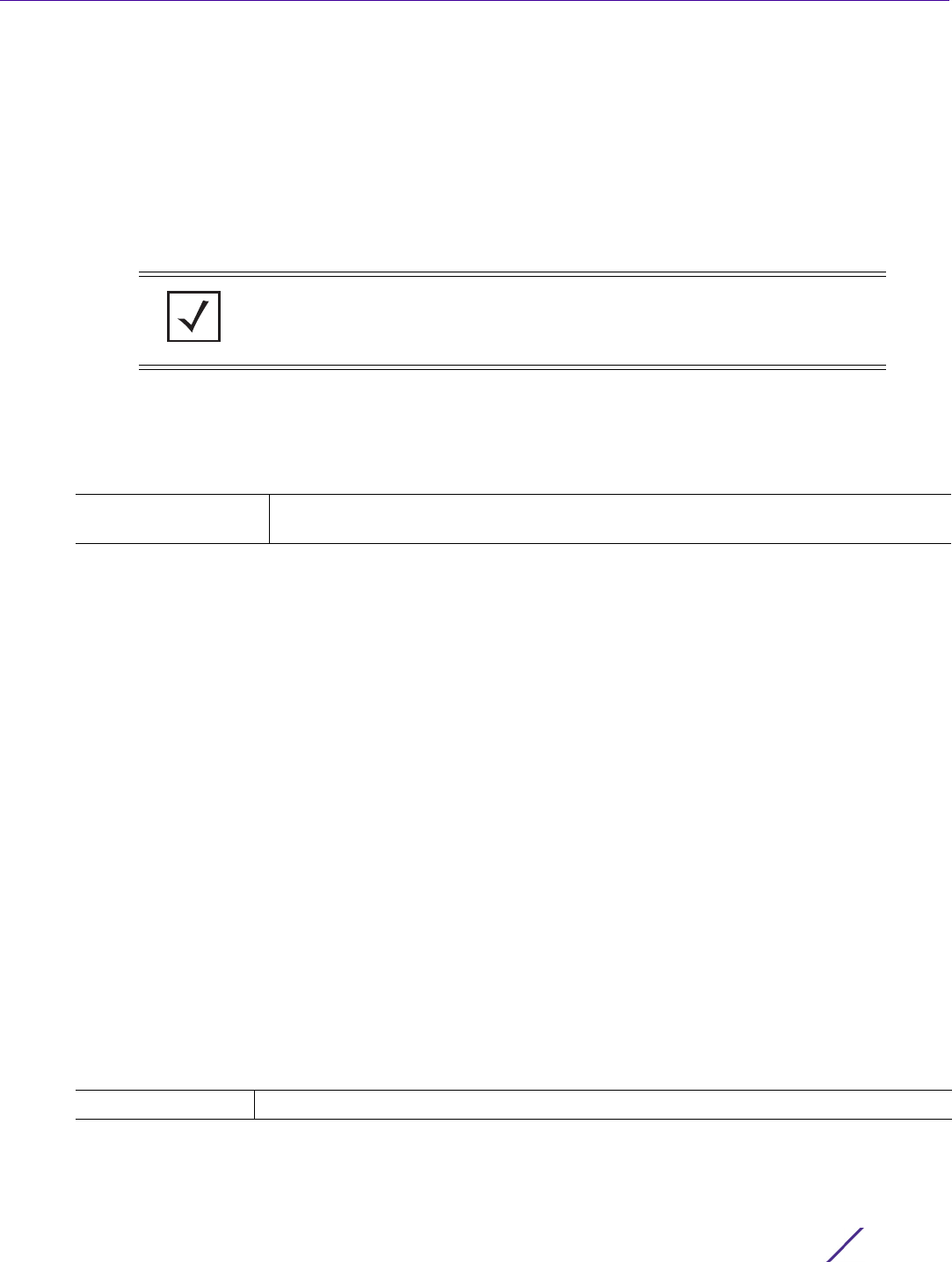
GLOBAL CONFIGURATION COMMANDS
Access Point, Wireless Controller and Service Platform CLI Reference Guide 4 - 406
4.1.83 nx75xx
Global Configuration Commands
Adds an integrated NX75XX series service platform to the network. If a profile for service platform is not
available, a new profile is created.
Supported in the following platforms:
• Wireless Controllers — RFS4000, RFS6000
• Service Platforms — NX7500, NX7510, NX7520, NX7530, NX9500, NX9510, NX9600, VX9000
Syntax
nx75xx <DEVICE-NX75XX-MAC>
Parameters
• nx75xx <DEVICE-NX75XX-MAC>
Example
nx9500-6C8809(config)#nx75xx B4-C9-81-6C-FA-7C
nx9500-6C8809(config-device-B4-C9-81-6C-FA-7C)#show context
nx75xx B4-C9-81-6C-FA-7C
use profile default-nx75xx
use rf-domain default
hostname nx75xx-6CFA7C
nx9500-6C8809(config-device-B4-C9-81-6C-FA-7C)#
nx75xx-6CFA7C>show adoption status
Adopted by:
Type : nx9000
System Name : nx9500-6C8809
MAC address : B4-C7-99-6C-88-09
MiNT address : 19.6C.88.09
Time : 1 days 01:57:50 ago
Adopted Devices:
--------------------------------------------------------------------------------
-------
DEVICE-NAME VERSION CFG-STAT MSGS ADOPTED-BY LAST-ADOPTION UPTIME
--------------------------------------------------------------------------------
-------
ap7131-11E6C4 5.8.6.0-008B configured No nx75xx-6CFA7C 1 days 01:49:44 1 days
01:59:34
--------------------------------------------------------------------------------
-------
Total number of devices displayed: 1
nx75xx-6CFA7C>
Related Commands
NOTE: In this guide, NX7500, NX7510, NX7520, and NX7530 are collectively
represented as a NX75XX series service platform.
<DEVICE-NX75XX-
MAC>
Specifies the MAC address of a NX75XX series service platform.
no Removes a NX75XX series service platform from the network

GLOBAL CONFIGURATION COMMANDS
Access Point, Wireless Controller and Service Platform CLI Reference Guide 4 - 407
4.1.84 nx9000
Global Configuration Commands
Adds a NX95XX series service platform to the network
Supported in the following platforms:
• Wireless Controllers — RFS4000, RFS6000
• Service Platforms — NX5500, NX7500, NX7510, NX7520, NX7530, NX9500, NX9510, NX9600,
VX9000
Syntax
nx9000 <DEVICE-NX95XX-MAC>
Parameters
• nx9000 <DEVICE-NX95XX-MAC>
Example
nx9500-6C8809(config)#nx9000 B4-C7-89-7C-81-08
nx9500-6C8809(config-device-B4-C7-89-7C-81-08)#
Related Commands
<DEVICE-NX95XX-
MAC>
Specifies the MAC address of a NX95XX series service platform.
no Removes a NX95XX series service platform from the network

GLOBAL CONFIGURATION COMMANDS
Access Point, Wireless Controller and Service Platform CLI Reference Guide 4 - 408
4.1.85 roaming-assist-policy
Global Configuration Commands
Configures a roaming assist policy that enables access points to assist wireless clients in making roaming
decisions, such as which access point to connect, etc.
Supported in the following platforms:
• Access Points — AP6521, AP6522, AP6532, AP6562, AP7161, AP7502, AP7522, AP7532, AP7562,
AP7602, AP7612, AP7622, AP7632, AP7662, AP81XX, AP82XX, AP8432, AP8533
• Wireless Controllers — RFS4000, RFS6000
• Service Platforms — NX5500, NX7500, NX7510, NX7520, NX7530, NX9500, NX9510, NX9600,
VX9000
Syntax
roaming-assist-policy <POLICY-NAME>
Parameters
• roaming-assist-policy <POLICY-NAME>
Example
rfs6000-81742D(config)#roaming-assist-policy testPolicy
rfs6000-81742D(config-roaming-assist-policy-testPolicy)#?
Roaming Assist Mode commands:
action Configure action - action is either to log / deauth
aggressiveness Configure the roaming aggressiveness for a wireless
client
detection-threshold Configure the detection threshold - when exceeded,
client monitoring starts
disassoc-time Configure the disassociation time - time after which a
disassociation is sent
handoff-count Configure the handoff count - number of times client
can exceed handoff threshold
handoff-threshold Configure the handoff threshold - when exceeds an
action is taken.
monitoring-interval Configure the monitoring interval - interval at which
client monitoring occurs
no Negate a command or set its defaults
sampling-interval Configure the sampling interval - interval at which
client rssi values are checked
clrscr Clears the display screen
commit Commit all changes made in this session
end End current mode and change to EXEC mode
exit End current mode and down to previous mode
help Description of the interactive help system
revert Revert changes
service Service Commands
show Show running system information
write Write running configuration to memory or terminal
rfs6000-81742D(config-roaming-assist-policy-testPolicy)#
Related Commands
<POLICY-NAME> Specify the roaming assist policy name. If the policy does not exist, it is created.
no Removes an existing roaming assist policy

GLOBAL CONFIGURATION COMMANDS
Access Point, Wireless Controller and Service Platform CLI Reference Guide 4 - 409
NOTE: For more information on roaming assist policy commands, see
Chapter 30, ROAMING ASSIST POLICY.

GLOBAL CONFIGURATION COMMANDS
Access Point, Wireless Controller and Service Platform CLI Reference Guide 4 - 410
4.1.86 role-policy
Global Configuration Commands
Configures a role-based firewall policy
Supported in the following platforms:
• Access Points — AP6521, AP6522, AP6532, AP6562, AP7161, AP7502, AP7522, AP7532, AP7562,
AP7602, AP7612, AP7622, AP7632, AP7662, AP81XX, AP82XX, AP8432, AP8533
• Wireless Controllers — RFS4000, RFS6000
• Service Platforms — NX5500, NX7500, NX7510, NX7520, NX7530, NX9500, NX9510, NX9600,
VX9000
Syntax
role-policy <ROLE-POLICY-NAME>
Parameters
• role-policy <ROLE-POLICY-NAME>
Example
rfs6000-81742D(config)#role-policy role1
rfs6000-81742D(config-role-policy-role1)#?
Role Policy Mode commands:
default-role Configuration for Wireless Clients not matching any role
ldap-deadperiod Ldap dead period interval
ldap-query Set the ldap query mode
ldap-server Add a ldap server
ldap-timeout Ldap query timeout interval
no Negate a command or set its defaults
user-role Create a role
clrscr Clears the display screen
commit Commit all changes made in this session
do Run commands from Exec mode
end End current mode and change to EXEC mode
exit End current mode and down to previous mode
help Description of the interactive help system
revert Revert changes
service Service Commands
show Show running system information
write Write running configuration to memory or terminal
rfs6000-81742D(config-role-policy-role1)#
Related Commands
<ROLE-POLICY-
NAME>
Specify the role policy name. If the policy does not exist, it is created.
no Removes an existing role policy
NOTE: For more information on role policy commands, see Chapter 18, ROLE-
POLICY.

GLOBAL CONFIGURATION COMMANDS
Access Point, Wireless Controller and Service Platform CLI Reference Guide 4 - 411
4.1.87 route-map
Global Configuration Commands
Creates a dynamic BGP route map and enters its configuration mode
BGP route maps are used by network administrators to define rules controlling redistribution of routes
between routers and routing processes. These route maps are also used to control and modify routing
information.
Supported in the following platforms:
• Service Platforms — NX5500, NX7500, NX7510, NX7520, NX7530, NX9600, VX9000
Syntax
route-map <ROUTE-MAP-NAME>
Parameters
• route-map <ROUTE-MAP-NAME>
Example
nx9500-6C8809(config)#route-map test
nx9500-6C8809(config-dr-route-map-test)#?
Route Map Mode commands:
deny Add a deny route map rule to deny set operations
no Negate a command or set its defaults
permit Add a permit route map rule to permit set operations
clrscr Clears the display screen
commit Commit all changes made in this session
do Run commands from Exec mode
end End current mode and change to EXEC mode
exit End current mode and down to previous mode
help Description of the interactive help system
revert Revert changes
service Service Commands
show Show running system information
write Write running configuration to memory or terminal
nx9500-6C8809(config-dr-route-map-test)#
Related Commands
route-map
<ROUTE-MAP-NAME>
Creates a new BGP route map and enters its configuration mode
no Removes an existing dynamic BGP route map
NOTE: For more information on BGP route maps, see Chapter 28, BORDER
GATEWAY PROTOCOL.

GLOBAL CONFIGURATION COMMANDS
Access Point, Wireless Controller and Service Platform CLI Reference Guide 4 - 412
4.1.88 routing-policy
Global Configuration Commands
Configures a routing policy
Supported in the following platforms:
• Access Points — AP6521, AP6522, AP6532, AP6562, AP7161, AP7502, AP7522, AP7532, AP7562,
AP7602, AP7612, AP7622, AP7632, AP7662, AP81XX, AP82XX, AP8432, AP8533
• Wireless Controllers — RFS4000, RFS6000
• Service Platforms — NX5500, NX7500, NX7510, NX7520, NX7530, NX9500, NX9510, NX9600,
VX9000
Syntax
routing-policy <ROUTING-POLICY-NAME>
Parameters
• routing-policy <ROUTING-POLICY-NAME>
Example
rfs6000-81742D(config)#routing-policy TestRoutingPolicy
rfs6000-81742D(config-routing-policy-TestRoutingPolicy)#?
Routing Policy Mode commands:
apply-to-local-packets Use Policy Based Routing for packets generated by
the device
logging Enable logging for this Route Map
no Negate a command or set its defaults
route-map Create a Route Map
use Set setting to use
clrscr Clears the display screen
commit Commit all changes made in this session
do Run commands from Exec mode
end End current mode and change to EXEC mode
exit End current mode and down to previous mode
help Description of the interactive help system
revert Revert changes
service Service Commands
show Show running system information
write Write running configuration to memory or terminal
rfs6000-81742D(config-routing-policy-TestRoutingPolicy)#
Related Commands
<ROUTING-POLICY-
NAME>
Specify the routing policy name. If the policy does not exist, it is created.
no Removes an existing routing policy
NOTE: For more information on routing policy commands, see Chapter 24,
ROUTING-POLICY.

GLOBAL CONFIGURATION COMMANDS
Access Point, Wireless Controller and Service Platform CLI Reference Guide 4 - 413
4.1.89 rtl-server-policy
Global Configuration Commands
The following table lists the Real Time Locationing (RTL) server policy configuration commands:
Table 4.45 RTL-Server-Policy Config Command
Command Description Reference
rtl-server-policy Configures an RTL server policy and enters its configuration mode page 4-414
rtl-server-policy-
mode commands
Summarizes RTL server policy configuration mode commands page 4-416

GLOBAL CONFIGURATION COMMANDS
Access Point, Wireless Controller and Service Platform CLI Reference Guide 4 - 414
4.1.89.1 rtl-server-policy
rtl-server-policy
Creates an RTL server policy and enters its configuration mode. When configured and applied on an access
point (AP7522, AP7532, AP8432, AP8533), this policy enables the sending of RSSI feeds from the access
point to a
third-party Euclid server. The RTL server policy provides the exact location (URL) of the Euclid server. The
RSSI feeds sent are as per the sensor-policy configured and applied on the access point. Therefore, ensure
that a sensor-policy, with the rssi-interval-duration specified, is existing, configured, and applied on the
access points.
To initiate RSSI feed posts to the Euclid locationing server, use the RTL server policy on the:
•AP’s device/profile context, or
•AP’s RF Domain context.
Supported in the following platforms:
• Access Points — AP7522, AP7532, AP8432, AP8533
• Wireless Controllers — RFS4000
• Service Platforms — NX9500, NX9510, NX9600, VX9000
Syntax
rtl-server-policy <RTL-POLICY-NAME>
Parameters
• rtl-server-policy <RTL-POLICY-NAME>
Example
nx9500-6C8809(config)#rtl-server-policy test
nx9500-6C8809(config-rtl-server-policy-test)#?
RTL Server Policy Mode commands:
no Negate a command or set its defaults
url Configure the url to send the real time RSSI feed to
clrscr Clears the display screen
commit Commit all changes made in this session
do Run commands from Exec mode
end End current mode and change to EXEC mode
exit End current mode and down to previous mode
help Description of the interactive help system
revert Revert changes
service Service Commands
show Show running system information
write Write running configuration to memory or terminal
nx9500-6C8809(config-rtl-server-policy-test)#
<RTL-SERVER-
POLICY-NAME>
Specify the RTL server policy name. If a RTL server policy with the specified name
does not exist, it is created.

GLOBAL CONFIGURATION COMMANDS
Access Point, Wireless Controller and Service Platform CLI Reference Guide 4 - 415
Related Commands
no Removes an existing RTL server policy
use (profile/device
configuration mode
command)
Documents the ‘use’ command in a device’s profile or device configuration context.
Use this option to associate this RTL server policy to an access point’s profile or
device.
use (RF Domain
configuration mode
command)
Documents the ‘use’ command in the RF Domain configuration context. Use this
option to associate this RTL server policy to an RF Domain. When associated, the
policy is applied to all access points within the RF Domain.

GLOBAL CONFIGURATION COMMANDS
Access Point, Wireless Controller and Service Platform CLI Reference Guide 4 - 416
4.1.89.2 rtl-server-policy-mode commands
rtl-server-policy
The following table summarizes the RTL server policy configuration mode commands:
Table 4.46 RTL-Server-Policy Mode Commands
Command Description Reference
url Configures the third-party Euclid RTL server’s URL page 4-417
no Removes the Euclid RTL server’s URL configuration page 4-418

GLOBAL CONFIGURATION COMMANDS
Access Point, Wireless Controller and Service Platform CLI Reference Guide 4 - 417
4.1.89.2.1 url
rtl-server-policy-mode commands
Configures the third-party Euclid RTL server’s exact location. This is the URL at which the server can be
reached.
Supported in the following platforms:
• Access Points — AP7522, AP7532, AP8432, AP8533
• Wireless Controllers — RFS4000
• Service Platforms — NX9500, NX9510, NX9600, VX9000
Syntax
url <URL>
Parameters
• url <URL>
Example
nx9500-6C8809(config-rtl-server-policy-test)#url https://testrtlsever.com
nx9500-6C8809(config-rtl-server-policy-test)#show context
rtl-server-policy test
url https://testrtlsever.com
nx9500-6C8809(config-rtl-server-policy-test)#
Related Commands
url <URL> Configures the Euclid server’s URL
• <URL> – Specify the URL.
no Removes the Euclid server’s configured URL

GLOBAL CONFIGURATION COMMANDS
Access Point, Wireless Controller and Service Platform CLI Reference Guide 4 - 418
4.1.89.2.2 no
rtl-server-policy-mode commands
Removes the Euclid locationing server’s URL configuration
Supported in the following platforms:
• Access Points — AP7522, AP7532, AP8432, AP8533
• Wireless Controllers — RFS4000
• Service Platforms — NX9500, NX9510, NX9600, VX9000
Syntax
no url
Parameters
• no url
Example
The following example displays the RTL server policy ‘test’ settings before the ‘no’ command is
executed:
nx9500-6C8809(config-rtl-server-policy-test)#show context
rtl-server-policy test
url https://testrtlsever.com
nx9500-6C8809(config-rtl-server-policy-test)#
nx9500-6C8809(config-rtl-server-policy-test)#no url
The following example displays the RTL server policy ‘test’ settings after the ‘no’ command is executed:
nx9500-6C8809(config-rtl-server-policy-test)#show context
rtl-server-policy test
nx9500-6C8809(config-rtl-server-policy-test)#
no url Removes the Euclid server’s URL

GLOBAL CONFIGURATION COMMANDS
Access Point, Wireless Controller and Service Platform CLI Reference Guide 4 - 419
4.1.90 schedule-policy
Global Configuration Commands
The following table summarizes the config schedule policy commands:
Table 4.47 Schedule-Policy Config Commands
Command Description Reference
schedule-policy Creates a schedule policy and enters its configuration mode page 4-420
schedule-policy-mode
commands
Lists schedule policy configuration mode commands page 4-421

GLOBAL CONFIGURATION COMMANDS
Access Point, Wireless Controller and Service Platform CLI Reference Guide 4 - 420
4.1.90.1 schedule-policy
schedule-policy
Creates a schedule policy and enters its configuration mode. A schedule policy strategically enforces
application filter policy rules during administrator assigned intervals.
Supported in the following platforms:
• Wireless Controllers — RFS4000, RFS6000
• Service Platforms — NX5500, NX7500, NX7510, NX7520, NX7530, NX9500, NX9510, NX9600,
VX9000
Syntax
schedule-policy <SCHEDULE-POLICY-NAME>
Parameters
• schedule-policy <SCHEDULE-POLICY-NAME>
Example
nx9500-6C8809(config)#schedule-policy test
nx9500-6C8809(config-schedule-policy-test)#?
Schedule Policy Mode commands:
description Schedule policy description
no Negate a command or set its defaults
time-rule Configure a time rule
clrscr Clears the display screen
commit Commit all changes made in this session
do Run commands from Exec mode
end End current mode and change to EXEC mode
exit End current mode and down to previous mode
help Description of the interactive help system
revert Revert changes
service Service Commands
show Show running system information
write Write running configuration to memory or terminal
nx9500-6C8809(config-schedule-policy-test)#
Related Commands
schedule-policy
<SCHEDULE-POLICY-
NAME>
Specify the Schedule policy name. If the policy does not exist, it is created. The name
should not exceed 32 characters in length.
no Removes an existing schedule policy

GLOBAL CONFIGURATION COMMANDS
Access Point, Wireless Controller and Service Platform CLI Reference Guide 4 - 421
4.1.90.2 schedule-policy-mode commands
schedule-policy
The following table summarizes schedule-policy configuration mode commands:
Table 4.48 Schedule-Policy-Config-Mode Commands
Command Description Reference
description Configures a description for this schedule policy that differentiates it from
other policies with similar time rule configurations
page 4-422
time-rule Configures a time rule specifying the days and optionally the start and
end times
page 4-423
no Removes the selected schedule policy’s settings page 4-425

GLOBAL CONFIGURATION COMMANDS
Access Point, Wireless Controller and Service Platform CLI Reference Guide 4 - 422
4.1.90.2.1 description
schedule-policy-mode commands
Configures a description for this schedule policy that differentiates it from other policies with similar time
rule configurations
Supported in the following platforms:
• Wireless Controllers — RFS4000, RFS6000
• Service Platforms — NX5500, NX7500, NX7510, NX7520, NX7530, NX9500, NX9510, NX9600,
VX9000
Syntax
description <WORD>
Parameters
• description <WORD>
Example
nx9500-6C8809(config-schedule-policy-test)#description "Denies social networking
sites on weekdays."
nx9500-6C8809(config-schedule-policy-test)#show context
schedule-policy test
description "Denies social networking sites on weekdays."
nx9500-6C8809(config-schedule-policy-test)#
Related Commands
description <WORD> Configures this schedule policy’s description
• <WORD> – Enter a description not exceeding 80 characters in length. The description
should uniquely identify the policy from other policies with similar configuration.
no Removes this schedule policy’s description

GLOBAL CONFIGURATION COMMANDS
Access Point, Wireless Controller and Service Platform CLI Reference Guide 4 - 423
4.1.90.2.2 time-rule
schedule-policy-mode commands
Configures a time rule specifying the days and optionally the start and end times. When applied to an
application-policy rule, the schedule policy defines the enforcement time of the rule. For more information,
see application-policy.
Supported in the following platforms:
• Wireless Controllers — RFS4000, RFS6000
• Service Platforms — NX5500, NX7500, NX7510, NX7520, NX7530, NX9500, NX9510, NX9600,
VX9000
Syntax
time-rule days [sunday|monday|tuesday|wednesday|thursday|friday|saturday|all|
weekends|weekdays] {start-time <HH:MM> [end-time <HH:MM>]}
Parameters
• time-rule days [sunday|monday|tuesday|wednesday|thursday|friday|saturday|all|
weekends|weekdays] {start-time <HH:MM> [end-time <HH:MM>]}
time-rule Configures a time rule in days and hours and minutes
A schedule policy can have more than one non-overlapping time-rules. The following
time-rules, having overlapping time periods, are invalid: ‘weekdays, start-time 9:30 am,
end-time 11:30 pm’ and ‘all, start-time 12:00 am, end-time 12:00 pm’.
days
[sunday|monday|
tuesday|wednesday|
thursday|friday|
saturday|all|
weekends|
weekdays]
Specifies the days on which the time rule is applicable
• sunday – Applicable on Sundays only
• monday – Applicable on Mondays only
• tuesday – Applicable on Tuesdays only
• wednesday – Applicable on Wednesdays only
• thursday – Applicable on Thursdays only
• friday – Applicable on Fridays only
• saturday – Applicable on Saturdays only
• weekends – Applicable on weekends only
• weekdays – Applicable on weekdays only
• all – Applicable on all days
start-time <HH:MM>
[end-time <HH:MM>]
After specifying the days of enforcement, specify the following:
• start-time – Optional. Specifies the enforcement start time
• <HH:MM> – Specify the start time in hours and minutes in the HH:MM format.
If no start time is specified, the time rule is enforced, on the specified days, at all time.
• end-time – Specifies the enforcement end time
• <HH:MM> – Specify the time in hours and minutes in the HH:MM format.

GLOBAL CONFIGURATION COMMANDS
Access Point, Wireless Controller and Service Platform CLI Reference Guide 4 - 424
Example
nx9500-6C8809(config-schedule-policy-test)#time-rule days weekdays start-time
10:00 end-time 23:30
nx9500-6C8809(config-schedule-policy-test)#show context
schedule-policy test
description "Denies social networking sites on weekdays."
time-rule days weekdays start-time 10:00 end-time 23:30
nx9500-6C8809(config-schedule-policy-test)#
Related Commands
no Removes the time-rule from the schedule policy

GLOBAL CONFIGURATION COMMANDS
Access Point, Wireless Controller and Service Platform CLI Reference Guide 4 - 425
4.1.90.2.3 no
schedule-policy-mode commands
Removes the selected schedule policy’s settings
Supported in the following platforms:
• Wireless Controllers — RFS4000, RFS6000
• Service Platforms — NX5500, NX7500, NX7510, NX7520, NX7530, NX9500, NX9510, NX9600,
VX9000
Syntax
no [description|time-rule]
no description
no time-rule days [sunday|monday|tuesday|wednesday|thursday|friday|saturday|
all|weekends|weekdays]
Parameters
• no <PARAMETERS>
Example
The following example displays the schedule policy ‘test’ settings before the ‘no’ commands have been
executed:
nx9500-6C8809(config-schedule-policy-test)#show context
schedule-policy test
description "Denies social networking sites on weekdays."
time-rule days weekdays start-time 10:00 end-time 23:30
nx9500-6C8809(config-schedule-policy-test)#
The following example displays the schedule policy ‘test’ settings after the ‘no’ commands have been
executed:
nx9500-6C8809(config-schedule-policy-test)#no description
nx9500-6C8809(config-schedule-policy-test)#no time-rule days weekdays
nx9500-6C8809(config-schedule-policy-test)#show context
schedule-policy test
nx9500-6C8809(config-schedule-policy-test)#
no <PARAMETERS> Removes the schedule policy’s settings based on the parameters passed

GLOBAL CONFIGURATION COMMANDS
Access Point, Wireless Controller and Service Platform CLI Reference Guide 4 - 426
4.1.91 self
Global Configuration Commands
Displays the logged device’s configuration context
Supported in the following platforms:
• Access Points — AP6521, AP6522, AP6532, AP6562, AP7161, AP7502, AP7522, AP7532, AP7562,
AP7602, AP7612, AP7622, AP7632, AP7662, AP81XX, AP82XX, AP8432, AP8533
• Wireless Controllers — RFS4000, RFS6000
• Service Platforms — NX5500, NX7500, NX7510, NX7520, NX7530, NX9500, NX9510, NX9600,
VX9000
Syntax
self
Parameters
None
Example
rfs6000-81742D(config)#self
rfs6000-81742D(config-device-00-15-70-37-FA-BE)#

GLOBAL CONFIGURATION COMMANDS
Access Point, Wireless Controller and Service Platform CLI Reference Guide 4 - 427
4.1.92 sensor-policy
Global Configuration Commands
The following table summarizes the config sensor policy commands:0
Table 4.49 Sensor-Policy Config Commands
Command Description Reference
sensor-policy Creates a sensor policy and enters its configuration mode page 4-428
sensor-policy-mode
commands
Lists sensor policy configuration mode commands page 4-430
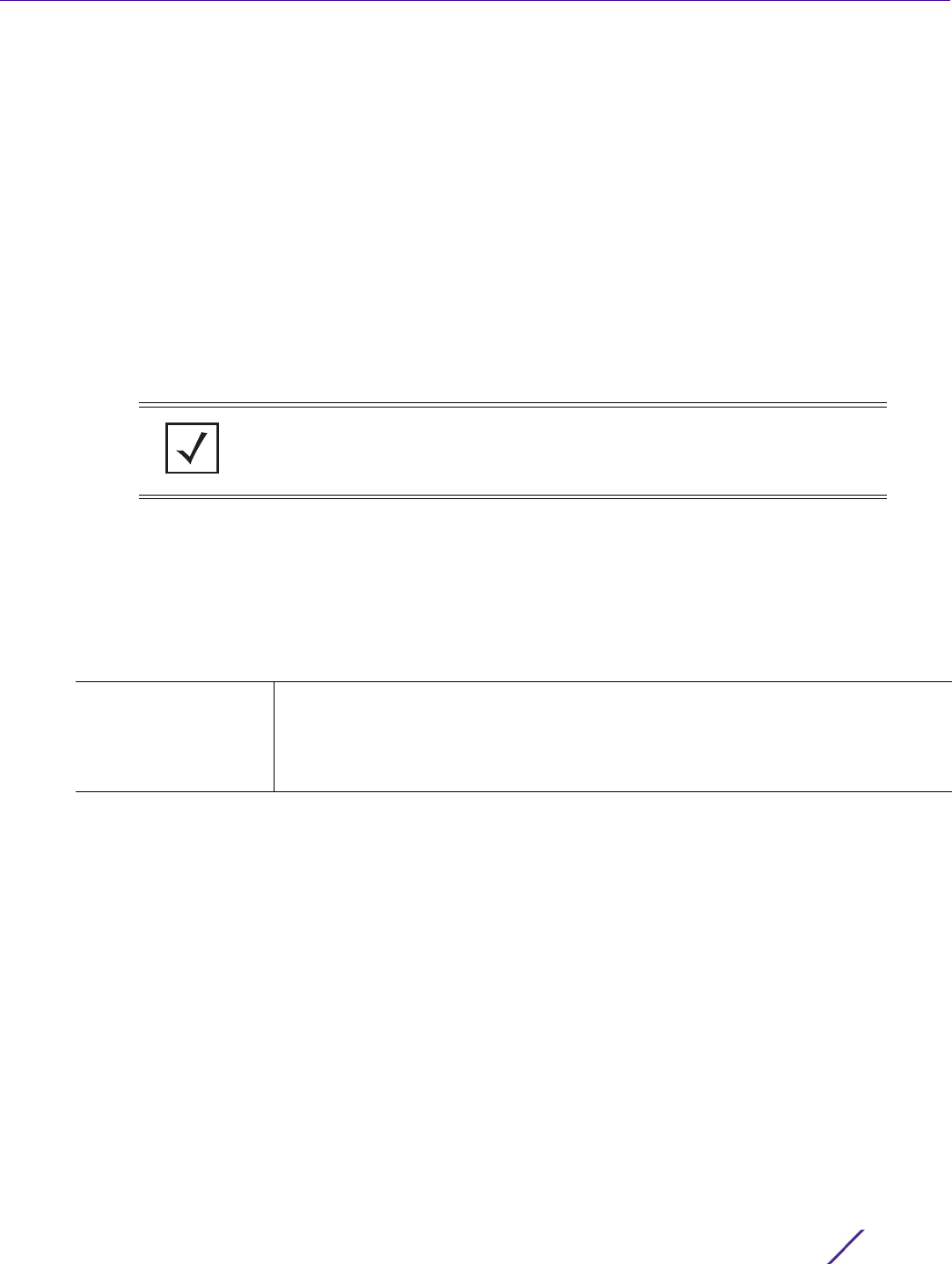
GLOBAL CONFIGURATION COMMANDS
Access Point, Wireless Controller and Service Platform CLI Reference Guide 4 - 428
4.1.92.1 sensor-policy
sensor-policy
In addition to WIPS support, sensor functionality has now been added for the Extreme Network’s MPact
locationing system. The MPact system for Wi-Fi locationing includes WiNG controllers, and access points
functioning as sensors. Within the MPact architecture, sensors scan for RSSI data on an administrator
defined interval and send to a dedicated MPact Server resource, as opposed to an ADSP server. The MPact
Server collects the RSSI data from WiNG sensor devices, and calculates the location of Wi-Fi devices for
MPact administrators.
Use this command to configure a policy defining the mode of scanning, the channels to scan (in case scan-
mode is set to custom-scan), and the RSSI interval. For the sensor policy to take effect, use the policy
either in the access point’s RF Domain context or in the access point’s device context.
Supported in the following platforms:
• Service Platforms — NX7500, NX7510, NX7520, NX7530, NX9500, NX9510
Syntax
sensor-policy <SENSOR-POLICY-NAME>
Parameters
• sensor-policy <SENSOR-POLICY-NAME>
Usage GuidelinesADSP WIPS/MPact
Access point radios, functioning as sensors, along with AirDefense WIPS servers protect networks from
attacks and unauthorized access. These access point sensors scan legal channels and (based on a WIPS
policy settings) identify events potential threats to the managed network. These events are reported to the
AirDefense WIPS server, which determines the action taken.
In addition to WIPS support, sensor functionality has now been added for the MPact locationing system.
The MPact system for Wi-Fi locationing includes WiNG controllers and access points functioning as
sensors. Within the MPact architecture, sensors scan for RSSI data on an administrator-defined interval and
send to a dedicated MPact server resource, as opposed to an ADSP server. The MPact server collects the
RSSI data from WiNG sensor devices, and calculates the location of Wi-Fi devices. With the introduction of
the MPact platform, the data collected by access point radios, functioning as sensors, is also used by the
MPact server to provide real-time locationing services.
NOTE: If a dedicated sensor is utilized with WIPS for rogue detection, any
sensor policy used is discarded and not utilized by the sensor. To avoid this
situation, use ADSP channel settings exclusively to configure the sensor and
not the WiNG interface.
sensor-policy
<SENSOR-POLICY-
NAME>
Specify the Sensor policy name. If a sensor policy with the specified name does not
exist, it is created. The name should not exceed 32 characters in length. No
character spaces are permitted within the name. Define a name unique to the
policy’s channel and scan mode configuration to help differentiate it from other
policies.

GLOBAL CONFIGURATION COMMANDS
Access Point, Wireless Controller and Service Platform CLI Reference Guide 4 - 429
Example
nx9500-6C8809(config)#sensor-policy test
nx9500-6C8809(config-sensor-policy-test)#?
Sensor Policy Mode commands:
custom-scan Channel configuration in Custom Scan channels
no Negate a command or set its defaults
rssi-interval-duration Configure the periodicity of sensding RSSI info from
sensor to server
scan-mode Configure the Scan mode
clrscr Clears the display screen
commit Commit all changes made in this session
do Run commands from Exec mode
end End current mode and change to EXEC mode
exit End current mode and down to previous mode
help Description of the interactive help system
revert Revert changes
service Service Commands
show Show running system information
write Write running configuration to memory or terminal
nx9500-6C8809(config-sensor-policy-test)#
Related Commands
no Removes an existing sensor policy

GLOBAL CONFIGURATION COMMANDS
Access Point, Wireless Controller and Service Platform CLI Reference Guide 4 - 430
4.1.92.2 sensor-policy-mode commands
sensor-policy
The following table summarizes sensor-policy configuration mode commands:
Table 4.50 Sensor-Policy-Config-Mode Commands
Command Description Reference
custom-scan Configures the channel scanning settings when the scan-mode is set to
custom-scan
page 4-431
rssi-interval-
duration
Configures the interval at which dedicated sensors scan channels for RSSI
assessments and send the collected data to a specified MPact server
resource
page 4-433
scan-mode Configures the mode of scanning used by dedicated sensors (access
point radios)
page 4-434
no Removes or reverts to default a sensor policy’s settings page 4-435

GLOBAL CONFIGURATION COMMANDS
Access Point, Wireless Controller and Service Platform CLI Reference Guide 4 - 431
4.1.92.2.1 custom-scan
sensor-policy-mode commands
Configures the channel scanning settings when the scan-mode is set to custom-scan
Supported in the following platforms:
• Service Platforms — NX7500, NX7510, NX7520, NX7530, NX9500, NX9510, NX9600, VX9000
Syntax
custom-scan channel-frequency <CHANNEL-FREQUENCY> width [20MHz|40MHz-Bth|40MHz-
Lower|40MHz-Upper|80MHz] scan-weight <SCAN-WEIGHT>
Parameters
• custom-scan channel-frequency <CHANNEL-FREQUENCY> width [20MHz|40MHz-Both|
40MHz-Lower|40MHz-Upper|80MHz] scan-weight <SCAN-WEIGHT>
Example
nx9500-6C8809(config-sensor-policy-test)#custom-scan channel-frequency 2412 width
20MHz scan-weight 1000
nx9500-6C8809(config-sensor-policy-test)#custom-scan channel-frequency 2417 width
20MHz scan-weight 1000
NOTE: If the mode of scanning is set to Custom-Scan, use this command to
configure the channels to be scanned. To set the mode of scanning to
custom-scan, use the scan-mode > Custom-Scan command. For more
information, see scan-mode.
custom-scan Configures the custom-scan channel frequency, channel width, and scan weight
channel-frequency
<CHANNEL-
FREQUENCY>
Configures the channel frequency. A list of unique channels in the 2.4, 4.9, 5 and 6 GHz
band can be collectively or individually enabled for customized channel scans and
RSSI reporting.
• <CHANNEL-FREQUENCY> – Specify a single or multiple, ‘comma-separated’ channel
frequencies.
width [20MHz|
40MHz-Both|
40MHz-Lower|
40MHz-Upper|
80MHz]
Configures the channel width. When custom channels are selected for RSSI scans,
each selected channel can have its own width defined. Numerous channels have their
width fixed at 20MHz, 802.11a radios support 20 and 40 MHz channel widths.
• 20MHz – Sets the channel width as 20 Mhz
• 40Mhz-Both – Sets the channel width as 40Mhz-Both
• 40Mhz-Lowe – Sets the channel width as 40Mhz-Lower
• 40Mhz-Upper – Sets the channel width as 40Mhz-Upper
• 80Mhz – Sets the channel width as 80Mhz
scan-weight <SCAN-
WEIGHT>
Configures the scan-weight (scanning duration) for each of the selected channels.
Each selected channel can have its weight prioritized in respect to the amount of time
a scan is permitted within the defined RSSI scan interval.
• <SCAN-WEIGHT> – Specify the scan weightage given to each selected channel.

GLOBAL CONFIGURATION COMMANDS
Access Point, Wireless Controller and Service Platform CLI Reference Guide 4 - 432
nx9500-6C8809(config-sensor-policy-test)#show context
sensor-policy test
scan-mode Custom-Scan
custom-scan channel-frequency 2412 width 20MHz scan-weight 1000
custom-scan channel-frequency 2417 width 20MHz scan-weight 1000
nx9500-6C8809(config-sensor-policy-test)#
Related Commands
no Removes channels from the channels-to-scan list in case of scan-mode being set to
Custom-Scan

GLOBAL CONFIGURATION COMMANDS
Access Point, Wireless Controller and Service Platform CLI Reference Guide 4 - 433
4.1.92.2.2 rssi-interval-duration
sensor-policy-mode commands
Configures the interval, in seconds, at which dedicated sensors scan channels for RSSI assessments and
send the RSSI data obtained to a specified server resource
Supported in the following platforms:
• Service Platforms — NX7500, NX7510, NX7520, NX7530, NX9500, NX9510, NX9600, VX9000
Syntax
rssi-interval-duration <1-60>
Parameters
• rssi-interval-duration <1-60>
Example
nx9500-6C8809(config-sensor-policy-test)#rssi-interval-duration 30
nx9500-6C8809(config-sensor-policy-test)#show context
sensor-policy test
rssi-interval-duration 30
scan-mode Custom-Scan
custom-scan channel-frequency 2412 width 20MHz scan-weight 1000
custom-scan channel-frequency 2417 width 20MHz scan-weight 1000
nx9500-6C8809(config-sensor-policy-test)#
Related Commands
rssi-interval-duration
<1-60>
Configures the RSSI interval duration in seconds. This is the interval at which the
sensor scans channels for RSSI data and forwards the data to a dedicated server
resource. The server calculates real-time locations of Wi-Fi devices based on the this
data.
• <1-60> – Specify the RSSI interval duration from 1 - 60 seconds. The default is 1 second.
The channels scanned for RSSI assessment depends on the scan-mode selected. For
more information, see scan-mode and custom-scan.
Ensure that the server’s IP address or hostname has been configured in the access
point sensor’s RF Domain context.
no Resets the interval at which RSSI data is collected and sent by the sensor to the
MPact server host to default (1 second)

GLOBAL CONFIGURATION COMMANDS
Access Point, Wireless Controller and Service Platform CLI Reference Guide 4 - 434
4.1.92.2.3 scan-mode
sensor-policy-mode commands
Configures the mode of scanning used by dedicated sensors (access point radios)
Supported in the following platforms:
• Service Platforms — NX7500, NX7510, NX7520, NX7530, NX9500, NX9510, NX9600, VX9000
Syntax
scan-mode [Channel-Lock|Custom-Scan|Default-Scan]
scan-mode Channel-Lock lock-frequency <LOCK-FREQUENCY>
scan-mode [Custom-Scan|Default-Scan]
Parameters
• scan-mode Channel-Lock lock-frequency <LOCK-FREQUENCY>
• scan-mode [Custom-Scan|Default-Scan]
Example
nx9500-6C8809(config-sensor-policy-test)#scan-mode Custom-Scan
nx9500-6C8809(config-sensor-policy-test)#show context
sensor-policy test
rssi-interval-duration 30
scan-mode Custom-Scan
custom-scan channel-frequency 2412 width 20MHz scan-weight 1000
custom-scan channel-frequency 2417 width 20MHz scan-weight 1000
nx9500-6C8809(config-sensor-policy-test)#
Related Commands
scan-mode Configures the mode of scanning used by the sensors to scan system-defined or user-
defined channels for RSSI assessments. The options are: Channel-Lock, Custom-Scan,
and Default-Scan.
Channel-Lock
lock-frequency
<LOCK-
FREQUENCY>
Configures the mode of scanning as Channel-Lock
• lock-frequency <LOCK-FREQUENCY> – Locks scanning for RSSI data to one specific
channel identified by the <LOCK-FREQUENCY> parameter.
• <LOCK-FREQUENCY> – Specify the channel frequency in MHz. When specified, the
sensor scans only this specified channel.
scan-mode Configures the mode of scanning used by the sensor. The options are: channel-lock,
custom-scan, and default-scan.
Custom-Scan Configures the mode of scanning as Custom-Scan
Select this option to restrict scanning to user-defined channels. If selecting this option,
use the custom-scan > channel-frequency command to configure the channels
scanned by the dedicated sensor. For more information, see custom-scan.
Default-Scan Configures the mode of scanning as Default-Scan. This is the default setting.
By default the system has a fixed, built-in list of channels that are scanned. These
channels are hard coded in a spread pattern of 1, 6, 11, 36, 40, 44, and 48. When
selected, the dedicated sensor scans only these default channels.
no Reverts the scan-mode to default (Default-Scan)

GLOBAL CONFIGURATION COMMANDS
Access Point, Wireless Controller and Service Platform CLI Reference Guide 4 - 435
4.1.92.2.4 no
sensor-policy-mode commands
Removes or reverts to default a sensor policy’s settings
Supported in the following platforms:
• Service Platforms — NX7500, NX7510, NX7520, NX7530, NX9500, NX9510, NX9600, VX9000
Syntax
no [custom-scan|rss1-interval-duration|scan-mode]
no custom-scan channel-frequency <CHANNEL-FREQUENCY-LIST>
no rssi-interval-duration
no scan-mode
Parameters
• no <PARAMETERS>
Example
The following example shows the sensor-policy ‘test’ settings before the ‘no’ commands are executed:
nx9500-6C8809(config-sensor-policy-test)#show context
sensor-policy test
rssi-interval-duration 30
scan-mode Custom-Scan
custom-scan channel-frequency 2412 width 20MHz scan-weight 1000
custom-scan channel-frequency 2417 width 20MHz scan-weight 1000
nx9500-6C8809(config-sensor-policy-test)#
The scan-mode is reverted back to the default setting of 'Default-Scan', as show in the following
output:
nx9500-6C8809(config-sensor-policy-test)#no scan-mode
nx9500-6C8809(config-sensor-policy-test)#show context
sensor-policy test
rssi-interval-duration 30
scan-mode Default-Scan
custom-scan channel-frequency 2412 width 20MHz scan-weight 1000
custom-scan channel-frequency 2417 width 20MHz scan-weight 1000
nx9500-6C8809(config-sensor-policy-test)#
nx9500-6C8809(config-sensor-policy-test)#no custom-scan channel-frequency 2412
nx9500-6C8809(config-sensor-policy-test)#no custom-scan channel-frequency 2417
nx9500-6C8809(config-sensor-policy-test)#show context
sensor-policy test
rssi-interval-duration 30
scan-mode Default-Scan
nx9500-6C8809(config-sensor-policy-test)#
no <PARAMETERS> Removes or reverts to default a sensor policy settings based on the parameters
passed

GLOBAL CONFIGURATION COMMANDS
Access Point, Wireless Controller and Service Platform CLI Reference Guide 4 - 436
4.1.93 smart-rf-policy
Global Configuration Commands
Configures a Smart RF policy
Supported in the following platforms:
• Access Points — AP6521, AP6522, AP6532, AP6562, AP7161, AP7502, AP7522, AP7532, AP7562,
AP7602, AP7612, AP7622, AP7632, AP7662, AP81XX, AP82XX, AP8432, AP8533
• Wireless Controllers — RFS4000, RFS6000
• Service Platforms — NX5500, NX7500, NX7510, NX7520, NX7530, NX9500, NX9510, NX9600,
VX9000
Syntax
smart-rf-policy <SMART-RF-POLICY-NAME>
Parameters
• smart-rf-policy <SMART-RF-POLICY-NAME>
Example
rfs6000-81742D(config)#smart-rf-policy test
rfs6000-81742D(config-smart-rf-policy-test)#?
Smart RF Mode commands:
area Specify channel list/ power for an area
assignable-power Specify the assignable power during power-assignment
avoidance-time Time to avoid a channel once dfs/adaptivity
avoidance is necessary
channel-list Select channel list for smart-rf
channel-width Select channel width for smart-rf
coverage-hole-recovery Recover from coverage hole
enable Enable this smart-rf policy
group-by Configure grouping parameters
interference-recovery Recover issues due to excessive noise and
interference
neighbor-recovery Recover issues due to faulty neighbor radios
no Negate a command or set its defaults
sensitivity Configure smart-rf sensitivity (Modifies various
other smart-rf configuration items)
smart-ocs-monitoring Smart off channel scanning
clrscr Clears the display screen
commit Commit all changes made in this session
end End current mode and change to EXEC mode
exit End current mode and down to previous mode
help Description of the interactive help system
revert Revert changes
service Service Commands
show Show running system information
write Write running configuration to memory or term
rfs6000-81742D(config-smart-rf-policy-test)#
Related Commands
<SMART-RF-POLICY-
NAME>
Specify the Smart RF policy name. If the policy does not exist, it is created.
no Removes an existing Smart RF policy

GLOBAL CONFIGURATION COMMANDS
Access Point, Wireless Controller and Service Platform CLI Reference Guide 4 - 437
NOTE: For more information on Smart RF policy commands, see Chapter 19,
SMART-RF-POLICY.

GLOBAL CONFIGURATION COMMANDS
Access Point, Wireless Controller and Service Platform CLI Reference Guide 4 - 438
4.1.94 t5
Global Configuration Commands
Invokes the configuration mode of a t5 wireless controller
A T5 controller uses the IPX operating system to manage its connected radio devices, as opposed to the
WiNG operating system used by RFS controllers and NX service platforms. However, a T5 controller, once
enabled as a supported external device, can provide data to WiNG to assist in a T5’s management within a
WiNG supported subnet populated by both types of devices.
Supported in the following platforms:
• Wireless Controllers — RFS4000, RFS6000
• Service Platforms — NX5500, NX7500, NX7510, NX7520, NX7530, NX9500, NX9510, NX9600,
VX9000
Syntax
t5 <T5-DEVICE-MAC>
Parameters
• t5 <T5-DEVICE-MAC>
t5 <T5-DEVICE-MAC> Specify the t5 device’s MAC address. The system enters the identified device’s
configuration mode.
A T5 controller uses the IPX operating system to manage its connected radio devices,
as opposed to the WiNG operating system used by RFS wireless controllers and NX
service platforms. However, a T5 controller, once enabled as a supported external
device, can provide data to WiNG to assist in a T5’s management within a WiNG
supported subnet populated by both types of devices. The Customer Premises
Equipment (CPEs) are the T5 controller managed radio devices using the IPX
operating system. These CPEs use a Digital Subscriber Line (DSL) as their high speed
Internet access mechanism using the CPE’s physical wallplate connection and phone
jack.
After logging on to the T5 device, use the ‘cpe’ keyword and configure the following
mandatory settings:
• vlan – Set a VLAN from 1 - 4,094 used as a virtual interface for connections between
the T5 controller and its managed CPE devices.
• start ip – Set a starting IP address used in a range of addresses available to T5 con-
troller connecting CPE devices.
• end ip – Set an end IP address used in a range of addresses available to T5 controller
connecting CPE devices.

GLOBAL CONFIGURATION COMMANDS
Access Point, Wireless Controller and Service Platform CLI Reference Guide 4 - 439
Example
rfs6000-81742D(config)#t5 B4:C7:99:ED:5C:2C
rfs6000-81742D(config-device-B4:C7:99:ED:5C:2C)#?
T5 Device Mode commands:
adsp-sensor-server Configure WIPS server
bridge Sets MAC address expiration time in the bridge address
table
clock Configure clock options
cpe T5 CPE configuration
hostname Set system's network name
interface Select an interface to configure
ip Internet Protocol (IP)
no Negate a command or set its defaults
ntp Configure NTP
override-wlan Configure RF Domain level overrides for wlan
password T5 password configuration
qos QOS settings
radius-server Radius server settings
t5 T5 configuration
t5-logging Modify message logging facilities
use Set setting to use
clrscr Clears the display screen
commit Commit all changes made in this session
do Run commands from Exec mode
end End current mode and change to EXEC mode
exit End current mode and down to previous mode
help Description of the interactive help system
revert Revert changes
service Service Commands
show Show running system information
write Write running configuration to memory or terminal
rfs6000-81742D(config-device-B4:C7:99:ED:5C:2C)#
Related Commands
no Removes the t5 wireless controller identified by the device’s MAC address

GLOBAL CONFIGURATION COMMANDS
Access Point, Wireless Controller and Service Platform CLI Reference Guide 4 - 440
4.1.95 web-filter-policy
Global Configuration Commands
The following table lists commands that enable you to enter the Web Filter policy configuration mode:
Table 4.51 Commands Creating a Web-Filter-Policy
Command Description Reference
web-filter-policy Creates a new Web Filter policy and enters its configuration mode page 4-552
web-filter-policy-
config-mode
commands
Summarizes the Web Filter policy configuration mode commands page 4-443

GLOBAL CONFIGURATION COMMANDS
Access Point, Wireless Controller and Service Platform CLI Reference Guide 4 - 441
4.1.95.1 web-filter-policy
web-filter-policy
Creates a Web Filtering policy and enters its configuration mode. This policy defines rules managing the
local classification database and the cached data. When configured and applied, this policy also enables
caching of URL classification records in a local database in a controller-based, hierarchically managed (HM)
deployment. Use this option to specify the following: classification server details, size of the local database,
time for which records are cached in the database, the action taken in case the classification server is
unavailable, etc.
The Web filter policy is applied at the profile or device level.
For more information on URL filtering, see url-filter.
Supported in the following platforms:
• Access Points — AP6521, AP6522, AP6532, AP6562, AP7161, AP7502, AP7522, AP7532, AP7562,
AP7602, AP7612, AP7622, AP7632, AP7662, AP81XX, AP82XX, AP8432, AP8533
• Wireless Controllers — RFS4000, RFS6000
• Service Platforms — NX5500, NX7500, NX7510, NX7520, NX7530, NX9500, NX9510, NX9600,
VX9000
Syntax
web-filter-policy <WEB-FILTER-POLICY-NAME>
Parameters
• web-filter-policy <WEB-FILTER-POLICY-NAME>
Example
nx9500-6C8809(config)#web-filter-policy test
nx9500-6C8809(config-web-filter-policy-test)#?
Content Filter Mode commands:
cache-max-recs Configure the maximum number of records in local cache
cache-save-interval Configure the time a record is saved in local cache
logging Select logging method
no Negate a command or set its defaults
server-host Configure URL classification server if it is not the
adopted controller
server-unreachable Permission to access website when classification server
is unreachable (default is pass)
uncategorized-url Permission to website when server fails to classify the
URL request (default is pass)
clrscr Clears the display screen
commit Commit all changes made in this session
do Run commands from Exec mode
end End current mode and change to EXEC mode
exit End current mode and down to previous mode
help Description of the interactive help system
revert Revert changes
service Service Commands
show Show running system information
write Write running configuration to memory or terminal
nx9500-6C8809(config-web-filter-policy-test)#
<WEB-FILTER-
POLICY-NAME>
Specify the Web filter policy name. If the policy does not exist, it is created.

GLOBAL CONFIGURATION COMMANDS
Access Point, Wireless Controller and Service Platform CLI Reference Guide 4 - 442
Related Commands
no Removes an existing Web filter policy

GLOBAL CONFIGURATION COMMANDS
Access Point, Wireless Controller and Service Platform CLI Reference Guide 4 - 443
4.1.95.2 web-filter-policy-config-mode commands
web-filter-policy
The following table summarizes Web Filter policy configuration mode commands:
Table 4.52 Web-Filter-Policy-Config-Mode Commands
Command Description Reference
cache-max-recs Configures the maximum number of records (URLs and Web pages)
cached in the local database
page 4-444
cache-save-
interval
Configures the maximum time period for which a record (URL and Web
page classification entry) is cached in the local database
page 4-445
logging Configures the method used to log Web filtering events page 4-446
no Reverts the selected Web Filter policy settings to default page 4-447
server-host Configures the URL classification server in case it is not the adopted
controller
page 4-448
server-
unreachable
Configures the action taken in case the classification server is
unreachable
page 4-449
uncategorized-url Configures the action taken in case the classification server fails to
classify a URL/Website
page 4-450

GLOBAL CONFIGURATION COMMANDS
Access Point, Wireless Controller and Service Platform CLI Reference Guide 4 - 444
4.1.95.2.1 cache-max-recs
web-filter-policy-config-mode commands
Configures the maximum number of records (URL and Web page classification entries) cached in the local
database
Supported in the following platforms:
• Access Points — AP6521, AP6522, AP6532, AP6562, AP7161, AP7502, AP7522, AP7532, AP7562,
AP7602, AP7612, AP7622, AP7632, AP7662, AP81XX, AP82XX, AP8432, AP8533
• Wireless Controllers — RFS4000, RFS6000
• Service Platforms — NX5500, NX7500, NX7510, NX7520, NX7530, NX9500, NX9510, NX9600,
VX9000
Syntax
cache-max-recs <1-1000000>
Parameters
• cache-max-recs <1-1000000>
Example
nx9500-6C8809(config-web-filter-policy-test)#cache-max-recs 9000
nx9500-6C8809(config-web-filter-policy-test)#show context
web-filter-policy test
cache-max-recs 9000
nx9500-6C8809(config-web-filter-policy-test)#
Related Commands
cache-max-recs
<1-1000000>
Specify the maximum number of records cached in the local database from 1 -
1000000.
When configuring this value take into consideration the type of device using the Web
Filter policy. The value should approximately be as per the following information:
• NX95XX – <1-1000000> (default is 100000)
• NX75XX – <1-100000> (default is 10000)
• RFS Switches – <1-10000> (default is 1000)
• Access Points – <1-1500> (default is 500)
no Reverts the maximum number of stored records to default. Please see the parameter
table for default values for the different device types.

GLOBAL CONFIGURATION COMMANDS
Access Point, Wireless Controller and Service Platform CLI Reference Guide 4 - 445
4.1.95.2.2 cache-save-interval
web-filter-policy-config-mode commands
Configures the maximum time period, in seconds, for which a record (URL and Web page classification
entry) is cached in the local database. Once the specified time has expired the record is removed from the
cache.
Supported in the following platforms:
• Access Points — AP6521, AP6522, AP6532, AP6562, AP7161, AP7502, AP7522, AP7532, AP7562,
AP7602, AP7612, AP7622, AP7632, AP7662, AP81XX, AP82XX, AP8432, AP8533
• Wireless Controllers — RFS4000, RFS6000
• Service Platforms — NX5500, NX7500, NX7510, NX7520, NX7530, NX9500, NX9510, NX9600,
VX9000
Syntax
cache-save-interval <1-86400>
Parameters
• cache-save-interval <1-86400>
Example
nx9500-6C8809(config-web-filter-policy-test)#cache-save-interval 1000
nx9500-6C8809(config-web-filter-policy-test)#show context
web-filter-policy test
cache-max-recs 9000
cache-save-interval 1000
nx9500-6C8809(config-web-filter-policy-test)#
Related Commands
cache-save-interval
<1-86400>
Specify the maximum time period, in seconds, for which a record is cached in the local
database from 1 - 86400 seconds. The default is 60 seconds.
no Reverts the maximum time period for which a record (URL and Web page
classification entry) is cached in the local database to default (60)

GLOBAL CONFIGURATION COMMANDS
Access Point, Wireless Controller and Service Platform CLI Reference Guide 4 - 446
4.1.95.2.3 logging
web-filter-policy-config-mode commands
Configures the method used to log Web filtering events
Supported in the following platforms:
• Access Points — AP6521, AP6522, AP6532, AP6562, AP7161, AP7502, AP7522, AP7532, AP7562,
AP7602, AP7612, AP7622, AP7632, AP7662, AP81XX, AP82XX, AP8432, AP8533
• Wireless Controllers — RFS4000, RFS6000
• Service Platforms — NX5500, NX7500, NX7510, NX7520, NX7530, NX9500, NX9510, NX9600,
VX9000
Syntax
logging [logfile|syslog]
Parameters
• logging [logfile|syslog]
Example
nx9500-6C8809(config-web-filter-policy-test)#logging logfile
nx9500-6C8809(config-web-filter-policy-test)#show context
web-filter-policy test
logging logfile
nx9500-6C8809(config-web-filter-policy-test)#
logging
[logfile|syslog]
Selects the method used to log Web filtering events. The options are:
• logfile – Logs to a file.
• syslog – Logs to the syslog server. This is the default setting.

GLOBAL CONFIGURATION COMMANDS
Access Point, Wireless Controller and Service Platform CLI Reference Guide 4 - 447
4.1.95.2.4 no
web-filter-policy-config-mode commands
Reverts the selected Web Filter policy settings to default, based on the parameters passed
Supported in the following platforms:
• Access Points — AP6521, AP6522, AP6532, AP6562, AP7161, AP7502, AP7522, AP7532, AP7562,
AP7602, AP7612, AP7622, AP7632, AP7662, AP81XX, AP82XX, AP8432, AP8533
• Wireless Controllers — RFS4000, RFS6000
• Service Platforms — NX5500, NX7500, NX7510, NX7520, NX7530, NX9500, NX9510, NX9600,
VX9000
Syntax
no [cache-max-recs|cache-save-interval|server-host|server-unreachable|
uncategorized-url]
Parameters
• no <PARAMETERS>
Example
The following example shows the Web Filter policy ‘test’ settings before the ‘no’ command is executed:
nx9500-6C8809(config-web-filter-policy-test)#show context
web-filter-policy test
cache-max-recs 9000
cache-save-interval 1000
uncategorized-url block
server-unreachable block
server-host ip-address 192.168.13.13
nx9500-6C8809(config-web-filter-policy-test)#
nx9500-6C8809(config-web-filter-policy-test)#no cache-max-recs
nx9500-6C8809(config-web-filter-policy-test)#no server-unreachable
nx9500-6C8809(config-web-filter-policy-test)#no uncategorized-url
The following example shows the Web Filter policy ‘test’ settings after the ‘no’ command has been
executed:
nx9500-6C8809(config-web-filter-policy-test)#show context
web-filter-policy test
cache-save-interval 1000
server-host ip-address 192.168.13.13
nx9500-6C8809(config-web-filter-policy-test)#
no <PARAMETERS> Reverts the selected Web Filter policy settings to default, based on the parameters
passed. Specify the parameters to revert back to default value.

GLOBAL CONFIGURATION COMMANDS
Access Point, Wireless Controller and Service Platform CLI Reference Guide 4 - 448
4.1.95.2.5 server-host
web-filter-policy-config-mode commands
Configures the URL classification server in case it is not the adopted controller
Supported in the following platforms:
• Access Points — AP6521, AP6522, AP6532, AP6562, AP7161, AP7502, AP7522, AP7532, AP7562,
AP7602, AP7612, AP7622, AP7632, AP7662, AP81XX, AP82XX, AP8432, AP8533
• Wireless Controllers — RFS4000, RFS6000
• Service Platforms — NX5500, NX7500, NX7510, NX7520, NX7530, NX9500, NX9510, NX9600,
VX9000
Syntax
server-host [host-name <SERVER-HOST-NAME>|ip-address <SERVER-IPv4>|mint-id
<SERVER-MiNT-ID>]
Parameters
• server-host [host-name <SERVER-HOST-NAME>|ip-address <SERVER-IPv4>|mint-id
<SERVER-MiNT-ID>]
Example
nx9500-6C8809(config-web-filter-policy-test)#server-host ip-address 192.168.13.13
nx9500-6C8809(config-web-filter-policy-test)#show context
web-filter-policy test
cache-max-recs 9000
cache-save-interval 1000
server-host ip-address 192.168.13.13
nx9500-6C8809(config-web-filter-policy-test)#
Related Commands
server-host
[host-name
<SERVER-HOST-
NAME>|
ip-address
<SERVER-IPv4>|
mint-id
<SERVER-MiNT-ID>]
Use one of the following options to identify the URL classification server:
• host-name <SERVER-HOST-NAME> – Identifies the classification server by its
hostname.
• ip-address <SERVER-IPv4> – Identifies the classification server by its IP address.
• mint-id <SERVER-MiNT-ID> – Identifies the classification server by its MiNT ID.
no Removes the URL classification server’s configured details, such as hostname,
ip-address, or MiNT ID.

GLOBAL CONFIGURATION COMMANDS
Access Point, Wireless Controller and Service Platform CLI Reference Guide 4 - 449
4.1.95.2.6 server-unreachable
web-filter-policy-config-mode commands
Configures the action taken in case the classification server is unreachable. Based on the value configured
the an end user’s request for a URL/Website is either blocked or passed.
Supported in the following platforms:
• Access Points — AP6521, AP6522, AP6532, AP6562, AP7161, AP7502, AP7522, AP7532, AP7562,
AP7602, AP7612, AP7622, AP7632, AP7662, AP81XX, AP82XX, AP8432, AP8533
• Wireless Controllers — RFS4000, RFS6000
• Service Platforms — NX5500, NX7500, NX7510, NX7520, NX7530, NX9500, NX9510, NX9600,
VX9000
Syntax
server-unreachable [block|pass]
Parameters
• server-unreachable [block|pass]
Example
nx9500-6C8809(config-web-filter-policy-test)#server-unreachable block
nx9500-6C8809(config-web-filter-policy-test)#show context
web-filter-policy test
cache-max-recs 9000
cache-save-interval 1000
server-unreachable block
server-host ip-address 192.168.13.13
nx9500-6C8809(config-web-filter-policy-test)#
Related Commands
server-unreachable
[block|pass]
Configures the action taken in case the classification server is unreachable. The options
are:
• block – Denies access to the requested URL/Website
• pass – Allows access to the requested URL/Website. This is the default value.
no Reverts the action taken in case the classification server is unreachable to default
(pass)

GLOBAL CONFIGURATION COMMANDS
Access Point, Wireless Controller and Service Platform CLI Reference Guide 4 - 450
4.1.95.2.7 uncategorized-url
web-filter-policy-config-mode commands
Configures the action taken in case the classification server fails to classify a URL/Website. Based on the
value configured the an end user’s request for a non-classified URL/Website is either blocked or passed.
Supported in the following platforms:
• Access Points — AP6521, AP6522, AP6532, AP6562, AP7161, AP7502, AP7522, AP7532, AP7562,
AP7602, AP7612, AP7622, AP7632, AP7662, AP81XX, AP82XX, AP8432, AP8533
• Wireless Controllers — RFS4000, RFS6000
• Service Platforms — NX5500, NX7500, NX7510, NX7520, NX7530, NX9500, NX9510, NX9600,
VX9000
Syntax
uncategorized-url [block|pass]
Parameters
• uncategorized-url [block|pass]
Example
nx9500-6C8809(config-web-filter-policy-test)#uncategorized-url block
nx9500-6C8809(config-web-filter-policy-test)#show context
web-filter-policy test
cache-max-recs 9000
cache-save-interval 1000
uncategorized-url block
server-unreachable block
server-host ip-address 192.168.13.13
nx9500-6C8809(config-web-filter-policy-test)#
Related Commands
uncategorized-url
[block|pass]
Configures the action taken in case the classification server fails to classify a URL/
Website. The options are:
• block – Denies access to the requested non-classified URL/Website
• pass – Allows access to the requested non-classified URL/Website. This is the default
value.
no Reverts the action taken in case the classification server fails to classify a URL/
Website to default (pass)

GLOBAL CONFIGURATION COMMANDS
Access Point, Wireless Controller and Service Platform CLI Reference Guide 4 - 451
4.1.96 wips-policy
Global Configuration Commands
Configures a WIPS policy
Supported in the following platforms:
• Access Points — AP6521, AP6522, AP6532, AP6562, AP7161, AP7502, AP7522, AP7532, AP7562,
AP7602, AP7612, AP7622, AP7632, AP7662, AP81XX, AP82XX, AP8432, AP8533
• Wireless Controllers — RFS4000, RFS6000
• Service Platforms — NX5500, NX7500, NX7510, NX7520, NX7530, NX9500, NX9510, NX9600,
VX9000
Syntax
wips-policy <WIPS-POLICY-NAME>
Parameters
• wips-policy <WIPS-POLICY-NAME>
Example
rfs6000-81742D(config)#wips-policy test
rfs6000-81742D(config-wips-policy-test)#?
Wips Policy Mode commands:
ap-detection Rogue AP detection
enable Enable this wips policy
event Configure an event
history-throttle-duration Configure the duration for which event duplicates
are not stored in history
interference-event Specify events which will contribute to smart-rf
wifi interference calculations
no Negate a command or set its defaults
signature Signature to configure
use Set setting to use
clrscr Clears the display screen
commit Commit all changes made in this session
do Run commands from Exec mode
end End current mode and change to EXEC mode
exit End current mode and down to previous mode
help Description of the interactive help system
revert Revert changes
service Service Commands
show Show running system information
write Write running configuration to memory or terminal
rfs6000-81742D(config-wips-policy-test)#
Related Commands
<WIPS-POLICY-
NAME>
Specify the WIPS policy name. If the policy does not exist, it is created.
no Removes an existing WIPS policy
NOTE: For more information on WIPS policy commands, see Chapter 20, WIPS-
POLICY.

GLOBAL CONFIGURATION COMMANDS
Access Point, Wireless Controller and Service Platform CLI Reference Guide 4 - 452
4.1.97 wlan
Global Configuration Commands
Configures a Wireless Local Area Network (WLAN)
The following table lists WLAN configuration mode commands:
Table 4.53 WLAN-Policy Config Commands
Command Description Reference
wlan Creates a new wireless LAN and enters its configuration mode page 4-453
wlan-mode
commands
Summarizes WLAN configuration mode commands page 4-457

GLOBAL CONFIGURATION COMMANDS
Access Point, Wireless Controller and Service Platform CLI Reference Guide 4 - 453
4.1.97.1 wlan
wlan
Configures a WLAN and enters its configuration mode. Use this command to modify an existing WLAN’s
settings.
A WLAN is a data-communications system that flexibly extends the functionality of a wired LAN. A WLAN
links two or more computers or devices using spread-spectrum or Orthogonal Frequency Division
Multiplexing (OFDM) modulation based technology. WLANs do not require lining up devices for line-of-
sight transmission, and are thus, desirable for wireless networking. Roaming users can be handed off from
one access point to another, like a cellular phone system. WLANs can therefore be configured around the
needs of specific user groups, even when they are not in physical proximity.
WLANs can provide an abundance of services, including data communications (allowing mobile devices to
access applications), e-mail, file, and print services or even specialty applications (such as guest access
control and asset tracking).
Each WLAN configuration contains encryption, authentication and QoS policies and conditions for user
connections. Connected access point radios transmit periodic beacons for each BSS. A beacon advertises
the SSID, security requirements, supported data rates of the wireless network to enable clients to locate
and connect to the WLAN.
WLANs are mapped to radios on each access point. A WLAN can be advertised from a single access point
radio or can span multiple access points and radios. WLAN configurations can be defined to provide
service to specific areas of a site. For example, a guest access WLAN may only be mapped to a 2.4 GHz
radio in a lobby or conference room providing limited coverage, while a data WLAN is mapped to all 2.4
GHz and 5.0 GHz radios at the branch site to provide complete coverage.
The maximum number of WLANs supported by different devices is as follows:
• RFS4000 and RFS6000 wireless controllers – 32 WLANs
• NX95XX series service platforms – 1000 WLANs
• Access Points – 16 WLANs
Supported in the following platforms:
• Access Points — AP6521, AP6522, AP6532, AP6562, AP7161, AP7502, AP7522, AP7532, AP7562,
AP7602, AP7612, AP7622, AP7632, AP7662, AP81XX, AP82XX, AP8432, AP8533
• Wireless Controllers — RFS4000, RFS6000
• Service Platforms — NX5500, NX7500, NX7510, NX7520, NX7530, NX9500, NX9510, NX9600,
VX9000
Syntax
wlan {<WLAN-NAME>|containing <WLAN-NAME>}

GLOBAL CONFIGURATION COMMANDS
Access Point, Wireless Controller and Service Platform CLI Reference Guide 4 - 454
Parameters
• wlan {<WLAN-NAME>|containing <WLAN-NAME>}
Example
rfs6000-81742D(config)#wlan 1
rfs6000-81742D(config-wlan-1)#?
Wireless LAN Mode commands:
accounting Configure how accounting records are
created for this wlan
acl Actions taken based on ACL
configuration [packet drop being one
of them]
answer-broadcast-probes Include this wlan when responding to
probe requests that do not specify an
SSID
assoc-response Association response threshold
association-list Configure the association list for
the wlan
authentication-type The authentication type of this WLAN
bridging-mode Configure how packets to/from this
wlan are bridged
broadcast-dhcp Configure broadcast DHCP packet
handling
broadcast-ssid Advertise the SSID of the WLAN in
beacons
captive-portal-enforcement Enable captive-portal enforcement on
the wlan
client-access Enable client-access (normal data
operations) on this wlan
client-client-communication Allow switching of frames from one
wireless client to another on this
wlan
client-load-balancing Configure load balancing of clients
on this wlan
controller-assisted-mobility Enable controller assisted mobility
to determine wireless clients' VLAN
assignment
data-rates Specify the 802.11 rates to be
supported on this wlan
description Configure a description of the usage
of this wlan
downstream-group-addressed-forwarding Enable downstream group addressed
forwarding of packets
dpi Deep-Packet-Inspection (Application
Assurance)
dynamic-vlan-assignment Dynamic VLAN assignment configuration
eap-types Configure client access based on
eap-type used for authentication
encryption-type Configure the encryption to use on
this wlan
enforce-dhcp Drop packets from Wireless Clients
with static IP address
fast-bss-transition Configure support for 802.11r Fast
wlan
<WLAN-NAME>
Configures a new WLAN
• <WLAN-NAME> – Optional. Specify the WLAN name.
The WLAN name could be a logical representation of its coverage area (for example,
engineering, marketing, etc.).The name cannot exceed 32 characters.
containing
<WLAN-NAME>
Optional. Configures an existing WLAN’s settings
• <WLAN-NAME> – Specify a sub-string in the WLAN name. Use this parameter to filter
a WLAN. This option allows you to select and enter the configuration mode of one or
more WLANs.

GLOBAL CONFIGURATION COMMANDS
Access Point, Wireless Controller and Service Platform CLI Reference Guide 4 - 455
BSS Transition
http-analyze Enable HTTP URL analysis on the wlan
ip Internet Protocol (IP)
ipv6 Internet Protocol version 6 (IPv6)
kerberos Configure kerberos authentication
parameters
mac-authentication Configure mac-authentication related
parameters
no Negate a command or set its defaults
nsight Nsight Server
opendns OpenDNS related config for this wlan
protected-mgmt-frames Protected Management Frames (IEEE
802.11w) related configuration (DEMO
FEATURE)
proxy-arp-mode Configure handling of ARP requests
with proxy-arp is enabled
proxy-nd-mode Configure handling of IPv6 ND
requests with proxy-nd is enabled
qos-map Support the 802.11u QoS map element
and frame
radio-resource-measurement Configure support for 802.11k Radio
Resource Measurement
radius Configure RADIUS related parameters
registration Enable dynamic registration of device
(or) user
relay-agent Configure dhcp relay agent info
shutdown Shutdown this wlan
ssid Configure the Service Set Identifier
for this WLAN
t5-client-isolation Isolate traffic among clients
t5-security Configure encryption and
authentication
time-based-access Configure client access based on time
use Set setting to use
vlan Configure the vlan where traffic from
this wlan is mapped
vlan-pool-member Add a member vlan to the pool of
vlans for the wlan (Note:
configuration of a vlan-pool
overrides the 'vlan' configuration)
wep128 Configure WEP128 parameters
wep64 Configure WEP64 parameters
wing-extensions Enable support for WiNG-Specific
extensions to 802.11
wireless-client Configure wireless-client specific
parameters
wpa-wpa2 Modify tkip-ccmp (wpa/wpa2) related
parameters
clrscr Clears the display screen
commit Commit all changes made in this
session
do Run commands from Exec mode
end End current mode and change to EXEC
mode
exit End current mode and down to previous
mode
help Description of the interactive help
system
revert Revert changes
service Service Commands
show Show running system information
write Write running configuration to memory
or terminal
rfs6000-81742D(config-wlan-1)#

GLOBAL CONFIGURATION COMMANDS
Access Point, Wireless Controller and Service Platform CLI Reference Guide 4 - 456
The following example shows how to use the ‘containing’ keyword to enter the configuration mode of
an existing WLAN:
rfs6000-81742D(config)#wlan containing wlan1
rfs6000-81742D(config-wlan-{'containing': 'wlan1'})#

GLOBAL CONFIGURATION COMMANDS
Access Point, Wireless Controller and Service Platform CLI Reference Guide 4 - 457
4.1.97.2 wlan-mode commands
wlan
This section documents the WLAN configuration mode commands in detail.
Use the (config) instance to configure WLAN related parameters.
To navigate to this instance, use the following command:
<DEVICE>(config)#wlan <WLAN-NAME>
The following table summarizes WLAN configuration mode commands:
Table 4.54 WLAN-Mode Commands
Command Description Reference
accounting Defines a WLAN accounting configuration page 4-460
acl Defines the actions based on an ACL rule configuration page 4-462
answer-
broadcast-probes
Allows a WLAN to respond to probes for broadcast ESS page 4-464
assoc-response Configures a minimum receive signal strength indication (RSSI) value,
below which the WLAN does not send a response to a client’s
association request
page 4-465
association-list Attaches an existing global association list to a WLAN page 4-466
authentication-
type
Sets a WLAN’s authentication type page 4-467
bridging-mode Configures how packets to/from this WLAN are bridged page 4-469
broadcast-dhcp Configures broadcast DHCP packet handling page 4-470
broadcast-ssid Advertises a WLAN’s SSID in beacons page 4-471
captive-portal-
enforcement
Configures a WLAN’s captive portal enforcement page 4-472
client-access Enables WLAN client access (normal data operations) page 4-473
client-client-
communication
Allows the switching of frames from one wireless client to another on a
WLAN
page 4-474
client-load-
balancing
Enables load balancing of WLAN clients page 4-475
controller-
assisted-mobility
Enables controller assisted mobility to determine wireless clients' VLAN
assignment
page 4-477
data-rates Specifies the 802.11 rates supported on the WLAN page 4-478
description Sets a WLAN’s description page 4-481
downstream-
group-addressed-
forwarding
Enables forwarding of downstream packets addressed to a group page 4-482
dpi Enables extraction of metadata flows on the WLAN page 4-483
dynamic-vlan-
assignment
Configures dynamic VLAN assignment on this WLAN page 4-485
eap-types Configures client access based on eap-type used for authentication page 4-486
encryption-type Sets a WLAN’s encryption type page 4-488

GLOBAL CONFIGURATION COMMANDS
Access Point, Wireless Controller and Service Platform CLI Reference Guide 4 - 458
enforce-dhcp Drops packets from clients with a static IP address page 4-489
fast-bss-transition Configures support for 802.11r fast BSS transition on a WLAN page 4-490
http-analyze Enables HTTP URL analysis on the WLAN page 4-491
ip Configures IPv4 settings on this WLAN page 4-493
ipv6 Configures IPv6 settings on this WLAN page 4-494
kerberos Configures Kerberos authentication parameters page 4-495
mac-
authentication
Configures MAC authentication parameters page 4-497
no Negates a command or reverts settings to their default page 4-498
nsight Enables retention of guest client history in the NSight database page 4-502
opendns Configures the device ID, which is embedded in each DNS query packet
going out from an access point, wireless controller, or service platform
to the OpenDNS server
page 4-503
protected-mgmt-
frames
Enables and configures the WLAN's frame protection mode and
security association
page 4-505
proxy-arp-mode Enables the proxy ARP mode for ARP requests page 4-507
proxy-nd-mode Configures the proxy ND mode for this WLAN member clients as either
strict or dynamic
page 4-508
qos-map Enables support for 802.11u QoS map element and frames page 4-509
radio-resource-
measurement
Enables support for 802.11k radio resource measurement page 4-510
radius Configures RADIUS parameters page 4-511
registration Configures settings enabling dynamic registration of devices. Use this
command to specify the mode of registration and to configure
corresponding parameters.
page 4-513
relay-agent Enables support for DHCP relay agent information (option 82) feature
on this WLAN
page 4-516
shutdown Auto shuts down a WLAN page 4-518
ssid Configures a WLAN’s SSID page 4-520
t5-client-isolation Disallows clients connecting to the WLAN to communicate with one
another
page 4-521
t5-security Configures T5 PowerBroadband security settings page 4-522
time-based-
access
Configures time-based client access page 4-524
use Defines WLAN mode configuration settings page 4-525
vlan Sets VLAN assignment for a WLAN page 4-529
vlan-pool-
member
Adds a member VLAN to the pool of VLANs for a WLAN page 4-530
wep128 Configures WEP128 parameters page 4-532
wep64 Configures WEP64 parameters page 4-534
Table 4.54 WLAN-Mode Commands
Command Description Reference

GLOBAL CONFIGURATION COMMANDS
Access Point, Wireless Controller and Service Platform CLI Reference Guide 4 - 459
wing-extensions Enables support for WiNG specific extensions to 802.11 page 4-536
wireless-client Configures the transmit power for wireless clients transmission page 4-539
wpa-wpa2 Modifies TKIP and CCMP (WPA/WPA2) related parameters page 4-542
service Invokes service commands applicable in the WLAN configuration mode page 4-545
Table 4.54 WLAN-Mode Commands
Command Description Reference

GLOBAL CONFIGURATION COMMANDS
Access Point, Wireless Controller and Service Platform CLI Reference Guide 4 - 460
4.1.97.2.1 accounting
wlan-mode commands
Defines the WLAN’s accounting configuration
Accounting is the method of collecting user data, such as start and stop times, executed commands (for
example, PPP), number of packets and number of bytes received and transmitted. This data is sent to the
security server for billing, auditing, and reporting purposes. Accounting enables wireless network
administrators to track the services and network resources accessed and consumed by users. When
enabled, this feature allows the network access server to report and log user activity to a RADIUS security
server in the form of accounting records. Each accounting record is comprised of AV pairs and is stored on
the access control server. The data can be analyzed for network management, client billing, and/or
auditing. Accounting methods must be defined through AAA policies.
Accounting can be enabled and applied to access point, wireless controller, or service platform managed
WLANs. Once enabled, it uniquely logs accounting events specific to the managed WLAN. Accounting logs
contain information about the use of remote access services by users. This information is of great
assistance in partitioning local versus remote users and how to best accommodate each. Remote user
information can be archived to a location outside of the access point for periodic network and user
permission administration.
Supported in the following platforms:
• Access Points — AP6521, AP6522, AP6532, AP6562, AP7161, AP7502, AP7522, AP7532, AP7562,
AP7602, AP7612, AP7622, AP7632, AP7662, AP81XX, AP82XX, AP8432, AP8533
• Wireless Controllers — RFS4000, RFS6000
• Service Platforms — NX5500, NX7500, NX7510, NX7520, NX7530, NX9500, NX9510, NX9600,
VX9000
Syntax
accounting [radius|syslog|wait-client-ip]
accounting [radius|wait-client-ip]
accounting syslog [host|mac-address-format]
accounting syslog host <IP/HOSTNAME> {port <1-65535>} {proxy-mode [none|through-
controller|through-rf-domain-manager]}
accounting syslog mac-address-format [middle-hyphen|no-delim|pair-colon|pair-
hyphen|quad-dot] case [lower|upper]
Parameters
• accounting [radius|wait-client-ip]
accounting radius Enables support for WLAN RADIUS accounting messages. This option is disabled by
default.
When enabled, the WLAN uses an external RADIUS resource for accounting.
Use the use > aaa-policy > <AAA-POLICY-NAME> command to associate an
appropriate AAA policy with this WLAN. This AAA policy should be existing and
should define the accounting, authentication, and authorization parameters.
accounting
wait-client-ip
Enables waiting for client’s IP before commencing the accounting procedure

GLOBAL CONFIGURATION COMMANDS
Access Point, Wireless Controller and Service Platform CLI Reference Guide 4 - 461
• accounting syslog host <IP/HOSTNAME> {port <1-65535>} {proxy-mode [none|through-
controller|through-rf-domain-manager]}
• accounting syslog mac-address-format [middle-hyphen|no-delim|pair-colon|pair-
hyphen|quad-dot] case [lower|upper]
Example
rfs6000-81742D(config-wlan-test)#accounting syslog host 172.16.10.4 port 2 proxy-
mode none
rfs6000-81742D(config-wlan-test)#show context
wlan test
ssid test
bridging-mode tunnel
encryption-type none
authentication-type none
accounting syslog host 172.16.10.4 port 2
rfs6000-81742D(config-wlan-test)#
Related Commands
accounting syslog Enables support for WLAN syslog accounting messages in standard syslog format
(RFC 3164). This option is disabled by default.
host
<IP/HOSTNAME>
Configures a syslog destination hostname or IP address for accounting records
• <IP/HOSTNAME> – Specify the IP address or name of the destination host.
port <1-65535> Optional. Configures the syslog server’s UDP port (this port is used to connect to the
server)
• <1-65535> – Specify the port from 1 - 65535. Default port is 514.
proxy-mode
[none|
through-controller|
through-rf-domain-
manager]
Optional. Configures the request proxying mode
• none – Requests are directly sent to the server from the device
• through-controller – Proxies requests through the controller (access point, wireless
controller, or service platform) configuring the device
• through-rf-domain-manager – Proxies requests through the local RF Domain manager
accounting syslog Enables support for WLAN syslog accounting messages
mac-address-format Configures the MAC address format used in syslog messages
middle-hyphen Configures the MAC address format with middle hyphen (AABBCC-DDEEFF)
no-delim Configures the MAC address format without delimitors (AABBCCDDEEFF)
pair-colon Configures the MAC address format with pair-colon delimitors (AA:BB:CC:DD:EE:FF)
pair-hyphen Configures the MAC address format with pair-hyphen deli mi tors (AA-BB-CC-DD-EE-
FF). This is the default setting.
quad-dot Configures the MAC address format with quad-dot delimitors (AABB.CCDD.EEFF)
case [lower|upper] The following keywords are common to all:
• case – Specifies MAC address case (upper or lower)
• lower – Specifies MAC address is filled in lower case (for example, aa-bb-cc-dd-ee-
ff)
• upper – Specifies MAC address is filled in upper case (for example, AA-BB-CC-DD-
EE-FF)
no Disables sending of accounting message to the RADIUS server, disables syslog
accounting, or disables waiting for client’s IP before sending accounting messages

GLOBAL CONFIGURATION COMMANDS
Access Point, Wireless Controller and Service Platform CLI Reference Guide 4 - 462
4.1.97.2.2 acl
wlan-mode commands
Defines the actions taken based on an ACL rule configuration
Use the use > ip-access-list <IP-ACCESS-LIST-NAME> command to associate an ACL with the WLAN. The
ACL rule is determined by the associated ACL’s configuration.
A firewall is a mechanism enforcing access control, and is considered a first line of defense in protecting
proprietary information within the network. The means by which this is accomplished varies, but in
principle, a firewall can be thought of as mechanisms allowing and denying data traffic in respect to
administrator defined rules. For an overview of firewalls, see FIREWALL-POLICY.
WLANs use firewalls like Access Control Lists (ACLs) to filter/mark packets based on the WLAN from which
they arrive, as opposed to filtering packets on layer 2 ports. An ACL contains an ordered list of Access
Control Entries (ACEs). Each ACE specifies an action and a set of conditions (rules) a packet must satisfy
to match the ACE. The order of conditions in the list is critical since filtering is stopped after the first
match.
IP based firewall rules are specific to source and destination IP addresses and the unique rules and
precedence orders assigned. Both IP and non-IP traffic on the same layer 2 interface can be filtered by
applying both an IP ACL and a MAC.
Additionally, administrators can filter layer 2 traffic on a physical layer 2 interface using MAC addresses. A
MAC Firewall rule uses source and destination MAC addresses for matching operations, where the result is
a typical allow, deny or mark designation to WLAN packet traffic.
Keep in mind IP and non-IP traffic on the same layer 2 interface can be filtered by applying both an IP ACL
and a MAC ACL to the interface.
Supported in the following platforms:
• Access Points — AP6521, AP6522, AP6532, AP6562, AP7161, AP7502, AP7522, AP7532, AP7562,
AP7602, AP7612, AP7622, AP7632, AP7662, AP81XX, AP82XX, AP8432, AP8533
• Wireless Controllers — RFS4000, RFS6000
• Service Platforms — NX5500, NX7500, NX7510, NX7520, NX7530, NX9500, NX9510, NX9600,
VX9000
Syntax
acl exceed-rate wireless-client-denied-traffic <0-1000000> {blacklist <0-86400>|
disassociate}
Parameters
• acl exceed-rate wireless-client-denied-traffic <0-1000000> {blacklist <0-86400>|
disassociate}
acl exceed-rate Sets the action taken based on an ACL rule configuration (for example, drop a packet)
• exceed-rate – Action is taken when the rate exceeds a specified value

GLOBAL CONFIGURATION COMMANDS
Access Point, Wireless Controller and Service Platform CLI Reference Guide 4 - 463
Example
rfs6000-81742D(config-wlan-test)#acl exceed-rate wireless-client-denied-traffic
20 disassociate
rfs6000-81742D(config-wlan-test)#show context
wlan test
ssid test
bridging-mode tunnel
encryption-type none
authentication-type none
accounting syslog host 172.16.10.4 port 2
acl exceed-rate wireless-client-denied-traffic 20 disassociate
rfs6000-81742D(config-wlan-test)#
Related Commands
wireless-client-
denied-traffic
<0-1000000>
Sets the action to deny traffic to the wireless client when the rate exceeds the
specified value
• <0-1000000> – Specify a allowed rate threshold of disallowed traffic in packets/sec.
If enabled, this option allows an associated client, exceeding the thresholds configured
for storm traffic, to be either de-authenticated or blacklisted depending on the action
selected. This option is disabled by default.
blacklist <0-86400> Optional. When enabled, sets the time interval, in seconds, to blacklist a wireless
client.
• <0-86400> – Configures the blacklist duration from 0 - 86400 seconds. Offending
clients are re-authenticated once the blacklist duration, configured here, has exceeded.
disassociate Optional. When enabled, disassociates a wireless client
no Removes the action (de-authenticate or blacklist) to be taken when an associated
client exceeds the thresholds configured for storm traffic

GLOBAL CONFIGURATION COMMANDS
Access Point, Wireless Controller and Service Platform CLI Reference Guide 4 - 464
4.1.97.2.3 answer-broadcast-probes
wlan-mode commands
Allows the WLAN to respond to probe requests that do not specify a SSID. These probes are for broadcast
ESS. This feature is enabled by default.
Supported in the following platforms:
• Access Points — AP6521, AP6522, AP6532, AP6562, AP7161, AP7502, AP7522, AP7532, AP7562,
AP7602, AP7612, AP7622, AP7632, AP7662, AP81XX, AP82XX, AP8432, AP8533
• Wireless Controllers — RFS4000, RFS6000
• Service Platforms — NX5500, NX7500, NX7510, NX7520, NX7530, NX9500, NX9510, NX9600,
VX9000
Syntax
answer-broadcast-probes
Parameters
None
Example
rfs6000-81742D(config-wlan-1)#answer-broadcast-probes
rfs6000-81742D(config-wlan-1)#
Related Commands
no Does not allow this WLAN to respond to probe requests that do not specify a SSID

GLOBAL CONFIGURATION COMMANDS
Access Point, Wireless Controller and Service Platform CLI Reference Guide 4 - 465
4.1.97.2.4 assoc-response
wlan-mode commands
Configures the deny-threshold and rssi-threshold values. These threshold values are considered when
responding to a client’s association/authentication request.
Supported in the following platforms:
• Access Points — AP6521, AP6522, AP6532, AP6562, AP7161, AP7502, AP7522, AP7532, AP7562,
AP7602, AP7612, AP7622, AP7632, AP7662, AP81XX, AP82XX, AP8432, AP8533
• Wireless Controllers — RFS4000, RFS6000
• Service Platforms — NX5500, NX7500, NX7510, NX7520, NX7530, NX9500, NX9510, NX9600,
VX9000
Syntax
assoc-response [deny-threshold <1-12>|rssi-threshold <-100--40>]
Parameters
• assoc-response [deny-threshold <1-12>|rssi-threshold <-100--40>]
Example
nx9500-6C8809(config-wlan-test)#assoc-response rssi-threshold -60
nx9500-6C8809(config-wlan-test)#assoc-response deny-threshold 4
nx9500-6C8809(config-wlan-test)#show context
wlan test
ssid test
bridging-mode local
encryption-type none
authentication-type none
assoc-response rssi-threshold -60
assoc-response deny-threshold 4
registration user group-name guest expiry-time 2000 agreement-refresh 14400
nx9500-6C8809(config-wlan-test)#
Related Commands
assoc-response Configures the association response thresholds
deny-threshold
<1-12>
Configures the number of times association/authentication request, from a client, is
ignored if the RSSI is less than the configured RSSI threshold. This option is disabled
by default.
• <1-12> – Specify the deny-threshold from 1 - 12.
rssi-threshold
<-100--40>
Configures an association response RSSI threshold value. If the RSSI is below the
configured threshold value, the client’s association/authentication request is ignored.
This option is disabled by default.
• rssi-threshold <-100--40> – Specify a value from -100 - -40 dBm.
no Removes the configured deny-threshold and rssi-threshold values

GLOBAL CONFIGURATION COMMANDS
Access Point, Wireless Controller and Service Platform CLI Reference Guide 4 - 466
4.1.97.2.5 association-list
wlan-mode commands
Attaches an existing global association list with this WLAN. For more information on global association
lists, see
global-association-list.
Supported in the following platforms:
• Access Points — AP6521, AP6522, AP6532, AP6562, AP7161, AP7502, AP7522, AP7532, AP7562,
AP7602, AP7612, AP7622, AP7632, AP7662, AP81XX, AP82XX, AP8432, AP8533
• Wireless Controllers — RFS4000, RFS6000
• Service Platforms — NX5500, NX7500, NX7510, NX7520, NX7530, NX9500, NX9510, NX9600,
VX9000
Syntax
association-list global <GLOBAL-ASSO-LIST-NAME>
Parameters
• association-list global <GLOBAL-ASSO-LIST-NAME>
Example
rfs4000-229D58(config-wlan-test)#association-list global my-clients
rfs4000-229D58(config-wlan-test)#show context
wlan test
ssid test
bridging-mode tunnel
encryption-type none
authentication-type none
association-list global my-clients
rfs4000-229D58(config-wlan-test)#
Related Commands
association-list
global <GLOBAL-
ASSO-LIST-NAME>
Attaches an existing global association list with this WLAN
• <GLOBAL-ASSO-LIST-NAME> – Specify the global association list name (should be
existing and configured).
no Removes the global association list’s association with this WLAN

GLOBAL CONFIGURATION COMMANDS
Access Point, Wireless Controller and Service Platform CLI Reference Guide 4 - 467
4.1.97.2.6 authentication-type
wlan-mode commands
Sets the WLAN’s authentication type
Supported in the following platforms:
• Access Points — AP6521, AP6522, AP6532, AP6562, AP7161, AP7502, AP7522, AP7532, AP7562,
AP7602, AP7612, AP7622, AP7632, AP7662, AP81XX, AP82XX, AP8432, AP8533
• Wireless Controllers — RFS4000, RFS6000
• Service Platforms — NX5500, NX7500, NX7510, NX7520, NX7530, NX9500, NX9510, NX9600,
VX9000
Syntax
authentication-type [eap|eap-mac|eap-psk|kerberos|mac|none]
Parameters
• authentication-type [eap|eap-mac|eap-psk|kerberos|mac|none]
authentication-type Configures a WLAN’s authentication type
The authentication types are: EAP, EAP-MAC, EAP-PSK, Kerberos, MAC, and none.
eap Configures EAP authentication (802.1X)
EAP is the de-facto standard authentication method used to provide secure
authenticated access to controller managed WLANs. EAP provides mutual
authentication, secured credential exchange, dynamic keying and strong encryption.
802.1X EAP can be deployed with WEP, WPA or WPA2 encryption schemes to further
protect user information forwarded over controller managed WLANs.
The EAP process begins when an unauthenticated supplicant (client device) tries to
connect with an authenticator (in this case, the authentication server). An access point
passes EAP packets from the client to an authentication server on the wired side of the
access point. All other packet types are blocked until the authentication server
(typically, a RADIUS server) verifies the client’s identity.
If using EAP authentication ensure that a AAA policy is mapped to the WLAN.
eap-mac Configures EAP or MAC authentication depending on client. (This setting is valid only
with the None encryption type.
EAP-MAC is useful when in a hotspot environment, as some clients support EAP and
an administrator may want to authenticate based on just the MAC address of the
device.
eap-psk Configures EAP authentication or pre-shared keys depending on client (This setting is
only valid with Temporal Key Integrity Protocol (TKIP) or Counter Mode with Cipher
Block Chaining Message Authentication Code Protocol (CCMP) encryption types).
When using PSK with EAP, the controller sends a packet requesting a secure link using
a pre-shared key. The controller and authenticating device must use the same
authenticating algorithm and pass code during authentication. EAP-PSK is useful when
transitioning from a PSK network to one that supports EAP.
If using eap-psk authentication ensure that a AAA policy is mapped to the WLAN.

GLOBAL CONFIGURATION COMMANDS
Access Point, Wireless Controller and Service Platform CLI Reference Guide 4 - 468
Example
rfs6000-81742D(config-wlan-test)#authentication-type eap
rfs6000-81742D(config-wlan-test)#show context
wlan test
ssid test
bridging-mode tunnel
encryption-type none
authentication-type eap
accounting syslog host 172.16.10.4 port 2
acl exceed-rate wireless-client-denied-traffic 20 disassociate
rfs6000-81742D(config-wlan-test)#
Related Commands
kerberos Configures Kerberos authentication (encryption will change to WEP128 if it’s not
already WEP128 or Keyguard)
Kerberos (designed and developed by MIT) provides strong authentication for client/
server applications using secret-key cryptography. Using Kerberos, a client must prove
its identity to a server (and vice versa) across an insecure network connection.
Once a client and server use Kerberos to validate their identity, they encrypt all
communications to assure privacy and data integrity. Kerberos can only be used on the
access point with 802.11b clients. Kerberos uses Network Time Protocol (NTP) for
synchronizing the clocks of its Key Distribution Center (KDC) server(s).
mac Configures MAC authentication (RADIUS lookup of MAC address)
MAC is a device level authentication method used to augment other security schemes
when legacy devices are deployed using static WEP.
MAC authentication can be used for device level authentication by permitting WLAN
access based on device MAC address. MAC authentication is typically used to augment
WLAN security options that do not use authentication (such as static WEP, WPA-PSK
and WPA2-PSK) MAC authentication can also be used to assign VLAN memberships,
Firewall policies and time and date restrictions.
MAC authentication can only identify devices, not users.
If using mac authentication ensure that an AAA policy is mapped to the WLAN.
none No authentication is used or the client uses pre-shared keys. This is the default value.
no Resets the authentication mode used with this WLAN to default (none/pre-shared
keys)

GLOBAL CONFIGURATION COMMANDS
Access Point, Wireless Controller and Service Platform CLI Reference Guide 4 - 469
4.1.97.2.7 bridging-mode
wlan-mode commands
Configures how packets are bridged to and from a WLAN
Use this command to define which VLANs are bridged, and how local VLANs are bridged between the
wired and wireless sides of the network.
Supported in the following platforms:
• Access Points — AP6521, AP6522, AP6532, AP6562, AP7161, AP7502, AP7522, AP7532, AP7562,
AP7602, AP7612, AP7622, AP7632, AP7662, AP81XX, AP82XX, AP8432, AP8533
• Wireless Controllers — RFS4000, RFS6000
• Service Platforms — NX5500, NX7500, NX7510, NX7520, NX7530, NX9500, NX9510, NX9600,
VX9000
Syntax
bridging-mode [local|tunnel]
Parameters
• bridging-mode [local|tunnel]
Example
rfs6000-81742D(config-wlan-test)#bridging-mode local
rfs6000-81742D(config-wlan-test)#show context
wlan test
ssid test
bridging-mode local
encryption-type none
authentication-type eap
accounting syslog host 172.16.10.4 port 2
acl exceed-rate wireless-client-denied-traffic 20 disassociate
rfs6000-81742D(config-wlan-test)#
bridging-mode Configures how packets are bridged to and from a WLAN. The options are local and
tunnel.
local Bridges packets between WLAN and local ethernet ports. This is the default mode.
tunnel Tunnels packets to other devices (typically a wireless controller or service platform)

GLOBAL CONFIGURATION COMMANDS
Access Point, Wireless Controller and Service Platform CLI Reference Guide 4 - 470
4.1.97.2.8 broadcast-dhcp
wlan-mode commands
Configures broadcast DHCP packet handling parameters
Supported in the following platforms:
• Access Points — AP6521, AP6522, AP6532, AP6562, AP7161, AP7502, AP7522, AP7532, AP7562,
AP7602, AP7612, AP7622, AP7632, AP7662, AP81XX, AP82XX, AP8432, AP8533
• Wireless Controllers — RFS4000, RFS6000
• Service Platforms — NX5500, NX7500, NX7510, NX7520, NX7530, NX9500, NX9510, NX9600,
VX9000
Syntax
broadcast-dhcp validate-offer
Parameters
• broadcast-dhcp validate-offer
Example
rfs6000-81742D(config-wlan-test)#broadcast-dhcp validate-offer
rfs6000-81742D(config-wlan-test)#show context
wlan test
ssid test
bridging-mode local
encryption-type none
authentication-type eap
accounting syslog host 172.16.10.4 port 2
acl exceed-rate wireless-client-denied-traffic 20 disassociate
broadcast-dhcp validate-offer
rfs6000-81742D(config-wlan-test)#
Related Commands
validate-offer Enables validation of the broadcast DHCP packet destination (a wireless client
associated to the radio) before forwarding over the air. This option is disabled by
default.
no Disables validation of the broadcast DHCP packet destination (a wireless client
associated to the radio) before forwarding over the air

GLOBAL CONFIGURATION COMMANDS
Access Point, Wireless Controller and Service Platform CLI Reference Guide 4 - 471
4.1.97.2.9 broadcast-ssid
wlan-mode commands
Advertises the WLAN SSID in beacons. If a hacker tries to isolate and hack a SSID from a client, the SSID
will display since the ESSID is in the beacon. This feature is enabled by default.
Supported in the following platforms:
• Access Points — AP6521, AP6522, AP6532, AP6562, AP7161, AP7502, AP7522, AP7532, AP7562,
AP7602, AP7612, AP7622, AP7632, AP7662, AP81XX, AP82XX, AP8432, AP8533
• Wireless Controllers — RFS4000, RFS6000
• Service Platforms — NX5500, NX7500, NX7510, NX7520, NX7530, NX9500, NX9510, NX9600,
VX9000
Syntax
broadcast-ssid
Parameters
None
Example
rfs6000-81742D(config-wlan-1)#broadcast-ssid
rfs6000-81742D(config-wlan-1)#
Related Commands
no Disables the broadcasting of the WLAN’s SSID in beacons

GLOBAL CONFIGURATION COMMANDS
Access Point, Wireless Controller and Service Platform CLI Reference Guide 4 - 472
4.1.97.2.10 captive-portal-enforcement
wlan-mode commands
Configures the captive portal enforcement on this WLAN. When enabled, provides successfully
authenticated guests temporary and restricted access to the network. If enforcing captive-portal
authentication, specify the captive-portal policy to use. For more information, see use.
Supported in the following platforms:
• Access Points — AP6521, AP6522, AP6532, AP6562, AP7161, AP7502, AP7522, AP7532, AP7562,
AP7602, AP7612, AP7622, AP7632, AP7662, AP81XX, AP82XX, AP8432, AP8533
• Wireless Controllers — RFS4000, RFS6000
• Service Platforms — NX5500, NX7500, NX7510, NX7520, NX7530, NX9500, NX9510, NX9600,
VX9000
Syntax
captive-portal-enforcement {fall-back}
Parameters
• captive-portal-enforcement {fall-back}
Example
rfs6000-81742D(config-wlan-test)#captive-portal-enforcement fall-back
rfs6000-81742D(config-wlan-test)#show context
wlan test
ssid test
bridging-mode local
encryption-type none
authentication-type eap
accounting syslog host 172.16.10.4 port 2
captive-portal-enforcement fall-back
acl exceed-rate wireless-client-denied-traffic 20 disassociate
broadcast-dhcp validate-offer
rfs6000-81742D(config-wlan-test)#
Related Commands
captive-portal-
enforcement
Enables captive portal enforcement on a WLAN. This option is disabled by default.
fall-back Optional. Enforces captive portal validation if WLAN authentication fails (applicable
to EAP or MAC authentication only)
no Disables captive portal enforcement

GLOBAL CONFIGURATION COMMANDS
Access Point, Wireless Controller and Service Platform CLI Reference Guide 4 - 473
4.1.97.2.11 client-access
wlan-mode commands
Enables WLAN client access (for normal data operations)
Supported in the following platforms:
• Access Points — AP6521, AP6522, AP6532, AP6562, AP7161, AP7502, AP7522, AP7532, AP7562,
AP7602, AP7612, AP7622, AP7632, AP7662, AP81XX, AP82XX, AP8432, AP8533
• Wireless Controllers — RFS4000, RFS6000
• Service Platforms — NX5500, NX7500, NX7510, NX7520, NX7530, NX9500, NX9510, NX9600,
VX9000
Syntax
client-access
Parameters
None
Example
rfs6000-81742D(config-wlan-1)#client-access
rfs6000-81742D(config-wlan-1)#
Related Commands
no Disables WLAN client access

GLOBAL CONFIGURATION COMMANDS
Access Point, Wireless Controller and Service Platform CLI Reference Guide 4 - 474
4.1.97.2.12 client-client-communication
wlan-mode commands
Allows frame switching from one client to another on a WLAN
This option is enabled by default. It allows clients to exchange packets with other clients. It does not
necessarily prevent clients on other WLANs from sending packets to this WLAN, but as long as this setting
is also disabled on that WLAN, clients are not permitted to interoperate.
Supported in the following platforms:
• Access Points — AP6521, AP6522, AP6532, AP6562, AP7161, AP7502, AP7522, AP7532, AP7562,
AP7602, AP7612, AP7622, AP7632, AP7662, AP81XX, AP82XX, AP8432, AP8533
• Wireless Controllers — RFS4000, RFS6000
• Service Platforms — NX5500, NX7500, NX7510, NX7520, NX7530, NX9500, NX9510, NX9600,
VX9000
Syntax
client-client-communication
Parameters
None
Example
rfs6000-81742D(config-wlan-1)#client-client-communication
rfs6000-81742D(config-wlan-1)#
Related Commands
no Disables frame switching from one client to another on a WLAN

GLOBAL CONFIGURATION COMMANDS
Access Point, Wireless Controller and Service Platform CLI Reference Guide 4 - 475
4.1.97.2.13 client-load-balancing
wlan-mode commands
Enforces client load balancing on a WLAN’s access point radios. AP6522, AP6532, AP6562, AP81XX, and
AP82XX models can support 256 clients per access point. AP6511 and AP6521 models can support up to
128 clients per access point. When enforced, loads are balanced by ignoring association and probe
requests. Probe and association requests are not responded to, forcing a client to associate with another
access point radio.
This feature is disabled by default.
Supported in the following platforms:
• Access Points — AP6521, AP6522, AP6532, AP6562, AP7161, AP7502, AP7522, AP7532, AP7562,
AP7602, AP7612, AP7622, AP7632, AP7662, AP81XX, AP82XX, AP8432, AP8533
• Wireless Controllers — RFS4000, RFS6000
• Service Platforms — NX5500, NX7500, NX7510, NX7520, NX7530, NX9500, NX9510, NX9600,
VX9000
Syntax
client-load-balancing {allow-single-band-clients|band-discovery-intvl|
capability-ageout-time|max-probe-req|probe-req-invl}
client-load-balancing {allow-single-band-clients [2.4ghz|5ghz]|band-discovery-
intvl <0-10000>|capability-ageout-time <0-10000>}
client-load-balancing {max-probe-req|probe-req-intvl} [2.4ghz|5ghz] <0-10000>
Parameters
• client-load-balancing {allow-single-band-clients [2.4ghz|5ghz]|band-discovery-
intvl <0-10000>|capability-ageout-time <0-10000>}
• client-load-balancing {max-probe-req|probe-req-intvl} [2.4ghz|5ghz] <0-10000>
client-load-balancing Configures client load balancing on a WLAN
allow-single-band-
clients [2.4ghz|5ghz]
Optional. Allows single band clients to associate even during load balancing
• 2.4ghz – Enables load balancing across 2.4 GHz channels
• 5ghz – Enables load balancing across 5.0 GHz channels
This option is enabled by default for 2.4 and 5.0 GHz radios.
band-discovery-intvl
<0-10000>
Optional. Configures the interval to discover a client's band capability before
connection
• <0-10000> – Specify a value from 0 - 10000 seconds. The default is 10 seconds.
capability-ageout-
time <0-10000>
Optional. Configures a client's capability ageout interval. This is the time for which a
client’s capabilities are retained in the device’s internal table. Once this time is
exceeded the client’s capabilities are aged out.
• <0-10000> – Specify a value from 0 - 10000 seconds. The default is 3600 seconds.
client-load-balancing Configures WLAN client load balancing
max-probe-req
[2.4ghz|5ghz]
<0-10000>
Optional. Configures client probe request interval limits for device association
• 2.4ghz – Configures maximum client probe requests on 2.4 GHz radios
• 5ghz – Configures maximum client probe requests on 5.0 GHz radios
• <0-10000> – Specify a client probe request threshold from 0 - 10000. The default
for both 2.4 and 5.0 GHz radios is 60.

GLOBAL CONFIGURATION COMMANDS
Access Point, Wireless Controller and Service Platform CLI Reference Guide 4 - 476
Example
rfs6000-81742D(config-wlan-test)#client-load-balancing band-discovery-intvl 2
rfs6000-81742D(config-wlan-test)#client-load-balancing probe-req-intvl 5ghz 5
rfs6000-81742D(config-wlan-test)#show context
wlan test
ssid test
bridging-mode local
encryption-type none
authentication-type eap
accounting syslog host 172.16.10.4 port 2
client-load-balancing probe-req-intvl 5ghz 5
client-load-balancing band-discovery-intvl 2
captive-portal-enforcement fall-back
acl exceed-rate wireless-client-denied-traffic 20 disassociate
broadcast-dhcp validate-offer
rfs6000-81742D(config-wlan-test)#
Related Commands
probe-req-intvl
[2.4ghz|5ghz]
<0-10000>
Optional. Configures client probe request interval limits for device association
• 2.4ghz – Configures the client probe request interval on 2.4 GHz radios
• 5ghz – Configures the client probe request interval on 5.0 GHz radios
• <0-10000> – Specify a value from 0 - 10000. The default for both 2.4 and 5.0 GHz
radios is 10 seconds.
no Disables client load balancing on a WLAN’s access point radios

GLOBAL CONFIGURATION COMMANDS
Access Point, Wireless Controller and Service Platform CLI Reference Guide 4 - 477
4.1.97.2.14 controller-assisted-mobility
wlan-mode commands
Enables controller or service platform assisted mobility to determine a wireless client’s VLAN assignment.
When enabled, a controller or service platform’s mobility database is used to assist in roaming between RF
Domains. This option is disabled by default.
Supported in the following platforms:
• Access Points — AP6521, AP6522, AP6532, AP6562, AP7161, AP7502, AP7522, AP7532, AP7562,
AP7602, AP7612, AP7622, AP7632, AP7662, AP81XX, AP82XX, AP8432, AP8533
• Wireless Controllers — RFS4000, RFS6000
• Service Platforms — NX5500, NX7500, NX7510, NX7520, NX7530, NX9500, NX9510, NX9600,
VX9000
Syntax
controller-assisted-mobility
Parameters
None
Example
rfs4000-229D58(config-wlan-test)#controller-assisted-mobility
rfs4000-229D58(config-wlan-test)#show context
wlan test
ssid test
bridging-mode tunnel
encryption-type none
authentication-type none
controller-assisted-mobility
rfs4000-229D58(config-wlan-test)#
Related Commands
no Disables controller or service platform assisted mobility to determine a wireless client’s
VLAN assignment

GLOBAL CONFIGURATION COMMANDS
Access Point, Wireless Controller and Service Platform CLI Reference Guide 4 - 478
4.1.97.2.15 data-rates
wlan-mode commands
Specifies the 802.11 rates supported on a WLAN
Supported in the following platforms:
• Access Points — AP6521, AP6522, AP6532, AP6562, AP7161, AP7502, AP7522, AP7532, AP7562,
AP7602, AP7612, AP7622, AP7632, AP7662, AP81XX, AP82XX, AP8432, AP8533
• Wireless Controllers — RFS4000, RFS6000
• Service Platforms — NX5500, NX7500, NX7510, NX7520, NX7530, NX9500, NX9510, NX9600,
VX9000
Syntax
data-rates [2.4GHz|5GHz]
data-rates 2.4GHz [b-only|bg|bgn|custom|default|g-only|gn]
data-rates 2.4GHz custom [1|11|12|18|2|24|36|48|5.5|54|6|9|basic-1|basic-11|
basic-12|basic-18|basic-2|basic-24|basic-36|basic-48|basic-5.5|basic-54|
basic-6|basic-9|basic-mcs-1s|mcs-1s|mcs-2s|mcs-3s]
data-rates 5GHz [a-only|an|custom|default]
data-rates 5GHz custom [12|18|24|36|48|54|6|9|basic-1|basic-11|basic-12|
basic-18|basic-2|basic-24|basic-36|basic-48|basic-5.5|basic-54|basic-6|basic-9|
basic-mcs-1s|mcs-1s|mcs2s|mcs3s]
Parameters
• data-rates 2.4GHz [b-only|bg|bgn|default|g-only|gn]
• data-rates 5GHz [a-only|an|default]
• data-rates [2.4GHz|5GHz] custom [1|11|12|18|2|24|36|48|5.5|54|6|9|basic-1|
basic-11|basic-12|basic-18|basic-2|basic-24|basic-36|basic-48|basic-5.5|
basic-54|basic-6|basic-9|basic-mcs-1s|mcs-1s|mcs-2s|mcs-3s]
data-rates Specifies the 802.11 rates supported when mapped to a 2.4 GHz radio
b-only Uses rates that support only 11b clients
bg Uses rates that support both 11b and 11g clients
bgn Uses rates that support 11b, 11g and 11n clients
default Uses the default rates configured for a 2.4 GHz radio
g-only Uses rates that support operation in 11g only
gn Uses rates that support 11g and 11n clients
data-rates Specifies the 802.11 rates supported when mapped to a 5.0 GHz radio
a-only Uses rates that support operation in 11a only
an Uses rates that support 11a and 11n clients
default Uses default rates configured for a 5.0 GHz
data-rates
[2.4GHz|5GHz]
Specifies the 802.11 rates supported when mapped to a 2.4 GHz or 5.0 GHz radio

GLOBAL CONFIGURATION COMMANDS
Access Point, Wireless Controller and Service Platform CLI Reference Guide 4 - 479
custom Configures a data rates list by specifying each rate individually. Use 'basic-' prefix
before a rate to indicate it is used as a basic rate (For example, 'data-rates custom
basic-1 basic-2 5.5 11').
The data-rates for 2.4 GHz and 5.0 GHz channels are the same with a few exceptions.
The 2.4 GHz channel has a few extra data rates: 1, 11, 2, and 5.5.
1,11,2,5.5 The following data rates are specific to the 2.4 GHz channel:
• 1 – 1-Mbps
• 11 – 11-Mbps
• 2 – 2-Mbps
• 5.5 – 5.5-Mbps
[12,18,24,36,48,54,6,9,
basic-1,basic-11,
basic-12,basic-18,
basic-2,basic-36,
basic-48,basic-5.5,
basic-54,basic-6,
basic-9,
basic-mcs-1s,
mcs-1s,mcs2s,
mcs-3s]
The following data rates are common to both the 2.4 GHz and 5.0 GHz channels:
•12 – 12 Mbps
•18 – 18-Mbps
•24 – 24 Mbps
• 36 – 36-Mbps
• 48 – 48-Mbps
• 54 – 54-Mbps
•6 – 6-Mbps
•9 – 9-Mbps
• basic-1 – basic 1-Mbps
• basic-11 – basic 11-Mbps
• basic-12 – basic 12-Mbps
• basic-18 – basic 18-Mbps
• basic-2 – basic 2-Mbps
• basic-36 – basic 36-Mbps
• basic-48 – basic 48-Mbps
• basic-5.5 – basic 5.5-Mbps
• basic-54 – basic 54-Mbps
• basic-6 – basic 6-Mbps
• basic-9 – basic 9-Mbps
• basic-mcs-1s – Modulation and coding scheme data rates for 1 Spatial Stream
• mcs-1s – Applicable to 1-spatial stream data rates
• mcs-2s – Applicable to 2-spatial stream data rates
• mcs-3s – Applicable to 3-spatial stream data rates

GLOBAL CONFIGURATION COMMANDS
Access Point, Wireless Controller and Service Platform CLI Reference Guide 4 - 480
Example
rfs6000-81742D(config-wlan-test)#data-rates 2.4GHz gn
rfs6000-81742D(config-wlan-test)#show context
wlan test
ssid test
bridging-mode local
encryption-type none
authentication-type eap
accounting syslog host 172.16.10.4 port 2
data-rates 2.4GHz gn
client-load-balancing probe-req-intvl 5ghz 5
client-load-balancing band-discovery-intvl 2
captive-portal-enforcement fall-back
acl exceed-rate wireless-client-denied-traffic 20 disassociate
broadcast-dhcp validate-offer
rfs6000-81742D(config-wlan-test)#
Related Commands
no Resets the 802.11 data rates supported on a WLAN for the 2.4 GHz or 5.0 GHz radios

GLOBAL CONFIGURATION COMMANDS
Access Point, Wireless Controller and Service Platform CLI Reference Guide 4 - 481
4.1.97.2.16 description
wlan-mode commands
Defines the WLAN description
Supported in the following platforms:
• Access Points — AP6521, AP6522, AP6532, AP6562, AP7161, AP7502, AP7522, AP7532, AP7562,
AP7602, AP7612, AP7622, AP7632, AP7662, AP81XX, AP82XX, AP8432, AP8533
• Wireless Controllers — RFS4000, RFS6000
• Service Platforms — NX5500, NX7500, NX7510, NX7520, NX7530, NX9500, NX9510, NX9600,
VX9000
Syntax
description <LINE>
Parameters
• description <LINE>
Example
rfs6000-81742D(config-wlan-test)#description TestWLAN
rfs6000-81742D(config-wlan-test)#show context
wlan test
description TestWLAN
ssid test
bridging-mode local
encryption-type none
authentication-type eap
accounting syslog host 172.16.10.4 port 2
data-rates 2.4GHz gn
client-load-balancing probe-req-intvl 5ghz 5
client-load-balancing band-discovery-intvl 2
captive-portal-enforcement fall-back
acl exceed-rate wireless-client-denied-traffic 20 disassociate
broadcast-dhcp validate-offer
rfs6000-81742D(config-wlan-test)#
Related Commands
<LINE> Specify a WLAN description
The WLAN’s description should help differentiate it from others with similar
configurations. The description should not exceed 64 characters.
no Removes a WLAN’s configured description

GLOBAL CONFIGURATION COMMANDS
Access Point, Wireless Controller and Service Platform CLI Reference Guide 4 - 482
4.1.97.2.17 downstream-group-addressed-forwarding
wlan-mode commands
Enables forwarding of downstream broadcast/multicast (BC/MC) packets to a group on this WLAN. This
feature is enabled by default.
Supported in the following platforms:
• Access Points — AP6521, AP6522, AP6532, AP6562, AP7161, AP7502, AP7522, AP7532, AP7562,
AP7602, AP7612, AP7622, AP7632, AP7662, AP81XX, AP82XX, AP8432, AP8533
• Wireless Controllers — RFS4000, RFS6000
• Service Platforms — NX5500, NX7500, NX7510, NX7520, NX7530, NX9500, NX9510, NX9600,
VX9000
Syntax
downstream-group-addressed-forwarding
Parameters
None
Example
rfs4000-229D58(config-wlan-test)#downstream-group-addressed-forwarding
rfs4000-229D58(config-wlan-test)#
Related Commands
no Disables forwarding of downstream BCMC packets to a group on this WLAN

GLOBAL CONFIGURATION COMMANDS
Access Point, Wireless Controller and Service Platform CLI Reference Guide 4 - 483
4.1.97.2.18 dpi
wlan-mode commands
Enables DPI on this WLAN. When enabled, all traffic is subjected to DPI for detection of applications,
application categories, custom applications, and metadata extraction.
DPI is an advanced packet analysis technique, which analyzes packet and packet content headers to
determine the nature of network traffic. When enabled, DPI inspects packets of all flows to identify
applications (such as, Netflix, Twitter, Facebook, etc.) and extract metadata (such as, host name, server
name, TCP-RTT, etc.) for further use by the WiNG firewall.
Supported in the following platforms:
• Access Points — AP6521, AP6522, AP6532, AP6562, AP7161, AP7502, AP7522, AP7532, AP7562,
AP7602, AP7612, AP7622, AP7632, AP7662, AP81XX, AP82XX, AP8432, AP8533
• Wireless Controllers — RFS4000, RFS6000
• Service Platforms — NX5500, NX7500, NX7510, NX7520, NX7530, NX9500, NX9510, NX9600,
VX9000
Syntax
dpi metadata [http|ssl|tcp-rtt|voice-video]
Parameters
• dpi metadata [http|ssl|tcp-rtt|voice-video]
dpi metadata
[http|ssl|tcp-rtt|
voice-video]
Enables extraction of the following metadata flows:
• http – Extracts HTTP flows. When enabled, administrators can track HTTP Websites
accessed by both internal and guest clients and visualize HTTP data usage, hits, active
time and total clients on the NSight application’s dashboard. This setting is disabled
by default.
• ssl – Extracts SSL flows. When enabled, administrators can track SSL Websites
accessed by both internal and guest clients and visualize SSL data usage, hits, active
time and total clients on the NSight application’s dashboard.This setting is disabled by
default
• tcp-rtt – Extracts Round Trip Time (RTT) information from Transmission Control
Protocol (TCP) flows. However, this TCP-RTT metadata is viewable only on the NSight
dashboard. Therefore, ensure the NSight server is up and NSight analytics data
collection is enabled.
• voice-video – Extracts voice and video flows. When enabled, voice and video calls can
be tracked by extracting parameters, such as packets transferred and lost, jitter, and
application name. Most Enterprise VoIP applications like facetime, skype for business
and VoIP terminals can be monitored for call quality and visualized on the NSight
dashboard in manner similar to HTTP and SSL. Call quality and metrics can only be
determined from calls established unencrypted. This setting is disabled by default.

GLOBAL CONFIGURATION COMMANDS
Access Point, Wireless Controller and Service Platform CLI Reference Guide 4 - 484
Example
rfs6000-81742D(config-wlan-test)#dpi metadata http
rfs6000-81742D(config-wlan-test)#dpi metadata ssl
rfs6000-81742D(config-wlan-test)#dpi metadata voice-video
rfs6000-81742D(config-wlan-test)#show context
wlan test
ssid test
bridging-mode tunnel
encryption-type none
authentication-type none
dpi metadata voice-video
dpi metadata http
dpi metadata ssl
rfs6000-81742D(config-wlan-test)#
Related Commands
no Disables extraction of metadata flows on the WLAN

GLOBAL CONFIGURATION COMMANDS
Access Point, Wireless Controller and Service Platform CLI Reference Guide 4 - 485
4.1.97.2.19 dynamic-vlan-assignment
wlan-mode commands
Enables dynamic VLAN assignment on this WLAN, and adds or removes VLANs for the selected WLAN.
Configure this feature to allow an override to the WLAN configuration. If, as part of the authentication
process, the RADIUS server returns a client's VLAN-ID in a RADIUS Access-Accept packet, and this feature
is enabled, all client traffic is forward on that VLAN. If disabled, the RADIUS server returns VLAN-ID is
ignored and the WLAN’s VLAN configuration is used. For more information, see vlan. This option is
disabled by default.
Supported in the following platforms:
• Access Points — AP6521, AP6522, AP6532, AP6562, AP7161, AP7502, AP7522, AP7532, AP7562,
AP7602, AP7612, AP7622, AP7632, AP7662, AP81XX, AP82XX, AP8432, AP8533
• Wireless Controllers — RFS4000, RFS6000
• Service Platforms — NX5500, NX7500, NX7510, NX7520, NX7530, NX9500, NX9510, NX9600,
VX9000
Syntax
dynamic-vlan-assignment allowed-vlans <VLAN-ID>
Parameters
• dynamic-vlan-assignment allowed-vlans <VLAN-ID>
Example
rfs4000-229D58(config-wlan-test)#dynamic-vlan-assignment allowed-vlans 10-20
rfs4000-229D58(config-wlan-test)#show context
wlan test
ssid test
bridging-mode tunnel
encryption-type none
authentication-type none
dynamic-vlan-assignment allowed-vlans 10-20
rfs4000-229D58(config-wlan-test)#
Related Commands
dynamic-vlan-
assignment
allowed-vlans
Enables dynamic VLAN assignment and configures a list of VLAN IDs or VLAN alias
allowed access to the WLAN
<VLAN-ID> Specify the list of VLAN IDs or the VLAN alias names. For example, 10-20, 25, 30-35,
$guest.
For information on VLAN aliases, see alias.
no Disables dynamic VLAN assignment on this WLAN

GLOBAL CONFIGURATION COMMANDS
Access Point, Wireless Controller and Service Platform CLI Reference Guide 4 - 486
4.1.97.2.20 eap-types
wlan-mode commands
Configures client access based on the EAP type used
Supported in the following platforms:
• Access Points — AP6521, AP6522, AP6532, AP6562, AP7161, AP7502, AP7522, AP7532, AP7562,
AP7602, AP7612, AP7622, AP7632, AP7662, AP81XX, AP82XX, AP8432, AP8533
• Wireless Controllers — RFS4000, RFS6000
• Service Platforms — NX5500, NX7500, NX7510, NX7520, NX7530, NX9500, NX9510, NX9600,
VX9000
Syntax
eap-types [allow|deny] [aka|all|fast|peap|sim|tls|ttls] {(aka|all|fast|peap|sim|
tls|ttls)}
Parameters
• eap-types [allow|deny] [aka|all|fast|peap|sim|tls|ttls] {(aka|all|fast|
peap|sim|tls|ttls)}
eap-types
[allow|deny]
Configures a list of allowed or denied EAP types
• allow – Configures a list of EAP types allowed for WLAN client authentication
• deny – Configures a list of EAP types not allowed for WLAN client authentication
[aka|all|fast|peap|sim|
tls|ttls]
The following EAP types are common to the ‘allow’ and ‘deny’ keywords:
• aka – Configures EAP Authentication and Key Agreement (AKA) and EAP-AKA’ (AKA
Prime). EAP-AKA is one of the methods in the EAP authentication framework. It uses
Universal Mobile Telecommunications System (UMTS) and Universal Subscriber
Identity Module (USIM) for client authentication and key distribution.
• all – Allows or denies usage of all EAP types on the WLAN. This is the default setting.
• fast – Configures EAP Flexible Authentication via Secure Tunneling (FAST). EAP-FAST
establishes a Transport Layer Security (TLS) tunnel, to verify client credentials, using
Protected Access Credentials (PAC).
•peap – Configures Protected Extensible Authentication Protocol (PEAP). PEAP or
Protected EAP uses encrypted and authenticated TLS tunnel to encapsulate EAP.
• sim – Configures EAP Subscriber Identity Module (SIM). EAP-SIM uses Global System
for Mobile Communications (GSMC) SIM for client authentication and key distribution.
• tls – Configures EAP Transport Layer Security (TLS). EAP-TLS is an EAP authentication
method that uses PKI to communicate with a RADIUS server or any other
authentication server.
• ttls – Configures Tunneled Transport Layer Security (TTLS). EAP-TTLS is an extension
of TLS. Unlike TLS, TTLS does not require every client to generate and install a CA-
signed certificate.
These options are recursive, and more than one EAP type can be selected. The
selected options are added to the allowed or denied EAP types list.

GLOBAL CONFIGURATION COMMANDS
Access Point, Wireless Controller and Service Platform CLI Reference Guide 4 - 487
Example
rfs6000-81742D(config-wlan-test)#eap-types allow fast sim tls
rfs6000-81742D(config-wlan-test)#show context
wlan test
ssid test
bridging-mode tunnel
encryption-type none
authentication-type none
eap-types allow fast sim tls
rfs6000-81742D(config-wlan-test)#
Related Commands
no Reverts to default setting - eap-types allow all

GLOBAL CONFIGURATION COMMANDS
Access Point, Wireless Controller and Service Platform CLI Reference Guide 4 - 488
4.1.97.2.21 encryption-type
wlan-mode commands
Sets a WLAN’s encryption type
Supported in the following platforms:
• Access Points — AP6521, AP6522, AP6532, AP6562, AP7161, AP7502, AP7522, AP7532, AP7562,
AP7602, AP7612, AP7622, AP7632, AP7662, AP81XX, AP82XX, AP8432, AP8533
• Wireless Controllers — RFS4000, RFS6000
• Service Platforms — NX5500, NX7500, NX7510, NX7520, NX7530, NX9500, NX9510, NX9600,
VX9000
Syntax
encryption-type [ccmp|keyguard|none|tkip-ccmp|wep128|web128-keyguard|wep64]
Parameters
• encryption-type [ccmp|keyguard|none|tkip-ccmp|wep128|web128-keyguard|wep64]
Example
rfs6000-81742Dconfig-wlan-test)#encryption-type tkip-ccmp
rfs6000-81742D(config-wlan-test)#show context
wlan test
description TestWLAN
ssid test
bridging-mode local
encryption-type tkip-ccmp
authentication-type eap
accounting syslog host 172.16.10.4 port 2
data-rates 2.4GHz gn
client-load-balancing probe-req-intvl 5ghz 5
client-load-balancing band-discovery-intvl 2
captive-portal-enforcement fall-back
acl exceed-rate wireless-client-denied-traffic 20 disassociate
broadcast-dhcp validate-offer
rfs6000-81742D(config-wlan-test)#
Related Commands
encryption-type Configures the WLAN’s data encryption parameters
ccmp Configures Advanced Encryption Standard (AES) Counter Mode CBC-MAC Protocol
(AES-CCM/CCMP)
keyguard Configures Keyguard-MCM (Mobile Computing Mode)
none No encryption used. This is the default setting.
tkip-ccmp Configures the TKIP and AES-CCM/CCMP encryption modes
wep128 Configures WEP with 128 bit keys
wep128-keyguard Configures WEP128 as well as Keyguard-MCM encryption modes
wep64 Configures WEP with 64 bit keys. A WEP64 configuration is insecure when two
WLANs are mapped to the same VLAN, and one uses no encryption while the other
uses WEP.
no Resets the WLAN’s encryption type to default (none)

GLOBAL CONFIGURATION COMMANDS
Access Point, Wireless Controller and Service Platform CLI Reference Guide 4 - 489
4.1.97.2.22 enforce-dhcp
wlan-mode commands
Enables dropping of packets from clients with a static IP address. This option is disabled by default.
Supported in the following platforms:
• Access Points — AP6521, AP6522, AP6532, AP6562, AP7161, AP7502, AP7522, AP7532, AP7562,
AP7602, AP7612, AP7622, AP7632, AP7662, AP81XX, AP82XX, AP8432, AP8533
• Wireless Controllers — RFS4000, RFS6000
• Service Platforms — NX5500, NX7500, NX7510, NX7520, NX7530, NX9500, NX9510, NX9600,
VX9000
Syntax
enforce-dhcp
Parameters
None
Example
rfs6000-81742D(config-wlan-test)#enforce-dhcp
rfs6000-81742D(config-wlan-test)#show context
wlan test
description TestWLAN
ssid test
bridging-mode local
encryption-type tkip-ccmp
authentication-type eap
accounting syslog host 172.16.10.4 port 2
data-rates 2.4GHz gn
client-load-balancing probe-req-intvl 5ghz 5
client-load-balancing band-discovery-intvl 2
captive-portal-enforcement fall-back
acl exceed-rate wireless-client-denied-traffic 20 disassociate
enforce-dhcp
broadcast-dhcp validate-offer
rfs6000-81742D(config-wlan-test)#
Related Commands
no Disables dropping of packets from clients with a static IP address

GLOBAL CONFIGURATION COMMANDS
Access Point, Wireless Controller and Service Platform CLI Reference Guide 4 - 490
4.1.97.2.23 fast-bss-transition
wlan-mode commands
Enables support for 802.11r Fast-BSS Transition (FT) on the selected WLAN. This feature is disabled by
default.
802.11r is an attempt to undo the burden that security and QoS added to the handoff process, and restore
it back to an original four message exchange process. The central application for the 802.11r standard is
VOIP using mobile phones within wireless Internet networks. 802.11r FT redefines the security key
negotiation protocol, allowing parallel processing of negotiation and requests for wireless resources.
Enabling FT standards provides wireless clients fast, secure and seamless transfer from one base station to
another, ensuring continuous connectivity.
Supported in the following platforms:
• Access Points — AP6521, AP6522, AP6532, AP6562, AP7161, AP7502, AP7522, AP7532, AP7562,
AP7602, AP7612, AP7622, AP7632, AP7662, AP81XX, AP82XX, AP8432, AP8533
• Wireless Controllers — RFS4000, RFS6000
• Service Platforms — NX5500, NX7500, NX7510, NX7520, NX7530, NX9500, NX9510, NX9600,
VX9000
Syntax
fast-bss-transition {over-ds}
Parameters
• fast-bss-transition {over-ds}
Example
rfs6000-81742D(config-wlan-test)#fast-bss-transition
rfs6000-81742D(config-wlan-test)#show context
wlan test
ssid test
vlan 1
bridging-mode tunnel
encryption-type none
authentication-type none
fast-bss-transition
rfs6000-81742D(config-wlan-test)#
Related Commands
fast-bss-transition
over-ds
Enables 802.11r FT support on this WLAN
• over-ds – Optional. Enables 802.11r client roaming over the Distribution System (DS).
When enabled, all client communication with the target AP is via the current AP. This
communication, carried in FT action frames, is first sent by the client to the current AP,
then forwarded to the target AP through the controller.
no Disables support for 802.11r Fast-BSS Transition (FT) on a WLAN

GLOBAL CONFIGURATION COMMANDS
Access Point, Wireless Controller and Service Platform CLI Reference Guide 4 - 491
4.1.97.2.24 http-analyze
wlan-mode commands
Enables HTTP URL analysis on the WLAN
Supported in the following platforms:
• Access Points — AP6521, AP6522, AP6532, AP6562, AP7161, AP7502, AP7522, AP7532, AP7562,
AP7602, AP7612, AP7622, AP7632, AP7662, AP81XX, AP82XX, AP8432, AP8533
• Wireless Controllers — RFS4000, RFS6000
• Service Platforms — NX5500, NX7500, NX7510, NX7520, NX7530, NX9500, NX9510, NX9600,
VX9000
Syntax
http-analyze [filter|syslog]
http-analyze filter [images|post|query-string]
http-analyze syslog host <IP/HOSTNAME> {port <1-65535>} {proxy-mode [none|
through-controller|through-rf-domain-manager]}
Parameters
• http-analyze filter [images|post|query-string]
• http-analyze syslog host <IP/HOSTNAME> {port <1-65535>} {proxy-mode [none|
through-controller|through-rf-domain-manager]}
filter Filters URLs, based on the parameters set, before forwarding them
images Filters out URLs referring to images (does not forward URL requesting images)
post Filters out URLs requesting POST (does not forward POST requests). This option is
disabled by default.
query-string Removes query strings from URLs before forwarding them (forwards requests and no
data). This option is disabled by default.
syslog
host <IP/
HOSTNAME>
Forwards client and URL information to a syslog server
• host <IP/HOSTNAME> – Specify the syslog server’s IP address or hostname
port <1-65535> Optional. Specifies the UDP port to connect to the syslog server from 1 - 65535
proxy-mode
[none|
through-controller|
through-rf-domain-
manager]
Optional. Specifies if the request is to be proxied through another device
• none – Requests are sent directly to syslog server from device
• through-controller – Proxies requests, to the syslog server, through the controller
configuring the device
• through-rf-domain-manager – Proxies requests, to the syslog server, through the local
RF Domain manager

GLOBAL CONFIGURATION COMMANDS
Access Point, Wireless Controller and Service Platform CLI Reference Guide 4 - 492
Example
rfs4000-229D58(config-wlan-test)#http-analyze syslog host 192.168.13.10 port 21
proxy-mode through-controller
rfs4000-229D58(config-wlan-test)#show context
wlan test
ssid test
bridging-mode tunnel
encryption-type none
authentication-type none
http-analyze syslog host 192.168.13.10 port 21 proxy-mode through-controller
rfs4000-229D58(config-wlan-test)#
Related Commands
no Disables HTTP URL analysis on the WLAN

GLOBAL CONFIGURATION COMMANDS
Access Point, Wireless Controller and Service Platform CLI Reference Guide 4 - 493
4.1.97.2.25 ip
wlan-mode commands
Configures Internet Protocol (IP) settings
Supported in the following platforms:
• Access Points — AP6521, AP6522, AP6532, AP6562, AP7161, AP7502, AP7522, AP7532, AP7562,
AP7602, AP7612, AP7622, AP7632, AP7662, AP81XX, AP82XX, AP8432, AP8533
• Wireless Controllers — RFS4000, RFS6000
• Service Platforms — NX5500, NX7500, NX7510, NX7520, NX7530, NX9500, NX9510, NX9600,
VX9000
Syntax
ip [arp|dhcp]
ip arp [header-mismatch-validation|trust]
ip dhcp trust
Parameters
• ip arp [header-mismatch-validation|trust]
• ip dhcp trust
Example
rfs6000-81742D(config-wlan-test)#ip dhcp trust
rfs6000-81742D(config-wlan-test)#show context
wlan test
description TestWLAN
ssid test
bridging-mode local
encryption-type tkip-ccmp
authentication-type eap
accounting syslog host 172.16.10.4 port 2
data-rates 2.4GHz gn
client-load-balancing probe-req-intvl 5ghz 5
client-load-balancing band-discovery-intvl 2
captive-portal-enforcement fall-back
ip dhcp trust
acl exceed-rate wireless-client-denied-traffic 20 disassociate
enforce-dhcp
broadcast-dhcp validate-offer
http-analyze controller
rfs6000-81742D(config-wlan-test)#
Related Commands
ip arp Configures the IP settings for ARP packets
header-mismatch-
validation
Verifies mismatch of source MAC address in the ARP and Ethernet headers. This
option is enabled by default.
trust Sets ARP responses as trusted for a WLAN/range. This option is disabled by default.
ip dhcp Configures the IP settings for DHCP packets
trust Sets DHCP responses as trusted for a WLAN/range. This option is disabled by default.
no Resets IP ARP or DHCP trust parameters to default. ARP trust is disabled, ARP
mismatch verification is enabled, or DHCP trust is disabled.

GLOBAL CONFIGURATION COMMANDS
Access Point, Wireless Controller and Service Platform CLI Reference Guide 4 - 494
4.1.97.2.26 ipv6
wlan-mode commands
Sets the DHCPv6 and ICMPv6 neighbor discovery (ND) components for this WLAN
Supported in the following platforms:
• Access Points — AP6521, AP6522, AP6532, AP6562, AP7161, AP7502, AP7522, AP7532, AP7562,
AP7602, AP7612, AP7622, AP7632, AP7662, AP81XX, AP82XX, AP8432, AP8533
• Wireless Controllers — RFS4000, RFS6000
• Service Platforms — NX5500, NX7500, NX7510, NX7520, NX7530, NX9500, NX9510, NX9600,
VX9000
Syntax
ipv6 [dhcpv6|nd]
ipv6 dhcpv6 trust
ipv6 nd [header-mismatch-validation|raguard|trust]
Parameters
• ipv6 dhcpv6 trust
• ipv6 nd [header-mismatch-validation|raguard|trust]
Example
rfs6000-81742D(config-wlan-test)#ipv6 dhcpv6 trust
rfs6000-81742D(config-wlan-test)#ipv6 nd trust
rfs6000-81742D(config-wlan-test)#show context
wlan test
ssid test
vlan 1
bridging-mode tunnel
encryption-type none
authentication-type none
ipv6 dhcpv6 trust
ipv6 nd trust
rfs6000-81742D(config-wlan-test)#
Related Commands
ipv6 dhcpv6 trust Enables DHCPv6 trust state for DHCPv6 responses on this WLAN. When enabled, all
DHCPv6 responses received on this WLAN are trusted and forwarded. This option is
disabled by default.
ipv6 nd Sets the IPv6 ND settings for this WLAN
header-mismatch-
validation
Checks for mismatch of source MAC address in the ICMPv6 ND message and
Ethernet header (link layer option). This option is enabled by default.
raguard Allows redirection of router advertisements (RAs) and ICMPv6 packets originating on
this WLAN. This option is disabled by default.
trust Enables trust state for ND requests received on this WLAN. When enabled, all ND
requests on an IPv6 firewall, on this WLAN, are trusted. This option is disabled by
default.
no Resets IPv6 ND or DHCPv6 trust parameters to default. ND request trust is disabled,
ND header mismatch verification is enabled, ND RA and ICMPv6 redirection is
disabled, or DHCPv6 trust is disabled.

GLOBAL CONFIGURATION COMMANDS
Access Point, Wireless Controller and Service Platform CLI Reference Guide 4 - 495
4.1.97.2.27 kerberos
wlan-mode commands
Configures Kerberos authentication parameters on a WLAN
Kerberos (designed and developed by MIT) provides strong authentication for client/server applications
using secret-key cryptography. Using Kerberos, a client must prove its identity to a server (and vice versa)
across an insecure network connection.
Once a client and server use Kerberos to validate their identity, they encrypt all communications to assure
privacy and data integrity. Kerberos can only be used on the access point with 802.11b clients. Kerberos
uses Network Time Protocol (NTP) for synchronizing the clocks of its Key Distribution Center (KDC)
server(s).
Supported in the following platforms:
• Access Points — AP6521, AP6522, AP6532, AP6562, AP7161, AP7502, AP7522, AP7532, AP7562,
AP7602, AP7612, AP7622, AP7632, AP7662, AP81XX, AP82XX, AP8432, AP8533
• Wireless Controllers — RFS4000, RFS6000
• Service Platforms — NX5500, NX7500, NX7510, NX7520, NX7530, NX9500, NX9510, NX9600,
VX9000
Syntax
kerberos [password|realm|server]
kerberos password [0 <LINE>|2 <LINE>|<LINE>]
kerberos realm <REALM>
kerberos server [primary|secondary|timeout]
kerberos server [primary|secondary] host <IP/HOSTNAME> {port <1-65535>}
kerberos server timeout <1-60>
Parameters
• kerberos password [0 <LINE>|2 <LINE>|<LINE>]
• kerberos realm <REALM>
kerberos Configures a WLAN’s Kerberos authentication parameters
The parameters are: password, realm, and server.
password Configures a Kerberos KDC server password. The password should not exceed 127
characters. The password options are:
• 0 <LINE> – Configures a clear text password
• 2 <LINE> – Configures an encrypted password
•<LINE> – Specify the password.
kerberos Configures a WLAN’s Kerberos authentication parameters
The parameters are: password, realm, and server.
realm <REALM> Configures a Kerberos KDC server realm. The REALM should not exceed 127
characters.

GLOBAL CONFIGURATION COMMANDS
Access Point, Wireless Controller and Service Platform CLI Reference Guide 4 - 496
• kerberos server [primary|secondary] host <IP/HOSTNAME> {port <1-65535>}
• kerberos server timeout <1-60>
Example
rfs6000-81742D(config-wlan-test)#kerberos server timeout 12
rfs6000-81742D(config-wlan-test)#kerberos server primary host 172.16.10.2 port 88
rfs6000-81742D(config-wlan-test)#show context
wlan test
description TestWLAN
ssid test
bridging-mode local
encryption-type tkip-ccmp
authentication-type eap
kerberos server timeout 12
kerberos server primary host 172.16.10.2
accounting syslog host 172.16.10.4 port 2
data-rates 2.4GHz gn
client-load-balancing probe-req-intvl 5ghz 5
client-load-balancing band-discovery-intvl 2
captive-portal-enforcement fall-back
ip dhcp trust
acl exceed-rate wireless-client-denied-traffic 20 disassociate
enforce-dhcp
broadcast-dhcp validate-offer
http-analyze controller
rfs6000-81742D(config-wlan-test)#
Related Commands
kerberos Configures a WLAN’s Kerberos authentication parameters
The parameters are: password, realm, and server.
server
[primary|secondary]
Configures the primary and secondary KDC server parameters
• primary – Configures the primary KDC server parameters
• secondary – Configures the secondary KDC server parameters
host <IP/HOSTNAME> Sets the primary or secondary KDC server address
• <IP/HOSTNAME> – Specify the IP address or name of the KDC server.
port <1-65535> Optional. Configures the UDP port used to connect to the KDC server
• <1-65535> – Specify the port from 1 - 65535. The default is 88.
kerberos Configures a WLAN’s Kerberos authentication parameters
The parameters are: password, realm, and server.
timeout <1-60> Modifies the Kerberos KDC server‘s timeout parameters
• <1-60> – Specifies the wait time for a response from the Kerberos KDC server before
retrying. Specify a value from 1 - 60 seconds.
no Removes Kerberos authentication related parameters on a WLAN

GLOBAL CONFIGURATION COMMANDS
Access Point, Wireless Controller and Service Platform CLI Reference Guide 4 - 497
4.1.97.2.28 mac-authentication
wlan-mode commands
Enables MAC authentication. When enabled, the system uses cached credentials (RADIUS server lookups
are skipped) to authenticate clients.
Supported in the following platforms:
• Access Points — AP6521, AP6522, AP6532, AP6562, AP7161, AP7502, AP7522, AP7532, AP7562,
AP7602, AP7612, AP7622, AP7632, AP7662, AP81XX, AP82XX, AP8432, AP8533
• Wireless Controllers — RFS4000, RFS6000
• Service Platforms — NX5500, NX7500, NX7510, NX7520, NX7530, NX9500, NX9510, NX9600,
VX9000
Syntax
mac-authentication [cached-credentials|enforce-always]
Parameters
• mac-authentication [cached-credentials|enforce-always]
Example
rfs4000-229D58(config-wlan-test)#mac-authentication cached-credentials
rfs4000-229D58(config-wlan-test)#
Related Commands
mac-authentication Enables MAC authentication on this WLAN and configures related parameters
cached-credentials Uses cached credentials to skip RADIUS lookups. This option is disabled by default.
enforce-always Enforces MAC authentication on this WLAN. When enabled, MAC authentication is
enforced, each time a client logs in, even when the authentication type specified
(using the authentication-type command) is not MAC authentication. This option is
disabled by default.
no Disables MAC authentication related parameters: Disables use of cached credentials to
skip RADIUS lookups, or disables enforcement of MAC authentication on this WLAN.

GLOBAL CONFIGURATION COMMANDS
Access Point, Wireless Controller and Service Platform CLI Reference Guide 4 - 498
4.1.97.2.29 no
wlan-mode commands
Negates WLAN mode commands and reverts values to their default
Supported in the following platforms:
• Access Points — AP6521, AP6522, AP6532, AP6562, AP7161, AP7502, AP7522, AP7532, AP7562,
AP7602, AP7612, AP7622, AP7632, AP7662, AP81XX, AP82XX, AP8432, AP8533
• Wireless Controllers — RFS4000, RFS6000
• Service Platforms — NX5500, NX7500, NX7510, NX7520, NX7530, NX9500, NX9510, NX9600,
VX9000
Syntax
no [accounting|acl|answer-broadcast-probes|assoc-response|association-list|
authentication-type|broadcast-dhcp|broadcast-ssid|captive-portal-enforcement|
client-access|client-client-communication|client-load-balancing|
controller-assisted-mobility|data-rates|description|downstream-group-addressed-
forwarding|dpi|dynamic-vlan-assignment|eap-types|encryption-type|enforce-
dhcp|fast-bss-transition|http-analyze|ip|ipv6|kerberos|mac-authentication|
nsight|opendns|protected-mgmt-frames|proxy-arp-mode|proxy-nd-mode|qos-map|radio-
resource-measurement|radius|registration|relay-agent|shutdown|ssid|t5-client-
isolation|t5-security|time-based-access|use|vlan|vlan-pool-member|wep128|wep64|
wing-extensions|wireless-client|wpa-wpa2|service]
no accounting [radius|syslog|wait-client-ip]
no acl exceed-rate wireless-client-denied-traffic
no [answer-broadcast-probes|association-list global|authentication-type|
broadcast-dhcp validate-offer|broadcast-ssid|captive-portal-enforcement|
client-access|client-client-communication|client-load-balancing allow-single-
band-clients|controller-assisted-mobility|data-rates [2.4GHz|5GHz]|description|
downstream-group-addressed-forwarding|dynamic-vlan-assignment allowed-vlans|
eap-types|encryption-type|enforce-dhcp|fast-bss-transition over-ds|
opendns device-id|protected-mgmt-frames {sa-query}|proxy-arp-mode|proxy-nd-mode|
qos-map|ssid|t5-client-isolation|t5-security|vlan]
no assoc-response [deny-threshold|rssi-threshold]
no http-analyze {filter|syslog}
no http-analyze {filter [images|post|query-string]}
no ip [arp|dhcp]
no ip arp [header-mismatch-validation|trust]
no ip dhcp trust
no dpi metadata [http|ssl|voice-video]
no ipv6 [dhcpv6|nd]
no ipv6 dhcpv6 trust
no ipv6 nd [header-mismatch-validation|raguard|trust]
no kerberos [password|realm|server]
no kerberos server [primary host|secondary host|timeout]
no mac-authentication [cached-credentials|enforce-always]
no nsight client-history
no radio-resource-measurement {channel-report|neighbor-report {hybrid}}
no radius [dynamic-authorization|nas-identifier|nas-port-id|vlan-assignment]

GLOBAL CONFIGURATION COMMANDS
Access Point, Wireless Controller and Service Platform CLI Reference Guide 4 - 499
no registration {external}
no relay-agent [dhcp-option82|dhcpv6-ldra]
no shutdown {on-critical-resource|on-meshpoint-loss|on-primary-port-link-loss|
on-unadoption}
no time-based-access days [all|friday|monday|saturday|sunday|thursday|tuesday|
wednesday|weekdays|weekends]
no use [aaa-policy|association-acl-policy|bonjour-gw-discovery-policy|captive-
portal|ip-access-list|ipv6-access-list|mac-access-list|passpoint-policy|
roaming-assist-policy|url-filter|wlan-qos-policy]
no vlan-pool-member [<1-40 95>|<VLAN-ALIAS-NAME>]
no [wep128|wep64] [key {1-4}|transmit-key]
no wing-extension [move-command|smart-scan|wing-load-information|wmm-load-
information]
no wireless-client [count-per-radio|cred-cache-ageout|hold-time|inactivity-
timeout|max-firewall-sessions|reauthentication|roam-notification|t5-inactivity-
timeout|tx-power|vlan-cache-ageout]
Parameters
• no <PARAMETERS>
Usage Guidelines
The no command negates any command associated with it. Wherever required, use the same parameters
associated with the command getting negated.
Example
rfs6000-81742D(config-wlan-test)#no ?
accounting Configure how accounting records are
created for this wlan
acl Actions taken based on ACL
configuration [ packet drop being one
of them]
answer-broadcast-probes Do not Include this wlan when
responding to probe requests that do
not specify an SSID
assoc-response Association response threshold
association-list Configure the association list for
the wlan
authentication-type Reset the authentication to use on
this wlan to default (none/Pre-shared
keys)
broadcast-dhcp Configure broadcast DHCP packet
handling
broadcast-ssid Do not advertise the SSID of the WLAN
in beacons
captive-portal-enforcement Configure how captive-portal is
enforced on the wlan
client-access Disallow client access on this wlan
(no data operations)
client-client-communication Disallow switching of frames from one
wireless client to another on this
wlan
client-load-balancing Disable load-balancing of clients on
this wlan
controller-assisted-mobility Disable configure assisted mobility
no <PARAMETERS> Removes or reverts this WLAN’s settings based on the parameters passed

GLOBAL CONFIGURATION COMMANDS
Access Point, Wireless Controller and Service Platform CLI Reference Guide 4 - 500
data-rates Reset data rate configuration to
default
description Reset the description of the wlan
downstream-group-addressed-forwarding Disable downstream group addressed
forwarding of packets
dpi Deep-Packet-Inspection (Application
Assurance)
dynamic-vlan-assignment Dynamic VLAN assignment configuration
eap-types Allow all EAP types on this wlan
encryption-type Reset the encryption to use on this
wlan to default (none)
enforce-dhcp Drop packets from Wireless Clients
with static IP address
fast-bss-transition Disable support for 802.11r Fast BSS
Transition
http-analyze Enable HTTP URL analysis on the wlan
ip Internet Protocol (IP)
ipv6 Internet Protocol version 6 (IPv6)
kerberos Configure kerberos authentication
parameters
mac-authentication Configure mac-authentication related
parameters
nsight Nsight Server
opendns OpenDNS related config for this wlan
protected-mgmt-frames Disable support for Protected
Management Frames (IEEE 802.11w)
proxy-arp-mode Configure handling of ARP requests
with proxy-arp is enabled
proxy-nd-mode Configure handling of IPv6 ND
requests with proxy-nd is enabled
qos-map Disable the 802.11u QoS map element
and frame
radio-resource-measurement Disable support for 802.11k Radio
Resource Measurement
radius Configure RADIUS related parameters
registration Dynamic registration of device (or)
user
relay-agent Configure dhcp relay agent info
shutdown Enable the use of this wlan
ssid Configure ssid
t5-client-isolation Do not Isolate traffic among clients
t5-security Configure encryption and
authentication
time-based-access Reset time-based-access parameters to
default
use Set setting to use
vlan Map the default vlan (vlan-id 1) to
the wlan
vlan-pool-member Delete a mapped vlan from this wlan
wep128 Reset WEP128 parameters
wep64 Reset WEP64 parameters
wing-extensions Disable support for WiNG-Specific
extensions to 802.11
wireless-client Configure wireless-client specific
parameters
wpa-wpa2 Modify tkip-ccmp (wpa/wpa2) related
parameters
service Service to monitor to show no-service
page to user
rfs6000-81742D(config-wlan-test)#

GLOBAL CONFIGURATION COMMANDS
Access Point, Wireless Controller and Service Platform CLI Reference Guide 4 - 501
The test settings before execution of the no command:
rfs6000-81742D(config-wlan-test)#show context
wlan test
description TestWLAN
ssid test
bridging-mode local
encryption-type tkip-ccmp
authentication-type eap
kerberos server timeout 12
kerberos server primary host 172.16.10.2
accounting syslog host 172.16.10.4 port 2
data-rates 2.4GHz gn
wing-extensions wmm-load-information
client-load-balancing probe-req-intvl 5ghz 5
client-load-balancing band-discovery-intvl 2
captive-portal-enforcement fall-back
ip dhcp trust
acl exceed-rate wireless-client-denied-traffic 20 disassociate
enforce-dhcp
broadcast-dhcp validate-offer
http-analyze controller
rfs6000-81742D(config-wlan-test)#
rfs6000-81742D(config-wlan-test)#no accounting syslog
rfs6000-81742D(config-wlan-test)#no description
rfs6000-81742D(config-wlan-test)#no authentication-type
rfs6000-81742D(config-wlan-test)#no encryption-type
rfs6000-81742D(config-wlan-test)#no enforce-dhcp
rfs6000-81742D(config-wlan-test)#no kerberos server primary host
rfs6000-81742D(config-wlan-test)#no kerberos server timeout
rfs6000-81742D(config-wlan-test)#no data-rates 2.4GHz
rfs6000-81742D(config-wlan-test)#no ip dhcp trust
rfs6000-81742D(config-wlan-test)#no captive-portal-enforcement
The test settings after the execution of the no command:
rfs6000-81742D(config-wlan-test)#show context
wlan test
ssid test
bridging-mode local
encryption-type none
authentication-type none
wing-extensions wmm-load-information
client-load-balancing probe-req-intvl 5ghz 5
client-load-balancing band-discovery-intvl 2
acl exceed-rate wireless-client-denied-traffic 20 disassociate
broadcast-dhcp validate-offer
http-analyze controller
rfs6000-81742D(config-wlan-test)#

GLOBAL CONFIGURATION COMMANDS
Access Point, Wireless Controller and Service Platform CLI Reference Guide 4 - 502
4.1.97.2.30 nsight
wlan-mode commands
Enables retention of client-history
A typical NSight-server enabled, guest access environment may be visited by thousands of unique clients
on a daily basis. Some of these guest clients are not regular visitors, accessing the network infrequently.
However, by default, historical data of all guest clients, irrespective of their network access frequency, is
retained by the NSight server for up to 180 days. This results in the database containing thousands if not
millions of unique MAC addresses of infrequent guest clients. To address this potential problem it is
recommended to disable client-history retention on a guest WLAN, and use the nsight-policy context to
configure a separate timer (8 hours by default) specifying the guest client data lifespan in the database.
Supported in the following platforms:
• Access Points — AP6521, AP6522, AP6532, AP6562, AP7161, AP7502, AP7522, AP7532, AP7562,
AP7602, AP7612, AP7622, AP7632, AP7662, AP81XX, AP82XX, AP8432, AP8533
• Wireless Controllers — RFS4000, RFS6000
• Service Platforms — NX5500, NX7500, NX7510, NX7520, NX7530, NX9500, NX9510, NX9600,
VX9000
Syntax
nsight client-history
Parameters
• nsight client-history
Example
On a WLAN, the client-history option is enabled by default. When enabled, all client history (including
guest-clients) is retained in the NSight server database for 180 days.
To disable this option, execute the no > nsight > client-history command. When disabled, guest client
history is retained only for 8 hours, which is the default setting defined by the NSight policy applied on
the access point (through which the guest client accesses the WLAN) or the access point’s RF Domain.
However, the default historical data retention duration for regular clients and devices (access point and
controllers) remains unchanged (180 days) as per the NSight policy settings.
nx9500-6C8809(config-wlan-test3)#no nsight client-history
nx9500-6C8809(config-wlan-test3)#show context
wlan test3
ssid test3
bridging-mode local
encryption-type none
authentication-type none
no nsight client-history
nx9500-6C8809(config-wlan-test3)#
Use the NSight policy context to define separate client-history retention time for regular clients,
devices, and guest clients. For more information, see nsight-policy.
Related Commands
nsight client-history Enables retention of client-history in the database. This option is enabled by default.
no Disables client-history retention in the NSight database

GLOBAL CONFIGURATION COMMANDS
Access Point, Wireless Controller and Service Platform CLI Reference Guide 4 - 503
4.1.97.2.31 opendns
wlan-mode commands
Configures the pre-fetched OpenDNS device_id. Once configured, all DNS queries originating from wireless
clients associating with the WLAN are appended with an additional 31 bytes of data (representing the
device ID) at the end of the DNS packet. The device ID is a sixteen (16) character hex string representing a
64 bit unsigned integer and is fetched from the OpenDNS site.
This command is part of a series of configurations that are required to integrate WiNG access points,
wireless controllers, and service platforms with OpenDNS. When all the parameters have been configured,
DNS queries from wireless clients, associating with the WLAN, are redirected to OpenDNS (208.67.220.220
OR 208.67.222.222). These OpenDNS resolvers act as proxy DNS servers that provide additional
functionalities, such as Web filtering, reporting, and performance enhancement. For more information on
the entire configuration, see opendns.
This option is disabled by default.
Supported in the following platforms:
• Access Points — AP6521, AP6522, AP6532, AP6562, AP7161, AP7502, AP7522, AP7532, AP7562,
AP7602, AP7612, AP7622, AP7632, AP7662, AP81XX, AP82XX, AP8432, AP8533
• Wireless Controllers — RFS4000, RFS6000
• Service Platforms — NX5500, NX7500, NX7510, NX7520, NX7530, NX9500, NX9510, NX9600,
VX9000
Syntax
opendns device-id <DEVICE-ID>
Parameters
• opendns device-id <DEVICE-ID>
Example
The following command fetches the device_id from the OpenDNS site.
ap7131-E6D512#opendns ApiToken 9110B39543DEB2ECA1F473AE03E8899C00019073
device_id = 0014AADF8EDC6C59
ap7131-E6D512#
Use this device_id in the WLAN configuration context.
ap7131-E6D512(config)#wlan opendns
ap7131-E6D512(config-wlan-opendns)#opendns device-id 0014AADF8EDC6C59
ap7131-E6D512(config-wlan-opendns)#commit
ap7131-E6D512(config-wlan-opendns)#show context
wlan opendns
ssid opendns
vlan 1
bridging-mode local
encryption-type none
authentication-type none
opendns device-id 0014AADF8EDC6C59
ap7131-E6D512(config-wlan-opendns)#
opendns device-id
<DEVICE-ID>
Configures the device ID to embed in DNS queries sent to OpenDNS
• <DEVICE-ID> – Specify the device ID.

GLOBAL CONFIGURATION COMMANDS
Access Point, Wireless Controller and Service Platform CLI Reference Guide 4 - 504
Related Commands
no Removes the device ID configured to be embedded in the DNS queries originating
from the WiNG devices

GLOBAL CONFIGURATION COMMANDS
Access Point, Wireless Controller and Service Platform CLI Reference Guide 4 - 505
4.1.97.2.32 protected-mgmt-frames
wlan-mode commands
Configures the WLAN's frame protection mode and security association (SA) query parameters
802.11w provides protection for both unicast management frames and broadcast/multicast management
frames. The ‘robust management frames’ are action, disassociation, and deauthentication frames. The
standard provides one security protocol CCMP for protection of unicast robust management frames.
Protected management frames (PMF) protocol only applies to robust management frames after
establishment of RSNA PTK. Robust management frame protection is achieved by using CCMP for unicast
management frames, broadcast/multicast integrity protocol (BIP) for broadcast/multicast management
frames and SA query protocol for protection against (re)association attacks.
Supported in the following platforms:
• Access Points — AP6521, AP6522, AP6532, AP6562, AP7161, AP7502, AP7522, AP7532, AP7562,
AP7602, AP7612, AP7622, AP7632, AP7662, AP81XX, AP82XX, AP8432, AP8533
• Wireless Controllers — RFS4000, RFS6000
• Service Platforms — NX5500, NX7500, NX7510, NX7520, NX7530, NX9500, NX9510, NX9600,
VX9000
Syntax
protected-mgmt-frames [mandatory|optional|sa-query [attempts <1-10>|timeout <100-
1000>]]
Parameters
• protected-mgmt-frames [mandatory|optional|sa-query [attempts <1-10>|timeout
<100-1000>]]
protected-mgmt-
frames
Enables and configures WLAN's frame protection mode and SA query parameters.
Use this command to specify whether management frames are continually or
optionally protected. Frame protection mode is disabled by default.
mandatory Enforces protected management frames (PMF) on this WLAN (management frames
are continually optionally protected)
optional Provides PMF only for those clients that support PMF (management frames are
optionally protected)
sa-query
[attempts <1-10>|
timeout <100-1000>]
Configures the following SA parameters:
• attempts <1-10> – Configures the number of SA query attempts from 1 - 10. The default
is 5.
• timeout <100-1000> – Configures the interval, in milliseconds, used to timeout
association requests that exceed the defined interval. Specify a value from 100 - 1000
milliseconds. The default value is 201 milliseconds.

GLOBAL CONFIGURATION COMMANDS
Access Point, Wireless Controller and Service Platform CLI Reference Guide 4 - 506
Example
rfs6000-81742D(config-wlan-test)#protected-mgmt-frames mandatory
rfs6000-81742D(config-wlan-test)#show context
wlan test
ssid test
bridging-mode tunnel
encryption-type none
authentication-type none
protected-mgmt-frames mandatory
rfs6000-81742D(config-wlan-test)#
Related Commands
no Disables enforcement of protected management frames on this WLAN. And reverts
protected management frames sa-query timeout and attempts to 201 milliseconds
and 5 respectively.

GLOBAL CONFIGURATION COMMANDS
Access Point, Wireless Controller and Service Platform CLI Reference Guide 4 - 507
4.1.97.2.33 proxy-arp-mode
wlan-mode commands
Enables proxy ARP mode for handling ARP requests
Proxy ARP is the technique used to answer ARP requests intended for another system. By faking its
identity, the access point accepts responsibility for routing packets to the actual destination.
Supported in the following platforms:
• Access Points — AP6521, AP6522, AP6532, AP6562, AP7161, AP7502, AP7522, AP7532, AP7562,
AP7602, AP7612, AP7622, AP7632, AP7662, AP81XX, AP82XX, AP8432, AP8533
• Wireless Controllers — RFS4000, RFS6000
• Service Platforms — NX5500, NX7500, NX7510, NX7520, NX7530, NX9500, NX9510, NX9600,
VX9000
Syntax
proxy-arp-mode [dynamic|strict]
Parameters
• proxy-arp-mode [dynamic|strict]
Example
rfs6000-81742D(config-wlan-test)#proxy-arp-mode strict
rfs6000-81742D(config-wlan-test)#show context
wlan test
ssid test
bridging-mode local
encryption-type none
authentication-type none
protected-mgmt-frames mandatory
wing-extensions wmm-load-information
client-load-balancing probe-req-intvl 5ghz 5
client-load-balancing band-discovery-intvl 2
acl exceed-rate wireless-client-denied-traffic 20 disassociate
proxy-arp-mode strict
broadcast-dhcp validate-offer
http-analyze controller
rfs6000-81742D(config-wlan-test)#
Related Commands
proxy-arp-mode Enables proxy ARP mode for handling ARP requests. The options available are
dynamic and strict.
dynamic Forwards ARP requests to the wireless side (for which a response could not be
proxied). This is the default setting.
strict Does not forward ARP requests to the wireless side
no Reverts the proxy ARP mode to default (dynamic)

GLOBAL CONFIGURATION COMMANDS
Access Point, Wireless Controller and Service Platform CLI Reference Guide 4 - 508
4.1.97.2.34 proxy-nd-mode
wlan-mode commands
Configures the proxy ND mode for this WLAN member clients as either strict or dynamic
ND proxy is used in IPv6 to provide reachability by allowing a client to act as proxy. Proxy certificate
signing can be done either dynamically (requiring exchanges of identity and authorization information) or
statically when the network topology is defined.
Supported in the following platforms:
• Access Points — AP6521, AP6522, AP6532, AP6562, AP7161, AP7502, AP7522, AP7532, AP7562,
AP7602, AP7612, AP7622, AP7632, AP7662, AP81XX, AP82XX, AP8432, AP8533
• Wireless Controllers — RFS4000, RFS6000
• Service Platforms — NX5500, NX7500, NX7510, NX7520, NX7530, NX9500, NX9510, NX9600,
VX9000
Syntax
proxy-nd-mode [dynamic|strict]
Parameters
• proxy-nd-mode [dynamic|strict]
Example
rfs6000-81742D(config-wlan-test)#proxy-nd-mode strict
rfs6000-81742D(config-wlan-test)#show context
wlan test
ssid test
bridging-mode tunnel
encryption-type none
authentication-type none
wpa-wpa2 server-only-authentication
proxy-nd-mode strict
opendns device-id 44-55-66
rfs6000-81742D(config-wlan-test)#
Related Commands
proxy-nd-mode
[dynamic|strict]
Configures the proxy ND mode for this WLAN member clients. The options are:
dynamic and strict
• dynamic – Forwards ND request to wireless for which a response could not be proxied.
This is the default value.
• strict – Does not forward ND requests to the wireless side
no Reverts the proxy ND mode to default (dynamic)

GLOBAL CONFIGURATION COMMANDS
Access Point, Wireless Controller and Service Platform CLI Reference Guide 4 - 509
4.1.97.2.35 qos-map
wlan-mode commands
Enables support for 802.11u QoS map element and frames
Supported in the following platforms:
• Access Points — AP6521, AP6522, AP6532, AP6562, AP7161, AP7502, AP7522, AP7532, AP7562,
AP7602, AP7612, AP7622, AP7632, AP7662, AP81XX, AP82XX, AP8432, AP8533
• Wireless Controllers — RFS4000, RFS6000
• Service Platforms — NX5500, NX7500, NX7510, NX7520, NX7530, NX9500, NX9510, NX9600,
VX9000
Syntax
qos-map
Parameters
None
Example
rfs6000-81742D(config-wlan-test)#qos-map
rfs6000-81742D(config-wlan-test)#show context
wlan test
ssid test
bridging-mode tunnel
encryption-type none
authentication-type none
qos-map
wpa-wpa2 server-only-authentication
proxy-nd-mode strict
opendns device-id 44-55-66
rfs6000-81742D(config-wlan-test)#
Related Commands
no Disables support for 802.11u QoS map element and frames

GLOBAL CONFIGURATION COMMANDS
Access Point, Wireless Controller and Service Platform CLI Reference Guide 4 - 510
4.1.97.2.36 radio-resource-measurement
wlan-mode commands
Enables support for 802.11k radio resource measurement capabilities (IEEE 802.11k) on this WLAN
802.11k improves how traffic is distributed. In a WLAN, devices normally connect to the access point with
the strongest signal. Depending on the number and location of clients, this arrangement can lead to
excessive demand on one access point and under utilization of others, resulting in degradation of overall
network performance. With 802.11k, if the access point with the strongest signal is loaded to its capacity, a
client connects to an under-utilized access point. Even if the signal is weaker, the overall throughput is
greater since it's an efficient use of the network's resources. This feature is disabled by default.
Supported in the following platforms:
• Access Points — AP6521, AP6522, AP6532, AP6562, AP7161, AP7502, AP7522, AP7532, AP7562,
AP7602, AP7612, AP7622, AP7632, AP7662, AP81XX, AP82XX, AP8432, AP8533
• Wireless Controllers — RFS4000, RFS6000
• Service Platforms — NX5500, NX7500, NX7510, NX7520, NX7530, NX9500, NX9510, NX9600,
VX9000
Syntax
radio-resource-measurement {channel-report|neighbor-report {hybrid}}
Parameters
• radio-resource-measurement {channel-report|neighbor-report {hybrid}}
Example
rfs4000-229D58(config-wlan-test)#radio-resource-measurement
rfs4000-229D58(config-wlan-test)#show context
wlan test
ssid test
vlan 1
bridging-mode tunnel
encryption-type none
authentication-type none
radio-resource-measurement
controller-assisted-mobility
rfs4000-229D58(config-wlan-test)#
Related Commands
radio-resource-
measurement
Enables support for 802.11k radio resource measurement capabilities
channel-report Optional. Includes the channel-report element in beacons and probe responses
neighbor-report
{hybrid}
Optional. Enables responding to neighbor-report requests
• hybrid – Optional. Uses the hybrid model of smart-rf neighbors and roaming
frequency to neighbors
no Disables support for 802.11k radio resource measurement capabilities (IEEE 802.11k) on
this WLAN

GLOBAL CONFIGURATION COMMANDS
Access Point, Wireless Controller and Service Platform CLI Reference Guide 4 - 511
4.1.97.2.37 radius
wlan-mode commands
Configures RADIUS related parameters
Supported in the following platforms:
• Access Points — AP6521, AP6522, AP6532, AP6562, AP7161, AP7502, AP7522, AP7532, AP7562,
AP7602, AP7612, AP7622, AP7632, AP7662, AP81XX, AP82XX, AP8432, AP8533
• Wireless Controllers — RFS4000, RFS6000
• Service Platforms — NX5500, NX7500, NX7510, NX7520, NX7530, NX9500, NX9510, NX9600,
VX9000
Syntax
radius [dynamic-authorization|nas-identifier|nas-port-id|vlan-assignment]
radius [dynamic-authorization|nas-identifier <NAS-ID>|nas-port-id <NAS-PORT-ID>|
vlan-assignment]
Parameters
• radius [dynamic-authorization|nas-identifier <NAS-ID>|nas-port-id <NAS-PORT-
ID>|vlan-assignment]
dynamic-authorization Enables support for disconnect and change of authorization messages (RFC5176)
When enabled, this option extends the RADIUS protocol to support unsolicited
messages from the RADIUS server. These messages allow administrators to issue
change of authorization (CoA) messages, which affect session authorization, or
disconnect messages (DM) that terminate a session immediately. This option is
disabled by default.
nas-identifier
<NAS-ID>
Configures the network access server (NAS) identifier attribute, a value that identifies
the access point or controller where the RADIUS messages originate. The value
specified here is included in the RADIUS NAS-Identifier field for WLAN
authentication and accounting packets.
• <NAS-ID> – Specify the NAS identifier attribute (should not exceed 256 characters in
length).
nas-port-id
<NAS-PORT-ID>
Configures the NAS port ID attribute, a value that identifies the port from where the
RADIUS messages originate
• <NAS-PORT-ID> – Specify the NAS port ID attribute (should not exceed 256
characters in length).
The profile database on the RADIUS server consists of user profiles for each
connected NAS port. Each profile is matched to a username representing a physical
port. When authorizing users, it queries the user profile database using a username
representative of the physical NAS port making the connection. Set the numeric port
value from 0 - 4294967295.

GLOBAL CONFIGURATION COMMANDS
Access Point, Wireless Controller and Service Platform CLI Reference Guide 4 - 512
Example
rfs6000-81742D(config-wlan-test)#radius vlan-assignment
rfs6000-81742D(config-wlan-test)#show context
wlan test
ssid test
bridging-mode local
encryption-type none
authentication-type none
protected-mgmt-frames mandatory
radius vlan-assignment
wing-extensions wmm-load-information
client-load-balancing probe-req-intvl 5ghz 5
client-load-balancing band-discovery-intvl 2
--More--
rfs6000-81742D(config-wlan-test)#
Related Commands
vlan-assignment Configures the VLAN assignment of a WLAN. RADIUS VLAN assignment is disabled
by default.
When enabled, this option assigns clients to the RADIUS server specified VLANs,
overriding the WLAN configuration. This option is disabled by default. If, as part of
the authentication process, the RADIUS server returns a client's VLAN-ID in a
RADIUS access-accept packet, and this feature is enabled, all client traffic is
forwarded on that VLAN. If disabled, the RADIUS server returned VLAN-ID is ignored
and the VLAN specified using the vlan/vlan-pool-member options (in the WLAN
config mode) is used.
If both the RADIUS VLAN assignment and the post authentication VLAN options are
enabled, then RADIUS VLAN assignment takes priority over post authentication
VLAN configuration.
no Disables support for disconnect and change of authorization messages. Disables the
use of VLAN information received in RADIUS server responses, instead uses the VLAN
provided in the WLAN configuration. Removes the NAS identifier and NAS port
identifiers configured.

GLOBAL CONFIGURATION COMMANDS
Access Point, Wireless Controller and Service Platform CLI Reference Guide 4 - 513
4.1.97.2.38 registration
wlan-mode commands
Configures settings enabling dynamic registration and validation of devices by their MAC addresses. When
configured, this option registers a device’s MAC address, and allows direct access to a previously registered
device.
This command also configures the external guest registration and validation server details. If using an
external server to perform guest registration, authentication and accounting, use this command to
configure the external server’s IP address/hostname. When configured, access points and controllers
forward guest registration requests to the specified registration server. In case of EGuest deployment, this
external resource should point to the EGuest registration server.
Supported in the following platforms:
• Access Points — AP6521, AP6522, AP6532, AP6562, AP7161, AP7502, AP7522, AP7532, AP7562,
AP7602, AP7612, AP7622, AP7632, AP7662, AP81XX, AP82XX, AP8432, AP8533
• Wireless Controllers — RFS4000, RFS6000
• Service Platforms — NX5500, NX7500, NX7510, NX7520, NX7530, NX9500, NX9510, NX9600,
VX9000
Syntax
registration [device|device-OTP|external|user]
registration [device|device-OTP|user] group-name <RAD-GROUP-NAME> {agreement-
refresh <0-144000>|expiry-time <1-43800>}
registration external [follow-aaa|host]
registration external follow-aaa {send-mode [http|https|udp]}
registration external host <IP/HOSTNAME> {proxy-mode|send-mode}
registration external host <IP/HOSTNAME> {proxy-mode [none|through-controller|
through-rf-domain-manager|through-centralized-controller]|send-mode [https|
https|udp]}
Parameters
• registration external follow-aaa {send-mode [http|https|udp]}
registration Enables dynamic guest-user registration and validation. This option is disabled by
default.
external Specifies that the guest registration is handled by an external resource. Access
points/controllers send registration requests to the external registration server.
follow-aaa Uses an AAA policy to point to the guest registration, authentication, and accounting
server. When used, guest registration is handled by the RADIUS server specified in
the AAA policy used in the WLAN context.
In case of EGuest deployment, the RADIUS authentication and accounting server
configuration in the AAA policy should point to the EGuest server. The use of ‘follow-
aaa’ option is recommended in EGuest replica-set deployments.
For more information on enabling the EGuest server, see eguest-server (VX9000
only).
For more information on configuring an EGuest deployment, see configuring
ExtremeGuest captive-portal.

GLOBAL CONFIGURATION COMMANDS
Access Point, Wireless Controller and Service Platform CLI Reference Guide 4 - 514
• registration external host <IP/HOSTNAME> {proxy-mode [none|through-controller|
through-rf-domain-manager|through-centralized-controller]|send-mode [https|
https|udp]}
• registration [device|device-OTP|user] group-name <RAD-GROUP-NAME> {agreement-
refresh <0-144000>|expiry-time <1-43800>}
send-mode
[https|https|udp]
Optional. Specifies the protocol used to forward registration requests to the external
AAA policy servers. The options are;
• HTTPS – Sends registration requests as HTTPS packet
• HTTP – Sends registration requests as HTTP packet
• UDP – Sends registration requests as UDP packet, using the UPD port 12322. This is
the default setting.
registration Configures dynamic guest registration and validation parameters. This option is
disabled by default.
external Specifies that the guest registration is handled by an external resource. Access
points/controllers send registration requests to the external registration server.
host
<IP/HOSTNAME>
Specifies the external registration server’s IP address or hostname. When configured,
access points/ controllers forward guest registration requests to the external
registration server specified here.
proxy-mode
{none|
through-controller|
through-rf-domain-
manager|through-
centralized-controller}
Optional. Specifies the proxy mode. If a proxy is needed for connection, specify the
proxy mode as through-controller, through-rf-domain. If no proxy is needed, select
none.
• none – Optional. Requests are sent directly to the controller from the requesting
device
• through-controller – Optional. Requests are proxied through the controller
configuring the device
• through-rf-domain-manager – Optional. Requests are proxied through the local RF
Domain manager
• through-centralized-controller – Optional. Request are proxied through one of the
controllers in a cluster.that is operating as the designated forwarder. Select this option
if capture and redirection is on a cluster of wireless controller/service platforms
managing dependent/independent access points when redundancy is required.
After specifying the proxy-mode, optionally specify the protocol used to send the
requests to the external registration server host.
send-mode
[https|https|udp]
Optional. Specifies the communication protocol used. The options are;
• HTTPS – Sends registration requests as HTTPS packets
• HTTP – Sends registration requests as HTTP packets
• UDP – Sends registration requests as UDP packet, using the UPD port 12322. This is
the default setting.
registration Configures dynamic guest registration and validation parameters. This option is
disabled by default.

GLOBAL CONFIGURATION COMMANDS
Access Point, Wireless Controller and Service Platform CLI Reference Guide 4 - 515
Example
nx9500-6C8809(config-wlan-test)#registration user group-name guest agreement-ref
resh 14400 expiry-time 2000
nx9500-6C8809(config-wlan-test)#show context
wlan test
ssid test
bridging-mode local
encryption-type none
authentication-type none
registration user group-name guest expiry-time 2000 agreement-refresh 14400
nx9500-6C8809(config-wlan-test)#
Related Commands
[device|device-OTP|
user]
Configures the mode used to register guest users of this WLAN. Options include
device, external, user, and device-OTP
• device-OTP – Registers a device by its MAC address. During registration, the user,
using the registered device, has to provide the e-mail address, mobile number, or
member id, and the one-time-passcode (OTP) sent to the registered e-mail id or
mobile number to complete registration. On subsequent logins, the user has to enter
the OTP. If the MAC address of the device attempting login and the OTP combination
matches, the user is allowed access. If using this option, set the WLAN authentication
type as MAC authentication.
• device – Registers a device by its MAC address. On subsequent logins, already
registered MAC addresses are allowed access. If using this option, set the WLAN
authentication type as MAC authentication.
• user – Registers guest users using one of the following options: e-mail address,
mobile-number, or member-id.
If using any one of the above modes of registration, specify the RADIUS group to
which the registered device or user is to be assigned post authentication.
group-name
<RAD-GROUP-NAME>
Configures the RADIUS group name to which registered users are associated. When
left blank, users are not associated with a RADIUS group.
• <RAD-GROUP-NAME> – Specify the RADIUS group name (should not exceed 64
characters).
expiry-time
<1-43800>
Optional. Configures the amount of time, in hours, before registered addresses expire
and must be re-entered
• <1-43800> – Specify a value from 1 - 43800 hrs. The default is 1500 hrs.
agreement-refresh
<0-144000>
Optional. Sets the time, in minutes, after which an inactive user has to refresh the
WLAN’s terms of agreement. For example, if the agreement refresh period is set to
1440 minutes, a user, who has been inactive for more than 1440 minutes (1 day) is
served the agreement page, and is allowed access only after refreshing the terms of
agreement.
• <0-100> – Specify a value from 0 - 144000. The default is 0 minutes.
no Disables dynamic user registration and removes associated configurations. ALso
disables forwarding of user information to an external device.

GLOBAL CONFIGURATION COMMANDS
Access Point, Wireless Controller and Service Platform CLI Reference Guide 4 - 516
4.1.97.2.39 relay-agent
wlan-mode commands
Enables support for DHCP/DHCPv6 relay agent information (option 82 and DHCPv6-LDRA) feature on this
WLAN. This option is disabled by default.
Supported in the following platforms:
• Access Points — AP6521, AP6522, AP6532, AP6562, AP7161, AP7502, AP7522, AP7532, AP7562,
AP7602, AP7612, AP7622, AP7632, AP7662, AP81XX, AP82XX, AP8432, AP8533
• Wireless Controllers — RFS4000, RFS6000
• Service Platforms — NX5500, NX7500, NX7510, NX7520, NX7530, NX9500, NX9510, NX9600,
VX9000
Syntax
relay-agent [dhcp-option82|dhcpv6-ldra]
Parameters
• relay-agent [dhcp-option82|dhcpv6-ldra]
Example
rfs4000-229D58(config-wlan-test)#relay-agent dhcp-option82
rfs4000-229D58(config-wlan-test)#show context
wlan test
ssid test
vlan 1
bridging-mode tunnel
encryption-type none
authentication-type none
radio-resource-measurement
relay-agent dhcp-option82
controller-assisted-mobility
rfs4000-229D58(config-wlan-test)#
rfs6000-81701D(config-wlan-test)#relay-agent dhcpv6-ldra
rfs6000-81701D(config-wlan-test)#show context
wlan test
ssid test
bridging-mode tunnel
encryption-type none
authentication-type none
relay-agent dhcpv6-ldra
rfs6000-81701D(config-wlan-test)#
relay-agent Enables support for the following DHCP and DHCPv6 options: option 82 and
Lightweight DHCPv6 Relay Agent (LDRA) respectively. When enabled, this feature
allows the DHCP/DHCPv6 relay agent to insert the relay agent information option
(option 82, LDRA) in client requests forwarded to the DHCP/DHCPv6 server.
This information provides the following:
• circuit ID suboption – Provides the SNMP port interface index
• remote ID – Provides the controller’s MAC address
dhcp-option82 Enables DHCP option 82. DHCP option 82 provides client physical attachment
information. This option is disabled by default.
dhcpv6-ldra Enables the DHCPv6 relay agent. The LDRA feature allows DHCPv6 messages to be
transmitted on existing networks that do not currently support IPv6 or DHCPv6. This
option is disabled by default.

GLOBAL CONFIGURATION COMMANDS
Access Point, Wireless Controller and Service Platform CLI Reference Guide 4 - 517
Related Commands
no Disables support for DHCP/DHCPv6 relay agent information (option 82 and DHCPv6-
LDRA) feature on this WLAN

GLOBAL CONFIGURATION COMMANDS
Access Point, Wireless Controller and Service Platform CLI Reference Guide 4 - 518
4.1.97.2.40 shutdown
wlan-mode commands
Auto shuts down a WLAN
The auto shutdown mechanism helps regulate the availability of a WLAN based on an administrator
defined access period. Use this feature to shut down a WLAN on specific days and hours and restrict
periods when the WLAN traffic is either not desired or cannot be properly administrated. The normal
practice is to shut down WLANs when there are no users on the network, such as after hours, weekends or
holidays. This allows administrators more time to manage mission critical tasks since the WLAN's
availability is automated.
Supported in the following platforms:
• Access Points — AP6521, AP6522, AP6532, AP6562, AP7161, AP7502, AP7522, AP7532, AP7562,
AP7602, AP7612, AP7622, AP7632, AP7662, AP81XX, AP82XX, AP8432, AP8533
• Wireless Controllers — RFS4000, RFS6000
• Service Platforms — NX5500, NX7500, NX7510, NX7520, NX7530, NX9500, NX9510, NX9600,
VX9000
Syntax
shutdown {on-critical-resource <CR-NAME>|on-meshpoint-loss|on-primary-port-link-
loss|on-unadoption}
Parameters
• shutdown {on-critical-resource <CR-NAME>|on-meshpoint-loss|on-primary-port-
link-loss|on-unadoption}
Usage Guidelines
If the shutdown on-meshpoint-loss feature is enabled, the WLAN status changes only if the meshpoint and
the WLAN are mapped to the same VLAN. If the meshpoint is mapped to VLAN 1 and the WLAN is
mapped to VLAN 2, then the WLAN status does not change on loss of the meshpoint.
shutdown Auto shuts down the WLAN when specified events occur. Disabled by default.
on-critical-resource
<CR-NAME>
Optional. Auto shuts down the WLAN when critical resource failure occurs.
Disabled by default.
• <CR-NAME> – Specifies the name of the critical resource being monitored for this
WLAN.
on-meshpoint-loss Optional. Auto shuts down the WLAN when the root meshpoint link fails (is
unreachable). Disabled by default.
on-primary-port-link-
loss
Optional. Auto shuts down the WLAN when a device losses its primary Ethernet
port (ge1/up1) link. Disabled by default.
on-unadoption Optional. Auto shuts down the WLAN when an adopted device becomes
unadopted. Disabled by default.

GLOBAL CONFIGURATION COMMANDS
Access Point, Wireless Controller and Service Platform CLI Reference Guide 4 - 519
Example
rfs6000-81742D(config-wlan-test)#shutdown on-unadoption
rfs6000-81742D(config-wlan-test)#show context
wlan test
ssid test
bridging-mode local
encryption-type none
authentication-type none
protected-mgmt-frames mandatory
radius vlan-assignment
wing-extensions wmm-load-information
client-load-balancing probe-req-intvl 5ghz 5
client-load-balancing band-discovery-intvl 2
acl exceed-rate wireless-client-denied-traffic 20 disassociate
proxy-arp-mode strict
broadcast-dhcp validate-offer
shutdown on-unadoption
http-analyze controller
rfs6000-81742D(config-wlan-test)#
Related Commands
no Disables auto shut down WLAN. Use the optional keywords provided to disable auto
shut down of the WLAN upon critical resource failure, when meshpoint links fail, when
the primary Ethernet port (e1/up1) loses link, or when the WLAN gets unadopted.

GLOBAL CONFIGURATION COMMANDS
Access Point, Wireless Controller and Service Platform CLI Reference Guide 4 - 520
4.1.97.2.41 ssid
wlan-mode commands
Configures a WLAN’s SSID
Supported in the following platforms:
• Access Points — AP6521, AP6522, AP6532, AP6562, AP7161, AP7502, AP7522, AP7532, AP7562,
AP7602, AP7612, AP7622, AP7632, AP7662, AP81XX, AP82XX, AP8432, AP8533
• Wireless Controllers — RFS4000, RFS6000
• Service Platforms — NX5500, NX7500, NX7510, NX7520, NX7530, NX9500, NX9510, NX9600,
VX9000
Syntax
ssid <SSID>
Parameters
• ssid <SSID>
Example
rfs6000-81742D(config-wlan-test)#ssid testWLAN1
rfs6000-81742D(config-wlan-test)#show context
wlan test
ssid testWLAN1
bridging-mode local
encryption-type none
authentication-type none
protected-mgmt-frames mandatory
radius vlan-assignment
wing-extensions wmm-load-information
client-load-balancing probe-req-intvl 5ghz 5
client-load-balancing band-discovery-intvl 2
acl exceed-rate wireless-client-denied-traffic 20 disassociate
proxy-arp-mode strict
broadcast-dhcp validate-offer
shutdown on-unadoption
http-analyze controller
rfs6000-81742D(config-wlan-test)#
Related Commands
<SSID> Specify the WLAN’s SSID. The WLAN SSID is case sensitive and alphanumeric. Its
length should not exceed 32 characters.
no Removes the WLAN’s SSID
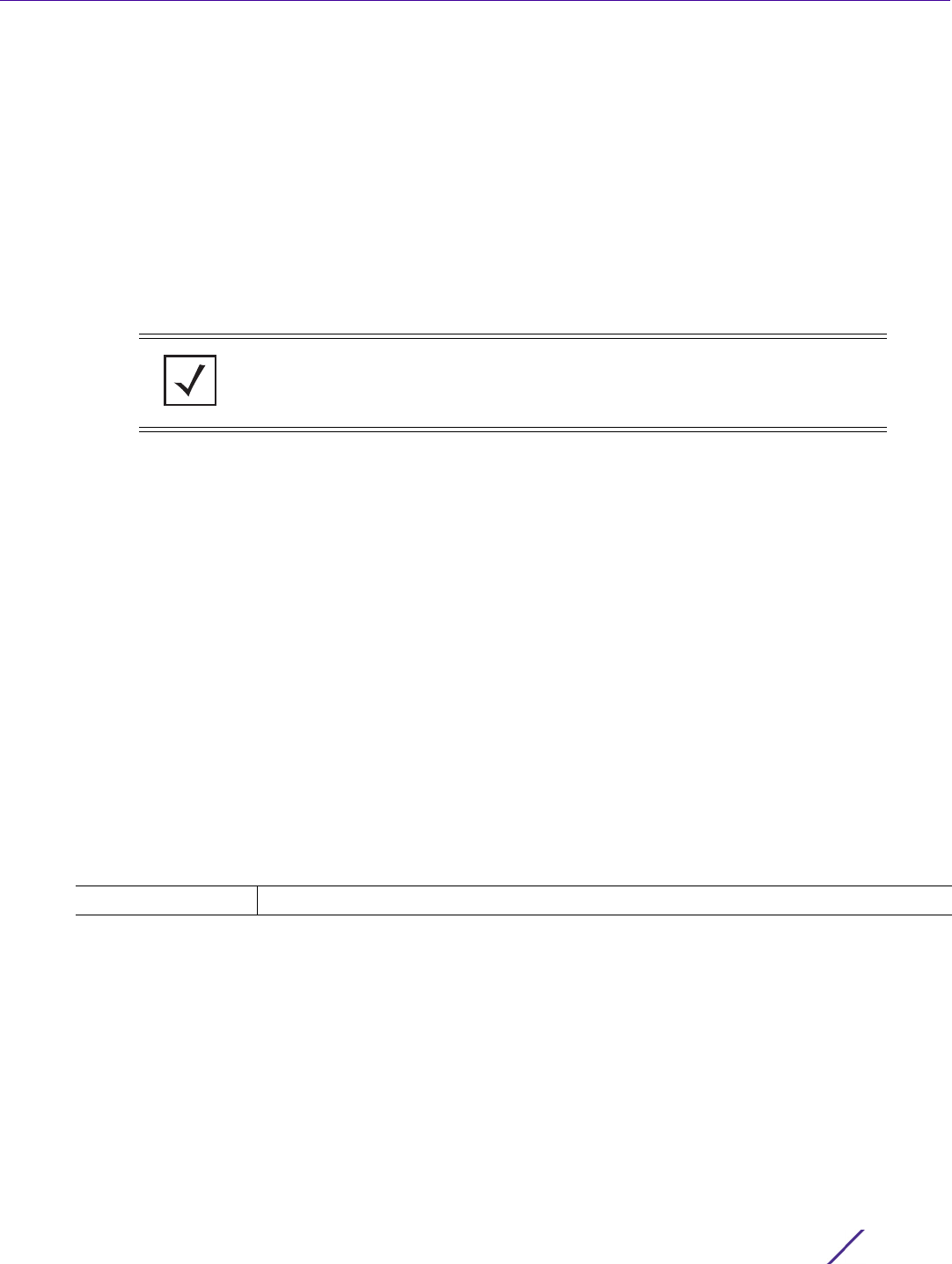
GLOBAL CONFIGURATION COMMANDS
Access Point, Wireless Controller and Service Platform CLI Reference Guide 4 - 521
4.1.97.2.42 t5-client-isolation
wlan-mode commands
Disallows clients connecting to the WLAN to communicate with one another. This setting applies
exclusively to CPE devices managed by aT5 controller and is disabled by default.
A T5 controller uses the IPX operating system to manage its connected radio devices, as opposed to the
WiNG operating system used by RFS wireless controllers and NX service platforms. However, a T5
controller, once enabled as a supported external device, can provide data to WiNG to assist in a T5’s
management within a WiNG supported subnet populated by both types of devices. The CPEs are the T5
controller managed radio devices using the IPX operating system. These CPEs use a DSL as their high
speed Internet access mechanism using the CPE’s physical wallplate connection and phone jack.
Supported in the following platforms:
• Service Platforms — NX5500, NX7500, NX7510, NX7520, NX7530, NX9500, NX9510, NX9600,
VX9000
Syntax
t5-client-isolation
Parameters
None
Example
nx9500-6C8809(config-wlan-test)#t5-client-isolation
nx9500-6C8809(config-wlan-test)#show context
wlan test
ssid test
bridging-mode local
encryption-type none
authentication-type none
t5-client-isolation
nx9500-6C8809(config-wlan-test)#
Related Commands
NOTE: This setting is applicable only when this WLAN supports T5
controllers and their connected CPEs.
no Allows clients connecting to the WLAN to communicate with one another
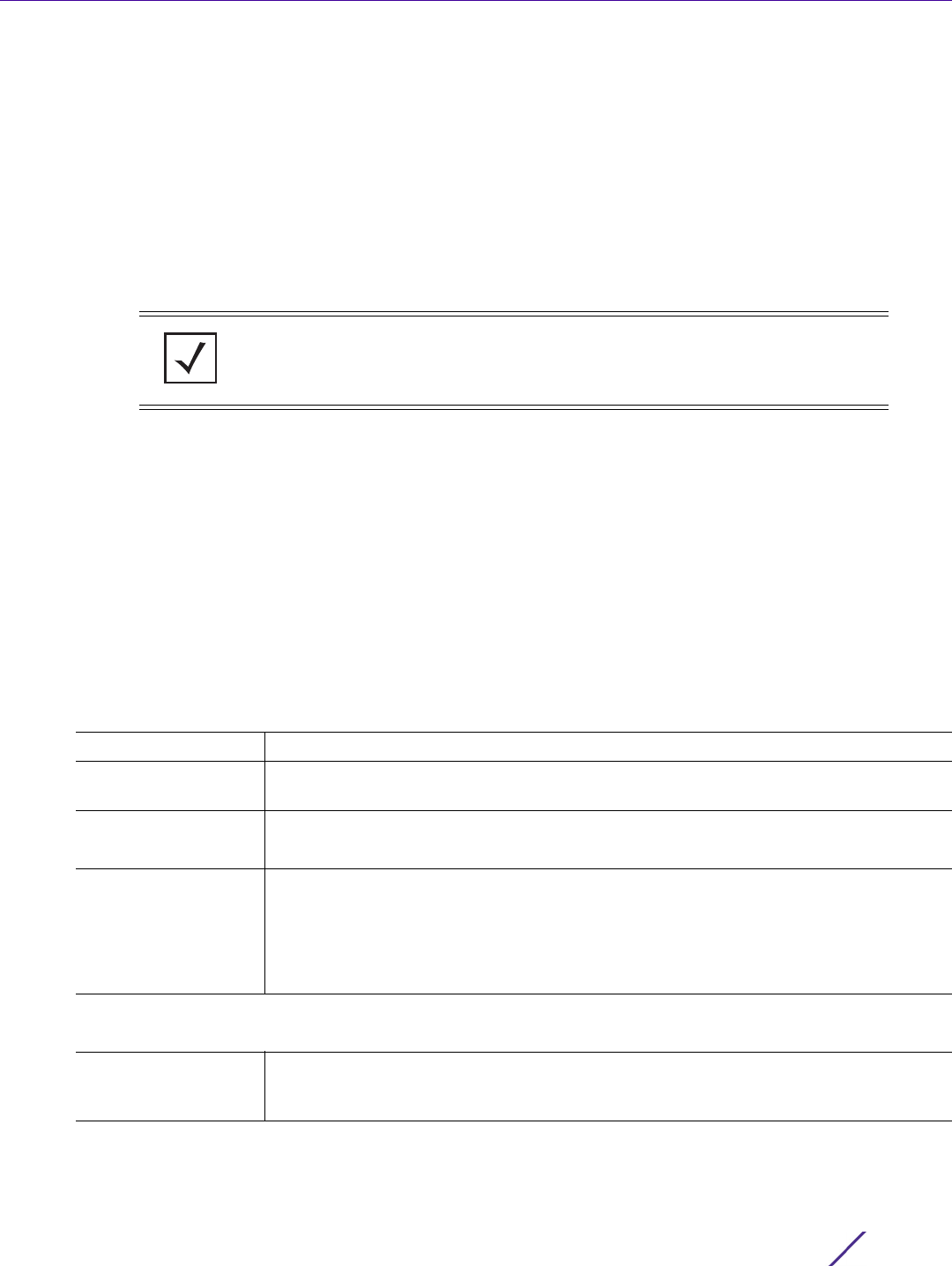
GLOBAL CONFIGURATION COMMANDS
Access Point, Wireless Controller and Service Platform CLI Reference Guide 4 - 522
4.1.97.2.43 t5-security
wlan-mode commands
Configures T5 PowerBroadband security settings
A T5 controller uses the IPX operating system to manage its connected radio devices, as opposed to the
WiNG operating system used by RFS controllers and NX service platforms. However, a T5 controller, once
enabled as a supported external device, can provide data to WiNG to assist in a T5’s management within a
WiNG supported subnet populated by both types of devices. The CPEs are the T5 controller managed
radio devices using the IPX operating system. These CPEs use DSL as their high speed Internet access
mechanism using the CPE’s physical wallplate connection and phone jack.
Supported in the following platforms:
• Service Platforms — NX5500, NX7500, NX7510, NX7520, NX7530, NX9500, NX9510, NX9600,
VX9000
Syntax
t5-security [static-wep|wpa-enterprise|wpa-personal]
t5-security static-wep encryption-type [wep128|wep64] [hex <STRING>|passphrase
<STRING>]
t5-security [wpa-enterprise|wpa-personal] encryption-type [ccmp|tkip|tkip-ccmp]
version [mixed|wpa|wpa2]
Parameters
• t5-security static-wep encryption-type [wep128|wep64] [hex <STRING>|passphrase
<STRING>]
• t5-security [wpa-enterprise|wpa-personal] encryption-type [ccmp|tkip|tkip-ccmp]
version [mixed|wpa|wpa2]
NOTE: This setting is applicable only when this WLAN supports T5
controllers and their connected CPEs.
t5-security static-wep Configures the T5 WLAN security type as static-wep
encryption-type
[wep128|wep64]
Applies one of the following encryption algorithms to the T5 support WLAN
configuration: WEP64 or WEP128
hex <STRING> Configures the hex password (used to derive the security key)
• <STRING> – Specify the hex password (should not exceed the 10 - 26 characters).
passphrase <STRING> Configures the passphrase shared by both transmitting and receiving authenticators
• <STRING> – Specify the passphrase. It could either be an alphanumeric string of 8 to
63 ASCII characters or 64 HEX characters. The alphanumeric string allows character
spaces. This string is converted to a numeric value. Configuring a passphrase saves
you the need to create a 256-bit key each time keys are generated.
t5-security
[wpa-enterprise|
wpa-personal]
Configures the T5 WLAN security type as: wpa-enterprise OR wpa-personal

GLOBAL CONFIGURATION COMMANDS
Access Point, Wireless Controller and Service Platform CLI Reference Guide 4 - 523
Example
nx9500-6C8809(config-wlan-test)#t5-security wpa-enterprise encryption-type ccmp
version wpa
nx9500-6C8809(config-wlan-test)#show context
wlan test
ssid test
bridging-mode local
encryption-type none
authentication-type none
t5-security wpa-enterprise encryption-type ccmp version wpa
t5-client-isolation
nx9500-6C8809(config-wlan-test)#
Related Commands
encryption-type
[ccmp|tkip|tkip-ccmp]
The following parameters are common to the wpa-enterprise and wpa-personal
keywords:
Applies one of the following encryption algorithms to the T5 support WLAN
configuration: CCMP, TKIP, or TKIP-CCMP
version
[mixed|wpa|wpa2]
The following parameters are common to the wpa-enterprise and wpa-personal
keywords:
• version – Applies one of the following encryption schemes to the T5 support WLAN
configuration: WPA, WPA2, or mixed
no Removes the configured T5 PowerBroadband security settings

GLOBAL CONFIGURATION COMMANDS
Access Point, Wireless Controller and Service Platform CLI Reference Guide 4 - 524
4.1.97.2.44 time-based-access
wlan-mode commands
Configures time-based client access to the network resources
Administrators can use this feature to assign fixed days and time of WLAN access for wireless clients
Supported in the following platforms:
• Access Points — AP6521, AP6522, AP6532, AP6562, AP7161, AP7502, AP7522, AP7532, AP7562,
AP7602, AP7612, AP7622, AP7632, AP7662, AP81XX, AP82XX, AP8432, AP8533
• Wireless Controllers — RFS4000, RFS6000
• Service Platforms — NX5500, NX7500, NX7510, NX7520, NX7530, NX9500, NX9510, NX9600,
VX9000
Syntax
time-based-access days [sunday|monday|tuesday|wednesday|thursday|friday|
saturday|all|weekends|weekdays] {start <START-TIME>} [end <END-TIME>]
Parameters
• time-based-access days [sunday|monday|tuesday|wednesday|thursday|friday|
saturday|all|weekends|weekdays] {start <START-TIME>} [end <END-TIME>]
Example
rfs6000-81742D(config-wlan-test)#time-based-access days weekdays start 10:00 end
16:30
rfs6000-81742D(config-wlan-test)#show context
wlan test
ssid testWLAN1
bridging-mode local
encryption-type none
authentication-type none
protected-mgmt-frames mandatory
radius vlan-assignment
time-based-access days weekdays start 10:00 end 16:30
--More--
rfs6000-81742D(config-wlan-test)#
Related Commands
day <option> Specifies the day or days on which the client can access the WLAN
• sunday – Allows access on Sundays only
• monday – Allows access on Mondays only
• tuesday – Allows access on Tuesdays only
• wednesday – Allows access on Wednesdays only
• thursday – Allows access on Thursdays only
• friday – Allows access on Fridays only
• saturday – Allows access on Saturdays only
• weekends – Allows access on weekends only
• weekdays – Allows access on weekdays only
• all – Allows access on all days
start <START-TIME> Optional. Specifies the access start time in hours and minutes (HH:MM)
end <END-TIME> Specifies the access end time in hours and minutes (HH:MM)
no Removes the configured time-based-access settings

GLOBAL CONFIGURATION COMMANDS
Access Point, Wireless Controller and Service Platform CLI Reference Guide 4 - 525
4.1.97.2.45 use
wlan-mode commands
This command associates an existing captive portal with a WLAN.
Supported in the following platforms:
• Access Points — AP6521, AP6522, AP6532, AP6562, AP7161, AP7502, AP7522, AP7532, AP7562,
AP7602, AP7612, AP7622, AP7632, AP7662, AP81XX, AP82XX, AP8432, AP8533
• Wireless Controllers — RFS4000, RFS6000
• Service Platforms — NX5500, NX7500, NX7510, NX7520, NX7530, NX9500, NX9510, NX9600,
VX9000
Syntax
use [aaa-policy|application-policy|association-acl-policy|bonjour-gw-discovery-
policy|captive-portal|ip-access-list|ipv6-access-list|mac-access-list|passpoint-
policy|roaming-assist-policy|url-filter|wlan-qos-policy]
use [aaa-policy <AAA-POLICY-NAME>|application-policy <POLICY-NAME>|association-
acl-policy <ASSOCIATION-POLICY-NAME>|bonjour-gw-discovery-policy <POLICY-
NAME>|captive-portal <CAPTIVE-PORTAL-NAME>|passpoint-policy <PASSPOINT-POLICY-
NAME>|roaming-assist-policy <POLICY-NAME>|url-filter <URL-FILTER-NAME>|wlan-qos-
policy <WLAN-QOS-POLICY-NAME>]
use ip-access-list [in|out] <IP-ACCESS-LIST-NAME>
use ipv6-access-list [in|out] <IPv6-ACCESS-LIST-NAME>
use mac-access-list [in|out] <MAC-ACCESS-LIST-NAME>
Parameters
• use [aaa-policy <AAA-POLICY-NAME>|application-policy <POLICY-NAME>|
association-acl-policy <ASSOCIATION-POLICY-NAME>|bonjour-gw-discovery-policy
<POLICY-NAME>|captive-portal <CAPTIVE-PORTAL-NAME>|passpoint-policy <PASSPOINT-
POLICY-NAME>|roaming-assist-policy <POLICY-NAME>|url-filter <URL-FILTER-NAME>|
wlan-qos-policy <WLAN-QoS-POLICY-NAME>]
aaa-policy
<AAA-POLICY-NAME>
Uses an existing AAA policy with a WLAN
• <AAA-POLICY-NAME> – Specify the AAA policy name.
application-policy
<POLICY-NAME>
Uses an existing application policy with a WLAN. An application policy defines
actions to perform on a packet when it matches a specified set of pre-defined
applications or application categories. For more information, see application-policy.
• <POLICY-NAME> – Specify the policy name.
association-acl
<ASSOCIATION-
POLICY-NAME>
Uses an existing association ACL policy with a WLAN
• <ASSOCIATION-POLICY-NAME> – Specify the association ACL policy name.
bonjour-gw-
discovery-policy
<POLICY-NAME>
Uses an existing Bonjour GW Discovery policy with a WLAN. When associated, the
Bonjour GW Discovery policy defines a list of services clients can discover across
subnets.
Contd..

GLOBAL CONFIGURATION COMMANDS
Access Point, Wireless Controller and Service Platform CLI Reference Guide 4 - 526
• use ip-access-list [in|out] <IP-ACCESS-LIST-NAME>
• use ipv6-access-list [in|out] <IPv6-ACCESS-LIST-NAME>
Bonjour enables discovery of services on a LAN. Bonjour allows the setting up a
network (without any configuration) in which services such as printers, scanners and
file-sharing servers can be found using Bonjour. Bonjour only works within a single
broadcast domain. However, with a special DNS configuration, it can be extended to
find services across broadcast domains.
• <POLICY-NAME> – Specify the Bonjour GW Discovery policy name (should be
existing and configured).
For more information on Bonjour GW Discovery policy, see bonjour-gw-discovery-
policy.
captive-portal
<CAPTIVE-PORTAL-
NAME>
Specifies the captive-portal policy to use if enforcing captive-portal authentication on
this WLAN
• <CAPTIVE-PORTAL-NAME> – Specify the captive-portal policy name. Should be
existing and configured.
passpoint-policy
<PASSPOINT-POLICY-
NAME>
Associates a passpoint policy (Hotspot2 configuration) with this WLAN
• <PASSPOINT-POLICY-NAME> – Specify the Hotspot 2.0 policy name.
For more information on passpoint policy, see passpoint-policy.
Map a passpoint policy to a WLAN. Since the configuration gets applied to the radio
by BSS, only the Hotspot 2.0 configuration of primary WLANs on a BSSID is used.
Incoming Hotspot 2.0 GAQ/ANQP requests from clients are identified by their
destination MAC addresses and are handled by the passpoint policy from the primary
WLAN on that BSS.
Define one passpoint policy for every WLAN configured.
roaming-assist-policy
<POLICY-NAME>
Associates an existing roaming assist policy with this WLAN
• <POLICY-NAME> – Specify the Roaming Assist policy name.
For more information on roaming assist policy, see roaming-assist-policy.
url-filter
<URL-FILTER-NAME>
Associates an existing URL list with this WLAN
• <URL-FILTER-NAME> – Specify the URL filter name.
For more information on configuring a URL list, see url-list.
wlan-qos-policy
<WLAN-QOS-POLICY-
NAME>
Uses an existing WLAN QoS policy with a WLAN
• <wlan-qos-policy-name> – Specify the WLAN QoS policy name.
ip-access-list [in|out]
<IP-ACCESS-LIST-
NAME>
Specifies the IP access list for incoming and outgoing packets
• in – Applies the IP ACL to incoming packets
• out – Applies IP ACL to outgoing packets
• <IP-ACCESS-LIST-NAME> – Specify the IP access list name.
ipv6-access-list
[in|out] <IPv6-
ACCESS-LIST-NAME>
Specifies the IPv6 access list for incoming and outgoing packets
• in – Applies the IPv6 ACL to incoming packets
• out – Applies IPv6 ACL to outgoing packets
• <IPv6-ACCESS-LIST-NAME> – Specify the IPv6 access list name.

GLOBAL CONFIGURATION COMMANDS
Access Point, Wireless Controller and Service Platform CLI Reference Guide 4 - 527
• use mac-access-list [in|out] <MAC-ACCESS-LIST-NAME>
Usage Guidelines
IP and MAC ACLs act as firewalls within a WLAN. WLANs use ACLs as firewalls to filter or mark packets
based on the WLAN from which they arrive, as opposed to filtering packets on layer 2 ports. An ACL
contains an ordered list of Access Control Entries (ACEs). Each ACE specifies a set of conditions (rules) and
the action taken in case of a match. The action can be permit, deny, or mark. Therefore, when a packet
matches an ACE’s conditions, it is either forwarded, dropped, or marked depending on the action specified
in the ACE. The order of conditions in the list is critical since filtering is stopped after the first match.
IP ACLs contain deny and permit rules specifying source and destination IP addresses. Each rule has a
precedence order assigned. Both IP and non-IP traffic on the same layer 2 interface can be filtered by
applying both an IP ACL and a MAC.
Additionally, you can filter layer 2 traffic on a physical layer 2 interface using MAC addresses. A MAC
firewall rule uses source and destination MAC addresses for matching operations, where the result is a
typical allow, deny, or mark designation to WLAN packet traffic.
Keep in mind IP and non-IP traffic on the same layer 2 interface can be filtered by applying both an IP ACL
and a MAC ACL to the interface.
Example
rfs6000-81742D(config-wlan-test)#use aaa-policy test
rfs6000-81742D(config-wlan-test)#use association-acl-policy test
rfs6000-81742D(config-wlan-test)#show context
wlan test
ssid testWLAN1
bridging-mode local
encryption-type none
authentication-type none
protected-mgmt-frames mandatory
radius vlan-assignment
time-based-access days weekdays start 10:00 end 16:30
wing-extensions wmm-load-information
client-load-balancing probe-req-intvl 5ghz 5
client-load-balancing band-discovery-intvl 2
use aaa-policy test
use association-acl-policy test
acl exceed-rate wireless-client-denied-traffic 20 disassociate
proxy-arp-mode strict
broadcast-dhcp validate-offer
shutdown on-unadoption
http-analyze controller
rfs6000-81742D(config-wlan-test)#
mac-access-list
[in|out] <MAC-
ACCESS-LIST-NAME>
Specifies the MAC access list for incoming and outgoing packets.
• in – Applies the MAC ACL to incoming packets
• out – Applies MAC ACL to outgoing packets
• <MAC-ACCESS-LIST-NAME> – Specify the MAC access list name.

GLOBAL CONFIGURATION COMMANDS
Access Point, Wireless Controller and Service Platform CLI Reference Guide 4 - 528
rfs6000-81742D(config-wlan-ipad_clients)#use bonjour-gw-discovery-policy generic
rfs6000-81742D(config-wlan-ipad_clients)#show context
wlan ipad_clients
ssid ipad_clients
vlan 41
bridging-mode local
encryption-type none
authentication-type none
use bonjour-gw-discovery-policy generic
rfs6000-81742D(config-wlan-ipad_clients)#
Related Commands
no Removes the following policies associated with a WLAN: aaa-policy, application-policy,
association-acl-policy, bonjour-gw-discovery-policy, captive-portal, ip-access-list,
ipv6-access-list, mac-access-list, passpoint-policy, roaming-assist-policy, url-filter, or
wlan-qos-policy.

GLOBAL CONFIGURATION COMMANDS
Access Point, Wireless Controller and Service Platform CLI Reference Guide 4 - 529
4.1.97.2.46 vlan
wlan-mode commands
Sets the VLAN where traffic from a WLAN is mapped
Supported in the following platforms:
• Access Points — AP6521, AP6522, AP6532, AP6562, AP7161, AP7502, AP7522, AP7532, AP7562,
AP7602, AP7612, AP7622, AP7632, AP7662, AP81XX, AP82XX, AP8432, AP8533
• Wireless Controllers — RFS4000, RFS6000
• Service Platforms — NX5500, NX7500, NX7510, NX7520, NX7530, NX9500, NX9510, NX9600,
VX9000
Syntax
vlan [<1-4094>|<VLAN-ALIAS-NAME>]
Parameters
• vlan [<1-4094>|<VLAN-ALIAS-NAME>]
Example
rfs6000-81742D(config-wlan-test)#vlan 4
rfs6000-81742D(config-wlan-test)#show context
wlan test
ssid testWLAN1
vlan 4
bridging-mode local
encryption-type none
authentication-type none
protected-mgmt-frames mandatory
radius vlan-assignment
time-based-access days weekdays start 10:00 end 16:30
wing-extensions wmm-load-information
client-load-balancing probe-req-intvl 5ghz 5
client-load-balancing band-discovery-intvl 2
use aaa-policy test
use association-acl-policy test
acl exceed-rate wireless-client-denied-traffic 20 disassociate
proxy-arp-mode strict
broadcast-dhcp validate-offer
shutdown on-unadoption
http-analyze controller
rfs6000-81742D(config-wlan-test)#
Related Commands
<1-4094> Sets a WLAN’s VLAN ID. This command starts a new VLAN assignment for a WLAN
index. All prior VLAN settings are erased.
Use this command to assign just one VLAN to the WLAN. Utilizing a single VLAN per
WLAN is a more typical deployment scenario than using a VLAN pool.
<VLAN-ALIAS-NAME> Assigns a VLAN alias to the WLAN. The VLAN alias should to existing and
configured.
A VLAN alias maps a name to a VLAN ID. When applied to ports (for example GE
ports) using the trunk mode, a VLAN alias denies or permits traffic, on the port, to
and from the VLANs specified in the alias. For more information on aliases, see alias.
no Removes a WLAN’s default VLAN mapping

GLOBAL CONFIGURATION COMMANDS
Access Point, Wireless Controller and Service Platform CLI Reference Guide 4 - 530
4.1.97.2.47 vlan-pool-member
wlan-mode commands
Adds a member VLAN to a WLAN’s VLAN pool. Use this option to define the VLANs available to this
WLAN. Additionally, define the number of wireless clients supported by each VLAN.
Supported in the following platforms:
• Access Points — AP6521, AP6522, AP6532, AP6562, AP7161, AP7502, AP7522, AP7532, AP7562,
AP7602, AP7612, AP7622, AP7632, AP7662, AP81XX, AP82XX, AP8432, AP8533
• Wireless Controllers — RFS4000, RFS6000
• Service Platforms — NX5500, NX7500, NX7510, NX7520, NX7530, NX9500, NX9510, NX9600,
VX9000
Syntax
vlan-pool-member <WORD> {limit <0-8192>}
Parameters
• vlan-pool-member <WORD> {limit <0-8192>}
Example
rfs6000-81742D(config-wlan-test)#vlan-pool-member 1-10 limit 1
rfs6000-81742D(config-wlan-test)#show context
wlan test
ssid testWLAN1
vlan-pool-member 1 limit 1
vlan-pool-member 2 limit 1
vlan-pool-member 3 limit 1
vlan-pool-member 4 limit 1
vlan-pool-member 5 limit 1
vlan-pool-member 6 limit 1
vlan-pool-member 7 limit 1
vlan-pool-member 8 limit 1
vlan-pool-member 9 limit 1
vlan-pool-member 10 limit 1
bridging-mode local
encryption-type none
authentication-type none
protected-mgmt-frames mandatory
radius vlan-assignment
time-based-access days weekdays start 10:00 end 16:30
--More--
rfs6000-81742D(config-wlan-test)#
NOTE: Configuration of a VLAN pool overrides the 'vlan' configuration.
vlan-pool-member Adds a member VLAN to a WLAN’s VLAN pool
Since users belonging to separate VLANs can share the same WLAN, it is not
necessary to create a new WLAN for every VLAN in the network.
<WORD> Define the VLANs available to this WLAN. It is either a single index, or a list of VLAN
IDs (for example, 1,3,7), or a range (for example, 1-10)
limit <0-8192> Optional. Is ignored if the number of clients are limited and well within the limits of
the DHCP pool on the VLAN
• <0-8192> – Specifies the number of users allowed

GLOBAL CONFIGURATION COMMANDS
Access Point, Wireless Controller and Service Platform CLI Reference Guide 4 - 531
Related Commands
no Removes the list of VLANs mapped to a WLAN

GLOBAL CONFIGURATION COMMANDS
Access Point, Wireless Controller and Service Platform CLI Reference Guide 4 - 532
4.1.97.2.48 wep128
wlan-mode commands
Configures WEP128 parameters
Supported in the following platforms:
• Access Points — AP6521, AP6522, AP6532, AP6562, AP7161, AP7502, AP7522, AP7532, AP7562,
AP7602, AP7612, AP7622, AP7632, AP7662, AP81XX, AP82XX, AP8432, AP8533
• Wireless Controllers — RFS4000, RFS6000
• Service Platforms — NX5500, NX7500, NX7510, NX7520, NX7530, NX9500, NX9510, NX9600,
VX9000
Syntax
wep128 [key|keys-from-passkey|transmit-key]
wep128 key <1-4> [ascii|hex] [0 <WORD>|2 <WORD>|<WORD>]
wep128 keys-from-passkey <WORD>
wep128 transmit-key <1-4>
Parameters
• wep128 key <1-4> [ascii|hex] [0 <WORD>|2 <WORD>|<WORD>]
• wep128 keys-from-passkey <WORD>
• wep128 transmit-key <1-4>
wep128 Configures WEP128 parameters. The parameters are: key, key-from-passkey, and
transmit-key.
key <1-4> Configures pre-shared hex keys
• <1-4> – Configures a maximum of four key indexes. Select the key index from 1 - 4.
ascii
[0 <WORD>|
2 <WORD>||
<WORD>]
Sets keys as ASCII characters (5 characters for WEP64, 13 for WEP128)
• 0 <WORD> – Configures a clear text key
• 2 <WORD> – Configures an encrypted key
• <WORD> – Configures keys as 13 ASCII characters converted to hex, or 26
hexadecimal characters
hex
[0 <WORD>|
2 <WORD>|
<WORD>]
Sets keys as hexadecimal characters (10 characters for WEP64, 26 for WEP128)
• 0 <WORD> – Configures a clear text key
• 2 <WORD> – Configures an encrypted key
• <WORD> – Configures keys as 13 ASCII characters converted to hex, or 26
hexadecimal characters
keys-from-passkey
<WORD>
Specifies a passphrase from which keys are derived
• <WORD> – Specify a passphrase from 4 - 32 characters.
transmit-key <1-4> Configures the key index used for transmission from an AP to a wireless client or
service platform
• <1-4> – Specify a key index from 1 - 4.

GLOBAL CONFIGURATION COMMANDS
Access Point, Wireless Controller and Service Platform CLI Reference Guide 4 - 533
Example
rfs6000-81742D(config-wlan-test)#wep128 keys-from-passkey example@123
rfs6000-81742D(config-wlan-test)#show context
wlan test
ssid testWLAN1
vlan-pool-member 1 limit 1
vlan-pool-member 2 limit 1
vlan-pool-member 3 limit 1
vlan-pool-member 4 limit 1
vlan-pool-member 5 limit 1
vlan-pool-member 6 limit 1
vlan-pool-member 7 limit 1
vlan-pool-member 8 limit 1
vlan-pool-member 9 limit 1
vlan-pool-member 10 limit 1
bridging-mode local
encryption-type none
authentication-type none
protected-mgmt-frames mandatory
wep128 key 1 hex 0 25f6e7ed9718918a87a75acc75
wep128 key 2 hex 0 2b3fb36924b22dffe98c86c315
wep128 key 3 hex 0 1ebf3394431700194762ebd5b2
wep128 key 4 hex 0 e3de75be311bd787aeac5e4e8b
radius vlan-assignment
time-based-access days weekdays start 10:00 end 16:30
--More--
rfs6000-81742D(config-wlan-test)#
Related Commands
no Resets the WEP128 PSK and transmission keys to factory-default values.

GLOBAL CONFIGURATION COMMANDS
Access Point, Wireless Controller and Service Platform CLI Reference Guide 4 - 534
4.1.97.2.49 wep64
wlan-mode commands
Configures WEP64 parameters
Supported in the following platforms:
• Access Points — AP6521, AP6522, AP6532, AP6562, AP7161, AP7502, AP7522, AP7532, AP7562,
AP7602, AP7612, AP7622, AP7632, AP7662, AP81XX, AP82XX, AP8432, AP8533
• Wireless Controllers — RFS4000, RFS6000
• Service Platforms — NX5500, NX7500, NX7510, NX7520, NX7530, NX9500, NX9510, NX9600,
VX9000
Syntax
wep64 [key|keys-from-passkey|transmit-key]
wep64 key <1-4> [ascii|hex] [0 <WORD>|2 <WORD>|<WORD>]
wep64 keys-from-passkey <WORD>
wep64 transmit-key <1-4>
Parameters
• wep64 key <1-4> [ascii|hex] [0 <WORD>|2 <WORD>|<WORD>]
• wep64 keys-from-passkey <WORD>
• wep64 transmit-key <1-4>
wep64 Configures WEP64 parameters
The parameters are: key, key-from-passkey, and transmit-key.
key <1-4> Configures pre-shared hex keys
• <1-4> – Configures a maximum of four key indexes. Select a key index from 1 - 4.
ascii
[0 <WORD>|
2 <WORD>|
<WORD>]
Sets keys as ASCII characters (5 characters for WEP64, 13 for WEP128)
• 0 <WORD> – Configures a clear text key
• 2 <WORD> – Configures an encrypted key
• <WORD> – Configures key (10 hex or 5 ASCII characters for WEP64, 26 hex or 13 ASCII
characters for WEP128).
hex
[0 <WORD>|
2 <WORD>|
<WORD>]
Sets keys as hexadecimal characters (10 characters for WEP64, 26 for WEP128)
• 0 <WORD> – Configures a clear text key
• 2 <WORD> – Configures an encrypted key
• <WORD> – Configures the key (10 hex or 5 ASCII characters for WEP64, 26 hex or 13
ASCII characters for WEP128)
keys-from-passkey
<WORD>
Specifies a passphrase from which keys are derived
• <WORD> – Specify a passphrase from 4 - 32 characters.
transmit-key <1-4> Configures the key index used for transmission from an AP to a wireless client or
service platform
• <1-4> – Specify a key index from 1 - 4.

GLOBAL CONFIGURATION COMMANDS
Access Point, Wireless Controller and Service Platform CLI Reference Guide 4 - 535
Example
rfs6000-81742D(config-wlan-test)#wep64 key 1 ascii test1
rfs6000-81742D(config-wlan-test)#wep64 transmit-key 1
rfs6000-81742D(config-wlan-test)#show context
wlan test
ssid testWLAN1
vlan-pool-member 1 limit 1
vlan-pool-member 2 limit 1
vlan-pool-member 3 limit 1
vlan-pool-member 4 limit 1
vlan-pool-member 5 limit 1
vlan-pool-member 6 limit 1
vlan-pool-member 7 limit 1
vlan-pool-member 8 limit 1
vlan-pool-member 9 limit 1
vlan-pool-member 10 limit 1
bridging-mode local
encryption-type none
authentication-type none
protected-mgmt-frames mandatory
wep64 key 1 hex 0 7465737431
radius vlan-assignment
time-based-access days weekdays start 10:00 end 16:30
wing-extensions wmm-load-information
client-load-balancing probe-req-intvl 5ghz 5
client-load-balancing band-discovery-intvl 2
use aaa-policy test
--More--
rfs6000-81742D(config-wlan-test)#
Related Commands
no Resets the WEP64 PSK and transmission keys to factory-default values

GLOBAL CONFIGURATION COMMANDS
Access Point, Wireless Controller and Service Platform CLI Reference Guide 4 - 536
4.1.97.2.50 wing-extensions
wlan-mode commands
Enables support for WiNG-specific client extensions to the IEEE 802.11x WLAN standards that potentially
increase client roaming reliability and handshake speed
Supported in the following platforms:
• Access Points — AP6521, AP6522, AP6532, AP6562, AP7161, AP7502, AP7522, AP7532, AP7562,
AP7602, AP7612, AP7622, AP7632, AP7662, AP81XX, AP82XX, AP8432, AP8533
• Wireless Controllers — RFS4000, RFS6000
• Service Platforms — NX5500, NX7500, NX7510, NX7520, NX7530, NX9500, NX9510, NX9600,
VX9000
Syntax
wing-extensions [ap-attributes-information {include-hostname}|
coverage-hole-detection {11k-clients|offset <5-20>|threshold <-80--60}|
ft-over-ds-aggregate|move-command|scan-assist {channel-info-interval <6-9>}|
smart-scan|wing-load-information|wmm-load-information]
Parameters
• wing-extensions [ap-attributes-information {include-hostname}|
coverage-hole-detection {11k-clients|offset <5-20>|offset <5-20>|threshold <-80--
60}|ft-over-ds-aggregate|move-command|scan-assist {channel-info-interval <6-9>}|
smart-scan|wing-load-information|wmm-load-information]
wing-extensions Enables support for inclusion of WiNG-specific client extensions in radio
transmissions
ap-attributes-
information
{include-hostname}
Enables support for AP attributes information element (IE)
• include-hostname – Optional. When enabled, includes AP’s hostname, as a sub-
element, in the AP attributes IE.
The AP attributes IE is vendor-specific and, when enabled, is added to beacons and
probe responses. Inclusion of AP attributes IE allows Extreme Networks terminals to:
- Recognize Extreme APs
- Determine if the AP supports PAN BU features, irrespective of whether these
features are enabled or not.
AP attributes IE is not added to beacons and probe responses by default.
overage-hole-
detection
{11k-clients|
offset <5-20>|
threshold <-80--60>}
Enables coverage hole detection (CHD) and configures CHD parameters. When
enabled, allows clients (MUs) to inform an access point when it experiences a
coverage hole. A coverage hole is an area of poor wireless coverage not supported
by a WiNG managed access point radio. Enable radio resource measurement prior to
enabling CHD. For enabling radio resource measurement, see radio-resource-
measurement. CHD is disabled by default.
After enabling CHD, optionally configure the following parameters:
• 11k-clients – Optional. Provides coverage hole detection to 802.11k-only-capable
clients. This is a reduced set of coverage hole detection capabilities (standard 11k
messages and behaviors). This option is disabled by default.
Contd..

GLOBAL CONFIGURATION COMMANDS
Access Point, Wireless Controller and Service Platform CLI Reference Guide 4 - 537
Example
rfs6000-81742D(config-wlan-test)#wing-extensions wmm-load-information
rfs6000-81742D(config-wlan-test)#show context
wlan test
description TestWLAN
ssid test
bridging-mode local
encryption-type tkip-ccmp
authentication-type eap
kerberos server timeout 12
kerberos server primary host 172.16.10.2
accounting syslog host 172.16.10.4 port 2
data-rates 2.4GHz gn
wing-extensions wmm-load-information
client-load-balancing probe-req-intvl 5ghz 5
--More--
rfs6000-81742D(config-wlan-test)#
• offset <5-20> – Optional. Configures the offset added to the threshold to obtain the
access point’s signal strength (as seen by the client) considered adequate.
• <5-20> – Specify the offset value from 5 - 20. The default is 5.
• threshold – Optional. Configures the access point’s signal strength threshold. When
Radio Resource Measurement and CVG Hole are enabled, specify a threshold for the
AP’s signal strength (as seen by the client) below which a coverage hole incident is
reported by the client.
• <-80--60> – Specify the threshold from -80 - -60 dBm. The default is -70 dBm.
ft-over-ds-aggregate Enables fast-transition (FT) aggregation of action frames. When enabled, increases
roaming speed by eliminating separate key exchange handshake frames with
potential roam candidates. Enable fast transition to complete an initial FT over
distribution system (DS) handshake with multiple roam candidates (up to 6) at once,
eliminating the need to send separate FT over DS handshakes to each roam
candidate.
This option is disabled by default.
move-command Enables use of Hyper Fast Secure Roaming (HFSR) for clients on this WLAN. This
feature applies only to certain client devices. This option is disabled by default.
scan-assist
{channel-info-interval
<6-9>}
Enables support for scanning assist. When enabled, allows faster roams on Dynamic
Frequency Selection (DFS) channels by eliminating passive scans. Clients get channel
information directly from possible roam candidates. This option is disabled by
default.
• channel-info-interval <6-9> – Optional. Configures the interval at which channel
information is periodically retrieved from potential roam candidates without
requesting scan assist.
• <6-9> – Specify the interval from 6 - 9 seconds. When enabled, the default value is
8 seconds.
smart-scan Enables a smart scan to refine a clients channel scans to just a few channels as
opposed to all available channels. This option is disabled by default.
wing-load-information Enables support for the WiNG load information element (Element ID 173) with legacy
Symbol Technology clients, thus making them optimally interoperable with the latest
Extreme Networks access points. This option is enabled by default.
wmm-load-
information
Enables support for WiNG Wi-Fi MultiMedia (WMM) Load Information Element in
radio transmissions with legacy clients. This option is disabled by default.

GLOBAL CONFIGURATION COMMANDS
Access Point, Wireless Controller and Service Platform CLI Reference Guide 4 - 538
Related Commands
no Disables support for WiNG-specific client extensions to the IEEE 802.11x WLAN
standards. Use the keywords provided to disable a specific wing-extension.

GLOBAL CONFIGURATION COMMANDS
Access Point, Wireless Controller and Service Platform CLI Reference Guide 4 - 539
4.1.97.2.51 wireless-client
wlan-mode commands
Configures the transmit power indicated to clients
Supported in the following platforms:
• Access Points — AP6521, AP6522, AP6532, AP6562, AP7161, AP7502, AP7522, AP7532, AP7562,
AP7602, AP7612, AP7622, AP7632, AP7662, AP81XX, AP82XX, AP8432, AP8533
• Wireless Controllers — RFS4000, RFS6000
• Service Platforms — NX5500, NX7500, NX7510, NX7520, NX7530, NX9500, NX9510, NX9600,
VX9000
Syntax
wireless-client [count-per-radio|cred-cache-ageout|hold-time|inactivity-timeout|
max-firewall-sessions|reauthentication|roam-notification|t5-inactivity-timeout|
tx-power|vlan-cache-ageout]
wireless-client [count-per-radio <0-256>|cred-cache-ageout <60-86400>|hold-time
<1-86400>|inactivity-timeout <60-86400>|max-firewall-sessions <10-10000>|
reauthentication <30-86400>|t5-inactivity-timeout <60-86400>|tx-power <0-20>|
vlan-cache-ageout <60-86400>]
wireless-client roam-notification [after-association|after-data-ready|auto]
Parameters
• wireless-client [count-per-radio <0-256>|cred-cache-ageout <60-86400>|hold-time
<1-86400>|inactivity-timeout <60-86400>|max-firewall-sessions <10-10000>|
reauthentication <30-86400>|t5-inactivity-timeout <60-86400>|tx-power <0-20>|
vlan-cache-out <60-86400>]
wireless-client Configures the transmit power indicated to wireless clients for transmission
count-per-radio
<0-256>
Configures the maximum number of clients allowed on this WLAN per radio
• <0-256> – Specify a value from 0 - 256.
cred-cache-ageout
<60-86400>
Configures the timeout period for which client credentials are cached across
associations
• <60-86400> – Specify a value from 60 - 86400 seconds.
hold-time <1-86400> Configures the time period for which wireless client state information is cached post
roaming
• <1-86400> – Specify a value from 1 - 86400 seconds.
inactivity-timeout
<60-86400>
Configures an inactivity timeout period in seconds. If a frame is not received from a
wireless client for this period of time, the client is disassociated.
• <60-86400> – Specify a value from 60 - 86400 seconds.
max-firewall-sessions
<10-10000>
Configures the maximum firewall sessions allowed per client on a WLAN
• <10-10000> – Specify the maximum number of firewall sessions allowed from
10 - 10000.
reauthentication
<30-86400>
Configures periodic reauthentication of associated clients
• <30-86400> – Specify the client reauthentication interval from 30 - 86400 seconds.
t5-inactivity-timeout
<60-86400>
Configures and inactivity timeout, in seconds, for T5 devices. When configured, the T5
device is disassociated if the time lapsed after the last frame received from it exceeds
the value specified here.
• <60-86400> – Specify a value from 60 - 86400 seconds. The default is 60 seconds.

GLOBAL CONFIGURATION COMMANDS
Access Point, Wireless Controller and Service Platform CLI Reference Guide 4 - 540
• wireless-client roam-notification [after-association|after-data-ready|auto]
Example
rfs6000-81742D(config-wlan-test)#wireless-client cred-cache-ageout 65
rfs6000-81742D(config-wlan-test)#wireless-client hold-time 200
rfs6000-81742D(config-wlan-test)#wireless-client max-firewall-sessions 100
rfs6000-81742D(config-wlan-test)#wireless-client reauthentication 35
rfs6000-81742D(config-wlan-test)#wireless-client tx-power 12
rfs6000-81742D(config-wlan-test)#show context
wlan test
ssid testWLAN1
vlan-pool-member 1 limit 1
vlan-pool-member 2 limit 1
vlan-pool-member 3 limit 1
vlan-pool-member 4 limit 1
vlan-pool-member 5 limit 1
vlan-pool-member 6 limit 1
vlan-pool-member 7 limit 1
vlan-pool-member 8 limit 1
vlan-pool-member 9 limit 1
vlan-pool-member 10 limit 1
bridging-mode local
encryption-type none
authentication-type none
wireless-client hold-time 200
wireless-client cred-cache-ageout 65
wireless-client max-firewall-sessions 100
protected-mgmt-frames mandatory
wireless-client reauthentication 35
wep64 key 1 hex 0 7465737431
wep128 key 1 hex 0 25f6e7ed9718918a87a75acc75
wep128 key 2 hex 0 2b3fb36924b22dffe98c86c315
wep128 key 3 hex 0 1ebf3394431700194762ebd5b2
wep128 key 4 hex 0 e3de75be311bd787aeac5e4e8b
radius vlan-assignment
time-based-access days weekdays start 10:00 end 16:30
wing-extensions wmm-load-information
wireless-client tx-power 12
client-load-balancing probe-req-intvl 5ghz 5
--More--
rfs6000-81742D(config-wlan-test)#
tx-power <0-20> Configures the transmit power indicated to clients
• <0-20> – Specify a value from 0 - 20 dBm.
vlan-cache-ageout
<60-86400>
Configures the timeout period for which client VLAN information is cached across
associations.
• <60-86400> – Specify a value from 60 - 86400 seconds.
wireless-client Configures the transmit power indicated to wireless clients for transmission
roam-notification Configures when a roam notification is transmitted
after-association Transmits a roam notification after a client has associated
after-data-ready Transmits a roam notification after a client is data-ready (after completion of
authentication, handshakes, etc.)
auto Transmits a roam notification upon client association (if the client is known to have
authenticated to the network)

GLOBAL CONFIGURATION COMMANDS
Access Point, Wireless Controller and Service Platform CLI Reference Guide 4 - 541
Related Commands
no Removes or reverts to default configured wireless client related parameters

GLOBAL CONFIGURATION COMMANDS
Access Point, Wireless Controller and Service Platform CLI Reference Guide 4 - 542
4.1.97.2.52 wpa-wpa2
wlan-mode commands
Modifies TKIP-CCMP (WPA/WPA2) related parameters
Supported in the following platforms:
• Access Points — AP6521, AP6522, AP6532, AP6562, AP7161, AP7502, AP7522, AP7532, AP7562,
AP7602, AP7612, AP7622, AP7632, AP7662, AP81XX, AP82XX, AP8432, AP8533
• Wireless Controllers — RFS4000, RFS6000
• Service Platforms — NX5500, NX7500, NX7510, NX7520, NX7530, NX9500, NX9510, NX9600,
VX9000
Syntax
wpa-wpa2 [exclude-wpa2-tkip|handshake|key-rotation|opp-pmk-caching|pmk-caching|
preauthentication|server-only-authentication|psk|tkip-countermeasures|
use-sha256-akm]
wpa-wpa2 [exclude-wpa2-tkip|opp-pmk-caching|pmk-caching|preauthentication|
server-only-authentication|use-sha256-akm]
wpa-wpa2 handshake [attempts|init-wait|priority|timeout]
wpa-wpa2 handshake [attempts <1-5>|init-wait <5-1000000>|priority [high|normal]|
timeout <10-5000> {10-5000}]
wpa-wpa2 key-rotation [broadcast|unicast] <30-86400>
wpa-wpa2 psk [0 <LINE>|2 <LINE>|<LINE>]
wpa-wpa2 tkip-countermeasures holdtime <0-65535>
Parameters
• wpa-wpa2 [exclude-wpa2-tkip|opp-pmk-caching|pmk-caching|preauthentication|
server-only-authentication|use-sha256-akm]
• wpa-wpa2 handshake [attempts <1-5>|init-wait <5-1000000>|priority
[high|normal]|timeout <10-5000> {10-5000}]
wpa-wpa2 Modifies TKIP-CCMP (WPA/WPA2) related parameters
exclude-wpa2-tkip Excludes the Wi-Fi Protected Access II (WPA2) version of TKIP. It supports the WPA
version of TKIP only. This option is disabled by default.
opp-pmk-caching Uses opportunistic key caching (same Pairwise Master Key (PMK) across APs for fast
roaming with EAP.802.1x. This option is enabled by default.
pmk-caching Uses cached pair-wise master keys (fast roaming with eap/802.1x). This option is
enabled by default.
preauthentication Uses pre-authentication mode (WPA2 fast roaming)
server-only-
authentication
Uses online sign up server-only-authenticated encryption network. This option is
disabled by default.
use-sha256-akm Uses sha256 authentication key management suite. This option is disabled by default.
wpa-wpa2 Modifies TKIP-CCMP (WPA/WPA2) related parameters
handshake Configures WPA/WPA2 handshake parameters
attempts <1-5> Configures the total number of times a message is transmitted towards a non-
responsive client
• <1-5> – Specify a value from 1 - 5. The default is 2.

GLOBAL CONFIGURATION COMMANDS
Access Point, Wireless Controller and Service Platform CLI Reference Guide 4 - 543
• wpa-wpa2 key-rotation [broadcast|unicast] <30-86400>
• wpa-wpa2 psk [0 <LINE>|2 <LINE>|<LINE>]
• wpa-wpa2 tkip-countermeasures holdtime <0-65535>
init-wait
<5-1000000>
Configures a minimum wait-time period, in microseconds, before the first handshake
message is transmitted from the AP. This option is disabled by default.
• <5-1000000> – Specify a value from 5 - 1000000 microseconds.
priority
[high|normal]
Configures the relative priority of handshake messages compared to other data traffic
• high – Treats handshake messages as high priority packets on a radio. This is the default
setting.
• normal – Treats handshake messages as normal priority packets on a radio
timeout <10-5000>
<10-5000>
Configures the timeout period, in milliseconds, for a handshake message to retire.
Once this period is exceed, the handshake message is retired.
• <10-5000> – Specify a value from 10 - 5000 milliseconds. The default is 500
milliseconds.
• <10-5000> – Optional. Configures a different timeout between the second and third
attempts
wpa-wpa2 Modifies TKIP-CCMP (WPA/WPA2) related parameters
key-rotation Configures parameters related to periodic rotation of encryption keys. The periodic key
rotation parameters are broadcast, multicast, and unicast traffic.
broadcast
<30-86400>
Configures the periodic rotation of keys used for broadcast and multicast traffic. This
parameter specifies the interval, in seconds, at which keys are rotated. This option is
disabled by default.
• <30-86400> – Specify a value from 30 - 86400 seconds.
unicast <30-86400> Configures a periodic interval for the rotation of keys, used for unicast traffic. This
option is disabled by default.
• <30-86400> – Specify a value from 30 - 86400 seconds.
wpa-wpa2 Modifies TKIP-CCMP (WPA/WPA2) related parameters
psk Configures a pre-shared key. The key options are: 0, 2, and LINE
0 <LINE> Configures a clear text key
2 <LINE> Configures an encrypted key
<LINE> Enter the pre-shared key either as a passphrase not exceeding 8 - 63 characters, or as
a 64 character (256bit) hexadecimal value
wpa-wpa2 Modifies TKIP-CCMP (WPA/WPA2) parameters
tkip-
countermeasures
Configures a hold time period for implementation of TKIP counter measures
holdtime <0-65535> Configures the amount of time a WLAN is disabled when TKIP counter measures are
invoked
• <0-65535> – Specify a value from 0 - 65535 seconds. The default is 60 seconds.

GLOBAL CONFIGURATION COMMANDS
Access Point, Wireless Controller and Service Platform CLI Reference Guide 4 - 544
Example
rfs6000-81742D(config-wlan-test)#wpa-wpa2 tkip-countermeasures hold-time 2
rfs6000-81742D(config-wlan-test)#show context
wlan test
ssid testWLAN1
vlan-pool-member 1 limit 1
vlan-pool-member 2 limit 1
vlan-pool-member 3 limit 1
vlan-pool-member 4 limit 1
vlan-pool-member 5 limit 1
vlan-pool-member 6 limit 1
vlan-pool-member 7 limit 1
vlan-pool-member 8 limit 1
vlan-pool-member 9 limit 1
vlan-pool-member 10 limit 1
bridging-mode local
encryption-type none
authentication-type none
wireless-client hold-time 200
wireless-client cred-cache-ageout 65
wireless-client max-firewall-sessions 100
protected-mgmt-frames mandatory
wireless-client reauthentication 35
wpa-wpa2 tkip-countermeasures hold-time 2
wep64 key 1 hex 0 7465737431
wep128 key 1 hex 0 25f6e7ed9718918a87a75acc75
--More--
rfs6000-81742D(config-wlan-test)#
Related Commands
no Removes or reverts to default TKIP-CCMP (WPA/WPA2) related parameters

GLOBAL CONFIGURATION COMMANDS
Access Point, Wireless Controller and Service Platform CLI Reference Guide 4 - 545
4.1.97.2.53 service
wlan-mode commands
Invokes service commands applicable in the WLAN configuration mode
Supported in the following platforms:
• Access Points — AP6521, AP6522, AP6532, AP6562, AP7161, AP7502, AP7522, AP7532, AP7562,
AP7602, AP7612, AP7622, AP7632, AP7662, AP81XX, AP82XX, AP8432, AP8533
• Wireless Controllers — RFS4000, RFS6000
• Service Platforms — NX5500, NX7500, NX7510, NX7520, NX7530, NX9500, NX9510, NX9600,
VX9000
Syntax
service [allow-ht-only|allow-open-passpoint|client-load-balancing|cred-cache|
eap-mac-mode|eap-mac-multicopy|eap-mac-multikeys|eap-throttle|
enforce-pmkid-validation|key-index|monitor|radio-crypto|reauthentication|
session-timeout|tx-deauth-on-roam-detection|unresponsive-client|wpa-wpa2|show]
service [allow-ht-only|allow-open-passpoint|cred-cache [clear-on-4way-timeout|
clear-on-disconnect]|eap-mac-multicopy|eap-mac-multikeys|enforce-pmkid-
validation|radio-crypto|reauthentication seamless|session-timeout mac|
tx-deauth-on-roam-detection|show cli]
service eap-mac-mode [mac-always|normal]
service eap-throttle <0-254>
service key-index eap-wep-unicast <1-4>
service monitor [aaa-server|adoption|captive-portal|dhcp|dns]
service monitor [aaa-server|adoption vlan <1-4094>|captive-portal external-server]
service monitor [dhcp|dns] crm <RESOURCE-NAME> vlan <1-4094>
service unresponsive-client [attempts <1-1000>|ps-detect {threshold <1-1000>}|
timeout <1-60>]
service wpa-wpa2 exclude-ccmp
Parameters
• service [allow-ht-only|allow-open-passpoint|cred-cache [clear-on-4way-timeout|
clear-on-disconnect]|eap-mac-multicopy|eap-mac-multikeys|enforce-pmkid-
validation|radio-crypto|reauthentication seamless|session-timeout mac|tx-deauth-
on-roam-detection|show cli]
allow-ht-only Only allows clients capable of High Throughput (802.11n) data rates to associate. This
option is disabled by default.
allow-open-passpoint Enables non-WPA2 security for passpoint WLANs. This option is disabled by default.
For more information on passpoint policy and configuration, see PASSPOINT
POLICY.
cred-cache
[clear-on-4way-
timeout|
clear-on-disconnect]
Clears credential cache based on the parameter passed
• clear-on-4way-timeout – Clears cached client credentials after the 4way handshake
with a client has timed out. This option is enabled by default.
• clear-on-disconnect – Clears cached client credentials after the client has
disconnected from the network. This option is disabled by default.
eap-mac-multicopy Enables sending of multiple copies of broadcast and unicast messages. This option is
disabled by default.

GLOBAL CONFIGURATION COMMANDS
Access Point, Wireless Controller and Service Platform CLI Reference Guide 4 - 546
• service eap-mac-mode [mac-always|normal]
• service eap-throttle <0-254>
• service key-index eap-wep-unicast <1-4>
• service wpa-wpa2 exclude-ccmp
eap-mac-multikeys Enables configuration of different key indices for MAC authentication. This option is
disabled by default.
enforce-pmkid-
validation
Validates the Predictive real-time pairwise master key identifier (PMKID) contained in
a client’s association request against the one present in the wpa-wpa2 handshake.
This option is enabled by default.
This functionality is based on the Proactive Key Caching (PKC) extension of the
802.11i EEEE standard. Whenever a wireless client successfully authenticates with a
AP it receives a pairwise master key (PMK). PKC allows clients to cache this PMK and
reuse it for future re-authentications with the same AP. The PMK is unique for every
client and is identified by the PMKID. The PMKID is a combination of the hash of the
PMK, a string, the station and the MAC addresses of the AP.
radio-crypto Uses radio hardware for encryption and decryption. This is applicable only for devices
using Counter Cipher Mode with Block Chaining Message Authentication Code
Protocol (CCMP) encryption mode. This option is enabled by default.
reauthentication
seamless
Enables seamless EAP client reauthentication without disconnecting client after the
session has timed out. This option is enabled by default.
session-timeout mac Enables reauthentication of MAC authenticated clients without disconnecting client
after the session has timed out. This option is enabled by default.
tx-deauth-on-roam-
detection
Transmits a deauthentication on the air while disassociating a client because its roam
is detected on the wired side. This option is disabled by default.
show cli Displays the CLI tree of the current mode. When used in the WLAN mode, this
command displays the WLAN CLI structure.
eap-mac-mode Configures the EAP and/or MAC authentication mode used with this WLAN. This
option is enabled by default.
mac-always Enables both EAP and MAC authentication. MAC authentication is performed first,
followed by EAP authentication. Clients are granted access based on the EAP
authentication result. If a client does not have EAP, the MAC authentication result is
used to grant access.
normal Grants client access if the client clears either EAP or MAC authentication. This is the
default setting.
eap-throttle <0-254> Enables EAP request throttling. Use this command to specify the maximum number
of parallel EAP sessions allowed on this WLAN. Once this specified value is exceeded,
all incoming EAP session requests are throttled. This option is enabled by default.
• <0-254> – Specify a value from 0 - 254. This default value is 0.
key-index
eap-wep-unicast
<1-4>
Configures an index with each key during EAP authentication with WEP. This option
is enabled by default.
• <1-4> – Select a index from 1 - 4. The default value is 1.
wpa-wpa2
exclude-ccmp
Configures exclusion of CCMP requests when the authentication mode is set to tkip-
ccmp. When enabled, it provides compatibility for client devices not compliant with
tkip-ccmp. This option is disabled by default.

GLOBAL CONFIGURATION COMMANDS
Access Point, Wireless Controller and Service Platform CLI Reference Guide 4 - 547
• service monitor [aaa-server|adoption vlan <1-4094>|captive-portal external-
server]
• service monitor [dhcp|dns] crm <RESOURCE-NAME> vlan <1-4094>]
monitor Enables critical resource monitoring. In a WLAN, service monitoring enables regular
monitoring of external AAA servers, captive portal servers, access point adoption,
DHCP and DNS servers. When enabled, it allows administrators to notify users of a
service’s availability and make resource substitutions in case of unavailability of a
service.
aaa-server Enables external AAA server failure monitoring. When enabled monitors an external
RADIUS server resource’s AAA activity and ensures its adoption and availability. This
feature is disabled by default.
adoption vlan
<1-4094>
Enables adoption failure monitoring on an adopted AP. Also configures a adoption
failover VLAN. This feature is disabled by default.
• VLAN <1-4094> – Specify the VLAN on which clients are placed when the
connectivity between the AAP and the controller is lost.
Configure a DHCP pool and gateway for the failover VLAN. Ensure the DHCP server
is running on the AP. Also ensure that the DHCP pool is configured to have less lease
time.
When this feature is enabled on a WLAN, it allows adopted APs to monitor their
connectivity with the controller. If and when this connectivity is lost, all new clients
are placed in the configured adoption failover VLAN. They are served an IP by the
DHCP server running on the AP. In this situation if a client tries to access a Web URL,
the AP redirects the client to a page stating that the service is down.
When the AAP’s link to the switch is restored, clients are placed back in the WLAN’s
configured VLAN, and are served an IP from the corresponding configured DHCP
server (external or on the AP/controller).
captive-portal
external-server
Enables external captive portal server failure monitoring. When enabled, monitors
externally hosted captive portal activity, and user access to the controller or service
platform managed network. This feature is disabled by default.
When enabled, this feature enables APs to display, to an externally located captive
portal’s user, the no-service page when the captive portal’s server is not reachable.
monitor Enables DHCP and/or DNS server monitoring on this WLAN.
dhcp Enables monitoring of a specified DHCP server. When the connection to the DHCP
server is lost, captive portal users automatically migrate to a pre-defined VLAN. The
feature is disabled by default.
Use the crm keyword to specify the DHCP server to monitor.
dns Enables monitoring of a specified DNS server. When the connection to the DNS
server is lost, captive portal users automatically migrate to a pre-defined VLAN. The
feature is disabled by default.
Use the crm keyword to specify the DNS server to monitor.
crm
<RESOURCE-NAME>
This keyword is common to the ‘dhcp’ and ‘dns’ parameters.
• crm – Identifies the DHCP and/or DNS server to monitor
• <RESOURCE-NAME> – Specify the name of the DHCP or DNS server.
Once enabled, the CRM server monitors the DHCP/DNS server and updates their
status as ‘up’ or ‘down’ depending on the availability of the resource. When either of
these resources is down the wireless client is mapped to the failover VLAN and
served with the ‘no-service’ page through the access point.

GLOBAL CONFIGURATION COMMANDS
Access Point, Wireless Controller and Service Platform CLI Reference Guide 4 - 548
• service unresponsive-client [attempts <1-1000>|ps-detect {threshold <1-1000>}|
timeout <1-60>]
Example
rfs4000-229D58(config-wlan-test)#service allow-ht-only
rfs4000-229D58(config-wlan-test)#service monitor aaa-server
rfs4000-229D58(config-wlan-test)#show context
wlan test
ssid test
vlan 1
bridging-mode tunnel
encryption-type none
authentication-type none
service monitor aaa-server
service allow-ht-only
controller-assisted-mobility
rfs4000-229D58(config-wlan-test)#
Related Commands
vlan <1-4094> This keyword is common to the ‘dhcp’ and ‘dns’ parameters.
After specifying the DHCP/DNS sever resource, specify the failover VLAN.
• VLAN <1-4094> – Configures the failover VLAN from 1 - 4094.
When the DHCP server resource becomes unavailable, the device falls back to the
VLAN defined here. This VLAN has a DHCP server configured that provides a pool of
IP addresses with a lease time less than the main DHCP server.
When this DNS server resource becomes unavailable, the device falls back to the
VLAN defined here. This VLAN has a DNS server configured that provides DNS
address resolution until the main DNS server becomes available.
eap-mac-mode Configures handling of unresponsive clients
attempts <1-1000> Configures the maximum number of successive packets that failed transmission
• <1-1000> – Specify a value from 1 - 1000. The default is 7.
ps-detect {threshold
<1-1000>}
Enables the detection of power-save mode clients, whose PS stats has not been
updated on the AP. This option is enabled by default.
• threshold – Optional. Configures the threshold at which power-save client detection
is triggered
• <1-1000> – Configures the number of successive unacknowledged packets
received before power-save detection is triggered. Specify a value from 1 - 1000. The
default is 3.
timeout <1-60> Configures the interval, in seconds, for successive packets not acknowledged by the
client
• <1-60> – Specify a value from 1 - 60 seconds. The default is 3 seconds.
no Removes or reverts to default WLAN settings configured using the ‘service’ command

GLOBAL CONFIGURATION COMMANDS
Access Point, Wireless Controller and Service Platform CLI Reference Guide 4 - 549
4.1.98 wlan-qos-policy
Global Configuration Commands
Configures a WLAN QoS policy
Supported in the following platforms:
• Access Points — AP6521, AP6522, AP6532, AP6562, AP7161, AP7502, AP7522, AP7532, AP7562,
AP7602, AP7612, AP7622, AP7632, AP7662, AP81XX, AP82XX, AP8432, AP8533
• Wireless Controllers — RFS4000, RFS6000
• Service Platforms — NX5500, NX7500, NX7510, NX7520, NX7530, NX9500, NX9510, NX9600,
VX9000
Syntax
wlan-qos-policy <WLAN-QOS-POLICY-NAME>
Parameters
• wlan-qos-policy <WLAN-QOS-POLICY-NAME>
Example
rfs6000-81742D(config)#wlan-qos-policy test
rfs6000-81742D(config-wlan-qos-test)#?
WLAN QoS Mode commands:
accelerated-multicast Configure accelerated multicast streams address assnd
forwarding QoS classification
classification Select how traffic on this WLAN must be classified
(relative prioritization on the radio)
multicast-mask Egress multicast mask (frames that match bypass the
PSPqueue. This permits intercom mode operation
without delay even in the presence of PSP clients)
no Negate a command or set its defaults
qos Quality of service
rate-limit Configure traffic rate-limiting parameters on a
per-wlan/per-client basis
svp-prioritization Enable spectralink voice protocol support on this
wlan
voice-prioritization Prioritize voice client over other client (for
non-WMM clients)
wmm Configure 802.11e/Wireless MultiMedia parameters
clrscr Clears the display screen
commit Commit all changes made in this session
do Run commands from Exec mode
end End current mode and change to EXEC mode
exit End current mode and down to previous mode
help Description of the interactive help system
revert Revert changes
service Service Commands
show Show running system information
write Write running configuration to memory or terminal
rfs6000-81742D(config-wlan-qos-test)#
Related Commands
<WLAN-QOS-POLICY-
NAME>
Specify the WLAN QoS policy name. If the policy does not exist, it is created.
no Removes an existing WLAN QoS Policy

GLOBAL CONFIGURATION COMMANDS
Access Point, Wireless Controller and Service Platform CLI Reference Guide 4 - 550
NOTE: For more information on WLAN QoS policy commands, see Chapter
21, WLAN-QOS-POLICY.

GLOBAL CONFIGURATION COMMANDS
Access Point, Wireless Controller and Service Platform CLI Reference Guide 4 - 551
4.1.99 url-filter
Global Configuration Commands
The following table lists the commands that allow you to enter the URL filter configuration mode:
Table 4.55 Commands Creating a URL Filter
Command Description Reference
url-filter Creates a new URL filter and enters its configuration mode page 4-552
url-filter-config-
mode commands
Summarizes the URL filter configuration mode commands page 4-555
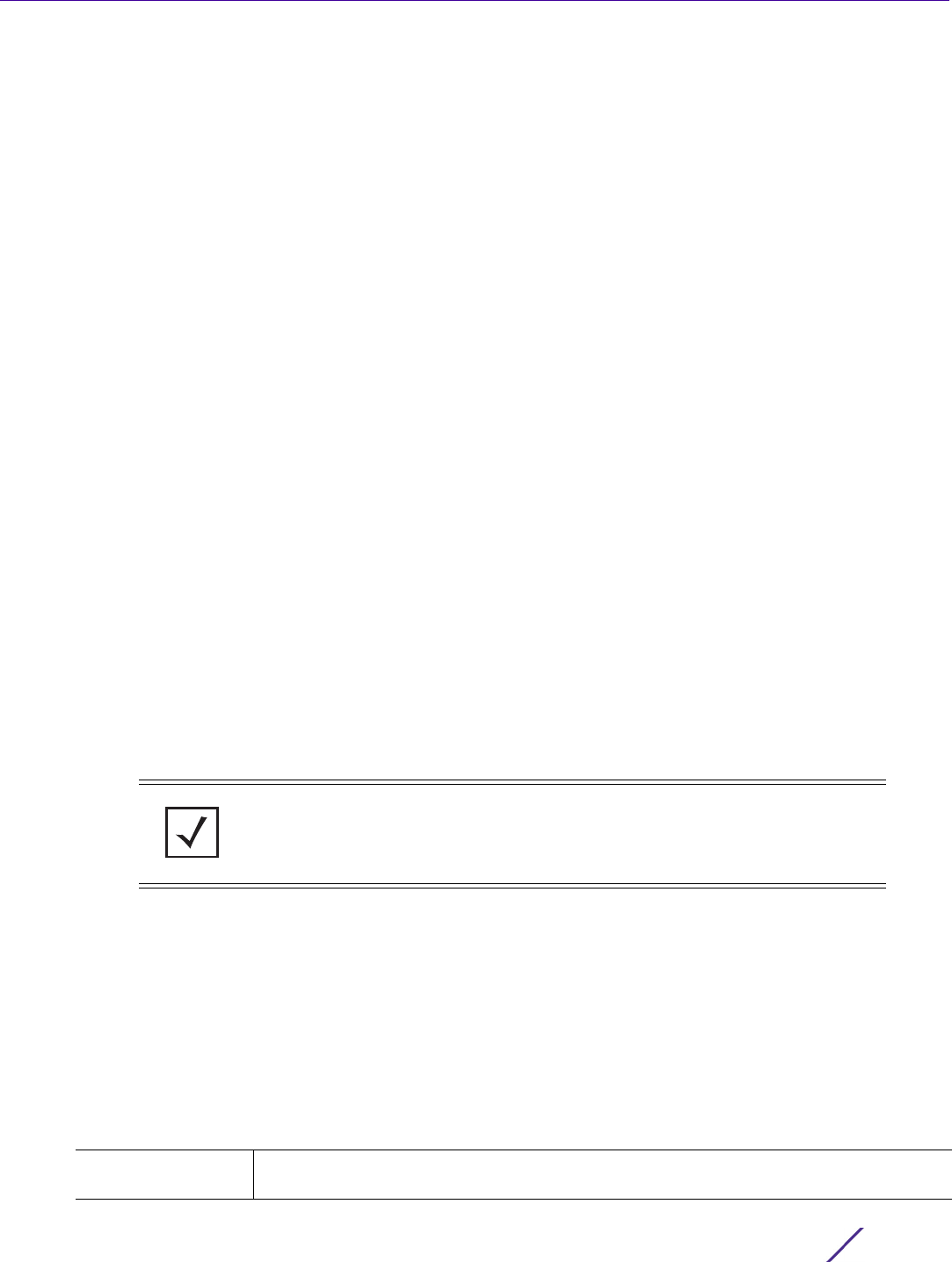
GLOBAL CONFIGURATION COMMANDS
Access Point, Wireless Controller and Service Platform CLI Reference Guide 4 - 552
4.1.99.1 url-filter
url-filter
Creates a new URL filter (Web filter) and enters its configuration mode. URL filtering is a licensed feature.
When applied to a WiNG device the license allows you to enable URL filtering on the device, create and
apply a URL filter defining the banned and/or allowed URLs. When enabled, the URL filter is applied to all
user-initiated URL requests to determine if the requested URL is banned or allowed. Only if allowed is the
user’s request (in the form of a HTTP request packet) forwarded to the Web server.
URL filters can be applied at any of the following points: the user’s application (browser/email reader), the
network’s gateway, at the Internet service provider’s (ISP) end, and also on a Web portal. For wireless
clients, the WLAN infrastructure is the best place to implement these filters.
A URL filter is a set of whitelist and/or blacklist rules. The whitelist allows access only to those Websites
and URLs specified in it. All other Websites and URLs, apart from those specified in the whitelist, are
banned. On the other hand, the blacklist bans all Websites and URLs specified in it. All other Websites and
URLs, apart from those specified in the blacklist, are allowed.
To simplify URL filter configuration, Websites have been classified into pre-defined category-types and
categories. The system provides 12 category-types and 64 categories. To further simplify configuration,
these 12 category-types have been grouped into five (5) pre-defined levels. (See Usage Guidelines section
for the list of category-types, categories, and levels). The actual classification of URLs (on the basis of the
pre-defined factors mentioned above) is done by the classification server. A local database also helps by
caching URL records for a user-defined time period. The classification server host is specified in the Web
filter policy. The Web filter policy also defines the URL database parameters. For more information, see
web-filter-policy.
The WiNG software also allows you to create URL lists. Each URL list contains a list of user-defined URLs.
Use the URL list in a URL filter (whitelist or blacklist rule) to identify the URLs to ban or allow. For example,
a URL list named SocialNetworking is created listing the following three sites: Facebook, Twitter, and
LinkedIn. When applied to a URL filter’s blacklist these three sites are banned. Where as, when applied to a
whitelist only these three sites are allowed. For more information on configuring a URL list, see url-list.
Supported in the following platforms:
• Access Points — AP6522, AP6532, AP7131, AP7502, AP7522, AP7532, AP7562, AP8132
• Wireless Controllers — RFS4000, RFS6000
• Service Platforms — NX5500, NX7500, NX7510, NX7520, NX7530, NX9500, NX9510, NX9600,
VX9000
Syntax
url-filter <URL-FILTER-NAME>
Parameters
• url-filter <URL-FILTER-NAME>
NOTE: URL filtering is a licensed feature. Procure and install the license in
the device configuration mode. For more information, see license.
<URL-FILTER-
NAME>
Creates a new URL filter and enters its configuration mode. Specify the URL filter
name. If the filter does not exist, it is created.

GLOBAL CONFIGURATION COMMANDS
Access Point, Wireless Controller and Service Platform CLI Reference Guide 4 - 553
Usage Guidelines
Category Type Category
1 Adult Content Alcohol & Tobacco, Dating & Personals, Gambling, Nudity, Pornography/Sexually
Explicit, Sex Education, Weapons
2 Business Web-based Email
3 Communication Chat, Instant Messaging
4 Entertainment Streaming Media & Downloads
5 File Sharing and
Backup
Download Sites
6 Gaming Games
7News Sports
and General
Arts, Business, Computer & Technology, Education, Entertainment, Fashion & Beauty,
Finance, Forum & Newsgroups, General, Government, Greeting Card, Health &
Medicine, Information Security, Job Search, Leisure & Recreation, Network Errors,
News, Non-Profits & NGO, Personal Sites, Politics, Private IP Addresses, Real Estates,
Religion, Restaurants & Dinning, Search Engine & Portals, Shopping, Sports,
Transportation, Translators, Travel
8 Peer-to-Peer
(P2P)
Peer to Peer
9 Questionable/
Unethical
Child Abuse Images, Cults, Hacking, Hate & Intolerance, Illegal Drug, Illegal Sharing,
Illegal Software, School Cheating, Tasteless, Violence
10 Security Risk Advertisement & Pop-ups, Anonymizers, Botnets, Compromised, Criminal Activity,
Malware, Parked Domains, Phishing & Fraud, Spam Sites
11 Social and
Photo Sharing
Social Networking
12 Software
Update
N/A
Level Description
1 Basic Blocks sites/URL categorized as Security Risk
2 Low Blocks sites/URL categorized as Adult Content + Basic
3 Medium Blocks sites/URL categorized as File Sharing and Backup, P2P, Questionable /
Unethical + Low
4 Medium High Blocks sites/URL categorized as Gaming + Medium
5 High Blocks sites/URL categorized as Communication, Entertainment, Social and Photo
Sharing + Medium High

GLOBAL CONFIGURATION COMMANDS
Access Point, Wireless Controller and Service Platform CLI Reference Guide 4 - 554
Example
nx9500-6C8809(config-url-filter-test)#?
URL Filter Mode commands:
blacklist Block access to URL
blockpage Configure blocking page parameters
description Url filter description
no Negate a command or set its defaults
whitelist Allow access to URL
clrscr Clears the display screen
commit Commit all changes made in this session
do Run commands from Exec mode
end End current mode and change to EXEC mode
exit End current mode and down to previous mode
help Description of the interactive help system
revert Revert changes
service Service Commands
show Show running system information
write Write running configuration to memory or terminal
nx9500-6C8809(config-url-filter-test)#

GLOBAL CONFIGURATION COMMANDS
Access Point, Wireless Controller and Service Platform CLI Reference Guide 4 - 555
4.1.99.2 url-filter-config-mode commands
url-filter
The following table summarizes URL filter configuration mode commands:
Table 4.56 URL-Filter-Config-Mode Commands
Command Description Reference
blacklist Creates a blacklist rule defining a list of banned Websites and URLs page 4-556
blockpage Configures the parameters that retrieve the page or content displayed by
the client’s browser when a requested URL is blocked and cannot be
viewed
page 4-559
description Configures an appropriate description for this URL filter page 4-561
no Removes this URL filter’s configured parameters page 4-562
whitelist Creates a whitelist rule defining a list of Websites and URLs allowed
access by clients.
page 4-563

GLOBAL CONFIGURATION COMMANDS
Access Point, Wireless Controller and Service Platform CLI Reference Guide 4 - 556
4.1.99.2.1 blacklist
url-filter-config-mode commands
Creates a blacklist rule. A blacklist is a list of Websites and URLs denied access by clients. Clients
requesting blacklisted URLs are presented with a page displaying the ‘Web page blocked’ message.
Parameters relating to this page are configured using the ‘blockpage’ option.
URL filtering is based on the classification of Websites into pre-defined category-types. Some of the
category-types are further divided into multiple categories. Currently available are 12 built-in category
types, and 64 categories. These built-in category-types and categories cannot be modified.
Use the available options to identify the URL category-types and categories to include in the blacklist.
In addition to identifying URLs by the categories and category-types they are classified into, the system
also provides five (5) levels of Web filtering (basic, high, low, medium, and medium-high). Each level
identifies a specific set of URL categories to blacklist. For more information on category-types, categories,
and URL filtering levels, see url-filter.
Supported in the following platforms:
• Access Points — AP6522, AP6532, AP7131, AP7502, AP7522, AP7532, AP7562, AP8132
• Wireless Controllers — RFS4000, RFS6000
• Service Platforms — NX5500, NX7500, NX7510, NX7520, NX7530, NX9500, NX9510, NX9600,
VX9000
Syntax
blacklist [category-type|level|url-list]
blacklist category-type [adult-content|all|business|communication|entertainment|
file-sharing-backup|gaming|news-sports-general|p2p|questionable|security-risk|
social-photo-sharing|software-updates] precedence <1-500> {description <LINE>}
blacklist level [basic|high|low|medium|medium-high] precedence <1-500>
{description <LINE>}
blacklist url-list <URL-LIST-NAME> precedence <1-500> {description <LINE>}
Parameters
• blacklist category-type [adult-content|all|business|communication|
entertainment|file-sharing-backup|gaming|news-sports-general|p2p|questionable|
security-risk|social-photo-sharing|software-updates] precedence <1-500>
{description <LINE>}
blacklist
category-type
<SELECT-
CATEGORY-TYPE>
Selects the category-type to blacklist. A category is a pre-defined URL list available in
the WiNG software. Categories are based on an external database, and cannot be
modified or removed. Custom categories can created with the URL List and added to
the database.
Websites have been classified into the following 12 category types:
adult-content, business, communication, entertainment, file-sharing-backup, gaming,
news-sports-general, p2p, questionable, security-risk, social-photo-sharing, and
software-updates
Contd..

GLOBAL CONFIGURATION COMMANDS
Access Point, Wireless Controller and Service Platform CLI Reference Guide 4 - 557
• blacklist level [basic|high|low|medium|medium-high] precedence <1-500>
{description <LINE>}
• blacklist url-list <URL-LIST-NAME> precedence <1-500> {description <LINE>}
Example
rfs6000-81742D(config-url-filter-test)#blacklist level medium-high precedence 10
rfs6000-81742D(config-url-filter-test)#blacklist category-type adult-content
category alcohol-tobacco precedence 1
rfs6000-81742D(config-url-filter-test)#blacklist category-type security-risk
category botnets precedence 3
Select ‘all’ to blacklist all category-types.
Some of the category-types are further classified into categories. For example, the
‘adult-content’ category-type is differentiated into the following categories:
• alcohol-tobacco, dating-personals, gambling, nudity, pornography-sexually-explicit,
sex-education, and weapons.
The system blocks all categories (URLs falling within their limits) within the selected
category-type.
precedence
<1-500>
Configures the precedence value for this blacklist rule. Rules are applied in the
increasing order of their precedence. Therefore, rules with lower precedence are
applied first.
description <LINE> Optional. Configures a description (not exceeding 80 characters) for this blacklist rule.
Enter a description that allows you to identify the purpose of the rule.
blacklist level
[basic|high|low|
medium|medium-
high]
Configures the Web filtering level as basic, high, low, medium, or medium-high. Each of
these filter-levels are pre-configured to use a set of category types and this mapping
cannot be modified.
precedence
<1-500>
Configures the precedence value for this blacklist rule. Rules are applied in the
increasing order of their precedence. Therefore, rules with lower precedence are
applied first.
description <LINE> Optional. Configures a description (not exceeding 80 characters) for this blacklist rule.
Enter a description that allows you to identify the purpose of the rule.
blacklist url-list
<URL-LIST-NAME>
Associates a URL list with this URL filter. When associated with a blacklist rule, all URLs
listed in the specified URL list are blacklisted.
URL lists are customized categories included in the custom filter-level setting. URL lists
enable an administrator to blacklist or whitelist URLs in addition to the built-in
categories. For more information on configuring a URL list, see url-list.
• <URL-LIST-NAME> – Enter URL list name (should be existing and configured)
precedence
<1-500>
Configures the precedence value for this blacklist rule. Rules are applied in the
increasing order of their precedence. Therefore, rules with lower precedence are
applied first.
description <LINE> Optional. Configures a description (not exceeding 80 characters) for this blacklist rule.
Enter a description that allows you to identify the purpose of the rule.

GLOBAL CONFIGURATION COMMANDS
Access Point, Wireless Controller and Service Platform CLI Reference Guide 4 - 558
rfs6000-81742D(config-url-filter-test)#show context
url-filter test
blacklist level medium-high precedence 10
blacklist category-type security-risk category botnets precedence 3
blacklist category-type adult-content category alcohol-tobacco precedence 1
rfs6000-81742D(config-url-filter-test)#
Related Commands
no Removes a blacklist rule from this URL filter. Specify the category-type, category, and
precedence to identify the blacklist rule. The identified rule is removed form the URL
filter.

GLOBAL CONFIGURATION COMMANDS
Access Point, Wireless Controller and Service Platform CLI Reference Guide 4 - 559
4.1.99.2.2 blockpage
url-filter-config-mode commands
Configures the parameters that retrieve the page or content displayed by the client’s browser when a
requested URL is blocked and cannot be viewed
Supported in the following platforms:
• Access Points — AP6522, AP6532, AP7131, AP7502, AP7522, AP7532, AP7562, AP8132
• Wireless Controllers — RFS4000, RFS6000
• Service Platforms — NX5500, NX7500, NX7510, NX7520, NX7530, NX9500, NX9510, NX9600,
VX9000
Syntax
blockpage [external|internal|path]
blockpage path [external|internal]
blockpage external url <URL>
blockpage internal [content|footer|header|main-logo|org-name|org-signature|
small-logo|title] <LINE/IMAGE-URL>
Parameters
• blockpage path [external|internal]
• blockpage external url <URL>
• blockpage internal [content|footer|header|main-logo|org-name|org-signature|
small-logo|title] <LINE/IMAGE-URL>
blockpage path
[external|internal]
Specifies if the location of the page displayed, to the client when a requested URL is
blocked, is external or internal
• external – Indicates the page displayed is hosted on an external Web server resource. If
selecting this option, use the blockpage > external > url <URL> command to provide the
path to the external Web server hosting the page.
internal – Indicates the page displayed is hosted internally. This is the default setting. If
selecting this option, use the blockpage > internal > <SELECT-PAGE-TYPE> > <LINE/
IMAGE-URL> command to define the page configuration.
blockpage external
url <URL>
Configures the URL of the external Web server hosting the page (displayed to the
client when a requested URL is blocked).
• url <URL> – Specify the URL of the Web server and the blocking page name
Valid URLs should begin with http:// or https://
The URL can contain query strings.
Use '&' or '?' character to separate field-value pair.
Enter 'ctrl-v' followed by '?' to configure query strings
blockpage internal
[content|footer|
header|main-logo|
org-name|
org-signature|
small-logo|title]
<LINE/IMAGE-URL>
Configures the internally hosted blocking page parameters, such as the content
displayed, page footer and header, organization (the organization enforcing the Web
page blocking) details (name, signature, and logo), and page title
• content – Configures the text (message) displayed on the blocking page
• footer – Configures the text displayed as the blocking page footer
Contd...

GLOBAL CONFIGURATION COMMANDS
Access Point, Wireless Controller and Service Platform CLI Reference Guide 4 - 560
Example
rfs6000-81742D(config-url-filter-test)#blockpage internal content "The requested
Web page is blocked and cannot be displayed for viewing"
rfs6000-81742D(config-url-filter-test)#show context
url-filter test
blacklist level medium-high precedence 10
blacklist category-type security-risk category botnets precedence 3
blacklist category-type adult-content category alcohol-tobacco precedence 1
blockpage internal content "The requested Web page is blocked and cannot be
displayed for viewing"
rfs6000-81742D(config-url-filter-test)#
Related Commands
• header – Configures the text displayed as the blocking page header
• org-name – Configures the organization’s name displayed on the blocking page
• org-signature – Configures the organization’s signature displayed on the blocking page
• title – Configures the title of the blocking page.
• main-logo – Configures the location of the main logo (organization’s large logo)
• small-logo – Configures the location of the small logo (organization’s small logo)
The following keyword is common to all of the above parameters:
• <LINE/IMAGE-URL> – Specify the location of the logo (main and small) image file.
The image is retrieved and displayed from the location configured here. If you are using
this option to provide content, such as organization name, footer, header, etc. enter a
text string not exceeding 255 characters in length.
no Removes the blocking page configurations

GLOBAL CONFIGURATION COMMANDS
Access Point, Wireless Controller and Service Platform CLI Reference Guide 4 - 561
4.1.99.2.3 description
url-filter-config-mode commands
Configures a description for this URL filter. Provide a description that enables you to identify the purpose
of this URL filter.
Supported in the following platforms:
• Access Points — AP6522, AP6532, AP7131, AP7502, AP7522, AP7532, AP7562, AP8132
• Wireless Controllers — RFS4000, RFS6000
• Service Platforms — NX5500, NX7500, NX7510, NX7520, NX7530, NX9500, NX9510, NX9600,
VX9000
Syntax
description <LINE>
Parameters
• description <LINE>
Example
rfs6000-81742D(config-url-filter-test)#description Blacklists sites inappropriate
for children and are security risks.
rfs6000-81742D(config-url-filter-test)#show context
url-filter test
description "Blacklists sites inappropriate for children and are security risks."
blacklist level medium-high precedence 10
blacklist category-type security-risk category botnets precedence 3
blacklist category-type adult-content category alcohol-tobacco precedence 1
blockpage internal content "The requested Web page is blocked and cannot be
displayed for viewing"
rfs6000-81742D(config-url-filter-test)#
Related Commands
description <LINE> Enter an appropriate description for this URL filter. The description should identify the
URL filter’s purpose and should not exceed 80 characters in length.
no Removes this URL filter’s description

GLOBAL CONFIGURATION COMMANDS
Access Point, Wireless Controller and Service Platform CLI Reference Guide 4 - 562
4.1.99.2.4 no
url-filter-config-mode commands
Use the no command to remove this URL filter’s configured parameters
Supported in the following platforms:
• Access Points — AP6522, AP6532, AP7131, AP7502, AP7522, AP7532, AP7562, AP8132
• Wireless Controllers — RFS4000, RFS6000
• Service Platforms — NX5500, NX7500, NX7510, NX7520, NX7530, NX9500, NX9510, NX9600,
VX9000
Syntax
no [blacklist|blockpage|description|whitelist]
no blacklist [category-type|level|url-list]
no blacklist [category-type <SELECT-CATEGORY-TYPE>|level <SELECT-LEVEL>|
url-list <URL-LIST-NAME>] precedence <1-500>
no blockpage [external|internal [content|footer|header|main-logo|org-name|
org-signature|small-logo|title]|path]
no description
no whitelist [category-type|url-list]
no whitelist [category-type <SELECT-CATEGORY-TYPE>|url-list <URL-LIST-NAME>]
precedence <1-500>
Parameters
• no <PARAMETERS>
Example
The following example displays the URL filter ‘test’ settings before the ‘no’ is executed:
rfs6000-81742D(config-url-filter-test)#show context
url-filter test
description "Blacklists sites inappropriate for children and are security risks."
blacklist level medium-high precedence 10
whitelist category-type communication category chat precedence 7
blacklist category-type security-risk category botnets precedence 3
blacklist category-type adult-content category alcohol-tobacco precedence 1
blockpage internal content "The requested Web page is blocked and cannot be
displayed for viewing"
rfs6000-81742D(config-url-filter-test)#
rfs6000-81742D(config-url-filter-test)#no description
rfs6000-81742D(config-url-filter-test)#no blacklist category-type adult-content
category alcohol-tobacco precedence 1
rfs6000-81742D(config-url-filter-test)#no whitelist category-type communication
category chat precedence 7
The following example displays the URL filter ‘test’ settings after the ‘no’ is executed:
rfs6000-81742D(config-url-filter-test)#show context
url-filter test
blacklist level medium-high precedence 10
blacklist category-type security-risk category botnets precedence 3
blockpage internal content "The requested Web page is blocked and cannot be
displayed for viewing"
rfs6000-81742D(config-url-filter-test)#
no <PARAMETERS> Removes this URL filter’s configured parameters based on the values passed here

GLOBAL CONFIGURATION COMMANDS
Access Point, Wireless Controller and Service Platform CLI Reference Guide 4 - 563
4.1.99.2.5 whitelist
url-filter-config-mode commands
Creates a whitelist rule. A whitelist is a list of Websites and URLs allowed access by clients.
URL filtering is based on the classification of Websites into pre-defined category-types. Some of the
category-types are further divided into multiple categories. Currently available are 12 built-in category
types, and 64 categories. These built-in category-types and categories cannot be modified.
Use the available options to identify the category-types and categories to include in the whitelist.
Supported in the following platforms:
• Access Points — AP6522, AP6532, AP7131, AP7502, AP7522, AP7532, AP7562, AP8132
• Wireless Controllers — RFS4000, RFS6000
• Service Platforms — NX5500, NX7500, NX7510, NX7520, NX7530, NX9500, NX9510, NX9600,
VX9000
Syntax
whitelist [category-type|url-list]
whitelist category-type [adult-content|all|business|communication|entertainment|
file-sharing-backup|gaming|news-sports-general|p2p|questionable|security-risk|
social-photo-sharing|software-updates] precedence <1-500> {description <LINE>}
whitelist url-list <URL-LIST-NAME> precedence <1-500> {description <LINE>}
Parameters
• whitelist category-type [adult-content|all|business|communication|
entertainment|file-sharing-backup|gaming|news-sports-general|p2p|questionable|
security-risk|social-photo-sharing|software-updates] precedence <1-500>
{description <LINE>}
whitelist
category-type
<SELECT-
CATEGORY-TYPE>
Selects the category-type to add to this whitelist. A category is a pre-defined URL list
available in the WiNG software. Categories are based on an external database, and
cannot be modified or removed. Custom categories can created with the URL List and
added to the database.
Websites have been classified into the following 12 category types: adult-content,
business, communication, entertainment, file-sharing-backup, gaming,
news-sports-general, p2p, questionable, security-risk, social-photo-sharing, and
software-updates.
Select ‘all’ to whitelist all category-types.
Some of the category-types are further classified into categories. For example, the
‘adult-content’ category-type is differentiated into the following categories:
• alcohol-tobacco, dating-personals, gambling, nudity, pornography-sexually-explicit,
sex-education, and weapons.
The system allows all categories (URLs falling within their limits) within the selected
category-type.
precedence
<1-500>
Configures the precedence value for this whitelist rule. Rules are applied in the
increasing order of their precedence. Therefore, rules with lower precedence are
applied first.
description <LINE> Optional. Configures a description (not exceeding 80 characters) for this whitelist rule.
Enter a description that allows you to identify the purpose of the rule.

GLOBAL CONFIGURATION COMMANDS
Access Point, Wireless Controller and Service Platform CLI Reference Guide 4 - 564
• whitelist url-list <URL-LIST-NAME> precedence <1-500> {description <LINE>}
Example
rfs6000-81742D(config-url-filter-test)#whitelist category-type communication
category chat precedence 7
rfs6000-81742D(config-url-filter-test)#show context
url-filter test
description "Blacklists sites inappropriate for children and are security risks."
blacklist level medium-high precedence 10
whitelist category-type communication category chat precedence 7
blacklist category-type security-risk category botnets precedence 3
blacklist category-type adult-content category alcohol-tobacco precedence 1
blockpage internal content "The requested Web page is blocked and cannot be
displayed for viewing"
rfs6000-81742D(config-url-filter-test)#
Related Commands
whitelist url-list
<URL-LIST-NAME>
Associates a URL list with this URL filter. When associated with a whitelist rule, all URLs
listed in the specified URL list are allowed access.
URL lists are customized categories included in the custom filter-level setting. URL lists
enable an administrator to blacklist or whitelist URLs in addition to the built-in
categories. For more information on configuring a URL list, see url-list.
• <URL-LIST-NAME> – Enter URL list name (should be existing and configured)
precedence
<1-500>
Configures the precedence value for this whitelist rule. Rules are applied in the
increasing order of their precedence. Therefore, rules with lower precedence are
applied first.
description <LINE> Optional. Configures a description (not exceeding 80 characters) for this whitelist rule.
Enter a description that allows you to identify the purpose of the rule.
no Removes a whitelist rule from this URL filter. Specify the category-type, category, and
precedence to identify the blacklist rule. The identified rule is removed form the URL
filter.

GLOBAL CONFIGURATION COMMANDS
Access Point, Wireless Controller and Service Platform CLI Reference Guide 4 - 565
4.1.100 url-list
Global Configuration Commands
The following table lists the commands that allow you to enter the URL list configuration mode:
Table 4.57 Commands Creating a URL List
Command Description Reference
url-list Creates a new URL list and enters its configuration mode page 4-566
url-list-config-
mode commands
Summarizes the URL list configuration mode commands page 4-567

GLOBAL CONFIGURATION COMMANDS
Access Point, Wireless Controller and Service Platform CLI Reference Guide 4 - 566
4.1.100.1 url-list
url-list
Creates a URL list and enters its configuration mode. URL lists are a means of categorizing URLs on the
basis of various criteria, such as frequently used, not-permitted, etc. It is used in URL filters to identify
whitelisted/blacklisted URLs. Web requests are blocked or approved based on URL filter whitelist/blacklist
rules. A whitelist bans all sites except the categories and URL lists defined in the whitelist. The blacklist
allows all sites except the categories and URL lists defined in the blacklist
Supported in the following platforms:
• Access Points — AP6522, AP6532, AP7131, AP7502, AP7522, AP7532, AP7562, AP8132
• Wireless Controllers — RFS4000, RFS6000
• Service Platforms — NX5500, NX7500, NX7510, NX7520, NX7530, NX9500, NX9510, NX9600,
VX9000
Syntax
url-list <URL-LIST-NAME>
Parameters
• url-list <URL-LIST-NAME>
Example
nx9500-6C8809(config)#url-list URLlist1
nx9500-6C8809(config-url-list-URLlist1)#?
URL List Mode commands:
description Description of the category
no Negate a command or set its defaults
url Add a URL entry
clrscr Clears the display screen
commit Commit all changes made in this session
do Run commands from Exec mode
end End current mode and change to EXEC mode
exit End current mode and down to previous mode
help Description of the interactive help system
revert Revert changes
service Service Commands
show Show running system information
write Write running configuration to memory or terminal
nx9500-6C8809(config-url-list-URLlist1)#
nx9500-6C8809(config-url-list-URLlist1)#url http://www.example_company.com depth
10
nx9500-6C8809(config-url-list-test)#show context
url-list test
url http://www.example_company.com depth 10
nx9500-6C8809(config-url-list-URLlist1)#
<URL-LIST-NAME> Specify the URL list name. The URL list is created if another list with the same name
does not exist.

GLOBAL CONFIGURATION COMMANDS
Access Point, Wireless Controller and Service Platform CLI Reference Guide 4 - 567
4.1.100.2 url-list-config-mode commands
url-list
The following table summarizes URL list configuration mode commands:
Table 4.58 URL-Filter-Config-Mode Commands
Command Description Reference
description Creates a blacklist rule defining a list of banned Web sites and URLs page 4-568
url Adds URL entries to this URL list page 4-569
no Removes this URL list’s settings page 4-570

GLOBAL CONFIGURATION COMMANDS
Access Point, Wireless Controller and Service Platform CLI Reference Guide 4 - 568
4.1.100.2.1 description
url-list-config-mode commands
Configures a description for this URL list. The description should be unique and enable you to identify the
type of URLs listed in the URL list.
Supported in the following platforms:
• Access Points — AP6522, AP6532, AP7131, AP7502, AP7522, AP7532, AP7562, AP8132
• Wireless Controllers — RFS4000, RFS6000
• Service Platforms — NX5500, NX7500, NX7510, NX7520, NX7530, NX9500, NX9510, NX9600,
VX9000
Syntax
description <LINE>
Parameters
• description <LINE>
Example
nx9500-6C8809(config-url-list-test)#description “This URL list contains social
media URLs”
nx9500-6C8809(config-url-list-test)#show context
url-list test
description “This URL list contains social media URLs”
nx9500-6C8809(config-url-list-test)#
Related Commands
description <LINE> Provide a unique description for this URL list (should not exceed 500 characters in
length)
no Removes this URL list’s description

GLOBAL CONFIGURATION COMMANDS
Access Point, Wireless Controller and Service Platform CLI Reference Guide 4 - 569
4.1.100.2.2 url
url-list-config-mode commands
Adds URL entries to this URL list
Supported in the following platforms:
• Access Points — AP6522, AP6532, AP7131, AP7502, AP7522, AP7532, AP7562, AP8132
• Wireless Controllers — RFS4000, RFS6000
• Service Platforms — NX5500, NX7500, NX7510, NX7520, NX7530, NX9500, NX9510, NX9600,
VX9000
Syntax
url <WORD> {depth <1-10>}
Parameters
• url <WORD> {depth <1-10>}
Example
nx9500-6C8809(config-url-list-test)#url http://www.facebook.com
nx9500-6C8809(config-url-list-test)#show context
url-list test
description “This URL list contains social communication URLS”
url https://www.facebook.com depth 5
nx9500-6C8809(config-url-list-test)#
Related Commands
url <WORD>
{depth <1-10>}
Adds a URL entry
• <WORD> – Specify the URL to add.
• depth – Optional. Sets number of levels to be cached. Since Web sites have different
parameters to uniquely identify specific content, the same content may be stored on
multiple origin servers. Smart caching uses subsets of these parameters to recognize
that the content is the same and serves it from cache.
• <1-10> – Specify the depth from 1 - 10.
no Removes a URL entry from this URL list

GLOBAL CONFIGURATION COMMANDS
Access Point, Wireless Controller and Service Platform CLI Reference Guide 4 - 570
4.1.100.2.3 no
url-list-config-mode commands
Removes this URL list’s settings
Supported in the following platforms:
• Access Points — AP6522, AP6532, AP7131, AP7502, AP7522, AP7532, AP7562, AP8132
• Wireless Controllers — RFS4000, RFS6000
• Service Platforms — NX5500, NX7500, NX7510, NX7520, NX7530, NX9500, NX9510, NX9600,
VX9000
Syntax
no [description|url]
no description
no url <WORD>
Parameters
• no <PARAMETERS>
Example
The following example displays the URL list ‘test’ settings before the ‘no’ command is executed:
nx9500-6C8809(config-url-list-test)#show context
url-list test
description “This URL list contains social communication URLS”
url https://www.facebook.com depth 5
nx9500-6C8809(config-url-list-test)#
nx9500-6C8809(config-url-list-test)#no url www.facebook.com
The following example displays the URL list ‘test’ settings after the ‘no’ command is executed:
nx9500-6C8809(config-url-list-test)#show context
url-list test
description “This URL list contains social communication URLS”
nx9500-6C8809(config-url-list-test)#
no <PARAMETERS> Removes this URL’s settings based on the parameters passed

GLOBAL CONFIGURATION COMMANDS
Access Point, Wireless Controller and Service Platform CLI Reference Guide 4 - 571
4.1.101 vx9000
Global Configuration Commands
Configures a Virtual WLAN Controller (V-WLC) in a virtual machine (VM) environment. V-WLC can be
deployed on a shared, third-party server hardware, thereby reducing overhead costs of procuring and
maintaining dedicated appliances. The external, third-party hardware needs to have installed hypervisors,
such as VmWare, Xen, VirtualBox, KVM, Amazon EC2 or Hyper-V, enabling it to communicate with V-WLC
software.
The V-WLC controls and manages access points and other controllers (at NOC or as a site-controller) in the
network. The traffic between the access points and the V-WLC is over the layer-3 MINT protocol.
V-WLC is a licensed feature, and the WiNG software provides the following two new licenses:
• VX – When installed, this license activates VM controller instance, and enables the V-WLC to trigger
adoption process allowing access points to adopt to the V-WLC. The adoption capacity of the V-
WLC is determined by the number of licenses installed on it.
• VX-DEMO – This is a 60 day trial license. This license also activates VM controller instance, and
enables the V-WLC to adopt access points. But, the access point adoption capacity is limited to 16.
Having installed this license on a device, the only other license that you can install on it is the VX
license. All existing installed licenses will continue to work as before. Since this license has a limited
validity period, ensure that the system clock on the license generating tool and the device are in
sync. preferably through NTP.
To install the VX or VX-DEMO license on an existing V-WLC instance, use the license command. For more
information, see the examples provided in this section.
Supported in the following platforms:
• Service Platforms — NX9500, NX9510, NX9600
Syntax
vx9000 <MAC>
Parameters
• vx9000 <MAC>
Example
nx9500-6C8809(config)#vx9000 11-22-33-44-55-66
nx9500-6C8809(config-device-11-22-33-44-55-66)#?
Device Mode commands:
adopter-auto-provisioning-policy-lookup Use centralized auto-provisioning
policy when adopted by another
controller
adoption Adoption configuration
adoption-site Set system's adoption site
adoption-mode Configure the adoption mode for the
access-points in this RF-Domain
alias Alias
application-policy Application Poicy configuration
area Set name of area where the system
is located
arp Address Resolution Protocol (ARP)
auto-learn Auto learning
vx <MAC> Configures a V-WLC and enters its configuration mode
The V-WLC configuration is the same as that of a normal controller.

GLOBAL CONFIGURATION COMMANDS
Access Point, Wireless Controller and Service Platform CLI Reference Guide 4 - 572
autogen-uniqueid Autogenerate a unique id
autoinstall Autoinstall settings
bluetooth-detection Detect Bluetooth devices using the
Bluetooth USB module - there will
be interference on 2.4 Ghz radio in
wlan mode
bridge Ethernet bridge
captive-portal Captive portal
cdp Cisco Discovery Protocol
channel-list Configure channel list to be
advertised to wireless clients
cluster Cluster configuration
configuration-persistence Enable persistence of configuration
across reloads (startup configfile)
contact Configure the contact
controller WLAN controller configuration
country-code Configure the country of operation
critical-resource Critical Resource
crypto Encryption related commands
database Database command
device-upgrade Device firmware upgrade
dot1x 802.1X
dpi Enable Deep-Packet-Inspection
(Application Assurance)
dscp-mapping Configure IP DSCP to 802.1p
priority mapping for untagged
frames
email-notification Email notification configuration
enforce-version Check the firmware versions of
devices before interoperating
environmental-sensor Environmental Sensors Configuration
events System event messages
export Export a file
file-sync File sync between controller and
adoptees
floor Set the floor within a area where
the system is located
geo-coordinates Configure geo coordinates for this
device
gre GRE protocol
hostname Set system's network name
http-analyze Specify HTTP-Analysis configuration
interface Select an interface to configure
ip Internet Protocol (IP)
ipv6 Internet Protocol version 6 (IPv6)
l2tpv3 L2tpv3 protocol
l3e-lite-table L3e lite Table
layout-coordinates Configure layout coordinates for
this device
led Turn LEDs on/off on the device
led-timeout Configure the time for the led to
turn off after the last radio state
change
legacy-auto-downgrade Enable device firmware to auto
downgrade when other legacy devices
are detected
legacy-auto-update Auto upgrade of legacy devices
license License management command
lldp Link Layer Discovery Protocol
load-balancing Configure load balancing parameter
location Configure the location
logging Modify message logging facilities
mac-address-table MAC Address Table
mac-auth 802.1X
mac-name Configure MAC address to name
mappings
management-server Configure management server address
memory-profile Memory profile to be used on the

GLOBAL CONFIGURATION COMMANDS
Access Point, Wireless Controller and Service Platform CLI Reference Guide 4 - 573
device
meshpoint-device Configure meshpoint device
parameters
meshpoint-monitor-interval Configure meshpoint monitoring
interval
min-misconfiguration-recovery-time Check controller connectivity after
configuration is received
mint MiNT protocol
mirror Mirroring
misconfiguration-recovery-time Check controller connectivity after
configuration is received
mpact-server MPACT server configuration
neighbor-inactivity-timeout Configure neighbor inactivity
timeout
neighbor-info-interval Configure neighbor information
exchange interval
no Negate a command or set its
defaults
noc Configure the noc related setting
nsight NSight
ntp Ntp server WORD
offline-duration Set duration for which a device
remains unadopted before it
generates offline event
override Override a command
override-wlan Configure RF Domain level overrides
for wlan
power-config Configure power mode
preferred-controller-group Controller group this system will
prefer for adoption
preferred-tunnel-controller Tunnel Controller Name this system
will prefer for tunneling extended
vlan traffic
radius Configure device-level radius
authentication parameters
raid RAID
remove-override Remove configuration item override
from the device (so profile value
takes effect)
rf-domain-manager RF Domain Manager
router Dynamic routing
rsa-key Assign a RSA key to a service
sensor-server AirDefense sensor server
configuration
slot PCI expansion Slot
spanning-tree Spanning tree
timezone Configure the timezone
traffic-class-mapping Configure IPv6 traffic class to
802.1p priority mapping for
untagged frames
trustpoint Assign a trustpoint to a service
tunnel-controller Tunnel Controller group this
controller belongs to
use Set setting to use
vrrp VRRP configuration
vrrp-state-check Publish interface via OSPF/BGP only
if the interface VRRP state is not
BACKUP
wep-shared-key-auth Enable support for 802.11 WEP
shared key authentication
clrscr Clears the display screen
commit Commit all changes made in this
session
do Run commands from Exec mode
end End current mode and change to EXEC
mode
exit End current mode and down to

GLOBAL CONFIGURATION COMMANDS
Access Point, Wireless Controller and Service Platform CLI Reference Guide 4 - 574
previous mode
help Description of the interactive help
system
revert Revert changes
service Service Commands
show Show running system information
write Write running configuration to
memory or terminal
nx9500-6C8809(config-device-11-22-33-44-55-66)#
vx-0099CC(config-device-00-0C-29-00-99-CC)~*#license ?
WORD Feature name (AP/AAP/ADSEC/HTANLT/VX) for
which license is to be added
vx-0099CC(config-device-00-0C-29-00-99-CC)~*#license vx 80ee9649eddc94b48b5a35d7
eaf8e73b376a51649291714d04c84769b0fc4b3766816878d2739c24
vx-0099CC(config-device-00-0C-29-00-99-CC)~*#com wr
Jan 16 13:48:11 2014: vx-0099CC : %SYSTEM-6-CONFIG_COMMIT: Configuration commit by
user 'root' (mapsh) from 'Console'
Jan 16 13:48:11 2014: vx-0099CC : %SYSTEM-6-CONFIG_REVISION: Configuration
revision updated to 9 from 8
Jan 16 13:48:12 2014: vx-0099CC : %LICMGR-6-LIC_INSTALLED: VX license installed
[OK]
vx-0099CC(config-device-00-0C-29-00-99-CC)~*#Jan 16 13:48:12 2014: vx-0099CC :
%SYSTEM-6-CONFIG_REVISION: Configuration revision updated to 10 from 9
vx-0099CC(config-device-00-0C-29-00-99-CC)~*#
vx-0099CC(config-device-00-0C-29-00-99-CC)~*#
vx-0099CC(config-device-00-0C-29-00-99-CC)~*#sh licenses
Serial Number : 000C290099CCC0A80001
WARNING: Recommended minimum system resource requirements not met for the current
license pack or cluster configs. Please check user guide and reconfigure the system
Device Licenses:
AP-LICENSE
String :
Value : 10240
AAP-LICENSE
String :
Value : 10240
ADVANCED-SECURITY
String : DEFAULT-ADV-SEC-LICENSE
VX-LICENSE
String :
80ee9649eddc94b48b5a35d7eaf8e73b376a51649291714d04c84769b0fc4b3766816878d2739c24
Cluster Licenses:
AP-LICENSE
Value : 10240
Used : 0
AAP-LICENSE
Value : 10240
Used : 0
Cluster MAX AP Capacity:
Value : 10240
Used : 0
Active Members:
--------------------------------------------------------------------------------
-------------------
MEMBER SERIAL LIC TYPE VALUE BORROWED TOTAL NO.APS
NO.AAPS
--------------------------------------------------------------------------------
-------------------
00-0C-29-00-99-CC 000C290099CCC0A80001 AP 10240 0 10240 0 0

GLOBAL CONFIGURATION COMMANDS
Access Point, Wireless Controller and Service Platform CLI Reference Guide 4 - 575
00-0C-29-00-99-CC 000C290099CCC0A80001 AAP 10240 0 10240 -
-
--------------------------------------------------------------------------------
-------------------
vx-0099CC(config-device-00-0C-29-00-99-CC)~*#
Related Commands
no Removes a VX9000 wireless controller

5 - 1
Access Point, Wireless Controller and Service Platform CLI Reference Guide
5
COMMON COMMANDS
This chapter describes the CLI commands used in the USER EXEC, PRIV EXEC, and GLOBAL CONFIG
modes.
The PRIV EXEC command set contains commands available within the USER EXEC mode. Some
commands can be entered in either mode. Commands entered in either the USER EXEC or PRIV EXEC
mode are referred to as EXEC mode commands. If a user or privilege is not specified, the referenced
command can be entered in either mode.

COMMON COMMANDS
Access Point, Wireless Controller and Service Platform CLI Reference Guide 5 - 2
5.1 Common Commands
COMMON COMMANDS
The following table summarizes commands common to the User Exec, Priv Exec, and Global Config modes:
Table 5.1 Commands Common to Controller CLI Modes
Command Description Reference
clrscr Clears the display screen page 5-3
commit Commits (saves) changes made in the current session page 5-4
exit Ends and exits the current mode and moves to the PRIV EXEC mode page 5-5
help Displays the interactive help system page 5-6
no Negates a command or reverts values to their default settings page 5-9
revert Reverts changes to their last saved configuration page 5-12
service Invokes service commands to troubleshoot or debug (config-if)
instance configurations
page 5-13
show Displays running system information page 5-58
write Writes the system’s running configuration to memory or to the terminal page 5-60
NOTE: The input parameter <HOSTNAME> cannot include an underscore
character. In other words, a device’s hostname cannot contain an underscore.

COMMON COMMANDS
Access Point, Wireless Controller and Service Platform CLI Reference Guide 5 - 3
5.1.1 clrscr
Common Commands
Clears the screen and refreshes the prompt, irrespective of the mode
Supported in the following platforms:
• Access Points — AP6521, AP6522, AP6532, AP6562, AP7161, AP7502, AP7522, AP7532, AP7562,
AP81XX, AP82XX, AP8432, AP8533
• Wireless Controllers — RFS4000, RFS6000
• Service Platforms — NX5500, NX7500, NX7510, NX7520, NX7530, NX9500, NX9510, NX9600,
VX9000
Syntax
clrscr
Parameters
None
Example
The terminal window or screen before the clrscr command is executed:
rfs4000-229D58#device-upgrade ?
DEVICE-NAME Name/MAC address of device
all Upgrade all devices
ap650 Upgrade AP650 Device
ap6511 Upgrade AP6511 Device
ap6521 Upgrade AP6521 Device
ap6522 Upgrade AP6522 Device
ap6532 Upgrade AP6532 Device
ap6562 Upgrade AP6562 Device
ap71xx Upgrade AP7161 Device
ap7502 Upgrade AP7502 Device
ap7522 Upgrade AP7522 Device
ap7532 Upgrade AP7532 Device
ap7562 Upgrade AP7562 Device
ap81xx Upgrade AP81XX Device
ap82xx Upgrade AP82XX Device
ap8432 Upgrade AP8432 Device
ap8533 Upgrade AP8533 Device
cancel-upgrade Cancel upgrading the device
load-image Load the device images to controller for device-upgrades
rf-domain Upgrade all devices belonging to an RF Domain
rfs4000 Upgrade RFS4000 Device
rfs4000-229D58#
The terminal window or screen after the clrscr command is executed:
rfs4000-229D58#

COMMON COMMANDS
Access Point, Wireless Controller and Service Platform CLI Reference Guide 5 - 4
5.1.2 commit
Common Commands
Commits changes made in the active session. Use the commit command to save and invoke settings
entered during the current transaction.
Supported in the following platforms:
• Access Points — AP6521, AP6522, AP6532, AP6562, AP7161, AP7502, AP7522, AP7532, AP7562,
AP7602, AP7612, AP7622, AP7632, AP7662, AP81XX, AP82XX, AP8432, AP8533
• Wireless Controllers — RFS4000, RFS6000
• Service Platforms — NX5500, NX7500, NX7510, NX7520, NX7530, NX9500, NX9510, NX9600,
VX9000
Syntax
commit {write}{memory}
Parameters
• commit {write}{memory}
Example
nx9500-6C8809#commit write memory
[OK]
nx9500-6C8809#
write Optional. Commits changes made in the current session
memory Optional. Writes to memory. This option ensures current changes persist across
reboots.

COMMON COMMANDS
Access Point, Wireless Controller and Service Platform CLI Reference Guide 5 - 5
5.1.3 exit
Common Commands
The exit command works differently in the User Exec, Priv Exec, and Global Config modes. In the Global
Config mode, it ends the current mode and moves to the previous mode, which is Priv Exec mode. The
prompt changes from (config)# to #. When used in the Priv Exec and User Exec modes, the exit
command ends the current session, and connection to the terminal device is terminated. If the current
session has changes that have not been committed, the system prompts you to either do a commit or a
revert before terminating the session.
Supported in the following platforms:
• Access Points — AP6521, AP6522, AP6532, AP6562, AP7161, AP7502, AP7522, AP7532, AP7562,
AP7602, AP7612, AP7622, AP7632, AP7662, AP81XX, AP82XX, AP8432, AP8533
• Wireless Controllers — RFS4000, RFS6000
• Service Platforms — NX5500, NX7500, NX7510, NX7520, NX7530, NX9500, NX9510, NX9600,
VX9000
Syntax
exit
Parameters
None
Example
nx9500-6C8809(config)#exit
nx9500-6C8809#

COMMON COMMANDS
Access Point, Wireless Controller and Service Platform CLI Reference Guide 5 - 6
5.1.4 help
Common Commands
Describes the interactive help system
Use this command to access the advanced help feature. Use “?” anytime at the command prompt to access
the help topic.
Two kinds of help are provided:
• Full help is available when ready to enter a command argument
• Partial help is provided when an abbreviated argument is entered and you want to know what
arguments match the input (for example 'show ve?').
Supported in the following platforms:
• Access Points — AP6521, AP6522, AP6532, AP6562, AP7161, AP7502, AP7522, AP7532, AP7562,
AP7602, AP7612, AP7622, AP7632, AP7662, AP81XX, AP82XX, AP8432, AP8533
• Wireless Controllers — RFS4000, RFS6000
• Service Platforms — NX5500, NX7500, NX7510, NX7520, NX7530, NX9500, NX9510, NX9600,
VX9000
Syntax
help {search}
help {search <WORD>} {detailed|only-show|skip-no|skip-show}
Parameters
• help {search <WORD>} {detailed|only-show|skip-no|skip-show}
search <WORD> Optional. Searches for CLI commands related to a specified target term
• <WORD> – Specify a target term (for example, a feature or a configuration
parameter). After specifying the term, select one of the following options: detailed,
only-show, skip-no, or skip-show. The system displays information based on the
option selected.
detailed Optional. Searches and displays help strings in addition to mode and commands
only-show Optional. Displays only “show” commands. Does not display configuration
commands
skip-no Optional. Displays only configuration commands. Does not display “no” commands
skip-show Optional. Displays only configuration commands. Does not display “show”
commands

COMMON COMMANDS
Access Point, Wireless Controller and Service Platform CLI Reference Guide 5 - 7
Example
nx9500-6C8809>help search crypto detailed
found more than 64 references, showing the first 64
Context : Command
Command : clear crypto ike sa (A.B.C.D|all)(|on DEVICE-NAME)
\ Clear
\ Encryption Module
\ IKE SA
\ Flush IKE SAs
\ Flush IKE SAs for a given peer
\ Flush all IKE SA
\ On AP/Controller
\ AP/Controller name
: clear crypto ipsec sa(|on DEVICE-NAME)
\ Clear
\ Encryption Module
\ IPSec database
\ Flush IPSec SAs
\ On AP/Controller
\ AP/Controller name
: crypto key export rsa WORD URL (passphrase WORD|) (background|) ...
\ Encryption related commands
--More--
nx9500-6C8809>
nx9500-6C8809>help search crypto only-show
Context : Command
Command : show crypto cmp request status(|on DEVICE-NAME)
: show crypto ike sa (version 1|version 2|)(peer A.B.C.D|) (detail...
: show crypto ipsec sa (peer A.B.C.D|) (detail|) (|on DEVICE-NAME...
: show crypto key rsa (|public-key-detail) (|on DEVICE-NAME)
: show crypto pki trustpoints (WORD|all|)(|on DEVICE-NAME)
nx9500-6C8809>
nx9500-6C8809>help search service skip-show
found more than 64 references, showing the first 64
Context : Command
Command : service block-adopter-config-update
: service clear adoption history(|on DEVICE-NAME)
: service clear captive-portal-page-upload history (|(on DOMAIN-NA...
: service clear command-history(|on DEVICE-NAME)
: service clear device-upgrade history (|on DOMAIN-NAME)
: service clear noc statistics
: service clear reboot-history(|on DEVICE-NAME)
: service clear unsanctioned aps (|on DEVICE-OR-DOMAIN-NAME)
: service clear upgrade-history(|on DEVICE-NAME)
: service clear web-filter cache(|on DEVICE-NAME)
: service clear wireless ap statistics (|(AA-BB-CC-DD-EE-FF)) (|on...
: service clear wireless client statistics (|AA-BB-CC-DD-EE-FF) (|...
: service clear wireless controller-mobility-database
: service clear wireless dns-cache(|on DEVICE-OR-DOMAIN-NAME)
: service clear wireless radio statistics (|(DEVICE-NAME (|<1-3>))...
: service clear wireless wlan statistics (|WLAN) (|on DEVICE-OR-DO...
: service clear xpath requests (|<1-100000>)
: service show block-adopter-config-update
: service show captive-portal servers(|on DEVICE-NAME)
: service show captive-portal user-cache(|on DEVICE-NAME)
: service show cli
--More--
nx9500-6C8809>

COMMON COMMANDS
Access Point, Wireless Controller and Service Platform CLI Reference Guide 5 - 8
nx9500-6C8809>help search mint only-show
Found 25 references for "mint"
Context : Command
Command : show debugging mint (|on DEVICE-OR-DOMAIN-NAME)
: show mint config(|on DEVICE-NAME)
: show mint dis (|details)(|on DEVICE-NAME)
: show mint id(|on DEVICE-NAME)
: show mint info(|on DEVICE-NAME)
: show mint known-adopters(|on DEVICE-NAME)
: show mint links (|details)(|on DEVICE-NAME)
: show mint lsp
: show mint lsp-db (|details AA.BB.CC.DD)(|on DEVICE-NAME)
: show mint mlcp history(|on DEVICE-NAME)
: show mint mlcp(|on DEVICE-NAME)
: show mint neighbors (|details)(|on DEVICE-NAME)
: show mint route(|on DEVICE-NAME)
: show mint stats(|on DEVICE-NAME)
: show mint tunnel-controller (|details)(|on DEVICE-NAME)
: show mint tunneled-vlans(|on DEVICE-NAME)
: show wireless mint client (|on DEVICE-OR-DOMAIN-NAME)
: show wireless mint client portal-candidates(|(DEVICE-NAME (|<1-3...
: show wireless mint client statistics (|on DEVICE-OR-DOMAIN-NAME)...
: show wireless mint client statistics rf (|on DEVICE-OR-DOMAIN-NA...
: show wireless mint detail (|(DEVICE-NAME (|<1-3>))) (|(filter {|...
: show wireless mint links (|on DEVICE-OR-DOMAIN-NAME)
: show wireless mint portal (|on DEVICE-OR-DOMAIN-NAME)
: show wireless mint portal statistics (|on DEVICE-OR-DOMAIN-NAME)...
: show wireless mint portal statistics rf (|on DEVICE-OR-DOMAIN-NA...
nx9500-6C8809>

COMMON COMMANDS
Access Point, Wireless Controller and Service Platform CLI Reference Guide 5 - 9
5.1.5 no
Common Commands
Negates a command or sets its default. Though the no command is common to the User Exec, Priv Exec,
and Global Config modes, it negates a different set of commands in each mode.
Supported in the following platforms:
• Access Points — AP6521, AP6522, AP6532, AP6562, AP7161, AP7502, AP7522, AP7532, AP7562,
AP7602, AP7612, AP7622, AP7632, AP7662, AP81XX, AP82XX, AP8432, AP8533
• Wireless Controllers — RFS4000, RFS6000
• Service Platforms — NX5500, NX7500, NX7510, NX7520, NX7530, NX9500, NX9510, NX9600,
VX9000
Syntax
no <PARAMETERS>
Parameters
• no <PARAMATERS>
Usage Guidelines
The no command negates any command associated with it. Wherever required, use the same parameters
associated with the command getting negated.
Example
Global Config mode: No command options
rfs6000-81742D(config)##no ?
aaa-policy Delete a aaa policy
aaa-tacacs-policy Delete a aaa tacacs policy
alias Alias
ap621 Delete an AP621 access point
ap622 Delete an AP622 access point
ap650 Delete an AP650 access point
ap6511 Delete an AP6511 access point
ap6521 Delete an AP6521 access point
ap6522 Delete an AP6522 access point
ap6532 Delete an AP6532 access point
ap6562 Delete an AP6562 access point
ap71xx Delete an AP71XX access point
ap7502 Delete an AP7502 access point
ap7522 Delete an AP7522 access point
ap7532 Delete an AP7532 access point
ap7562 Delete an AP7562 access point
ap81xx Delete an AP81XX access point
ap82xx Delete an AP82XX access point
ap8432 Delete an AP8432 access point
ap8533 Delete an AP8533 access point
application Delete an application
application-group Delete an application-group
application-policy Delete an application policy
association-acl-policy Delete an association-acl policy
auto-provisioning-policy Delete an auto-provisioning policy
bgp BGP Configuration
bonjour-gw-discovery-policy Disable Bonjour Gateway discovery policy
no <PARAMETERS> The no command is common across all configuration modes and sub modes. It resets
or reverts settings based on the mode in which executed. For example, when
executed in the AAA policy configuration mode, it allows you to reset or revert a
specific AAA policy settings. Similarly, when executed in the global configuration
mode, it only resets or reverts settings configured in the global configuration mode.

COMMON COMMANDS
Access Point, Wireless Controller and Service Platform CLI Reference Guide 5 - 10
bonjour-gw-forwarding-policy Disable Bonjour Gateway Forwarding
policy
bonjour-gw-query-forwarding-policy Disable Bonjour Gateway Query Forwarding
policy
captive-portal Delete a captive portal
client-identity Client identity (DHCP Device
Fingerprinting)
client-identity-group Client identity group (DHCP Fingerprint
Database)
crypto-cmp-policy CMP policy
customize Restore the custom cli commands to
default
device Delete multiple devices
device-categorization Delete device categorization object
dhcp-server-policy DHCP server policy
dhcpv6-server-policy DHCPv6 server related configuration
dns-whitelist Delete a whitelist object
event-system-policy Delete a event system policy
ex3500 Ex3500 device
ex3500-management-policy Delete a ex3500 management policy
ex3500-qos-class-map-policy Delete a ex3500 qos class-map policy
ex3500-qos-policy-map Delete a ex3500 qos policy-map
ex3524 Delete an EX3524 wireless controller
ex3548 Delete an EX3548 wireless controller
firewall-policy Configure firewall policy
global-association-list Delete a global association list
igmp-snoop-policy Remove device onboard igmp snoop policy
inline-password-encryption Disable storing encryption key in the
startup configuration file
ip Internet Protocol (IP)
ipv6 Internet Protocol version 6 (IPv6)
ipv6-router-advertisement-policy IPv6 Router Advertisement related
configuration
l2tpv3 Negate a command or set its defaults
mac MAC configuration
management-policy Delete a management policy
meshpoint Delete a meshpoint object
meshpoint-qos-policy Delete a mesh point QoS configuration
policy
nac-list Delete an network access control list
nsight-policy Delete a nsight policy
passpoint-policy Delete a passpoint configuration policy
password-encryption Disable password encryption in
configuration
profile Delete a profile and all its associated
configuration
radio-qos-policy Delete a radio QoS configuration policy
radius-group Local radius server group configuration
radius-server-policy Remove device onboard radius policy
radius-user-pool-policy Configure Radius User Pool
rf-domain Delete one or more RF-domains and all
their associated configurations
rfs4000 Delete an RFS4000 wireless controller
rfs6000 Delete an RFS6000 wireless controller
roaming-assist-policy Delete a roaming-assist policy
role-policy Role based firewall policy
route-map Dynamic routing route map Configuration
routing-policy Policy Based Routing Configuratino
rtl-server-policy Delete a rtl server policy
schedule-policy Delete a schedule policy
sensor-policy Delete a sensor policy
smart-rf-policy Delete a smart-rf-policy
t5 Delete an T5 DSL switch
url-filter Delete a url filter
url-list Delete a URL list
web-filter-policy Delete a web filter policy
wips-policy Delete a wips policy
wlan Delete a wlan object

COMMON COMMANDS
Access Point, Wireless Controller and Service Platform CLI Reference Guide 5 - 11
wlan-qos-policy Delete a wireless lan QoS configuration
policy
service Service Commands
rfs6000-81742D(config)#
Priv Exec mode: No command options
rfs6000-81742D#no ?
adoption Reset adoption state of the device (& all devices adopted to
it)
captive-portal Captive portal commands
cpe T5 CPE configuration
crypto Encryption related commands
debug Debugging functions
logging Modify message logging facilities
page Toggle paging
service Service Commands
terminal Set terminal line parameters
upgrade Remove a patch
wireless Wireless Configuration/Statistics commands
rfs6000-81742D#
user Exec mode: No command options
rfs6000-81742D>no ?
adoption Reset adoption state of the device (& all devices adopted to
it)
captive-portal Captive portal commands
crypto Encryption related commands
debug Debugging functions
logging Modify message logging facilities
page Toggle paging
service Service Commands
terminal Set terminal line parameters
wireless Wireless Configuration/Statistics commands
rfs6000-81742D>

COMMON COMMANDS
Access Point, Wireless Controller and Service Platform CLI Reference Guide 5 - 12
5.1.6 revert
Common Commands
Reverts changes made, in the current session, to their last saved configuration
Supported in the following platforms:
• Access Points — AP6521, AP6522, AP6532, AP6562, AP7161, AP7502, AP7522, AP7532, AP7562,
AP7602, AP7612, AP7622, AP7632, AP7662, AP81XX, AP82XX, AP8432, AP8533
• Wireless Controllers — RFS4000, RFS6000
• Service Platforms — NX5500, NX7500, NX7510, NX7520, NX7530, NX9500, NX9510, NX9600,
VX9000
Syntax
revert
Parameters
None
Example
nx9500-6C8809>revert
nx9500-6C8809>

COMMON COMMANDS
Access Point, Wireless Controller and Service Platform CLI Reference Guide 5 - 13
5.1.7 service
Common Commands
Service commands are used to view and manage configurations. The service commands and their
corresponding parameters vary from mode to mode. The User Exec mode and Priv Exec mode commands
provide same functionalities with a few minor changes. The Global Config service command sets the size of
history files. It also enables viewing the current mode’s CLI tree.
This section consists of the following sub-sections:
•Syntax (User Exec Mode)
•Syntax (Privilege Exec Mode)
•Syntax (Privilege Exec Mode: NX9500 and NX9510)
Supported in the following platforms:
• Access Points — AP6521, AP6522, AP6532, AP6562, AP7161, AP7502, AP7522, AP7532, AP7562,
AP81XX, AP82XX, AP8432, AP8533
• Wireless Controllers — RFS4000, RFS6000
• Service Platforms — NX5500, NX7500, NX7510, NX7520, NX7530, NX9500, NX9510, NX9600,
VX9000
Syntax (User Exec Mode)
service [block-adopter-config-update|clear|cli-tables-skin|cluster|database|
delete-offline-aps|force-send-config|force-update-vm-stats|guest-registration|
load-balancing|load-ssh-authorized-keys|locator|nsight|radio|radius|
request-full-config-from-adopter|set|show|smart-rf|ssm|snmp|syslog|wireless]
service [block-adopter-config-update|request-full-config-from-adopter]
service clear [adoption|captive-portal-page-upload|command-history|device-
upgrade|diag|dpi|file-sync|noc|reboot-history|unsanctioned|upgrade-history|
virtual-machine-history|web-filter|wireless|xpath]
service clear adoption history {on <DEVICE-NAME>}
service clear device-upgrade history {on <DOMAIN-NAME>}
service clear dpi [all|app|app-category] stats {on <DEVICE-OR-DOMAIN-NAME>}
service clear diag pkts
service clear file-sync history {on <DOMAIN-NAME>}
service clear captive-portal-page-upload history {on <DOMAIN-NAME>}
service clear [command-history|reboot-history|upgrade-history|virtual-machine-
history] {on <DEVICE-NAME>}
service clear noc statistics
service clear unsanctioned aps {on <DEVICE-OR-DOMAIN-NAME>}
service clear web-filter cache {on <DEVICE-NAME>}
service clear wireless [ap|client|controller-mobility-database|dns-
cache|radio|wlan]
service clear wireless controller-mobility-database
service clear wireless [ap|client] statistics {<MAC>} {(on <DEVICE-OR-DOMAIN-
NAME>)}
service clear wireless dns-cache on {(on <DEVICE-OR-DOMAIN-NAME)}
service clear wireless radio statistics {<MAC/HOSTNAME>} {<1-3>} {(on <DEVICE-OR-
DOMAIN-NAME>)}
service clear wireless wlan statistics {<WLAN-NAME>} {(on <DEVICE-OR-DOMAIN-NAME)}
service clear xpath requests {<1-100000>}
service cli-tables-skin [ansi|hashes|minimal|none|percent|stars|thick|thin|utf-8]
{grid}

COMMON COMMANDS
Access Point, Wireless Controller and Service Platform CLI Reference Guide 5 - 14
service cluster force [active|configured-state|standby]
service database [authentication|start-shell]
service database authentication [create-user|delete-user]
service database authentication create-user username <USER-NAME> password
<PASSWORD>
service database authentication delete-user username <USER-NAME>
Note, the other service > database command options are documented latter in this
section under the (Privilege Exec Mode) section.
service database start-shell
service delete-offline-aps [all|offline-for]
service delete-offline-aps offline-for days <0-999> {time <TIME>}
service force-send-config {on <DEVICE-OR-DOMAIN-NAME>}
service force-update-vm-stats {on <DEVICE-NAME>}
service guest-registration [backup|delete|export|import]
service guest-registration backup [delete|restore]
service guest-registration delete [all|email <EMAIL-ADD>|group <RAD-GROUP-NAME>|
mac <MAC>|mobile <MOBILE-NUMBER>|name <CLIENT-FULL-NAME>|non-social|offline-for
days <1-999>|otp-incomplete-for days <1-999>|social [facebook|google]|
wlan <WLAN-NAME>]
service guest-registration export format [csv|json] <DEST-URL> {(rfdomain <DOMAIN-
NAME>|time [1-Day|1-Month|1-Week|2-Hours|30-Mins|5-Hours|all]|wlan <WLAN-NAME>)}
service guest-registration import format <JSON> <SOURCE-URL>
service load-balancing clear-client-capability [<MAC>|all] {on <DEVICE-NAME>}
service load-ssh-authorized-keys <PUBLIC-KEY> {on <DEVICE-NAME>}
service locator {<1-60>} {(on <DEVICE-NAME>)}
service nsight clear-offline [all|offline-for days <0-999> {time <TIME>}]
service radio <1-3> [adaptivity|channel-switch|dfs]
service radio <1-3> adaptivity
service radio <1-3> channel-switch <36-196> [160|20|40|80]
service radio <1-3> dfs simulator-radar [extension|primary]
service radius test [<IP>|<HOSTNAME>] [<WORD>|port]
service radius test [<IP>|<HOSTNAME>] <WORD> <USERNAME> <PASSWORD> {wlan <WLAN-
NAME> ssid <SSID>} {(on <DEVICE-NAME>)}
service radius test [<IP>|<HOSTNAME>] port <1024-65535> <WORD> <USERNAME>
<PASSWORD> {wlan <WLAN-NAME> ssid <SSID>} {(on <DEVICE-NAME>)}
service set validation-mode [full|partial] {on <DEVICE-NAME>}
service show [block-adopter-config-update|captive-portal|cli|client-identity-
defaults|command-history|configuration-revision|crash-info|dhcp-lease|diag|fast-
switching|fib|fib6|guest-registration|info|ip-access-list|mac-vendor|mem|mint|
noc|nsight|pm|process|reboot-history|rf-domain-manager|sites|snmp|
ssh-authorized-keys|startup-log|sysinfo|top|upgrade-history|virtual-machine-
history|watch-dog|wireless|xpath-history]

COMMON COMMANDS
Access Point, Wireless Controller and Service Platform CLI Reference Guide 5 - 15
service show block-adopter-config-update
service show captive-portal [log-internal|servers|user-cache]
service show captive-portal log-internal
service show captive-portal [servers|user-cache] {on <DEVICE-NAME>}
service show [cli|client-identity-defaults|configuration-revision|mac-vendor
<OUI/MAC>|noc diag|snmp session|xpath-history]
service show [command-history|crash-info|info|mem|process|reboot-history|startup-
log|ssh-authorized-keys|sysinfo|top|upgrade-history|watchdog] {on <DEVICE-NAME>}
service show ip-access-list wlan <WLAN-NAME> status {detail} {on <DEVICE-OR-
DOMAIN-NAME>}
service show dhcp-lease {<INTERFACE-NAME>|pppoe1|vlan <1-4094>|wwan1} (on <DEVICE-
NAME>)}
service show diag [fds|led-status|pkts|psu|stats]
service show diag [fds|pkts]
service show diag [led-status|psu|stats] {on <DEVICE-NAME>}
service show fast-switching {on <DEVICE-NAME>}
service show [fib|fib6] {table-id <0-255>}
service show guest-registration [export-status|import-status|restore-status]
service show mint [adopted-devices {on <DEVICE-NAME>}|ports]
service show pm {history} {(on <DEVICE-NAME>)}
service show rf-domain-manager [diag|info] {<MAC/HOSTNAME>} {(on <DEVICE-OR-
DOMAIN-NAME>)}
service show sites
service show virtual-machine-history {on <DEVICE-NAME>}
service show wireless [aaa-stats|adaptivity-status|client|config-internal|
credential-cache|dns-cache|log-internal|meshpoint|neighbors|radar-status|
radio-internal|reference|stats-client|vlan-usage]
service show wireless [aaa-stats|adaptivity-status|credential-cache|dns-cache|
radar-status|vlan-usage] {on <DEVICE-NAME>}
service show wireless [config-internal|log-internal|neighbors]
service show wireless [client|meshpoint neighbor] proc [info|stats] {<MAC>}
{{on <DEVICE-OR-DOMAIN-NAME>)}
service show wireless radio-internal [radio1|radio2] <LINE>
service show wireless reference [channels|frame|handshake|mcs-rates|reason-codes|
status-codes]
service show wireless stats-client diag {<MAC/HOSTNAME>} {(on <DEVICE-OR-DOMAIN-
NAME>)}
service smart-rf [clear-config|clear-history|clear-interfering-aps|save-config]
service smart-rf clear-config {<MAC>|<DEVICE-NAME>|on <DOMAIN-NAME>}
service smart-rf [clear-history||clear-interfering-aps|save-config] {on <DOMAIN-
NAME>}
service snmp sysoid wing5

COMMON COMMANDS
Access Point, Wireless Controller and Service Platform CLI Reference Guide 5 - 16
service ssm [dump-core-snapshot|trace]
service ssm trace pattern <WORD> {on <DEVICE-NAME>}
service syslog test {level [<0-7>|alerts|critical|debugging|emergencies|errors|
informational|notifications|warnings]} {(on <DEVICE-NAME>)}
service wireless [client|dump-core-snapshot|meshpoint|qos|trace|unsanctioned|
wips]
service wireless client [beacon-request|quiet-element|trigger-bss-transition|
trigger-wnm]
service wireless client beacon-request <MAC> mode [active|passive|table] ssid
[<SSID>|any] channel-report [<CHANNEL-LIST>|none] {on <DEVICE-NAME>}
service wireless client quiet-element [start|stop]
service wireless client trigger-bss-transition mac <MAC> {timeout <0-65535>} {url
<URL>} {on <DEVICE-OR-DOMAIN-NAME>}
service wireless client trigger-wnm mac <MAC> type [deauth-imminent|subscription-
remediation] {uri <WORD>}
service wireless dump-core-snapshot
service wireless meshpoint zl <MESHPOINT-NAME> [on <DEVICE-NAME>] {<ARGS>|timeout
<1-65535>}
service wireless qos delete-tspec <MAC> tid <0-7>
service wireless trace pattern <WORD> {on <DEVICE-NAME>}
service wireless unsanctioned ap air-terminate <MAC> {on <DOMAIN-NAME>}
service wireless wips [clear-client-blacklist|clear-event-history|dump-managed-
config]
service wireless wips clear-client-blacklist [all|mac <MAC>]
service wireless wips clear-event-history {on <DEVICE-OR-DOMAIN-NAME>}
Parameters (User Exec Mode)
service
• service [block-adopter-config-update|request-full-config-from-adopter]
• service clear adoption history {on <DEVICE-NAME>}
block-adopter-config-
update
Blocks the configuration updates sent from the NOC server
request-full-config-
from-adopter
Configures a request for full configuration updates from the adopter device
In an hierarchically managed (HM) network devices are deployed in two levels. The
first level consists of the Network Operations Center (NOC) controllers. The second
level consists of the site controllers that can be grouped to form clusters. The NOC
controllers adopt and manage the site controllers. Access points within the network
are adopted and managed by the site controllers. The adopted devices (access
points and site controllers) are referred to as the adoptee. The devices adopting the
adoptee are the ‘adopters’.
clear adoption history Clears adoption history on this device and its adopted access points

COMMON COMMANDS
Access Point, Wireless Controller and Service Platform CLI Reference Guide 5 - 17
• service clear device-upgrade history {on <DOMAIN-NAME>}
• service clear diag pkts
• service clear dpi [all|app|app-category] stats {on <DEVICE-OR-DOMAIN-NAME>}
• service clear file-sync history {on <DOMAIN-NAME>}
• service clear captive-portal-page-upload history {on <DOMAIN-NAME>}
on <DEVICE-NAME> Optional. Clears adoption history on a specified device
• <DEVICE-NAME> – Specify the name of the AP, wireless controller, or service
platform.
clear device-upgrade
history
Clears device upgrade history
on <DOMAIN-NAME> Optional. Clears all firmware upgrade history in a specified RF Domain
• <DOMAIN-NAME> – Specify the RF Domain name.
clear diag pkts Clears the looped packets queue logged by the dataplane. The dataplane logs up to
16 looped packets at a time in a separate queue, which has to be manually cleared to
make space for new packet logging.
For more information on viewing logged looped packet information execute the
service > show > diag > pkts command.
clear dpi Clears Deep Packet Inspection (DPI) statistics
When enabled, DPI allows application and/or application category recognition. The
DPI statistics are maintained by the system for every hit registered by the DPI
engine.
[all|app|app-category]
stats
Use the following filter options to clear all or specific DPI statistics:
• all – Clears all DPI related (application and app-category) statistics
• app – Clears only application related statistics
• app-category – Clears only app-category related statistics
on <DEVICE-OR-
DOMAIN-NAME>
Optional. Clears DPI statistics based on the parameters passed on a specified device
or RF Domain
• <DEVICE-OR-DOMAIN-NAME> – Specify the name of the access point, controller,
service platform, or RF Domain.
clear file-sync history Clears client-bridge certificate synchronization statistics
When an AP6522/AP6562 access point is configured as a client bridge, the EAP-TLS
X.509 (PKCS#12) certificate is synchronized between the staging-controller and
adoptee AP6522/AP6562 client-bridge access points. This command allows you to
clear client-bridge certificate synchronization statistics.
on <DOMAIN-NAME> Optional. Clears file synchronization history on all devices within a specified RF
Domain
• <DOMAIN-NAME> – Specify the RF Domain name.
clear captive-portal-
page-upload history
Clears captive portal page upload history
on <DOMAIN-NAME> Optional. Clears captive portal page upload history on a specified RF Domain
• <DOMAIN-NAME> – Specify the RF Domain name.

COMMON COMMANDS
Access Point, Wireless Controller and Service Platform CLI Reference Guide 5 - 18
• service clear [command-history|reboot-history|upgrade-history|virtual-machine-
history] {on <DEVICE-NAME>}
• service clear noc statistics
• service clear unsanctioned aps {on <DEVICE-OR-DOMAIN-NAME>}
• service clear wireless [ap|client] {<MAC>} {(on <DEVICE-OR-DOMAIN-NAME>)}
• service clear wireless controller-mobility-database
• service clear web-filter cache {on <DEVICE-NAME>}
clear [command-
history|reboot-history|
upgrade-history]
Clears command history, reboot history, or device upgrade history
clear virtual-machine-
history
Clears virtual-machine history on the logged device or a specified device
This command is applicable only on the NX9500 and NX9510 series service
platforms.
on <DEVICE-NAME> Optional. Clears history on a specified device
• <DEVICE-NAME> – Specify the name of the AP, wireless controller, or service
platform.
When executing the clear virtual-machine-history command, provide the name of
the service platform running the VMs.
clear noc statistics Clears Network Operations Center (NOC) applicable statistics counters
clear unsanctioned
aps
Clears the unsanctioned APs list
on <DEVICE-OR-
DOMAIN-NAME>
Optional. Clears the unsanctioned APs list on a specified device or RF Domain
• <DEVICE-OR-DOMAIN-NAME> – Specify the name of the AP, wireless controller,
service platform, or RF Domain.
clear wireless
[ap|client] statistics
Clears wireless statistics counters based on the parameters passed
• ap statistics – Clears applicable AP statistics counters
• client statistics – Clears applicable wireless client statistics counters
• <DEVICE-OR-DOMAIN-NAME> – Specify the name of the AP, wireless controller,
service platform, or RF Domain.
<MAC>
{on <DEVICE-OR-
DOMAIN-NAME>}
The following keywords are common to the ‘ap’ and ‘client’ parameters:
• <MAC> – Optional. Clears statistics counters for a specified AP or client. Specify the
AP/client MAC address.
• on <DEVICE-OR-DOMAIN-NAME> – Optional. Clears AP/client statistics counters
on a specified device or RF Domain. Specify the name of the AP, wireless controller,
service platform, or RF Domain.
clear wireless
controller-mobility-
database
Clears the controller assisted mobility database
clear web-filter cache Clears the cache used for Web filtering

COMMON COMMANDS
Access Point, Wireless Controller and Service Platform CLI Reference Guide 5 - 19
• service clear wireless radio statistics {<MAC/HOSTNAME>} {<1-3>}
{(on <DEVICE-OR-DOMAIN-NAME>)}
• service clear wireless wlan statistics {<WLAN-NAME>} {(on <DEVICE-OR-DOMAIN-
NAME>)}
• service clear xpath requests {<1-100000>}
• service cli-tables-skin [ansi|hashes|minimal|none|percent|stars|thick|thin|utf-
8] {grid}
on <DEVICE-NAME> Optional. Clears the Web filtering cache on a specified device
• <DEVICE-NAME> – Specify the name of the AP, wireless controller, or service
platform.
clear wireless radio
statistics
Clears applicable wireless radio statistics counters
<MAC/HOSTNAME>
<1-3>
Optional. Specify the MAC address or hostname of the radio, or append the interface
number to form the radio ID in the AA-BB-CC-DD-EE-FF:RX or HOSTNAME:RX
format.
• <1-3> – Optional. Specify the radio interface index, if not specified as part of the radio
ID.
on <DEVICE-OR-
DOMAIN-NAME>
Optional. This is a recursive parameter, which clears wireless radio statistics on a
specified device or RF Domain. Specify the name of the device.
• <DEVICE-OR-DOMAIN-NAME> – Specify the name of the AP, wireless controller,
service platform, or RF Domain.
clear wireless wlan
statistics
Clears WLAN statistics counters
<WLAN-NAME> Optional. Clears statistics counters on a specified WLAN. Specify the WLAN name.
on <DEVICE-OR-
DOMAIN-NAME>
Optional. This is a recursive parameter, which clears WLAN statistics on a specified
device or RF Domain. Specify the name of the device.
• <DEVICE-OR-DOMAIN-NAME> – Specify the name of the AP, wireless controller,
service platform, or RF Domain.
clear xpath Clears XPATH related information
requests Clears pending XPATH get requests
<1-100000> Optional. Specifies the session number (cookie from show sessions)
• <1-100000> – Specify the session number from 1 - 100000.
Note: Omits clearing the current session’s pending XPATH get requests.
cli-tables-skin
[ansi|hashes|minimal|
none|percent|stars|
thick|thin|uf-8]
Selects a formatting layout or skin for CLI tabular outputs
• ansi – Uses ANSI characters for borders
• hashes – Uses hashes (#) for borders
• minimal – Uses one horizontal line between title and data rows
• none – Displays space separated items with no decoration
• percent – Uses the percent sign (%) for borders
• stars – Uses asterisks (*) for borders
• thick – Uses thick lines for borders
Contd..

COMMON COMMANDS
Access Point, Wireless Controller and Service Platform CLI Reference Guide 5 - 20
• service cluster force [active|configured-state|standby]
• service database authentication create-user username <USER-NAME> password
<PASSWORD>
• database authentication delete-user username <USER-NAME>
• service database start-shell
• service delete-offline-aps all
• service delete-offline-aps offline-for days <0-999> {time <TIME>}
• thin – Uses thin lines for borders
• utf-8 – Uses UTF-8 characters for borders
grid Optional. Uses a complete grid instead of just title lines
cluster Enables cluster protocol management
force Forces action commands on a cluster (active, configured-state, and standby)
active Changes the cluster run status to active
configured-state Restores a cluster to the configured state
standby Changes the cluster run status to standby
database Performs database related actions
This command is supported only on the NX95XX, NX9600, and VX9000 platforms.
authentication create-
user username <USER-
NAME> password
<PASSWORD>
Creates users having access rights to the database. Execute this command on the
database host. However, before creating users, on the database, generate the
database keyfile. For more information on generating the keyfile, see database.
• username <USER-NAME> – Configures databse username
• password <PASSWORD> – Configures a password for the username specified
above
In the database-policy ensure that authentication is enabled and username and
password is configured. The database-client-policy also should have the same
username and password configured. For more information on database-policy and
database-client-policy, see database-policy and database-client-policy.
database Performs database related actions
This command is supported only on the NX95XX, NX9600, and VX9000 platforms.
database
authentication delete-
user username <USER-
NAME>
Deletes the username requires to access rights the captive-portal/NSight database
• username <USER-NAME> – Deletes the username identified by the <USER-NAME>
keyword
Once deleted, the database cannot be accessed using the specified combination of
username and password.
database Performs database related actions
This command is supported only on the NX95XX, NX9600, and VX9000 platforms.
start-shell Starts the database shell
delete-offline-aps all Deletes all off-line access points
delete-offline-aps Deletes off-line access points for a specified interval

COMMON COMMANDS
Access Point, Wireless Controller and Service Platform CLI Reference Guide 5 - 21
• service force-send-config {on <DEVICE-OR-DOMAIN-NAME>}
• service force-update-vm-stats {on <DEVICE-NAME>}
• service guest-registration backup [delete|restore]
• service guest-registration delete [all|email <EMAIL-ADD>|group <RAD-GROUP-
NAME>|mac <MAC>|mobile <MOBILE-NUMBER>|name <CLIENT-FULL-NAME>|non-social|
offline-for days <1-999>|wlan <WLAN-NAME>|otp-incomplete-for days <1-999>|
social [facebook|google]
day <0-999> Deletes off-line access points for a specified number of days
• <0-999> – Specify the number of off-line days from 0 - 999.
time <TIME> Optional. Deletes off-line access points for a specified time
• <TIME> – Specify the time in HH:MM:SS format.
force-send-config Resends configuration to device(s)
on <DEVICE-OR-
DOMAIN-NAME>
Optional. Resends configuration to a specified device or all devices in a specified RF
Domain
• <DEVICE-OR-DOMAIN-NAME> – Specify the name of the AP, wireless controller,
service platform, or RF Domain.
force-update-vm-stats Forcefully pushes VM statistics on to the NOC
on <DEVICE-NAME> Optional. Executes the command on a specified device
• <DEVICE-NAME> – Specify the name of the device.
service
guest-registration
backup
[delete|restore]
Deletes or restores all guest registration backup snapshots based on the parameter
passed
• delete – Deletes all guest registration backup snapshots
• restores – Restores all guest registration backup snapshots
Note: To view the status of the restore process, use the
service > show > guest-registration > restore-status command.
service
guest-registration delete
Deletes a specified user or all user records from the guest-registration database
To delete a specific user, use one of the following options as an identification
parameter: email, group, mac, mobile number, name, offline-for, wlan, otp-
incomplete-for, or social.
[all|email <EMAIL-
ADD>|group <RAD-
GROUP-NAME>|
mac <MAC>|mobile
<MOBILE-NUMBER>|
name <CLIENT-FULL-
NAME>]|non-social|
offline-for days
<1-999>|wlan <WLAN-
NAME>|otp-incomplete-
for days <1-999>|social
[facebook|google]
Following are the user filtering options: The user identified by one of the following
parameters is deleted from the guest-registration database.
• email <EMAIL-ADD> – Identifies user by the e-mail address
• <EMAIL-ADD> – Provide the user’s e-mail address.
• mac <MAC> – Identifies user by the MAC address
• <MAC> – Provide the user’s MAC address.
• group <RAD-GROUP-NAME> – Identifies users by their RADIUS group association
• <RAD-GROUP-NAME> – Specify the RADIUS group name.
• mobile <MOBILE-NUMBER> – Identifies user by the registered mobile number
• <MOBILE-NUMBER> – Provide the user’s mobile number.
Contd..

COMMON COMMANDS
Access Point, Wireless Controller and Service Platform CLI Reference Guide 5 - 22
• service guest-registration export format [csv|json] <DEST-URL> {(rfdomain
<DOMAIN-NAME>|time [1-Day|1-Month|1-Week|2-Hours|30-Mins|5-Hours|all]|wlan <WLAN-
NAME>)}
• name <CLIENT-FULL-NAME> – Identifies user by the registered full name
• <CLIENT-FULL-NAME> – Provide the user’s full name.
• non-social – Identifies users that have not registered through social authentication
• offline-for days <1-999> – Filters users who have not accessed the network for a
specified number of days
• days <1-999> – Specify the number of days from 1 - 999.
• wlan <WLAN-NAME> – Identifies users accessing a specified WLAN
• <WLAN-NAME> – Specify the WLAN name.
• otp-incomplete-for days <1-999> – Identifies records of users that have not used
their one-time-password (OTP) to complete registration within a specified number
of days
• days <1-999> – Specify the number of days from 1 - 999.
• social [facebook|google] – Identifies users using either Facebook or Google
credentials to access the network
• facebook – Identifies users using Facebook authentication
• google – Identifies users using Google authentication
service
guest-registration
export
Exports guest registration user data files in the Comma-Separated Values (CSV) or
JavaScript Object Notation (JSON) format
Use the ‘rfdomain’, ‘wlan’, and ‘time’ options to filter users for a specified RF Domain,
WLAN, and/or time period. These are recursive parameters and you can apply all or
any of these three filters.
format [csv|json] Specifies the file format. The options are:
• csv – Exports user data files in the CSV format
• json – Exports user data files in the JSON format
<DEST-URL> Configures the destination URL. The files are exported to the specified location. Both
IPv4 and IPv6 address formats are supported.
IPv4 URLs:
tftp://<hostname|IP>[:port]/path/file
ftp://<user>:<passwd>@<hostname|IP>[:port]/path/file
sftp://<user>:<passwd>@<hostname|IP>[:port]>/path/file
IPv6 URLs:
tftp://<hostname|[IPv6]>[:port]/path/file
ftp://<user>:<passwd>@<hostname|[IPv6]>[:port]/path/file
sftp://<user>:<passwd>@<hostname|[IPv6]>[:port]>/path/file
rfdomain
<DOMAIN-NAME>
Optional. Filters user data based on RF Domain name. Only the filtered data are
exported.
• <DOMAIN-NAME> – Specify the RF Domain name.
wlan
<WLAN-NAME>
Optional. Filters user data based on WLAN name. Only the filtered data are
exported.
• <WLAN-NAME> – Specify the WLAN name.

COMMON COMMANDS
Access Point, Wireless Controller and Service Platform CLI Reference Guide 5 - 23
• service guest-registration import format json <SOURCE-URL>
• service load-balancing clear-client-capability [<MAC>|all] {on <DEVICE-NAME>}
• service load-ssh-authorized-keys <PUBLIC-KEY> {on <DEVICE-NAME>}
time [1-Day|1-Month|
1-Week|2-Hours|
30-Mins|5-Hours|all]
Optional. Filters user data for a specified time period. Only the filtered data are
exported.
• 1-Day – Filters and exports previous day’s data
• 1-Month – Filters and exports previous month’s data
• 1-Week – Filters and exports previous week’s data
• 2-Hours – Filters and exports last 2 hours data
• 30-Mins – Filters and exports last 30 minutes data
• 5-Hours – Filters and exports last 5 hours data
• all – Exports the entire database
service
guest-registration
import
Imports user data from a specified location
format json Specifies the file format
• json – Imports user data files in the JSON format
<SOURCE-URL> Configures the Source URL. The files are imported from the specified location. Both
IPv4 and IPv6 address formats are supported.
IPv4 URLs:
tftp://<hostname|IP>[:port]/path/file
ftp://<user>:<passwd>@<hostname|IP>[:port]/path/file
sftp://<user>:<passwd>@<hostname|IP>[:port]>/path/file
IPv6 URLs:
tftp://<hostname|[IPv6]>[:port]/path/file
ftp://<user>:<passwd>@<hostname|[IPv6]>[:port]/path/file
sftp://<user>:<passwd>@<hostname|[IPv6]>[:port]>/path/file
load-balancing Enables wireless load balancing by clearing client capability records
clear-client-capability
[<MAC>|all]
Clears a specified client or all client’s capability records
• <MAC> – Clears capability records of a specified client. Specify the client’s MAC
address in the AA-BB-CC-DD-EE-FF format.
• all – Clears the capability records of all clients
on <DEVICE-NAME> Optional. Clears client capability records on a specified device
• <DEVICE-NAME> – Specify the name of the AP, wireless controller, or service
platform.
load-ssh-authorized-
keys
Loads SSH public (client) key on a device
<PUBLIC-KEY> Enter the public key. The public key should be in the OpenSSH rsa/dsa format.
on <DEVICE-NAME> Optional. Loads the specified public key on a specified device
• <DEVICE-NAME> – Specify the name of the AP, wireless controller, or service
platform.

COMMON COMMANDS
Access Point, Wireless Controller and Service Platform CLI Reference Guide 5 - 24
• service locator {<1-60>} {(on <DEVICE-NAME>)}
• service nsight clear-offline [all|offline-for days <0-999> {time <TIME>}]
• service radio <1-3> adaptivity
• service radio <1-3> channel-switch <36-196> [160|20|40|80|80-80]
• service radio <1-3> dfs simulate-radar [extension|primary]
locator Enables LEDs
<1-60> Sets LED flashing time from 1 - 60 seconds.
on <DEVICE-NAME> The following keyword is recursive and common to the <1-60> parameter:
• on <DEVICE-NAME> – Optional. Enables LEDs on a specified device
• <DEVICE-NAME> – Specify name of the AP, wireless controller, or service plat-
form.
nsight clear-offline
[all|offline-for
days <0-999>
{time <TIME>}]
Clears NSight data received from offline controllers, based on the parameters
passed. Select one of the following options:
• all – Clears NSight data received from all offline controllers
• offline-for days <0-999> time <TIME> – Clears NSight data received from controllers
that have been offline for a specified time period
• days <0-999> – Specifies the number of days controllers have been offline
• <0-999> – Specify the number of days from 0 - 999 days. Select “0” to identify
controllers offline less than 24 hours.
• time <TIME> – Optional. Specifies the total time for which controllers have
been offline
• <TIME> – Specify the time in HH:MM:SS format.
Note: This command is applicable only to the NX95XX, NX9600, and VX9000
platforms.
radio <1-3> Configures radio’s parameters
• <1-3> – Specify the radio index from 1 - 3.
adaptivity Simulates the presence of interference on the current channel
radio <1-3> Configures radio’s parameters
• <1-3> – Specify the radio index from 1 - 3.
channel-switch
<36-196>
[160|20|40|80|
80-80]
Enables channel switching
• <36-196> – Specifies the channel to switch to from 36 - 196.
• 160|20|40|80|80-80] – Specifies the bandwidth for the above specified channel.
Select the appropriate option.
radio <1-3> Configures radio’s parameters
• <1-3> – Specify the radio index from 1 - 3.
dfs Enables Dynamic Frequency Selection (DFS)
simulate-radar
[extension|primary]
Simulates the presence of a radar on a channel. Select the channel type from the
following options:
• extension – Simulates a radar on the radio’s current extension channel
• primary – Simulates a radar on the radio’s current primary channel

COMMON COMMANDS
Access Point, Wireless Controller and Service Platform CLI Reference Guide 5 - 25
• service radius test [<IP>|<HOSTNAME>] <WORD> <USERNAME> <PASSWORD> {wlan <WLAN-
NAME> ssid <SSID>} {(on <DEVICE-NAME>)}
• service radius test [<IP>|<HOSTNAME>] port <1024-65535> <WORD> <USERNAME>
<PASSWORD> {wlan <WLAN-NAME> ssid <SSID>} {(on <DEVICE-NAME>)}
• service set validation-mode [full|partial] {on <DEVICE-NAME>}
radius test Tests RADIUS server’s account. This command sends an access-request packet to the
RADIUS server. Use this command to confirm time and data/bandwidth parameters
for valid wireless clients.
• test – Tests the RADIUS server’s account with user provided parameters
[<IP>|<HOSTNAME>] Sets the RADIUS server’s IP address or hostname
• <IP> – Specifies the RADIUS server’s IP address
• <HOSTNAME> – Specifies the RADIUS server’s hostname
<WORD> Specify the RADIUS server’s shared secret.
<USERNAME> Specify username for authentication.
<PASSWORD> Specify the password.
wlan <WLAN-NAME>
ssid <SSID>
Optional. Tests the RADIUS server on the local WLAN. Specify the local WLAN name.
• ssid <SSID> – Specify the local RADIUS server’s SSID.
on <DEVICE-NAME> Optional. This is a recursive parameter also applicable to the WLAN parameter.
Performs tests on a specified device
• <DEVICE-NAME> – Specify the name of the AP, wireless controller, or service
platform.
radius test Tests a RADIUS server’s account. This command sends an access-request packet to
the RADIUS server. Use this command to confirm time and data/bandwidth
parameters for valid wireless clients.
• test – Tests the RADIUS server’s account with user provided parameters
[<IP>|<HOSTNAME>] Sets the IP address or hostname of the RADIUS server
• <IP> – Specify the RADIUS server’s IP address.
• <HOSTNAME> – Specify the RADIUS server’s hostname.
port <1024-65535> Specify the RADIUS server port from 1024 - 65535. The default port is 1812.
<WORD> Specify the RADIUS server’s shared secret.
<USERNAME> Specify username for authentication.
<PASSWORD> Specify the password.
wlan <WLAN-NAME>
ssid <SSID>
Optional. Tests the RADIUS server on the local WLAN. Specify the local WLAN
name.
• ssid <SSID> – Specify the RADIUS server’s SSID.
on <DEVICE-NAME> Optional. This is a recursive parameter also applicable to the WLAN parameter.
Performs tests on a specified device
• <DEVICE-NAME> – Specify the name of the AP, wireless controller, or service
platform.
set Sets the validation mode for running configuration validation

COMMON COMMANDS
Access Point, Wireless Controller and Service Platform CLI Reference Guide 5 - 26
• service show block-adopter-config-update
• service show captive-portal log-internal
• service show captive-portal [servers|user-cache] {on <DEVICE-NAME>}
• service show [cli|client-identity-defaults|configuration-revision|mac-user-
import-status|mac-vendor <OUI/MAC>|noc diag|snmp session|xpath-history]
validation-mode
[full|partial]
Sets the validation mode
• full – Performs a full configuration validation
• partial – Performs a partial configuration validation
on <DEVICE-NAME> Optional. Performs full or partial configuration validation on a specified device
• <DEVICE-NAME> – Specify the name of the AP, wireless controller, or service
platform.
show Displays running system statistics based on the parameters passed
block-adopter-config-
update
Displays NOC configuration blocking status
show Displays running system statistics based on the parameters passed
captive-portal Displays captive portal information
log-internal Displays recent captive portal debug logs (information and above severity level)
show Displays running system statistics based on the parameters passed
captive-portal Displays captive portal information
servers Displays server information for active captive portals
user-cache Displays cached user details for a captive portal
on <DEVICE-NAME> Optional. Displays server information or cached user details on a specified device
• <DEVICE-NAME> – Specify the name of the AP, wireless controller, or service
platform.
show Displays running system statistics based on the parameters passed
cli Displays CLI tree of the current mode
client-identity-
defaults
Displays default client-identities and their configuration
configuration-revision Displays current configuration revision number
mac-user-import-
status
Displays status of file import initiated by a MAC-user
mac-vendor
<OUI/MAC>
Displays vendor name for a specified MAC address or Organizationally Unique
Identifier (OUI) part of the MAC address
• <OUI/MAC> – Specify the MAC address or its OUI. The first six digits of the MAC
address is the OUI. Use the AABBCC or AA-BB-CC format to provide the OUI.
noc diag Displays NOC diagnostic details
snmp session Displays SNMP session details
xpath-history Displays XPath history

COMMON COMMANDS
Access Point, Wireless Controller and Service Platform CLI Reference Guide 5 - 27
• service show [command-history|crash-info|info|mem|process|reboot-history|
startup-log|ssh-authorized-keys|sysinfo|top|upgrade-history|watchdog] {on
<DEVICE-NAME>}
• service show ip-access-list wlan <WLAN-NAME> status {detail} {on <DEVICE-OR-
DOMAIN-NAME>}
• service show dhcp-lease {<INTERFACE-NAME>|on|pppoe1|vlan <1-4094>|wwan1} {(on
<DEVICE-NAME>)}
show Displays running system statistics based on the parameters passed
command-history Displays command history (lists all commands executed)
crash-info Displays information about core, panic, and AP dump files
info Displays snapshot of available support information
mem Displays a system’s current memory usage (displays the total memory and available
memory)
process Displays active system process information (displays all processes currently running
on the system)
reboot-history Displays the device’s reboot history
startup-log Displays the device’s startup log
ssh-authorized-keys Displays all devices (device hostnames) that have ssh authorized keys loaded
sysinfo Displays system’s memory usage information
top Displays system resource information
upgrade-history Displays the device’s upgrade history (displays details, such as date, time, and status
of the upgrade, old version, new version, etc.)
watchdog Displays the device’s watchdog status
on <DEVICE-NAME> The following keywords are common to all of the above:
• on <DEVICE-NAME> – Optional. Displays information for a specified device. If no
device is specified, the system displays information for logged device(s)
• <DEVICE-NAME> – Specify the name of the AP, wireless controller, or service plat-
form.
show ip-access-list Displays status of IP Access Control List (ACL) to WLAN mappings on a specified
device or all devices within a specified RF Domain. This command also displays if IP
ACLs are properly applied in the dataplane.
wlan <WLAN-NAME> Specifies the WLAN, for which the IP ACL to WLAN mapping status is required
• <WLAN-NAME> – Specify the WLAN name.
status detail Displays only failed IP ACL to WLAN mappings
• details – Optional. Displays all (failed as well as successful) IP ACL to WLAN mapping
status
on <DEVICE-OR-
DOMAIN-NAME>
Optional. Specifies the device name or the RF Domain name.
• <DEVICE-OR-DOMAIN-NAME> – Specify the device name or the RF Domain. When
specified, the system displays IP ACL to WLAN mapping status on the specified
device or all devices within the specified RF Domain.
show Displays running system statistics based on the parameters passed
dhcp-lease Displays DHCP lease information received from the server

COMMON COMMANDS
Access Point, Wireless Controller and Service Platform CLI Reference Guide 5 - 28
• service show diag [fds|pkts]
• service show diag [led-status|psu|stats] {(on <DEVICE-NAME>)}
<INTERFACE-NAME> Optional. Displays DHCP lease information for a specified router interface
• <INTERFACE-NAME> – Specify the router interface name.
on Optional. Displays DHCP lease information for a specified device
pppoe1 Optional. Displays DHCP lease information for a PPP over Ethernet interface
vlan <1-4094> Optional. Displays DHCP lease information for a VLAN interface
• <1-4094> – Specify a VLAN index from 1 - 4094.
wwan1 Optional. Displays DHCP lease information for a Wireless WAN interface
on <DEVICE-NAME> The following keywords are common to all of the above:
• on <DEVICE-NAME> – Optional. Displays DHCP lease information for a specified
device. If no device is specified, the system displays information for the logged
device.
• <DEVICE-NAME> – Specify the name of the AP, wireless controller, or service plat-
form.
show diag Displays diagnostic statistics, such as LED status, fan speed, sensor temperature,
open file descriptors, looped packets etc.
fds Displays the number of file descriptors (fds) opened by key processes, such as the
CFGD. When executed, the command displays only the file name and FD.
pkts Displays details of looped packets captured by the dataplane and pushed to a
separate queue. These queued packets are written to a log file (named
loop_pkt_info.log) available at the /var2/log/ directory. Use the service > start-shell
command and enter the path ‘cat /var2/log/’ to view if the loop_pkt_info.log file
exists. However, looped packet logging has to be enabled in the profile/device
context. For more information, see diag.
The dataplane can log up to 16 looped packets at a time. Once the queue is full, no
new loop packet is logged until the existing queue is cleared. To clear the logged
looped packet queue execute the service > clear > diag > pkts command.
Following are the loop codes and the corresponding loop reasons:
(5) - "pkt looping in dataplane"
(51) - "loop in packet path"
(367) - "wispe encapsulation loop"
(432) - "mcx loop prevention"
(532) - "Port loop detected"
(536) - "packet loop detected by wireless bridge"
(41) - "IPv4 TTL exceeded"
(493) - "IPv6 TTL exceeded"
(540) - "mint TTL exceeded"
show Displays running system statistics based on the parameters passed
diag Displays diagnostic statistics, such as LED status, fan speed, and sensor temperature
led-status Displays LED state variables and the current state
psu Displays power supply information

COMMON COMMANDS
Access Point, Wireless Controller and Service Platform CLI Reference Guide 5 - 29
• service show guest-registration [export-status|import-status|restore-status]
• service show fast-switching {on <DEVICE-NAME>}
• service show [fib|fib6] {table-id <0-255>}
• service show mint [adopted-devices {on <DEVICE-NAME>}|ports]
stats Displays fan speed and sensor temperature statistics
on <DEVICE-NAME> Optional. Displays diagnostic statistics for a specified device. If no device is
specified, the system displays information for the logged device.
• <DEVICE-NAME> – Specify the name of the AP, wireless controller, or service
platform.
show Displays running system statistics based on the parameters passed
guest-registration Displays status of the guest-registration database snapshot related processes
(export, import, and restore)
Note: To export, import, or restore a guest-registration database, use the
service > guest-registration > [backup|export|import] command.]
export-status Displays the status of the latest export process initiated
import-status Displays the status of the latest import process initiated
export-status Displays the status of the latest restore process initiated
show Displays running system statistics based on the parameters passed
fast-switching Displays fast switching state (enabled or disabled)
on <DEVICE-NAME> Optional. Displays fast switching state for a specified device. If no device is specified,
the system displays information for the logged device.
• <DEVICE-NAME> – Specify the name of the AP, wireless controller, or service
platform.
show Displays running system statistics based on the parameters passed
fib Displays entries in the Forwarding Information Base (FIB)
fib6 Displays FIB IPv6 static routing entries
The WiNG software allows the IPv6 FIB to maintain only IPv6 static and interface
routes.
FIB is a collection of routing entries. A route entry consists of IPv6 network (which
can also be a host) address, the prefix length for the network (for IPv6 routes this is
between 0 - 128), and the next hop’s (gateway) IPv6 address. Since a destination can
be reached through multiple next hops, you can configure multiple routes to the
same destination with multiple next hops.
table-id <0-255> Optional. Displays FIB information maintained by the system based on the table ID
• <0-255> – Specify the table ID from 0 - 255.
show Displays running system statistics based on the parameters passed
mint Displays MiNT protocol details

COMMON COMMANDS
Access Point, Wireless Controller and Service Platform CLI Reference Guide 5 - 30
• service show pm {history} {(on <DEVICE-NAME>)}
• service show rf-domain-manager [diag|info] {<MAC/HOSTNAME>} {(on <DEVICE-OR-
DOMAIN-NAME>)}
• service show sites
• service show virtual-machine-history {on <DEVICE-NAME>}
• service show wireless [aaa-stats|adaptivity-status|credential-cache|dns-cache|
radar-status|vlan-usage] {on <DEVICE-NAME>}
adopted-devices
on <DEVICE-NAME>
Displays adopted devices status in dpd2
• on <DEVICE-NAME> – Optional. Displays MiNT protocol details for a specified device.
If no device is specified, the system displays information for the logged device.
• <DEVICE-NAME> – Specify the name of the AP, wireless controller, or service plat-
form.
ports Displays MiNT ports used by various services and features
show Displays running system statistics based on the parameters passed
pm Displays the Process Monitor (PM) controlled process details
history Optional. Displays process change history (the time at which the change was
implemented, and the events that triggered the change)
on <DEVICE-NAME> Optional. Displays process change history for a specified device. If no device is
specified, the system displays information for the logged device.
• <DEVICE-NAME> – Specify the name of the AP, wireless controller, or service
platform.
show Displays running system statistics based on the parameters passed
rf-domain-manager Displays RF Domain manager information
diag Displays RF Domain manager related diagnostics statistics
info The following keyword is common to the ‘diag’ and ‘info’ parameters:
Displays RF Domain manager related information
<MAC/HOSTNAME> Optional. Specify the MAC address or hostname of the RF Domain manager.
on <DEVICE-OR-
DOMAIN-NAME>
The following keyword is common to the ‘diag’ and ‘info’ parameters:
Optional. Displays diagnostics statistics on a specified device or domain
• <DEVICE-OR-DOMAIN-NAME> – Specify the name of the AP, wireless controller,
service platform, or RF Domain.
show Displays running system statistics based on the parameters passed
sites Displays NOC sites related information
show virtual-machine-
history
Displays virtual machine history based on the parameters passed
This command is applicable only to the NX9500, and NX9510 series service
platforms. It is also available on the Privilege Executable Mode of these devices.
on <DEVICE-NAME> Optional. Displays virtual machine history on a specified device. If no device is
specified, the system displays information for the logged device.
• <DEVICE-NAME> – Specify the name of the service platform.
show Displays running system statistics based on the parameters passed

COMMON COMMANDS
Access Point, Wireless Controller and Service Platform CLI Reference Guide 5 - 31
• service show wireless [config-internal|log-internal|neighbors]
• service show wireless [client|meshpoint neighbor] proc [info|stats] {<MAC>}
{(on <DEVICE-OR-DOMAIN-NAME)}
wireless Displays WLAN statistics (WLAN AAA policy, configuration parameters, VLAN
assignment, etc.)
aaa-stats Displays AAA policy statistics
adaptivity-status Displays the current list of channels (with interference levels exceeding the
configured threshold resulting in adaptivity kicking in) and time when adaptivity
kicked in on a device
credential-cache Displays clients cached credentials statistics (VLAN, keys, etc.)
dns-cache Displays cache of resolved names of servers related to wireless networking
radar-status Displays radar discovery status. This option displays following information:
• If a radar has been discovered by the AP
•The time of discovery
vlan-usage Displays VLAN statistics across WLANs
on <DEVICE-NAME> The following keywords are common to all of the above:
• on <DEVICE-NAME> – Optional. Displays running system statistics on a specified
device. If no device is specified, the system displays information for the logged device.
• <DEVICE-NAME> – Specify the name of the AP, wireless controller, or service plat-
form.
show Displays running system statistics based on the parameters passed
wireless Displays WLAN statistics (WLAN AAA policy, configuration parameters, VLAN usage,
etc.)
config-internal Displays internal configuration parameters
log-internal Displays recent internal wireless debug logs (info and above severity)
neighbors Displays neighboring device statistics for roaming and flow migration
show Displays running system statistics based on the parameters passed
wireless Displays WLAN statistics (WLAN AAA policy, configuration parameters, VLAN usage,
etc.)
client Displays WLAN client statistics
meshpoint neighbor Displays meshpoint related proc entries
proc The following keyword is common to client and meshpoint neighbor parameters:
• proc – Displays dataplane proc entries based on the parameter selected
Note: These proc entries provide statistics on each wireless client on the WLAN.
Note: For the meshpoint parameter, it displays proc entries about neighbors.
info This parameter is common to client and meshpoint neighbor parameters. Displays
information for a specified device (wireless client or neighbor) or RF Domain
stats This parameter is common to client and meshpoint neighbor parameters. Displays
information for a specified device (wireless client or neighbor) or RF Domain

COMMON COMMANDS
Access Point, Wireless Controller and Service Platform CLI Reference Guide 5 - 32
• service show wireless radio-internal [radio1|radio2] <LINE>
• service show wireless reference [channels|frame|handshake|mcs-rates|reason-
codes|status-codes]
• service show wireless stats-client diag {<MAC/HOSTNAME>} {(on <DEVICE-OR-DOMAIN-
NAME)}
• service smart-rf clear-config {<MAC>|<DEVICE-NAME>|on <DOMAIN-NAME>}
<MAC> Displays information for a specified device (wireless client or neighbor) or RF
Domain
on <DEVICE-OR-
DOMAIN-NAME>
This parameter is common to client and meshpoint neighbor parameters. Displays
information for a specified device (wireless client or neighbor) or RF Domain.
• <DEVICE-OR-DOMAIN-NAME> – Specify the name of the AP, wireless controller,
service platform, or RF Domain.
show Displays running system statistics based on the parameters passed
wireless Displays WLAN statistics (WLAN AAA policy, configuration parameters, VLAN usage,
etc.)
radio-internal
[radio1|radio2]
Displays radio internal debug logs. Select the radio from the following options:
•radio1 – Selects radio 1
• radio2 – Selects radio 2.
<LINE> Specify the radio internal debug command to enable.
show Displays running system statistics based on the parameters passed
wireless Displays WLAN statistics (WLAN AAA policy, configuration parameters, VLAN usage,
etc.)
reference Displays look up reference information related to standards, protocols, etc.
channels Displays 802.11 channels information
frame Displays 802.11 frame structure
handshake Displays a flow diagram of 802.11 handshakes
mcs-rates Displays MCS rate information
reason-codes Displays 802.11 reason codes (for deauthentication, disassociation, etc.)
status-codes Displays 802.11 status codes (for association response)
show Displays running system statistics based on the parameters passed
wireless Displays WLAN statistics (WLAN AAA policy, configuration parameters, VLAN usage,
etc.)
stats-client Displays managed AP statistics
<MAC/HOSTNAME> Optional. Specify the MAC address or hostname of the AP.
on <DEVICE-OR-
DOMAIN-NAME>
Optional. Displays statistics on a specified AP, or all APs on a specified domain.
• <DEVICE-OR-DOMAIN-NAME> – Specify the name of the AP, wireless controller,
service platform, or RF Domain.
smart-rf Enables Smart RF management
clear-config Clears WLAN Smart RF configuration on a specified device or on all devices

COMMON COMMANDS
Access Point, Wireless Controller and Service Platform CLI Reference Guide 5 - 33
• service smart-rf [clear-history|clear-interfering-aps|save-config] {on <DOMAIN-
NAME>}
• service snmp sysoid wing5
• service ssm dump-core-snapshot
• service syslog test {level [<0-7>|alerts|critical|debugging|emergencies|errors|
informational|notifications|warnings]} {(on <DEVICE-NAME>)}
<MAC> Optional. Clears WLAN Smart RF configuration on a device identified by its MAC
address. Specify the device’s MAC address in the AA-BB-CC-DD-EE-FF format.
<DEVICE-NAME> Optional. Clears WLAN Smart RF configuration on a device identified by its
hostname. Specify the device’s hostname.
on <DOMAIN-NAME> Optional. Clears WLAN Smart RF configuration on all devices in a specified RF
Domain
• <DOMAIN-NAME> – Specify the RF Domain name.
smart-rf Enables Smart RF management
clear-history Clears WLAN Smart RF history on all devices
clear-interfering-aps Clears Smart-RF interfering APs
save-config Saves the Smart RF configuration on all devices, and also saves the history on the RF
Domain Manager
on <DOMAIN-NAME> Optional. Clears WLAN Smart RF configuration on all devices in a specified RF
Domain
• <DOMAIN-NAME> – Specify the RF Domain name.
snmp sysoid wing5 Configures a new sysObjectID (sysoid), in the MIB, for devices running WiNG 5.X
devices
When configured, the SNMP manager returns sysoid for WiNG 5.X OS. Hardwares
running the WiNG 4.X and WiNG 5.X images have different sysoids. For example, the
sysoid for a RFS4000 using the WiNG 4.X image differs from another RFS4000
running the WiNG 5.X image.
This command is applicable only to RFS4000 and RFS6000 platforms, since they
have the same sysoid supported in WiNG 4.X and WiNG 5.X.
The WiNG 4.X sysoids are:
• RFS4000 – 1.3.6.1.4.1.388.18
• RFS6000 – 1.3.6.1.4.1.388.16
The WiNG 5.X sysoids are:
• RFS4000 – 1.3.6.1.4.1.388.50.1.1.35
• RFS6000 – 1.3.6.1.4.1.388.50.1.1.36
ssm
dump-core-snapshot
Triggers a debug core dump of the SSM module
syslog test Sends a test message to the syslog server to confirm server availability

COMMON COMMANDS
Access Point, Wireless Controller and Service Platform CLI Reference Guide 5 - 34
• service ssm trace pattern <WORD> {on <DEVICE-NAME>}
• service wireless client beacon-request <MAC> mode [active|passive|table] ssid
[<SSID>|any] channel-report [<CHANNEL-LIST>|none] {on <DEVICE-NAME>}
level Optional. Sets the logging level. In case syslog server is unreachable, an event is
logged based on the logging level defined. This is an optional parameter, and the
system configures default settings, if no logging severity level is specified.
• <0-7> – Optional. Specify the logging severity level from 0-7. The various levels and
their implications are as follows:
• alerts – Optional. Immediate action needed (severity=1)
• critical – Optional. Critical conditions (severity=2)
• debugging – Optional. Debugging messages (severity=7)
• emergencies – Optional. System is unusable (severity=0)
• errors – Optional. Error conditions (severity=3)
• informational – Optional. Informational messages (severity=6)
• notifications – Optional. Normal but significant conditions (severity=5)
• warnings – Optional. Warning conditions (severity=4). This is the default setting.
on <DEVICE-NAME> Optional. Executes the command on a specified device
• <DEVICE-NAME> – Specify the name of the AP, wireless controller, or service
platform.
ssm trace Displays the SSM module trace based on parameters passed
pattern <WORD> Configures the pattern to match
• <WORD> – Specify the pattern to match.
on <DEVICE-NAME> Optional. Displays the SSM module trace on a specified device
• <DEVICE-NAME> – Specify the name of the AP, wireless controller, or service
platform.
wireless client
beacon-requests
Sends beacon measurement requests to a wireless client
<MAC> Specify the wireless client’s MAC address.
mode
[active|passive|table]
Specifies the beacon measurement mode. The following modes are available:
• Active – Requests beacon measurements in the active mode
• Passive – Requests beacon measurements in the passive mode
• Table – Requests beacon measurements in the table mode
ssid [<SSID>|any] Specifies if the measurements have to be made for a specified SSID or for any SSID
• <SSID> – Requests beacon measurement for a specified SSID
• any – Requests beacon measurement for any SSID
channel-report
[<CHANNEL-LIST>|
none]
Configures channel report in the request. The request can include a list of channels
or can apply to all channels.
• <CHANNEL-LIST> – Request includes a list of channels. The client has to send beacon
measurements only for those channels included in the request
• none – Request applies to all channels
on <DEVICE-NAME> Optional. Sends requests on a specified device
• <DEVICE-NAME> – Specify the name of the AP, wireless controller, or service
platform.

COMMON COMMANDS
Access Point, Wireless Controller and Service Platform CLI Reference Guide 5 - 35
• service wireless client quiet-element [start|stop]
• service wireless client trigger-bss-transition mac <MAC> {timeout <0-65535} {url
<URL>} {on <DEVICE-OR-DOMAIN-NAME>}
• service wireless client trigger-wnm mac <MAC> type [deauth-imminent|
subscription-remediation] {uri <WORD>}
• service wireless dump-core-snapshot
• service wireless meshpoint zl <MESHPOINT-NAME> [on <DEVICE-NAME>] {<ARGS>|
timeout <1-65535>}
wireless client
quiet-element
Enables the quite-element information in beacons sent to wireless clients
start Enables the quite-element information in beacons sent to wireless clients. This is the
interval for which all wireless clients are to remain quiet.
stop Disables the quite-element information in beacons sent to wireless clients. Once
disabled, this information is no longer included in beacons.
wireless client trigger-
bss-transition
Sends a 80211v-Wireless Network Management BSS transition request to a client
mac <MAC> Specifies the wireless client’s MAC address
timeout <0-65535> Specifies the time remaining, for this client. before BSS transition is initiated. In other
words on completion of the specified time period, BSS transition is triggered.
• <0-65535> – Specify a time from 0 -65535 seconds.
url <URL> Optional. Specifies session termination URL
on
<DEVICE-OR-
DOMAIN-NAME>
Optional. Sends request on a specified device
• <DEVICE-OR-DOMAIN-NAME> – Specify the name of the AP, wireless controller,
service platform, or RF Domain.
wireless client
trigger-wnm
Sends a WNM notification (action frame) to a wireless client
mac <MAC> Specifies the wireless client’s MAC address
type [deauth-
imminent|
subscription-
remediation]
Configures the WNM notification type
• deauth-imminent – Sends a de-authentication imminent frame
• subscription-remediation – Sends a subscription remediation needed frame
uri <WORD> Optional. Specifies the unique resource identifier (URI)
wireless client
dump-core-snapshot
Triggers a debug core dump of the wireless module
service wireless
meshpoint zl
Triggers a zonal level debug of a specified meshpoint’s modules
<MESHPOINT-NAME> Specify the meshpoint name
on <DEVICE-NAME> Triggers zonal level debug of a specified meshpoint’s modules on a specified device
• <DEVICE-NAME> – Specify the name of the device (AP, wireless controller, or service
platform)

COMMON COMMANDS
Access Point, Wireless Controller and Service Platform CLI Reference Guide 5 - 36
• service wireless qos delete-tspec <MAC> tid <0-7>
• service wireless trace pattern <WORD> {on <DEVICE-NAME>}
• service wireless unsanctioned ap air-terminate <MAC> {on <DOMAIN-NAME>}
• service wireless wips clear-client-blacklist [all|mac <MAC>]
• service wireless wips clear-event-history {on <DEVICE-OR-DOMAIN-NAME}
<ARGS> Optional. Specifies the zonal arguments. These zonal arguments represent the
meshpoint modules identified by the zonal and subzonal arguments passed here.
Also specify the debug level from 0 -7. Please see the Examples section, at the end
of this topic, for more information.
timeout <1-65535> Optional. Specifies a timeout value from 1 - 65535 seconds. When specified,
meshpoint logs are debugged for the time specified here.
wireless qos
delete-tspec
Sends a delete TSPEC request to a wireless client
<MAC> Specify the MAC address of the wireless client.
tid <0-7> Deletes the Traffic Identifier (TID)
• <0-7> – Select the TID from 0 - 7.
wireless trace Displays the wireless module trace based on parameters passed
pattern <WORD> Configures the pattern to match
• <WORD> – Specify the pattern to match.
on <DEVICE-NAME> Optional. Displays the wireless module trace on a specified device
• <DEVICE-NAME> – Specify the name of the AP, wireless controller, or service
platform.
wireless unsanctioned
ap air-terminate
Enables unsanctioned access points termination
<MAC> Configures the unsanctioned access points’ BSSID (MAC address)
on <DOMAIN-NAME> Optional. Specifies the RD Domain of the access point
• <DOMAIN-NAME> – Specify the name of the RF Domain.
wireless wips Enables management of WIPS parameters
clear-client-blacklist
[all|mac <MAC>]
Removes a specified client or all clients from the blacklist
• all – Removes all clients from the blacklist
• mac <MAC> – Removes a specified client form the blacklist
• <MAC> – Specify the wireless client’s MAC address.
wireless wips Enables WIPS management
clear-event-history Clears event history
on <DEVICE-OR-
DOMAIN-NAME>
Optional. Clears event history on a device or RF Domain
• <DEVICE-OR-DOMAIN-NAME> – Specify the name of the AP, wireless controller,
service platform, or RF Domain.

COMMON COMMANDS
Access Point, Wireless Controller and Service Platform CLI Reference Guide 5 - 37
Syntax (Privilege Exec Mode)
service
service [block-adopter-config-updates|clear|cli-tables-skin|cluster|copy|
database|delete|delete-offline-aps|force-send-config|force-update-vm-stats|
guest-registration|load-balancing|locator|mint|pktcap|pm|radio|radius|
request-full-config-from-adopter|restore|set|show|signal|smart-rf|snmp|ssm|
start-shell|syslog|trace|wireless]
service clear crash-info {on <DEVICE-NAME>}
service copy [stats-report|tech-support]
service copy stats-report [global|rf-domain <DOMAIN-NAME>] (<FILE>|<URL>)
service copy tech-support [<FILE>|<URL>]
service database [authentication|compact|drop|maintenance-mode|primary-stepdown|
remove-all-files|replica-set|server|start-shell]
service database authentication [create-user|delete-user]
service database authentication create-user username <USER-NAME> password
<PASSWORD>
service database authentication delete-user username <USER-NAME>
service database compact [all|captive-portal|nsight]
service database drop [captive-portal|nsight] collection <COLLECTION-NAME>
service database [maintenance-mode|primary-stepdown|remove-all-files|start-shell]
service database replica-set [add|delete]
service database replica-set add member [<IP>|<FQDN>] [arbiter|priority <0-255>]
service database replica-set delete member [<IP>|<FQDN>]
service database server [restart|start|stop]
service delete sessions <SESSION-COOKIES>
service mint [clear|debug-log|expire|flood]
service mint [clear [lsp-db|mlcp]|debug-log [flash-and-syslog|flash-only]|expire
[lsp|spf]|flood [csnp|lsp]]
service pktcap on [bridge|deny|drop|ext-vlan|interface|radio|rim|router|vpn|
wireless]
service pktcap on [bridge|deny|drop|ext-vlan|rim|router|vpn|wireless] {(acl-name
<ACL>,count <1-1000000>,direction [any|inbound|outbound],filter <LINE>,hex,rate
<1-100>,snap <1-2048>,tcpdump,verbose,write [file|url|tzsp [<IP/TZSP-HOSTNAME>])}
service pktcap on interface [<INTERFACE-NAME>|ge <1-4>|me1|port-channel <1-2>|
pppoe1|vlan <1-4094>|wwan1] {(acl-name <ACL>,count <1-1000000>,direction
[any|inbound|outbound],filter <LINE>,hex,rate <1-100>,snap <1-2048>,tcpdump,
verbose,write [file|url|tzsp [<IP/TZSP-HOSTNAME>])}
NOTE: The “service” command of the Priv Exec Mode is the same as the service
command in the User Exec Mode. There a few modifications that have been
documented in this section. For the syntax and parameters of the other commands
refer to the (User Exec Mode) syntax and (User Exec Mode) parameters sections
of this chapter.

COMMON COMMANDS
Access Point, Wireless Controller and Service Platform CLI Reference Guide 5 - 38
service pktcap on radio [<1-1024>|all] {(acl-name <ACL>,count <1-1000000>,
direction [any|inbound|outbound],filter <LINE>,hex,promiscuous,rate <1-100>,
snap <1-2048>,tcpdump,verbose,write [file|url|tzsp [<IP/TZSP-HOSTNAME>])}
service pm stop {on <DEVICE-NAME>}
service restore analytics-support [<FILE>|<URL>]
service show last-passwd
service signal [abort <PROCESS-NAME>|kill <PROCESS-NAME>]
service start-shell
service trace <PROCESS-NAME> {summary}
Parameters (Privilege Exec Mode)
service
• service copy tech-support [<FILE>|<URL>]
• service copy stats-report [global|rf-domain <DOMAIN-NAME>] (<FILE>|<URL>)
• service clear crash-info {on <DEVICE-NAME>}
copy tech-support Copies extensive system information used for troubleshooting
<FILE> Specify the location to copy file using the following format:
•usbX:/path/file
<URL> Specify the location URL to copy file. Both IPv4 andIPv6 address formats are
supported.
tftp://<hostname|IPv4/IPv6>[:port]/path/file
ftp://<user>:<passwd>@<hostname|IPv4/IPv6>[:port]/path/file
sftp://<user>:<passwd>@<hostname|IPv4/IPv6>[:port]>/path/file
copy stats-report Copies extensive statistical data useful for troubleshooting
[global|rf-domain
<DOMAIN-NAME>]
Identifies the RF Domain to copy statistical data
• global – Copies extensive statistical data of all configured RF Domains
• rf-domain <DOMAIN-NAME> – Copies extensive statistical data of a specified RF
Domain. Specify the domain name.
<FILE> Specify the location to copy file using the following format:
•usbX:/path/file
<URL> Specify the location URL to copy file. Both IPv4 andIPv6 address formats are
supported.
tftp://<hostname|IPv4/IPv6>[:port]/path/file
ftp://<user>:<passwd>@<hostname|IPv4/IPv6>[:port]/path/file
sftp://<user>:<passwd>@<hostname|IPv4/IPv6>[:port]>/path/file
clear crash-info Clears all crash files
on <DEVICE-NAME> Optional. Clears crash files on a specified device. These crash files are core, panic,
and AP dump.
• <DEVICE-NAME> – Specify the name of the AP, wireless controller, or service
platform.

COMMON COMMANDS
Access Point, Wireless Controller and Service Platform CLI Reference Guide 5 - 39
• service database authentication create-user username <USER-NAME> password
<PASSWORD>
• database authentication delete-user username <USER-NAME>
• service database compact [all|captive-portal|nsight]
• service database drop [captive-portal|nsight] collection <COLLECTION-NAME>
database Performs captive-portal/NSight database related actions
This command is supported only on the NX95XX, NX9600, and VX9000 platforms.
database
authentication create-
user username <USER-
NAME> password
<PASSWORD>
Creates the username and password required to access the database. Execute this
command on the database host. However, before creating users, on the database,
generate the database keyfile. For more information on generating the keyfile, see
database.
• username <USER-NAME> – Configures a database username
• password <PASSWORD> – Configures a password for the username created
above
In the database-policy context, enable authentication and configure this username and
password. The database-client-policy also should have the same user credentials
configured. For more information on database-policy and database-client-policy, see
database-policy and database-client-policy.
database Performs database related actions
This command is supported only on the NX95XX, NX9600, and VX9000 platforms.
database
authentication delete-
user username <USER-
NAME>
Deletes existing users having access rights to the database
• username <USER-NAME> – Identifies the user to delete by the username
• <USER-NAME> – Specify the user name.
Once deleted, the database cannot be accessed using the specified combination of
username and password.
database Performs database related actions
Note: This command is supported only on the NX95XX, NX9600, and VX9000
platforms.
compact [all|
captive-portal|nsight]
Compacts collections within the database. Each database (captive-portal and
NSight) contains one or more collection, where each collection is a set of records.
Use this command to make a single compact set of all collections within a database.
• all – Compacts collections within all databases (captive-portal and NSight) being
maintained
• captive-portal – Compacts all collections within the captive portal database only
• nsight – Compacts all collections within the NSight database only
database Performs database related actions
Note: This command is supported only on the NX95XX, NX9600, and VX9000
platforms.

COMMON COMMANDS
Access Point, Wireless Controller and Service Platform CLI Reference Guide 5 - 40
• service database [maintenance-mode|primary-stepdown|remove-all-files|start-
shell]
• service database replica-set add member [<IP>|<FQDN>] [arbiter|priority <0-255>]
drop
[captive-portal|nsight]
collection
<COLLECTION-NAME>
Drops the specified collection from the selected database. Select the database type
and specify the collection.
• captive-portal – Drops a captive portal database collection
• nsight – Drops an NSight database collection
The following keyword is common to both the ‘captive-portal’ and ‘NSight’
databases:
• collection <COLLECTION-NAME> – Drops the collection identified by the <COL-
LECTION-NAME> parameter.
• <COLLECTION-NAME> – Specify the collection name.
database Performs database related actions
Note: This command is supported only on the NX95XX, NX9600, and VX9000
platforms.
maintenance-mode Places the database server in the maintenance mode
primary-stepdown Requests the primary replica-set to step down. For more information on replica-sets
and its creation, see database-policy.
remove-all-files Removes all database-server related files (captive-portal and NSight). Use in a
scenario where complete removal of all database related files is necessary, such as
when downgrading to 5.8.1 or 5.8.0 version. Extreme caution is recommended when
using this command.
start-shell Starts the database shell
database Performs database related actions
Note: This command is supported only on the NX95XX, NX9600, and VX9000
platforms.
replica-set Adds members to the database replica set. A replica set is a group of devices
running the database instances that maintain the same data set. Replica sets provide
redundancy and high availability, and are the basis for all production deployments.
The replica set can contain a maximum of fifty (50) members, with each member
(with the exception of the arbiter) hosting an instance of the database. For more
information on creating replica sets, see database-policy.
add member
[<IP>|<FQDN>]
Adds members to the database replica set
• <IP> – Identifies the member by its IP address. Specify the member’s IP address.
• <FQDN> – Identifies the member by its Fully Qualified Domain Name (FQDN).
Specify the member’s FQDN address.
Note: Ensure that the identified members have the database instance running prior to
being added to the replica set.

COMMON COMMANDS
Access Point, Wireless Controller and Service Platform CLI Reference Guide 5 - 41
• service database replica-set delete member [<IP>|<FQDN>]
• service database server [restart|start|stop]
• service delete sessions <SESSION-COOKIES>
• service mint [clear [lsp-dp|mlcp]|debug-log [flash-and-syslog|flash-only]|
expire [lsp|spf]|flood [csnp|lsp]]
[arbiter|
priority <0-255>]
After identifying the new member, optionally specify if the member is the arbiter or
not. If not the arbiter, specify the member’s priority value.
• arbiter – Identifies the new member as the arbiter. The arbiter does not maintain a
data set and is added to the replica set to facilitate the election of the fall-back
primary member. It provides that one extra vote required in the election of the
primary member.
• priority <0-255> – Identifies the new member as not being the arbiter and configures
its priority value.
• <0-255> – Specify the priority value from 0 - 255. Not applicable for the arbiter.
The priority value determines the member’s position within the replica set as primary
or secondary. It also helps in electing the fall-back primary member in the
eventuality of the current primary member being unreachable.
All identified members should have the database instances running prior to being
added to the replica set.
database Performs database related actions
Note: This command is supported only on the NX95XX, NX9600, and VX9000
platforms.
replica-set Allows deletion of members in a database replica set. For each database a single
three-member replica-set can be created and maintained. For more information on
creating replica sets, see database-policy.
delete member
[<IP>|<FQDN>]
Deletes members from an existing database replica set
• <IP> – Identifies the member by its IP address. Specify the member’s IP address.
• <FQDN> – Identifies the member by its FQDN. Specify the member’s FQDN address.
database Performs database related actions
Note: This command is supported only on the NX95XX, NX9600, and VX9000
platforms.
server
[restart|start|stop]
Performs the following actions on the database server:
• restart – Restarts the server
• start – Starts the server
• stop – Stops the server
delete sessions
<SESSION-COOKIES>
Deletes session cookies
• <SESSION-COOKIES> – Provide a list of cookies to delete.
mint Enables MiNT protocol management (clears LSP database, enables debug logging,
enables running silence, etc.)
clear [lsp-dp|mlcp] Clears LSP database and MiNT Link Control Protocol (MLCP) links
• lsp-dp – Clears MiNT Label Switched Path (LSP) database
• mlcp – Clears MLCP links

COMMON COMMANDS
Access Point, Wireless Controller and Service Platform CLI Reference Guide 5 - 42
• service pm stop {on <DEVICE-NAME>}
• service pktcap on [bridge|deny|drop|ext-vlan|rim|router|vpn|wireless]
{(acl-name <ACL>,count <1-1000000>,direction [any|inbound|outbound],filter,hex,
rate <1-100>,snap <1-2048>,tcpdump,verbose,write [file|url|tzsp <IP/TZSP-
HOSTNAME>])}
debug-log
[flash-and-syslog|
flash-only]
Enables debug message logging
• flash-and-syslog – Logs debug messages to the flash and syslog files
• flash-only – Logs debug messages to the flash file only
expire [lsp|spf] Forces expiration of LSP and recalculation of Shortest Path First (SPF)
• lsp – Forces expiration of LSP
• spf – Forces recalculation of SPF
flood [csnp|lsp] Floods control packets
• csnp – Floods our Complete Sequence Number Packets (CSNP)
• lsp – Floods our LSP
pm Stops the Process Monitor (PM)
stop Stop the PM from monitoring all daemons
on <DEVICE-NAME> Optional. Stops the PM on a specified device
• <DEVICE-NAME> – Specify the name of the AP, wireless controller, or service
platform.
pktcap on Captures data packets crossing at a specified location
• on – Defines the packet capture location
bridge Captures packets transiting through the Ethernet bridge
deny Captures packets denied by an Access Control List (ACL)
drop Captures packets at the drop locations
ext-vlan Captures packets forwarded to or from an extended VLAN
rim Captures packets at the Radio Interface Module (RIM)
router Captures packets transiting through an IP router
vpn Captures packets forwarded to or from a VPN link
wireless Captures packets forwarded to or from a wireless device
acl-name <ACL> Optional. Specify the ACL that matches the acl-name for the 'deny' location
count <1-1000000> Optional. Limits the captured packet count. Specify a value from 1 -1000000.
direction
[any|inbound|
outbound]
Optional. Changes the packet direction with respect to a device. The direction can be
set as any, inbound, or outbound.

COMMON COMMANDS
Access Point, Wireless Controller and Service Platform CLI Reference Guide 5 - 43
filter
[<LINE>|arp|capwap|c
dp|dot11|dropreason|d
st|ether|failed|host|icm
p|icmp6|igmp|ip|ipv6|l
2|l3|l4|lldp|mint|net|no
t|port|priority|radio|rss
i|src|stp|tcp|tcp6|udp|
udp6|vlan|wlan]
Optional. Filters packets based on the option selected (must be used as a last
option)
The filter options are:
• <LINE> – Defines user defined packet capture filter
• arp – Matches ARP packets
• capwap – Matches CAPWAP packets
• cdp – Matches CDP packets
• dot11 – Matches 802.11 packets
• dropreason – Matches packet drop reason
• dst – Matches IP destination
• ether – Matches Ethernet packets
• failed – Matches failed 802.11 transmitted frames
• host – Matches host destination
• icmp – Matches ICMP packets
• icmp6 – Matches ICMPv6 frames
• ip – Matches IPV4 packets
• ipv6 – Matches IPV6 packets
• l2 – Matches L2 header
• l3 – Matches L3 header
•l4 – Matches L4 header
• mint – Matches MiNT packets
• lldp – Matches LLDP packets
• net – Matches IP in subnet
• not – Filters out any packet that matches the filter criteria (For example, if not TCP is
used, all tcp packets are filtered out)
• port – Matches TCP or UDP port
• priority – Matches packet priority
•radio – Matches radio
•rssi – Matches Received Signal Strength Indication (RSSI) of received radio signals
• src – Matches IP source
•stp – Matches STP packets
•tcp – Matches TCP packets
• tcp6 – Matches TCP over IPv6 packets
• udp – Matches UDP packets
• udp6 – Matches UDP over IPv6 packets
•vlan – Matches VLAN
•wlan – Matches WLAN
hex Optional. Provides binary output of the captured packets
rate <1-100> Optional. Specifies the packet capture rate
• <1-100> – Specify a value from 1 - 100 seconds.
snap <1-2048> Optional. Captures the data length
• <1-2048> – Specify a value from 1 - 2048 characters.
tcpdump Optional. Decodes tcpdump. The tcpdump analyzes network behavior, performance,
and infrastructure. It also analyzes applications that generate or receive traffic.

COMMON COMMANDS
Access Point, Wireless Controller and Service Platform CLI Reference Guide 5 - 44
• service pktcap on radio [<1-1024>|all] {(acl-name <ACL>,count <1-1000000>,
direction [any|inbound|outbound],filter <LINE>,hex,promiscuous,rate <1-100>,snap
<1-2048>,tcpdump,verbose,write [file|url|tzsp <IP/TZSP-HOSTNAME>])}
verbose Optional. Displays full packet body
write Captures packets to a specified file. Specify the location to capture file:
FILE – flash:/path/file
usbX:/path/file
vram:startup-config
URL – Specify the location URL to capture file. Both IPv4 and IPv6 address formats
are supported.
tftp://<hostname|IPv4/IPv6>[:port]/path/file
ftp://<user>:<passwd>@<hostname|IPv4/IPv6>[:port]/path/file
sftp://<user>@<hostname|IPv4/IPv6>[:port]>/path/file
tzsp – Tazman Sniffer Protocol (TZSP) host. Specify the TZSP host’s IP address or
hostname.
pktcap on radio Captures data packets on a radio (802.11)
<1-1024> Captures data packets on a specified radio
• <1-1024> – specify the radio index from 1 - 1024.
all Captures data packets on all radios
acl-name <ACL> Optional. Specify the ACL that matches the ACL name for the 'deny' location
count <1-1000000> Optional. Sets a specified number of packets to capture
• <1-1000000> – Specify a value from 1 - 1000000.
direction
[any|inbound|
outbound]
Optional. Changes the packet direction with respect to a device. The direction can be
set as any, inbound, or outbound.
filter <LINE> Optional. Filters packets based on the option selected (must be used as a last
option)
• <LINE> – Define a packet capture filter or select any one of the available options.
hex Optional. Provides binary output of the captured packets
rate <1-100> Optional. Specifies the packet capture rate
• <1-100> – Specify a value from 1 - 100 seconds.
snap <1-2048> Optional. Captures the data length
• <1-2048> – Specify a value from 1 - 2048 characters.
tcpdump Optional. Decodes the TCP dump
verbose Optional. Provides verbose output

COMMON COMMANDS
Access Point, Wireless Controller and Service Platform CLI Reference Guide 5 - 45
• service pktcap on interface [<INTERFACE>|ge <1-4>|me|port-channel <1-2>|vlan
<1-4094>] {(acl-name <ACL>,count <1-1000000>,direction [any|inbound|outbound],
filter <LINE>,hex,rate <1-100>,snap <1-2048>,tcpdump,verbose,write [file|url|tzsp
<IP/TZSP-HOSTNAME>])}
write Captures packets to a specified file. Specify the location to capture file:
FILE – flash:/path/file
usbX:/path/file
nvram:startup-config
URL – Specify the location URL to capture file. Both IPv4 and IPv6 address formats
are supported.
tftp://<hostname|IPv4/IPv6>[:port]/path/file
ftp://<user>:<passwd>@<hostname|IPv4/IPv6>[:port]/path/file
sftp://<user>@<hostname|IPv4/IPv6>[:port]>/path/file
tzsp – The TZSP host. Specify the TZSP host’s IP address or hostname.
pktcap on Captures data packets at a specified interface
• on – Specify the capture location.
interface
[<INTERFACE>|
ge <1-4>|me1|
port-channel <1-2>|
vlan <1-4094>]
Captures packets at a specified interface. The options are:
• <INTERFACE> – Specify the interface name.
• ge <1-4> – Selects a GigabitEthernet interface index from 1 - 4
• me1 – Selects the FastEthernet interface
• port-channel <1-2> – Selects a port-channel interface index from 1- 2
• vlan <1-4094> – Selects a VLAN ID from 1 - 4094
acl-name <ACL> Optional. Specify the ACL that matches the ACL name for the 'deny' location
count <1-1000000> Optional. Sets a specified number of packets to capture
• <1-1000000> – Specify a value from 1 - 1000000.
direction
[any|inbound|
outbound]
Optional. Changes the packet direction with respect to a device. The direction can be
set as any, inbound, or outbound.
filter <LINE> Optional. Filters packets based on the option selected (must be used as a last option)
• <LINE> – Define a packet capture filter or select any one of the available options.
hex Optional. Provides binary output of the captured packets
rate <1-100> Optional. Specifies the packet capture rate
• <1-100> – Specify a value from 1 - 100 seconds.
snap <1-2048> Optional. Captures the data length
• <1-2048> – Specify a value from 1 - 2048 characters.
tcpdump Optional. Decodes the TCP dump
verbose Optional. Provides verbose output

COMMON COMMANDS
Access Point, Wireless Controller and Service Platform CLI Reference Guide 5 - 46
• service show last-passwd
• service signal [abort <PROCESS-NAME>|kill <PROCESS-NAME>]
• service start-shell
• service trace <PROCESS-NAME> {summary}
Syntax (Privilege Exec Mode: NX9500 and NX9510)
service
The following service commands are specific to the NX9500 and NX9510 series service platforms:
service copy analytics-support [<FILE>|<URL>]
Parameters (Privilege Exec Mode: NX9500 and NX9510)
• service copy analytics-support [<FILE>|<URL>]
write Captures packets to a specified file. Specify the location to capture file:
FILE – flash:/path/file
usbX:/path/file
nvram:startup-config
URL – Specify the location URL to capture file. Both IPv4 and IPv6 address formats
are supported.
tftp://<hostname|IPv4/IPv6>[:port]/path/file
ftp://<user>:<passwd>@<hostname|IPv4/IPv6>[:port]/path/file
sftp://<user>@<hostname|IPv4/IPv6>[:port]>/path/file
tzsp – The TZSP host. Specify the TZSP host’s IP address or hostname.
show Displays running system statistics based on the parameters passed
last-passwd Displays the last password used to enter shell
signal Sends a signal to a process
• tech-support – Copies extensive system information useful for troubleshooting
abort Sends an abort signal to a process, and forces it to dump to core
• <PROCESS-NAME> – Specify the process name.
kill Sends a kill signal to a process, and forces it to terminate without a core
• <PROCESS-NAME> – Specify the process name.
start-shell Provides shell access
trace Traces a process for system calls and signals
<PROCESS-NAME> Specifies the process name
summary Optional. Generates summary report of the specified process
copy analytics-
support
Enables copying of analytics information to a specified. Use one of the following
options to specify the file:
This information is useful to troubleshoot issues by the Technical Support team.
<FILE> Specify the file name and location using one of the following formats:
usb1:/path/file
usb2:/path/file

COMMON COMMANDS
Access Point, Wireless Controller and Service Platform CLI Reference Guide 5 - 47
Usage Guidelines
The NX9500 and NX9510 model service platforms (NOC) provide granular and robust analytic reporting
for a RFS4000 or RFS6000 device managed network. The data analyzed is collected at intervals specified
by the administrator.
To enable data analytics, procure and apply a separate hot spare analytics license at the NOC. The license
restricts the number of access point streams processed at the NOC or forwarded to partner systems for
further processing. The analytics feature can be turned on at select APs by enabling them in configuration.
This way the customer can enable analytics on a select set of APs and not the entire system as long as the
number of APs on which it is enabled is less than or equal to the total number of AP analytics licenses
available at the NOC controller.
In an NOC managed network, the analytics engine parses and processes Smart RF events as they are
received. The analytics engine parses the new channel and power information from the Smart RF event, as
opposed to retrieving the event from the devices themselves.
Syntax (Global Config Mode)
service
service [set|show cli]
service set [command-history <10-300>|upgrade-history <10-100>|reboot-history <10-
100>|virtual-machine-history <10-200>] {on <DEVICE-NAME>}
service show cli
Parameters (Global Config Mode)
• service set [command-history <10-300>|upgrade-history <10-100>|reboot-history
<10-100>|virtual-machine-history <10-200>] {on <DEVICE-NAME>}
<URL> Specify the location URL to copy file. Both IPv4 and IPv6 formats are supported.
tftp://<hostname|IPv4/IPv6>[:port]/path/file
ftp://<user>:<passwd>@<hostname|IPv4/IPv6>[:port]/path/file
sftp://<user>:<passwd>@<hostname|IPv4/IPv6>[:port]>/path/file
set Sets the size of history files
command-history
<10-300>
Sets the size of the command history file
• <10-300> – Specify a value from 10 - 300. The default is 200.
upgrade-history
<10-100>
Sets the size of the upgrade history file
• <10-100> – Specify a value from 10 - 100. The default is 50.
reboot-history
<10-100>
Sets the size of the reboot history file
• <10-100> – Specify a value from 10 - 100. The default is 50.
virtual-machine-
history <10-200>
Sets the size of the virtual-machine history file
• <10-200> – Specify a value from 10 - 200. The default is 100.
This command is applicable only to the NX9500 and NX9510 series service platforms.
Use the no > service > set > virtual-machine-history > {on <DEVICE-NAME>}
command to revert the history file size to 100.
on <DEVICE-NAME> Optional. Sets the size of history files on a specified device
• <DEVICE-NAME> – Specify the name of the AP, wireless controller, or service
platform.

COMMON COMMANDS
Access Point, Wireless Controller and Service Platform CLI Reference Guide 5 - 48
• service show cli
Example
rfs6000-81742D>service show cli
Command mode: +-do
+-help [help]
+-search
+-WORD [help search WORD (|detailed|only-show|skip-show|skip-no)]
+-detailed [help search WORD (|detailed|only-show|skip-show|skip-no)]
+-only-show [help search WORD (|detailed|only-show|skip-show|skip-no)]
+-skip-show [help search WORD (|detailed|only-show|skip-show|skip-no)]
+-skip-no [help search WORD (|detailed|only-show|skip-show|skip-no)]
+-show
+-commands [show commands]
+-adoption
+-log
+-adoptee [show adoption log adoptee(|on DEVICE-NAME)]
+-on
+-DEVICE-NAME [show adoption log adoptee(|on DEVICE-NAME)]
+-adopter [show adoption log adopter (|mac AA-BB-CC-DD-EE-FF)(|on DEVICE-
NAME)]
+-mac
+-AA-BB-CC-DD-EE-FF [show adoption log adopter (|mac AA-BB-CC-DD-EE-
FF)(|on DEVICE-NAME)]
+-on
+-DEVICE-NAME [show adoption log adopter (|mac AA-BB-CC-DD-EE-FF)(|on
DEVICE-NAME)]
--More--
rfs6000-81742D>
rfs6000-81742D#service signal abort testprocess
Sending an abort signal to testprocess
rfs6000-81742D#
nx9500-6C8809*#service show crash-info
--------------------------------------------------------------------------------
CRASH FILE SIZE LAST MODIFIED
--------------------------------------------------------------------------------
cfgd.log_NX9500_5.9.0.0-014D.error.1 8369 Tue Apr 12 03:54:54 2017
--------------------------------------------------------------------------------
nx9500-6C8809*#
rfs6000-81742D#service show command-history
Configured size of command history is 200
Date & Time User Location Command
=====================================================================
Apr 12 09:31:41 2017 admin 192.168.13.10 22 rf-domain test
Apr 11 03:00:56 2017 admin 192.168.13.10 93 reload force
Apr 11 03:00:35 2017 admin 192.168.13.10 93 write memory
Apr 11 03:00:31 2017 admin 192.168.13.10 93 commit
Apr 11 03:00:24 2017 admin 192.168.13.10 93 no cluster name
Apr 10 21:29:50 2017 admin 192.168.13.10 93 commit
Apr 10 21:29:48 2017 admin 192.168.13.10 93 use rf-domain TechPubs
Apr 10 21:29:44 2017 admin 192.168.13.10 93 self
Apr 10 21:29:40 2017 admin 192.168.13.10 93 write memory
Apr 10 21:29:34 2017 admin 192.168.13.10 93 commit
Apr 10 21:29:27 2017 admin 192.168.13.10 93 use license WEBF
Apr 10 21:29:27 2017 admin 192.168.13.10 93 controller-managed
Apr 10 21:29:27 2017 admin 192.168.13.10 93 control-vlan 1
--More--
rfs6000-81742D#
show cli Displays running system configuration details
• cli – Displays the CLI tree of the current mode

COMMON COMMANDS
Access Point, Wireless Controller and Service Platform CLI Reference Guide 5 - 49
rfs6000-81742D#service show diag stats
fan 1 (fan 1) current speed: 0 min_speed: 2000 hysteresis: 250
fan 2 (fan 2) current speed: 10320 min_speed: 2000 hysteresis: 250
fan 3 (fan 3) current speed: 10620 min_speed: 2000 hysteresis: 250
fan 4 (fan 4) current speed: 10740 min_speed: 2000 hysteresis: 250
Sensor 1 (upwind of CPU) Temperature 31.0 C
Sensor 2 (CPU die) Temperature 47.0 C
Sensor 3 (left side) Temperature 37.0 C
Sensor 4 (by FPGA) Temperature 31.0 C
Sensor 5 (front right) Temperature 30.0 C
Sensor 6 (front left) Temperature 31.0 C
rfs6000-81742D#
rfs6000-81742D#service show info
7.7M out of 8.0M available for logs.
32.9M out of 34.0M available for history.
20.4M out of 84.0M available for crashinfo.
List of Files:
adopts.log 1.7K Apr 12 11:20
anald.log 1.1K Apr 12 11:20
cfgd.log 48.8K Apr 12 12:35
dpd2.log 40.1K Apr 12 12:07
messages.log 22.4K Apr 12 12:27
startup.log 6.0K Apr 11 09:08
upgrade.log 60.9K Apr 12 11:40
vlan-usage.log 0 Apr 12 12:18
command.history 10.5K Apr 12 09:31
reboot.history 1.1K Apr 11 09:07
ugrade.history 116 Apr 11 09:05
Please export these files or delete them for more space.
rfs6000-81742D#
rfs6000-81742D#service show mac-vendor B4-C7-99-6C-88-09
B4-C7-99 : Extreme Networks
rfs6000-81742D#
nx9500-6C8809>service show upgrade-history
Configured size of upgrade history is 50
Date & Time Old Version New Version Status
Date & Time Old Version New Version Status
=====================================================================
Apr 11 07:57:33 2017 5.9.0.0-012D 5.9.0.0-014D Successful
Mar 30 15:00:48 2017 5.9.0.0-010D 5.9.0.0-012D Successful
Mar 22 13:35:20 2017 5.9.0.0-009D 5.9.0.0-010D Successful
Mar 22 11:54:25 2017 5.8.6.0-010R 5.9.0.0-009D Successful
Feb 21 08:40:22 2017 5.8.6.0-009R 5.8.6.0-010R Successful
Feb 21 08:22:45 2017 5.8.6.0-009R 5.8.6.0-009R Failure in openssl. Verification
failure.
Feb 15 10:55:00 2017 5.8.6.0-007B 5.8.6.0-009R Successful
Feb 15 10:45:40 2017 5.8.6.0-007B 5.8.6.0-008B Successful
Feb 15 10:45:07 2017 5.8.6.0-007B 5.8.6.0-007B Unable to get update file. ftpget:
unexpected server response to RETR: 550 LatestBuilds/W586/NX9000.img: The system
cannot find the file specified.
Feb 11 12:26:20 2017 5.8.6.0-007B 5.8.6.0-008B Successful
Feb 11 12:21:04 2017 5.8.6.0-007B 5.8.6.0-008B Successful
Feb 11 12:20:34 2017 5.8.6.0-007B 5.8.6.0-007B Unable to get update file. ftpget:
bad address '1921.68.13.10'
---More--
nx9500-6C8809>

COMMON COMMANDS
Access Point, Wireless Controller and Service Platform CLI Reference Guide 5 - 50
rfs6000-81742Drfs6000-81742D#service show wireless reference reason-codes
CODE DESCRIPTION
0 Success
1 Unspecified Reason
2 Previous authentication no longer valid
3 Deauth because sending STA is leaving IBSS or ESS
4 Disassoc due to inactivity
5 Disassoc because AP is unable to handle all currently assoc STA
6 Class 2 frame received from non-authenticated STA
7 Class 3 frame received from nonassociated STA
8 Disassoc because STA is leaving BSS
9 STA requesting association is not authentication with corresponding STA
10 Disassoc because info in the power capability elem is unacceptable
--More--
rfs6000-81742D#
rfs6000-81742D#service show wireless reference status-codes
CODE DESCRIPTION
0 Successful
1 Unspecified failure
2-9 Reserved
10 Cannot support all requested capabilities in the Capability Information field
11 Reassociation denied due to inability to confirm that association exists
12 Association denied due to reason outside the scope of this standard
13 Responding STA does not support the specified authentication algorithm
14 Received an auth frame with authentication transaction seq number out of
expected sequence
15 Authentication rejected because of challenge failure
--More--
rfs6000-81742D#
nx9500-6C8809>service show wireless config-internal
! Startup-Config-Playback Completed: Yes
no debug wireless
country-code in
nx9500-6C8809>
nx9500-6C8809>service show wireless log-internal
08:16:45.901: wlan:Starting credcache checkup/sync (credcache.c:1536)
07:56:41.900: wlan:Starting credcache checkup/sync (credcache.c:1536)
07:36:40.899: wlan:Starting credcache checkup/sync (credcache.c:1536)
07:16:32.898: wlan:Starting credcache checkup/sync (credcache.c:1536)
06:56:31.898: wlan:Starting credcache checkup/sync (credcache.c:1536)
06:36:24.897: wlan:Starting credcache checkup/sync (credcache.c:1536)
06:16:22.897: wlan:Starting credcache checkup/sync (credcache.c:1536)
05:56:18.896: wlan:Starting credcache checkup/sync (credcache.c:1536)
05:16:09.895: wlan:Starting credcache checkup/sync (credcache.c:1536)
04:56:01.894: wlan:Starting credcache checkup/sync (credcache.c:1536)
04:35:58.893: wlan:Starting credcache checkup/sync (credcache.c:1536)
04:34:41.63: config:commit done in cfgd (config.c:5382)
04:15:55.893: wlan:Starting credcache checkup/sync (credcache.c:1536)
03:55:54.891: wlan:Starting credcache checkup/sync (credcache.c:1536)
03:20:30.397: config:commit done in cfgd (config.c:5382)
03:19:50.188: config:commit done in cfgd (config.c:5382)
--More--
nx9500-6C8809>
nx9500-6C8809#service show xpath-history
********************************************************************************
************************************************************
* DATE&TIME * USER *
XPATH
* DURATION(MS)*
********************************************************************************
************************************************************
* Wed Apr 12 12:45:28 2017 * system @ rfs6000-81742D * wing-stats/device/B4-C7-99-
6C-88-09/_internal/feature_license_request * 0 *

COMMON COMMANDS
Access Point, Wireless Controller and Service Platform CLI Reference Guide 5 - 51
* Wed Apr 12 12:45:24 2017 * system @ rfs6000-81742D * wing-stats/device/B4-C7-99-
6C-88-09/_internal/feature_license_request * 0 *
* Wed Apr 12 12:45:13 2017 * system @ rfs6000-81742D * wing-stats/device/B4-C7-99-
6C-88-09/_internal/feature_license_request * 0 *
* Wed Apr 12 12:45:02 2017 * system * wing-stats/device/B4-C7-99-
6C-88-09/_internal/feature_license_request * 0 *
--More--
nx9500-6C8809#
The following example shows the service > show > virtual-machine-history output on a NX9500 service
platform:
nx9500-6C874D>service show virtual-machine-history
Configured size of virtual machine history is 100
Date & Time Virtual Machine Event
=====================================================
Jan 16 05:39:46 2017 Domain-0 autostart
Jan 10 03:47:09 2017 Domain-0 autostart
Jan 02 05:53:48 2017 Domain-0 autostart
Dec 27 10:52:59 2016 Domain-0 autostart
Oct 14 05:56:14 2016 Domain-0 autostart
Oct 14 03:01:48 2016 Domain-0 autostart
Oct 12 04:11:52 2016 Domain-0 autostart
Sep 30 04:41:08 2016 Domain-0 autostart
--More--
nx9500-6C874D>
rfs4000-229D58#service show fib6
-------------------------------------------------------------------------------
Route Table ID : 254
::1/128
Next Hop: :: Interface: lo Route Type: ROUTE_TYPE_CONNECT
Route Status: ROUTE_STATUS_KERNEL Metric: 0 Distance: 0
fe80::/64
Next Hop: :: Interface: vlan2 Route Type: ROUTE_TYPE_CONNECT
Route Status: ROUTE_STATUS_KERNEL Metric: 256 Distance: 0
2001::/64
Next Hop: 2001::6 Interface: Route Type: ROUTE_TYPE_STATIC
Route Status: ROUTE_STATUS_PENDING Metric: 256 Distance: 1
rfs4000-229D58#
Examples for the service > wireless > meshpoint command.
The following example displays meshpoint modules:
ROOT1-ap81xx-71174C#service wireless meshpoint zl mesh_root on ROOT1-ap81xx-71174C
| SUBZONE
| 0 1 2 3 4 5 6 7
-------+-----------------------------------------
ZONE |
| GEN TX RX BEA TXF
2-LLC | 0 0 0 0 0
| GEN TX RX NBR LQM LSA
3-ND | 0 0 0 0 0 0
| GEN
4-ORL | 0
| GEN TX RX HEL PRO
5-LQ | 0 0 0 0 0
| GEN
6-PS | 0
| GEN ROOT NBR REC
7-RS | 0 0 0 0
| GEN
8-IA | 0
| GEN SET GET
11-MGT | 0 0 0
| GEN RX TX R0 LMST LSUP LKEY KEY
13-LSA | 0 0 0 0 0 0 0 0

COMMON COMMANDS
Access Point, Wireless Controller and Service Platform CLI Reference Guide 5 - 52
| GEN SCAN TRIG
14-ACS | 0 0 0
| GEN
15-EAP | 0
| GEN
16-L2P | 0
ROOT1-ap81xx-71174C#
In the preceding example,
• The meshpoint name is mesh_root
• The device on which the command is executed is ROOT1-ap81xx-71174C
• The vertical ZONE column represents meshpoint modules. For example, 3-ND presents the Neighbor
Discovery module.
• The SUBZONE 0 to 7 represents the available processes for each of the zonal modules.
• Debugging is disabled for all modules for the mesh-root meshpoint. A value of 0 (Zero) represents
debugging disabled.
To enable meshpoint module debugging, specify the module number and the process number
separated by a period (.). And then specify the debugging level from 0 - 7.
ROOT1-ap81xx-71174C#service wireless meshpoint zl mesh_root on ROOT1-ap81xx-71174C
3.2 7
In the preceding command,
• The meshpoint module number provided is 3 (ND)
• The process number provided is 2 (RX - Received signals from neighbors)
• The debugging level provided is 7 (highest level - warning)
ROOT1-ap81xx-71174C#service wireless meshpoint zl mesh_root on ROOT1-ap81xx-71174C
| SUBZONE
| 0 1 2 3 4 5 6 7
-------+-----------------------------------------
ZONE |
| GEN TX RX BEA TXF
2-LLC | 0 0 0 0 0
| GEN TX RX NBR LQM LSA
3-ND | 0 0 7(D) 0 0 0
| GEN
4-ORL | 0
| GEN TX RX HEL PRO
5-LQ | 0 0 0 0 0
| GEN
6-PS | 0
| GEN ROOT NBR REC
7-RS | 0 0 0 0
| GEN
8-IA | 0
| GEN SET GET
11-MGT | 0 0 0
| GEN RX TX R0 LMST LSUP LKEY KEY
13-LSA | 0 0 0 0 0 0 0 0
| GEN SCAN TRIG
14-ACS | 0 0 0
| GEN
15-EAP | 0
| GEN
16-L2P | 0
ROOT1-ap81xx-71174C#
In the preceding example, level 7 debugging has been enabled only for the ND module’s received
signals. Note that debugging for all other modules and processes are still disabled.

COMMON COMMANDS
Access Point, Wireless Controller and Service Platform CLI Reference Guide 5 - 53
To disable debugging for all modules, specify 0 (zero) in the command. For example:
ROOT1-ap81xx-71174C#service wireless meshpoint zl mesh_root on ROOT1-ap81xx-71174C
0
To enable debugging for all modules, specify the debugging level number. For example:
ROOT1-ap81xx-71174C#service wireless meshpoint zl mesh_root on ROOT1-ap81xx-71174C
5
ROOT1-ap81xx-71174C#service wireless meshpoint zl mesh_root on ROOT1-ap81xx-71174C
| SUBZONE
| 0 1 2 3 4 5 6 7
-------+-----------------------------------------
ZONE |
| GEN TX RX BEA TXF
2-LLC | 5(N) 5(N) 5(N) 5(N) 5(N)
| GEN TX RX NBR LQM LSA
3-ND | 5(N) 5(N) 5(N) 5(N) 5(N) 5(N)
| GEN
4-ORL | 5(N)
| GEN TX RX HEL PRO
5-LQ | 5(N) 5(N) 5(N) 5(N) 5(N)
| GEN
6-PS | 5(N)
| GEN ROOT NBR REC
7-RS | 5(N) 5(N) 5(N) 5(N)
| GEN
8-IA | 5(N)
| GEN SET GET
11-MGT | 5(N) 5(N) 5(N)
| GEN RX TX R0 LMST LSUP LKEY KEY
13-LSA | 5(N) 5(N) 5(N) 5(N) 5(N) 5(N) 5(N) 5(N)
| GEN SCAN TRIG
14-ACS | 5(N) 5(N) 5(N)
| GEN
15-EAP | 5(N)
| GEN
16-L2P | 5(N)
ROOT1-ap81xx-71174C#
rfs4000-1BE644#service show ssh-authorized-keys
'extreme@extreme-quadcore'
rfs4000-1BE644#
rfs4000-1BE644#service load-ssh-autorized-keys "ssh-rsa
AAAAB3NzaC1yc2EAAAADAQABAAABAQDPERY9aTibRYlFMnERTYP2iyylJ00YElxjUElY7Zm9Ky2yeSmg
15UKerJ+IP161Gdm0AoEfXyeheRntK+Z6NWHa341RWJ0UrQMcp7hSEE5jbDpLKJOuEoW22Ag45BZzMV7
EnM7lHowboNsQhSzX5uBBlVViWlBxBqDroX4BcuB/
CFugezHTt95UQ2ZRUfHvePS6jQdOArf1alwk0Slcsz4HNSl5KDutJ4VY+6vRvlf5Gy/
3GNehMwNsmsRKK4UVKV5RpuuKIjkbZE+goPFAKYVPNmZngjaOyDfvNGE7JIwmYlti/
AId6tv2zAbM4qSomWAgUOO0hkXS9m4m74FnHPr extreme@extreme-quadcore"
Successfully added the ssh key
rfs4000-1BE644#
rfs4000-1BE644#no service load-ssh-autorized-keys rfs4000-1BE644
Successfully removed the ssh key
rfs4000-1BE644#
nx9500-6C8809#service show diag fds
Process open fds
cfgd 86
nx9500-6C8809#
nx9500-6C8809#service show diag pkts
Date: 11-4-2016, Time: 8:41:08.501033, Len: 64, 802.3, Proto: 0x8783, Vlan: 1,
Priority: 0, Ingress: ge1, vlan1

COMMON COMMANDS
Access Point, Wireless Controller and Service Platform CLI Reference Guide 5 - 54
Loop reason: Unknown(540)
TRUNCATED BB-7C-4D-80-C2-AC > 10-01-00-D2-68-99 at 64 bytes
Date: 11-4-2016, Time: 8:41:08.707631, Len: 64, 802.3, Proto: 0x8783, Vlan: 1,
Priority: 0, Ingress: ge1, vlan1
Loop reason: Unknown(540)
TRUNCATED BB-7C-4D-80-C2-AC > 10-01-00-D2-68-99 at 64 bytes
Date: 11-4-2016, Time: 8:41:08.830963, Len: 64, 802.3, Proto: 0x8783, Vlan: 1,
Priority: 0, Ingress: ge1, vlan1
Loop reason: Unknown(540)
TRUNCATED BB-7C-4D-83-30-A4 > 10-01-00-42-68-99 at 64 bytes
--More--
nx9500-6C8809#
nx9500-6C8809#service clear diag pkts
nx9500-6C8809#service show diag pkts
nx9500-6C8809#
nx9500-6C8809#service show diag psu
PSU1 (upper):
status unplugged
PSU2 (lower):
status normal
nx9500-6C8809#
The following examples show the purging of users from the guest-registration database:
nx7500-112233#service guest-registration delete ?
all Delete all users
email Email address
group Group
mac MAC address
mobile Mobile phone number
name Full name
offline-for Specify minimum amount of time offline
otp-incomplete-for Specify minimum amount of time registration with
one-time-passcode incomplete
social Social site used to log in
wlan Wireless LAN
nx7500-112233#
Purges users belonging to a specified RADIUS group.
nx7500-112233#service guest-registration delete group mac_reg_gr1
delete user status: delete users matching a group will take time, please wait
nx7500-112233#
Purges users using social-site (Facebook or Google) credentials to login.
nx7500-112233#service guest-registration delete social facebook
delete user status: delete users matching a social category will take time,
please wait
nx7500-112233#
Purges users inactive for a specified time period.
nx7500-112233#service guest-registration delete offline-for days 5
delete user status: Deleting users offline for minimum 5 days. This will take
time, please wait
nx7500-112233#
Purges users who have failed to complete registration using the one-time-passcode (OTP) within a
specified time period.
nx7500-112233#service guest-registration delete otp-incomplete-for days 5

COMMON COMMANDS
Access Point, Wireless Controller and Service Platform CLI Reference Guide 5 - 55
delete user status: Deleting registration with one-time-passcode incomplete for
minimum 5 days. This will take time, please wait
nx7500-112233#
The following example displays IP ACLs to WLAN mapping summary on the ‘TechPubs’ RF Domain:
nx9500-6C8809#service show ip-access-list wlan TechPubs status
Reporting Device: ap7131-99BB7C - success
Reporting Device: ap7532-80C2AC - success
Reporting Device: ap7562-84A224 - success
Reporting Device: nx9500-6C8809 - success
Reporting Device: ap8132-74B45C - success
Total reporting devices: 5
nx9500-6C8809#
Consider an RF Domain (name guest-domain) with 3 APs adopted to a controller. The CLI output for
the service > show > ip-access-list command in this set up varies for different scenarios, as shown in the
following examples:
Scenario 1: Executing the command on a device (access point).
AP01#service show ip-access-list wlan status
Reporting Device: AP01 - fail
WLAN: XPO-Guest-PSK
use ip-access-list in guest_access_inbound : fail
Total reporting devices: 1
AP01#
AP01#service show ip-access-list wlan status detail
==============================================================================
==
Reporting Device: AP01
------------------------------------------------------------------------------
--
WLAN: XPO-Guest-PSK
use ip-access-list in guest_access_inbound : fail
use ip-access-list out BC-MC-CONTROL : success
------------------------------------------------------------------------------
--
WLAN: PartnerNet
use ip-access-list in default : success
use ip-access-list out default : success
------------------------------------------------------------------------------
--
Total reporting devices: 1
AP01#
Scenario 2: IP ACL to WLAN mapping is successful for all APs in a specified RF Domain.
SW01#service show ip-access-list wlan status on guest-domain
Reporting Device: AP01 - success
Reporting Device: AP02 - success
Reporting Device: AP03 - success
Total reporting devices: 3
SW01#
Scenario 3: IP ACL has failed in dataplane due to unknown reasons.
SW01#service show ip-access-list wlan status on guest-domain
Reporting Device: AP01 - fail
WLAN: XPO-Guest-PSK
use ip-access-list in guest_access_inbound : fail
Reporting Device: AP02 - success
Reporting Device: AP03 - success
Total reporting devices: 3
SW01#service show ip-access-list wlan status detail on guest-domain
==============================================================================
==
Reporting Device: AP01
------------------------------------------------------------------------------
--

COMMON COMMANDS
Access Point, Wireless Controller and Service Platform CLI Reference Guide 5 - 56
WLAN: XPO-Guest-PSK
use ip-access-list in guest_access_inbound : fail
use ip-access-list out BC-MC-CONTROL : success
------------------------------------------------------------------------------
--
WLAN: PartnerNet
use ip-access-list in guest_access_inbound : success
use ip-access-list out BC-MC-CONTROL : success
------------------------------------------------------------------------------
--
==============================================================================
==
Reporting Device: AP02
------------------------------------------------------------------------------
--
WLAN: PartnerNet
use ip-access-list in guest_access_inbound : success
use ip-access-list out BC-MC-CONTROL : success
------------------------------------------------------------------------------
--
==============================================================================
==
Reporting Device: AP03
------------------------------------------------------------------------------
--
WLAN: PartnerNet
use ip-access-list in guest_access_inbound : success
use ip-access-list out BC-MC-CONTROL : success
------------------------------------------------------------------------------
--
Total reporting devices: 3
SW01#
Scenario 4: AP in RF Domain is unreachable or does not support this functionality.
SW01#service show ip-access-list wlan status on guest-domain
Reporting Device: AP01 - unreachable
Reporting Device: AP02 - success
Reporting Device: AP03 - success
Total reporting devices: 3
SW01#
SW01#service show ip-access-list wlan status detail on guest-domain
==============================================================================
==
Reporting Device: AP01
Timed out waiting for remote device: xpath=wing-stats/device/00-23-68-0B-86-38/
firewall/ip_acl_intf_status/wlan[mac='*']
==============================================================================
==
Reporting Device: AP02
------------------------------------------------------------------------------
--
WLAN: PartnerNet
use ip-access-list in guest_access_inbound : success
use ip-access-list out BC-MC-CONTROL : success
------------------------------------------------------------------------------
--
==============================================================================
==
Reporting Device: AP03
------------------------------------------------------------------------------
--
WLAN: PartnerNet

COMMON COMMANDS
Access Point, Wireless Controller and Service Platform CLI Reference Guide 5 - 57
use ip-access-list in guest_access_inbound : success
use ip-access-list out BC-MC-CONTROL : success
------------------------------------------------------------------------------
--
Total reporting devices: 3

COMMON COMMANDS
Access Point, Wireless Controller and Service Platform CLI Reference Guide 5 - 58
5.1.8 show
Common Commands
Displays specified system component settings. There are a number of ways to invoke the show command:
• When invoked without any arguments, it displays information about the current context. If the
current context contains instances, the show command (usually) displays a list of these instances.
• When invoked with the display parameter, it displays information about that component.
Supported in the following platforms:
• Access Points — AP6521, AP6522, AP6532, AP6562, AP7161, AP7502, AP7522, AP7532, AP7562,
AP7602, AP7612, AP7622, AP7632, AP7662, AP81XX, AP82XX, AP8432, AP8533
• Wireless Controllers — RFS4000, RFS6000
• Service Platforms — NX5500, NX7500, NX7510, NX7520, NX7530, NX9500, NX9510, NX9600,
VX9000
Syntax
show <PARAMETERS>
Parameters
• show <PARAMATERS>
Example
nx9500-6C8809#show ?
adoption Adoption related information
bluetooth Bluetooth Configuration/Statistics commands
bonjour Bonjour Gateway related commands
boot Display boot configuration.
captive-portal Captive portal commands
captive-portal-page-upload Captive portal internal and advanced page upload
cdp Cisco Discovery Protocol
classify-url Query the category of an URL
clock Display system clock
cluster Cluster Protocol
cmp-factory-certs Display the CMP certificate status
commands Show command lists
context Information about current context
critical-resources Critical Resources
crypto Encryption related commands
database Database
debug Debugging functions
debugging Debugging functions
device-upgrade Device Upgrade
dot1x 802.1X
dpi Deep Packet Inspection
eguest Registration EGuest process
environmental-sensor Display Environmental Sensor Module status
event-history Display event history
event-system-policy Display event system policy
ex3500 EX3500 device details
extdev External device (T5, Ex3500..)
file Display filesystem information
file-sync File sync between controller and adoptees
firewall Wireless Firewall
show <PARAMETERS> The show command displays configuration details based on the configuration
mode, in which the command is executed, and the parameters passed. For
example, when executed in the AAA policy configuration mode, it displays the
logged AAA policy’s current settings. The example below shows the configuration
details that can be viewed in the Priv Executable mode.

COMMON COMMANDS
Access Point, Wireless Controller and Service Platform CLI Reference Guide 5 - 59
global Global-level information
gre Show l2gre tunnel info
guest-notification-config Show guest-notification information
guest-registration Guest registration commands
interface Interface Configuration/Statistics commands
ip Internet Protocol (IP)
ip-access-list IP ACL
ipv6 Internet Protocol version 6 (IPv6)
ipv6-access-list IPV6 ACL
l2tpv3 L2TPv3 information
lacp LACP commands
ldap-agent LDAP Agent Configuration
licenses Show installed licenses and usage
lldp Link Layer Discovery Protocol
logging Show logging information
mac-access-list MAC ACL
mac-address-table Display MAC address table
mac-auth MAC authentication
mac-auth-clients MAC authenticated clients
mint MiNT protocol
mirroring Show mirroring sessions
nsight Nsight Server Module
ntp Network time protocol
password-encryption Pasword encryption
pppoe-client PPP Over Ethernet client
privilege Show current privilege level
radius RADIUS statistics commands
raid Show RAID status
reload Scheduled reload information
remote-debug Show details of remote debug sessions
rf-domain-manager Show RF Domain Manager selection details
role Role based firewall
route-maps Display Route Map Statistics
rtls RTLS Statistics
running-config Current operating configuration
session-changes Configuration changes made in this session
session-config This session configuration
sessions Display sessions
site-config-diff Difference between site configuration on the NOC
and actual site configuration
slot Expansion slots stats
smart-rf Smart-RF Management Commands
spanning-tree Display spanning tree information
startup-config Startup configuration
t5 Display T5 inventory information
terminal Display terminal configuration parameters
timezone The timezone
traffic-shape Display traffic shaping
upgrade-status Display last image upgrade status
version Display software & hardware version
virtual-machine Virtual Machine
vrrp VRRP protocol
web-filter Web filter
what Perform global search
wireless Wireless commands
wwan Display wireless WAN Status
nx9500-6C8809#
NOTE: For more information on the show command, see Chapter 6, SHOW
COMMANDS.

COMMON COMMANDS
Access Point, Wireless Controller and Service Platform CLI Reference Guide 5 - 60
5.1.9 write
Common Commands
Writes the system running configuration to memory or terminal
Supported in the following platforms:
• Access Points — AP6521, AP6522, AP6532, AP6562, AP7161, AP7502, AP7522, AP7532, AP7562,
AP81XX, AP82XX, AP8432, AP8533
• Wireless Controllers — RFS4000, RFS6000
• Service Platforms — NX5500, NX7500, NX7510, NX7520, NX7530, NX9500, NX9510, NX9600,
VX9000
Syntax
write [memory|terminal]
Parameters
• write [memory|terminal]
Example
nx9500-6C8809>write memory
[OK]
nx9500-6C8809>
memory Writes to the non-volatile (NV) memory
terminal Writes to the terminal

6 - 1
Access Point, Wireless Controller and Service Platform CLI Reference Guide
6
SHOW COMMANDS
Show commands display configuration settings or statistical information. Use this command to view the
current running configuration as well as the start-up configuration. The show command also displays the
current context’s configuration.
This chapter describes the ‘show’ CLI commands used in the USER EXEC, PRIV EXEC, and GLOBAL
CONFIG modes. Commands entered in either USER EXEC mode or PRIV EXEC mode are referred to as
EXEC mode commands. If a user or privilege is not specified, the referenced command can be entered in
either mode.
This chapter also describes the ‘show’ commands in the ‘GLOBAL CONFIG’ mode. The commands can be
entered in all three modes, except commands like file, IP access list statistics, MAC access list statistics, and
upgrade statistics, which cannot be entered in the USER EXEC mode.
NOTE: The input parameter <HOSTNAME>, wherever used in syntaxes
across this chapter, cannot include an underscore (_) character. In other
words, the name of a device cannot contain an underscore.

SHOW COMMANDS
Access Point, Wireless Controller and Service Platform CLI Reference Guide 6 - 2
6.1 show commands
SHOW COMMANDS
The following table summarizes show commands:
Table 6.1 Show Commands
Command Description Reference
show Displays settings for the specified system component page 6-5
adoption Displays information related to adoption page 6-10
bluetooth Displays Bluetooth radio statistics for RF Domain member access
points
page 6-14
boot Displays a device boot configuration page 6-16
bonjour Displays the configured Bonjour services available on local and remote
sites
page 6-17
captive-portal Displays WLAN hotspot functions page 6-18
captive-portal-
page-upload
Displays captive portal page related information page 6-20
cdp Displays a Cisco Discovery Protocol (CDP) neighbor table page 6-22
classify-url Queries a specified global data center or a pre-configured classification
server for the category of a specified URL.
page 6-24
clock Displays the software system clock page 6-25
cluster Displays cluster commands page 6-26
cmp-factory-
certs
Displays factory installed CMP certificates page 6-28
commands Displays command list page 6-29
context Displays information about the current context page 6-30
critical-resources Displays critical resource information page 6-31
crypto Displays encryption mode information page 6-32
database Displays database-related statistics and status page 6-35
device-upgrade Displays device firmware upgradation information for devices adopted
by a wireless controller or access point
page 6-37
dot1x Displays dot1x information on interfaces page 6-39
dpi Displays statistics for all configured and canned applications page 6-41
eguest Displays EGuest server status and EGuest registration statistics page 6-44
environmental-
sensor
Displays environmental sensor’s historical data (applicable only to
AP8132)
page 6-45
event-history Displays event history page 6-48
event-system-
policy
Displays event system policy configuration information page 6-49
ex3500 Displays EX3500-related statistical data page 6-50
extdev Displays external device (T5 or EX3500) configuration error history page 6-53

SHOW COMMANDS
Access Point, Wireless Controller and Service Platform CLI Reference Guide 6 - 3
file-sync Displays file synchronization settings and status on a controller. The
file-sync command syncs trustpoint/wireless-bridge certificate between
the staging-controller and its adopted access points
page 6-54
firewall Displays wireless firewall information page 6-56
global Displays global information for network devices based on the
parameters passed
page 6-60
gre Displays GRE tunnel related information page 6-62
guest-
registration
Displays guest registration statistics based on the option and time
entered
page 6-63
interface Displays interface status page 6-71
ip Displays IP related information page 6-75
ip-access-list Displays IP access list statistics page 6-82
ipv6 Displays IPv6 related information page 6-84
ipv6-access-list Displays IPv6 access list statistics page 6-88
l2tpv3 Displays Layer 2 Tunnel Protocol Version 3 (L2TPV3) information page 6-89
lacp Displays Link Aggregation Control Protocol (LACP) related information page 6-92
ldap-agent Displays an LDAP agent’s join status (join status to a LDAP server
domain)
page 6-95
licenses Displays installed licenses and usage information page 6-96
lldp Displays Link Layer Discovery Protocol (LLDP) information page 6-99
logging Displays logging information page 6-100
mac-access-list Displays MAC access list statistics page 6-101
mac-address-
table
Displays MAC address table entries page 6-102
mac-auth Displays details of wired ports that have MAC address-based
authentication enabled
page 6-103
mac-auth-clients Displays MAC-authenticated clients based on the parameters passed page 6-105
mint Displays MiNT protocol configuration commands page 6-107
nsight Displays NSight module related statistics and also displays the
database server status (reachable or not)
page 6-111
ntp Displays Network Time Protocol (NTP) information page 6-112
password-
encryption
Displays password encryption status page 6-114
pppoe-client Displays Point to Point Protocol over Ethernet (PPPoE) client
information
page 6-115
privilege Displays current privilege level information page 6-116
radius Displays the amount of access time consumed and the access time
remaining for all guest users configured on a RADIUS server
page 6-117
reload Displays scheduled reload information page 6-119
Table 6.1 Show Commands
Command Description Reference

SHOW COMMANDS
Access Point, Wireless Controller and Service Platform CLI Reference Guide 6 - 4
rf-domain-
manager
Displays RF Domain manager selection details page 6-120
role Displays role-based firewall information page 6-121
route-maps Display route map statistics page 6-122
rtls Displays Real Time Location Service (RTLS) statistics of access points page 6-123
running-config Displays configuration file contents page 6-125
session-changes Displays configuration changes made in this session page 6-132
session-config Displays a list of currently active open sessions on the device page 6-133
sessions Displays CLI sessions page 6-134
site-config-diff Displays the difference between site configuration available on NOC
and the actual site configuration
page 6-135
smart-rf Displays Smart RF management commands page 6-136
spanning-tree Displays spanning tree information page 6-140
startup-config Displays complete startup configuration script on the console page 6-142
t5 Displays adopted T5 controller details. This command is applicable only
on the RFS4000, RFS6000, NX9500, NX9510, and VX9000.
page 6-143
terminal Displays terminal configuration parameters page 6-151
timezone Displays timezone information for the system and managed devices page 6-152
traffic-shape Displays traffic-shaping related configuration details and statistics page 6-153
upgrade-status Displays image upgrade status page 6-155
version Displays a device’s software and hardware version page 6-156
vrrp Displays Virtual Router Redundancy Protocol (VRRP) protocol details page 6-157
web-filter Displays pre-configured, in-built Web filter options available. These
options are: category (URL category), category-types, filter-level, etc.
This command also displays Web filter statistics and status.
page 6-159
what Displays details of a specified search phrase page 6-161
wireless Displays wireless configuration parameters page 6-162
wwan Displays the wireless WAN status page 6-185
virtual-machine Displays the virtual-machine (VM) configuration, logs, and statistics page 6-186
raid Displays Redundant Array of Independent Disks (RAID) related
information, such as array status, consistency check status, and RAID
log.
page 6-189
Table 6.1 Show Commands
Command Description Reference

SHOW COMMANDS
Access Point, Wireless Controller and Service Platform CLI Reference Guide 6 - 5
6.1.1 show
show commands
The show command displays following information:
• A device’s current configuration
• A device’s start-up configuration
• A device’s current context configuration, such as profiles and policies
Supported in the following platforms:
• Access Points — AP6521, AP6522, AP6532, AP6562, AP7161, AP7502, AP7522, AP7532, AP7562,
AP7602, AP7612, AP7622, AP7632, AP7662, AP81XX, AP8232, AP8432, AP8533
• Wireless Controllers — RFS4000, RFS6000
• Service Platforms — NX5500, NX7500, NX7510, NX7520, NX7530, NX9500, NX9510, NX9600,
VX9000
Syntax
show <PARAMETERS>
Parameters
• show <PARAMATERS>
Example
The following examples list the show commands in the User Exec, Priv Exec, and Global Config modes:
GLOBAL CONFIG Mode
<DEVICE>(config)#show ?
adoption Adoption related information
bluetooth Bluetooth Configuration/Statistics commands
bonjour Bonjour Gateway related commands
boot Display boot configuration.
captive-portal Captive portal commands
captive-portal-page-upload Captive portal internal and advanced page upload
cdp Cisco Discovery Protocol
classify-url Query the category of an URL
clock Display system clock
cluster Cluster Protocol
cmp-factory-certs Display the CMP certificate status
commands Show command lists
context Information about current context
critical-resources Critical Resources
crypto Encryption related commands
database Database
debug Debugging functions
debugging Debugging functions
device-upgrade Device Upgrade
dot1x 802.1X
dpi Deep Packet Inspection
eguest ExtremeGuest
environmental-sensor Display Environmental Sensor Module status
event-history Display event history
show <PARAMETERS> The show command displays configuration details based on the configuration
mode, in which the command is executed, and the parameters passed. For
example, when executed in the AAA policy configuration mode, it displays the
logged AAA policy’s current settings. The examples below show the configuration
parameters that can be viewed in the User Executable, Priv Executable, and Global
Configurable modes.

SHOW COMMANDS
Access Point, Wireless Controller and Service Platform CLI Reference Guide 6 - 6
event-system-policy Display event system policy
ex3500 EX3500 device details
extdev External device (T5, Ex3500..)
file Display filesystem information
file-sync File sync between controller and adoptees
firewall Wireless Firewall
global Global-level information
gre Show l2gre tunnel info
guest-notification-config Show guest-notification information
guest-registration Guest registration commands
interface Interface Configuration/Statistics commands
ip Internet Protocol (IP)
ip-access-list IP ACL
ipv6 Internet Protocol version 6 (IPv6)
ipv6-access-list IPV6 ACL
l2tpv3 L2TPv3 information
lacp LACP commands
ldap-agent LDAP Agent Configuration
licenses Show installed licenses and usage
lldp Link Layer Discovery Protocol
logging Show logging information
mac-access-list MAC ACL
mac-address-table Display MAC address table
mac-auth MAC authentication
mac-auth-clients MAC authenticated clients
mint MiNT protocol
mirroring Show mirroring sessions
nsight Nsight Server Module
ntp Network time protocol
password-encryption Pasword encryption
pppoe-client PPP Over Ethernet client
privilege Show current privilege level
radius RADIUS statistics commands
raid Show RAID status
reload Scheduled reload information
remote-debug Show details of remote debug sessions
rf-domain-manager Show RF Domain Manager selection details
role Role based firewall
route-maps Display Route Map Statistics
rtls RTLS Statistics
running-config Current operating configuration
session-changes Configuration changes made in this session
session-config This session configuration
sessions Display sessions
site-config-diff Difference between site configuration on the NOC
and actual site configuration
slot Expansion slots stats
smart-rf Smart-RF Management Commands
spanning-tree Display spanning tree information
startup-config Startup configuration
t5 Display T5 inventory information
terminal Display terminal configuration parameters
timezone The timezone
traffic-shape Display traffic shaping
upgrade-status Display last image upgrade status
version Display software & hardware version
virtual-machine Virtual Machine
vrrp VRRP protocol
web-filter Web filter
what Perform global search
wireless Wireless commands
wwan Display wireless WAN Status
<DEVICE>(config)#

SHOW COMMANDS
Access Point, Wireless Controller and Service Platform CLI Reference Guide 6 - 7
rfs6000-81742D(config)#show clock
2017-04-06 15:49:10 IST
rfs6000-81742D(config)#
PRIVILEGE EXEC Mode
<DEVICE>#show ?
adoption Adoption related information
bluetooth Bluetooth Configuration/Statistics commands
bonjour Bonjour Gateway related commands
boot Display boot configuration.
captive-portal Captive portal commands
captive-portal-page-upload Captive portal internal and advanced page upload
cdp Cisco Discovery Protocol
classify-url Query the category of an URL
clock Display system clock
cluster Cluster Protocol
cmp-factory-certs Display the CMP certificate status
commands Show command lists
context Information about current context
critical-resources Critical Resources
crypto Encryption related commands
database Database
debug Debugging functions
debugging Debugging functions
device-upgrade Device Upgrade
dot1x 802.1X
dpi Deep Packet Inspection
eguest ExtremeGuest
environmental-sensor Display Environmental Sensor Module status
event-history Display event history
event-system-policy Display event system policy
ex3500 EX3500 device details
extdev External device (T5, Ex3500..)
file Display filesystem information
file-sync File sync between controller and adoptees
firewall Wireless Firewall
global Global-level information
gre Show l2gre tunnel info
guest-notification-config Show guest-notification information
guest-registration Guest registration commands
interface Interface Configuration/Statistics commands
ip Internet Protocol (IP)
ip-access-list IP ACL
ipv6 Internet Protocol version 6 (IPv6)
ipv6-access-list IPV6 ACL
l2tpv3 L2TPv3 information
lacp LACP commands
ldap-agent LDAP Agent Configuration
licenses Show installed licenses and usage
lldp Link Layer Discovery Protocol
logging Show logging information
mac-access-list MAC ACL
mac-address-table Display MAC address table
mac-auth MAC authentication
mac-auth-clients MAC authenticated clients
mint MiNT protocol
mirroring Show mirroring sessions
nsight Nsight Server Module
ntp Network time protocol
password-encryption Pasword encryption
pppoe-client PPP Over Ethernet client
privilege Show current privilege level
radius RADIUS statistics commands
raid Show RAID status
reload Scheduled reload information
remote-debug Show details of remote debug sessions
rf-domain-manager Show RF Domain Manager selection details

SHOW COMMANDS
Access Point, Wireless Controller and Service Platform CLI Reference Guide 6 - 8
role Role based firewall
route-maps Display Route Map Statistics
rtls RTLS Statistics
running-config Current operating configuration
session-changes Configuration changes made in this session
session-config This session configuration
sessions Display sessions
site-config-diff Difference between site configuration on the NOC
and actual site configuration
slot Expansion slots stats
smart-rf Smart-RF Management Commands
spanning-tree Display spanning tree information
startup-config Startup configuration
t5 Display T5 inventory information
terminal Display terminal configuration parameters
timezone The timezone
traffic-shape Display traffic shaping
upgrade-status Display last image upgrade status
version Display software & hardware version
virtual-machine Virtual Machine
vrrp VRRP protocol
web-filter Web filter
what Perform global search
wireless Wireless commands
wwan Display wireless WAN Status
<DEVICE>#
rfs6000-81742D#show terminal
Terminal Type: xterm
Length: 24 Width: 80
rfs6000-81742D#
USER EXEC Mode
<DEVICE>>show ?
adoption Adoption related information
bluetooth Bluetooth Configuration/Statistics commands
bonjour Bonjour Gateway related commands
boot Display boot configuration.
captive-portal Captive portal commands
captive-portal-page-upload Captive portal internal and advanced page upload
cdp Cisco Discovery Protocol
classify-url Query the category of an URL
clock Display system clock
cluster Cluster Protocol
cmp-factory-certs Display the CMP certificate status
commands Show command lists
context Information about current context
critical-resources Critical Resources
crypto Encryption related commands
database Database
debug Debugging functions
debugging Debugging functions
device-upgrade Device Upgrade
dot1x 802.1X
dpi Deep Packet Inspection
eguest ExtremeGuest
environmental-sensor Display Environmental Sensor Module status
event-history Display event history
event-system-policy Display event system policy
ex3500 EX3500 device details
extdev External device (T5, Ex3500..)
file-sync File sync between controller and adoptees
firewall Wireless Firewall
global Global-level information
gre Show l2gre tunnel info
guest-notification-config Show guest-notification information

SHOW COMMANDS
Access Point, Wireless Controller and Service Platform CLI Reference Guide 6 - 9
guest-registration Guest registration commands
interface Interface Configuration/Statistics commands
ip Internet Protocol (IP)
ipv6 Internet Protocol version 6 (IPv6)
lacp LACP commands
licenses Show installed licenses and usage
lldp Link Layer Discovery Protocol
logging Show logging information
mac-address-table Display MAC address table
mac-auth MAC authentication
mac-auth-clients MAC authenticated clients
mint MiNT protocol
mirroring Show mirroring sessions
nsight Nsight Server Module
ntp Network time protocol
password-encryption Pasword encryption
pppoe-client PPP Over Ethernet client
privilege Show current privilege level
radius RADIUS statistics commands
raid Show RAID status
rf-domain-manager Show RF Domain Manager selection details
role Role based firewall
route-maps Display Route Map Statistics
rtls RTLS Statistics
running-config Current operating configuration
session-changes Configuration changes made in this session
session-config This session configuration
sessions Display sessions
site-config-diff Difference between site configuration on the NOC
and actual site configuration
slot Expansion slots stats
smart-rf Smart-RF Management Commands
spanning-tree Display spanning tree information
startup-config Startup configuration
t5 Display T5 inventory information
terminal Display terminal configuration parameters
timezone The timezone
traffic-shape Display traffic shaping
version Display software & hardware version
virtual-machine Virtual Machine
vrrp VRRP protocol
web-filter Web filter
what Perform global search
wireless Wireless commands
wwan Display wireless WAN Status
<DEVICE>>
nx9500-6C8809(config)#show wireless ap configured
--------------------------------------------------------------------------------
-------
IDX NAME MAC PROFILE RF-DOMAIN ADOPTED-BY
--------------------------------------------------------------------------------
-------
1 ap7532-80C2AC 84-24-8D-80-C2-AC default-ap7532 TechPubs B4-C7-
99-6C-88-09
2 ap8132-711728 B4-C7-99-71-17-28 default-ap81xx TechPubs B4-C7-
99-6D-B5-D4
3 t5-ED7C6C B4-C7-99-ED-7C-6C default-t5 TechPubs B4-C7-
99-6C-88-09
4 rfs4000-880DA7 00-23-68-88-0D-A7 default-rfs4000 TechPubs B4-C7-
99-6C-88-09
5 ap7131-99BB7C 00-23-68-99-BB-7C default-ap71xx TechPubs B4-C7-
99-6C-88-09
--More--
nx9500-6C8809(config)#
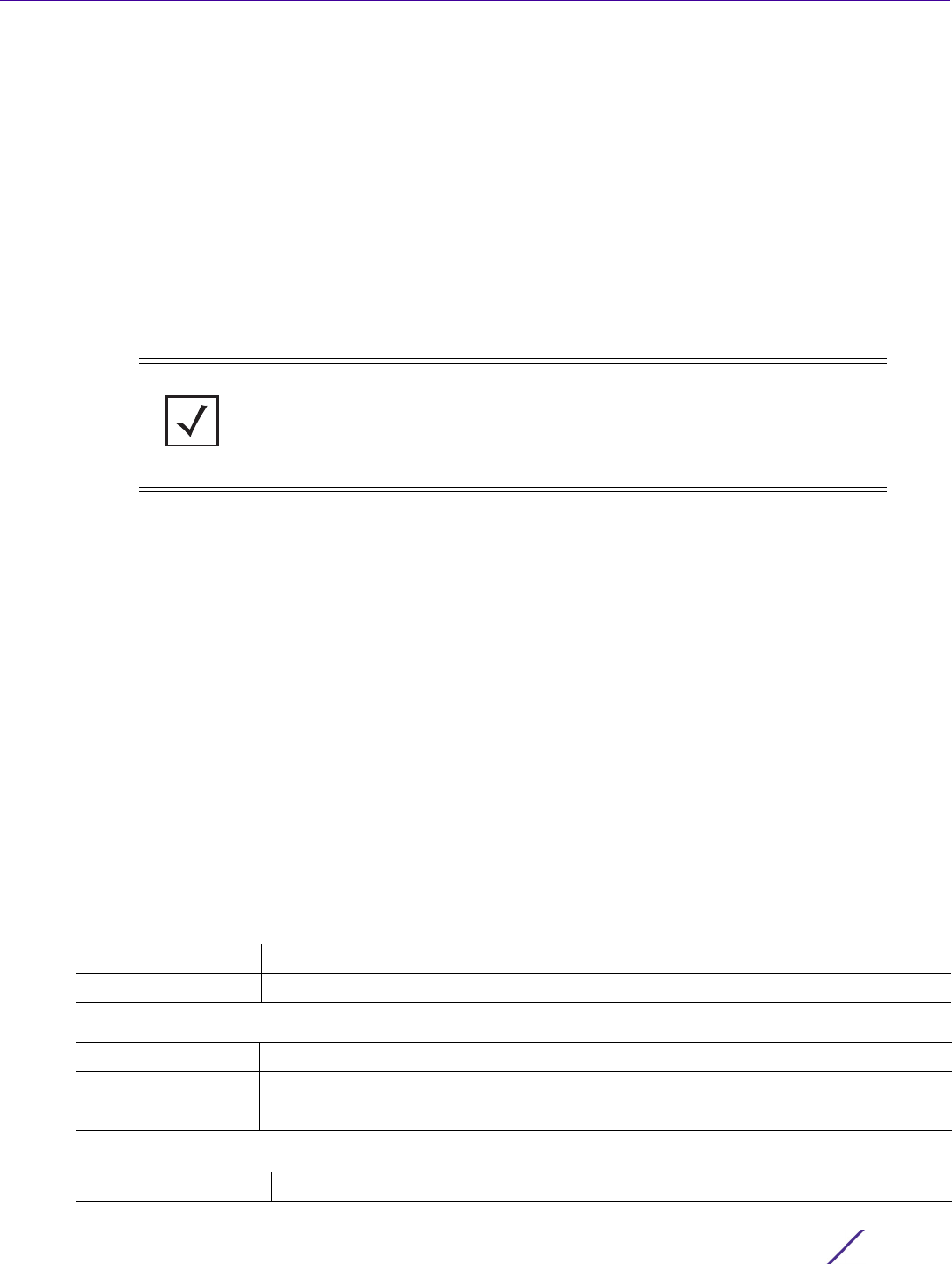
SHOW COMMANDS
Access Point, Wireless Controller and Service Platform CLI Reference Guide 6 - 10
6.1.2 adoption
show commands
Displays adoption related information, and is common to the User Exec, Priv Exec, and Global Config
modes.
In an hierarchically managed (HM) network devices are deployed in two levels. The first level consists of the
Network Operations Center (NOC) controllers. The second level consists of the site controllers. that can be
grouped to form clusters. The NOC controllers adopt and manage the site controllers. Access points within
the network are adopted and managed by the site controllers.
Use this command to confirm if a device is an adoptee or an adopter. This command also allows you to
determine the devices adopted by an adopter device.
Supported in the following platforms:
• Access Points — AP6521, AP6522, AP6532, AP6562, AP7161, AP7502, AP7522, AP7532, AP7562,
AP7602, AP7612, AP7622, AP7632, AP7662, AP81XX, AP8232, AP8432, AP8533
• Wireless Controllers — RFS4000, RFS6000
• Service Platforms — NX5500, NX7500, NX7510, NX7520, NX7530, NX9500, NX9510, NX9600,
VX9000
Syntax
show adoption [config-errors|controllers|history|info|log|offline|pending|status|
timeline]
show adoption offline
show adoption config-errors <DEVICE-NAME>
show adoption log [adoptee|adopter {<MAC>}] {on <DEVICE-NAME>}
show adoption [controllers {include-ipv6}|history|info|pending|status {summary}|
timeline] {on <DEVICE-NAME>}
Parameters
• show adoption offline
• show adoption config-errors <DEVICE-NAME>
• show adoption log [adoptee|adopter {<MAC>}] {on <DEVICE-NAME>}
NOTE: A NOC controller’s capacity is equal to or higher than a site
controller’s capacity. The following devices can be deployed at NOC and
sites:
• NOC controller – RFS6000, NX65XX, NX9500, NX9510, or NX9600.
• Site controller – RFS6000 or RFS4000.
adoption Displays adoption related information. It also displays configuration errors.
offline Displays non-adopted status of the logged device and its adopted access points
adoption Displays adoption related information. It also displays configuration errors.
config-errors
<DEVICE-NAME>
Displays configuration errors for a specified adopted device
• <DEVICE-NAME> – Specify the name of the AP, wireless controller, or service platform.
adoption Displays adoption related information. It also displays configuration errors.

SHOW COMMANDS
Access Point, Wireless Controller and Service Platform CLI Reference Guide 6 - 11
• show adoption [history|controllers {include-ipv6}|info|pending|status
{summary}|timeline] {on <DEVICE-NAME>}
log [adoptee|
adopter {MAC}]
{on <DEVICE-NAME>}
Displays adoption logs, for the specified device. If no device name is specified, the
system displays logs for the logged device.
• adoptee – Displays adoption logs for adoptee devices (APs, wireless controllers, and
service platforms). To view logs for a specified adoptee, specify the device’s name. If
no device name is specified, the system displays logs for the logged device. If the
logged device is not an adoptee, the system states that the device is a controller. For
example, 2013-01-19 22:00:13:MLCP_TAG_CLUSTER_MASTER not present
and this device is a controller. Ignoring
• on <DEVICE-NAME> – Optional. Displays adoptee status and details for the device
identified by the <DEVICE-NAME> keyword
• <DEVICE-NAME> – Specify the device’s name.
• adopter – Displays adoption logs for adopter devices (APs, wireless controllers, and
service platforms). To view logs for a specified adopter, specify the device’s name. If
no device name is specified, the system displays logs for the logged device.
• <MAC> – Optional. Filters adopters by the adoptee device’s MAC address. Specify
the adoptee device’s MAC address. The system displays logs for the device that has
adopted the device identified by the <MAC> keyword.
• on <DEVICE-NAME> – Optional. Displays adopter status and details for the device
identified by the <DEVICE-NAME> keyword.
• <DEVICE-NAME> – Specify the adopter device’s name.
A wireless controller or service platform cannot be configured as an adoptee and an
adopter simultaneously. In other words, an adopted wireless controller or service
platform cannot be configured to adopt another device and vice versa.
adoption Displays adoption related information. It also displays configuration errors.
controllers
{include-ipv6}
Displays information about adopted controllers. This is applicable in a Hierarchically
managed network, where site controllers are adopted by the NOC controllers.
• include-ipv6 – Optional. Displays the controller’s IPv6 address, if assigned, in the
output
history Displays adoption history of the logged device and its adopted access points
info Displays adopted device information
pending Displays information for devices pending adoption
status {summary} Displays adoption status for the logged device. When executed without using the ‘on
<DEVICE-NAME>’ parameter, this command displays detailed information of all
devices adopted by the device on which the command is executed.
• summary – Optional. Displays a summary of all devices adopted by the logged
device.
timeline Displays the logged device’s adoption timeline. It also shows the adoption time for
logged device’s adopted APs. To view the adoption timeline of a specific device, use
the on <device-name> option to specify the device.
on <DEVICE-NAME> The following keywords are common to all of the above parameters:
• on <DEVICE-NAME> – Optional. Displays a device’s adoption information, based on
the parameter passed.
• <DEVICE-NAME> – Specify the name of the AP, wireless controller, or service plat-
form.

SHOW COMMANDS
Access Point, Wireless Controller and Service Platform CLI Reference Guide 6 - 12
Usage Guidelines
In a device’s Global Config mode, use the customize > show-adoption-status command to customize the
show > adoption > status command output. The following columns can be added to the output:
nx9500-6C8809(config)#customize show-adoption-status ?
adopted-by Device name to which the AP is adopted
ap-name Host-name of the adopted AP
cdp-lldp-info Cdp/lldp info of the Adopted AP
config-status Configuration status of the adopted AP
last-adoption Last known adoption time
msgs Messages status
uptime Uptime of the adopted AP
version Current version of the adopted AP
nx9500-6C8809(config)#
For more information on the customise command, see customize.
Example
The following example displays details of the:
• device to which the logged device (rfs6000-81742D) is adopted, and
•devices adopted (
ap7532-A2A4B0, ap7532-80C2AC, ap7562-84A224, etc.) by the logged device.
rfs6000-81742D(config)#show adoption status
Adopted by:
Type : nx9000
System Name : nx9500-6C8809
MAC address : B4-C7-99-6C-88-09
MiNT address : 19.6C.88.09
Time : 7 days 01:02:34 ago
Adopted Devices:
--------------------------------------------------------------------------------
-------------------------------
DEVICE-NAME VERSION CFG-STAT MSGS ADOPTED-BY LAST-
ADOPTION UPTIME
--------------------------------------------------------------------------------
-------------------------------
ap7532-A2A4B0 5.9.1.0-012D configured No rfs6000-81742D 0 days
23:42:11 0 days 23:46:12
Snap004...ssPoint 5.9.1.0-012D configured No rfs6000-81742D 1 days
00:25:33 1 days 02:30:57
ap7532-80C2AC 5.9.1.0-012D error Yes rfs6000-81742D 1 days
00:10:00 1 days 00:11:40
ap7562-84A224 5.9.1.0-012D configured No rfs6000-81742D 1 days
00:23:12 1 days 02:13:48
-More--
rfs6000-81742D(config)#
nx9500-6C8809#show adoption info
--------------------------------------------------------------------------------
--------------------
HOST-NAME MAC TYPE MODEL
SERIAL-NUMBER
--------------------------------------------------------------------------------
--------------------
rfs6000-81742D 00-15-70-81-74-2D rfs6000 RFS-6010-1000-WR
7295520400121
t5-ED7C6C B4-C7-99-ED-7C-6C t5 TS-0524-WR
14213522400004
--------------------------------------------------------------------------------
--------------------
Total number of devices displayed: 2
nx9500-6C8809#

SHOW COMMANDS
Access Point, Wireless Controller and Service Platform CLI Reference Guide 6 - 13
nx9500-6C8809#show adoption status
--------------------------------------------------------------------------------
-------------------------------
DEVICE-NAME VERSION CFG-STAT MSGS ADOPTED-BY LAST-
ADOPTION UPTIME
--------------------------------------------------------------------------------
-------------------------------
rfs6000-81742D 5.9.1.0-012D configured No nx9500-6C8809 7 days
01:06:02 7 days 01:08:45
t5-ED7C6C 5.4.2.0-010R configured No nx9500-6C8809 7 days
01:22:09 114 days 04:37:10
--------------------------------------------------------------------------------
--------------------------------
Total number of devices displayed: 2
nx9500-6C8809#
nx9500-6C8809#show adoption offline
-----------------------------------------
MAC HOST-NAME TYPE RF-DOMAIN TIME OFFLINE
CONNECTED-TO
--------------------------------------------------------------------------------
-------
00-23-68-11-E6-C4 ap71xx-11E6C4 ap71xx TechPubs unknown
None
00-23-68-9C-63-D4 ap7131-9C63D4 ap71xx default unknown
None
5C-0E-8B-A6-57-80 ap650-A65780 ap650 default unknown
None
5C-0E-8B-A6-ED-14 ap650-A6ED14 ap650 default unknown
None
84-24-8D-16-01-C4 ap7532-1601C4 ap7532 default unknown
None
B4-C7-99-4B-F3-64 ap7131-4BF364 ap71xx default unknown
None
--------------------------------------------------------------------------------
-------
Total number of devices displayed: 6
nx9500-6C8809#
rfs6000-81742D#show adoption log adoptee on ap7532-80C2AC
2017-04-05 10:19:56:Received OK from cfgd, adoption complete to 70.81.74.2D
2017-04-05 10:19:56:Waiting for cfgd OK, adopter should be 70.81.74.2D
2017-04-05 10:19:56:Adoption state change: 'Connecting to adopter' to 'Waiting for
Adoption OK'
2017-04-05 10:19:56:Adoption state change: 'Adoption failed' to 'Connecting to
adopter'
2017-04-05 10:19:56:Try to adopt to 70.81.74.2D (cluster master 70.81.74.2D in
adopters)
2017-04-05 10:19:27:Ignoring MLCP Offer, vlan_state MLCP_DONE != MLCP_DISCOVERING
/ MLCP_STP_WAITING
--More--
rfs6000-81742D#
nx9500-6C8809#show adoption controllers include-ipv6
--------------------------------------------------------------------------------
--------------------------------------------------
NAME RF-DOMAIN MAC MINT-ID
IP IPV6 ADOPTED-BY
--------------------------------------------------------------------------------
--------------------------------------------------
rfs6000-81742D TechPubs 00-15-70-81-74-2D 70.81.74.2D
192.168.13.24 :: nx9500-6C8809
--------------------------------------------------------------------------------
--------------------------------------------------
Total number of devices displayed: 1
nx9500-6C8809#
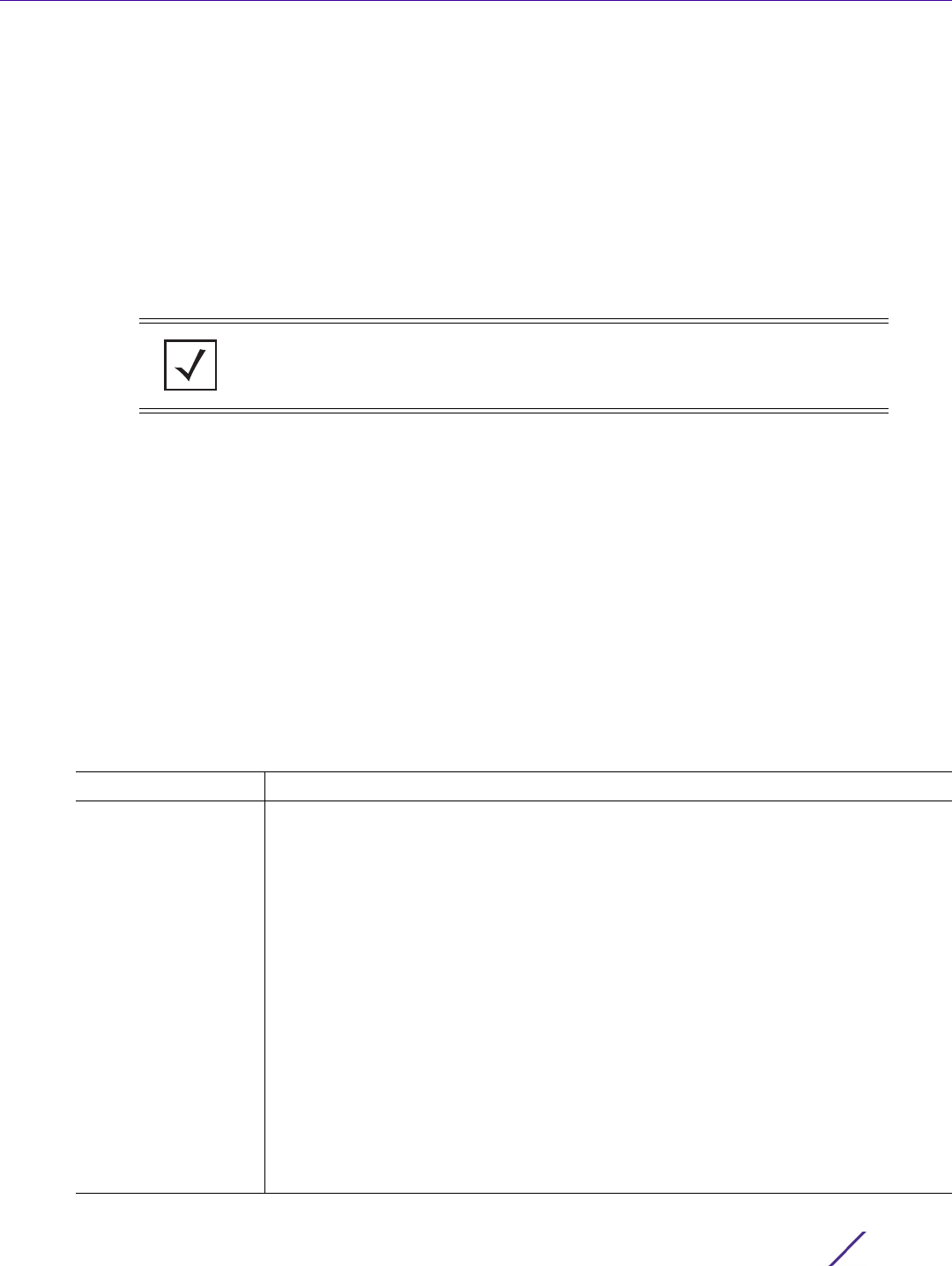
SHOW COMMANDS
Access Point, Wireless Controller and Service Platform CLI Reference Guide 6 - 14
6.1.3 bluetooth
show commands
Displays Bluetooth radio statistics for RF Domain member access points
AP8432 and AP8533 model access points utilize a built-in Bluetooth chip for specific Bluetooth functional
behaviors in a WiNG managed network. AP8432 and AP8533 models support both Bluetooth classic and
Bluetooth low energy (BLE) technology. These platforms use their Bluetooth classic enabled radio to sense
other Bluetooth enabled devices and report device data (MAC address, RSSI and device calls) to an ADSP
server for intrusion detection. If the device presence varies in an unexpected manner, ADSP can raise an
alarm.
AP8432 and AP8533 model access points support Bluetooth beaconing to emit either iBeacon or
Eddystone-URL beacons. The access point’s Bluetooth radio sends non-connectable, undirected low-energy
(LE) advertisement packets periodically. These advertisement packets are short and sent on Bluetooth
advertising channels that conform to already-established iBeacon and Eddystone-URL standards.
Supported in the following platforms:
• Access Points — AP8432, AP8533
Syntax
show bluetooth radio {detail|on}
show bluetooth radio {detail {<DEVICE-NAME> <1-1>|filter bluetooth-radio-mac <BT-
RADIO-MAC>}} {(on <DEVICE-OR-DOMAIN-NAME>)}
Parameters
• show bluetooth radio {detail {<DEVICE-NAME> <1-1>|filter bluetooth-radio-mac
<BT-RADIO-MAC>}} {(on <DEVICE-OR-DOMAIN-NAME>)}
NOTE: AP8132 model access points support an external USB Bluetooth radio
providing ADSP Bluetooth classic sensing functionality only, not the BLE
beaconing functionality available for AP8432 and AP8533 model access
points described in this section.
bluetooth radio Displays Bluetooth radio utilization statistics based on the parameters passed
detail
<DEVICE-NAME> <1-
1>
Optional. Displays detailed Bluetooth radio utilization statistics. Optionally, to view
detailed information for a specific access point’s Bluetooth radio, specify the access
point’s and the radio’s MAC addresses.
• <DEVICE-NAME> <1-1> – Optional. Specify the access point’s hostname or MAC
address.
• <1-1> – Specify the bluetooth radio interface index number from 1 - 1. As of now only
one Bluetooth radio interface is supported. The Interface index number is appended
to the AP’s hostname or MAC address in the following format: ap8533-06FBE1:B1 OR
74-67-F7-06-FB-E1:B1
The following information is displayed:
• access point’s hostname as its network identifier
•access point
’s alias. If an alias has been defined for the access point its listed here.
The alias value is expressed in the form of
<hostname>:B<Bluetooth_radio_number>. If the access point has a administrator
assigned hostname, it is used in place of the access point’s default hostname.
Contd..

SHOW COMMANDS
Access Point, Wireless Controller and Service Platform CLI Reference Guide 6 - 15
Example
nx9500-6C8809(config)#show bluetooth radio on ap8533-06F808
-----------------------------------------------------------------------------
BLUETOOTH RADIO RADIO MAC MODES STATE
-----------------------------------------------------------------------------
ap8533-06F808:B1 74-67-F7-08-A3-B0 BLE-Beacon On
-----------------------------------------------------------------------------
Total number of Bluetooth radios displayed: 0
nx9500-6C8809(config)#
nx9500-6C8809(config)#show bluetooth radio detail 74-67-F7-06-F8-08 1
Radio: 74-67-F7-06-F8-08:B1, alias ap8533-06F808:B1
STATE : Off [shutdown in cfg]
PHY INFO : MAC: 74-67-F7-08-A3-B0
ACCESS POINT : Name: ap8533-06F808 Location: default Placement: Indoor
ENABLED MODES : BLE-Beacon
BEACON TYPES : Eddystone-URL
BEACON PERIOD : 1000ms
Last error :
nx9500-6C8809(config)#
contd.. • access point’s factory encoded MAC address
• access point and bluetooth radio’s administrator assigned area of deployment (the
AP’s geographical location)
• bluetooth radio’s state (on/off)
• bluetooth radio’s reason for inactivity (in case the radio is off)
• bluetooth radio’s factory encoded MAC address serving as this device’s hardware
identifier on the network
• bluetooth radio’s functional mode: bt-sensor or le-beacon
• bluetooth radio’s beacon period
• bluetooth radio’s beacon type
• descriptive text on any error that’s preventing the Bluetooth radio from operating
filter bluetooth-radio-
mac
<BT-RADIO-MAC>
Optional. Specifies additional filters to get table values. Filters data based on the
Bluetooth radio’s MAC address.
• <BT-RADIO-MAC> – Specify the Bluetooth radio’s MAC address. The system only
displays statistics related to the specified Bluetooth radio.
on <DEVICE-OR-
DOMAIN-NAME>
The following keywords are recursive and common to all of the above.
• on <DEVICE-OR-DOMAIN-NAME> – Optional. Displays Bluetooth radio statistics on a
specified device or RF Domain
• <DEVICE-OR-DOMAIN-NAME> – Specify the name of the device or RF Domain. If
the device name is explicitly given, the results display data for the specified AP only.
If the RF Domain is explicitly given, the results display data for all APs within the spec-
ified RF Domain.
If no device/RF Domain is specified, the results include data for all Bluetooth radios
within the controller’s RF Domain.
If the controller is in the “on rf-domain all” mode, the results include data for all
Bluetooth radios for all APs in each domain known to the controller.

SHOW COMMANDS
Access Point, Wireless Controller and Service Platform CLI Reference Guide 6 - 16
6.1.4 boot
show commands
Displays a device’s boot configuration. Use this command to view the primary and secondary image
details, such as Build Date, Install Date, and Version. This command also displays the current boot and next
boot information.
Supported in the following platforms:
• Access Points — AP6521, AP6522, AP6532, AP6562, AP7161, AP7502, AP7522, AP7532, AP7562,
AP7602, AP7612, AP7622, AP7632, AP7662, AP81XX, AP8232, AP8432, AP8533
• Wireless Controllers — RFS4000, RFS6000
• Service Platforms — NX5500, NX7500, NX7510, NX7520, NX7530, NX9500, NX9510, NX9600,
VX9000
Syntax
show boot {on <DEVICE-NAME>}
Parameters
• show boot {on <DEVICE-NAME>}
Example
nx9500-6C8809#show boot
--------------------------------------------------------------------------------
IMAGE BUILD DATE INSTALL DATE VERSION
--------------------------------------------------------------------------------
Primary 05/31/2017 22:24:22 06/02/2017 14:22:51 5.9.0.0-029R
Secondary 05/27/2017 01:00:26 05/30/2017 10:35:55 5.9.0.0-028B
--------------------------------------------------------------------------------
Current Boot : Primary
Next Boot : Primary
Software Fallback : Enabled
VM support : Not present
nx9500-6C8809#
nx9500-6C8809#show boot on TechPubs/rfs6000-6DB5D4
--------------------------------------------------------------------------------
IMAGE BUILD DATE INSTALL DATE VERSION
--------------------------------------------------------------------------------
Primary 05/31/2017 22:24:22 06/02/2017 14:22:51 5.9.0.0-029R
Secondary 05/27/2017 01:00:26 05/30/2017 10:35:55 5.9.0.0-028B
--------------------------------------------------------------------------------
Current Boot : Primary
Next Boot : Primary
Software Fallback : Enabled
VM support : Not present
nx9500-6C8809#
boot Displays primary and secondary image boot configuration details (build date, install
date, version, and the image used to boot the current session)
on <DEVICE-NAME> Optional. Displays a specified device’s boot configuration
• <DEVICE-NAME> – Specify the name of the AP, wireless controller, or service
platform.
Note: Use the on <DEVICE-NAME> option to view a remote device’s boot configuration.

SHOW COMMANDS
Access Point, Wireless Controller and Service Platform CLI Reference Guide 6 - 17
6.1.5 bonjour
show commands
Displays the configured Bonjour services available on local and remote sites
Supported in the following platforms:
• Access Points — AP6521, AP6522, AP6532, AP6562, AP7161, AP7502, AP7522, AP7532, AP7562,
AP7602, AP7612, AP7622, AP7632, AP7662, AP81XX, AP8232, AP8432, AP8533
• Wireless Controllers — RFS4000, RFS6000
• Service Platforms — NX5500, NX7500, NX7510, NX7520, NX7530, NX9500, NX9510, NX9600,
VX9000
Syntax
show bonjour services {on <DEVICE-NAME>}
Parameters
• show bonjour services {on <DEVICE-NAME>}
Example
rfs6000-81742D#show bonjour services on ap7131-11E6C4
--------------------------------------------------------------------------------
----------------------------------------------------------------------
SERVICE_NAME INSTANCE_NAME IP:PORT
VLAN-ID VLAN_TYPE EXPIRY
--------------------------------------------------------------------------------
----------------------------------------------------------------------
_pdl-datastream._tcp.local Brother MFC-8510DN._pdl-datastream._tcp.local
172.110.0.146:9100 110 Local Tue Sep 12 02:07:44 2017
_universal._sub._ipp._tcp.local Brother MFC-8510DN._ipp._tcp.local
172.110.0.146:631 110 Local Tue Sep 12 02:36:13 2017
_ipp._tcp.local Brother MFC-8510DN._ipp._tcp.local
172.110.0.146:631 110 Local Tue Sep 12 02:36:13 2017
--------------------------------------------------------------------------------
--------------------------------------------------------------------------------
--------------
rfs6000-81742D#
bonjour services Displays the configured Bonjour services available on local and remote sites
on <DEVICE-NAME> Optional. Displays Bonjour services available on a specified device
• <DEVICE-NAME> – Specify the name of the AP, wireless controller, or service
platform.

SHOW COMMANDS
Access Point, Wireless Controller and Service Platform CLI Reference Guide 6 - 18
6.1.6 captive-portal
show commands
Displays WLAN captive portal information. Use this command to view a configured captive portal’s client
information.
Supported in the following platforms:
• Access Points — AP6521, AP6522, AP6532, AP6562, AP7161, AP7502, AP7522, AP7532, AP7562,
AP7602, AP7612, AP7622, AP7632, AP7662, AP81XX, AP8232, AP8432, AP8533
• Wireless Controllers — RFS4000, RFS6000
• Service Platforms — NX5500, NX7500, NX7510, NX7520, NX7530, NX9500, NX9510, NX9600,
VX9000
Syntax
show captive-portal sessions {include-ipv6|on <DEVICE-OR-DOMAIN-NAME>|
statistics} {(filter [captive-portal [<CAPTIVE-PORTAL>|not <CAPTIVE-PORTAL>]|
ip [<IPv4>|not <IPv4>]|ipv6 [<IPv6>|not <IPv6>]|state [pending|success|not
[pending|success]|vlan [<VLAN-ID>|not <VLAN-ID>]|wlan [<WLAN-NAME>|not <WLAN-
NAME>]])}
Parameters
• show captive-portal sessions {include-ipv6|on <DEVICE-OR-DOMAIN-NAME>|
statistics} {(filter [captive-portal [<CAPTIVE-PORTAL>|not <CAPTIVE-PORTAL>]|ip
[<IPv4>|not <IPv4>]|ipv6 [<IPv6>|not <IPv6>]|state [pending|success|not
[pending|success]|vlan [<VLAN-ID>|not <VLAN-ID>]|wlan [<WLAN-NAME>|not <WLAN-
NAME>]])}
captive-portal
sessions
Displays active captive portal client session details
include-ipv6 Optional. Includes IPv6 address (if known) of captive portal clients
By default the system only displays IPv4 addresses. The include-ipv6 parameter
includes IPv6 address (if known) of each client.
statistics Optional. Displays statistical information regarding client sessions
on <DEVICE-OR-
DOMAIN-NAME>
Optional. Displays active captive portal session details on a specified device or RF
Domain.
• <DEVICE-OR-DOMAIN-NAME> – Specify the name of the AP, wireless controller,
service platform, or RF Domain.
filter This parameter is recursive and can be used with any of the above parameters to
define additional filters.
Optional. Defines additional filters. Use one of the following options: captive-portal,
ip, ipv6, state, vlan, or wlan.
captive-portal
[<CAPTIVE-PORTAL>|
not <CAPTIVE-
PORTAL>]
Optional. Displays captive portal client and client session information, based on the
captive portal name passed
• <CAPTIVE-PORTAL> – Specify the captive portal name. Displays client details for the
specified captive portal.
• not <CAPTIVE-PORTAL> – Inverts the match selection. Displays client details for all
captive portals other than the specified captive portal.

SHOW COMMANDS
Access Point, Wireless Controller and Service Platform CLI Reference Guide 6 - 19
Example
rfs4000-229D58#show captive-portal sessions
================================================================================
=======
CLIENT IPv4 CAPTIVE-PORTAL WLAN/PORT VLAN STATE SESSION TIME
--------------------------------------------------------------------------------
-------
00-26-55-F4-5F-79 192.168.3.99 cappo rfs4000-229D58:ge2 400 Success
23:58:35
================================================================================
=======
Total number of captive portal sessions displayed: 1
rfs4000-229D58#
ip [<IPv4>|not
<IPv4>]
Optional. Displays captive portal client/client sessions information, based on the IPv4
address passed
• <IPv4> – Specify the client’s IPv4 address. Displays information of the client identified
by the <IPv4> parameter
• not <IPv4> – Inverts the match selection. Displays client details for all clients other
than the one identified by the <IPv4> parameter.
ipv6 [<IPv6>|not
<IPv6>]
This filter option is available only for the ‘include-ipv6’ keyword.
Optional. Displays captive portal client/client sessions information, based on the IPv6
address passed
• <IPv6> – Specify the client’s IPv6 address. Displays information of the client identified
by the <IPv6> parameter
• not <IPv6> – Inverts the match selection. Displays client details for all clients other
than the one identified by the <IPv6> parameter.
state
[pending|success|
not
[pending|success]]
Optional. Filters clients/client sessions based on the client’s authentication state
• pending – Displays information of clients redirected for authentication
• success – Displays information of successfully authenticated clients
• not [pending|success] – Inverts match selection
• pending – Displays information of successfully authenticated clients (opposite of
pending authentication)
• success – Displays information of clients redirected for authentication (opposite of
successful authentication)
vlan [<VLAN-ID>|
not <VLAN-ID>]
Optional. Displays captive portal client/client sessions information based on the
VLAN ID passed
• <VLAN-ID> – Specify the VLAN ID. Displays client details for the specified VLAN.
• not <VLAN-ID> – Inverts match selection. Displays client details for all VLANs other
than the one identified by the <VLAN-ID> parameter.
wlan [<WLAN-
NAME>|
not <WLAN-NAME>]
Optional. Displays captive portal client/client sessions information based on the
WLAN name passed
• <WLAN-NAME> – Specify the WLAN name. Displays client details for the specified
WLAN.
• not <WLAN-NAME> – Inverts match selection. Displays client details for all WLANs
other than the one identified by the <WLAN-NAME> parameter.

SHOW COMMANDS
Access Point, Wireless Controller and Service Platform CLI Reference Guide 6 - 20
6.1.7 captive-portal-page-upload
show commands
Displays captive portal page information, such as upload history, upload status, and page file download
status
Supported in the following platforms:
• Access Points — AP6521, AP6522, AP6532, AP6562, AP7161, AP7502, AP7522, AP7532, AP7562,
AP7602, AP7612, AP7622, AP7632, AP7662, AP81XX, AP8232, AP8432, AP8533
• Wireless Controllers — RFS4000, RFS6000
• Service Platforms — NX5500, NX7500, NX7510, NX7520, NX7530, NX9500, NX9510, NX9600,
VX9000
Syntax
show captive-portal-page-upload [history|list-files|load-image-status|status]
show captive-portal-page-upload load-image-status
show captive-portal-page-upload history {on <RF-DOMAIN-NAME>}
show captive-portal-page-upload status {on [<RF-DOMAIN-NAME>|<RF-DOMAIN-
MANAGER>]}
show captive-portal-page-upload list-files <CAPTIVE-PORTAL-NAME>
Parameters
• show captive-portal-page-upload load-image-status
• show captive-portal-page-upload history {on <RF-DOMAIN-NAME>}
• show captive-portal-page-upload status {on [<RF-DOMAIN-NAME>|<RF-DOMAIN-
MANAGER>]}
• show captive-portal-page-upload list-files <CAPTIVE-PORTAL-NAME>
load-image-status Displays captive portal advanced page file download status on the logged device
history
{on <RF-DOMAIN-
NAME>}
Displays captive portal page upload history
• on <RF-DOMAIN-NAME> – Optional. Displays captive portal page upload history
within a specified RF Domain. Specify the RF Domain name.
status
{on <RF-DOMAIN-
NAME>|
on <RF-DOMAIN-
MANAGER>}
Displays captive portal page upload status
• on <RF-DOMAIN-NAME> – Optional. Displays captive portal page upload status
within a specified RF Domain. Specify the RF Domain name.
• on <RF-DOMAIN-MANAGER> – Optional. Displays captive portal page upload status
for a specified RF Domain Manager. Specify the RF Domain Manager name.
list-files
<CAPTIVE-PORTAL-
NAME>
Displays a list of all captive portal Web page files, of a specified captive portal,
uploaded (internal and advanced page files)
• <CAPTIVE-PORTAL-NAME> – Specify the captive portal name.

SHOW COMMANDS
Access Point, Wireless Controller and Service Platform CLI Reference Guide 6 - 21
Example
nx7500-7F2C13#captive-portal-page-upload CP-BW all
--------------------------------------------------------------------------------
CONTROLLER STATUS MESSAGE
--------------------------------------------------------------------------------
84-24-8D-7F-2C-13 Success Added 1 APs to upload queue
--------------------------------------------------------------------------------
nx7500-7F2C13#
nx7500-7F2C13#show captive-portal-page-upload load-file-status
Download of CP-BW page file is complete
nx7500-7F2C13#
nx7500-7F2C13#show captive-portal-page-upload list-files CP-BW
--------------------------------------------------------------------------------
NAME SIZE LAST MODIFIED
--------------------------------------------------------------------------------
CP-BW-1.tar.gz 6133 2016-05-16 10:38:40
CP-BW.tar.gz 3370 2016-05-16 10:45:44
--------------------------------------------------------------------------------
nx7500-7F2C13#

SHOW COMMANDS
Access Point, Wireless Controller and Service Platform CLI Reference Guide 6 - 22
6.1.8 cdp
show commands
Displays the Cisco Discovery Protocol (CDP) neighbor table
Supported in the following platforms:
• Access Points — AP6521, AP6522, AP6532, AP6562, AP7161, AP7502, AP7522, AP7532, AP7562,
AP7602, AP7612, AP7622, AP7632, AP7662, AP81XX, AP8232, AP8432, AP8533
• Wireless Controllers — RFS4000, RFS6000
• Service Platforms — NX5500, NX7500, NX7510, NX7520, NX7530, NX9500, NX9510, NX9600,
VX9000
Syntax
show cdp [neighbors|report] {detail {on <DEVICE-NAME>}|on <DEVICE-NAME>}
Parameters
• show cdp [neighbors|report] {detail {on <DEVICE-NAME>}|on <DEVICE-NAME>}
Example
The following example shows detailed CDP neighbors table:
nx9500-6C8809#show cdp neighbors detail
-------------------------
Device ID: ap8132-74B45C
Entry address(es):
IP Address: 192.168.13.26
Platform: AP-8132-66040-WR, Capabilities: Router Switch
Interface: ge1, Port ID (outgoing port): ge1
Hold Time: 165 sec
advertisement version: 2
Native VLAN: 1
Duplex: full
Version :
5.8.6.0-008B
-------------------------
Device ID: ap7532-80C2AC
Entry address(es):
IP Address: 192.168.13.28
Platform: AP-7532-67040-WR, Capabilities: Router Switch
Interface: ge1, Port ID (outgoing port): ge1
Hold Time: 169 sec
--More--
nx9500-6C8809#
cdp [neighbors|report] Displays CDP neighbors table or aggregated CDP neighbors table
detail
{on <DEVICE-NAME>}
Optional. Displays detailed CDP neighbors table or aggregated CDP neighbors table
• on <DEVICE-NAME> – Optional. Displays table details on a specified device
• <DEVICE-NAME> – Specify the name of the AP, wireless controller, or service
platform.
on <DEVICE-NAME> Optional. Displays table details on a specified device
• <DEVICE-NAME> – Specify the name of the AP, wireless controller, or service
platform.

SHOW COMMANDS
Access Point, Wireless Controller and Service Platform CLI Reference Guide 6 - 23
The following example shows a non-detailed CDP neighbors table:
rfs6000-81742D#show cdp neighbors
--------------------------------------------------------------------------------
Device ID Platform Local Interface Port ID Duplex
--------------------------------------------------------------------------------
nx9500-6C8809 NX-9500-100R0-WR ge2 ge1 full
rfs6000-81742D RFS-6010-1000-WR ge2 ge1 full
rfs4000-880DA7 RFS-4011-11110-US ge2 ge1 full
ap6521-42936C AP-6521E-60020-WR ge2 ge1 full
--------------------------------------------------------------------------------
rfs6000-81742D#

SHOW COMMANDS
Access Point, Wireless Controller and Service Platform CLI Reference Guide 6 - 24
6.1.9 classify-url
show commands
Displays a specified URL’s category. Use this command to query the category of a specific URL. The query
is sent to a configured classification server. This option is available only if a valid URL filter license is
available.
Supported in the following platforms:
• Access Points — AP6521, AP6522, AP6532, AP6562, AP7161, AP7502, AP7522, AP7532, AP7562,
AP7602, AP7612, AP7622, AP7632, AP7662, AP81XX, AP8232, AP8432, AP8533
• Wireless Controllers — RFS4000, RFS6000
• Service Platforms — NX5500, NX7500, NX7510, NX7520, NX7530, NX9500, NX9510, NX9600,
VX9000
Syntax
show classify-url [<URL-TO-QUERY>|datacenter <URL-TO-QUERY>]
Parameters
• show classify-url [<URL-TO-QUERY>|datacenter <URL-TO-QUERY>]
Example
nx9500-6C8809#show classify-url www.google.com
Categories: search-engines-portals,
Custom Categories:
nx9500-6C8809#
nx9500-6C8809#show classify-url www.ndtv.com
Categories: news,
Custom Categories: list1,
nx9500-6C8809#
classify-url Queries the category of a specified URL
<URL-TO-QUERY> Specify the URL to query. The query is sent to the configured classification server.
datacenter
<URL-TO-QUERY>
The query is sent to a global classification datacenter
• <URL-TO-QUERY> – Specify the URL to query.

SHOW COMMANDS
Access Point, Wireless Controller and Service Platform CLI Reference Guide 6 - 25
6.1.10 clock
show commands
Displays a selected system’s clock
Supported in the following platforms:
• Access Points — AP6521, AP6522, AP6532, AP6562, AP7161, AP7502, AP7522, AP7532, AP7562,
AP7602, AP7612, AP7622, AP7632, AP7662, AP81XX, AP8232, AP8432, AP8533
• Wireless Controllers — RFS4000, RFS6000
• Service Platforms — NX5500, NX7500, NX7510, NX7520, NX7530, NX9500, NX9510, NX9600,
VX9000
Syntax
show clock {on <DEVICE-NAME>}
Parameters
• show clock {on <DEVICE-NAME>}
Example
rfs6000-81742D#show clock
2017-04-06 15:50:42 IST
rfs6000-81742D#
clock Displays a system’s clock
on <DEVICE-NAME> Optional. Displays system clock on a specified device
• <DEVICE-NAME> – Specify the name of the AP, wireless controller, service platform,
or RF Domain.

SHOW COMMANDS
Access Point, Wireless Controller and Service Platform CLI Reference Guide 6 - 26
6.1.11 cluster
show commands
Displays cluster information (cluster configuration parameters, members, status, etc.)
Supported in the following platforms:
• Access Points — AP6521, AP6522, AP6532, AP6562, AP7161, AP7502, AP7522, AP7532, AP7562,
AP7602, AP7612, AP7622, AP7632, AP7662, AP81XX, AP8232, AP8432, AP8533
• Wireless Controllers — RFS4000, RFS6000
• Service Platforms — NX5500, NX7500, NX7510, NX7520, NX7530, NX9500, NX9510, NX9600,
VX9000
Syntax
show cluster [configuration|history|members|status]
show cluster [configuration|history {on <DEVICE-NAME>}|members {detail}|status]
Parameters
• show cluster [configuration|members {detail}|status]
Example
rfs6000-380649(config)#show cluster configuration
Cluster Configuration Information
Name : SiteConRFS6k
Configured Mode : Active
Master Priority : 128
Force configured state : Disabled
Force configured state delay : 5 minutes
Handle STP : Disabled
Radius Counter DB Sync Time : 5 minutes
rfs6000-380649(config)#
rfs6000-380649(config)#show cluster members detail
--------------------------------------------------------------------------------
-------
ID MAC MODE AP COUNT AAP COUNT AP LICENSE AAP
LICENSE VERSION
--------------------------------------------------------------------------------
-------
70.38.06.49 00-15-70-38-06-49 Active 0 1 0 0
5.8.6.0-008B
70.81.74.2D 00-15-70-81-74-2D Active 0 0 1 0
5.8.6.0-008B
--------------------------------------------------------------------------------
-------
rfs6000-380649(config)#
cluster Displays cluster information
configuration Displays cluster configuration details
history on <DEVICE-
NAME>
Displays cluster history status
• <DEVICE-NAME> – Optional. Specify the controller or access point name. If the device
name is not specified, the system displays all cluster history.
members {detail} Displays cluster members configured on the logged device
• detail – Optional. Displays detailed information of known cluster members
status Displays cluster status

SHOW COMMANDS
Access Point, Wireless Controller and Service Platform CLI Reference Guide 6 - 27
rfs6000-380649(config)#show cluster status
Cluster Runtime Information
Protocol version : 1
Cluster operational state : active
AP license : 1
AAP license : 0
AP count : 0
AAP count : 1
Max AP adoption capacity : 256
Number of connected member(s): 1
rfs6000-380649(config)#

SHOW COMMANDS
Access Point, Wireless Controller and Service Platform CLI Reference Guide 6 - 28
6.1.12 cmp-factory-certs
show commands
Displays factory installed CMP certificates
Supported in the following platforms:
• Access Points — AP6521, AP6522, AP6532, AP6562, AP7161, AP7502, AP7522, AP7532, AP7562,
AP7602, AP7612, AP7622, AP7632, AP7662, AP81XX, AP8232, AP8432, AP8533
• Wireless Controllers — RFS4000, RFS6000
• Service Platforms — NX5500, NX7500, NX7510, NX7520, NX7530, NX9500, NX9510, NX9600,
VX9000
Syntax
show cmp-factory-certs {all}
Parameters
• show cmp-factory-certs {all}
Example
nx9500-6C8809>show cmp-factory-certs
No CMP factory certificate exist
nx9500-6C8809>
cmp-factory-certs
{all}
Displays factory installed CMP certificates on the logged device. Optionally use the ‘all’
keyword to view certificate details.

SHOW COMMANDS
Access Point, Wireless Controller and Service Platform CLI Reference Guide 6 - 29
6.1.13 commands
show commands
Displays commands available for the current mode
Supported in the following platforms:
• Access Points — AP6521, AP6522, AP6532, AP6562, AP7161, AP7502, AP7522, AP7532, AP7562,
AP7602, AP7612, AP7622, AP7632, AP7662, AP81XX, AP8232, AP8432, AP8533
• Wireless Controllers — RFS4000, RFS6000
• Service Platforms — NX5500, NX7500, NX7510, NX7520, NX7530, NX9500, NX9510, NX9600,
VX9000
Syntax
show commands
Parameters
None
Example
rfs4000-880DA7(config)#show commands
help
help search WORD (|detailed|only-show|skip-show|skip-no)
show commands
show adoption log adoptee(|on DEVICE-NAME)
show adoption log adopter (|mac AA-BB-CC-DD-EE-FF)(|on DEVICE-NAME)
show adoption info (|on DEVICE-NAME)
show adoption status (|on DEVICE-NAME)
show adoption status summary (|on DEVICE-NAME)
show adoption config-errors DEVICE-NAME
show adoption offline
show adoption pending (|on DEVICE-NAME)
show adoption history (|on DEVICE-NAME)
show adoption timeline (|on DEVICE-NAME)
show adoption controllers (|on DEVICE-NAME)
show adoption controllers include-ipv6(|on DEVICE-NAME)
show debugging (|on DEVICE-OR-DOMAIN-NAME)
show debugging cfgd(|on DEVICE-NAME)
show debugging fib(|on DEVICE-NAME)
show debugging adoption (|on DEVICE-OR-DOMAIN-NAME)
show debugging wireless (|on DEVICE-OR-DOMAIN-NAME)
show debugging snmp (|on DEVICE-NAME)
show debugging ssm (|on DEVICE-NAME)
show debugging voice (|on DEVICE-OR-DOMAIN-NAME)
--More--
rfs4000-880DA7(config)#

SHOW COMMANDS
Access Point, Wireless Controller and Service Platform CLI Reference Guide 6 - 30
6.1.14 context
show commands
Displays the current context details
Supported in the following platforms:
• Access Points — AP6521, AP6522, AP6532, AP6562, AP7161, AP7502, AP7522, AP7532, AP7562,
AP7602, AP7612, AP7622, AP7632, AP7662, NX7500, AP81XX, AP8232, AP8432, AP8533
• Wireless Controllers — RFS4000, RFS6000
• Service Platforms — NX5500, NX7500, NX7510, NX7520, NX7530, NX9500, NX9510, NX9600,
VX9000
Syntax
show context {include-factory|session-config {include-factory}}
Parameters
• show context {include-factory|session-config {include-factory}}
Example
rfs4000-880DA7(config)#show context
!
! Configuration of RFS4000 version 5.9.1.0-015D
!
!
version 2.5
!
!
client-identity-group default
load default-fingerprints
!
ip snmp-access-list default
permit any
!
firewall-policy default
no ip dos tcp-sequence-past-window
!
!
mint-policy global-default
!
radio-qos-policy default
!
auto-provisioning-policy 4K
!
--More--
rfs4000-880DA7(config)#
include-factory Optional. Includes factory defaults
session-config
{include-factory}
Optional. Displays running system information in the current context
• include-factory – Optional. Includes factory defaults

SHOW COMMANDS
Access Point, Wireless Controller and Service Platform CLI Reference Guide 6 - 31
6.1.15 critical-resources
show commands
Displays critical resource information. Critical resources are resources vital to the network.
Supported in the following platforms:
• Access Points — AP6521, AP6522, AP6532, AP6562, AP7161, AP7502, AP7522, AP7532, AP7562,
AP7602, AP7612, AP7622, AP7632, AP7662, AP81XX, AP8232, AP8432, AP8533
• Wireless Controllers — RFS4000, RFS6000
• Service Platforms — NX5500, NX7500, NX7510, NX7520, NX7530, NX9500, NX9510, NX9600,
VX9000
Syntax
show critical-resources {on <DEVICE-NAME>}
Parameters
• show critical-resources {on <DEVICE-NAME>}
Example
rfs4000-229D58(config)#show critical-resources
--------------------------------------------------------------------------
CRITICAL RESOURCE IP VLAN PING-MODE STATE
--------------------------------------------------------------------------
172.168.1.103 1 arp-icmp up
--------------------------------------------------------------------------
rfs4000-229D58(config)#
critical-resources Displays critical resources information
on <DEVICE-NAME> Optional. Displays critical resource information on a specified device
• <DEVICE-NAME> – Specify the name of the AP, wireless controller, or service
platform.

SHOW COMMANDS
Access Point, Wireless Controller and Service Platform CLI Reference Guide 6 - 32
6.1.16 crypto
show commands
Displays encryption mode information
Supported in the following platforms:
• Access Points — AP6521, AP6522, AP6532, AP6562, AP7161, AP7502, AP7522, AP7532, AP7562,
AP7602, AP7612, AP7622, AP7632, AP7662, AP81XX, AP8232, AP8432, AP8533
• Wireless Controllers — RFS4000, RFS6000
• Service Platforms — NX5500, NX7500, NX7510, NX7520, NX7530, NX9500, NX9510, NX9600,
VX9000
Syntax
show crypto [cmp|ike|ipsec|key|pki]
show crypto cmp request status
show crypto ike sa {detail|on|peer|version}
show crypto ike sa {detail|peer <IP>} {on <DEVICE-NAME>}
show crypto ike sa {version [1|2]} {peer <IP>} {(on <DEVICE-NAME>)}
show crypto ipsec sa {detail|on|peer}
show crypto ipsec sa {detail} {on <DEVICE-NAME>}
show crypto ipsec sa {peer <IP>} {detail} {(on <DEVICE-NAME>)}
show crypto key rsa {on|public-key-detail}
show crypto key rsa {public-key-detail} {(on <DEVICE-NAME>)}
show crypto pki trustpoints {<TRUSTPOINT-NAME>|all|on}
show crypto pki trustpoints {<TRUSTPOINT-NAME>|all} {(on <DEVICE-NAME>)}
Parameters
• show crypto cmp request status
• show crypto ike sa {detail|peer <IP>} {on <DEVICE-NAME>}
crypto cmp request
status
Displays current status of in-progress certificate management protocol (CMP)
requests
For more information, see CRYPTO-CMP-POLICY.
crypto ike sa Displays Internet Key Exchange (IKE) security association (SA) statistics
detail Displays detailed IKE SA statistics
peer <IP> Optional. Displays IKE SA statistics for a specified peer
• <IP> – Specify the peer’s IP address in the A.B.C.D format
on <DEVICE-NAME> Optional. Displays IKE SA statistics on a specified device
• <DEVICE-NAME> – Specify the name of the AP, wireless controller, or service
platform.

SHOW COMMANDS
Access Point, Wireless Controller and Service Platform CLI Reference Guide 6 - 33
• show crypto ike sa {version [1|2]} {peer <IP>} {(on <DEVICE-NAME>)}
• show crypto ipsec sa {detail} {on <DEVICE-NAME>}
• show crypto sa {peer <IP>} {detail} {(on <DEVICE-NAME>)}
• show crypto key rsa {public-key-detail} {(on <DEVICE-NAME>)}
• show crypto pki trustpoints {<TRUSTPOINT-NAME>|all} {(on <DEVICE-NAME>)}
crypto ike sa Displays IKE SA details
version [1|2] Optional. Displays IKE SA version statistics
•1 – Displays IKEv1 statistics
• 2 – Displays IKEv2 statistics
peer <IP> Optional. Displays IKE SA version statistics for a specified peer
• <IP> – Specify the peer’s IP address in the A.B.C.D format
on <DEVICE-NAME> The following keyword is recursive and common to the ‘peer ip’ parameter:
• on <DEVICE-NAME> – Optional. Displays IKE SA statistics on a specified device
• <DEVICE-NAME> – Specify the name of the AP, wireless controller, or service
platform.
crypto ipsec sa Displays Internet Protocol Security (IPSec) SA statistics. The IPSec encryption
authenticates and encrypts each IP packet in a communication session
detail Optional. Displays detailed IPSec SA statistics
on <DEVICE-NAME> Optional. Displays IPSec SAs on a specified device
• <DEVICE-NAME> – Specify the name of the AP, wireless controller, or service
platform.
crypto ipsec sa Displays IPSec SA statistics. The IPSec encryption authenticates and encrypts each
IP packet in a communication session
peer <IP> detail Optional. Displays IPSec SA statistics for a specified peer
• <IP> – Specify the peer’s IP address in the A.B.C.D format.
• detail – Displays detailed IPSec SA statistics for the specified peer
on <DEVICE-NAME> The following keyword is recursive:
• on <DEVICE-NAME> – Optional. Displays IPSec SAs on a specified device
• <DEVICE-NAME> – Specify the name of the AP, wireless controller, or service
platform.
crypto key rsa Displays RSA public keys
public-key-detail Optional. Displays public key in the Privacy-Enhanced Mail (PEM) format
on <DEVICE-NAME> The following keyword is recursive:
• on <DEVICE-NAME> – Optional. Displays public key on a specified device
• <DEVICE-NAME> – Specify the name of the AP, wireless controller, or service
platform.
crypto pki Displays PKI related information
trustpoints Displays WLAN trustpoints
This command displays all trustpoints including CMP-generated trustpoints.
<TRUSTPOINT-NAME> Optional. Displays a specified trustpoint details. Specify the trustpoint name.

SHOW COMMANDS
Access Point, Wireless Controller and Service Platform CLI Reference Guide 6 - 34
Example
nx9500-6C8809(config)#show crypto key rsa public-key-detail
RSA key name: ting Key-length: 2048
-----BEGIN PUBLIC KEY-----
MIIBIjANBgkqhkiG9w0BAQEFAAOCAQ8AMIIBCgKCAQEAtLj11yR38+/mcInGRlrw
3DaasuTJhKsWg7kcSVkM7RLd/Wq/mPZEsqwFLnvFIm4rVIke+mVdWBqV4oGE1TUm
Z4YqKtzlANSAG7EZREr3MXEIHd49NHYeK8U+1EAmHN9F21XCxTO+yRMngKDJeHfz
Za2/64PdBsnRlV4nqCGMGHbbaaCwGe5X0a
RSA key name: default_rsa_key Key-length: 2048
-----BEGIN PUBLIC KEY-----
MIIBIjANBgkqhkiG9w0BAQEFAAOCAQ8AMIIBCgKCAQEA3hyJDk9aMk97X3PhoyMb
6nufFLFUkpF9YwSqO2fNyp9SutqpoML/VAMHHotmaa6SsxPURF8mC66bT7De32r7
wwPd7pIWwALTscwCzd3CrB1jY8s2OQ7ZHGCH6MLau+LeoNPE0c+uH3tNLloTAvSG
xtUAHfwFa4rM6vlzs/ejJ4InnboI8i4uIA
nx9500-6C8809(config)#
nx9500-6C8809(config)#show crypto key rsa
--------------------------------------------------------------------------------
# KEY NAME KEY LENGTH
--------------------------------------------------------------------------------
1 ting 2048
2 default_rsa_key 2048
--------------------------------------------------------------------------------
nx9500-6C8809(config)#
nx9500-6C8809(config)#show crypto pki trustpoints all
Trustpoint Name: default-trustpoint (self signed)
-------------------------------------------------------------------------------
CRL present: no
Server Certificate details:
Key used: default_rsa_key
Serial Number: 051d
Subject Name:
/CN=NX9500-B4-C7-99-6C-88-09
Issuer Name:
/CN=NX9500-B4-C7-99-6C-88-09
Valid From : Thu Dec 5 04:15:59 2013 UTC
Valid Until: Sun Dec 3 04:15:59 2023 UTC
nx9500-6C8809(config)#
nx9500-6C8809>show crypto cmp request status
CMP Request Status: ir-req-reset
nx9500-6C8809>
all Optional. Displays details of all trustpoints
on <DEVICE-NAME> The following keyword is recursive and common to the ‘trustpoint-name’ and ‘all’
parameters:
• on <DEVICE-NAME> – Optional. Displays trustpoints configured on a specified
device
• <DEVICE-NAME> – Specify the name of the AP, wireless controller, or service
platform.

SHOW COMMANDS
Access Point, Wireless Controller and Service Platform CLI Reference Guide 6 - 35
6.1.17 database
show commands
Displays database-related statistics and status
Supported in the following platforms:
• Service Platforms — NX9500, NX9510, VX9000
Syntax
show database [backup-status|keyfile|restore-status|statistics|status|users] {on
<DEVICE-NAME>}
Parameters
• show database [backup-status|keyfile|restore-status|statistics|status|users]
{on <DEVICE-NAME>}
Example
vx9000-D031F2(config)#show database backup-status detail
Last Database Backup Status : Failed(Error in ftp: 1)
Last Database Backup Time : 2017-04-11 08:03:10
-----------------------------------------------
Starting backup of mart ...
connected to: 127.0.0.1
2015-05-20T14:02:46.340+0530 DATABASE: mart to dump/mart
2015-05-20T14:02:46.341+0530 mart.system.indexes to dump/mart/
system.indexes.bson
2015-05-20T14:02:46.341+0530 61 documents
2015-05-20T14:02:46.341+0530 mart.wlan_info to dump/mart/wlan_info.bson
2015-05-20T14:02:46.341+0530 5 documents
2015-05-20T14:02:46.342+0530 Metadata for mart.wlan_info to dump/mart/
wlan_info.metadata.json
2015-05-20T14:02:46.342+0530 mart.rf_domain_info to dump/mart/
rf_domain_info.bson
2015-05-20T14:02:46.342+0530 21 documents
2015-05-20T14:02:46.342+0530 Metadata for mart.rf_domain_info to dump/mart/
rf_domain_info.metadata.json
--More--
vx9000-D031F2(config)#
database Displays all configured database-related statistics and status
backup-status Displays the last database backup status
keyfile Displays the keyfiles generated on the database host to enable authenticated
database access
back-restore Displays the last database restore status
statistics Displays database-related statistics, such as name of the database (NSight or
captive portal), data size, storage size, free disk space available, etc.
status Displays database status, such as online time.
users Displays database users created. These are the users that can access the databases.
on <DEVICE-NAME> Optional. Displays database-related information on a specified device
• <DEVICE-NAME> – Specify the name of the AP, wireless controller, or service
platform.

SHOW COMMANDS
Access Point, Wireless Controller and Service Platform CLI Reference Guide 6 - 36
vx9000-D031F2(config)#show database status
--------------------------------------------------------------------------------
MEMBER STATE ONLINE TIME
--------------------------------------------------------------------------------
localhost PRIMARY 2 days 3 hours 45 min 24 sec
--------------------------------------------------------------------------------
Authentication: Disabled Authentication User: None
--------------------------------------------------------------------------------
[*] indicates this device.
vx9000-D031F2(config)#
vx9000-D031F2(config)#show database statistics
--------------------------------------------------------------------------------
DATABASE STORAGE SIZE DATA SIZE INDEX SIZE DISK FREE
--------------------------------------------------------------------------------
admin 32k 335 48k 594.5G
captive-portal 4k 0 24k 594.5G
nsightcache 96k 2.0k 264k 594.5G
nsight 26.1M 136.6M 18.9M 594.5G
--------------------------------------------------------------------------------
vx9000-D031F2(config)#
nx9500-6C8809#show database keyfile
SLz6lVXyi9vyTCChUKs04THRo3mWOjZheM58Dt6NC0MDkdgV+5+wWN9/IT6zfy1s
KPut4BPpUWyM8MEaRmapg4kRrN/SMSMlH6sPITMGTLMu6wRYFEUgKgO01Wn/BohE
5n+uuhY0xiZQsN0LS7IaA8Yb9rX859YRQ7v9By5aEpi1NIDR4KX09Xs3TqIB+5v2
jE3vv7OsKK+LX63bCIoYo35MX251T2pHdL+fMdLfKPMt8ZbzYzx2b22Yvukfg0gm
xHsMCB+bLAsfkjeCPgHCAq/WWi3Kxna6ysFjp8J4US2Bm+GL1COvALbCQBwkPPN+
o7M90qT40AubibBkeID2S9rkQkKcXqGESbL5xG6ip+26jIxiLv7GP6/SQZGFOqC/
ZZEkCNhGhkiyktiOIxBfoXwoy66sqQ4KBwLF449eqBe7Svel/dzpFPNfYZpW8SMY
LD6iLTPR9BddjsBBej8kGGc5R+M0R6lgQFEew2WX6Rqz45YTGEcfOkl8c9wl3taD
xn4imhI/esjMppFDu5muxRHF5RHa5RncTGnsMfc7ndvUl78QaGHLZvDqjNLBUnuP
c8QmyohEnKf70TYx/ruG9Vb2AP0Jw5OODTNh2lmaoFjicKYQr+xIHUJpHc0qY43C
5WzlWf84CK67cu7kOPiJoaxvufzSXhJB18BiCXTuv40+ZZ6e3PcisZuIrPXxCZup
GJ3KpuHq61IJyVCydFd5zl4Fho+RGaQ9dlDIlaLjbW+YT4CEH1bTiUmreUt+D/X2
zcB9nec77wIIAcdfl2qysgGIqmkI3jRI89d3XM5Y7Kc2TuXBVZOazYldPj+qE/yi
EgVWcbtvyS834jit35MGbVXhvQ2d45qgo42WZwdTVLXC9memzoKa3YIZoj32uP3U
iOrzD8E1gMte4gDE/KmGkYya+hsWswBmKC1v0gj5NQ6TejYS4z+nefqLHUSVXbQ8
NxRel1huGi8P1ns4dWCwClWp8GpxUTa7GuN1DySA7/l2OJM=
nx9500-6C8809#

SHOW COMMANDS
Access Point, Wireless Controller and Service Platform CLI Reference Guide 6 - 37
6.1.18 device-upgrade
show commands
Displays device firmware upgradation information for devices adopted by a wireless controller or access
point
Supported in the following platforms:
• Access Points — AP6521, AP6522, AP6532, AP6562, AP7161, AP7502, AP7522, AP7532, AP7562,
AP7602, AP7612, AP7622, AP7632, AP7662, AP81XX, AP8232, AP8432, AP8533
• Wireless Controllers — RFS4000, RFS6000
• Service Platforms — NX5500, NX7500, NX7510, NX7520, NX7530, NX9500, NX9510, NX9600,
VX9000
Syntax
show device-upgrade [history|load-image-status|status|versions]
show device-upgrade [history {on <DOMAIN-NAME>}|load-image-status|versions {on
<DEVICE-OR-DOMAIN-NAME>}
show device-upgrade status {on [<DOMAIN-NAME>|rf-domain-manager]|summary {on
<DOMAIN-NAME>}}
Parameters
• show device-upgrade [history {on <DOMAIN-NAME>}|load-image-status|versions {on
<DEVICE-OR-DOMAIN-NAME>}]
• show device-upgrade status {on [<DOMAIN-NAME>|rf-domain-manager]|summary {on
<DOMAIN-NAME>}}]
device-upgrade Displays device upgrade information based on the parameters passed
history
{on <DOMAIN-NAME>}
Displays device upgrade history
• on <DOMAIN-NAME> – Optional. Displays upgrade history for all devices within a
specified RF Domain. Specify the RF Domain name.
load-image-status Displays firmware image loading status. The output displays the <DEVICE> image
loading status in percentage.
For example:
#show device-upgrade load-image-status
Download of ap81xx firmware file is 47 percent complete
versions {on <DEVICE-
OR-DOMAIN-NAME>}
Displays firmware image versions
• on <DEVICE-OR-DOMAIN-NAME> – Optional. Displays firmware image versions
loaded on specified device or RF Domain. Specify the name of the AP, wireless
controller, service platform, or RF Domain.
• <DEVICE-OR-DOMAIN-NAME> – Specify the AP, wireless controller, service plat-
form, or RF Domain name.
device-upgrade Displays device upgrade information based on the parameters passed
status Displays in progress device upgrade status
on [<DOMAIN-NAME>|
rf-domain-manager]
Optional. Displays in progress upgrade status of all devices within a specified RF
Domain, or all devices upgraded by the RF Domain manager. Use this option to
view upgrade status of multiple devices.
• <DOMAIN-NAME> – Specify the RF Domain name.
• rf-domain-manager – Select to view devices upgraded by the RF Domain manager.

SHOW COMMANDS
Access Point, Wireless Controller and Service Platform CLI Reference Guide 6 - 38
Example
nx9500-6C8809#device-upgrade load-image rfs6000 ftp://anonymous:anonymous@192.16
8.13.10/LatestBuilds/W59/RFS6000-LEAN.img
nx9500-6C8809#show device-upgrade load-image-status
Download of rfs6000 firmware file is complete
nx9500-6C8809#
nx9500-6C8809#show device-upgrade status
Number of devices currently being upgraded : 0
Number of devices waiting in queue to be upgraded : 1
Number of devices currently being rebooted : 0
Number of devices waiting in queue to be rebooted : 0
Number of devices failed upgrade : 0
--------------------------------------------------------------------------------
-------------------------
DEVICE STATE UPGRADE TIME REBOOT TIME PROGRESS RETRIES LAST UPDATE
ERROR UPGRADED BY
--------------------------------------------------------------------------------
-------------------------
rfs6000-81742D waiting immediate immediate 0 0 -
nx9500-6C8809
--------------------------------------------------------------------------------
-------------------------
nx9500-6C8809#
summary
{on <DOMAIN-NAME>}
Displays a summary of in-progress upgrade processes
• on <DOMAIN-NAME> – Optional. Displays in-progress upgrade processes within a
specified RF Domain
• <DOMAIN-NAME> – Specify the RF Domain name.
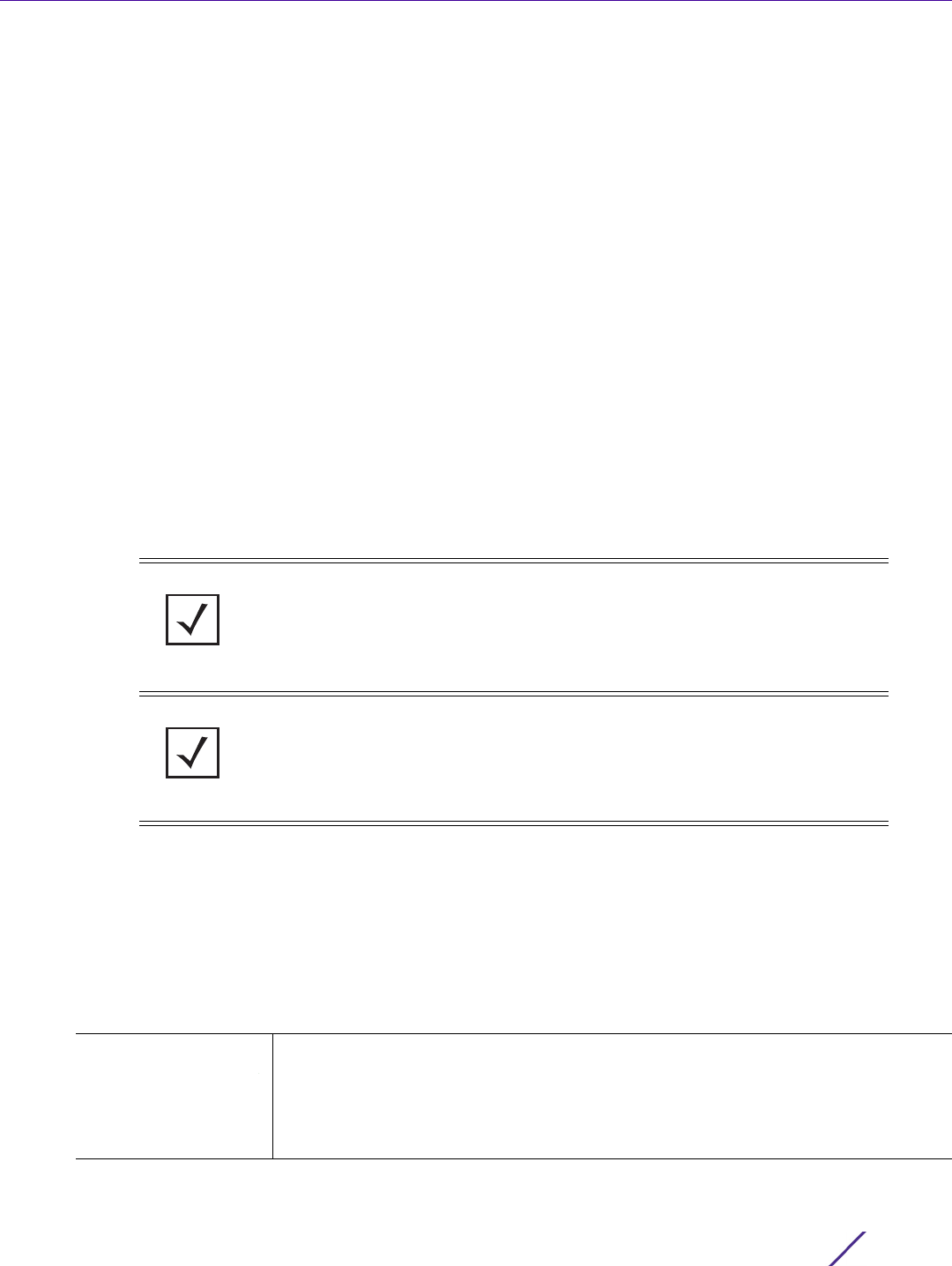
SHOW COMMANDS
Access Point, Wireless Controller and Service Platform CLI Reference Guide 6 - 39
6.1.19 dot1x
show commands
Displays dot1x information on interfaces
Dot1x (or 802.1x) is an IEEE standard for network authentication. Devices supporting dot1x allow the
automatic provision and connection to the wireless network without launching a Web browser at login.
When within range of a dot1x network, a dot1X-enabled device automatically connects and authenticates
without needing to manually login.
However, dot1x-enabled devices can be configured either as:
• supplicants only – Devices seeking network access
• authenticators only – Devices authenticating the supplicants, or
• supplicants as well authenticators
Supported in the following platforms:
• Access Points — AP6521, AP6522, AP6532, AP6562, AP7161, AP7502, AP7522, AP7532, AP7562,
AP7602, AP7612, AP7622, AP7632, AP7662, AP81XX, AP8232, AP8432, AP8533
• Wireless Controllers — RFS4000, RFS6000
• Service Platforms — NX5500, NX7500, NX7510, NX7520, NX7530, NX9500, NX9510, NX9600,
VX9000
Syntax
show dot1x {all|interface|on}
show dot1x {all {on <DEVICE-NAME>}|on <DEVICE-NAME>}
show dot1x {interface [<INTERFACE-NAME>|ge <1-4>|port-channel <1-2>} {on <DEVICE-
NAME>}
Parameters
• show dot1x {all {on <DEVICE-NAME>}|on <DEVICE-NAME>}
NOTE: Dot.1x supplicant configuration is supported on the following platforms:
• Access Points – AP6521, AP6522, AP6532, AP6562, AP7161, AP7502, AP7522,
AP7532, AP7562, AP81XX, AP8232, AP8432, AP8533
• Wireless Controllers – RFS4000
• Service Platforms – NX5500, NX7500
NOTE: Dot.1x authenticator configuration is supported on the following
platforms:
• Access Points – AP6521, AP6522, AP6562, AP7161, AP7502, AP81XX
• Wireless Controllers – RFS4000, RFS6000
• Service Platforms – NX5500, NX7500
dot1x all
{on <DEVICE-NAME>}
Optional. Displays dot1x information for all interfaces
• on <DEVICE-NAME> – Optional. Displays dot1x information for all interfaces on a
specified device
• <DEVICE-NAME> – Specify the name of the AP, wireless controller, or service
platform.

SHOW COMMANDS
Access Point, Wireless Controller and Service Platform CLI Reference Guide 6 - 40
• show dot1x {interface [<INTERFACE-NAME>|ge <1-4>|port-channel <1-2>]} {on
<DEVICE-NAME>}
Example
rfs6000-81742D#show dot1x all
802.1X information
------------------------------
SysAuthControl : disabled
Guest-Vlan : disabled
AAA-Policy : none
Holdtime : 60
802.1X information for interface GE1
--------------------------------------
Supplicant MAC N/A
Auth SM State : FORCE AUTHORIZED
Bend SM State : REQUEST
Port Status : AUTHORIZED
Host Mode : SINGLE
Auth Vlan : None
Guest Vlan : None
802.1X information for interface GE2
--------------------------------------
Supplicant MAC N/A
Auth SM State : FORCE AUTHORIZED
Bend SM State : REQUEST
Port Status : AUTHORIZED
--More--
rfs6000-81742D#
rfs6000-81742D#show dot1x interface ge 1
802.1X information for interface GE1
--------------------------------------
Supplicant MAC N/A
Auth SM State : FORCE AUTHORIZED
Bend SM State : REQUEST
Port Status : AUTHORIZED
Host Mode : SINGLE
Auth Vlan : None
Guest Vlan : None
rfs6000-81742D#
dot1x
{on <DEVICE-NAME>}
Optional. Displays dot1x information for interfaces on a specified device
• <DEVICE-NAME> – Specify the name of AP, wireless controller, or service platform.
dot1x interface Optional. Displays dot1x information for a specified interface or interface type
<INTERFACE-NAME> Displays dot1x information for the layer 2 (Ethernet port) interface specified by the
<INTERFACE-NAME> parameter
ge <1-4> Displays dot1x for a specified GigabitEthernet interface
• <1-4> – Select the interface index from 1 - 4.
port-channel <1-2> Displays dot1x for a specified port channel interface
• <1-2> – Select the interface index from 1 - 2.
on <DEVICE-NAME> The following keywords are common to all of the above parameters:
• on <DEVICE-NAME> – Optional. Displays dot1x interface information on a specified
device
• <DEVICE-NAME> – Specify the name of AP, wireless controller, or service plat-
form.
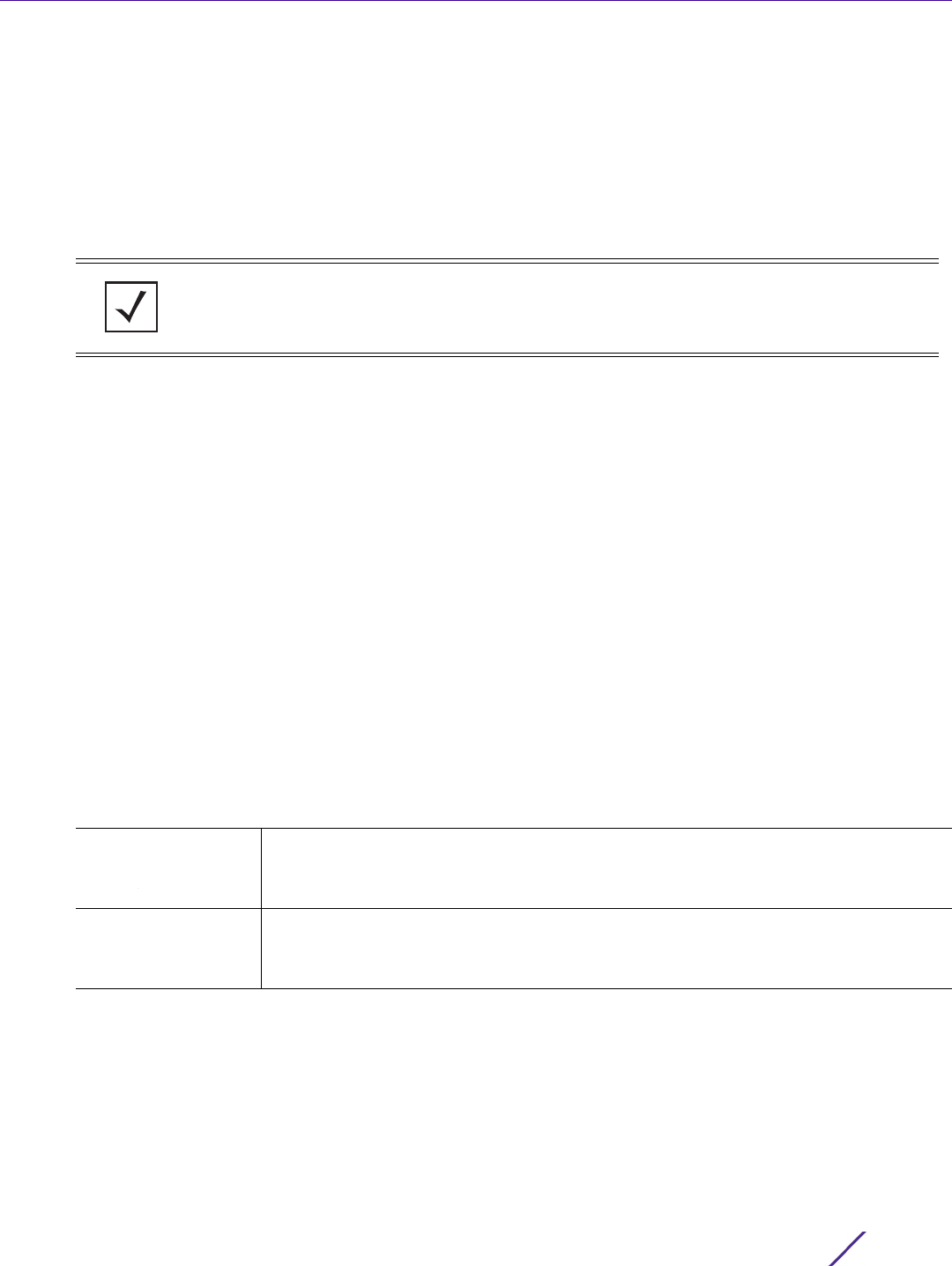
SHOW COMMANDS
Access Point, Wireless Controller and Service Platform CLI Reference Guide 6 - 41
6.1.20 dpi
show commands
Displays Deep Packet Inspection (DPI) statistics for all configured and canned applications. DPI is an
advanced packet analysis technique, which analyzes packet and packet content headers to determine the
nature of network traffic. When DPI is enabled, packets of all flows are subjected to DPI to get accurate
results. DPI identifies applications (such as, Netflix, Twitter, Facebook, etc.) and also extracts metadata
(such as, host name, server name, TCP-RTT, etc.) for further use by the WiNG firewall.
Supported in the following platforms:
• Access Points — AP7522, AP7532, AP7602, AP7612, AP7622, AP7632, AP7662, AP81XX, AP8432,
AP8533
• Service Platforms — NX5500, NX7500, NX7510, NX7520, NX7530, NX9500, NX9510, NX9600,
VX9000
Syntax
show dpi [app|app-category|application|application-policy|per-category]
show dpi app wireless-clients stats <MAC> {on <DEVICE-OR-DOMAIN-NAME>}
show dpi [app|app-category] stats [<APPLICATION/APP-CATEGORY-NAME>|all] {on
<DEVICE-OR-DOMAIN-NAME>}
show dpi application-policy stats <APPLICATION-POLICY-NAME> {on <DEVICE-OR-DOMAIN-
NAME>}
show dpi application brief
show dpi per-category stats <APP-CATEGORIES> [bytes-in|bytes-out|total-bytes] {on
<DEVICE-OR-DOMAIN-NAME>}
Parameters
• show dpi app wireless-clients stats <MAC> {<DEVICE-OR-DOMAIN-NAME>}
NOTE: The show > dpi command returns results only if executed on a device that supports
DPI and has DPI logging enabled. DPI logging can be enabled either on the device or on
the profile applied to the device. For more information, see dpi.
dpi app
wireless-clients
<MAC>
Displays application-related statistics for all or a specified wireless clients
• <MAC> – Displays statistics for a specified wireless client. Specify the client’s MAC
address.
on <DEVICE-OR-
DOMAIN-NAME>
Optional. Displays statistical data on a specified device or RF Domain
• <DEVICE-OR-DOMAIN-NAME> – Specify the name of the access point, wireless
controller, service platform, or RF Domain.

SHOW COMMANDS
Access Point, Wireless Controller and Service Platform CLI Reference Guide 6 - 42
• show dpi [app|app-category] stats [<APPLICATION/APP-CATEGORY-NAME>|all]
{on <DEVICE-OR-DOMAIN-NAME>}
• show dpi application-policy stats <APPLICATION-POLICY-NAME> {on <DEVICE-OR-
DOMAIN-NAME>}
• show dpi application brief
• show dpi per-category stats <APP-CATEGORIES> [bytes-in|bytes-out|total-bytes]
{on <DEVICE-OR-DOMAIN-NAME>}
dpi [app|
app-category] stats
Displays statistics for a application or application category
• app – Displays statistics for a specified application or all applications
• app-category – Displays statistics for a specified application category or all
categories.
Note: The applications are the RF Domain member allowed applications whose data
(bytes) are passing through the WiNG managed network. And, the application
categories are existing WiNG or user defined application groups (video, streaming,
mobile, audio, etc.) that assist administrators to permit or deny forwarding of application
data.
[<APPLICATION/APP-
CATEGORY-
NAME>|all]
This parameter is common to the ‘app’ and ‘app-category’ keywords.
• <APPLICATION/APP-CATEGORY-NAME> – Displays statistics for a specified
application or application category, depending on the option selected in the previous
step. Specify the application name or application category name.
• all – Displays statistics for all applications or application categories, depending on the
option selected in the previous step
on <DEVICE-OR-
DOMAIN-NAME>
Optional. Displays statistical data on a specified device or RF Domain
• <DEVICE-OR-DOMAIN-NAME> – Specify the name of the access point, wireless
controller, service platform, or RF Domain.
dpi application-policy
stats
Displays statistics for an existing application policy
<APPLICATION-
POLICY-NAME>
Displays statistics for a specified application-policy. Specify the application-policy
name.
on <DEVICE-OR-
DOMAIN-NAME>
Optional. Displays application-policy related statistical data on a specified device or
RF Domain
• <DEVICE-OR-DOMAIN-NAME> – Specify the name of the access point, wireless
controller, service platform, or RF Domain.
dpi application brief Displays a brief summary of applications their status and configuration
dpi per-category
stats
Displays statistics for the top ten applications based on the application category and
the Sort ID specified. The Sort ID options are: bytes-in, bytes-out or total-bytes.
<APP-CATEGORIES> Specify the application category name. The system displays statistics for the top ten
applications in this category.

SHOW COMMANDS
Access Point, Wireless Controller and Service Platform CLI Reference Guide 6 - 43
Example
nx9500-6C8809>show dpi application brief
1-clickshare-com
This application recognizes DirectDownloadLink 1-clickshare
traffic
Application Category : filetransfer
Predefined Application : Yes
1-upload-com
This application recognizes DirectDownloadLink 1-upload-com
traffic
Application Category : filetransfer
Predefined Application : Yes
1-upload-to
This application recognizes DirectDownloadLink 1-upload-to
traffic
Application Category : filetransfer
Predefined Application : Yes
10upload-com
This application recognizes DirectDownloadLink 10upload-com
traffic
Application Category : filetransfer
Predefined Application : Yes
123upload-pl
This application recognizes DirectDownloadLink 123upload-pl
traffic
--More--
nx9500-6C8809>
[bytes-in|bytes-out|
total-bytes]
Filters and displays statistical data for the top ten utilized applications in respect to
the following:
• bytes-in – Displays total data bytes uploaded through the controller managed
network. If this application data is not aligned with application utilization
expectations, consider allowing or denying additional applications and categories or
adjusting their precedence (priority).
• bytes-out – Displays total data bytes downloaded through the controller managed
network. If this application data is not aligned with application utilization
expectations, consider allowing or denying additional applications and categories or
adjusting their precedence (priority).
• total-bytes – Displays total data bytes (uploaded and downloaded) through the
controller managed network. These are only the administrator allowed applications
approved for proliferation within the managed network.
on <DEVICE-OR-
DOMAIN-NAME>
Optional. Displays statistical data on a specified device or RF Domain
• <DEVICE-OR-DOMAIN-NAME> – Specify the name of the access point, wireless
controller, service platform, or RF Domain.

SHOW COMMANDS
Access Point, Wireless Controller and Service Platform CLI Reference Guide 6 - 44
6.1.21 eguest
show commands
Displays EGuest server status and EGuest registration statistics
Supported in the following platforms:
• Service Platforms — NX9500, NX9510, NX9600, VX9000
Syntax
eguest [registration statistics|status]
Parameters
• eguest [registration statistics|status]
Example
vx-eguest-primary#show eguest status
-----------------------------------
pid process
-----------------------------------
2521 gmd
2529 regserver
2539 acct_server
2569 guest_manager
2636 acct_server
2642 acct_server
2643 acct_server
2649 acct_server
2655 acct_server
2708 acct_server-helper
2770 guest_manager
2776 guest_manager
2777 guest_manager
2783 guest_manager
3628 gmd
3630 gmd
3631 gmd
3632 gmd
3633 gmd
3634 gmd
5729 radiusd
-----------------------------------
Database server is local
Database server is reachable
vx-eguest-primary#
vx-eguest-primary#show eguest registration statistics
msg_received - number of registration messages received
user_try_to_add - number of database add attempts
user_added - number of messages succesfully added to db
user_failed - number of messages failed adding to db
------------------------------------------------------------------------
msg_received user_try_to_add user_added user_failed
------------------------------------------------------------------------
189 11 11 0
vx-eguest-primary#
registration
statistics
Displays the EGuest registration statistics
status Displays the current status of EGuest servers

SHOW COMMANDS
Access Point, Wireless Controller and Service Platform CLI Reference Guide 6 - 45
6.1.22 environmental-sensor
show commands
Displays environmental sensor’s recorded data. The environmental sensor has to be enabled and
configured in order to collect data related to humidity, light, motion, and temperature.
Supported in the following platforms:
• Access Points — AP8132
Syntax
show environmental-sensor [history|humidity|light|motion|summary|temperature|
version]
show environmental-sensor history {<1-HOUR>|<20-MINUTE>|<24-HOUR>}
show environmental-sensor [humidity|light|motion|summary|temperature|version]
Parameters
• show environmental-sensor history {<1-HOUR>|<20-MINUTE>|<24-HOUR>}
• show environmental-sensor [humidity|light|motion|summary|temperature|
version]
NOTE: The environmental senor is supported only on an AP8132. When
executed on any controller (other than an AP8132), the show >
environmental-sensor > <parameters> command displays environmental-
sensor details for adopted AP8132s (if any).
environmental-
sensor history
Displays environmental sensor history once in every hour, 20 minutes, or 24 hours
History includes the humidity, light, motion, and temperature data recorded by the sensor
at specified time interval.
1-hour Optional. Displays environmental sensor history once in every 1 (one) hour
20-minute Optional. Displays environmental sensor history once in every 20 minutes
24-hour Optional. Displays environmental sensor history once in every 24 hours
environmental-
sensor
Displays environmental sensor’s recorded data, based on the parameters passed. The
system displays the specified recorded data.
The environmental sensor records data at the following intervals: 20 minutes, 1 hour, and
24 hours.
humidity Displays the minimum, average, and maximum humidity recorded
light Displays the minimum, average, and maximum light recorded
motion Displays the minimum, average, and maximum motion recorded
temperature Displays the minimum, average, and maximum temperature recorded
version Displays the hardware and firmware versions
summary Displays a summary of the data recorded at following intervals:

SHOW COMMANDS
Access Point, Wireless Controller and Service Platform CLI Reference Guide 6 - 46
Example
ap8132-711728#show environmental-sensor summary
Maat Device uptime: 0 days 15:25:11
ERROR: Maat device is offline!
threshold polling-interval: 5
historical data polled 0 times per 2-minutes interval since Maat online
motion-sensor: Enabled(Demo)
current value: 0 detected
-------------------------------
motion detected
-------------------------------
20-minute 0
1-hour 0
6-hour 0
24-hour 0
temperature-sensor: Enabled(Demo)
current value: -40.00 deg. C
-------------------------------
min/average/max
-------------------------------
20-minute 0/0/0
1-hour 0/0/0
6-hour 0/0/0
24-hour 0/0/0
light-sensor: Enabled
threshold-high:+400.00 threshold-low:+200.00 holdtime:11
action radio-shutdown: radio-1 and radio-2
light-on:1
light-on/off event sent:0/0
current value: 0.00 lux
-------------------------------
min/average/max
-------------------------------
20-minute 0/0/0
1-hour 0/0/0
6-hour 0/0/0
24-hour 0/0/0
humidity-sensor: Enabled(Demo)
current value: 0.00 %
-------------------------------
min/average/max
-------------------------------
20-minute 0/0/0
1-hour 0/0/0
6-hour 0/0/0
24-hour 0/0/0
ap8132-711728#
ap8132-711634#show env-sensor history
Current Time: 2015-06-20 14:08:01 UTC
-------------------------------------------------------------------------------
Sample-Interval Motion Temperature Light Humidity
(deg. C) (lux) (%)
----------- min/average/max ------------
-------------------------------------------------------------------------------
20-minute 1 64/65/66 77/80 58/60/61
1-hour 24 63/67/70 75/81 57/59/61
6-hour 128 60/62/69 71/79 52/56/71
24-hour 188 54/58/70 15/45 49/57/73
ap8132-711634#

SHOW COMMANDS
Access Point, Wireless Controller and Service Platform CLI Reference Guide 6 - 47
ap8132-711634#show env-sensor history 20-min
--------------------------------------------------------------------------------
-
timestamp Motion Temperature Light Humidity
--------------------------------------------------------------------------------
-
2015-11-20 13:51:35 UTC 0 66 79 59
2015-11-20 13:53:35 UTC 0 66 79 59
2015-11-20 13:55:35 UTC 0 65 79 58
2015-11-20 13:57:35 UTC 1 66 80 59
2015-11-20 13:59:35 UTC 0 66 79 59
2015-11-20 14:02:35 UTC 0 65 79 60
2015-11-20 14:03:35 UTC 0 64 79 60
2015-11-20 14:05:35 UTC 2 66 80 60
2015-11-20 14:07:35 UTC 0 66 80 61
2015-11-20 14:09:35 UTC 0 66 80 61
ap8132-711634#
ap8132-711634#show env-sensor history 1-hr
--------------------------------------------------------------------------------
--timestamp Motion Temperature Light Humidity
--------------------------------------------------------------------------------
--
2015-11-20 13:51:35 UTC 0 66 79 59
2015-11-20 13:53:35 UTC 0 66 79 59
2015-11-20 13:55:35 UTC 0 65 79 58
2015-11-20 13:57:35 UTC 1 66 80 59
2015-11-20 13:59:35 UTC 0 66 79 59
2015-11-20 14:01:35 UTC 0 65 79 60
2015-11-20 14:03:35 UTC 0 64 79 60
2015-11-20 14:05:35 UTC 2 66 80 60
2015-11-20 14:07:35 UTC 0 66 80 61
2015-11-20 14:09:35 UTC 0 66 80 61
2015-11-20 14:42:35 UTC 0 65 81 60
2015-11-20 14:43:35 UTC 0 64 80 59
2015-11-20 14:45:35 UTC 3 66 80 60
ap8132-711634#
<DEVICE-NAME>#show env-sensor history 24-hr
--------------------------------------------------------------------------------
--
timestamp Motion Temperature Light Humidity
--------------------------------------------------------------------------------
--
2015-11-20 10:10:20 UTC 27 66 80 60
2015-11-20 10:30:20 UTC 17 66 80 60
2015-11-20 10:50:20 UTC 17 66 81 60
2015-11-20 11:10:20 UTC 25 66 81 60
2015-11-20 11:30:20 UTC 24 66 81 60
2015-11-20 11:50:20 UTC 26 66 81 60
2015-11-21 08:10:20 UTC 9 65 80 59
2015-11-21 08:30:20 UTC 7 65 80 59
2015-11-21 08:50:20 UTC 12 65 80 60
2015-11-21 09:10:20 UTC 10 65 80 60
2015-11-21 09:30:20 UTC 15 65 80 60
2015-11-21 09:50:20 UTC 19 66 80 60
<DEVICE-NAME>#

SHOW COMMANDS
Access Point, Wireless Controller and Service Platform CLI Reference Guide 6 - 48
6.1.23 event-history
show commands
Displays event history report
Supported in the following platforms:
• Access Points — AP6521, AP6522, AP6532, AP6562, AP7161, AP7502, AP7522, AP7532, AP7562,
AP7602, AP7612, AP7622, AP7632, AP7662, AP81XX, AP8232, AP8432, AP8533
• Wireless Controllers — RFS4000, RFS6000
• Service Platforms — NX5500, NX7500, NX7510, NX7520, NX7530, NX9500, NX9510, NX9600,
VX9000
Syntax
show event-history {on <DEVICE-OR-DOMAIN-NAME>}
Parameters
• show event-history {on <DEVICE-OR-DOMAIN-NAME>}
Example
nx9500-6C8809#show event-history
Generated on '2016-09-21 05:19:55 UTC' by 'admin'
2017-06-06 10:40:19 nx9500-6C8809 SYSTEM LOGIN Successfully
logged in user 'admin' with privilege 'superuser' from 'ssh'
2017-06-06 10:38:36 nx9500-6C8809 SYSTEM LOGOUT Logged out user
'admin' with privilege 'superuser' from '192.168.100.214'
2017-06-06 10:27:34 nx9500-6C8809 SYSTEM LOGIN Successfully
logged in user 'admin' with privilege 'superuser' from 'ssh'
2017-06-06 10:27:34 nx9500-6C8809 SYSTEM LOGOUT Logged out user
'admin' with privilege 'superuser' from '192.168.100.214'
2016-09-20 23:52:49 nx9500-6C8809 SYSTEM LOGIN Successfully
logged in user 'admin' with privilege 'superuser' from 'ssh'
2016-09-20 05:39:01 nx9500-6C8809 SYSTEM LOGOUT Logged out
user 'admin' with privilege 'superuser' from '192.168.100.165'
2016-09-20 05:08:54 nx9500-6C8809 SYSTEM LOGIN Successfully
logged in user 'admin' with privilege 'superuser' from 'ssh'
--More--
nx9500-6C8809#
event-history Displays event history report
on <DEVICE-OR-
DOMAIN-NAME>
Optional. Displays event history report on a device or RF Domain
• <DEVICE-OR-DOMAIN-NAME> – Specify the name of the AP, wireless controller,
service platform, or RF Domain.

SHOW COMMANDS
Access Point, Wireless Controller and Service Platform CLI Reference Guide 6 - 49
6.1.24 event-system-policy
show commands
Displays detailed event system policy configuration
Supported in the following platforms:
• Access Points — AP6521, AP6522, AP6532, AP6562, AP7161, AP7502, AP7522, AP7532, AP7562,
AP7602, AP7612, AP7622, AP7632, AP7662, AP81XX, AP8232, AP8432, AP8533
• Wireless Controllers — RFS4000, RFS6000
• Service Platforms — NX5500, NX7500, NX7510, NX7520, NX7530, NX9500, NX9510, NX9600,
VX9000
Syntax
show event-system-policy [config|detail] <EVENT-SYSTEM-POLICY-NAME>
Parameters
• show event-system-policy [config|detail] <EVENT-SYSTEM-POLICY-NAME>
Example
rfs6000-81742D(config)#show event-system-policy config testpolicy
--------------------------------------------------------------------------
MODULE EVENT SYSLOG SNMP FORWARD EMAIL
--------------------------------------------------------------------------
aaa radius-discon-msg on on on default
--------------------------------------------------------------------------
rfs6000-81742D(config)#
event-system-policy Displays event system policy configuration
config Displays configuration for a specified policy
detail Displays detailed configuration for a specified policy
<EVENT-SYSTEM-
POLICY-NAME>
Specify the event system policy name.

SHOW COMMANDS
Access Point, Wireless Controller and Service Platform CLI Reference Guide 6 - 50
6.1.25 ex3500
show commands
Displays EX3500-related statistical data
Supported in the following platforms:
• Service Platforms — NX7500, NX9500
Syntax
show ex3500 [dir|interfaces|system|upgrade|version|whichboot]
show ex3500 dir {boot-rom|config|on|opcode} {<FILE-NAME>} {on <EX3500-DEVICE-
NAME>}
show ex3500 interfaces counters [ether-like stats|ethernet <1-1> <1-52>|ext-if-
table stats|if-table stats|portUtil stats|rmon stats] {on <EX3500-DEVICE-NAME>}
show ex3500 [system|upgrade|version|whichboot] {on <EX3500-DEVICE-NAME>}
Parameters
• show ex3500 dir {boot-rom|config|on|opcode} {<FILE-NAME>} {on <EX3500-DEVICE-
NAME>}
• show ex3500 interfaces counters [ether-like stats|ethernet <1-1> <1-52>|
ext-if-table stats|if-table stats|portUtil stats|rmon stats] {on <EX3500-DEVICE-
NAME>}
ex3500 dir Displays EX3500 directory information based on the option selected. The options
are: boot-rom, config, opcode
Note: If none of the specified options is selected, all EX3500 system-related
information is displayed.
boot-rom Optional. Displays only the Boot-ROM information
config Optional. Displays only the configuration file
opcode Optional. Displays only the run-time operation code
<FILE-NAME> Displays the contents of a specified file identified by the <FILE-NAME> keyword.
This is the name of configuration file or code image.
on
<EX3500-DEVICE-
NAME>
Optional. Executes the command on a specified EX3500 device
• <DEVICE-NAME> – Specify the device’s name.
ex3500 interfaces
counters
Displays EX3500 interface counter information based on the option selected. The
options are: ether-like, ethernet, ext-if-table, if-table, portUtil, rmon
ether-like stats Displays Managed Information Base (MIB) object statistics for Ethernet-like
interfaces
ethernet <1-1> <1-52> Displays the Ethernet port statistics based on the unit identifier and port number
selected
• <1-1> – Specify the EX3500 unit’s identifier from 1 - 1.
• <1-52> – Specify the port number from 1 - 52. This range varies for the EX3524 (1-
28) and EX3548 (1-52) devices.
Note: This option displays the following for the selected Ethernet interface: extended
interface table stats, interface table stats, port utilization information, and remote
monitoring stats.
ext-if-table stats Displays only the extended interface table statistics

SHOW COMMANDS
Access Point, Wireless Controller and Service Platform CLI Reference Guide 6 - 51
• show ex3500 [system|upgrade|version|whichboot] {on <EX3500-DEVICE-NAME>}
Example
nx9500-6C8809#show ex3500 interfaces counters ethernet 1 17
Ethernet 1/ 17
===== IF table Stats =====
2166458 Octets Input
14734059 Octets Output
14707 Unicast Input
19806 Unicast Output
0 Discard Input
0 Discard Output
0 Error Input
0 Error Output
0 Unknown Protocols Input
0 QLen Output
===== Extended Iftable Stats =====
23 Multi-cast Input
5525 Multi-cast Output
170 Broadcast Input
11 Broadcast Output
===== Ether-like Stats =====
0 Alignment Errors
0 FCS Errors
0 Single Collision Frames
0 Multiple Collision Frames
0 SQE Test Errors
0 Deferred Transmissions
0 Late Collisions
0 Excessive Collisions
0 Internal Mac Transmit Errors
0 Internal Mac Receive Errors
0 Frames Too Long
0 Carrier Sense Errors
0 Symbol Errors
0 Pause Frames Input
0 Pause Frames Output
===== RMON Stats =====
0 Drop Events
16900558 Octets
40243 Packets
if-table stats Displays only the interface table statistics
portUtil stats Displays only the port utilization information
rmon stats Displays only remote monitoring (RMon) statistics
on <EX3500-DEVICE-
NAME>
Optional. Executes the command on a specified EX3500 device
• <DEVICE-NAME> – Specify the device’s name.
ex3500 Displays the following information for a specified EX3500 device or all EX3500
devices in the managed network
system Displays EX3500 system information, such as device description, OID string, up
time, name, location, contact, MAC address, etc. Some of these information
(example, system name) are configurable items, and if not configured are left blank.
upgrade Displays the opcode upgrade configuration settings
version Displays hardware and software version information for a EX3500 system
whichboot Displays boot information
on <EX3500-DEVICE-
NAME>
Optional. Executes the command on a specified EX3500 device
• <DEVICE-NAME> – Specify the device’s name.

SHOW COMMANDS
Access Point, Wireless Controller and Service Platform CLI Reference Guide 6 - 52
170 Broadcast PKTS
23 Multi-cast PKTS
0 Undersize PKTS
0 Oversize PKTS
0 Fragments
0 Jabbers
0 CRC Align Errors
0 Collisions
21065 Packet Size <= 64 Octets
3805 Packet Size 65 to 127 Octets
2448 Packet Size 128 to 255 Octets
797 Packet Size 256 to 511 Octets
2941 Packet Size 512 to 1023 Octets
9187 Packet Size 1024 to 1518 Octets
===== Port Utilization (recent 300 seconds) =====
0 Octets Input in kbits per second
0 Packets Input per second
0.00 % Input Utilization
0 Octets Output in kbits per second
0 Packets Output per second
0.00 % Output Utilization
nx9500-6C8809#

SHOW COMMANDS
Access Point, Wireless Controller and Service Platform CLI Reference Guide 6 - 53
6.1.26 extdev
show commands
Displays external device (T5 or EX3500) configuration error history
Supported in the following platforms:
• Wireless Controllers — RFS4000, RFS6000
• Service Platforms — NX9500, NX9510
Syntax
show extdev error history {on <T5/EX3500-DEVICE-NAME>}
Parameters
• show extdev error history {on <T5/EX3500-DEVICE-NAME>}
Example
nx9500-6C8809#show extdev error history on t5-ED5EAC
%% No History for this device
nx9500-6C8809#
extdev error history Displays external device error history. This command is applicable only to the
external devices T5, and EX3500 series switches. Use this command to view
configuration error history for all or a specified external device adopted and
managed by a WiNG NX9500 series service platform.
on <T5/EX3500-
DEVICE-NAME>
Optional. Displays configuration error history on a specified T5 or EX3500 device
• <T5/EX3500-DEVICE-NAME> – Specify the name of the device.

SHOW COMMANDS
Access Point, Wireless Controller and Service Platform CLI Reference Guide 6 - 54
6.1.27 file-sync
show commands
Displays file synchronization settings and status on a controller
The file-sync command syncs wireless-bridge certificate and trustpoint between the staging-controller and
its adopted access points. The show > file-sync command displays information related to this process.
Supported in the following platforms:
• Wireless Controllers — RFS4000, RFS6000
• Service Platforms — NX7500, NX7510, NX7520, NX7530, NX9500, NX9510
Syntax
show file-sync [configuration|history|load-file-status|status] {on <DEVICE-OR-
DOMAIN-NAME>}
Parameters
• show file-sync [configuration|history|load-file-status|status] {on <DEVICE-OR-
DOMAIN-NAME>}
file-sync Displays the following file-synchronization (trustpoint and wireless-bridge
certificate) related information: configuration, history, load-file-status, and status
configuration Displays the following file-synchronization configuration details:
• automatic file-syncing enabled or disabled. The default setting is disabled.
The X.509 certificate needs synchronization only if the access point’s radio2 is
configured to use EAP-TLS authentication. In which case PKCS#12 certificate needs
to be pushed on AP adoption. To enable automatic file syncing, in the controller’s
device/profile configuration mode, execute the file-sync > auto command. For more
information, see file-sync.
• Number of access points to which the certificate can be simultaneously uploaded.
The default is 10.
To modify the number of simultaneous uploads, in the controller’s device/profile
configuration mode, execute the file-sync > count <1-20> command. For more
information, see file-sync.
• Scheduled certificate upload, if any, details, such time and date of upload.
To schedule certificate upload, use the file-sync > wireless-certificate command. For
more information, see file-sync.
history Displays file synchronization history. Use this option to view statistical data relating
to wireless-bridge certificate synchronization between staging controller and its
access points. When executed, a list of all certificate transfers made to the APs is
displayed, with the latest transfer listed at the top.
load-file-status Displays the status of the file upload to the controller. Use this command to view
the status of a in-progress certificate upload,
For more information on initiating a PKCS#12 certificate upload, see file-sync.
status Displays status of the file synchronization between the controller and its adopted
access point.

SHOW COMMANDS
Access Point, Wireless Controller and Service Platform CLI Reference Guide 6 - 55
Example
nx9500-6C8809#show file-sync configuration
File Sync Configuration Information
Auto : Disabled
Simultaneous Upload Count : 128
Wireless Bridge Cert Load Time : Thu May 29 23:23:35 2015
nx9500-6C8809#
nx9500-6C8809#show file-sync load-file-status
Download of wireless_bridge certificate is complete
nx9500-6C8809#
nx9500-6C8809#show file-sync history
-------------------------------------------------------------------------------------
AP RESULT TIME RETRIES SYNCED-BY LAST-SYNC-ERROR
-------------------------------------------------------------------------------------
AP6522-491220 done 2015-05-27 01:37:32 B4-C7-99-6C-88-09 -
ME733ANACBMOT21 done 2015-05-27 02:02:51 0 B4-C7-99-6C-88-09 -
nx9500-6C8809#
on <DEVICE-OR-
DOMAIN- NAME>
Optional. Displays file synchronization settings and status on a specified device or
RF Domain
• <DEVICE-OR-DOMAIN- NAME> – Specify the name of the controller, service
platform, or RF Domain.

SHOW COMMANDS
Access Point, Wireless Controller and Service Platform CLI Reference Guide 6 - 56
6.1.28 firewall
show commands
Displays wireless firewall information, such as Dynamic Host Configuration Protocol (DHCP) snoop table
entries, denial of service statistics, active session summaries, etc.
Supported in the following platforms:
• Access Points — AP6521, AP6522, AP6532, AP6562, AP7161, AP7502, AP7522, AP7532, AP7562,
AP7602, AP7612, AP7622, AP7632, AP7662, AP81XX, AP8232, AP8432, AP8533
• Wireless Controllers — RFS4000, RFS6000
• Service Platforms — NX5500, NX7500, NX7510, NX7520, NX7530, NX9500, NX9510, NX9600,
VX9000
Syntax
show firewall [dhcp|flows|neighbors]
show firewall dhcp snoop-table {on <DEVICE-NAME>}
show firewall flows {filter|management|on|stats|wireless-client}
show firewall flows {filter} {(dir|dst port <1-65535>|ether|flow-type|icmp|
icmpv6|igmp|ip|ipv6|max-idle|min-bytes|min-idle|min-pkts|not|port|src|tcp|udp)}
show firewall flows {management {on <DEVICE-NAME>}|stats {on <DEVICE-NAME>}|
wireless-client <MAC>|on <DEVICE-NAME>}
show firewall neighbors snoop-table {on <DEVICE-NAME>}
Parameters
• show firewall dhcp snoop-table {on <DEVICE-NAME>}
• show firewall flows {filter} {(dir|dst|ether|flow-type|icmp|icmpv6|igmp|ip|
ipv6|max-idle|min-bytes|min-idle|min-pkts|not|port|src|tcp|udp)}
firewall dhcp
snoop-table
Displays DHCP snoop table entries
• snoop-table – Displays DHCP snoop table entries
DHCP snooping acts as a firewall between non-trusted hosts and the DHCP server.
Snoop table entries contain MAC address, IP address, lease time, binding type, and
interface information of non-trusted interfaces.
on <DEVICE-NAME> The following keyword is common to the ‘DHCP snoop table’ and ‘DoS stats’
parameters:
• on <DEVICE-NAME> – Optional. Displays snoop table entries, or DoS stats on a
specified device
• <DEVICE-NAME> – Specify the name of the AP, wireless controller, or service plat-
form.
firewall flows Notifies a session has been established
filter Optional. Defines additional firewall flow filter parameters
dir [wired-wired|
wired-wireless|
wireless-wired|
wireless-wireless]
Optional. Matches the packet flow direction
• wired-wired – Wired to wired flows
• wired-wireless – Wired to wireless flows
• wireless-wired – Wireless to wired flows
• wireless-wireless – Wireless to wireless flows

SHOW COMMANDS
Access Point, Wireless Controller and Service Platform CLI Reference Guide 6 - 57
dst port
<1-65535>
Optional. Matches the destination port with the specified port
• port <1-65535> – Specifies the destination port number from 1 - 65535
ether
[dst <MAC>|
host <MAC>|
src <MAC>|
vlan <1-4094>]
Optional. Displays Ethernet filter options
• dst <MAC> – Matches only the destination MAC address
• host <MAC> – Matches flows containing the specified MAC address
• src <MAC> – Matches only the source MAC address
• vlan <1-4094> – Matches the VLAN number of the traffic with the specified value.
Specify a value from 1- 4094.
flow-type
[bridged|natted|
routed|wired|
wireless]
Optional. Matches the traffic flow type
• bridged – Bridged flows
•natted – Natted flows
•routed – Routed flows
• wired – Flows belonging to wired hosts
• wireless – Flows containing a mobile unit
icmp {code|type} Optional. Matches flows with the specified Internet Control Message Protocol (ICMP)
version 4 code and type
• code – Optional. Matches flows with the specified ICMPv4 code
• type – Optional. Matches flows with the specified ICMPv4 type
icmpv6 {code|type} Optional. Matches flows with the specified ICMP version 6 code and type
• code – Optional. Matches flows with the specified ICMPv6 code
• type – Optional. Matches flows with the specified ICMPv6 type
igmp Optional.Matches Internet Group Management Protocol (IGMP) flows
ip [dst <IP>|
host <IP>|
proto <0-254>|
src <IP>]
Optional. Filters firewall flows based on the IPv4 parameters passed
• dst <IP> – Matches destination IP address
• host <IP> – Matches flows containing IPv4 address
• proto <0-254> – Matches the IPv4 protocol number with the specified number
• src <IPv4> – Matches source IP address
ipv6 [dst <IPv6>|
host <IPv6>|
proto <0-254>|
src <IPv6>]
Optional. Filters firewall flows based on the IPv6 parameters passed
• dst <IPv6> – Matches destination IPv6 address
• host <IPv6> – Matches flows containing IPv6 address
• proto <0-254> – Matches the IPv6 protocol number with the specified number
• src <IPv6> – Matches source IPv6 address
max-idle
<1-4294967295>
Optional. Filters firewall flows idle for at least the specified duration. Specify a max-
idle value from 1 - 4294967295 bytes.
min-bytes
<1-4294967295>
Optional. Filters firewall flows with at least the specified number of bytes. Specify a
min-bytes value from 1 - 4294967295 bytes.
min-idle
<1-4294967295>
Optional. Filters firewall flows idle for at least the specified duration. Specify a min-
idle value from 1 - 4294967295 bytes.
min-pkts
<1-4294967295>
Optional. Filters firewall flows with at least the given number of packets. Specify a
min-bytes value from 1 - 4294967295 bytes.
not Optional. Negates the filter expression selected

SHOW COMMANDS
Access Point, Wireless Controller and Service Platform CLI Reference Guide 6 - 58
• show firewall flows {management {on <DEVICE-NAME>}|stats {on <DEVICE-NAME>}|
wireless-client <MAC>|on <DEVICE-NAME>}
• show firewall neighbors snoop-table {on <DEVICE-NAME>}
Example
rfs6000-81742D(config)#show fi
file-sync firewall file
rfs6000-81742D(config)#show firewall dhcp snoop-table
Snoop Binding <192.168.13.24, 00-15-70-81-74-2D, Vlan 1>
Type switch-SVI, Touched 427779 seconds ago
-------------------------------------------------------------------------------
rfs6000-81742D(config)#
port <1-65535> Optional. Matches either the source or destination port. Specify a port from 1 -
65535.
src <1-65535> Optional. Matches only the source port with the specified port. Specify a port from 1
- 65535.
tcp Optional. Matches TCP flows
udp Optional. Matches UDP flows
firewall flows Notifies a session has been established
management
{on <DEVICE-NAME>}
Optional. Displays management traffic firewall flows
• on <DEVICE-NAME> – Optional. Displays firewall flows on a specified device
• <DEVICE-NAME> – Specify the name of the AP, wireless controller, or service plat-
form.
stats
{on <DEVICE-NAME>}
Optional. Displays active session summary
• on <DEVICE-NAME> – Optional. Displays active session summary on a specified
device
• <DEVICE-NAME> – Specify the name of the AP, wireless controller, or service plat-
form.
wireless-client <MAC> Optional. Displays wireless clients firewall flows
• <MAC> – Specify the MAC address of the wireless client.
on <DEVICE-NAME> Optional. Displays all firewall flows on a specified device
• <DEVICE-NAME> – Specify the name of the AP, wireless controller, or service
platform.
firewall neighbors
snoop-table
Displays IPv6 neighbors snoop table entries
on <DEVICE-NAME> Optional. Displays IPv6 neighbors snoop table entries on a specified device
• <DEVICE-NAME> – Specify the name of the AP, wireless controller, or service
platform.

SHOW COMMANDS
Access Point, Wireless Controller and Service Platform CLI Reference Guide 6 - 59
rfs6000-81742D(config)#show firewall dos stats
--------------------------------------------------------------------------------
ATTACK TYPE COUNT LAST OCCURENCE
--------------------------------------------------------------------------------
udp-short-hdr 0 Never
multicast-icmpv6 0 Never
icmp-router-solicit 0 Never
tcp-xmas-scan 0 Never
ascend 0 Never
twinge 0 Never
tcp-post-syn 0 Never
land 0 Never
broadcast-multicast-icmp 0 Never
ftp-bounce 0 Never
spoof 0 Never
source-route 0 Never
tcp-null-scan 0 Never
tcp-fin-scan 0 Never
ipv6-hop-limit-zero 0 Never
tcp-bad-sequence 97 0 days 02:24:32 ago
fraggle 0 Never
router-advt 0 Never
snork 0 Never
raguard 0 Never
--More--
rfs6000-81742D(config)#
rfs6000-81742D(config)#show firewall flows management
========== Flow# 1 Summary ==========
Forward:
IPv4 Vlan 1, TCP 192.168.13.10 port 1646 > 192.168.13.24 port 22
00-02-B3-28-D1-55 > 00-15-70-81-74-2D, ingress port up1
Egress port: <local>, Egress interface: vlan1, Next hop: <local> (00-15-70-81-74-
2D)
1170 packets, 99960 bytes, last packet 0 seconds ago
Reverse:
IPv4 Vlan 1, TCP 192.168.13.24 port 22 > 192.168.13.10 port 1646
00-15-70-81-74-2D > 00-02-B3-28-D1-55, ingress port local
Egress port: up1, Egress interface: vlan1, Next hop: 192.168.13.10 (00-02-B3-28-
D1-55)
873 packets, 98797 bytes, last packet 0 seconds ago
TCP state: Established
Flow times out in 1 hour 30 minutes
rfs6000-81742D(config)#
rfs6000-81742D(config)#show firewall flows stats
Active Flows 2
TCP/IPv4 flows 2
UDP/IPv4 flows 0
DHCP/IPv4 flows 0
ICMP/IPv4 flows 0
IPsec/IPv4 flows 0
TCP/IPv6 flows 0
UDP/IPv6 flows 0
DHCP/IPv6 flows 0
ICMP/IPv6 flows 0
IPsec/IPv6 flows 0
L3/Unknown flows 0
rfs6000-81742D(config)#

SHOW COMMANDS
Access Point, Wireless Controller and Service Platform CLI Reference Guide 6 - 60
6.1.29 global
show commands
Displays global information for network devices based on the parameters passed
Supported in the following platforms:
• Access Points — AP6521, AP6522, AP6532, AP6562, AP7161, AP7502, AP7522, AP7532, AP7562,
AP7602, AP7612, AP7622, AP7632, AP7662, AP81XX, AP8232, AP8432, AP8533
• Wireless Controllers — RFS4000, RFS6000
• Service Platforms — NX5500, NX7500, NX7510, NX7520, NX7530, NX9500, NX9510, NX9600,
VX9000
Syntax
show global [device-list|domain]
show global device-list {filter {offline|online|rf-domain}}
show global device-list {filter {offline|online}}
show global device-list {filter rf-domain [<DOMAIN-NAME>|not <DOMAIN-NAME>]}
show global domain managers
Parameters
• show global device-list {filter {offline|online}}
• show global device-list {filter rf-domain [<DOMAIN-NAME>|not <DOMAIN-NAME>]}
• show global domain managers
global device-list Displays global information for all network devices. Use the following keywords to
specify additional filters: offline, online, and rf-domain.
filter {offline|online} Optional. Specifies additional filters
• offline – Optional. Displays global information for offline devices only
• online – Optional. Displays global information for online devices only
global device-list Displays global information for all network devices. Use the following keywords to
specify additional filters: offline, online, and rf-domain.
filter rf-domain
[<DOMAIN-NAME>|
not <DOMAIN-
NAME>]
Optional. Specifies additional filters
• rf-domain – Optional. Displays global information for all devices in a specified RF
Domain
• <DOMAIN-NAME> – Optional. Displays information of all devices within the domain
identified by the <DOMAIN-NAME> keyword
• not <DOMAIN-NAME> – Optional. Displays information of all devices in domains not
matching the <DOMAIN-NAME> keyword
global domain
managers
Displays global information for all RF Domains and managers in the network

SHOW COMMANDS
Access Point, Wireless Controller and Service Platform CLI Reference Guide 6 - 61
Example
rfs6000-81742D(config)#show global device-list filter rf-domain TechPubs
--------------------------------------------------------------------------------
------------------------------
MAC HOST-NAME TYPE CLUSTER RF-DOMAIN
ADOPTED-BY ONLINE
--------------------------------------------------------------------------------
------------------------------
00-15-70-81-74-2D rfs6000-81742D rfs6000 SiteConRFS6k TechPubs B4-
C7-99-6C-88-09 online
--------------------------------------------------------------------------------
------------------------------
Total number of clients displayed: 1
rfs6000-81742D(config)#
rfs6000-81742D(config)#show global domain managers
--------------------------------------------------------------------------------
---------------------
RF-DOMAIN MANAGER HOST-
NAME APS CLIENTS
--------------------------------------------------------------------------------
---------------------
default ? rf-domain manager 00-15-70-38-03-E7 not in
configuration
TechPubs 00-15-70-81-74-2D rfs6000-
81742D 0 0
--------------------------------------------------------------------------------
---------------------
Total number of RF-domain displayed: 2
rfs6000-81742D(config)#

SHOW COMMANDS
Access Point, Wireless Controller and Service Platform CLI Reference Guide 6 - 62
6.1.30 gre
show commands
Displays layer 2 Generic Routing Encapsulation (GRE) tunnel traffic flow information
GRE is one of the available tunneling mechanisms which uses IP as the transport protocol and can be used
for carrying many different passenger protocols. The tunnels behave as virtual point-to-point links that
have two endpoints identified by the tunnel source and tunnel destination addresses at each endpoint.
Supported in the following platforms:
• Access Points — AP6521, AP6522, AP6532, AP6562, AP7161, AP7502, AP7522, AP7532, AP7562,
AP7602, AP7612, AP7622, AP7632, AP7662, AP81XX, AP8232, AP8432, AP8533
• Wireless Controllers — RFS4000, RFS6000
• Service Platforms — NX5500, NX7500, NX7510, NX7520, NX7530, NX9500, NX9510, NX9600,
VX9000
Syntax
show gre info {detail} {(on <DEVICE-NAME>)}
Parameters
• show gre info {detail} {(on <DEVICE-NAME>)}
Example
rfs6000-81742D#show gre info
Gre Tunnel info:
Tunnel info not found
rfs6000-81742D#
gre info Displays GRE tunnel information
detail Optional. Displays GRE tunnel information in detail, such as tunnel state, tunnel’s
remote-end peer device’s IP address, session ID of an operational tunnel, total
number of packets received and transmitted through the tunnel, and the number of
dropped packets during tunneled exchanges between access point and a peer at the
remote end of the tunnel.
on <DEVICE-NAME> Optional. Executes the command on a specified device
• <DEVICE-NAME> – Specify the name of the access point, controller, or service
platform.

SHOW COMMANDS
Access Point, Wireless Controller and Service Platform CLI Reference Guide 6 - 63
6.1.31 guest-registration
show commands
Displays information on the performance of clients using guest access permissions to obtain network
resources within the WiNG network. The reporting timeline can be adjusted as needed, as can the RF
Domain(s) and WLAN(s) used to filter and report guest client statistics.
Supported in the following platforms:
• Service Platforms — NX7500, NX7510, NX7520, NX7530, NX9500, NX9510
Syntax
show guest-registration [age-range|backup-snapshots|browsers|client|devices|
gender|loyalty-app-status|notification-status|os|social|user-trends|visitors]
{on <DEVICE-NAME>}
show guest-registration backup-snapshots
show guest-registration [age-range|browsers|devices|gender|os|user-trends|
visitors] time [1-Day|1-Month|1-Week|2-Hours|30-Mins|5-Hours|all] {(rfdomain
<DOMAIN-NAME>|wlan <WLAN-NAME>)}
show guest-registration client [email|mac|member|mobile|name|time]
show guest-registration client [email <EMAIL-ADDRESS>|mac <MAC>|member <MEMBER-
ID>|mobile <MOBILE-NUMBER>|name <NAME>]
show guest-registration client time [1-Hour|10-Mins|15-Mins|2-Mins|30-Mins|
30-Secs|5-Mins] {(rfdomain <DOMAIN-NAME>|wlan <WLAN-NAME>)}
show guest-registration loyalty-app-status time [1-Day|1-Month|1-Week|2-Hours|
30-Mins|5-Hours|all] {rfdomain <RF-DOMAIN-NAME>|wlan <WLAN-NAME>}
show guest-registration notification-status
show guest-registration social time [1-Day|1-Month|1-Week|2-Hours|30-Mins|
5-Hours|all] {(facebook|rfdomain <DOMAIN-NAME>|wlan <WLAN-NAME>|google)}
Parameters
• show guest-registration backup-snapshots
• show guest-registration [age-range|browsers|devices|gender|os|user-
trends|visitors] time [1-Day|1-Month|1-Week|2-Hours|30-Mins|5-Hours|all]
{(rfdomain <DOMAIN-NAME>|wlan <WLAN-NAME>)}
guest-registration Displays guest registration statistics based on the parameters passed
backup-snapshots Displays a list of periodically backed up snapshots of the database. By default, the
system maintains a snapshot of the database on a daily basis.
Note: Use the service > guest-registration > backup [delete|restore] command to
delete these snapshots and to restore deleted snapshots. For more information, see
service.
guest-registration Displays guest registration statistics based on the parameters and time entered.
Optionally, use the ‘rfdomain’ and/or ‘wlan’ keywords to view guest registration
statistics for a specified RF Domain and/or WLAN.
age-range Displays the age ranges of logged guest users for a selected time period
browsers Displays the browsers used by guest users logged in within a selected time period
devices Displays the device types used by guest users logged in within a selected time
period

SHOW COMMANDS
Access Point, Wireless Controller and Service Platform CLI Reference Guide 6 - 64
• show guest-registration client [email <EMAIL-ADDRESS>|mac <MAC>|member <MEMBER-
ID>|mobile <MOBILE-NUMBER>|name <NAME>]
gender Displays the gender of guest users logged in within a selected time period
os Displays the operating system (OS) of devices logged in within a selected time
period
user-trends Displays guest user login trends for a selected time period. It displays statistical
data, such as number of new users, number of return users, and total of number
users.
visitors Displays type of visitors logged in within a selected time period
time [1-Day|1-Month|
1-Week|2-Hours|
30-Mins|5-Hours|all]
Displays guest registration statistics, for a specified time period. The stats displayed
depends on the option selected in the previous step. Specify the time period using
one of the following options:
• 1-Day – Displays previous day’s statistics
• 1-Month – Displays previous month’s statistics
• 1-Week – Displays previous week’s statistics
• 2-Hours – Displays last 2 hours statistics
• 30-Mins – Displays last 30 minutes statistics
• 5-Hours – Displays last 5 hours statistics
• all – Displays statistics from the day the database was created
[rfdomain
<DOMAIN-NAME|
wlan <WLAN-NAME>]
Use the following options as additional filters:
• rfdomain <DOMAIN-NAME> – Optional. Displays guest registration statistics for a
specified RF Domain.
• <DOMAIN-NAME> – Specify the RF Domain name.
• wlan <WLAN-NAME> – Optional. Displays guest registration statistics for a
specified WLAN.
• <WLAN-NAME> – Specify the WLAN name.
guest-registration Displays guest registration statistics based on the parameters and time entered.
Optionally, use the ‘rfdomain’ and/or ‘wlan’ keywords to view guest registration
statistics for a specified RF Domain and/or WLAN.
client Displays statistical data for a specific client. Use the e-mail, mac, member, mobile,
name to provide a match criteria.
email
<EMAIL-ADDRESS>
Displays statistical data for the client with e-mail address matching the
<EMAIL-ADDRESS> parameter
• <EMAIL-ADDRESS> – Specify the client’s e-mail address.
mac <MAC> Displays statistical data for the client with MAC address matching the <MAC>
parameter
• <MAC> – Specify the client’s MAC address
member
<MEMBER-ID>
Displays statistical data for the client with member ID matching the <MEMBER-ID>
parameter
• <MEMBER-ID> – Specify the client’s member ID.

SHOW COMMANDS
Access Point, Wireless Controller and Service Platform CLI Reference Guide 6 - 65
• show guest-registration client time [1-Hour|10-Mins|15-Mins|2-Mins|30-Mins|30-
Secs|5-Mins] {(rfdomain <DOMAIN-NAME>|wlan <WLAN-NAME>)}
• show guest-registration loyalty-app-status time [1-Day|1-Month|1-Week|2-
Hours|30-Mins|5-Hours|all] {rfdomain <RF-DOMAIN-NAME>|wlan <WLAN-NAME>}
mobile
<MOBILE-NUMBER>
Displays statistical data for the client with mobile number matching the
<MOBILE-NUMBER> parameter
• <MOBILE-NUMBER> – Specify the client’s mobile number.
name <NAME> Displays statistical data for the client with name matching the <NAME> parameter
• <MOBILE-NUMBER> – Specify the client’s name.
guest-registration Displays guest registration statistics based on the parameters and time entered.
Optionally, use the ‘rfdomain’ and/or ‘wlan’ keywords to view guest registration
statistics for a specified RF Domain and/or WLAN.
client Displays statistical data for all clients logged in within a specified time period
time [1-Day|1-Month|
1-Week|2-Hours|
30-Mins|5-Hours|all]
Use one of the following options to specify the time period:
• 1-Day – Displays previous day’s statistics
• 1-Month – Displays previous month’s statistics
• 1-Week – Displays previous week’s statistics
• 2-Hours – Displays last 2 hours statistics
• 30-Mins – Displays last 30 minutes statistics
• 5-Hours – Displays last 5 hours statistics
• all – Displays entire statistics, from the day the database was created
[rfdomain
<DOMAIN-NAME|
wlan <WLAN-NAME>]
Use the following options as additional filters:
• rfdomain <DOMAIN-NAME> – Optional. Displays guest registration statistics for a
specified RF Domain.
• <DOMIAIN-NAME> – Specify the RF Domain name.
• wlan <WLAN-NAME> – Optional. Displays guest registration statistics for a
specified WLAN.
• <WLAN-NAME> – Specify the WLAN name.
guest-registration Displays guest registration statistics based on the parameters and time entered
loyalty-app-status Displays captive portal clients’ Loyalty Application analytics, such as the number of
guest clients with loyalty application detection enabled, associating with the
captive portal’s access point during a specified time period
Loyalty application detection occurs on the access point to which the guest client is
associated, allowing a retail administrator to assess whether a captive portal client
is using specific retail (loyalty) applications in their captive portal.
For more information on enabling loyalty application detection on a captive portal,
see report-loyalty-application.
time [1-Day|1-Month|
1-Week|2-Hours|
30-Mins|5-Hours|all]
Specifies the time period, using one of the following options:
• 1-Day – Displays previous day’s captive portal clients’ Loyalty Application analytics
• 1-Month – Displays previous month’s captive portal clients’ Loyalty Application
analytics
Contd..

SHOW COMMANDS
Access Point, Wireless Controller and Service Platform CLI Reference Guide 6 - 66
• show guest-registration notification-status
• show guest-registration social time [1-Day|1-Month|1-Week|2-Hours|30-Mins|5-
Hours|all] {(facebook|rfdomain <DOMAIN-NAME>|wlan <WLAN-NAME>|google)}
• 1-Week – Displays previous week’s captive portal clients’ Loyalty Application
analytics
• 2-Hours – Displays last 2 hours captive portal clients’ Loyalty Application analytics
• 30-Mins – Displays last 30 minutes captive portal clients’ Loyalty Application
analytics
• 5-Hours – Displays last 5 hours captive portal clients’ Loyalty Application analytics
• all – Displays the entire Loyalty Application analytics, from the day the database
was created
{rfdomain
<RF-DOMAIN-NAME>|
wlan <WLAN-NAME>}
Optional. Specifies the ‘rfdomain’ and/or ‘wlan’ to view guest registration statistics
for a specified RF Domain and/or WLAN
• rfdomain <RF-DOMAIN-NAME> – Displays Loyalty App analytics for a specified RF
Domain
• <RF-DOMAIN-NAME> – Specify the RF Domain name.
• wlan <WLAN-NAME> – Displays Loyalty App analytics for a specified WLAN
• <WLAN-NAME> – Specify the WLAN name.
guest-registration Displays guest registration statistics based on the parameters and time entered.
Optionally, use the ‘rfdomain’ and/or ‘wlan’ keywords to view guest registration
statistics for a specified RF Domain and/or WLAN.
notification-status Displays guest registration notification status
guest-registration social Displays the social sites used by guests to register. Optionally, use the ‘rfdomain’
and/or ‘wlan’ keywords to view social site used by guests of a specified RF Domain
and/or WLAN.
time [1-Day|1-Month|
1-Week|2-Hours|
30-Mins|5-Hours|all]
Displays social site statistics for a specified time period. Use one of the following
time options:
• 1-Day – Displays previous day’s statistics
• 1-Month – Displays previous month’s statistics
• 1-Week – Displays previous week’s statistics
• 2-Hours – Displays last 2 hours statistics
• 30-Mins – Displays last 30 minutes statistics
• 5-Hours – Displays last 5 hours statistics
• all – Displays the entire database
facebook Displays guest users using Facebook to log in
rfdomain
<DOMAIN-NAME>
Displays guest users for a specific RF Domain
• <DOMAIN-NAME> – Specify the RF Domain name.
wlan <WLAN-NAME> Displays guest users for a specific WLAN
• <WLAN-NAME> – Specify the WLAN name.
google Displays guest users using Google to log in

SHOW COMMANDS
Access Point, Wireless Controller and Service Platform CLI Reference Guide 6 - 67
Example
nx9500-6C8809#show guest-registration age-range time all
Timeline: all
---------------------------------
AGE RANGE COUNT
---------------------------------
less_than_18 0 ( 0%)
18_to_24 1 ( 20%)
25_to_34 0 ( 0%)
35_to_44 1 ( 20%)
45_to_54 1 ( 20%)
55_to_64 2 ( 40%)
greater_than_64 0 ( 0%)
---------------------------------
nx9500-6C8809#
nx9500-6C8809#show guest-registration browsers time 1-Day rfdomain Test-rfdomain-
10
RF Domain: Test-rfdomain-10 Timeline: 1-Day
-----------------------------------
BROWSER COUNT
-----------------------------------
Safari 1 ( 50%)
Chrome 1 ( 50%)
nx9500-6C8809#
nx9500-6C8809#show guest-registration devices time 30-Mins wlan Test-ssid-9
WLAN: Test-ssid-9 Timeline: 30-Mins
-------------------------------
DEVICE COUNT
-------------------------------
Windows PC 1 (100%)
nx9500-6C8809#
nx9500-6C8809#show guest-registration gender time all wlan Test-ssid-10 rfdomain
Test-rfdomain-10
RF Domain: Test-rfdomain-10 WLAN: Test-ssid-10 Timeline: all
---------------------------------------------
GENDER COUNT
---------------------------------------------
Male 1 ( 50%)
Female 1 ( 50%)
Other 0 ( 0%)
nx9500-6C8809#
nx9500-6C8809#show guest-registration gender time all wlan Test-ssid-10 rfdomain
Test-rfdomain-9
%% No guests registered for specified inputs.
nx9500-6C8809#
nx9500-6C8809#show guest-registration os time 1-Day
Timeline: 1-Day
-------------------------------
OS COUNT
-------------------------------
Windows 7 3 ( 30%)
Apple iOS 3 ( 30%)
Macintosh 3 ( 30%)
Windows 8 1 ( 10%)
nx9500-6C8809#

SHOW COMMANDS
Access Point, Wireless Controller and Service Platform CLI Reference Guide 6 - 68
nx9500-6C8809#show guest-registration social time 30-Mins
Timeline: 30-Mins
---------------------------------------------
SOCIAL ONLINE TOTAL
---------------------------------------------
google 1 (100%) 1 ( 10%)
Local 0 ( 0%) 9 ( 90%)
nx9500-6C8809#
nx9500-6C8809#show guest-registration user-trends time all
Timeline: all
----------------------------------------------------------------------------
SAMPLE RANGE NEW USERS RETURN USERS TOTAL
----------------------------------------------------------------------------
2014-2-16 - 2014-4-17 0 ( 0%) 0 ( 0%) 0
2014-4-17 - 2014-6-16 0 ( 0%) 0 ( 0%) 0
2014-6-16 - 2014-8-15 0 ( 0%) 0 ( 0%) 0
2014-8-15 - 2014-10-14 0 ( 0%) 0 ( 0%) 0
2014-10-14 - 2014-12-13 0 ( 0%) 0 ( 0%) 0
2014-12-13 - 2015-2-11 10 (100%) 0 ( 0%) 10
----------------------------------------------------------------------------
nx9500-6C8809#
nx9500-6C8809#show guest-registration user-trends time 1-Day
Timeline: 1-Day
----------------------------------------------------------------------------
SAMPLE RANGE NEW USERS RETURN USERS TOTAL
----------------------------------------------------------------------------
23:16 - 3:16 0 ( 0%) 0 ( 0%) 0
3:16 - 7:16 0 ( 0%) 0 ( 0%) 0
7:16 - 11:16 0 ( 0%) 0 ( 0%) 0
11:16 - 15:16 0 ( 0%) 0 ( 0%) 0
15:16 - 19:16 0 ( 0%) 0 ( 0%) 0
19:16 - 23:16 0 ( 0%) 0 ( 0%) 0
----------------------------------------------------------------------------
nx9500-6C8809#
nx9500-6C8809#show guest-registration visitors time 30-Mins
Timeline: 30-Mins
-----------------------------------
VISITORS COUNT
-----------------------------------
New Users 7 ( 70%)
Return Users 3 ( 30%)
nx9500-6C8809#
nx9500-6C8809#show guest-registration client time 30-Mins email Guest_9@abc.com
-----------------------------------
ATTRIBUTE VALUE
-----------------------------------
city Brooklyn
wlan Test-ssid-10
name Guest_9
zip 11204
mobile 9131373709
gender female
llogintime 2015-01-20 19:11:14.001000
mobileok on
devtype Windows PC
createtime 2015-01-20 18:27:14.001000
email Guest_9@abc.com
mac 10-00-00-10-00-09
reg_type otp
rfd Test-rfdomain-10

SHOW COMMANDS
Access Point, Wireless Controller and Service Platform CLI Reference Guide 6 - 69
agerange <18
group mac_reg_gr1
mid 1234100009
os Windows 7
exptime 2015-11-16 19:21:14.001000
browser Safari
-----------------------------------
nx9500-6C8809#
nx9500-6C8809#show guest-registration client time 30-Mins rfdomain Test-rfdomain-8
-----------------------------------
ATTRIBUTE VALUE
-----------------------------------
loggedin yes
wlan Test-ssid-8
name Guest_1
locale en_US
llogintime 2015-01-20 19:15:14
devtype Macintosh
exptime 2015-11-16 19:21:14
lname Guest_100000
source google
mac 10-00-00-10-00-01
email Guest_1@abc.com
id 657669862939196
reg_type device
fname Test-Guest_1
rfd Test-rfdomain-8
agerange 35-44
timezone 7
profilePic https://www.google.com/user_id/657669862939196/
os Macintosh
createtime 2015-01-20 18:45:14
group mac_reg_gr1
browser Chrome
-----------------------------------
city Santa Cruz
group mac_reg_gr1
name Guest_2
zip 95062
mobile 3700870747
mid 1234100001
llogintime 2015-01-20 19:18:14
mobileok on
devtype Apple iPad
exptime 2015-11-16 19:21:14
createtime 2015-01-20 19:11:14
mac 10-00-00-10-00-02
reg_type otp
rfd Test-rfdomain-8
agerange 55-64
wlan Test-ssid-8
os Apple iOS
email Guest_2@abc.com
browser Chrome
-----------------------------------
city Los Angeles
group mac_reg_gr1
name Guest_5
zip 90001
mobile 9129618672
mid 1234100005
llogintime 2015-01-20 19:20:14
devtype Macintosh
exptime 2015-11-16 19:21:14
createtime 2015-01-20 19:05:14

SHOW COMMANDS
Access Point, Wireless Controller and Service Platform CLI Reference Guide 6 - 70
mac 10-00-00-10-00-05
reg_type device
rfd Test-rfdomain-8
agerange 18-24
wlan Test-ssid-8
os Macintosh
email Guest_5@abc.com
browser Chrome
-----------------------------------
nx9500-6C8809#
nx7500-112233#show guest-registration loyalty-app-status time all
Timeline: all
---------------------------------------------
LOYALTY APP STATUS COUNT
---------------------------------------------
Loyalty App Users 491 ( 49%)
Others 510 ( 51%)
nx7500-112233#

SHOW COMMANDS
Access Point, Wireless Controller and Service Platform CLI Reference Guide 6 - 71
6.1.32 interface
show commands
Displays configured system interfaces and their status
Supported in the following platforms:
• Access Points — AP6521, AP6522, AP6532, AP6562, AP7161, AP7502, AP7522, AP7532, AP7562,
AP7602, AP7612, AP7622, AP7632, AP7662, AP81XX, AP8232, AP8432, AP8533
• Wireless Controllers — RFS4000, RFS6000
• Service Platforms — NX5500, NX7500, NX7510, NX7520, NX7530, NX9500, NX9510, NX9600,
VX9000
Syntax
show interface {<INTERFACE-NAME>|brief|counters|ge|me1|port-channel|pppoe1|
switchport|vlan|wwan1}
show interface {<INTERFACE-NAME>|brief|counters|ge <1-4>|me1|port-channel <1-2>|
pppoe1|switchport|vlan <1-4094>|wwan1} {on <DEVICE-NAME>}
Parameters
• show interface {<INTERFACE-NAME>|brief|counters|ge <1-4>|me1|port-channel <1-
2>|pppoe1|switchport|vlan <1-4094>|wwan1} {on <DEVICE-NAME>}
interface Optional. Displays system interface status based on the parameters passed
<INTERFACE-NAME> Optional. Displays status of the interface specified by the <INTERFACE-NAME>
parameter. Specify the interface name.
brief Optional. Displays a brief summary of the interface status and configuration
counters Optional. Displays interface Tx or Rx counters
ge <1-4> Optional. Displays Gigabit Ethernet interface status and configuration
• <1-4> – Select the Gigabit Ethernet interface index from 1 - 4.
me1 Optional. Displays Fast Ethernet interface status and configuration
port-channel <1-2> Optional. Displays port channel interface status and configuration
• <1-2> – Specify the port channel index from 1 - 2.
pppoe1 Optional. Displays PPP over Ethernet interface status and configuration
switchport Optional. Displays layer 2 interface status
vlan <1-4094> Optional. Displays VLAN interface status and configuration
• <1-4094> – Specify the Switch Virtual Interface (SVI) VLAN ID from 1 - 4094.
wwan1 Optional. Displays Wireless WAN interface status, configuration, and counters
on <DEVICE-NAME> The following keywords are common to all of the above interfaces:
• on <DEVICE-NAME> – Optional. Displays interface related information on a specified
device
• <DEVICE-NAME> – Specify the name of the AP, wireless controller, or service plat-
form.

SHOW COMMANDS
Access Point, Wireless Controller and Service Platform CLI Reference Guide 6 - 72
Example
Following interfaces are available on a RFS6000 controller:
rfs6000-81742D(config)#show interface ?
WORD Interface name
brief Brief summary of interface status and configuration
counters Interface tx/rx counters
ge GigabitEthernet interface
me1 FastEthernet interface
on On AP/Controller
port-channel Port-Channel interface
pppoe1 PPP Over Ethernet interface
switchport Status of Layer2 interfaces
up1 WAN Ethernet interface
vlan Switch VLAN interface
wwan1 Wireless WAN interface
| Output modifiers
> Output redirection
>> Output redirection appending
<cr>
rfs6000-81742D(config)#
rfs6000-81742D(config)#show interface switchport
--------------------------------------------------------------------------------
-------
INTERFACE STATUS MODE VLAN(S)
--------------------------------------------------------------------------------
-------
ge1 DOWN access 1
ge2 DOWN access 1
ge3 DOWN access 1
ge4 DOWN access 1
ge5 DOWN access 1
ge6 DOWN access 1
ge7 DOWN access 1
ge8 DOWN access 1
up1 UP access 1
--More--
rfs6000-81742D(config)#
rfs6000-81742D(config)#show interface ge 1
Interface ge1 is DOWN
Hardware-type: ethernet, Mode: Layer 2, Address: 00-15-70-81-74-2E
Index: 2001, Metric: 1, MTU: 1500
Speed: Admin Auto, Operational n/a, Maximum 1G
Duplex: Admin Auto, Operational n/a
Active-medium: n/a
Switchport settings: access, access-vlan: 1
Input packets 0, bytes 0, dropped 0
Received 0 unicasts, 0 broadcasts, 0 multicasts
Input errors 0, runts 0, giants 0
CRC 0, frame 0, fragment 0, jabber 0
Output packets 0, bytes 0, dropped 0
Sent 0 unicasts, 0 broadcasts, 0 multicasts
Output errors 0, collisions 0, late collisions 0
Excessive collisions 0
rfs6000-81742D(config)#

SHOW COMMANDS
Access Point, Wireless Controller and Service Platform CLI Reference Guide 6 - 73
rfs6000-81742D(config)#show interface counters
--------------------------------------------------------------------------------
------------------------------
INTF MAC RX-PKTS RX-BYTES RX-DROP TX-PKTS
TX-BYTES TX-DROP
--------------------------------------------------------------------------------
------------------------------
me1 00-15-70-81-74-36 0 0 0 0 0 0
vlan1 00-15-70-81-74-2D 1578154 279596323 0 82096
14710688 0
ge1 00-15-70-81-74-2E 0 0 0 0 0 0
ge2 00-15-70-81-74-2F 0 0 0 0 0 0
ge3 00-15-70-81-74-30 0 0 0 0 0 0
ge4 00-15-70-81-74-31 0 0 0 0 0 0
ge5 00-15-70-81-74-32 0 0 0 0 0 0
ge6 00-15-70-81-74-33 0 0 0 0 0 0
--More--
rfs6000-81742D(config)#
rfs6000-81742D(config)#show interface vlan 1
Interface vlan1 is UP
Hardware-type: vlan, Mode: Layer 3, Address: 00-15-70-81-74-2D
Index: 5, Metric: 1, MTU: 1500
IP-Address: 192.168.13.24/24
input packets 1578392, bytes 279625825, dropped 0, multicast packets 0
input errors 0, length 0, overrun 0, CRC 0, frame 0, fifo 0, missed 0
output packets 82159, bytes 14717966, dropped 0
output errors 0, aborted 0, carrier 0, fifo 0, heartbeat 0, window 0
collisions 0
IPv6 mode is disabled
rfs6000-81742D(config)#
nx9500-6C8809(config)#show interface switchport
--------------------------------------------------------------------------------
-------
INTERFACE STATUS MODE VLAN(S)
--------------------------------------------------------------------------------
-------
ge1 UP access 1
ge2 DOWN access 1
--------------------------------------------------------------------------------
-------
A '*' next to the VLAN ID indicates the native vlan for that trunk port
nx9500-6C8809(config)#
nx9500-6C8809(config)#show interface vlan 1
Interface vlan1 is UP
Hardware-type: vlan, Mode: Layer 3, Address: B4-C7-99-6C-88-09
Index: 5, Metric: 1, MTU: 1500
IP-Address: 192.168.13.13/24
input packets 4623946, bytes 568905032, dropped 0, multicast packets 0
input errors 0, length 0, overrun 0, CRC 0, frame 0, fifo 0, missed 0
output packets 458235, bytes 90317187, dropped 0
output errors 0, aborted 0, carrier 0, fifo 0, heartbeat 0, window 0
collisions 0
IPv6 mode is disabled
nx9500-6C8809(config)#

SHOW COMMANDS
Access Point, Wireless Controller and Service Platform CLI Reference Guide 6 - 74
nx9500-6C8809(config)#show interface ge 1
Interface ge1 is UP
Hardware-type: ethernet, Mode: Layer 2, Address: 00-1E-67-4B-BF-BC
Index: 2001, Metric: 1, MTU: 1500
Speed: Admin Auto, Operational 1G, Maximum 1G
Duplex: Admin Auto, Operational Full
Active-medium: n/a
Input packets 2326745, bytes 348775278, dropped 0
Received 2326745 unicasts, 4367 broadcasts, 1219173 multicasts
Input errors 0, runts 0, giants 0
CRC 0, frame 0, fragment 0, jabber 0
Output packets 1080901, bytes 244595966, dropped 0
Sent 1080901 unicasts, 392 broadcasts, 132573 multicasts
Output errors 0, collisions 0, late collisions 0
Excessive collisions 0
nx9500-6C8809(config)#
nx9500-6C8809(config)#show interface counters
--------------------------------------------------------------------------------
------------------------------
INTF MAC RX-PKTS RX-BYTES RX-DROP TX-PKTS
TX-BYTES TX-DROP
--------------------------------------------------------------------------------
------------------------------
vlan1 B4-C7-99-6C-88-09 2571193 341672167 0 625888
90924957 0
ge1 00-1E-67-4B-BF-BC 2326629 348759017 0 1080855
244588229 0
ge2 00-1E-67-4B-BF-BD 0 0 0 0 0 0
port..nel1 00-1E-67-4B-BF-BC 2326631 348759243 0 1080857
244588673 0
--------------------------------------------------------------------------------
------------------------------
nx9500-6C8809(config)#

SHOW COMMANDS
Access Point, Wireless Controller and Service Platform CLI Reference Guide 6 - 75
6.1.33 ip
show commands
Displays IP related information
Supported in the following platforms:
• Access Points — AP6521, AP6522, AP6532, AP6562, AP7161, AP7502, AP7522, AP7532, AP7562,
AP7602, AP7612, AP7622, AP7632, AP7662, AP81XX, AP8232, AP8432, AP8533
• Wireless Controllers — RFS4000, RFS6000
• Service Platforms — NX5500, NX7500, NX7510, NX7520, NX7530, NX9500, NX9510, NX9600,
VX9000
Syntax
show ip [arp|bgp|ddns|default-gateways|dhcp|dhcp-vendor-options|domain-name|
extcommunity-list|igmp|interface|name-server|nat|ospf|route|routing]
show ip arp {<VLAN-NAME>} {(on <DEVICE-NAME>)}
show ip bgp {<IP>|<IP/M>|community|community-list|filter-list|neighbors|on|paths|
prefix-list|regexp|route-map|state|summary}
show ip ddns bindings {on <DEVICE-NAME>}
show ip dhcp [binding|networks|status]
show ip dhcp binding {manual} {(on <DEVICE-NAME>)}
show ip dhcp [networks|status] {on <DEVICE-NAME>}
show ip [default-gateways|dhcp-vendor-options|domain-name|name-server|routing]
{on <DEVICE-NAME>}
show ip extcommunity-list [<1-500>|<NAME>]
show ip igmp snooping [mrouter|querier|vlan]
show ip igmp snooping [mrouter|querier] vlan <1-4095> {on <DEVICE-NAME>}
show ip igmp snooping vlan <1-4095> {<IP>} {(on <DEVICE-NAME>)}
show ip interface {<INTERFACE-NAME>|brief|on}
show ip interface {<INTERFACE-NAME>|brief} {(on <DEVICE-NAME>)}
show ip nat translations verbose {on <DEVICE-NAME>}
show ip route {<INTERFACE-NAME>|ge|me1|on|port-channel|pppoe1|vlan|wwan1}
show ip route {<INTERFACE-NAME>|ge <1-4>|me1|port-channel <1-2>|vlan <1-4094>|
pppoe1|wwan1} {(on <DEVICE-NAME>)}
show ip ospf {border-router|interface|neighbor|on|route|state}
show ip ospf {border-router|neighbor|route|on|state} {on <DEVICE-NAME>}
show ip ospf {interface} {vlan|on}
show ip ospf {interface} {vlan <1-4094>} {(on <DEVICE-NAME>)}
Parameters
• show ip arp {<VLAN-NAME>} {(on <DEVICE-NAME>)}
NOTE: The show ip ospf command is also available under the ‘profile’ and
‘device’ modes.
ip arp Displays Address Resolution Protocol (ARP) mappings
<VLAN-NAME> Optional. Displays ARP mapping on a specified VLAN. Specify the VLAN name.

SHOW COMMANDS
Access Point, Wireless Controller and Service Platform CLI Reference Guide 6 - 76
• show ip bgp {<IP>|<IP/M>|community|community-list|filter-list|neighbors|on|
paths|prefix-list|regexp|route-map|state|summary}
on
<DEVICE-NAME>
The following keyword is recursive and common to the ‘vlan-name’ parameter:
• on <DEVICE-NAME> – Optional. Displays ARP configuration details on a specified
device
• <DEVICE-NAME> – Specify the name of the AP, wireless controller, or service plat-
form.
ip bgp Displays BGP routing table statistics based on the match criteria specified here.
Routes matching the specified criteria are filtered. Use available options to filter the
information displayed.
This command is applicable to the RFS4000, RFS6000, NX9XXX model devices.
<IP> Optional. Filters routes matching the specified IP address
<IP/M> Optional. Filters routes matching the specified network
community Optional. Filters routes based on the community attribute specified. The options are:
• AA:NN – Filters routes based on the community number (AA: is the autonomous
system number (ASN), NN: is the community number within the specified ASN)
• local-as – Filters routes carrying the local-as attribute (these routes are not sent
outside the local AS)
• no-advertise – Filters routes carrying the no-advertise attribute (these routes are not
advertised to any peers)
• no-export – Filters routes carrying no-export attribute (these routes are not exported
to next AS)
community-list Optional. Displays routes that are members of communities included in the specified
BGP community-list
• <1-500> – Specify the community-list number.
• <WORD> – Specify the community-list name.
filter-list Optional. Filters routes having AS-path matching the specified AS-path access list.
Specify the AS-path ACL name.
neighbors Optional. Displays BGP neighbor details. Specify the IP address, to view a specific
neighbor details. Use one of the following options to filter information:
• advertised-routes – Displays route information for routes advertised to the selected
neighbor device
• received-routes – Displays route information for routes received from the selected
neighbor device
• routes – Displays the route information for routes learned from the selected neighbor
device
If no neighbor IP address is specified, the system displays all neighbor-related routes
on the logged device.
on <DEVICE-NAME> Optional. Displays BGP routing table statistics on a specified device
• <DEVICE-NAME> – Specify the name of the AP, wireless controller, or service
platform.
paths Optional. Displays BGP path details
prefix-list
<PREFIX-LIST-NAME>
Optional. Displays routes confirming to the specified prefix-list
• <PREFIX-LIST-NAME> – Specify the prefix list name.

SHOW COMMANDS
Access Point, Wireless Controller and Service Platform CLI Reference Guide 6 - 77
• show ip ddns bindings {on <DEVICE-NAME>}
• show ip dhcp [networks|status] {on <DEVICE-NAME>}
• show ip dhcp binding {manual} {(on <DEVICE-NAME>)}
• show ip extcommunity-list [<1-500>|<NAME>]
• show ip [default-gateways|dhcp-vendor-options|domain-name|name-server|
routing] {on <DEVICE-NAME>}
regexp <LINE> Optional. Displays routes matching the specified AS path regular expression
• <LINE> – Specify the regular expression.
route-map
<ROUTE-MAP-
NAME>
Optional. Displays routes matching the specified route map
• <ROUTE-MAP-NAME> – Specify the route map name.
ip ddns Displays Dynamic Domain Name Server (DDNS) configuration details
bindings
{on <DEVICE-NAME>}
Displays DDNS address bindings
• on <DEVICE-NAME> – Optional. Displays address bindings on a specified device
• <DEVICE-NAME> – Specify the name of the AP, wireless controller, or service plat-
form.
ip dhcp Displays DHCP server related details, such as network and status
networks Displays DHCP server network details
status Displays DHCP server status
on <DEVICE-NAME> The following keyword is common to all of the above parameters:
• on <DEVICE-NAME> – Optional. Displays server status and network details on a
specified device
• <DEVICE-NAME> – Specify the name of the AP, wireless controller, or service plat-
form.
ip dhcp Displays the DHCP server configuration details
bindings Displays DHCP address bindings
manual Optional. Displays static DHCP address bindings
on <DEVICE-NAME> The following keyword is recursive and common to the ‘manual’ parameter:
• on <DEVICE-NAME> – Optional. Displays DHCP address bindings on a specified
device
• <DEVICE-NAME> – Specify the name of the AP, wireless controller, or service plat-
form.
ip extcommunity-list
[<1-500>|<NAME>]
Displays the specified extended community list details
• <1-500> – Specify the extended community number from 1 - 500.
• <NAME> – Specify the extended community name.
This command is applicable to the RFS4000, RFS6000, NX95XX model devices.
ip default-gateways Displays all learnt default gateways
ip dhcp-vendor-
options
Displays DHCP 43 parameters received from the DHCP server. This output includes
the interface from which the option was learned.
ip domain-name Displays the DNS default domain

SHOW COMMANDS
Access Point, Wireless Controller and Service Platform CLI Reference Guide 6 - 78
• show ip igmp snooping [mrouter|querier] vlan <1-4095> {on <DEVICE-NAME>}
• show ip igmp snooping vlan <1-4095> {<IP>} {(on <DEVICE-NAME>)}
• show ip interface {<INTERFACE-NAME>|brief} {(on <DEVICE-NAME>)}
• show ip nat translations verbose {on <DEVICE-NAME>}
ip name-server Displays the DNS name server details
ip routing Displays routing status
on <DEVICE-NAME> The following keywords are common to all of the above parameters:
• on <DEVICE-NAME> – Optional. Displays IP related information, based on the
parameters passed, on a specified device
• <DEVICE-NAME> – Specify the name of the AP, wireless controller, or service plat-
form.
ip igmp snooping Displays the IGMP snooping configuration
mrouter Displays the IGMP snooping multicast router (mrouter) configuration
querier Displays the IGMP snooping multicast querier configuration
vlan <1-4095>
{on <DEVICE-NAME>}
Displays the IGMP snooping multicast router configuration for a VLAN
• <1-4095> – Specify the VLAN ID from 1 - 4095.
• on <DEVICE-NAME> – Optional. Displays the IGMP snooping mrouter
configuration on a specified device
• <DEVICE-NAME> – Specify the name of the AP or wireless controller.
ip igmp snooping Displays the IGMP snooping configuration
vlan <1-4095> Displays the VLAN IGMP snooping configuration
• <1-4095> – Specify the VLAN ID from 1 - 4095.
<IP> Optional. Specifies the multicast group IP address
on <DEVICE-NAME> The following keyword is recursive and common to the ‘ip’ parameter:
• on <DEVICE-NAME> – Optional. Displays configuration details on a specified device
• <DEVICE-NAME> – Specify the name of the AP or wireless controller.
ip interface Displays an administrative and operational status of all layer 3 interfaces or a
specified layer 3 interface
<INTERFACE-NAME> Optional. Displays a specified interface status. Specify the interface name.
brief Optional. Displays a brief summary of all interface status and configuration
on <DEVICE-NAME> The following keyword is recursive and common to the ‘interface-name’ and ‘brief’
parameters:
• on <DEVICE-NAME> – Optional. Displays interface status and summary, based on the
parameters passed, on a specified device
• <DEVICE-NAME> – Specify the name of the AP, wireless controller, or service plat-
form.
ip nat translations Displays Network Address Translation (NAT) translations
verbose Displays detailed NAT translations
• on <DEVICE-NAME> – Optional.Displays NAT translations on a specified device
• <DEVICE-NAME> – Specify the name of the AP, wireless controller, or service plat-
form.

SHOW COMMANDS
Access Point, Wireless Controller and Service Platform CLI Reference Guide 6 - 79
• show ip route {<INTERFACE-NAME>|ge <1-4>|me1|port-channel <1-2>|vlan <1-4094>|
pppoe1|wwan1} {(on <DEVICE-NAME>)}
• show ip ospf {border-router|interface|neighbor|route|on|state} {on <DEVICE-
NAME>}
ip route Displays route table details. The route tables use flags to distinguish between routes.
The different flags are:
•C – Connected
•G – Gateway
•O – OSPF route
•S – Static route
Note: Flags ‘S’ and ‘O’ identify static learned routes and dynamic learned routes
respectively.
<INTERFACE-NAME> Optional. Displays route table details for a specified interface. Specify the interface
name
ge <1-4> Optional. Displays GigabitEthernet interface route table details
• <1-4> – Specify the GigabitEthernet interface index from 1 - 4.
me1 Optional. Displays FastEthernet interface route table details
port-channel <1-2> Optional. Displays port channel interface route table details. Specify the port channel
index from 1 - 2.
vlan <1-4094> Optional. Displays VLAN interface route table details. Select the VLAN interface ID
from 1 - 4094.
pppoe1 Optional. Displays Point-to-point Protocol over Ethernet (PPPoE) interface route
table details
wwan1 Optional. Displays Wireless WAN route table details
on <DEVICE-NAME> The following keywords are recursive and common to all of the above parameters:
• on <DEVICE-NAME> – Displays route table details, based on the parameters passed,
on a specified device
• <DEVICE-NAME> – Specify the name of the AP, wireless controller, or service plat-
form.
ip ospf Displays overall OSPF information
border-router Optional. Displays details of all the border routers connected
interface
{on| vlan <1-4094>}
{on <DEVICE-NAME>}
Optional. Displays details of all the interfaces with OSPF enabled
• on <DEVICE-NAME> – Optional. Displays specified device details
• vlan <1-4094> – Displays VLAN interface details
• <DEVICE-NAME> – Specify the name of the AP or wireless controller.
neighbor Optional. Displays an OSPF neighbors list
route Optional. Displays OFPS routes information
on <DEVICE-NAME> Optional. Displays overall OSPF information on a specified device
• <DEVICE-NAME> – Specify the name of the AP, wireless controller, or service
platform.
state Optional. Displays an OSPF process state

SHOW COMMANDS
Access Point, Wireless Controller and Service Platform CLI Reference Guide 6 - 80
Example
rfs6000-81742D(config)#show ip arp
--------------------------------------------------------------------------------
IP MAC INTERFACE TYPE
--------------------------------------------------------------------------------
192.168.13.10 00-02-B3-28-D1-55 vlan1 dynamic
192.168.13.13 B4-C7-99-6C-88-09 vlan1 dynamic
192.168.13.2 00-0F-8F-19-BA-4C vlan1 dynamic
--------------------------------------------------------------------------------
rfs6000-81742D(config)#
rfs6000-81742D(config)#show ip interface brief
-------------------------------------------------------------------------------
INTERFACE IP-ADDRESS/MASK TYPE STATUS PROTOCOL
-------------------------------------------------------------------------------
me1 unassigned n/a UP down
vlan1 192.168.13.24/24 primary UP up
-------------------------------------------------------------------------------
rfs6000-81742D(config)#
rfs6000-81742D(config)#show ip route
--------------------------------------------------------------------------------
DESTINATION GATEWAY FLAGS INTERFACE METRIC DISTANCE
--------------------------------------------------------------------------------
default 192.168.13.2 S vlan1 0 1
192.168.13.0/24 0.0.0.0 C vlan1 0 0
--------------------------------------------------------------------------------
Flags: C - Connected G - Gateway O - OSPF B - BGP S - Static
Gateway: N - Normalized Gateway Address
rfs6000-81742D(config)#
rfs6000-81701D(config)#show ip route port-channel 1
--------------------------------------------------------------------------------
DESTINATION GATEWAY FLAGS INTERFACE METRIC DISTANCE
--------------------------------------------------------------------------------
192.168.0.0/24 direct C me1 0 0
172.18.0.0/24 direct C vlan1 0 0
10.2.0.0/24 172.18.0.1 S vlan1 0 1
default 192.168.13.2 S vlan192 0 1
192.168.13.0/24 direct C vlan192 0 0
--------------------------------------------------------------------------------
Flags: C - Connected G - Gateway O - OSPF B - BGP S - Static
Gateway: N - Normalized Gateway Address
rfs6000-81701D(config)#
nx9500-6C8809(config)#show ip routing on rfs6000-81742D
IP routing is enabled.
nx9500-6C8809(config)#
on <DEVICE-NAME> The following keywords are recursive and common to all of the above parameters:
• on <DEVICE-NAME> – Optional. Displays overall OSPF information, based on the
parameters passed, on a specified device
• <DEVICE-NAME> – Specify the name of the AP, wireless controller, or service plat-
form.

SHOW COMMANDS
Access Point, Wireless Controller and Service Platform CLI Reference Guide 6 - 81
nx9500-6C8809(config)#show ip dhcp status
State of DHCP server: not-running
nx9500-6C8809(config)#
rfs6000-81701D(config)#show ip ospf state
Maximum number of OSPF routes allowed: 9216
Number of OSPF routes received: 0
Ignore-count allowed: 5, current ingore-count: 0
Ignore-time 60 seconds, reset-time 360 seconds
Current OSPF process state: Running
rfs6000-81701D(config)#
rfs6000-81742D(config)#show ip route on ap7532-A2A56C
--------------------------------------------------------------------------------
DESTINATION GATEWAY FLAGS INTERFACE METRIC DISTANCE
--------------------------------------------------------------------------------
169.254.0.0/16 0.0.0.0 C vlan1 0 0
default 192.168.9.2 CG vlan1 0 1
192.168.9.0/24 0.0.0.0 C vlan1 0 0
--------------------------------------------------------------------------------
Flags: C - Connected G - Gateway O - OSPF B - BGP S - Static
Gateway: N - Normalized Gateway Address
rfs6000-81742D(config)#
rfs6000-81742D(config)#show ip dhcp-vendor-options
--------------------------------------------------------------------------------
ITEM VALUE INTERFACE
--------------------------------------------------------------------------------
Server Info n/a vlan1
Firmware Image File n/a vlan1
Config File n/a vlan1
Legacy Adoption Info n/a n/a
AP Adoption Info n/a n/a
Controller Adoption Info n/a n/a
--------------------------------------------------------------------------------
rfs6000-81742D(config)#

SHOW COMMANDS
Access Point, Wireless Controller and Service Platform CLI Reference Guide 6 - 82
6.1.34 ip-access-list
show commands
Displays IP access list statistics
Supported in the following platforms:
• Access Points — AP6521, AP6522, AP6532, AP6562, AP7161, AP7502, AP7522, AP7532, AP7562,
AP7602, AP7612, AP7622, AP7632, AP7662, AP81XX, AP8232, AP8432, AP8533
• Wireless Controllers — RFS4000, RFS6000
• Service Platforms — NX5500, NX7500, NX7510, NX7520, NX7530, NX9500, NX9510, NX9600,
VX9000
Syntax
show ip-access-list stats {<IP-ACCESS-LIST-NAME>|detail|on}
show ip-access-list stats {<IP-ACCESS-LIST-NAME>|detail <IP-ACCESS-LIST-NAME>}
{(on <DEVICE-NAME>)}
Parameters
• show ip-access-list stats {<IP-ACCESS-LIST-NAME>|detail <IP-ACCESS-LIST-NAME>}
{(on <DEVICE-NAME>)}
Example
rfs6000-81742D(config)#show ip-access-list stats
IP Access-list: # Restrict Management ACL #
permit tcp any any eq ftp rule-precedence 1 Hitcount: 0
permit tcp any any eq www rule-precedence 2 Hitcount: 4
permit tcp any any eq ssh rule-precedence 3 Hitcount: 448
permit tcp any any eq https rule-precedence 4 Hitcount: 0
permit udp any any eq snmp rule-precedence 5 Hitcount: 0
permit tcp any any eq telnet rule-precedence 6 Hitcount: 4
rfs6000-81742D(config)#
NOTE: This command is not available in the USER EXEC Mode.
ip-access-list stats Displays IP access list statistics
<IP-ACCESS-LIST-
NAME>
Optional. Displays statistics for a specified IP access list. Specify the IP access list
name.
detail
<IP-ACCESS-LIST-
NAME>
Optional. Displays detailed statistics for a specified IP access list. Specify the IP
access list name.
on <DEVICE-NAME> The following keyword is recursive and common to the ‘IP-ACCESS-LIST-NAME’ and
‘detail’ parameters:
• on <DEVICE-NAME> – Optional. Displays all or a specified IP access list statistics on a
specified device.
• <DEVICE-NAME> – Specify the name of the AP, wireless controller, or service plat-
form.

SHOW COMMANDS
Access Point, Wireless Controller and Service Platform CLI Reference Guide 6 - 83
The following example displays the ‘auto-tunnel-acl’ IP ACL configuration:
rfs4000-229D58(config)#ip access-list auto-tunnel-acl
rfs4000-229D58(config-ip-acl-auto-tunnel-acl)#show context
ip access-list auto-tunnel-acl
permit ip host 200.200.200.99 30.30.30.1/24 rule-precedence 2
permit ip host 200.200.200.99 any rule-precedence 3
rfs4000-229D58(config-ip-acl-auto-tunnel-acl)#
The following example displays the statistics for the ‘auto-tunnel-acl’ ACL:
rfs4000-229D58#show ip-access-list stats
IP Access-list: auto-tunnel-acl
permit ip host 200.200.200.99 30.30.30.1/24 rule-precedence 2 Hitcount: 0
permit ip host 200.200.200.99 any rule-precedence 3 Hitcount: 0
rfs4000-229D58#
nx9500-6C8809#show ip-access-list stats scaleacl | i 125
permit ip host 125.1.1.1 any rule-precedence 125 Hitcount: 893 Hardware
Hitcount: 3120
permit ip host 125.2.1.1 any rule-precedence 346 Hitcount: 0 Hardware
Hitcount: 0
nx9500-6C8809#

SHOW COMMANDS
Access Point, Wireless Controller and Service Platform CLI Reference Guide 6 - 84
6.1.35 ipv6
show commands
Displays IPv6 related information
Supported in the following platforms:
• Access Points — AP6521, AP6522, AP6532, AP6562, AP7161, AP7502, AP7522, AP7532, AP7562,
AP7602, AP7612, AP7622, AP7632, AP7662, AP81XX, AP8232, AP8432, AP8533
• Wireless Controllers — RFS4000, RFS6000
• Service Platforms — NX5500, NX7500, NX7510, NX7520, NX7530, NX9500, NX9510, NX9600,
VX9000
Syntax
show ipv6 [default-gateways|delegated-prefix|dhcp|hop-limit|interface|mld|name-
server|neighbors|route]
show ipv6 [default-gateways|delegated-prefix|hop-limit|name-server] {on <DEVICE-
NAME>}
show ipv6 dhcp [client received-options|relay status|status] {on <DEVICE-NAME>}
show ipv6 interface {<IF-NAME>|brief} {(on <DEVICE-NAME>)}
show ipv6 mld snooping [mrouter vlan <1-4095>|querier vlan <1-4095>|vlan <1-4095>]
{on <DEVICE-NAME>}
show ipv6 neighbors <VLAN-NAME> {(on <DEVICE-NAME>)}
show ipv6 route {<IF-NAME>|ge <1-X>|me1|port-channel <1-2>|ppppoe1|serial <1-4>|
t1e1 <1-4> <1-1>|up|vlan <1-4095>|wwan1|xge} {(on <DEVICE-NAME>)}
Parameters
• show ipv6 [default-gateways|delegated-prefix|hop-limit|name-server] {on
<DEVICE-NAME>}
• show ipv6 dhcp [client received-options|relay status|status] {on <DEVICE-NAME>}
ipv6 Displays IPv6 related information
default-gateways Displays all learnt default gateways
delegated-prefix Displays prefix delegation information
hop-limit Displays the configured IPv6 hop count value
name-server Displays DNS name servers
on <DEVICE-NAME> This parameter is common to all of the above keywords.
• on <DEVICE-NAME> – Optional. Displays the specified information on a device
(access point, wireless controller, or service platform)
• <DEVICE-NAME> – Specify the name of the AP, wireless controller, or
service platform.
ipv6 Displays IPv6 related information
dhcp Displays DHCPv6 related information
client received-options Displays DHCP options received from clients
relay status Displays the DHCPv6 relay agent’s running status
status Displays the DHCPv6 stateless server daemon’s status. In case the DHCPv6 server is
up and running, it also displays interface names.

SHOW COMMANDS
Access Point, Wireless Controller and Service Platform CLI Reference Guide 6 - 85
• show ipv6 interface {<IF-NAME>|brief} {(on <DEVICE-NAME>)}
• show ipv6 mld snooping [mrouter vlan <1-4095>|querier vlan <1-4095>|vlan <1-
4095>] {on <DEVICE-NAME>}
• show ipv6 neighbors <VLAN-NAME> {(on <DEVICE-NAME>)}
• show ipv6 route {<IF-NAME>|ge <1-X>|me1|port-channel <1-2>|ppppoe1|serial <1-4>|
t1e1 <1-4> <1-1>|up|vlan <1-4095>|wwan1|xge} {(on <DEVICE-NAME>)}
on <DEVICE-NAME> This parameter is common to all of the above keywords.
• on <DEVICE-NAME> – Optional. Displays the specified information on a device
(access point, wireless controller, or service platform)
<DEVICE-NAME> – Specify the name of the AP, wireless controller, or service
platform.
ipv6 Displays IPv6 related information
interface
{<IF-NAME>|brief}
Displays IPv6 status and configuration on a specified interface related information
• <IF-NAME> – Optional. Specify the interface name.
• brief – Optional. Displays a brief summary of IPv6 status and configuration on the
specified interface
on <DEVICE-NAME> This parameter is common to all of the above keywords.
• on <DEVICE-NAME> – Optional. Displays the specified information on a device
(access point, wireless controller, or service platform)
<DEVICE-NAME> – Specify the name of the AP, wireless controller, or service
platform.
ipv6 Displays IPv6 related information
mld snooping Displays Multicast Listener Discovery Protocol (MLD) snooping related information
mrouter vlan
<1-4095>
Displays IPv6 multicast router information on the specified VLAN
querier vlan
<1-4095>
Displays IPv6 multicast querier information on the specified VLAN
vlan <1-4095> Displays MLD snooping related information on the specified VLAN
on <DEVICE-NAME> This parameter is common to all of the above keywords.
• on <DEVICE-NAME> – Optional. Displays the specified information on a device
(access point, wireless controller, or service platform)
<DEVICE-NAME> – Specify the name of the AP, wireless controller, or service
platform.
ipv6 Displays IPv6 related information
neighbors
<VLAN-NAME>
Displays IPv6 neighbors on the specified VLAN
on <DEVICE-NAME> Optional. Displays IPv6 neighbors on a specified device (access point, wireless
controller, or service platform)
<DEVICE-NAME> – Specify the name of the AP, wireless controller, or service
platform.
ipv6 Displays IPv6 related information

SHOW COMMANDS
Access Point, Wireless Controller and Service Platform CLI Reference Guide 6 - 86
Example
rfs6000-81742D(config)#show ipv6 dhcp client received-options
DHCPv6 Client received options:
Interface:
None
Server Identifier:
None
Client Identifier:
None
DNS Servers:
None
Domain Name:
None
Sip Servers:
None
Sip Domain Name:
None
Refresh Time:
None
Server Preference:
None
Vendor Options:
None
rfs6000-81742D(config)#
route Displays IPv6 route table
<IF-NAME> Optional. Displays IPv6 route table for the interface identified by the <IF-NAME>
keyword
ge <1-X> Optional. Displays IPv6 route table for the selected GigabitEthernet interface
me1 Optional. Displays IPv6 route table for the FastEthernet interface
port-channel <1-2> Optional. Displays IPv6 route table for the selected port-channel interface
pppoe1 Optional. Displays IPv6 route table for the PPP over Ethernet interface
vlan <1-4095> Optional. Displays IPv6 route table for the selected VLAN interface
up Optional. Displays IPv6 route table for the WAN Ethernet interface
wwan1 Optional. Displays IPv6 route table for the wireless WAN interface
xge <1-4> Optional. Displays IPv6 route table for the selected TenGigabitEthernet interface
Applicable only for the NX9500 and NX9510 service platforms.
on <DEVICE-NAME> This parameter is common to all of the above keywords.
• on <DEVICE-NAME> – Optional. Displays the specified information on a device
(access point, wireless controller, or service platform)
<DEVICE-NAME> – Specify the name of the AP, wireless controller, or
service platform.

SHOW COMMANDS
Access Point, Wireless Controller and Service Platform CLI Reference Guide 6 - 87
rfs4000-229D58(config)#show ipv6 route
--------------------------------------------------------------------------------
DESTINATION GATEWAY FLAGS INTERFACE
--------------------------------------------------------------------------------
2000:abcd::/64 fe80::300:1 S vlan300
default fe80::11:1 R vlan11
4444:1111::/64 direct C vlan1
--------------------------------------------------------------------------------
Flags: C - Connected G - Gateway S - Static R - IPv6-RA
rfs4000-229D58(config)#
rfs4000-229D58#show ipv6 default-gateways
--------------------------------------------------------------------------------
Source: IPv6-RA Gateway-address : fe80::100:1
Preference: medium Status : not-monitored
Insatlled : NO Interface : vlan100
Remaining Lifetime: 1471 sec
--------------------------------------------------------------------------------
Source: IPv6-RA Gateway-address : fe80::1:2
Preference: low Status : not-monitored
Insatlled : NO Interface : vlan1
Remaining Lifetime: 1488 sec
--------------------------------------------------------------------------------
Source: Static-Route Gateway-address : fe80::2000:1
Preference: NA Status : unreachable
Insatlled : NO Interface : vlan2000
Remaining Lifetime: forever
--------------------------------------------------------------------------------
Source: IPv6-RA Gateway-address : fe80::11:1
Preference: high Status : reachable
Insatlled : YES Interface : vlan11
Remaining Lifetime: 1471 sec
--------------------------------------------------------------------------------
rfs4000-229D58#

SHOW COMMANDS
Access Point, Wireless Controller and Service Platform CLI Reference Guide 6 - 88
6.1.36 ipv6-access-list
show commands
Displays IPv6 access list statistics
Supported in the following platforms:
• Access Points — AP6521, AP6522, AP6532, AP6562, AP7161, AP7502, AP7522, AP7532, AP7562,
AP7602, AP7612, AP7622, AP7632, AP7662, AP81XX, AP8232, AP8432, AP8533
• Wireless Controllers — RFS4000, RFS6000
• Service Platforms — NX5500, NX7500, NX7510, NX7520, NX7530, NX9500, NX9510, NX9600,
VX9000
Syntax
show ipv6-access-list stats <IPv6-ACCESS-LIST-NAME> {(on <DEVICE-NAME>)}
Parameters
• show ipv6-access-list stats <IPv6-ACCESS-LIST-NAME> {(on <DEVICE-NAME>)}
Example
rfs6000-81742D#show ipv6-access-list stats
IPV6 Access-list: test
deny ipv6 any any rule-precedence 20 Hitcount: 4
rfs6000-81742D#
NOTE: This command is not available in the USER EXEC Mode.
ipv6-access-list stats Displays IPv6 access list statistics
<IPv6-ACCESS-LIST-
NAME>
Optional. Displays statistics for a specified IPv6 access list. Specify the IPv6 access list
name.
If IPv6 ACL name is not provided, the system displays statistics for all ACLs
configured and applied.
on <DEVICE-NAME> Optional. Displays all or a specified IPv6 access list statistics on a specified device
• <DEVICE-NAME> – Specify the name of the AP, wireless controller, or service
platform.
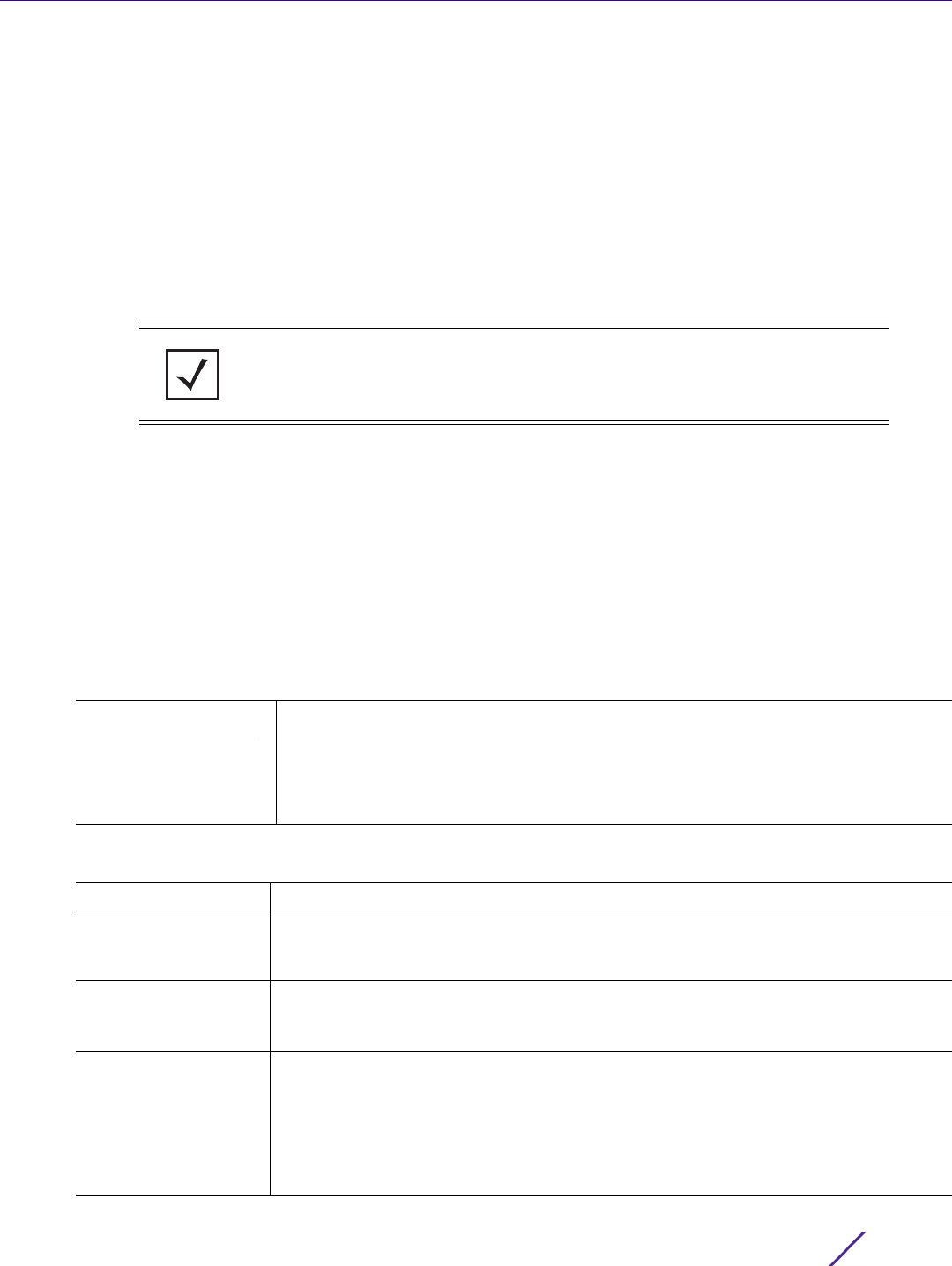
SHOW COMMANDS
Access Point, Wireless Controller and Service Platform CLI Reference Guide 6 - 89
6.1.37 l2tpv3
show commands
Displays a Layer 2 Tunnel Protocol Version 3 (L2TPV3) session information
Supported in the following platforms:
• Access Points — AP6521, AP6522, AP6532, AP6562, AP7161, AP7502, AP7522, AP7532, AP7562,
AP7602, AP7612, AP7622, AP7632, AP7662, AP81XX, AP8232, AP8432, AP8533
• Wireless Controllers — RFS4000, RFS6000
• Service Platforms — NX5500, NX7500, NX7510, NX7520, NX7530, NX9500, NX9510, NX9600,
VX9000
Syntax
l2tpv3 {on|tunnel|tunnel-summary}
l2tpv3 {on <DEVICE-NAME>}
l2tpv3 {tunnel <L2TPV3-TUNNEL-NAME>} {session <L2TPV3-SESSION-NAME>} {(on <DEVICE-
NAME>)}
l2tpv3 {tunnel-summary} {down|on|up}
l2tpv3 {tunnel-summary} {on <DEVICE-NAME>}
l2tpv3 {tunnel-summary} {down|up} {on <DEVICE-NAME>}
Parameters
• l2tpv3 {on <DEVICE-NAME>}
• l2tpv3 {tunnel <L2TPV3-TUNNEL-NAME>} {session <L2TPV3-SESSION-NAME>} {(on
<DEVICE-NAME>)}
NOTE: This command is not available in the USER EXEC mode.
l2tpv3
{on <DEVICE-NAME>}
Displays a L2TPv3 tunnel and session details or summary
• on <DEVICE-NAME> – Optional. Displays L2TPv3 information on a specified access
point or wireless controller
• <DEVICE-NAME> – Specify the name of AP, wireless controller, or service plat-
form.
l2tpv3 Displays a L2TPv3 tunnel and session details or summary
tunnel
<L2TPV3-TUNNEL-
NAME>
Optional. Displays a specified L2TPv3 tunnel information
• <L2TPV3-TUNNEL-NAME> – Specify the L2TPv3 tunnel name.
session
<L2TPV3-SESSION-
NAME>
Optional. Displays a specified L2TPv3 tunnel session information
• <L2TPV3-SESSION-NAME> – Specify the session name.
on <DEVICE-NAME> The following keyword is recursive and common to the ‘session <L2TPV3-SESSION-
NAME>’ parameter.
• on <DEVICE-NAME> – Optional. Displays a L2TPv3 tunnel and session details, based
on the parameters passed, on a specified device.
• <DEVICE-NAME> – Specify the name of AP, wireless controller, or service plat-
form.

SHOW COMMANDS
Access Point, Wireless Controller and Service Platform CLI Reference Guide 6 - 90
• l2tpv3 {tunnel-summary} {on <DEVICE-NAME>}
• l2tpv3 {tunnel-summary} {down|up} {on <DEVICE-NAME>}
Example
ap7131-11E6C4#show l2tpv3 tunnel-summary
--------------------------------------------------------------------------------
-------
Sl No Tunnel Name Tunnel State Estd/Total Sessions Encapsulation
Protocol
--------------------------------------------------------------------------------
-------
1 testTunnel Established (secured by ipsec) 1/1 IP
Total Number of Tunnels 1
ap7131-11E6C4#
ap7131-11E6C4#show l2tpv3
-------------------------------------------------------------------------------
Tunnel Name : testTunnel
Control connection id : 2238970979
Peer Address : 30.1.1.1
Local Address : 30.1.1.30
Encapsulation Protocol : IP
MTU : 1460
Peer Host Name : rfss
Peer Vendor Name : Example Company
Peer Control Connection ID : 322606389
Tunnel State : Established (secured by ipsec)
Establishment Criteria : always
Sequence number of the next msg to the peer : 29
Expected sequence number of the next msg from the peer :42
Sequence number of the next msg expected by the peer : 29
Retransmission count : 0
Reconnection count : 0
Uptime : 0 days 1 hours 2 minutes 47 seconds
-------------------------------------------------------------------------------
Session Name : session1
VLANs : 30
Pseudo Wire Type : Ethernet_VLAN
Serial number for the session : 6
l2tpv3 Displays L2TPv3 tunnel and session details or summary
For an L2TPv3 tunnel over Auto IPSec, the tunnel status is displayed as: Established
(secured by ipsec)
tunnel-summary
{on <DEVICE-NAME>}
Optional. Displays L2TPv3 tunnel summary
• on <DEVICE-NAME> – Optional. Displays a L2TPv3 tunnel summary on a specified
device
• <DEVICE-NAME> – Specify the name of AP, wireless controller, or service plat-
form.
l2tpv3 Displays a L2TPv3 tunnel and session details or summary
tunnel-summary Optional. Displays a L2TPv3 tunnel summary, based on the parameters passed
down Optional. Displays un-established tunnels summary
up Optional. Displays established tunnels summary
on <DEVICE-NAME> The following keyword is common to the ‘down’ and ‘up’ parameters:
• on <DEVICE-NAME> – Optional. Displays summary, for un-established or established
tunnels, on a specified device
• <DEVICE-NAME> – Specify the name of AP, wireless controller, or service plat-
form.

SHOW COMMANDS
Access Point, Wireless Controller and Service Platform CLI Reference Guide 6 - 91
Local Session ID : 129538998
Remote Session ID : 8151374
Size of local cookie (0, 4 or 8 bytes) : 0
First word of local cookie : 0
Second word of local cookie : 0
Size of remote cookie (0, 4 or 8 bytes) : 0
First word of remote cookie : 0
Second word of remote cookie : 0
Session state : Established
Remote End ID : 444
Trunk Session : 1
Native VLAN tagged : Enabled
Native VLAN ID : 0
Number of packets received : 0
Number of bytes received : 0
Number of packets sent : 0
Number of bytes sent : 0
Number of packets dropped : 0
ap7131-11E6C4#

SHOW COMMANDS
Access Point, Wireless Controller and Service Platform CLI Reference Guide 6 - 92
6.1.38 lacp
show commands
Displays Link Aggregation Control Protocol (LACP) related information
Supported in the following platforms:
• Service Platforms — NX5500, NX7500, NX7510, NX7520, NX7530, NX9500, NX9510, NX9600,
VX9000
Syntax
show lacp [<1-4>|counters|details|sys-id]
show lacp <1-4> ([counters|details])
show lacp sys-id
Parameters
• show lacp <1-4> ([counters|details])
• show lacp sys-id
NOTE: For more information on enabling dynamic LACP, see lacp, lacp-channel-group, and
lacp.
show lacp <1-4> Shows the LACP related information for a specified port-channel or all port-channels
using LACP
• <1-4> – Select the port-channel index number from 1 - 4. Note, LACP is supported
only on the NX5500, NX7500, and NX9500 model service platforms. However, the
NX9500 series service platforms support only two (2) port-channels. Where as the
other model service platforms support four (4) port-channels.
If the port-channel index number is not specified, the system displays LACP
counters and details for all port-channels configured on the device.
counters Shows LACP counters for LACP-enabled port-channels. When passed without the
<1-4> keyword, the system displays LACP counters for all configured port-channels.
However, if the port-channel index number is specified, the system displays LACP
counters only for the specified port-channel.
details Shows details for LACP-enabled port-channels. When passed without the <1-4>
keyword, the system displays LACP details for all configured port-channels. However,
if the port-channel index number is specified, the system displays LACP details only
for the specified port-channel.
show lacp sys-id Shows the LACP related information for all LACP-enabled port-channels
• sys-id – Shows the LACP system identifier and priority. This is the identifier assigned
to the LACP peers (devices).

SHOW COMMANDS
Access Point, Wireless Controller and Service Platform CLI Reference Guide 6 - 93
Example
NOC-controller#show interface port-channel 1
Interface port-channel1 is UP
Hardware-type: aggregate, Mode: Layer 2, Address: 84-24-8D-7F-35-C8
Index: 2018, Metric: 1, MTU: 1500
Speed: Admin Auto, Operational 20G, Maximum 20G
Duplex: Admin Auto, Operational Full
Active-medium: n/a
Channel-members: xge1 xge2
Switchport settings: trunk, access-vlan: n/a
Input packets 5121052, bytes 807510883, dropped 0
Received 5121052 unicasts, 0 broadcasts, 516544 multicasts
Input errors 0, runts 0, giants 0
CRC 0, frame 0, fragment 0, jabber 0
Output packets 4804420, bytes 1053174746, dropped 0
Sent 4804420 unicasts, 0 broadcasts, 0 multicasts
Output errors 0, collisions 0, late collisions 0
Excessive collisions 0
NOC-controller#
NOC-controller#show interface port-channel 4
Interface port-channel4 is UP
Hardware-type: aggregate, Mode: Layer 2, Address: 84-24-8D-7F-35-C4
Index: 2016, Metric: 1, MTU: 1500
Speed: Admin Auto, Operational 4G, Maximum 4G
Duplex: Admin Auto, Operational Full
Active-medium: n/a
Channel-members: ge2 ge3 ge4 ge5
Switchport settings: trunk, access-vlan: n/a
Input packets 5848499493, bytes 8772550780653, dropped 0
Received 5848499493 unicasts, 0 broadcasts, 120167 multicasts
Input errors 0, runts 0, giants 0
CRC 0, frame 0, fragment 0, jabber 0
Output packets 362245, bytes 33129264, dropped 0
Sent 362245 unicasts, 0 broadcasts, 0 multicasts
Output errors 0, collisions 0, late collisions 0
Excessive collisions 0
NOC-controller#
NOC-controller#show lacp counters
Port-Channel Interface LACPDU Marker
Packet error
Sent Recv Sent Recv Sent Recv
pc1 xge1 11548 12479 0 0 0 0
pc1 xge2 11550 12469 0 0 0 0
pc4 ge2 14081 14041 0 0 0 0
pc4 ge3 15877 15874 0 0 0 0
pc4 ge4 15875 15874 0 0 0 0
pc4 ge5 14064 14052 0 0 0 0
NOC-controller#
NOC-controller#show lacp details
Port-Channel pc1 Interface xge1:
Actor admin port key : 1
Actor oper port key : 1
Actor port priority : 32768
Actor port number : 2011
Actor admin port state : ActiveLACP LongTimeout Aggregatable
OUT_OF_SYNC Defaulted
Actor oper port state : ActiveLACP LongTimeout Aggregatable IN_SYNC
Collecting Distributing
Partner admin system ID : 32768, 00-00-00-00-00-00
Partner oper system ID : 32768, 44-03-A7-BF-00-00
Partner admin key : 0
Partner oper key : 1

SHOW COMMANDS
Access Point, Wireless Controller and Service Platform CLI Reference Guide 6 - 94
Partner admin port priority : 0
Partner oper port priority : 32768
Partner admin port number : 0
Partner oper port number : 286
Partner admin port state : PassiveLACP LongTimeout Aggregatable
OUT_OF_SYNC Defaulted
Partner oper port state : ActiveLACP LongTimeout Aggregatable IN_SYNC
Collecting Distributing
Receive machine state : Current
Periodic transmission machine state : Slow periodic
Mux machine state : Collecting/Distributing
Port-Channel pc1 Interface xge2:
Actor admin port key : 1
Actor oper port key : 1
Actor port priority : 32768
Actor port number : 2012
Actor admin port state : ActiveLACP LongTimeout Aggregatable
OUT_OF_SYNC Defaulted
--More--
NOC-controller#
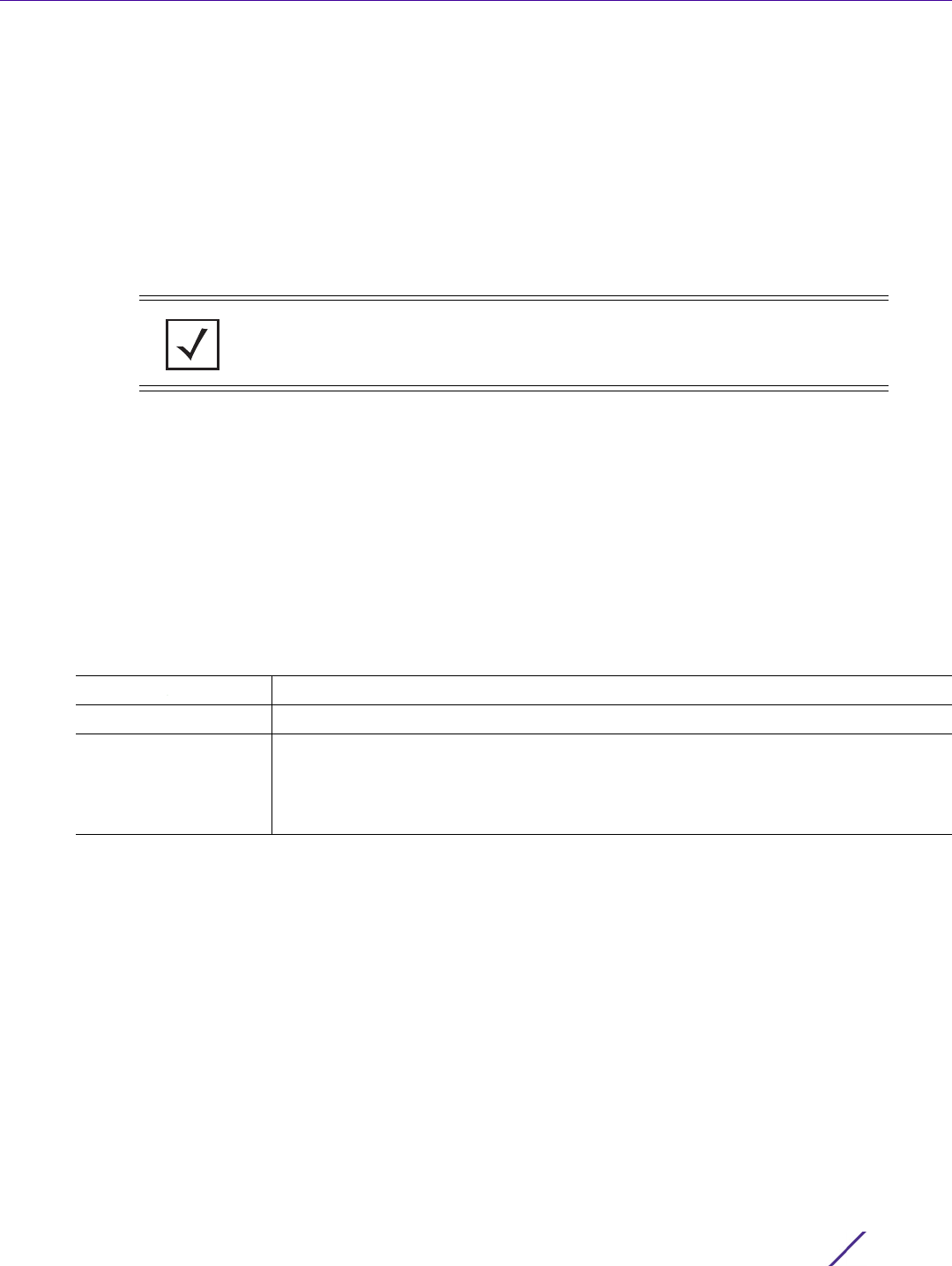
SHOW COMMANDS
Access Point, Wireless Controller and Service Platform CLI Reference Guide 6 - 95
6.1.39 ldap-agent
show commands
Displays an LDAP agent’s join status (join status to a LDAP server domain)
Use this command When LDAP is specified the external resource (as opposed to local RADIUS resources)
to validate PEAP-MS-CHAP v2 authentication requests, user credentials, and password information needs
to be made available locally to successfully connect to the external LDAP server. Up to two LDAP Agents
(primary and secondary external resources) can be defined as external resources for PEAP-MS-CHAP v2
authentication requests.
Supported in the following platforms:
• Access Points — AP6521, AP6522, AP6532, AP6562, AP7161, AP7502, AP7522, AP7532, AP7562,
AP7602, AP7612, AP7622, AP7632, AP7662, AP81XX, AP8232, AP8432, AP8533
• Wireless Controllers — RFS4000, RFS6000
• Service Platforms — NX5500, NX7500, NX7510, NX7520, NX7530, NX9500, NX9510, NX9600,
VX9000
Syntax
show ldap-agent join-status {on <DEVICE-NAME>}
Parameters
• show ldap-agent join-status {on <DEVICE-NAME>}
Example
rfs6000-81701D#show ldap-agent join-status
Primary LDAP Server's agent join-status : Joined domain TEST.
Secondary LDAP Server's agent join-status : Not Configured
rfs6000-81701D#
NOTE: This command is not available in the USER EXEC Mode.
ldap-agent Displays LDAP agent related configuration
join-status Displays if the LDAP agent has successfully joined a LDAP server’s domain
on <DEVICE-NAME> Optional. Displays if the LDAP agent has successfully joined a specified LDAP
server’s domain.
• <DEVICE-NAME> – Specify the name of the device running the LDAP server (access
point, wireless controller, or service platform).

SHOW COMMANDS
Access Point, Wireless Controller and Service Platform CLI Reference Guide 6 - 96
6.1.40 licenses
show commands
Displays installed licenses and usage information
Supported in the following platforms:
• Access Points — AP6521, AP6522, AP6532, AP6562, AP7161, AP7502, AP7522, AP7532, AP7562,
AP7602, AP7612, AP7622, AP7632, AP7662, AP81XX, AP8232, AP8432, AP8533
• Wireless Controllers — RFS4000, RFS6000
• Service Platforms — NX5500, NX7500, NX7510, NX7520, NX7530, NX9500, NX9510, NX9600,
VX9000
Syntax
show licenses {borrowed|lent}
Parameters
• show licenses {borrowed|lent}
Usage Guidelines
The WiNG HM network defines a three-tier structure, consisting of multiple wireless sites managed by a
single Network Operations Center (NOC) controller, The NOC and the site controllers constitute the first
and second tiers of the hierarchy respectively. The site controllers in turn adopt and manage access points
that form the third tier of the hierarchy. The site controllers may or may not be grouped to form clusters.
At the time of adoption, access points and adaptive access points are provided license by the adopting
controller. These license packs can be installed on both the NOC and site controllers. When a AP/AAP is
adopted by a controller, the controller pushes a license on to the device. At this point the various possible
scenarios are:
• AP/AAP license packs installed on the NOC controller only.
The NOC controller provides the site controllers with the AP licenses, ensuring that per platform limits are
not exceeded.
• AP/AAP license packs installed on the NOC and site controllers.
The site controller uses its installed licenses and, in case of a shortage, the site controller borrows additional
licenses from the NOC. If the NOC controller is unable to allocate sufficient licenses, the site controller
unadopts some of the AP/AAPs.
• AP/AAP license packs installed on one controller within a cluster.
The site controller shares its installed and borrowed licenses with other cluster controllers.
licenses
{borrowed|lent}
Displays installed licenses and usage information
• borrowed – Optional. Displays information on licenses borrowed
• lent – Optional. Displays information on licenses lent

SHOW COMMANDS
Access Point, Wireless Controller and Service Platform CLI Reference Guide 6 - 97
Example
rfs4000-229D58#show licenses
Serial Number : 9184521800027
Device Licenses:
AP-LICENSE
String : DEFAULT-6AP-LICENSE
Value : 6
Borrowed : 0
Total : 6
Used : 0
AAP-LICENSE
String :
Value : 0
Borrowed : 0
Total : 0
Used : 0
ADVANCED-SECURITY
String : DEFAULT-ADV-SEC-LICENSE
rfs4000-229D58#
The following example shows the show > licenses command output on a NOC controller:
nx9500-6C8809#show licenses
Serial Number : B4C7996C8809
Device Licenses:
AP-LICENSE
String :
Value : 0
Lent : 0
Total : 0
Used : 0
AAP-LICENSE
String :
66069c24b3bb1259b34ff016c723a9e299dd408f0ff891e7c5f7e279a382648397d6b3e975e356a1
Value : 10250
Lent : 0
Total : 10250
Used : 7
HOTSPOT-ANALYTICS
String :
66069c24b3bb1259eb36826cab3cc83999dd408f0ff891e74b62b2d3594f0b3dde7967f30e49e497
Total Licenses Including Licenses in Adopted Controllers:
AP-LICENSE
Value : 14
Used : 1
AAP-LICENSE
Value : 10250
Used : 7
nx9500-6C8809#

SHOW COMMANDS
Access Point, Wireless Controller and Service Platform CLI Reference Guide 6 - 98
In the following example, the ‘VALIDITY(HRS)’ column specifies the validity period, in days and hours,
of a lent license. On a NOC controller, a ‘VALIDITY(HRS)’ value of ‘current’ implies that the site
controller is currently adopted. Whereas, a numerical ‘VALIDITY(HRS)’ value indicates the days and
hours the lent license is valid for a site controller that is not reachable.
nx9500-6C8809#show licenses lent
--------------------------------------------------------------------------------
----------------------------
MAC HOST-NAME TYPE LENT BORROWER-MAC BORROWER-
HOST-NAME VALIDITY
--------------------------------------------------------------------------------
----------------------------
B4-C7-99-6C-88-09 nx9500-6C8809 AAP 5 00-15-70-81-74-2D rfs6000-
81742D current
B4-C7-99-6C-88-09 nx9500-6C8809 AAP 9 B4-C7-99-6D-CD-4B rfs7000-
6DCD4B 97 days, 21 hours
--------------------------------------------------------------------------------
----------------------------
nx9500-6C8809#
rfs4000-881E4B#show licenses borrowed
-----------------------------------------------------------------------------
MAC HOST-NAME TYPE BORROWED VALIDITY
-----------------------------------------------------------------------------
00-15-70-37-FD-89 rfs7000-37FD89 AAP 2 99 days, 23 hours
00-15-70-81-70-1D rfs6000-81701D AP 1 99 days, 23 hours
-----------------------------------------------------------------------------
rfs4000-881E4B#
The following examples show the ‘show > licenses’ output on the devices participating in the process:
nx9500-6C8809>show licenses lent
--------------------------------------------------------------------------------
----------------------------
MAC HOST-NAME TYPE LENT BORROWER-MAC BORROWER-
HOST-NAME VALIDITY
--------------------------------------------------------------------------------
----------------------------
B4-C7-99-6C-88-09 nx9500-6C8809 AAP 1 00-15-70-81-74-2D rfs6000-
81742D current
B4-C7-99-6C-88-09 nx9500-6C8809 AAP 9 B4-C7-99-6D-CD-4B rfs7000-
6DCD4B 99 days, 23 hours
--------------------------------------------------------------------------------
----------------------------
nx9500-6C8809>
rfs6000-81742D(config)#show licenses borrowed
-----------------------------------------------------------------------------
MAC HOST-NAME TYPE BORROWED VALIDITY
-----------------------------------------------------------------------------
B4-C7-99-6C-88-09 nx9500-6C8809 AAP 1 current
-----------------------------------------------------------------------------
rfs6000-81742D(config)#

SHOW COMMANDS
Access Point, Wireless Controller and Service Platform CLI Reference Guide 6 - 99
6.1.41 lldp
show commands
Displays Link Layer Discovery Protocol (LLDP) information
Supported in the following platforms:
• Access Points — AP6521, AP6522, AP6532, AP6562, AP7161, AP7502, AP7522, AP7532, AP7562,
AP7602, AP7612, AP7622, AP7632, AP7662, AP81XX, AP8232, AP8432, AP8533
• Wireless Controllers — RFS4000, RFS6000
• Service Platforms — NX5500, NX7500, NX7510, NX7520, NX7530, NX9500, NX9510, NX9600,
VX9000
Syntax
show lldp [neighbors|report]
show lldp neighbors {on <DEVICE-NAME>}
show lldp report {detail|on}
show lldp report {detail} {(on <DEVICE-OR-DOMAIN-NAME>)}
Parameters
• show lldp neighbors {on <DEVICE-NAME>}
• show lldp report {detail} {(on <DEVICE-OR-DOMAIN-NAME>)}
Example
nx9500-6C8809#show lldp neighbors
-------------------------
Chassis ID: 00-18-71-D0-0B-00
System Name: TechPubs-ProCurve-Switch
Platform: ProCurve J8697A Switch 5406zl, revision K.12.1X, ROM K.11.03 (/sw/code/
build/btm(sw_esp1))
Capabilities: Bridge Router
Enabled Capabilities: Bridge
Local Interface: ge1, Port ID(Port Description) (outgoing port): 5(A5)
TTL: 113 sec
Management Addresses: 192.168.13.40
nx9500-6C8809#
lldp Displays an LLDP neighbors table or aggregated LLDP neighbors table
neighbors Displays an LLDP neighbors table
on <DEVICE-NAME> Optional. Displays an LLDP neighbors table on a specified device
• <DEVICE-NAME> – Specify the name of the AP, wireless controller, or service
platform.
lldp Displays an LLDP neighbors table or aggregated LLDP neighbors table
report detail Displays an aggregated LLDP neighbors table
• detail – Optional. Displays detailed aggregated LLDP neighbors table
Note: If the ‘on’ keyword is used without the ‘detail’ keyword, the system displays LLDP
neighbors table summary on the specified device or RF Domain.
on <DEVICE-OR-
DOMAIN-NAME>
The following keyword is recursive and common to the ‘report detail’ parameter:
• on <DEVICE-OR-DOMAIN-NAME> – Displays an aggregated LLDP neighbors table
on a specified device or RF Domain
• <DEVICE-OR-DOMAIN-NAME> – Specify the name of the AP, wireless controller,
service platform, or RF Domain.

SHOW COMMANDS
Access Point, Wireless Controller and Service Platform CLI Reference Guide 6 - 100
6.1.42 logging
show commands
Displays the network’s activity log
Supported in the following platforms:
• Access Points — AP6521, AP6522, AP6532, AP6562, AP7161, AP7502, AP7522, AP7532, AP7562,
AP7602, AP7612, AP7622, AP7632, AP7662, AP81XX, AP8232, AP8432, AP8533
• Wireless Controllers — RFS4000, RFS6000
• Service Platforms — NX5500, NX7500, NX7510, NX7520, NX7530, NX9500, NX9510, NX9600,
VX9000
Syntax
show logging {on <DEVICE-NAME>}
Parameters
• show logging {on <DEVICE-NAME>}
Example
nx9500-6C8809#show logging
Logging module: enabled
Aggregation time: disabled
Console logging: level debugging
Monitor logging: disabled
Buffered logging: level warnings
Syslog logging: level warnings
Facility: local7
Log Buffer (1666269 bytes):
May 14 05:30:23 2015: nx9500-6C8809 : %DIAG-4-PWRSPLY_FAIL: Power supply failure,
no longer redundant
May 14 05:30:13 2015: nx9500-6C8809 : %DEVICE-4-OFFLINE: Device B4-C7-99-74-B4-
5C(ap8132-74B45C) is offline, last seen:10 minutes ago on switchport rfs6000-
6DB5D4:ge1
May 14 05:20:16 2015: nx9500-6C8809 : %DIAG-4-PWRSPLY_FAIL: Power supply failure,
no longer redundant
May 14 05:19:43 2015: nx9500-6C8809 : %DEVICE-4-OFFLINE: Device B4-C7-99-74-B4-
5C(ap8132-74B45C) is offline, last seen:10 minutes ago on switchport rfs6000-
380649:ge1
--More--
nx9500-6C8809#
logging
{on <DEVICE-NAME>}
Displays logging information on a specified device
• on <DEVICE-NAME> – Optional. Executes the command on a specified device.
• <DEVICE-NAME> – Specify the name of the AP, wireless controller, or service
platform.

SHOW COMMANDS
Access Point, Wireless Controller and Service Platform CLI Reference Guide 6 - 101
6.1.43 mac-access-list
show commands
Displays MAC access list statistics
Supported in the following platforms:
• Access Points — AP6521, AP6522, AP6532, AP6562, AP7161, AP7502, AP7522, AP7532, AP7562,
AP7602, AP7612, AP7622, AP7632, AP7662, AP81XX, AP8232, AP8432, AP8533
• Wireless Controllers — RFS4000, RFS6000
• Service Platforms — NX5500, NX7500, NX7510, NX7520, NX7530, NX9500, NX9510, NX9600,
VX9000
Syntax
show mac-access-list stats {<MAC-ACCESS-LIST-NAME>|on}
show mac-access-list stats {<MAC-ACCESS-LIST-NAME>} {(on <DEVICE-NAME>)}
Parameters
• show mac-access-list stats {<MAC-ACCESS-LIST-NAME>} {(on <DEVICE-NAME>)}
Example
nx9500-6C8809#show mac-access-list stats scalemacacl | i 311
permit D0-67-E5-3F-C0-00 FF-FF-FF-FF-F0-00 host 00-1E-EC-F2-0A-76 rule-
precedence 311 Hitcount: 0 Hardware Hitcount: 0
nx9500-6C8809#
NOTE: This command is not present in USER EXEC mode.
mac-access-list stats Displays MAC access list statistics
<MAC-ACCESS-LIST> Optional. Displays statistics for a specified MAC access list. Specify the MAC access
list name.
Note: The system displays all configured ACL statistics if no ACL name is specified.
on <DEVICE-NAME> Optional. Displays all or a specified MAC access list statistics on a specified device
• <DEVICE-NAME> – Specify the name of the AP, wireless controller, or service
platform.

SHOW COMMANDS
Access Point, Wireless Controller and Service Platform CLI Reference Guide 6 - 102
6.1.44 mac-address-table
show commands
Displays MAC address table entries
Supported in the following platforms:
• Access Points — AP6521, AP6522, AP6532, AP6562, AP7161, AP7502, AP7522, AP7532, AP7562,
AP7602, AP7612, AP7622, AP7632, AP7662, AP81XX, AP8232, AP8432, AP8533
• Wireless Controllers — RFS4000, RFS6000
• Service Platforms — NX5500, NX7500, NX7510, NX7520, NX7530, NX9500, NX9510, NX9600,
VX9000
Syntax
show mac-address-table {on <DEVICE-NAME>}
Parameters
• show mac-address-table {on <DEVICE-NAME>}
Example
rfs6000-81742D(config)#show mac-address-table
--------------------------------------------------------
BRIDGE VLAN PORT MAC STATE
--------------------------------------------------------
1 1 up1 00-02-B3-28-D1-55 forward
1 1 up1 00-0F-8F-19-BA-4C forward
1 1 up1 84-24-8D-80-C2-AC forward
1 1 up1 84-24-8D-80-BF-34 forward
1 1 up1 1C-7E-E5-18-FA-67 forward
1 1 up1 84-24-8D-83-30-A4 forward
1 1 up1 B4-C7-99-DD-31-C8 forward
1 1 up1 B4-C7-99-6C-88-09 forward
1 1 up1 00-18-71-D0-1B-F3 forward
1 1 up1 B4-C7-99-71-17-28 forward
1 1 up1 FC-0A-81-42-93-6C forward
1 1 up1 B4-C7-99-6D-CD-4B forward
1 1 up1 84-24-8D-84-A2-24 forward
1 1 up1 3C-CE-73-F4-47-83 forward
1 1 up1 B4-C7-99-74-B4-5C forward
--------------------------------------------------------
Total number of MACs displayed: 15
rfs6000-81742D(config)#
mac-address-table Displays MAC address table entries
on <DEVICE-NAME> Optional. Displays MAC address table entries on a specified device
• <DEVICE-NAME> – Specify the name of the AP, wireless controller, or service
platform.

SHOW COMMANDS
Access Point, Wireless Controller and Service Platform CLI Reference Guide 6 - 103
6.1.45 mac-auth
show commands
Displays details of wired ports that have MAC address authentication enabled
Use this command to view MAC authentication configuration and authentication state. The command
displays the current authentication state of the wired host, the authorization state of the Ge1 port, and the
wired hosts’ MAC address. The port status displays as Authorized if the wired host has successfully
authenticated and Not Authorized if the wired host has not authenticated or has failed MAC authentication.
For more information on enabling MAC address authentication on a wired port, see mac-auth.
Supported in the following platforms:
• Access Points — AP6511
• Wireless Controllers — RFS4000, RFS6000
Syntax
show mac-auth {all|interface|on}
show mac-auth {all|interface [<INTERFACE-NAME>|ge <1-5>|port-channel <1-3>|t1e1
<1-4>|up <1-2>|xge <1-4>]} {(on <DEVICE-NAME>)}
Parameters
• show mac-auth {all|interface [<INTERFACE-NAME>|ge <1-5>|port-channel <1-3>|t1e1
<1-4>|up <1-2>|xge <1-4>]} {(on <DEVICE-NAME>)}
mac-auth Displays MAC authentication related information for all interfaces or all interfaces
all Optional. Displays MAC authentication related information for all interfaces
interface
[<INTERFACE-
NAME>|ge <1-5>|
port-channel <1-3>|
t1e1 <1-4>|up <1-2>|
xge <1-4>]
Optional. Displays MAC authentication related information for a specified interface.
Specify the interface using one of the following options:
• <INTERFACE-NAME> – Selects the interface identified by the <INTERFACE-NAME>
keyword
• ge <1-5> – Selects the GigabitEthernet interface identified by the index number
• port-channel <1-3> – Selects the port channel interface identified by the index number
• t1e1 <1-4> – Selects the layer 2 interface (Ethernet port)
• up <1-2> – Selects the WAN Ethernet interface identified by the index number
• xge <1-4> – Selects the TenGigabitEthernet interface identified by the index number
on <DEVICE-NAME> The following keywords are common to the ‘all’ and ‘interface’ parameters:
• on <DEVICE-NAME> – Optional. Displays MAC authentication related information on
a specified device
• <DEVICE-NAME> – Specify the name of the AP, wireless controller, or service plat-
form.
Note: When the ‘on’ keyword is used exclusively, without the ‘all’ and ‘interface’ options,
the system displays MAC authentication related information for interfaces configured on
the specified device.

SHOW COMMANDS
Access Point, Wireless Controller and Service Platform CLI Reference Guide 6 - 104
Example
rfs4000-229D58(config)#show mac-auth all
AAA-Policy is none
Mac Auth info for interface GE1
-----------------------------------
Mac Auth Enabled
Mac Auth Not Authorized
Mac Auth info for interface GE2
-----------------------------------
Mac Auth Disabled
Mac Auth Not Authorized
Mac Auth info for interface GE3
-----------------------------------
Mac Auth Disabled
Mac Auth Not Authorized
Mac Auth info for interface GE4
-----------------------------------
Mac Auth Disabled
Mac Auth Authorized
Mac Auth info for interface GE5
-----------------------------------
Mac Auth Disabled
Mac Auth Not Authorized
Mac Auth info for interface UP1
-----------------------------------
Mac Auth Disabled
Mac Auth Not Authorized
rfs4000-229D58(config)#

SHOW COMMANDS
Access Point, Wireless Controller and Service Platform CLI Reference Guide 6 - 105
6.1.46 mac-auth-clients
show commands
Displays MAC authenticated clients
Supported in the following platforms:
• Access Points — AP6511
• Wireless Controllers — RFS4000, RFS6000
Syntax
show mac-auth-clients [all|interface]
show mac-auth-clients all {on <DEVICE-NAME>}
show mac-auth-clients interface {<INF-NAME>|ge <1-X>|port-channel <1-2>|xge <1-4>}
Parameters
• show mac-auth-clients all {on <DEVICE-NAME>}
• show mac-auth-clients interface {<INF-NAME>|ge <1-X>|port-channel <1-2>|xge <1-
4>}
mac-auth-clients Displays MAC authenticated clients based on the parameters passed. The options
are: all and interface.
all Displays MAC authenticated clients for all interfaces
on <DEVICE-NAME> Optional. Displays MAC authenticated clients for all interfaces on a specified device
• <DEVICE-NAME> – Specify the name of the AP, wireless controller, or service
platform.
mac-auth-clients Displays MAC authenticated clients based on the parameters passed. The options
are: all and interface.
interface
[<INF-NAME>|
ge <1-X>|
port-channel <1-2>|
xge <1-4>]
Displays MAC authenticated clients for the specified interface. Select the interface
type from the following options:
• <INF-NAME> – Optional. Displays MAC authenticated clients for the interface
identified by the <INF-NAME> keyword. Specify the layer 2 (ethernet port) interface
name.
• ge <1-X> – Optional. Displays MAC authenticated clients for the selected
GigabitEthernet interface. Specify the GE interface index from 1 - X. This will vary for
different device types.
• port-channel <1-2> – Optional. Displays MAC authenticated clients for the selected
port channel interface. Specify the port channel interface index from 1 - 2.
• xge <1-4> – Optional. Displays MAC authenticated clients for the selected
TenGigabitEthernet interface. Specify the interface index from 1 - 4.
on <DEVICE-NAME> Optional. Displays MAC authenticated clients for the specified interface on a
specified device
• <DEVICE-NAME> – Specify the name of the AP, wireless controller, or service
platform.

SHOW COMMANDS
Access Point, Wireless Controller and Service Platform CLI Reference Guide 6 - 106
Example
nx9500-6C8809(config-device-B4-C7-99-6C-88-09)#show mac-auth-clients interface ge
1
-----------------------------------------------
MAC STATE INTERFACE
-----------------------------------------------
-----------------------------------------------
Total number of MACs displayed: 0
nx9500-6C8809(config-device-B4-C7-99-6C-88-09)#

SHOW COMMANDS
Access Point, Wireless Controller and Service Platform CLI Reference Guide 6 - 107
6.1.47 mint
show commands
Displays MiNT protocol related statistics
Supported in the following platforms:
• Access Points — AP6521, AP6522, AP6532, AP6562, AP7161, AP7502, AP7522, AP7532, AP7562,
AP7602, AP7612, AP7622, AP7632, AP7662, AP81XX, AP8232, AP8432, AP8533
• Wireless Controllers — RFS4000, RFS6000
• Service Platforms — NX5500, NX7500, NX7510, NX7520, NX7530, NX9500, NX9510, NX9600,
VX9000
Syntax
show mint [config|dis|id|info|known-adopters|links|lsp|lsp-db|mlcp|neighbors|
route|stats|tunnel-controller|tunneled-vlans]
show mint [config|id|info|known-adopters|route|stats|tunneled-vlans] {on <DEVICE-
NAME>}
show mint [dis|links|neighbors|tunnel-controller] {details} {(on <DEVICE-NAME>)}
show mint lsp
show mint lsp-db {details <MINT-ADDRESS>} {(on <DEVICE-NAME>)}
show mint mlcp {history} {(on <DEVICE-NAME>)}
Parameters
• show mint [config|id|info|known-adopters|route|stats|tunneled-vlans] {on
<DEVICE-NAME>}
• show mint [dis|links|neighbors|tunnel-controller] {details} {(on <DEVICE-NAME>)}
mint Displays MiNT protocol information based on the parameters passed
config Displays MiNT configuration
id Displays local MiNT ID
info Displays MiNT status
known-adopters Displays known, possible, or reachable adopters
route Displays MiNT route table details
stats Displays MiNT related statistics
tunneled-vlans Displays MiNT tunneled VLAN details
on <DEVICE-NAME> The following keywords are common to all of the above parameters:
• on <DEVICE-NAME> – Optional. Displays MiNT protocol details on a specified device
• <DEVICE-NAME> – Specify the name of the AP, wireless controller, or service plat-
form.
mint Displays MiNT protocol information based on the parameters passed
dis Displays MiNT network Designated Intermediate Systems (DISes) and Ethernet
Virtualization Interconnects (EVISes)
links Displays MiNT networking link details
neighbors Displays adjacent MiNT peer details

SHOW COMMANDS
Access Point, Wireless Controller and Service Platform CLI Reference Guide 6 - 108
• show mint lsp
• show mint lsp-db {details <MINT-ADDRESS>} {(on <DEVICE-NAME>)}
• show mint mlcp {history} {(on <DEVICE-NAME>)}
Example
nx9500-6C8809#show mint stats
9 Level-1 neighbors
Level-1 LSP DB size 26 LSPs (4 KB)
Last Level-1 SPFs took 0.000s
Level-1 SPF (re)calculated 818 times.
26 Level-1 paths.
0 Level-2 neighbors
Level-2 LSP DB size 0 LSPs (0 KB)
Last Level-2 SPFs took 0.000s
Level-2 SPF (re)calculated 0 times.
0 Level-2 paths.
nx9500-6C8809#
tunnel-controller Displays details of MiNT VLAN network tunnel wireless controllers for extended
VLAN load balancing
details
{(on <DEVICE-
NAME>)}
The following keywords are common to the ‘dis’, ‘links’, ‘neighbors’, and ‘tunnel-
controller’ parameters:
• details – Optional. Displays detailed MiNT information
• on <DEVICE-NAME> – Optional. This is a recursive parameter, which displays MiNT
information on a specified device.
• <DEVICE-NAME> – Specify the name of the AP, wireless controller, or service
platform.
mint Displays MiNT protocol information based on the parameters passed
lsp Displays this router's MiNT Label Switched Paths (LSPs)
mint Displays MiNT protocol information based on the parameters passed
lsp-db Displays MiNT LSP database entries
details
<MINT-ADDRESS>
Optional. Displays detailed MiNT LSP database entries
• <MINT-ADDRESS> – Specify the MiNT address in the AA.BB.CC.DD format.
on <DEVICE-NAME> The following keyword is recursive and common to the ‘details’ parameter:
• on <DEVICE-NAME> – Optional. Displays MiNT LSP database entries on a specified
device
• <DEVICE-NAME> – Specify the name of the AP or wireless controller
mint Displays MiNT protocol information based on the parameters passed
This command displays the ‘hello-interval’ and ‘hold-time’ default values for both IP
and VLAN links.
mlcp Displays IPv4 and IPv6 MiNT Link Creation Protocol (MLCP) status
history Optional. Displays MLCP client history
• on <DEVICE-NAME> – Optional. Displays MLCP client history on a specified device
on <DEVICE-NAME> The following keyword is recursive and common to the ‘history’ parameter:
• on <DEVICE-NAME> – Optional. Displays MLCP client history on a specified device
• <DEVICE-NAME> – Specify the name of the AP, wireless controller, or service plat-
form.

SHOW COMMANDS
Access Point, Wireless Controller and Service Platform CLI Reference Guide 6 - 109
nx9500-6C8809#show mint lsp
id 19.6C.88.09, level 1, 9 adjacencies, 0 extended-vlans
seqnum 1476782, expires in 29 minutes, republish in 1362 seconds
161 bytes, can-adopt: True, adopted-by: 00.00.00.00, dis-priority 5, Level-2-
gateway: False
hostname "nx9500-6C8809"
cluster id "TechPubs"
rf-domain "TechPubs", priority vector: 0x60dc0000
adjacent to 4D.83.30.A4, cost 10
adjacent to 4D.84.A2.24, cost 10
adjacent to 19.74.B4.5C, cost 10
adjacent to 19.6D.CD.4B, cost 10
adjacent to 19.DD.31.C8, cost 10
adjacent to 4D.80.C2.AC, cost 10
adjacent to 4D.80.BF.34, cost 10
adjacent to 19.71.17.28, cost 10
adjacent to 70.81.74.2D, cost 10
nx9500-6C8809#
nx9500-6C8809#show mint lsp-db
26 LSPs in LSP-db of 19.6C.88.09:
LSP 19.6C.88.09 at level 1, hostname "nx9500-6C8809", 9 adjacencies, seqnum 1476782
LSP 19.6C.8A.49 at level 1, hostname "nx9500-6C8A49pp", 9 adjacencies, seqnum 67397
LSP 19.6D.CD.4B at level 1, hostname "rfs7000-6DCD4B", 9 adjacencies, seqnum
1143297
LSP 19.71.17.28 at level 1, hostname "ap8132-711728", 9 adjacencies, seqnum 837272
LSP 19.72.D4.F4 at level 1, hostname "ap650-72D4F4", 2 adjacencies, seqnum 107768
LSP 19.72.D5.44 at level 1, hostname "ap4600-72D544", 9 adjacencies, seqnum 10889
LSP 19.72.E6.C4 at level 1, hostname "ap6532-72E6C4", 2 adjacencies, seqnum 109985
LSP 19.74.B4.5C at level 1, hostname "ap8132-74B45C", 9 adjacencies, seqnum 1659590
LSP 19.DD.31.C8 at level 1, hostname "rfs4000-DD31C8", 25 adjacencies, seqnum
1787045
LSP 1A.7C.D5.A4 at level 1, hostname "ap8222-7CD5A4", 9 adjacencies, seqnum 440488
LSP 1A.7E.79.E8 at level 1, hostname "ap8122-7E79E8", 9 adjacencies, seqnum 100282
LSP 1A.B1.9C.40 at level 1, hostname "ap7131-B19C40", 9 adjacencies, seqnum 95001
LSP 4D.80.BF.34 at level 1, hostname "Rajeev-AP", 9 adjacencies, seqnum 232516
LSP 4D.80.C2.AC at level 1, hostname "ap7532-80C2AC", 9 adjacencies, seqnum 842369
LSP 4D.83.30.A4 at level 1, hostname "ap7522-8330A4", 9 adjacencies, seqnum 478482
LSP 4D.84.A2.24 at level 1, hostname "ap7562-84A224", 9 adjacencies, seqnum 562219
LSP 4D.8A.15.C8 at level 1, hostname "AP1", 1 adjacencies, seqnum 92687
LSP 68.88.10.D1 at level 1, hostname "rfs4000-8810D1", 9 adjacencies, seqnum 115580
LSP 70.38.03.E7 at level 1, hostname "rfs7000-3803E7", 9 adjacencies, seqnum 947279
LSP 70.81.74.2D at level 1, hostname "rfs6000-81742D", 9 adjacencies, seqnum 487287
LSP 75.A2.A4.90 at level 1, hostname "ap7532-A2A490", 4 adjacencies, seqnum 181692
LSP 75.A2.A4.B0 at level 1, hostname "ap7532-A2A4B0", 4 adjacencies, seqnum 180804
LSP 75.A2.A5.54 at level 1, hostname "ap7532-A2A554", 4 adjacencies, seqnum 156084
LSP 75.A2.A5.6C at level 1, hostname "Snap004-AceessPoint", 4 adjacencies, seqnum
169181
LSP 75.D1.AA.7A at level 1, hostname "ap7622-D1AA7A", 9 adjacencies, seqnum 5471
LSP 75.D1.B2.68 at level 1, hostname "ap7602-D1B268", 9 adjacencies, seqnum 6054
nx9500-6C8809#
nx9500-6C8809#show mint route
Destination : Next-Hop(s)
4D.84.A2.24 : 4D.84.A2.24 via vlan-1
1A.7C.D5.A4 : 19.DD.31.C8 via vlan-1
68.88.10.D1 : 19.DD.31.C8 via vlan-1
19.72.E6.C4 : 19.DD.31.C8 via vlan-1
75.A2.A5.54 : 19.DD.31.C8 via vlan-1
1A.B1.9C.40 : 19.DD.31.C8 via vlan-1
70.81.74.2D : 70.81.74.2D via vlan-1
19.6C.8A.49 : 19.DD.31.C8 via vlan-1
19.74.B4.5C : 19.74.B4.5C via vlan-1
19.6D.CD.4B : 19.6D.CD.4B via vlan-1
19.72.D5.44 : 19.DD.31.C8 via vlan-1
75.D1.AA.7A : 19.DD.31.C8 via vlan-1
75.A2.A4.B0 : 19.DD.31.C8 via vlan-1
19.71.17.28 : 19.71.17.28 via vlan-1

SHOW COMMANDS
Access Point, Wireless Controller and Service Platform CLI Reference Guide 6 - 110
70.38.03.E7 : 19.DD.31.C8 via vlan-1
4D.80.C2.AC : 4D.80.C2.AC via vlan-1
19.6C.88.09 : 19.6C.88.09 via self
75.A2.A4.90 : 19.DD.31.C8 via vlan-1
1A.7E.79.E8 : 19.DD.31.C8 via vlan-1
19.DD.31.C8 : 19.DD.31.C8 via vlan-1
75.A2.A5.6C : 19.DD.31.C8 via vlan-1
19.72.D4.F4 : 19.DD.31.C8 via vlan-1
4D.83.30.A4 : 4D.83.30.A4 via vlan-1
4D.80.BF.34 : 4D.80.BF.34 via vlan-1
4D.8A.15.C8 : 19.DD.31.C8 via vlan-1
75.D1.B2.68 : 19.DD.31.C8 via vlan-1
nx9500-6C8809#
nx9500-6C8809#show mint known-adopters
19.6C.8A.49
nx9500-6C8809#
nx9500-6C8809#show mint known-adopters
19.6C.8A.49
nx9500-6C8809#
nx9500-6C8809#show min config
Base priority 5
DIS priority 5
Control priority 220
UDP/IP Mint encapsulation port 24576
Global Mint MTU 1500
nx9500-6C8809#
ap7532-15E6E4#show mint mlcp
MLCP VLAN state: MLCP_DONE
Potential VLAN links: 1
All VLANs were scanned 2 times
Link created on VLAN 1
MLCP IP state: MLCP_DISCOVERING
Potential L3 Links:
192.168.1.43
MCLP IP Hello Interval: 15s(default), Adjacency hold time: 46s(default)
MCLP VLAN Hello Interval: 4s(default), Adjacency hold time: 13s(default)
ap7532-15E6E4#

SHOW COMMANDS
Access Point, Wireless Controller and Service Platform CLI Reference Guide 6 - 111
6.1.48 nsight
show commands
Displays NSight related information and also displays the database server status (reachable or not)
Supported in the following platforms:
• Service Platforms — NX9500, NX9510, NX9600, VX9000
Syntax
show nsight status
Parameters
• show nsight status
Example
nx9500-6C8809(config)#show nsight status
Nsight is enabled
Nsight report and aggregation daemon is running
Nsight alarm daemon is running
Nsight server daemon is running
Database server is local
Database server is reachable
nx9500-6C8809(config)#
nsight Displays the NSight module related status, such as:
• NSight is enabled or not on the device
• NSight report and aggregation daemon is running or not
• NSight alarm daemon is running or not
• NSight server daemon is running or not
• Database server is reachable or not

SHOW COMMANDS
Access Point, Wireless Controller and Service Platform CLI Reference Guide 6 - 112
6.1.49 ntp
show commands
Displays Network Time Protocol (NTP) information. NTP enables clock synchronization within a network.
Supported in the following platforms:
• Access Points — AP6521, AP6522, AP6532, AP6562, AP7161, AP7502, AP7522, AP7532, AP7562,
AP7602, AP7612, AP7622, AP7632, AP7662, AP81XX, AP8232, AP8432, AP8533
• Wireless Controllers — RFS4000, RFS6000
• Service Platforms — NX5500, NX7500, NX7510, NX7520, NX7530, NX9500, NX9510, NX9600,
VX9000
Syntax
show ntp [associations|status]
show ntp [associations {detail|on}|status {on <DEVICE-NAME>}]
Parameters
• show ntp [associations {detail|on}|status {on <DEVICE-NAME>}]
ntp associations
{detail|on}
Displays existing NTP associations. The interaction between the controller or service
platform and a SNTP server constitutes an association. SNTP associations are of two
kinds:
- peer associations - where a controller or service platform synchronizes to another
system or allows another system to synchronize to it, or
- server associations - where only the controller or service platform synchronizes to
the SNTP resource, not the other way around.
• detail – Optional. Displays detailed NTP associations
• on <DEVICE-NAME> – Optional. Displays NTP associations on a specified device
• <DEVICE-NAME> – Specify the name of the AP, wireless controller, or service
platform.
Note: If the ‘on’ keyword is used without the ‘detail’ keyword, the system displays a
summary of existing NTP associations on the specified device or RF Domain.
ntp status
{on <DEVICE-NAME>}
Displays the performance (status) information relative to the NTP association status.
Use this command to view the access point, controller, or service platform’s current
NTP resource.
• on <DEVICE-NAME> – Optional. Displays NTP association status on a specified
device
• <DEVICE-NAME> – Specify the name of the AP, wireless controller, or
service platform.

SHOW COMMANDS
Access Point, Wireless Controller and Service Platform CLI Reference Guide 6 - 113
Example
nx9500-6C8809#show ntp associations
--------------------------------------------------------------------------------
-----------------------------------
STATUS NTP SERVER IP ADDR REF CLOCK IP ADDR STRATUM WHEN POLL REACH
DELAY OFFSET DISPERSION
--------------------------------------------------------------------------------
-----------------------------------
~ 12.12.12.12 INIT 16 - 1024 0 0.0
0.0 15937.5
~ 11.11.11.11 INIT 16 - 1024 0 0.0
0.0 15937.5
--------------------------------------------------------------------------------
-------
STATUS Notation: * master (synced), # master (unsynced), + selected, - candidate,
~ configured
nx9500-6C8809#
nx9500-6C8809#show ntp status
--------------------------------------------------------------------------------
ITEM VALUE
--------------------------------------------------------------------------------
Leap Clock is unsynchronized
Stratum 16
Reference INIT
Frequency 0.0000 Hz
Precision 2^-20
Reference time 00000000.00000000 (Feb 07 11:58:16 UTC 2036)
Clock Offset 0.000 msec
Root delay 0.000 msec
Root Dispersion 0.000 msec
--------------------------------------------------------------------------------
nx9500-6C8809#

SHOW COMMANDS
Access Point, Wireless Controller and Service Platform CLI Reference Guide 6 - 114
6.1.50 password-encryption
show commands
Displays password encryption status (enabled/disabled)
Supported in the following platforms:
• Access Points — AP6521, AP6522, AP6532, AP6562, AP7161, AP7502, AP7522, AP7532, AP7562,
AP7602, AP7612, AP7622, AP7632, AP7662, AP81XX, AP8232, AP8432, AP8533
• Wireless Controllers — RFS4000, RFS6000
• Service Platforms — NX5500, NX7500, NX7510, NX7520, NX7530, NX9500, NX9510, NX9600,
VX9000
Syntax
show password-encryption status
Parameters
• show password-encryption status
Example
rfs6000-81742D(config)#show password-encryption status
Password encryption is enabled
rfs6000-81742D(config)#
password-encryption
status
Displays password encryption status (enabled/disabled)

SHOW COMMANDS
Access Point, Wireless Controller and Service Platform CLI Reference Guide 6 - 115
6.1.51 pppoe-client
show commands
Displays Point-to-Point Protocol over Ethernet (PPPoE) client information
Use this command to view PPPoE statistics derived from access to high-speed data and broadband
networks. PPPoE uses standard encryption, authentication, and compression methods as specified by the
PPPoE protocol. PPPoE enables point-to-points connection to an ISP over existing Ethernet interface.
Supported in the following platforms:
• Access Points — AP6521, AP6522, AP6532, AP6562, AP7161, AP7502, AP7522, AP7532, AP7562,
AP7602, AP7612, AP7622, AP7632, AP7662, AP81XX, AP8232, AP8432, AP8533
• Wireless Controllers — RFS4000, RFS6000
• Service Platforms — NX5500, NX7500, NX7510, NX7520, NX7530, NX9500, NX9510, NX9600,
VX9000
Syntax
show pppoe-client [configuration|status] {on <DEVICE-NAME>}
Parameters
• show pppoe-client [configuration|status] {on <DEVICE-NAME>}
Example
nx9500-6C8809#show pppoe-client configuration
PPPoE Client Configuration:
+-------------------------------------------
| Mode : Disabled
| Service Name :
| Auth Type : pap
| Username :
| Password : fJx5O+5duPjaOaPuXmtLDQAAAAAmvgEXcQ1+eUK4ByHK4aRi
| Idle Time : 600
| Keepalive : Disabled
| Local n/w : vlan1
| Static IP : __wing_internal_not_set__
| MTU : 1492
+-------------------------------------------
nx9500-6C8809#
pppoe-client Displays PPPoE client information (configuration and status)
configuration Displays detailed PPPoE client configuration
status Displays detailed PPPoE client status
on <DEVICE-NAME> The following keywords are common to ‘configuration’ and ‘status’ parameters:
• on <DEVICE-NAME> – Optional. Displays detailed PPPoE client status or configuration
on a specified device
• <DEVICE-NAME> – Specify the name of the AP, wireless controller, or
service platform.

SHOW COMMANDS
Access Point, Wireless Controller and Service Platform CLI Reference Guide 6 - 116
6.1.52 privilege
show commands
Displays a device’s existing privilege level
Supported in the following platforms:
• Access Points — AP6521, AP6522, AP6532, AP6562, AP7161, AP7502, AP7522, AP7532, AP7562,
AP7602, AP7612, AP7622, AP7632, AP7662, AP81XX, AP8232, AP8432, AP8533
• Wireless Controllers — RFS4000, RFS6000
• Service Platforms — NX5500, NX7500, NX7510, NX7520, NX7530, NX9500, NX9510, NX9600,
VX9000
Syntax
show privilege
Parameters
None
Example
rfs6000-81742D(config)#show privilege
Current user privilege: superuser
rfs6000-81742D(config)#

SHOW COMMANDS
Access Point, Wireless Controller and Service Platform CLI Reference Guide 6 - 117
6.1.53 radius
show commands
Displays the amount of access time consumed and the amount of access time remaining for all guest users
configured on a RADIUS server
Every captive portal guest user can access the captive portal for a specified duration. This results in
following three scenarios:
• Scenario 1: Access duration not specified (in this case the default of 1440 minutes is applied)
• Scenario 2: Access duration is specified and is greater than 0
• Scenario 3: Access duration is specified and equals to 0 (in this case the guest user has unlimited
access)
In all the three scenarios the access time consumed is the duration for which the guest user has logged.
But the access time remaining varies. It is calculated as follows:
• Scenarios 1 & 2 - It is the lesser of the following two values: difference between the configured
access duration and the time consumed AND the time until user account expiration.
• Scenario 3 - It is the time until user account expiration
Supported in the following platforms:
• Access Points — AP6521, AP6522, AP6532, AP6562, AP7161, AP7502, AP7522, AP7532, AP7562,
AP7602, AP7612, AP7622, AP7632, AP7662, AP81XX, AP8232, AP8432, AP8533
• Wireless Controllers — RFS4000, RFS6000
• Service Platforms — NX5500, NX7500, NX7510, NX7520, NX7530, NX9500, NX9510, NX9600,
VX9000
Syntax
show radius [guest-users|server]
show radius guest-users {brief|<GUEST-USER-NAME>}
show radius server
Parameters
• show radius guest-users {brief|<GUEST-USER-NAME>}
radius guest-users
{brief|<GUEST-
USER-NAME>}
Displays RADIUS server’s guest user’s access details: total time for which the user has
logged in, and the amount of access time remaining.
• brief – Displays the total number of guest users provided RADIUS access
• <GUEST-USER-NAME> – Optional. Provide the name of the guest user (whose access
details are to be viewed). If no name is provided, the system displays details of all guest
users who have successfully logged in at least once.
Use this command in the captive-portal context to view time and data statistics
for guest user(s) having bandwidth-based or time-based vouchers configured. In
such a scenario, the system displays the following information: data configured,
data remaining, configured and current bandwidths (for both downlink and
uplink), time configured, and time remaining.
Contd..

SHOW COMMANDS
Access Point, Wireless Controller and Service Platform CLI Reference Guide 6 - 118
• show radius server
Example
rfs4000-229D58#show radius guest-users
TIME (min:sec)
USED REMAINING GUEST USER
0:00 9:00 time9
0:00 5:00 time5
0:00 15:00 time15
0:00 305416:35 notime
2:31 7:29 time10
rfs4000-229D58#
The following example shows a RADIUS user pool with guest users having bandwidth-based, time-
based, bandwidth and time based, and no bandwidth or time based vouchers:
rfs4000-229D58(config-captive-portal-wdws)#show context
radius-user-pool-policy wdws
user time_and_data password 0 both group wdws guest expiry-time 12:00 expiry-
date 12/31/2015 access-duration 8000 data-limit 500 committed-downlink 3000
committed-uplink 2000 reduced-downlink 1000 reduce4
user neither password 0 nine group wdws guest expiry-time 12:00 expiry-date
12/31/2015
user data_only password 0 data group wdws guest expiry-time 12:00 expiry-date
12/31/2015 data-limit 125 committed-downlink 1000 committed-uplink 800
reduced-downlink 500 reduced-uplink 400
rfs4000-229D58(config-captive-portal-wdws)#
The following example shows the captive portal access details for the above mentioned RADIUS user
pool users:
rfs4000-229D58(config-captive-portal-wdws)#show radius guest-users
TIME (DD:HH:MM:SS) DATA (kilobytes)
BANDWIDTH (kbps)
GUEST USER CONFIGURED REMAINING CONFIGURED REMAINING CFGD
DN CURR DN CFGD UP CURR UP
time_and_data 5:13:20:00 5:12:00:50 512000 433727 3000
0 2000 0
neither till expiry 221:19:44:54 unlimited unlimited
data_only till expiry 221:19:44:54 128000 127587 1000
0 800 0
time_only 3:11:20:00 3:11:19:47 unlimited unlimited
Current time: 17:15:07
rfs4000-229D58(config-captive-portal-wdws)#
If bandwidth-based voucher is not applicable to a guest user, the data configured and
data remaining values are displayed as ‘unlimited’. The bandwidth columns are blank.
If time-based voucher is not applicable to a guest user, the only value displayed is the
time remaining (which is the time till the expiration of the guest user’s account).
Note: For more information on configuring bandwidth-based and time-based vouchers,
see user.
show radius server Displays RADIUS server related statistical data

SHOW COMMANDS
Access Point, Wireless Controller and Service Platform CLI Reference Guide 6 - 119
6.1.54 reload
show commands
Displays scheduled reload information for a specific device
Supported in the following platforms:
• Access Points — AP6521, AP6522, AP6532, AP6562, AP7161, AP7502, AP7522, AP7532, AP7562,
AP7602, AP7612, AP7622, AP7632, AP7662, AP81XX, AP8232, AP8432, AP8533
• Wireless Controllers — RFS4000, RFS6000
• Service Platforms — NX5500, NX7500, NX7510, NX7520, NX7530, NX9500, NX9510, NX9600,
VX9000
Syntax
show reload {on <DEVICE-OR-DOMAIN-NAME>}
Parameters
• show reload {on <DEVICE-OR-DOMAIN-NAME>}
Example
rfs6000-81742D(config)#show reload
No reload is scheduled.
rfs6000-81742D(config)#
NOTE: This command is not present in the USER EXEC mode.
reload
{on <DEVICE-OR-
DOMAIN-NAME>}
Displays scheduled reload information for a specified device
• on <DEVICE-OR-DOMAIN-NAME> – Optional. Displays configuration on a specified
device
• <DEVICE-OR-DOMAIN-NAME> – Specify the name of the AP, wireless controller,
service platform, or RF Domain.

SHOW COMMANDS
Access Point, Wireless Controller and Service Platform CLI Reference Guide 6 - 120
6.1.55 rf-domain-manager
show commands
Displays RF Domain manager selection details
Supported in the following platforms:
• Access Points — AP6521, AP6522, AP6532, AP6562, AP7161, AP7502, AP7522, AP7532, AP7562,
AP7602, AP7612, AP7622, AP7632, AP7662, AP81XX, AP8232, AP8432, AP8533
• Wireless Controllers — RFS4000, RFS6000
• Service Platforms — NX5500, NX7500, NX7510, NX7520, NX7530, NX9500, NX9510, NX9600,
VX9000
Syntax
show rf-domain-manager {on <DEVICE-OR-DOMAIN-NAME>}
Parameters
• show rf-domain-manager {on <DEVICE-OR-DOMAIN-NAME>}
Example
nx9500-6C8809#show rf-domain-manager
RF Domain TechPubs
RF Domain Manager:
ID: 19.6C.88.09
Controller Managed
Device under query:
Priority: 220
Has IP MiNT links
Has wired MiNT links
nx9500-6C8809#
rf-domain-manager Displays RF Domain manager selection details
on <DEVICE-OR-
DOMAIN-NAME>
Optional. Displays RF Domain manager selection details on a specified device or
domain
• <DEVICE-OR-DOMAIN-NAME> – specify the name of the AP, wireless controller,
service platform, or RF Domain.

SHOW COMMANDS
Access Point, Wireless Controller and Service Platform CLI Reference Guide 6 - 121
6.1.56 role
show commands
Displays role based firewall information
Supported in the following platforms:
• Access Points — AP6521, AP6522, AP6532, AP6562, AP7161, AP7502, AP7522, AP7532, AP7562,
AP7602, AP7612, AP7622, AP7632, AP7662, AP81XX, AP8232, AP8432, AP8533
• Wireless Controllers — RFS4000, RFS6000
• Service Platforms — NX5500, NX7500, NX7510, NX7520, NX7530, NX9500, NX9510, NX9600,
VX9000
Syntax
show role [ldap-stats|wireless-clients]
show role [ldap-stats|wireless-clients] {on <DEVICE-NAME>}
Parameters
• show role [ldap-stats|wireless-clients] {on <DEVICE-NAME>}
Example
nx9500-6C8809(config)#show role wireless-clients
No ROLE statistics found.
nx9500-6C8809(config)#
role ldap-stats Displays LDAP server status and statistics
role wireless-clients Displays clients associated with roles
on <DEVICE-NAME> The following parameters are common to the ‘ldap-stats’ and ‘wireless-clients’
keywords:
• on <DEVICE-NAME> – Optional. Displays clients associated with roles on a specified
device
• <DEVICE-NAME> – Specify the name of the AP, wireless controller, and service
platform.

SHOW COMMANDS
Access Point, Wireless Controller and Service Platform CLI Reference Guide 6 - 122
6.1.57 route-maps
show commands
Displays route map statistics for defined device routes
Supported in the following platforms:
• Access Points — AP6521, AP6522, AP6532, AP6562, AP7161, AP7502, AP7522, AP7532, AP7562,
AP7602, AP7612, AP7622, AP7632, AP7662, AP81XX, AP8232, AP8432, AP8533
• Wireless Controllers — RFS4000, RFS6000
• Service Platforms — NX5500, NX7500, NX7510, NX7520, NX7530, NX9500, NX9510, NX9600,
VX9000
Syntax
show route-maps {on <DEVICE-NAME>}
Parameters
• show route-maps {on <DEVICE-NAME>}
Example
nx9500-6C8809(config)#show route-maps
nx9500-6C8809(config)#
route-maps Displays configured route map statistics for all defined routes
For more information on route maps, see route-map.
on <DEVICE-NAME> Optional. Displays route map statistics on a specified device
• <DEVICE-NAME> – Specify the name of the AP, wireless controller, or service
platform.

SHOW COMMANDS
Access Point, Wireless Controller and Service Platform CLI Reference Guide 6 - 123
6.1.58 rtls
show commands
Displays Real Time Location Service (RTLS) statistics for access points contributing locationing information
Supported in the following platforms:
• Access Points — AP6521, AP6522, AP6532, AP6562, AP7161, AP7502, AP7522, AP7532, AP7562,
AP7602, AP7612, AP7622, AP7632, AP7662, AP81XX, AP8232, AP8432, AP8533
• Wireless Controllers — RFS4000, RFS6000
• Service Platforms — NX5500, NX7500, NX7510, NX7520, NX7530, NX9500, NX9510, NX9600,
VX9000
Syntax
show rtls [aeroscout|ekahau|omnitrail] {<MAC/HOSTNAME>} {(on <DEVICE-OR-DOMAIN-
NAME>)}
Parameters
• show rtls [aeroscout|ekahau|omnitrail] {<MAC/HOSTNAME>} {(on <DEVICE-OR-DOMAIN-
NAME>)}
Example
rfs4000-229D58(config)#show rtls aeroscout
Aeroscout Engine IP: 0.0.0.0 Port: 0
Send Count : 0
Recv Count : 0
Tag Reports : 0
Nacks : 0
Acks : 0
Lbs : 0
AP Status : 0
AP Notif : 0
Send Err : 0
Errmsg Count : 0
Total number of APs displayed: 1
rfs4000-229D58(config)#
rtls Displays access point RTLS statistics
aeroscout Displays access point Aeroscout statistics
ekahau Displays access point Ekahau statistics
omnitrail Displays access point Omnitrail statistics
<MAC/HOSTNAME> Optional. Displays Aeroscout or Ekahau statistics for a specified access point. Specify
the MAC address or hostname of the access point.
on <DEVICE-OR-
DOMAIN-NAME>
The following keyword is recursive and common to ‘Aeroscout’ and ‘Ekahau’
parameters:
• on <DEVICE-OR-DOMAIN-NAME> – Optional. Displays Aeroscout or Ekahau
statistics on a specified device or domain.
• <DEVICE-OR-DOMAIN-NAME> – Specify the name of the AP,
wireless controller, service platform, or RF Domain.

SHOW COMMANDS
Access Point, Wireless Controller and Service Platform CLI Reference Guide 6 - 124
ap8533-84A224##show rtls omnitrail
Engine IP: 157.235.90.41
Control Port: 8890
Otls 2.4 GHz Engine status: CONNECTED
Otls 5 GHz Engine status: CONNECTED
Data Port configured for forwarding 2.4GHz Radio detected beacons: 8888
Data Port configured for forwarding 5GHz Radio detected beacons:8889
Heart beats sent for 2.4GHz Port : 1
Heart beats sent for 5GHz Port : 0
Beacon tags received on 2.4GHz Radio and forwarded: 6883
Beacon tags received on 5GHz Radio and forwarded: 0
Beacon tags received on Sensor Radio (2.4GHz Band) and forwarded: 5187
Beacon tags received on Sensor Radio (5Ghz Band) and forwarded: 0
Total number of APs displayed: 1
ap8533-84A224#

SHOW COMMANDS
Access Point, Wireless Controller and Service Platform CLI Reference Guide 6 - 125
6.1.59 running-config
show commands
Displays configuration files (where all configured MAC and IP access lists are applied to an interface)
Supported in the following platforms:
• Access Points — AP6521, AP6522, AP6532, AP6562, AP7161, AP7502, AP7522, AP7532, AP7562,
AP7602, AP7612, AP7622, AP7632, AP7662, AP81XX, AP8232, AP8432, AP8533
• Wireless Controllers — RFS4000, RFS6000
• Service Platforms — NX5500, NX7500, NX7510, NX7520, NX7530, NX9500, NX9510, NX9600,
VX9000
Syntax
show running-config {aaa-policy|application|application-group|
application-policy|association-acl-policy|auto-provisioning-policy|
captive-portal-policy|device|database-client-policy|database-policy|device|
device-overrides|dhcp-server-policy|dhcpv6-server-policy|ex3500-management-
policy|ex3500-qos-class-map-policy|ex3500-qos-policy-map|exclude-devices|
firewall-policy|flag-unwritten-changes|guest-management-policy|hide-encrypted-
values|include-factory|interface|ip-access-list|ipv6-access-list|mac-access-
list|management-policy|meshpoint|nsight-policy|profile|radio-qos-policy|
rf-domain|roaming-assist-policy|rtl-server-policy|schedule-policy|smart-rf-
policy|url-filter|url-list|web-filter-policy|wlan|wlan-qos-policy}
show running-config {aaa-policy|application-policy|association-acl-policy|auto-
provisioning-policy|captive-portal-policy|database-client-policy|database-
policy|dhcp-server-policy|dhcpv6-server-policy|ex3500-management-policy|ex3500-
qos-class-map-policy|ex3500-qos-policy-map|guest-management-policy|firewall-
policy|management-policy|nsight-policy|radio-qos-policy|roaming-assist-policy|
rtl-server-policy|schedule-policy|smart-rf-policy|web-filter-policy|wlan-qos-
policy} <POLICY-NAME> {include-factory}
show running-config {flag-unwritten-changes}
show running-config {application <APPLICATION-NAME>|application-group
<APPLICATION-GROUP-NAME>}
show running-config exclude-devices
show running-config {device [<MAC>|self]} {include-factory}
show running-config {device-overrides {brief}}
show running-config {hide-encrypted-values {exclude-devices|include-factory}}
show running-config {include-factory}
show running-config {interface} {<INTERFACE-NAME>|ge|include-factory|me|port-
channel|pppoe1|vlan|wwan1}
show running-config {interface} {<INTERFACE-NAME>|ge <1-4>|include-
factory|me1|port-channel <1-2>|pppoe1|vlan <1-4094>|wwan1} {include-factory}
show running-config {ip-access-list <IP-ACCESS-LIST-NAME>|ipv6-access-list <IPv6-
ACCESS-LIST-NAME>|mac-access-list <MAC-ACCESS-LIST-NAME} {include-factory}
show running-config {meshpoint <MESHPOINT-NAME>} {include-factory}
show running-config {profile [anyap|ap6521|ap6522|ap6532|ap6562|ap71xx|ap7502|
ap7522|ap7532|ap7562|ap7602|ap7612|ap7622|ap7632|ap7662|ap81xx|ap82xx|ap8432|
ap8533|rfs4000|rfs6000|nx5500|nx75xx|nx9000|nx9600] <PROFILE-NAME>}
{include-factory}

SHOW COMMANDS
Access Point, Wireless Controller and Service Platform CLI Reference Guide 6 - 126
show running-config {rf-domain <DOMAIN-NAME>} {include-factory}
show running-config {wlan <WLAN-NAME>} {include-factory}
show running-config url-filter <URL-FILTER-NAME>
show running-config url-list <URL-LIST-NAME> {include-factory}
Parameters
• show running-config {flag-unwritten-changes}
• show running-config {aaa-policy|application-policy|association-acl-policy|
auto-provisioning-policy|captive-portal-policy|database-client-policy|database-
policy|dhcp-server-policy|dhcpv6-server-policy|ex3500-management-policy|ex3500-
qos-class-map-policy|ex3500-qos-policy-map|guest-management-policy|firewall-
policy|management-policy|nsight-policy|radio-qos-policy|roaming-assist-policy|
rtl-server-policy|schedule-policy|smart-rf-policy|web-filter-policy|wlan-qos-
policy} <POLICY-NAME> {include-factory}
running-config
flag-unwritten-
changes
Flags unsaved changes in the show > running-config command output. Optionally
use the flag-unwritten-changes keyword to view changes that have been committed
but not saved in the startup configuration. When used, all unsaved changes are
marked with a “===” marker, as shown in the following show > running-config > flag-
unwritten-changes output:
nx9500-6C8809(config)#show running-config flag-unwritten-
changes
!
! Configuration of NX9500 version 5.9.1.0-017D
!
!
version 2.5
!
!
client-identity-group default
load default-fingerprints
!
client-identity-group test2
load default-fingerprints
!
===alias encrypted-string $WRITE 2 o5gA2zqj/q/
REWi8rTa7vQAAAAh4yA1YNBjqTVf4mMBsGA4i
!
===alias encrypted-string $enAlias2 2
JI4lPuMaCdMMx7rfBeyIAwAAAAoZ6tR1FfTlFXWvSicTMVZc
!
--More--
nx9500-6C8809(config)#
Execute the write > memory command to save these changes.
running-config Displays current running configuration
Optionally, execute the command along with one of the associated keywords to view
the running configuration for that top-level object. For example, to view a policy and
its configuration, specify the policy type and provide the policy name.
Note: If the command is executed without a keyword, the system displays the entire
running configuration.
<POLICY-TYPE>
<POLICY-NAME>
Optional. Select the policy type, for example, aaa-policy, auto-provisioning-policy,
captive-portal-policy, etc. and then specify the policy name. The system displays the
selected policy’s configuration.
• <POLICY-NAME> – Specify the name of the policy (should be existing and
configured).

SHOW COMMANDS
Access Point, Wireless Controller and Service Platform CLI Reference Guide 6 - 127
• show running-config {application <APPLICATION-NAME>|apllication-group
<APPLICATION-GROUP-NAME>}
• show running-config {device [<MAC>|self]} {include-factory}
• show running-config {hide-encrypted-values {exclude-devices|include-factory}}
include-factory The following keyword is common to all policies:
• include-factory – Optional. Includes factory defaults
running-config Displays current running configuration
Optionally, execute the command along with one of the associated keywords to view
the running configuration for that top-level object. For example, to view a policy and
its configuration, specify the policy type and provide the policy name.
If the command is executed without a keyword, the system displays the entire
running configuration.
application
<APPLICATION-
NAME>
Displays an application’s configuration. The application can be system-provided or
user-defined.
• <APPLICATION-NAME> – Specify the application name (should be existing).
application-group
<APPLICATION-
GROUP-NAME>
Displays an application-group’s configuration
• <APPLICATION-GROUP-NAME> – Specify the application-group name (should be
existing and configured).
running-config Displays current running configuration
Optionally, execute the command along with one of the associated keywords to view
the running configuration for that top-level object. For example, to view a policy and
its configuration, specify the policy type and provide the policy name.
If the command is executed without a keyword, the system displays the entire
running configuration.
device [<MAC>|self] Optional. Displays device configuration
• <MAC> – Displays a specified device configuration. Specify the MAC address of the
device.
• self – Displays the logged device’s configuration
include-factory The following keyword is common to the ‘<MAC>’ and ‘self’ parameters:
• Optional. Displays factory defaults
running-config Displays current running configuration
Optionally, execute the command along with one of the associated keywords to view
the running configuration for that top-level object. For example, to view a policy and
its configuration, specify the policy type and provide the policy name.
If the command is executed without a keyword, the system displays the entire
running configuration.
hide-encrypted-values
{exclude-
devices|include-
factory}
Optional. Replaces all encrypted passwords with the standard characters ****** in the
show > running-config output
• exclude-devices – Optional. Excludes devices from the running configuration
displayed
• include-factory – Optional. Includes factory default values in the running
configuration displayed

SHOW COMMANDS
Access Point, Wireless Controller and Service Platform CLI Reference Guide 6 - 128
• show running-config {device-overrides {brief}}
• show running-config {exclude-devices}
• show running-config {include-factory}
• show running-config {interface} {<INTERFACE-NAME>|ge <1-4>|include-factory|
me1|port-channel <1-2>|pppoe1|vlan <1-4094>|wwan1} {include-factory}
• show running-config {ip-access-list <IP-ACCESS-LIST-NAME>|ipv6-access-list
<IPv6-ACCESS-LIST-NAME>|mac-access-list <MAC-ACCESS-LIST-NAME} {include-factory}
running-config Displays current running configuration
device-overrides brief Optional. Displays overrides applied at the device’s configuration
• brief – Optional. Displays a brief summary of device overrides
running-config Displays current running configuration
exclude-devices Optional. Excludes device configuration details from the running configuration
displayed
running-config Displays current running configuration
include-factory Optional. Includes factory defaults
running-config Displays current running configuration
interface Optional. Displays interface configuration
<INTERFACE-NAME> Optional. Displays a specified interface configuration. Specify the interface name.
ge <1-4> Optional. Displays GigabitEthernet interface configuration
• <1-4> – Specify the GigabitEthernet interface index from 1 - 4.
me1 Optional. Displays FastEthernet interface configuration
port-channel <1-2> Optional. Displays port channel interface configuration
• <1-2> – Specify the port channel interface index from 1 - 2.
pppoe1 Optional. Displays PPP over Ethernet interface configuration
vlan <1-4094> Displays VLAN interface configuration
• <1-4094> – Specify the VLAN interface number from 1 - 4094.
wwan1 Optional. Displays Wireless WAN interface configuration
include-factory The following keyword is common to all interfaces:
• Optional. Includes factory defaults
running-config Displays current running configuration
Optionally, you can execute the command along with one of the associated
keywords to view the running configuration for that top-level object. To view a
access-list and its configuration, specify the ACL type and provide the ACL name.
Note: If the command is executed without a keyword, the system displays the entire
running configuration.
<ACL-TYPE>
<IP/IPv6/MAC-ACL-
NAME>
Optional. Select the ACL type, for example, ip-access-list, ipv6-access-list, or mac-
access-list, and then specify the ACL name. The system displays the selected ACL’s
configuration.
• <IP/IPv6/MAC-ACL-NAME> – Specify the name of the ACL (should be existing and
configured).

SHOW COMMANDS
Access Point, Wireless Controller and Service Platform CLI Reference Guide 6 - 129
• show running-config {meshpoint <MESHPOINT-NAME>} {include-factory}
• show running-config {profile [anyap|ap6521|ap6522|ap6532|ap6562|ap71xx|
ap7502|ap7522|ap7532|ap7562|ap7602|ap7612|ap7622|ap7632|ap7662|ap81xx|ap82xx|
ap8432|ap8533|rfs4000|rfs6000|nx5500|nx75xx|nx9000|nx9600] <PROFILE-NAME>}
{include-factory}
• show running-config {rf-domain <DOMAIN-NAME>} {include-factory}
• show running-config {wlan <WLAN-NAME>} {include-factory}
• show running-config url-filter <URL-FILTER-NAME>
include-factory The following keyword is common to the ‘ip-access-list’ and ‘mac-access-list’
parameters:
• Optional. Includes factory defaults
running-config Displays current running configuration
meshpoint
<MESHPOINT-NAME>
Optional. Displays meshpoint configuration
• <MESHPOINT-NAME> – Specify the meshpoint name
include-factory Optional. Includes factory defaults along with running configuration details
running-config Displays current running configuration
profile
<DEVICE-TYPE>
<PROFILE-NAME>
Optional. Displays current configuration for a specified profile. Select the device
type, and then specify the profile name.
• <DEVICE-TYPE> – Select the device type. The options are: AP6521, AP6522, AP6532,
AP6562, AP7161, AP7502, AP7522, AP7532, AP7562, AP7602, AP7612, AP7622,
AP7632, AP7662, AP81XX, AP8232, AP8432, AP8533, RFS4000, RFS6000, NX5500,
NX75XX, NX95XX, NX9600, and VX9000.
• <PROFILE-NAME> – Specify the profile name for the selected <DEVICE-TYPE>.
Note: Select the ‘anyap’ option to view the running configuration of any type of device.
include-factory Optional. This parameter is common to all profiles. When selected, it includes factory
defaults in the output.
running-config Displays current running configuration
rf-domain <DOMAIN-
NAME>
Optional. Displays current configuration for a RF Domain
• <DOMAIN-NAME> – Displays current configuration for a specified RF Domain.
Specify the RF Domain name.
include-factory Optional. Includes factory defaults
running-config Displays current running configuration
wlan <WLAN-NAME> Optional. Displays current configuration for a WLAN
• <WLAN-NAME> – Displays current configuration for a specified WLAN. Specify the
WLAN name.
include-factory Optional. Includes factory defaults
running-config Displays current running configuration
url-filter <URL-FILTER-
NAME>
Optional. Displays current configuration for the URL filter identified by the <URL-
FILTER-NAME> keyword
• <URL-FILTER-NAME> – Specify the URL filter’s name.

SHOW COMMANDS
Access Point, Wireless Controller and Service Platform CLI Reference Guide 6 - 130
• show running-config url-list <URL-LIST-NAME> {include-factory}
Example
rfs6000-81742D#show running-config device self
!
version 2.5
!
!
ip snmp-access-list default
permit any
!
firewall-policy default
no ip dos tcp-sequence-past-window
!
!
mint-policy global-default
!
!
management-policy default
no telnet
no http server
https server
no ftp
ssh
user admin password 1
fd07f19c6caf46e5b7963a802d422a708ad39a24906e04667c8642299c8462f1 role superuser
access all
--More--
rfs6000-81742D#
rfs6000-81742D#show running-config profile ap81xx default-ap81xx
profile ap81xx default-ap81xx
autoinstall configuration
autoinstall firmware
crypto ikev1 policy ikev1-default
isakmp-proposal default encryption aes-256 group 2 hash sha
crypto ikev2 policy ikev2-default
isakmp-proposal default encryption aes-256 group 2 hash sha
crypto ipsec transform-set default esp-aes-256 esp-sha-hmac
crypto ikev1 remote-vpn
crypto ikev2 remote-vpn
crypto auto-ipsec-secure
crypto remote-vpn-client
interface radio1
interface radio2
interface radio3
interface ge1
--More--
rfs6000-81742D#
nx9500-6C8809#show running-config url-filter URL_FILTER_Shopping include-factory
url-filter URL_FILTER_Shopping
no description
blacklist category-type p2p precedence 20 description description
blacklist category-type news-sports-general category shopping precedence 10
description description
blockpage path internal
blockpage internal org-name Your Organization Name
running-config Displays current running configuration
url-list <URL-LIST-
NAME>
Optional. Displays current configuration for the URL list identified by the <URL-LIST-
NAME> keyword
• <URL-FILTER-NAME> – Specify the URL list’s name.
include-factory Optional. Includes factory defaults

SHOW COMMANDS
Access Point, Wireless Controller and Service Platform CLI Reference Guide 6 - 131
blockpage internal org-signature Your Organization Name, All Rights Reserved.
blockpage internal title This URL may have been filtered.
blockpage internal header The requested URL could not be retrieved.
blockpage internal footer If you have any questions please contact your IT
department.
blockpage internal content The site you have attempted to reach may be considered
inappropriate for access.
no blockpage internal main-logo
no blockpage internal small-logo
no blockpage external
nx9500-6C8809#
nx9500-6C8809#show running-config url-list AllowedShopping
url-list AllowedShopping
url ebay.com depth 10
url amazon.com depth 10
nx9500-6C8809#
nx9500-6C8809#show running-config application Bing
application Bing
app-category streaming
use url-list Bing
nx9500-6C8809#
nx9500-6C8809#sho running-config application-group amazon
application-group amazon
application amazon_cloud
application amazon_shop
application amazon-prime-music
application amazon-prime-video
nx9500-6C8809#

SHOW COMMANDS
Access Point, Wireless Controller and Service Platform CLI Reference Guide 6 - 132
6.1.60 session-changes
show commands
Displays configuration changes made in the current session
Supported in the following platforms:
• Access Points — AP6521, AP6522, AP6532, AP6562, AP7161, AP7502, AP7522, AP7532, AP7562,
AP7602, AP7612, AP7622, AP7632, AP7662, AP81XX, AP8232, AP8432, AP8533
• Wireless Controllers — RFS4000, RFS6000
• Service Platforms — NX5500, NX7500, NX7510, NX7520, NX7530, NX9500, NX9510, NX9600,
VX9000
Syntax
show session-changes
Parameters
None
Example
rfs6000-81742D(config)#show session-changes
No changes in this session
rfs6000-81742D(config)#

SHOW COMMANDS
Access Point, Wireless Controller and Service Platform CLI Reference Guide 6 - 133
6.1.61 session-config
show commands
Lists active open sessions on a device
Supported in the following platforms:
• Access Points — AP6521, AP6522, AP6532, AP6562, AP7161, AP7502, AP7522, AP7532, AP7562,
AP7602, AP7612, AP7622, AP7632, AP7662, AP81XX, AP8232, AP8432, AP8533
• Wireless Controllers — RFS4000, RFS6000
• Service Platforms — NX5500, NX7500, NX7510, NX7520, NX7530, NX9500, NX9510, NX9600,
VX9000
Syntax
show session-config {exclude-devices|include-factory}
Parameters
• show session-config {exclude-devices|include-factory}
Example
nx9500-6C8809(config)#show session-config
!
! Configuration of NX9500 version 5.9.1.0-017D
!
!
version 2.5
!
!
client-identity-group default
load default-fingerprints
!
ip access-list BROADCAST-MULTICAST-CONTROL
permit tcp any any rule-precedence 10 rule-description "permit all TCP traffic"
permit udp any eq 67 any eq dhcpc rule-precedence 11 rule-description "permit DHCP
replies"
deny udp any range 137 138 any range 137 138 rule-precedence 20 rule-description
"deny windows netbios"
deny ip any 224.0.0.0/4 rule-precedence 21 rule-description "deny IP multicast"
deny ip any host 255.255.255.255 rule-precedence 22 rule-description "deny IP
local broadcast"
permit ip any any rule-precedence 100 rule-description "permit all IP traffic"
!
mac access-list PERMIT-ARP-AND-IPv4
permit any any type ip rule-precedence 10 rule-description "permit all IPv4 tra
--More--
nx9500-6C8809(config)#
session-config
{exclude-devices|
include-factory}
Displays current session configuration
• exclude-devices – Optional. Excludes device configuration details from the output
• include-factory – Optional. Includes factory defaults

SHOW COMMANDS
Access Point, Wireless Controller and Service Platform CLI Reference Guide 6 - 134
6.1.62 sessions
show commands
Displays CLI sessions initiated on a device
Supported in the following platforms:
• Access Points — AP6521, AP6522, AP6532, AP6562, AP7161, AP7502, AP7522, AP7532, AP7562,
AP7602, AP7612, AP7622, AP7632, AP7662, AP81XX, AP8232, AP8432, AP8533
• Wireless Controllers — RFS4000, RFS6000
• Service Platforms — NX5500, NX7500, NX7510, NX7520, NX7530, NX9500, NX9510, NX9600,
VX9000
Syntax
show sessions all {on <DEVICE-NAME>}
Parameters
• show sessions all {on <DEVICE-NAME>}
Example
nx9500-6C8809#show sessions
INDEX COOKIE NAME START TIME FROM ROLE
1 2 snmp 2017-06-02 14:31:23 127.0.0.1 superuser
2 3 snmp2 2017-06-02 14:31:23 127.0.0.1 superuser
3 18 admin 2017-06-06 10:38:36 192.168.13.17 superuser
nx9500-6C8809#
sessions Displays CLI sessions initiated on a device
all Displays all sessions including internal
on <DEVICE-NAME> Optional. This is a recurring keyword and is common to the ‘all’ parameter. Displays
CLI sessions on a specified device
• <DEVICE-NAME> – Specify the name of the AP, wireless controller, or service
platform.

SHOW COMMANDS
Access Point, Wireless Controller and Service Platform CLI Reference Guide 6 - 135
6.1.63 site-config-diff
show commands
Displays the difference in site configuration available on the NOC and a site.
The WiNG HM network defines a three-tier structure, consisting of multiple wireless sites managed by a
single Network Operations Center (NOC) controller, The NOC controller constitutes the first and the site
controllers constitute the second tier of the hierarchy. The site controllers may or may not be grouped to
form clusters. The site controllers in turn adopt and manage access points that form the third tier of the
hierarchy.
NOC controllers possess default site configuration details. Overrides applied at the site level result in a
mismatch of configuration at the site and the default site configuration available on the NOC controller. Use
this command to view this difference.
Supported in the following platforms:
• Access Points — AP6521, AP6522, AP6532, AP6562, AP7161, AP7502, AP7522, AP7532, AP7562,
AP7602, AP7612, AP7622, AP7632, AP7662, AP81XX, AP8232, AP8432, AP8533
• Wireless Controllers — RFS4000, RFS6000
• Service Platforms — NX5500, NX7500, NX7510, NX7520, NX7530, NX9500, NX9510, NX9600,
VX9000
Syntax
show site-config-diff <SITE-NAME>
Parameters
• show site-config-diff <SITE-NAME>
Example
nx9500-6C874D#show site-config-diff 5C-0E-8B-18-06-F4
---- Config diff for switch 5C-0E-8B-18-06-F4 ----
rfs6000 5C-0E-8B-18-06-F4
interface pppoe1
no shutdown
nx9500-6C874D#
site-config-diff
<SITE-NAME>
Displays the configuration difference for the specified site
• <SITE-NAME> – Specify the site name.

SHOW COMMANDS
Access Point, Wireless Controller and Service Platform CLI Reference Guide 6 - 136
6.1.64 smart-rf
show commands
Displays Self-Monitoring At Run Time (Smart RF) statistical history to assess adjustments made to device
configurations to compensate for detected coverage holes or device failures
When invoked by an administrator, Smart RF instructs access point radios to change to a specific channel
and begin beaconing using the maximum available transmit power. Within a well-planned deployment, any
RF Domain member access point radio should be reachable by at least one other radio. Smart RF records
signals received from its neighbors as well as signals from external, un-managed radios. AP-to-AP distance
is recorded in terms of signal attenuation. The information from external radios is used during channel
assignment to minimize interference.
Supported in the following platforms:
• Access Points — AP6521, AP6522, AP6532, AP6562, AP7161, AP7502, AP7522, AP7532, AP7562,
AP7602, AP7612, AP7622, AP7632, AP7662, AP81XX, AP8232, AP8432, AP8533
• Wireless Controllers — RFS4000, RFS6000
• Service Platforms — NX5500, NX7500, NX7510, NX7520, NX7530, NX9500, NX9510, NX9600,
VX9000
Syntax
show smart-rf [ap|channel-distribution|history|history-timeline|interfering-ap|
interfering-neighbors|radio]
show smart-rf ap {<MAC>|<DEVICE-NAME>|activity|energy|neighbors|on <DOMAIN-NAME>}
show smart-rf ap {<MAC>|<DEVICE-NAME>} {on <DOMAIN-NAME>}
show smart-rf ap (activity|energy|neighbors} [<MAC>|<DEVICE-NAME>] {(on <DOMAIN-
NAME>)}
show smart-rf [channel-distribution|history|history-timeline] {on <DOMAIN-NAME>}
show smart-rf radio {<MAC>|activity|all-11an|all-11bgn|channel|energy|neighbors|
on <DOMAIN-NAME>}
show smart-rf radio {<MAC>|all-11an|all-11bgn|energy <MAC>} {on <DOMAIN-NAME>}
show smart-rf radio {activity|neigbors} {<MAC>|all-11an|all-11bgn} {on <DOMAIN-
NAME>}
show smart-rf interfering-ap {<MAC>|<DEVICE-NAME>|on <DOMAIN-NAME>}
show smart-rf interfering-neighbors {<MAC>|<DEVICE-NAME>|on <DOMAIN-NAME>|
threshold <50-100>}
Parameters
• show smart-rf ap {<MAC>|<DEVICE-NAME>} {on <DOMAIN-NAME>}
smart-rf Displays Smart RF related information
ap Displays access point related Smart RF information
<MAC> Optional. Uses MAC addresses to identify access points. Displays all access points, if
no MAC address is specified.
<DEVICE-NAME> Optional. Uses an administrator defined name to identify an access point
on <DOMAIN-NAME> Optional. Displays access point details on a specified RF Domain
• <DOMAIN-NAME> – Specify the domain name.

SHOW COMMANDS
Access Point, Wireless Controller and Service Platform CLI Reference Guide 6 - 137
• show smart-rf ap (activity|energy|neighbors} [<MAC>|<DEVICE-NAME>] {(on <DOMAIN-
NAME>)}
• show smart-rf [channel-distribution|history|history-timeline] {on <DOMAIN-
NAME>}
smart-rf Displays Smart RF related information
ap Displays AP related Smart RF information
activity Optional. Displays Smart RF activity related information
Use this option to view the following:
• Time-period – Lists the frequency Smart RF activity is trended for the RF Domain.
Trending periods include the current hour, last 24 hours, or the last seven days.
Comparing Smart RF adjustments versus the last seven days enables an
administrator to assess whether periods of interference and poor performance were
relegated to just specific periods.
• Power changes – Displays the number of Smart RF initiated power level changes
needed for RF Domain member devices during each of the three trending periods.
Determine whether power compensations were relegated to known device outages
or if compensations were consistent over the course of a day or week.
• Channel changes – Lists the number of Smart RF initiated channel changes needed
for RF Domain member devices during each of the three trending periods. Determine
if channel adjustments were relegated to known device count increases or decreases
over the course of a day or week.
• Coverage changes – Displays the number of Smart RF initiated coverage changes
needed for RF Domain member devices during each of the three trending periods.
Determine if coverage changes were relegated to known device failures or known
periods of interference over the course of a day or week.
energy Optional. Displays AP energy for a specified AP or all APs
Use this option to view an RF Domain member access point’s operating channels,
noise level and neighbor count. This information helps assess whether Smart RF
neighbor recovery is needed in respect to poorly performing access points.
neighbors Optional. Displays AP neighbors
Use this option to view attributes of neighbor radio resources available for Smart RF
radio compensations for other RF Domain member device radios.
{<MAC>|
<DEVICE-NAME>}
The following keywords are common to all of the above parameters:
• <MAC> – Displays all of the above mentioned information for a specified AP,
identified by its MAC address. Specify the AP’s MAC address.
• <DEVICE-NAME> – Displays all of the above mentioned information for a specified
AP, identified by its hostname. Specify the AP’s hostname.
on <DOMAIN-NAME> Optional.Displays access point details on a specified RF Domain
• <DOMAIN-NAME> – Specify the domain name.
smart-rf Displays Smart RF related information
channel-distribution Displays Smart RF channel distribution information. This provides an overview of
how RF Domain member devices are utilizing different channels to optimally support
connect devices and avoid congestion and interference with neighboring devices.
Assess whether the channel spectrum is being effectively utilized and whether
channel changes are warranted to improve RF Domain member device performance.

SHOW COMMANDS
Access Point, Wireless Controller and Service Platform CLI Reference Guide 6 - 138
• show smart-rf radio {<MAC>|all-11an|all-11bgn|energy <MAC>} {on <DOMAIN-NAME>}
• show smart-rf radio {activity|neighbors} {<MAC>|all-11an|all-11bgn} {on <DOMAIN-
NAME>}
• show smart-rf interfering-ap {<MAC>|<DEVICE-NAME>|on <DOMAIN-NAME>}
history Displays Smart RF calibration history
Use this option to view description and types of Smart RF events impacting RF
Domain member devices.
history-timeline Displays extended Smart RF calibration history on an hourly or daily timeline
Use this option to view the time stamp when Smart RF status was updated on
behalf of a Smart RF adjustment within the selected RF Domain.
on <DOMAIN-NAME> The following keyword is common to all of the above parameters:
• on <DOMAIN-NAME> – Optional. Displays Smart RF configuration, based on the
parameters passed, on a specified RF Domain
• on <DOMAIN-NAME> – Specify the RF Domain name.
smart-rf Displays Smart RF related information
radio Displays radio related commands
<MAC> Optional. Displays details of a specified radio. Specify the radio’s MAC address in the
AA-BB-CC-DD-EE-FF format.
all-11an Optional. Displays all 11a radios currently in the configuration
all-11bgn Optional. Displays all 11bg radios currently in the configuration
energy {<MAC>} Optional. Displays radio energy
• <MAC> – Optional. Specify the radio’s MAC address in the AA-BB-CC-DD-EE-FF
format.
Use this option to view an RF Domain member access point radio’s operating
channel, noise level and neighbor count. This information helps assess whether Smart
RF neighbor recovery is needed in respect to poorly performing radios.
on <DOMAIN-NAME> The following keyword is common to all of the above parameters:
• on <DOMAIN-NAME> – Optional. Displays radio details on a specified RF Domain
• <DOMAIN-NAME> – Specify the RF Domain name.
smart-rf Displays Smart RF related information
radio Displays Smart RF radio related commands
activity Optional. Displays changes related to radio power, number of radio channels, or
coverage holes. Use additional filters to view specific details.
<MAC> Optional. Displays radio activity for a specified radio
• <MAC> – Specify the radio’s MAC address.
all-11an Optional. Displays radio activity of all 11a radios in the configuration
all-11bgn Optional. Displays radio activity of all 11bg radios in the configuration
on <DOMAIN-NAME> Optional. Displays radio activity of all radios within a specified RF Domain
• <DOMAIN-NAME> – Specify the RF Domain name.
smart-rf Displays Smart RF related information
interfering-ap Displays interfering access points (requiring potential isolation) information

SHOW COMMANDS
Access Point, Wireless Controller and Service Platform CLI Reference Guide 6 - 139
• show smart-rf interfering-neighbors {<MAC>|<DEVICE-NAME>|on <DOMAIN-NAME>|
threshold <50-100>}
Example
rfs6000-81742D(config)#show smart-rf calibration-status
No calibration currently in progress
rfs6000-81742D(config)#
rfs6000-81742D(config)#show smart-rf history
--------------------------------------------------------------------------------
-------
TIME EVENT DESCRIPTION
--------------------------------------------------------------------------------
-------
--------------------------------------------------------------------------------
-------
Total number of history entries displayed: 0
rfs6000-81742D(config)#
<MAC> Optional. Displays information of a specified interfering access point
• <MAC> – Specify the access point’s MAC address.
Note: Considers all APs if this parameter is omitted
<DEVICE-NAME> Optional. Displays interfering access point information on a specified device
• <DEVICE-NAME> – Specify the device name.
Note: Considers all APs if this parameter is omitted
on <DOMAIN-NAME> Optional. Displays all interfering access point information within a specified RF
Domain
• <DOMAIN-NAME> – Specify the RF Domain name.
smart-rf Displays Smart RF related information
interfering-ap Displays interfering neighboring access point information
<MAC> Optional. Displays interfering neighboring access point information
• <MAC> – Specify the access point’s MAC address.
Considers all APs if this parameter is omitted
<DEVICE-NAME> Optional. Displays all interfering neighboring access point information on a specified
device
• <DEVICE-NAME> – Specify the device name.
Considers all APs if this parameter is omitted
threshold <50-100> Optional. Specifies the maximum attenuation threshold of interfering neighbors.
• <50-100> – Specify a value from 50 -100 dB.
Attenuation is a measure of the reduction of signal strength during transmission.
Attenuation is the opposite of amplification, and is normal when a signal is sent from
one point to another. If the signal attenuates too much, it becomes unintelligible.
Attenuation is measured in decibels.
on <DOMAIN-NAME> Optional. Displays radio activity of all radios within a specified RF Domain
• <DOMAIN-NAME> – Specify the RF Domain name.

SHOW COMMANDS
Access Point, Wireless Controller and Service Platform CLI Reference Guide 6 - 140
6.1.65 spanning-tree
show commands
Displays spanning tree utilization information
Supported in the following platforms:
• Access Points — AP6521, AP6522, AP6532, AP6562, AP7161, AP7502, AP7522, AP7532, AP7562,
AP7602, AP7612, AP7622, AP7632, AP7662, AP81XX, AP8232, AP8432, AP8533
• Wireless Controllers — RFS4000, RFS6000
• Service Platforms — NX5500, NX7500, NX7510, NX7520, NX7530, NX9500, NX9510, NX9600,
VX9000
Syntax
show spanning-tree mst {configuration|detail|instance|on <DEVICE-NAME>}
show spanning-tree mst {configuration} {(on <DEVICE-NAME>)}
show spanning-tree mst {detail} {interface|on}
show spanning-tree mst {detail} interface {<INTERFACE-NAME>|ge <1-4>|me1|port-
channel <1-2>|pppoe1|vlan <1-4094>|wwan1} {(on <DEVICE-NAME>)}
show spanning-tree mst {instance <1-15>} {interface <INTERFACE-NAME>} {(on
<DEVICE-NAME>)}
Parameters
• show spanning-tree mst {configuration} {(on <DEVICE-NAME>)}
• show spanning-tree mst {detail} interface {<INTERFACE-NAME>|ge <1-4>|me1|port-
channel <1-2>|pppoe1|vlan <1-4094>|wwan1} {(on <DEVICE-NAME>)}
spanning-tree Displays spanning tree utilization information
mst Displays Multiple Spanning Tree (MST) related information
configuration
{on <DEVICE-
NAME>}
Optional. Displays MST configuration
• on <DEVICE-NAME> – Optional. Displays MST configuration on a specified device
• <DEVICE-NAME> – Specify the name of the AP or wireless controller.
Note: If the ‘on’ keyword is used without any of the other options, the system displays a
summary of spanning tree utilization information on the specified device.
spanning-tree Displays spanning tree information
mst Displays MST configuration
detail Optional. Displays detailed MST configuration, based on the parameters passed
interface
[<INTERFACE>|
ge <1-4>|me1|
port-channel <1-2>|
pppoe1|
vlan <1-4094>
wwan1]
Displays detailed MST configuration for a specified interface
• <INTERFACE> – Displays detailed MST configuration for a specified interface. Specify
the interface name.
• ge <1-4> – Displays GigabitEthernet interface MST configuration
• <1-4> – Select the GigabitEthernet interface index from 1 - 4.
• me1 – Displays FastEthernet interface MST configuration
• port-channel – Displays port channel interface MST configuration
• <1-2> – Select the port channel interface index from 1 - 2.
Contd..

SHOW COMMANDS
Access Point, Wireless Controller and Service Platform CLI Reference Guide 6 - 141
• show spanning-tree mst {instance <1-15>} {interface <INTERFACE-NAME>} {(on
<DEVICE-NAME>)}
Example
rfs6000-81742D#show spanning-tree mst configuration
%%
% MSTP Configuration Information for bridge 1 :
%%------------------------------------------------------
% Format Id : 0
% Name : My Name
% Revision Level : 0
% Digest : 0xac36177f50283cd4b83821d8ab26de62
%%------------------------------------------------------
rfs6000-81742D#
rfs6000-81742D#show spanning-tree mst detail interface ge 1
% Bridge up - Spanning Tree Disabled
% CIST Root Path Cost 0 - CIST Root Port 0 - CIST Bridge Priority 32768
% Forward Delay 15 - Hello Time 2 - Max Age 20 - Max hops 20
% 1: CIST Root Id 800000157081742e
% 1: CIST Reg Root Id 800000157081742e
% 1: CIST Bridge Id 800000157081742e
% portfast bpdu-filter disabled
% portfast bpdu-guard disabled
% portfast portfast errdisable timeout disabled
% portfast errdisable timeout interval 300 sec
% cisco interoperability not configured - Current cisco interoperability off
% ge1: Port 2001 - Id 87d1 - Role Disabled - State Forwarding
% ge1: Designated External Path Cost 0 - Internal Path Cost 0
%
--More--
rfs6000-81742D#
• pppoe1 – Displays PPP over Ethernet interface MST configuration
• vlan – Displays VLAN interface MST configuration
• <1-4094> – Select the SVI VLAN ID from 1 - 4094.
• wwan1 – Displays Wireless WAN interface MST configuration
on <DEVICE-NAME> The following keyword is common to all interfaces:
• on <DEVICE-NAME> – Optional. Displays detailed MST configuration on a specified
device
• <DEVICE-NAME> – Specify the name of the AP, wireless controller, or service plat-
form.
spanning-tree Displays spanning tree information
mst Displays MST configuration. Use additional filters to view specific details.
instance <1-15> Optional. Displays information for a particular MST instance
• <1-15> – Specify the instance ID from 1 - 15.
interface
<INTERFACE-NAME>
Optional. Displays MST configuration for a specific interface instance. The options are:
• <INTERFACE-NAME> – Displays MST configuration for a specified interface. Specify
the interface name.
on <DEVICE-NAME> Optional. Displays MST configuration on a specified device
• <DEVICE-NAME> – Specify the name of the AP, wireless controller, or service
platform.

SHOW COMMANDS
Access Point, Wireless Controller and Service Platform CLI Reference Guide 6 - 142
6.1.66 startup-config
show commands
Displays complete startup configuration script
Supported in the following platforms:
• Access Points — AP6521, AP6522, AP6532, AP6562, AP7161, AP7502, AP7522, AP7532, AP7562,
AP7602, AP7612, AP7622, AP7632, AP7662, AP81XX, AP8232, AP8432, AP8533
• Wireless Controllers — RFS4000, RFS6000
• Service Platforms — NX5500, NX7500, NX7510, NX7520, NX7530, NX9500, NX9510, NX9600,
VX9000
Syntax
show startup-config {include-factory}
Parameters
• show startup-config {include-factory}
Example
nx9500-6C8809#show startup-config
!
! Configuration of NX9500 version 5.9.1.0-017D
!
!
version 2.5
!
password-encryption-version 1.0
inline-password-encryption
password-encryption-key secret 2
2cd258b63fa0e16a753394d779cbc5a20000002065d2c29edf373ed42131fa410426d5cb8b0296ff
ea49331cb72e122e421acc9c
!
client-identity-group default
load default-fingerprints
!
client-identity-group test2
load default-fingerprints
!
alias network-group $NetGrpAlias address-range 192.168.13.7 to 192.168.13.16
192.168.13.20 to 192.168.13.25
alias network-group $NetGrpAlias network 192.168.13.0/24 192.168.16.0/24
!
alias network $NetworkAlias 192.168.13.0/24
!
--More--
nx9500-6C8809#
startup-config
include-factory
Displays startup configuration script
• include-factory – Optional. Includes factory defaults

SHOW COMMANDS
Access Point, Wireless Controller and Service Platform CLI Reference Guide 6 - 143
6.1.67 t5
show commands
Displays adopted T5 controller statistics
Supported in the following platforms:
• Wireless Controllers — RFS4000, RFS6000
• Service Platforms — NX7500, NX7510, NX7510, NX7520, NX9500, NX9510, NX9600, VX9000
Syntax
show t5 [boot|clock|cpe|interface|mac|system|temperature|uptime|version|
wireless] {on <T5-DEVICE-NAME>}
show t5 [boot|clock|system|temperature|uptime|version] {on <T5-DEVICE-NAME>}
show t5 cpe [address|boot|ether port status|led|reset|system|uptime|version] {on
<T5-DEVICE-NAME>}
show t5 interface [dsl|fe|ge|radio]
show t5 interface [dsl|fe|ge] [counter|description|errors|status|utilization] {on
<T5-DEVICE-NAME>}
show t5 interface dsl custom [avg|dses|dsses|peak|uses|usses] {on <T5-DEVICE-
NAME>}
show t5 interface radio [stats|status|wlam-map] {on <T5-DEVICE-NAME>}
show t5 mac table [filter name [dsl<1-24>|ge <1-2>|vlan <1-4094>|wlan <1-24>] {on
<T5-DEVICE-NAME>}]
show t5 wireless [client|wlan]
show t5 wireless client {filter name [association-status|authentication-
status|bss|mac-address|retry-percentage|rssi-value]} {on <T5-DEVICE-NAME>}
show t5 wireless wlan counters [qos|rate|size] {on <T5-DEVICE-NAME>}
Parameters
• show t5 [boot|clock|system|temperature|uptime|version] {on <T5-DEVICE-NAME>}
NOTE: This command is applicable only on WiNG controllers with adopted
and managed T5 controllers.
t5 Displays adopted T5 controller statistics
boot Displays the T5 device’s boot details. Use this option to view the primary and
secondary image files available to use for booting up.
clock Displays the T5 controller’s system time, as reported from the controller itself or its
remote NTP time resource
system Displays T5 controller’s system information, which includes the T5 controller’s
hostname, MAC address, RF Domain, system clock, uptime
temperature Displays T5 controller’s current temperature
uptime Displays the T5 controller’s uptime (the time it has been actively deployed and
operational)

SHOW COMMANDS
Access Point, Wireless Controller and Service Platform CLI Reference Guide 6 - 144
• show t5 cpe [address|boot|ether port status|led|reset|system|uptime|version]
{on <T5-DEVICE-NAME>}
• show t5 interface [dsl|fe|ge] [counter|description|errors|status|utilization]
{on <T5-DEVICE-NAME>}
version Displays the T5 controller’s primary and secondary firmware images
on <T5-DEVICE-
NAME>
Optional. Executes the command on a specified T5 device
• <T5-DEVICE-NAME> – Specify the T5 device’s hostname. An error message is
displayed if no T5 device name is specified.
t5 Displays adopted T5 controller statistics
cpe Displays the T5 controller managed Customer Premises Equipment (CPE) statistics
based on the parameters passed. Use this command to verify each CPE address
credentials and whether currently disconnected or ready for radio coverage area
support.
address Displays each linked CPE's current IP address used as its network identifier
boot Displays the primary and secondary firmware versions available to each CPE, along
with status of the most recent upgrade operation details
ether port status Displays Ethernet port status
led Displays whether the CPEs currently have their LEDs enabled or disabled. In places
like hospitals, its not uncommon for access points to be operational, but their LEDs
off as to not disturb patients.
reset Displays the number times a CPE has been reset
system Displays device hardware and SKU information for each CPE. Use this information to
assess whether a controller is managing the correct CPE devices out of the total
number of CPEs available.
uptime Displays the time each CPE device has been actively deployed and operational
version Displays the application and boot versions utilized by the CPE devices
on <T5-DEVICE-
NAME>
Optional. Executes the command on a specified T5 device
• <T5-DEVICE-NAME> – Specify the T5 device’s hostname. An error message is
displayed if no T5 device name is specified.
t5 Displays adopted T5 controller statistics
interface Displays T5 interface-related statistics based on the interface selected
[dsl|fe|ge|radio]
[counter|description|
errors|status|
utilization]
Select the interface type. The options are: dsl, fe, ge.
• dsl – Displays Digital Subscriber Line (DSL) interface related information
•fe – Displays Fast Ethernet (FE) interface related information
• ge – Displays Gigabit Ethernet (GE) interface related information
The system displays the following information for the DSL, GE, and FE ports:
• counter – Displays the following:
• Number of octets (bytes) received and transmitted on this port
• Number of data packets received and transmitted on this port
• Number of flow control (layer 2) packets received and transmitted on this port
Contd..

SHOW COMMANDS
Access Point, Wireless Controller and Service Platform CLI Reference Guide 6 - 145
• show t5 interface dsl custom [avg|dses|dsses|peak|uses|usses]
{on <T5-DEVICE-NAME>}
contd.. • description – Displays the following:
•The selected port’s name
• The numeric index assignable to each port
• The 64 character maximum, unique, administrator-assigned description to each
port
• errors – Displays the following DSL interface related errors:
• The name of the DSL utilized by each T5 controller connected CPE device.
• The number of FECs detected in the downstream direction.
Forward Error Correction (FEC) or channel coding is used for controlling errors over
unreliable or noisy communication channels.
• The number of CPE DSL coding violations (badly coded packets) detected in the
downstream direction.
• The number of FECs detected in the upstream direction.
• The number of CPE DSL coding violations (badly coded packets) detected in the
upstream direction.
• status – Displays the following:
•The selected port’s name
• Whether the port is currently up or down as a T5 controller transmit and receive
resource
• The port's current speed in MB
• Whether pause packet utilization is currently off or on for the selected port
• Whether each listed port is enabled or disabled by the administrator
• utilization – Displays the following:
•The selected port’s name
• The port’s receive and transmit data rates (in Kbps)
• The packet per second port receive and transmit rates (p/s)
• Each port's receive and transmit direction utilization as a percentage of the total
transmit bandwidth available.
on <T5-DEVICE-
NAME>
Optional. Executes the command on a specified T5 device
• <T5-DEVICE-NAME> – Specify the T5 device’s hostname. An error message is
displayed if no T5 device name is specified.
t5 Displays adopted T5 controller statistics
interface Displays T5 interface-related statistics based on the interface selected
dsl Selects A T5 controller’s DSL interface.
A T5 controller uses the operating system to manage its connected radio devices, as
opposed to the WiNG operating used by RFS controllers and NX service platforms.
However, a T5 controller, once enabled as a supported external device, can provide
data to WiNG to assist in a T5’s management within a WiNG supported subnet
populated by both types of devices. The CPEs are the T5 controller managed radio
devices using the operating system. These CPEs use a DSL as their high speed
Internet access mechanism using the CPE’s physical wallplate connection and phone
jack.

SHOW COMMANDS
Access Point, Wireless Controller and Service Platform CLI Reference Guide 6 - 146
• show t5 interface radio [stats|status|wlam-map] {on <T5-DEVICE-NAME>}
custom
[avg|dses|dsses|peak|u
ses|usses]
Displays following custom CPE DSL data:
• avg – Each DSL's average response time in microseconds
• dses – The number of seconds downstream DSL transmissions were negatively
impacted by code violations.
• dsses – The number of seconds downstream DSL transmissions were severely
negatively impacted by code violations.
• peak – Each DSL's maximum (best to date since the screen was refreshed) response
time in microseconds.
• uses – The number of seconds upstream DSL transmissions were negatively
impacted by code violations.
• usses – The number of seconds upstream DLS transmissions were severely
negatively impacted by code violations.
on <T5-DEVICE-
NAME>
Optional. Executes the command on a specified T5 device
• <T5-DEVICE-NAME> – Specify the T5 device’s hostname. An error message is
displayed if no T5 device name is specified.
t5 Displays adopted T5 controller statistics
interface Displays T5 interface-related statistics based on the interface selected
radio
[stats|status|
wlan-map]
Displays following radio interface related information:
• stats – Displays T5 radio interface statistics. A T5 controller uses the operating
system to manage its connected radio devices, as opposed to the WiNG operating
used by RFS controllers and NX service platforms. However, a T5 controller, once
enabled as a supported external device, can provide data to WiNG to assist in a T5’s
management within a WiNG supported subnet populated by both types of devices.
The CPEs are the T5 controller managed radio devices using the operating system.
Use this option to view the following:
• name – The administrator assigned name of each listed CPE radio as its unique
identifier
• Rx (Kbps) – The listed CPE radio's receive data rate (in Kbps). Use this information
to assess RF activity versus other T5 managed CPE radios in the same radio cover-
age area.
• Rx Octets – The number of octets (bytes) received with no errors by the listed T5
controller managed CPE radio.
• Rx Packets – The number of data packets received for the listed T5 managed CPE
radio since this screen was last refreshed.
• Tx (Kbps) – The listed CPE radio's transmit data rate (in Kbps). Use this informa-
tion to assess RF activity versus other T5 managed CPE radios in the same radio
coverage area.
• Tx Octets – Displays the number of octets (bytes) transmitted with no errors by
the listed T5 controller managed CPE radio.
• Tx Packets – The number of data packets transmitted from the listed T5 managed
CPE radio since this screen was last refreshed.
Contd..

SHOW COMMANDS
Access Point, Wireless Controller and Service Platform CLI Reference Guide 6 - 147
• show t5 mac table [filter name [dsl<1-24>|ge <1-2>|vlan <1-4094>|wlan <1-24>]
{on <T5-DEVICE-NAME>}
• show t5 wireless client {filter name [association-status|authentication-
status|bss|mac-address|retry-percentage|rssi-value]} {on <T5-DEVICE-NAME>}
contd.. • status – Displays T5 radio interface status information
• name – The administrator assigned name of each listed CPE radio as its unique
identifier.
• Operational status – The radio interface’s operational status (enabled/disabled).
• mac – The T5 radio interface's MAC address.
• transmit power – The T5 radio interface’s transmit power.
• Channel – The T5 radio interface’s channel of operation.
• wlan-map – Displays WLAN map membership data for T5 controller managed CPE
radio devices. Use this option to view the following:
• name – The administrator assigned name of each listed CPE radio as its unique
identifier.
• status – Whether a CPE radio is currently enabled or disabled as a radio resource
for the WLAN(s) the CPE radio has been mapped to.
• wlan-radio-mapping – The managed WLAN(s) each listed radio has been
mapped to.
on <T5-DEVICE-
NAME>
Optional. Executes the command on a specified T5 device
• <T5-DEVICE-NAME> – Specify the T5 device’s hostname. An error message is
displayed if no T5 device name is specified.
t5 Displays adopted T5 controller statistics
mac table
[dsl<1-24>|ge <1-2>|
vlan <1-4094>|
wlan <1-24>]
Displays T5 MAC address table. The T5 MAC table displays a dynamic list of MAC
addresses learned by the T5 controller over its ethernet interfaces. Use this
information to identify devices and the interfaces on which they can be found.
Use the following additional filters to filter on the basis of the VLAN or DSL
interface:
• dsl <1-24> – Filters information on the basis of the selected DSL port
• ge <1-2> – Filters information on the basis of the selected GE port
• vlan <1-4094 – Filters information on the basis of the selected VLAN port
• wlan <1-24> – Filters on the basis of the selected CPE
on <T5-DEVICE-
NAME>
Optional. Executes the command on a specified T5 device
• <T5-DEVICE-NAME> – Specify the T5 device’s hostname. An error message is
displayed if no T5 device name is specified.
t5 Displays adopted T5 controller statistics
wireless client Displays the T5 wireless client and WLAN related statistics
• client – Displays read-only device information for wireless clients associated with the
selected T5 controller and its connected CPE device radios. Use this information to
assess if configuration changes are required to improve client performance.
Use the additional filters available to view specific client-related information. The
options are:
• association-status
Contd..

SHOW COMMANDS
Access Point, Wireless Controller and Service Platform CLI Reference Guide 6 - 148
• show t5 wireless wlan counters [qos|rate|size] {on <T5-DEVICE-NAME>}
Example
The following examples are for show commands executed on the ‘t5-ED7C6C’ controller adopted by the
‘nx9500-6C8809’ wireless controller:
nx9500-6C8809(config)#show t5 boot on t5-ED7C6C
Primary Version: 5.4.2.0-010R
Secondary Version: 5.4.2.0-006B
Next Boot: Primary
Upgrade Status: none
Upgrade Progress %: 0
nx9500-6C8809(config)#
nx9500-6C8809(config)#show t5 version on t5-ED7C6C
Bootloader Version: 5.4.2.0-010R
Application Version: 5.4.2.0-010R
nx9500-6C8809(config)#
• authentication-status
•bss
• retry-percentage
• rssi-value
on <T5-DEVICE-
NAME>
Optional. Executes the command on a specified T5 device
• <T5-DEVICE-NAME> – Specify the T5 device’s hostname. An error message is
displayed if no T5 device name is specified.
t5 Displays adopted T5 controller statistics
wireless wlan
[qos|rate|size]
Displays the T5 wireless WLAN related statistics
• wlan – Displays following T5 controller traffic counter statistics:
• qos – T5 controller WLAN QoS utilization. Displays the number of background
(low priority) and best-effort packets received and transmitted on each listed T5
controller managed WLANs
• rates – Displays T5 controller's WLAN utilization data rate statistics
• Lists the number of data packets received and transmitted in the WLAN that
have been relegated to a 1 Mbps data rate
• Lists the number of data packets received and transmitted in the WLAN by T5
controller connected devices at 54Mbps
• size – Displays the number of data packets received and transmitted, in each
listed WLAN, greater than 1024 bytes
on <T5-DEVICE-
NAME>
Optional. Executes the command on a specified T5 device
• <T5-DEVICE-NAME> – Specify the T5 device’s hostname. An error message is
displayed if no T5 device name is specified.

SHOW COMMANDS
Access Point, Wireless Controller and Service Platform CLI Reference Guide 6 - 149
nx9500-6C8809(config)#show t5 system on t5-ED7C6C
Serial Number 14213522400004
SKU TS-0524-WR
Hardware Rev 5
Mac Address B4-C7-99-ED-7C-6C
Description 24-port PowerBroadband VDSL2 Switch Version 5.4.2.0-010R
Contact NULL
Name t5-ED7C6C
Location NULL
nx9500-6C8809(config)#
nx9500-6C8809(config)#show t5 clock on t5-ED7C6C
Time 6-6-2017 17:14:30 UTC
nx9500-6C8809(config)#
nx9500-6C8809(config)#show t5 interface ge counter on t5-ED7C6C
--------------------------------------------------------------------------------
-----------------------------------
INTERFACE RECEIVE OCTETS RECEIVE PACKETS RECEIVE PAUSE PKTS TRANSMIT OCTETS
TRANSMIT PACKETS TRANSMIT PAUSE PKTS
--------------------------------------------------------------------------------
-----------------------------------
ge1 711128918 89636040 0 2558110037 133720283
0
ge2 2515775064 133311355 0 3422167586 78735853
0
--------------------------------------------------------------------------------
-----------------------------------
nx9500-6C8809(config)#
nx9500-6C8809(config)#show t5 uptime on t5-ED7C6C
Up Time 0 days 1 day, 3:19:43
nx9500-6C8809(config)#
nx9500-6C8809(config)#show t5 temperature on t5-ED7C6C
============ Temperature ============
--------------------------------------------------------------------
INDEX CURRENT (C) FANS @ FULL SPEED (C) FANS @ VARIABLE SPEED (C)
--------------------------------------------------------------------
1 39 70 60
--------------------------------------------------------------------
nx9500-6C8809(config)#
nx9500-6C8809(config)#show t5 cpe address on t5-ED7C6C
--------------------------------------------------------------------------------
DEVICE STATUS IP ADDRESS MAC ADDRESS
--------------------------------------------------------------------------------
cpe1 ready 192.168.13.32 00-C0-23-69-80-CD
cpe2 ready 192.168.13.33 74-6F-F7-40-16-62
cpe3 disconnected 0.0.0.0 00-00-00-00-00-00
cpe4 disconnected 0.0.0.0 00-00-00-00-00-00
cpe5 disconnected 0.0.0.0 00-00-00-00-00-00
--More--
nx9500-6C8809(config)#

SHOW COMMANDS
Access Point, Wireless Controller and Service Platform CLI Reference Guide 6 - 150
nx9500-6C8809(config)#show t5 cpe led on t5-ED7C6C
--------------------------------------------------------------------------------
-------
DEVICE LED STATUS
--------------------------------------------------------------------------------
---
cpe1 enable
cpe2 enable
cpe3 enable
cpe4 enable
cpe5 enable
--More--
nx9500-6C8809(config)#
nx9500-6C8809(config)#show t5 mac table filter name vlan 1 on t5-ED7C6C
--------------------------------------------------------------------------------
-------
T5-MAC VLAN ADDRESS INTERFACE VENDOR
--------------------------------------------------------------------------------
-------
B4-C7-99-ED-7C-6C 1 00-02-B3-28-D1-55 ge1 Intel Corp
B4-C7-99-ED-7C-6C 1 00-1E-67-4B-BF-BD ge1 Intel Corp
B4-C7-99-ED-7C-6C 1 00-23-68-11-E6-C4 ge1 Extreme
Tech
B4-C7-99-ED-7C-6C 1 00-23-68-88-0D-A7 ge1 Extreme
Tech
B4-C7-99-ED-7C-6C 1 00-23-68-99-BB-7C ge1 Extreme
Tech
B4-C7-99-ED-7C-6C 1 00-A0-F8-68-D5-70 ge1 Extreme
Tech
B4-C7-99-ED-7C-6C 1 00-C0-23-69-80-CD dsl1 00-C0-23
B4-C7-99-ED-7C-6C 1 1C-7E-E5-18-FA-67 ge1 D-
Link Corp
B4-C7-99-ED-7C-6C 1 3C-CE-73-F4-47-83 ge1 Cisco
Systems
B4-C7-99-ED-7C-6C 1 74-6F-F7-40-16-62 dsl2 Wistron
Corp
--More--
nx9500-6C8809(config)#

SHOW COMMANDS
Access Point, Wireless Controller and Service Platform CLI Reference Guide 6 - 151
6.1.68 terminal
show commands
Displays terminal configuration parameters
Supported in the following platforms:
• Access Points — AP6521, AP6522, AP6532, AP6562, AP7161, AP7502, AP7522, AP7532, AP7562,
AP7602, AP7612, AP7622, AP7632, AP7662, AP81XX, AP8232, AP8432, AP8533
• Wireless Controllers — RFS4000, RFS6000
• Service Platforms — NX5500, NX7500, NX7510, NX7520, NX7530, NX9500, NX9510, NX9600,
VX9000
Syntax
show terminal
Parameters
None
Example
rfs6000-81742D(config)#show terminal
Terminal Type: xterm
Length: 24 Width: 200
rfs6000-81742D(config)#

SHOW COMMANDS
Access Point, Wireless Controller and Service Platform CLI Reference Guide 6 - 152
6.1.69 timezone
show commands
Displays a device’s timezone
Supported in the following platforms:
• Access Points — AP6521, AP6522, AP6532, AP6562, AP7161, AP7502, AP7522, AP7532, AP7562,
AP7602, AP7612, AP7622, AP7632, AP7662, AP81XX, AP8232, AP8432, AP8533
• Wireless Controllers — RFS4000, RFS6000
• Service Platforms — NX5500, NX7500, NX7510, NX7520, NX7530, NX9500, NX9510, NX9600,
VX9000
Syntax
show timezone
Parameters
None
Example
rfs6000-81742D(config)#show timezone
Timezone is America/Los_Angeles
rfs6000-81742D(config)#

SHOW COMMANDS
Access Point, Wireless Controller and Service Platform CLI Reference Guide 6 - 153
6.1.70 traffic-shape
show commands
Displays traffic-shaping related configuration details and statistics
Traffic shaping regulates network data transfers to ensure a specific performance level. Traffic shaping
delays the flow of packets defined as less important than prioritized traffic streams. Traffic shaping enables
traffic control out an interface to match its flow to the speed of a remote target’s interface and ensure
traffic conforms applied policies. Traffic can be shaped to meet downstream requirements and eliminate
network congestion when data rates are in conflict.
Apply traffic shaping to specific applications to apply application categories. When application and ACL
rules are conflicting, ACL rules take precedence for the traffic shaping class. Using traffic shaping, an
application takes precedence over an application category.
Supported in the following platforms:
• Access Points — AP6521, AP6522, AP6562, AP7161, AP7502, AP7522, AP7532, AP7562, AP7602,
AP7612, AP7622, AP7632, AP7662, AP81XX, AP8432, AP8533
• Wireless Controllers — RFS4000, RFS6000
• Service Platforms — NX5500, NX7500, NX7510, NX7520, NX7530
Syntax
show traffic-shape [priority-map|statistics {class <1-4>}|status] {on <DEVICE-
NAME>}
Parameters
• show traffic-shape [priority-map|statistics {class <1-4>}|status] {on <DEVICE-
NAME>}
traffic-shape Displays traffic-shaping related configuration details and statistics
priority-map Displays the traffic shaper queue priority. There are 8 queues (0 - 7), and traffic is
queued in each based on incoming packets 802.1p markings.
statistics class <1-4> Displays traffic-shaping related statistics for all traffic shaper classes or for a
selected class
• class <1-4> – Optional. Specify the traffic class from 1 - 4. The system displays traffic
shaping statistics for the selected class. If not selected, the system statistics for all
classes.
status Displays the controller or service platform’s traffic shaping status (whether running
or not)
on <DEVICE-NAME> Optional. Displays traffic-shaping related configuration details and statistics on a
specified device
• <DEVICE-NAME> – Specify the name of the AP, wireless controller, or service
platform.

SHOW COMMANDS
Access Point, Wireless Controller and Service Platform CLI Reference Guide 6 - 154
Example
ap7532-DEB9B0#show traffic-shape priority-map
----------------------------------------
DOT1P-PRIORITY TX-SHAPER-PRIORITY
----------------------------------------
0 2
1 0
2 1
3 3
4 4
5 5
6 6
7 7
----------------------------------------
ap7532-DEB9B0#
ap7532-DEB9B0#show traffic-shape status
State of Traffic shaper: running
ap7532-DEB9B0#
ap7532-DEB9B0#show traffic-shape statistics
Traffic shaper class : 1
Class 1 is not configured:
Traffic shaper class : 3
Class 3 is not configured:
Traffic shaper class : 2
Rate: 1500 Kbps
--------------------------------------------------------------------------------
-------
PRIORITY PKTS-SENT PKTS-DELAYED PKTS-DROPPED CURRENT-QUEUE-LEN CURRENT-
LATENCY(IN USECS)
--------------------------------------------------------------------------------
-------
1 0 0 0 0 0
0 0 0 0 0 0
3 0 0 0 0 0
2 152153035 151924251 1508343 11 33447
5 0 0 0 0 0
4 0 0 0 0 0
7 0 0 0 0 0
6 0 0 0 0 0
--------------------------------------------------------------------------------
-------
Traffic shaper class : 4
Class 4 is not configured:
ap7532-DEB9B0#

SHOW COMMANDS
Access Point, Wireless Controller and Service Platform CLI Reference Guide 6 - 155
6.1.71 upgrade-status
show commands
Displays the last image upgrade status
Supported in the following platforms:
• Access Points — AP6521, AP6522, AP6532, AP6562, AP7161, AP7502, AP7522, AP7532, AP7562,
AP7602, AP7612, AP7622, AP7632, AP7662, AP81XX, AP8232, AP8432, AP8533
• Wireless Controllers — RFS4000, RFS6000
• Service Platforms — NX5500, NX7500, NX7510, NX7520, NX7530, NX9500, NX9510, NX9600,
VX9000
Syntax
show upgrade-status {detail|on}
show upgrade-status {detail} {(on <DEVICE-NAME>)}
Parameters
• show upgrade-status {detail} {(on <DEVICE-NAME>)}
Example
nx9500-6C8809#show upgrade-status
Last Image Upgrade Status :In_Progress(17 percent completed)
Last Image Upgrade Time : 2017-02-11 12:26:29
nx9500-6C8809#
nx9500-6C8809#show upgrade-status detail
Last Image Upgrade Status : Successful
Last Image Upgrade Time : 2017-06-02 14:22:51
-----------------------------------------------
Running from partition /dev/sda8
var2 is 1 percent full
/tmp is 4 percent full
Free Memory 33357504 kB
FWU invoked via Linux shell
Validating image file header
Removing other partition
Tue May 30 10:43:36 IST 2017
debug: cmdline -C /boot/lilo.conf -R 5.9.0.0-028B -P fix
LILO version 22.6-CCB, Copyright (C) 1992-1998 Werner Almesberger
--More--
nx9500-6C8809#
NOTE: This command is not available in the USER EXEC Mode.
upgrade-status Displays last image upgrade status and log
detail Optional. Displays last image upgrade status in detail
on <DEVICE-NAME> The following keyword is recursive and common to the ‘detail’ parameter:
• on <DEVICE-NAME> – Optional. Displays last image upgrade status on a specified
device
• <DEVICE-NAME> – Specify the name of the AP, wireless controller, or service plat-
form.
Note: If the ‘on’ keyword is used without the ‘detail’ keyword, the system displays a
summary of upgrade status and log on the specified device.

SHOW COMMANDS
Access Point, Wireless Controller and Service Platform CLI Reference Guide 6 - 156
6.1.72 version
show commands
Displays a device’s software and hardware version
Supported in the following platforms:
• Access Points — AP6521, AP6522, AP6532, AP6562, AP7161, AP7502, AP7522, AP7532, AP7562,
AP81XX, AP8232, AP8432, AP8533
• Wireless Controllers — RFS4000, RFS6000
• Service Platforms — NX5500, NX7500, NX7510, NX7520, NX7530, NX9500, NX9510, NX9600,
VX9000
Syntax
show version {on <DEVICE-NAME>}
Parameters
• show version {on <DEVICE-NAME>}
Example
nx9500-6C8809#show version
NX9500 version 5.9.0.0-029R
Copyright (c) 2004-2017 Extreme Networks, Inc. All rights reserved.
Booted from primary
nx9500-6C8809 uptime is 3 days, 20 hours 49 minutes
CPU is Intel(R) Xeon(R) CPU E5645 @ 2.40GHz, No. of CPUs 24
Base ethernet MAC address is B4-C7-99-6C-88-09
System serial number is B4C7996C8809
Model number is NX-9500-100R0-WR
nx9500-6C8809#
version
{on <DEVICE-
NAME>}
Displays software and hardware versions on all devices or a specified device
• on <DEVICE-NAME> – Optional. Displays software and hardware versions on a
specified device
• <DEVICE-NAME> – Specify the name of the AP, wireless controller, or service plat-
form.

SHOW COMMANDS
Access Point, Wireless Controller and Service Platform CLI Reference Guide 6 - 157
6.1.73 vrrp
show commands
Displays the following Virtual Router Redundancy Protocol (VRRP) related statistics: configuration error,
router redundancy information in brief and detail. VRRP configuration errors include mismatch of
authentication credentials, invalid packet checksums, invalid packet types, invalid virtual route IDs, TTL
errors, packet length errors and invalid (non matching) VRRP versions.
Supported in the following platforms:
• Access Points — AP6521, AP6522, AP6532, AP6562, AP7161, AP7502, AP7522, AP7532, AP7562,
AP7602, AP7622, AP81XX, AP8232, AP8432, AP8533
• Wireless Controllers — RFS4000, RFS6000
• Service Platforms — NX5500, NX7500, NX7510, NX7520, NX7530, NX9500, NX9510, NX9600,
VX9000
Syntax
show vrrp [brief|details|error-stats|stats]
show vrrp [brief|details|stats] {<1-255>} {(on <DEVICE-NAME>)}
show vrrp error-stats {on <DEVICE-NAME>}
Parameters
• show vrrp [brief|details|stats] {<1-255>} {(on <DEVICE-NAME>)}
• show vrrp error-stats {on <DEVICE-NAME>}
vrrp Displays VRRP related statistics in brief or in detail depending on the option selected
brief Displays virtual router information in brief
details Displays virtual router information in detail
stats Displays virtual router statistics
<1-255> The following keyword is common to all of the above parameters:
• <1-255> – Optional. Displays information for a specified Virtual Router. Specify the
router's ID from 1 - 255.
on <DEVICE-NAME> The following keyword is recursive and common to the ‘<1-255>’ parameter:
• on <DEVICE-NAME> – Optional. Displays specified router information on a specified
device
• <DEVICE-NAME> – Specify the name of the AP, wireless controller, or service plat-
form.
vrrp Displays VRRP related statistics in brief or in detail depending on the option
selected
error-stats
{on <DEVICE-NAME>}
Displays global error statistics
• on <DEVICE-NAME> – Optional. Displays global error statistics on a specified device
• <DEVICE-NAME> – Specify the name of the AP, wireless controller, or service plat-
form.

SHOW COMMANDS
Access Point, Wireless Controller and Service Platform CLI Reference Guide 6 - 158
Example
rfs6000-81742D(config)#show vrrp error-stats
Last protocol error reason: none
IP TTL errors: 0
Version mismatch: 0
Packet Length error: 0
Checksum error: 0
Invalid virtual router id: 0
Authentication mismatch: 0
Invalid packet type: 0
rfs6000-81742D(config)#
rfs6000-81742D(config)#show vrrp details
VRRP Group 1:
version 2
interface none
configured priority 1
advertisement interval 1 sec
preempt enable, preempt-delay 0
virtual mac address 00-00-5E-00-01-01
sync group disable
rfs6000-81742D(config)#

SHOW COMMANDS
Access Point, Wireless Controller and Service Platform CLI Reference Guide 6 - 159
6.1.74 web-filter
show commands
Displays Web filtering related information
Use this command to view information on Web requests for content and whether the requests were
blocked or approved based on URL filter settings defined for the selected controller or service platform. A
URL filter is comprised of several filter rules. A whitelist bans all sites except the categories and URL lists
defined in the whitelist. The blacklist allows all sites except the categories and URL lists defined in the
blacklist.
Supported in the following platforms:
• Access Points — AP6522, AP6532, AP7161, AP7502, AP7522, AP7532, AP7562, AP8132
• Wireless Controllers — RFS4000, RFS6000
• Service Platforms — NX7500, NX7510, NX7520, NX7530, NX9500, NX9510, NX9600, VX9000
Syntax
show web-filter [category|category-type|config|filter-level [basic|high|low|
medium|medium-high]|statistics {on <DEVICE-NAME>}|status]
Parameters
• show web-filter [category|category-type|config|filter-level [basic|high|low|
medium|medium-high]|statistics {on <DEVICE-NAME>}|status]
web-filter Displays an existing and configured Web filter details
category Displays Web filter categories. A category is a pre-defined URL list available in the
WiNG software.
category-type Displays the Web filter category types. This is a pre-configured list of categories and
sub-categories in to which commonly accessed URLs have been classified.
config Displays all existing Web filters and their configuration details
filter-level [basic|
high|low|medium|
medium-high]
Displays category types for the selected filter-level. Each filter level is pre-configured
to use a set of category types. You cannot change the categories in the category
types used for these pre-configured filter-level setting. Nor can you add, modify, or
remove the category types mapped to a filter-level setting.The options are:
• basic – Displays all category types configured for the basic filter-level
• high – Displays all category types configured for the high filter-level
• low – Displays all category types configured for the low filter-level
• medium – Displays all category types configured for the medium filter-level
• medium-high – Displays all category types configured for the medium-high filter-
level
statistics
{on <DEVICE-NAME>}
Displays Web filter statistics on a specified device
• on <DEVICE-NAME> – Optional. Specifies the device name
• <DEVICE-NAME> – Specify the name of the AP, controller, or service platform.
Note: Web filtering is a licensed feature, and only when enforced can the system
display Web filtering statistics.

SHOW COMMANDS
Access Point, Wireless Controller and Service Platform CLI Reference Guide 6 - 160
Example
nx9500-6C8809(config)#show web-filter category
advertisement-popups
Sites that provide advertising graphics or other ad content
files such as banners and pop-ups.
alcohol-tobacco
Sites that promote or sell alcohol- or tobacco-related
products or services.
anonymizers
Sites and proxies that act as an intermediary for surfing to
other websites in an anonymous fashion, whether to
circumvent web filtering or for other reasons.
arts
Sites with artistic content or relating to artistic
institutions such as theaters, museums, galleries, dance
companies, photography, and digital graphic resources.
botnets
Sites that use bots (zombies) including command-and-control
sites.
--More--
nx9500-6C8809(config)#
nx9500-6C8809(config)#show web-filter config
URL filters configured for this device are:
WebFilter_ShoppingSites
Blacklisted categories:
shopping,
Whitelisted categories:
<AllowedShopping>,
nx9500-6C8809(config)#
status
{on <DEVICE-NAME>}
Displays Web filter status on a specified device
• on <DEVICE-NAME> – Optional. Specifies the device name
• <DEVICE-NAME> – Specify the name of the AP, controller, or service platform.
Note: Web filtering is a licensed feature, and only when enforced can the system
display Web filtering status.

SHOW COMMANDS
Access Point, Wireless Controller and Service Platform CLI Reference Guide 6 - 161
6.1.75 what
show commands
Displays details of a specified search phrase (performs global search)
Supported in the following platforms:
• Access Points — AP6521, AP6522, AP6532, AP6562, AP7161, AP7502, AP7522, AP7532, AP7562,
AP7602, AP7612, AP7622, AP7632, AP7662, AP81XX, AP8232, AP8432, AP8533
• Wireless Controllers — RFS4000, RFS6000
• Service Platforms — NX5500, NX7500, NX7510, NX7520, NX7530, NX9500, NX9510, NX9600,
VX9000
Syntax
show what [contain|is] <WORD> {on <DEVICE-OR-DOMAIN-NAME>}
Parameters
• show what [contain|is] <WORD> {on <DEVICE-OR-DOMAIN-NAME>}
Example
rfs4000-229D58#show what contain default
--------------------------------------------------------------------------------
--------------------------------------------------------------------
NO. CATEGORY MATCHED OTHER KEY INFO (1)
OTHER KEY INFO (2) OTHER KEY INFO (3)
NAME/VALUE NAME/VALUE NAME/
VALUE NAME/VALUE
--------------------------------------------------------------------------------
--------------------------------------------------------------------
https-trustpoint type mac
rf_domain_name
1 device-cfg default-trustpoint rfs4000 00-
23-68-22-9D-58 default
__obj_name__ name
2 firewall_policy default default
__obj_name__ name https
idle_session_timeout
3 management_policy default default
True
30
qos_policy name control_vlan
beacon_format
--More--
rfs4000-229D58#
contain <WORD> Searches on all the items that contain a specified word
• <WORD> – Specify a word to search (for example, MAC address, hostname, etc.).
is <WORD> Searches on an exact match
• <WORD> – Specify a word to search (for example, MAC address, hostname, etc.).
on <DEVICE-OR-
DOMAIN-NAME>
Optional. Performs global search on a specified device or RF Domain
• <DEVICE-OR-DOMAIN-NAME> – Specify the name of the AP, wireless controller,
service platform, or RF Domain.

SHOW COMMANDS
Access Point, Wireless Controller and Service Platform CLI Reference Guide 6 - 162
6.1.76 wireless
show commands
Displays wireless configuration parameters
Supported in the following platforms:
• Access Points — AP6521, AP6522, AP6532, AP6562, AP7161, AP7502, AP7522, AP7532, AP7562,
AP7602, AP7612, AP7622, AP7632, AP7662, AP81XX, AP8232, AP8432, AP8533
• Wireless Controllers — RFS4000, RFS6000
• Service Platforms — NX5500, NX7500, NX7510, NX7520, NX7530, NX9500, NX9510, NX9600,
VX9000
Syntax
show wireless [ap|bridge|client|coverage-hole-incidents|meshpoint|mint|mobility-
database|radio|regulatory|rf-domain|sensor-server|unsanctioned|wips|wlan]
show wireless ap {configured|detail|load-balancing|on <DEVICE-NAME>}
show wireless ap {configured}
show wireless ap {detail} {<MAC/HOST-NAME>} {(on <DEVICE-OR-DOMAIN-NAME>)}
show wireless ap {load-balancing} {client-capability|events|neighbors} {(on
<DEVICE-NAME>)}
show wireless bridge {candidate-ap|certificate|config|hosts|on|statistics}
show wireless bridge {candidate-ap} {<MAC/HOSTNAME> {<1-3>}} {(filter radio-mac
<RADIO-MAC>)} {(on <DEVICE-OR-DOMAIN-NAME>)}
show wireless bridge {certificate} status {on <DEVICE-NAME>}
show wireless bridge {config}
show wireless bridge {hosts} {on <DEVICE-OR-DOMAIN-NAME>}
show wireless bridge {statistics} {rf|traffic} {(on <DEVICE-OR-DOMAIN-NAME>)}
show wireless client {association-history|detail|filter|include-ipv6|on <DEVICE-
OR-DOMAIN-NAME>|statistics|tspec}
show wireless client {association-history <MAC>} {on <DEVICE-OR-DOMAIN-NAME>}
show wireless client {detail <MAC>} {(on <DEVICE-OR-DOMAIN-NAME>)}
show wireless client {filter [ip|on|state|wlan]}
show wireless client {filter} {ip [<IP>|not <IP>]} {on <DEVICE-OR-DOMAIN-NAME>}
show wireless client {filter} {on <DEVICE-OR-DOMAIN-NAME>}
show wireless client {filter} {state [data-ready|not [data-ready|roaming]|
roaming]} {on <DEVICE-OR-DOMAIN-NAME>}
show wireless client {filter} {wlan [<WLAN-NAME>|not <WLAN-NAME>]} {on <DEVICE-OR-
DOMAIN-NAME>}
show wireless client {include-ipv6} {detail|on|filter}
show wireless client {include-ipv6} {detail <MAC>} {(on <DEVICE-OR-DOMAIN-NAME>)}
show wireless client {include-ipv6} {filter {ip|ipv6|state|wlan}}
show wireless client {statistics} {detail|on|rf|window-data}

SHOW COMMANDS
Access Point, Wireless Controller and Service Platform CLI Reference Guide 6 - 163
show wireless client {statistics} {detail <MAC>|rf|window-data <MAC>} {(on
<DEVICE-OR-DOMAIN-NAME>)}
show wireless client {tspec <MAC>} {(on <DEVICE-OR-DOMAIN-NAME>)}
show wireless coverage-hole-incidents [detail|on|summary]
show wireless coverage-hole-incidents detail {filter [ap <MAC/HOSTNAME>|client-mac
<MAC>]|summary} {(on <DOMAIN-NAME>)}]
show wireless meshpoint {config|detail|multicast|neighbor|on|path|proxy|root|
security|statistics|tree|usage-mappings}
show wireless meshpoint {config} {filter [device <DEVICE-NAME>|rf-domain <DOMAIN-
NAME>]}
show wireless meshpoint {detail} {<MESHPOINT-NAME>}
show wireless meshpoint {on <DEVICE-OR-DOMAIN-NAME>}
show wireless meshpoint {multicast|path|proxy|root|security|statistics}
[<MESHPOINT-NAME>|detail] {on <DEVICE-OR-DOMAIN-NAME>}
show wireless meshpoint neighbor [<MESHPOINT-NAME>|detail|statistics {rf}] {on
<DEVICE-OR-DOMAIN-NAME>}
show wireless meshpoint {tree} {on <DEVICE-OR-DOMAIN-NAME>}
show wireless meshpoint {usage-mappings}
show wireless mobility-database {on <DEVICE-NAME>}
show wireless mint [client|detail|links|portal]
show wireless [client|detail] {on|portal-candidates {<DEVICE-NAME>|filter <RADIO-
MAC>}|statistics} (<DEVICE-OR-DOMAIN-NAME>)
show wireless mint links {on <DEVICE-OR-DOMAIN-NAME>}
show wireless mint portal statistics {on <DEVICE-OR-DOMAIN-NAME>}
show wireless radio {detail|on <DEVICE-OR-DOMAIN-NAME>|statistics|tspec|wlan-map}
show wireless radio {detail} {<DEVICE-NAME>|filter|on <DEVICE-OR-DOMAIN-NAME>}
show wireless radio {detail} {<DEVICE-NAME> {<1-3>|filter|on}}
show wireless radio {detail} {filter <RADIO-MAC>} {(on <DEVICE-OR-DOMAIN-NAME>)}
show wireless radio {statistics} {detail|on|rf|windows-data}
show wireless radio {statistics} {on <DEVICE-OR-DOMAIN-NAME>|rf {on <DEVICE-OR-
DOMAIN-NAME>}}
show wireless radio {statistics} {detail|window-data} {<DEVICE-NAME>} {<1-
3>|filter <RADIO-MAC>} {(on <DEVICE-OR-DOMAIN-NAME>)}
show wireless radio {tspec} {<DEVICE-NAME>|filter|on <DEVICE-OR-DOMAIN-
NAME>|option}
show wireless radio {wlan-map} {on <DEVICE-OR-DOMAIN-NAME>}
show wireless regulatory [channel-info <WORD>|country-code <WORD>|device-type]
show wireless regulatory device-type [ap6521|ap6522|ap6532|ap6562|ap7131|ap7161|
ap7181|ap7502|ap7522|ap7532|ap7562|ap7602|ap7612|ap7622|ap7632|ap7662|ap8132|
ap8163|ap82xx|ap8432|ap8533|rfs4000] <WORD>
show wireless rf-domain statistics {detail} {(on <DEVICE-OR-DOMAIN-NAME>)}

SHOW COMMANDS
Access Point, Wireless Controller and Service Platform CLI Reference Guide 6 - 164
show wireless sensor-server {on <DEVICE-OR-DOMAIN-NAME>}
show wireless unsanctioned aps {detail|statistics} {(on <DEVICE-OR-DOMAIN-NAME>)}
show wireless wips [client-blacklist|event-history] {on <DEVICE-OR-DOMAIN-NAME>}
show wireless wlan {config|detail <WLAN>|on <DEVICE-OR-DOMAIN-NAME>|policy-
mappings|statistics|usage-mappings}
show wireless wlan {detail <WLAN>|on <DEVICE-OR-DOMAIN-NAME>|policy-
mappings|usage-mappings}
show wireless {config filter {device <DEVICE-NAME>|rf-domain <DOMAIN-NAME>}}
show wireless wlan statistics {<WLAN>|detail|traffic} {on <DEVICE-OR-DOMAIN-NAME>}
Parameters
• show wireless ap {configured}
• show wireless ap {detail} {<MAC/HOST-NAME>} {(on <DEVICE-OR-DOMAIN-NAME>)}
• show wireless ap {load-balancing} {client-capability|events|neighbors} {(on
<DEVICE-NAME)}
wireless Displays wireless configuration parameters
ap Displays managed access point information
configured Optional. Displays configured AP information, such as name, MAC address, profile,
RF Domain, and adoption status
wireless Displays wireless configuration parameters
ap Displays managed access point information
detail
<MAC/HOST-NAME>
Optional. Displays detailed information for all APs or a specified AP
• <MAC/HOST-NAME> – Optional. Displays information for a specified AP. Specify
the AP’s MAC address.
on <DEVICE-OR-
DOMAIN-NAME>
The following keyword is recursive and common to the ‘detail <MAC/HOST-
NAME>’ parameter:
• on <DEVICE-OR-DOMAIN-NAME> – Optional. Displays information on a specified
device or RF Domain
• <DEVICE-OR-DOMAIN-NAME> – Specify the name of the AP, wireless control-
ler, service platform, or RF Domain.
wireless Displays wireless configuration parameters
ap Displays managed access point information
load-balancing
{client-capability|
events|neighbors}
Optional. Displays load balancing status. Use additional filters to view specific
details.
• client-capability – Optional. Displays client band capability
• events – Optional. Displays client events
• neighbors – Optional. Displays neighboring clients
on <DEVICE-NAME> The following keyword is recursive and common to the ‘client-capability’, ‘events’,
and ‘neighbors’ parameters:
• on <DEVICE-NAME> – Optional. Displays load balancing information, based on the
parameters passed, on a specified device
• <DEVICE-NAME> – Specify the name of the AP, wireless controller, or service
platform.

SHOW COMMANDS
Access Point, Wireless Controller and Service Platform CLI Reference Guide 6 - 165
• show wireless bridge {candidate-ap} {<MAC/HOSTNAME> {<1-3>}} {(filter radio-mac
<RADIO-MAC>)} {(on <DEVICE-OR-DOMAIN-NAME>)}
• show wireless bridge {certificate} status {on <DEVICE-NAME>}
• show wireless bridge {config}
• show wireless bridge {hosts} {on <DEVICE-OR-DOMAIN-NAME>}
wireless Displays wireless configuration statistics
bridge
candidate-ap
Optional. Displays information about the candidate infrastructure access points as
well as the infrastructure access point that the client-bridge radio has selected
Note: When enabled, the client-bridge radio scans its defined channels to locate the
best candidate access point servicing the infrastructure WLAN.
<MAC/HOSTNAME>
<1-3>
Optional. Specify the client-bridge access point’s hostname or MAC address.
Optionally append the radio interface’s number to form client-bridge in the form
of AA-BB-CC-DD-EE-FF:RX or HOSTNAME:RX.
• <1-3> – Optional. Radio interface index if not specified as part of mesh ID.
filter radio-mac <RADIO-
MAC>
This is a recursive parameter and common to all of the above options.
• filter radio-mac – Optional. Provides additional filters to specifically identify the
radio by its MAC address
• <RADIO-MAC> – Specify the radio’s MAC address.
on <DEVICE-OR-
DOMAIN-NAME>
This is a recursive parameter and common to all of the above options.
• on <DEVICE-OR-DOMAIN-NAME> – Optional. Executes the command on a
specified device or devices within a specified RF Domain
• <DEVICE-OR-DOMAIN-NAME> – Specify the AP, controller, service platform, or
RF Domain name.
wireless Displays wireless configuration statistics
bridge certificate status Optional. Displays all client bridges in configuration and the status of their
PKCS#12 certificates
on <DEVICE-NAME> Optional. Executes the command on a specified device
• <DEVICE-NAME> – Specify the AP, controller, service platform name.
wireless Displays wireless configuration statistics
bridge config Optional. Displays all client bridges in configuration
The output displays the configured client-bridges’ hostname, MAC address, profile,
RF Domain, SSID, band, encryption, authentication, and EAP username.
wireless Displays wireless configuration statistics
bridge hosts Optional. Displays the client bridge host information
The output displays the configured client-bridges’ host’s MAC Address, bridge
MAC address, IPv4 address, bridging status, and activity
Note: The HOST MAC column displays real MAC addresses of wired hosts, while the
BRIDGE MAC column displays the translated MAC addresses. The BRIDGE MAC
column is based on the radio 2 base MAC address and increments by 1 for each wired
host connected to the client bridges Ge1 port.

SHOW COMMANDS
Access Point, Wireless Controller and Service Platform CLI Reference Guide 6 - 166
• show wireless bridge {statistics} {rf|traffic} {(on <DEVICE-OR-DOMAIN-NAME>)}
• show wireless client {association-history <MAC>} {on <DEVICE-OR-DOMAIN-NAME>}
• show wireless client {detail <MAC>} {(on <DEVICE-OR-DOMAIN-NAME>)}
• show wireless client {filter ip [<IP>|not <IP>]} {on <DEVICE-OR-DOMAIN-NAME>}
on <DEVICE-OR-
DOMAIN-NAME>
Optional. Executes the command on a specified device or devices within a
specified RF Domain
• <DEVICE-OR-DOMAIN-NAME> – Optional. Specify the AP, controller, service
platform, or Domain name.
wireless Displays wireless configuration statistics
bridge statistics Optional. Displays the client-bridge related statistics
rf Optional. Displays the client-bridge related RF statistics
The output displays the signal, noise, SNR, TX/RX rates, retries, and errors.
traffic Optional. Displays the client-bridge related traffic statistics
The output displays TX/RX bytes, TX/RX packets, TX/RX bits/second, and dropped
packets.
on <DEVICE-OR-
DOMAIN-NAME>
Optional. Executes the command on a specified device or devices within a
specified RF Domain
• on <DEVICE-OR-DOMAIN-NAME> – Optional. Specify the AP, controller, service
platform, or Domain name.
wireless Displays wireless configuration parameters
client Displays client information based on the parameters passed
association-history
<MAC>
Optional. Displays association history for a specified client
• <MAC> – Specify the MAC address of the client.
on <DEVICE-OR-
DOMAIN-NAME>
Optional. Displays association history on a specified device or RF Domain
• <DEVICE-OR-DOMAIN-NAME> – Specify the name of the AP, wireless controller,
service platform, or RF Domain.
wireless Displays wireless configuration parameters
client Displays client information based on the parameters passed
detail <MAC> Optional. Displays detailed wireless client(s) information
• <MAC> – Optional. Displays detailed information for a specified wireless client.
Specify the MAC address of the client.
on <DEVICE-OR-
DOMAIN-NAME>
The following keyword is recursive and common to the ‘detail <MAC>’ parameter:
• on <DEVICE-OR-DOMAIN-NAME> – Optional. Displays detailed information on a
specified device or RF Domain
• <DEVICE-OR-DOMAIN-NAME> – Specify the name of the AP,
wireless controller, service platform, or RF Domain.
wireless Displays wireless configuration parameters
client Displays client information based on the parameters passed

SHOW COMMANDS
Access Point, Wireless Controller and Service Platform CLI Reference Guide 6 - 167
• show wireless client {filter} {state [data-ready|not [data-ready|roaming]|
roaming]} {on <DEVICE-OR-DOMAIN-NAME>}
• show wireless client {filter} {wlan [<WLAN-NAME>|not <WLAN-NAME>]} {on <DEVICE-
OR-DOMAIN-NAME>}
• show wireless client {statistics} {detail <MAC>|rf|window-data <MAC>} {(on
<DEVICE-OR-DOMAIN-NAME>)}
filter IP
[<IP>|not <IP>]
Optional. Uses IP addresses to filter wireless clients
• <IP> – Selects clients with IP address matching the <IP> parameter
• not <IP> – Inverts the match selection
on <DEVICE-OR-
DOMAIN-NAME>
The following keyword is common to the ‘IP’ and ‘not IP’ parameters:
• on <DEVICE-OR-DOMAIN-NAME> – Optional. Displays selected wireless client
information on a specified device or RF Domain
• <DEVICE-OR-DOMAIN-NAME> – Specify the name of the AP, wireless control-
ler, service platform, or RF Domain.
wireless Displays wireless configuration parameters
client Displays client information based on the parameters passed
filter state
[data-ready|
not [data-ready|
roaming]|
roaming]
Optional. Filters clients based on their state
• data-ready – Selects wireless clients in the data-ready state
• not [data-ready|roaming] – Inverts match selection. Selects wireless clients neither
ready nor roaming
• Roaming – Selects roaming clients
on <DEVICE-OR-
DOMAIN-NAME>
The following keyword is common to the ‘ready’, ‘not’, and ‘roaming’ parameters:
• on <DEVICE-OR-DOMAIN-NAME> – Optional. Displays selected client details on a
specified device or RF Domain
• <DEVICE-OR-DOMAIN-NAME> – Specify the name of the AP, wireless control-
ler, service platform, or RF Domain.
wireless Displays wireless configuration parameters
client Displays client information based on the parameters passed
filter wlan
[<WLAN-NAME>|
not <WLAN-NAME>]
Optional. Filters clients on a specified WLAN
• <WLAN-NAME> – Specify the WLAN name.
• not <WLAN-NAME> – Inverts the match selection
on <DEVICE-OR-
DOMAIN-NAME>
The following keyword is common to the ‘WLAN and ‘not’ parameters:
• on <DEVICE-OR-DOMAIN-NAME> – Optional. Filters clients on a specified device
or RF Domain
• <DEVICE-OR-DOMAIN-NAME> – Specify the name of the AP, wireless control-
ler, service platform, or RF Domain.
wireless Displays wireless configuration parameters
client Displays client information based on the parameters passed

SHOW COMMANDS
Access Point, Wireless Controller and Service Platform CLI Reference Guide 6 - 168
• show wireless client {tspec} {<MAC>} {(on <DEVICE-OR-DOMAIN-NAME>)}
• show wireless client {include-ipv6} {detail <MAC>} {(on <DEVICE-OR-DOMAIN-
NAME>)}
• show wireless client {include-ipv6} {filter {ip|ipv6|state|wlan}}
statistics
{detail <MAC>|rf|
window-data <MAC>}
Optional. Displays detailed client statistics. Use additional filters to view specific
details.
• detail <MAC> – Optional. Displays detailed client statistics
• <MAC> – Optional. Displays detailed statistics for a specified client. Specify the
client’s MAC address.
• rf – Optional. Displays detailed client statistics on a specified device or RF Domain
• window-data <MAC> – Optional. Displays historical data, for a specified client
• <MAC> – Optional. Specify the client’s MAC address
on <DEVICE-OR-
DOMAIN-NAME>
The following keyword is recursive and common to the ‘detail <MAC>’, ‘RF’, and
‘window-data <MAC>’ parameters:
• on <DEVICE-OR-DOMAIN-NAME> – Optional. Displays client statistics, based on
the parameters passed, on a specified device or RF Domain
• <DEVICE-OR-DOMAIN-NAME> – Specify the name of the AP,
wireless controller, service platform, or RF Domain.
wireless Displays wireless configuration parameters
client Displays client information based on the parameters passed
tspec <MAC> Optional. Displays detailed traffic specification (TSPEC) information for all clients
or a specified client
• <MAC> – Optional. Displays detailed TSPEC information for a specified client.
Specify the MAC address of the client.
on <DEVICE-OR-
DOMAIN-NAME>
The following keyword is recursive and common to the ‘tspec <MAC>’ parameter:
• on <DEVICE-OR-DOMAIN-NAME> – Optional. Displays detailed TSPEC
information for wireless clients on a specified device or RF Domain
• <DEVICE-OR-DOMAIN-NAME> – Specify the name of the AP, wireless control-
ler, service platform, or RF Domain.
wireless Displays wireless configuration parameters
client Displays client information based on the parameters passed
include-ipv6 Includes IPv6 address (if known) of wireless clients
detail <MAC> Optional. Displays detailed wireless client(s) information
• <MAC> – Optional. Displays detailed information for a specified wireless client.
Specify the MAC address of the client.
on <DEVICE-OR-
DOMAIN-NAME>
The following keyword is recursive and common to the ‘detail <MAC>’ parameter:
• on <DEVICE-OR-DOMAIN-NAME> – Optional. Displays detailed information on a
specified device or RF Domain
• <DEVICE-OR-DOMAIN-NAME> – Specify the name of the AP, wireless control-
ler, service platform, or RF Domain.
wireless Displays wireless configuration parameters
client Displays wireless client information based on the parameters passed

SHOW COMMANDS
Access Point, Wireless Controller and Service Platform CLI Reference Guide 6 - 169
• show wireless coverage-hole-incidents {detail} {filter [ap <MAC/HOSTNAME>|
client-mac <MAC>]|summary} {(on <DOMAIN-NAME>)}
include-ipv6 {filter} Optional. Includes IPv6 address (if known) of wireless clients
• filter – Optional. Defines additional filters. Use one of the following options to filter
clients: ip, ipv6, state, and wlan
By default the system only displays the IPv4 address of clients. The include-ipv6
parameter includes the known IPv6 address of each client.
ip [<IPv4>|not <IPv4>] Optional. Displays wireless client information based on the IPv4 address passed
• <IPv4> – Displays information of the client identified by the <IPv4> parameter
• not <IPv4> – Inverts the match selection
ipv6 [<IPv6>|
not <Pv6>]
Optional. Displays wireless client information based on the IPv6 address passed
• <IPv6> – Displays information of the client identified by the <IPv6> parameter
• not <IPv6> – Inverts the match selection
filter state [data-ready|
not [data-ready|
roaming]|roaming]
Optional. Filters wireless client information based on their state
• data-ready – Displays information of wireless clients in the data-ready state
• not [data-ready|roaming] – Inverts match selection. Displays information of
wireless clients neither ready nor roaming
• Roaming – Displays information of roaming clients
wlan [<WLAN-NAME>|
not <WLAN-NAME>]
Optional. Displays wireless client information based on the WLAN name passed
• <WLAN-NAME> – Specify the WLAN name.
• not <WLAN-NAME> – Inverts match selection
wireless Displays wireless configuration parameters. Use this option to view coverage-hole
related incidents encountered by wireless clients and reported to associated
access points.
coverage-hole-incidents Displays coverage-hole related statistics
detail filters
[ap <MAC/HOSTNAME>|
client-mac <MAC>]
Optional. Displays detailed coverage-hole related statistics
• filters – Optional. Displays detailed coverage-hole related statistics on a per access
point or wireless-client basis
• ap <MAC/HOSTNAME> – Displays detailed coverage-hole related statistics for
a specified access point
• <MAC/HOSTNAME> – Specify the access point’s device name or MAC ad-
dress.
• client-mac <MAC> – Displays detailed coverage-hole related statistics encoun-
tered by a specified wireless client
• <MAC> – Specify the wireless client’s MAC address
Note: If the command is executed without any parameters being included, the
system displays all coverage-hole related statistics.
summary Optional. Displays a summary of coverage-hole related statistics
on <DOMAIN-NAME> This parameter is recursive and is common to the ‘detail’ and ‘summary’ keywords:
• on <DOMAIN-NAME> – Optional. Displays detailed or summary coverage-hole
related statistics on a specified RF Domain
• <DOMAIN-NAME> – Specify the domain name.

SHOW COMMANDS
Access Point, Wireless Controller and Service Platform CLI Reference Guide 6 - 170
• show wireless meshpoint {config} {filter [device <DEVICE-NAME>|rf-domain
<DOMAIN-NAME>]}
• show wireless meshpoint {detail} {<MESHPOINT-NAME>}
• show wireless meshpoint {multicast|path|proxy|root|security|statistics}
[<MESHPOINT-NAME>|detail] {on <DEVICE-OR-DOMAIN-NAME>}
wireless Displays wireless configuration parameters. Use this option to view detailed
statistics on each Mesh-capable client available within controller’s adopted access
point’s radio coverage area.
A mesh network is where one where each node is able to communicate with
other nodes and maintain more then one path to the other mesh nodes within
the mesh network. A mesh network provides robust, reliable and redundant
connectivity to all the members of the mesh network. When one member of the
mesh network becomes unavailable, the other mesh nodes are still able to
communicate with one another either directly or indirectly through intermediate
nodes.
meshpoint Displays meshpoint related information
config Optional. Displays all meshpoint configuration
filters
[device <DEVICE-
NAME>|rf-domain
<DOMAIN-NAME>]
Optional. Provides additional filter options, such as device name and RF Domain
name.
• device <DEVICE-NAME> – Displays meshpoints applied to a specified device
• <DEVICE-NAME> – Specify the device name.
• rf-domain – <DOMAIN-NAME> – Displays meshpoints applied to a specified RF
Domain
• <DOMAIN-NAME> – Specify the domain name.
wireless Displays wireless configuration parameters
meshpoint Displays meshpoint related information. Use this option to view detailed statistics
on each Mesh-capable client available within controller’s adopted access point’s
radio coverage area.
A mesh network is where one where each node is able to communicate with other
nodes and maintain more then one path to the other mesh nodes within the mesh
network. A mesh network provides robust, reliable and redundant connectivity to all
the members of the mesh network. When one member of the mesh network
becomes unavailable, the other mesh nodes are still able to communicate with one
another either directly or indirectly through intermediate nodes.
detail
<MESHPOINT-NAME>
Optional. Displays detailed information for all meshpoints or a specified
meshpoint
• <MESHPOINT-NAME> – Optional. Displays detailed information for a specified
meshpoint. Specify the meshpoint name.
wireless Displays wireless configuration parameters

SHOW COMMANDS
Access Point, Wireless Controller and Service Platform CLI Reference Guide 6 - 171
• show wireless meshpoint {neighbor} [<MESHPOINT-NAME>|detail|statistics {rf}]
{on <DEVICE-OR-DOMAIN-NAME>}
meshpoint Displays meshpoint related information. Use this option to view detailed statistics
on each Mesh-capable client available within controller’s adopted access point’s
radio coverage area.
A mesh network is where one where each node is able to communicate with
other nodes and maintain more then one path to the other mesh nodes within
the mesh network. A mesh network provides robust, reliable and redundant
connectivity to all the members of the mesh network. When one member of the
mesh network becomes unavailable, the other mesh nodes are still able to
communicate with one another either directly or indirectly through intermediate
nodes.
multicast Optional. Displays meshpoint multicast information
path Optional. Displays meshpoint path information
proxy Optional. Displays meshpoint proxy information
root Optional. Displays meshpoint root information
security Optional. Displays meshpoint security information
statistics Optional. Displays meshpoint statistics
[<MESHPOINT-NAME>|
detail]
The following keywords are common to all of the above parameters:
• <MESHPOINT-NAME> – Displays meshpoint related information for a specified
meshpoint. Specify the meshpoint name.
• detail – Displays detailed multicast information for all meshpoints
on <DEVICE-OR-
DOMAIN-NAME>
The following keyword is common to all of the above parameters:
• on <DEVICE-OR-DOMAIN-NAME> – Optional. Displays detailed multicast
information on a specified device or RF Domain.
• <DEVICE-OR-DOMAIN-NAME> – Specify the name of the AP, wireless control-
ler, service platform, or RF Domain.
wireless Displays wireless configuration parameters
meshpoint Displays meshpoint related information. Use this option to view detailed statistics
on each Mesh-capable client available within controller’s adopted access point’s
radio coverage area.
A mesh network is where one where each node is able to communicate with
other nodes and maintain more then one path to the other mesh nodes within the
mesh network. A mesh network provides robust, reliable and redundant
connectivity to all the members of the mesh network. When one member of the
mesh network becomes unavailable, the other mesh nodes are still able to
communicate with one another either directly or indirectly through intermediate
nodes.
neighbor Optional. Displays meshpoint neighbor information, based on the parameters
passed
[<MESHPOINT-
NAME>|detail|
statistics {rf}]
Select one of the following parameter to view neighbor related information
• <MESHPOINT-NAME> – Displays detailed multicast information for a specified
meshpoint. Specify the meshpoint name.
• detail – Displays detailed multicast information for all meshpoints
• statistics – Displays neighbors related statistics
• rf – Optional. Displays RF related statistics for neighbors

SHOW COMMANDS
Access Point, Wireless Controller and Service Platform CLI Reference Guide 6 - 172
• show wireless meshpoint {tree} {on <DEVICE-OR-DOMAIN-NAME>}
• show wireless meshpoint {usage-mappings|on <DEVICE-OR-DOMAIN-NAME>}
• show wireless mobility-database {on <DEVICE-NAME>}
• show wireless mint [client|detail] {portal-candidates {<DEVICE-NAME>|filter
<RADIO-MAC>}|statistics} (on <DEVICE-OR-DOMAIN-NAME>)
on <DEVICE-OR-
DOMAIN-NAME>
The following keyword is common to all of the above parameters:
• on <DEVICE-OR-DOMAIN-NAME> – Optional. Displays meshpoint neighbor
information, based on the parameters passed, on a specified device or RF Domain.
• <DEVICE-OR-DOMAIN-NAME> – Specify the name of the AP, wireless control-
ler, service platform, or RF Domain.
wireless Displays wireless configuration parameters
meshpoint Displays meshpoint related information
Note: The show > wireless > meshpoint > tree command can be executed only from
a wireless controller.
tree Optional. Displays meshpoint network tree
on <DEVICE-OR-
DOMAIN-NAME>
Optional. Displays meshpoint network tree on a specified device or RF Domain
• <DEVICE-OR-DOMAIN-NAME> – Optional. Specify the name of AP, wireless
controller, service platform, or RF Domain
wireless Displays wireless configuration parameters
meshpoint Displays meshpoint related information
usage-mappings Optional. Lists all devices and profiles using the meshpoint
on <DEVICE-OR-
DOMAIN-NAME>
Optional. Displays meshpoint applied to a specified device or RF Domain
• <DEVICE-OR-DOMAIN-NAME> – Optional. Specify the name of AP, wireless
controller,service platform, or RF Domain
wireless Displays wireless configuration parameters
mobility-database Displays controller-assisted mobility database
on <DEVICE-OR-
DOMAIN-NAME>
The following keyword is recursive and common to the ‘filter <RADIO-MAC>’
parameter:
• on <DEVICE-OR-DOMAIN-NAME> – Optional. Displays detailed radio operation
status for all or a specified radio on a specified device or RF Domain.
• <DEVICE-OR-DOMAIN-NAME> – Specify the name of the AP, wireless control-
ler, service platform, or RF Domain.
wireless mint
[client|detail]
Displays radio MiNT-mesh related statistics
• client – Displays MiNT-mesh client related information. Use the ‘client’ option to
view detailed statistics on each Mesh capable client available within the selected
access point’s radio coverage area.
• detail – Displays detailed MiNT-mesh related information
portal-candidates Displays detailed information about portal candidates for a MiNT-mesh. Mesh
points connected to an external network and forwarding traffic in and out are
Mesh portals. Mesh points must find paths to a portal to access the Internet.
When multiple portals exist, the mesh point must select one.
Use the additional filter option to view specific portal candidate details.

SHOW COMMANDS
Access Point, Wireless Controller and Service Platform CLI Reference Guide 6 - 173
• how wireless mint portal statistics {on <DEVICE-OR-DOMAIN-NAME>}
• show wireless mint portal statistics {on <DEVICE-OR-DOMAIN-NAME>}
• show wireless radio {detail} {<DEVICE-NAME> {<1-3>|filter|on}}
statistics This option is common to the ‘client’ and ‘detail’ keyword.
Displays MiNT-mesh client statistical data
on <DEVICE-OR-
DOMAIN-NAME>
This option is common to the ‘client’ and ‘detail’ keyword.
Displays MiNT-mesh client related information on a specific device or RF Domain
• <DEVICE-OR-DOMAIN-NAME> – Specify the access point, controller, or RF
Domain name.
wireless mint Displays radio MiNT-mesh related statistics
links Displays MiNT-mesh links related information. MiNT Links are automatically
created between controllers and access points during adoption using MLCP
(MiNT Link Creation Protocol). They can also be manually created between a
controller and access point (or) between access points. MiNT links are manually
created between controllers while configuring a cluster.
Level 2 (or) remote MiNT links are controller aware links, and requires IP
network for communication. This level 2 MiNT links at access points are
intended for remote adaptive AP deployment and management from NOC.
With Level2 MiNT links, access points are only aware of the controllers and not
about other access points. Level 2 MiNT links also provide partitioning,
between access points deployed at various remote sites.
on <DEVICE-OR-
DOMAIN-NAME>
Displays MiNT-mesh links on a specific device or RF Domain
• <DEVICE-OR-DOMAIN-NAME> – Specify the access point, controller, or RF
Domain name.
wireless mint Displays radio MiNT-mesh related statistics
portal Displays legacy client on MiNT-mesh portal
on <DEVICE-OR-
DOMAIN-NAME>
Displays legacy client on MiNT-mesh portal on a specific device or RF Domain
• <DEVICE-OR-DOMAIN-NAME> – Specify the access point, controller, or RF
Domain name.
wireless Displays wireless configuration parameters
radio Displays radio operation status and other related information. Use this option to
view radio association data, including radio ID, connected APs, radio type, quality
index and Signal to Noise Ratio (SNR). This data is reported to the managing
controller or service platform from connected access point radios and should be
refreshed periodically.
A radio’s RF Mode displays as:
• 2.4GHz-wlan – If it is configured to provide 2.4 GHz WLAN service
• 5GHz-wlan – If it is configured to provide 5.0 GHz WLAN service
• bridge – If it is configured to provide client-bridge operation
detail Optional. Displays detailed radio operation status
<DEVICE-NAME> Optional. Displays detailed information for a specified radio. Specify the MAC
address or hostname, or append the interface number to form the radio ID in the
AA-BB-CC-DD-EE-FF:RX or HOSTNAME:RX format.

SHOW COMMANDS
Access Point, Wireless Controller and Service Platform CLI Reference Guide 6 - 174
• show wireless radio {detail} {filter <RADIO-MAC>} {(on <DEVICE-OR-DOMAIN-NAME>)}
• show wireless radio {statistics} {on <DEVICE-OR-DOMAIN-NAME>|rf {on <DEVICE-OR-
DOMAIN-NAME>}}
<1-3> Optional. Specify the radio interface index from 1 - 3 (if not specified as part of the
radio ID)
filter <RADIO-MAC> Optional. Provides additional filters
• <RADIO-MAC> – Optional. Filters based on the radio MAC address
on <DEVICE-OR-
DOMAIN-NAME>
Optional. After specifying the radio MAC address, further refine the search by
specifying a device or RF Domain.
• <DEVICE-OR-DOMAIN-NAME> – Specify the name of the AP, wireless controller,
service platform, or RF Domain.
wireless Displays wireless configuration parameters
radio Displays radio operation status and other related information. Use this option to
view radio association data, including radio ID, connected APs, radio type, quality
index and Signal to Noise Ratio (SNR). This data is reported to the managing
controller or service platform from connected access point radios and should be
refreshed periodically.
A radio’s RF Mode displays as:
• 2.4GHz-wlan – If it is configured to provide 2.4 GHz WLAN service
• 5GHz-wlan – If it is configured to provide 5.0 GHz WLAN service
• bridge – If it is configured to provide client-bridge operation
detail Optional. Displays detailed radio operation status
filter
<RADIO-MAC>
Optional. Provides additional filter options
• <RADIO-MAC> – Uses MAC address to filter radios
on <DEVICE-OR-
DOMAIN-NAME>
The following keyword is recursive and common to the ‘filter <RADIO-MAC>’
parameter:
• on <DEVICE-OR-DOMAIN-NAME> – Optional. Displays detailed radio operation
status for all or a specified radio on a specified device or RF Domain.
• <DEVICE-OR-DOMAIN-NAME> – Specify the name of the AP, wireless control-
ler, service platform, or RF Domain.
wireless Displays wireless configuration parameters
radio Displays radio operation status and other related information. Use this option to
view radio association data, including radio ID, connected APs, radio type, quality
index and SNR. This data is reported to the managing controller or service
platform from connected access point radios and should be refreshed periodically.
A radio’s RF Mode displays as:
• 2.4GHz-wlan – If it is configured to provide 2.4 GHz WLAN service
• 5GHz-wlan – If it is configured to provide 5.0 GHz WLAN service
• bridge – If it is configured to provide client-bridge operation
statistics Optional. Displays radio traffic and RF statistics

SHOW COMMANDS
Access Point, Wireless Controller and Service Platform CLI Reference Guide 6 - 175
• show wireless radio {statistics} {detail|window-data} {<DEVICE-NAME>} {<1-3>|
filter <RADIO-MAC>} {(on <DEVICE-OR-DOMAIN-NAME>)}
• show wireless radio {tspec} {<DEVICE-NAME>|filter|on <DEVICE-OR-DOMAIN-NAME>|
option}
on <DEVICE-OR-
DOMAIN-NAME>
Optional. Displays traffic and RF related statistics on a specified device or RF
Domain
• <DEVICE-OR-DOMAIN-NAME> – Specify the name of the AP, wireless controller,
service platform, or RF Domain.
rf {on <DEVICE-OR-
DOMAIN-NAME>}
Optional. Displays RF statistics on a specified device or RF Domain
• <DEVICE-OR-DOMAIN-NAME> – Specify the name of the AP, wireless controller,
service platform, or RF Domain.
wireless Displays wireless configuration parameters
radio Displays radio operation status and other related information. Use this option to
view radio association data, including radio ID, connected APs, radio type, quality
index and SNR. This data is reported to the managing controller or service
platform from connected access point radios and should be refreshed periodically.
A radio’s RF Mode displays as:
• 2.4GHz-wlan – If it is configured to provide 2.4 GHz WLAN service
• 5GHz-wlan – If it is configured to provide 5.0 GHz WLAN service
• bridge – If it is configured to provide client-bridge operation
statistics
{detail|window-data}
Optional. Displays radio traffic and RF statistics. Use additional filters to view
specific details. The options are: are:
• detail – Displays detailed traffic and RF statistics of all radios
• window-data – Displays historical data over a time window
<DEVICE-NAME> The following keywords are common to the ‘detail’ and ‘window-data’ parameters:
• <DEVICE-NAME> – Optional. Specify the MAC address or hostname, or append
the interface number to form the radio ID in the AA-BB-CC-DD-EE-FF:RX or
HOSTNAME:RX format.
<1-3> Optional. Specify the radio interface index from 1- 3, if not specified as part of the
radio ID using the preceding parameter.
filter <RADIO-MAC> Optional. Provides additional filters
• <RADIO-MAC> – Optional. Filters based on the radio MAC address
on <DEVICE-OR-
DOMAIN-NAME>
Optional. After specifying the radio MAC address, further refine the search by
specifying a device or RF Domain.
• <DEVICE-OR-DOMAIN-NAME> – Specify the name of the AP, wireless controller,
service platform, or RF Domain.
wireless Displays wireless configuration parameters

SHOW COMMANDS
Access Point, Wireless Controller and Service Platform CLI Reference Guide 6 - 176
• show wireless regulatory [channel-info <WORD>|county-code <WORD>]
• show wireless regulatory device-type [ap6521|ap6522|ap6532|ap6562|ap7131|
ap7161|ap7181|ap7502|ap7522|ap7532|ap7562|ap7602|ap7612|ap7622|ap7632|ap7662|
ap8132|ap8163|ap82xx|ap8432|ap8533|rfs4000] <WORD>
• show wireless rf-domain statistics {detail} {(on <DEVICE-OR-DOMAIN-NAME>)}
radio Displays radio operation status and other related information. Use this option to
view radio association data, including radio ID, connected APs, radio type, quality
index and Signal to Noise Ratio (SNR). This data is reported to the managing
controller or service platform from connected access point radios and should be
refreshed periodically.
A radio’s RF Mode displays as:
• 2.4GHz-wlan – If it is configured to provide 2.4 GHz WLAN service
• 5GHz-wlan – If it is configured to provide 5.0 GHz WLAN service
• bridge – If it is configured to provide client-bridge operation
tspec Optional.Displays TSPEC information on a radio
<DEVICE-NAME> Optional. Specify the MAC address or hostname, or append the interface number
to form the radio ID in the AA-BB-CC-DD-EE-FF:RX or HOSTNAME:RX format.
filter Optional. Provides additional filters
• <RADIO-MAC> – Optional. Filters based on the radio MAC address
on <DEVICE-OR-
DOMAIN-NAME>
Optional. After specifying the radio MAC address, further refine the search by
specifying a device or RF Domain.
• <DEVICE-OR-DOMAIN-NAME> – Specify the name of the AP, wireless controller,
service platform, or RF Domain.
wireless Displays wireless configuration parameters
regulatory Displays wireless regulatory information
channel-info <WORD> Displays channel information
• <WORD> – Specify the channel number.
country-code <WORD> Displays country code to country name information
• <WORD> – Specify the two letter ISO-3166 country code.
wireless Displays wireless configuration parameters
regulatory Displays wireless regulatory information
device-type <DEVICE-
TYPE> <WORD>
Displays wireless regulatory information based on the device type selected. Select
the device type. The options are:
AP6521, AP6522, AP6532, AP6562, AP7161, AP7502, AP7522, AP7532, AP7562,
AP7602, AP7612, AP7622, AP7632, AP7662, AP8132, AP8163, AP8232, AP8432,
AP8533 and RFS4000.
After specifying the device type, specify the country code.
• <WORD> – Specify the two letter ISO-3166 country code.
wireless Displays wireless configuration parameters
rf-domain statistics Displays RF Domain statistics
details Optional. Displays detailed RF Domain statistics

SHOW COMMANDS
Access Point, Wireless Controller and Service Platform CLI Reference Guide 6 - 177
• show wireless sensor-server {on <DEVICE-OR-DOMAIN-NAME>}
• show wireless unsanctioned aps {detailed|statistics} {(on <DEVICE-OR-DOMAIN-
NAME>)}
• show wireless wips [client-blacklist|event-history] {on <DEVICE-OR-DOMAIN-NAME>}
• show wlan {detail <WLAN>|on <DEVICE-OR-DOMAIN-NAME>|policy-mappings|usage-
mappings}
on <DEVICE-OR-
DOMAIN-NAME>
The following keyword is recursive and common to the ‘detail’ parameter:
• on <DEVICE-OR-DOMAIN-NAME> – Optional. Displays RF Domain statistics on a
specified device or RF Domain
• <DEVICE-OR-DOMAIN-NAME> – Specify the name of the AP, wireless control-
ler, service platform, or RF Domain.
wireless Displays wireless configuration parameters
sensor- server
{on <DEVICE-OR-
DOMAIN-NAME>}
Displays AirDefense sensor server configuration details
• on <DEVICE-OR-DOMAIN-NAME> – Optional. Displays AirDefense sensor server
configuration on a specified device or RF Domain
wireless Displays wireless configuration parameters
unsanctioned aps Displays unauthorized APs. Use additional filters to view specific details.
detailed Optional. Displays detailed unauthorized APs information
statistics Optional. Displays channel statistics
on <DEVICE-OR-
DOMAIN-NAME>
The following keyword is common to the ‘detailed’ and ‘statistics’ parameters:
• on <DEVICE-OR-DOMAIN-NAME> – Optional. Specify the name of the AP,
wireless controller, service platform, or RF Domain.
• <DEVICE-OR-DOMAIN-NAME> – Specify the name of the AP, wireless control-
ler, service platform, or RF Domain.
wireless Displays wireless configuration parameters
wips [client-
blacklist|event-history]
Displays the WIPS details
• client-blacklist – Displays blacklisted clients
• event-history – Displays event history
on <DEVICE-OR-
DOMAIN-NAME>
The following keyword is common to the ‘client-blacklist’ and ‘event-history’
parameters:
• on <DEVICE-OR-DOMAIN-NAME> – Optional. Displays the WIPS details on a
specified device or RF Domain.
• <DEVICE-OR-DOMAIN-NAME> – Specify the name of the AP, wireless control-
ler, service platform, or RF Domain.
wireless Displays wireless configuration parameters
wlan Displays WLAN related information based on the parameters passed
detail <WLAN> Optional. Displays WLAN configuration
• <WLAN> – Specify the WLAN name.
on <DEVICE-OR-
DOMAIN-NAME>
Optional. Displays WLAN configuration on a specified device or RF Domain
• <DEVICE-OR-DOMAIN-NAME> – Specify the name of the AP, wireless controller,
service platform, or RF Domain.

SHOW COMMANDS
Access Point, Wireless Controller and Service Platform CLI Reference Guide 6 - 178
• show wlan {config filter {device <DEVICE-NAME>|rf-domain <DOMAIN-NAME>}
• show wlan {statistics {<WLAN>|detail} {(on <DEVICE-OR-DOMAIN-NAME>)}
Usage Guidelines
The customize command enables you to customize the show > wireless command output.
rfs6000-81742D(config)#customize ?
cdp-lldp-info-column-width Customize cdp-lldp-info
column width
hostname-column-width Customize hostname column width
show-adoption-offline Customize the output of (show
adoption offline) command
show-adoption-status Customize the output of (show
adoption status) command
show-wireless-bridge Customize the output of (show
wireless bridge) command
show-wireless-bridge-hosts Customize the output of (show
wireless bridge hosts)
command
show-wireless-bridge-stats Customize the output of (show
wireless bridge stats)
command
show-wireless-bridge-stats-rf Customize the output of (show
wireless bridge stats rf)
command
show-wireless-bridge-stats-traffic Customize the output of (show
wireless bridge stats)
command
show-wireless-client Customize the output of (show
wireless client) command
show-wireless-client-stats Customize the output of (show
wireless client stats) command
show-wireless-client-stats-rf Customize the output of (show
policy-mappings Optional. Displays WLAN policy mappings
usage-mappings Optional. Lists all devices and profiles using the WLAN
wireless Displays wireless configuration parameters
wlan Displays WLAN related information based on the parameters passed
config filter Optional. Filters WLAN information based on the device name or RF Domain
device <DEVICE-NAME> Optional. Filters WLAN information based on the device name
• <DEVICE-NAME> – Specify the device name.
rf-domain
<DOMAIN-NAME>
Optional. Filters WLAN information based on the RF Domain
• <DOMAIN-NAME> – Specify the RF Domain name.
wireless Displays wireless configuration parameters
wlan Displays WLAN related information based on the parameters passed
statistics
{<WLAN>|detail}
Optional. Displays WLAN statistics. Use additional filters to view specific details
• <WLAN> – Optional. Displays WLAN statistics. Specify the WLAN name.
• detail – Optional. Displays detailed WLAN statistics
on <DEVICE-OR-
DOMAIN-NAME>
The following keyword is common to the ‘WLAN’ and ‘detail’ parameters:
• on <DEVICE-OR-DOMAIN-NAME> – Optional. Displays WLAN statistics on a
specified device or RF Domain
• <DEVICE-OR-DOMAIN-NAME> – Specify the name of the AP, wireless control-
ler, service platform, or RF Domain.

SHOW COMMANDS
Access Point, Wireless Controller and Service Platform CLI Reference Guide 6 - 179
wireless client stats rf)
show-wireless-legacy-mesh-client-stats Customize the output of (show
wireless mint client stats)
command
show-wireless-meshpoint Customize the output of (show
wireless meshpoint) command
show-wireless-meshpoint-accelerated-multicast Customize the output of (show
wireless meshpoint
accelerated-multicast)
command
show-wireless-meshpoint-neighbor-stats Customize the output of (show
wireless meshpoint neighbor
stats) command
show-wireless-meshpoint-neighbor-stats-rf Customize the output of (show
wireless meshpoint neighbor stats
rf) command
show-wireless-mint-client Customize the output of (show
wireless mint client)
show-wireless-mint-client-stats Customize the output of (show
wireless mint client stats)
command
show-wireless-mint-client-stats-rf Customize the output of (show
wireless mint client stats
rf) command
show-wireless-mint-portal Customize the output of (show
wireless mint portal)
show-wireless-mint-portal-stats Customize the output of (show
wireless mint portal stats)
command
show-wireless-mint-portal-stats-rf Customize the output of (show
wireless mint portal stats
rf) command
show-wireless-radio Customize the output of (show
wireless radio) command
show-wireless-radio-stats Customize the output of (show
wireless radio stats) command
show-wireless-radio-stats-rf Customize the output of (show
wireless radio stats rf) command
rfs6000-81742D(config)#
The default setting for the show > wireless > client command is as follows:
rfs6000-81742D(config)#show wireless client
--------------------------------------------------------------------------------
-------
MAC IPv4 VENDOR RADIO-ID WLAN VLAN
STATE
--------------------------------------------------------------------------------
-------
--------------------------------------------------------------------------------
-------
Total number of wireless clients displayed: 0
rfs6000-81742D(config)#
The above output can be customized, using the customize > show-wireless-client command, as follows:
rfs6000-81742D(config)#customize show-wireless-client mac ip vendor vlan radio-id
state wlan location radio-alias radio-type
rfs6000-81742D(config)#commit
rfs6000-81742D(config)#show wireless client
--------------------------------------------------------------------------------
--------------------------------------------------------------------------------
--
MAC IP VENDOR VLAN RADIO-ID STATE WLAN
AP-LOCATION RADIO RADIO-TYPE
--------------------------------------------------------------------------------
--------------------------------------------------------------------------------
--

SHOW COMMANDS
Access Point, Wireless Controller and Service Platform CLI Reference Guide 6 - 180
--------------------------------------------------------------------------------
--------------------------------------------------------------------------------
--
Total number of wireless clients displayed: 0
rfs6000-81742D(config)#
Example
nx9500-6C8809(config)#show wireless wlan config
--------------------------------------------------------------------------------
NAME ENABLE SSID ENCRYPTION AUTHENTICATION VLAN BRIDGING MODE
--------------------------------------------------------------------------------
test Y test wep64 none 1 local
--------------------------------------------------------------------------------
nx9500-6C8809(config)#
nx9500-6C8809(config)#show wireless wips client-blacklist
No wireless clients blacklisted
nx9500-6C8809(config)#
rfs6000-81742D#show wireless regulatory channel-info 36
Center frequency for channel 36 is 5180MHz
rfs6000-81742D#
nx9500-6C8809(config)#show wireless regulatory country-code
--------------------------------------------------------------------------------
ISO CODE NAME
--------------------------------------------------------------------------------
gt Guatemala
co Colombia
cn China
cm Cameroon
cl Chile
--More--
nx9500-6C8809(config)#
nx9500-6C8809(config)#show wireless regulatory device-type ap7502 us
--------------------------------------------------------------------------------
--------------------
# Channel Set Power(mW) Power (dBm) Placement DFS CAC(mins)
TPC
--------------------------------------------------------------------------------
--------------------
1 1-11 4000 36 Indoor/Outdoor NA NA NA
2 36-48 4000 36 Indoor/Outdoor Not Required 0 Not
Required
3 52-64 500 27 Indoor/Outdoor Required 1 Not
Required
4 52-64 1000 30 Indoor/Outdoor Required 1 Required
5 100-140 500 27 Indoor/Outdoor Required 1 Not
Required
6 100-140 1000 30 Indoor/Outdoor Required 1 Required
7 149-165 4000 36 Indoor/Outdoor Not Required 0 Not
Required
--------------------------------------------------------------------------------
--------------------
nx9500-6C8809(config)#

SHOW COMMANDS
Access Point, Wireless Controller and Service Platform CLI Reference Guide 6 - 181
rfs6000-81742D#show wire ap detail
AP: 84-24-8D-84-A2-24
AP Name : ap7562-84A224
Location : Bangalore
RF-Domain : TechPubs
Type : ap7562
Model : AP-7562-67040-US
IP : 192.168.13.29
IPv6 : ::
Num of radios : 2
Num of clients : 0
Last Smart-RF time : not done
Stats update mode : auto
Stats interval : 30
Radio Modes :
radio-1 : wlan
radio-2 : wlan
Country-code : not-set
Site-Survivable : True
Last error : in [India] not supported on hardware model AP-7562-67040-US
Fault Detected : False
Power management information for ap7562:
--More--
rfs6000-81742D#
nx9500-6C8809#show wireless ap load-balancing on rfs6000-81742D
Column Name Reference:
Ap-Ld : Load of the AP as reported by it.
Avg-Ld : Average AP load in the AP's neighborhood.
2.4g-Ld : 2.4GHz band load in the AP's neighborhood.
5g-Ld : 5GHz band load in the AP's neighborhood.
Ap-2.4g-Ch-Ld : Load in the AP's 2.4GHz channel in its neighborhood.
Avg-2.4g-Ch-Ld : Average load of a 2.4GHz channel in AP's neighborhood.
Ap-5g-Ch-Ld : Load in the AP's 5GHz channel in its neighborhood.
Avg-5g-Ch-Ld : Average load of a 5GHz channel in AP's neighborhood.
Allow-2.4g-Req : AP responds to client requests on 2.4ghz radio
Allow-5g-Req : AP responds to client requests on 5ghz radio
--------------------------------------------------------------------------------
------------------------------------------------
No. Ap-Name Ap- Avg- 2.4g- 5g- Band Cfgd- Ap-
Ap- Avg- Avg- Allow Allow
Load Load Load Load Ratio Band 2.4g-
5g- 2.4g- 5g- 2.4g- 5g-
Ratio Ch-
Ld Ch-Ld Ch-Ld Ch-Ld Req Req
--------------------------------------------------------------------------------
------------------------------------------------
1 rfs6000-81742D 0% 0% 0% 0% 0:0 0:1 182%
240% 0% 70% yes yes
--------------------------------------------------------------------------------
------------------------------------------------
nx9500-6C8809#
nx9600-7F5124#show wireless meshpoint tree on PTP-AP
In progress .......
1:PTP-Radio2 [7 MPs(2 roots, 5 bound)]
|-ap7562-84A484-ROOT1
| |-ap7562-84A2CC-VMM
| |-ap7532-80C28C-NR
| |-ap7532-82CCA4-NR
| |-ap7562-84A22C-NR2
| |-ap7532-160114
|-ap7562-84A280-ROOT2
Total number of meshes displayed: 1
nx9600-7F5124#

SHOW COMMANDS
Access Point, Wireless Controller and Service Platform CLI Reference Guide 6 - 182
ap6532-000001#show wireless meshpoint multicast detail
Multicast Paths @00-23-68-00-00-01 (ap6532-000001), mesh1 [00-23-68-2E-64-B2]
--------------------------------------------------------------------------------
Group-Addr Subscriber Name Subscriber MPID Timeout (mSecs)
--------------------------------------------------------------------------------
01-00-5E-01-01-01 ap6532-000001 00-23-68-2E-64-B2 N/A
--------------------------------------------------------------------------------
Total number of meshpoint displayed: 1
ap6532-000001#
ap6532-000001#show wireless meshpoint neighbor detail
Neighbors @00-23-68-00-00-01 (ap6532-000001), mesh1 [00-23-68-2E-64-B2]
--------------------------------------------------------------------------------
---------------------------------------------------------------------------
Neighbor Name Neighbor MPID.IFID Root Name Root MPID RMet
Hops Type Interface Auth-State Resourced Rank LQ% LMet Age
--------------------------------------------------------------------------------
---------------------------------------------------------------------------
5C-0E-8B-21-76-22.5C-0E-8B-21-74-40 00-23-68-2E-97-60 115
1 Fixed 00-23-68-00-00-01:R2 Enabled Yes 0 97 87 20
00-23-68-30-F7-82.00-23-68-30-F8-F0 00-23-68-2E-97-60 99
1 Fixed 00-23-68-00-00-01:R2 Init Yes 0 97 86 30
00-23-68-30-F7-82.00-23-68-30-F7-82 00-23-68-2E-97-60 99
1 Fixed 00-23-68-00-00-01:R1 Enabled Yes 0 96 94 0
5C-0E-8B-21-76-22.5C-0E-8B-21-76-22 00-23-68-2E-97-60 115
1 Fixed 00-23-68-00-00-01:R1 Enabled Yes 0 96 93 30
00-23-68-2E-AB-50.00-23-68-2E-AB-50 00-23-68-2E-AB-50 0
0 Root 00-23-68-00-00-01:R2 Enabled Yes 7 96 87 40
00-23-68-2E-97-60.00-23-68-2E-97-60 00-23-68-2E-97-60 0
0 Root 00-23-68-00-00-01:R2 Enabled Yes 8 94 90 10
--------------------------------------------------------------------------------
---------------------------------------------------------------------------
Total number of meshpoint displayed: 1
ap6532-000001#
ap6532-000001#show wireless meshpoint proxy detail
Proxies @00-23-68-00-00-01 (ap6532-000001), mesh1 [00-23-68-2E-64-B2]
--------------------------------------------------------------------------------
Destination Addr Owner Name Owner MPID Persist VLAN Age
--------------------------------------------------------------------------------
00-23-68-00-00-01 ap6532-000001 00-23-68-2E-64-B2 Permanent 101 180654310
00-1E-E5-A6-66-E2 ap6532-000001 00-23-68-2E-64-B2 Untimed 103 231920
--------------------------------------------------------------------------------
Total number of meshpoint displayed: 1
ap6532-000001#
ap6532-000001#show wireless meshpoint multicast mesh1
Multicast Paths @00-23-68-00-00-01 (ap6532-000001), mesh1 [00-23-68-2E-64-B2]
--------------------------------------------------------------------------------
Group-Addr Subscriber Name Subscriber MPID Timeout (mSecs)
--------------------------------------------------------------------------------
01-00-5E-01-01-01 ap6532-000001 00-23-68-2E-64-B2 -1
--------------------------------------------------------------------------------
Total number of meshpoint displayed: 1
ap6532-000001#

SHOW COMMANDS
Access Point, Wireless Controller and Service Platform CLI Reference Guide 6 - 183
ap6532-000001#show wireless meshpoint path detail
Paths @00-23-68-00-00-01 (ap6532-000001), mesh1 [00-23-68-2E-64-B2]
--------------------------------------------------------------------------------
-----------------------------------------------------------------
Destination Name Destination Addr Next Hop Name Next Hop IFID State Hops Type
Binding Metric Timeout Path-Timeout Sequence MiNT ID
--------------------------------------------------------------------------------
-----------------------------------------------------------------
00-23-68-2E-AB-50 00-23-68-2E-AB-50 Valid 1 Root
Bound 89 8730 0 23847 68.31.19.58
00-23-68-2E-97-60 00-23-68-2E-97-60 Valid 1 Root
Unbound 92 5200 0 3481 68.31.1A.80
--------------------------------------------------------------------------------
-----------------------------------------------------------------
ap6532-000001#
rfs4000-22A24E#show wireless client
--------------------------------------------------------------------------------
---------------------------------
Report start on RF-Domain: qs1
MAC IP VENDOR RADIO-ID WLAN
VLAN STATE
--------------------------------------------------------------------------------
---------------------------------
Report end on RF-Domain: qs1
--------------------------------------------------------------------------------
---------------------------------
--------------------------------------------------------------------------------
---------------------------------
Report start on RF-Domain: Store-1
MAC IP VENDOR RADIO-ID WLAN
VLAN STATE
--------------------------------------------------------------------------------
---------------------------------
00-01-02-03-04-10 2.3.4.16 3Com Corp 00-01-02-03-04-00:R1 sim-wlan-
1 1 Data-Ready
00-01-02-03-05-10 2.3.5.16 3Com Corp 00-01-02-03-04-00:R2 sim-wlan-
1 1 Data-Ready
Report end on RF-Domain: Store-1
--------------------------------------------------------------------------------
---------------------------------
--------------------------------------------------------------------------------
---------------------------------
Report start on RF-Domain: default
database not available
Report end on RF-Domain: default
--------------------------------------------------------------------------------
---------------------------------
Total number of clients displayed: 2
rfs4000-22A24E#
The following examples show client-bridge related information:
NX9500(config)#show adoption status
--------------------------------------------------------------------------------
-------
DEVICE-NAME VERSION CFG-STAT MSGS ADOPTED-BY LAST-ADOPTION UPTIME
--------------------------------------------------------------------------------
-------
ap6562-167598 5.9.1.0-017DB configured No NX9500 0 days 00:01:59 0 days
00:03:22
--------------------------------------------------------------------------------
-------
Total number of devices displayed: 1
NX9500(config)#

SHOW COMMANDS
Access Point, Wireless Controller and Service Platform CLI Reference Guide 6 - 184
NX9500(config)#show wireless bridge on ap6562-167598
--------------------------------------------------------------------------------
-----------------
LOCAL RADIO LOCAL BSSID SELECTED AP RF-BAND CHANNEL STATE UP TIME
ACTIVITY
(sec ago)
--------------------------------------------------------------------------------
-----------------
ap6562-167598:R2 FC-0A-81-16-69-50 B4-C7-99-CA-A1-F0 5GHz 104 Selected 0 days
00:01:55 00:00:00
--------------------------------------------------------------------------------
-----------------
Total number of radios displayed: 1
NX9500(config)#
NX9500(config)#show wireless bridge config
--------------------------------------------------------------------------------
------------------------------------------------------------
IDX NAME MAC PROFILE RF-DOMAIN SSID
BAND ENCRYPTION AUTHENTICATION EAP-USERNAME
--------------------------------------------------------------------------------
------------------------------------------------------------
1 ap6562-167598 FC-0A-81-16-75-98 default-ap6562 default inf_ap
2.4GHz/5GHz ccmp eap hoabeo
--------------------------------------------------------------------------------
------------------------------------------------------------
NX9500(config)#
NX9500(config)#show wireless bridge hosts
-----------------------------------------------------------------------------
HOST MAC BRIDGE MAC IP BRIDGING STATUS ACTIVITY
(sec ago)
-----------------------------------------------------------------------------
FC-0A-81-16-75-98 FC-0A-81-16-69-50 172.16.34.55 UP 00:00:00
-----------------------------------------------------------------------------
Total number of hosts displayed: 1
NX9500(config)#
NX9500(config)#show wireless bridge statistics
--------------------------------------------------------------------------------
-------
LOCAL RADIO CONNECTED AP SIGNAL SNR TX-RATE RX-RATE Tx Rx RETRY
(dbm) db (Mbps) (Mbps) bps bps AVG
--------------------------------------------------------------------------------
-------
ap6562-167598:R2 B4-C7-99-CA-A1-F0 -52 50 53 36 1 k 3 k 10
--------------------------------------------------------------------------------
-------
Total number of radios displayed: 1
NX9500(config)#
NX9500(config)#show wireless bridge candidate-ap on ap6562-167598
Client Bridge Candidate APs:
AP-MAC BAND CHANNEL SIGNAL(dbm) STATUS
B4-C7-99-CA-A1-F0 5 GHz 104 -39 selected
Total number of candidates displayed: 1
NX9500(config)#
NX9500(config)#show wireless bridge certificate status on ap6562-167598
Certificate Last Updated Status: Thu Jul 23 11:41:40 2017
NX9500(config)#

SHOW COMMANDS
Access Point, Wireless Controller and Service Platform CLI Reference Guide 6 - 185
6.1.77 wwan
show commands
Displays wireless WAN status
Supported in the following platforms:
• Access Points — AP6521, AP6522, AP6532, AP6562, AP7161, AP7502, AP7522, AP7532, AP7562,
AP7602, AP7612, AP7622, AP7632, AP7662, AP81XX, AP8232, AP8432, AP8533
• Wireless Controllers — RFS4000, RFS6000
• Service Platforms — NX5500, NX7500, NX7510, NX7520, NX7530, NX9500, NX9510, NX9600,
VX9000
Syntax
show wwan [configuration|status] {on <DEVICE-OR-DOMAIN-NAME>}
Parameters
• show wwan [configuration|status] {on <DEVICE-OR-DOMAIN-NAME>}
Example
rfs4000-229D58(config-device-00-23-68-22-9D-58)#show wwan configuration
>>> WWAN Configuration:
+-------------------------------------------
| Access Port Name : isp.cingular
| User Name : testuser
| Cryptomap : map1
+-------------------------------------------
rfs4000-229D58(config-device-00-23-68-22-9D-58)#
rfs4000-229D58(config-device-00-23-68-22-9D-58)#show wwan status
>>> WWAN Status:
+-------------------------------------------
| State : ACTIVE
| DNS1 : 209.183.54.151
| DNS2 : 209.183.54.151
+-------------------------------------------
rfs4000-229D58(config-device-00-23-68-22-9D-58)#
wwan Displays wireless WAN configuration and status details
configuration Displays wireless WAN configuration information
status Displays wireless WAN status information
on <DEVICE-OR-
DOMAIN-NAME>
The following keyword is common to the ‘configuration’ and ‘status’ parameters:
• on <DEVICE-OR-DOMAIN-NAME> – Optional. Displays configuration or status details
on a specified device or RF Domain
<DEVICE-OR-DOMAIN-NAME> – Specify the AP, wireless controller, service platform,
or RF Domain name.

SHOW COMMANDS
Access Point, Wireless Controller and Service Platform CLI Reference Guide 6 - 186
6.1.78 virtual-machine
show commands
Displays the virtual-machine (VM) configuration, logs, and statistics
Supported in the following platforms:
• Service Platforms — NX7500, NX7510, NX7520, NX7530, NX9500, NX9510
Syntax
show virtual-machine [configuration|debugging|export|statistics]
show virtual-machine [configuration|statistics] {<VM-NAME>|team-urc|team-rls|
team-vowlan} {(on <DEVICE-NAME>)}
show virtual-machine debugging {level|on}
show virtual-machine debugging {level [debug|error|info|warning]} {on <DEVICE-
NAME>}
show virtual-machine export <VM-NAME> {on <DEVICE-NAME>}
show virtual-machine [configuration|statistics] {<VM-NAME>|adsp|team-cmt}
Parameters
• show virtual-machine [configuration|statistics] {<VM-NAME>|team-urc|team-rls|
team-vowlan} {(on <DEVICE-NAME>)}
• show virtual-machine [configuration|statistics] {<VM-NAME>|adsp|team-cmt}
{(on <DEVICE-NAME>)}
virtual-machine Displays the following VM-related information: configuration or statistics
configuration Displays detailed VM configuration
statistics Displays VM statistics
[<VM-NAME>|
team-urc|team-rls|
team-vowlan]
The following keywords are common to the ‘configuration’ and ‘statistics’
parameters:
• <VM-NAME> – Optional. Displays VM configuration or statistics for the virtual
machine identified by the <VM-NAME> keyword. Specify the VM name.
• team-urc – Optional. Displays TEAM-URC (IP-PBX) VM configuration/statistics
• team-rls – Optional. Displays TEAM-RLS (Radio Link Server) VM configuration/
statistics
• team-vowlan – Optional. Displays TEAM-VoWLAN (Voice over WLAN) VM
configuration/statistics
on <DEVICE-NAME> Optional. Specifies the name of the device on which the command is executed
• <DEVICE-NAME> – Specify the name of the service platform.
virtual-machine Displays the following VM-related information: configuration or statistics
configuration Displays detailed VM configuration
statistics Displays VM statistics

SHOW COMMANDS
Access Point, Wireless Controller and Service Platform CLI Reference Guide 6 - 187
• show virtual-machine debugging {level[debug|error|info|warning]} {on <DEVICE-
NAME>}
• show virtual-machine export <VM-NAME> {on <DEVICE-NAME>}
[<VM-NAME>|adsp|
team-cmt]
The following keywords are common to the ‘configuration’ and ‘statistics’
parameters:
• <VM-NAME> – Optional. Displays VM configuration or statistics for the virtual
machine identified by the <VM-NAME> keyword. Specify the VM name.
• adsp – Optional. Displays Air-Defense Services Platform (ADSP) VM configuration/
statistics
• team-cmt – Optional. Displays TEAM-CMT VM configuration/statistics
These keywords are specific to the NX9500 and NX9510 service platforms.
on <DEVICE-NAME> Optional. Specifies the name of the device on which the command is executed
• <DEVICE-NAME> – Specify the name of the service platform.
virtual-machine Displays the following VM-related information: configuration or statistics
debugging Displays VM logs
level [debug|
error|info|warning]
Optional. Displays VM logs based on the level selected. The available options are:
• debug – Displays VM logs of level debug and above
• error – Displays VM logs of level error
• info – Displays VM logs of level Info and above
• warning – Displays logs of level warning and above
The NX9500 and NX9510 series service platforms will display ADSP and TEAM-CMT
VM debugging logs.
on <DEVICE-NAME> Optional. Specifies the name of the device on which the command is executed
• <DEVICE-NAME> – Specify the name of the service platform.
virtual-machine Displays the following VM-related information: configuration or statistics
export Displays VM configuration export related information
<VM-NAME> Displays VM configuration export related information for the virtual machine
identified by the <VM-NAME> keyword. Specify the VM name.
The NX9500 and NX9510 series service platforms will display ADSP and TEAM-CMT
VM configuration export information
on <DEVICE-NAME> Optional. Specifies the name of the device on which the command is executed
• <DEVICE-NAME> – Specify the name of the service platform.

SHOW COMMANDS
Access Point, Wireless Controller and Service Platform CLI Reference Guide 6 - 188
Example
nx9500-6C874D#show virtual-machine statistics
--------------------------------------------------------------------------------
NAME STATE VCPUS MEM (MB) BRIDGE-IF IP
--------------------------------------------------------------------------------
WiNG - - 18432 - -
adsp Halted - - unknown -
team-cmt Halted - - unknown -
--------------------------------------------------------------------------------
nx9500-6C874D#
nx9500-6C874D#show virtual-machine configuration
--------------------------------------------------------------------------------
NAME AUTOSTART MEMORY(MB) VCPUS
--------------------------------------------------------------------------------
WiNG - 18432 -
adsp ignore 12000 12
team-cmt ignore 1024 1
--------------------------------------------------------------------------------
nx9500-6C874D#
nx9500-6C874D>show virtual-machine statistics adsp
VM name: adsp
Base Version : unknown
Install Status : not_installed
nx9500-6C874D>

SHOW COMMANDS
Access Point, Wireless Controller and Service Platform CLI Reference Guide 6 - 189
6.1.79 raid
show commands
Displays Redundant Array of Independent Disks (RAID) related information, such as array status,
consistency check status, and RAID log.
Use this command to assess the RAID array’s drive utilization and whether the drives are currently online.
Since there is only one RAID array controller reporting status to the service platform, it is important to
know if other drive s house hot spare drives as additional resources should one of the dedicated drives fail.
This command also displays whether a physical within the RAID array has a drive installed, and whether
the drive is currently online.
Supported in the following platforms:
•Service Platforms — NX9500
Syntax
show raid {on <DEVICE-NAME>}
Parameters
• show raid {on <DEVICE-NAME>}
Example
nx9500-6C874D(config)#show raid
Logical drive info:
Size 930 GB, State optimal
Alarm enabled
Last check: Sat Aug 10 02:56:54 2013
Last check result: ending
Physical drive info:
Drive 0: online
Drive 1: online
Drive 2: not-installed
Drive 3: not-installed
Drive 4: not-installed
nx9500-6C874D(config)#
raid Displays the RAID array status and statistics
on <DEVICE-NAME> Optional. Displays RAID status and statistics on a specified device
• <DEVICE-NAME> – Specify the name of the AP, wireless controller, or service
platform.

7 - 1
Access Point, Wireless Controller and Service Platform CLI Reference Guide
7
PROFILES
Profiles enable administrators to assign a common set of configuration parameters, policies, and WLANs to
service platforms, controllers, and access points across a large, multi segment, site. The configuration
parameters within a profile are based on the hardware model the profile was created to support.
The service platforms, wireless controllers, and access points support both default and user-defined
profiles. Each default and user-defined profile contains policies and configurations that are applied to
devices assigned to the profile. Changes made to these configurations are automatically inherited by the
devices. The central benefit of a profile is its ability to update devices collectively without having to modify
individual device configurations.
Default profiles are system maintained and are automatically applied to service platforms and wireless
controllers. The default AP profile is automatically applied to a AP (discovered by a wireless controller or
service platform), unless an AP auto-provisioning policy is defined specifically to assign APs to a user-
defined profile. After adoption, changes made to a profile’s parameters are reflected across all devices
using the profile. Default profiles are ideal for single site deployments where service platforms, wireless
controllers, and access points share a common configuration.
User-defined profiles, on the other hand, are manually created for each supported service platform,
wireless controller, and access point model. User-defined profiles are recommended for larger deployments
using centralized controllers and service platforms when groups of devices on different floors, buildings or
sites share a common configuration. These user-defined profiles can be manually, or automatically assigned
to through an auto provisioning policy. An auto provisioning policy provides the means to assign profiles to
access points based on model, serial number, VLAN ID, DHCP options, IP address (subnet) and MAC
address. For more information, see AUTO-PROVISIONING-POLICY.
Each default and user-defined profile contains policies and configuration parameters.
A user defined profile can be created for each of the following device type:
• AP6521 – Adds an AP6521 access point profile
• AP6522 – Adds an AP6522 access point profile
• AP6532 – Adds an AP6532 access point profile
• AP6562 – Adds an AP6562 access point profile
• AP7161 – Adds an AP7161 access point profile
• AP7502 – Adds an AP7502 access point profile
• AP7522 – Adds an AP7522 access point profile
• AP7532 – Adds an AP7532 access point profile
• AP7562 – Adds an AP7562 access point profile
• AP7602 – Adds an AP7602 access point profile
• AP7612 – Adds an AP7612 access point profile
• AP7622 – Adds an AP7622 access point profile
• AP7632 – Adds an AP7632 access point profile
• AP7662 – Adds an AP7662 access point profile
• AP81XX – Adds an AP81XX access point profile supporting the AP8132 and AP8163 models
• AP8232 – Adds an AP8232 access point profile
• AP8432 – Adds an AP8432 access point profile
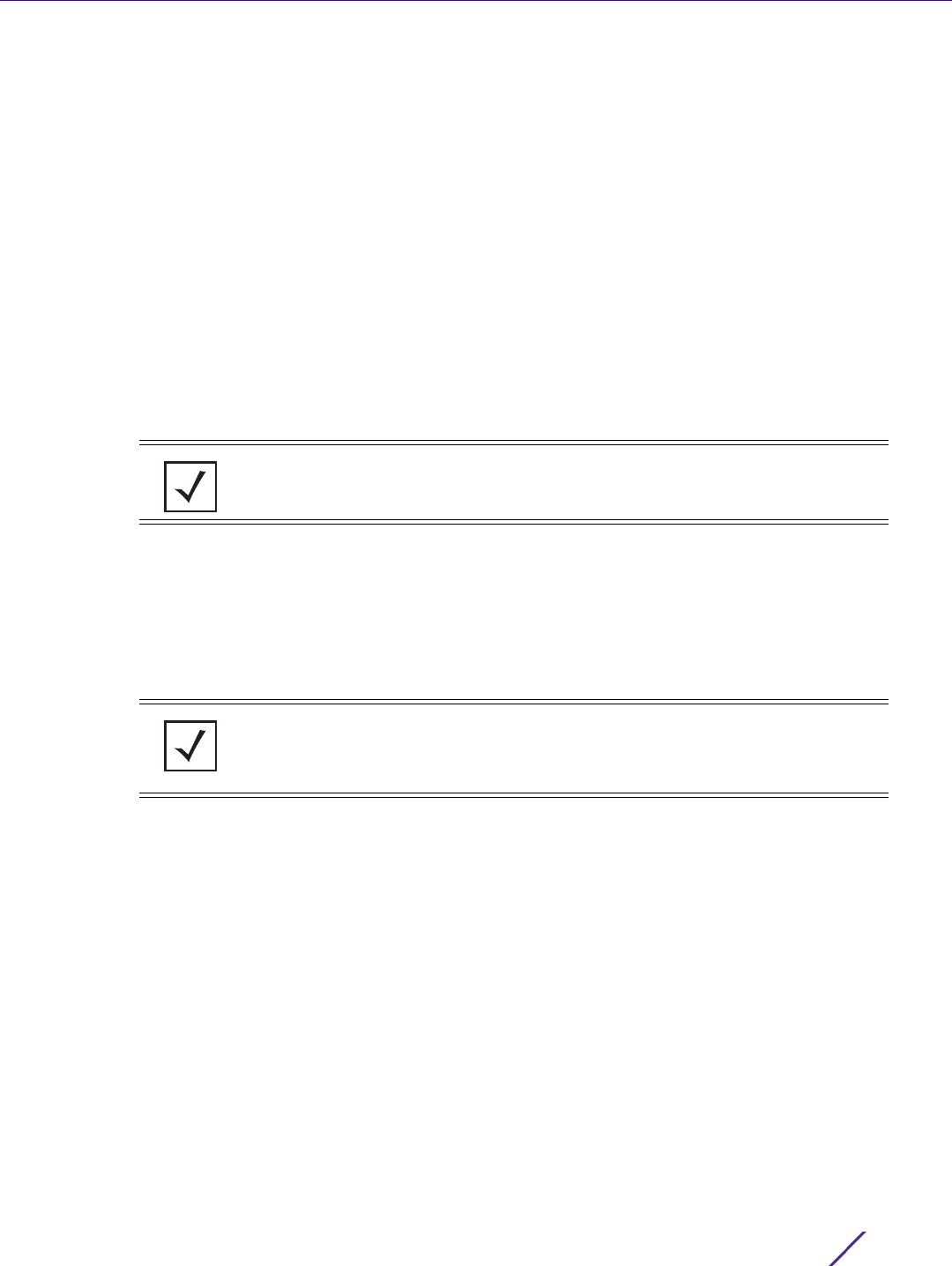
PROFILES
Access Point, Wireless Controller and Service Platform CLI Reference Guide 7 - 2
• AP8533 – Adds an AP8533 access point profile
• EX3524 – Adds an EX3524 wireless controller profile
• EX3548 – Adds an EX3548 wireless controller profile
• RFS4000 – Adds an RFS4000 wireless controller profile
• RFS6000 – Adds an RFS6000 wireless controller profile
• NX5500 – Adds an NX5500 wireless controller profile
• NX7500 – Adds an NX75XX series service platform profile supporting the NX7510, NX7520, and
NX7530 models
• NX9000 – Adds an NX95XX series service platform profile supporting the NX9500 and NX9510
models
• NX9600 – Adds an NX96XX series service platform profile supporting the NX9600 and NX9610
models. Supported only on an NX96XX model device.
• VX9000 – Adds a VX9000 wireless controller profile
• T5 – Adds a T5 controller profile
Although profiles assign a common set of configuration parameters across devices, individual devices can
still be assigned unique configuration parameters that follow the flat configuration model. As individual
device updates are made, these devices no longer share the profile based configuration they originally
supported. Therefore, changes made to a profile are not automatically inherited by devices who have had
their configuration customized. These devices require careful administration, as they cannot be tracked as
profile members. Their customized configurations overwrite their profile configurations until the profile is
re-applied.
This chapter is organized into the following topics:
•Profile Config Commands
•Device Config Commands
•T5 Profile Config Commands
•EX3524 & EX3548 Profile/Device Config Commands
To view the list of device profiles supported, use the following command:
<DEVICE>(config)#profile ?
anyap Any access point profile
ap650 AP650 access point profile
ap6511 AP6511 access point profile
ap6521 AP6521 access point profile
ap6522 AP6522 access point profile
ap6532 AP6532 access point profile
ap6562 AP6562 access point profile
ap71xx AP7161 access point profile
ap7502 AP7502 access point profile
ap7522 AP7522 access point profile
ap7532 AP7532 access point profile
ap7562 AP7562 access point profile
NOTE: A T5 profile can be created only on the following platforms:
RFS4000, RFS6000, NX9500, NX9510, and NX9600.
NOTE: The commands present under ‘Profiles’ are also available under the
‘Device mode’. The additional commands specific to the ‘Device mode’ are
listed separately.

PROFILES
Access Point, Wireless Controller and Service Platform CLI Reference Guide 7 - 3
ap81xx AP81XX access point profile
ap82xx AP8232 access point profile
ap8432 AP8432 access point profile
ap8533 AP8533 access point profile
containing Specify profiles that contain a sub-string in the profile name
ex3524 EX3524 wireless controller profile
ex3548 EX3548 wireless controller profile
filter Specify addition selection filter
nx5500 NX5500 wireless controller profile
nx75xx NX75XX wireless controller profile
nx9000 NX9000 wireless controller profile
nx9600 NX9600 wireless controller profile
rfs4000 RFS4000 wireless controller profile
rfs6000 RFS6000 wireless controller profile
rfs7000 RFS7000 wireless controller profile
t5 T5 wireless controller profile
vx9000 VX9000 wireless controller profile
<DEVICE>(config)#
rfs6000-37FABE(config)#profile rfs6000 default-rfs6000
rfs6000-37FABE(config-profile-default-rfs6000)#
rfs6000-37FABE(config)#profile ap71xx default-ap71xx
rfs6000-37FABE(config-profile-default-ap71xx)#
<DEVICE>(config)#profile <DEVICE-TYPE> <PROFILE-NAME>
<DEVICE>(config-profile-<PROFILE-NAME>)#
<DEVICE>(config-profile-<PROFILE-NAME>)#?
Profile Mode commands:
adopter-auto-provisioning-policy-lookup Use centralized auto-provisioning
policy when adopted by another
controller
adoption Adoption configuration
adoption-mode Configure the adoption mode for the
access-points in this RF-Domain
alias Alias
application-policy Application Poicy configuration
area Set name of area where the system
is located
arp Address Resolution Protocol (ARP)
auto-learn Auto learning
autogen-uniqueid Autogenerate a unique id
autoinstall Autoinstall settings
bridge Ethernet bridge
captive-portal Captive portal
cdp Cisco Discovery Protocol
cluster Cluster configuration
configuration-persistence Enable persistence of configuration
across reloads (startup config
file)
controller WLAN controller configuration
critical-resource Critical Resource
crypto Encryption related commands
database Database command
device-onboard Device-onboarding configuration
device-upgrade Device firmware upgrade
diag Diagnosis of packets
dot1x 802.1X
dpi Enable Deep-Packet-Inspection
(Application Assurance)
dscp-mapping Configure IP DSCP to 802.1p
priority mapping for untagged
frames
eguest-server Enable ExtremeGuest Server
functionality
email-notification Email notification configuration

PROFILES
Access Point, Wireless Controller and Service Platform CLI Reference Guide 7 - 4
enforce-version Check the firmware versions of
devices before interoperating
environmental-sensor Environmental Sensors Configuration
events System event messages
export Export a file
file-sync File sync between controller and
adoptees
floor Set the floor within a area where
the system is located
gre GRE protocol
http-analyze Specify HTTP-Analysis configuration
interface Select an interface to configure
ip Internet Protocol (IP)
ipv6 Internet Protocol version 6 (IPv6)
l2tpv3 L2tpv3 protocol
l3e-lite-table L3e lite Table
led Turn LEDs on/off on the device
led-timeout Configure the time for the led to
turn off after the last radio state
change
legacy-auto-downgrade Enable device firmware to auto
downgrade when other legacy devices
are detected
legacy-auto-update Auto upgrade of legacy devices
lldp Link Layer Discovery Protocol
load-balancing Configure load balancing parameter
logging Modify message logging facilities
mac-address-table MAC Address Table
mac-auth 802.1X
management-server Configure management server address
memory-profile Memory profile to be used on the
device
meshpoint-device Configure meshpoint device
parameters
meshpoint-monitor-interval Configure meshpoint monitoring
interval
min-misconfiguration-recovery-time Time interval to check controller
connectivity after configuration is
received
mint MiNT protocol
misconfiguration-recovery-time Check controller connectivity after
configuration is received
neighbor-inactivity-timeout Configure neighbor inactivity
timeout
neighbor-info-interval Configure neighbor information
exchange interval
no Negate a command or set its
defaults
noc Configure the noc related setting
nsight NSight
ntp Ntp server WORD
offline-duration Set duration for which a device
remains unadopted before it
generates offline event
otls Omnitrail Location Server
power-config Configure power mode
preferred-controller-group Controller group this system will
prefer for adoption
preferred-tunnel-controller Tunnel Controller Name this system
will prefer for tunneling extended
vlan traffic
radius Configure device-level radius
authentication parameters
raid RAID
remote-debug Configure remote debug parameters
remove-override Remove configuration item override
from the device (so profile value
takes effect)

PROFILES
Access Point, Wireless Controller and Service Platform CLI Reference Guide 7 - 5
rf-domain-manager RF Domain Manager
router Dynamic routing
slot PCI expansion Slot
spanning-tree Spanning tree
traffic-class-mapping Configure IPv6 traffic class to
802.1p priority mapping for
untagged frames
traffic-shape Traffic shaping
trustpoint Assign a trustpoint to a service
tunnel-controller Tunnel Controller group this
controller belongs to
use Set setting to use
vrrp VRRP configuration
vrrp-state-check Publish interface via OSPF/BGP only
if the interface VRRP state is not
BACKUP
wep-shared-key-auth Enable support for 802.11 WEP
shared key authentication
zone Configure Zone name
clrscr Clears the display screen
commit Commit all changes made in this
session
do Run commands from Exec mode
end End current mode and change to EXEC
mode
exit End current mode and down to
previous mode
help Description of the interactive help
system
revert Revert changes
service Service Commands
show Show running system information
write Write running configuration to
memory or terminal
<DEVICE>(config-profile-<PROFILE-NAME>)#
<DEVICE>(config-profile-<T5-PROFILE-NAME>)#?
T5 Profile Mode commands:
cpe T5 CPE configuration
interface Select an interface to configure
ip Internet Protocol (IP)
no Negate a command or set its defaults
ntp Configure NTP
override-wlan Configure RF Domain level overrides for wlan
t5 T5 configuration
t5-logging Modify message logging facilities
use Set setting to use
clrscr Clears the display screen
commit Commit all changes made in this session
do Run commands from Exec mode
end End current mode and change to EXEC mode
exit End current mode and down to previous mode
help Description of the interactive help system
revert Revert changes
service Service Commands
show Show running system information
write Write running configuration to memory or terminal
<DEVICE>(config-profile-<T5-PROFILE-NAME>)#
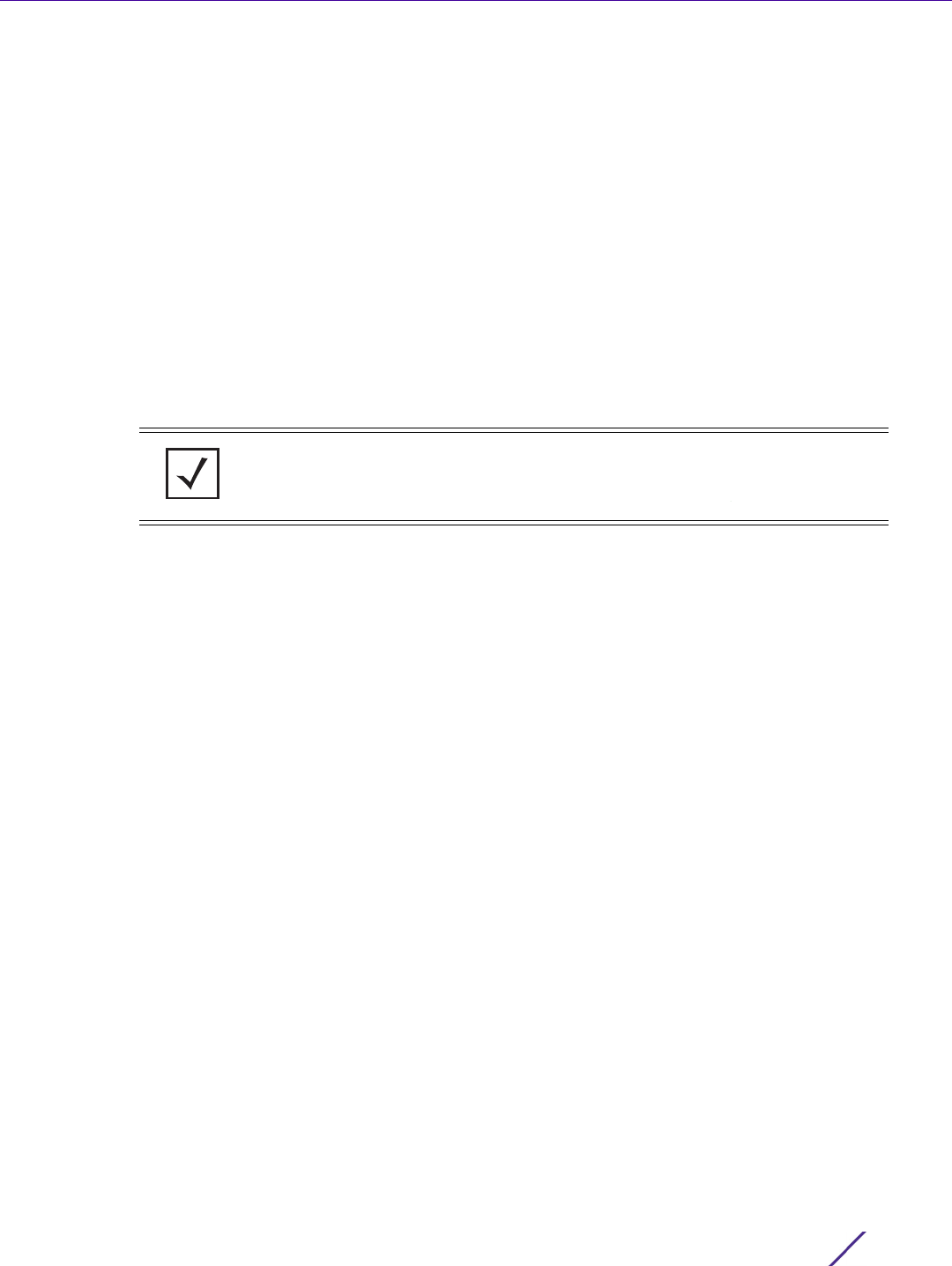
PROFILES
Access Point, Wireless Controller and Service Platform CLI Reference Guide 7 - 6
<DEVICE>(config-profile-<EX3524/EX3548-PROFILE-NAME>)#?
EX3500 Profile Mode commands:
interface Select an interface to configure
ip Internet Protocol (IP)
no Negate a command or set its defaults
power Ex3500 Power over Ethernet Command
upgrade Configures upgrade option for ex3500 system
use Set setting to use
clrscr Clears the display screen
commit Commit all changes made in this session
do Run commands from Exec mode
end End current mode and change to EXEC mode
exit End current mode and down to previous mode
help Description of the interactive help system
revert Revert changes
service Service Commands
show Show running system information
write Write running configuration to memory or terminal
<DEVICE>(config-profile-<EX3524/EX3548-PROFILE-NAME>)#
NOTE: The input parameter <HOSTNAME>, wherever used in syntaxes
across this chapter, cannot include an underscore (_) character. In other
words, the name of a device cannot contain an underscore.

PROFILES
Access Point, Wireless Controller and Service Platform CLI Reference Guide 7 - 7
7.1 Profile Config Commands
PROFILES
The following table summarizes profile configuration mode commands:
Command Description Reference
adopter-auto-
provisioning-
policy-lookup
Enables the use of a centralized auto provisioning policy on this profile page 7-11
adoption Configures a minimum and maximum delay time in the initiation of the
device adoption process
page 7-13
alias Creates various types of aliases, such as network, VLAN, network-group,
network-service, encrypted-string, hashed -string, etc. at the profile level
page 7-15
application-
policy
Associates a RADIUS server provided application policy with this profile.
When associated, the application policy allows wireless clients (MUs) to
always find the RADIUS-supplied application policy in the dataplane.
page 7-22
area Sets the system’s area of location (the area name) page 7-24
arp Configures static address resolution protocol page 7-25
auto-learn Enables controllers or service platforms to maintain a local configuration
record of devices requesting adoption and provisioning. The command
also enables learning of a device’s host name via DHCP options.
page 7-27
autogen-
uniqueid
Auto-generates a unique local ID for devices using this profile. When
executed in the device configuration mode, this command generates a
unique ID for the logged device.
page 7-28
autoinstall Configures the automatic install feature page 7-30
bridge Configures bridge specific parameters page 7-31
captive-portal Configures captive portal advanced Web page upload on a device
profile
page 7-62
cdp Enables Cisco Discovery Protocol (CDP) on a device page 7-63
cluster Configures a cluster name page 7-64
configuration-
persistence
Enables persistence of configuration across reloads page 7-67
controller Configures a wireless controller or service platform page 7-68
critical-resource Monitors resources that are critical to the health of the service platform,
wireless controller, or access point managed network. These critical
resources are identified by their configured IP addresses.
page 7-72
crypto Configures data encryption related protocols and settings page 7-80
database Backs up captive-portal and/or NSight database to a specified location
and file and configures a low-disk-space threshold value
page 7-143
device-onboard Configures the logo image file name and title displayed on the EGuest
device-onboarding portal. This is the portal a vendor-admin user uses to
onboard devices.
page 7-144
device-upgrade Configures device firmware upgrade settings on this profile page 7-145
diag Enables looped packet logging page 7-147

PROFILES
Access Point, Wireless Controller and Service Platform CLI Reference Guide 7 - 8
dot1x Configures 802.1x standard authentication controls page 7-148
dpi Enables Deep Packet Inspection (DPI) on this profile page 7-150
dscp-mapping Configures an IP DSCP to 802.1p priority mapping for untagged frames page 7-153
eguest-server
(VX9000 only)
Enables the EGuest daemon when executed without the ‘host’ option page 7-154
eguest-server
(NOC Only)
Points to the EGuest server, when executed along with the ‘host’ option page 7-155
email-
notification
Configures e-mail notification settings page 7-156
enforce-version Enables checking of a device’s firmware version before attempting
adoption or clustering
page 7-158
environmental-
sensor
Configures the environmental sensor settings on this profile (applicable
to AP8132 model access point only)
page 7-159
events Enables system event logging and message generation. This command
also configures event message forwarding settings.
page 7-161
export Enables export of startup.log file after every boot page 7-162
file-sync Configures parameters enabling synching of trustpoint and/or wireless-
bridge certificate between the staging-controller and adopted access
point
page 7-163
floor Sets the floor name where the system is located page 7-164
gre Enables Generic Routing Encapsulation (GRE) tunneling on this profile page 7-165
http-analyze Configures HTTP analysis settings page 7-177
interface Configures an interface (VLAN, radio, GE, etc.) page 7-180
ip Configures IPv4 components page 7-348
ipv6 Configures IPv6 components page 7-358
l2tpv3 Defines the Layer 2 Tunnel Protocol (L2TP) protocol for tunneling layer 2
payloads using Virtual Private Networks (VPNs)
page 7-362
l3e-lite-table Configures L3e Lite Table with this profile page 7-364
led Turns device LEDs on or off page 7-365
led-timeout Configures LED-timeout timer. This command is specific to the NX95XX
series service platforms.
page 7-366
legacy-auto-
downgrade
Auto downgrades a legacy device firmware page 7-368
legacy-auto-
update
Auto upgrades a legacy device firmware page 7-369
lldp Configures Link Layer Discovery Protocol (LLDP) page 7-370
load-balancing Configures load balancing parameters page 7-372
logging Modifies message logging settings page 7-377
mac-address-
table
Configures the MAC address table page 7-379
mac-auth Enables 802.1x user authentication protocol on this profile page 7-381
Command Description Reference

PROFILES
Access Point, Wireless Controller and Service Platform CLI Reference Guide 7 - 9
management-
server
Configures a management server with this profile page 7-384
memory-profile Configures the memory profile used on the device page 7-385
meshpoint-
device
Configures a meshpoint device parameters page 7-386
meshpoint-
monitor-interval
Configures meshpoint monitoring interval page 7-388
min-
misconfiguration
-recovery-time
Configures the minimum device connectivity verification time page 7-389
mint Configures MiNT protocol settings page 7-390
misconfiguration
-recovery-time
Verifies device connectivity after a configuration is received page 7-397
neighbor-
inactivity-
timeout
Configures neighbor inactivity timeout page 7-398
neighbor-info-
interval
Configures neighbor information exchange interval page 7-399
no Removes or reverts settings to their default. The no command, when
used in the profile configuration mode, removes the selected profile’s
settings or reverts them to their default.
page 7-400
noc Configures NOC settings page 7-402
nsight Configures NSight database related parameters page 7-403
ntp Configures NTP server settings page 7-408
otls Configures support for detection and forwarding of OmniTrail beacon
tags
page 7-411
offline-duration Sets the duration, in minutes, for which a device remains un-adopted
before it generates offline event
page 7-414
power-config Configures the power mode page 7-415
preferred-
controller-group
Specifies the wireless controller or service platform group preferred for
adoption
page 7-417
preferred-
tunnel-controller
Configures the tunnel wireless controller or service platform preferred
by the system to tunnel extended VLAN traffic
page 7-418
radius Configures device-level RADIUS authentication parameters page 7-419
raid Enables alarm on the array. This command is supported only on the
NX9500 and NX9510 series service platform profile/device config
modes.
page 7-493
rf-domain-
manager
Enables devices using this profile to be elected as RF Domain manager.
Also sets the priority value for devices using this profile in the RF
Domain manager election process.
page 7-420
router Configures dynamic router protocol settings page 7-421
spanning-tree Configures spanning tree related settings page 7-423
traffic-class-
mapping
Maps the IPv6 traffic class value of incoming IPv6 untagged packets to
802.1p priority
page 7-426
Command Description Reference
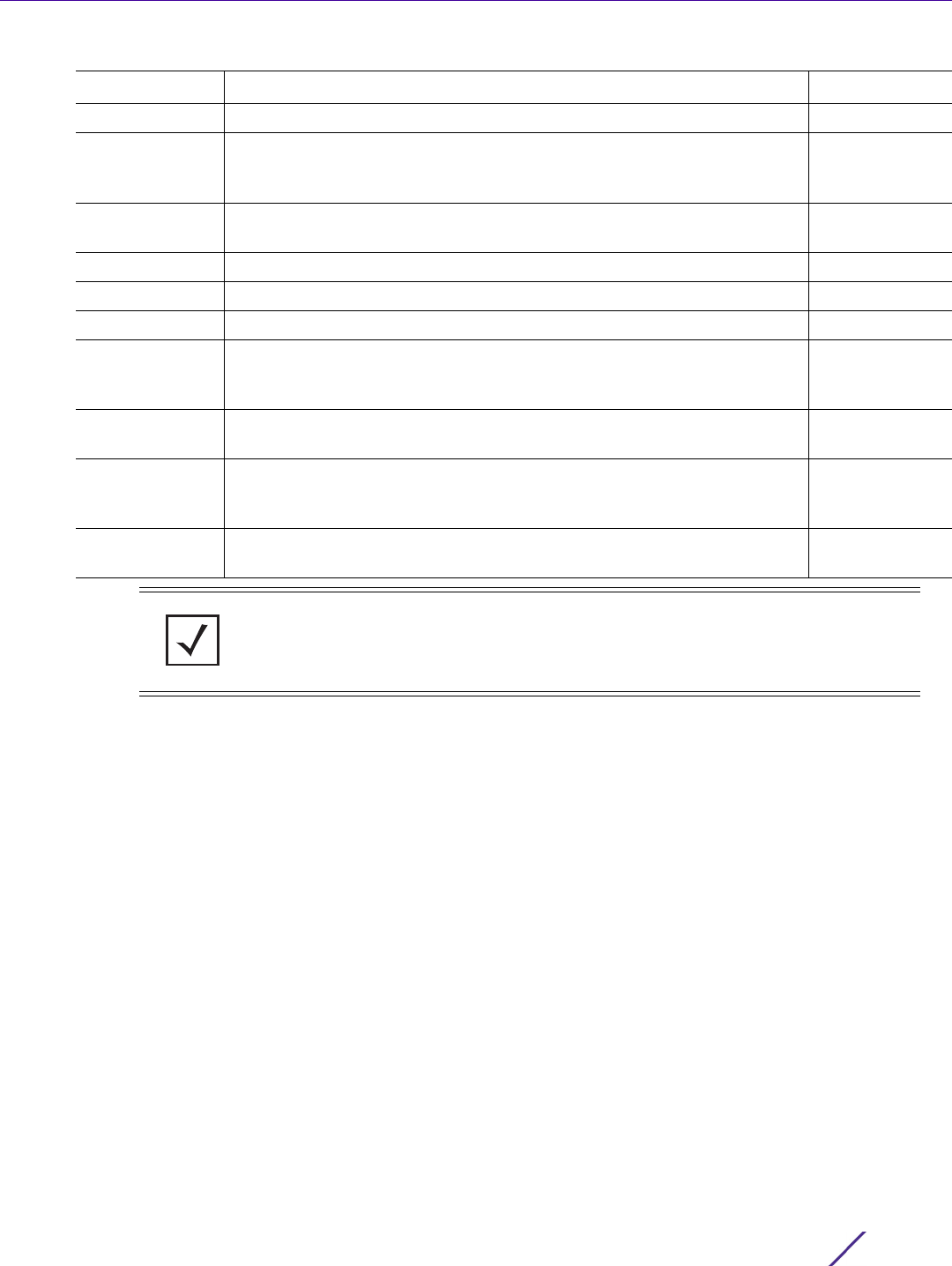
PROFILES
Access Point, Wireless Controller and Service Platform CLI Reference Guide 7 - 10
traffic-shape Enables traffic shaping and configures traffic shaping parameters page 7-428
trustpoint
(profile-config-
mode)
Configures the trustpoint assigned for validating a CMP auth Operator page 7-434
tunnel-controller Configures the name of tunneled WLAN (extended VLAN) wireless
controller or service platform
page 7-436
use Uses pre configured policies with this profile page 7-437
vrrp Configures Virtual Router Redundancy Protocol (VRRP) group settings page 7-443
vrrp-state-check Publishes interface via OSPF or BGP based on VRRP status page 7-447
virtual-controller Enables an access point as a virtual-controller (VC) or dynamic virtual
controller (DVC). Note, DVC is supported only on the AP7522, AP7532,
and AP7562 model access points.
page 7-448
wep-shared-
key-auth
Enables support for 802.11 WEP shared key authentication page 7-450
service Service commands are used to view and manage configurations. The
service commands and their corresponding parameters vary from mode
to mode.
page 7-451
zone Configures the zone for devices using this profile. The zone can also
be configured on the device’s self context.
page 7-456
Command Description Reference
NOTE: For more information on common commands (clrscr, commit, help,
revert, service, show, write, and exit), see COMMON COMMANDS.

PROFILES
Access Point, Wireless Controller and Service Platform CLI Reference Guide 7 - 11
7.1.1 adopter-auto-provisioning-policy-lookup
Profile Config Commands
Enables the use of a centralized auto provisioning policy on this profile. When enabled, the auto-
provisioning policy applied on the NOC gets precedence over the one applied at the site controller level.
Optionally, use the ‘evaluate-always’ option to set flag to run centralized auto-provisioning policy every
time a device (access point/controller) is adopted. The device’s previous adoption status is not taken into
consideration.
This command is also applicable in the device configuration context.
Supported in the following platforms:
• Access Points — AP6521, AP6522, AP6532, AP6562, AP7161, AP7502, AP7522, AP7532, AP7562,
AP7602, AP7612, AP7622, AP7632, AP7662, AP81XX, AP8232, AP8432, AP8533
• Wireless Controllers — RFS4000, RFS6000
• Service Platforms — NX5500, NX7500, NX7510, NX7520, NX7530, NX9500, NX9510, NX9600,
VX9000
Syntax
adopter-auto-provisioning-policy-lookup {evaluate-always}
Parameters
• adopter-auto-provisioning-policy-lookup {evaluate-always}
Example
rfs6000-81742D(config-profile-default-rfs6000)#adopter-auto-provisioning-policy-
lookup evaluate-always
rfs6000-81742D(config-profile-default-rfs6000)#show context
profile rfs6000 default-rfs6000
autoinstall configuration
autoinstall firmware
crypto ikev1 policy ikev1-default
isakmp-proposal default encryption aes-256 group 2 hash sha
crypto ikev2 policy ikev2-default
isakmp-proposal default encryption aes-256 group 2 hash sha
crypto ipsec transform-set default esp-aes-256 esp-sha-hmac
crypto ikev1 remote-vpn
crypto ikev2 remote-vpn
crypto auto-ipsec-secure
crypto remote-vpn-client
interface me1
interface up1
interface ge1
interface ge2
interface ge3
interface ge4
interface ge5
interface ge6
interface ge7
interface ge8
interface wwan1
interface pppoe1
use firewall-policy default
adopter-auto-
provisioning-policy-
lookup
{evaluate-always}
Enables the use of a centralized auto provisioning policy on this profile or device
• evaluate-always – Optional. Sets flag to run centralized auto-provisioning policy every
time a device (access point/controller) is adopted.

PROFILES
Access Point, Wireless Controller and Service Platform CLI Reference Guide 7 - 12
logging on
service pm sys-restart
adopter-auto-provisioning-policy-lookup
router ospf
router bgp
rfs6000-81742D(config-profile-default-rfs6000)#
Related Commands
no Disables the application of centralized auto provisioning policy on this profile or
device

PROFILES
Access Point, Wireless Controller and Service Platform CLI Reference Guide 7 - 13
7.1.2 adoption
Profile Config Commands
Configures a minimum and maximum delay time in the initiation of the device adoption process. When
configured, devices do not attempt adoption immediately on coming up. The process is initiated after the
lapse of a specified period of time (configured using this command as the start-delay minimum time).
Once configured and applied, this setting is applicable on all devices using this profile. This option is also
available in the device-configuration mode.
Supported in the following platforms:
• Access Points — AP6521, AP6522, AP6532, AP6562, AP7161, AP7502, AP7522, AP7532, AP7562,
AP7602, AP7612, AP7622, AP7632, AP7662, AP81XX, AP8232, AP8432, AP8533
• Wireless Controllers — RFS4000, RFS6000
• Service Platforms — NX5500, NX7500, NX7510, NX7520, NX7530, NX9500, NX9510, NX9600,
VX9000
Syntax
adoption start-delay min <0-30> max <0-30>
Parameters
• adoption start-delay min <0-30> max <0-30>
Example
rfs6000-81742D(config-profile-default-rfs6000)#adoption start-delay min 10 max 30
rfs6000-81742D(config-profile-default-rfs6000)#show context
profile rfs6000 default-rfs6000
autoinstall configuration
autoinstall firmware
crypto ikev1 policy ikev1-default
isakmp-proposal default encryption aes-256 group 2 hash sha
crypto ikev2 policy ikev2-default
isakmp-proposal default encryption aes-256 group 2 hash sha
crypto ipsec transform-set default esp-aes-256 esp-sha-hmac
crypto ikev1 remote-vpn
crypto ikev2 remote-vpn
crypto auto-ipsec-secure
crypto remote-vpn-client
interface me1
interface up1
interface ge1
interface ge2
interface ge3
interface ge4
interface ge5
interface ge6
interface ge7
interface ge8
adoption start-delay
min <0-30>
max <0-30>
Delays start of device adoption process
• min <0-30> – Configures the minimum time to lapse before a device attempts
adoption. Specify a value from 0 - 30 seconds.
A device, on coming up, attempts adoption only after the lapse of the time specified
here. The default is 5 seconds.
• max <0-30> – Configures the maximum time to lapse before a device attempts
adoption. Specify a value from 0 - 30 seconds. The default is 20 seconds.

PROFILES
Access Point, Wireless Controller and Service Platform CLI Reference Guide 7 - 14
interface wwan1
interface pppoe1
use firewall-policy default
logging on
service pm sys-restart
adopter-auto-provisioning-policy-lookup
router ospf
router bgp
adoption start-delay min 10 max 30
rfs6000-81742D(config-profile-default-rfs6000)#
Related Commands
no Removes the configured minimum start-delay value. When removed, devices
attempt adoption immediately on coming up.

PROFILES
Access Point, Wireless Controller and Service Platform CLI Reference Guide 7 - 15
7.1.3 alias
Profile Config Commands
Configures network, VLAN, and service aliases. The aliases defined on this profile applies to all devices
using this profile. Aliases can be also defined at the device level.
Supported in the following platforms:
• Access Points — AP6521, AP6522, AP6532, AP6562, AP7161, AP7502, AP7522, AP7532, AP7562,
AP7602, AP7612, AP7622, AP7632, AP7662, AP81XX, AP8232, AP8432, AP8533
• Wireless Controllers — RFS4000, RFS6000
• Service Platforms — NX5500, NX7500, NX7510, NX7520, NX7530, NX9500, NX9510, NX9600,
VX9000
Syntax
alias [address-range|encrypted-string|hashed-string|host|network|network-group|
network-service|number|string|vlan]
alias address-range <ADDRESS-RANGE-ALIAS-NAME> <STARTING-IP> to <ENDING-IP>
alias encrypted-string <ENCRYPTED-STRING-ALIAS-NAME> [0|2] <LINE>
alias hashed-string <HASHED-STRING-ALIAS-NAME> <LINE>
alias host <HOST-ALIAS-NAME> <HOST-IP>
alias network <NETWORK-ALIAS-NAME> <NETWORK-ADDRESS/MASK>
alias network-group <NETWORK-GROUP-ALIAS-NAME> [address-range|host|network]
alias network-group <NETWORK-GROUP-ALIAS-NAME> [address-range <STARTING-IP> to
<ENDING-IP> {<STARTING-IP> to <ENDING-IP>}|host <HOST-IP> {<HOST-IP>}|network
<NETWORK-ADDRESS/MASK> {<NETWORK-ADDRESS/MASK>}]
alias network-service <NETWORK-SERVICE-ALIAS-NAME> proto [<0-254>|<WORD>|eigrp|
gre|igmp|igp|ospf|vrrp] {(<1-65535>|<WORD>|bgp|dns|ftp|ftp-data|gopher|https|
ldap|nntp|ntp|pop3|proto|sip|smtp|sourceport|ssh|telnet|tftp|www)}
alias network-service <NETWORK-SERVICE-ALIAS-NAME> proto [<0-254>|<WORD>|eigrp|
gre|igmp|igp|ospf|vrrp] {(<1-65535>|<WORD>|bgp|dns|ftp|ftp-data|gopher|https|
ldap|nntp|ntp|pop3|proto|sip|smtp|sourceport [<1-65535>|<WORD>]|ssh|telnet|tftp|
www)}
alias number <NUMBER-ALIAS-NAME> <0-4294967295>
alias string <STRING-ALIAS-NAME> <LINE>
alias vlan <VLAN-ALIAS-NAME> <1-4094>
Parameters
• alias address-range <ADDRESS-RANGE-ALIAS-NAME> <STARTING-IP> to <ENDING-IP>
NOTE: You can apply overrides to aliases at the device level. Overrides applied
at the device level take precedence. For more information on aliases, see alias.
address-range
<ADDRESS-RANGE-
ALIAS-NAME>
Creates a new address-range alias for this profile. Or associates an existing address-
range alias with this profile. An address-range alias maps a name to a range of IP
addresses. Use this option to create unique address-range aliases for different
deployment scenarios.
Contd..

PROFILES
Access Point, Wireless Controller and Service Platform CLI Reference Guide 7 - 16
• alias encrypted-string <ENCRYPTED-STRING-ALIAS-NAME> [0|2] <LINE>
For example, if an ACL defines a pool of network addresses as 192.168.10.10 through
192.168.10.100 for an entire network, and a remote location’s network range is
172.16.13.20 through 172.16.13.110, the remote location’s ACL can be overridden using an
alias. At the remote location, the ACL works with the 172.16.13.20-110 address range. A
new ACL need not be created specifically for the remote deployment location.
• <ADDRESS-RANGE-ALIAS-NAME> – Specify the address range alias name.
Note: Alias name should begin with ‘$’.
<STARTING-IP>
to <ENDING-IP>
Associates a range of IP addresses with this address range alias
• <STARTING-IP> – Specify the first IP address in the range.
• to <ENDING-IP> – Specify the last IP address in the range.
Aliases defined at any given level can be overridden at the next lower levels. For
example, a global alias can be redefined on a selected set of RF Domains, profiles, or
devices. Overrides applied at the device level take precedence.
encrypted-string
<ENCRYPTED-
STRING-ALIAS-
NAME>
Creates an alias for an encrypted string. Use this alias for string configuration values
that are encrypted when "password-encryption" is enabled. For example, in the
management-policy, use it to define the SNMP community string. For more
information, see snmp-server.
• <ENCRYPTED-STRING-ALIAS-NAME> – Specify the encrypted-string alias name.
Alias name should begin with ‘$’.
[0|2] <LINE> Configures the value associated with the alias name specified in the previous step
• [0|2] <LINE> – Configures the alias value
Note, if password-encryption is enabled, in the show > running-config output, this
clear text is displayed as an encrypted string, as shown below:
nx9500-6C8809(config)#show running-config
!...............................
alias encrypted-string $enString 2
fABMK2is7UToNiZE3MQXbgAAAAxB0ZIysdqsEJwr6AH/Da//
!
--More--
nx9500-6C8809
In the above output, the ‘2’ displayed before the encrypted-
string alias value indicates that the displayed text is
encrypted and not a clear text.
However, if password-encryption is disabled the clear text is
displayed as is:
nx9500-6C8809(config)#show running-config
!...............................
!
alias encrypted-string $enString 0 test11223344
!
--More--
nx9500-6C8809
For more information on enabling password-encryption, see password-encryption.

PROFILES
Access Point, Wireless Controller and Service Platform CLI Reference Guide 7 - 17
• alias hashed-string <HASHED-STRING-ALIAS-NAME> <LINE>
• alias host <HOST-ALIAS-NAME> <HOST-IP>
• alias network <NETWORK-ALIAS-NAME> <NETWORK-ADDRESS/MASK>
hashed-string
<HASHED-STRING-
ALIAS-NAME>
Creates an alias for a hashed string. Use this alias for configuration values that are
hashed string, such as passwords. For example, in the management-policy, use it to
define the privilege mode password. For more information, see privilege-mode-
password.
• <HASHED-STRING-ALIAS-NAME> – Specify the hashed-string alias name.
Alias name should begin with ‘$’.
<LINE> Configures the hashed-string value associated with this alias.
nx9500-6C8809(config)#show running-config
!
alias encrypted-string $WRITE 2
sBqVCDAoxs3oByF5PCSuFAAAAAd7HT2+EiT/l/BXm9c4SBDv
!
alias hashed-string $PriMode 1
faffdde27cb49ad634ea20df4f7c8ef2685894d10ffcb1b2efba054112ec
fc75
--More--
nx9500-6C8809
In the above show > running-config output, the ‘1’ displayed before the hashed-string
alias value indicates that the displayed text is hashed and not a clear text.
host
<HOST-ALIAS-NAME> Creates a new host alias for this profile. Or associates an existing host alias with this
profile. A host alias configuration is for a particular host device’s IP address. Use this
option to create unique host aliases for different deployment scenarios. For example, if a
central network DNS server is set a static IP address, and a remote location’s local DNS
server is defined, this host can be overridden at the remote location. At the remote
location, the network is functional with a local DNS server, but uses the name set at the
central network. A new host need not be created at the remote location. This simplifies
creating and managing hosts and allows an administrator to better manage specific local
requirements.
• <HOST-ALIAS-NAME> – Specify the host alias name.
Alias name should begin with ‘$’.
<HOST-IP> Associates the network host’s IP address with this host alias
• <HOST-IP> – Specify the network host’s IP address.
Aliases defined at any given level can be overridden at the next lower levels. For example,
a global alias can be redefined on a selected set of RF Domains, profiles, or devices.
Overrides applied at the device level take precedence.
network
<NETWORK-ALIAS-
NAME>
Creates a new network alias for this profile. Or associates an existing network alias
with this profile. A network alias configuration is utilized for an IP address on a
particular network. Use this option to create unique Network aliases for different
deployment scenarios. For example, if a central network ACL defines a network as
192.168.10.0/24, and a remote location’s network range is 172.16.10.0/24, the ACL can
be overridden at the remote location to suit their local (but remote) requirement.
At the remote location, the ACL functions with the 172.16.10.0/24 network. A new ACL
need not be created specifically for the remote deployment. This simplifies ACL
definition and allows an administrator to better manage specific local requirements.
• <NETWORK-ALIAS-NAME> – Specify the network alias name.
Alias name should begin with ‘$’.

PROFILES
Access Point, Wireless Controller and Service Platform CLI Reference Guide 7 - 18
• alias network-group <NETWORK-GROUP-ALIAS-NAME> [address-range <STARTING-IP> to
<ENDING-IP> {<STARTING-IP> to <ENDING-IP>}|host <HOST-IP> {<HOST-IP>}|
network <NETWORK-ADDRESS/MASK> {<NETWORK-ADDRESS/MASK>}]
• alias network-service <NETWORK-SERVICE-ALIAS-NAME> proto [<0-254>|<WORD>|
eigrp|gre|igmp|igp|ospf|vrrp] {(<1-65535>|<WORD>|bgp|dns|ftp|ftp-data|gopher|
https|ldap|nntp|ntp|pop3|proto|sip|smtp|sourceport [<1-65535>|<WORD>]|ssh|
telnet|tftp|www)}
<NETWORK-
ADDRESS/MASK>
Associates a single network with this network alias
• <NETWORK-ADDRESS/MASK> – Specify the network’s address and mask.
Aliases defined at any given level can be overridden at the next lower levels. For
example, a global alias can be redefined on a selected set of RF Domains, profiles, or
devices. Overrides applied at the device level take precedence.
network
<NETWORK-GROUP-
ALIAS-NAME>
Creates a new network-group alias for this profile. Or associates an existing network-
group alias with this profile.
• <NETWORK-GROUP-ALIAS-NAME> – Specify the network-group alias name.
Alias name should begin with ‘$’.
The network-group aliases are used in ACLs, to define the network-specific
components. ACLs using aliases can be used across sites by re-defining the network-
group alias elements at the device or profile level.
After specifying the name, specify the following: a range of IP addresses, host
addresses, or a range of network addresses.
Aliases defined at any given level can be overridden at the next lower levels. For
example, a global alias can be redefined on a selected set of RF Domains, profiles, or
devices. Overrides applied at the device level take precedence.
address-range
<STARTING-IP>
to <ENDING-IP>
{<STARTING-IP>
to <ENDING-IP>}
Associates a range of IP addresses with this network-group alias
• <STARTING-IP> – Specify the first IP address in the range.
• to <ENDING-IP> – Specify the last IP address in the range.
• <STARTING-IP> to <ENDING-IP> – Optional. Specifies more than one range of IP
addresses. A maximum of eight (8) IP address ranges can be configured.
host <HOST-IP>
{<HOST-IP>}
Associates a single or multiple hosts with this network-group alias
• <HOST-IP> – Specify the hosts’ IP address.
• <HOST-IP> – Optional. Specifies more than one host. A maximum of eight (8) hosts
can be configured.
network <NETWORK-
ADDRESS/MASK>
{<NETWORK-
ADDRESS/MASK>}
Associates a single or multiple networks with this network-group alias
• <NETWORK-ADDRESS/MASK> – Specify the network’s address and mask.
• <NETWORK-ADDRESS/MASK> – Optional. Specifies more than one network. A
maximum of eight (8) networks can be configured.
alias network-service
<NETWORK-
SERVICE-ALIAS-
NAME>
Creates a new network-service alias for this profile. Or associates an existing network-
service alias with this profile. A network service alias is a set of configurations that
consist of protocol and port mappings. Both source and destination ports are
configurable. For each protocol, up to 2 source port ranges and up to 2 destination
port ranges can be configured. A maximum of 4 protocol entries can be configured
per network service alias.
• <NETWORK-SERVICE-ALIAS-NAME> – Specify a network-service alias name.
Alias name should begin with ‘$’.
Contd..

PROFILES
Access Point, Wireless Controller and Service Platform CLI Reference Guide 7 - 19
The network-service aliases are used in ACLs, to define the service-specific
components. ACLs using aliases can be used across sites by re-defining the network-
service alias elements at the device or profile level.
Note: Aliases defined at any given level can be overridden at the next lower levels. For
example, a global alias can be redefined on a selected set of RF Domains, profiles, or
devices. Overrides applied at the device level take precedence.
proto [<0-254>|
<WORD>|eigrp|gre|
igmp|igp|ospf|vrrp]
Use one of the following options to associate an Internet protocol with this network-
service alias:
• <0-254> – Identifies the protocol by its number. Specify the protocol number from 0
- 254. This is the number by which the protocol is identified in the Protocol field of the
IPv4 header and the Next Header field of IPv6 header. For example, the User Datagram
Protocol’s (UDP) designated number is 17.
• <WORD> – Identifies the protocol by its name. Specify the protocol name.
• eigrp – Selects Enhanced Interior Gateway Routing Protocol (EIGRP). The protocol
number 88.
•gre – Selects Generic Routing Encapsulation (GRE). The protocol number is 47.
• igmp – Selects Internet Group Management Protocol (IGMP). The protocol number is
2.
•igp – Selects Interior Gateway Protocol (IGP). The protocol number is 9.
•ospf – Selects Open Shortest Path First (OSPF). The protocol number is 89.
• vrrp – Selects Virtual Router Redundancy Protocol (VRRP). The protocol number is 112.
{(<1-65535>|
<WORD>|bgp|dns|
ftp|ftp-data|gopher|
https|ldap|nntp|ntp|
pop3|proto|sip|smtp|
sourceport
[<1-65535>|
<WORD>]|ssh|telnet|
tftp|www)}
After specifying the protocol, you may configure a destination port for this service.
These keywords are recursive and you can configure multiple protocols and associate
multiple destination and source ports.
• <1-65535> – Optional. Configures a destination port number from 1 - 65535
• <WORD> – Optional. Identifies the destination port by the service name provided. For
example, the secure shell (SSH) service uses TCP port 22.
• bgp – Optional. Configures the default Border Gateway Protocol (BGP) services port
(179)
• dns – Optional. Configures the default Domain Name System (DNS) services port (53)
• ftp – Optional. Configures the default File Transfer Protocol (FTP) control services port
(21)
• ldap – Optional. Configures the default Lightweight Directory Access Protocol (LDAP)
services port (389)
• ftp-data – Optional. Configures the default FTP data services port (20)
• gopher – Optional. Configures the default gopher services port (70)
• https – Optional. Configures the default HTTPS services port (443)
• nntp – Optional. Configures the default Newsgroup (NNTP) services port (119)
• ntp – Optional. Configures the default Network Time Protocol (NTP) services port
(123)
• proto – Optional. Use this option to select another Internet protocol in addition to the
one selected in the previous step.
• sip – Optional. Configures the default Session Initiation Protocol (SIP) services port
(5060).
Contd..

PROFILES
Access Point, Wireless Controller and Service Platform CLI Reference Guide 7 - 20
• alias number <NUMBER-ALIAS-NAME> <0-4294967295>
• alias string <STRING-ALIAS-NAME> <LINE>
• alias vlan <VLAN-ALIAS-NAME> <1-4094>
• sourceport [<1-65535>|<WORD>] – Optional. After specifying the destination port,
you may specify a single or range of source ports.
• <1-65535> – Specify the source port from 1 - 65535.
• <WORD> – Specify the source port range, for example 1-10.
• ssh – Optional. Configures the default SSH services port (22)
• telnet – Optional. Configures the default Telnet services port (23)
• tftp – Optional. Configures the default Trivial File Transfer Protocol (TFTP) services
port (69)
• www – Optional. Configures the default HTTP services port (80)
alias number
<NUMBER-ALIAS-
NAME>
<0-4294967295>
Creates a number alias identified by the <NUMBER-ALIAS-NAME> keyword. Number
aliases map a name to a numeric value. For example, ‘alias number $NUMBER 100’
• The number alias name is: $NUMBER
• The value assigned is: 100
The value referenced by alias $NUMBER, wherever used, is 100.
• <NUMBER-ALIAS-NAME> – Specify the number alias name.
• <0-4294967295> – Specify the number, from 0 - 4294967295, assigned to the
number alias created.
Alias name should begin with ‘$’.
alias string
<STRING-ALIAS-
NAME>
Creates a new string alias for this profile. Or associates an existing string alias with
this profile. String aliases map a name to an arbitrary string value. Use this option to
create unique string aliases for different deployment scenarios. For example, if the
main domain at a remote location is called loc1.domain.com and at another
deployment location it is called loc2.domain.com, the alias can be overridden at the
remote location to suit the local (but remote) requirement. At one remote location,
the alias functions with the loc1.domain.com domain and at the other with the
loc2.domain.com domain.
• <VLAN-ALIAS-NAME> – Specify the string alias name.
• <LINE> – Specify the string value.
Alias name should begin with ‘$’.
Aliases defined at any given level can be overridden at the next lower levels. For
example, a global alias can be redefined on a selected set of RF Domains, profiles, or
devices. Overrides applied at the device level take precedence.
alias vlan
<VLAN-ALIAS-NAME>
Creates a new VLAN alias for this profile. Or associates an existing VLAN alias with
this profile. A VLAN alias maps a name to a VLAN ID. A VLAN alias is a configuration
for optimal VLAN re-use and management for local and remote deployments. Use
this option to create unique VLANs aliases for different deployment scenarios. For
example, if a VLAN ID is set as 10 for the central network, and the VLAN is set as 26
at a remote location, the VLAN can be overridden at the remote location using an
alias.
Contd..

PROFILES
Access Point, Wireless Controller and Service Platform CLI Reference Guide 7 - 21
Example
The following example shows the global aliases configured. Note the network-service alias ‘$kerberos’
settings.
nx9500-6C8809(config)#show running-config | include alias
alias network-group $NetGrpAlias address-range 192.168.13.7 to 192.168.13.16
192.168.13.20 to 192.168.13.25
alias network-group $NetGrpAlias network 192.168.13.0/24 192.168.16.0/24
alias network $NetworkAlias 192.168.13.0/24
alias host $HostAlias 192.168.13.10
alias address-range $AddRanAlias 192.168.13.10 to 192.168.13.13
alias network-service $kerberos proto tcp 23 22 proto udp 25
alias vlan $VlanAlias 1
alias string $AREA Ecospace
alias string $IN-Blr-EcoSpace-Floor-4 IBEF4
alias encrypted-string $READ 2 CdO6glQ9w29hybKxfbd6JwAAAAa7lKMBMk9EiDQfFRf9kegO
alias hashed-string $PriMode 1
faffdde27cb49ad634ea20df4f7c8ef2685894d10ffcb1b2efba054112ecfc75
nx9500-6C8809(config)#
The following examples show the overrides applied to the network-service alias ‘$kerberos’ at the
profile level:
nx9500-6C8809(config-profile-testRFS4k)#alias network-service $kerberos proto tcp
88 proto udp 389
nx9500-6C8809(config-profile-testRFS4k)#
The following example shows the overrides applied to the network-service alias ‘$kerberos’ at the
profile level:
nx9500-6C8809(config-profile-testRFS4k)#show running-config | include alias
alias network-group $NetGrpAlias address-range 192.168.13.7 to 192.168.13.16
192.168.13.20 to 192.168.13.25
alias network-group $NetGrpAlias network 192.168.13.0/24 192.168.16.0/24
alias network $NetworkAlias 192.168.13.0/24
alias host $HostAlias 192.168.13.10
alias address-range $AddRanAlias 192.168.13.10 to 192.168.13.13
alias network-service $kerberos proto tcp 23 22 proto udp 25
alias vlan $VlanAlias 1
alias string $AREA Ecospace
alias string $IN-Blr-EcoSpace-Floor-4 IBEF4
alias encrypted-string $READ 2 /Mfbt1Et8XRhybKxfbd6JwAAAAZ9yrIYq7mNl4+gNNiiMIZI
alias hashed-string $PriMode 1
faffdde27cb49ad634ea20df4f7c8ef2685894d10ffcb1b2efba054112ecfc75
alias network-service $kerberos proto tcp 88 proto udp 389
nx9500-6C8809(config-profile-testRFS4k)#
Related Commands
At the remote location, the network is functional with an ID of 26, but utilizes the
name defined at the central local network. A new VLAN need not be created
specifically at the remote location.
• <VLAN-ALIAS-NAME> – Specify the VLAN alias name.
Alias name should begin with ‘$’.
<1-4094> Maps the VLAN alias to a VLAN ID
• <1-4094> – Specify the VLAN ID from 1 - 4094.
Aliases defined at any given level can be overridden at the next lower levels. For
example, a global alias can be redefined on a selected set of RF Domains, profiles, or
devices. Overrides applied at the device level take precedence.
no Removes the use of centralized auto provisioning policy on this profile or device

PROFILES
Access Point, Wireless Controller and Service Platform CLI Reference Guide 7 - 22
7.1.4 application-policy
Profile Config Commands
Associates a RADIUS server provided application policy with this profile. This command is also applicable
to the device configuration mode. When associated, the application policy allows wireless clients (MUs) to
always find the RADIUS-supplied application policy in the dataplane.
An application policy defines the actions executed on recognized HTTP (Facebook), enterprise (Webex)
and peer-to-peer (gaming) applications or application-categories. The following are the actions that can be
applied in an application policy:
• Allow - Allows packets for a specific application and its defined category type (for e.g., social
networking)
• Deny - Denies (restricts) packets to a specific application and its defined category type
• Mark - Marks recognized packets with DSCP/8021p value
• Rate-limit - Rate limits packets from specific application type
For more information on configuring an application policy, see application-policy.
Supported in the following platforms:
• Access Points — AP7602, AP7612, AP7622, AP7632, AP7662, AP81XX, AP8432, AP8533
• Service Platforms — NX5500, NX7500, NX7510, NX7520, NX7530, NX9500, NX9510, NX9600,
VX9000
Syntax
application-policy radius <APP-POLICY-NAME>
Parameters
• application-policy radius <APP-POLICY-NAME>
Example
nx9500-6C8809(config)#show context include-factory | include application-policy
application-policy Bing
no use application-policy
no use application-policy
no use application-policy
no use application-policy
no use application-policy
no use application-policy
no use application-policy
no use application-policy
no use application-policy
nx9500-6C8809(config)#
nx9500-6C8809(config-profile-testNX9500)#application-policy radius Bing
nx9500-6C8809(config-profile-testNX9500)#show context include-factory | include
application-policy
application-policy radius Bing
nx9500-6C8809(config-profile-testNX9500)#
application-policy
radius
<APP-POLICY-NAME>
Associates a RADIUS server provided application policy with this profile
• <APP-POLICY-NAME> – Specify the application policy name (should be existing and
configured).

PROFILES
Access Point, Wireless Controller and Service Platform CLI Reference Guide 7 - 23
nx9500-6C8809(config-application-Bing)#Show context
application Bing
app-category streaming
use url-list Bing
nx9500-6C8809(config-application-Bing)#
Related Commands
no Removes the RADIUS-server provided application policy associated with this profile

PROFILES
Access Point, Wireless Controller and Service Platform CLI Reference Guide 7 - 24
7.1.5 area
Profile Config Commands
Sets the system’s area of location (the physical area of deployment)
Supported in the following platforms:
• Access Points — AP6521, AP6522, AP6532, AP6562, AP7161, AP7502, AP7522, AP7532, AP7562,
AP7602, AP7612, AP7622, AP7632, AP7662, AP81XX, AP8232, AP8432, AP8533
• Wireless Controllers — RFS4000, RFS6000
• Service Platforms — NX5500, NX7500, NX7510, NX7520, NX7530, NX9500, NX9510, NX9600,
VX9000
Syntax
area <WORD>
Parameters
• area <WORD>
Example
rfs6000-37FABE(config-profile-default-rfs6000)#area Ecospace
rfs6000-37FABE(config-profile-default-rfs6000)#show context
profile rfs6000 default-rfs6000
bridge vlan 1
ip igmp snooping
ip igmp snooping querier
area Ecospace
autoinstall configuration
autoinstall firmware
crypto ikev1 policy ikev1-default
isakmp-proposal default encryption aes-256 group 2 hash sha
crypto ikev2 policy ikev2-default
isakmp-proposal default encryption aes-256 group 2 hash sha
crypto ipsec transform-set default esp-aes-256 esp-sha-hmac
crypto ikev1 remote-vpn
crypto ikev2 remote-vpn
crypto auto-ipsec-secure
interface me1
interface ge1
--More--
rfs6000-37FABE(config-profile-default-rfs6000)#
Related Commands
area <WORD> Sets the system’s area of location
• <WORD> – Specify the area name (should not exceed 64 characters).
no Resets the configured area name

PROFILES
Access Point, Wireless Controller and Service Platform CLI Reference Guide 7 - 25
7.1.6 arp
Profile Config Commands
Adds a static Address Resolution Protocol (ARP) IP address in the ARP cache
The ARP protocol maps an IP address to a hardware MAC address recognized on the network. ARP
provides protocol rules for making this correlation and providing address conversion in both directions.
When an incoming packet destined for a host arrives, ARP finds a physical host or MAC address that
matches the IP address. ARP looks in its ARP cache and, if it finds the address, provides it so the packet
can be converted to the right packet length, formatted, and sent to its destination. If no entry is found for
the IP address, ARP broadcasts a request packet in a special format on the LAN to locate a device that
recognizes the IP address. A device that recognizes the IP address as its own returns a reply indicating it.
ARP updates the ARP cache for future reference and then sends the packet to the MAC address that
replied.
Supported in the following platforms:
• Access Points — AP6521, AP6522, AP6532, AP6562, AP7161, AP7502, AP7522, AP7532, AP7562,
AP7602, AP7612, AP7622, AP7632, AP7662, AP81XX, AP8232, AP8432, AP8533
• Wireless Controllers — RFS4000, RFS6000
• Service Platforms — NX5500, NX7500, NX7510, NX7520, NX7530, NX9500, NX9510, NX9600,
VX9000
Syntax
arp [<IP>|timeout]
arp <IP> <MAC> arpa [<L3-INTERFACE-NAME>|pppoe1|vlan <1-4094>|wwan1|serial <1-4>
<1-1> <1-1>] {dhcp-server|router}
arp timeout <15-86400>
Parameters
• arp <IP> <MAC> arpa [<L3-INTERFACE-NAME>|pppoe1|vlan <1-4094>|wwan1|serial <1-
4> <1-1> <1-1>] {dhcp-server|router}
arp <IP> Adds a static ARP IPv4 address in the ARP cache
• <IP> – Specify the static IP address.
<MAC> Specify the MAC address associated with the IP and the Switch Virtual Interface
(SVI).
arpa Sets ARP encapsulation type to ARPA
<L3-INTERFACE-
NAME>
Configures static ARP entry for a specified router interface
• <L3-INTERFACE-NAME> – Specify the router interface name.
pppoe1 Configures static ARP entry for PPP over Ethernet interface
vlan <1-4094> Configures static ARP entry for a VLAN interface
• <1-4094> – Specify a SVI VLAN ID from 1 - 4094.
wwan1 Configures static ARP entry for Wireless WAN interface
{dhcp-server|router} The following keywords are common to all off the above interface types:
• dhcp-server – Optional. Sets ARP entries for a DHCP server
• router – Optional. Sets ARP entries for a router

PROFILES
Access Point, Wireless Controller and Service Platform CLI Reference Guide 7 - 26
• arp timeout <15-86400>
Example
rfs6000-37FABE(config-profile-default-rfs6000)#arp timeout 2000
rfs6000-37FABE(config-profile-default-rfs6000)#show context
profile rfs6000 default-rfs6000
bridge vlan 1
bridging-mode isolated-tunnel
ip igmp snooping
ip igmp snooping querier
arp timeout 2000
crypto ikev1 policy ikev1-default
isakmp-proposal default encryption aes-256 group 2 hash sha
crypto ikev2 policy ikev2-default
isakmp-proposal default encryption aes-256 group 2 hash sha
crypto ipsec transform-set default esp-aes-256 esp-sha-hmac
crypto ikev1 remote-vpn
crypto ikev2 remote-vpn
crypto auto-ipsec-secure
interface me1
interface ge1
ip dhcp trust
qos trust dscp
qos trust 802.1p
interface ge2
ip dhcp trust
--More--
rfs6000-37FABE(config-profile-default-rfs7000)#
Related Commands
arp timeout
<15-86400>
Sets ARP entry timeout
• <TIME> – Sets the ARP entry timeout in seconds. Specify a value from 15 - 86400
seconds. The default is 3600 seconds.
no Removes an entry from the ARP cache

PROFILES
Access Point, Wireless Controller and Service Platform CLI Reference Guide 7 - 27
7.1.7 auto-learn
Profile Config Commands
Enables controllers or service platforms to maintain a local configuration record of devices requesting
adoption and provisioning. The command also enables learning of a device’s host name via DHCP options.
Supported in the following platforms:
• Access Points — AP6521, AP6522, AP6532, AP6562, AP7161, AP7502, AP7522, AP7532, AP7562,
AP7602, AP7612, AP7622, AP7632, AP7662, AP81XX, AP8232, AP8432, AP8533
• Wireless Controllers — RFS4000, RFS6000
• Service Platforms — NX5500, NX7500, NX7510, NX7520, NX7530, NX9500, NX9510, NX9600,
VX9000
Syntax
auto-learn [host-name-via-dhcp <WORD>|staging-config]
Parameters
• auto-learn [host-name-via-dhcp <WORD>|staging-config]
Example
nx9500-6C8809(config-profile-test)#auto-learn staging-config
nx9500-6C8809(config-profile-test)#show context include-factory | include auto-
learn
auto-learn staging-config
no auto-learn host-name-via-dhcp
nx9500-6C8809(config-profile-test)#
Related Commands
auto-learn
[host-name-via-dhcp
<WORD>|
staging-config]
Enables auto-learning of:
• host-name-via-dhcp – A device’s host name via DHCP option.
• <WORD> – Provide the optional template with substitution token. For example,
'outdoor-$DHCP[1:3]-ap', where the $DHCP token references DHCP Option value re-
ceived by the adopting device. The $DHCP token should be present. This option is dis-
abled by default.
• staging-config – The network configuration of devices requesting adoption. This
option is enabled by default. For dependent access points that are pre-staged prior
to deployment, it is recommended that the auto-learn-staging-config parameter re-
mains enabled so that hostnames, VLAN and IP addressing configuration can be
maintained upon initial adoption. However, if dependent access points are to be cen-
trally managed and configured, it is recommended that the auto-learn-staging-config
parameter be disabled.
no Disables automatic recognition of devices’ hostname and devices pending
adoption

PROFILES
Access Point, Wireless Controller and Service Platform CLI Reference Guide 7 - 28
7.1.8 autogen-uniqueid
Profile Config Commands
Auto-generates a unique ID for devices using this profile. When executed in the device configuration mode,
this command generates a unique ID for the logged device. A device’s unique ID is a combination of a
user-defined string (prefix, suffix, or both) and a substitution token. The WiNG implementation provides
two built-in substitution tokens: $SN and $MiNT-ID that represent the device’s serial number and MiNT-ID
respectively. The value referenced by these substitution tokens are internally retrieved and combined with
the user-defined string to auto generate a unique identity for the device.
The general format of this command is: <PREFIX><SUBSTITUTION-TOKEN><SUFFIX>. You can provide
both (prefix and suffix) or just a prefix or suffix.
For example, given the following set of inputs:
• user-defined prefix – TestAP6522
• substitution token – $SN
The unique ID is generated using TestAP6522$SN, where $SN is replaced with the device’s serial number.
When executed on an AP6522 (having serial number B4C7996C8809), the autogen-uniqueid
TestAP6522$SN command generates the unique ID: TestAP6522B4C7996C8809. When configured on an
AP6522 profile, all AP6522s using the profile auto-generate a unique ID in which the device’s serial number
is preceded by the string ‘TestAP6522’.
Supported in the following platforms:
• Access Points — AP6521, AP6522, AP6532, AP6562, AP7161, AP7502, AP7522, AP7532, AP7562,
AP7602, AP7612, AP7622, AP7632, AP7662, AP81XX, AP8232, AP8432, AP8533
• Wireless Controllers — RFS4000, RFS6000
• Service Platforms — NX5500, NX7500, NX7510, NX7520, NX7530, NX9500, NX9510, NX9600,
VX9000
Syntax
autogen-uniqueid <WORD>
Parameters
• autogen-uniqueid <WORD>
autogen-uniqueid
<WORD>
Auto-generates a device’s unique ID (not exceeding 64 characters in length)
The ID generated is a combination of the text provided and the value referenced
through the substitution token $SN or $MiNT-ID. Where ever the autogen-uniqueid is
used the device’s serial number OR MiNT-ID is referenced depending on the
substitution token used.
• <WORD> – Specify a auto generate unique ID format using one of the following
substitution tokens:
Available tokens:
$SN - references SERIAL NUMBER of the device
$MINT-ID - references MINT-ID of the device
For example, Test-$SN-TechPubs. In this example ‘Test’ and ‘TechPubs’ represent the
user-defined prefix and suffix respectively. And $SN is the substitution token.

PROFILES
Access Point, Wireless Controller and Service Platform CLI Reference Guide 7 - 29
Example
nx9500-6C8809(config-device-B4-C7-99-6C-88-09)#autogen-uniqueid Test-$MiNT-ID-
TechPubs
nx9500-6C8809(config-device-B4-C7-99-6C-88-09)#show context
nx9000 B4-C7-99-6C-88-09
use profile default-nx9000
use rf-domain TechPubs
hostname nx9500-6C8809
license AAP
66069c24b3bb1259b34ff016c723a9e299dd408f0ff891e7c5f7e279a382648397d6b3e975e356a1
license HTANLT
66069c24b3bb1259eb36826cab3cc83999dd408f0ff891e74b62b2d3594f0b3dde7967f30e49e497
timezone Asia/Calcutta
use database-policy default
use nsight-policy noc
autogen-uniqueid Test-$MiNT-ID-TechPubs
ip default-gateway 192.168.13.2
device-upgrade auto rfs6000 ap81xx ap71xx ap7562 ap7532
interface ge1
switchport mode access
switchport access vlan 1
interface ge2
--More--
nx9500-6C8809(config-device-B4-C7-99-6C-88-09)#
Related Commands
no When executed in the device configuration mode, removes the device’s autogen-
uniqueid. When executed in the profile configuration mode, removes the autogen-
uniqueid on all devices using the profile.

PROFILES
Access Point, Wireless Controller and Service Platform CLI Reference Guide 7 - 30
7.1.9 autoinstall
Profile Config Commands
Automatically installs firmware image and startup configuration parameters on to the selected device.
Supported in the following platforms:
• Access Points — AP6521, AP6522, AP6532, AP6562, AP7161, AP7502, AP7522, AP7532, AP7562,
AP7602, AP7612, AP7622, AP7632, AP7662, AP81XX, AP8232, AP8432, AP8533
• Wireless Controllers — RFS4000, RFS6000
• Service Platforms — NX5500, NX7500, NX7510, NX7520, NX7530, NX9500, NX9510, NX9600,
VX9000
Syntax
autoinstall [configuration|firmware|start-interval <WORD>]
Parameters
• autoinstall [configuration|firmware|start-interval <WORD>]
Example
rfs6000-37FABE(config-profile-default-rfs6000)#autoinstall configuration
rfs6000-37FABE(config-profile-default-rfs6000)#autoinstall firmware
rfs7000-37FABE(config-profile-default-rfs6000)#show context
profile rfs6000 default-rfs6000
bridge vlan 1
bridging-mode isolated-tunnel
ip igmp snooping
ip igmp snooping querier
arp timeout 2000
autoinstall configuration
autoinstall firmware
crypto ikev1 policy ikev1-default
isakmp-proposal default encryption aes-256 group 2 hash sha
crypto ikev2 policy ikev2-default
isakmp-proposal default encryption aes-256 group 2 hash sha
crypto ipsec transform-set default esp-aes-256 esp-sha-hmac
crypto ikev1 remote-vpn
crypto ikev2 remote-vpn
crypto auto-ipsec-secure
interface me1
interface ge1
ip dhcp trust
--More--
rfs6000-37FABE(config-profile-default-rfs6000)#
Related Commands
configuration Autoinstalls startup configuration. Setup parameters are automatically configured on
devices using this profile. This option is disabled by default.
firmware Autoinstalls firmware image. Firmware images are automatically installed on devices
using this profile. This option is disabled by default.
start-interval
<WORD>
Configures the interval between system boot and start of autoinstall process (this is
the time, from system boot, after which autoinstall should start)
• <WORD> – Specify the interval in minutes. The default is 10 minutes.
Note: Zero (0) implies firmware or startup configuration installation can start any time.
no Disables the auto install settings

PROFILES
Access Point, Wireless Controller and Service Platform CLI Reference Guide 7 - 31
7.1.10 bridge
Profile Config Commands
The following table summarizes Ethernet bridge configuration commands:
Command Description Reference
bridge Enables Ethernet bridge configuration context page 7-32
bridge-vlan-
mode commands
Summarizes bridge VLAN configuration mode commands page 7-35

PROFILES
Access Point, Wireless Controller and Service Platform CLI Reference Guide 7 - 32
7.1.10.1 bridge
bridge
Configures VLAN Ethernet bridging parameters. Use this command to configure a Bridge NAT or Bridge
VLAN settings
Configuring bridge Network Address Translation (NAT) parameters, allows management of Internet traffic
originating at a remote site. In addition to traditional NAT functionality, bridge NAT provides a means of
configuring NAT for bridged traffic through an access point. NAT rules are applied to bridged traffic
through the access point, and matching packets are NATed to the WAN link instead of being bridged on
their way to the router. Using bridge NAT, a tunneled VLAN (extended VLAN) is created between the NOC
and a remote location. When a remote client needs to access the Internet, Internet traffic is routed to the
NOC, and from there routed to the Internet. This increases the access time for the end user on the client.
To resolve latency issues, bridge NAT identifies and segregates traffic heading towards the NOC and
outwards towards the Internet. Traffic towards the NOC is allowed over the secure tunnel. Traffic towards
the Internet is switched to a local WLAN link with access to the Internet.
A Virtual LAN (VLAN) is a separately administrated virtual network within the same physical managed
network. VLANs are broadcast domains defined within wireless controllers or service platforms to allow
control of broadcast, multicast, unicast, and unknown unicast within a layer 2 device. For example, say
several computers are used in conference room X and some in conference Y. The systems in conference
room X can communicate with one another, but not with the systems in conference room Y. The VLAN
enables the systems in conference rooms X and Y to communicate with one another even though they are
on separate physical subnets. The systems in conference rooms X and Y are managed by the same single
wireless controller or service platform, but ignore the systems that are not using the same VLAN ID.
Administrators often need to route traffic between different VLANs. Bridging VLANs are only for non-
routable traffic, like tagged VLAN frames destined to some other device, which will untag it. When a data
frame is received on a port, the VLAN bridge determines the associated VLAN based on the port of
reception. Using forwarding database information, the bridge VLAN forwards the data frame on the
appropriate port(s). VLANs are useful to set separate networks to isolate some computers from others,
without actually having to have separate cabling and Ethernet switches. Controllers can do this on their
own, without need for the computer or other gear to know itself what VLAN it is on (this is called port-
based VLAN, since it is assigned by port of the switch). Another common use is to put specialized devices
like VoIP Phones on a separate network for easier configuration, administration, security, or quality of
service.
Supported in the following platforms:
• Access Points — AP6521, AP6522, AP6532, AP6562, AP7161, AP7502, AP7522, AP7532, AP7562,
AP7602, AP7612, AP7622, AP7632, AP7662, AP81XX, AP8232, AP8432, AP8533
• Wireless Controllers — RFS4000, RFS6000
• Service Platforms — NX5500, NX7500, NX7510, NX7520, NX7530, NX9500, NX9510, NX9600,
VX9000
Switch Note: For more information on the interface types and the devices support-
ing them, see interface.

PROFILES
Access Point, Wireless Controller and Service Platform CLI Reference Guide 7 - 33
Syntax
bridge [nat|vlan]
bridge nat source list <IP-ACCESS-LIST-NAME> precedence <1-500> interface
[<LAYER3-INTERFACE-NAME>|pppoe1|vlan <1-4094>|wwan1] [(address|interface|
overload|pool <NAT-POOL-NAME>)]
bridge vlan [<1-4094>|<VLAN-ALIAS-NAME>]
Parameters
• bridge nat source list <IP-ACCESS-LIST-NAME> precedence <1-500> interface
[<LAYER3-INTERFACE-NAME>|pppoe1|vlan <1-4094>|wwan1]
[(address|interface|overload|pool <NAT-POOL-NAME>)]
• bridge vlan [<1-4094>|<VLAN-ALIAS-NAME>]
Usage Guidelines
Creating customized filter schemes for bridged networks limits the amount of unnecessary traffic
processed and distributed by the bridging equipment.
If a bridge does not hear Bridge Protocol Data Units (BPDUs) from the root bridge within the specified
interval, defined in the max-age (seconds) parameter, assume the network has changed and recomputed
the spanning-tree topology.
nat Configures bridge NAT parameters
source Configures NAT source addresses
list
<IP-ACCESS-LIST-
NAME>
precedence <1-500>
Associates an access control list (ACL) with this bridge NAT policy. The ACL
specifies the IP address permit/deny rules applicable to this bridge NAT policy.
• <IP-ACCESS-LIST-NAME> – Specify access list name.
• precedence <1-500> – Specifies a precedence value for this bridge NAT policy.
interface
[<LAYER3-INTERFACE-
NAME>|
pppoe1|vlan <1-4094>|
wwan1]
Selects one of the following as the primary interface (between the source and
destination points):
• <LAYER3-INTERFACE-NAME> – A router interface. Specify interface name.
• pppoe1 – A PPP over Ethernet interface.
• vlan <1-4094> – A VLAN interface. Specify the VLAN interface index from 1 - 4094.
• wwan1 – A Wireless WAN interface.
[(address|interface|
overload|pool
<NAT-POOL-NAME>)]
The following keywords are recursive and common to all interface types:
• address – Configures the interface IP address used for NAT
• interface – Configures the failover interface (default setting)
• overload – Enables use of one global address for multiple local addresses
(terminates command)
• pool <NAT-POOLNAME> – Configures the NAT pool used with this bridge NAT
policy. Specify the NAT pool name. For more information on configuring a NAT
pool, see nat-pool-config-instance.
vlan <1-4094> Configures the numerical identifier for the Bridge VLAN when it was initially
created.
• <1-4094> – Specify a VLAN index from 1 - 4094.
vlan <VLAN-ALIAS-
NAME>
Configures the VLAN alias (should be existing and configured) identifying the
bridge VLAN
• <VLAN-ALIAS-NAME> – Specify a VLAN alias name.

PROFILES
Access Point, Wireless Controller and Service Platform CLI Reference Guide 7 - 34
Example
rfs6000-37FABE(config-profile-default-rfs6000)#bridge vlan 1
rfs6000-37FABE(config-profile-default-rfs6000-bridge-vlan-1)#?
Bridge VLAN Mode commands:
Bridge VLAN Mode commands:
bridging-mode Configure how packets on this
VLAN are bridged
captive-portal Captive Portal
captive-portal-enforcement Enable captive-portal enforcement
on this extended VLAN
description Vlan description
edge-vlan Enable edge-VLAN mode
firewall Enable vlan firewall(IPv4)
http-analyze Forward URL and Data to
controller
ip Internet Protocol (IP)
ipv6 Internet Protocol version 6
(IPv6)
l2-tunnel-broadcast-optimization Enable broadcast optimization
l2-tunnel-forward-additional-packet-types Forward additional packet types
not normally forwarded by l2
broadcast optimization
mac-auth Enable mac-auth for this bridge
vlan
no Negate a command or set its
defaults
stateful-packet-inspection-l2 Enable stateful packet inspection
in layer2 firewall
tunnel Vlan tunneling settings
tunnel-over-level2 Tunnel extended VLAN traffic over
level 2 MiNT links
use Set setting to use
clrscr Clears the display screen
commit Commit all changes made in this
session
do Run commands from Exec mode
end End current mode and change to
EXEC mode
exit End current mode and down to
previous mode
help Description of the interactive
help system
revert Revert changes
service Service Commands
show Show running system information
write Write running configuration to
memory or terminal
rfs6000-37FABE(config-profile-default-rfs6000-bridge-vlan-1)#

PROFILES
Access Point, Wireless Controller and Service Platform CLI Reference Guide 7 - 35
7.1.10.2 bridge-vlan-mode commands
bridge
The following table summarizes bridge VLAN configuration mode commands:
Command Description Reference
bridging-mode Configures how packets on this VLAN are bridged page 7-36
captive-portal Enables IP packet snooping on wired captive portals, and also
configures the subnet to snoop
page 7-38
captive-portal-
enforcement
Enables auto-enforcement of captive portal rules on this extended
VLAN interface
page 7-39
description Configures VLAN bridge description page 7-40
edge-vlan Enables edge VLAN mode page 7-41
firewall Enables firewall on this bridge VLAN interface page 7-42
http-analyze Enables the analysis of URLs and data traffic on this Bridge VLAN page 7-43
ip Configures IP components page 7-44
ipv6 Configures IPv6 components page 7-47
l2-tunnel-
broadcast-
optimization
Enables broadcast optimization page 7-50
l2-tunnel-forward-
additional-packet-
types
Enables forwarding of Wireless Network Management Protocol
(WNMP) packets across L2 tunnels. These WNMP packets are
normally not forwarded if L2 tunnel broadcast optimization is
enabled.
page 7-53
mac-auth Enables MAC authentication for Extended VLAN and Tunneled traffic page 7-51
no Negates a command or reverts settings to their default page 7-54
stateful-packet-
inspection-l2
Enables stateful packet inspection in the layer 2 fire wall page 7-56
tunnel Enables tunneling of unicast messages to unknown MAC destinations,
on the selected VLAN bridge
page 7-57
tunnel-over-level2 Enables extended VLAN traffic over level 2 MiNT links page 7-59
use Associates a captive-portal, access control list (IP, IPv6, or MAC), and
a URL filter with this bridge VLAN
page 7-60

PROFILES
Access Point, Wireless Controller and Service Platform CLI Reference Guide 7 - 36
7.1.10.2.1 bridging-mode
bridge-vlan-mode commands
Configures how packets are bridged on the selected VLAN
Supported in the following platforms:
• Access Points — AP6521, AP6522, AP6532, AP6562, AP7161, AP7502, AP7522, AP7532, AP7562,
AP7602, AP7612, AP7622, AP7632, AP7662, AP81XX, AP8232, AP8432, AP8533
• Wireless Controllers — RFS4000, RFS6000
• Service Platforms — NX5500, NX7500, NX7510, NX7520, NX7530, NX9500, NX9510, NX9600,
VX9000
Syntax
bridging-mode [auto|isolated-tunnel|local|tunnel]
Parameters
• bridging-mode [auto|isolated-tunnel|local|tunnel]
Usage Guidelines
ACLs can only be used with tunnel or isolated-tunnel modes. They do not work with the local and
automatic modes.
bridging-mode Configures the VLAN bridging mode
auto Automatically selects the bridging mode to match the WLAN, VLAN and bridging
mode configurations. When selected, the controller or access point determines the
best bridging mode for the VLAN. (default setting)
isolated-tunnel Bridges packets between local Ethernet ports and local radios, and passes tunneled
packets through without de-tunneling
Select this option for a dedicated tunnel for bridging VLAN traffic.
local Bridges packets normally between local Ethernet ports and local radios (if any)
Local mode is typically configured in remote branch offices where traffic on remote
private LAN segments need to be bridged locally. Local mode implies that traffic,
wired and wireless, is to be bridged locally.
tunnel Bridges packets between local Ethernet ports, local radios, and tunnels to other APs,
wireless controllers, or service platforms
Select this option to use a shared tunnel for bridging VLAN traffic.
In tunnel mode, the traffic at the AP is always forwarded through the best path. The
APs decide the best path to reach the destination and forward packets accordingly.
Setting the VLAN to tunnel mode ensures packets are bridged between local
Ethernet ports, any local radios, and tunnels to other APs, wireless controllers, and
service platforms.

PROFILES
Access Point, Wireless Controller and Service Platform CLI Reference Guide 7 - 37
Example
rfs6000-37FABE(config-profile-default-rfs6000-bridge-vlan-1)#bridging-mode
isolated-tunnel
rfs6000-37FABE(config-profile-default-rfs6000-bridge-vlan-1)#show context
bridge vlan 1
bridging-mode isolated-tunnel
ip igmp snooping
ip igmp snooping querier
rfs6000-37FABE(config-profile-default-rfs6000-bridge-vlan-1)#
Related Commands
no Resets bridging mode to auto

PROFILES
Access Point, Wireless Controller and Service Platform CLI Reference Guide 7 - 38
7.1.10.2.2 capti ve - po r tal
bridge-vlan-mode commands
Enables IP (IPv4 and IPv6) packet snooping on wired captive portals, and also configures the subnet to
snoop. When enabled, IP packets received from wired captive portal clients, on the specified subnet, are
snooped to learn IP to MAC mapping.
Supported in the following platforms:
• Access Points — AP6521, AP6522, AP6532, AP6562, AP7161, AP7502, AP7522, AP7532, AP7562,
AP7602, AP7612, AP7622, AP7632, AP7662, AP81XX, AP8232, AP8432, AP8533
• Wireless Controllers — RFS4000, RFS6000
• Service Platforms — NX5500, NX7500, NX7510, NX7520, NX7530, NX9500, NX9510, NX9600,
VX9000
Syntax
captive-portal [ipv4-snooping|ipv6-snooping] subnet <IPv4/M|IPv6/M> {excluded-
address <IPv4|IPv6>}
Parameters
• captive-portal [ipv4-snooping|ipv6-snooping] subnet <IPv4/M|IPv6/M> {excluded-
address <IPv4|IPv6>}
Example
nx9500-6C8809(config-profile NX9500Test-bridge-vlan-4)#captive-portal ip-snooping
subnet 192.168.13.0/24 excluded-address 192.168.13.7
nx9500-6C8809(config-profile NX9500Test-bridge-vlan-4)#show context
bridge vlan 4
captive-portal ip-snooping subnet 192.168.13.0/24 excluded-address 192.168.13.7
ip igmp snooping
ip igmp snooping querier
ipv6 mld snooping
ipv6 mld snooping querier
nx9500-6C8809(config-profile NX9500Test-bridge-vlan-4)#
Related Commands
captive-portal
[ipv4-snooping|
ipv6-snooping]
Enables snooping of IPv4 or IPv6 packets (based on the option selected) for wired
captive portal clients
subnet <IPv4/M|
IPv6/M>
Enables IPv4 or IPv6 packet snooping on a specified subnet
• <IPv4/M|IPv6/M> – Specify the subnet address in the A.B.C.D/M or X:X::X:X/M
format to identify an IPv4 or IPv6 subnet respectively. When specified, this is the
IPv4/IPv6 subnet on which IP packets are to be snooped.
excluded-address
<IPv4|IPv6>
Optional. Configures the IPv4 or IPv6 address excluded from snooping within the
specified IPv4|IPv6 subnet.
• <IPv4|IPv6> – Specify the IPv4 or IPv6 address. Use this parameter to configure the
gateway’s address.
no Disables IP packet snooping on wired captive portals

PROFILES
Access Point, Wireless Controller and Service Platform CLI Reference Guide 7 - 39
7.1.10.2.3 captive-portal-enforcement
bridge-vlan-mode commands
Enables auto-enforcement of captive portal rules on this extended VLAN interface. This option is disabled
by default.
Supported in the following platforms:
• Access Points — AP6521, AP6522, AP6532, AP6562, AP7161, AP7502, AP7522, AP7532, AP7562,
AP7562, AP7602, AP7612, AP7622, AP7632, AP7662, AP81XX, AP8232, AP8432, AP8533
• Wireless Controllers — RFS4000, RFS6000
• Service Platforms — NX5500, NX7500, NX7510, NX7520, NX7530, NX9500, NX9510, NX9600,
VX9000
Syntax
captive-portal-enforcement {fall-back}
Parameters
• captive-portal-enforcement {fallback}
Example
nx9500-6C8809(config-profile testAP7602-bridge-vlan-20)#show context
bridge vlan 20
captive-portal-enforcement
ip igmp snooping
ip igmp snooping querier
ipv6 mld snooping
ipv6 mld snooping querier
nx9500-6C8809(config-profile testAP7602-bridge-vlan-20)#
Related Commands
captive-portal-
enforcement
Enables auto-enforcement of captive portal access permission rules to data
transmitted over this extended VLAN interface. When enforced, wired network users
can pass traffic through the captive portal without being redirected to an
authentication page. Authentication instead takes place when the RADIUS server is
queried against the wired user's MAC address. If the MAC address is in the RADIUS
server's user database, the user is allowed access.
A captive portal is an access policy for providing temporary and restrictive access
using a standard Web browser. Captive portals capture and re-direct a wired/wireless
user's Web browser session to a captive portal login page where the user must enter
valid credentials to access the network.
fall-back Optional. If enabling source MAC authentication for Extended VLAN and tunneled
traffic on this bridge VLAN, use this option to enforce captive-portal
authentication as the fall-back mode of authentication in case MAC authentication
fails.
no Disables auto-enforcement of captive portal rules on this extended VLAN interface

PROFILES
Access Point, Wireless Controller and Service Platform CLI Reference Guide 7 - 40
7.1.10.2.4 description
bridge-vlan-mode commands
Configures this extended VLAN’s description
Supported in the following platforms:
• Access Points — AP6521, AP6522, AP6532, AP6562, AP7161, AP7502, AP7522, AP7532, AP7562,
AP7602, AP7612, AP7622, AP7632, AP7632, AP81XX, AP8232, AP8432, AP8533
• Wireless Controllers — RFS4000, RFS6000
• Service Platforms — NX5500, NX7500, NX7510, NX7520, NX7530, NX9500, NX9510, NX9600,
VX9000
Syntax
description <WORD>
Parameters
• description <WORD>
Example
rfs6000-37FABE(config-profile-default-rfs6000-bridge-vlan-1)#description “This is
a description for the bridged VLAN”
rfs6000-37FABE(config-profile-default-rfs6000-bridge-vlan-1)#show context
bridge vlan 1
description "This is a description for the bridged VLAN"
bridging-mode isolated-tunnel
ip igmp snooping
ip igmp snooping querier
rfs6000-37FABE(config-profile-default-rfs6000-bridge-vlan-1)#
Related Commands
description <WORD> Configures a description for this VLAN bridge
• <WORD> – Enter a description. The description should be unique to the VLAN’s
specific configuration to help differentiate it from other VLANs with similar
configurations.
no Removes VLAN’s description

PROFILES
Access Point, Wireless Controller and Service Platform CLI Reference Guide 7 - 41
7.1.10.2.5 edge-vlan
bridge-vlan-mode commands
Enables the edge VLAN mode. In the edge VLAN mode, a protected port does not forward traffic to
another protected port on the same wireless controller or service platform. This feature is enabled by
default.
Supported in the following platforms:
• Access Points — AP6521, AP6522, AP6532, AP6562, AP7161, AP7502, AP7522, AP7532, AP7562,
AP7602, AP7612, AP7622, AP7632, AP7662, AP81XX, AP8232, AP8432, AP8533
• Wireless Controllers — RFS4000, RFS6000
• Service Platforms — NX5500, NX7500, NX7510, NX7520, NX7530, NX9500, NX9510, NX9600,
VX9000
Syntax
edge-vlan
Parameters
None
Example
rfs6000-37FABE(config-profile-default-rfs6000-bridge-vlan-1)#edge-vlan
rfs6000-37FABE(config-profile-default-rfs6000-bridge-vlan-1)#
Related Commands
no Disables the edge VLAN mode

PROFILES
Access Point, Wireless Controller and Service Platform CLI Reference Guide 7 - 42
7.1.10.2.6 firewall
bridge-vlan-mode commands
Enables IPv4 firewall on this bridge VLAN interface. This feature is enabled by default.
Supported in the following platforms:
• Access Points — AP6521, AP6522, AP6532, AP6562, AP7161, AP7502, AP7522, AP7532, AP7562,
AP7602, AP7612, AP7622, AP7632, AP7662, AP81XX, AP8232, AP8432, AP8533
• Wireless Controllers — RFS4000, RFS6000
• Service Platforms — NX5500, NX7500, NX7510, NX7520, NX7530, NX9500, NX9510, NX9600,
VX9000
Syntax
firewall
Parameters
None
Example
rfs6000-37FABE(config-profile-default-rfs6000-bridge-vlan-1)#firewall
rfs6000-37FABE(config-profile-default-rfs6000-bridge-vlan-1)#
Related Commands
no Disables firewall on this bridge VLAN interface

PROFILES
Access Point, Wireless Controller and Service Platform CLI Reference Guide 7 - 43
7.1.10.2.7 http-analyze
bridge-vlan-mode commands
Enables the analysis of URLs and data traffic on this Bridge VLAN. When enabled, URLs and data are
forwarded to the controller running the HTTP analytics engine.
Supported in the following platforms:
• Access Points — AP6521, AP6522, AP6532, AP6562, AP7161, AP7502, AP7522, AP7532, AP7562,
AP7602, AP7612, AP7622, AP7632, AP7662, AP81XX, AP8232, AP8432, AP8533
• Wireless Controllers — RFS4000, RFS6000
• Service Platforms — NX5500, NX7500, NX7510, NX7520, NX7530, NX9500, NX9510, NX9600,
VX9000
Syntax
http-analyze {filter [images|post|query-string]}
Parameters
• http-analyze {filter [images|post|query-string]}
Example
rfs4000-229D58(config-device 00-23-68-22-9D-58-bridge-vlan-4)#http-analyze filter
images
rfs4000-229D58(config-device 00-23-68-22-9D-58-bridge-vlan-4)#show context
bridge vlan 4
http-analyze filter images
rfs4000-229D58(config-device 00-23-68-22-9D-58-bridge-vlan-4)#
Related Commands
http-analyze
filter [images|post|
query-string]
Enables URL and HTTP data analysis. Optionally use the filter keyword to filter out
specific URLs
• filter – Optional. Filters out specific URLs
• images – Filters out URLs referring to images
• post – Filters out URLs referring to POSTs
• query-string – Filters out query strings received from URLs
no Disables forwarding of URLs and data to the controller running the HTTP analytics
engine

PROFILES
Access Point, Wireless Controller and Service Platform CLI Reference Guide 7 - 44
7.1.10.2.8 ip
bridge-vlan-mode commands
Configures VLAN bridge IP components
Supported in the following platforms:
• Access Points — AP6521, AP6522, AP6532, AP6562, AP7161, AP7502, AP7522, AP7532, AP7562,
AP7602, AP7612, AP7622, AP7632, AP7662, AP81XX, AP8232, AP8432, AP8533
• Wireless Controllers — RFS4000, RFS6000
• Service Platforms — NX5500, NX7500, NX7510, NX7520, NX7530, NX9500, NX9510, NX9600,
VX9000
Syntax
ip [arp|dhcp|igmp]
ip [arp|dhcp] trust
ip igmp snooping {fast-leave|forward-unknown-multicast|last-member-query-count|
mrouter|querier}
ip igmp snooping {fast-leave|forward-unknown-multicast|last-member-query-count
<1-7>}
ip igmp snooping {mrouter [interface|learn]}
ip igmp snooping {mrouter [interface <INTERFACE-LIST>|learn pim-dvmrp]}
ip igmp snooping {querier} {address|max-response-time|timer|version}
ip igmp snooping {querier} {address <IP>|max-response-time <1-25>|timer expiry
<60-300>|version <1-3>}
Parameters
• ip [arp|dhcp] trust
• ip igmp snooping {fast-leave|forward-unknown-multicast|last-member-query-count
<1-7>}
ip Configures the VLAN bridge IP parameters
arp trust Configures the ARP trust parameter. Trusted ARP packets are used to update the
DHCP snoop table to prevent IP spoof and arp-cache poisoning attacks. This option
is disabled by default.
• trust – Trusts ARP responses on the VLAN bridge
dhcp trust Configures the DHCP trust parameter. Uses DHCP packets, from a DHCP server, as
trusted and permissible within the access point, wireless controller, or service
platform managed network. DHCP packets are used to update the DHCP snoop
table to prevent IP spoof attacks. This feature is enabled by default.
• trust – Trusts DHCP responses on the VLAN bridge
ip Configures the VLAN bridge IP parameters
igmp snooping Configures Internet Group Management Protocol (IGMP) snooping parameters.
IGMP snooping is enabled by default.
IGMP establishes and maintains multicast group memberships for interested
members. Multicasting allows a networked device to listen to IGMP network traffic
and forward IGMP multicast packets to radios on which the interested hosts are
connected. The device also maintains a map of the links that require multicast
streams, there by reducing unnecessary flooding of the network with multicast
traffic.

PROFILES
Access Point, Wireless Controller and Service Platform CLI Reference Guide 7 - 45
• ip igmp snooping {mrouter [interface <INTERFACE-LIST>|learn pim-dvmrp]}
• ip igmp snooping {querier} {address <IP>|max-response-time <1-25>|
timer expiry <60-300>|version <1-3>}
fast-leave Optional. Enables fast leave processing. When enabled, layer 2 LAN interfaces are
removed from the IGMP snooping forwarding table entry without initially sending
IGMP group-specific queries to the interface. When receiving a group specific
IGMPv2 leave message, IGMP snooping removes the interface from the Layer 2
forwarding table entry for that multicast group, unless a multicast router was
learned on the port. Fast-leave processing enhances bandwidth management for all
hosts on the network. This option is disabled by default.
This feature is supported only on the AP7502, AP8232, AP8533 model access
points.
forward-unknown-
multicast
Optional. Enables forwarding of multicast packets from unregistered multicast
groups. If disabled, the unknown multicast forward feature is also disabled for
individual VLANs. This option is enabled by default.
last-member-query-
count <1-7>
Optional. Configures the last member query count used in determining the number
of group-specific queries sent before removing the snoop entry
• <1-7> – Specify the count from 1 - 7. The default value is 2.
ip Configures the VLAN bridge IP parameters
igmp snooping Configures the IGMP snooping parameters
mrouter Optional. Configures the multicast router parameters
interface
<INTERFACE-LIST>
Configures the multicast router interfaces. This option is disabled by default.
• <INTERFACE-LIST> – Specify a comma-separated list of interface names.
learn pim-dvmrp Configures the multicast router learning protocols. This option is disabled by
default.
• pim-dvmrp – Enables Protocol-Independent Multicast (PIM) and
Distance-Vector Multicast Routing Protocol (DVMRP) snooping of packets
ip Configures the VLAN bridge IP parameters
igmp snooping Configures the IGMP snooping parameters
querier Optional. Configures the IGMP querier parameters. This option is disabled by
default.
Enables IGMP querier. IGMP snoop querier keeps host memberships alive. It is
primarily used in a network where there is a multicast streaming server and hosts
subscribed to the server and no IGMP querier present. The access point, wireless
controller, or service platform performs the IGMP querier role. An IGMP querier
sends out periodic IGMP query packets. Interested hosts reply with an IGMP report
packet. IGMP snooping is only conducted on wireless radios. IGMP multicast packets
are flooded on wired ports. IGMP multicast packet are not flooded on the wired
port. IGMP membership is also learnt on it and only if present, then it is forwarded
on that port.
address <IP> Optional. Configures the IGMP querier source IP address. This address is used as the
default VLAN querier IP address.
• <IP> – Specify the IGMP querier source IP address.

PROFILES
Access Point, Wireless Controller and Service Platform CLI Reference Guide 7 - 46
Example
rfs6000-37FABE(config-profile-default-rfs6000-bridge-vlan-1)#ip arp trust
rfs6000-37FABE(config-profile-default-rfs6000-bridge-vlan-1)#ip dhcp trust
rfs6000-37FABE(config-profile-default-rfs6000-bridge-vlan-1)#ip igmp snooping
mrouter interface ge1 ge2
rfs6000-37FABE(config-profile-default-rfs6000-bridge-vlan-1)#ip igmp snooping
mrouter learn pim-dvmrp
rfs6000-37FABE(config-profile-default-rfs6000-bridge-vlan-1)#ip igmp snooping
querier max-response-time 24
rfs6000-37FABE(config-profile-default-rfs6000-bridge-vlan-1)#ip igmp snooping
querier timer expiry 100
rfs6000-37FABE(config-profile-default-rfs6000-bridge-vlan-1)#ip igmp snooping
querier version 2
rfs6000-37FABE(config-profile-default-rfs6000-bridge-vlan-1)#show context
bridge vlan 1
description “This is a description for the bridged VLAN”
ip arp trust
ip dhcp trust
ip igmp snooping
ip igmp snooping querier
ip igmp snooping querier version 2
ip igmp snooping querier max-response-time 24
ip igmp snooping querier timer expiry 100
ip igmp snooping mrouter interface ge2 ge1
rfs6000-37FABE(config-profile-default-rfs6000-bridge-vlan-1)#
Related Commands
max-response-time
<1-25>
Optional. Configures the IGMP querier maximum response time. This option is
disabled by default.
• <1-25> – Specify the maximum response time from 1 - 25 seconds.
The access point, wireless controller, or service platform forwards multicast packets
only to radios present in the snooping table. IGMP reports from wired ports are
forwarded to the multicast router ports.
If no reports are received from a radio, it is removed from the snooping table. The
radio then stops receiving multicast packets.
timer expiry <60-300> Optional. Configures the IGMP querier expiry time. The value specified is used as
the timeout interval for other querier resources. This option is disabled by default.
• expiry – Configures the IGMP querier timeout
• <60-300> – Specify the IGMP querier timeout from 60 - 300 seconds.
version <1-3> Optional. Configures the IGMP version. This option is disabled by default.
• <1-3> – Specify the IGMP version. The versions are 1- 3.
no Disables or reverts the VLAN Ethernet bridge parameters

PROFILES
Access Point, Wireless Controller and Service Platform CLI Reference Guide 7 - 47
7.1.10.2.9 ipv6
bridge-vlan-mode commands
Configures this VLAN bridge’s IPv6 components
Supported in the following platforms:
• Access Points — AP6521, AP6522, AP6532, AP6562, AP7161, AP7502, AP7522, AP7532, AP7562,
AP7602, AP7612, AP7622, AP7632, AP7662, AP81XX, AP8232, AP8432, AP8533
• Wireless Controllers — RFS4000, RFS6000
• Service Platforms — NX5500, NX7500, NX7510, NX7520, NX7530, NX9500, NX9510, NX9600,
VX9000
Syntax
ipv6 [dhcpv6|firewall|mld|nd]
ipv6 dhcpv6 trust
ipv6 firewall
ipv6 mld snooping {forward-unknown-multicast|mrouter|querier}
ipv6 mld snooping {forward-unknown-multicast}
ipv6 mld snooping {mrouter [interface|learn]}
ipv6 mld snooping {mrouter [interface <INTERFACE-LIST>|learn pim-dvmrp]}
ipv6 mld snooping {querier} {max-response-time|timer|version}
ipv6 mld snooping {querier} {max-response-time <1-25000>|timer expiry <60-300>|
version <1-2>}
ipv6 nd raguard
Parameters
• ipv6 dhcpv6 trust
• ipv6 firewall
• ipv6 mld snooping {forward-unknown-multicast}
ipv6 Configures the VLAN bridge IPv6 parameters
dhcpv6 trust Enables the DHCPv6 trust option. When enabled all DHCPv6 responses are trusted
on this bridge VLAN. This option is enabled by default.
• trust – Trusts DHCPv6 responses on this bridge VLAN
ipv6 Configures the VLAN bridge IPv6 parameters
firewall Enables IPv6 firewall on this bridge VLAN. This option is enabled by default.
Devices utilizing IPv6 addressing require firewall protection unique to IPv6 traffic.
IPv6 addresses are composed of eight groups of four hexadecimal digits separated
by colons. IPv6 hosts can configure themselves automatically when connected to an
IPv6 network using the neighbor discovery (ND) protocol via ICMPv6 router
discovery messages. When first connected to a network, a host sends a link-local
router solicitation multicast request for its configuration parameters. Routers
respond to such a request with a router advertisement (RA) packet that contains
Internet layer configuration parameters.
ipv6 Configures the VLAN bridge IPv6 parameters

PROFILES
Access Point, Wireless Controller and Service Platform CLI Reference Guide 7 - 48
• ipv6 mld snooping {mrouter [interface <INTERFACE-LIST>|learn pim-dvmrp]}
• ipv6 mld snooping {querier} {max-response-time <1-25000>|timer expiry <60-300>|
version <1-2>}
mld snooping Configures Multicast Listener Discovery Protocol (MLD) snooping parameters
MLD snooping enables a access point, wireless controller, or service platform to
examine MLD packets and make forwarding decisions based on the content. MLD is
used by IPv6 devices to discover devices wanting to receive multicast packets
destined for specific multicast addresses. MLD uses multicast listener queries and
multicast listener reports to identify which multicast addresses have listeners and
join multicast groups.
MLD snooping caps the flooding of IPv6 multicast traffic on controller, service
platform or access point VLANs. When enabled, MLD messages between hosts and
multicast routers are examined to identify the hosts receiving multicast group
traffic. The access point, wireless controller, or service platform forward multicast
traffic only to those interfaces connected to interested receivers instead of flooding
traffic to all interfaces.
This option is enabled by default.
forward-unknown-
multicast
Optional. Enables forwarding of multicast packets from unregistered multicast
groups. If disabled, the unknown multicast forward feature is also disabled for
individual VLANs. This option is enabled by default.
ipv6 Configures the VLAN bridge IPv6 parameters
mld snooping Configures MLD snooping parameters. This option is enabled by default.
mrouter Optional. Configures the multicast router parameters, such as interfaces and
learning protocol used.
interface
<INTERFACE-LIST>
Configures the multicast router interfaces. This option is disabled by default.
• <INTERFACE-LIST> – Specify a comma-separated list of interface names.
learn pim-dvmrp Configures the multicast router learning protocols. This option is disabled by
default.
• pim-dvmrp – Enables PIM and DVMRP snooping of packets
ipv6 Configures the VLAN bridge IPv6 parameters
mld snooping Configures IPv6 MLD snooping parameters. This option is disabled by default.
querier Optional. Enables and configures the MLD querier parameters. When enabled, the
device (access point, wireless controller, and service platform) sends query
messages to discover which network devices are members of a given multicast
group. This option is disabled by default.
max-response-time
<1-25000>
Optional. Configures the IPv6 MLD querier’s maximum response time. This option is
disabled by default.
• <1-25000> – Specify the maximum response time from 1 - 25000 milliseconds.
timer expiry <60-300> Optional. Configures the IPv6 MLD other querier’s timeout. This option is disabled
by default.
• <60-300> – Specify the MLD other querier’s timeout from 60 - 300 seconds.
version <1-2> Optional. Configures the IPv6 MLD querier version. This option is disabled by
default.
• <1-2> – Specify the MLD version. The versions are 1- 2.

PROFILES
Access Point, Wireless Controller and Service Platform CLI Reference Guide 7 - 49
• ipv6 nd raguard
Example
rfs7000-37FABE(config-profile test-bridge-vlan-2)#ipv6 dhcpv6 trust
rfs7000-37FABE(config-profile test-bridge-vlan-2)#ipv6 firewall
rfs7000-37FABE(config-profile test-bridge-vlan-2)#ipv6 mld snooping forward-
unknown-multicast
rfs7000-37FABE(config-profile test-bridge-vlan-2)#ipv6 mld snooping mrouter
interface ge1 ge2
rfs7000-37FABE(config-profile test-bridge-vlan-2)#ipv6 mld snooping mrouter learn
pim-dvmrp
rfs7000-37FABE(config-profile test-bridge-vlan-2)#ipv6 mld snooping querier max-
response-time 20000
rfs7000-37FABE(config-profile test-bridge-vlan-2)#ipv6 mld snooping querier timer
expiry 200
rfs7000-37FABE(config-profile test-bridge-vlan-2)#ipv6 mld snooping querier
version 2
rfs7000-37FABE(config-profile test-bridge-vlan-2)#show context
bridge vlan 2
ip igmp snooping
ip igmp snooping querier
ipv6 mld snooping
ipv6 mld snooping querier
ipv6 mld snooping mrouter interface ge2 ge1
ipv6 mld snooping querier version 2
ipv6 mld snooping querier max-response-time 20000
ipv6 mld snooping querier timer expiry 200
rfs7000-37FABE(config-profile test-bridge-vlan-2)#
Related Commands
ipv6 Configures the VLAN bridge IPv6 parameters
nd raguard Allows router advertisement (RA) or ICMPv6 redirects on this VLAN bridge. This
option is enabled by default.
no Disables or reverts the VLAN Ethernet bridge IPV6 parameters

PROFILES
Access Point, Wireless Controller and Service Platform CLI Reference Guide 7 - 50
7.1.10.2.10 l2-tunnel-broadcast-optimization
bridge-vlan-mode commands
Enables broadcast optimization on this bridge VLAN. L2 Tunnel Broadcast Optimization prevents flooding
of ARP packets over the virtual interface. Based on the learned information, ARP packets are filtered at the
wireless controller level.
Supported in the following platforms:
• Access Points — AP6521, AP6522, AP6532, AP6562, AP7161, AP7502, AP7522, AP7532, AP7562,
AP7602, AP7612, AP7622, AP7632, AP7662, AP81XX, AP8232, AP8432, AP8533
• Wireless Controllers — RFS4000, RFS6000
• Service Platforms — NX5500, NX7500, NX7510, NX7520, NX7530, NX9500, NX9510, NX9600,
VX9000
Syntax
l2-tunnel-broadcast-optimization
Parameters
None
Example
rfs6000-37FABE(config-profile-default-rfs6000-bridge-vlan-1)#l2-tunnel-broadcast
-optimization
rfs6000-37FABE(config-profile-default-rfs6000-bridge-vlan-1)#show context
bridge vlan 1
description “This is a description for the bridged VLAN”
l2-tunnel-broadcast-optimization
bridging-mode isolated-tunnel
ip arp trust
ip dhcp trust
ip igmp snooping
ip igmp snooping querier
ip igmp snooping mrouter interface ge2 ge1
ip igmp snooping querier version 2
ip igmp snooping querier max-response-time 24
ip igmp snooping querier timer expiry 100
rfs6000-37FABE(config-profile-default-rfs6000-bridge-vlan-1)#
Related Commands
no Disables L2 tunnel broadcast optimization

PROFILES
Access Point, Wireless Controller and Service Platform CLI Reference Guide 7 - 51
7.1.10.2.11 mac-a u t h
bridge-vlan-mode commands
Enables source MAC authentication for Extended VLAN and tunneled traffic (MiNT and L2TPv3) on this
bridge VLAN
Supported in the following platforms:
• Wireless Controllers — RFS4000, RFS6000
• Service Platforms — NX5500, NX7500, NX7510, NX7520, NX7530, NX9500, NX9510, NX9600,
VX9000
Syntax
mac-auth {attempts <1-5>|throttle <0-255>}
Parameters
• mac-auth {attempts <1-5>|throttle <0-255>}]
Usage Guidelines Applying AAA Policy for MAC Authentication
To enable MAC authentication,
• Create an AAA policy.
nx9500-6C8809(config)#aaa-policy MAC-Auth
• Use the AAA policy on the device for MAC Authentication.
nx9500-6C8809(config-device-B4-C7-99-6C-88-09)#mac-auth use aaa-policy MAC-Auth
• In the bridge VLAN context, enable MAC Authentication,
nx9500-6C8809(config-device B4-C7-99-6C-88-09-bridge-vlan-20)#mac-auth
• Optionally, configure the following MAC Authentication parameters. If not specified, default values are
applied.
nx9500-6C8809(config-device B4-C7-99-6C-88-09-bridge-vlan-20)#mac-auth attempts 2
nx9500-6C8809(config-device B4-C7-99-6C-88-09-bridge-vlan-20)#mac-auth throttle 100
Usage Guidelines Enabling Fall-back Captive Portal Authentication
To enable fall-back captive-portal authentication on the bridge VLAN,
• apply a captive-portal policy to the bridge VLAN.
nx9500-6C8809(config-device B4-C7-99-6C-88-09-bridge-vlan-20)#use captive-portal test
NOTE: If enabling MAC authentication, ensure that an AAA policy is
configured and for enforcing MAC Authentication.
mac-auth Enables MAC Authentication
attempts <1-5> Optional. Configures the maximum number of retries allowed for MAC
authentication requests.
• <1-5> – Specify the maximum allowed authentication retries from 1 - 5. The default
is 3.
throttle <0-255> Optional. Configures the throttle value for MAC authentication requests
• <0-255> – Specify the MAC authentication request throttle value from 0 -255. The
default is 64.

PROFILES
Access Point, Wireless Controller and Service Platform CLI Reference Guide 7 - 52
• enable captive-portal authentication as the fall-back authentication mode.
nx9500-6C8809(config-device B4-C7-99-6C-88-09-bridge-vlan-20)#captive-portal-enforcement fall-
back
Example
nx9500-6C8809(config-profile testNX9000-bridge-vlan-20)#mac-auth attempts 2
nx9500-6C8809(config-profile testNX9000-bridge-vlan-20)#mac-auth throttle 80
nx9500-6C8809(config-profile testNX9000-bridge-vlan-20)#show context
bridge vlan 20
mac-auth attempts 2
mac-auth throttle 80
ip igmp snooping
ip igmp snooping querier
ipv6 mld snooping
ipv6 mld snooping querier
nx9500-6C8809(config-profile testNX9000-bridge-vlan-20)#
Related Commands
no Disables MAC authentication for Extended VLAN and Tunneled traffic on this
bridge VLAN

PROFILES
Access Point, Wireless Controller and Service Platform CLI Reference Guide 7 - 53
7.1.10.2.12 l2-tunnel-forward-additional-packet-types
bridge-vlan-mode commands
Enables forwarding of Wireless Network Management Protocol (WNMP) packets across L2 tunnels. Under
normal circumstances, if L2 tunnel broadcast optimization is enabled. WNMP packets are not forwarded
across the L2 tunnels. Use this option to enable the forwarding of only WNMP packets.
Supported in the following platforms:
• Access Points — AP6521, AP6522, AP6532, AP6562, AP7161, AP7502, AP7522, AP7532, AP7562,
AP7602, AP7612, AP7622, AP7632, AP7662, AP81XX, AP8232, AP8432, AP8533
• Wireless Controllers — RFS4000, RFS6000
• Service Platforms — NX5500, NX7500, NX7510, NX7520, NX7530, NX9500, NX9510, NX9600,
VX9000
Syntax
l2-tunnel-forward-additional-packet-types wnmp
Parameters
None
Example
nx9500-6C8809(config-profile testNX9000-bridge-vlan-1)#l2-tunnel-forward-
additional-packet-types wnmp
nx9500-6C8809(config-profile testNX9000-bridge-vlan-1)#show context
bridge vlan 1
l2-tunnel-broadcast-optimization
l2-tunnel-forward-additional-packet-types wnmp
ip igmp snooping
ip igmp snooping querier
ipv6 mld snooping
ipv6 mld snooping querier
nx9500-6C8809(config-profile testNX9000-bridge-vlan-1)#
Related Commands
no Disables WNMP packet forwarding across L2 tunnel

PROFILES
Access Point, Wireless Controller and Service Platform CLI Reference Guide 7 - 54
7.1.10.2.13 no
bridge-vlan-mode commands
Negates a command or reverts settings to their default. The no command, when used in the bridge VLAN
mode, negates the VLAN bridge settings or reverts them to their default.
Supported in the following platforms:
• Access Points — AP6521, AP6522, AP6532, AP6562, AP7161, AP7502, AP7522, AP7532, AP7562,
AP7602, AP7612, AP7622, AP7632, AP7662, AP81XX, AP8232, AP8432, AP8533
• Wireless Controllers — RFS4000, RFS6000
• Service Platforms — NX5500, NX7500, NX7510, NX7520, NX7530, NX9500, NX9510, NX9600,
VX9000
Syntax
no [bridging-mode|captive-portal|captive-portal-enforcement|description|edge-
vlan|firewall|http-analyze|ip|ipv6|l2-tunnel-broadcast-optimization|l2-tunnel-
forward-additional-packet-types|mac-auth|stateful-packet-inspection-l2|tunnel|
tunnel-over-level2|use]
no [bridging-mode|captive-portal-enforcement|description|edge-vlan|firewall|
l2-tunnel-broadcast-optimization|l2-tunnel-forward-additional-packet-types|
mac-auth|stateful-packet-inspection-l2|tunnel-over-level2]
no captive-portal [ip-snooping|ipv6-snooping] subnet <IPv4/M|IPv6/M> {excluded-
address <IPv4|IPv6>}
no http-analyze {filter [images|post|query-string]}
no ip [arp|dhcp|igmp]
no ip [arp|dhcp] trust
no ip igmp snooping {fast-leave|forward-unknown-multicast|last-member-query-
count|mrouter|querier}
no ip igmp snooping {forward-unknown-multicast}
no ip igmp snooping {mrouter [interface <INTERFACE-LIST>|learn pin-dvmrp]}
no ip igmp snooping {querier} {address|max-response-time|timer expiry|version}
no ipv6 [dhcpv6|firewall|mld|nd]
no ipv6 dhcpv6 trust
no ipv6 firewall
no ipv6 mld snooping {forward-unknown-multicast}
no ipv6 mld snooping {mrouter [interface <INTERFACE-LIST>|learn pin-dvmrp]}
no ipv6 mld snooping {querier} {max-response-time|timer expiry|version}
no ipv6 nd raguard
no tunnel [rate-limit level2|unknown-unicast]
no use [application-policy|captive-portal|ip-access-list|ipv6-access-list|
mac-access-list|url-list] tunnel out
Parameters
• no <PARAMETERS>
no <PARAMETERS> Resets or reverts this bridge VLAN’s settings based on the parameters passed

PROFILES
Access Point, Wireless Controller and Service Platform CLI Reference Guide 7 - 55
Example
The following example displays bridge VLAN 20 settings before the ‘no’ commands are executed:
nx9500-6C8809(config-profile testNX9500-bridge-vlan-20)#show context
bridge vlan 20
ip igmp snooping
ip igmp snooping querier
ipv6 mld snooping
ipv6 mld snooping querier
nx9500-6C8809(config-profile testNX9500-bridge-vlan-20)#
nx9500-6C8809(config-profile testNX9500-bridge-vlan-20)#no ip igmp snooping
nx9500-6C8809(config-profile testNX9500-bridge-vlan-20)#no ipv6 mld snooping
The following example displays bridge VLAN 20 settings after the ‘no’ commands are executed:
nx9500-6C8809(config-profile testNX9500-bridge-vlan-20)#show context
bridge vlan 20
no ip igmp snooping
ip igmp snooping querier
no ipv6 mld snooping
ipv6 mld snooping querier
nx9500-6C8809(config-profile testNX9500-bridge-vlan-20)#
nx9500-6C8809(config-profile TestProfileNX9500-bridge-vlan-20)#show context
bridge vlan 20
mac-auth attempts 2
mac-auth throttle 80
ip igmp snooping
ip igmp snooping querier
ipv6 mld snooping
ipv6 mld snooping querier
nx9500-6C8809(config-profile TestProfileNX9500-bridge-vlan-20)#
nx9500-6C8809(config-profile TestProfileNX9500-bridge-vlan-20)#no mac-auth
nx9500-6C8809(config-profile TestProfileNX9500-bridge-vlan-20)#show context
bridge vlan 20
ip igmp snooping
ip igmp snooping querier
ipv6 mld snooping
ipv6 mld snooping querier
nx9500-6C8809(config-profile TestProfileNX9500-bridge-vlan-20)#

PROFILES
Access Point, Wireless Controller and Service Platform CLI Reference Guide 7 - 56
7.1.10.2.14 stateful-packet-inspection-l2
bridge-vlan-mode commands
Enables a stateful packet inspection (SPI) at the layer 2 firewall. SPI, also referred to as dynamic packet
filtering, is a security feature that tracks the operating state and characteristics of network connections
traversing it. It distinguishes legitimate packets for different types of connections, and only allows packets
matching a known active connection to pass.
Supported in the following platforms:
• Access Points — AP6521, AP6522, AP6532, AP6562, AP7161, AP7502, AP7522, AP7532, AP7562,
AP7602, AP7612, AP7622, AP7632, AP7662, AP81XX, AP8232, AP8432, AP8533
• Wireless Controllers — RFS4000, RFS6000
• Service Platforms — NX5500, NX7500, NX7510, NX7520, NX7530, NX9500, NX9510, NX9600,
VX9000
Syntax
stateful-packet-inspection-l2
Parameters
None
Example
rfs6000-37FABE(config-profile-default-rfs6000-bridge-vlan-1)#stateful-packet-ins
inspection-l2
rfs6000-37FABE(config-profile-default-rfs6000-bridge-vlan-1)#
Related Commands
no Disables stateful packet inspection at the layer 2 firewall

PROFILES
Access Point, Wireless Controller and Service Platform CLI Reference Guide 7 - 57
7.1.10.2.15 tunnel
bridge-vlan-mode commands
Enables tunneling of unicast messages, to unknown MAC destinations, on the selected VLAN bridge
Supported in the following platforms:
• Access Points — AP6521, AP6522, AP6532, AP6562, AP7161, AP7502, AP7522, AP7532, AP7562,
AP7602, AP7612, AP7622, AP7632, AP7662, AP81XX, AP8232, AP8432, AP8533
• Wireless Controllers — RFS4000, RFS6000
• Service Platforms — NX5500, NX7500, NX7510, NX7520, NX7530, NX9500, NX9510, NX9600,
VX9000
Syntax
tunnel [rate-limit|unknown-unicast]
tunnel rate-limit level2 rate <50-1000000> max-burst-size <2-1024> {red-threshold
[background <0-100>|best-effort <0-100>|video <0-100>|voice <0-100>]}
tunnel unknown-unicast
Parameters
• tunnel rate-limit level2 rate <50-1000000> max-burst-size <2-1024> {red-
threshold [background <0-100>|best-effort <0-100>|video <0-100>|voice <0-100>]}
• tunnel unknown-unicast
tunnel rate-limit
level2 rate
<50-1000000>
max-burst-size
<2-1024>
Configures a rate-limit parameters (max-burst-size and rate) for tunneled VLAN traffic
over level 2 MiNT links
• rate – Optional. Configures the data rate, in kilobits per second, for the incoming and
outgoing extended VLAN traffic tunneled over MiNT level 2 links
• <50-1000000> – Specify a value from 50 - 1000000 Kbps. The default is 5000
Kbps.
• max-burst-size – Optional. Configures the maximum burst size
• <2-1024> – Specify the maximum burst size from 2 - 1024 kbytes. The de-
fault is 320 kbytes.
After specifying the max-burst-size, optionally specify the red-threshold value for the
different traffic types. The red-threshold is configured as a % of the specified max-
burst-size.
• red-threshold – Optional. Configures the random early detection (red) threshold for
the different traffic types
• background – Configures the red-threshold for low priority traffic from 0 - 100. The
default is 50% of the specified max-burst-size.
• best-effort – Configures the red-threshold for normal priority traffic from 0 - 100.
The default is 50% of the specified max-burst-size.
• video – Configures the red-threshold for video traffic from 0 - 100. The default is
25% of the specified max-burst-size.
• voice – Configures the red-threshold for voice traffic from 0 - 100. The default is 0%
of the specified max-burst-size.
tunnel
unknown-unicast
Enables tunneling of unicast packets destined for unknown MAC addresses

PROFILES
Access Point, Wireless Controller and Service Platform CLI Reference Guide 7 - 58
Example
rfs6000-37FABE(config-profile TestAP81xx-bridge-vlan-1)#tunnel unknown-unicast
rfs6000-37FABE(config-profile TestAP81xx-bridge-vlan-1)#no tunnel unknown-unicast
rfs6000-37FABE(config-profile TestAP81xx-bridge-vlan-1)#show context
bridge vlan 1
ip igmp snooping
ip igmp snooping querier
no tunnel unknown-unicast
rfs6000-37FABE(config-profile TestAP81xx-bridge-vlan-1)#
Related Commands
no Disables tunneling of unicast messages, to unknown MAC destinations, on the
selected VLAN bridge

PROFILES
Access Point, Wireless Controller and Service Platform CLI Reference Guide 7 - 59
7.1.10.2.16 tunnel-over-level2
bridge-vlan-mode commands
Enables extended VLAN (tunneled VLAN) traffic over level 2 MiNT links. This option is disabled by default.
Supported in the following platforms:
• Access Points — AP6521, AP6522, AP6532, AP6562, AP7161, AP7502, AP7522, AP7532, AP7562,
AP7602, AP7612, AP7622, AP7632, AP7662, AP81XX, AP8232, AP8432, AP8533
• Wireless Controllers — RFS4000, RFS6000
• Service Platforms — NX5500, NX7500, NX7510, NX7520, NX7530, NX9500, NX9510, NX9600,
VX9000
Syntax
tunnel-over-level2
Parameters
None
Example
rfs4000-229D58(config-profile testRFS4000-bridge-vlan-1)#tunnel-over-level2
rfs4000-229D58(config-profile testRFS4000-bridge-vlan-1)#show context
bridge vlan 1
description “This is a description for the bridged VLAN”
l2-tunnel-broadcast-optimization
bridging-mode isolated-tunnel
tunnel-over-level2
ip arp trust
ip dhcp trust
ip igmp snooping
ip igmp snooping querier
rfs4000-229D58(config-profile testRFS4000-bridge-vlan-1)#
Related Commands
no Disables extended VLAN traffic over level 2 MiNT links

PROFILES
Access Point, Wireless Controller and Service Platform CLI Reference Guide 7 - 60
7.1.10.2.17 use
bridge-vlan-mode commands
Associates a captive-portal, access control list (IPv4, IPv6, or MAC), and/or a URL filter with this bridge
VLAN
Supported in the following platforms:
• Access Points — AP6521, AP6522, AP6532, AP6562, AP7161, AP7502, AP7522, AP7532, AP7562,
AP7602, AP7612, AP7622, AP7632, AP7662, AP81XX, AP8232, AP8432, AP8533
• Wireless Controllers — RFS4000, RFS6000
• Service Platforms — NX5500, NX7500, NX7510, NX7520, NX7530, NX9500, NX9510, NX9600,
VX9000
Syntax
use [application-policy|captive-portal|ip-access-list|ipv6-access-list|mac-
access-list|url-filter]
use application-policy <APP-POLICY-NAME>
use captive-portal <CAPTIVE-PORTAL-NAME>
use [ip-access-list|ipv6-access-list|mac-access-list] tunnel out <IP/ipv6/MAC-
ACCESS-LIST-NAME>
use url-filter <URL-FILTER-NAME>
Parameters
• use application-policy <APP-POLICY-NAME>
• use captive-portal <CAPTIVE-PORTAL-NAME>
• use [ip-access-list|ipv6-access-list|mac-access-list] tunnel out <IP/IPv6/MAC-
ACCESS-LIST-NAME>
use application-policy
<APP-POLICY-NAME>
Enforces application detection on this VLAN bridge
• <APP-POLICY-NAME> – Specify the application policy name (should be existing
and configured).
• For more information on application definitions and application policies, see
application and application-policy.
use captive-portal Applies an existing captive portal configuration to restrict access to the bridge
VLAN configuration
A captive portal is an access policy for providing temporary and restrictive access
using a standard Web browser. Captive portals provide authenticated access by
capturing and re-directing a wireless user's Web browser session to a captive
portal login page where the user must enter valid credentials to access to the
network. Once logged into the captive portal, additional terms and agreement,
welcome, fail, and no-service pages provide the administrator with a number of
options on captive portal screen flow and user appearance.
• <CAPTIVE-PORTAL-NAME> – Specify the captive portal name.
use Sets this VLAN bridge policy to use an IPv4/IPv6 access list or a MAC access list
ip-access-list Associates a pre-configured IPv4 access list with this VLAN-bridge interface
ipv6-access-list Associates a pre-configured IPv6 access list with this VLAN-bridge interface
mac-access-list Associates a pre-configured MAC access list with this VLAN- bridge interface

PROFILES
Access Point, Wireless Controller and Service Platform CLI Reference Guide 7 - 61
• use url-filter <URL-FILTER-NAME>
Example
rfs6000-37FABE(config-profile-default-rfs6000-bridge-vlan-1)#use mac-access-list
tunnel out PERMIT-ARP-AND-IPv4
rfs6000-37FABE(config-profile-default-rfs6000-bridge-vlan-1)#show context
bridge vlan 1
ip igmp snooping
ip igmp snooping querier
use mac-access-list tunnel out PERMIT-ARP-AND-IPv4
rfs6000-37FABE(config-profile-default-rfs6000-bridge-vlan-1)#
Related Commands
tunnel out
<IP/IPv6/MAC-ACCESS-
LIST-NAME>
The following keywords are common to the ‘IPv4/IPv6 access list’ and ‘MAC access
list’ parameters:
• tunnel – Applies IPv4/IPv6 access list or MAC access list to all packets going into
the tunnel
• out – Applies IPv4/IPv6 access list or MAC access list to all outgoing packets
• <IP/IPv6/MAC-ACCESS-LIST-NAME> – Specify the IP/IPv6 access list or MAC
access list name.
use url-filter Sets this VLAN bridge to use a URL filter
<URL-FILTER-NAME> Specify the URL filter name. It should be existing and configured.
This option enforces URL filtering on the VLAN bridge.
no Disables or reverts VLAN Ethernet bridge settings

PROFILES
Access Point, Wireless Controller and Service Platform CLI Reference Guide 7 - 62
7.1.11 captive-portal
Profile Config Commands
Configures captive portal advanced Web page uploads on this profile
A captive portal is a means of providing guests temporary and restrictive access to the controller managed
wireless network. A captive portal provides secure authenticated controller access by capturing and re-
directing a wireless user’s Web browser session to a captive portal login page, where the user must enter
valid credentials. Once the user is authenticated and logged into the controller managed network,
additional agreement, welcome, and fail pages provide the administrator with options to control the
captive portal’s screen flow and user appearance.
Supported in the following platforms:
• Access Points — AP6521, AP6522, AP6532, AP6562, AP7161, AP7502, AP7522, AP7532, AP7562,
AP7602, AP7612, AP7622, AP7632, AP7662, AP81XX, AP8232, AP8432, AP8533
• Wireless Controllers — RFS4000, RFS6000
• Service Platforms — NX5500, NX7500, NX7510, NX7520, NX7530, NX9500, NX9510, NX9600,
VX9000
Syntax
captive-portal page-upload count <1-20>
Parameters
• captive-portal page-upload count <1-20>
Example
nx9500-6C8809(config-profile-testNX9500)#captive-portal page-upload count 15
nx9500-6C8809(config-profile-testNX9500)#show context include-factory | include
captive-portal
captive-portal page-upload count 15
no captive-portal-enforcement
no captive-portal-enforcement
no captive-portal-enforcement
no captive-portal-enforcement
no captive-portal-enforcement
no captive-portal-enforcement
service captive-portal-server connections-per-ip 3
nx9500-6C8809(config-profile-testNX9500)#
page-upload Enables captive portal advanced Web page upload
count <1-20> Sets the maximum number of APs that can be uploaded concurrently
• <1-20> – Set a value from 1 - 20. The default is 10.

PROFILES
Access Point, Wireless Controller and Service Platform CLI Reference Guide 7 - 63
7.1.12 cdp
Profile Config Commands
Enables Cisco Discovery Protocol (CDP), a proprietary data link layer network protocol implemented in
Cisco networking equipment and used to share network information amongst different vendor wireless
devices
Supported in the following platforms:
• Access Points — AP6521, AP6522, AP6532, AP6562, AP7161, AP7502, AP7522, AP7532, AP7562,
AP7602, AP7612, AP7622, AP7632, AP7662, AP81XX, AP8232, AP8432, AP8533
• Wireless Controllers — RFS4000, RFS6000
• Service Platforms — NX5500, NX7500, NX7510, NX7520, NX7530, NX9500, NX9510, NX9600,
VX9000
Syntax
cdp [holdtime|run|timer]
cdp [holdtime <10-1800>|run|timer <5-900>]
Parameters
• cdp [holdtime <10-1800>|run|timer <5-900>]
Example
rfs6000-37FABE(config profile-default-rfs6000)#cdp run
rfs6000-37FABE(config profile-default-rfs6000)#cdp holdtime 1000
rfs7000-37FABE(config profile-default-rfs6000)#cdp timer 900
rfs6000-37FABE(config-profile-default-rfs6000)#show context
profile rfs6000 default-rfs6000
bridge vlan 1
no edge-vlan
l2-tunnel-broadcast-optimization
.............................................................
qos trust 802.1p
interface pppoe1
use firewall-policy default
cdp holdtime 1000
cdp timer 900
service pm sys-restart
router ospf
rfs6000-37FABE(config-profile-default-rfs6000)#
Related Commands
holdtime <10-1800> Specifies the holdtime after which transmitted packets are discarded
• <10-1800> – Specify a value from 10 - 1800 seconds. The default is 180 seconds.
run Enables CDP sniffing and transmit globally. This feature is enabled by default.
timer <5-900> Specifies the interval, in seconds, between successive CDP packet transmission
• <5-900> – Specify a value from 5 - 900 seconds. The default is 60 seconds.
no Disables CDP on this profile

PROFILES
Access Point, Wireless Controller and Service Platform CLI Reference Guide 7 - 64
7.1.13 cluster
Profile Config Commands
Sets the cluster configuration
Supported in the following platforms:
• Access Points — AP6521, AP6522, AP6532, AP6562, AP7161, AP7502, AP7522, AP7532, AP7562,
AP7602, AP7612, AP7622, AP7632, AP7662, AP81XX, AP8232, AP8432, AP8533
• Wireless Controllers — RFS4000, RFS6000
• Service Platforms — NX5500, NX7500, NX7510, NX7520, NX7530, NX9500, NX9510, NX9600,
VX9000
Syntax
cluster [force-configured-state|force-configured-state-delay|handle-stp|master-
priority|member|mode|name|radius-counter-db-sync-time]
cluster [force-configured-state|force-configured-state-delay <3-1800>|handle-stp|
master-priority <1-255>]
cluster member [ip|vlan]
cluster member [ip <IP> {level [1|2]}|vlan <1-4094>]
cluster mode [active|standby]
cluster name <CLUSTER-NAME>
cluster radius-counter-db-sync-time <1-1440>
Parameters
• cluster [force-configured-state|force-configured-state-delay <3-1800>|handle-
stp|master-priority <1-255>]
force-configured-state Forces adopted APs to auto revert when a failed wireless controller or service
platform (in a cluster) restarts
When an active controller (wireless controller, or service platform) fails, a standby
controller in the cluster takes over APs adopted by the failed active controller. If the
failed active controller were to restart, it starts a timer based on the ‘force-
configured-state-delay’ interval specified. At the expiration of this interval, the
standby controller releases all adopted APs and goes back to a monitoring mode. If
the active controller fails during this interval, the ‘force-configured-state-delay’ timer
is stopped. The timer restarts as soon as the active controller comes back up.
This feature is disabled by default.
force-configured-
state-delay <3-1800>
Forces cluster transition to the configured state after a specified interval
• <3-1800> – Specify a delay from 3 - 1800 minutes. The default is 5 minutes.
This is the interval a standby controller waits before releasing adopted APs when a
failed primary controller becomes active again.
handle-stp Enables Spanning Tree Protocol (STP) convergence handling. This feature is disabled
by default.
In layer 2 networks, this protocol is enabled to prevent network looping. If enabled,
the network forwards data only after STP convergence. Enabling STP convergence
delays the redundancy state machine execution until the STP convergence is
completed (the standard protocol value for STP convergence is 50 seconds).
Delaying the state machine is important to load balance APs at startup.

PROFILES
Access Point, Wireless Controller and Service Platform CLI Reference Guide 7 - 65
• cluster member [ip <IP> {level [1|2]}|vlan <1-4094>]
• cluster mode [active|standby]
• cluster name <CLUSTER-NAME>
• cluster radius-counter-db-sync-time <1-1440>
master-priority
<1-255>
Configures cluster master priority
• <1-255> – Specifies cluster master election priority. Assign a value from 1 - 255. Higher
the value higher is the precedence. The default is 128.
In a cluster environment one device from the cluster is elected as the cluster master.
A device’s master priority value decides the device’s priority to become cluster
master.
member Adds a member to the cluster. It also configures the cluster VLAN where members
can be reached.
ip <IP> level [1|2] Adds IP address of the new cluster member
• <IP> – Specify the IP address.
• level – Optional. Configures routing level for the new member. Select one of the fol-
lowing routing levels:
• 1 – Level 1, local routing
• 2 – Level 2, In-site routing
vlan <1-4094> Configures the cluster VLAN where members can be reached
•<1-4094> – Specify the VLAN ID from 1- 4094.
mode [active|standby] Configures cluster member’s mode as active or standby
• active – Configures cluster mode as active. This is the default setting.
• standby – Configures cluster mode as standby
A member can be in either an Active or Standby mode. All active member controllers
can adopt access points. Standby members only adopt access points when an active
member has failed or sees an access point not adopted by a controller.
name
<CLUSTER-NAME>
Configures the cluster name
• <CLUSTER-NAME> – Specify the cluster name.
radius-counter-db-
sync-time <1-1440>
Configures the interval, in minutes, at which the RADIUS counter database is
synchronized with the dedicated NTP server resource.
• <1-1440> – Specify a value from 1 - 1440 minutes. The default is 5 minutes.
Use the show > cluster > configuration command to view RADIUS counter DB sync
time.

PROFILES
Access Point, Wireless Controller and Service Platform CLI Reference Guide 7 - 66
Example
rfs6000-37FABE(config-profile-default-rfs6000)#cluster name cluster1
rfs6000-37FABE(config-profile-default-rfs6000)#cluster member ip 172.16.10.3
rfs6000-37FABE(config-profile-default-rfs6000)#cluster mode active
rfs6000-37FABE(config-profile-default-rfs6000)#show context
profile rfs6000 default-rfs6000
bridge vlan 1
description Vlan1
.......................................................................
cluster name cluster1
cluster member ip 172.16.10.3
cluster member vlan 1
rfs6000-37FABE(config-profile-default-rfs6000)#
Related Commands
no Removes cluster member

PROFILES
Access Point, Wireless Controller and Service Platform CLI Reference Guide 7 - 67
7.1.14 configuration-persistence
Profile Config Commands
Enables configuration persistence across reloads. This option is enabled by default.
Supported in the following platforms:
• Access Points — AP6521, AP6522, AP6532, AP6562, AP7161, AP7502, AP7522, AP7532, AP7562,
AP7602, AP7612, AP7622, AP7632, AP7662, AP81XX, AP8232, AP8432, AP8533
• Wireless Controllers — RFS4000, RFS6000
• Service Platforms — NX5500, NX7500, NX7510, NX7520, NX7530, NX9500, NX9510, NX9600,
VX9000
Syntax
configuration-persistence {auto|secure}
Parameters
• configuration-persistence {auto|secure}
Example
rfs6000-37FABE(config-profile-default-rfs6000)#configuration-persistence secure
rfs6000-37FABE(config-profile-default-rfs6000)#show context
profile rfs6000 default-rfs6000
bridge vlan 1
no edge-vlan
ip igmp snooping
no ip igmp snooping unknown-multicast-fwd
no ip igmp snooping mrouter learn pim-dvmrp
autoinstall configuration
autoinstall firmware
..........................................................................
cluster name cluster1
cluster member ip 1.2.3.4 level 2
cluster member ip 172.16.10.3
cluster member vlan 4094
cluster handle-stp
cluster force-configured-state
holdtime 1000
timer 900
configuration-persistence secure
rfs6000-37FABE(config-profile-default-rfs6000)#
Related Commands
auto Optional. Assigns default value based on the device type
secure Optional. Ensures parts of a file that contain security information are not written
during a reload
no Disables automatic write up of startup configuration file

PROFILES
Access Point, Wireless Controller and Service Platform CLI Reference Guide 7 - 68
7.1.15 controller
Profile Config Commands
Configures the WiNG controller (wireless controller or service platform) adoption settings
Adoption is the process a controller or service platform uses to discover available access points and/or
peer controllers/service platforms, establish an association and provision the adopted device. Adoption
settings are configurable and supported within a profile and applied to all devices supported by the profile.
Use this command to add a controller to a pool and group. This command also enables and disables
adoption on controllers, and specifies the device types that can be adopted by a controller.
Supported in the following platforms:
• Access Points — AP6521, AP6522, AP6532, AP6562, AP7161, AP7502, AP7522, AP7532, AP7562,
AP7602, AP7612, AP7622, AP7632, AP7662, AP81XX, AP8232, AP8432, AP8533
• Wireless Controllers — RFS4000, RFS6000
• Service Platforms — NX5500, NX7500, NX7510, NX7520, NX7530, NX9500, NX9510, NX9600,
VX9000
Syntax
controller [adopted-devices|adoption|group|hello-interval|vlan|host]
controller adopted-devices [aps {controllers}|controllers {aps}|external-devices|
external-devices-monitoring-only]hel
controller adoption
controller [group <CONTROLLER-GROUP-NAME>|vlan <1-4094>]
controller hello-interval <1-120> adjacency-hold-time <2-600>
controller host [<IPv4>|<IPv6>|<HOSTNAME>] {ipsec-secure|level|pool|remote-vpn-
client}
controller host [<IPv4>|<IPv6>|<HOSTNAME>] {ipsec-secure} {gw [<IP>|<HOSTNAME>]}
controller host [<IPv4>|<IPv6>|<HOSTNAME>] {level [1|2]|pool <1-2> level [1|2]}
{ipsec-secure {gw [<IP>|<HOSTNAME>]}|remote-vpn-client}
controller host [<IPv4>|<IPv6>|<HOSTNAME>] {remote-vpn-client}
Parameters
• controller adopted-devices [aps {controllers}|controllers {aps}|external-
devices|external-devices-monitoring-only]
controller Configures the WLAN’s controller adoption settings
adopted-devices Configures the types of device (AP/controller) this controller can adopt
aps {controllers} Enables the adoption of network access points by this controller. This option is
enabled by default.
• controllers – Optional. Enables the adoption of peer controllers by this controller
All adopted devices (referred to as adoptee) receive complete configuration from
the adopting controller (referred to as adopter).

PROFILES
Access Point, Wireless Controller and Service Platform CLI Reference Guide 7 - 69
• controller adoption
• controller [group <CONTROLLER-GROUP-NAME>|vlan <1-4094>]
• controller hello-interval <1-120> adjacency-hold-time <2-600>
• controller host [<IPv4>|<IPv6>|<HOSTNAME>] {ipsec-secure} {gw [<IP>|<HOSTNAME>]}
controllers {aps} Enables the adoption of peer controllers by this controllers
• aps – Optional. Enables the adoption of network access points by this controller
A controller cannot be configured as an adoptee and an adopter simultaneously. In
other words, an adopted controller (adoptee) cannot be configured to adopt
another controller.
Use the no > controller > adopted-devices command to remove this setting.
external-devices Enables adoption of external devices by this controller. This option is disabled by
default.
When enabled, a WiNG controller can adopt and manage T5 controllers and
EX3500 switches (using the IPX operating system) within a WiNG managed device
subnet. This setting is disabled by default.
To disable T5 or EX3500 adoption, use the no > controller > external-devices
command.
This feature is supported only on RFS4000, NX9500, NX9510, NX9600, and
VX9000 platforms.
external-devices-
monitoring-only
Enables only monitoring of external devices by this controller or service platform.
This option is disabled by default.
controller adoption Enables the adoption of the logged device (wireless controller or service platform)
by other controllers. This option is disabled by default.
Use the no > controller > adoption command to disable adoption.
controller Configures the WLAN’s controller adoption settings
group
<CONTROLLER-
GROUP-NAME>
Configures the wireless controller or service platform group
• <CONTROLLER-GROUP-NAME> – Specify the wireless controller or service
platform group name.
vlan <1-4094> Configures the wireless controller or service platform VLAN
• <1-4094> – Specify the VLAN ID from 1 - 4094.
controller Configures the WLAN’s controller settings
hello-interval <1-120> Configures the hello-interval in seconds. This is the interval between consecutive
hello packets exchanged between AP and wireless controller or service platform.
• <1-120> – Specify a value from 1 - 120 seconds.
adjacency-hold-time
<2-600>
Configures the adjacency hold time in seconds. This is the time since the last
received hello packet, after which the adjacency between wireless controller or
service platform and AP is lost, and the link is re-established.
• <2-600> – Specify a value from 2 - 600 seconds.
controller Configures the WLAN’s controller adoption settings

PROFILES
Access Point, Wireless Controller and Service Platform CLI Reference Guide 7 - 70
• controller host [<IPv4>|<IPv6>|<HOSTNAME>] {level [1|2]|pool <1-2> level [1|2]}
{ipsec-secure {gw [<IP>|<HOSTNAME>]}|remote-vpn-client}
host [<IPv4>|<IPv6>|
<HOSTNAME>]
Configures wireless controller or service platform’s IPv4/IPv6 address or hostname
• <IPv4> – Configures wireless controller or service platform’s IPv4 address
• <IPv6> – Configures wireless controller or service platform’s IPv6 address
• <HOSTNAME> – Configures wireless controller or service platform’s hostname
ipsec-secure
{gw [<IP>|
<HOSTNAME>]}
Optional. Enables Internet Protocol Security (IPSec) peer authentication on the
connection (link) between the adopting devices. This option is disabled by default.
• gw – Optional. Specifies a IPSec gateway other than the wireless controller or
service platform
• <IP> – Use this option to specify the IPSec gateway’s IP address.
• <HOSTNAME> – Use this option to specify the IPSec gateway’s hostname.
If the gateway’s IP address or hostname is not specified, the system assumes the
logged controller as the IPSec gateway.
controller Configures the WLAN’s controller adoption settings
host [<IPv4>|<IPv6>|
<HOSTNAME>]
Configures wireless controller or service platform’s IPv4/IPv6 address or name
• <IPv4> – Configures wireless controller or service platform’s IPv4 address
• <IPv6> – Configures wireless controller or service platform’s IPv6 address
• <HOSTNAME> – Configures wireless controller or service platform’s name
level [1|2] The following keywords are common to the ‘IP’, ‘IPv6’, and ‘hostname’ parameters:
Optional. After providing the wireless controller or service platform’s address,
optionally select one of the following routing levels:
• 1 – Optional. Level 1, local routing
• 2 – Optional. Level 2, inter-site routing
Note: After specifying the routing level, you can, optionally enable IPSec Secure
authentication and remote VPN client.
pool <1-2> level [1|2] The following keywords are common to the ‘IP’, ‘IPv6’, and ‘hostname’ parameters:
Optional. Sets the wireless controller or service platform’s pool
• <1-2> – Select either 1 or 2 as the pool. The default is 1. After selecting the pool,
optionally select one of the following two routing levels:
• 1 – Optional. Level 1, local routing
• 2 – Optional. Level 2, inter-site routing
{ipsec-secure
{gw [<IP>|
<HOSTNAME>]}|
remote-vpn-client}
After specifying the routing level and or device’s pool, you can optionally specify
the following:
• ipsec-secure – Optional. Enables IPSec peer authentication on the connection (link)
between the adopting devices. This option is disabled by default.
• gw – Optional. Specifies a IPSec gateway other than the wireless controller or
service platform
• <IP> – Use this option to specify the IPSec gateway’s IP address.
• <HOSTNAME> – Use this option to specify the IPSec gateway’s hostname.
Note: If the gateway’s IP address or hostname is not specified, the system assumes the
logged controller as the IPSec gateway.
Contd....

PROFILES
Access Point, Wireless Controller and Service Platform CLI Reference Guide 7 - 71
• controller host [<IPv4>|<IPv6>|<HOSTNAME>] {remote-vpn-client}
Example
rfs6000-37FABE(config-profile-default-rfs6000)controller group test
rfs6000-37FABE(config-profile-default-rfs6000)#controller host 1.2.3.4 pool 2
rfs7000-37FABE(config-profile-default-rfs7000)#show context
profile rfs6000 default-rfs6000
no autoinstall configuration
no autoinstall firmware
crypto isakmp policy default
crypto ipsec transform-set default esp-aes-256 esp-sha-hmac
..........................................................
interface ge4
ip dhcp trust
qos trust dscp
qos trust 802.1p
use firewall-policy default
controller host 1.2.3.4 pool 2
controller group test
service pm sys-restart
--More--
rfs6000-37FABE(config-profile-default-rfs6000)#
rfs4000-229D58(config-profile-testRFS4000)#controller adopted-devices aps
controllers
rfs4000-229D58(config-profile-testRFS4000)#show context
profile rfs4000 testRFS4000
autoinstall configuration
....................................................................
logging on
service pm sys-restart
router ospf
controller adopted-devices aps controllers
rfs4000-229D58(config-profile-testRFS4000)#
Related Commands
• remote-vpn-client – Forces MiNT link creation protocol (MLCP) to use remote VPN
connection on the controller
The controller uses remote VPN tunnel for this traffic. If multiple controller hosts
are configured, either all the hosts should use remote-vpn-client or none.
When enabled, an MLCP connection is not initiated until remote VPN connection is
UP and virtual IP, DNS server, source route, etc. are installed on the AP.
controller Configures the WLAN’s controller settings
host [<IPv4>|<IPv6>|
<HOSTNAME>]
Configures wireless controller or service platform’s IPv4/IPv6 address or hostname
• <IP> – Configures wireless controller or service platform’s IPv4 address
• <IPv6> – Configures wireless controller or service platform’s IPv6 address
• <HOSTNAME> – Configures wireless controller or service platform’s name
remote-vpn-client Forces MLCP to use remote VPN connection on the controller
The controller uses remote VPN tunnel for this traffic. If multiple controller hosts
are configured, either all the hosts should use remote-vpn-client or none.
When enabled, an MLCP connection is not initiated until remote VPN connection is
UP and virtual IP, DNS server, source route, etc. are installed on the AP.
no Disables or reverts settings to their default

PROFILES
Access Point, Wireless Controller and Service Platform CLI Reference Guide 7 - 72
7.1.16 critical-resource
Profile Config Commands
Enables monitoring of resources critical to the health of the service platform, wireless controller, or access
point managed network. These critical resources are identified by their configured IP addresses. When
enabled, the system monitors these devices regularly and logs their status. Use this command to create a
critical resource monitoring (CRM) policy.
A critical resource can be a gateway, AAA server, WAN interface, any hardware, or a service on which the
stability of the network depends. Monitoring these resources is therefore essential. When enabled, this
feature pings critical resources regularly to ascertain their status. If there is a connectivity issue, an event is
generated stating a critical resource is unavailable. By default, there is no enabled critical resource policy
and one needs to be created and implemented.
Critical resources can be monitored directly through the interfaces on which they are discovered. For
example, a critical resource on the same subnet as an AP8132 access point can be monitored by its IP
address. However, a critical resource located on a VLAN must continue to be monitored on that VLAN.
Critical resource monitoring can be enabled on service platforms, wireless controllers, and access points
through their respective device profiles.
Supported in the following platforms:
• Access Points — AP6521, AP6522, AP6532, AP6562, AP7161, AP7502, AP7522, AP7532, AP7562,
AP7602, AP7612, AP7622, AP7632, AP7662, AP81XX, AP8232, AP8432, AP8533
• Wireless Controllers — RFS4000, RFS6000
• Service Platforms — NX5500, NX7500, NX7510, NX7520, NX7530, NX9500, NX9510, NX9600,
VX9000
Syntax
critical-resource [<CR-NAME>|monitor|retry-count]
critical-resource <CR-NAME> [monitor|monitor-using-flows]
critical-resource <CR-NAME> monitor [direct|via]
critical-resource <CR-NAME> monitor direct [all|any] [<IP/HOST-ALIAS-NAME>|sync-
adoptees] {<IP/HOST-ALIAS-NAME>|arp-only vlan [<1-4094>|<VLAN-ALIAS-NAME>]{<IP/
HOST-ALIAS-NAME>|port [<LAYER2-IF-NAME>|ge <1-4>|port-channel <1-2>]}}
critical-resource <CR-NAME> monitor via [<IP/HOST-ALIAS-NAME>|<LAYER3-INTERFACE-
NAME>|pppoe1|vlan|wwan1]
critical-resource <CR-NAME> monitor via [<IP/HOST-ALIAS-NAME>|<LAYER3-INTERFACE-
NAME>|pppoe1|vlan <1-4094>|wwan1] [all|any] [<IP/HOST-ALIAS-NAME>|
sync-adoptees] {<IP/HOST-ALIAS-NAME>|arp-only [vlan <1-4094>|<VLAN-ALIAS-NAME>]
{<IP/HOST-ALIAS-NAME>|port [<LAYER2-IF-NAME>|ge <1-4>|port-channel <1-2>]}}
critical-resource <CR-NAME> monitor-using-flows [all|any]
[criteria|dhcp|dns|sync-adoptees]
critical-resource <CR-NAME> monitor-using-flows [all|any] criteria [all|cluster-
master|rf-domain-manager] (dhcp [vlan <1-4094>|<VLAN-ALIAS-NAME>]|
dns <IP/HOST-ALIAS-NAME>) {dhcp vlan [<1-4094>|<VLAN-ALIAS-NAME>]|dns <IP/HOST-
ALIAS-NAME>}
critical-resource <CR-NAME> monitor-using-flows [all|any] dhcp vlan <1-4094> {dhcp
vlan [<1-4094>|<VLAN-ALIAS-NAME>]|dns <IP/HOST-ALIAS-NAME>}

PROFILES
Access Point, Wireless Controller and Service Platform CLI Reference Guide 7 - 73
critical-resource <CR-NAME> monitor-using-flows [all|any] dns <IP/HOST-ALIAS-NAME>
{dhcp [vlan <1-4094>|<VLAN-ALIAS-NAME>]|dns <IP/HOST-ALIAS-NAME>}
critical-resource <CR-NAME> monitor-using-flows [all|any] sync-adoptees criteria
[all|cluster-master|rf-domain-manager] (dhcp [vlan <1-4094>|<VLAN-ALIAS-
NAME>]|dns <IP/HOST-ALIAS-NAME>) {dhcp [vlan <1-4094>|
<VLAN-ALIAS-NAME>]|dns <IP/HOST-ALIAS-NAME>}
critical-resource monitor interval <5-86400>
critical-resource retry-count <0-10>
Parameters
• critical-resource <CR-NAME> monitor direct [all|any] [<IP/HOST-ALIAS-NAME>|sync-
adoptees] {<IP/HOST-ALIAS-NAME>|arp-only [vlan <1-4094>|<VLAN-ALIAS-NAME>] {<IP/
HOST-ALIAS-NAME>|port [<LAYER2-IF-NAME>|ge <1-4>|port-channel <1-2>]}}
<CR-NAME> Identifies the critical resource to be monitored. Provide the name of the critical
resource.
monitor Enables critical resource(s) monitoring
direct [all|any]
[<IP/HOST-ALIAS-
NAME>|
sync-adoptees]
Monitors critical resources using the default routing engine
• all – Monitors all resources that are going down (generates an event when all
specified critical resources are unreachable)
• any – Monitors any resource that is going down (generates an event when any one
of the specified critical resource is unreachable)
• <IP/HOST-ALIAS-NAME> – Configures the IP address of the critical resource
being monitored (for example, the DHCP or DNS server). Specify the IP address in
the A.B.C.D format. You can use a host-alias to identify the critical resource. If us-
ing a host-alias, ensure that the host-alias is existing and configured.
• sync-adoptees – Syncs adopted access points with the controller. In the stand-
alone AP scenario, where the CRM policy is running on the AP, the AP is directly
intimated in case a critical resource goes down. On the other hand, when an AP is
adopted to a controller (running the CRM policy), it is essential to enable the sync-
adoptees option in order to sync the AP with the controller regarding the
latest CRM status.
arp-only
vlan [<1-4094>|<VLAN-
ALIAS-NAME>]
{<IP/HOST-ALIAS-
NAME>|
port [<LAYER2-
IFNAME>|ge|
port-channel]}
The following keywords are common to the ‘all’ and ‘any’ parameters:
• arp-only vlan <1-4094> – Optional. Uses ARP to determine if the IP address is
reachable (use this option to monitor resources that do not have IP addresses).
ARP is used to resolve hardware addresses when only the network layer address
is known.
• vlan [<1-4094>|<VLAN-ALIAS-NAME>] – Specifies the VLAN ID on which to
send the probing ARP requests. Specify the VLAN ID from 1 - 4094. Alternately,
use a vlan-alias to identify the VLAN. If using a vlan-alias, ensure that the alias is
existing and configured.
• <IP/HOST-ALIAS-NAME> – Optional. Limits ARP to a device specified by the
<IP> parameter. You can use a host-alias to specify the IP address. If using a
host-alias, ensure that the host-alias is existing and configured.
• port [<LAYER2-IF-NAME>|ge|port-channel] – Optional. Limits ARP to a
specified port

PROFILES
Access Point, Wireless Controller and Service Platform CLI Reference Guide 7 - 74
• critical-resource <CRM-POLICY-NAME> monitor via [<IP/HOST-ALIAS-NAME>|<LAYER3-
INTERFACE-NAME>|pppoe1|vlan <1-4094>|wwan1] [all|any] [<IP/HOST-ALIAS-NAME>|
sync-adoptees] {<IP/HOST-ALIAS-NAME>|arp-only vlan [<1-4094>|<VLAN-ALIAS-NAME>]
{<IP>|port [<LAYER2-IFNAME>|ge|port-channel]}}
<CR-NAME> Identifies the critical resource to be monitored. Provide the name of the critical
resource.
monitor Enables critical resource(s) monitoring
via Specifies the interface or next-hop via which the ICMP pings should be sent.
Configures the interface or next-hop via which ICMP pings are sent. This does not
apply to IP addresses configured for arp-only. For interfaces which learn the
default-gateway dynamically (like DHCP clients and PPP interfaces), use an
interface name for VIA, or use an IP address.
<IP/HOST-ALIAS-NAME> Specify the IP address of the next-hop via which the critical resource(s) are
monitored. Configures up to four IP addresses for monitoring. All the four IP
addresses constitute critical resources. You can use a host-alias to specify the IP
address. If using a host-alias, ensure that the host-alias is existing and configured.
<LAYER3-INTERFACE-
NAME>
Specify the layer 3 Interface name (router interface)
pppoe1 Specifies PPP over Ethernet interface
vlan [<1-4094>|<VLAN-
ALIAS-NAME>]
Specifies the wireless controller or service platform’s VLAN interface. Specify
VLAN ID from 1 - 4094. Alternately, use a vlan-alias to identify the VLAN. If using
a vlan-alias, ensure that the alias is existing and configured.
wwan1 Specifies Wireless WAN interface
[all|any]
[<IP/HOST-ALIAS-
NAME>|
sync-adoptees]
Monitors critical resources using the default routing engine
• all – Monitors all resources that are going down (generates an event when all
specified critical resource IP addresses are unreachable)
• any – Monitors any resource that is going down (generates an event when any one
of the specified critical resource IP address is unreachable)
• <IP/HOST-ALIAS-NAME> – Configures the IP address of the critical resource
being monitored (for example, the DHCP or DNS server). Specify the IP address in
the A.B.C.D format. You can use a host-alias to specify the IP address. If using a
host-alias, ensure that the host-alias is existing and configured.
• sync-adoptees – Syncs adopted access points with the controller. In the stand-
alone AP scenario, where the CRM policy is running on the AP, the AP is directly
intimated in case a critical resource goes down. On the other hand, when an AP is
adopted to a controller (running the CRM policy), it is essential to enable the sync-
adoptees option in order to sync the AP with the controller regarding the latest
CRM status.
arp-only
vlan [<1-4094>|<VLAN-
ALIAS-NAME>]
{<IP/HOST-ALIAS-
NAME>|
port [<LAYER2-
IFNAME>|ge|
port-channel]}
The following keywords are common to the ‘all’ and ‘any’ parameters:
• arp-only vlan <1-4094> – Optional. Uses ARP to determine if the IP address is
reachable (use this option to monitor resources that do not have IP addresses).
ARP is used to resolve hardware addresses when only the network layer address is
known.
Contd....

PROFILES
Access Point, Wireless Controller and Service Platform CLI Reference Guide 7 - 75
• critical-resource <CRM-POLICY-NAME> monitor-using-flows [all|any] criteria
[all|cluster-master|rf-domain-manager] (dhcp [vlan <1-4094>|<VLAN-ALIAS-NAME>]|
dns <IP/HOST-ALIAS-NAME>) {dhcp [vlan <1-4094>|<VLAN-ALIAS-NAME>]|dns <IP/HOST-
ALIAS-NAME>}
• vlan [<1-4094>|<VLAN-ALIAS-NAME>] – Specifies the VLAN ID to send the
probing ARP requests. Specify the VLAN ID from 1 - 4094. Alternately, use a vlan-
alias to identify the VLAN. If using a vlan-alias, ensure that the alias is existing and
configured.
• <IP’HOST-ALIAS-NAME> – Optional. Limits ARP to a device specified by the
<IP> parameter. You can use a host-alias to specify the IP address. If using a
host-alias, ensure that the host-alias is existing and configured.
• port [<LAYER2-IF-NAME>|ge|port-channel] – Optional. Limits ARP to a
specified port
<CR-NAME> Identifies the critical resource to be monitored. Provide the name of the critical
resource.
monitor-using-flows Enables critical resource(s) monitoring using message flows for DHCP or DNS
(DHCP discover, DHCP offer, etc.) instead of ICMP or ARP packets in order to
reduce the amount of traffic on the network.
[all|any] Configures how critical resource event messages are generated. Options include
all and any.
• all – Monitors all resources that are going down (generates an event when all
specified critical resources are unreachable)
• any – Monitors any resource that is going down (generates an event when any one
of the specified critical resource is unreachable)
criteria
[all|cluster-master|
rf-domain-manager]
Configures the resource that will monitor critical resources and update the rest of
the devices in a group. Options include all, rf-domain-manager, or cluster-master.
• all – Configures all devices within a group (cluster or RF Domain) as the monitoring
resource
• cluster-master – Configures the cluster master as the monitoring resource
• rf-domain-manager – Configures the RF Domain manager as the monitoring
resource
dhcp vlan [<1-4094>|
<VLAN-ALIAS-NAME>]
The following parameters are recursive and common to the ‘all’, ‘cluster-master’,
and ‘rf-domain-manager’ keywords:
• dhcp – Configures DHCP as the mode of monitoring critical resources. When
configured, DHCP message flows (DHCP Discover, DHCP Offer, etc.) are used
instead of ICMP or ARP packets to confirm critical resource availability.
• vlan [<1-4094>|<VLAN-ALIAS-NAME>] – Configures the VLAN on which the
critical resource(s) is available. Specify the VLAN from 1 - 4094. Alternately, use a
vlan-alias to identify the VLAN. If using a vlan-alias, ensure that the alias is
existing and configured.
dns <IP/HOST-ALIAS-
NAME>
The following parameters are recursive and common to the ‘all’, ‘cluster-master’,
and ‘rf-domain-manager’ keywords:
• dns – Configures DNS as the mode of monitoring critical resources. When
configured, DNS message flows are used instead of ICMP or ARP packets to
confirm critical resource availability.
• <IP/HOST-ALIAS-NAME> – Configures the IPv4 address or host alias of the crit-
ical resource. Specify the IPv4 address or host alias name (should be existing and
configured).

PROFILES
Access Point, Wireless Controller and Service Platform CLI Reference Guide 7 - 76
• critical-resource <CRM-POLICY-NAME> monitor-using-flows [all|any] dhcp vlan [<1-
4094>|<VLAN-ALIAS-NAME>] {dhcp vlan [<1-4094>|<VLAN-ALIAS-NAME>]|dns <IP/HOST-
ALIAS-NAME>}
{dhcp [vlan <1-4094>|
<VLAN-ALIAS-NAME>]|
dns <IP/HOST-ALIAS-
NAME>}
The ‘dhcp’ and ‘dns’ parameters are recursive and you can optionally configure
multiple VLANs and critical resource IPv4 addresses (or host alias names).
• dhcp – Optional. Configures DHCP as the mode of monitoring critical resources.
When configured, DHCP message flows (DHCP Discover, DHCP Offer, etc.) are
used instead of ICMP or ARP packets to confirm critical resource availability.
• vlan [<1-4094>|<VLAN-ALIAS-NAME>] – Configures the VLAN on which the
critical resource(s) is available. Specify the VLAN from 1 - 4094. Alternately, use a
vlan-alias to identify the VLAN. If using a vlan-alias, ensure that the alias is existing
and configured.
• dns – Optional. Configures DNS as the mode of monitoring critical resources.
When configured, DNS message flows are used instead of ICMP or ARP packets to
confirm critical resource availability.
• <IP/HOST-ALIAS-NAME> – Configures the IPv4 address or host alias of the crit-
ical resource. Specify the IPv4 address or host alias name (should be existing and
configured).
<CR-NAME> Identifies the critical resource to be monitored. Provide the name of the critical
resource.
monitor-using-flows Enables critical resource(s) monitoring using message flows for DHCP or DNS
(DHCP Discover, DHCP Offer, etc.) instead of ICMP or ARP packets in order to
reduce the amount of traffic on the network.
[all|any] Configures how critical resource event messages are generated. Options include
all and any.
• all – Monitors all resources that are going down (generates an event when all
specified critical resources are unreachable)
• any – Monitors any resource that is going down (generates an event when any one
of the specified critical resource is unreachable)
dhcp vlan [<1-4094>|
<VLAN-ALIAS-NAME>]
Configures DHCP as the mode of monitoring critical resources. When configured,
DHCP message flows (DHCP Discover, DHCP Offer, etc.) are used instead of ICMP
or ARP packets to confirm critical resource availability.
• vlan [<1-4094>|<VLAN-ALIAS-NAME>] – Configures the VLAN on which the
critical resource(s) is available. Specify the VLAN from 1 - 4094. Alternately, use a
vlan-alias to identify the VLAN. If using a vlan-alias, ensure that the alias is existing
and configured.
{dhcp vlan [<1-4094>|
<VLAN-ALIAS-NAME>]|
dns <IP/HOST-ALIAS-
NAME>}
The following parameters are recursive and optional. Use them to configure
multiple VLANs and critical resource IPv4 addresses (or host alias names):
• dhcp – Optional. Configures DHCP as the mode of monitoring critical resources.
When configured, DHCP message flows (DHCP Discover, DHCP Offer, etc.) are
used instead of ICMP or ARP packets to confirm critical resource availability.
• vlan [<1-4094>|<VLAN-ALIAS-NAME>] – Configures the VLAN on which the
critical resource(s) is available. Specify the VLAN from 1 - 4094. Alternately, use a
vlan-alias to identify the VLAN. If using a vlan-alias, ensure that the alias is existing
and configured.
Contd...

PROFILES
Access Point, Wireless Controller and Service Platform CLI Reference Guide 7 - 77
• critical-resource <CRM-POLICY-NAME> monitor-using-flows [all|any] dns <IP/HOST-
ALIAS-NAME> {dhcp vlan [<1-4094><VLAN-ALIAS-NAME>]|dns <IP/HOST-ALIAS-NAME>}
• critical-resource <CRM-POLICY-NAME> monitor-using-flows [all|any] sync-adoptees
criteria [all|cluster-master|rf-domain-manager] (dhcp vlan [<1-4094>|<VLAN-ALIAS-
NAME>]|dns <IP/HOST-ALIAS-NAME>) {dhcp vlan [<1-4094>|<VLAN-ALIAS-NAME>]|dns <IP/
HOST-ALIAS-NAME>}
• dns – Optional. Configures DNS as the mode of monitoring critical resources.
When configured, DNS message flows are used instead of ICMP or ARP packets to
confirm critical resource availability.
• <IP/HOST-ALIAS-NAME> – Configures the IPv4 address or host alias of the crit-
ical resource. Specify the IPv4 address or host alias name (should be existing and
configured).
<CR-NAME> Identifies the critical resource to be monitored. Provide the name of the critical
resource.
monitor-using-flows Enables critical resource(s) monitoring using message flows for DHCP or DNS
(DHCP Discover, DHCP Offer, etc.) instead of ICMP or ARP packets in order to
reduce the amount of traffic on the network.
[all|any] Configures how critical resource event messages are generated. Options include
all and any.
• all – Monitors all resources that are going down (generates an event when all
specified critical resources are unreachable)
• any – Monitors any resource that is going down (generates an event when any one
of the specified critical resource is unreachable)
dns <IP/HOST-ALIAS-
NAME>
Configures DNS as the mode of monitoring critical resources. When configured,
DNS message flows are used instead of ICMP or ARP packets to confirm critical
resource availability.
• <IP/HOST-ALIAS-NAME> – Configures the IPv4 address or host alias of the critical
resource. Specify the IPv4 address or host alias name (should be existing and
configured).
{dhcp vlan [<1-4094>|
<VLAN-ALIAS-NAME>|
dns <IP/HOST-ALIAS-
NAME>}
The following parameters are recursive and optional. Use them to configure
multiple VLANs and critical resource IPv4 addresses (or host alias names):
• dhcp – Optional. Configures DHCP as the mode of monitoring critical resources.
When configured, DHCP message flows (DHCP Discover, DHCP Offer, etc.) are
used instead of ICMP or ARP packets to confirm critical resource availability.
• vlan [<1-4094>|<VLAN-ALIAS-NAME>] – Configures the VLAN on which the
critical resource(s) is available. Specify the VLAN from 1 - 4094. Alternately, use a
vlan-alias to identify the VLAN. If using a vlan-alias, ensure that the alias is existing
and configured.
• dns – Optional. Configures DNS as the mode of monitoring critical resources.
When configured, DNS message flows are used instead of ICMP or ARP packets to
confirm critical resource availability.
• <IP/HOST-ALIAS-NAME> – Configures the IPv4 address or host alias of the
critical resource. Specify the IPv4 address or host alias name (should be existing
and configured).
<CR-NAME> Identifies the critical resource to be monitored. Provide the name of the critical
resource.

PROFILES
Access Point, Wireless Controller and Service Platform CLI Reference Guide 7 - 78
monitor-using-flows Enables critical resource(s) monitoring using message flows for DHCP or DNS
(DHCP Discover, DHCP Offer, etc.) instead of ICMP or ARP packets in order to
reduce the amount of traffic on the network.
[all|any] Configures how critical resource event messages are generated. Options include
all and any.
• all – Monitors all resources that are going down (generates an event when all
specified critical resources are unreachable)
• any – Monitors any resource that is going down (generates an event when any one
of the specified critical resource is unreachable)
syn-adoptees Syncs adopted access points with the controller. In the stand-alone AP scenario,
where the CRM policy is running on the AP, the AP is directly intimated in case a
critical resource goes down. On the other hand, when an AP is adopted to a
controller (running the CRM policy), it is essential to enable the sync-adoptees
option in order to sync the AP with the controller regarding the latest CRM status.
criteria
[all|cluster-master|
rf-domain-manager]
Configures the resource that will monitor critical resources and update the rest of
the devices in a group. Options include all, rf-domain-manager, or cluster-master.
• all – Configures all devices within a group (cluster or RF Domain) as the monitoring
resource
• cluster-master – Configures the cluster master as the monitoring resource
• rf-domain-manager – Configures the RF Domain manager as the monitoring
resource
dhcp vlan [<1-4094>|
<VLAN-ALIAS-NAME>]
The following parameters are recursive and common to the ‘all’, ‘cluster-master’,
and ‘rf-domain-manager’ keywords:
• dhcp – Configures DHCP as the mode of monitoring critical resources. When
configured, DHCP message flows (DHCP Discover, DHCP Offer, etc.) are used
instead of ICMP or ARP packets to confirm critical resource availability.
• vlan [<1-4094>|<VLAN-ALIAS-NAME>] – Configures the VLAN on which the
critical resource(s) is available. Specify the VLAN from 1 - 4094. Alternately, use a
vlan-alias to identify the VLAN. If using a vlan-alias, ensure that the alias is
existing and configured.
dns <IP/HOST-ALIAS-
NAME>
The following parameters are recursive and common to the ‘all’, ‘cluster-master’,
and ‘rf-domain-manager’ keywords:
• dns – Configures DNS as the mode of monitoring critical resources. When
configured, DNS message flows are used instead of ICMP or ARP packets to
confirm critical resource availability.
• <IP/HOST-ALIAS-NAME> – Configures the IPv4 address or host alias of the
critical resource. Specify the IPv4 address or host alias name (should be existing
and configured).
{dhcp vlan {<1-4094>|
<VLAN-ALIAS-NAME>]|
dns <IP/HOST-ALIAS-
NAME>}
The ‘dhcp’ and ‘dns’ parameters are recursive and you can optionally configure
multiple VLANs and critical resource IPv4 addresses (or host alias names).
• dhcp – Optional. Configures DHCP as the mode of monitoring critical resources.
When configured, DHCP message flows (DHCP Discover, DHCP Offer, etc.) are
used instead of ICMP or ARP packets to confirm critical resource availability.
• vlan [<1-4094>|<VLAN-ALIAS-NAME>] – Configures the VLAN on which the
critical resource(s) is available. Specify the VLAN from 1 - 4094. Alternately, use a
vlan-alias to identify the VLAN. If using a vlan-alias, ensure that the alias is
existing and configured.
Contd...

PROFILES
Access Point, Wireless Controller and Service Platform CLI Reference Guide 7 - 79
• critical-resource monitor interval <5-86400>
• critical-resource retry-count <0-10>
Example
nx9500-6C8809(config-device-B4-C7-99-6C-88-09)#critical-resource test monitor
direct all 192.168.13.10 arp-only vlan 1
nx9500-6C8809(config-device-B4-C7-99-6C-88-09)#critical-resource monitor interval
40
nx9500-6C8809(config-device-B4-C7-99-6C-88-09)#show context
rfs6000 B4-C7-99-6D-B5-D4
use profile default-rfs6000
use rf-domain default
hostname rfs6000-6DB5D4
license AP
6c781f42a3638757d8849c38268b4ea48e483e2f986ae392ebbcdd6a8f6f309443e93ad3123c3d76
mint mlcp ip
ip default-gateway 192.168.13.2
interface vlan1
ip address 192.168.13.16/24
ip dhcp client request options all
cluster mode standby
cluster member ip 192.168.13.16 level 1
controller host 192.168.13.13
critical-resource monitor interval 40
critical-resource test monitor direct all 192.168.13.10 arp-only vlan 1
nx9500-6C8809(config-device-B4-C7-99-6C-88-09)#
• dns – Optional. Configures DNS as the mode of monitoring critical resources.
When configured, DNS message flows are used instead of ICMP or ARP packets to
confirm critical resource availability.
• <IP/HOST-ALIAS-NAME> – Configures the IPv4 address or host alias of the
critical resource. Specify the IPv4 address or host alias name (should be existing
and configured).
monitor interval
<5-86400>
Configures the critical resource monitoring frequency. This is the interval between
two successive pings to the critical resource being monitored.
• <5-86400> – Specifies the frequency in seconds. Specify the time from 5 - 86400
seconds. The default is 30 seconds.
retry-count <0-10> Configures the maximum number of failed attempts allowed to connect to a
critical resource, using DHCP/DNS message flows, before marking it as down
• <0-10> – Specifies the maximum number of retries from 0 - 10. The default value
is 3 attempts.

PROFILES
Access Point, Wireless Controller and Service Platform CLI Reference Guide 7 - 80
7.1.17 crypto
Profile Config Commands
Use the crypto command to define a system-level local ID for Internet Security Association and Key
Management Protocol (ISAKMP) negotiation and to enter the ISAKMP policy, ISAKMP client, or ISAKMP
peer command set.
The following table summarizes crypto configuration mode commands:
Command Description Reference
crypto Invokes commands used to configure ISAKMP policy, ISAKMP client,
and ISAKMP peer
page 7-81
crypto-auto-
ipsec-tunnel
commands
Creates an auto IPSec VPN tunnel and enters its configuration mode page 7-87
crypto-ikev1/
ikev2-policy
commands
Creates a crypto IKEv1/IKEv2 policy and enters its configuration mode page 7-94
crypto-ikev1/
ikev2-peer
commands
Creates a IKEv1/IKEv2 peer and enters its configuration mode page 7-103
crypto-map-
config-
commands
Creates a crypto map and enters its configuration mode page 7-111
crypto-remote-
vpn-client
commands
Creates a remote VPN client and enters its configuration mode page 7-136

PROFILES
Access Point, Wireless Controller and Service Platform CLI Reference Guide 7 - 81
7.1.17.1 crypto
crypto
Use the crypto command to define a system-level local ID for ISAKMP negotiation and enter the ISAKMP
policy, ISAKMP client, or ISAKMP peer configuration mode.
A crypto map entry is a single policy that describes how certain traffic is secured. There are two types of
crypto map entries: ipsec-manual and ipsec-ike entries. Each entry is given an index (used to sort the
ordered list).
When a non-secured packet arrives on an interface, the crypto map associated with that interface is
processed (in order). If a crypto map entry matches the non-secured traffic, the traffic is discarded.
When a packet is transmitted on an interface, the crypto map associated with that interface is processed.
The first crypto map entry that matches the packet is used to secure the packet. If a suitable Security
Association (SA) exists, it is used for transmission. Otherwise, IKE is used to establish a SA with the peer. If
no SA exists (and the crypto map entry is “respond only”), the packet is discarded.
When a secured packet arrives on an interface, its Security Parameter Index (SPI) is used to look up a SA. If
a SA does not exist (or if the packet fails any of the security checks), it is discarded. If all checks pass, the
packet is forwarded normally.
Supported in the following platforms:
• Access Points — AP6521, AP6522, AP6532, AP6562, AP7161, AP7502, AP7522, AP7532, AP7562,
AP7602, AP7612, AP7622, AP7632, AP7662, AP81XX, AP8232, AP8432, AP8533
• Wireless Controllers — RFS4000, RFS6000
• Service Platforms — NX5500, NX7500, NX7510, NX7520, NX7530, NX9500, NX9510, NX9600,
VX9000
Syntax
crypto [auto-ipsec-secure|enable-ike-uniqueids|ike-version|ikev1|ikev2|ipsec|
load-management|map|pki|plain-text-deny-acl-scope|remote-vpn-client]
crypto [auto-ipsec-secure|enable-ike-uniqueids|load-management]
crypto ike-version [ikev1-only|ikev2-only]
crypto ikev1 [dpd-keepalive <10-3600>|dpd-retries <1-100>|nat-keepalive <10-
3600>|peer <IKEV1-PEER>|policy <IKEV1-POLICY-NAME>|remote-vpn]
crypto ikev2 [cookie-challenge-threshold <1-100>|dpd-keepalive <10-3600>|
dpd-retries <1-100>|nat-keepalive <10-3600>|peer <IKEV2-PEER>|policy <IKEV2-
POLICY-NAME>|remote-vpn]
crypto ipsec [df-bit|security-association|transform-set]
crypto ipsec df-bit [clear|copy|set]
crypto ipsec security-association lifetime [kilobytes <500-2147483646>|seconds
<120-86400>]
crypto ipsec transform-set <TRANSFORM-SET-TAG> [esp-3des|esp-aes|esp-aes-192|
esp-aes-256|esp-des|esp-null] [esp-aes-xcbc-mac|esp-md5-hmac|esp-sha-hmac|esp-
sha256-hmac]
crypto map <CRYPTO-MAP-TAG> <1-1000> [ipsec-isakmp {dynamic}|ipsec-manual]
crypto pki import crl <TRUSTPOINT-NAME> URL <1-168>
crypto plain-text-deny-acl-scope [global|interface]

PROFILES
Access Point, Wireless Controller and Service Platform CLI Reference Guide 7 - 82
crypto remote-vpn-client
Parameters
• crypto [auto-ipsec-secure|enable-ike-uniqueids|load-management]
• crypto ike-version [ikev1-only|ikev2-only]
• crypto ikev1 [dpd-keepalive <10-3600>|dpd-retries <1-100>|nat-keepalive <10-
3600>|peer <IKEV1-PEER>|policy <IKEV1-POLICY-NAME>|remote-vpn]
• crypto ikev2 [cookie-challenge-threshold <1-100>|dpd-keepalive <10-3600>|dpd-
retries <1-100>|nat-keepalive <10-3600>|peer <IKEV2-PEER>|policy <IKEV2-POLICY-
NAME>|remote-vpn]
auto-ipsec-secure Configures the Auto IPSec Secure parameter settings. For Auto IPSec tunnel
configuration commands, see crypto-auto-ipsec-tunnel commands.
enable-ike-uniqueids Enables Internet Key Exchange (IKE) unique ID check
For more information on IKE unique IDs, see remotegw.
load-management Configures load management for platforms using software cryptography
ike-version
[ikev1-only|ikev2-only]
Selects and starts the IKE daemon
• ikev1-only – Enables support for IKEv1 tunnels only
• ikev2-only – Enables support for IKEv2 tunnels only
ikev1 Configures the IKE version 1 parameters
dpd-keepalive
<10-3600>
Sets the global Dead Peer Detection (DPD) keep alive interval from 10 - 3600
seconds. This is the interval between successive IKE keep alive messages sent to
detect if a peer is dead or alive. The default is 30 seconds.
dpd-retries <1-1000> Sets the global DPD retries count from 1 - 1000. This is the number of keep alive
messages sent to a peer before the tunnel connection is declared as dead. The
default is 5.
nat-keepalive
<10-3600>
Sets the global NAT keep alive interval from 10 - 3600 seconds. This is the interval
between successive NAT keep alive messages sent to detect if a peer is dead or
alive. The default is 20 seconds.
peer <IKEV1-PEER> Specify the name/Identifier for the IKEv1 peer. For IKEV1 peer configuration
commands, see crypto-ikev1/ikev2-peer commands.
policy
<IKEV1-POLICY-NAME>
Configures an ISKAMP policy. Specify the name of the policy.
The local IKE policy and the peer IKE policy must have matching group settings for
successful negotiations.
For IKEV1 policy configuration commands, see crypto-ikev1/ikev2-policy
commands.
remote-vpn Specifies the IKEV1 remote-VPN server configuration (responder only)
ikev2 Configures the IKE version 2 parameters
cookie-challenge-
threshold <1-100>
Starts the cookie challenge mechanism after the number of half open IKE SAs
exceeds the specified limit. Specify the limit from 1 - 100. The default is 5.
dpd-keepalive
<10-3600>
Sets the global DPD keepalive interval from 10 - 3600 seconds. The default is 30
seconds.
dpd-retries <1-100> Sets the global DPD retries count from 1 - 100. The default is 5.
nat-keepalive
<10-3600>
Sets the global NAT keepalive interval from 10 - 3600 seconds. The default is 20
seconds.

PROFILES
Access Point, Wireless Controller and Service Platform CLI Reference Guide 7 - 83
• crypto ipsec df-bit [clear|copy|set]
• crypto ipsec security-association lifetime [kilobytes <500-2147483646>|seconds
<120-86400>]
• crypto ipsec transform-set <TRANSFORM-SET-TAG> [esp-3des|esp-aes|esp-aes-192|
esp-aes-256|esp-des|esp-null] [esp-aes-xcbc-mac|esp-md5-hmac|esp-sha-hmac|esp-
sha256-hmac]
peer <IKEV2-PEER> Specify the name/Identifier for the IKEv2 peer
policy
<IKEV2-POLICY-NAME>
Configures an ISKAMP policy. Specify the policy name.
The local IKE policy and the peer IKE policy must have matching group settings for
successful negotiations.
remote-vpn Specifies an IKEv2 remote-VPN server configuration (responder only)
ipsec Configures the IPSec policy parameters
df-bit [clear|copy|set] Configures Don’t-Fragment (DF) bit handling for encapsulating header. The options
are:
• clear – Clears the DF bit in the outer header and ignores in the inner header
• copy – Copies the DF bit from the inner header to the outer header. This is the
default setting.
• set – Sets the DF bit in the outer header
ipsec Configures the IPSec policy parameters
security-association Configures the IPSec SAs parameters
lifetime
[kilobyte |seconds]
Defines the IPSec SAs lifetime (in kilobytes and/or seconds). Values can be entered
in both kilobytes and seconds, which ever limit is reached first, ends the SA. When
the SA lifetime ends it is renegotiated as a security measure.
• kilobytes – Specifies a volume-based key duration (minimum is 500 KB and
maximum is 2147483646 KB)
• <500-2147483646> – Specify a value from 500 - 2147483646 KB. The default is
4608000 KB.
• seconds – Specifies a time-based key duration (minimum is 120 seconds and
maximum is 86400 seconds)
• <120-86400> – Specify a value from 120 - 86400 seconds. The default is 3600
seconds.
The security association lifetime can be overridden under crypto maps.
ipsec Configures the IPSec policy parameters
transform-set
<TRANSFORM-SET-
TAG>
Defines the transform set configuration (authentication and encryption) for securing
data. A transform set is a combination of security protocols, algorithms and other
settings applied to IPSec protected traffic.
• <TRANSFORM-SET-TAG> – Specify the transform set name.
After specifying the transform set used by the IPSec transport connection, set the
encryption method and the authentication scheme used with the transform set.
The encryption methods are: DES, 3DES, AES, AES-192 and AES-256.
Note: The authentication schemes available are: esp-md5-hmac and esp-sha-hmac.
esp-3des Configures the ESP transform using 3DES cipher (168 bits). The transform set is
assigned to a crypto map using the map’s set > transform-set command.

PROFILES
Access Point, Wireless Controller and Service Platform CLI Reference Guide 7 - 84
• crypto map <CRYPTO-MAP-TAG> <1-1000> [ipsec-isakmp {dynamic}|ipsec-manual]
• crypto pki import crl <TRUSTPOINT-NAME> <URL> <1-168>
esp-aes Configures the ESP transform using Advanced Encryption Standard (AES) cipher.
The transform set is assigned to a crypto map using the map’s set > transform-set
command.
esp-aes-192 Configures the ESP transform using AES cipher (192 bits). The transform set is
assigned to a crypto map using the map’s set > transform-set command.
esp-aes-256 Configures the ESP transform using AES cipher (256 bits). The transform set is
assigned to a crypto map using the map’s set > transform-set command. This is the
default setting.
esp-des Configures the ESP transform using Data Encryption Standard (DES) cipher (56
bits). The transform set is assigned to a crypto map using the map’s set >
transform-set command.
esp-null Configures the ESP transform with no encryption
[esp-aes-xcbc-mac|
esp-md5-hmac|
esp-sha-hmac|
esp-sha256-hmac]
The following keywords are common to all of the above listed transform sets.
After specifying the transform set type, configure the authentication scheme used
to validate identity credentials. The options are:
• esp-aes-xcbc-mac – Configures ESP transform using AES-XCBC authorization
• esp-md5-hmac – Configures ESP transform using HMAC-MD5 authorization
• esp-sha-hmac – Configures ESP transform using HMAC-SHA authorization. This is
the default setting.
• esp-sha256-hmac – Configures ESP transform using HMAC-SHA256 authorization
map
<CRYPTO-MAP-TAG>
Configures the crypto map, a software configuration entity that selects data flows
that require security processing. The crypto map also defines the policy for these
data flows.
• <CRYPTO-MAP-TAG> – Specify a name for the crypto map. The name should not
exceed 32 characters. For crypto map configuration commands, see crypto-map-
ipsec-manual-instance.
<1-1000> Defines the crypto map entry sequence. Each crypto map uses a list of entries, each
entry having a specific sequence number. Specifying multiple sequence numbers
within the same crypto map provides the flexibility to connect to multiple peers
from the same interface. Specify a value from 1 - 1000.
ipsec-isakmp
{dynamic}
Configures IPSEC w/ISAKMP.
• dynamic – Optional. Configures dynamic map entry (remote VPN configuration) for
XAUTH with mode-config or ipsec-l2tp configuration
ipsec-manual Configures IPSEC w/manual keying. Remote configuration is not allowed for manual
crypto map.
pki Configures certificate parameters. The Public Key Infrastructure (PKI) protocol
creates encrypted public keys using digital certificates from certificate authorities.
import Imports a trustpoint related configuration

PROFILES
Access Point, Wireless Controller and Service Platform CLI Reference Guide 7 - 85
• crypto plain-text-deny-acl-scope [global|interface]
• crypto remote-vpn-client
Example
rfs6000-37FABE(config-profile-default-rfs6000)#crypto ipsec transform-set tpsec-
tag1 esp-aes-256 esp-md5-hmac
rfs6000-37FABE(config-profile-default-rfs6000)#crypto map map1 10 ipsec-isakmp
dynamic
rfs6000-37FABE(config-profile-default-rfs6000)#crypto plain-text-deny-acl-scope
interface
rfs6000-37FABE(config-profile-default-rfs6000)#show context
profile rfs6000 default-rfs6000
bridge vlan 1
tunnel-over-level2
ip igmp snooping
ip igmp snooping querier
no autoinstall configuration
no autoinstall firmware
device-upgrade persist-images
crypto ikev1 dpd-retries 1
crypto ikev1 policy ikev1-default
isakmp-proposal default encryption aes-256 group 2 hash sha
crypto ikev2 policy ikev2-default
isakmp-proposal default encryption aes-256 group 2 hash sha
crypto ipsec transform-set default esp-aes-256 esp-sha-hmac
crypto ipsec transform-set tpsec-tag1 esp-aes-256 esp-md5-hmac
crypto map map1 10 ipsec-isakmp dynamic
crypto ikev1 remote-vpn
crl
<TRUSTPOINT-NAME>
Imports a Certificate Revocation List (CRL). Imports a trustpoint including either a
private key and server certificate or a certificate authority (CA) certificate or both.
A CRL is a list of revoked certificates that are no longer valid. A certificate can be
revoked if the CA had improperly issued a certificate, or if a private-key is
compromised. The most common reason for revocation is the user no longer being
in sole possession of the private key.
• <TRUSTPOINT-NAME> – Specify the trustpoint name.
<URL> Specify the CRL source address in the following format. Both IPv4 and IPv6 address
formats are supported.
tftp://<hostname|IPv4 or IPv6>[:port]/path/file
ftp://<user>:<passwd>@<hostname|IPv4 or IPv6>[:port]/path/file
sftp://<user>:<passwd>@<hostname|IPv4 or IPv6>[:port]>/path/file
http://<hostname|IPv4 or IPv6>[:port]/path/file
cf:/path/file
usb<n>:/path/file
<1-168> Sets command replay duration from 1 - 168 hours. This is the interval (in hours) after
which devices using this profile copy a CRL file from an external server and
associate it with a trustpoint.
plain-text-deny-acl-
scope
Configures plain-text-deny-acl-scope parameters
global Applies the plain text deny ACL globally. This is the default setting.
interface Applies the plain text deny ACL to the interface only
remote-vpn-client Configures remote VPN client settings. For more information, see crypto-remote-
vpn-client commands.

PROFILES
Access Point, Wireless Controller and Service Platform CLI Reference Guide 7 - 86
crypto ikev2 remote-vpn
crypto auto-ipsec-secure
crypto plain-text-deny-acl-scope interface
interface radio1
interface radio2
interface up
rfs6000-37FABE(config-profile-default-rfs6000)#
rfs6000-37FABE(config-profile-default-rfs6000)#crypto ipsec transform-set tag1
esp-null esp-md5-hmac
rfs6000-37FABE(config-profile-default-rfs6000-transform-set-tag1)#?
Crypto Ipsec Configuration commands:
mode Encapsulation mode (transport/tunnel)
no Negate a command or set its defaults
clrscr Clears the display screen
commit Commit all changes made in this session
end End current mode and change to EXEC mode
exit End current mode and down to previous mode
help Description of the interactive help system
revert Revert changes
service Service Commands
show Show running system information
write Write running configuration to memory or terminal
rfs6000-37FABE(config-profile-default-rfs6000-transform-set-tag1)#
Related Commands
no Disables or reverts settings to their default

PROFILES
Access Point, Wireless Controller and Service Platform CLI Reference Guide 7 - 87
7.1.17.2 crypto-auto-ipsec-tunnel commands
crypto
Creates an auto IPSec VPN tunnel and changes the mode to auto-ipsec-secure mode for further
configuration
Auto IPSec tunneling provides a secure tunnel between two networked peer controllers or service
platforms and associated access points that are within a range of valid IP addresses. You can define which
packets are sent within the tunnel, and how they are protected. When a tunneled peer sees a sensitive
packet, it creates a secure tunnel and sends the packet through the tunnel to its remote peer destination or
associated access point.
Tunnels are sets of SA between two peers. SAs define the protocols and algorithms applied to sensitive
packets and specify the keying mechanisms used by tunneled peers. SAs are unidirectional and exist in
both the inbound and outbound direction. SAs are established per the rules and conditions of defined
security protocols (AH or ESP).
The IKE protocol is a key management protocol used in conjunction with IPSec. IKE enhances IPSec by
providing additional features, flexibility, and configuration simplicity for the IPSec standard. IKE enables
secure communications without time consuming manual pre-configuration for auto IPSec tunneling.
rfs7000-37FABE(config-profile-default-rfs7000)#crypto auto-ipsec-secure
rfs7000-37FABE(config-profile-default-rfs7000-crypto-auto-ipsec-secure)#?
Crypto Auto IPSEC Tunnel commands:
groupid Local/Remote identity and Authentication credentials for Auto
IPSec Secure IKE negotiation
ike-lifetime Set lifetime for ISAKMP security association
ikev2 IKEv2 configuration commands
ip Internet Protocol config commands
no Negate a command or set its defaults
remotegw Auto IPSec Secure Remote Peer IKE
clrscr Clears the display screen
commit Commit all changes made in this session
do Run commands from Exec mode
end End current mode and change to EXEC mode
exit End current mode and down to previous mode
help Description of the interactive help system
revert Revert changes
service Service Commands
show Show running system information
write Write running configuration to memory or terminal
rfs7000-37FABE(config-profile-default-rfs7000-crypto-auto-ipsec-secure)#
The following table summarizes the crypto IPSec auto tunnel configuration mode commands:
Command Description Reference
groupid Specifies the identity string used for IKE authentication page 7-88
ip Enables the controller or service platform to uniquely identify APs and
the hosts present in the AP’s subnet
page 7-89
ike-lifetime Configures the IKE SA’s key lifetime in seconds page 7-90
ikev2 Enables the forced re-authentication of IKEv2 peer page 7-91
remotegw Defines the IKE version used for an auto IPSec tunnel using secure
gateways
page 7-92
no Removes or reverts the crypto auto IPSec tunnel settings page 7-93
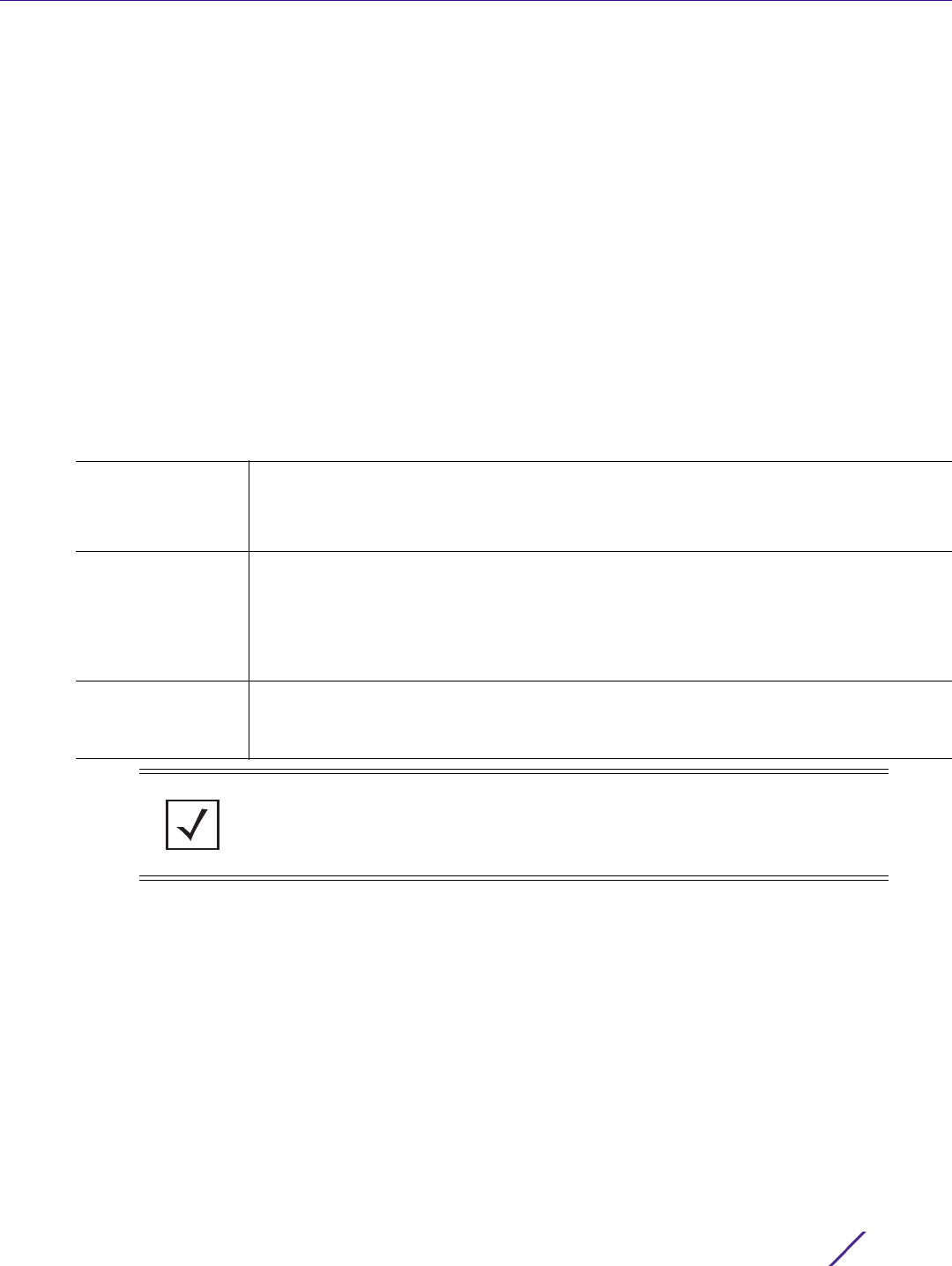
PROFILES
Access Point, Wireless Controller and Service Platform CLI Reference Guide 7 - 88
7.1.17.2.1 groupid
crypto-auto-ipsec-tunnel commands
Specifies the identity string used for IKE authentication
Supported in the following platforms:
• Access Points — AP6521, AP6522, AP6532, AP6562, AP7161, AP7502, AP7522, AP7532, AP7562,
AP7602, AP7612, AP7622, AP7632, AP7662, AP81XX, AP8232, AP8432, AP8533
• Wireless Controllers — RFS4000, RFS6000
• Service Platforms — NX5500, NX7500, NX7510, NX7520, NX7530, NX9500, NX9510, NX9600,
VX9000
Syntax
groupid <WORD> [psk|rsa]
groupid <WORD> [psk [0 <WORD>|2 <WORD>|<WORD>]|rsa]
Parameters
• groupid <WORD> [psk [0 <WORD>|2 <WORD>|<WORD>]|rsa]
Example
rfs6000-37FABE(config-profile-default-rfs6000-crypto-auto-ipsec-secure)#groupid
testgroup@123 rsa
rfs6000-37FABE(config-profile-default-rfs6000-crypto-auto-ipsec-secure)#show
context
crypto auto-ipsec-secure
groupid testgroup@123 rsa
rfs6000-37FABE(config-profile-default-rfs6000-crypto-auto-ipsec-secure)#
<WORD> Specify a string not exceeding 64 characters. This is the group identity used for IKE
exchange for auto IPSec secure peers. After providing a group ID, specify the
authentication method used to authenticate peers on the auto IPSec secure tunnel. The
options are: psk and rsa.
psk [0 <WORD>|
2 <WORD>|
<WORD>]
Configures the pre-shared key (PSK) as the authentication type for secure peer
authentication on the auto IPSec secure tunnel
• 0 <WORD> – Configures a clear text key
• 2 <WORD> – Configures an encrypted key
• <WORD> – Specify a string value from 8 - 21 characters.
rsa Configures the Rivest-Shamir-Adleman (RSA) key.
RSA is an algorithm for public key cryptography. It is the first algorithm known to be
suitable for signing, as well as encryption. This is the default setting.
NOTE: Only one group ID is supported on the controller or service platform.
All APs, controllers, and service platform must use the same group ID.

PROFILES
Access Point, Wireless Controller and Service Platform CLI Reference Guide 7 - 89
7.1.17.2.2 ip
crypto-auto-ipsec-tunnel commands
Enables the controller to uniquely identify APs and the hosts present in the AP’s subnet. This allows the
controller to correctly identify the destination host and create a dynamic site-to-site VPN tunnel between
the host and the private network behind the controller.
Supported in the following platforms:
• Access Points — AP6521, AP6522, AP6532, AP6562, AP7161, AP7502, AP7522, AP7532, AP7562,
AP7602, AP7612, AP7622, AP7632, AP7662, AP81XX, AP8232, AP8432, AP8533
• Wireless Controllers — RFS4000, RFS6000
• Service Platforms — NX5500, NX7500, NX7510, NX7520, NX7530, NX9500, NX9510, NX9600,
VX9000
Syntax
ip nat crypto
Parameters
• ip nat crypto
Example
rfs4000-229D58config-profile-testRFS4000-crypto-auto-ipsec-secure)#ip nat crypto
rfs4000-229D58config-profile-testRFS4000-crypto-auto-ipsec-secure)#show context
crypto auto-ipsec-secure
remotegw ike-version ikev2 uniqueid
ip nat crypto
rfs4000-229D58config-profile-testRFS4000-crypto-auto-ipsec-secure)#
ip nat crypto Enables unique identification of APs and the hosts present in each AP’s subnet
Providing a unique ID enables the access point, wireless controller, or service
platform to uniquely identify the destination device. This is essential in networks
where there are multiple APs behind a router, or when two (or more) APs behind two
(or more) different routers have the same IP address. Further, the same subnet exists
behind these APs.
For example, let us consider a scenario where there are two APs (A and B) behind
two routers (1 and 2). AP ‘A’ is behind router ‘1’. And AP ‘B’ is behind router ‘2’. Both
these APs have the same IP address (192.168.13.8). The subnet behind APs A and B is
also the same (100.1.1.0/24). In such a scenario the controller fails to uniquely identify
the hosts present in either AP’s subnet.
For more information, see remotegw and crypto.

PROFILES
Access Point, Wireless Controller and Service Platform CLI Reference Guide 7 - 90
7.1.17.2.3 ike-lifetime
crypto-auto-ipsec-tunnel commands
Configures the IKE SA’s key lifetime in seconds
The lifetime defines how long a connection (encryption/authentication keys) should last, from successful
key negotiation to expiration. Two peers need not exactly agree on the lifetime, though if they do not,
there is some clutter for a superseded connection on the peer defining the lifetime as longer.
Supported in the following platforms:
• Access Points — AP6521, AP6522, AP6532, AP6562, AP7161, AP7502, AP7522, AP7532, AP7562,
AP7602, AP7612, AP7622, AP7632, AP7662, AP81XX, AP8232, AP8432, AP8533
• Wireless Controllers — RFS4000, RFS6000
• Service Platforms — NX5500, NX7500, NX7510, NX7520, NX7530, NX9500, NX9510, NX9600,
VX9000
Syntax
ike-lifetime <600-86400>
Parameters
• ike-lifetime <600-86400>
Example
rfs4000-229D58(config-profile-testRFS4000-crypto-auto-ipsec-secure)#ike-lifetime
800
rfs4000-229D58(config-profile-testRFS4000-crypto-auto-ipsec-secure)#show context
crypto auto-ipsec-secure
ike-lifetime 800
rfs4000-229D58(config-profile-testRFS4000-crypto-auto-ipsec-secure)#
ike-lifetime
<600-86400>
Sets the IKE SA’s key lifetime in seconds
• <600-86400> – Specify a value fro m 600 - 86400 seconds. The default is 8600
seconds.

PROFILES
Access Point, Wireless Controller and Service Platform CLI Reference Guide 7 - 91
7.1.17.2.4 ikev2
crypto-auto-ipsec-tunnel commands
Enables the forced IKEv2 peer re-authentication. This option is disabled by default.
In most IPSec tunnel configurations, the lifetime of IKE SAs between peers is limited. Once the IKE SA key
expires it is renegotiated. In such a scenario, the IKEv2 tunnel peers may or may not re-authenticate
themselves. When enabled, IKE tunnel peers have to re-authenticate each time the IKE SA is renegotiated.
Supported in the following platforms:
• Access Points — AP6521, AP6522, AP6532, AP6562, AP7161, AP7502, AP7522, AP7532, AP7562,
AP7602, AP7612, AP7622, AP7632, AP7662, AP81XX, AP8232, AP8432, AP8533
• Wireless Controllers — RFS4000, RFS6000
• Service Platforms — NX5500, NX7500, NX7510, NX7520, NX7530, NX9500, NX9510, NX9600,
VX9000
Syntax
ikev2 peer reauth
Parameters
• ikev2 peer reauth
Example
rfs4000-229D58(config-profile-testRFS4000-crypto-auto-ipsec-secure)#ikev2 peer
reauth
ikev2 peer reauth Enables IKEv2 peer re-authentication. When enabled, IKE tunnel peers are forced to
re-authenticate each time the IKE key is renegotiated.

PROFILES
Access Point, Wireless Controller and Service Platform CLI Reference Guide 7 - 92
7.1.17.2.5 remotegw
crypto-auto-ipsec-tunnel commands
Defines the IKE version used for auto IPSEC tunnel negotiation with the IPSec remote gateway other than
the controller
Supported in the following platforms:
• Access Points — AP6521, AP6522, AP6532, AP6562, AP7161, AP7502, AP7522, AP7532, AP7562,
AP7602, AP7612, AP7622, AP7632, AP7662, AP81XX, AP8232, AP8432, AP8533
• Wireless Controllers — RFS4000, RFS6000
• Service Platforms — NX5500, NX7500, NX7510, NX7520, NX7530, NX9500, NX9510, NX9600,
VX9000
Syntax
remotegw ike-version [ikev1-aggr|ikev1-main|ikev2] {uniqueid}
Parameters
• remotegw ike-version [ikev1-aggr|ikev1-main|ikev2] {uniqueid}
Example
rfs6000-37FABE(config-profile-default-rfs6000-crypto-auto-ipsec-secure)#remotegw
ike-version ikev2 uniqueid
rfs6000-37FABE(config-profile-default-rfs6000-crypto-auto-ipsec-secure)#show
context
crypto auto-ipsec-secure
remotegw ike-version ikev2 uniqueid
rfs6000-37FABE(config-profile-default-rfs6000-crypto-auto-ipsec-secure)#
remotegw
ike-version
Configures the IKE version used for initiating auto IPSec tunnel with secure gateways
other than the controller
ikev1-aggr Aggregation mode is used by the auto IPSec tunnel initiator to set up the connection
ikev1-main Main mode is used by the auto IPSec tunnel initiator to establish the connection
ikev2 IKEv2 is the preferred method when wireless controller/AP only is used
uniqueid This keyword is common to all of the above parameters.
• uniqueid – Optional. Enables the assigning of a unique ID to APs (using this profile)
behind a router by prefixing the MAC address to the group ID
Providing a unique ID enables the access point, wireless controller, or service
platform to uniquely identify the destination device. This is essential in networks
where there are multiple APs behind a router, or when two (or more) APs behind two
(or more) different routers have the same IP address. For example, let us consider a
scenario where there are two APs (A and B) behind two routers (1 and 2). AP ‘A’ is
behind router ‘1’. And AP ‘B’ is behind router ‘2’. Both these APs have the same IP
address (192.168.13.8). In such a scenario, the controller fails to establish an Auto
IPSec VPN tunnel to either APs, because it is unable to uniquely identify them.
After enabling unique ID assignment, enable IKE unique ID check. For more
information, see crypto.

PROFILES
Access Point, Wireless Controller and Service Platform CLI Reference Guide 7 - 93
7.1.17.2.6 no
crypto-auto-ipsec-tunnel commands
Removes or resets this auto IPSec tunnel settings
Supported in the following platforms:
• Access Points — AP6521, AP6522, AP6532, AP6562, AP7161, AP7502, AP7522, AP7532, AP7562,
AP7602, AP7612, AP7622, AP7632, AP7662, AP81XX, AP8232, AP8432, AP8533
• Wireless Controllers — RFS4000, RFS6000
• Service Platforms — NX5500, NX7500, NX7510, NX7520, NX7530, NX9500, NX9510, NX9600,
VX9000
Syntax
no [groupid|ike-lifetime|ikev2 peer reauth|ip nat crypto]
Parameters
• no <PARAMETERS>
Example
The following example shows the Auto IPSec VLAN bridge settings before the ‘no’ command is
executed:
rfs6000-37FABE(config-profile-default-rfs6000-crypto-auto-ipsec-secure)#show
context
crypto auto-ipsec-secure
groupid testpassword@123 rsa
rfs6000-37FABE(config-profile-default-rfs6000-crypto-auto-ipsec-secure)#
rfs6000-37FABE(config-profile-default-rfs6000-crypto-auto-ipsec-secure)#no
groupid
The following example shows the Auto IPSec VLAN bridge settings after the ‘no’ command is executed:
rfs6000-37FABE(config-profile-default-rfs6000-crypto-auto-ipsec-secure)#show
context
crypto auto-ipsec-secure
rfs6000-37FABE(config-profile-default-rfs6000-crypto-auto-ipsec-secure)#
no <PARAMETERS> Removes or resets this auto IPSec tunnel’s settings based on the parameters passed

PROFILES
Access Point, Wireless Controller and Service Platform CLI Reference Guide 7 - 94
7.1.17.3 crypto-ikev1/ikev2-policy commands
crypto
Defines crypto-IKEv1/IKEv2 commands in detail
IKE protocol is a key management protocol standard used in conjunction with IPSec. IKE enhances IPSec
by providing additional features, flexibility, and configuration simplicity for the IPSec standard. IKE
automatically negotiates IPSec SAs and enables secure communications without time consuming manual
pre-configuration.
Use the (config) instance to configure IKEv1/IKEv2 policy configuration commands.
To navigate to the IKEv1/IKEv2 policy config instance, use the following commands:
<DEVICE>(config)#profile <DEVICE-TYPE> <PROFILE-NAME>
<DEVICE>(config-profile-<PROFILE-NAME>)#crypto ikev1/ikev2 policy <IKEV1/IKEV2-
POLICY-NAME>
rfs7000-37FABE(config-profile-default-rfs7000)#crypto ikev1 policy ikev1-
testpolicy
rfs7000-37FABE(config-profile-default-rfs7000-ikev1-policy-ikev1-testpolicy)#?
Crypto IKEv1 Policy Configuration commands:
dpd-keepalive Set Dead Peer Detection interval in seconds
dpd-retries Set Dead Peer Detection retries count
isakmp-proposal Configure ISAKMP Proposals
lifetime Set lifetime for ISAKMP security association
mode IKEv1 mode (main/aggressive)
no Negate a command or set its defaults
clrscr Clears the display screen
commit Commit all changes made in this session
end End current mode and change to EXEC mode
exit End current mode and down to previous mode
help Description of the interactive help system
revert Revert changes
service Service Commands
show Show running system information
write Write running configuration to memory or terminal
rfs7000-37FABE(config-profile-default-rfs7000-ikev1-policy-ikev1-testpolicy)#
rfs7000-37FABE(config-profile-test-ikev2-policy-ikev2-testpolicy)#?
Crypto IKEv2 Policy Configuration commands:
dpd-keepalive Set Dead Peer Detection interval in seconds
isakmp-proposal Configure ISAKMP Proposals
lifetime Set lifetime for ISAKMP security association
no Negate a command or set its defaults
sa-per-acl Setup single SA for all rules in the ACL (ONLY APPLICABLE
FOR SITE-TO-SITE VPN)
clrscr Clears the display screen
commit Commit all changes made in this session
do Run commands from Exec mode
end End current mode and change to EXEC mode
exit End current mode and down to previous mode
help Description of the interactive help system
revert Revert changes
service Service Commands
show Show running system information
write Write running configuration to memory or terminal
rfs7000-37FABE(config-profile-test-ikev2-policy-ikev2-testpolicy)#

PROFILES
Access Point, Wireless Controller and Service Platform CLI Reference Guide 7 - 95
The following table summarizes crypto IKEv1/iKEv2 configuration mode commands:
NOTE: IKEv2 being an improved version of the original IKEv1 design, is
recommended in most deployments. IKEv2 provides enhanced
cryptographic mechanisms, NAT and firewall traversal, attack resistance,
etc.
Command Description Reference
dpd-keepalive Sets DPD keep alive packet interval page 7-96
dpd-retries Sets the maximum number of attempts for sending DPD keep alive
packets (applicable only to the IKEv1 policy)
page 7-97
isakmp-
proposal
Configures ISAKMP proposals page 7-98
lifetime Specifies how long an IKE SA is valid before it expires page 7-100
mode Sets the mode of the tunnels (applicable only to the IKEv1 policy) page 7-101
no Removes or reverts IKEv1/IKEv2 policy settings page 7-102

PROFILES
Access Point, Wireless Controller and Service Platform CLI Reference Guide 7 - 96
7.1.17.3.1 dpd-keepalive
crypto-ikev1/ikev2-policy commands
Sets the DPD keep-alive packet interval
Supported in the following platforms:
• Access Points — AP6521, AP6522, AP6532, AP6562, AP7161, AP7502, AP7522, AP7532, AP7562,
AP7602, AP7612, AP7622, AP7632, AP7662, AP81XX, AP8232, AP8432, AP8533
• Wireless Controllers — RFS4000, RFS6000
• Service Platforms — NX5500, NX7500, NX7510, NX7520, NX7530, NX9500, NX9510, NX9600,
VX9000
Syntax
dpd-keepalive <10-3600>
Parameters
• dpd-keepalive <10-3600>
Example
rfs6000-37FABE(config-profile-default-rfs6000-ikev1-policy-ikev1-testpolicy)#
dpd-keepalive 11
rfs6000-37FABE(config-profile-default-rfs6000-ikev1-policy-testpolicy)#show
context
crypto ikev1 policy testpolicy
dpd-keepalive 11
isakmp-proposal default encryption aes-256 group 2 hash sha
rfs6000-37FABE(config-profile-default-rfs6000-ikev1-policy-testpolicy)#
<10-3600> Specifies the interval, in seconds, between successive DPD keep alive packets.The
IKE keep alive message is used to detect a dead peer on the remote end of the
IPSec VPN tunnel. Specify the time from 10 - 3600 seconds. The default is 30
seconds.

PROFILES
Access Point, Wireless Controller and Service Platform CLI Reference Guide 7 - 97
7.1.17.3.2 dpd-retries
crypto-ikev1/ikev2-policy commands
Sets the maximum number of times DPD keep-alive packets are sent to a peer. Once this value is
exceeded, without a response from the peer, the VPN tunnel connection is declared dead. This option is
available only for the IKEv1 policy.
Supported in the following platforms:
• Access Points — AP6521, AP6522, AP6532, AP6562, AP7161, AP7502, AP7522, AP7532, AP7562,
AP7602, AP7612, AP7622, AP7632, AP7662, AP81XX, AP8232, AP8432, AP8533
• Wireless Controllers — RFS4000, RFS6000
• Service Platforms — NX5500, NX7500, NX7510, NX7520, NX7530, NX9500, NX9510, NX9600,
VX9000
Syntax
dpd-retries <1-100>
Parameters
• dpd-retries <1-100>
Example
rfs6000-37FABE(config-profile-default-rfs6000-ikev1-policy-ikev1-testpolicy)#
dpd-retries 10
rfs6000-37FABE(config-profile-default-rfs6000-ikev1-policy-ikev1-testpolicy)#
show context
crypto ikev1 policy testpolicy
dpd-keepalive 11
dpd-retries 10
isakmp-proposal default encryption aes-256 group 2 hash sha
rfs6000-37FABE(config-profile-default-rfs6000-ikev1-policy-ikev1-testpolicy)#
<1-100> Declares a peer dead after the specified number of retries. Specify a value from 1 - 100.
The default is 5.

PROFILES
Access Point, Wireless Controller and Service Platform CLI Reference Guide 7 - 98
7.1.17.3.3 isakmp-proposal
crypto-ikev1/ikev2-policy commands
Configures ISAKMP proposals and their parameters
Supported in the following platforms:
• Access Points — AP6521, AP6522, AP6532, AP6562, AP7161, AP7502, AP7522, AP7532, AP7562,
AP7602, AP7612, AP7622, AP7632, AP7662, AP81XX, AP8232, AP8432, AP8533
• Wireless Controllers — RFS4000, RFS6000
• Service Platforms — NX5500, NX7500, NX7510, NX7520, NX7530, NX9500, NX9510, NX9600,
VX9000
Syntax
isakmp-proposal <WORD> encryption [3des|aes|aes-192|aes-256] group [14|2|5] hash
[aes-xcbc-mac|md5|sha|sha256]
Parameters
• isakmp-proposal <WORD> encryption [3des|aes|aes-192|aes-256] group [14|2|5] hash
[aes-xcbc-mac|md5|sha|sha256]
<WORD> Assigns the target peer (tunnel destination) a 32 character maximum name to
distinguish it from others with a similar configuration.
encryption
[3des|aes|aes-192|
aes-256]
Configures the encryption method used by the tunneled peers to securely inter-
operate
• 3des – Configures triple data encryption standard
• aes – Configures AES (128 bit keys)
• aes-192 – Configures AES (192 bit keys)
• aes-256 – Configures AES (256 bit keys). This is the default setting.
group [14|2|5] Specifies the Diffie-Hellman (DH) group identifier used by VPN peers to derive a
shared secret password without having to transmit. DH groups determine the strength
of the key used in key exchanges. The higher the group number, the stronger and
more secure the key. Options include 2, 5 and 14.
• 14 – Configures DH group 14
• 2 – Configures DH group 2. This is the default setting.
• 5 – Configures DH group 5
hash
[maes-xcbc-mac|
md5|sha|sha256]
Specifies the hash algorithm used to authenticate data transmitted over the IKE SA.
The hash algorithm specified here is used by VPN peers to exchange credential
information.
• aes-xcbc-mac – Uses AES XCBC Auth hash algorithm. This option is applicable only to
the IKEv2 policy configuration context.
•md5 – Uses Message Digest 5 (MD5) hash algorithm
• sha – Uses Secure Hash Authentication (SHA) hash algorithm. This is the default
setting.
• sha256 – Uses Secure Hash Standard 2 algorithm

PROFILES
Access Point, Wireless Controller and Service Platform CLI Reference Guide 7 - 99
Example
rfs6000-37FABE(config-profile-default-rfs6000-ikev1-policy-ikev1-testpolicy)#
isakmp-proposal testproposal encryption aes group 2 hash sha
rfs6000-37FABE(config-profile-default-rfs6000-ikev1-policy-ikev1-testpolicy)#
show context
crypto ikev1 policy testpolicy
dpd-keepalive 11
dpd-retries 10
isakmp-proposal default encryption aes-256 group 2 hash sha
isakmp-proposal testpraposal encryption aes group 2 hash sha
rfs6000-37FABE(config-profile-default-rfs6000-ikev1-policy-ikev1-testpolicy)#

PROFILES
Access Point, Wireless Controller and Service Platform CLI Reference Guide 7 - 100
7.1.17.3.4 lifetime
crypto-ikev1/ikev2-policy commands
Specifies how long an IKE SA (encryption/authentication keys) is valid. The value specified is the validity
period of the IKE SA from successful key negotiation to expiration.
Supported in the following platforms:
• Access Points — AP6521, AP6522, AP6532, AP6562, AP7161, AP7502, AP7522, AP7532, AP7562,
AP7602, AP7612, AP7622, AP7632, AP7662, AP81XX, AP8232, AP8432, AP8533
• Wireless Controllers — RFS4000, RFS6000
• Service Platforms — NX5500, NX7500, NX7510, NX7520, NX7530, NX9500, NX9510, NX9600,
VX9000
Syntax
lifetime <600-86400>
Parameters
• lifetime <600-86400>
Example
rfs6000-37FABE(config-profile-default-rfs6000-ikev1-policy-ikev1-testpolicy)#
lifetime 655
rfs6000-37FABE(config-profile-default-rfs6000-ikev1-policy-ikev1-testpolicy)#
show context
crypto ikev1 policy testpolicy
dpd-keepalive 11
dpd-retries 10
lifetime 655
isakmp-proposal default encryption aes-256 group 2 hash sha
isakmp-proposal testpraposal encryption aes group 2 hash sha
rfs6000-37FABE(config-profile-default-rfs6000-ikev1-policy-ikev1-testpolicy)#
lifetime <600-86400> Specifies how many seconds an IKE SA lasts before it expires. Set a time stamp from
600 - 86400 seconds.
• <600-86400> – Specify a value from 600 - 86400 seconds. The default is 86400
seconds.

PROFILES
Access Point, Wireless Controller and Service Platform CLI Reference Guide 7 - 101
7.1.17.3.5 mode
crypto-ikev1/ikev2-policy commands
Configures the IPSec mode of operation for the IKEv1 policy. This option is not available for IKEv2 policy.
Supported in the following platforms:
• Access Points — AP6521, AP6522, AP6532, AP6562, AP7161, AP7502, AP7522, AP7532, AP7562,
AP7602, AP7612, AP7622, AP7632, AP7662, AP81XX, AP8232, AP8432, AP8533
• Wireless Controllers — RFS4000, RFS6000
• Service Platforms — NX5500, NX7500, NX7510, NX7520, NX7530, NX9500, NX9510, NX9600,
VX9000
Syntax
mode [aggresive|main]
Parameters
• mode [aggresive|main]
Example
rfs6000-37FABE(config-profile-default-rfs6000-ikev1-policy-ikev1-testpolicy)#
mode aggressive
rfs6000-37FABE(config-profile-default-rfs6000-ikev1-policy-ikev1-testpolicy)#
show context
crypto ikev1 policy testpolicy
dpd-keepalive 11
dpd-retries 10
lifetime 655
isakmp-proposal default encryption aes-256 group 2 hash sha
isakmp-proposal testpraposal encryption aes group 2 hash sha
mode aggressive
rfs6000-37FABE(config-profile-default-rfs6000-ikev1-policy-ikev1-testpolicy)#
mode [aggresive|main] Sets the mode of the tunnels
• aggressive – Initiates the aggressive mode
• main – Initiates the main mode
If configuring the IKEv1 IPSec policy, define the IKE mode as either main or
aggressive. In the aggressive mode, 3 messages are exchanged between the IPSec
peers to setup the SA. On the other hand, in the main mode, 6 messages are
exchanged. The default setting is main.

PROFILES
Access Point, Wireless Controller and Service Platform CLI Reference Guide 7 - 102
7.1.17.3.6 no
crypto-ikev1/ikev2-policy commands
Removes or reverts IKEv1/IKEv2 policy settings
Supported in the following platforms:
• Access Points — AP6521, AP6522, AP6532, AP6562, AP7161, AP7502, AP7522, AP7532, AP7562,
AP7602, AP7612, AP7622, AP7632, AP7662, AP81XX, AP8232, AP8432, AP8533
• Wireless Controllers — RFS4000, RFS6000
• Service Platforms — NX5500, NX7500, NX7510, NX7520, NX7530, NX9500, NX9510, NX9600,
VX9000
Syntax
no [dpd-keepalive|dpd-retries|isakmp-proposal <WORD>|lifetime|mode]
Parameters
• no <PARAMETERS>
Example
The following example shows the IKEV1 Policy settings before the ‘no’ commands are executed:
rfs6000-37FABE(config-profile-default-rfs6000-ikev1-policy-ikev1-testpolicy)#
show context
crypto ikev1 policy testpolicy
dpd-keepalive 11
dpd-retries 10
lifetime 655
isakmp-proposal default encryption aes-256 group 2 hash sha
isakmp-proposal testpraposal encryption aes group 2 hash sha
mode aggressive
rfs6000-37FABE(config-profile-default-rfs6000-ikev1-policy-ikev1-testpolicy)#
rfs6000-37FABE(config-profile-default-rfs6000-ikev1-policy-ikev1-testpolicy)#no
mode
rfs6000-37FABE(config-profile-default-rfs6000-ikev1-policy-ikev1-testpolicy)#no
dpd-keepalive
rfs6000-37FABE(config-profile-default-rfs6000-ikev1-policy-ikev1-testpolicy)#no
dpd-retries
The following example shows the IKEV1 Policy settings after the ‘no’ commands are executed:
rfs6000-37FABE(config-profile-default-rfs6000-ikev1-policy-ikev1-testpolicy)#
show context
crypto ikev1 policy testpolicy
lifetime 655
isakmp-proposal default encryption aes-256 group 2 hash sha
isakmp-proposal testpraposal encryption aes group 2 hash sha
rfs6000-37FABE(config-profile-default-rfs6000-ikev1-policy-ikev1-testpolicy)#
no <PARAMETERS> Removes or reverts this IKEv1/IKEv2 policy settings based on parameters passed

PROFILES
Access Point, Wireless Controller and Service Platform CLI Reference Guide 7 - 103
7.1.17.4 crypto-ikev1/ikev2-peer commands
crypto
Use the (config) instance to configure IKEv1/IKEv2 peer configuration commands. To navigate to the IKEv1/
IKEv2 peer config instance, use the following commands:
<DEVICE>(config)#profile <DEVICE-TYPE> <PROFILE-NAME>
<DEVICE>(config-profile-<PROFILE-NAME>)#crypto ikev1/ikev2 peer <IKEV1/IKEV2-
PEER-NAME>
rfs7000-37FABE(config-profile-default-rfs7000)#crypto ikev1 peer peer1
rfs7000-37FABE(config-profile-default-rfs7000-ikev1-peer-peer1)#?
Crypto IKEV1 Peer Configuration commands:
authentication Configure Authentication credentials
ip Configure peer address/fqdn
localid Set local identity
no Negate a command or set its defaults
remoteid Configure remote peer identity
use Set setting to use
clrscr Clears the display screen
commit Commit all changes made in this session
end End current mode and change to EXEC mode
exit End current mode and down to previous mode
help Description of the interactive help system
revert Revert changes
service Service Commands
show Show running system information
write Write running configuration to memory or terminal
rfs7000-37FABE(config-profile-default-rfs7000-ikev1-peer-peer1)#
rfs7000-37FABE(config-profile-default-rfs7000)#crypto ikev2 peer peer1
rfs7000-37FABE(config-profile-default-rfs7000-ikev2-peer-peer1)#?
Crypto IKEV2 Peer Configuration commands:
authentication Configure Authentication credentials
ip Configure peer address/fqdn
localid Set local identity
no Negate a command or set its defaults
remoteid Configure remote peer identity
use Set setting to use
clrscr Clears the display screen
commit Commit all changes made in this session
do Run commands from Exec mode
end End current mode and change to EXEC mode
exit End current mode and down to previous mode
help Description of the interactive help system
revert Revert changes
service Service Commands
show Show running system information
write Write running configuration to memory or terminal
rfs7000-37FABE(config-profile-default-rfs7000-ikev2-peer-peer1)#

PROFILES
Access Point, Wireless Controller and Service Platform CLI Reference Guide 7 - 104
The following table summarizes crypto IPSec IKEv1/IKEv2 peer configuration mode commands:
Command Description Reference
authentication Configures a peer’s authentication mode and the pre-shared key page 7-105
ip Configures the peer’s IP address page 7-106
localid Configures a peer’s local identity details page 7-107
remoteid Configures a remote peer’s identity details page 7-108
use Associates an IKEv1 policy and IKEv2 policy with the IKEv1 and IKEv2
peer respectively
page 7-109
no Negates a command or reverts settings to their default. The no
command, when used in the ISAKMP policy mode, defaults the ISAKMP
protection suite settings.
page 7-110

PROFILES
Access Point, Wireless Controller and Service Platform CLI Reference Guide 7 - 105
7.1.17.4.1 authentication
crypto-ikev1/ikev2-peer commands
Configures IKEv1/IKEv2 peer’s authentication mode and the pre-shared key
Supported in the following platforms:
• Access Points — AP6521, AP6522, AP6532, AP6562, AP7161, AP7502, AP7522, AP7532, AP7562,
AP7602, AP7612, AP7622, AP7632, AP7662, AP81XX, AP8232, AP8432, AP8533
• Wireless Controllers — RFS4000, RFS6000
• Service Platforms — NX5500, NX7500, NX7510, NX7520, NX7530, NX9500, NX9510, NX9600,
VX9000
Syntax
authentication [psk|rsa]
authentication psk [0 <WORD>|2 <WORD>|<WORD>] {local|remote}
authentication rsa
Parameters
• authentication psk [0 <WORD>|2 <WORD>|<WORD>] {local|remote}
• authentication rsa
Example
rfs6000-37FABE(config-profile-default-rfs6000-ikev1-peer-peer1)#authentication
rsa
rfs6000-37FABE(config-profile-default-rfs6000-ikev2-peer-peer1)#authentication
psk 0 key@123456
rfs6000-37FABE(config-profile-default-rfs6000-ikev2-peer-peer1)#show context
crypto ikev2 peer peer1
authentication psk 0 key@123456 local
authentication psk 0 key@123456 remote
rfs6000-37FABE(config-profile-default-rfs6000-ikev2-peer-peer1)#
psk [0 <WORD>|
2 <WORD>|
<WORD>]
{local|remote}
Configures the authentication mode as pre-shared key (PSK). The PSK is a string, 8 -
12 characters long. It is shared by both ends of the VPN tunnel connection. If using
IKEv2, both a local and remote string must be specified for handshake validation at
both ends (local and remote) of the VPN connection.
• 0 <WORD> – Configures a clear text key
• 2 <WORD> – Configures an encrypted key
• <WORD> – Configures the pre-shared key
The following keywords are available only in the IKEv2 peer configuration mode:
• local – Optional. Uses the specified key for local peer authentication only
• remote – Optional. Uses the specified key for remote peer authentication only
Note: In case the peer type is not specified, this string is used for authenticating both
local and remote peers.
rsa Configures the authentication mode as Rivest, Shamir, and Adleman (RSA) This is the
default setting (for both IKEv1 and IKEv2).
RSA is the first known public-key cryptography algorithm designed signing and
encryption. If configuring the IKEv2 peer, the ‘rsa’ option allows you to enable
authentication at both ends of the VPN connection (local and remote).

PROFILES
Access Point, Wireless Controller and Service Platform CLI Reference Guide 7 - 106
7.1.17.4.2 ip
crypto-ikev1/ikev2-peer commands
Sets the IP address or Fully Qualified Domain Name (FQDN) of the IPSec VPN peer used in the tunnel
setup
Supported in the following platforms:
• Access Points — AP6521, AP6522, AP6532, AP6562, AP7161, AP7502, AP7522, AP7532, AP7562,
AP7602, AP7612, AP7622, AP7632, AP7662, AP81XX, AP8232, AP8432, AP8533
• Wireless Controllers — RFS4000, RFS6000
• Service Platforms — NX5500, NX7500, NX7510, NX7520, NX7530, NX9500, NX9510, NX9600,
VX9000
Syntax
ip [address <IP>|fqdn <WORD>]
Parameters
• ip [address <IP>|fqdn <WORD>]
Example
rfs6000-37FABE(config-profile-default-rfs6000-ikev1-peer-peer1)#ip address
172.16.10.12
rfs6000-37FABE(config-profile-default-rfs6000-ikev1-peer-peer1)#show context
crypto ikev1 peer peer1
ip address 172.16.10.12
rfs6000-37FABE(config-profile-default-rfs6000-ikev1-peer-peer1)#
rfs6000-37FABE(config-profile-default-rfs6000-ikev2-peer-peer1)#ip address
192.168.10.6
rfs6000-37FABE(config-profile-default-rfs6000-ikev2-peer-peer1)#show context
crypto ikev2 peer peer1
ip address 192.168.10.6
authentication psk 0 test@123456 local
authentication psk 0 test@123456 remote
rfs6000-37FABE(config-profile-default-rfs6000-ikev2-peer-peer1)#
address <IP> Specify the peer device’s IP address.
fqdn <WORD> Specify the peer device’s FQDN hostname.

PROFILES
Access Point, Wireless Controller and Service Platform CLI Reference Guide 7 - 107
7.1.17.4.3 localid
crypto-ikev1/ikev2-peer commands
Sets a IKEv1/IKEv2 peer’s local identity. This local identifier is used with this peer configuration for an IKE
exchange with the target VPN IPSec peer.
Supported in the following platforms:
• Access Points — AP6521, AP6522, AP6532, AP6562, AP7161, AP7502, AP7522, AP7532, AP7562,
AP7602, AP7612, AP7622, AP7632, AP7662, AP81XX, AP8232, AP8432, AP8533
• Wireless Controllers — RFS4000, RFS6000
• Service Platforms — NX5500, NX7500, NX7510, NX7520, NX7530, NX9500, NX9510, NX9600,
VX9000
Syntax
localid [address|autogen-uniqueid|dn|email|fqdn|string]
localid [address <IP>|autogen-uniqueid <WORD>|dn <WORD>|email <WORD>|fqdn <WORD>|
string <WORD>]
Parameters
• localid [address <IP>|dn <WORD>|email <WORD>|fqdn <WORD>|string <WORD>]
Example
rfs6000-37FABE(config-profile-default-rfs6000-ikev1-peer-peer1)#localid email
bob@examplecompany.com
rfs6000-37FABE(config-profile-default-rfs6000-ikev1-peer-peer1)#show context
crypto ikev1 peer peer1
ip address 172.16.10.12
localid email bob@examplecompany.com
rfs6000-37FABE(config-profile-default-rfs6000-ikev1-peer-peer1)#
address <IP> Configures the peer’s IP address. The IP address is used as local identity.
autogen-uniqueid
<WORD>
Generates a localid using the device's unique identity. The system prefixes the device's
unique identity to the string provided here. The device’s unique identity should be
existing and configured. For more information on configuring a device’s unique identity,
see autogen-uniqueid.
• <WORD> – Provide the string.
dn <WORD> Configures the peer’s distinguished name. (for example, "C=us ST=<state>
L=<location> O=<organization> OU=<org unit>". The maximum length is 128 characters.
email <WORD> Configures the peer’s e-mail address. The maximum length is 128 characters.
fqdn <WORD> Configures the peer’s FQDN. The maximum length is 128 characters.
string <WORD> Configures the peer’s identity string. The maximum length is 128 characters. This is the
default setting.

PROFILES
Access Point, Wireless Controller and Service Platform CLI Reference Guide 7 - 108
7.1.17.4.4 rem o tei d
crypto-ikev1/ikev2-peer commands
Configures a IKEv1/IKEV2 peer’s remote identity. This remote identifier is used with this peer configuration
for an IKE exchange with the target VPN IPSec peer.
Supported in the following platforms:
• Access Points — AP6521, AP6522, AP6532, AP6562, AP7161, AP7502, AP7522, AP7532, AP7562,
AP7602, AP7612, AP7622, AP7632, AP7662, AP81XX, AP8232, AP8432, AP8533
• Wireless Controllers — RFS4000, RFS6000
• Service Platforms — NX5500, NX7500, NX7510, NX7520, NX7530, NX9500, NX9510, NX9600,
VX9000
Syntax
remoteid [address <IP>|dn <WORD>|email <WORD>|fqdn <WORD>|string <WORD>]
Parameters
• remoteid [address <IP>|dn <WORD>|email <WORD>|fqdn <WORD>|string <WORD>
Example
rfs6000-37FABE(config-profile-default-rfs6000-ikev1-peer-peer1)#remoteid dn
SanJose
rfs6000-37FABE(config-profile-default-rfs6000-ikev1-peer-peer1)#show context
crypto ikev1 peer peer1
ip address 172.16.10.12
remoteid dn SanJose
localid email bob@examplecompany.com
rfs6000-37FABE(config-profile-default-rfs6000-ikev1-peer-peer1)#
rfs6000-37FABE(config-profile-default-rfs6000-ikev1-peer-peer1)#remoteid address
157.235.209.63
rfs6000-37FABE(config-profile-default-rfs6000-ikev2-peer-peer1)#show context
crypto ikev2 peer peer1
remoteid address 157.235.209.63
rfs6000-37FABE(config-profile-default-rfs6000-ikev2-peer-peer1)#
address <IP> Configures the remote IKEv1/IKEV2 peer’s IP address. The IP address is used as the
peer’s remote identity.
dn <WORD> Configures the remote peer’s distinguished name. For example, "C=us ST=<state>
L=<location> O=<organization> OU=<org unit>". The maximum length is 128 characters.
email <WORD> Configures the remote peer’s e-mail address. The maximum length is 128 characters.
fqdn <WORD> Configures a peer’s FQDN. The maximum length is 128 characters.
string <WORD> Configures a peer’s identity string. The maximum length is 128 characters.

PROFILES
Access Point, Wireless Controller and Service Platform CLI Reference Guide 7 - 109
7.1.17.4.5 use
crypto-ikev1/ikev2-peer commands
Associates IKEv1/IKEv2 policy with the IKEv1/IKEv2 peer respectively
Supported in the following platforms:
• Access Points — AP6521, AP6522, AP6532, AP6562, AP7161, AP7502, AP7522, AP7532, AP7562,
AP7602, AP7612, AP7622, AP7632, AP7662, AP81XX, AP8232, AP8432, AP8533
• Wireless Controllers — RFS4000, RFS6000
• Service Platforms — NX5500, NX7500, NX7510, NX7520, NX7530, NX9500, NX9510, NX9600,
VX9000
Syntax
use ikev1-policy <IKEV1-POLICY-NAME>
use ikev2-policy <IKEV2-POLICY-NAME>
Parameters
• use ikev1-policy <IKEV1-POLICY-NAME>
• use ikev2-policy <IKEV2-POLICY-NAME>
Example
rfs6000-37FABE(config-profile-default-rfs6000-ikev1-peer-peer1)#use ikev1-policy
test-ikev1policy
rfs6000-37FABE(config-profile-default-rfs6000-ikev1-peer-peer1)#show context
crypto ikev1 peer peer1
ip address 172.16.10.12
remoteid dn SanJose
localid email bob@examplecompany.com
use ikev1-policy test-ikev1policy
rfs6000-37FABE(config-profile-default-rfs6000-ikev1-peer-peer1)#
rfs6000-37FABE(config-profile-default-rfs6000-ikev2-peer-peer1)#use ikev2-policy
test-ikev2policy
rfs6000-37FABE(config-profile-default-rfs6000-ikev2-peer-peer1)#show context
crypto ikev2 peer peer1
remoteid address 157.235.209.63
use ikev2-policy test-ikev2policy
rfs6000-37FABE(config-profile-default-rfs6000-ikev2-peer-peer1)#
use ikev1-policy
<IKEV1-POLICY-
NAME>
Specify the IKEv1 policy name.
The local IKEv1 policy and the peer IKEv1 policy must have matching group settings
for successful negotiations.
use ikev2-policy
<IKEV2-POLICY-
NAME>
Specify the IKEv2 policy name.
The local IKEv2 policy and the peer IKEv2 policy must have matching group settings
for successful negotiations.

PROFILES
Access Point, Wireless Controller and Service Platform CLI Reference Guide 7 - 110
7.1.17.4.6 no
crypto-ikev1/ikev2-peer commands
Removes or reverts IKEv1/IKEv2 peer settings
Supported in the following platforms:
• Access Points — AP6521, AP6522, AP6532, AP6562, AP7161, AP7502, AP7522, AP7532, AP7562,
AP7602, AP7612, AP7622, AP7632, AP7662, AP81XX, AP8232, AP8432, AP8533
• Wireless Controllers — RFS4000, RFS6000
• Service Platforms — NX5500, NX7500, NX7510, NX7520, NX7530, NX9500, NX9510, NX9600,
VX9000
Syntax
no [authentication|ip|localid|remoteid|use <IKEv1/IKEv2-POLICY-NAME>]
Parameters
• no <PARAMETERS>
Example
The following example shows the Crypto IKEV1 peer1 settings before the ‘no’ commands are executed:
rfs6000-37FABE(config-profile-default-rfs6000-ikev1-peer-peer1)#show context
crypto ikev1 peer peer1
ip address 172.16.10.12
remoteid dn SanJose
localid email bob@examplecompany.com
use ikev1-policy test-ikev1policy
rfs6000-37FABE(config-profile-default-rfs6000-ikev1-peer-peer1)#
rfs6000-37FABE(config-profile-default-rfs6000-ikev1-peer-peer1)#no localid
rfs6000-37FABE(config-profile-default-rfs6000-ikev1-peer-peer1)#no remoteid
The following example shows the Crypto IKEV1 peer1 settings after the ‘no’ commands are executed:
rfs6000-37FABE(config-profile-default-rfs6000-ikev1-peer-peer1)#show context
crypto ikev1 peer peer1
ip address 172.16.10.12
use ikev1-policy test-ikev1policy
rfs6000-37FABE(config-profile-default-rfs6000-ikev1-peer-peer1)#
The following example shows the Crypto IKEV2 peer1 settings before the ‘no’ commands are executed:
rfs6000-37FABE(config-profile-default-rfs6000-ikev2-peer-peer1)#show context
crypto ikev2 peer peer1
remoteid address 157.235.209.63
use ikev2-policy test
rfs6000-37FABE(config-profile-default-rfs6000-ikev2-peer-peer1)#
The following example shows the Crypto IKEV2 peer1 settings after the ‘no’ commands are executed:
rfs6000-37FABE(config-profile-default-rfs7000-ikev2-peer-peer1)#no use ikev2-
policy
rfs6000-37FABE(config-profile-default-rfs6000-ikev2-peer-peer1)#show context
crypto ikev2 peer peer1
remoteid address 157.235.209.63
rfs6000-37FABE(config-profile-default-rfs6000-ikev2-peer-peer1)#
no <PARAMETERS> Removes or reverts IKEv1/IKEv2 peer settings based on the parameters passed

PROFILES
Access Point, Wireless Controller and Service Platform CLI Reference Guide 7 - 111
7.1.17.5 crypto-map-config-commands
crypto
This section explains crypto map configuration mode commands in detail.
A crypto map entry is a single policy that describes how certain traffic is secured. There are two types of
crypto map entries: ipsec-manual and ipsec-ike. Each entry is given an index (used to sort the ordered list).
IPSec VPN provides a secure tunnel between two networked peers. Administrators can define which
packets are sent within the tunnel, and how they're protected. When a tunneled peer sees a sensitive
packet, it creates a secure tunnel and sends the packet through the tunnel to its remote peer destination.
Tunnels are sets of SA between two peers. SAs define the protocols and algorithms applied to sensitive
packets and specify the keying mechanisms used by tunneled peers. SAs are unidirectional and exist in
both the inbound and outbound direction. SAs are established per the rules and conditions of defined
security protocols (AH or ESP).
IKE is a key management protocol standard used in conjunction with IPSec. IKE enhances IPSec by
providing additional features, flexibility, and configuration simplicity for the IPSec standard. IKE
automatically negotiates IPSec SAs, and enables secure communications without time consuming manual
pre-configuration.
Use crypto maps to configure IPSec VPN SAs. Crypto maps combine the elements comprising IPSec SAs.
Crypto maps also include transform sets. A transform set is a combination of security protocols, algorithms
and other settings applied to IPSec protected traffic. One crypto map is utilized for each IPSec peer,
however for remote VPN deployments one crypto map is used for all the remote IPSec peers.
Use the (config) instance to enter the crypto map configuration mode. To navigate to the crypto-map
configuration instance, use the following commands:
In the device-config mode:
<DEVICE>(config-device-<DEVICE-MAC>)#crypto map <CRYPTO-MAP-TAG> <1-1000>
[ipsec-isakmp {dynamic}|ipsec-manual]
In the profile-config mode:
<DEVICE>(config-profile-<PROFILE-NAME>)#crypto map <CRYPTO-MAP-TAG> <1-1000>
[ipsec-isakmp {dynamic}|ipsec-manual]
There are three different configurations defined for each listed crypto map: site-to-site manual (ipsec-
manual), site-to-site-auto tunnel (ipsec-isakmp), and remote VPN client (ipsec-isakmp dynamic). With site-
to-site deployments, an IPSec tunnel is deployed between two gateways, each at the edge of two different
remote networks. With remote VPN, an access point located at remote branch defines a tunnel with a
security gateway. This facilitates the end points in the branch office to communicate with the destination
endpoints (behind the security gateway) in a secure manner.

PROFILES
Access Point, Wireless Controller and Service Platform CLI Reference Guide 7 - 112
Each crypto map entry is given an index (used to sort the ordered list).
rfs6000-37FABE(config-profile-default-rfs6000)#crypto map map1 1 ipsec-manual
rfs6000-37FABE(config-profile-default-rfs6000-cryptomap-map1#1)#?
Manual Crypto Map Configuration commands:
local-endpoint-ip Use this IP as local tunnel endpoint address, instead
of the interface IP (Advanced Configuration)
mode Set the tunnel mode
no Negate a command or set its defaults
peer Set peer
security-association Set security association parameters
session-key Set security session key parameters
use Set setting to use
clrscr Clears the display screen
commit Commit all changes made in this session
do Run commands from Exec mode
end End current mode and change to EXEC mode
exit End current mode and down to previous mode
help Description of the interactive help system
revert Revert changes
service Service Commands
show Show running system information
write Write running configuration to memory or terminal
rfs6000-37FABE(config-profile-default-rfs6000-cryptomap-map1#1)#
The following table summarizes crypto map configuration mode commands:
Command Description Reference
crypto-map
auto-vpn-
tunnel/remote-
vpn-client
instance
Configures an auto site-to-site VPN or remote VPN client page 7-113
crypto-map-
ipsec-manual-
instance
Configures a manual site-to-site VPN page 7-127

PROFILES
Access Point, Wireless Controller and Service Platform CLI Reference Guide 7 - 113
7.1.17.5.1 crypto-map auto-vpn-tunnel/remote-vpn-client instance
crypto-map-config-commands
To navigate to the auto site-to-site VPN tunnel configuration instance, use the following command:
In the device-config mode:
<DEVICE>(config-device-<DEVICE-MAC>)#crypto map <CRYPTO-MAP-TAG> <1-1000> ipsec-
isakmp
In the profile-config mode:
<DEVICE>(config-profile-<PROFILE-NAME>)#crypto map <CRYPTO-MAP-TAG> <1-1000>
ipsec-isakmp
rfs4000-229D58(config-device-00-23-68-22-9D-58)#crypto map test 1 ipsec-isakmp
rfs4000-229D58(config-device-00-23-68-22-9D-58-cryptomap-test#1)#?
Site to Site Crypto Map Configuration commands:
ip Internet Protocol config commands
local-endpoint-ip Use this IP as local tunnel endpoint address, instead
of the interface IP (Advanced Configuration)
no Negate a command or set its defaults
peer Add a remote peer
pfs Specify Perfect Forward Secrecy
security-association Security association parameters
transform-set Specify IPSec transform to use
use Set setting to use
clrscr Clears the display screen
commit Commit all changes made in this session
do Run commands from Exec mode
end End current mode and change to EXEC mode
exit End current mode and down to previous mode
help Description of the interactive help system
revert Revert changes
service Service Commands
show Show running system information
write Write running configuration to memory or terminal
rfs4000-229D58(config-device-00-23-68-22-9D-58-cryptomap-test#1)#
To navigate to the remote VPN client configuration instance, use the following command:
In the device-config mode:
<DEVICE>(config-device-<DEVICE-MAC>)#crypto map <CRYPTO-MAP-TAG> <1-1000> ipsec-
isakmp {dynamic}
In the profile-config mode:
<DEVICE>(config-profile-<PROFILE-NAME>)#crypto map <CRYPTO-MAP-TAG> <1-1000>
ipsec-isakmp {dynamic}
rfs4000-229D58(config-device-00-23-68-22-9D-58)#crypto map test 2 ipsec-isakmp
dynamic
rfs4000-229D58(config-device-00-23-68-22-9D-58-cryptomap-test#2)#?
Dynamic Crypto Map Configuration commands:
local-endpoint-ip Use this IP as local tunnel endpoint address, instead
of the interface IP (Advanced Configuration)
modeconfig Set the mode config method
no Negate a command or set its defaults
peer Add a remote peer
pfs Specify Perfect Forward Secrecy
remote-type Set the remote VPN client type
security-association Security association parameters
transform-set Specify IPSec transform to use
use Set setting to use
clrscr Clears the display screen
commit Commit all changes made in this session

PROFILES
Access Point, Wireless Controller and Service Platform CLI Reference Guide 7 - 114
do Run commands from Exec mode
end End current mode and change to EXEC mode
exit End current mode and down to previous mode
help Description of the interactive help system
revert Revert changes
service Service Commands
show Show running system information
write Write running configuration to memory or terminal
rfs4000-229D58(config-device-00-23-68-22-9D-58-cryptomap-test#2)#
The following table lists the IPSec-Auto-VPN/Remote-VPN tunnel configuration commands:
Command Description Reference
ip Enables this setting to utilize IP/Port NAT on the VPN tunnel. This
command is applicable only to the site-to-site VPN tunnel.
page 7-115
local-endpoint-
ip
Uses the configured IP as local tunnel endpoint address, instead of the
interface IP. This command is applicable to the site-to-site VPN tunnel and
remote VPN client.
page 7-116
modeconfig Configures the mode config method (pull or push) associated with the
remote VPN client. This command is applicable only to the remote VPN
client.
page 7-117
peer Configures the IKEv1 or IKEv2 peer for the VPN tunnel. This command is
applicable to the site-to-site VPN tunnel and remote VPN client.
page 7-118
pfs Configures the Perfect Forward Secrecy (PFS) for the VPN tunnel. This
command is applicable to the site-to-site VPN tunnel and remote VPN
client.
page 7-119
remote-type Configures the remote VPN client type as either None or XAuth. This
command is applicable only to the remote VPN client.
page 7-120
security-
association
Defines this automatic VPN tunnel’s IPSec SA settings. This command is
applicable to the site-to-site VPN tunnel and remote VPN client.
page 7-121
transform-set Applies a transform set (encryption and hash algorithms) to the VPN
tunnel. This command is applicable to the site-to-site VPN tunnel and
remote VPN client.
page 7-123
use Applies an existing and configured IP access list to the VPN tunnel. This
command is applicable to the site-to-site VPN tunnel and remote VPN
client.
page 7-124
no Removes or reverts site-to-site VPN tunnel or remote VPN client settings page 7-125

PROFILES
Access Point, Wireless Controller and Service Platform CLI Reference Guide 7 - 115
7.1.17.5.2 ip
crypto-map auto-vpn-tunnel/remote-vpn-client instance
Enables this setting to utilize IP/Port NAT on this auto site-to-site VPN tunnel. This option is disabled by
default.
Supported in the following platforms:
• Access Points — AP6521, AP6522, AP6532, AP6562, AP7161, AP7502, AP7522, AP7532, AP7562,
AP7602, AP7612, AP7622, AP7632, AP7662, AP81XX, AP8232, AP8432, AP8533
• Wireless Controllers — RFS4000, RFS6000
• Service Platforms — NX5500, NX7500, NX7510, NX7520, NX7530, NX9500, NX9510, NX9600,
VX9000
Syntax
ip nat crypto
Parameters
• ip nat crypto
Example
rfs4000-229D58(config-device-00-23-68-22-9D-58-cryptomap-test#1)#ip nat crypto
rfs4000-229D58(config-device-00-23-68-22-9D-58-cryptomap-test#1)#show context
crypto map test 1 ipsec-isakmp
ip nat crypto
rfs4000-229D58(config-device-00-23-68-22-9D-58-cryptomap-test#1)#
ip nat crypto Enables this setting to utilize IP/Port NAT on the site-to-site VPN tunnel. This setting is
disabled by default.

PROFILES
Access Point, Wireless Controller and Service Platform CLI Reference Guide 7 - 116
7.1.17.5.3 local-endpoint-ip
crypto-map auto-vpn-tunnel/remote-vpn-client instance
Uses the configured IP as local tunnel endpoint address, instead of the interface IP
Supported in the following platforms:
• Access Points — AP6521, AP6522, AP6532, AP6562, AP7161, AP7502, AP7522, AP7532, AP7562,
AP7602, AP7612, AP7622, AP7632, AP7662, AP81XX, AP8232, AP8432, AP8533
• Wireless Controllers — RFS4000, RFS6000
• Service Platforms — NX5500, NX7500, NX7510, NX7520, NX7530, NX9500, NX9510, NX9600,
VX9000
Syntax
local-endpoint-ip <IP>
Parameters
• local-endpoint-ip <IP>
Example
Site-to-site VPN tunnel:
rfs4000-229D58(config-device-00-23-68-22-9D-58-cryptomap-test#1)#local-endpoint-
ip 192.168.13.10
rfs4000-229D58(config-device-00-23-68-22-9D-58-cryptomap-test#1)#show context
crypto map test 1 ipsec-isakmp
local-endpoint-ip 192.168.13.10
ip nat crypto
rfs4000-229D58(config-device-00-23-68-22-9D-58-cryptomap-test#1)#
Remote VPN client:
rfs4000-229D58(config-device-00-23-68-22-9D-58-cryptomap-test#2)#local-endpoint-
ip 157.235.204.62
rfs4000-229D58(config-device-00-23-68-22-9D-58-cryptomap-test#2)#show context
crypto map test 2 ipsec-isakmp dynamic
local-endpoint-ip 157.235.204.62
rfs4000-229D58(config-device-00-23-68-22-9D-58-cryptomap-test#2)#
local-endpoint-ip
<IP>
Configures the local VPN tunnel’s (site-to-site VPN tunnel or remote VPN client)
endpoint IP address
• <IP> – Specify the IP address. The specified IP address must be available on the
interface.

PROFILES
Access Point, Wireless Controller and Service Platform CLI Reference Guide 7 - 117
7.1.17.5.4 mod e conf i g
crypto-map auto-vpn-tunnel/remote-vpn-client instance
Configures the mode config method (pull or push) associated with the remote VPN client
Supported in the following platforms:
• Access Points — AP6521, AP6522, AP6532, AP6562, AP7161, AP7502, AP7522, AP7532, AP7562,
AP7602, AP7612, AP7622, AP7632, AP7662, AP81XX, AP8232, AP8432, AP8533
• Wireless Controllers — RFS4000, RFS6000
• Service Platforms — NX5500, NX7500, NX7510, NX7520, NX7530, NX9500, NX9510, NX9600,
VX9000
Syntax
modeconfig [pull|push]
Parameters
• modeconfig [pull|push]
Example
Remote VPN client:
rfs4000-229D58(config-device-00-23-68-22-9D-58-cryptomap-test#2)#modeconfig pull
rfs4000-229D58(config-device-00-23-68-22-9D-58-cryptomap-test#2)#show context
crypto map test 2 ipsec-isakmp dynamic
modeconfig pull
rfs4000-229D58(config-device-00-23-68-22-9D-58-cryptomap-test#2)
modeconfig
[pull|push]
Configures the mode config method associated with a remote VPN client. The options
are: pull and push.
The mode (pull or push) defines the method used to assign a virtual IP. This setting is
relevant for IKEv1 only, since IKEv2 always uses the configuration payload in pull mode.
The default setting is push.

PROFILES
Access Point, Wireless Controller and Service Platform CLI Reference Guide 7 - 118
7.1.17.5.5 peer
crypto-map auto-vpn-tunnel/remote-vpn-client instance
Configures the IKEv1 or IKEv2 peer for the auto site-to-site VPN tunnel or remote VPN client. The peer
device can be specified either by its hostname or by its IP address. A maximum of three peers can be
configured.
Supported in the following platforms:
• Access Points — AP6521, AP6522, AP6532, AP6562, AP7161, AP7502, AP7522, AP7532, AP7562,
AP7602, AP7612, AP7622, AP7632, AP7662, AP81XX, AP8232, AP8432, AP8533
• Wireless Controllers — RFS4000, RFS6000
• Service Platforms — NX5500, NX7500, NX7510, NX7520, NX7530, NX9500, NX9510, NX9600,
VX9000
Syntax
peer <1-3> [ikev1|ikev2] <IKEv1/IKEv2-PEER-NAME>
Parameters
• peer <1-3> [ikev1|ikev2] <IKEv1/IKEv2-PEER-NAME>
Example
Site-to-site tunnel:
rfs4000-229D58(config-device-00-23-68-22-9D-58-cryptomap-test#1)#peer 1 ikev2
ikev2Peer1
rfs4000-229D58(config-device-00-23-68-22-9D-58-cryptomap-test#1)#show context
crypto map test 1 ipsec-isakmp
peer 1 ikev2 ikev2Peer1
local-endpoint-ip 192.168.13.10
ip nat crypto
rfs4000-229D58(config-device-00-23-68-22-9D-58-cryptomap-test#1)#
Remote VPN client:
rfs4000-229D58(config-device-00-23-68-22-9D-58-cryptomap-test#2)#peer 1 ikev1 Re
moteIKEv1Peer1
rfs4000-229D58(config-device-00-23-68-22-9D-58-cryptomap-test#2)#show context
crypto map test 2 ipsec-isakmp dynamic
peer 1 ikev1 RemoteIKEv1Peer1
local-endpoint-ip 157.235.204.62
rfs4000-229D58(config-device-00-23-68-22-9D-58-cryptomap-test#2)#
peer <1-3> Creates a new peer and configures the peer’s priority level. Peer ‘1’ is the primary
peer, and peer ‘3’ is redundant.
ikev1 <IKEv1-PEER-
NAME>
Configures an IKEv1 peer
• <IKEv1-PEER-NAME> – Specify the IKEv1 peer’s name.
ikev2<IKEv2-PEER-
NAME>
Configures an IKEv2 peer
• <IKEv2-PEER-NAME> – Specify the IKEv2 peer’s name.

PROFILES
Access Point, Wireless Controller and Service Platform CLI Reference Guide 7 - 119
7.1.17.5.6 pfs
crypto-map auto-vpn-tunnel/remote-vpn-client instance
Configures Perfect Forward Secrecy (PFS) for the auto site-to-site VPN tunnel or remote VPN client
PFS is the key-establishment protocol, used to secure VPN communications. If one encryption key is
compromised, only data encrypted by that specific key is compromised. For PFS to exist, the key used to
protect data transmissions must not be used to derive any additional keys. Options include 2, 5 and 14. This
option is disabled by default.
Supported in the following platforms:
• Access Points — AP6521, AP6522, AP6532, AP6562, AP7161, AP7502, AP7522, AP7532, AP7562,
AP7602, AP7612, AP7622, AP7632, AP7662, AP81XX, AP8232, AP8432, AP8533
• Wireless Controllers — RFS4000, RFS6000
• Service Platforms — NX5500, NX7500, NX7510, NX7520, NX7530, NX9500, NX9510, NX9600,
VX9000
Syntax
pfs [14|2|5]
Parameters
• pfs [14|2|5]
Example
Site-to-site VPN tunnel:
rfs4000-229D58(config-device-00-23-68-22-9D-58-cryptomap-test#1)#pfs 5
rfs4000-229D58(config-device-00-23-68-22-9D-58-cryptomap-test#1)#show context
crypto map test 1 ipsec-isakmp
peer 1 ikev2 ikev2Peer1
local-endpoint-ip 192.168.13.10
pfs 5
ip nat crypto
rfs4000-229D58(config-device-00-23-68-22-9D-58-cryptomap-test#1)#
Remote VPN client:
rfs4000-229D58(config-device-00-23-68-22-9D-58-cryptomap-test#2)#pfs 14
rfs4000-229D58(config-device-00-23-68-22-9D-58-cryptomap-test#2)#show context
crypto map test 2 ipsec-isakmp dynamic
peer 1 ikev1 RemoteIKEv1Peer1
local-endpoint-ip 157.235.204.62
pfs 14
rfs4000-229D58(config-device-00-23-68-22-9D-58-cryptomap-test#2)#
pfs [14|2|5] Configures PFS
• 14 – Configures D-H Group14 (2048-bit modp)
• 2 – Configures D-H Group2 (1024-bit modp)
• 5 – Configures D-H Group5 (1536-bit modp)

PROFILES
Access Point, Wireless Controller and Service Platform CLI Reference Guide 7 - 120
7.1.17.5.7 remo te-typ e
crypto-map auto-vpn-tunnel/remote-vpn-client instance
Configures the remote VPN client type as either None or XAuth
Supported in the following platforms:
• Access Points — AP6521, AP6522, AP6532, AP6562, AP7161, AP7502, AP7522, AP7532, AP7562,
AP7602, AP7612, AP7622, AP7632, AP7662, AP81XX, AP8232, AP8432, AP8533
• Wireless Controllers — RFS4000, RFS6000
• Service Platforms — NX5500, NX7500, NX7510, NX7520, NX7530, NX9500, NX9510, NX9600,
VX9000
Syntax
remote-type [none|xauth]
Parameters
• remote-type [none|xauth]
Example
Remote VPN client:
rfs4000-229D58(config-device-00-23-68-22-9D-58-cryptomap-test#2)#remote-type none
rfs4000-229D58(config-device-00-23-68-22-9D-58-cryptomap-test#2)#show context
crypto map test 2 ipsec-isakmp dynamic
peer 1 ikev1 RemoteIKEv1Peer1
local-endpoint-ip 157.235.204.62
pfs 14
remote-type none
rfs4000-229D58(config-device-00-23-68-22-9D-58-cryptomap-test#2)#
remote-type
[none|xauth]
Specify the remote VPN’s client type
• none – Configures remote VPN client with No XAUTH
• xauth – Configures remote VPN client as using XAUTH (applicable only for IKEv1).
This is the default setting.
XAuth (extended authentication) provides additional authentication validation by
permitting an edge device to request extended authentication information from an
IPSec host. This forces the host to respond with additional authentication
credentials. The edge device respond with a failed or passed message.

PROFILES
Access Point, Wireless Controller and Service Platform CLI Reference Guide 7 - 121
7.1.17.5.8 security-association
crypto-map auto-vpn-tunnel/remote-vpn-client instance
Defines the IPSec SA’s (created by this auto site-to-site VPN tunnel or remote VPN client) settings
Supported in the following platforms:
• Access Points — AP6521, AP6522, AP6532, AP6562, AP7161, AP7502, AP7522, AP7532, AP7562,
AP7602, AP7612, AP7622, AP7632, AP7662, AP81XX, AP8232, AP8432, AP8533
• Wireless Controllers — RFS4000, RFS6000
• Service Platforms — NX5500, NX7500, NX7510, NX7520, NX7530, NX9500, NX9510, NX9600,
VX9000
Syntax
security-association [inactivity-timeout|level|lifetime]
security-association [inactivity-timeout <120-86400>|level perhost]
security-association lifetime [kilobytes <500-2147483646>|seconds <120-86400>]
Parameters
• security-association [inactivity-timeout <120-86400>|level perhost]
• security-association lifetime [kilobytes <500-2147483646>|seconds <120-86400>]
Example
Site-to-site tunnel:
rfs4000-229D58(config-device-00-23-68-22-9D-58-cryptomap-test#1)#security-
association inactivity-timeout 200
rfs4000-229D58(config-device-00-23-68-22-9D-58-cryptomap-test#1)#security-
association level perhost
rfs4000-229D58(config-device-00-23-68-22-9D-58-cryptomap-test#1)#security-
association lifetime kilobytes 250000
inactivity-timeout
<120-86400>
Specifies an inactivity period, in seconds, for this IPSec VPN SA. Once the set value
is exceeded, the association is timed out.
• <120-86400> – Specify a value from 120 - 86400 seconds. The default is 900
seconds.
level perhost Specifies the granularity level for this IPSec VPN SA
• perhost – Sets the IPSec VPN SA’s granularity to the host level
lifetime
[kilobytes
<500-2147483646>|
seconds
<120-86400>]
Defines the IPSec SA’s lifetime (in kilobytes and/or seconds). Values can be entered
in both kilobytes and seconds. Which ever limit is reached first, ends the security
association.
• kilobytes <500-2147483646> – Defines volume based key duration. Specify a value
from 500 - 2147483646 kilobytes. Select this option to define a connection volume
lifetime (in kilobytes) for the duration of the IPSec VPN SA. Once the set volume is
exceeded, the association is timed out. This option is disabled by default.
• seconds <120-86400> – Defines time based key duration. Specify the time frame
from 120 - 86400 seconds. Select this option to define a lifetime (in seconds) for the
duration of the IPSec VPN SA. Once the set value is exceeded, the association is
timed out. This option is disabled by default.

PROFILES
Access Point, Wireless Controller and Service Platform CLI Reference Guide 7 - 122
rfs4000-229D58(config-device-00-23-68-22-9D-58-cryptomap-test#1)#show context
crypto map test 1 ipsec-isakmp
security-association level perhost
peer 1 ikev2 ikev2Peer1
local-endpoint-ip 192.168.13.10
pfs 5
security-association lifetime kilobytes 250000
security-association inactivity-timeout 200
ip nat crypto
rfs4000-229D58(config-device-00-23-68-22-9D-58-cryptomap-test#1)#
Remote VPN client:
rfs4000-229D58(config-device-00-23-68-22-9D-58-cryptomap-test#2)#security-
association lifetime seconds 10000
rfs4000-229D58(config-device-00-23-68-22-9D-58-cryptomap-test#2)#show context
crypto map test 2 ipsec-isakmp dynamic
peer 1 ikev1 RemoteIKEv1Peer1
local-endpoint-ip 157.235.204.62
pfs 14
security-association lifetime seconds 10000
remote-type none
rfs4000-229D58(config-device-00-23-68-22-9D-58-cryptomap-test#2)#

PROFILES
Access Point, Wireless Controller and Service Platform CLI Reference Guide 7 - 123
7.1.17.5.9 transform-set
crypto-map auto-vpn-tunnel/remote-vpn-client instance
Applies a transform set (encryption and hash algorithms) to site-to-site VPN tunnel or remote VPN client.
This command allows you to provide customized data protection for each crypto map can be customized
with its own data protection and peer authentication schemes.
Supported in the following platforms:
• Access Points — AP6521, AP6522, AP6532, AP6562, AP7161, AP7502, AP7522, AP7532, AP7562,
AP7602, AP7612, AP7622, AP7632, AP7662, AP81XX, AP8232, AP8432, AP8533
• Wireless Controllers — RFS4000, RFS6000
• Service Platforms — NX5500, NX7500, NX7510, NX7520, NX7530, NX9500, NX9510, NX9600,
VX9000
Syntax
transform-set <TRANSFORM-SET-TAG> {<TRANSFORM-SET-TAG>}
Parameters
• transform-set <TRANSFORM-SET-TAG> {<TRANSFORM-SET-TAG>}
Example
Site-to-site VPN tunnel:
rfs4000-229D58(config-device-00-23-68-22-9D-58-cryptomap-test#1)#transform-set
AutoVPN
rfs4000-229D58(config-device-00-23-68-22-9D-58-cryptomap-test#1)#show context
crypto map test 1 ipsec-isakmp
security-association level perhost
peer 1 ikev2 ikev2Peer1
local-endpoint-ip 192.168.13.10
pfs 5
security-association lifetime kilobytes 250000
security-association inactivity-timeout 200
transform-set AutoVPN
ip nat crypto
rfs4000-229D58(config-device-00-23-68-22-9D-58-cryptomap-test#1)#
Remote VPN client:
rfs4000-229D58(config-device-00-23-68-22-9D-58-cryptomap-test#2)#transform-set
RemoteVPN
rfs4000-229D58(config-device-00-23-68-22-9D-58-cryptomap-test#2)#show context
crypto map test 2 ipsec-isakmp dynamic
peer 1 ikev1 RemoteIKEv1Peer1
local-endpoint-ip 157.235.204.62
pfs 14
security-association lifetime seconds 10000
transform-set RemoteVPN
remote-type none
rfs4000-229D58(config-device-00-23-68-22-9D-58-cryptomap-test#2)#
transform-set
<TRANSFORM-SET-
TAG>
<TRANSFORM-SET-
TAG>
Applies a transform set. The transform set should be existing and configured.
• <TRANSFORM-SET-TAG> – Specify the transform set’s name.
• <TRANSFORM-SET-TAG> – Optional. Specify a second transform set. You can pro-
vide multiple, space-separated, transform set tags.

PROFILES
Access Point, Wireless Controller and Service Platform CLI Reference Guide 7 - 124
7.1.17.5.10 u se
crypto-map auto-vpn-tunnel/remote-vpn-client instance
Applies an existing and configured IP access list to the auto site-to-site VPN tunnel or remote VPN client.
Based on the IP access list’s settings traffic is permitted or denied across the VPN tunnel.
Supported in the following platforms:
• Access Points — AP6521, AP6522, AP6532, AP6562, AP7161, AP7502, AP7522, AP7532, AP7562,
AP7602, AP7612, AP7622, AP7632, AP7662, AP81XX, AP8232, AP8432, AP8533
• Wireless Controllers — RFS4000, RFS6000
• Service Platforms — NX5500, NX7500, NX7510, NX7520, NX7530, NX9500, NX9510, NX9600,
VX9000
Syntax
use ip-access-list <IP-ACCESS-LIST-NAME>
Parameters
• use ip-access-list <IP-ACCESS-LIST-NAME>
Example
Site-to-site VPN tunnel:
rfs4000-229D58(config-device-00-23-68-22-9D-58-cryptomap-test#1)#use ip-access-
list test
rfs4000-229D58(config-device-00-23-68-22-9D-58-cryptomap-test#1)#show context
crypto map test 1 ipsec-isakmp
use ip-access-list test
security-association level perhost
peer 1 ikev2 ikev2Peer1
local-endpoint-ip 192.168.13.10
pfs 5
security-association lifetime kilobytes 250000
security-association inactivity-timeout 200
transform-set AutoVPN
ip nat crypto
rfs4000-229D58(config-device-00-23-68-22-9D-58-cryptomap-test#1)#
Remote VPN client:
rrfs4000-229D58(config-device-00-23-68-22-9D-58-cryptomap-test#2)#use ip-access-
list test1
rfs4000-229D58(config-device-00-23-68-22-9D-58-cryptomap-test#2)#show context
' crypto map test 2 ipsec-isakmp dynamic
use ip-access-list test1
peer 1 ikev1 RemoteIKEv1Peer1
local-endpoint-ip 157.235.204.62
pfs 14
security-association lifetime seconds 10000
transform-set RemoteVPN
remote-type none
rfs4000-229D58(config-device-00-23-68-22-9D-58-cryptomap-test#2)#
ip-access-list
<IP-ACCESS-LIST-
NAME>
Specify the IP access list name.

PROFILES
Access Point, Wireless Controller and Service Platform CLI Reference Guide 7 - 125
7.1.17.5.11 n o
crypto-map auto-vpn-tunnel/remote-vpn-client instance
Removes or reverts the auto site-to-site VPN tunnel or remote VPN client settings
Supported in the following platforms:
• Access Points — AP6521, AP6522, AP6532, AP6562, AP7161, AP7502, AP7522, AP7532, AP7562,
AP81XX, AP8232, AP8432, AP8533
• Wireless Controllers — RFS4000, RFS6000
• Service Platforms — NX5500, NX7500, NX7510, NX7520, NX7530, NX9500, NX9510, NX9600,
VX9000
Syntax
no [ip|local-endpoint-ip|modeconfig|peer|pfs|remote-type|security-association|
transform-set|use]
Parameters
• no <PARAMETERS>
Example
The following example shows the IPSec site-to-site VPN tunnel ‘test’ settings before the ‘no’ commands
are executed:
rfs4000-229D58(config-device-00-23-68-22-9D-58-cryptomap-test#1)#show context
crypto map test 1 ipsec-isakmp
use ip-access-list test
security-association level perhost
peer 1 ikev2 ikev2Peer1
local-endpoint-ip 192.168.13.10
pfs 5
security-association lifetime kilobytes 250000
security-association inactivity-timeout 200
transform-set AutVPN
ip nat crypto
rfs4000-229D58(config-device-00-23-68-22-9D-58-cryptomap-test#1)#
rfs4000-229D58(config-device-00-23-68-22-9D-58-cryptomap-test#1)#no use ip-
access-list
rfs4000-229D58(config-device-00-23-68-22-9D-58-cryptomap-test#1)#no security-
association level perhost
rfs4000-229D58(config-device-00-23-68-22-9D-58-cryptomap-test#1)#no ip nat crypto
rfs4000-229D58(config-device-00-23-68-22-9D-58-cryptomap-test#1)#no pfs
rfs4000-229D58(config-device-00-23-68-22-9D-58-cryptomap-test#1)#no local-
endpoint-ip
The following example shows the IPSec site-to-site VPN tunnel ‘test’ settings after the ‘no’ commands
are executed:
rfs4000-229D58(config-device-00-23-68-22-9D-58-cryptomap-test#1)#show context
crypto map test 1 ipsec-isakmp
peer 1 ikev2 ikev2Peer1
security-association lifetime kilobytes 250000
security-association inactivity-timeout 200
transform-set AutoVPN
rfs4000-229D58(config-device-00-23-68-22-9D-58-cryptomap-test#1)#
no <PARAMETERS> Removes or resets this auto site-to-site/remote VPN settings based on the
parameters passed

PROFILES
Access Point, Wireless Controller and Service Platform CLI Reference Guide 7 - 126
The following example shows the IPSec remote VPN client ‘test’ settings before the ‘no’ commands are
executed:
rfs4000-229D58(config-device-00-23-68-22-9D-58-cryptomap-test#2)#show context
crypto map test 2 ipsec-isakmp dynamic
use ip-access-list test2
peer 1 ikev1 RemoteIKEv1Peer1
local-endpoint-ip 157.235.204.62
pfs 14
security-association lifetime seconds 10000
transform-set RemoteVPN
remote-type none
rfs4000-229D58(config-device-00-23-68-22-9D-58-cryptomap-test#2)#
rfs4000-229D58(config-device-00-23-68-22-9D-58-cryptomap-test#2)#no use ip-
access-list
rfs4000-229D58(config-device-00-23-68-22-9D-58-cryptomap-test#2)#no peer 1
rfs4000-229D58(config-device-00-23-68-22-9D-58-cryptomap-test#2)#no transform-set
The following example shows the IPSec remote VPN client ‘test’ settings after the ‘no’ commands are
executed:
rfs4000-229D58(config-device-00-23-68-22-9D-58-cryptomap-test#2)#show context
crypto map test 2 ipsec-isakmp dynamic
local-endpoint-ip 157.235.204.62
pfs 14
security-association lifetime seconds 10000
remote-type none
rfs4000-229D58(config-device-00-23-68-22-9D-58-cryptomap-test#2)#

PROFILES
Access Point, Wireless Controller and Service Platform CLI Reference Guide 7 - 127
7.1.17.5.12 crypto-map-ipsec-manual-instance
crypto-map-config-commands
To navigate to the automatic IPSec manual VPN tunnel configuration instance, use the following command:
In the device-config mode:
<DEVICE>(config-device-<DEVICE-MAC>)#crypto map <CRYPTO-MAP-TAG> <1-1000> ipsec-
manual
In the profile-config mode:
<DEVICE>(config-profile-<PROFILE-NAME>)#crypto map <CRYPTO-MAP-TAG> <1-1000>
ipsec-manual
rfs4000-229D58(config-device-00-23-68-22-9D-58)#crypto map test 3 ipsec-manual
rfs4000-229D58(config-device-00-23-68-22-9D-58-cryptomap-test#3)#?
Manual Crypto Map Configuration commands:
local-endpoint-ip Use this IP as local tunnel endpoint address, instead
of the interface IP (Advanced Configuration)
mode Set the tunnel mode
no Negate a command or set its defaults
peer Set peer
security-association Set security association parameters
session-key Set security session key parameters
use Set setting to use
clrscr Clears the display screen
commit Commit all changes made in this session
do Run commands from Exec mode
end End current mode and change to EXEC mode
exit End current mode and down to previous mode
help Description of the interactive help system
revert Revert changes
service Service Commands
show Show running system information
write Write running configuration to memory or terminal
rfs4000-229D58(config-device-00-23-68-22-9D-58-cryptomap-test#3)#
The following table summarizes IPSec manual VPN tunnel configuration mode commands:
Command Description Reference
local-endpoint-
ip
Uses the configured IP as local tunnel endpoint address, instead of the
interface IP (Advanced Configuration)
page 7-128
mode Sets the tunnel mode page 7-129
peer Sets the peer device’s IP address page 7-130
security-
association
Defines the lifetime (in kilobytes and/or seconds) of IPSec SAs created by
a crypto map
page 7-131
session-key Defines encryption and authentication keys for a crypto map page 7-132
use Uses the configured IP access list page 7-134
no Removes or reverts crypto map IPSec manual settings page 7-135

PROFILES
Access Point, Wireless Controller and Service Platform CLI Reference Guide 7 - 128
7.1.17.5.13 local-endpoint-ip
crypto-map-ipsec-manual-instance
Uses the configured IP as local tunnel endpoint address, instead of the interface IP (Advanced
Configuration)
Supported in the following platforms:
• Access Points — AP6521, AP6522, AP6532, AP6562, AP7161, AP7502, AP7522, AP7532, AP7562,
AP7602, AP7612, AP7622, AP7632, AP7662, AP81XX, AP8232, AP8432, AP8533
• Wireless Controllers — RFS4000, RFS6000
• Service Platforms — NX5500, NX7500, NX7510, NX7520, NX7530, NX9500, NX9510, NX9600,
VX9000
Syntax
local-endpoint-ip <IP>
Parameters
• local-endpoint-ip <IP>
Example
rfs6000-37FABE(config-profile-default-rfs6000-cryptomap-map1#1)#local-endpoint-
ip 172.16.10.3
local-endpoint-ip
<IP>
Uses the configured IP as local tunnel’s endpoint address
• <IP> – Specify the IP address. The specified IP address must be available on the
interface.

PROFILES
Access Point, Wireless Controller and Service Platform CLI Reference Guide 7 - 129
7.1.17.5.14 m od e
crypto-map-ipsec-manual-instance
Sets the crypto map tunnel mode
Supported in the following platforms:
• Access Points — AP6521, AP6522, AP6532, AP6562, AP7161, AP7502, AP7522, AP7532, AP7562,
AP7602, AP7612, AP7622, AP7632, AP7662, AP81XX, AP8232, AP8432, AP8533
• Wireless Controllers — RFS4000, RFS6000
• Service Platforms — NX5500, NX7500, NX7510, NX7520, NX7530, NX9500, NX9510, NX9600,
VX9000
Syntax
mode [transport|tunnel]
Parameters
• mode [transport|tunnel]
Example
rfs6000-37FABE(config-profile-default-rfs6000-cryptomap-map1#1)#mode transport
rfs6000-37FABE(config-profile-default-rfs6000-cryptomap-map1#1)#show context
crypto map map1 1 ipsec-manual
mode transport
rfs6000-37FABE(config-profile-default-rfs6000-cryptomap-map1#1)#
mode [transport|tunnel] Sets the mode of the tunnel for this crypto map
• transport – Initiates transport mode
• tunnel – Initiates tunnel mode (default setting)

PROFILES
Access Point, Wireless Controller and Service Platform CLI Reference Guide 7 - 130
7.1.17.5.15 p ee r
crypto-map-ipsec-manual-instance
Sets the peer device’s IP address. This can be set for multiple remote peers. The remote peer can be an IP
address.
Supported in the following platforms:
• Access Points — AP6521, AP6522, AP6532, AP6562, AP7161, AP7502, AP7522, AP7532, AP7562,
AP7602, AP7612, AP7622, AP7632, AP7662, AP81XX, AP8232, AP8432, AP8533
• Wireless Controllers — RFS4000, RFS6000
• Service Platforms — NX5500, NX7500, NX7510, NX7520, NX7530, NX9500, NX9510, NX9600,
VX9000
Syntax
peer <IP>
Parameters
• peer <IP>
Example
rfs6000-37FABE(config-profile-default-rfs6000-cryptomap-map1#1)#peer 172.16.10.12
rfs6000-37FABE(config-profile-default-rfs6000-cryptomap-map1#1)#show context
crypto map map1 1 ipsec-manual
peer 172.16.10.12
rfs6000-37FABE(config-profile-default-rfs6000-cryptomap-map1#1)#
peer <IP> Enter the peer device’s IP address. If not configured, it implies respond to any peer.
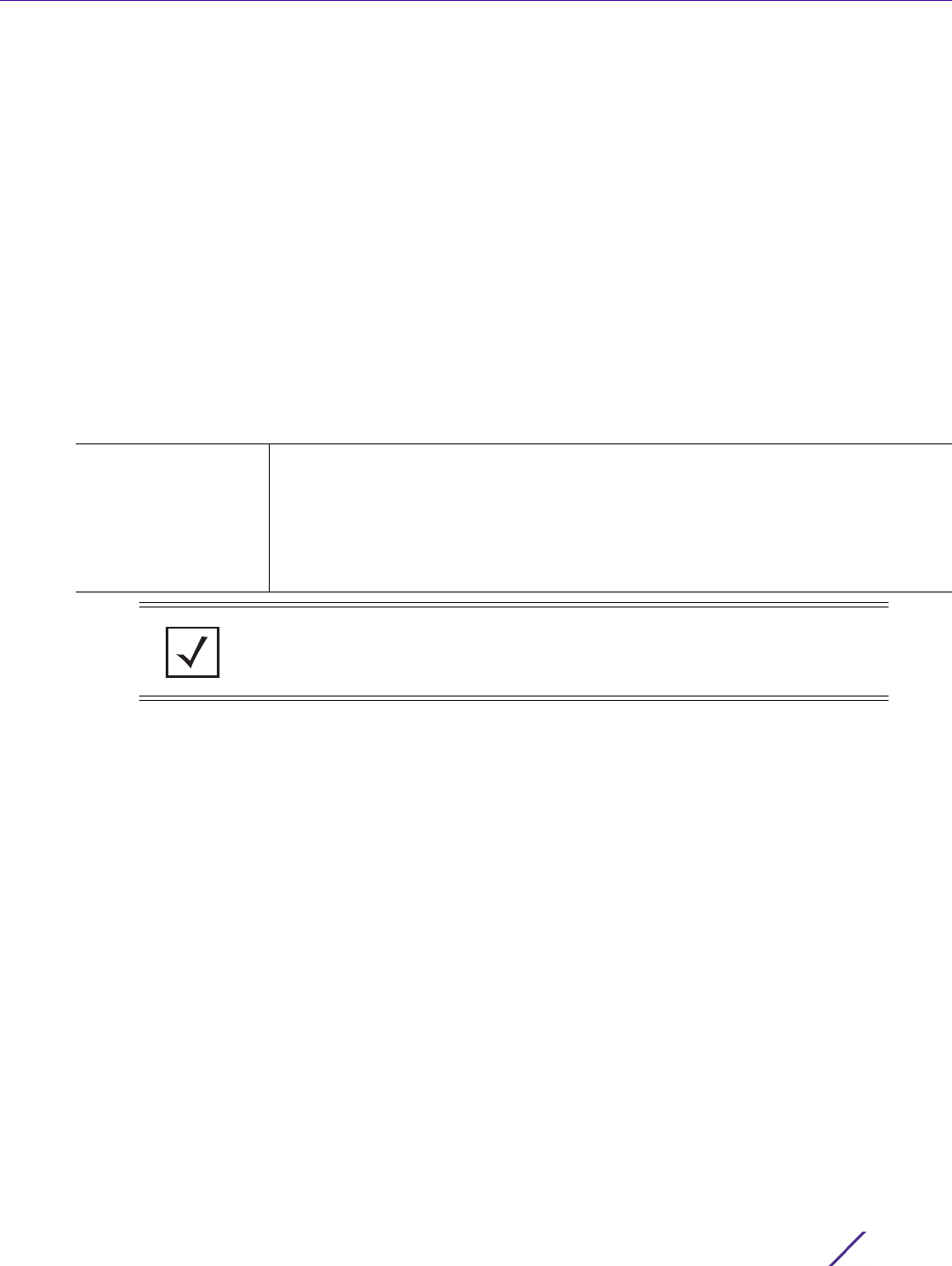
PROFILES
Access Point, Wireless Controller and Service Platform CLI Reference Guide 7 - 131
7.1.17.5.16 security-association
crypto-map-ipsec-manual-instance
Defines the lifetime (in kilobytes and/or seconds) of IPSec SAs created by this crypto map
Supported in the following platforms:
• Access Points — AP6521, AP6522, AP6532, AP6562, AP7161, AP7502, AP7522, AP7532, AP7562,
AP7602, AP7612, AP7622, AP7632, AP7662, AP81XX, AP8232, AP8432, AP8533
• Wireless Controllers — RFS4000, RFS6000
• Service Platforms — NX5500, NX7500, NX7510, NX7520, NX7530, NX9500, NX9510, NX9600,
VX9000
Syntax
security-association lifetime [kilobytes <500-2147483646>|seconds <120-86400>]
Parameters
• security-association lifetime [kilobytes <500-2147483646>|seconds <120-86400>]
Example
rfs6000-37FABE(config-profile-default-rfs6000-cryptomap-map2#2)#security-
association lifetime seconds 123
rfs6000-37FABE(config-profile-default-rfs6000-cryptomap-map2#2)#show context
Command not applicable to this crypto map
rfs6000-37FABE(config-profile-default-rfs6000-cryptomap-map2#2)#
lifetime
[kilobytes
<500-2147483646>|
seconds
<120-86400>]
Values can be entered in both kilobytes and seconds. Which ever limit is reached
first, ends the security association.
• kilobytes <500-2147483646> – Defines volume based key duration. Specify a value
from 500 - 2147483646 bytes.
• seconds <120-86400> – Defines time based key duration. Specify the time frame
from 120 - 86400 seconds.
NOTE: This command is not applicable to the ipsec-manual crypto map.

PROFILES
Access Point, Wireless Controller and Service Platform CLI Reference Guide 7 - 132
7.1.17.5.17 s essi o n -key
crypto-map-ipsec-manual-instance
Defines encryption and authentication keys for this crypto map
Supported in the following platforms:
• Access Points — AP6521, AP6522, AP6532, AP6562, AP7161, AP7502, AP7522, AP7532, AP7562,
AP7602, AP7612, AP7622, AP7632, AP7662, AP81XX, AP8232, AP8432, AP8533
• Wireless Controllers — RFS4000, RFS6000
• Service Platforms — NX5500, NX7500, NX7510, NX7520, NX7530, NX9500, NX9510, NX9600,
VX9000
Syntax
session-key [inbound|outbound] [ah|esp] <256-4294967295>
session-key [inbound|outbound] ah <256-4294967295> [0|2|authenticator [md5|sha]]
<WORD>
session-key [inbound|outbound] esp <256-4294967295> [0|2|cipher [3des|aes|aes-192|
aes-256|des|esp-null]] <WORD> authenticator [md5|sha] <WORD>
Parameters
• session-key [inbound|outbound] ah <256-4294967295> [0|2|authenticator [md5|sha]]
<WORD>
• session-key [inbound|outbound] esp <256-4294967295> [0|2|cipher [3des|aes|aes-
192|aes-256|des|esp-null]] <WORD> authenticator [md5|sha] <WORD>
session-key
[inbound|outbound]
Defines the manual inbound and outbound security association key parameters
ah <256-
4294967295>
Configures authentication header (AH) as the security protocol for the security
session
• <256-4294967295> – Sets the SPI for the security association from 256 - 4294967295
The SPI (in combination with the destination IP address and security protocol)
identifies the security association.
[0|2|authenticator
[md5|sha] <WORD>]
Specifies the key type
•0 – Sets a clear text key
•2 – Sets an encrypted key
• authenticator – Sets AH authenticator details
• md5 <WORD> – AH with MD5 authentication
• sha <WORD> – AH with SHA authentication
• <WORD> – Sets security association key value. The following key lengths (in hex
characters) are required (w/o leading 0x).AH-MD5: 32, AH-SHA: 40
session-key
[inbound|outbound]
Defines the manual inbound and outbound security association key parameters
esp <256-
4294967295>
Configures Encapsulating Security Payloads (ESP) as the security protocol for the
security session. This is the default setting.
• <256-4294967295> – Sets the SPI for the security association from 256 - 4294967295
The SPI (in combination with the destination IP address and security protocol)
identifies the security association.

PROFILES
Access Point, Wireless Controller and Service Platform CLI Reference Guide 7 - 133
Example
rfs6000-37FABE(config-profile-default-rfs6000-cryptomap-map1#1)#session-key
inbound esp 273 cipher esp-null authenticator sha 58768979
rfs6000-37FABE(config-profile-default-rfs6000-cryptomap-map1#1)#show context
crypto map map1 1 ipsec-manual
peer 172.16.10.2
mode transport
session-key inbound esp 273 0 cipher esp-null authenticator sha 58768979
rfs6000-37FABE(config-profile-default-rfs6000-cryptomap-map1#1)#
[0|2|cipher
[3des|aes|aes-192|
aes-256|des|
esp-null]]
•0 – Sets a clear text key
•2 – Sets an encrypted key
• cipher – Sets encryption/decryption key details
• 3des – ESP with 3DES encryption
• aes – ESP with AES encryption
• aes-192 – ESP with AES-192 encryption
• aes-256 – ESP with AES-256 encryption
• des – ESP with DES encryption
• esp-null – ESP with no encryption
• authenticator – Specify ESP authenticator details
• md5 <WORD> – ESP with MD5 authentication
•sha <WORD> – ESP with SHA authentication
• <WORD> – Sets security association key value. The following key lengths
(in hex characters) are required (w/o leading 0x).AH-MD5: 32, AH-SHA:
40

PROFILES
Access Point, Wireless Controller and Service Platform CLI Reference Guide 7 - 134
7.1.17.5.18 u se
crypto-map-ipsec-manual-instance
Associates an existing IP access list with this crypto map. The ACL protects the VPN traffic.
Supported in the following platforms:
• Access Points — AP6521, AP6522, AP6532, AP6562, AP7161, AP7502, AP7522, AP7532, AP7562,
AP7602, AP7612, AP7622, AP7632, AP7662, AP81XX, AP8232, AP8432, AP8533
• Wireless Controllers — RFS4000, RFS6000
• Service Platforms — NX5500, NX7500, NX7510, NX7520, NX7530, NX9500, NX9510, NX9600,
VX9000
Syntax
use ip-access-list <IP-ACCESS-LIST-NAME>
Parameters
• use ip-access-list <IP-ACCESS-LIST-NAME>
Example
rfs6000-37FABE(config-profile-default-rfs6000-cryptomap-map1#1)#use ip-access-
list test
rfs6000-37FABE(config-profile-default-rfs6000-cryptomap-map1#1)#show context
crypto map map1 1 ipsec-manual
use ip-access-list test
peer 172.16.10.12
mode transport
session-key inbound esp 273 0 cipher esp-null authenticator sha 5876897
rfs6000-37FABE(config-profile-default-rfs6000-cryptomap-map1#1)#
ip-access-list
<IP-ACCESS-LIST-
NAME>
Specify the IP access list name.

PROFILES
Access Point, Wireless Controller and Service Platform CLI Reference Guide 7 - 135
7.1.17.5.19 n o
crypto-map-ipsec-manual-instance
Removes or resets this crypto map’s settings
Supported in the following platforms:
• Access Points — AP6521, AP6522, AP6532, AP6562, AP7161, AP7502, AP7522, AP7532, AP7562,
AP7602, AP7612, AP7622, AP7632, AP7662, AP81XX, AP8232, AP8432, AP8533
• Wireless Controllers — RFS4000, RFS6000
• Service Platforms — NX5500, NX7500, NX7510, NX7520, NX7530, NX9500, NX9510, NX9600,
VX9000
Syntax
no [local-endpoint-ip|mode|peer|security-association|session-key|use]
Parameters
• no <PARAMETERS>
Example
rfs6000-37FABE(config-profile-default-rfs6000-cryptomap-map1#1)#show context
crypto map map1 1 ipsec-manual
use ip-access-list test
peer 172.16.10.12
mode transport
session-key inbound esp 273 0 cipher esp-null authenticator sha 5876897
rfs6000-37FABE(config-profile-default-rfs6000-cryptomap-map1#1)#
rfs6000-37FABE(config-profile-default-rfs6000-cryptomap-map1#1)#no use ip-access-
list
rfs6000-37FABE(config-profile-default-rfs6000-cryptomap-map1#1)#no peer
rfs6000-37FABE(config-profile-default-rfs6000-cryptomap-map1#1)#no mode
rfs6000-37FABE(config-profile-default-rfs6000-cryptomap-map1#1)#show context
crypto map map1 1 ipsec-manual
session-key inbound esp 273 0 cipher esp-null authenticator sha 58768979
rfs6000-37FABE(config-profile-default-rfs6000-cryptomap-map1#1)#
no <PARAMETERS> Removes or resets this crypto map settings based on the parameters passed
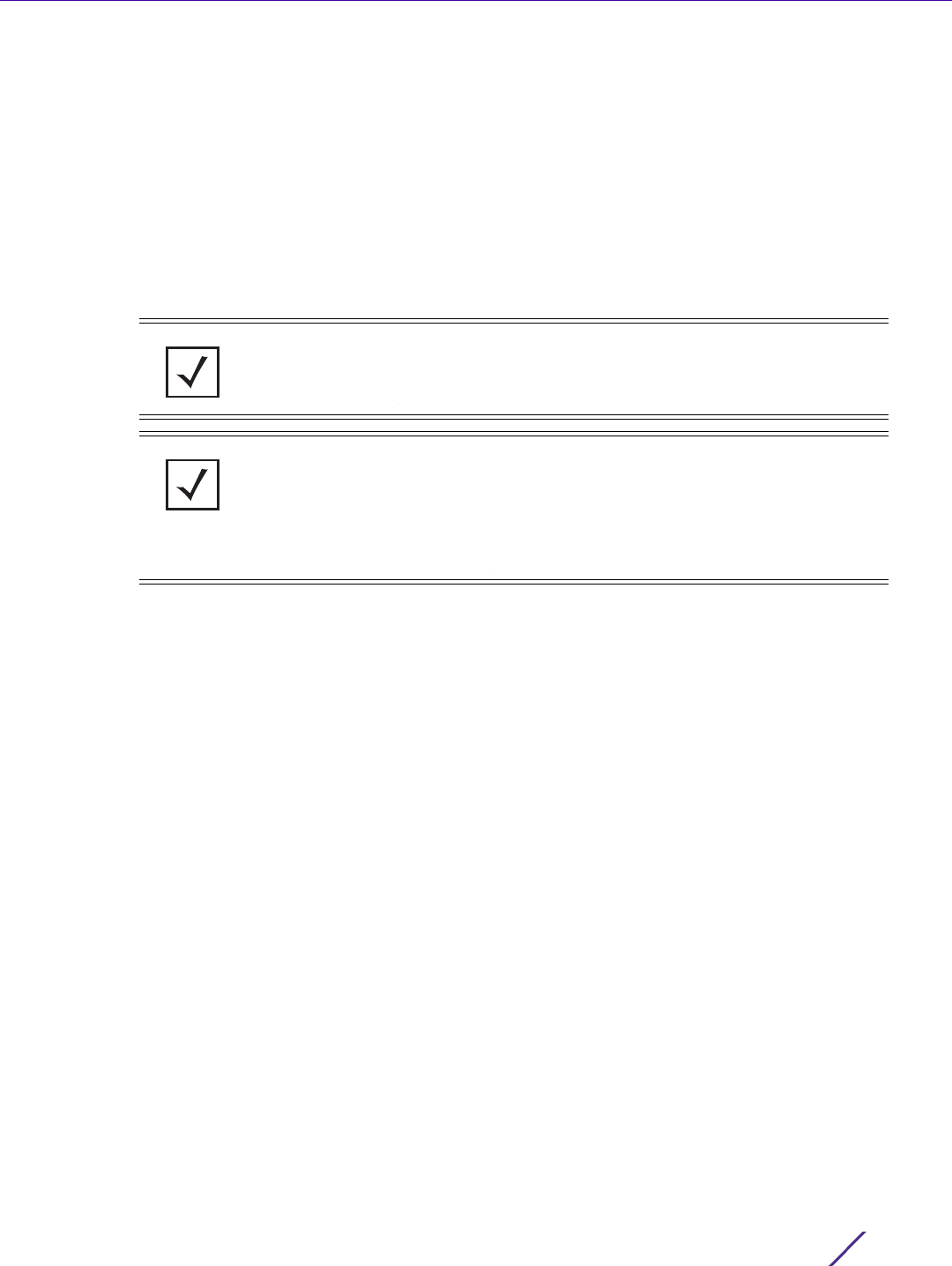
PROFILES
Access Point, Wireless Controller and Service Platform CLI Reference Guide 7 - 136
7.1.17.6 crypto-remote-vpn-client commands
crypto
This section documents the IKEV2 remote VPN client configuration settings. Use this command to define
the server resources used to secure (authenticate) a remote VPN connection with a target peer.
Use the profile-config instance to configure remote VPN client settings. To navigate to the remote-vpn-
client configuration instance, use the following commands:
<DEVICE>(config)#profile <DEVICE-TYPE> <PROFILE-NAME>
<DEVICE>(config-profile-<PROFILE-NAME>)#crypto remote-vpn-client
<DEVICE>(config-profile-<PROFILE-NAME>-crypto-ikev2-remote-vpn-client)#
rfs4000-229D58(config)#profile rfs4000 testRFS4000
rfs4000-229D58(config-profile-testRFS4000)#
rfs4000-229D58(config-profile-testRFS4000)#crypto remote-vpn-client
rfs4000-229D58(config-profile-testRFS4000-crypto-ikev2-remote-vpn-client)#?
Crypto IKEV2 Remote Vpn Client Config commands:
dhcp-peer Configure parameters for peers received via DHCP option
no Negate a command or set its defaults
peer Add a remote peer
shutdown Disable remote vpn client
transform-set Specify IPSec transform to use
clrscr Clears the display screen
commit Commit all changes made in this session
do Run commands from Exec mode
end End current mode and change to EXEC mode
exit End current mode and down to previous mode
help Description of the interactive help system
revert Revert changes
service Service Commands
show Show running system information
write Write running configuration to memory or terminal
rfs4000-229D58(config-profile-testRFS4000-crypto-ikev2-remote-vpn-client)#
NOTE: To configure remote VPN client settings on a device, on the device’s
configuration mode, use the crypto > remote-vpn-client command.
For example: rfs4000-229D58(config-device-00-23-68-22-9D-58)#crypto
remote-vpn-client
NOTE: The following configuration enables a access point to adopt to a
controller over the remote VPN link:
On a profile: rfs4000-229D58(config-profile-testRFS4000)#controller host
<HOST-IP> remote-vpn-client
On a device: rfs4000-229D58(config-00-23-68-22-9D-58)#controller host
<HOST-IP> remote-vpn-client

PROFILES
Access Point, Wireless Controller and Service Platform CLI Reference Guide 7 - 137
The following table summarizes crypto remote VPN client configuration mode commands:
Command Description Reference
dhcp-peer Configures DHCP peer’s local ID and authentication settings page 7-138
peer Adds a remote IKEv2 peer page 7-139
shutdown Disables the remote VPN client page 7-140
transform-set Associates an existing IPSec transform set with this remote VPN client page 7-141
no Removes the remote VPN client settings page 7-142

PROFILES
Access Point, Wireless Controller and Service Platform CLI Reference Guide 7 - 138
7.1.17.6.1 d h c p- p ee r
crypto-remote-vpn-client commands
Configures DHCP peer’s local ID and authentication settings
Supported in the following platforms:
• Access Points — AP6521, AP6522, AP6532, AP6562, AP7161, AP7502, AP7522, AP7532, AP7562,
AP7602, AP7612, AP7622, AP7632, AP7662, AP81XX, AP8232, AP8432, AP8533
• Wireless Controllers — RFS4000, RFS6000
• Service Platforms — NX5500, NX7500, NX7510, NX7520, NX7530, NX9500, NX9510, NX9600,
VX9000
Syntax
dhcp-peer [authentication|localid]
dhcp-peer authentication [psk [0 <WORD>|2 <WORD>|<WORD>]|rsa]
dhcp-peer localid [autogen-uniqueid <WORD>|string <WORD>]
Parameters
• dhcp-peer authentication [psk [0 <WORD>|2 <WORD>|<WORD>]|rsa]
• dhcp-peer localid [autogen-uniqueid <WORD>|string <WORD>]
Example
rfs4000-229D58(config-profile-testRFS4000-crypto-ikev2-remote-vpn-client)#dhcp-
peer authentication psk 0 @123testing
rfs4000-229D58(config-profile-testRFS4000-crypto-ikev2-remote-vpn-client)#show
context
crypto remote-vpn-client
dhcp-peer authentication psk 0 @123testing
rfs4000-229D58(config-profile-testRFS4000-crypto-ikev2-remote-vpn-client)#
dhcp-peer
authentication psk
[0 <WORD>|
2 <WORD>|
<WORD>]
Configures the DHCP peer’s authentication type as PSK
• 0 <WORD> – Configures a clear text authentication key
• 2 <WORD> – Configures an encrypted authentication key
• <WORD> – Provide a 8 - 21 character shared key password for DHCP peer
authentication
dhcp-peer
authentication rsa
Configures the DHCP peer’s authentication type as RSA. This is the default setting.
dhcp-peer localid
[autogen-uniqueid
<WORD>|
string <WORD>]
Configures the DHCP peer's localid using one of the following options:
• autogen-uniqueid - Generates a localid using the device's unique identity. The system
prefixes the device's unique identity to the string provided here. The device’s unique
identity should be existing and configured. For more information on configuring a
device’s unique identity, see autogen-uniqueid.
• <WORD> – Provide the string.
• string - Uses the value provided here as the DHCP peer’s localid.
• <WORD> - Provide the string.

PROFILES
Access Point, Wireless Controller and Service Platform CLI Reference Guide 7 - 139
7.1.17.6.2 pee r
crypto-remote-vpn-client commands
Configures IKEv2 peers and assigns them priorities for utilization with remote VPN client connections. A
maximum of three (3) peers can be added to support redundancy.
IKEv2 uses an initial handshake in which VPN peers negotiate cryptographic algorithms, mutually
authenticate, and establish a session key, creating an IKE-SA. Additionally, a first IPSec SA is established
during the initial SA creation. All IKEv2 messages are request/response pairs. It is the responsibility of the
side sending the request to retransmit if it does not receive a timely response.
Supported in the following platforms:
• Access Points — AP6521, AP6522, AP6532, AP6562, AP7161, AP7502, AP7522, AP7532, AP7562,
AP7602, AP7612, AP7622, AP7632, AP7662, AP81XX, AP8232, AP8432, AP8533
• Wireless Controllers — RFS4000, RFS6000
• Service Platforms — NX5500, NX7500, NX7510, NX7520, NX7530, NX9500, NX9510, NX9600,
VX9000
Syntax
peer <1-3> ikev2 <IKEV2-PEER-NAME>
Parameters
• peer <1-3> ikev2 <IKEV2-PEER-NAME>
Example
rfs4000-229D58(config-profile-testRFS4000-crypto-ikev2-remote-vpn-client)#peer
1 ikev2 ikev2Peer1
rfs4000-229D58(config-profile-testRFS4000-crypto-ikev2-remote-vpn-client)#peer 2
ikev2 ikev2Peer2
rfs4000-229D58(config-profile-testRFS4000-crypto-ikev2-remote-vpn-client)#show
context
crypto remote-vpn-client
peer 1 ikev2 ikev2Peer1
peer 2 ikev2 ikev2Peer2
rfs4000-229D58(config-profile-testRFS4000-crypto-ikev2-remote-vpn-client)#
peer <1-3> Adds a IKEv2 peer. You can add maximum of three (3) peers to achieve redundancy.
• <1-3> – Specify a priority level for the peer from 1 - 3 (1 = primary, 2 = secondary, and
3 = redundant).
ikev2
<IKEV2-PEER-
NAME>
Specify the IKEv2 peer’s name.
Note: The peer should be existing and configured. To configure an IKEv2 peer use the
crypto > ikev2 > peer > <IKEv2-PEER-NAME> command.

PROFILES
Access Point, Wireless Controller and Service Platform CLI Reference Guide 7 - 140
7.1.17.6.3 shu tdow n
crypto-remote-vpn-client commands
Disables remote-vpn-client on this profile or device. Remote VPN client feature is enabled by default.
To enable a disabled remote VPN client execute the no > shutdown command.
Supported in the following platforms:
• Access Points — AP6521, AP6522, AP6532, AP6562, AP7161, AP7502, AP7522, AP7532, AP7562,
AP7602, AP7612, AP7622, AP7632, AP7662, AP81XX, AP8232, AP8432, AP8533
• Wireless Controllers — RFS4000, RFS6000
• Service Platforms — NX5500, NX7500, NX7510, NX7520, NX7530, NX9500, NX9510, NX9600,
VX9000
Syntax
shutdown
Parameters
None
Example
rfs4000-229D58(config-profile-testRFS4000-crypto-ikev2-remote-vpn-client)#
shutdown
rfs4000-229D58(config-profile-testRFS4000-crypto-ikev2-remote-vpn-client)#

PROFILES
Access Point, Wireless Controller and Service Platform CLI Reference Guide 7 - 141
7.1.17.6.4 transform-set
crypto-remote-vpn-client commands
Specifies the IPSec Transform set to use with this remote VPN client. A transform set is a combination of
security protocols, algorithms, and other settings applied to IPSec protected client traffic.
Supported in the following platforms:
• Access Points — AP6521, AP6522, AP6532, AP6562, AP7161, AP7502, AP7522, AP7532, AP7562,
AP7602, AP7612, AP7622, AP7632, AP7662, AP81XX, AP8232, AP8432, AP8533
• Wireless Controllers — RFS4000, RFS6000
• Service Platforms — NX5500, NX7500, NX7510, NX7520, NX7530, NX9500, NX9510, NX9600,
VX9000
Syntax
transform-set <IPSEC-XFORM-TAG> {<IPSEC-XFORM-TAG>}
Parameters
• transform-set <IPSEC-XFORM-TAG> {<IPSEC-XFORM-TAG>}
Example
rfs4000-229D58(config-profile-testRFS4000-crypto-ikev2-remote-vpn-
client)#transform-set TransformSet1
rfs4000-229D58(config-profile-testRFS4000-crypto-ikev2-remote-vpn-client)#show
context
crypto remote-vpn-client
peer 1 ikev2 ikev2Peer1
transform-set TransformSet1
rfs4000-229D58(config-profile-testRFS4000-crypto-ikev2-remote-vpn-client)#
transform-set
<IPSEC-XFORM-
TAG>
<IPSEC-XFORM-
TAG>
Associates an IPSec Transform (should be existing and configured) set with this
remote VPN client. You can optionally associate more than one transform set with this
remote VPN client configuration. List the transform set tags separated by a space.
Note: To configure a transform-set, use the crypto > ipsec > transform-set command in
the profile or device configuration mode.

PROFILES
Access Point, Wireless Controller and Service Platform CLI Reference Guide 7 - 142
7.1.17.6.5 no
crypto-remote-vpn-client commands
Removes the remote VPN client settings
Supported in the following platforms:
• Access Points — AP6521, AP6522, AP6532, AP6562, AP7161, AP7502, AP7522, AP7532, AP7562,
AP7602, AP7612, AP7622, AP7632, AP7662, AP81XX, AP8232, AP8432, AP8533
• Wireless Controllers — RFS4000, RFS6000
• Service Platforms — NX5500, NX7500, NX7510, NX7520, NX7530, NX9500, NX9510, NX9600,
VX9000
Syntax
no [dhcp-peer|peer <1-3>|shutdown|transform-set]
no dhcp-peer [authentication|localid]
no peer <1-3>
no shutdown
no transform-set
Parameters
• no <PARAMETERS>
Example
rfs4000-229D58(config-profile-testRFS4000-crypto-ikev2-remote-vpn-client)#show
context
crypto remote-vpn-client
peer 1 ikev2 peer5
rfs4000-229D58(config-profile-testRFS4000-crypto-ikev2-remote-vpn-client)#
rfs4000-229D58(config-profile-testRFS4000-crypto-ikev2-remote-vpn-client)#no peer
1
rfs4000-229D58(config-profile-testRFS4000-crypto-ikev2-remote-vpn-client)#show
context
crypto remote-vpn-client
rfs4000-229D58(config-profile-testRFS4000-crypto-ikev2-remote-vpn-client)#
no <PARAMETERS> Removes or resets this remote VPN client settings based on the parameters passed

PROFILES
Access Point, Wireless Controller and Service Platform CLI Reference Guide 7 - 143
7.1.18 database
Profile Config Commands
Backs up captive-portal and/or NSight database to a specified location and file. When applied to devices,
this profile will enable the back up of the specified database. This command also enables you to configures
a low-disk-space threshold value.
These parameters can also be configured in the device configuration context of an NX95XX series service
platform.
Supported in the following platforms:
• Service Platforms — NX9500, NX9510, NX9600, VX9000
Syntax
database [backup|low-disk-space-threshold]
database backup database [captive-portal|nsight] <URL>
database low-disk-space-threshold <10-50>
Parameters
• database backup database [captive-portal|nsight] <URL>
• database low-disk-space-threshold <10-50>
Example
nx9500-6C8809(config-profile-testNX9500)#database backup database nsight ftp://
anonymous:anonymous@192.168.13.10/backups/nsight/nsight.tar.gz
Related Commands
database backup
database
[captive-portal|
nsight]
Backs up captive portal and/or NSight database to a specified location and file. Select
the database to backup.
• database – Selects the database to backup
• captive-portal – Backs up captive portal database
• nsight – Backs up NSight database
After specifying the database type, configure the destination location and file name.
<URL> Configures the destination location. The database is backed up at the specified
location. Specify the location URL in one of the following formats:
ftp://<user>:<passwd>@<hostname|IP>[:port]/path/file.tar.gz
sftp://<user>:<passwd>@<hostname|IP>[:port]/path/file.tar.gz
tftp://<hostname|IP>[:port]/path
database low-disk-
space-threshold <10-
50>
Configures the low disk space threshold for syslog warning. Once the threshold value
configured here is reached a syslog warning is sent.
• <10-50> – Specify the threshold from 10 - 50. The default is 30.
no Removes database backup configurations

PROFILES
Access Point, Wireless Controller and Service Platform CLI Reference Guide 7 - 144
7.1.19 device-onboard
Profile Config Commands
Configures the logo image file name and title displayed on the EGuest device-onboarding portal. The
EGuest UI can be accessed only by vendor-admin users.
Supported in the following platforms:
• Service Platforms — NX9500, NX9510, NX9600, VX9000
Syntax
device-onboard [logo|title] <WORD>
Parameters
• device-onboard [logo|title] <WORD>
Example
Split-EG-Server(config-device-00-0C-29-09-3C-CC)#device-onboard logo
extremenetworks.png
Split-EG-Server(config-device-00-0C-29-09-3C-CC)#device-onboard title EXTREME
NETWORKS ONBOARDING UI
Split-EG-Server(config-device-00-0C-29-09-3C-CC)#show context include-factory |
include device-onboard
device-onboard title EXTREME NETWORKS ONBOARDING UI
device-onboard logo extremenetworks.png
Split-EG-Server(config-device-00-0C-29-09-3C-CC)#
Following example shows a Management Policy, vendor-admin user configuration:
EC-NOC(config-management-policy-EGuest)#show context include-factory | include
user
user onboard-user password 1
1d5e9d60425bde727261b66b5e7eb0236058e7aae45225961ce7b872ea238240 role vendor-
admin group Samsung,Philips,Nest1,Orbit1
EC-NOC(config-management-policy-EGuest)#
Related Commands
NOTE: Vendor admin users are configured in the Management policy
context. For more information, see user.
device-onboard
[logo|title] <WORD>
Configures the logo and page title displayed on the device-onboarding portal
• logo – Specify the logo image file name. Note, logo image dimensions must not exceed
109 pixel and 52 pixel in width and height respectively.
• title – Specify the UI portal title. Note, the title should not exceed 32 characters in length.
The following keyword is common to both of the above parameters:
• <WORD> – Specify the logo image file name/page title.
no Removes the device-onboarding UI portal’s logo image file name and title
configuration

PROFILES
Access Point, Wireless Controller and Service Platform CLI Reference Guide 7 - 145
7.1.20 device-upgrade
Profile Config Commands
Configures device firmware upgrade settings on this profile
Administrators can customize profiles with unique device configuration file and firmware upgrade support.
In a clustered environment, operations performed on one device are propagated to each member of the
cluster and then onwards to devices managed by each cluster member. The number of concurrent device
upgrades and their start times can be customized to ensure a sufficient number of devices remain in duty
while upgrades are administered to others.
Supported in the following platforms:
• Access Points — AP6521, AP6522, AP6532, AP6562, AP7161, AP7502, AP7522, AP7532, AP7562,
AP7602, AP7612, AP7622, AP7632, AP7662, AP81XX, AP8232, AP8432, AP8533
• Wireless Controllers — RFS4000, RFS6000
• Service Platforms — NX5500, NX7500, NX7510, NX7520, NX7530, NX9500, NX9510, NX9600,
VX9000
Syntax
device-upgrade [add-auto|auto|count|persist-images]
device-upgrade add-auto [(ap6521|ap6522|ap6532|ap6562|ap71xx|ap7502|ap7522|
ap7532|ap7562|ap7602|ap7612|ap7622|ap7632|ap7662|ap81xx|ap82xx|ap8432|ap8533|
rfs4000|rfs6000|nx5500|nx75xx|nx9000|nx9600)]
device-upgrade auto {(ap6521|ap6522|ap6532|ap6562|ap71xx|ap7502|ap7522|ap7532|
ap7562|ap7602|ap7612|ap7622|ap7632|ap7662|ap81xx|ap82xx|ap8432|ap8533|rfs4000|
rfs6000|nx5500|nx75xx|nx9000|nx9600)}
device-upgrade count <1-128>
device-upgrade persist-images
Parameters
• device-upgrade add-auto[(ap6521|ap6522|ap6532|ap6562|ap71xx|ap7502|ap7522|
ap7532|ap7562|ap7602|ap7612|ap7622|ap7632|ap7662|ap81xx|ap82xx|ap8432|ap8533|
rfs4000|rfs6000|nx5500|nx75xx|nx9000|nx9600)]
device-upgrade add-
auto
Configures a list of devices types for automatic firmware upgrade
This command specifies the types of devices that can be automatically upgraded (if
enabled). To enable automatic device firmware upgrade, use the ‘auto’ command.
When enabled, access points, wireless controllers, and service platforms, using this
profile, will automatically upgrade firmware on adopted devices that match the
specified device types.
[<DEVICE-TYPE>] Specifies the type of devices to be upgraded. Select the device type. The options
are: AP6521, AP6522, AP6532, AP6562, AP7161, AP7502, AP7522, AP7532, AP7562,
AP7602, AP7612, AP7622, AP7632, AP7662, AP81XX, AP8232, AP8432, AP8533,
RFS4000, RFS6000, NX5500, NX75XX, NX95XX, NX9600, VX9000.
Note: Multiple device types can be added to the add-auto list.

PROFILES
Access Point, Wireless Controller and Service Platform CLI Reference Guide 7 - 146
• device-upgrade auto {(ap6521|ap6522|ap6532|ap6562|ap71xx|ap7502|ap7522|ap7532|
ap7562|ap7602|ap7612|ap7622|ap7632|ap7662|ap81xx|ap82xx|ap8432|ap8533|rfs4000|
rfs6000|nx5500|nx75xx|nx9000|nx9600)}
• device-upgrade count <1-128>
• device-upgrade persist-images
Example
rfs4000-229D58(config-profile-default-rfs4000)#device-upgrade auto ap71xx
rfs4000-229D58config-profile-default-rfs4000)#show context
profile rfs4000 default-rfs4000
autoinstall configuration
autoinstall firmware
device-upgrade auto ap71xx
device-upgrade persist-ap-image
crypto ikev1 policy ikev1-default
qos trust 802.1p
--More--
rfs4000-229D58(config-profile-default-rfs4000)#
Related Commands
device-upgrade auto Enables automatic firmware upgrade on specified device types. When used along
with the add-auto command, the auto command allows access points, wireless
controllers, and service platforms to automatically upgrade firmware on adopted
devices matching the specified device types.
<DEVICE-TYPE> Optional. Specifies the type of device to be lined up for automatic firmware upgrade.
The options are: AP6521, AP6522, AP6532, AP6562, AP7161, AP7502, AP7522,
AP7532, AP7562, AP7602, AP7612, AP7622, AP7632, AP7662, AP81XX, AP8232,
AP8432, AP8533, RFS4000, RFS6000, NX5500, NX75XX, NX95XX, NX9600,
VX9000.
Note: Multiple device types can be added to the auto list.
device-upgrade count
<1-128>
Configures the maximum number of concurrent upgrades possible
• <1-128> – specify a value from 1 - 128. The default is 10.
device-upgrade Configures parameters for automatic firmware upgrade of adopted devices. Use this
command to select the device types and the maximum number of concurrent
upgrades.
persist-images Enables RF Domain manager to retain AP firmware image after upgrade, subject to
availability of space. This option is enabled by default.
This option is enabled for all controllers and service platforms RF Domain managers
with the flash memory capacity to store firmware images for the selected access
point models they provision. This feature is disabled for access point RF Domain
managers that do not typically have the flash memory capacity needed.
no Removes device firmware upgrade settings on this profile
device-upgrade (show
commands)
Displays device upgrade details

PROFILES
Access Point, Wireless Controller and Service Platform CLI Reference Guide 7 - 147
7.1.21 diag
Profile Config Commands
Enables looped packet logging. When enabled, devices, using this profile, start logging looped packets to a
separate queue. This option is disabled by default.
Looped packet logging can also be enabled in the device configuration context.
Supported in the following platforms:
• Access Points — AP6521, AP6522, AP6532, AP6562, AP7161, AP7502, AP7522, AP7532, AP7562,
AP7602, AP7612, AP7622, AP7632, AP7662, AP81XX, AP8232, AP8432, AP8533
• Wireless Controllers — RFS4000, RFS6000
• Service Platforms — NX5500, NX7500, NX7510, NX7520, NX7530, NX9500, NX9510, NX9600,
VX9000
Syntax
diag pkts
Parameters
• diag pkts
Example
nx9500-6C8809(config-profile-default-nx75xx)#diag pkts
nx9500-6C8809(config-profile-default-nx75xx)#show context include-factory |
include diag
diag pkts
nx9500-6C8809(config-profile-default-nx75xx)#
Related Commands
NOTE: To view logged looped packets, execute the service > show > diag > pkts
command. For more information, see service.
diag pkts Enables looped packet logging
no Disables looped packet logging

PROFILES
Access Point, Wireless Controller and Service Platform CLI Reference Guide 7 - 148
7.1.22 dot1x
Profile Config Commands
Configures 802.1x standard authentication controls
Dot1x (or 802.1x) is an IEEE standard for network authentication. It enables media-level (layer 2) access
control, providing the capability to permit or deny connectivity based on user or device identity. Dot1x
allows port-based access using authentication. An dot1x enabled port can be dynamically enabled or
disabled depending on user identity or device connection.
Devices supporting dot1x allow the automatic provision and connection to the wireless network without
launching a Web browser at login. When within range of a dot1x network, a device automatically connects
and authenticates without needing to manually login.
Before authentication, the endpoint is unknown, and traffic is blocked. Upon authentication, the endpoint is
known and traffic is allowed. The controller or service platform uses source MAC filtering to ensure only the
authenticated endpoint is allowed to send traffic.
Dot1x authentication capabilities is supported on the following platforms:
Supported in the following platforms:
• Access Points — AP6511, AP6521, AP6522, AP6562, AP7161, AP7502, AP7602, AP7612, AP7622,
AP7632, AP7662, AP81XX, AP8232, AP8432
• Wireless Controllers — RFS4000, RFS6000, NX5500, NX7500
Dot1x supplicant capabilities is supported on the following platforms:
Supported in the following platforms:
• Access Points — AP6521, AP6522, AP6532, AP6562, AP7161, AP7502, AP7522, AP7532, AP7562,
AP7602, AP7612, AP7622, AP7632, AP7662, AP81XX, AP8232, AP8432, AP8533
• Wireless Controllers — RFS4000, NX5500, NX7500
Syntax
dot1x [guest-vlan|holdtime|system-auth-control|use]
dot1x holdtime <0-600>
dot1x system-auth-control
dot1x guest-vlan supplicant
dot1x use aaa-policy <AAA-POLICY-NAME>
Parameters
• dot1x system-auth-control
• dot1X holdtime <0-600>
system-auth-control Enables system auth control. Enables dot1x authorization globally for the controller.
This feature is disabled by default.
holdtime <0-600> Configures a holdtime value. This is the interval after which an authentication
attempt is ignored or failed.
• <0-600> – Specify a value from 0 - 600 seconds. A value of ‘0’ indicates no
holdtime. The default is 600 seconds or 10 minutes.
Adding a hold time at startup allows time for the network to converge before
receiving or transmitting 802.1x authentication packets.

PROFILES
Access Point, Wireless Controller and Service Platform CLI Reference Guide 7 - 149
• dot1x guest-vlan supplicant
• dot1x use aaa-policy <AAA-POLICY-NAME>
Example
nx9500-6C8809(config-profile-test-nx5500)#dot1x use aaa-policy OnBoarding
nx9500-6C8809(config-profile-test-nx5500)#dot1x system-auth-control
nx9500-6C8809(config-profile-test-nx5500)#show context
profile nx5500 test-nx5500
no autoinstall configuration
no autoinstall firmware
crypto ikev1 policy ikev1-default
isakmp-proposal default encryption aes-256 group 2 hash sha
crypto ikev2 policy ikev2-default
isakmp-proposal default encryption aes-256 group 2 hash sha
crypto ipsec transform-set default esp-aes-256 esp-sha-hmac
crypto ikev1 remote-vpn
crypto ikev2 remote-vpn
crypto auto-ipsec-secure
crypto load-management
crypto remote-vpn-client
interface ge1
interface ge2
interface ge3
interface ge4
interface ge5
interface ge6
interface pppoe1
use firewall-policy default
service pm sys-restart
router ospf
router bgp
dot1x system-auth-control
dot1x use aaa-policy OnBoarding
nx9500-6C8809(config-profile-test-nx5500)#
Related Commands
guest-vlan Configures guest VLAN and supplicant behavior
This feature is disabled by default.
supplicant Allows 802.1x capable supplicant to enter guest VLAN. When enabled, this is the
VLAN that supplicant’s traffic is bridged on.
use aaa-policy <AAA-
POLICY-NAME>
Associates a specified 802.1x AAA policy (for MAC authentication) with this access
point profile
• <AAA-POLICY-NAME> – Specify the AAA policy name. Once specified, this AAA
policy is utilized for authenticating user requests.
no Disables or reverts settings to their default

PROFILES
Access Point, Wireless Controller and Service Platform CLI Reference Guide 7 - 150
7.1.23 dpi
Profile Config Commands
Enables Deep Packet Inspection (DPI) on this profile. DPI is an advanced packet analysis technique, which
analyzes packet and packet content headers to determine the nature of network traffic. When enabled, DPI
inspects packets of all flows to identify applications (such as, Netflix, Twitter, Facebook, etc.) and extract
metadata (such as, host name, server name, TCP-RTT, etc.) for further use by the WiNG firewall.
This command is also available in the device configuration mode.
Supported in the following platforms:
• Access Points — AP7522, AP7532, AP7602, AP7612, AP7622, AP7632, AP7662
• Service Platforms — NX5500, NX7500, NX7510, NX7520, NX7530, NX9500, NX9510, NX9600
Syntax
dpi {custom-app|logging|metadata}
dpi {custom-app <CUSTOM-APP-NAME>}
dpi {logging [level [<0-7>|alerts|critical|debugging|emergencies|errors|
informational|notifications|warnings]|on]}
dpi {metadata [http|ssl|tcp-rtt|voice-video]}
dpi {metadata [http|ssl|voice-video]}
dpi {metadata tcp-rtt {app-group <APPLICATION-GROUP-NAME>}}
Parameters
• dpi {custom-app <CUSTOM-APP-NAME>}
• dpi {logging [level [<0-7>|alerts|critical|debugging|emergencies|errors|
informational|notifications|warnings]|on]}
dpi Enables DPI on this profile/device context and configures DPI settings. When enabled,
all flow traffic is subjected to DPI for detection of applications, application categories,
custom applications, and metadata extraction.
custom-app
<CUSTOM-APP-
NAME>
Optional. Adds custom application to this profile
• <CUSTOM-APP-NAME> – Specify custom application name (should be existing and
configured)
If no custom application is specified, the system detects the PACE built-in
applications.
Note: For more information on application categories and application detection, see
application.
dpi Enables DPI on this profile/device context and configures DPI settings. When enabled,
all flow traffic is subjected to DPI for detection of applications, application categories,
custom applications, and metadata extraction.

PROFILES
Access Point, Wireless Controller and Service Platform CLI Reference Guide 7 - 151
• dpi {metadata [http|ssl|voice-video]}
• dpi {metadata tcp-rtt {app-group <APPLICATION-GROUP-NAME>}}
logging [level [<0-7>|
alerts|critical|
debugging|
emergencies|
errors|informational|
notifications|
warnings]|on]
Optional. Enables DPI logging and sets the logging level
• level – Configures the DPI logging level. Use one of the following options to specify the
logging level:
• <0-7> Logging severity level
• alerts Immediate action needed (1)
• critical Critical conditions (2)
• debugging Debugging messages (7)
• emergencies System is unusable (0)
• errors Conditions (3)
• nformational Informational messages (6)
• notifications Normal but significant conditions (5) - Default setting
• warnings Warning conditions (4)
Either specify the logging level index (from 0 - 7) or the description. For example, to
log all alerts either enter ‘1’ or ‘alerts’.
• on – Enables application detection event logging. DPI logging is disabled by de-
fault.
dpi Enables DPI on this profile/device context and configures DPI settings. When enabled,
all flow traffic is subjected to DPI for detection of applications, application categories,
custom applications, and metadata extraction.
metadata
[http|ssl|voice-video]
Optional. Enables metadata extraction from following flows:
• http – HTTP flows. This option is disabled by default.
• ssl – SSL flows. This option is disabled by default.
• voice-video – Voice and video classified flows. This option is disabled by default.
dpi Enables DPI on this profile/device context and configures DPI settings. When enabled,
all flow traffic is subjected to DPI for detection of applications, application categories,
custom applications, and metadata extraction.
metadata tcp-rtt
{app-group
<APPLICATION-
GROUP-NAME>}
Optional. Enables Transmission Control Protocol - Round Trip Time (TCP-RTT)
metadata collection for application groups. Before executing this command, ensure
that you have created at least one application group.
Enable this option in the profile/device contexts of the AP7522, AP7532, AP7562,
AP8432, AP8533 access point models, as only these APs support TCP-RTT metadata
collection.
• app-group – Optional. Specifies the customized application-group name containing
the applications for which TCP-RTT is to be collected
• <APPLICATION-GROUP-NAME> – Specify the app-group name (should be existing
and configured). If not specified, the system collects TCP-RTT metadata for all the
customized app-groups created. You can enable TCP-RTT metadata collection on
eight (8) application groups at a time.
For more information on creating customized application-groups, see application-
group.
The TCP-RTT metadata is viewable only on the NSight dashboard. Therefore, ensure
the NSight server and database is up and NSight analytics data collection is enabled.

PROFILES
Access Point, Wireless Controller and Service Platform CLI Reference Guide 7 - 152
Example
nx9500-6C8809(config-profile-testNX9500)#dpi logging on
nx9500-6C8809(config-profile-testNX9500)#dpi logging level 7
nx9500-6C8809(config-profile-testNX9500)#show context
profile nx9000 testNX9500
bridge vlan 10
ip igmp snooping
ip igmp snooping querier
ipv6 mld snooping
.........................................................
router bgp
dpi logging on
dpi logging level debugging
nx9500-6C8809(config-profile-testNX9500)#
nx9500-6C8809(config-device-B4-C7-99-6C-88-09)#dpi metadata tcp-rtt app-group
amazon
Related Commands
no Disables DPI (application assurance) on this profile

PROFILES
Access Point, Wireless Controller and Service Platform CLI Reference Guide 7 - 153
7.1.24 dscp-mapping
Profile Config Commands
Configures IP Differentiated Services Code Point (DSCP) to 802.1p priority mapping for untagged frames
Supported in the following platforms:
• Access Points — AP6521, AP6522, AP6532, AP6562, AP7161, AP7502, AP7522, AP7532, AP7562,
AP7602, AP7612, AP7622, AP7632, AP7662, AP81XX, AP8232, AP8432, AP8533
• Wireless Controllers — RFS4000, RFS6000
• Service Platforms — NX5500, NX7500, NX7510, NX7520, NX7530, NX9500, NX9510, NX9600,
VX9000
Syntax
dscp-mapping <WORD> priority <0-7>
Parameters
• dscp-mapping <word> priority <0-7>
Example
rfs7000-37FABE(config-profile-default-rfs7000)#dscp-mapping 20 priority 7
rfs7000-37FABE(config-profile-default-rfs7000)#show context
profile rfs7000 default-rfs7000
dscp-mapping 20 priority 7
no autoinstall configuration
no autoinstall firmware
crypto isakmp policy default
crypto ipsec transform-set default esp-aes-256 esp-sha-hmac
interface me1
interface ge1
ip dhcp trust
qos trust dscp
rfs7000-37FABE(config-profile-default-rfs7000)#
Related Commands
<WORD> Specifies the DSCP value of a received IP packet. This could be a single value or a
list. For example, 10-20, 25, 30-35.
priority <0-7> Specifies the 802.1p priority to use for a packet if untagged. The priority is set on a
scale of 0 - 7. The priority values are:
• 0 – Best effort
• 1 – Background
•2 – Spare
• 3 – Excellent effort
• 4 – Controlled load
•5 – Video
•6 – Voice
•7 – Network control
Note: The specified 802.1p priority value is added as a 3-bit IP precedence value in the
Type of Service (ToS) field of the IP header used to set the priority. Up to 64 entries are
permitted.
no Disables or reverts settings to their default
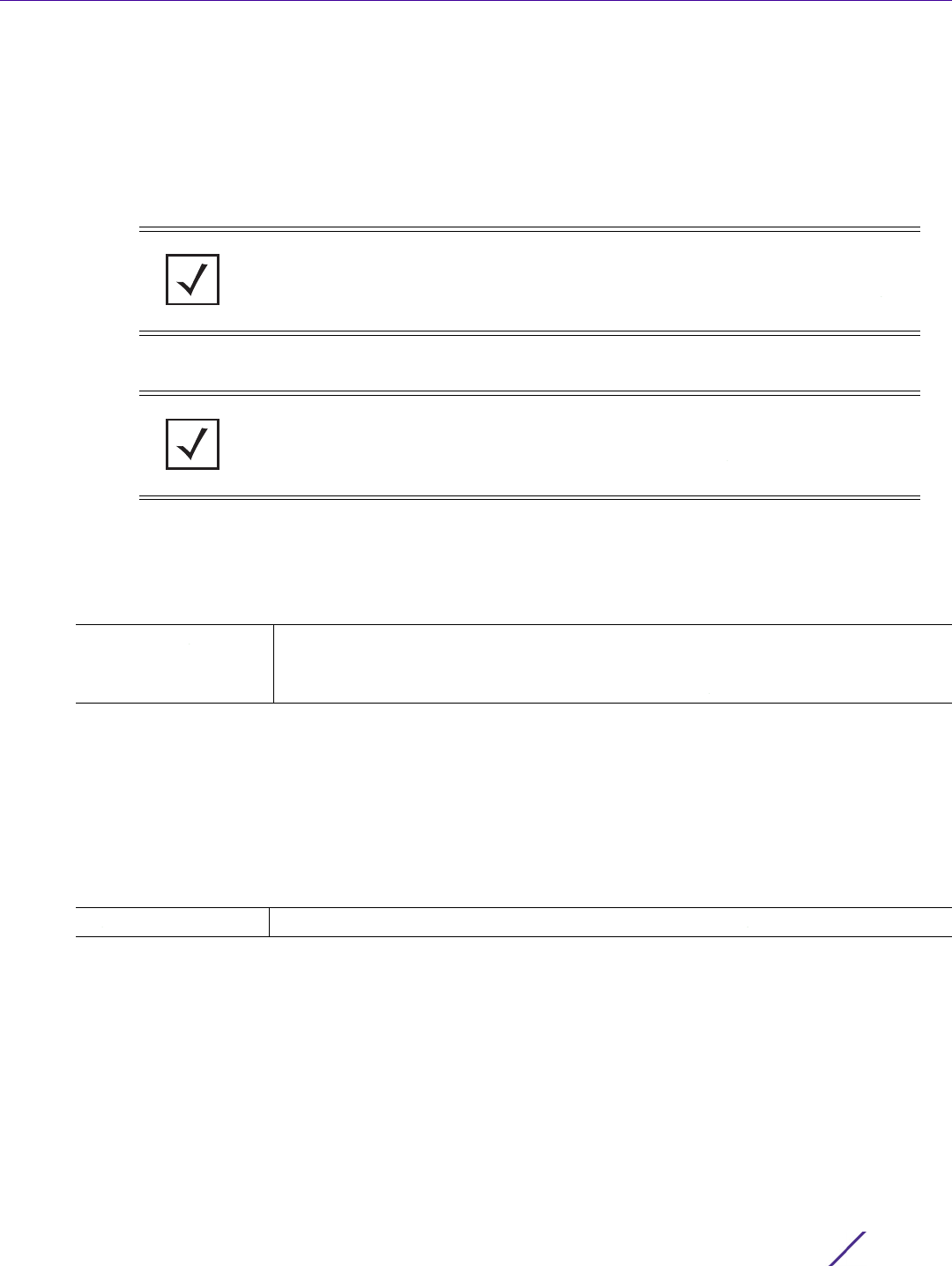
PROFILES
Access Point, Wireless Controller and Service Platform CLI Reference Guide 7 - 154
7.1.25 eguest-server (VX9000 only)
Profile Config Commands
Enables the ExtremeGuest (EGuest) server
The WiNG EGuest solution is an independently installable VM/Server that provides integrated guest
management and analytics. Use this command to enable the EGuest daemon on the EGuest server.
Supported in the following platforms:
• Service Platforms — VX9000
Syntax
eguest-server
Parameters
• eguest-server
Example
On the EGuest server, execute the command without the ‘host’ option to enable the EGuest daemon.
EG-Server(config-device-02-EE-1A-7E-AE-5B)#eguest-server
EG-Server(config-device-02-EE-1A-7E-AE-5B)#show context include-factory | include
eguest-server
eguest-server
EG-Server(config-device-02-EE-1A-7E-AE-5B)#
Related Commands
NOTE: EGuest being a licensed feature, ensure that the EGUEST-DEV license is
applied on the EGuest server’s self context. For more information, see license.
NOTE: For more information on configuring an EGuest captive-portal
deployment, see configuring ExtremeGuest captive-portal.
eguest-server Execute this command, without the ‘host’ option, on the EGuest server. When
executed, the EGuest daemon is enabled on the host.
EGuest server can be hosted only a VX9000 platform.
no Disables the EGuest server by stopping the EGuest daemon
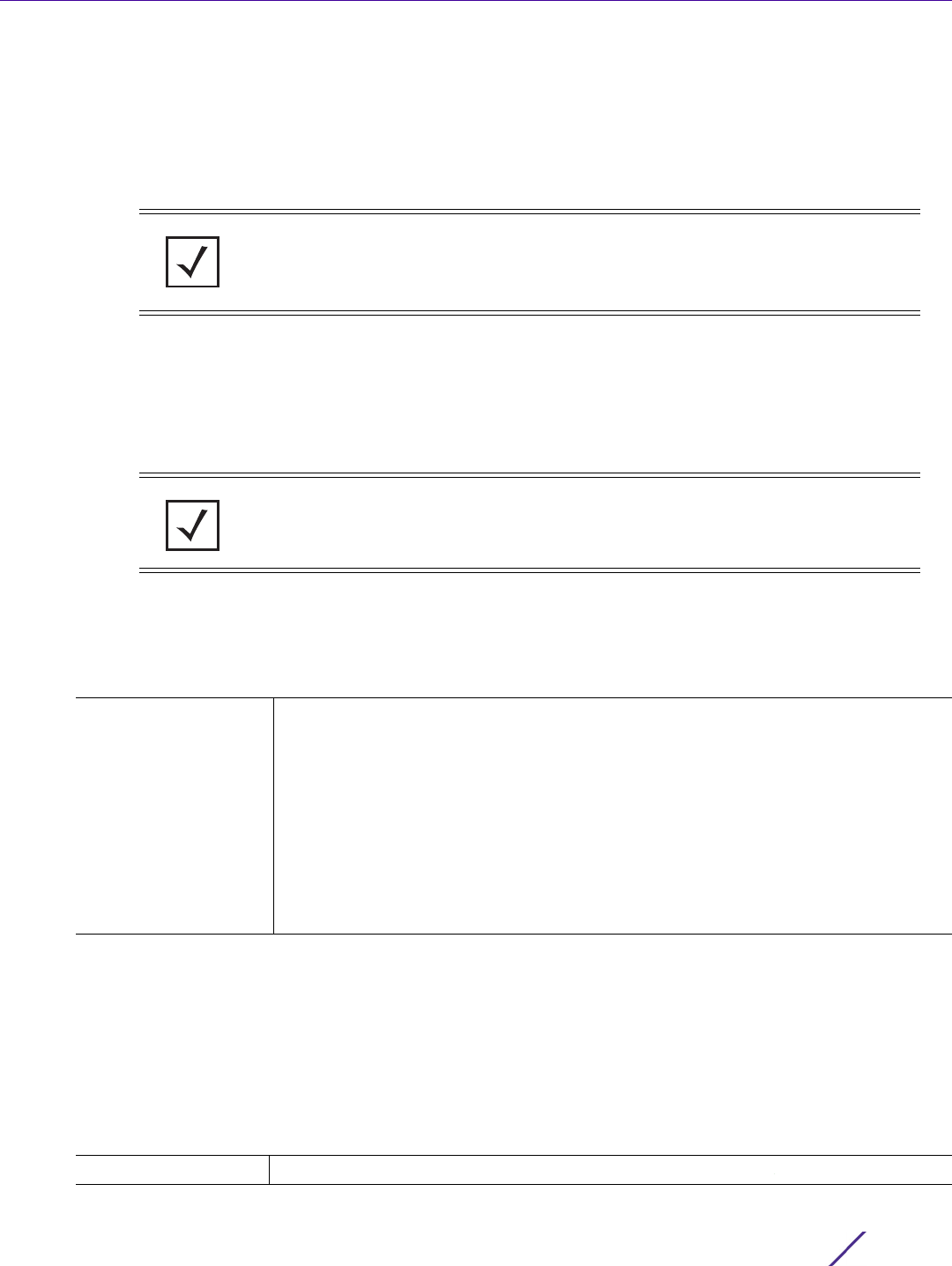
PROFILES
Access Point, Wireless Controller and Service Platform CLI Reference Guide 7 - 155
7.1.26 eguest-server (NOC Only)
Profile Config Commands
Points to the EGuest server when executed along with the ‘host’ option. The WiNG EGuest solution is an
independently installable VM/Server that provides integrated guest management and analytics. Use this
command to enable the EGuest daemon on the EGuest server.
Supported in the following platforms:
• Access Points — AP6521, AP6522, AP6532, AP6562, AP7161, AP7502, AP7522, AP7532, AP7562,
AP7602, AP7612, AP7622, AP7632, AP7662, AP81XX, AP8232, AP8432, AP8533
• Wireless Controllers — RFS4000, RFS6000
• Service Platforms — NX5500, NX7500, NX7510, NX7520, NX7530, NX9500, NX9510, NX9600,
VX9000
Syntax
eguest-server <1-3> host <IPv4/IPv6/HOSTNAME> {http|https}
Parameters
• eguest-server <1-3> host <IPv4/IPv6/HOSTNAME> {http|https}
Example
On the NOC, execute along with the ‘host’ option to point to the EGuest server.
EG-NOC(config-device-74-67-F7-5C-64-4A)#eguest-server 1 host EG-Server https
EG-NOC(config-device-74-67-F7-5C-64-4A)#show context include-factory | include
eguest-server
no eguest-server
eguest-server 1 host EG-Server https
EG-NOC(config-device-74-67-F7-5C-64-4A)#
Related Commands
NOTE: EGuest being a licensed feature, ensure that the EGUEST-DEV license is
applied on the EGuest server’s self context. For more information, see license.
NOTE: For more information on configuring an EGuest captive-portal
deployment, see configuring ExtremeGuest captive-portal.
eguest-server <1-3>
host <IPv4/IPv6/
HOSTNAME>
{http|https}
Configures the EGuest server details in the profile/device context of the NOC
(access point/controller). When configured, the NOC posts registration requests and
captive-portal related data directly to the specified EGuest server.
• <1-3> – Configures the EGuest server index number. A maximum of three EGuest
servers can be configured.
• host <IPv4/IPv6/HOSTNAME> – Configures the EGuest server’s IPv4/IPv6 ad-
dress or hostname.
• {http|https} – Optional. Configures the mode of connection as HTTP or HTTPS.
Note: HTTPS is recommended as it uses encryption for transmission and is therefore
more secure.
no Removes the EGuest server IP address/hostname configuration

PROFILES
Access Point, Wireless Controller and Service Platform CLI Reference Guide 7 - 156
7.1.27 email-notification
Profile Config Commands
Configures e-mail notification settings. When a system event occurs e-mail notifications are sent (provided
message logging is enabled) based on the settings configured here. Use this option to configure the
outgoing SMTP server settings.
Supported in the following platforms:
• Access Points — AP6521, AP6522, AP6532, AP6562, AP7161, AP7502, AP7522, AP7532, AP7562,
AP7602, AP7612, AP7622, AP7632, AP7662, AP81XX, AP8232, AP8432, AP8533
• Wireless Controllers — RFS4000, RFS6000
• Service Platforms — NX5500, NX7500, NX7510, NX7520, NX7530, NX9500, NX9510, NX9600,
VX9000
Syntax
email-notification [host|recipient]
email-notification recipient <RECIPIENT-NAME>
email-notification host <SMTP-SERVER-IP/HOSTNAME> sender <SENDER-EMAIL>
[port|security|username]
email-notification host <SMTP-SERVER-IP/HOSTNAME> sender <SENDER-EMAIL> [(port <1-
65535>, security [none|ssl|starttls], username <SMTP-USERNAME> password [2 <WORD>|
<WORD>])]
Parameters
• email-notification recipient <RECIPIENT-EMAIL>
• email-notification host <SMTP-SERVER-IP/HOSTNAME> sender <SENDER-EMAIL> [(port
<1-65535>, security [none|ssl|starttls], username <SMTP-USERNAME> password [2
<WORD>|<WORD>])]
recipient
<RECIPIENT-EMAIL>
Defines the recipient’s e-mail address. A maximum of 6 (six) e-mail addresses can
the configured.
• <RECIPIENT-EMAIL> – Specify the recipient’s e-mail address (should not exceed 64
characters in length).
host
<SMTP-SERVER-IP/
HOSTNAME>
Configures the host SMTP server’s IP address or hostname
• <SMTP-SERVER-IP/HOSTNAME> – Specify the SMTP server’s IP address or
hostname.
sender
<SENDER-EMAIL>
Defines the sender’s e-mail address. This is the from address on notification e-mails.
• <SENDER-EMAIL> – Specify the sender’s e-mail address (should not exceed 64
characters in length). Use the email-notification > recipient > <EMAIL-ADDRESS>
command to configure the recipient's address.
port <1-65535> This option is recursive and applicable to the ‘security‘ and ‘username’ parameters.
Configures the SMTP server port. Use this option to configure a non-standard SMTP
port on the outgoing SMTP server. The standard SMTP port is 25.
• <1-65535> – Specify the port from 1 - 65535.

PROFILES
Access Point, Wireless Controller and Service Platform CLI Reference Guide 7 - 157
Example
rfs6000-37FABE(config-profile-default-rfs6000)#email-notification recipient
test@examplecompany.com
rfs6000-37FABE(config-profile-default-rfs6000)#show context
profile rfs7000 default-rfs7000
dscp-mapping 20 priority 7
no autoinstall configuration
no autoinstall firmware
.............................................................
interface ge4
ip dhcp trust
qos trust dscp
qos trust 802.1p
use firewall-policy default
email-notification recipient test@examplecompany.com
service pm sys-restart
rfs6000-37FABE(config-profile-default-rfs6000)#
Related Commands
security
[none|ssl|starttls]
This option is recursive and applicable to the ‘port‘ and ‘username’ parameters.
Configures the SMTP encryption type used
• none – No encryption used
•ssl – Uses Secure Sockets Layer (SSL) encryption between the SMTP server and the
client
• starttls – Uses STARTTLS encryption between the SMTP server and the client
username
<SMTP-USERNAME>
password
[2 <WORD>|
<WORD>]
This option is recursive and applicable to the ‘port‘ and ‘security’ parameters.
Configures the SMTP sender’s username. Many SMTP servers require users to
authenticate with a username and password before sending e-mail through the
server.
• <SMTP-USERNAME> – Specify the SMTP username (should not exceed 64
characters in length).
• password – Configures the SMTP server password. Specify the password associ-
ated with the username of the sender on the outgoing SMTP server.
• 2 <WORD> – Configures an encrypted password
• <WORD> – Specify the password (should not exceed 127 characters in
length).
no Disables or reverts settings to their default

PROFILES
Access Point, Wireless Controller and Service Platform CLI Reference Guide 7 - 158
7.1.28 enforce-version
Profile Config Commands
Enables checking of a device’s firmware version before attempting adoption or clustering
Supported in the following platforms:
• Access Points — AP6521, AP6522, AP6532, AP6562, AP7161, AP7502, AP7522, AP7532, AP7562,
AP7602, AP7612, AP7622, AP7632, AP7662, AP81XX, AP8232, AP8432, AP8533
• Wireless Controllers — RFS4000, RFS6000
• Service Platforms — NX5500, NX7500, NX7510, NX7520, NX7530, NX9500, NX9510, NX9600,
VX9000
Syntax
enforce-version [adoption|cluster] [full|major|minor|none|strict]
Parameters
• enforce-version [adoption|cluster] [full|major|minor|none|strict]
Example
nx9500-6C8809(config-profile-test-nx5500)#enforce-version cluster full
nx9500-6C8809(config-profile-test-nx5500)#enforce-version adoption major
nx9500-6C8809(config-profile-test-nx5500)#show context
profile nx5500 test-nx5500
no autoinstall configuration
no autoinstall firmware
crypto ikev1 policy ikev1-default
isakmp-proposal default encryption aes-256 group 2 hash sha
....................................................
interface pppoe1
use firewall-policy default
enforce-version adoption major
enforce-version cluster full
service pm sys-restart
router ospf
router bgp
dot1x system-auth-control
dot1x use aaa-policy OnBoarding
nx9500-6C8809(config-profile-test-nx5500)#
Related Commands
adoption Verifies firmware versions before adopting. This option is enabled by default.
cluster Verifies firmware versions before clustering. This option is enabled by default.
full Allows adoption or clustering when the first four octets of the firmware versions match
(for example 5.8.6.0)
major Allows adoption or clustering when the first two octets of the firmware versions match
(for example 5.8)
minor Allows adoption or clustering when the first three octets of the firmware versions match
(for example 5.8.6)
none Allows adoption or clustering between any firmware versions
strict Allows adoption or clustering only when firmware versions exactly match (for example
5.8.6.0-008B). This is the default setting for both ‘adoption’ and ‘cluster’ options.
no Disables or reverts settings to their default

PROFILES
Access Point, Wireless Controller and Service Platform CLI Reference Guide 7 - 159
7.1.29 environmental-sensor
Profile Config Commands
Configures the environmental sensor settings
An AP8132 sensor module is a USB environmental sensor extension to an AP8132 model access point. It
provides a variety of sensing mechanisms, allowing the monitoring and reporting of the AP8132's radio
coverage area.
Supported in the following platforms:
• Access Points — AP8132
Syntax
environmental-sensor [humidity|light|motion|polling-interval|temperature]
environmental-sensor [humidity|motion|polling-interval <1-100>|temperature]
environmental-sensor light {holdtime|radio-shutdown|threshold}
environmental-sensor light {holdtime <10-201>|radio-shutdown [all|radio-1|radio-
2]}
environmental-sensor light {threshold [high <100-10000>|low <0-1000>]}
Parameters
• environmental-sensor [humidity|motion|polling-interval <1-100>|temperature]
• environmental-sensor light {holdtime <10-201>|radio-shutdown [all|radio-1|
radio-2]}
environmental-
sensor
Configures environmental sensor settings on this profile
humidity Enables (turns on) humidity sensors. This setting is enabled by default.
motion Enables (turns on) motion sensors.This setting is enabled by default.
polling-interval
<1-100>
Configures polling interval, in seconds, on all sensors. This is the interval after which the
sensor module polls its environment to assess the various parameters, such as light
intensity.
• <1-100> – Specify a value from 1 - 100 seconds. The default is 5 seconds.
temperature Enables (turns on) temperature sensors. This setting is enabled by default.
environmental-
sensor
Configures environmental sensor settings on this profile
light Enables (turns on) light sensors and specifies its settings
When enabled, the sensor module polls the environment to determine the light intensity.
Based on the reading, the system determines whether the AP8132’s deployment location
has lights on or off. Light intensity also helps determine whether the access point’s
deployment location is currently populated with clients.
holdtime
<10-201>
Optional. Configures a holdtime, in seconds, for the light sensor
• <10-201> – Specify a value from 10 - 201 seconds. The default value is 11 seconds.

PROFILES
Access Point, Wireless Controller and Service Platform CLI Reference Guide 7 - 160
• environmental-sensor light {threshold [high <100-10000>|low <0-1000>]}
Example
rfs4000-229D58(config-profile-testRFS4000)#environmental-sensor humidity
rfs4000-229D58(config-profile-testRFS4000)#environmental-sensor polling-interval
60
rfs4000-229D58(config-profile-testRFS4000)#environmental-sensor light radio-
shutdown all
rfs4000-229D58(config-profile-testRFS4000)#environmental-sensor light threshold
high 300
rfs4000-229D58(config-profile-testRFS4000)#environmental-sensor light threshold
low 100
rfs4000-229D58(config-profile-testRFS4000)#show context
profile rfs4000 testRFS4000
bridge vlan 1
tunnel-over-level2
ip igmp snooping
ip igmp snooping querier
environmental-sensor polling-interval 60
environmental-sensor light threshold high 300
environmental-sensor light threshold low 100
environmental-sensor light radio-shutdown all
no autoinstall configuration
no autoinstall firmware
device-upgrade persist-images
--More--
rfs4000-229D58(config-profile-testRFS4000)#
Related Commands
radio-shutdown
[all|radio1|radio2]
Optional. Shuts down the sensor’s radios
• all – Shuts down all radios. This is the default setting.
• radio1 – Shuts down radio 1
•radio2 – Shuts down radio 2
AP8132’s using this profile have their radios shut down, when the radio’s power falls
below the specified threshold. Use the environmental-sensor > light > threshold >
[high|low] command to set the threshold values.
environmental-
sensor
Configures environmental sensor settings on this profile
light Enables (turns on) light sensors and specifies its settings
threshold Optional. Configures the upper and lower thresholds for the amount of light in the
environment
high
<100-10000>
Specifies the upper threshold from 100 - 10000 lux. This value determines whether
lighting is on in the AP8132’s deployment location. The radios are turned off if the
average reading value is lower than the value set here. The default is 400 lux.
The light sensor triggers an event if the amount of light exceeds the specified value.
low <0-1000> Specifies the lower threshold from 0 - 1000 lux. This value determines whether lighting is
off in the AP8132’s deployment location. The radios are turned on when the average
value is higher than the value set here. The default is 200 lux.
The light sensor triggers an event if the amount of light drops below the specified value.
no Removes the environmental sensor’s settings

PROFILES
Access Point, Wireless Controller and Service Platform CLI Reference Guide 7 - 161
7.1.30 events
Profile Config Commands
Displays system event messages
Supported in the following platforms:
• Access Points — AP6521, AP6522, AP6532, AP6562, AP7161, AP7502, AP7522, AP7532, AP7562,
AP7602, AP7612, AP7622, AP7632, AP7662, AP81XX, AP8232, AP8432, AP8533
• Wireless Controllers — RFS4000, RFS6000
• Service Platforms — NX5500, NX7500, NX7510, NX7520, NX7530, NX9500, NX9510, NX9600,
VX9000
Syntax
events [forward on|on]
Parameters
• events [forward on|on]
Example
rfs6000-37FABE(config-profile-default-rfs6000)#events forward on
rfs6000-37FABE(config-profile-default-rfs6000)#
Related Commands
forward on Forwards system event messages to the wireless controller, service platform, or
cluster members. This feature is enabled by default.
• on – Enables forwarding of system events
on Generates system events. This feature is enabled by default.
no Disables or reverts settings to their default

PROFILES
Access Point, Wireless Controller and Service Platform CLI Reference Guide 7 - 162
7.1.31 export
Profile Config Commands
Enables export of startup.log file after every boot
Supported in the following platforms:
• Access Points — AP6521, AP6522, AP6532, AP6562, AP7161, AP7502, AP7522, AP7532, AP7562,
AP7602, AP7612, AP7622, AP7632, AP7662, AP81XX, AP8232, AP8432, AP8533
• Wireless Controllers — RFS4000, RFS6000
• Service Platforms — NX5500, NX7500, NX7510, NX7520, NX7530, NX9500, NX9510, NX9600,
VX9000
Syntax
export startup-log [max-retries|retry-interval|url]
export startup-log [max-retries <2-65535>|retry-interval <30-86400>|url <URL>]
Parameters
• export startup-log [max-retries <2-65535>|retry-interval <30-86400>|url <URL>]
Example
nx9500-6C8809(config-profile-test-nx5500)#export startup-log max-retries 10
retry-interval 30 url ftp://anonymous:anonymous@192.168.13.10/log/startup.log
nx9500-6C8809(config-profile-test-nx5500)#show context
profile nx5500 test-nx5500
no autoinstall configuration
no autoinstall firmware
crypto ikev1 policy ikev1-default
.......................................................
interface ge5
interface ge6
interface pppoe1
use firewall-policy default
export startup-log max-retries 10 retry-interval 30 url ftp://
anonymous:anonymous@192.168.13.10/log/startup.log
enforce-version adoption major
enforce-version cluster full
service pm sys-restart
--More--g
nx9500-6C8809(config-profile-test-nx5500)#
Related Commands
export startup-log Enables export of the startup.log file after every boot. This option is disabled by
default.
max-retries
<2-65535>
Configures the maximum number of retries in case the export process fails
• <2-65535> – Specify a value from 2 - 65535.
retry-interval
<30-86400>
Configures the interval between two consecutive retries
• <30-86400> – Specify a value from 30 - 86400 seconds.
url <URL> Configures the destination URL in the following format:
tftp://<hostname|IP>[:port]/path/file
ftp://<user>:<passwd>@<hostname|IP>[:port]/path/file
sftp://<user>@<hostname|IP>[:port]>/path/file
no Disables export of startup.log file

PROFILES
Access Point, Wireless Controller and Service Platform CLI Reference Guide 7 - 163
7.1.32 file-sync
Profile Config Commands
Configures parameters enabling auto syncing of trustpoint/wireless-bridge certificate between the staging-
controller and its adopted access points
This command is applicable to the access point’s profile as well as device configuration modes.
Supported in the following platforms:
• Access Points — AP6521, AP6522, AP6532, AP6562, AP7161, AP7502, AP7522, AP7532, AP7562,
AP7602, AP7612, AP7622, AP7632, AP7662, AP81XX, AP8232, AP8432, AP8533
• Wireless Controllers — RFS4000, RFS6000
• Service Platforms — NX7500, NX7510, NX7520, NX7530, NX9500, NX9510, NX9600
Syntax
file-sync [auto|count <1-20>]
Parameters
• file-sync [auto|count <1-20>]
Example
nx9500-6C8809(config-profile-default-rfs6000)#file-sync auto
nx9500-6C8809(config-profile-default-rfs6000)#file-sync count 8
nx9500-6C8809(config-profile-default-rfs6000)#show context
profile rfs6000 default-rfs6000
no autoinstall configuration
no autoinstall firmware
no device-upgrade auto
file-sync count 8
file-sync auto
crypto ikev1 policy ikev1-default
isakmp-proposal default encryption aes-256 group 2 hash sha
crypto ikev2 policy ikev2-default
isakmp-proposal default encryption aes-256 group 2 hash sha
crypto ipsec transform-set default esp-aes-256 esp-sha-hmac
--More--
nx9500-6C8809(config-profile-default-rfs6000)#
Related Commands
file-sync
[auto|count <1-20>]
Configures the following file-synching parameters:
• auto – Enables the staging controller to autoinstall trustpoint/wireless-bridge
certificate on an access point when it comes up for the first time and adopts to the
controller.
Prior to enabling file syncing, ensure that the wireless-bridge certificate is present on
the staging controller. To upload the certificate on the controller, in the user or
privilege executable modes, execute the following command: file-sync > load-file >
<URL>.
• count <1-20> – Configures the maximum number of access points that can be
concurrently auto-installed.
• <1-20> – Specify a value from 1 - 20. The default is 10 access points.
For the NX95XX service platforms the count-range is from 1 - 128.
no Disables automatic file syncing between the staging-controller and its access points

PROFILES
Access Point, Wireless Controller and Service Platform CLI Reference Guide 7 - 164
7.1.33 floor
Profile Config Commands
Sets the floor name where the target device (access point, wireless controller, or service platform using this
profile) is physically located. Assigning a building floor name helps in grouping devices within the same
general coverage area.
Supported in the following platforms:
• Access Points — AP6521, AP6522, AP6532, AP6562, AP7161, AP7502, AP7522, AP7532, AP7562,
AP7602, AP7612, AP7622, AP7632, AP7662, AP81XX, AP8232, AP8432, AP8533
• Wireless Controllers — RFS4000, RFS6000
• Service Platforms — NX5500, NX7500, NX7510, NX7520, NX7530, NX9500, NX9510, NX9600,
VX9000
Syntax
floor <WORD> {<1-4094>}
Parameters
• floor <WORD> {<1-4094>}
Example
rfs6000-37FABE(config-profile-default-rfs6000)#floor fifth
rfs6000-37FABE(config-profile-default-rfs6000)#show context
profile rfs7000 default-rfs7000
bridge vlan 1
ip igmp snooping
ip igmp snooping querier
area Ecospace
floor fifth
autoinstall configuration
autoinstall firmware
--More--
rfs6000-37FABE(config-profile-default-rfs6000)#
Related Commands
floor <WORD>
{<1-4094>}
Sets the floor name where the target device is located
• <WORD> – Specify the floor name (should not exceed 64 characters in length).
• <1-4094> – Optional. Configures the floor number from 1 - 4094. The default is 1.
no Resets the configured floor name and number

PROFILES
Access Point, Wireless Controller and Service Platform CLI Reference Guide 7 - 165
7.1.34 gre
Profile Config Commands
The following table summarizes commands that allow you to enter the GRE configuration mode:
Command Description Reference
gre Enables GRE tunneling on a profile/device This command also creates
a GRE tunnel and enters its configuration mode. Use this command to
modify an existing GRE tunnel’s settings.
page 7-166
gre-config-
instance
Summarizes GRE tunnel configuration mode commands page 7-168
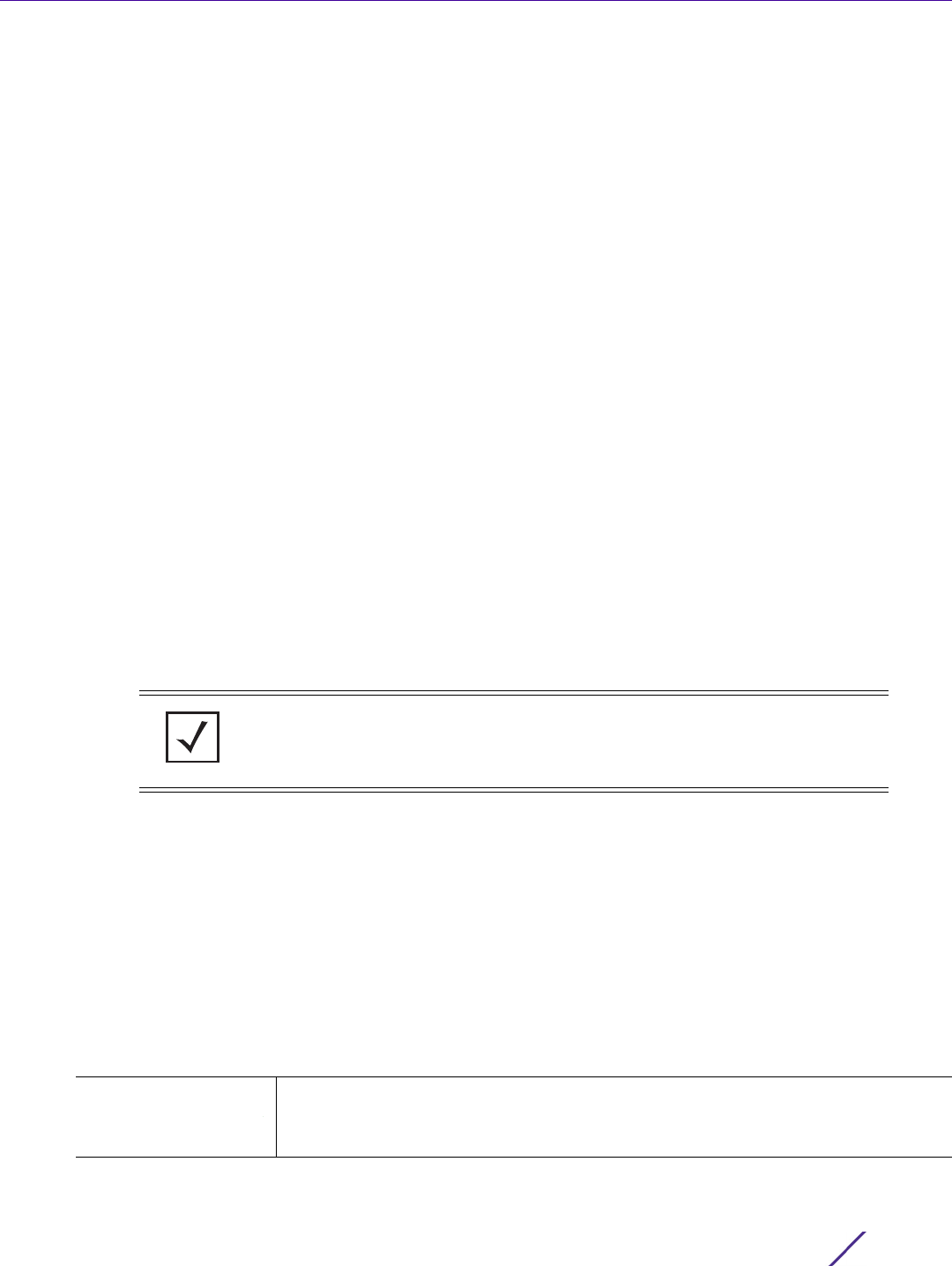
PROFILES
Access Point, Wireless Controller and Service Platform CLI Reference Guide 7 - 166
7.1.34.1 gre
gre
Enables Generic Routing Encapsulation (GRE) tunneling on this profile, and creates a new GRE tunnel or
modifies an existing GRE tunnel.
The GRE protocol allows encapsulation of one protocol over another. It is a tunneling protocol that
transports any layer 3 protocol over an IP network. When enabled, a payload packet is first encapsulated in
the GRE protocol. The GRE encapsulated payload is then encapsulated in another IP packet before being
forwarded to the destination.
GRE tunneling can be configured to bridge Ethernet packets between WLANs and a remote WLAN
gateway over an IPv4 GRE tunnel. The tunneling of 802.3 packets using GRE is an alternative to MiNT or
L2TPv3. Related features like ACLs for extended VLANs are still available using layer 2 tunneling over GRE.
Using GRE, access points map one or more VLANs to a tunnel. The remote end point is a user-configured
WLAN gateway IP address, with an optional secondary IP address should connectivity to the primary GRE
peer be lost. VLAN traffic is expected in both directions in the GRE tunnel. A WLAN mapped to these
VLANs can be either open or secure. Secure WLANs require authentication to a remote RADIUS server
available within your deployment using standard RADIUS protocols. Access Points can reach both the GRE
peer as well as the RADIUS server using IPv4.
The WiNG software now supports for both IPv4 or IPv6 tunnel endpoints. However, a tunnel needs to
contain either IPv4 or IPv6 formatted device addresses and cannot be mixed. With the new IPv6 tunnel
implementation, all outbound packets are encapsulated with the GRE header, then the IPv6 header. The
header source IP address is the local address of the IPv6 address of tunnel interface, and the destination
address peer address of the tunnel. All inbound packets are de-capsulated by removing the IPv6 and GRE
header before sending it over to the IP stack.
Supported in the following platforms:
• Access Points — AP6521, AP6522, AP6532, AP6562, AP7161, AP7502, AP7522, AP7532, AP7562,
AP7602, AP7622, AP81XX, AP8232, AP8432, AP8533
• Wireless Controllers — RFS4000, RFS6000
• Service Platforms — NX5500, NX7500, NX7510, NX7520, NX7530, NX9500, NX9510, NX9600,
VX9000
Syntax
gre tunnel <GRE-TUNNEL-NAME>
Parameters
• gre tunnel <GRE-TUNNEL-NAME>
NOTE: Only one GRE tunnel can be created for every profile.
gre tunnel
<GRE-TUNNEL-NAME>
Creates a new GRE tunnel or modifies an existing GRE tunnel
• <GRE-TUNNEL-NAME> – If creating a new tunnel, specify a unique name for it. If
modifying an existing tunnel, specify its name.

PROFILES
Access Point, Wireless Controller and Service Platform CLI Reference Guide 7 - 167
Example
rfs4000-229D58(config-profile testRFS4000-gre-tunnel-testGREtunnel)#?
GRE Tunnel Mode commands:
dscp Differentiated Services Code Point
establishment-criteria Set tunnel establishment criteria
failover L2gre tunnel failover
mtu L2GRE tunnel endpoint maximum transmission unit(MTU)
native Native trunking characteristics
no Negate a command or set its defaults
peer L2GRE peer
tunneled-vlan VLANs to tunnel
clrscr Clears the display screen
commit Commit all changes made in this session
do Run commands from Exec mode
end End current mode and change to EXEC mode
exit End current mode and down to previous mode
help Description of the interactive help system
revert Revert changes
service Service Commands
show Show running system information
write Write running configuration to memory or terminal
rfs4000-229D58(config-profile testRFS4000-gre-tunnel-testGREtunnel)#
rfs4000-229D58(config-profile testRFS4000-gre-tunnel-testGREtunnel)#peer 1 ip
192.168.13.8
rfs4000-229D58(config-profile testRFS4000-gre-tunnel-testGREtunnel)#peer 2 ip
192.168.13.10
rfs4000-229D58(config-profile testRFS4000-gre-tunnel-testGREtunnel)#show context
gre tunnel testGREtunnel
peer 1 ip 192.168.13.8
peer 2 ip 192.168.13.10
rfs4000-229D58(config-profile testRFS4000-gre-tunnel-testGREtunnel)#
rfs4000-229D58(config-profile-testRFS4000)#show context
profile rfs4000 testRFS4000
bridge vlan 1
tunnel-over-level2
ip igmp snooping
ip igmp snooping querier
................................................................................
..
use firewall-policy default
service pm sys-restart
router ospf
gre tunnel testGREtunnel
peer 1 ip 192.168.13.8
peer 2 ip 192.168.13.10
rfs4000-229D58(config-profile-testRFS4000)#
Related Commands
no Disables GRE tunneling on this profile

PROFILES
Access Point, Wireless Controller and Service Platform CLI Reference Guide 7 - 168
7.1.34.2 gre-config-instance
gre
The following table summarizes GRE tunnel configuration mode commands:
Command Description Reference
dscp Sets the GRE tunnel’s Differentiated Services Code Point (DSCP) / 802.1q
priority value
page 7-169
establishment-
criteria
Configures the GRE tunnel establishment criteria page 7-169
failover Enables periodic pinging of the primary gateway to assess its availability,
in case it is unreachable
page 7-171
mtu Configures the maximum transmission unit (MTU) for IPv4/IPv6 L2GRE
tunnel endpoints
page 7-172
native Configures native trunking settings for this GRE tunnel page 7-173
no Removes the GRE tunnel settings based on the parameters passed page 7-174
peer Configures the GRE tunnel’s end-point peers page 7-175
tunneled-vlan Defines the VLAN that connected clients use to route GRE-tunneled
traffic within their respective WLANs
page 7-176

PROFILES
Access Point, Wireless Controller and Service Platform CLI Reference Guide 7 - 169
7.1.34.2.1 d s c p
gre-config-instance
Sets the GRE tunnel’s DSCP / 802.1q priority value from encapsulated packets to the outer packet IPv4
header.
This option is disabled by default.
Supported in the following platforms:
• Access Points — AP6521, AP6522, AP6532, AP6562, AP7161, AP7502, AP7522, AP7532, AP7562,
AP7602, AP7622, AP81XX, AP8232, AP8432, AP8533
• Wireless Controllers — RFS4000, RFS6000
• Service Platforms — NX5500, NX7500, NX7510, NX7520, NX7530, NX9500, NX9510, NX9600,
VX9000
Syntax
dscp [<0-63>|reflect]
Parameters
• dscp [<0-63>|reflect]
Example
rfs4000-229D58(config-device 00-23-68-22-9D-58-gre-tunnel-testGRETunnel)#dscp 20
rfs4000-229D58(config-device 00-23-68-22-9D-58-gre-tunnel-testGRETunnel)#show
context
gre tunnel testGRETunnel
dscp 20
rfs4000-229D58(config-device 00-23-68-22-9D-58-gre-tunnel-testGRETunnel)#
Related Commands
dscp <0-63> Specifies the DSCP 802.1q priority value for outer packets from 0 - 63. The default is
1.
dscp reflect Copies the DSCP 802.1q value from inner packets
no Removes the GRE tunnel settings based on the parameters passed

PROFILES
Access Point, Wireless Controller and Service Platform CLI Reference Guide 7 - 170
7.1.34.2.2 establishment-criteria
gre-config-instance
Configures the GRE tunnel establishment criteria
In a multi-controller RF domain, it is always the master node that establishes the tunnel. The tunnel is
created only if the tunnel device is designated as one of the following: vrrp-master, cluster-master, or rf-
domain-manager.
Supported in the following platforms:
• Access Points — AP6521, AP6522, AP6532, AP6562, AP7161, AP7502, AP7522, AP7532, AP7562,
AP7602, AP7622, AP81XX, AP8232, AP8432, AP8533
• Wireless Controllers — RFS4000, RFS6000
• Service Platforms — NX5500, NX7500, NX7510, NX7520, NX7530, NX9500, NX9510, NX9600,
VX9000
Syntax
establishment-criteria [always|cluster-master|rf-domain-manager|vrrp-master <1-
255>]
Parameters
• establishment-criteria [always|cluster-master|rf-domain-manager|vrrp-master <1-
255>]
Example
nx9500-6C8809(config-profile testNX9500-gre-tunnel-testGREtunnel)#establishment-
criteria rf-domain-manager
nx9500-6C8809(config-profile testNX9500-gre-tunnel-testGREtunnel)#show context
gre tunnel testGREtunnel
establishment-criteria rf-domain-manager
nx9500-6C8809(config-profile testNX9500-gre-tunnel-testGREtunnel)#
establishment-criteria
[always|
cluster-master|
rf-domain-manager|
vrrp-master <1-255>]
Configures the GRE tunnel establishment criteria. The options are:
• always – Always automatically establishes tunnel (default setting). The tunnel device
need not be a cluster master, RF Domain manager, or VRRP master to establish the
GRE tunnel. This is the default setting.
• cluster-master – Establishes tunnel only if the tunnel device is designated as the
cluster master
• rf-domain-manager – Establishes tunnel only if the tunnel device is designated as the
RF Domain manager
• vrrp-master <1-255> – Establishes tunnel only if the tunnel device is designated as
the Virtual Router Redundancy (VRRP) master
• <1-255> – Configures the VRRP group ID from 1 - 255. A VRRP group enables the
creation of a group of routers as a default gateway for redundancy. Clients can point
to the IP address of the VRRP virtual router as their default gateway and utilize a dif-
ferent group member if a master becomes unavailable.

PROFILES
Access Point, Wireless Controller and Service Platform CLI Reference Guide 7 - 171
7.1.34.2.3 failover
gre-config-instance
Enables periodic pinging of the primary gateway to assess its availability. When enabled, the system
continues pinging, an unreachable gateway, for a specified number of times and at the specified interval.
This option is disabled by default.
Supported in the following platforms:
• Access Points — AP6521, AP6522, AP6532, AP6562, AP7161, AP7502, AP7522, AP7532, AP7562,
AP7602, AP7622, AP81XX, AP8232, AP8432, AP8533
• Wireless Controllers — RFS4000, RFS6000
• Service Platforms — NX5500, NX7500, NX7510, NX7520, NX7530, NX9500, NX9510, NX9600,
VX9000
Syntax
failover interval <1-250> retry <1-10>
Parameters
• failover interval <1-250> retry <1-10>
Example
rfs4000-229D58(config-device 00-23-68-22-9D-58-gre-tunnel-testGRETunnel)#failover
interval 200 retry 5
rfs4000-229D58(config-device 00-23-68-22-9D-58-gre-tunnel-testGRETunnel)#show
context
gre tunnel testGRETunnel
dscp 20
failover interval 200 retry 5
rfs4000-229D58(config-device 00-23-68-22-9D-58-gre-tunnel-testGRETunnel)#
Related Commands
failover interval
<1-250>
retry <1-10>
Specifies the interval, in seconds, between two successive pings to the primary
gateway. If the primary gateway is unreachable, the system pings it at intervals
specified here.
• <1-250> – Specify a value from 1 - 250 seconds.
• retry – Specifies the maximum number attempts made to ping the primary gate-
way before the session is terminated.
• <1-10> – Specify a value from 1 - 10.
no Removes the GRE tunnel settings based on the parameters passed

PROFILES
Access Point, Wireless Controller and Service Platform CLI Reference Guide 7 - 172
7.1.34.2.4 mtu
gre-config-instance
Configures the MTU for IPv4/IPv6 L2GRE tunnel endpoints
The MTU is the largest physical packet size (in bytes) transmittable within the tunnel. Any messages larger
than the configured MTU are divided into smaller packets before transmission. Larger the MTU greater is
the efficiency because each packet carries more user data, while protocol overheads, such as headers or
underlying per-packet delays remain fixed; the resulting higher efficiency means a slight improvement in
bulk protocol throughput. A larger MTU results in the processing of fewer packets for the same amount of
data.
Supported in the following platforms:
• Access Points — AP6521, AP6522, AP6532, AP6562, AP7161, AP7502, AP7522, AP7532, AP7562,
AP7602, AP7622, AP81XX, AP8232, AP8432, AP8533
• Wireless Controllers — RFS4000, RFS6000
• Service Platforms — NX5500, NX7500, NX7510, NX7520, NX7530, NX9500, NX9510, NX9600,
VX9000
Syntax
mtu [ipv4 <900-1476>|ipv6 <1236-1456>]
Parameters
• mtu [ipv4 <900-1476>|ipv6 <1236-1456>]
Example
nx9500-6C8809(config-profile testNX9500-gre-tunnel-testGREtunnel)#mtu ipv4 1200
nx9500-6C8809(config-profile testNX9500-gre-tunnel-testGREtunnel)#mtu ipv6 1300
nx9500-6C8809(config-profile testNX9500-gre-tunnel-testGREtunnel)#show context
gre tunnel testGREtunnel
mtu ipv4 1200
mtu ipv6 1300
establishment-criteria rf-domain-manager
nx9500-6C8809(config-profile testNX9500-gre-tunnel-testGREtunnel)#
mtu
[ipv4 <900-1476>|
ipv6 <1236-1456>]
Configures the MTU for L2GRE tunnel endpoints
• ipv4 <900-1476> – Configures IPv4 L2GRE tunnel endpoint MTU from 900 - 1476.
The default is 1476.
• ipv6 <1236-1456> – Configures IPv6 L2GRE tunnel endpoint MTU from 1236 - 1456.
The default is 1456.

PROFILES
Access Point, Wireless Controller and Service Platform CLI Reference Guide 7 - 173
7.1.34.2.5 native
gre-config-instance
Configures native trunking settings for this GRE tunnel
Supported in the following platforms:
• Access Points — AP6521, AP6522, AP6532, AP6562, AP7161, AP7502, AP7522, AP7532, AP7562,
AP7602, AP7622, AP81XX, AP8232, AP8432, AP8533
• Wireless Controllers — RFS4000, RFS6000
• Service Platforms — NX5500, NX7500, NX7510, NX7520, NX7530, NX9500, NX9510, NX9600,
VX9000
Syntax
native [tagged|vlan <1-4094>]
Parameters
• native [tagged|vlan <1-4094>]
Example
nx9500-6C8809(config-profile testNX9500-gre-tunnel-testGREtunnel)#native tagged
nx9500-6C8809(config-profile testNX9500-gre-tunnel-testGREtunnel)#native vlan 20
nx9500-6C8809(config-profile testNX9500-gre-tunnel-testGREtunnel)#show context
gre tunnel testGREtunnel
native vlan 20
native tagged
mtu ipv4 1200
mtu ipv6 1300
establishment-criteria rf-domain-manager
nx9500-6C8809(config-profile testNX9500-gre-tunnel-testGREtunnel)#
Related Commands
native tagged Enables native VLAN tagging
The IEEE 802.1Q specification is supported for tagging frames and coordinating
VLANs between devices. IEEE 802.1Q adds four bytes to each frame identifying the
VLAN ID for upstream devices that the frame belongs. If the upstream Ethernet
device does not support IEEE 802.1Q tagging, it does not interpret the tagged
frames. When VLAN tagging is required between devices, both devices must
support tagging and be configured to accept tagged VLANs. When a frame is
tagged, the 12 bit frame VLAN ID is added to the 802.1Q header so upstream
Ethernet devices know which VLAN ID the frame belongs to. The device reads the 12
bit VLAN ID and forwards the frame to the appropriate VLAN. When a frame is
received with no 802.1Q header, the upstream device classifies the frame using the
default or native VLAN assigned to the Trunk port. The native VLAN allows an
Ethernet device to associate untagged frames to a VLAN when no 802.1Q frame is
included in the frame. This feature is disabled by default.
native vlan <1-4094> Specifies a numerical VLAN ID (1 - 4094) for the native VLAN
The native VLAN allows an Ethernet device to associate untagged frames to a
VLAN, when no 802.1q frame is included in the frame. Additionally, the native VLAN
is the VLAN untagged traffic is directed over when using a port in trunk mode.
no Removes the GRE tunnel settings based on the parameters passed

PROFILES
Access Point, Wireless Controller and Service Platform CLI Reference Guide 7 - 174
7.1.34.2.6 no
gre-config-instance
Removes or resets the GRE tunnel settings based on the parameters passed
Supported in the following platforms:
• Access Points — AP6521, AP6522, AP6532, AP6562, AP7161, AP7502, AP7522, AP7532, AP7562,
AP7602, AP7622, AP81XX, AP8232, AP8432, AP8533
• Wireless Controllers — RFS4000, RFS6000
• Service Platforms — NX5500, NX7500, NX7510, NX7520, NX7530, NX9500, NX9510, NX9600,
VX9000
Syntax
no [dscp|establishment-criteria|failover|mtu|native|peer|tunneled-vlan]
no [dscp|establishment-criteria|failover|tunneled-vlan]
no mtu [ipv4|ipv6]
no native [tagged|vlan]
no peer <1-2>
Parameters
• no <PARAMETERS>
Example
The following example shows the GRE tunnel ‘testGRETunnel’ settings before the no commands are
executed:
rfs4000-229D58(config-device 00-23-68-22-9D-58-gre-tunnel-testGRETunnel)#show
context
gre tunnel testGRETunnel
peer 1 ip 192.168.13.6
native vlan 1
tunneled-vlan 1,10
native tagged
dscp 20
failover interval 200 retry 5
rfs4000-229D58(config-device 00-23-68-22-9D-58-gre-tunnel-testGRETunnel)#
rfs4000-229D58(config-device 00-23-68-22-9D-58-gre-tunnel-testGRETunnel)#no dscp
rfs4000-229D58(config-device 00-23-68-22-9D-58-gre-tunnel-testGRETunnel)#no
native vlan
rfs4000-229D58(config-device 00-23-68-22-9D-58-gre-tunnel-testGRETunnel)#no
tunneled-vlan
rfs4000-229D58(config-device 00-23-68-22-9D-58-gre-tunnel-testGRETunnel)#no
failover
The following example shows the GRE tunnel ‘testGRETunnel’ settings after the no commands are
executed:
rfs4000-229D58(config-device 00-23-68-22-9D-58-gre-tunnel-testGRETunnel)#show
context
gre tunnel testGRETunnel
peer 1 ip 192.168.13.6
native tagged
rfs4000-229D58(config-device 00-23-68-22-9D-58-gre-tunnel-testGRETunnel)#
no <PARAMETERS> Removes or resets the GRE tunnel’s settings based on the parameters passed

PROFILES
Access Point, Wireless Controller and Service Platform CLI Reference Guide 7 - 175
7.1.34.2.7 p e er
gre-config-instance
Adds the GRE tunnel’s end-point peers. A maximum of two peers, representing the tunnel’s end points, can
be added for each GRE tunnel.
Supported in the following platforms:
• Access Points — AP6521, AP6522, AP6532, AP6562, AP7161, AP7502, AP7522, AP7532, AP7562,
AP7602, AP7622, AP81XX, AP8232, AP8432, AP8533
• Wireless Controllers — RFS4000, RFS6000
• Service Platforms — NX5500, NX7500, NX7510, NX7520, NX7530, NX9500, NX9510, NX9600,
VX9000
Syntax
peer <1-2> ip <IPv4/IPv6>
Parameters
• peer <1-2> ip <IPv4/IPv6>
Example
rfs4000-229D58(config-device 00-23-68-22-9D-58-gre-tunnel-testGRETunnel)#peer 1
ip 192.168.13.6
rfs4000-229D58(config-device 00-23-68-22-9D-58-gre-tunnel-testGRETunnel)#show
context
gre tunnel testGRETunnel
peer 1 ip 192.168.13.6
native tagged
dscp 20
failover interval 200 retry 5
rfs4000-229D58(config-device 00-23-68-22-9D-58-gre-tunnel-testGRETunnel)#
Related Commands
peer <1-2> ip
<IPv4/IPv6>
Configures the tunnel’s end-point peers
• <1-2> – Specify a numeric index for each peer to help differentiate the tunnel end
points.
• ip – Specify the IP address (IPv4/IPv6) of the added GRE peer to serve as a
network address identifier.
• <IPv4/IPv6> – Specify the peer’s IPv4 or IPv6 address.
no Removes the GRE tunnel settings based on the parameters passed

PROFILES
Access Point, Wireless Controller and Service Platform CLI Reference Guide 7 - 176
7.1.34.2.8 tunneled-vlan
gre-config-instance
Defines the VLAN that connected clients use to route GRE tunneled traffic within their respective WLANs
Supported in the following platforms:
• Access Points — AP6521, AP6522, AP6532, AP6562, AP7161, AP7502, AP7522, AP7532, AP7562,
AP7602, AP7622, AP81XX, AP8232, AP8432, AP8533
• Wireless Controllers — RFS4000, RFS6000
• Service Platforms — NX5500, NX7500, NX7510, NX7520, NX7530, NX9500, NX9510, NX9600,
VX9000
Syntax
tunneled-vlan <VLAN-ID>
Parameters
• tunneled-vlan <VLAN-ID>
Example
rfs4000-229D58(config-device 00-23-68-22-9D-58-gre-tunnel-testGRETunnel)#
tunneled-vlan 10
rfs4000-229D58(config-device 00-23-68-22-9D-58-gre-tunnel-testGRETunnel)#show
context
gre tunnel testGRETunnel
peer 1 ip 192.168.13.6
native vlan 1
tunneled-vlan 1,10
native tagged
dscp 20
failover interval 200 retry 5
rfs4000-229D58(config-device 00-23-68-22-9D-58-gre-tunnel-testGRETunnel)#
Related Commands
tunneled-vlan
<VLAN-ID>
Specifies the VLANs associated with this GRE tunnel
• <VLAN-ID> – Specify the VLAN IDs. Specify a comma-separated list of IDs, to specify
multiple VLANs. For example, 1,10,12,16-20.
no Removes the GRE tunnel settings based on the parameters passed
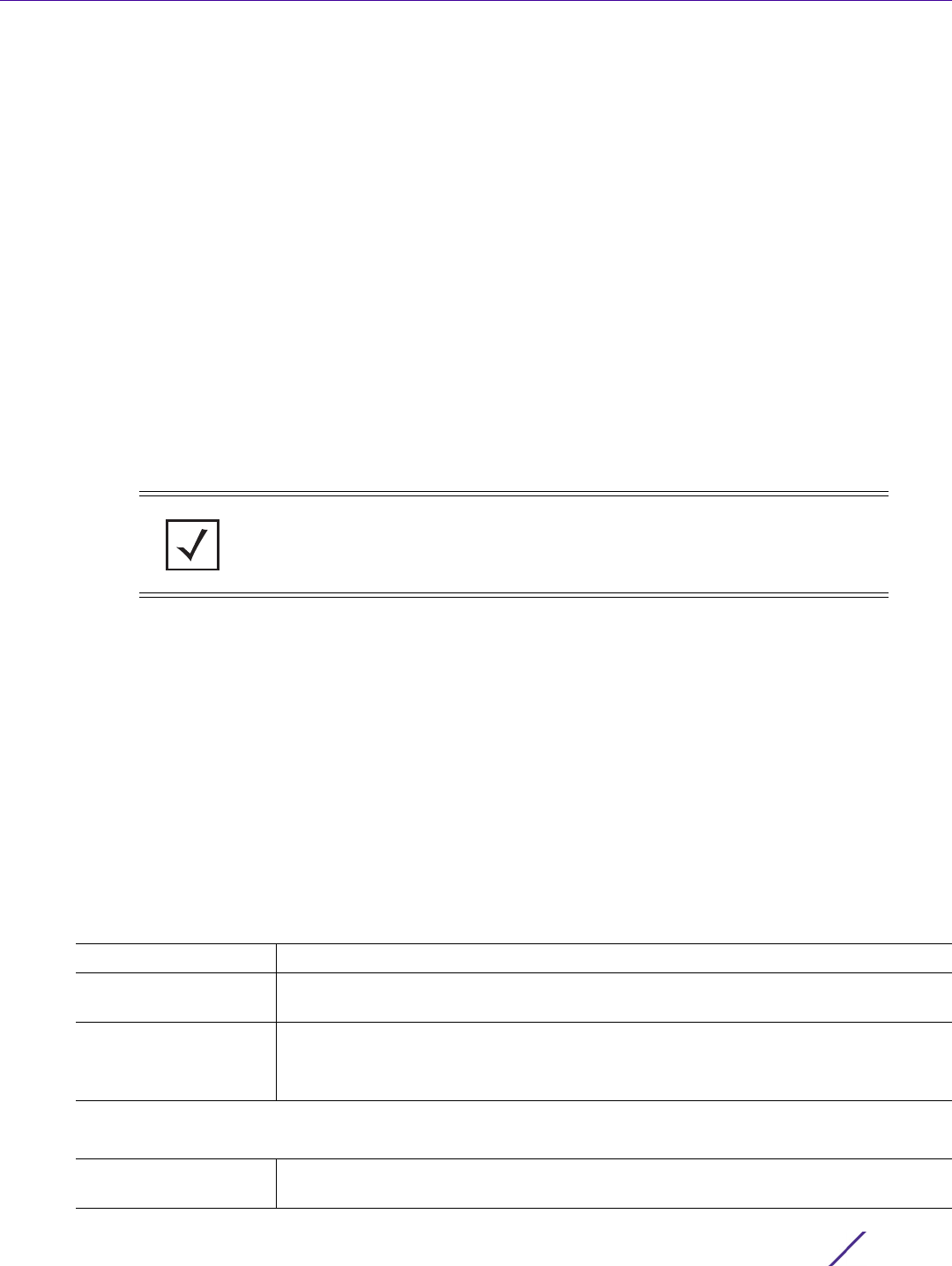
PROFILES
Access Point, Wireless Controller and Service Platform CLI Reference Guide 7 - 177
7.1.35 http-analyze
Profile Config Commands
Enables forwarding of HTTP request related data to the HTTP analytics engine
Wireless clients (MUs) connect to APs and route their HTTP requests through the APs. These APs extract
and forward HTTP request packets, through MiNT, to the NX series controller. The NX series controller uses
a new analytic daemon to cache, format, and forward information to the analytics engine. Currently the
analytics daemon is supported only on the NX series service platform. Therefore, it is essential that all APs
should use an NX series service platform as controller.
In a hierarchically organized network, HTTP analytics data forwarding is a simple and transparent process.
The site controllers receive the HTTP data from adopted APs adopted. This data is compressed and
forwarded to the Network Operations Center (NOC) controller. There is no need for a separate
configuration to enable this feature.
Use this command to configure the mode and interval at which data is sent to the controller and the
external analytics engine. This command also configures the external engine’s details, such as URL,
credentials, etc.
Supported in the following platforms:
• Access Points — AP6521, AP6522, AP6532, AP6562, AP7161, AP7502, AP7522, AP7532, AP7562,
AP7602, AP7612, AP7622, AP7632, AP7662, AP81XX, AP8232, AP8432, AP8533
• Wireless Controllers — RFS4000, RFS6000
• Service Platforms — NX7500, NX7510, NX7520, NX7530, NX9500, NX9510, NX9600, VX9000
Syntax
http-analyze [compress|external-server|update-interval <1-3600>]
http-analyze [compress|update-interval <1-3600>
http-analyze external-server [password <WORD>|proxy <URL>|update-interval <1-
3600>|url <URL>|username <WORD>|validate-server-certificate]
Parameters
• http-analyze [compress|update-interval <1-3600>]
• http-analyze external-server [password <WORD>|proxy <URL>|update-interval|
url|username|validate-server-certificate]
NOTE: The Analytics module helps gather data about customer behavior
such as web sites visited, search terms used, mobile device types, number
of new users vs. repeat users. This data provides a better understanding of
pricing strategies and promotions being run by competitors.
http-analyze Configures HTTP analysis related parameters
compress Compresses update files before forwarding to the controller. This option is disabled
by default.
update-interval
<1-3600>
Configures the interval, in seconds, at which buffered packets are pushed to the
controller
• <1-3600> – Specify the interval from 1 - 3600 seconds. The default is 60 seconds.
http-analyze external-
server
Configures the external HTTP analytics engine’s parameters

PROFILES
Access Point, Wireless Controller and Service Platform CLI Reference Guide 7 - 178
Example
rfs6000-37FABE(config-profile-default-rfs6000)#http-analyze compress
rfs6000-37FABE(config-profile-default-rfs6000)#http-analyze update-interval 200
rfs6000-37FABE(config-profile-default-rfs6000)#show context
profile rfs7000 default-rfs7000
bridge vlan 1
.....................................................................
qos trust 802.1p
interface pppoe1
use firewall-policy default
http-analyze update-interval 200
http-analyze compress
service pm sys-restart
router ospf
rfs6000-37FABE(config-profile-default-rfs6000)#
nx9500-6C8809(config-profile-test-nx5500)#http-analyze external-server username
anonymous
nx9500-6C8809(config-profile-test-nx5500)#http-analyze external-server password
anonymous
nx9500-6C8809(config-profile-test-nx5500)#http-analyze external-server validate-
server-certificate
nx9500-6C8809(config-profile-test-nx5500)#http-analyze external-server update-
interval 100
nx9500-6C8809(config-profile-test-nx5500)#http-analyze external-server url
https://192.168.13.10
password <WORD> Configures the external analytics engine’s password
• <WORD> – Provide the login password. This is the password associated with the
user name needed to access the external analytics engine.
proxy <URL> Configures the proxy server’s uniform resource locator (URL)
• <URL> – Specify the proxy server’s URL in the following format: http://
username:password@proxy-server:port. For example, http://
mot:sym@wwwgate0.mot.com:1080
update-interval
<1-36000>
Configures the interval, in seconds, at which buffered packets are pushed to the
external analytics engine
• <1-3600> – Specify the interval from 1 - 3600 seconds. The default is 60 seconds.
url <URl> Configures the external analytics engine’s IP address or URL
• <URL> – Provide the IP address or URL.
username <WORD> Configures the user name needed to access the external analytics engine
• <WORD> – Provide the user name.
validate-server-
certificate
Validates the external analytics engine’s certificate, if it is using HTTPS as the mode
of access

PROFILES
Access Point, Wireless Controller and Service Platform CLI Reference Guide 7 - 179
nx9500-6C8809(config-profile-test-nx5500)#show context
profile nx5500 test-nx5500
no autoinstall configuration
no autoinstall firmware
......................................................
interface ge5
interface ge6
interface pppoe1
use firewall-policy default
export startup-log max-retries 10 retry-interval 30 url ftp://
anonymous:anonymous@192.168.13.10/log/startup.log
http-analyze external-server url https://192.168.13.10
http-analyze external-server username anonymous
http-analyze external-server password anonymous
http-analyze external-server update-interval 100
enforce-version adoption major
enforce-version cluster full
--More--
nx9500-6C8809(config-profile-test-nx5500)#
nx9500-6C8809(config-profile-test-nx5500)#http-analyze external-server proxy
http://mot:sym@wwwgate0.mot.com:1080
nx9500-6C8809(config-profile-test-nx5500)#show context
profile nx5500 test-nx5500
no autoinstall configuration
no autoinstall firmware
crypto ikev1 policy ikev1-default
isakmp-proposal default encryption aes-256 group 2 hash sha
crypto ikev2 policy ikev2-default
...............................................................
http-analyze external-server url https://192.168.13.10
http-analyze external-server username anonymous
http-analyze external-server password anonymous
http-analyze external-server update-interval 100
http-analyze external-server proxy http://mot:sym@wwwgate0.mot.com:1080
enforce-version adoption major
enforce-version cluster full
service pm sys-restart
router ospf
router bgp
dot1x system-auth-control
dot1x use aaa-policy OnBoarding
nx9500-6C8809(config-profile-test-nx5500)#
Related Commands
no Disables HTTP analyze settings

PROFILES
Access Point, Wireless Controller and Service Platform CLI Reference Guide 7 - 180
7.1.36 interface
Profile Config Commands
The following table summarizes interface configuration commands:
Command Description Reference
interface Selects an interface to configure page 7-181
interface-config-ge-
instance
Summarizes Ethernet interface (associated with the wireless
controller or service platform) configuration commands
page 7-184
interface-config-
vlan-instance
Summarizes VLAN interface configuration commands page 7-217
interface-config-
port-channel-
instance
Summarizes port-channel interface configuration commands page 7-235
interface-config-
radio-instance
Summarizes radio interface configuration commands (applicable to
devices with built-in radios)
page 7-252
interface-config-
wwan-instance
Summarizes WWAN interface configuration commands page 7-327
interface-config-
bluetooth-instance
Summarizes the Bluetooth radio interface configuration commands
(supported only on the AP8432 and AP8533 model access points
page 7-337

PROFILES
Access Point, Wireless Controller and Service Platform CLI Reference Guide 7 - 181
7.1.36.1 interface
interface
Selects an interface to configure
A profile’s interface configuration can be defined to support separate physical Ethernet configurations both
unique and specific to RFS4000, RFS6000 controllers and NX7500 and NX95XX series service platforms.
Ports vary depending on the platform, but controller or service platform models do have some of the same
physical interfaces.
A controller or service platform requires its virtual interface be configured for layer 3 (IP) access or layer 3
service on a VLAN. A virtual interface defines which IP address is associated with each VLAN ID the
controller or service platform is connected to.
If the profile is configured to support an access point radio, an additional radio interface is available, unique
to the access point’s radio configuration.
Supported in the following platforms:
• Access Points — AP6521, AP6522, AP6532, AP6562, AP7161, AP7502, AP7522, AP7532, AP7562,
AP7602, AP7612, AP7622, AP7632, AP7662, AP81XX, AP8232, AP8432, AP8533
• Wireless Controllers — RFS4000, RFS6000
• Service Platforms — NX5500, NX7500, NX7510, NX7520, NX7530, NX9500, NX9510, NX9600,
VX9000
Syntax Service Platforms
interface [<INTERFACE-NAME>|fe <1-4>|ge <1-24>|me1|port-channel <1-4>|pppoe1|
radio [1|2|3]|serial <1-4>|t1e1 <1-4>|up <1-2>|vlan <1-4094>|wwan1|xge <1-4>]
Syntax Access Points and Wireless Controllers
interface [<INTERFACE-NAME>|bluetooth <1-1>|fe <1-4>|ge <1-8>|me1|port-channel <1-
4>|pppoe1|radio [1|2|3]|up1|vlan <1-4094>|wwan1|xge <1-4>]
Parameters
• interface [<INTERFACE-NAME>|bluetooth <1-1>|fe <1-4>|ge <1-8>|me1|port-channel
<1-4>|radio [1|2|3]|serial <1-4>|t1e1 <1-4>|up <1-2>|vlan <1-4094>|wwan1|xge <1-
4>]
<INTERFACE-NAME> Enters the configuration mode of the interface identified by the <INTERFACE-
NAME> keyword
bluetooth <1-1> Selects the Bluetooth radio interface
• <1-1> – Specify the Bluetooth radio interface index from 1 - 1. As of now only one
Bluetooth radio interface is supported.
This interface is applicable only for the AP8432 and AP8533 model access points.
fe <1-4> Selects a FastEthernet interface
• <1-4> – Specify the interface index from 1 - 4.
ge <1-24> Selects a GigabitEthernet interface
• <1-24> – Specify the interface index from 1 - 24. (4 for RFS7000 and 8 for RFS6000).

PROFILES
Access Point, Wireless Controller and Service Platform CLI Reference Guide 7 - 182
Usage Guidelines
The ports available on a device vary depending on the model. For example, the following ports are
available on RFS4000, RFS6000 and RFS7000 model wireless controllers:
• RFS4000 - ge1, ge2, ge3, ge4, ge5, up1
• RFS6000 - ge1, ge2, ge3, ge4, ge5, ge6, ge7, ge8, me1, up1
GE ports on are RJ-45 supporting 10/100/1000Mbps..
ME ports are available on RFS6000 platforms. ME ports are out-of-band management ports used to
manage the controller via CLI or Web UI, even when the other ports on the controller are unreachable.
The ports available on service platforms also vary depending on the model. For example, the following
ports are available on NX series service platforms:
• NX7500 - ge1-ge10, xge1-xge2
• NX95XX series - ge1, ge2, xge1-xge4
• EX3500 – ge1-1 to ge1-24
• EX3548 – ge1-1 to ge1-48
GE ports are available on devices, such as RFS4000 and RFS6000controllers. GE ports are RJ-45
supporting 10/100/1000Mbps.
ME ports are available on RFS6000 platforms. ME ports are out-of-band management ports used to
manage the controller via CLI or Web UI, even when the other ports on the controller are unreachable.
me1 Selects a management interface
Not applicable for RFS4000 model devices.
The management interface is applicable only for RFS6000 and RFS7000 model
controllers.
port-channel <1-4> Selects the port channel interface
• <1-4> – Specify the interface index from 1 - 4.
pppoe1 Selects the PPP over Ethernet interface to configure
radio [1|2|3] Selects a radio interface
• 1 – Selects radio interface 1
•2 – Selects radio interface 2
• 3 – Selects radio interface 3
The radio interface is not available on wireless controllers or service platforms.
up1 Selects the uplink GigabitEthernet interface
vlan <1-4094> Selects a VLAN interface
• <1-4094> – Specify the SVI VLAN ID from 1 - 4094.
wwan1 Selects a Wireless WAN interface
This interface is applicable only to AP7161, AP81XX, AP8232, RFS4000, RFS6000
model access points and controllers.
xge <1-4> Selects a TenGigabitEthernet interface
• <1-2> – Specify the interface index from 1 - 4.
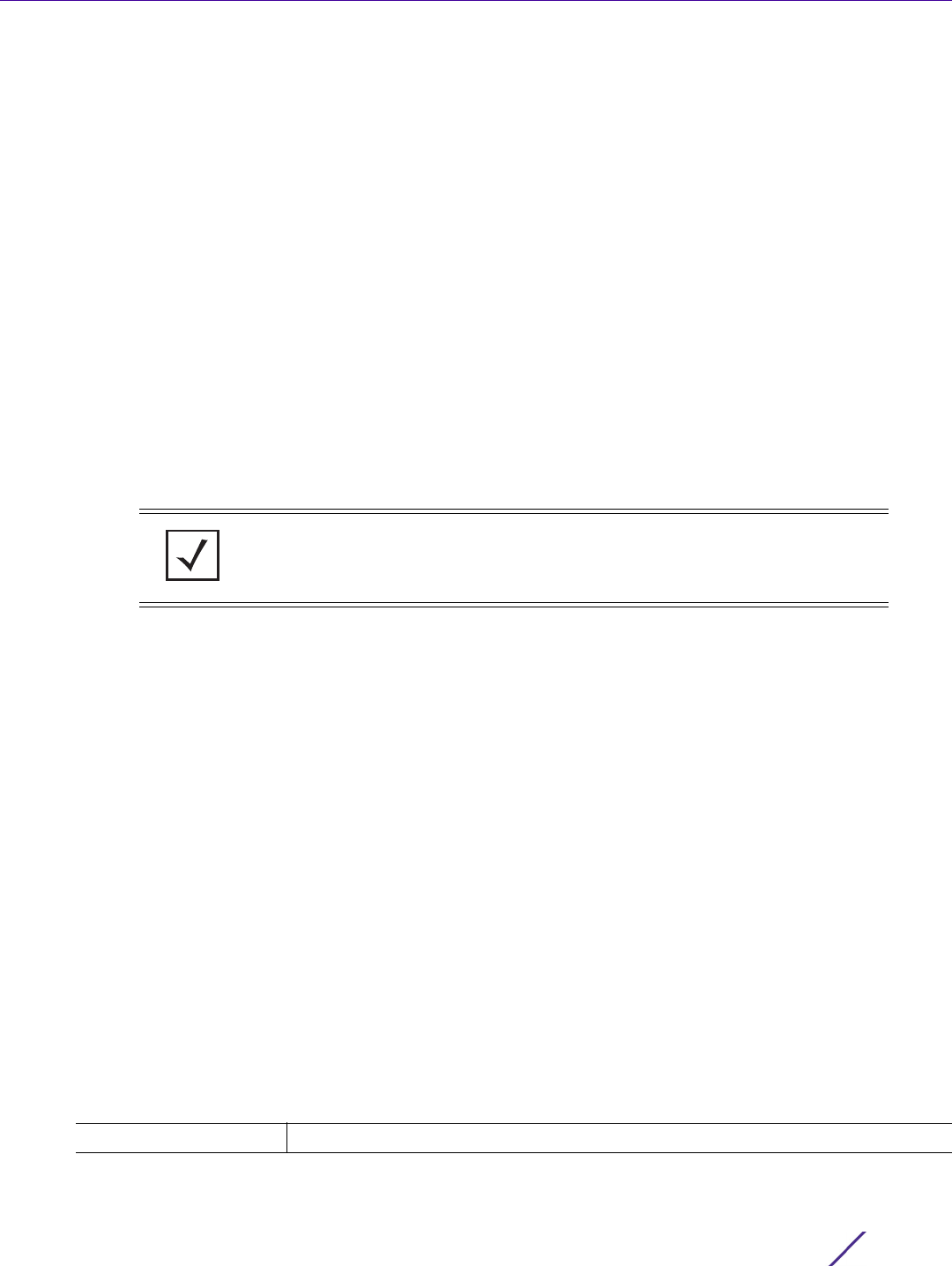
PROFILES
Access Point, Wireless Controller and Service Platform CLI Reference Guide 7 - 183
UP ports are available on RFS4000 and RFS6000 platforms. A UP port is used to connect to the backbone
network. UP ports are available on devices, such as RFS4000 and RFS6000 controllers. A UP port
supports either RJ-45 or fiber. The UP port is the preferred means to connect to the backbone as it has a
non-blocking 1gbps connection unlike the GE ports.
The following ports are available on access points:
• AP6511 - fe1, fe2, fe3, fe4, up1
• AP6521 - GE1/POE (LAN)
• AP6522 - GE1/POE (LAN)
•AP6532 - GE1/POE
• AP6562 - GE1/POE
• AP7161 - GE1/POE (LAN), GE2 (WAN)
• AP7502 - GE1 (THRU), fe1, fe2, fe3,
•AP7522 - GE1/POE (LAN)
•AP7532 - GE1/POE (LAN)
• AP81XX - GE1/POE (LAN), GE2 (WAN)
• AP82XX - GE1/POE (LAN), GE2 (WAN)
Example
rfs6000-37FABE(config-profile-default-rfs6000-if-vlan44)#
rfs6000-37FABE(config-profile-default-rfs6000-if-vlan44)#?
SVI configuration commands:
crypto Encryption module
description Vlan description
dhcp Dynamic Host Configuration Protocol (DHCP)
dhcp-relay-incoming Allow on-board DHCP server to respond to relayed DHCP
packets on this interface
ip Interface Internet Protocol config commands
ipv6 Internet Protocol version 6 (IPv6)
no Negate a command or set its defaults
shutdown Shutdown the selected interface
use Set setting to use
clrscr Clears the display screen
commit Commit all changes made in this session
do Run commands from Exec mode
end End current mode and change to EXEC mode
exit End current mode and down to previous mode
help Description of the interactive help system
revert Revert changes
service Service Commands
show Show running system information
write Write running configuration to memory or terminal
rfs6000-37FABE(config-profile-default-rfs6000-if-vlan44)#
Related Commands
NOTE: For a NX7500 model service platform, there are options for either a 2
port or 4 port network management card. Either card can be managed
using WiNG. If the 4 port card is used, ports ge7-ge10 are available. If the 2
port card is used, ports xge1-xge2 are available.
no Removes the selected interface

PROFILES
Access Point, Wireless Controller and Service Platform CLI Reference Guide 7 - 184
7.1.36.2 interface-config-ge-instance
interface
This section documents the GigabitEthernet configuration commands.
GE port placement and quantity varies depending on the controller, service platform, or access point
model. Configure the GE interface either in the device’s profile-config context or directly on a device.
The following example uses the config-profile-default-rfs7000 instance to configure a GigabitEthernet
interface:
nx9500-6C8809(config-profile-testNX9000-if-ge2)#?
Interface configuration commands:
captive-portal-enforcement Enable captive-portal enforcement on this port
cdp Cisco Discovery Protocol
channel-group Channel group commands
description Interface specific description
dot1x 802.1X
duplex Set duplex to interface
ip Internet Protocol (IP)
ipv6 Internet Protocol version 6 (IPv6)
lacp LACP commands
lacp-channel-group LACP channel commands
lldp Link Local Discovery Protocol
mac-auth Enable mac-auth for this port
no Negate a command or set its defaults
power PoE Command
qos Quality of service
remove-override Remove configuration item override from the
device (so profile value takes effect)
shutdown Shutdown the selected interface
spanning-tree Spanning tree commands
speed Configure speed
switchport Set switching mode characteristics
use Set setting to use
clrscr Clears the display screen
commit Commit all changes made in this session
do Run commands from Exec mode
end End current mode and change to EXEC mode
exit End current mode and down to previous mode
help Description of the interactive help system
revert Revert changes
service Service Commands
show Show running system information
write Write running configuration to memory or
terminal
nx9500-6C8809(config-profile-testNX9000-if-ge2)#
The following table summarizes the interface configuration commands:
Command Description Reference
captive-portal-
enforcement
Enables captive-portal enforcement on this Ethernet port page 7-186
cdp Enables Cisco Discovery Protocol (CDP) on this Ethernet port page 7-187
channel-group Assigns this Ethernet port to a channel group page 7-188
description Configures a description for this Ethernet port page 7-189
dot1x
(authenticator)
Configures 802.1X authenticator settings page 7-190

PROFILES
Access Point, Wireless Controller and Service Platform CLI Reference Guide 7 - 185
dot1x
(supplicant)
Configures 802.1X supplicant settings page 7-193
duplex Specifies the duplex mode for the interface page 7-195
ip Sets the IP address for this Ethernet port page 7-196
ipv6 Sets the DHCPv6 and ICMPv6 neighbor discovery (ND) components for
this interface
page 7-197
lacp Configures the selected GE port’s Link Aggregation Control Protocol
(LACP) port-priority value
page 7-199
lacp-channel-
group
Configures the selected GE port as a member of a port-channel group
(also referred as LAG)
page 7-200
lldp Configures Link Local Discovery Protocol (LLDP) page 7-202
mac-auth Enables MAC-based authentication on this Ethernet port page 7-203
no Removes or reverts the selected Ethernet port settings page 7-204
power Configures Power over Ethernet (PoE) settings on this interface page 7-205
qos Enables QoS page 7-206
shutdown Disables the selected Ethernet port page 7-207
spanning-tree Configures spanning tree parameters page 7-208
speed Specifies the speed on this Ethernet port page 7-211
switchport Sets interface switching mode characteristics page 7-212
use Associates IPv4, IPv6, and/or MAC ACL with the selected Ethernet port page 7-215
Command Description Reference

PROFILES
Access Point, Wireless Controller and Service Platform CLI Reference Guide 7 - 186
7.1.36.2.1 captive-portal-enforcement
interface-config-ge-instance
Enables application of captive portal access permission rules to data transmitted over this specific Ethernet
port. This setting is disabled by default.
Captive portal enforcement allows users on the wired network to pass traffic through the captive portal
without being redirected to an authentication page. Authentication instead takes place when the RADIUS
server is queried against the wired user's MAC address. If the MAC address is in the RADIUS server's user
database, the user can pass traffic on the captive portal.
Supported in the following platforms:
• Access Points — AP6521, AP6522, AP6532, AP6562, AP7161, AP7502, AP7522, AP7532, AP7562,
AP7602, AP7612, AP7622, AP7632, AP7662, AP81XX, AP8232, AP8432, AP8533
• Wireless Controllers — RFS4000, RFS6000
• Service Platforms — NX5500, NX7500, NX7510, NX7520, NX7530, NX9500, NX9510, NX9600,
VX9000
Syntax
captive-portal-enforcement {fall-back}
Parameters
• captive-portal-enforcement {fall-back}
Example
rfs6000-37FABE(config-device-B4-C7-99-6D-CD-4B-if-ge2)#captive-portal-
enforcement
rfs6000-37FABE(config-device-B4-C7-99-6D-CD-4B-if-ge2)#show context
interface ge2
captive-portal-enforcement
rfs6000-37FABE(config-device-B4-C7-99-6D-CD-4B-if-ge2)#
Related Commands
captive-portal-
enforcement
fall-back
Enables captive-portal enforcement on this Ethernet port
• fall-back – Optional. Enforces captive portal validation only if port authentication fails.
When selected, captive portal policies are enforced only when RADIUS authentication
of the client MAC address is not successful. If this option is not selected, captive portal
policies are enforced regardless of the client's MAC address being in the RADIUS
server's user database or not.
no Disables captive-portal enforcement on this interface

PROFILES
Access Point, Wireless Controller and Service Platform CLI Reference Guide 7 - 187
7.1.36.2.2 cdp
interface-config-ge-instance
Enables CDP on the selected GE port
Supported in the following platforms:
• Access Points — AP6521, AP6522, AP6532, AP6562, AP7161, AP7502, AP7522, AP7532, AP7562,
AP7602, AP7612, AP7622, AP7632, AP7662, AP81XX, AP8232, AP8432, AP8533
• Wireless Controllers — RFS4000, RFS6000
• Service Platforms — NX5500, NX7500, NX7510, NX7520, NX7530, NX9500, NX9510, NX9600,
VX9000
Syntax
cdp [receive|transmit]
Parameters
• cdp [receive|transmit]
Example
rfs6000-37FABE(config-profile-default-rfs6000-if-ge1)#cdp transmit
Related Commands
receive Enables CDP packet snooping on this interface. When enabled, the port receives
periodic interface updates from a multicast address. This option is enabled by default.
transmit Enables CDP packet transmission on this interface. When enabled, the port sends out
periodic interface updates to a multicast address to advertise its presence to
neighbors. This option is enabled by default.
no Disables CDP packet snooping on the controller or service platform’s selected GE
ports

PROFILES
Access Point, Wireless Controller and Service Platform CLI Reference Guide 7 - 188
7.1.36.2.3 channel-group
interface-config-ge-instance
Assigns this Ethernet port to a channel group. Ethernet ports can be aggregated to form a channel group.
For example, an RFS7000 has four (4) Ethernet ports (1, 2, 3, & 4). These can be aggregated to form a
minimum of one and maximum of two channel groups. A port can be a member of only one channel group
at a time.
Supported in the following platforms:
• Access Points — AP6521, AP6522, AP6532, AP6562, AP7161, AP7502, AP7522, AP7532, AP7562,
AP7602, AP7612, AP7622, AP7632, AP7662, AP81XX, AP8232, AP8432, AP8533
• Wireless Controllers — RFS4000, RFS6000
• Service Platforms — NX5500, NX7500, NX7510, NX7520, NX7530, NX9500, NX9510, NX9600,
VX9000
Syntax
channel-group <1-4>
Parameters
• channel-group <1-4>
Example
rfs6000-37FABE(config-profile-default-rfs6000-if-ge1)#channel-group 1
rfs6000-37FABE(config-profile-default-rfs6000-if-ge1)#show context
interface ge1
ip dhcp trust
qos trust dscp
qos trust 802.1p
channel-group 1
rfs6000-37FABE(config-profile-default-rfs6000-if-ge1)#
Related Commands
<1-4> Specifies a channel group number from 1 - 4. The number of channel groups
supported varies with the device type. For example:
RFS7000 – Supports two channel groups
RFS6000 – Supports four channel groups
RFS4000 – Supports three channel groups
NX5500 – Supports three channel groups
NX75XX – Supports four channel groups
NX95XX – Supports two channel groups
no Removes the channel group to which this port belongs

PROFILES
Access Point, Wireless Controller and Service Platform CLI Reference Guide 7 - 189
7.1.36.2.4 description
interface-config-ge-instance
Configures a description for this Ethernet port
Supported in the following platforms:
• Access Points — AP6521, AP6522, AP6532, AP6562, AP7161, AP7502, AP7522, AP7532, AP7562,
AP7602, AP7612, AP7622, AP7632, AP7662, AP81XX, AP8232, AP8432, AP8533
• Wireless Controllers — RFS4000, RFS6000
• Service Platforms — NX5500, NX7500, NX7510, NX7520, NX7530, NX9500, NX9510, NX9600,
VX9000
Syntax
description [<LINE>|<WORD>]
Parameters
• description [<LINE>|<WORD>]
Example
rfs6000-37FABE(config-profile-default-rfs6000-if-ge1)#description “This is
GigabitEthernet interface for Royal King”
rfs6000-37FABE(config-profile-default-rfs6000-if-ge1)#show context
interface ge1
description "This is GigabitEthernet interface for Royal King"
ip dhcp trust
qos trust dscp
qos trust 802.1p
channel-group 1
rfs6000-37FABE(config-profile-default-rfs6000-if-ge1)#
Related Commands
<LINE> Configures the maximum length (number of characters) of the interface description
<WORD> Configures a unique description for this interface. The description should not exceed
the length specified by the <LINE> parameter.
no Removes the interface description

PROFILES
Access Point, Wireless Controller and Service Platform CLI Reference Guide 7 - 190
7.1.36.2.5 dot1x (authenticator)
interface-config-ge-instance
Configures 802.1X authenticator settings
Dot1x (or 802.1x) is an IEEE standard for network authentication. It enables media-level (layer 2) access
control, providing the capability to permit or deny connectivity based on user or device identity. Dot1x
allows port-based access using authentication. An dot1x enabled port can be dynamically enabled or
disabled depending on user identity or device connection.
Devices supporting dot1x allow the automatic provision and connection to the wireless network without
launching a Web browser at login. When within range of a dot1x network, a device automatically connects
and authenticates without needing to manually login.
Before authentication, the endpoint is unknown, and traffic is blocked. Upon authentication, the endpoint is
known and traffic is allowed. The controller or service platform uses source MAC filtering to ensure only the
authenticated endpoint is allowed to send traffic.
Supported in the following platforms:
• Access Points — AP6521, AP6522, AP6562, AP7161, AP7502, AP81XX, AP8232, AP8432
• Wireless Controllers — RFS4000, RFS6000, NX5500, NX7500
Syntax
dot1x authenticator [guest-vlan|host-mode|max-reauth-req|port-control|
reauthenticate|timeout]
dot1x authenticator [guest-vlan <1-4094>|host-mode [multi-host|single-host]|
max-reauth-req <1-10>|port-control [auto|force-authorized|force-unauthorized]|
reauthenticate|timeout [quiet-period|reauth-period] <1-65535>]
Parameters
• dot1x authenticator [guest-vlan <1-4094>|host-mode [multi-host|single-host]|
max-reauth-req <1-10>|port-control [auto|force-authorized|force-unauthorized]|
reauthenticate|timeout [quiet-period|reauth-period]]
NOTE: The dot1x (802.1x) supplicant settings are documented in the next
section.
dot1x authenticator Configures 802.1x authenticator settings
guest-vlan <1-4094> Configures the guest VLAN for this interface. This is the VLAN, traffic is bridged on if
this port is unauthorized and the guest VLAN is globally enabled. Select the VLAN
index from 1 - 4094.
host-mode
[multi-host|
single-host]
Configures the host mode for this interface
• multi-host – Configures multiple host mode
• single-host – Configures single host mode. This is the default setting.
max-reauth-req
<1-10>
Configures maximum number of re-authorization retries for the supplicant. This is the
maximum number of re-authentication attempts made before this port is moved to
unauthorized.
• <1-10> – Specify a value from 1 -10. The default is 2.

PROFILES
Access Point, Wireless Controller and Service Platform CLI Reference Guide 7 - 191
Example
rfs4000-229D58(config-profile-testRFS4000-if-ge1)#dot1x authenticator guest-vlan
2
rfs4000-229D58(config-profile-testRFS4000-if-ge1)#dot1x authenticator host-mode
multi-host
rfs4000-229D58(config-profile-testRFS4000-if-ge1)#dot1x authenticator max-reauth-
req 6
rfs4000-229D58(config-profile-testRFS4000-if-ge1)#dot1x authenticator
reauthenticate
rfs4000-229D58(config-profile-testRFS4000-if-ge1)#show context
interface ge1
dot1x authenticator host-mode multi-host
dot1x authenticator guest-vlan 2
dot1x authenticator reauthenticate
dot1x authenticator max-reauth-count 6
ip dhcp trust
qos trust dscp
qos trust 802.1p
rfs4000-229D58(config-profile-testRFS4000-if-ge1)#
The following examples show the configurations made on an RFS6000 to enable it as a dot1X
authenticator:
1 Configure AAA policy on the authenticator, and identify the authentication server as onboard (self):
rfs6000-817379(config-aaa-policy-aaa-wireddot1x)#show context
aaa-policy aaa-wireddot1x
authentication server 1 onboard controller
rfs6000-817379(config-aaa-policy-aaa-wireddot1x)#
This AAA policy is used in the authenticator’s self configuration mode as shown in the last step.
2 Configure RADIUS user policy on the authenticator:
rfs6000-817379(config-radius-user-pool-wired-dot1x-users)#show con
radius-user-pool-policy wired-dot1x-users
user bob password 0 bob1234
rfs6000-817379(config-radius-user-pool-wired-dot1x-users)#
The user name and password configured here should match that of the supplicant. For more
information, see the examples provided in the dot1x (supplicant) section.
3 Configure RADIUS server policy on the authenticator, and associate the RADIUS user policy created in
the previous step:
port-control
[auto|
force-authorized|
force-unauthorized]
Configures port control state
• auto – Configures auto port state
• force-authorized – Configures authorized port state. This is the default setting.
• force-unauthorized – Configures unauthorized port state
reauthenticate Enables re-authentication for this port. When enabled, clients are forced to re-
authenticate on this port. The setting is disabled by default. Therefore, clients are not
required to re-authenticate for connection over this port until this setting is enabled.
timeout [quiet-period|
reauth-period]
<1-65535>
Configures timeout settings for this interface
• quiet-period – Configures the quiet period timeout in seconds. This is the interval, in
seconds, between successive client authentication attempts.
• reauth-period – Configures the time after which re-authentication is initiated
The following option is common to ‘quiet-period’ and ‘reauth-period’ keywords:
• <1-65535> – Specify a ‘quiet-period’ or ‘reauth-period’ from 1 - 65535 seconds.

PROFILES
Access Point, Wireless Controller and Service Platform CLI Reference Guide 7 - 192
rfs6000-817379(config-radius-server-policy-for-wired-dot1x)#show con
radius-server-policy for-wired-dot1x
use radius-user-pool-policy wired-dot1x-users
rfs6000-817379(config-radius-server-policy-for-wired-dot1x)#
4 In the authenticator’s self configuration mode, associate the RADIUS server policy, created in the
previous step, and configure other parameters (in bold) as shown in the following example:
rfs6000-817379(config-device-00-15-70-81-73-79)#use radius-server-policy for-
wired-dot1x
5 In the authenticator’s interface > ge configuration mode, configure the following parameters:
rfs6000-817379(config-device-00-15-70-81-73-79-if-ge2)#dot1x authenticator
host-mode single-host
rfs6000-817379(config-device-00-15-70-81-73-79-if-ge2)#dot1x authenticator
port-control auto
6 In the authenticator’s self configuration mode, configure the following parameters:
rfs6000-817379(config-device-00-15-70-81-73-79)#dot1x system-auth-control
rfs6000-817379(config-device-00-15-70-81-73-79)#dot1x use aaa-policy aaa-
wireddot1x
Following example displays the above configured parameters:
rfs6000-817379(config-device-00-15-70-81-73-79)#show context
use profile default-rfs6000
use rf-domain default
hostname rfs6000-817379
use radius-server-policy for-wired-dot1x
interface me1
ip address 192.168.0.1/24
interface ge2
dot1x authenticator host-mode single-host
dot1x authenticator port-control auto
interface vlan1
ip address dhcp
ip dhcp client request options all
logging on
logging console debugging
dot1x system-auth-control
dot1x use aaa-policy aaa-wireddot1x
--More--
rfs6000-817379(config-device-00-15-70-81-73-79)#
Related Commands
no Disables or reverts interface settings to their default

PROFILES
Access Point, Wireless Controller and Service Platform CLI Reference Guide 7 - 193
7.1.36.2.6 dot1x (supplicant)
interface-config-ge-instance
Configures 802.1X supplicant (client) settings
Supported in the following platforms:
• Access Points — AP6521, AP6522, AP6532, AP6562, AP7161, AP7502, AP7522, AP7532, AP7562,
AP81XX, AP8232, AP8432, AP8533
• Wireless Controllers — RFS4000, NX5500, NX7500
Syntax
dot1x supplicant username <USERNAME> password [0 <WORD>|2 <WORD>|<WORD>]
Parameters
• dot1x supplicant username <USERNAME> password [0 <WORD>|2 <WORD>|<WORD>]
Example
rfs4000-229D58(config-profile-testRFS4000-if-ge1)#dot1x supplicant username bob
password 0 test@123
rfs4000-229D58(config-profile-testRFS4000-if-ge1)#show context
interface ge1
dot1x supplicant username bob password 0 test@123
dot1x authenticator host-mode multi-host
dot1x authenticator guest-vlan 2
dot1x authenticator reauthenticate
dot1x authenticator max-reauth-count 6
ip dhcp trust
qos trust dscp
qos trust 802.1p
rfs4000-229D58(config-profile-testRFS4000-if-ge1)#
The following example shows the configuration made on an AP7522 to enable it as a dot1X supplicant:
ap7522-85B19C(config-device-84-24-8D-85-B1-9C-if-ge2)#dot1x supplicant username
bob password 0 bob1234
ap7522-85B19C(config-device-84-24-8D-85-B1-9C)#show context
use profile default-ap7522
use rf-domain default
hostname ap7522-85B19C
no adoption-mode
interface ge1
switchport mode access
switchport access vlan 1
dot1x supplicant username bob password 0 bob1234
logging on
logging console debugging
--More--
ap7522-85B19C(config-device-84-24-8D-85-B1-9C
dot1x supplicant Configures 802.1x suppliant settings
username
<USERNAME>
Sets the username for authentication
• <USERNAME> – Specify the supplicant’s username.
password
[0 <WORD>|
2 <WORD>|
<WORD>]
Sets the password associated with the supplicant’s username. Select any one of the
following options:
• 0 <WORD> – Sets a clear text password
• 2 <WORD> – Sets an encrypted password
•<WORD> – Specify the password.

PROFILES
Access Point, Wireless Controller and Service Platform CLI Reference Guide 7 - 194
Related Commands
no Removes 802.1X supplicant (client) settings

PROFILES
Access Point, Wireless Controller and Service Platform CLI Reference Guide 7 - 195
7.1.36.2.7 d u pl ex
interface-config-ge-instance
Configures duplex mode (for the flow of packets) on this Ethernet port
Supported in the following platforms:
• Access Points — AP6521, AP6522, AP6532, AP6562, AP7161, AP7502, AP7522, AP7532, AP7562,
AP7602, AP7612, AP7622, AP7632, AP7662, AP81XX, AP8232, AP8432, AP8533
• Wireless Controllers — RFS4000, RFS6000
• Service Platforms — NX5500, NX7500, NX7510, NX7520, NX7530, NX9500, NX9510, NX9600,
VX9000
Syntax
duplex [auto|half|full]
Parameters
• duplex [auto|half|full]
Example
rfs6000-37FABE(config-profile-default-rfs6000-if-ge1)#duplex full
rfs6000-37FABE(config-profile-default-rfs6000-if-ge1)#show context
interface ge1
description "This is GigabitEthernet interface for Royal King"
duplex full
dot1x supplicant username Bob password 0 test@123
ip dhcp trust
qos trust dscp
qos trust 802.1p
channel-group 1
rfs6000-37FABE(config-profile-default-rfs6000-if-ge1)#
Related Commands
auto Enables automatic duplexity on an interface port. The port automatically detects
whether it should run in full or half-duplex mode. (default setting)
half Sets the port to half-duplex mode. Allows communication in one direction only at
any given time. When selected, data is sent over the port, then immediately data is
received from the direction in which the data was transmitted.
full Sets the port to full-duplex mode. Allows communication in both directions
simultaneously. When selected, the port can send data while receiving data as well.
no Reverts to default (auto)

PROFILES
Access Point, Wireless Controller and Service Platform CLI Reference Guide 7 - 196
7.1.36.2.8 ip
interface-config-ge-instance
Sets the ARP and DHCP components for this Ethernet port
Supported in the following platforms:
• Access Points — AP6521, AP6522, AP6532, AP6562, AP7161, AP7502, AP7522, AP7532, AP7562,
AP7602, AP7612, AP7622, AP7632, AP7662, AP81XX, AP8232, AP8432, AP8533
• Wireless Controllers — RFS4000, RFS6000
• Service Platforms — NX5500, NX7500, NX7510, NX7520, NX7530, NX9500, NX9510, NX9600,
VX9000
Syntax
ip [arp|dhcp]
ip [arp [header-mismatch-validation|trust]|dhcp trust]
Parameters
• ip [arp [header-mismatch-validation|trust]|dhcp trust]
Example
rfs6000-37FABE(config-profile-default-rfs6000-if-ge1)#ip dhcp trust
rfs6000-37FABE(config-profile-default-rfs6000-if-ge1)#ip arp header-mismatch-
validation
rfs7000-37FABE(config-profile-default-rfs6000-if-ge1)#show context
interface ge1
description "This is GigabitEthernet interface for Royal King"
duplex full
dot1x supplicant username Bob password 0 test@123
ip dhcp trust
ip arp header-mismatch-validation
qos trust dscp
qos trust 802.1p
channel-group 1
rfs6000-37FABE(config-profile-default-rfs6000-if-ge1)#
Related Commands
arp [header-
mismatch-validation|
trust]
Configures ARP packet settings
• header-mismatch-validation – Enables matching of source MAC address in the ARP
and Ethernet headers to check for mismatch. This option is disabled by default.
• trust – Enables trust state for ARP responses on this interface. When enabled, ARP
packets received on this port are considered trusted and information from these
packets is used to identify rogue devices within the network. This option is disabled by
default.
dhcp trust Enables trust state for DHCP responses on this interface. When enabled, only DHCP
responses are trusted and forwarded on this port, and a DHCP server can be
connected only to a DHCP trusted port. This option is enabled by default.
no Removes the ARP and DHCP components configured for this interface

PROFILES
Access Point, Wireless Controller and Service Platform CLI Reference Guide 7 - 197
7.1.36.2.9 ipv6
interface-config-ge-instance
Sets the DHCPv6 and ICMPv6 neighbor discovery (ND) components for this interface
The ICMPv6 ND protocol uses ICMP messages and solicited multicast addresses to track neighboring
devices on the same local network. These messages are used to discover a neighbor’s link layer address
and to verify if a neighboring device is reachable.
The ICMP messages are neighbor solicitation (NS) and neighbor advertisement (NA) messages. When a
destination host receives an NS message from a neighbor, it replies back with a NA. The NA contains the
following information:
• Source address – This is the IPv6 address of the device sending the NA
• Destination address – This is the IPv6 address of the device from whom the NS message is received
• Data portion – Includes the link layer address of the device sending the NA
NS messages are used to verify a neighbor’s (whose ink layer address is known) reachability. To confirm a
neighbor’s reachability a node sends an NS message in which the neighbor’s unicast address is specified as
the destination address. If the neighbor sends back an acknowledgment on receipt of the NS message it is
considered reachable.
Supported in the following platforms:
• Access Points — AP6521, AP6522, AP6532, AP6562, AP7161, AP7502, AP7522, AP7532, AP7562,
AP7602, AP7612, AP7622, AP7632, AP7662, AP81XX, AP8232, AP8432, AP8533
• Wireless Controllers — RFS4000, RFS6000
• Service Platforms — NX5500, NX7500, NX7510, NX7520, NX7530, NX9500, NX9510, NX9600,
VX9000
Syntax
ipv6 [dhcpv6|nd]
ipv6 dhcpv6 trust
ipv6 nd [header-mismatch-validation|raguard|trust]
Parameters
• ipv6 dhcpv6 trust
• ipv6 nd [header-mismatch-validation|raguard|trust]
ipv6 dhcpv6 trust Enables trust state for DHCPv6 responses on this interface. When enabled, all
DHCPv6 responses received on this port are trusted and forwarded. This option is
enabled by default.
A DHCPv6 server can be connected to a DHCPv6 trusted port.
ipv6 nd Configures IPv6 ND settings
header-mismatch-
validation
Enables matching of source MAC address in the ICMPv6 ND and Ethernet headers
(link layer option) to check for mismatch. This option is disabled by default.
raguard Allows redirection of router advertisements (RAs) and ICMPv6 packets originating on
this interface. When selected, RAs are periodically sent to hosts or sent in response
to neighbor solicitation requests. The advertisement includes IPv6 prefixes and other
subnet and host information. This option is enabled by default.

PROFILES
Access Point, Wireless Controller and Service Platform CLI Reference Guide 7 - 198
Example
rfs6000-37FABE(config-device-B4-C7-99-6D-CD-4B-if-ge1)#ipv6 dhcpv6 trust
rfs6000-37FABE(config-device-B4-C7-99-6D-CD-4B-if-ge1)#ipv6 nd header-mismatch-
validation
rfs6000-37FABE(config-device-B4-C7-99-6D-CD-4B-if-ge1)#ipv6 nd trust
rfs6000-37FABE(config-device-B4-C7-99-6D-CD-4B-if-ge1)#show context
interface ge1
switchport mode access
switchport access vlan 1
ipv6 nd trust
ipv6 nd header-mismatch-validation
ipv6 dhcpv6 trust
rfs6000-37FABE(config-device-B4-C7-99-6D-CD-4B-if-ge1)#
Related Commands
trust Enables trust state for IPv6 ND requests received on this interface. When enabled,
IPv6 hosts can configure themselves automatically when connected to an IPv6
network using the neighbor discovery protocol via ICMPv6 router discovery
messages. When first connected to a network, a host sends a link-local router
solicitation multicast request for its configuration parameters; routers respond to the
request with a router advertisement packet containing Internet Layer configuration
parameters. This option is disabled by default.
no Removes or reverts IPv6 settings on this interface
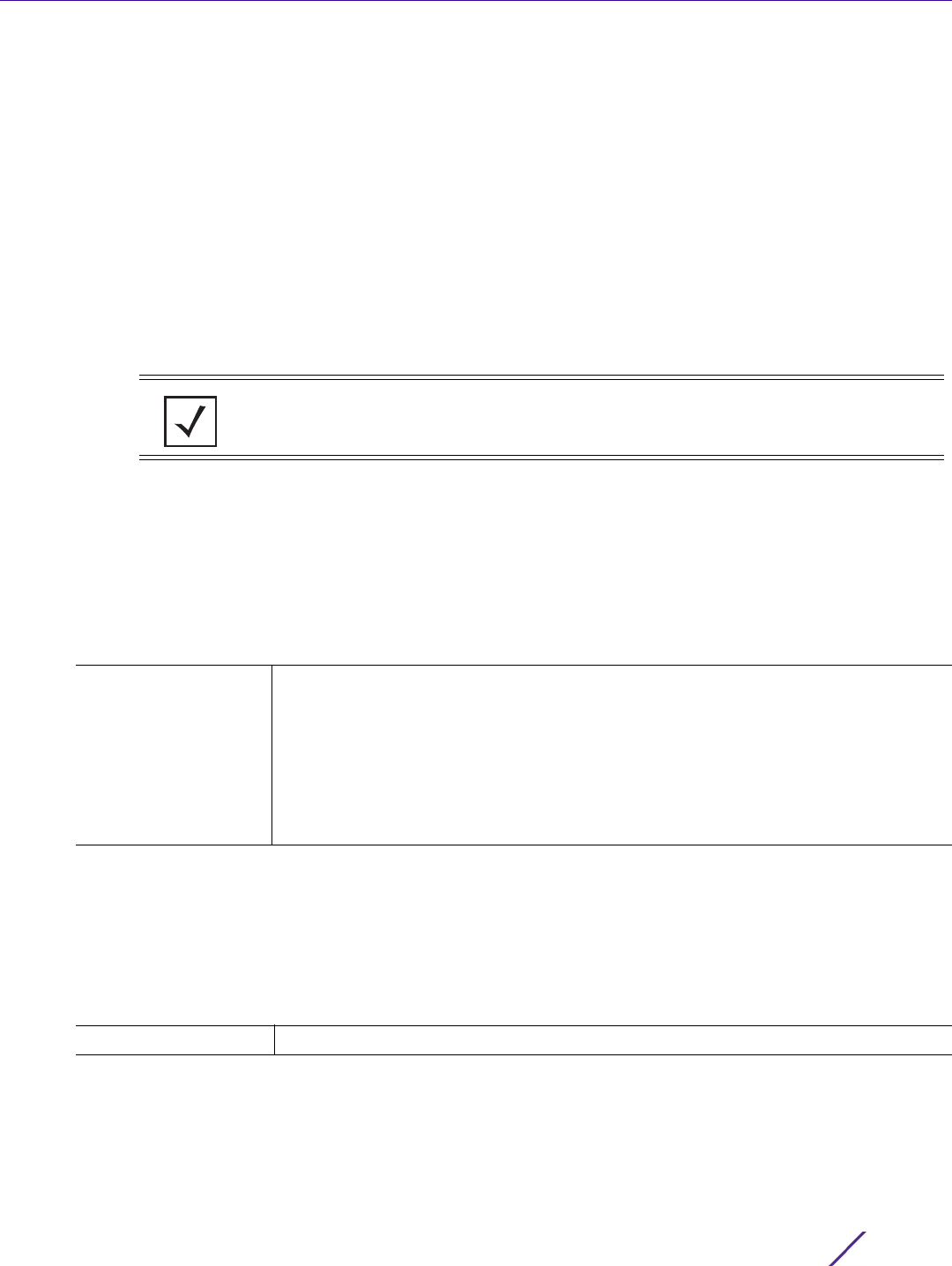
PROFILES
Access Point, Wireless Controller and Service Platform CLI Reference Guide 7 - 199
7.1.36.2.10 l a cp
interface-config-ge-instance
Configures the selected GE port’s Link Aggregation Control Protocol (LACP) port-priority value. If LACP is
enabled, and the selected port is a member of a link aggregation group (LAG), use this command to
configure the port’s priority within the LAG.
As per the IEEE 802.3ad standard, LACP enables aggregation of multiple physical links to form a single
logical channel. Each aggregated group of physical links is a LAG. When enabled, LACP dynamically
determines if link aggregation is possible between two peers, and automatically configures the
aggregation. LACP also allows the switch to dynamically reconfigure the LAGs. The LAG is enabled only
when LACP detects that the remote device is also using LACP and is able to join the LAG.
Enabling LACP provides automatic recovery in case one or more of the aggregated physical links fail.
Supported in the following platforms:
• Service Platforms — NX5500, NX7500, NX7510, NX7520, NX7530, NX9500, NX9510, NX9600,
VX9000
Syntax
lacp port-priority <1-65535>
Parameters
• lacp port-priority <1-65535>
Example
nx9500-6C8809(config-profile-testnx9000-if-ge1)#lacp port-priority 2
nx9500-6C8809(config-profile-testnx9000-if-ge1)#show context
interface ge1
lacp port-priority 2
nx9500-6C8809(config-profile-testnx9000-if-ge1)#
Related Commands
NOTE: Use the lacp-channel-group command to configure this port as a LAG
member.
lacp port-priority
<1-65535>
Configures the selected GE port’s port-priority value. The selected port’s actual
priority within the LAG is determined by the port-priority value specified here along
with the port’s number. Higher the value, lower is the priority. Use this option to
manipulate a port’s priority. For example, in a LAG having five physical ports, four
active and one standby, manually increasing the standby port’s priority ensures that
if one of the active port fails, the standby port is included in the LAG during re-
negotiation.
• <1-65535> – Specify a value from 1 - 65535. The default value is 32768.
no Removes the selected GE port’s configured port-priority value
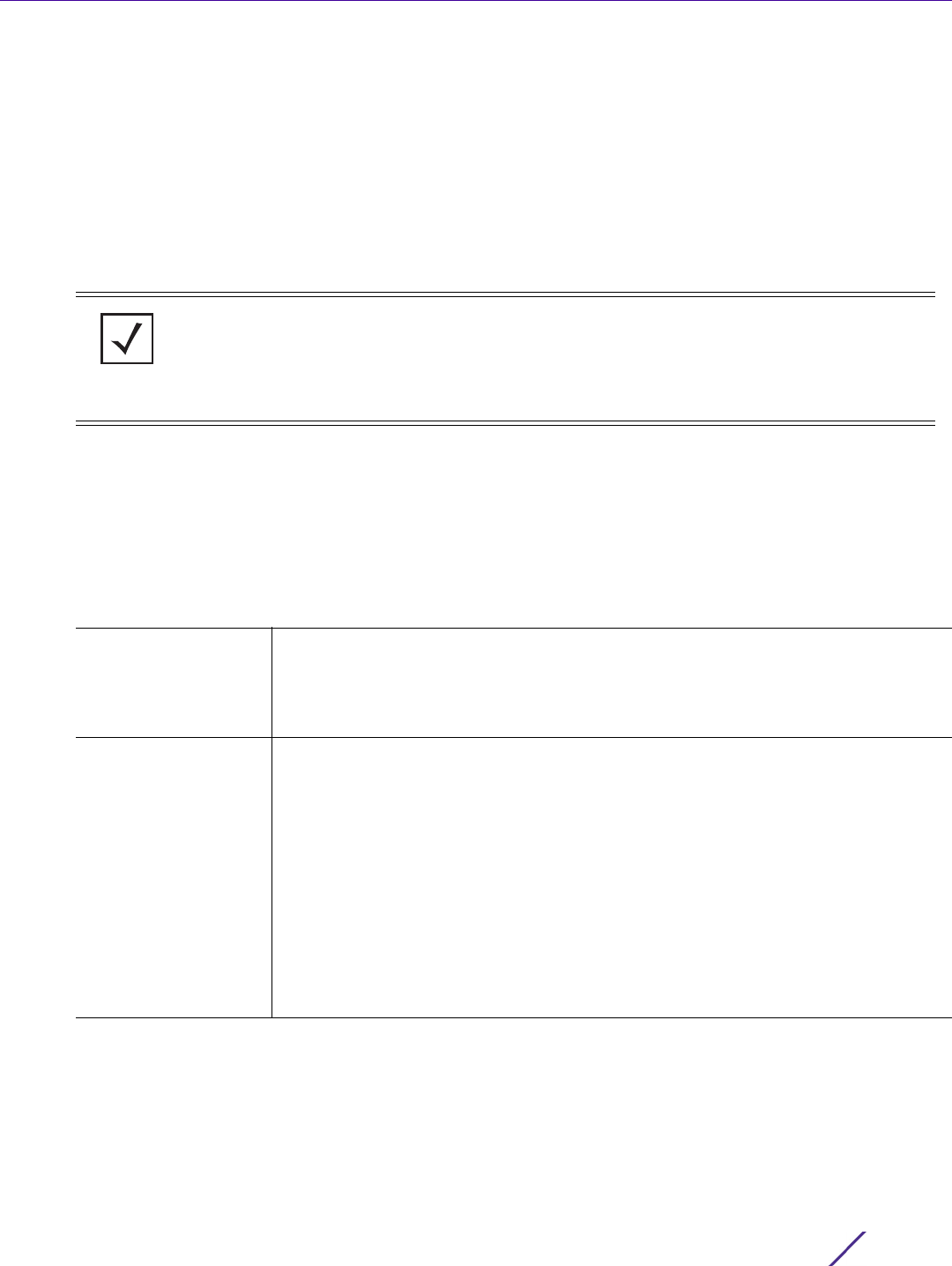
PROFILES
Access Point, Wireless Controller and Service Platform CLI Reference Guide 7 - 200
7.1.36.2.11 lacp-channel-group
interface-config-ge-instance
Configures the selected GE port as a member of a port channel group (also referred as LAG)
As per the IEEE 802.3ad standard, LACP enables the aggregation of multiple physical links (ethernet ports)
to form a single logical channel. When enabled, LACP dynamically determines if link aggregation is
possible and then automatically configures the aggregation. LACP also allows the switch to dynamically
reconfigure the LAGs. The LAG is enabled only when LACP detects that the remote device is also using
LACP and is able to join the LAG.
Supported in the following platforms:
• Service Platforms — NX5500, NX7500, NX7510, NX7520, NX7530, NX9500, NX9510, NX9600,
VX9000
Syntax
lacp-channel-group <1-4> mode [active|passive]
Parameters
• lacp-channel-group <1-4> mode [active|passive]
Example
nx9500-6C8809(config-profile-testnx9000-if-ge1)#lacp-channel-group 2 mode active
nx9500-6C8809(config-profile-test2nx9000-if-ge1)#show context
interface ge1
lacp-channel-group 2 mode active
lacp port-priority 2
nx9500-6C8809(config-profile-test2nx900-if-ge1)#
NOTE: Successful aggregation of two or more physical links is feasible only if the
aggregating physical links are configured identically. To ensure uniformity in configuration
across LAG members, implement configuration changes (such as changes in the
switching mode, speed, etc.) on the logical port (the port-channel) and not on the
physical port. Changes made on the port-channel will cascade down to each member of
the LAG thereby retaining uniformity.
lacp-channel-group <1-
4>
Associates this GE port with an existing port-channel group
• <1-4> – Specify a value from 1 - 4.
Use the interface > port-channel > <1-4> command to configure a port-channel
group. For more information, see interface-config-port-channel-instance.
mode [active|passive] After configuring the selected port as a LAG member, specify whether the port is an
active or passive member within the group. An active member initiates and
participates in LACP negotiations.
• active – Configures the port as an active member. When set to active, the port always
transmits LACPDU irrespective of the remote device’s port mode.
• passive – Configures the port as passive member. When set to passive, the port will
only respond to LACPDU received from its corresponding Active port.
At least one port within a LAG, on either of the two negotiating peers, should be in
the active mode. LACP negotiations are not initiated if all LAG member ports are
passive. Further, the peer-to-peer LACP negotiations are always initiated by the peer
with the lower system-priority value. For more information on configuring the
system-priority, see lacp.

PROFILES
Access Point, Wireless Controller and Service Platform CLI Reference Guide 7 - 201
To enable dynamic link aggregation on a device (service platform), execute the following steps:
1 Create a port-channel group on the device. Enter the port-channel configuration mode.
nx9500-6C8809(config-device-B4-C7-99-6C-88-09)#interface port-channel 1
a Set the switching mode to access or trunk as per requirement. In this example, the mode is set to
‘access’.
nx9500-6C8809(config-device-B4-C7-99-6C-88-09-if-port-channel1)#switchport
mode
access
b Specify the VLAN to switch, commit changes and exit.
nx9500-6C8809(config-device-B4-C7-99-6C-88-09-if-port-channel1)#switchport
access vlan 1
nx9500-6C8809(config-device-B4-C7-99-6C-88-09-if-port-channel1)#commit
nx9500-6C8809(config-device-B4-C7-99-6C-88-09-if-port-channel1)#exit
2 Enable dynamic link aggregation on the device’s physical port. Enter the GE port’s configuration mode.
nx9500-6C8809(config-device-B4-C7-99-6C-88-09)#interface ge 2
a Enable link aggregation and associate the port with the port-channel group created in step 1.
nx9500-6C8809(config-device-B4-C7-99-6C-88-09-if-ge2)#lacp-channel-group 1
mode
active
Note, the mode can be set to passive. However, at least one of the aggregated
GE ports in the port-channel group should be active in order to initiate link
aggregation negotiations with other LACP-enabled peers.
b Specify the GE port’s priority value.
nx9500-6C8809(config-device-B4-C7-99-6C-88-09-if-ge2)#lacp port-priority 2
Related Commands
no Removes the selected GE port’s port-channel group membership

PROFILES
Access Point, Wireless Controller and Service Platform CLI Reference Guide 7 - 202
7.1.36.2.12 lldp
interface-config-ge-instance
Configures Link Local Discovery Protocol (LLDP) parameters on this Ethernet port
Supported in the following platforms:
• Access Points — AP6521, AP6522, AP6532, AP6562, AP7161, AP7502, AP7522, AP7532, AP7562,
AP7602, AP7612, AP7622, AP7632, AP7662, AP81XX, AP8232, AP8432, AP8533
• Wireless Controllers — RFS4000, RFS6000
• Service Platforms — NX5500, NX7500, NX7510, NX7520, NX7530, NX9500, NX9510, NX9600,
VX9000
Syntax
lldp [receive|transmit]
Parameters
• lldp [receive|transmit]
Example
rfs6000-37FABE(config-profile-default-rfs6000-if-ge1)#lldp transmit
Related Commands
receive Enables LLDP Protocol Data Units (PDUs) snooping. When enabled, the port
receives periodic updates from a multicast address informing about presence of
neighbors. This option is enabled by default.
transmit Enables LLDP PDU transmission. When enabled, the port sends out periodic
interface updates to a multicast address to advertise its presence to neighbors. This
option is enabled by default.
no Disables or reverts interface settings to their default

PROFILES
Access Point, Wireless Controller and Service Platform CLI Reference Guide 7 - 203
7.1.36.2.13 m a c-au t h
interface-config-ge-instance
Enables authentication of MAC addresses on the selected wired port. When enabled, this feature
authenticates the MAC address of a device, connecting to this interface, with a RADIUS server. When
successfully authenticated, packets from the source are processed. Since only one MAC address is
supported per wired port, packets from all other sources are dropped.
For more information on enabling this feature, see mac-auth.
Enable port MAC authentication in conjunction with Wired 802.1x settings to configure a MAC
authentication AAA policy.
This option is also available in the device configuration mode.
Supported in the following platforms:
• Access Points — AP6522 AP6562, AP7161, AP7502, AP7602, AP7612, AP7622, AP7632, AP7662,
AP81XX, AP8232, AP8432, AP8533
• Wireless Controllers — RFS4000, RFS6000
• Service Platforms — NX7500, NX7510, NX7520, NX7530, NX9500, NX9510, NX9600, VX9000
Syntax
mac-auth
Parameters
None
Example
rfs4000-229D58(config-profile-testRFS4000-if-ge1)#mac-auth
rfs4000-229D58(config-profile-testRFS4000-if-ge1)#show context
interface ge1
mac-auth
ip dhcp trust
qos trust dscp
qos trust 802.1p
channel-group 1
rfs4000-229D58(config-profile-testRFS4000-if-ge1)#
rfs4000-229D58(config-profile-testRFS4000-if-ge5)#mac-auth
rfs4000-229D58(config-device-00-23-68-22-9D-58-if-ge5)#show context
interface ge5
switchport mode access
switchport access vlan 1
dot1x authenticator host-mode single-host
dot1x authenticator guest-vlan 5
dot1x authenticator port-control auto
mac-auth
rfs4000-229D58(config-device-00-23-68-22-9D-58-if-ge5)#
Related Commands
no Disables authentication of MAC addresses on the selected wired port

PROFILES
Access Point, Wireless Controller and Service Platform CLI Reference Guide 7 - 204
7.1.36.2.14 n o
interface-config-ge-instance
Removes or reverts the selected Ethernet port settings
Supported in the following platforms:
• Access Points — AP6521, AP6522, AP6532, AP6562, AP7161, AP7502, AP7522, AP7532, AP7562,
AP7602, AP7612, AP7622, AP7632, AP7662, AP81XX, AP8232, AP8432, AP8533
• Wireless Controllers — RFS4000, RFS6000
• Service Platforms — NX5500, NX7500, NX7510, NX7520, NX7530, NX9500, NX9510, NX9600,
VX9000
Syntax
no [captive-portal-enforcement|cdp|channel-group|description|dot1x|duplex|ip|
ipv6|lacp|lacp-channel-group|lldp|mac-auth|power|qos|shutdown|spanning-tree|
speed|switchport|use]
no [captive-portal-enforcement|channel-group|description|duplex|mac-auth|
shutdown|speed]
no [cdp|lldp] [receive|transmit]
no dot1x [authenticator [guest-vlan|host-mode|max-reauth-req|port-control|
reauthentication|timeout [quiet-period|reauth-period]]|supplicant]
no ip [arp [header-mismatch-validation|trust]|dhcp trust]
no ipv6 [dhcpv6 trust|nd [header-mismatch-validation|raguard|trust]]
no [lacp port-priority|lacp-channel-group]
no power {best-effort|limit|priority}
no qos trust [802.1p|cos|dscp]
no spanning-tree [bpdufilter|bpduguard|force-version|guard|link-type|mst|
portfast]
no switchport [access vlan|mode|trunk native tagged]
no use [ip-access-list|ipv6-access-list|mac-access-list] in
Parameters
• no <PARAMETERS>
Usage Guidelines
The no command negates any command associated with it. Wherever required, use the same parameters
associated with the command getting negated.
Example
rfs6000-37FABE(config-profile-default-rfs6000-if-ge1)#no cdp
rfs6000-37FABE(config-profile-default-rfs6000-if-ge1)#no duplex
no <PARAMETERS> Removes or reverts this Ethernet port settings based on the parameters passed

PROFILES
Access Point, Wireless Controller and Service Platform CLI Reference Guide 7 - 205
7.1.36.2.15 p owe r
interface-config-ge-instance
Configures Power over Ethernet (PoE) settings on this interface
When configured, this option allows the selected port to use Power over Ethernet. When enabled, the
controller supports 802.3af PoE on each of its GE ports. PoE allows users to monitor port power
consumption and configure power usage limits and priorities for each GE port.
Supported in the following platforms:
• Wireless Controllers — RFS4000, RFS6000
Syntax
power {best-effort|limit <0-40>|priority [critical|high|low]}
Parameters
• power {best-effort|limit <0-40>|priority [critical|high|low]}
Example
rfs4000-229D58(config-profile-testRFS4000-if-ge1)#power limit 30
rfs4000-229D58(config-profile-testRFS4000-if-ge1)#power priority critical
rfs4000-229D58(config-profile-testRFS4000-if-ge1)#show context
interface ge1
ip dhcp trust
qos trust dscp
qos trust 802.1p
power limit 30
power priority critical
rfs4000-229D58(config-profile-testRFS4000-if-ge1)#
Related Commands
power Configures power related thresholds for this interface
best-effort Optional. Enables power when the device is not operating from an 802.3at class 4
power source
limit <0-40> Optional. Configures the PoE power limit from 0 - 40 Watts. The default is 30
Watts.
priority
[critical|high|low]
Optional. Configures the PoE power priority on this interface. This is the priority
assigned to this port versus the power requirements of the other ports available on
the controller.
• critical – Sets PoE priority as critical
• high – Sets PoE priority as high
• low – Sets PoE priority as low. This is the default setting.
no Removes PoE settings on this interface

PROFILES
Access Point, Wireless Controller and Service Platform CLI Reference Guide 7 - 206
7.1.36.2.16 q o s
interface-config-ge-instance
Defines Quality of Service (QoS) settings on this Ethernet port
Supported in the following platforms:
• Access Points — AP6521, AP6522, AP6532, AP6562, AP7161, AP7502, AP7522, AP7532, AP7562,
AP7602, AP7612, AP7622, AP7632, AP7662, AP81XX, AP8232, AP8432, AP8533
• Wireless Controllers — RFS4000, RFS6000
• Service Platforms — NX5500, NX7500, NX7510, NX7520, NX7530, NX9500, NX9510, NX9600,
VX9000
Syntax
qos trust [802.1p|cos|dscp]
Parameters
• qos trust [802.1p|cos|dscp]
Example
rfs6000-37FABE(config-profile-default-rfs6000-if-ge1)#qos trust dscp
rfs6000-37FABE(config-profile-default-rfs6000-if-ge1)#qos trust 802.1p
rfs6000-37FABE(config-profile-default-rfs6000-if-ge1)#show context
interface ge1
description "This is GigabitEthernet interface for Royal King"
duplex full
dot1x supplicant username Bob password 0 test@123
ip dhcp trust
ip arp header-mismatch-validation
qos trust dscp
qos trust 802.1p
channel-group 1
rfs6000-37FABE(config-profile-default-rfs6000-if-ge1)#
Related Commands
trust [802.1p|cos|dscp] Trusts QoS values ingressing on this interface
• 802.1p – Trusts 802.1p COS values ingressing on this interface
• cos – Trusts 802.1p COS values ingressing on this interface. This option is enabled by
default.
• dscp – Trusts IP DSCP QOS values ingressing on this interface. This option is enabled
by default.
no Removes QoS settings on the selected interface

PROFILES
Access Point, Wireless Controller and Service Platform CLI Reference Guide 7 - 207
7.1.36.2.17 s h u tdow n
interface-config-ge-instance
Shuts down (disables) an interface. The interface is administratively enabled unless explicitly disabled using
this command.
Supported in the following platforms:
• Access Points — AP6521, AP6522, AP6532, AP6562, AP7161, AP7502, AP7522, AP7532, AP7562,
AP7602, AP7612, AP7622, AP7632, AP7662, AP81XX, AP8232, AP8432, AP8533
• Wireless Controllers — RFS4000, RFS6000
• Service Platforms — NX5500, NX7500, NX7510, NX7520, NX7530, NX9500, NX9510, NX9600,
VX9000
Syntax
shutdown
Parameters
None
Example
rfs6000-37FABE(config-profile-default-rfs6000-if-ge1)#shutdown
Related Commands
no Disables or reverts interface settings to their default

PROFILES
Access Point, Wireless Controller and Service Platform CLI Reference Guide 7 - 208
7.1.36.2.18 spanning-tree
interface-config-ge-instance
Configures spanning tree parameters
Supported in the following platforms:
• Access Points — AP6521, AP6522, AP6532, AP6562, AP7161, AP7502, AP7522, AP7532, AP7562,
AP7602, AP7612, AP7622, AP7632, AP7662, AP81XX, AP8232, AP8432, AP8533
• Wireless Controllers — RFS4000, RFS6000
• Service Platforms — NX5500, NX7500, NX7510, NX7520, NX7530, NX9500, NX9510, NX9600,
VX9000
Syntax
spanning-tree [bpdufilter|bpduguard|force-version|guard|link-type|mst|port-cisco-
interoperability|portfast]
spanning-tree [force-version <0-3>|guard root|portfast]
spanning-tree [bpdufilter|bpduguard] [default|disable|enable]
spanning-tree link-type [point-to-point|shared]
spanning-tree mst <0-15> [cost <1-200000000>|port-priority <0-240>]
spanning-tree port-cisco-interoperability [disable|enable]
Parameters
• spanning-tree [force-version <0-3>|guard root|portfast]
• spanning-tree [bpdufilter|bpduguard] [default|disable|enable]
force-version <0-3> Specifies the spanning tree force version. A version identifier of less than 2 enforces
the spanning tree protocol. Select one of the following versions:
•0 – Spanning Tree Protocol (STP)
• 1 – Not supported
•2 – Rapid Spanning tree Protocol (RSTP)
•3 – Multiple Spanning Tree Protocol (MSTP). This is the default setting
guard root Enables Root Guard for the port
The Root Guard disables superior Bridge Protocol Data Unit (BPDU) reception. The
Root Guard ensures the enabled port is a designated port. If the Root Guard enabled
port receives a superior BPDU, it moves to a discarding state (root-inconsistent STP
state). This state is equivalent to a listening state, and data is not forwarded across
the port. Therefore, enabling the guard root enforces the root bridge position. Use
the no parameter with this command to disable the Root Guard.
portfast Enables rapid transitions. Enabling PortFast allows the port to bypass the listening
and learning states.
bpdufilter
[default|disable|
enable]
Sets a PortFast BPDU filter for the port
Use the no parameter with this command to revert the port BPDU filter to its
default. The spanning tree protocol sends BPDUs from all ports. Enabling the BPDU
filter ensures PortFast enabled ports do not transmit or receive BPDUs.

PROFILES
Access Point, Wireless Controller and Service Platform CLI Reference Guide 7 - 209
• spanning-tree link-type [point-to-point|shared]
• spanning-tree mst <0-15> [cost <1-200000000>|port-priority <0-240>]
• spanning-tree port-cisco-interoperability [disable|enable]
Example
rfs6000-37FABE(config-profile-default-rfs6000-if-ge1)#spanning-tree bpdufilter
disable
rfs6000-37FABE(config-profile-default-rfs6000-if-ge1)#spanning-tree bpduguard
enable
rfs6000-37FABE(config-profile-default-rfs6000-if-ge1)#spanning-tree force-version
1
rfs6000-37FABE(config-profile-default-rfs6000-if-ge1)#spanning-tree guard root
rfs6000-37FABE(config-profile-default-rfs6000-if-ge1)#spanning-tree mst 2 port-
priority 10
bpduguard
[default|disable|
enable]
Enables BPDU guard on a port
Use the no parameter with this command to set BPDU guard to its default.
When the BPDU guard is set for a bridge, all PortFast-enabled ports that have the
BPDU guard set to default shut down upon receiving a BPDU. If this occurs, the
BPDU is not processed. The port can be brought back either manually (using the no
shutdown command), or by configuring the errdisable-timeout to enable the port
after a specified interval.
link-type
[point-to-point|shared]
Enables point-to-point or shared link types
• point-to-point – Enables rapid transition. This option indicates the port should be
treated as connected to a point-to-point link. A port connected to a controller is a
point-to-point link.
• shared – Disables rapid transition. This option indicates this port should be treated
as having a shared connection. A port connected to a hub is on a shared link,
mst <0-15> Configures MST on a spanning tree
cost <1-200000000> Defines path cost for a port from 1 - 200000000. The default path cost depends on
the speed of the port. The cost helps determine the role of the port in the MSTP
network. The designated cost is the cost for a packet to travel from this port to the
root in the MSTP configuration. The slower the media, the higher the cost.
port-priority <0-240> Defines port priority for a bridge from 1 - 240. Lower the priority greater is the
likelihood of the port becoming a designated port. Applying a higher value impacts
the port's likelihood of becoming a designated port.
port-cisco-
interoperability
Enables interoperability with Cisco's version of MSTP (which is incompatible with
standard MSTP)
enable Enables CISCO Interoperability
disable Disables CISCO Interoperability. The default is disabled.

PROFILES
Access Point, Wireless Controller and Service Platform CLI Reference Guide 7 - 210
rfs6000-37FABE(config-profile-default-rfs6000-if-ge1)#show context
interface ge1
description "This is GigabitEthernet interface for Royal King"
duplex full
spanning-tree bpduguard enable
spanning-tree bpdufilter disable
spanning-tree force-version 1
spanning-tree guard root
spanning-tree mst 2 port-priority 10
--More--
rfs6000-37FABE(config-profile-default-rfs6000-if-ge1)#
Related Commands
no Removes spanning tree settings configured on this interface

PROFILES
Access Point, Wireless Controller and Service Platform CLI Reference Guide 7 - 211
7.1.36.2.19 speed
interface-config-ge-instance
Specifies the speed of a FastEthernet (10/100) or GigabitEthernet (10/100/1000) port. This is the speed at
which the port can receive and transmit the data.
Supported in the following platforms:
• Access Points — AP6521, AP6522, AP6532, AP6562, AP7161, AP7502, AP7522, AP7532, AP7562,
AP7602, AP7612, AP7622, AP7632, AP7662, AP81XX, AP8232, AP8432, AP8533
• Wireless Controllers — RFS4000, RFS6000
• Service Platforms — NX5500, NX7500, NX7510, NX7520, NX7530, NX9500, NX9510, NX9600,
VX9000
Syntax
speed [10|100|1000|auto]
Parameters
• speed [10|100|1000|auto]
Usage Guidelines
Set the interface speed to auto detect and use the fastest speed available. Speed detection is based on
connected network hardware.
Example
rfs6000-37FABE(config-profile-default-rfs6000-if-ge1)#speed 10
rfs6000-37FABE(config-profile-default-rfs6000-if-ge1)#show context
interface ge1
description "This is GigabitEthernet interface for Royal King"
speed 10
duplex full
spanning-tree bpduguard enable
spanning-tree bpdufilter disable
spanning-tree force-version 1
spanning-tree guard root
spanning-tree mst 2 port-priority 10
dot1x supplicant username Bob password 0 test@123
ip dhcp trust
ip arp header-mismatch-validation
qos trust dscp
qos trust 802.1p
channel-group 1
rfs6000-37FABE(config-profile-default-rfs6000-if-ge1)#
Related Commands
10 Forces 10 Mbps operation
100 Forces 100 Mbps operation
1000 Forces 1000 Mbps operation
auto Port automatically detects its operational speed based on the port at the other end
of the link. Select this option to enable the port to automatically exchange
information about data transmission speed and duplex capabilities. Auto negotiation
is helpful when in an environment where different devices are connected and
disconnected on a regular basis.
no Resets speed to default (auto)

PROFILES
Access Point, Wireless Controller and Service Platform CLI Reference Guide 7 - 212
7.1.36.2.20 switchpo r t
interface-config-ge-instance
Sets switching mode characteristics for the selected interface
Supported in the following platforms:
• Access Points — AP6521, AP6522, AP6532, AP6562, AP7161, AP7502, AP7522, AP7532, AP7562,
AP7602, AP7612, AP7622, AP7632, AP7662, AP81XX, AP8232, AP8432, AP8533
• Wireless Controllers — RFS4000, RFS6000
• Service Platforms — NX5500, NX7500, NX7510, NX7520, NX7530, NX9500, NX9510, NX9600,
VX9000
Syntax
switchport [access|mode|trunk]
switchport access vlan [<1-4094>|<VLAN-ALIAS-NAME>]
switchport mode [access|trunk]
switchport trunk [allowed|native]
switchport trunk allowed vlan [<VLAN-ID>|add <VLAN-ID>|none|remove <VLAN-ID>]
switchport trunk native [tagged|vlan [<1-4094>|<VLAN-ALIAS-NAME>]]
Parameters
• switchport access vlan [<1-4094>|<VLAN-ALIAS-NAME>]
• switchport mode [access|trunk]
• switchport trunk allowed vlan [<VLAN-ID>|add <VLAN-ID>|none|remove <VLAN-ID>]
access vlan
[<1-4094>|
<VLAN-ALIAS-
NAME>]
Sets the VLAN when interface is in the access mode. You can either directly specify
the native VLAN ID or use a VLAN alias to identify the native VLAN.
• <1-4094> – Specify the SVI VLAN ID from 1 - 4094.
• <VLAN-ALIAS-NAME> – Specify the VLAN alias name (should be existing and
configured).
An Ethernet port in the access mode accepts packets only from the native VLAN.
Frames are forwarded out the port untagged with no 802.1Q header. All frames
received on the port are expected as untagged and are mapped to the native VLAN.
mode [access|trunk] Sets the interface’s switching mode to access or trunk (can only be used on physical
- layer 2 - interfaces)
• access – If access mode is selected, the access VLAN is automatically set to VLAN1.
In this mode, only untagged packets in the access VLAN (vlan1) are accepted on this
port. All tagged packets are discarded.
• trunk – If trunk mode is selected, tagged VLAN packets are accepted. The native
VLAN is automatically set to VLAN1. Untagged packets are placed in the native VLAN
by the wireless controller or service platform. Outgoing packets in the native VLAN
are sent untagged. The default mode for both ports is trunk.
trunk allowed Sets trunking mode, allowed VLANs characteristics of the port. Use this option to
add VLANs that exclusively send packets over the listed port.

PROFILES
Access Point, Wireless Controller and Service Platform CLI Reference Guide 7 - 213
• switchport trunk native [tagged|vlan [<1-4094>|<VLAN-ALIAS-NAME>]]
Usage Guidelines
Interfaces ge1 - ge4 can be configured as trunk or in access mode. An interface configured as “trunk”
allows packets (from the given list of VLANs) to be added to the trunk. An interface configured as “access”
allows packets only from native VLANs.
Use the [no] switchport (access|mode|trunk) to undo switchport configurations.
vlan
[<VLAN-ID>|
add <VLAN-ID>|
none|
remove <VLAN-ID>
Sets allowed VLAN options. The options are:
• <VLAN-ID> – Allows a group of VLAN IDs. Specify the VLAN IDs, can be either a
range (55-60) or a comma-separated list (35, 41, etc.)
• none – Allows no VLANs to transmit or receive through the layer 2 interface
• add <VLAN-ID> – Adds VLANs to the current list
• <VLAN-ID> – Specify the VLAN IDs. Can be either a range of VLAN (55-60) or a
list of comma separated IDs (35, 41, etc.)
• remove <VLAN-ID> – Removes VLANs from the current list
• <VLAN-ID> – Specify the VLAN IDs. Can be either a range of VLAN (55-60) or a
list of comma separated IDs (35, 41, etc.)
Allowed VLANs are configured only when the switching mode is set to “trunk”.
trunk Sets trunking mode characteristics of the switchport
native
[tagged|
vlan [<1-4094>|
<VLAN-ALIAS-
NAME>]]
Configures the native VLAN ID for the trunk-mode port
The native VLAN allows an Ethernet device to associate untagged frames to a
VLAN when no 802.1Q frame is included in the frame. Additionally, the native
VLAN is the VLAN untagged traffic is directed over when using a port in trunk
mode.
• tagged – Tags the native VLAN. When a frame is tagged, the 12 bit frame VLAN
ID is added to the 802.1Q header enabling upstream Ethernet devices to know
which VLAN ID the frame belongs to. The device reads the 12 bit VLAN ID and
forwards the frame to the appropriate VLAN. When a frame is received with no
802.1Q header, the upstream device classifies the frame using the default or
native VLAN assigned to the Trunk port. A native VLAN allows an Ethernet device
to associate untagged frames to a VLAN when no 802.1Q frame is included in the
frame.
• vlan [<1-4094>|<VLAN-ALIAS-NAME>] – Sets the native VLAN for classifying
untagged traffic when the interface is in trunking mode.
• <1-4094> – Specify a value from 1 - 4094.
• <VLAN-ALIAS-NAME> – Specify the VLAN alias name used to identify the
VLANs. The VLAN alias should be existing and configured.

PROFILES
Access Point, Wireless Controller and Service Platform CLI Reference Guide 7 - 214
Example
rfs6000-37FABE(config-profile-default-rfs6000-if-ge1)#switchport trunk native
tagged
rfs6000-37FABE(config-profile-default-rfs6000-if-ge1)#switchport access vlan 1
rfs6000-37FABE(config-profile-default-rfs6000-if-ge1)#show context
interface ge1
description "This is GigabitEthernet interface for Royal King"
speed 10
duplex full
switchport mode access
switchport access vlan 1
spanning-tree bpduguard enable
spanning-tree bpdufilter disable
--More--
rfs6000-37FABE(config-profile-default-rfs6000-if-ge1)#
Related Commands
no Disables or reverts interface settings to their default

PROFILES
Access Point, Wireless Controller and Service Platform CLI Reference Guide 7 - 215
7.1.36.2.21 us e
interface-config-ge-instance
Specifies the IP (IPv4 and IPv6) access list and MAC access list used with this Ethernet port. The associated
ACL firewall inspects IP and MAC traffic flows and detects attacks typically not visible to traditional wired
firewall appliances.
Supported in the following platforms:
• Access Points — AP6521, AP6522, AP6532, AP6562, AP7161, AP7502, AP7522, AP7532, AP7562,
AP7602, AP7612, AP7622, AP7632, AP7662, AP81XX, AP8232, AP8432, AP8533
• Wireless Controllers — RFS4000, RFS6000
• Service Platforms — NX5500, NX7500, NX7510, NX7520, NX7530, NX9500, NX9510, NX9600,
VX9000
Syntax
use [ip-access-list in <IPv4-ACCESS-LIST-NAME>|ipv6-access-list <IPv6-ACCESS-
LIST-NAME>|mac-access-list in <MAC-ACCESS-LIST-NAME>]
Parameters
• use [ip-access-list in <IPv4-ACCESS-LIST-NAME>|ipv6-access-list <IPv6-ACCESS-
LIST-NAME>|mac-access-list in <MAC-ACCESS-LIST-NAME>]
ip-access-list in
<IPv4-ACCESS-LIST-
NAME>
Associates an IPv4 access list with this Ethernet port. IPv4 is a connectionless
protocol for packet switched networking. IPv4 operates as a best effort delivery
method, as it does not guarantee delivery, and does not ensure proper sequencing or
duplicate delivery (unlike (TCP). IPv4 hosts can use link local addressing to provide
local connectivity.
• in – Applies the IPv4 ACL on incoming packets
• <IPv4-ACCESS-LIST-NAME> – Specify the IPv4 access list name (it should be an
existing and configured).
ipv6-access-list in
<IPv6-ACCESS-LIST-
NAME>
Associates an IPv6 access list with this Ethernet port. IPv6 is the latest revision of the
IP designed to replace IPv4. IPV6 provides enhanced identification and location
information for computers on networks routing traffic across the Internet. IPv6
addresses are composed of eight groups of four hexadecimal digits separated by
colons.
• in – Applies the IPv6 ACL on incoming packets
• <IPv6-ACCESS-LIST-NAME> – Specify the IPv6 access list name (it should be an
existing and configured).
mac-access-list in
<MAC-ACCESS-LIST-
NAME>
Associates a MAC access list with this Ethernet port. MAC ACLs filter/mark packets
based on the MAC address from which they arrive, as opposed to filtering packets on
layer 2 ports.
• in – Applies the MAC ACL on incoming packets
• <MAC-ACCESS-LIST-NAME> – Specify the MAC access list name (it should be an
existing and configured).

PROFILES
Access Point, Wireless Controller and Service Platform CLI Reference Guide 7 - 216
Example
rfs6000-37FABE(config-profile-default-rfs6000-if-ge1)#use mac-access-list in test
rfs6000-37FABE(config-profile-default-rfs6000-if-ge1)#use ip-access-list in test
rfs6000-37FABE(config-profile-default-rfs6000-if-ge1)#show context
interface ge1
description "This is GigabitEthernet interface for Royal King"
speed 10
duplex full
switchport mode accessi
switchport access vlan 1
use ip-access-list in test
use mac-access-list in test
spanning-tree bpduguard enable
spanning-tree bpdufilter disable
spanning-tree force-version 1
--More--
rfs6000-37FABE(config-profile-default-rfs6000-if-ge1)#
Related Commands
no Disassociates the IP access list or MAC access list from the interface

PROFILES
Access Point, Wireless Controller and Service Platform CLI Reference Guide 7 - 217
7.1.36.3 interface-config-vlan-instance
interface
Use the config-profile-<DEVICE-PROFILE-NAME> mode to configure Ethernet, VLAN and tunnel settings.
To switch to this mode, use the following commands:
<DEVICE>(config-profile-default-<DEVICE-TYPE>)#interface [<INTERFACE-NAME>|fe <1-
4>|ge <1-24>|me1|port-channel <1-4>|pppoe1|radio [1|2|3]|up1|vlan <1-4094>|wwan1|
xge <1-24>]
The following example uses the config-profile-default-rfs7000 instance to configure a VLAN interface:
rfs6000-37FABE(config-profile-default-rfs6000)#interface vlan 8
rfs6000-37FABE(config-profile-default-rfs6000-if-vlan8)#
rfs6000-37FABE(config-profile-default-rfs6000-if-vlan8)#?
SVI configuration commands:
crypto Encryption module
description Vlan description
dhcp Dynamic Host Configuration Protocol (DHCP)
dhcp-relay-incoming Allow on-board DHCP server to respond to relayed DHCP
packets on this interface
ip Interface Internet Protocol config commands
ipv6 Internet Protocol version 6 (IPv6)
no Negate a command or set its defaults
shutdown Shutdown the selected interface
use Set setting to use
clrscr Clears the display screen
commit Commit all changes made in this session
do Run commands from Exec mode
end End current mode and change to EXEC mode
exit End current mode and down to previous mode
help Description of the interactive help system
revert Revert changes
service Service Commands
show Show running system information
write Write running configuration to memory or terminal
rfs6000-37FABE(config-profile-default-rfs6000-if-vlan8)#
The following table summarizes interface VLAN configuration commands:
Commands Description Reference
crypto Defines the encryption module used with this VLAN interface page 7-218
description Defines the VLAN interface description page 7-219
dhcp Enables inclusion of optional fields (client identifier) in DHCP client
requests
page 7-220
dhcp-relay-
incoming
Allows an onboard DHCP server to respond to relayed DHCP packets
on this interface
page 7-221
ip Configures the VLAN interface’s IP settings page 7-222
ipv6 Configures the VLAN interface’s IPv6 settings page 7-225
no Removes or reverts this VLAN interface’s settings to default page 7-230
shutdown Shuts down this VLAN interface page 7-232
use Associates an IP (IPv4 and IPv6) access list, bonjour-gw-discovery
policy, and an IPv6-route-advertisement policy with this VLAN
interface
page 7-233

PROFILES
Access Point, Wireless Controller and Service Platform CLI Reference Guide 7 - 218
7.1.36.3.1 cr y pto
interface-config-vlan-instance
Associates an existing and configured VPN crypto map with this VLAN interface.
Crypto map entries are sets of configuration parameters for encrypting packets that pass through the VPN
tunnel. For more information on crypto maps, see crypto-map-config-commands.
Supported in the following platforms:
• Access Points — AP6521, AP6522, AP6532, AP6562, AP7161, AP7502, AP7522, AP7532, AP7562,
AP7602, AP7612, AP7622, AP7632, AP7662, AP81XX, AP8232, AP8432, AP8533
• Wireless Controllers — RFS4000, RFS6000
• Service Platforms — NX5500, NX7500, NX7510, NX7520, NX7530, NX9500, NX9510, NX9600,
VX9000
Syntax
crypto map <CRYPTO-MAP-NAME>
Parameters
• crypto map <CRYPTO-MAP-NAME>
Example
rfs6000-37FABE(config-profile-default-rfs6000-if-vlan8)#crypto map map1
rfs6000-37FABE(config-profile-default-rfs6000-if-vlan8)#show context
interface vlan8
crypto map map1
rfs6000-37FABE(config-profile-default-rfs6000-if-vlan8)#
Related Commands
map
<CRYPTO-MAP-NAME>
Attaches a crypto map to the selected VLAN interface. The crypto map should be
existing and configured.
• <CRYPTO-MAP-NAME> – Specify the crypto map name.
no Disables or reverts interface VLAN settings to their default